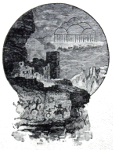
In the html version of this eBook, larger images (indicated with a blue border) are linked to higher-resolution versions of the illustrations.
Smithsonian institution. Bureau of ethnology.
Tenth annual report | of the | Bureau of ethnology | to the | secretary of the Smithsonian institution | 1888-’89 | by | J. W. Powell | director | [Vignette] |
Washington | government printing office | 1893
8o. xxx, 742 pp. 54 pl.
Powell (John Wesley).
Tenth annual report | of the | Bureau of ethnology | to the | secretary of the Smithsonian institution | 1888-’89 | by | J. W. Powell | director | [Vignette] |
Washington | government printing office | 1893
8o. xxx, 742 pp. 54 pl.
[Smithsonian institution. Bureau of ethnology.]
Tenth annual report | of the | Bureau of ethnology | to the | secretary of the Smithsonian institution | 1888-’89 | by | J. W. Powell | director | [Vignette] |
Washington | government printing office | 1893
8o. xxx, 742 pp. 54 pl.
[Smithsonian institution. Bureau of ethnology.]
TENTH ANNUAL REPORT
OF THE
BUREAU OF ETHNOLOGY
TO THE
SECRETARY OF THE SMITHSONIAN INSTITUTION
1888-’89
BY
J. W. POWELL
DIRECTOR

WASHINGTON
GOVERNMENT PRINTING OFFICE
1893
| Page. | |
| Letter of transmittal | VII |
| Introduction | IX |
| Publications | X |
| Field work | X |
| Mound explorations | X |
| Work of Mr. Cyrus Thomas | X |
| Work of Mr. Gerard Fowke | XI |
| Work of Mr. J. D. Middleton | XI |
| Work of Mr. H. L. Reynolds | XI |
| Work of Mr. J. W. Emmert | XII |
| General field studies | XII |
| Work of Col. Garrick Mallery | XII |
| Work of Mr. W. J. Hoffman | XIII |
| Work of Mr. H. W. Henshaw | XIV |
| Work of Mr. James Mooney | XV |
| Work of Mr. Jeremiah Curtin | XVI |
| Work of Mr. A. S. Gatschet | XVII |
| Work of Mr. J. N. B. Hewitt | XVII |
| Work of Mr. Victor Mindeleff | XVII |
| Work of Mr. A. M. Stephen | XVII |
| Office work | XVIII |
| Work of Major J. W. Powell | XVIII |
| Work of Mr. H. W. Henshaw | XVIII |
| Work of Col. Garrick Mallery | XVIII |
| Work of Mr. J. Owen Dorsey | XVIII |
| Work of Mr. A. S. Gatschet | XIX |
| Work of Mr. Jeremiah Curtin | XIX |
| Work of Mr. James Mooney | XIX |
| Work of Mr. J. N. B. Hewitt | XX |
| Work of Mr. J. C. Pilling | XX |
| Work of Mr. W. H. Holmes | XXI |
| Work of Mr. Cyrus Thomas | XXII |
| Work of Mr. H. L. Reynolds | XXII |
| Work of Mr. Victor Mindeleff | XXII |
| Work of Mr. Cosmos Mindeleff | XXII |
| Work of Mr. J. K. Hillers | XXIII |
| Work of Mr. Franz Boas | XXIII |
| Work of Mr. Lucien M. Turner | XXIV |
| Necrology | XXIV |
| Mr. James Stevenson | XXIV |
| Accompanying paper | XXV |
| Picture-writing of the American Indians, by Garrick Mallery | XXVI |
| Financial statement | XXX |
Smithsonian Institution, Bureau of Ethnology,
Washington, D. C., October 1, 1889.
Sir: I have the honor to submit my Tenth Annual Report as Director of the Bureau of Ethnology.
The first part of it presents an exposition of the operations of the Bureau during the fiscal year 1888-’89; the second part consists of a work on the Picture-writing of the American Indians, which has been in preparation for several years.
I desire to express my thanks for your earnest support and your valuable counsel relating to the work under my charge.
I am, with respect, your obedient servant,

Prof. S. P. Langley,
Secretary of the Smithsonian Institution.
TENTH ANNUAL REPORT
OF THE
BUREAU OF ETHNOLOGY.
By J. W. Powell, Director.
Research among the North American Indians, in obedience to acts of Congress, was continued during the fiscal year 1888-’89.
The explanation presented in several former annual reports of the general plan upon which the work of the Bureau has been performed renders a detailed repetition superfluous. The lines of investigation which from time to time have appeared to be the most useful or the most pressing have been confided to persons trained in or known to be specially adapted to their pursuit. The results of their labors are presented in the three series of publications of the Bureau which are provided for by law. A brief statement of the work upon which each one of the special students was actively engaged during the fiscal year is furnished below; but it should be noted that this statement does not specify all the studies made or services rendered by them.
The assistance of explorers, writers, and students who are not and may not desire to be officially connected with the Bureau is again invited. Their contributions, whether in suggestions or extended communications, will always be gratefully acknowledged and will receive proper credit. They may be published as Congress will allow, either in the series of annual reports or in monographs or bulletins. Several valuable papers of this class have already been contributed and published.
The report now submitted consists of three principal divisions. The first relates to the publications made during the fiscal year; the second, to the work prosecuted in the field; the third, to the office work, which chiefly consists of the preparation for publication of the results of field work, with the corrections and additions obtained from exhaustive researches into the literature of the subjects discussed and by correspondence relative to them.
The publications actually issued and distributed during the year were as follows, all octavo:
Bibliography of the Iroquoian Languages, by James C. Pilling; pages i-vi + 1-208. Facsimile reproductions, at pages 44 and 56, of title pages of early publications relating to Indian languages, and, at page 72, of the Cherokee alphabet.
Textile Fabrics of Ancient Peru, by William H. Holmes; pages 1-17, Figs. 1-11.
The Problem of the Ohio Mounds, by Cyrus Thomas; pages 1-54, Figs. 1-8.
The field work of the year is divided into (1) mound explorations and (2) general field studies, the latter being directed chiefly to archeology, linguistics, and pictography.
The work of exploring the mounds of the eastern United States was, as in former years, under the superintendence of Mr. Cyrus Thomas. The efforts of the division were chiefly confined to the examination of material already collected and to the arrangement and preparation for publication of the data on hand. Field work received less attention, therefore, than in previous years, and was mainly directed to such investigations as were necessary to elucidate doubtful points and to the examination and surveys of important works which had not before received adequate attention.
The only assistants to Mr. Thomas whose engagements embraced the entire year were Mr. James D. Middleton and Mr. Henry L. Reynolds. Mr. Gerard Fowke, one of the assistants, ceased his connection with the Bureau at the end of the second month. Mr. John W. Emmert was engaged as a temporary assistant for a few months.
During the short time in which he remained with the division, Mr. Fowke was engaged in exploring certain mounds in the Sciota valley, Ohio, a field to which Messrs. Squier and Davis had devoted much attention. Its reexamination was for the purpose of investigating certain typical mounds which had not been thoroughly examined by those explorers.
Mr. Middleton was employed from July to the latter part of October in the exploration of mounds and other ancient works in Calhoun county, Illinois, a territory to which special interest attaches because it seems to be on the border line of different archeologic districts. From October until December he was engaged at Washington in preparing plats of Ohio earthworks. During the next month he made resurveys of some of the more important inclosures in Ohio, after which he resumed work in the office at Washington until the latter part of March, when he was sent to Tennessee to examine several mound groups and to determine, so far as possible, the exact locations of the old Cherokee “over-hill towns.” The result of the last-mentioned investigation was valuable, as it indicated that each of these “over-hill towns” was, with possibly one unimportant exception, in the locality of a mound group.
Near the close of October Mr. Reynolds, having already examined the inclosures of the northern, eastern, and western sections of the mound region, went to Ohio and West Virginia to study the different types found there, with reference to the[xii] chapters he was preparing on the various forms of ancient inclosures in the United States. While thus engaged he explored a large mound connected with one of the typical works in Paint creek valley, obtaining unexpected and important results. The construction of this tumulus was found to be quite different from most of those in the same section examined by Messrs. Squier and Davis.
Mr. Emmert devoted the few months in which he was employed to the successful exploration of mounds in eastern Tennessee. Some important discoveries were made and additional interesting facts were ascertained in regard to the mounds of that section.
Early in the month of July Col. Garrick Mallery proceeded to Maine, Nova Scotia and New Brunswick to continue investigation into the pictographs of the Abnaki and Micmac Indians, which had been commenced in 1887. He first visited rocks in Maine, on the shore near Machiasport, and on Hog island, in Holmes bay, a part of Machias bay. In both localities pecked petroglyphs were found, accurate copies of which were taken. Some of them had not before been reported. They are probably of Abnaki origin, of either the Penobscot or the Passamaquoddy division, the rocks lying on the line of water communication between the territories of those divisions. From Maine he proceeded to Kejemkoojik lake, on the border of Queens and Annapolis counties, Nova Scotia, and resumed the work of drawing and tracing the large number of petroglyphs found during the previous summer. Perfect copies were obtained of so many of them as to be amply sufficient for study and comparison. These are incised petroglyphs, and were made by Micmacs. The country of the Malecites, on the St. Johns river, New Brunswick, was next visited. No petroglyphs were discovered, but a considerable amount of information was obtained[xiii] upon the old system of pictographs on birch bark and its use. Illustrative specimens were gathered, together with myths and legends, which assisted in the elucidation of some of the pictographs observed elsewhere.
Mr. W. J. Hoffman proceeded in July to visit the Red Lake and White Earth Indian reservations in Minnesota. At Red lake he obtained copies of birch bark records pertaining to the Midē'wiwin or Grand Medicine Society of the Ojibwa, an order of shamans professing the power to prophesy, to cure disease, and to confer success in the chase. The introductory portion of the ritual of this society pertains particularly to the Ojibwa cosmogony. At the same place he secured several birch bark records of hunting expeditions, battles with neighboring tribes of Indians, maps, and songs. He also investigated the former and present practice of tattooing, and the Ojibwa works of art in colors, beads, and quills.
At White Earth Reservation two distinct charts of the Grand Medicine Society were obtained, together with full explanations by two of the chief midé or shamans, one of whom was the only fourth-degree priest in either of the reservations. Although a considerable difference between these three charts is apparent, their principles and the general course of the initiation of the candidates are similar. The survival of archaic forms in the charts and ritual indicates a considerable antiquity. Some mnemonic songs were also obtained at this reservation. In addition to the ritual, secured directly from the priests, in the Ojibwa language, translations of the songs were also recorded, with musical notation. On leaving the above reservations, Mr. Hoffman proceeded to Pipestone, Minnesota, to copy the petroglyphs upon the cliffs of that historic quarry.
He then returned to St. Paul, Minnesota, to search the records of the library of the Minnesota Historical Society for copies of pictographs reported to have been made near La Pointe, Wisconsin. Little information was obtained, although it is known that such pictographs, now nearly obliterated,[xiv] existed upon conspicuous cliffs and rocks near Lake Superior, at and in the vicinity of Bayfield and Ashland.
Mr. Hoffman afterward made an examination of the “pictured cave,” eight miles northeast of La Crosse, Wisconsin, to obtain copies of the characters appearing there. These are rapidly being destroyed by the disintegration of the rock. The colors employed in delineating the various figures were dark red and black. The figures represent human beings, deer, and other forms not now distinguishable.
Mr. H. W. Henshaw spent the months of August, September, and October on the Pacific coast, engaged in the collection of vocabularies of several Indian languages, with a view to their study and classification. The Umatilla Reservation in Oregon was first visited with the object of obtaining a comprehensive vocabulary of the Cayuse. Though there are about four hundred of these Indians on the reservation, probably not more than six speak the Cayuse tongue. The Cayuse have extensively intermarried with the Umatilla, and now speak the language of the latter, or that of the Nez Percé. An excellent Cayuse vocabulary was obtained, and at the same time the opportunity was embraced to secure vocabularies of the Umatilla and the Nez Percé languages. His next objective point was the neighborhood of the San Rafael Mission, Marin county, California, the hope being entertained that some of the Indians formerly gathered at the mission would be found there. He learned that there were no Indians at or near San Rafael, but subsequently found a few on the shores of Tomales bay, to the north. A good vocabulary was collected from one of these, which, as was expected, was subsequently found to be related to the Moquelumnan family of the interior, to the southeast of San Francisco bay. Later the missions of Santa Cruz and Monterey were visited. At these points there still remain a few old Indians who retain a certain command of their own language, though Spanish forms their ordinary means of intercourse. The vocabularies obtained are sufficient to prove, beyond any reasonable doubt, that there are two[xv] linguistic families instead of one, as had been formerly supposed, in the country above referred to. A still more important discovery was made by Mr. Henshaw at Monterey, where an old woman was found who succeeded in calling to mind more than one hundred words and short phrases of the Esselen language, formerly spoken near Monterey, but less than forty words of which had been previously known. Near the town of Cayucas, to the south, an aged and blind Indian was visited who was able to add somewhat to the stock of Esselen words obtained at Monterey, and to give valuable information concerning the original home of that tribe. As a result of the study of this material Mr. Henshaw determines the Esselen to be a distinct linguistic family, a conclusion first drawn by Mr. Curtin from a study of the vocabularies collected by Galiano and Lamanon in the eighteenth century. The territory occupied by the tribe and linguistic family lies coastwise, south of Monterey bay, as far as the Santa Lucia mountains.
On July 5 Mr. James Mooney started on a second trip to the territory of the Cherokee in North Carolina, returning after an absence of about four months. During this time he made considerable additions to the linguistic material already obtained by him, and was able to demonstrate the former existence of a fourth, and perhaps even of a fifth, well-marked Cherokee dialect in addition to the upper, lower, and middle dialects already known. The invention of a Cherokee syllabary which was adapted to the sounds of the upper dialect has tended to make that dialect universal. A number of myths were collected, together with a large amount of miscellaneous material relating to the Cherokee tribe, and the great tribal game of ball play, with its attendant ceremonies of dancing, conjuring, scratching the bodies of the players, and going to water, was witnessed. A camera was utilized to secure characteristic pictures of the players. Special attention was given to the subject of Indian medicine, theoretic, ceremonial, and therapeutic. The most noted doctors of the tribe were employed as informants, and nearly five hundred specimens of medicinal[xvi] and food plants were collected and their Indian names and uses ascertained. The general result of this investigation shows that the medical and botanical knowledge of the Indians has been greatly overrated. A study was made of Cherokee personal names, about five hundred of which were translated, being all the names of Indian origin now remaining in that region. The most important results of Mr. Mooney’s investigations were the discovery of a large number of manuscripts containing the sacred formulas of the tribe, written in Cherokee characters by the shamans for their own secret use, and jealously guarded from the knowledge of all but the initiated. The existence of such manuscripts had been ascertained during a visit in 1887, and several of them had been procured. This discovery of genuine aboriginal material, written in an Indian language by shamans for their own use, is believed to be unique in the history of aboriginal investigation, and was only made possible through the invention of the Cherokee syllabary by Sequoia in 1821. Every effort was made by Mr. Mooney to obtain all the existing manuscripts, with the result of securing all of that material which was in the possession of the tribe. The whole number of formulas obtained is about six hundred. They consist of prayers and sacred songs, explanations of ceremonies, directions for medical treatment, and underlying theories. They relate to medicine, love, war, hunting, fishing, self-protection, witchcraft, agriculture, the ball play, and other similar subjects, thus forming a complete exposition of an aboriginal religion as set forth by its priests in their own language.
Early in October Mr. Jeremiah Curtin left Washington for the Pacific coast. During the remainder of the year he was occupied in Shasta and Humboldt counties, California, in collecting vocabularies and data connected with the Indian system of medicine. This work was continued in different parts of Humboldt and Siskiyou counties until June 30, 1889. Large collections of linguistic and other data were gathered and myths were secured which show that the whole system of[xvii] medicine of these Indians and the ministration of remedies originated in and are limited to sorcery practices.
The field work of Mr. Albert S. Gatschet during the year was short. It had been ascertained that Mrs. Alice M. Oliver, now in Lynn, Massachusetts, formerly lived on Trespalacios bay, Texas, near the homes of the Karánkawa, and Mr. Gatschet visited Lynn with a view of securing as complete a vocabulary as possible of their extinct language. Mrs. Oliver was able to recall about one hundred and sixty terms of the language, together with some phrases and sentences. She also furnished many valuable details regarding the ethnography of the tribe. Ten days were spent in this work.
Mr. J. N. B. Hewitt was occupied in field work from August 1 to November 8, as follows: From the first of August to September 20 he was on the Tuscarora reserve, in Niagara county, New York, in which locality fifty-five legends and myths were collected. A Penobscot vocabulary was also obtained here, together with other linguistic material. From September 20 to November 8 Mr. Hewitt visited the Grand River reserve, Canada, where a large amount of text was obtained, together with notes and other linguistic material.
Mr. Victor Mindeleff left Washington on October 23 for St. John’s, Arizona, where he examined the Hubbell collection of ancient pottery and secured a series of photographs and colored drawings of the more important specimens. Thence he went to Zuñi and obtained drawings of interior details of dwellings and other data necessary for the completion of his studies of the architecture of this pueblo. He returned to Washington December 7.
Mr. A. M. Stephen continued work among the Tusayan pueblos under the direction of Mr. Victor Mindeleff. He added[xviii] much to the knowledge of the traditionary history of Tusayan, and made an extensive study of the house lore and records of house-building ceremonials. He also reported a full nomenclature of Tusayan architectural terms as applied to the various details of terraced-house construction, with etymologies. He secured from the Navajo much useful information of the ceremonial connected with the construction of their conical lodges or “hogans,” supplementing the more purely architectural records of their construction previously collected by Mr. Mindeleff. As opportunity occurred he gathered typical collections of baskets and other textile fabrics illustrative of the successive stages of their manufacture, including specimens of raw materials and detailed descriptions of the dyes used. These collections are intended to include also the principal patterns in use at the present time, with the Indian explanations of their significance.
Major J. W. Powell, the Director, devoted much time during the year to the preparation of the paper to accompany a map of the linguistic families of America north of Mexico, the scope of which has been alluded to in previous reports. This report and map appear in the Seventh Annual Report of the Bureau.
Mr. Henshaw was chiefly occupied with the administrative duties of the office, which have been placed in his charge by the Director, and with the completion of the linguistic map.
Col. Mallery, after his return from the field work elsewhere mentioned, was engaged in the elaboration of the new information obtained and in further continued study of and correspondence relating to sign language and pictography. In this work he was assisted by Mr. Hoffman, particularly in the sketches made by the latter during previous field seasons, and in preparing a large number of the illustrations for the paper on Picture-writing of the American Indians which appears in the present volume.
Mr. J. Owen Dorsey did no field work during the year, but devoted much of the time to original investigations. Samuel[xix] Fremont, an Omaha Indian, came to Washington in October, 1888, and until February, 1889, assisted Mr. Dorsey in the revision of the entries for the Ȼegiha-English Dictionary. Similar assistance was rendered by Little Standing Buffalo, a Ponka Indian from the Indian Territory, in April and May, 1889. Mr. Dorsey also completed the entries for the Ȼegiha-English Dictionary, and a list of Ponka, Omaha, and Winnebago personal names. He translated from the Teton dialect of the Dakota all the material of the Bushotter collection in the Bureau of Ethnology, and prepared therefrom a paper on Teton folklore. He also prepared a brief paper on the camping circles of Siouan tribes, and in addition furnished an article on the modes of predication in the Athapascan dialects of Oregon and in several dialects of the Siouan family. He also edited the manuscript of the Dakota grammar, texts, and ethnography, written by the late Rev. Dr. S. R. Riggs, which has been published as Volume VII, Contributions to North American Ethnology. In May, 1889, he began an extensive paper on Indian personal names, based on material obtained by himself in the field, to contain names of the following tribes, viz: Omaha and Ponka, Kansa, Osage, Kwapa, Iowa, Oto and Missouri, and Winnebago.
Mr. Albert S. Gatschet’s office work was almost entirely restricted to the composition and completion of his Ethnographic Sketch, Grammar, and Dictionary of the Klamath Language of Oregon, with the necessary appendices. These works have been published as Parts 1 and 2, Vol. II, of Contributions to North American Ethnology.
Mr. Jeremiah Curtin during the year arranged and copied myths of various Indian families, and also transcribed Wasco, Sahaptin, and Yanan vocabularies previously collected.
Mr. James Mooney, on his return from the Cherokee reservation in 1888, began at once to translate a number of the prayers and sacred songs obtained from the shamans during his visit. The result of this work has appeared in a paper in the Seventh Annual Report of the Bureau entitled “Sacred formulas of the Cherokees.” Considerable time was devoted also to the elaboration of the botanic and linguistic notes obtained in the field. In[xx] the spring of 1889 he began the collection of material for a monograph on the aborigines of the Middle Atlantic slope, with special reference to the Powhatan tribes of Virginia. As a preliminary, about one thousand circulars, requesting information in regard to local names, antiquities, and surviving Indians, were distributed throughout Maryland, Delaware, Virginia, and northeastern Carolina. Sufficient information was obtained in responses to afford an excellent basis for future work in this direction.
Mr. John N. B. Hewitt, from July 1 to August 1, was engaged in arranging alphabetically the recorded words of the Tuscarora-English dictionary mentioned in former reports, and in the study of adjective word forms to determine the variety and kind of the Tuscarora moods and tenses. After his return from the field Mr. Hewitt classified and tabulated all the forms of the personal pronouns employed in the Tuscarora language. Studies were also prosecuted to develop the predicative function in the Tuscarora speech. All the terms of consanguinity and affinity as now used among the Tuscarora were recorded and tabulated. Literal translations of many myths collected in the field were made, and free translations added to four of them. In all appropriate instances linguistic notes were added relating to etymology, phonesis, and verbal change.
Mr. James C. Pilling gave much time to bibliographies of North American languages. The bibliography of the Iroquoian languages was completed early in the fiscal year, and the edition was issued in February. In the meantime a bibliography of the Muskhogean languages was compiled, the manuscript of which was sent to the Public Printer in January, 1889, though the edition was not delivered during the fiscal year. Early in March, 1889, Mr. Pilling went to Philadelphia to inspect the manuscripts belonging to the American Philosophical Society, the authorities of which gave him every facility, and much new material was secured. In June he visited the Astor, Lenox, and Historical Society libraries in New York; the libraries of the Boston Athenæum, Massachusetts Historical Society, American Board of Commissioners for Foreign Missions, and the Boston Public Library, in Boston;[xxi] that of Harvard University, in Cambridge; of the American Antiquarian Society, in Worcester; and the private library of Dr. J. Hammond Trumbull, in Hartford. In Canada he visited the library of Laval University, and the private library of Mr. P. Gagnon, in Quebec, of St. Mary’s College and Jacques Cartier School in Montreal, and various missions along the St. Lawrence river, to inspect the manuscripts left by the early missionaries. The result was the accumulation of much new material for insertion in the Algonquian bibliography.
Mr. William H. Holmes continued to edit the illustrations for the publications of the Bureau, and besides was engaged actively in his studies of aboriginal archeology. He completed papers upon the pottery of the Potomac valley, and upon the objects of shell collected by the Bureau during the last eight years, and he has others in preparation. As curator of Bureau collections he makes the following statement of accessions for the year: From Mr. Thomas and his immediate assistants, working in the mound region of the Mississippi valley and contiguous portions of the Atlantic slope, the Bureau has received one hundred and forty-six specimens, including articles of clay, stone, shell, and bone. Mr. Victor Mindeleff obtained sixteen specimens of pottery from the Pueblo country. Other collections by members of the Bureau and the U. S. Geological Survey are as follows: Shell beads and pendants (modern) from San Buenaventura, California, by Mr. Henshaw; fragments of pottery and other articles from the vicinity of the Cheroki agency, North Carolina, by Mr. Mooney; a large grooved hammer from the bluff at Three Forks, Montana, by Mr. A. C. Peale; a large series of rude stone implements from the District of Columbia, by Mr. De Lancey W. Gill. Donations have been received as follows: An important series of earthen vases from a mound on Perdido bay, Alabama, given by F. H. Parsons; ancient pueblo vases from southwestern Colorado, by William M. Davidson; a series of spurious earthen vessels, manufactured by unknown persons in eastern Iowa, from C. C. Jones, of Augusta, Georgia; fragments of pottery, etc., from Romney, West Virginia, given by G. H. Johnson; fragments of a steatite pot from Ledyard,[xxii] Connecticut, by G. L. Fancher; an interesting series of stone tools, earthen vessels, etc., from a mound on Lake Apopka, Florida, by Thomas Featherstonhaugh; fragments of gilded earthenware and photographs of antiquities from Mexico, by F. Plancarte; fragments of gold ornaments from Costa Rica, by Anastasio Alfaro. Important specimens have been received as follows: Articles of clay from a mound on Perdido bay, Alabama, loaned by Mrs. A. T. Mosman; articles of clay from the last mentioned locality, by A. B. Simons; pottery from the Potomac valley, by W. Hallett Phillips, by S. V. Proudfit, and by H. L. Reynolds; articles of gold and gold-copper alloy from Costa Rica, by Anastasio Alfaro, Secretary of the National Museum at San Jose.
Mr. Thomas was chiefly occupied during the year in the preparation of the second and third volumes of his reports upon the mounds. He also prepared a bulletin on the Circular, Square, and Octagonal Earthworks of Ohio, with a view of giving a summary of the recent survey by the mound division of the principal works of the above character in southern Ohio. A second bulletin was completed, entitled “The Problem of the Ohio Mounds,” in which he presented evidence to show that the ancient works of the state are due to Indians of several different tribes, and that some, at least, of the typical works were built by the ancestors of the modern Cherokees.
Mr. Reynolds after his return from the field was engaged in the preparation of a general map of the United States, showing the area of the mounds and the relative frequency of their occurrence. He also assisted Mr. Thomas in the preparation of the monograph upon the inclosures.
Mr. Victor Mindeleff, assisted by Mr. Cosmos Mindeleff, was engaged in preparing for publication a “Study of Pueblo Architecture” as illustrated in the provinces of Tusayan and Cibola, material for which he had been collecting for a number of years. This report has appeared in the Eighth Annual Report of the Bureau.
Mr. Cosmos Mindeleff with the force of the modeling room at the beginning of the fiscal year completed the exhibit of the Bureau for the Cincinnati Exposition, and during the early[xxiii] part of the year he was at Cincinnati in charge of that exhibit. Owing to restricted space it was limited to the Pueblo culture group, but this was illustrated as fully as the time would permit. The exhibit covered about 1,200 feet of floor space, as well as a large amount of wall space, and consisted of models of pueblo and cliff ruins, models of inhabited pueblos, ancient and modern pottery, examples of weaving, basketry, etc.; a representative series of implements of war, the chase, agriculture, and the household; manikins illustrating costumes, and a series of large photographs illustrative of aboriginal architecture of the pueblo region, and of many phases of pueblo life. Upon Mr. Mindeleff’s return from Cincinnati he resumed assistance to Mr. Victor Mindeleff upon the report on pueblo architecture, and by the close of the fiscal year the two chapters which had been assigned to him were completed. They consist of a review of the literature on the pueblo region and a summary of the traditions of the Tusayan group from material collected by Mr. A. M. Stephen. Work was also continued on the duplicate series of models, and twelve were advanced to various stages of completion. Some time was devoted to repairing original models which had been exhibited at Cincinnati and other exhibitions, and also to experiments in casting in paper, in order in find a suitable paper for use in large models. The experiments were successful.
Mr. J. K. Hillers has continued the collection of photographs of prominent Indians in both full-face and profile, by which method all the facial characteristics are exhibited to the best advantage. In nearly every instance a record has been preserved of the sitter’s status in the tribe, his age, biographic notes of interest, and in cases of mixed bloods, the degree of intermixture of blood. The total number of photographs obtained during the year is 27, distributed among the following tribes, viz: Sac and Fox, 5; Dakota, 6; Omaha, 6, and mixed bloods (Creeks), 10.
Mr. Franz Boas was employed from February to April in preparing for convenient use a series of vocabularies of the several Salish divisions, previously collected by him in British Columbia.
Mr. Lucien M. Turner was for two years stationed at the Hudson Bay Company’s post, Fort Chimo, near the northern end of the peninsula of Labrador, as a civilian observer in the employ of the Signal Service, U. S. Army. He was appointed to that position at the request of the late Prof. Baird, Secretary of the Smithsonian Institution, in order that his skill might be made available in a complete investigation of the ethnology and natural history of the region. Mr. Turner left Washington in June, 1882, and returned in the autumn of 1884. During the last year he was engaged in the preparation of a report which will appear in one of the forthcoming annual reports of the Bureau.
The officers of the Bureau of Ethnology and all persons interested in researches concerning the North American Indians were this year called to lament the death of Mr. James Stevenson, who had made regular and valuable contributions to the publications and collections of the Bureau.
Mr. Stevenson was born in Maysville, Kentucky, on the 24th of December, 1840. When but a boy of 16 he became associated with Prof. F. V. Hayden, and accompanied him upon expeditions into the regions of the upper Missouri and Yellowstone rivers. Although the main objects of these expeditions were geological, his tastes led him chiefly to the observation of the customs and dialects of the Indians, and the facilities for such study afforded him by the winters spent among the Blackfoot and Dakota Indians excited and confirmed the anthropologic zeal which absorbed the greater part of his life.
After military service during the civil war he resumed, in 1866, the studies which had been interrupted by it, and accompanied Prof. Hayden to the Bad Lands of Dakota. From this expedition and the action of the Congress of the United States in 1866-’67, sprang the Hayden survey, and during its existence Mr. Stevenson was its executive officer. In one of the explorations from 1868 to 1878, which are too many to be here enumerated, he climbed the Great Teton, and was the[xxv] first white man known to have reached the ancient Indian altar on its summit.
In 1879 the Hayden survey was discontinued, the Bureau of Ethnology was organized, and the U. S. Geological Survey was established. Mr. Stevenson, in addition to his duties as the executive officer of the new survey, was detailed for research in connection with the Bureau of Ethnology. In the subsequent years he devoted the winters—from the incoming of the field parties to their outgoing in the spring—chiefly to business of the survey; his summers to his favorite researches. He explored the cliff and cave dwellings of Arizona and New Mexico; he unearthed in the Canyon de Chelly two perfect skeletons of its prehistoric inhabitants; he investigated the religious mythology of the Zuñi, and secured a complete collection of fetich-gods, never before allowed out of their possession; he studied the history and religions of the Navajo and the Tusayan, and made an invaluable collection of pottery, costumes, and ceremonial objects, which are now prominent in the U. S. National Museum. But in the high mesas which were the field of his explorations in 1885 he was attacked by the “mountain fever” in its worst form. It was his first serious illness, and his regular and temperate life saved him for the time. But a visit to the same region in 1887 brought on a second attack of this peculiar and distressing disease. He came home prostrated, with symptoms of serious heart failure.
He died at the Gilsey House, in New York city, on the 25th of July, 1888, and was buried in the cemetery of Rock Creek church, near Washington.
For the first time in the series of the Annual Reports of this Bureau a single paper is submitted to exhibit the character of the investigations undertaken and the facts collected by its officers, with the results of their studies upon such collections. But while the paper is single in form and in title, it includes, in its illustrations and the text relating to them, nearly all topics into which anthropology can properly be divided, and therefore shows more diversity than would often be contained[xxvi] in a volume composed of separate papers by several authors. Its subject-matter being essentially pictorial, it required a large number of illustrations, twelve hundred and ninety-five figures being furnished in the text, besides fifty-four full-page plates, which, with their explanation and discussion, expanded the volume to such size as to exclude other papers.
The papers accompanying the Fourth Annual Report of this Bureau, which was for the fiscal year 1882-’83, included one under the title “Pictographs of the North American Indians, a Preliminary Paper, by Garrick Mallery.” Although that work was of considerable length and the result of much research and study, it was in fact as well as in title preliminary. The substance and general character of the information obtained at that time on the subject was published not only for the benefit of students already interested in it, but also to excite interest in that branch of study among active explorers in the field and, indeed, among all persons engaged in anthropologic researches. For the convenience of such workers as were invited in general terms to become collaborators, suggestions were offered for the examination, description, and study of the objects connected with this branch of investigation which might be noticed or discovered by them. The result of this preliminary publication has shown the wisdom of the plan adopted. Since the distribution of the Fourth Annual Report pictography in its various branches has become, far more than ever before, a prominent feature in the publications of learned societies, in the separate works of anthropologists, and in the notes of scientific explorers. The present paper includes, with proper credit to the authors quoted or cited, many contributions to this branch of study which obviously have been induced by the preliminary paper before mentioned.
The interest thus excited has continued to be manifested by the publication of new information of importance, in diverse shapes and in many languages, some of which has been received too late for proper attention in this paper.
Col. Mallery’s studies in pictography commenced in the field. He was stationed with his military command at Fort Rice, on the upper Missouri river, in the autumn of 1876, and obtained a copy of the remarkable pictograph which he then called “A Calendar of the Dakota Nation,” and published under that title, with interpretation and explanation, in Vol. III, No. 1, of the series of bulletins of the U. S. Geological and Geographical Survey of the Territories, issued April 9, 1877. This work attracted attention, and at the request of the Secretary of the Interior he was ordered by the Secretary of War, on June 13, 1877, to report for duty, in connection with the ethnology of the North American Indians, to the present Director of this Bureau, then in charge of the Geographical and Geological Survey of the Rocky Mountain Region. Upon the organization of the Bureau of Ethnology, in 1879, Col. Mallery was appointed ethnologist, and has continued in that duty without intermission, supplementing field explorations by study of all accessible anthropologic literature and by extensive correspondence. His attention has been steadily directed to pictography and to sign-language, which branches of study are so closely connected that neither can be successfully pursued to the exclusion of the other, but his researches have by no means been confined to those related subjects.
The plan and scope of the present work may be very briefly stated as follows:
After some introductory definitions and explanations general remarks are submitted upon the grand division of petroglyphs or pictures upon rocks as distinct from other exhibitions of pictography. This division is less susceptible of interpretation than others, but it claims special interest and attention because the locality of production is fixed, and also because the antiquity of workmanship may often be determined with more certainty than can that of pictures on less enduring and readily transportable objects. Descriptions, with illustrations, are presented of petroglyphs in North America, including those in several provinces of Canada, in many of the states and territories of the United States, in Mexico, and in the West Indies. A large number from Central and South America[xxviii] also appear, followed by examples from Australia, Oceanica, Europe, Africa, and Asia, inserted chiefly for comparison with the picture-writings in America, to which the work is specially devoted, and therefore styled extra-limital petroglyphs. The curious forms called cup sculptures are next discussed, followed by a chapter on pictographs considered generally, which condenses the results of much thought. The substances, apart from rocks, on which picture-writing is found are next considered, and afterwards the instruments and materials by which they are made. The subjects of pictography and the practices which elucidate it are classified under several headings, viz: Mnemonic, subdivided into (1) Knotted cords and objects tied, (2) Notched or marked sticks, (3) Wampum, (4) Order of songs, (5) Traditions, (6) Treaties, (7) Appointment, (8) Numeration, (9) Accounting; Chronology, in which the charts at first called calendars, but now, in correct translation of the Indian terms, styled winter-counts, are discussed and illustrated with the care required by their remarkable characteristics; Notices, which chapter embraces (1) Notice of visit, departure, and direction, (2) Direction by drawing topographic features, (3) Notice of condition, (4) Warning and guidance; Communications, including (1) Declaration of war, (2) Profession of peace and friendship, (3) Challenge, (4) Social and religious missives, (5) Claim or demand; Totems, titles, and names, divided into (1) Pictorial tribal designations, (2) Gentile and clan designation, (3) Significance of tattoo marks, which topic is discussed at length, with ample illustration, and (4) Designations of individuals, subdivided into insignia or tokens of authority, signs of individual achievements, property marks, and personal names. Some of the facts presented are to be correlated with the antique forms of heraldry and others with proper names in modern civilization.
The topic Religion, considered in the popular significance of that term, is divided into (1) Symbols of the supernatural, (2) Myths and mythic animals, (3) Shamanism, (4) Charms and amulets, (5) Religious ceremonies, and (6) Mortuary practices. Customs are divided into (1) Cult associations, (2) Daily life and habits, (3) Games. The chapter entitled Historic[xxix] presents (1) Record of expeditions, (2) Record of battle, which includes a highly interesting Indian pictured account of the battle of the Little Big Horn, commonly called the “Custer massacre,” (3) Record of migration, (4) Record of notable events. The Biographic chapter gives too many minutiæ for particularization here, but is divided into (1) Continuous record of events in life and (2) Particular exploits or events. Ideography permeates and infuses all the matter under the other headings, but is discussed distinctively and with evidential illustrations in the sections of (1) abstract ideas expressed objectively, and (2) symbols and emblems. In the latter section the author suggests that the proper mode of interpretation of pictographs whose origin and significance are unknown is that they are to be primarily supposed to be objective representations, but may be, and often are, ideographic, and in a limited number of cases may have become symbolic, but that the strong presumption without extrinsic evidence is against the occult or esoteric symbolism often attributed to the markings under discussion. The significance of colors is connected with ideography and examples are given of the colors used in many parts of the world for mere decoration, in ceremonies, for death and mourning, for war and peace, and to designate social status. The depiction of gesture and posture signs is next discussed, showing the intimate relation between a thought as expressed without words by signs, and a thought expressed without words by pictures corresponding to those signs.
Conventionalizing is divided into conventional devices, which were the precursors of writing, and the syllabaries and alphabets evolved. The pictographic origin of all the current alphabets of the world, often before discussed, receives further explanation.
While comparison by the reader between all the illustrations and the facts recorded and the suggestions submitted about them is essential to the utility of the work, the author gives, as representing his own mode of study, found to be advantageous in use, a chapter on Special Comparison, divided into (1) Typical style, (2) Homomorphs and symmorphs,[xxx] (3) Composite forms, (4) Artistic skill and methods. This chapter is followed by one with which it is closely connected, styled Means of Interpretation, divided into (1) Marked characters of known significance, (2) Distinctive costumes, weapons, and ornaments, (3) Ambiguous characters with known meanings, the latter being chiefly a collection of separate figures which would not be readily recognized without labels, but which are understood through reliable authority. Finally, under the rather noncommittal title of Controverted Pictographs, the subjects of fraud and error are discussed with striking examples and useful cautions.
From this brief paraphrase of the table of contents, it is obvious that nearly all branches of anthropology are touched upon. It is also to be remarked that the work is unique because it presents the several anthropologic topics recorded by the Indians themselves according to their unbiased conceptions, and in their own mode of writing. From this point of view the anonymous and generally unknown pictographers may be considered to be the primary authors of the treatise and Col. Mallery a discoverer, compiler, and editor. But such depreciative limitation of his functions would ignore the originality of treatment pervading the work and the systematic classification and skillful analysis shown in it which enhance its value and interest.
Classification of expenditures made from the appropriation for North American ethnology for the fiscal year ending June 30, 1889.
| Amount of appropriation 1888-’89 | $40,000.00 |
| EXPENSES. | |
| Services | $29,546.20 |
| Traveling expenses | 3,243.45 |
| Transportation of property | 128.05 |
| Field supplies | 47.00 |
| Instruments | 16.00 |
| Laboratory material | 95.60 |
| Photographic material | 44.20 |
| Books for library | 202.39 |
| Stationery and drawing material | 59.36 |
| Illustrations for report | 114.00 |
| Office furniture | 92.50 |
| Office supplies and repairs | 218.75 |
| Correspondence | 4.17 |
| Specimens | 500.00 |
| Bonded railroad accounts forwarded to Treasury for settlement | 61.19 |
| Balance on hand to meet outstanding liabilities | 5,627.14 |
| Total | 40,000.00 |
ACCOMPANYING PAPER.
SMITHSONIAN INSTITUTION—BUREAU OF ETHNOLOGY.
BY
GARRICK MALLERY.
| Page. | |
| Introduction | 25 |
| Chapter I. Petroglyphs | 31 |
| Chapter II. Petroglyphs in North America | 37 |
| Section 1. Petroglyphs in Canada | 37 |
| Nova Scotia | 37 |
| Ontario | 42 |
| Manitoba | 43 |
| British Columbia | 44 |
| Section 2. Petroglyphs in the United States | 45 |
| Alaska | 47 |
| Arizona | 48 |
| California | 52 |
| Owens Valley | 56 |
| Colorado | 72 |
| Connecticut | 75 |
| Georgia | 76 |
| Idaho | 77 |
| Illinois | 77 |
| Iowa | 80 |
| Kansas | 80 |
| Kentucky | 81 |
| Maine | 81 |
| Maryland | 83 |
| Massachusetts | 86 |
| Minnesota | 87 |
| Montana | 90 |
| Nebraska | 90 |
| Nevada | 92 |
| New Mexico | 96 |
| New York | 98 |
| North Carolina | 99 |
| Ohio | 101 |
| Oregon | 104 |
| Pennsylvania | 106 |
| Rhode Island | 113 |
| South Dakota | 114 |
| Tennessee | 114 |
| Texas | 115 |
| Utah | 116 |
| Virginia | 121 |
| Washington | 122 |
| West Virginia | 124 |
| Wisconsin | 126 |
| Wyoming | 128 |
| [6]Section 3. Petroglyphs in Mexico | 131 |
| Section 4. Petroglyphs in the West Indies | 136 |
| Puerto Rico | 136 |
| The Bahama islands | 137 |
| Guadeloupe | 139 |
| Aruba | 139 |
| Chapter III. Petroglyphs in Central and South America | 141 |
| Section 1. Petroglyphs in Central America | 141 |
| Nicaragua | 141 |
| Guatemala | 142 |
| Section 2. Petroglyphs in South America | 142 |
| United States of Colombia | 143 |
| Guiana | 144 |
| Venezuela | 147 |
| Brazil | 150 |
| Argentine Republic | 157 |
| Peru | 157 |
| Chile | 159 |
| Chapter IV. Extra-limital petroglyphs | 161 |
| Section 1. Petroglyphs in Australia | 161 |
| Section 2. Petroglyphs in Oceanica | 165 |
| New Zealand | 165 |
| Kei islands | 167 |
| Easter island | 169 |
| Section 3. Petroglyphs in Europe | 171 |
| Great Britain and Ireland | 171 |
| Sweden | 173 |
| France | 175 |
| Spain | 177 |
| Italy | 178 |
| Section 4. Petroglyphs in Africa | 178 |
| Algeria | 178 |
| Egypt | 179 |
| South Africa | 180 |
| Canary islands | 183 |
| Section 5. Petroglyphs in Asia | 185 |
| China | 185 |
| Japan | 185 |
| India | 186 |
| Siberia | 186 |
| Chapter V. Cup sculptures | 189 |
| Chapter VI. Pictographs generally | 201 |
| Chapter VII. Substances on which pictographs are made | 205 |
| Section 1. The human body | 205 |
| Section 2. Natural objects other than the human body | 205 |
| Stone | 205 |
| Bone | 206 |
| Skins | 206 |
| Feathers and quills | 207 |
| Gourds | 208 |
| Shells | 209 |
| Earth and sand | 210 |
| Copper | 212 |
| [7]Wood | 213 |
| Section 3. Artificial objects | 215 |
| Fictile fabrics | 215 |
| Textile fabrics | 215 |
| Chapter VIII. Instruments and materials by which pictographs are made | 218 |
| Section 1. Instruments for carving | 218 |
| Section 2. Instruments for drawing | 219 |
| Section 3. Coloring matter and its application | 219 |
| Chapter IX. Mnemonic | 223 |
| Section 1. Knotted cords and objects tied | 223 |
| Section 2. Notched or marked sticks | 227 |
| Section 3. Wampum | 228 |
| Section 4. Order of songs | 231 |
| Section 5. Traditions | 250 |
| The origin of the Indians | 255 |
| Section 6. Treaties | 256 |
| Section 7. Appointment | 257 |
| Section 8. Numeration | 258 |
| Section 9. Accounting | 259 |
| Chapter X. Chronology | 265 |
| Section 1. Time | 265 |
| Section 2. Winter counts | 266 |
| Lone-Dog’s winter count | 273 |
| Battiste Good’s winter count | 287 |
| Chapter XI. Notices | 329 |
| Section 1. Notice of visit, departure and direction | 329 |
| Section 2. Direction by drawing topographic features | 341 |
| Section 3. Notice of condition | 347 |
| Section 4. Warning and guidance | 353 |
| Chapter XII. Communications | 358 |
| Section 1. Declaration of war | 358 |
| Section 2. Profession of peace and friendship | 359 |
| Section 3. Challenge | 362 |
| Section 4. Social and religious missives | 362 |
| Australian message sticks | 369 |
| West African aroko | 371 |
| Section 5. Claim or demand | 374 |
| Chapter XIII. Totems, titles, and names | 376 |
| Section 1. Pictorial tribal designations | 377 |
| Iroquoian | 377 |
| Eastern Algonquian | 378 |
| Siouan and other designations | 379 |
| Absaroka, or Crow | 380 |
| Arapaho | 381 |
| Arikara, or Ree | 381 |
| Assiniboin | 381 |
| Brulé | 382 |
| Cheyenne | 382 |
| Dakota, or Sioux | 383 |
| Hidatsa, Gros Ventre or Minitari | 384 |
| Kaiowa | 384 |
| Mandan | 385 |
| Mandan and Arikara | 385 |
| Ojibwa | 385 |
| Omaha | 385 |
| [8]Pawnee | 386 |
| Ponka | 386 |
| Shoshoni | 387 |
| Section 2. Gentile and clan designations | 388 |
| Section 3. Significance of tattoo | 391 |
| Tattoo in North America | 392 |
| On the Pacific coast | 396 |
| Tattoo in South America | 407 |
| Extra-limital tattoo | 407 |
| Scarification | 416 |
| Summary of studies on tattooing | 418 |
| Section 4. Designations of individuals | 419 |
| Insignia, or tokens of authority | 419 |
| Signs of individual achievements | 433 |
| Property marks | 441 |
| Personal names | 442 |
| Objective | 447 |
| Metaphoric | 453 |
| Animal | 455 |
| Vegetable | 458 |
| Chapter XIV. Religion | 461 |
| Section 1. Symbols of the supernatural | 462 |
| Section 2. Myths and mythic animals | 468 |
| Thunder birds | 483 |
| Section 3. Shamanism | 490 |
| Section 4. Charms and amulets | 501 |
| Section 5. Religious ceremonies | 505 |
| Section 6. Mortuary practices | 517 |
| Chapter XV. Customs | 528 |
| Section 1. Cult societies | 528 |
| Section 2. Daily life and habits | 530 |
| Section 3. Games | 547 |
| Chapter XVI. History | 551 |
| Section 1. Record of expedition | 552 |
| Section 2. Record of battle | 554 |
| Battle of the Little Bighorn | 563 |
| Section 3. Record of migration | 566 |
| Section 4. Record of notable events | 567 |
| Chapter XVII. Biography | 571 |
| Section 1. Continuous record of events in life | 571 |
| Section 2. Particular exploits or events | 575 |
| Chapter XVIII. Ideography | 583 |
| Section 1. Abstract ideas expressed pictorially | 584 |
| After; age—old and young; bad; before; big; center; deaf; direction; disease; fast; fear; freshet; good; high; lean; little; lone; many, much; obscure; opposition; possession; prisoner; short; sight; slow; tall; trade; union; whirlwind; winter, cold, snow | 585-606 |
| Section 2. Signs, symbols, and emblems | 607 |
| Section 3. Significance of colors | 618 |
| Decorative use of color | 619 |
| Ideocrasy of colors | 622 |
| Color in ceremonies | 623 |
| [9]Color relative to death and mourning | 629 |
| Colors for war and peace | 631 |
| Color designating social status | 633 |
| Section 4. Gesture and posture signs depicted | 637 |
| Water | 642 |
| Child | 643 |
| Negation | 644 |
| Chapter XIX. Conventionalizing | 649 |
| Section 1. Conventional devices | 650 |
| Peace; war; chief; council; plenty of food; famine; starvation; horses; horse stealing; kill and death; shot; coming rain | 650-662 |
| Hittite emblems | 662 |
| Section 2. Syllabaries and alphabets | 664 |
| The Micmac “hieroglyphics” | 666 |
| Pictographs in alphabets | 674 |
| Chapter XX. Special comparison | 676 |
| Section 1. Typical style | 676 |
| Section 2. Homomorphs and symmorphs | 692 |
| Sky; sun and light; moon; day; night; cloud; rain; lightning; human form; human head and face; hand; feet and tracks; broken leg; voice and speech; dwellings; eclipse of the sun; meteors; the cross | 694-733 |
| Section 3. Composite forms | 735 |
| Section 4. Artistic skill and methods | 738 |
| Chapter XXI. Means of interpretation | 745 |
| Section 1. Marked characters of known significance | 745 |
| Section 2. Distinctive costumes, weapons, and ornaments | 749 |
| Section 3. Ambiguous characters with ascertained meaning | 755 |
| Chapter XXII. Controverted pictographs | 759 |
| Section 1. The Grave creek stone | 761 |
| Section 2. The Dighton rock | 762 |
| Section 3. Imitations and forced interpretations | 764 |
| Chapter XXIII. General conclusions | 768 |
| List of works and authors cited | 777 |
| Page. | ||
| Pl. I-XI. | Petroglyphs in Owens Valley, California | 56-76 |
| XII. | Petroglyph in Maine | 82 |
| XIII. | Petroglyphs in Nebraska | 92 |
| XIV. | The Stone of the Giants. Mexico | 134 |
| XV. | Powhatan’s mantle | 210 |
| XVI. | Peruvian quipu and birch-bark drawings | 226 |
| XVII. | Order of songs. Ojibwa | 232 |
| XVIII. | Mnemonic songs. Ojibwa | 236 |
| XIX. | Mnemonic songs. Ojibwa | 244 |
| XX. | Lone-Dog’s winter count | 266 |
| XXI. | Battiste Good’s cycles. A. D. 901-1000 | 290 |
| XXII. | Battiste Good’s cycles. A. D. 1141-1280 | 292 |
| XXIII. | Battiste Good’s cycles. A. D. 1421-1700 | 294 |
| XXIV. | Haida double thunder-bird | 400 |
| XXV. | Haida dog-fish | 402 |
| XXVI. | Oglala chiefs | 420 |
| XXVII. | Oglala subchiefs | 422 |
| XXVIII. | Mexican military insignia | 432 |
| XXIX. | Mexican military insignia | 434 |
| XXX. | Hidatsa dancers bearing exploit marks | 440 |
| XXXI. | Petroglyph in rock shelter, West Virginia | 476 |
| XXXII. | Wasko and mythic raven, Haida | 480 |
| XXXIII. | Mantle of invisibility | 504 |
| XXXIV. | Mexican treatment of new-born children | 542 |
| XXXV. | Education of Mexican children. Three to six years | 544 |
| XXXVI. | Education of Mexican children. Seven to ten years | 546 |
| XXXVII. | Education of Mexican children. Eleven to fourteen years | 548 |
| XXXVIII. | Adoption of profession and marriage. Mexican | 550 |
| XXXIX. | Map of Little Bighorn battlefield | 564 |
| XL. | Battle of Little Bighorn. Indian camp | 566 |
| XLI. | Battle of Little Bighorn. Soldiers charging Indian camp | 568 |
| XLII. | Battle of Little Bighorn. Sioux charging soldiers | 570 |
| XLIII. | Battle of Little Bighorn. Sioux fighting Custer’s battalion | 572 |
| XLIV. | Battle of Little Bighorn. The dead Sioux | 574 |
| XLV. | Battle of Little Bighorn. The dead Sioux | 576 |
| XLVI. | Battle of Little Bighorn. Custer’s dead cavalry | 578 |
| XLVII. | Battle of Little Bighorn. Indians leaving battle-ground | 580 |
| XLVIII. | Battle of Little Bighorn. Indians leaving battle-ground | 582 |
| XLIX. | Mexican symbols | 614 |
| L. | Tablets at Ancon, Peru | 706 |
| [12]LI. | Thruston tablet, Tennessee | 734 |
| LII. | Pictures on Dōtaku, Japan | 736 |
| LIII. | German knights and Apache warriors | 740 |
| LIV. | Dighton rock | 762 |
| Fig. 1-2. | Palimpsests on Fairy rocks, Nova Scotia | 40-41 |
| 3. | Petroglyph on Vancouver island | 44 |
| 4. | Petroglyphs in Alaska | 47 |
| 5-8. | Petroglyphs in Arizona | 48-50 |
| 9. | Petroglyph in Shinumo canyon, Arizona | 51 |
| 10. | Petroglyph in Mound canyon, Arizona | 52 |
| 11. | Petroglyphs near Visalia, California | 53 |
| 12-16. | Petroglyphs at Tule river, California | 54-57 |
| 17. | View of Chalk grade petroglyphs, Owens valley, California | 59 |
| 18. | Petroglyphs in Death valley, California | 60 |
| 19. | Rattlesnake rock, Mojave desert, California | 61 |
| 20. | Petroglyph near San Marcos pass, California | 62 |
| 21-22. | Petroglyphs near San Marcos pass, California | 62-63 |
| 23-28. | Petroglyphs in Najowe valley, California | 63-67 |
| 29-30. | Petroglyphs near Santa Barbara, California | 67-68 |
| 31. | Petroglyphs in Azuza canyon, California | 69 |
| 32-33. | Petroglyphs in Santa Barbara county, California | 70-71 |
| 34-35. | Petroglyphs on the Rio Mancos, Colorado | 73 |
| 36-37. | Petroglyphs on the Rio San Juan | 74-75 |
| 38. | Petroglyphs in Georgia | 76 |
| 39. | Petroglyphs in Idaho, Shoshonean | 77 |
| 40-41. | The Piasa Petroglyph | 78-79 |
| 42. | Petroglyph on the Illinois river | 79 |
| 43. | Petroglyph near Alton, Illinois | 80 |
| 44. | Petroglyphs in Kansas | 81 |
| 45. | Bald Friar rock, Maryland | 84 |
| 46. | Slab from Bald Friar rock | 85 |
| 47. | Top of Bald Friar rock | 85 |
| 48. | Characters from Bald Friar rock | 86 |
| 49. | Dighton rock, Massachusetts | 86 |
| 50. | Petroglyphs at Pipestone, Minnesota | 88 |
| 51. | Petroglyphs in Brown’s valley, Minnesota | 89 |
| 52-53. | Characters from Nebraska petroglyphs | 91-92 |
| 54. | Petroglyphs on Carson river, Nevada | 92 |
| 55. | Petroglyphs at Reveillé, Nevada | 94 |
| 56. | Petroglyphs at Dead mountain, Nevada | 95 |
| 57. | Inscription rock, New Mexico | 96 |
| 58-59. | Petroglyphs at Ojo de Benado, New Mexico | 97-98 |
| 60. | Petroglyph at Esopus, New York | 98 |
| 61. | Paint rock, North Carolina | 100 |
| 62. | Petroglyphs on Paint rock, North Carolina | 100 |
| 63. | Newark Track rock, Ohio | 101 |
| 64. | Independence stone, Ohio | 102 |
| 65. | Barnesville Track rock, Ohio | 103 |
| 66. | Characters from Barnesville Track rock | 103 |
| 67. | Barnesville Track rock, No. 2 | 104 |
| 68. | Petroglyphs, Wellsville, Ohio | 104 |
| 69. | Petroglyphs in Lake county, Oregon | 106 |
| 70. | Big Indian rock, Pennsylvania | 107 |
| 71. | Little Indian rock, Pennsylvania | 108 |
| 72. | Petroglyph at McCalls ferry, Pennsylvania | 108 |
| [13]73. | Petroglyph near Washington, Pennsylvania | 109 |
| 74. | Petroglyphs on “Indian God Rock,” Pennsylvania | 110 |
| 75. | Petroglyph at Millsboro, Pennsylvania | 111 |
| 76. | Petroglyphs near Layton, Pennsylvania | 112 |
| 77-78. | Glyphs in Fayette county, Pennsylvania | 112-113 |
| 79. | Petroglyphs in Roberts county, South Dakota | 114 |
| 80. | Petroglyphs near El Paso, Texas | 116 |
| 81. | Petroglyphs near Manti, Utah | 118 |
| 82-85. | Petroglyphs on Colorado river, Utah | 118-120 |
| 86. | Petroglyphs at Pipe Spring, Utah | 120 |
| 87-88. | Petroglyphs on Colorado river, Utah | 120 |
| 89. | Petroglyphs in Shinumo canyon, Utah | 121 |
| 90. | Petroglyphs in Tazewell county, Virginia | 121 |
| 91. | Petroglyphs in Browns cave, Wisconsin | 126 |
| 92. | Petroglyphs at Trempealeau, Wisconsin | 127 |
| 93-95. | Petroglyphs in Wind river valley, Wyoming | 128-129 |
| 96-97. | Petroglyphs near Sage creek, Wyoming | 130 |
| 98. | Petroglyphs in Mexico | 132 |
| 99. | The emperor Ahuitzotzin | 134 |
| 100-102. | Petroglyphs in the Bahamas | 138-139 |
| 103. | Petroglyph in Guadeloupe | 140 |
| 104. | Petroglyphs in Nicaragua | 141 |
| 105. | Petroglyphs in Colombia | 144 |
| 106. | Shallow carvings in Guiana | 145 |
| 107. | Sculptured rock in Venezuela | 147 |
| 108. | Rock near Caïcara, Venezuela | 148 |
| 109. | Petroglyphs of Chicagua rapids, Venezuela | 149 |
| 110. | Petroglyphs on the Cachoeira do Ribeirão, Brazil | 151 |
| 111. | The rock Itamaraca, Brazil | 151 |
| 112. | Petroglyphs on the Rio Negro, Brazil | 152 |
| 113. | Petroglyphs at Caldierão do Inferno, Brazil | 152 |
| 114. | Petroglyphs at the falls of Girão, Brazil | 153 |
| 115. | Petroglyphs at Pederneira, Brazil | 153 |
| 116. | Petroglyphs at Araras rapids, Brazil | 154 |
| 117. | Petroglyphs at Ribeirão, Brazil | 154 |
| 118. | Character at Madeira rapid, Brazil | 155 |
| 119. | Petroglyphs at Pao Grande, Brazil | 155 |
| 120. | Petroglyph in Ceará, Brazil | 156 |
| 121-122. | Petroglyphs in Morcego, Brazil | 156 |
| 123. | Petroglyphs in Inhamun, Brazil | 157 |
| 124. | Petroglyphs Pedra Lavrada, Brazil | 158 |
| 125. | Inscribed rock at Bajo de Canota, Argentine Republic | 158 |
| 126. | Petroglyphs near Araquipa, Peru | 159 |
| 127. | Petroglyph in Huaytara, Peru | 159 |
| 128. | Sculptured boulder in Chile | 160 |
| 129. | Petroglyph in Cajon de los Cipreses, Chile | 160 |
| 130. | Petroglyph on Finke river, Australia | 162 |
| 131. | Petroglyph in Depuch island, Australia | 163 |
| 132. | Petroglyph at Bantry bay, Australia | 164 |
| 133. | Petroglyph in New Zealand | 166 |
| 134. | Petroglyphs in Kei islands | 168 |
| 135. | Petroglyphs in Easter island | 169 |
| 136. | Tablet from Easter island | 170 |
| 137-138. | Petroglyph in Bohuslän, Sweden | 174-175 |
| [14]139. | Petroglyph in Épone, France | 176 |
| 140. | Petroglyphs at Tyout, Algeria | 179 |
| 141. | Petroglyphs at Moghar, Algeria | 180 |
| 142. | Petroglyph in Léribé, South Africa | 182 |
| 143. | Petroglyphs in Basutoland, South Africa | 183 |
| 144-145. | Petroglyphs in the Canary islands | 183-184 |
| 145a. | Petroglyph in Yezo, Japan | 185 |
| 146. | Petroglyphs at Chandeshwar, India | 187 |
| 147. | Types of cup sculptures | 190 |
| 148. | Variants of cup sculptures | 191 |
| 149. | Cup sculptures at Auchnabreach, Scotland | 192 |
| 150. | Cup sculptures at Ballymenach, Scotland | 193 |
| 151. | Cup sculptures in Chiriqui | 194 |
| 152-153. | Cup sculptures in Venezuela | 195 |
| 154-155. | Cup sculptures in Brazil | 195-196 |
| 156. | Cup sculptures in India | 197 |
| 157. | Comanche drawing on shoulder blade | 206 |
| 158. | Quill pictograph | 208 |
| 159. | Pictograph on gourd | 208 |
| 160. | Pictographs on wood, Washington | 214 |
| 161. | Haida basketry hat | 216 |
| 162. | Tshimshian blanket | 217 |
| 163. | Wampum strings | 228 |
| 164. | Penn wampum belt | 230 |
| 165. | Song for medicine hunting | 247 |
| 166. | Song for beaver hunting | 249 |
| 167. | Osage chart | 251 |
| 168. | Midē' record | 252 |
| 169. | Midē' records | 253 |
| 170. | Minabō'zho | 254 |
| 171. | Midē' practicing incantation | 254 |
| 172. | Jĕssakkī'd curing a woman | 254 |
| 173. | The origin of the Indians | 256 |
| 174. | Record of treaty | 257 |
| 175-177. | Shop account | 259-261 |
| 178-180. | Book account | 262 |
| 181. | Notched sticks | 263 |
| 182. | Device denoting the succession of time. Dakota | 265 |
| 183-196. | Lone-Dog’s Winter Count | 273-276 |
| 197. | Whooping-cough. The-Flame’s Winter Count, 1813-’14 | 276 |
| 198. | Whooping-cough. The-Swan’s Winter Count, 1813-’14 | 276 |
| 199-255. | Lone-Dog’s Winter Count | 276-286 |
| 256. | Battiste Good’s Revelation | 289 |
| 257-436. | Battiste Good’s Winter Count | 293-328 |
| 437. | Petroglyphs at Oakley Springs, Arizona | 329 |
| 438. | Hunting notices | 331 |
| 439. | Alaskan notice of hunt | 332 |
| 440. | Alaskan notice of departure | 332 |
| 441. | Alaskan notice of hunt | 333 |
| 442-444. | Alaskan notice of direction | 333-334 |
| 445. | Abnaki notice of direction | 335 |
| 446. | Amalecite notice of trip | 336 |
| 447-448. | Ojibwa notice of direction | 337-338 |
| 449. | Penobscot notice of direction | 338 |
| [15]450. | Passamaquoddy notice of direction | 339 |
| 451. | Micmac notice of direction | 341 |
| 452. | Lean-Wolf’s map. Hidatsa | 342 |
| 453. | Chart of battlefield | 343 |
| 454. | Topographic features | 344 |
| 455. | Greenland map | 345 |
| 456-458. | Passamaquoddy wikhegan | 348-350 |
| 459. | Alaskan notice of distress | 351 |
| 460. | Alaskan notice of departure and refuge | 351 |
| 461. | Alaskan notice of departure to relieve distress | 351 |
| 462. | Ammunition wanted. Alaskan | 352 |
| 463. | Assistance wanted in the hunt. Alaskan | 352 |
| 464-465. | Starving hunters. Alaskan | 352-353 |
| 466. | No thoroughfare | 354 |
| 467. | Rock paintings in Azuza canyon, California | 354 |
| 468. | Site of paintings in Azuza canyon, California | 355 |
| 469. | Sketches from Azuza canyon | 355 |
| 470. | West African message | 361 |
| 471. | Ojibwa love letter | 363 |
| 472. | Cheyenne letter | 364 |
| 473. | Ojibwa invitations | 365 |
| 474. | Ojibwa invitation sticks | 366 |
| 475. | Summons to Midé ceremony | 367 |
| 476. | Passamaquoddy wikhegan | 367 |
| 477. | Australian message sticks | 370 |
| 478-479. | West African aroko | 371 |
| 480-481. | Jebu complaint | 375 |
| 482. | Samoyed requisition | 375 |
| 483. | Eastern Algonquian tribal designations | 379 |
| 484-487. | Absaroka tribal designations | 380-381 |
| 488. | Arapaho tribal designation | 381 |
| 489-490. | Arikara tribal designations | 381 |
| 491. | Assiniboin tribal designation | 381 |
| 492-493. | Brulé tribal designations | 382 |
| 494-497. | Cheyenne tribal designations | 382-383 |
| 498. | Dakota tribal designation | 383 |
| 499. | Hidatsa tribal designation | 384 |
| 500-501. | Kaiowa tribal designations | 384 |
| 502. | Mandan tribal designation | 385 |
| 503. | Mandan and Arikara tribal designations | 385 |
| 504-506. | Omaha tribal designations | 385 |
| 507-509. | Pawnee tribal designations | 386 |
| 510-512. | Ponka tribal designations | 386-387 |
| 513. | Tamga of Kirghise tribes | 387 |
| 514. | Dakota gentile designations | 389 |
| 515. | Kwakiutl carvings | 390 |
| 516. | Virginia tattoo designs | 393 |
| 517. | Haida tattooing. Sculpin and dragon-fly | 397 |
| 518. | Haida tattooing. Thunder-bird | 398 |
| 519. | Haida tattooing. Thunder-bird and tshimos | 399 |
| 520. | Haida tattooing. Bear | 399 |
| 521. | Haida tattooing. Mountain goat | 400 |
| 522. | Haida tattooing. Double thunder-bird | 401 |
| 523. | Haida tattooing. Double raven | 401 |
| [16]524. | Haida tattooing. Dog-fish | 400 |
| 525-526. | Tattooed Haidas | 402-403 |
| 527. | Two forms of skulpin. Haida | 404 |
| 528. | Frog. Haida | 405 |
| 529. | Cod. Haida | 405 |
| 530. | Squid. Haida | 405 |
| 531. | Wolf. Haida | 405 |
| 532. | Australian grave and carved trees | 408 |
| 533. | New Zealand tattooed head and chin mark | 409 |
| 534. | Tattoo design on bone. New Zealand | 409 |
| 535. | Tattooed woman. New Zealand | 410 |
| 536. | Tattoo on Papuan chief | 411 |
| 537. | Tattooed Papuan woman | 412 |
| 538. | Badaga tattoo marks | 413 |
| 539. | Chukchi tattoo marks | 414 |
| 540. | Big-Road | 421 |
| 541. | Charging-Hawk | 422 |
| 542. | Feather-on-his-head | 422 |
| 543. | White-Tail | 423 |
| 544. | White-Bear | 423 |
| 545. | Standing-Bear | 423 |
| 546. | Four horn calumet | 424 |
| 547. | Two-Strike as partisan | 424 |
| 548. | Lean-Wolf as partisan | 425 |
| 549. | Micmac headdress in pictograph | 425 |
| 550. | Micmac chieftainess in pictograph | 426 |
| 551. | Insignia traced on rocks, Nova Scotia | 427 |
| 552. | Chilkat ceremonial shirt | 428 |
| 553. | Chilkat ceremonial cloak | 429 |
| 554. | Chilkat ceremonial blanket | 430 |
| 555. | Chilkat ceremonial coat | 430 |
| 556. | Bella Coola Indians | 431 |
| 557. | Guatemala priest | 431 |
| 558. | Mark of exploit. Dakota | 433 |
| 559. | Killed with fist. Dakota | 433 |
| 560. | Killed an enemy. Dakota | 434 |
| 561. | Cut throat and scalped. Dakota | 434 |
| 562. | Cut enemy’s throat. Dakota | 434 |
| 563. | Third to strike. Dakota | 434 |
| 564. | Fourth to strike. Dakota | 434 |
| 565. | Fifth to strike. Dakota | 434 |
| 566. | Many wounds. Dakota | 434 |
| 567-568. | Marks of exploits. Hidatsa | 437 |
| 569. | Successful defense. Hidatsa | 438 |
| 570. | Two successful defenses. Hidatsa | 438 |
| 571. | Captured a horse. Hidatsa | 438 |
| 572. | Exploit marks. Hidatsa | 438 |
| 573. | Record of exploits | 439 |
| 574. | Record of exploits | 439 |
| 575. | Exploit marks as worn | 439 |
| 576. | Scalp taken | 440 |
| 577. | Scalp and gun taken | 440 |
| 578. | Boat paddle. Arikara | 442 |
| 579. | African property mark | 442 |
| [17]580. | Owner’s marks. Slesvick | 442 |
| 581. | Signature of Running Antelope. Dakota | 445 |
| 582. | Solinger sword makers’ marks | 445 |
| 583-613. | Personal names. Objective | 447-453 |
| 614-621. | Personal names. Metaphoric | 453-454 |
| 622-634. | Personal names. Animal | 455-458 |
| 635-637. | Personal names. Vegetable | 458 |
| 638. | Loud-Talker | 459 |
| 639. | Mexican names | 460 |
| 640-651. | Symbols of the supernatural | 462-466 |
| 652. | Dream. Ojibwa | 466 |
| 653. | Religious symbols | 467 |
| 654. | Myth of Pokinsquss | 469 |
| 655. | Myth of Atosis | 470 |
| 656. | Myth of the Weasel girls | 471 |
| 657. | The giant bird Kaloo | 472 |
| 658. | Kiwach, the strong blower | 473 |
| 659. | Story of Glooscap | 474 |
| 660. | Ojibwa shamanistic symbols | 474 |
| 661. | Baho-li-kong-ya. Arizona | 476 |
| 662. | Mythic serpents. Innuit | 476 |
| 663. | Haida wind-spirit | 477 |
| 664. | Orca. Haida | 477 |
| 665. | Bear mother. Haida | 478 |
| 666. | Thunder-bird grasping whale | 479 |
| 667. | Haokah. Dakota giant | 480 |
| 668. | Ojibwa mánidō | 480 |
| 669. | Menomoni white bear mánidō | 481 |
| 670. | Mythic wild cats. Ojibwa | 482 |
| 671. | Winnebago magic animal | 482 |
| 672. | Mythic buffalo | 482 |
| 673-674. | Thunder-birds. Dakota | 483 |
| 675. | Wingless thunder-bird. Dakota | 483 |
| 676-677. | Thunder-birds. Dakota | 484 |
| 678. | Thunder-bird. Haida | 485 |
| 679. | Thunder-bird. Twana | 485 |
| 680. | Medicine-bird. Dakota | 486 |
| 681. | Five-Thunders. Dakota | 486 |
| 682. | Thunder-pipe. Dakota | 486 |
| 683. | Micmac thunder-bird | 487 |
| 684. | Venezuelan thunder-bird | 487 |
| 685. | Ojibwa thunder-birds | 487 |
| 686. | Moki rain-bird | 488 |
| 687. | Ahuitzotl | 488 |
| 688. | Peruvian fabulous animals | 488 |
| 689. | Australian mythic personages | 489 |
| 690. | Ojibwa Midē' wigwam | 493 |
| 691. | Lodge of a Midē' | 493 |
| 692. | Lodge of a Jĕssakkī'd | 493 |
| 693-697. | Making medicine. Dakota | 494 |
| 698. | Magic killing | 495 |
| 699. | Held-a-ghost-lodge | 495 |
| 700-701. | Muzzin-ne-neence. Ojibwa | 495-496 |
| 702. | Ojibwa divination. Ojibwa | 497 |
| [18]703. | Shaman exorcising demon. Alaska | 497 |
| 704. | Supplication for success. Alaska | 499 |
| 705. | Skokomish tamahous | 498 |
| 706. | Mdewakantawan fetich | 500 |
| 707. | Medicine bag, as worn | 501 |
| 708. | Medicine bag, hung up | 502 |
| 709-711. | Magic arrows | 503 |
| 712. | Hunter’s charm. Australia | 504 |
| 713. | Moki masks traced on rocks. Arizona | 506 |
| 714. | Shaman’s lodge. Alaska | 507 |
| 715. | Ah-tón-we-tuck | 509 |
| 716. | On-sáw-kie | 510 |
| 717. | Medicine lodge. Micmac | 510 |
| 718. | Juggler lodge. Micmac | 511 |
| 719. | Moki ceremonial | 511 |
| 720. | Peruvian ceremony | 513 |
| 721-723. | Tartar and Mongol drums | 515-517 |
| 724. | Votive offering. Alaska | 519 |
| 725-726. | Grave posts. Alaska | 520 |
| 727. | Village and burial ground. Alaska | 520 |
| 728. | Menomoni grave post | 521 |
| 729. | Incised lines on Menomoni grave post | 522 |
| 730. | Grave boxes and posts | 523 |
| 731. | Commemoration of dead. Dakota | 523 |
| 732. | Ossuary ceremonial. Dakota | 523 |
| 733. | Kalosh grave boxes | 524 |
| 734. | New Zealand grave effigy | 525 |
| 735. | New Zealand grave post | 526 |
| 736. | Nicobarese mortuary tablet | 526 |
| 737. | The policeman | 529 |
| 738. | Ottawa pipestem | 530 |
| 739-740. | Shooting fish. Micmac | 531 |
| 741. | Lancing fish. Micmac | 531 |
| 742. | Whale hunting. Innuit | 531 |
| 743. | Hunting in canoe. Ojibwa | 532 |
| 744. | Record of hunting. Ojibwa | 532 |
| 745. | Fruit gatherers. Hidatsa | 533 |
| 746. | Hunting antelope. Hidatsa | 533 |
| 747. | Hunting buffalo. Hidatsa | 534 |
| 748. | Counting coups. Dakota | 534 |
| 749-750. | Counting coup. Dakota | 535 |
| 751-752. | Scalp displayed. Dakota | 535-536 |
| 753. | Scalped head. Dakota | 536 |
| 754. | Scalp taken. Dakota | 536 |
| 755-757. | Antelope hunting. Dakota | 536-537 |
| 758. | Wife’s punishment. Dakota | 537 |
| 759. | Decorated horse. Dakota | 537 |
| 760. | Suicide. Dakota | 537 |
| 761. | Eagle hunting. Arikara | 537 |
| 762. | Eagle hunting. Ojibwa | 538 |
| 763. | Gathering pomme blanche | 538 |
| 764. | Moving tipi | 538 |
| 765. | Claiming sanctuary | 538 |
| 766-769. | Raising war party. Dakota | 540 |
| [19]770. | Walrus hunting. Alaska | 541 |
| 771. | Records carved on ivory. Alaska | 541 |
| 772-773. | Haka game. Dakota | 547 |
| 774. | Haida gambling sticks | 548 |
| 775. | Pebbles from Mas d’Azil | 549 |
| 776-781. | Records of expeditions. Dakota | 553-554 |
| 782-783. | Records of battles | 556 |
| 784. | Battle of 1797. Ojibwa | 557 |
| 785. | Battle of Hard river. Winnebago | 559 |
| 786. | Battle between Ojibwa and Sioux | 559 |
| 787. | Megaque’s last battle | 560 |
| 788-795. | Records of battles. Dakota | 561-563 |
| 796. | Record of Ojibwa migration | 566 |
| 797. | Origin of Brulé. Dakota | 567 |
| 798. | Kiyuksas | 568 |
| 799-802. | First coming of traders | 568 |
| 803. | Boy scalped | 568 |
| 804. | Boy scalped alive | 569 |
| 805. | Horses killed | 569 |
| 806-808. | Annuities received | 569 |
| 809. | Mexican blankets bought | 569 |
| 810. | Wagon captured | 570 |
| 811. | Clerk killed | 570 |
| 812. | Flagstaff cut down | 570 |
| 813. | Horses taken | 570 |
| 814. | Killed two Arikara | 571 |
| 815. | Shot and scalped an Arikara | 572 |
| 816. | Killed ten men and three women | 572 |
| 817. | Killed two chiefs | 573 |
| 818. | Killed one Arikara | 573 |
| 819. | Killed two Arikara hunters | 574 |
| 820. | Killed five Arikara | 574 |
| 821. | Peruvian biography | 575 |
| 822. | Hunting record. Iroquois | 575 |
| 823. | Martial exploits. Iroquois | 576 |
| 824. | Cross-Bear’s death | 576 |
| 825. | A dangerous trading trip | 577 |
| 826. | Shoshoni raid for horses | 578 |
| 827. | Life risked for water | 578 |
| 828. | Runs by the enemy | 579 |
| 829. | Runs around | 579 |
| 830. | Goes through the camp | 579 |
| 831. | Cut through | 579 |
| 832. | Killed in tipi | 579 |
| 833. | Killed in tipi | 579 |
| 834. | Took the warpath | 579 |
| 835. | White-Bull killed | 580 |
| 836. | Brave-Bear killed | 580 |
| 837. | Brave-man killed | 580 |
| 838. | Crazy Horse killed | 580 |
| 839. | Killed for whipping wife | 580 |
| 840. | Killed for whipping wife | 580 |
| 841-842. | Close shooting | 581 |
| 843. | Lean-Wolf’s exploits. Hidatsa | 581 |
| [20]844. | Record of hunt. Alaska | 581 |
| 845. | Charge after | 585 |
| 846. | Killed after | 585 |
| 847. | Old-Horse | 585 |
| 848. | Old-Mexican | 585 |
| 849. | Young-Rabbit | 585 |
| 850. | Bad-Boy | 585 |
| 851. | Bad-Horn | 585 |
| 852. | Bad-Face | 586 |
| 853. | Bad. Ojibwa | 586 |
| 854. | Got-there-first | 586 |
| 855-860. | Big | 586-587 |
| 861. | Center-Feather | 587 |
| 862. | Deaf Woman | 587 |
| 863-867. | Direction | 588 |
| 868. | Whooping cough | 588 |
| 869. | Measles | 589 |
| 870. | Measles or smallpox | 589 |
| 871. | Ate buffalo and died | 589 |
| 872. | Died of “whistle” | 589 |
| 873-874. | Smallpox | 589 |
| 875. | Smallpox. Mexican | 589 |
| 876. | Died of cramps | 589 |
| 877-878. | Died in childbirth | 590 |
| 879. | Sickness. Ojibwa | 590 |
| 880. | Sickness. Chinese | 590 |
| 881. | Fast-Horse | 590 |
| 882. | Fast-Elk | 590 |
| 883-887. | Fear | 591 |
| 888-890. | River freshet | 591-592 |
| 891. | Good-Weasel | 592 |
| 892-897. | High | 592-593 |
| 898-903. | Lean | 593-594 |
| 904-915. | Little | 594-595 |
| 916. | Lone-Woman | 595 |
| 917. | Lone-Bear | 596 |
| 918. | Many shells | 596 |
| 919. | Many deer | 596 |
| 920. | Much snow | 596 |
| 921. | Great, much | 596 |
| 922. | Ring-Cloud | 597 |
| 923. | Cloud-Ring | 597 |
| 924. | Fog | 597 |
| 925. | Kills-Back | 597 |
| 926. | Keeps-the-Battle | 597 |
| 927. | Keeps-the-Battle | 597 |
| 928. | His-Fight | 597 |
| 929. | River fight | 598 |
| 930. | Owns-the-arrows | 598 |
| 931. | Has-something-sharp | 598 |
| 932. | Prisoner. Dakota | 598 |
| 933. | Takes enemy | 598 |
| 934. | Iroquois triumph | 599 |
| 935. | Prisoners. Dakota | 599 |
| [21]936. | Prisoners. Iroquois | 600 |
| 937. | Prisoners. Mexico | 600 |
| 938. | Short bull | 600 |
| 939-944. | Sight | 600-601 |
| 945. | Slow bear | 601 |
| 946-954. | Tall | 601-602 |
| 955-956. | Trade | 603 |
| 957. | Brothers | 603 |
| 958. | Same tribe | 603 |
| 959. | Husband and wife | 604 |
| 960. | Same tribe | 604 |
| 961. | Same tribe | 604 |
| 962-966. | Whirlwind | 604-605 |
| 967-975. | Winter, cold, snow | 605-606 |
| 976. | Peruvian garrison | 607 |
| 977. | Comet. Mexican | 613 |
| 978. | Robbery. Mexican | 613 |
| 979. | Guatemalan symbols | 614 |
| 980. | Chibcha symbols | 616 |
| 981. | Syrian symbols | 616 |
| 982. | Piaroa color stamps | 621 |
| 983. | Rock painting. Tule river, California | 638 |
| 984-998. | Gesture signs in pictographs | 639-641 |
| 999. | Water symbols | 642 |
| 1000. | Gesture sign for drink | 642 |
| 1001. | Water. Egyptian | 642 |
| 1002. | Gesture for rain | 643 |
| 1003. | Water signs. Moki | 643 |
| 1004. | Symbols for child and man | 644 |
| 1005. | Gestures for birth | 644 |
| 1006. | Negation | 645 |
| 1007. | Hand | 645 |
| 1008. | Signal of discovery | 645 |
| 1009. | Pictured gestures. Maya | 646 |
| 1010. | Pictured gestures. Guatemala | 647 |
| 1011-1019. | Peace | 650-651 |
| 1020-1022. | War | 651-652 |
| 1023. | Chief-Boy | 652 |
| 1024. | War chief. Passamaquoddy | 652 |
| 1025-1029. | Council | 653-654 |
| 1030-1037. | Plenty of food | 654-655 |
| 1038-1043. | Famine | 655-656 |
| 1044-1046. | Starvation | 656 |
| 1047-1051. | Horses | 656-657 |
| 1052-1060. | Horse stealing | 657-658 |
| 1061-1069. | Kill and death | 658-660 |
| 1070. | Killed. Dakota | 660 |
| 1071. | Life and death. Ojibwa | 660 |
| 1072. | Dead. Iroquois | 660 |
| 1073. | Dead man. Arikara | 660 |
| 1074-1078. | Shot | 661 |
| 1079. | Coming rain | 662 |
| 1080. | Hittite emblems of known sound | 663 |
| 1081. | Hittite emblems of uncertain sound | 664 |
| [22]1082. | Title page of Kauder’s Micmac Catechism | 668 |
| 1083. | Lord’s Prayer in Micmac “hieroglyphics” | 669 |
| 1084-1085. | Religious story. Sicasica | 672 |
| 1086. | Mo-so MS. Desgodins | 673 |
| 1087. | Pictographs in alphabets | 675 |
| 1088. | Algonquian petroglyph, Hamilton farm, West Virginia | 677 |
| 1089. | Algonquian petroglyphs, Safe Harbor, Pennsylvania | 677 |
| 1090. | Algonquian petroglyphs, Cunningham’s Island, Lake Erie | 679 |
| 1091. | Algonquian petroglyphs, Wyoming | 680 |
| 1092. | Shoshonean petroglyphs, Idaho | 680 |
| 1093. | Shoshonean petroglyphs, Utah | 681 |
| 1094. | Shoshonean rock painting, Utah | 681 |
| 1095-1096. | Arizona petroglyphs | 682-683 |
| 1097-1098. | Petroglyphs in Lower California | 683 |
| 1099. | Haida totem post | 684 |
| 1100. | New Zealand house posts | 685 |
| 1101. | New Zealand tiki | 686 |
| 1102-1103. | Nicaraguan petroglyphs | 686 |
| 1104. | Deep carvings in Guiana | 687 |
| 1105-1106. | Venezuelan petroglyphs | 688 |
| 1107. | Brazilian petroglyphs | 689 |
| 1108. | Spanish and Brazilian petroglyphs | 690 |
| 1109-1111. | Brazilian petroglyphs | 690-691 |
| 1112. | Brazilian pictograph | 691 |
| 1113-1114. | Brazilian petroglyphs | 692 |
| 1115. | Tree | 693 |
| 1116. | Grow | 693 |
| 1117. | Sky | 694 |
| 1118. | Sun. Oakley Springs | 694 |
| 1119. | Sun. Gesture sign | 695 |
| 1120. | Devices for sun | 695 |
| 1121. | Sun and light | 695 |
| 1122. | Light | 695 |
| 1123. | Light and sun | 696 |
| 1124. | Sun. Kwakiutl | 696 |
| 1125. | Sun mask. Kwakiutl | 696 |
| 1126. | Suns | 696 |
| 1127. | Gesture for moon | 696 |
| 1128. | Moon | 697 |
| 1129. | Stars | 697 |
| 1130. | Day. Ojibwa | 697 |
| 1131. | Morning. Arizona | 698 |
| 1132. | Day | 698 |
| 1133. | Days. Apache | 698 |
| 1134. | Clear, stormy. Ojibwa | 699 |
| 1135-1139. | Night | 699 |
| 1140. | Night. Ojibwa | 699 |
| 1141. | Sign for night | 700 |
| 1142. | Night. Egyptian | 700 |
| 1143. | Night. Mexican | 700 |
| 1144. | Cloud shield | 700 |
| 1145. | Clouds. Moki | 700 |
| 1146. | Cloud. Ojibwa | 700 |
| 1147. | Rain. Ojibwa | 701 |
| [23]1148. | Rain. Pueblo | 701 |
| 1149. | Rain. Moki | 701 |
| 1150. | Rain. Chinese | 701 |
| 1151-1153. | Lightning. Moki | 701-702 |
| 1154. | Lightning. Pueblo | 702 |
| 1155-1158. | Human form | 703 |
| 1159. | Human form. Alaska | 704 |
| 1160. | Bird man. Siberia | 704 |
| 1161. | American. Ojibwa | 704 |
| 1162. | Man. Yakut | 704 |
| 1163. | Human forms. Moki | 704 |
| 1164. | Human form. Navajo | 705 |
| 1165. | Man and woman. Moki | 705 |
| 1166. | Human form. Colombia | 705 |
| 1167. | Human form. Peru | 707 |
| 1168. | Human face. Brazil | 708 |
| 1169-1170. | Human faces. Brazil | 708 |
| 1171. | Double-faced head. Brazil | 708 |
| 1172. | Funeral urn. Marajo | 709 |
| 1173. | Marajo vase | 709 |
| 1174. | Marajo vases | 710 |
| 1175. | Human heads | 711 |
| 1176. | Hand. Ojibwa | 711 |
| 1177. | Joined hands. Moki | 712 |
| 1178. | Cave-painting. Australia | 713 |
| 1179. | Irish cross | 715 |
| 1180. | Roman standard | 715 |
| 1181-1185. | Tracks | 716 |
| 1186. | Feet | 716 |
| 1187-1192. | Broken leg. Dakota | 716-717 |
| 1193. | Broken leg. Chinese | 717 |
| 1194-1198. | Voice | 717-718 |
| 1199. | Speech. Ojibwa | 719 |
| 1200. | Talk. Mexican | 719 |
| 1201. | Talk. Maya | 719 |
| 1202. | Talk. Guatemala | 720 |
| 1203. | Dwellings | 720 |
| 1204-1210. | Dwellings. Dakota | 721 |
| 1211. | Dwellings. Moki | 721 |
| 1212. | Dwelling. Maya | 722 |
| 1213. | House. Egyptian | 722 |
| 1214. | Eclipse of the sun | 722 |
| 1215-1223. | Meteors | 722-723 |
| 1224. | Meteors. Mexican | 724 |
| 1225. | Cross. Dakota | 725 |
| 1226. | Cross. Ohio mound | 725 |
| 1227. | Dragon fly | 725 |
| 1228. | Crosses. Eskimo | 727 |
| 1229. | Cross. Tulare valley, California | 727 |
| 1230. | Crosses. Owens valley, California | 728 |
| 1231. | Cross. Innuit | 729 |
| 1232. | Crosses. Moki | 729 |
| 1233. | Crosses. Maya | 729 |
| 1234. | Crosses. Nicaragua | 730 |
| [24]1235-1236. | Crosses. Guatemala | 730-731 |
| 1237. | Crosses. Sword-makers’ marks | 732 |
| 1238. | Cross. Golasecca | 733 |
| 1239-1251. | Composite forms | 735-736 |
| 1252. | Wolf-man. Haida | 737 |
| 1253. | Panther-man. Haida | 737 |
| 1254. | Moose. Kejimkoojik | 739 |
| 1255. | Hand. Kejimkoojik | 740 |
| 1256. | Engravings on bamboo. New Caledonia | 743 |
| 1257. | Typical character. Guiana | 745 |
| 1258. | Moki devices | 746 |
| 1259. | Frames and arrows. Moki | 746 |
| 1260. | Blossoms. Moki | 746 |
| 1261. | Moki characters | 748 |
| 1262. | Mantis. Kejimkoojik | 749 |
| 1263. | Animal forms. Sonora | 749 |
| 1264-1278. | Weapons and ornaments. Dakota | 750-752 |
| 1279. | Weapons | 753 |
| 1280. | Australian wommera and clubs | 754 |
| 1281. | Turtle. Maya | 756 |
| 1282. | Armadillo. Yucatan | 756 |
| 1283. | Dakota drawings | 756 |
| 1284. | Ojibwa drawings | 757 |
| 1285-1287. | Grave creek stone | 761-762 |
| 1288. | Imitated pictograph | 765 |
| 1289. | Fraudulent pictograph | 767 |
| 1290. | Chinese characters | 767 |
PICTURE-WRITING OF THE AMERICAN INDIANS.
By Garrick Mallery.
An essay entitled “Pictographs of the North American Indians: A Preliminary Paper,” appeared in the Fourth Annual Report of the Bureau of Ethnology. The present work is not a second edition of that essay, but is a continuation and elaboration of the same subject. Of the eighty-three plates in that paper not one is here reproduced, although three are presented with amendments; thus fifty-one of the fifty-four plates in this volume are new. Many of the text figures, however, are used again, as being necessary to the symmetry of the present work, but they are now arranged and correlated so as to be much more useful than when unmethodically disposed as before, and the number of text figures now given is twelve hundred and ninety-five as against two hundred and nine, the total number in the former paper. The text itself has been rewritten and much enlarged. The publication of the “Preliminary Paper” has been of great value in the preparation of the present work, as it stimulated investigation and report on the subject to such an extent that it is now impossible to publish within reasonable limits of space all the material on hand. Indeed, after the present work had been entirely written and sent to the Public Printer, new information came to hand which ought to be published, but can not now be inserted.
It is also possible to give more attention than before to the picture-writing of the aboriginal inhabitants of America beyond the limits of the United States. While the requirements of the acts of Congress establishing the Bureau of Ethnology have been observed by directing main attention to the Indians of North America, there is sufficient notice of Central and South America to justify the present title, in which also the simpler term “picture-writing” is used instead of “pictographs.”
Picture-writing is a mode of expressing thoughts or noting facts by marks which at first were confined to the portrayal of natural or artificial objects. It is one distinctive form of thought-writing without[26] reference to sound, gesture language being the other and probably earlier form. Whether remaining purely ideographic, or having become conventional, picture-writing is the direct and durable expression of ideas of which gesture language gives the transient expression. Originally it was not connected with the words of any language. When adopted for syllabaries or alphabets, which is the historical course of its evolution, it ceased to be the immediate and became the secondary expression of the ideas framed in oral speech. The writing common in civilization may properly be styled sound-writing, as it does not directly record thoughts, but presents them indirectly, after they have passed through the phase of sound. The trace of pictographs in alphabets and syllabaries is discussed in the present work under its proper heading so far as is necessary after the voluminous treatises on the topic, and new illustrations are presented. It is sufficient for the present to note that all the varied characters of script and print now current are derived directly or mediately from pictorial representations of objects. Bacon well said that “pictures are dumb histories,” and he might have added that in the crude pictures of antiquity were contained the germs of written words.
The importance of the study of picture-writing depends partly upon the result of its examination as a phase in the evolution of human culture. As the invention of alphabetic writing is admitted to be the great step marking the change from barbarism to civilization, the history of its earlier development must be valuable. It is inferred from internal evidence, though not specifically reported in history, that picture-writing preceded and generated the graphic systems of Egypt, Assyria, and China, but in America, especially in North America, its use is still current. It can be studied here without any requirement of inference or hypothesis, in actual existence as applied to records and communications. Furthermore, the commencement of its evolution into signs of sound is apparent in the Aztec and the Maya characters, in which transition stage it was arrested by foreign conquest. The earliest lessons of the genesis and growth of culture in this important branch of investigation may, therefore, be best learned from the western hemisphere. In this connection it should be noticed that picture-writing is found in sustained vigor on the same continent where sign language has prevailed and has continued in active operation to an extent historically unknown in other parts of the world. These modes of expression, i. e., transient and permanent thought-writing, are so correlated in their origin and development that neither can be studied to the best advantage without including the other. Unacquainted with these facts, but influenced by an assumption that America must have been populated from the eastern hemisphere, some enterprising persons have found or manufactured American inscriptions composed of characters which may be tortured into identity with some of the Eurasian alphabets or syllabaries, but which sometimes[27] suggest letters of indigenous invention. This topic is discussed in its place.
For the purposes of the present work there is no need to decide whether sign-language, which is closely connected with picture-writing, preceded articulate speech. It is sufficient to admit the high antiquity of thought-writing in both its forms, and yet it is proper to notice a strong current of recent opinions as indicated by Prof. Sayce (a) in his address to the anthropologic section of the British Association for the Advancement of Science, as follows:
I see no escape from the conclusions that the chief distinctions of race were established long before man acquired language. If the statement made by M. de Mortillet is true, that the absence of the mental tubercle, or bony excrescence in which the tongue is inserted, in a skull of the Neanderthal type found at La Naulette, indicates an absence of the faculty of speech, one race at least of palæolithic man would have existed in Europe before it had as yet invented an articulate language. Indeed it is difficult to believe that man has known how to speak for any very great length of time. * * * We can still trace through the thin disguise of subsequent modifications and growth the elements, both lexical and grammatical, out of which language must have arisen. * * * The beginnings of articulate language are still too transparent to allow us to refer them to a very remote era. * * * In fact the evidence that he is a drawing animal * * * mounts back to a much earlier epoch than the evidence that he is a speaking animal.
When a system of ideographic gesture signs prevailed and at the same time any form of artistic representation, however rude, existed, it would be expected that the delineations of the former would appear in the latter. It was but one more and an easy step to fasten upon bark, skins, or rocks the evanescent air pictures that still in pigments or carvings preserve their ideography or conventionalism in their original outlines. A transition stage between gestures and pictographs, in which the left hand is used as a supposed drafting surface, upon which the index draws lines, is exhibited in the Dialogue between Alaskan Indians in the First Annual Report of the Bureau of Ethnology (a). This device is common among deaf-mutes, without equal archeologic importance, as it may have been suggested by the art of writing, with which, even when not instructed in it, they are generally acquainted.
The execution of the drawings, of which the several forms of picture-writing are composed, often exhibits the first crude efforts of graphic art, and their study in that relation is of value.
When pictures are employed for the same purpose as writing, the conception intended to be presented is generally analyzed and only its most essential points are indicated, with the result that the characters when frequently repeated become conventional, and in their later form cease to be recognizable as objective portraitures. This exhibition of conventionalizing has its own historic import.
It is not probable that much valuable information will ever be obtained from ancient rock carvings or paintings, but they are important as indications of the grades of culture reached by their authors, and of the subjects which interested those authors, as is shown[28] in the appropriate chapters following. Some portions of these pictures can be interpreted. With regard to others, which are not yet interpreted and perhaps never can be, it is nevertheless useful to gather together for synoptic study and comparison a large number of their forms from many parts of the world. The present collection shows the interesting psychologic fact that primitive or at least very ancient man made the same figures in widely separated regions, though it is not established that the same figures had a common significance. Indications of priscan habitat and migrations may sometimes be gained from the general style or type of the drawings and sculptures, which may be divided into groups, although the influence of the environing materials must always be considered.
The more modern specimens of picture-writing displayed on skins, bark, and pottery are far more readily interpreted than those on rocks, and have already afforded information and verification as to points of tribal history, religion, customs, and other ethnologic details.
A criticism has been made on the whole subject of picture-writing by the eminent anthropologist, Dr. Andree, who, in Ethnographische Parallelen und Vergleiche (a), has described and figured a large number of examples of petroglyphs, a name given by him to rock-drawings and now generally adopted. His views are translated as follows:
But if we take a connected view of the petroglyphs to which the rock pictures, generally made with red paint, are equivalent, and make a comparison of both, it becomes evident that they are usually made for mere pastime and are the first artistic efforts of rude nations. Nevertheless, we find in them the beginnings of writing, and in some instances their transition to pictography as developed among North American Indians becomes evident.
It appears, therefore, that Dr. Andree carefully excludes the picture-writings of the North American Indians from his general censure, his conclusion being that those found in other parts of the world usually occupy a lower stage. It is possible that significance may yet be ascertained in many of the characters found in other regions, and perhaps this may be aided by the study of those in America; but no doubt should exist that the latter have purpose and meaning. The relegation to a trivial origin of such pictographs as are described and illustrated in the present work will be abandoned after a thorough knowledge of the labor and thought which frequently were necessary for their production. American pictographs are not to be regarded as mere curiosities. In some localities they represent the only intellectual remains of the ancient inhabitants. Wherever found, they bear significantly upon the evolution of the human mind.
Distrust concerning the actual significance of the ancient American petroglyphs may be dispelled by considering the practical use of similar devices by historic and living Indians for purposes as important to them as those of alphabetic writing, these serving to a surprising extent the same ends. This paper presents a large number of conclusive[29] examples. The old devices are substantially the same as the modern, though improved and established in the course of evolution. The ideography and symbolism displayed in these devices present suggestive studies in psychology more interesting than the mere information or text contained in the pictures. It must also be observed that when Indians now make pictographs it is with intention and care—seldom for mere amusement. Even when the labor is undertaken merely to supply the trade demand for painted robes or engraved pipes or bark records, it is a serious manufacture, though sometimes only imitative and not intrinsically significant. In all other known instances in which pictures are made without such specific intent as is indicated under the several headings of this work, they are purely ornamental; but in such cases they are often elaborate and artistic, not idle scrawls.
This paper is limited in its terms to the presentation of the most important known pictographs of the American Indians, but examples from other parts of the world are added for comparison. The proper classification and correlation of the matter collected has required more labor and thought than is apparent. The scheme of the work has been to give in an arrangement of chapters and sections some examples with illustrations in connection with each heading in the classification. This plan has involved a large amount of cross reference, because in many cases a character or a group of characters could be considered with reference to a number of different characteristics, and it was necessary to choose under which one of the headings it should be presented, involving reference to that from the other divisions of the work. Sometimes the decision was determined by taste or judgment, and sometimes required by mechanical considerations.
It may be mentioned that the limitation of the size of the present volume required that the space occupied by the text should be subordinated to the large amount of illustration. It is obvious that a work on picture-writing should be composed largely of pictures, and to allow room for them many pages of the present writer’s views have been omitted. Whatever may be the disadvantage of this omission it leaves to students of the work the opportunity to form their own judgments without bias. Indeed, this writer confesses that although he has examined and studied in their crude shape, as they went to the printer, all the illustrations and descriptions now presented, he expects that after the volume shall be delivered to him in printed form with its synoptic arrangement he will be better able than now to make appropriate remarks on its subject-matter. Therefore he anticipates that careful readers will judiciously correct errors in the details of the work which may have escaped him and that they will extend and expand what is yet limited and partial. It may be proper to note that when the writer’s observation has resulted in agreement with published authorities or contributors, the statements that could have been made on his own personal knowledge have been cited, when possible, from[30] the printed or manuscript works of others. Quotation is still more requisite when there is disagreement with the authorities.
Thanks for valuable assistance are due and rendered to correspondents and to officers of the Bureau of Ethnology and of the United States Geological Survey, whose names are generally mentioned in connection with their several contributions. Acknowledgment is also made now and throughout the work to Dr. W. J. Hoffman, who has officially assisted in its preparation during several years, by researches in the field, in which his familiarity with Indians and his artistic skill have been of great value. Similar recognition is due to Mr. De Lancey W. Gill, in charge of the art department of the Bureau of Ethnology and the U. S. Geological Survey, and to Mr. Wells M. Sawyer, his assistant, specially detailed on the duty, for their work on the illustrations presented. While mentioning the illustrations, it may be noted that the omission to furnish the scale on which some of them are produced is not from neglect, but because it was impossible to ascertain the dimensions of the originals in the few cases where no scale or measurement is stated. This omission is most frequently noticeable in the illustrations of petroglyphs which have not been procured directly by the officers of the Bureau of Ethnology. The rule in that Bureau is to copy petroglyphs on the scale of one-sixteenth actual size. Most of the other classes of pictographs are presented without substantial reduction, and in those cases the scale is of little importance.
It remains to give special notice to the reader regarding the mode adopted to designate the authors and works cited. A decision was formed that no footnotes should appear in the work. A difficulty in observing that rule arose from the fact that in the repeated citation of published works the text would be cumbered with many words and numbers to specify titles, pages and editions. The experiment was tried of printing in the text only the most abbreviated mention, generally by the author’s name alone, of the several works cited, and to present a list of them arranged in alphabetic order with cross references and catch titles. This list appears at the end of the work with further details and examples of its use. It is not a bibliography of the subject of picture-writing, nor even a list of authorities read and studied in the preparation of the work, but it is simply a special list, prepared for the convenience of readers, of the works and authors cited in the text, and gives the page and volume, when there is more than one volume in the edition, from which the quotation is taken.
In the plan of this work a distinction has been made between a petroglyph, as Andree names the class, or rock-writing, as Ewbank called it, and all other descriptions of picture-writing. The criterion for the former is that the picture, whether carved or pecked, or otherwise incised, and whether figured only by coloration or by coloration and incision together, is upon a rock either in situ or sufficiently large for inference that the picture was imposed upon it where it was found. This criterion allows geographic classification. In presenting the geographic distribution, prominence is necessarily (because of the laws authorizing this work) given to the territory occupied by the United States of America, but examples are added from various parts of the globe, not only for comparison of the several designs, but to exhibit the prevalence of the pictographic practice in an ancient form, though probably not the earliest form. The rocks have preserved archaic figures, while designs which probably were made still earlier on less enduring substances are lost.
Throughout the world in places where rocks of a suitable character appear, and notably in South America, markings on them have been found similar to those in North America, though until lately they have seldom been reported with distinct description or with illustration. They are not understood by the inhabitants of their vicinity, who generally hold them in superstitious regard, and many of them appear to have been executed from religious motives. They are now most commonly found remaining where the population has continued to be sparse, or where civilization has not been of recent introduction, with exceptions such as appear in high development on the Nile.
The superstitions concerning petroglyphs are in accord with all other instances where peoples in all ages and climes, when observing some phenomenon which they did not understand, accounted for it by supernatural action. The following examples are selected as of interest in the present connection.
It must be premised with reference to the whole character of the mythology and folk-lore of the Indians that, even when professed converts to Christianity, they seem to have taken little interest in the stories of the Christian church, whether the biblical narratives or the lives and adventures of the saints, which are so constantly dwelt upon[32] throughout the Christian world that they have become folk-lore. The general character of the Christian legends does not seem to have suited the taste of Indians and has not at all impaired their affection for or their belief in the aboriginal traditions.
Among the gods or demigods of the Abnaki are those who particularly preside over the making of petroglyphs. Their name in the plural, for there are several personages, is Oonagamessok. They lived in caves by the shore and were never seen, but manifested their existence by inscriptions on the rocks. The fact that these inscribed rocks are now very seldom found is accounted for by the statement that the Oonagamessok have become angry at the want of attention paid to them since the arrival of the white people and have caused the pictures to disappear. There is no evidence to determine whether this tradition should be explained by the fact that the ingenious shamans of the last century would sometimes produce a miracle, carving the rocks themselves and interpreting the marks in their own way, or by the fact that the rock inscriptions were so old that their origin was not remembered and an explanation was, as usual, made by ascription to a special divinity, perhaps a chieftain famous in the old stage of mythology, or perhaps one invented for the occasion by the class of priests who from immemorial antiquity have explained whatever was inexplicable.
At a rock near the mouth of the Magiguadavic river, at the time immediately before the Passamaquoddy Indians chose their first governor after the manner of the whites, the old Indians say there suddenly appeared a white man’s flag carved on the rocks. The old Indians interpreted this as a prophecy that the people would soon be abandoned to the white man’s methods, and this came to pass shortly after. Formerly they had a “Mayouett” or chief. Many other rock carvings are said to have foretold what has since come to pass. Strange noises have also been heard near them.
The Omaha superstition is mentioned on pages 91-92 infra.
The Mandans had an oracle stone on which figures appeared on the morning after a night of public fasting. They were deciphered by the shaman, who doubtless had made them.
Mr. T. H. Lewis (a) gives the following tradition relating to the incised bowlders in the upper Minnesota valley:
In olden times there used to be an object that marked the bowlders at night. It could be seen, but its exact shape was indistinct. It would work making sounds like hammering, and occasionally emit a light similar to that of a firefly. After finishing its work it would give one hearty laugh like a woman laughing and then disappear. The next morning the Indians would find another pictured bowlder in the vicinity where the object had been seen the night previous.
Mr. J. W. Lynd (a) says of the Dakotas:
The deities upon which the most worship is bestowed, if, indeed, any particular one is nameable, are Tunkan (Inyan) the Stone God and Wakinyan, the Thunder Bird. The latter, as being the main god of war, receives constant worship and sacrifices; whilst the adoration of the former is an every-day affair. The Tunkan,[33] the Dakotas say, is the god that dwells in stones or rocks, and is the oldest god. If asked why it is considered the oldest, they will tell you because it is the hardest.
Mr. Charles Hallock, on the authority of Capt. Ed. Hunter, First Cavalry, U. S. A., furnishes the following information respecting the Assiniboin, Montana, rock pictures, which shows the reverence of these Indians for the petroglyphs even when in ruins:
Some of the rocks of the sculptured cliff cleaved off and tumbled to the ground, whereupon the Indians assembled in force, stuck up a pole, hung up some buffalo heads and dried meat, had a song and dance, and carefully covered the detached fragments (which were sculptured or painted) with cotton cloth and blankets. Jim Brown, a scout, told Capt. Hunter that the Indians assembled at this station at stated times to hold religious ceremonies. The pictures are drawn on the smooth face of an outcrop or rocky projection.
Marcano (a) gives an account in which superstition is mixed with historic tradition. It is translated as follows:
The legend of the Tamanaques, transmitted by Father Gili, has also been invoked in favor of an ancient civilization. According to the beliefs of this nation, there took place in days of old a general inundation, which recalls the age of the great waters of the Mexicans, during which the scattered waves beat against the Encaramada. All the Tamanaques were drowned except one man and one woman, who fled to the mountain of Tamacu or Tamanácu, situated on the banks of Asiveru (Cuchivero). They threw above their heads the fruits of the palm tree, Mauritia, and saw arising from their kernels the men and women who repeopled the earth. It was during this inundation that Amalavica, the creator of mankind, arrived on a bark and carved the inscription of Tepumereme. Amalavica remained long among the Tamanaques, and dwelt in Amalavica-Jeutitpe (house). After putting everything in order he set sail and returned “to the other shore,” whence he had come. “Did you perchance meet him there?” said an Indian to Father Gili, after relating to him this story. In this connection Humboldt recalls that in Mexico, too, the monk Sahagun was asked whether he came from the other shore, whither Quetzalcoatl had retired.
The same traveler adds: “When you ask the natives how the hieroglyphic characters carved on the mountains of Urbana and Encaramada could have been traced, they reply that this was done in the age of the great waters, at the time when their fathers were able to reach the heights in their canoes.”
If these legends and these petroglyphs are proof of an extinct civilization, it is astonishing that their authors should have left no other traces of their culture. To come to the point, is it admissible that they were replaced by savage tribes without leaving a trace of what they had been, and can we understand this retrograde march of civilization when progress everywhere follows an ascending course? These destructions of American tribes in place are very convenient to prop up theories, but they are contrary to ethnologic laws.
The remarkable height of some petroglyphs has misled authors of good repute as well as savages. Petroglyphs frequently appear on the face of rocks at heights and under conditions which seemed to render their production impossible without the appliances of advanced civilization, a large outlay, and the exercise of unusual skill. An instance among many of the same general character is in the petroglyphs at Lake Chelan, Washington, where they are about 30 feet above the present water level, on a perpendicular cliff, the base of which is in the lake. On simple examination the execution of the pictographic work would[34] seem to involve details of wharfing, staging, and ladders if operated from the base, and no less elaborate machinery if approached from the summit. Strahlenberg suggests that such elevated drawings were made by the ingenious use of stone wedges driven into the rock, thus affording support for ascent or descent, and reports that he actually saw such stone wedges in position on the Yenesei river. A very rough geological theory has been presented by others to account for the phenomena by the rise of the rocks to a height far above the adjacent surface at a time later than their carving.
But in the many cases observed in America it is not necessary to propose either the hypothesis involving such elaborate work as is suggested or one postulating enormous geological changes. The escarpment of cliffs is from time to time broken down by the action of the elements and the fragments fall to the base, frequently forming a talus of considerable height, on which it is easy to mount and incise or paint on the remaining perpendicular face of the cliff. When the latter adjoins a lake or large stream, the disintegrated débris is almost immediately carried off, leaving the drawings or paintings at an apparently inaccessible altitude. When the cliff is on dry land, the rain, which is driven against the face of the cliff and thereby increased in volume and force at the point in question, also sweeps away the talus, though more slowly. The talus is ephemeral in all cases, and the face of the cliff may change in a week or a century, as it may happen, so its aspect gives but a slight evidence of age. The presence, therefore, of the pictures on the heights described proves neither extraordinary skill in their maker nor the great antiquity which would be indicated by the emergence of the pictured rocks through volcanic or other dynamic agency. The age of the paintings and sculptures must be inferred from other considerations.
Pictures are sometimes found on the parts of rocks which at present are always, or nearly always, covered with water. On the sea shore at Machias bay, Maine, the peckings have been continued below the line of the lowest tides as known during the present generation. In such cases subsidence of the rocky formation may be indicated. At Kejimkoojik lake, Nova Scotia, incisions of the same character as those on the bare surface of the slate rocks can now be seen only by the aid of a water glass, and then only when the lake is at its lowest. This may be caused by subsidence of the rocks or by rise of the water through the substantial damming of the outlet. Some rocks on the shores of rivers, e. g., those on the Kanahwa, in West Virginia, show the same general result of the covering and concealment of petroglyphs by water, except in an unusual drought, which may more reasonably be attributed to the gradual elevation of the river through the rise of the surface near its mouth than to the subsidence of the earth’s crust at the locality of the pictured rocks.
It must be admitted that no hermeneutic key has been discovered[35] applicable to American pictographs, whether ancient on stone or modern on bark, skins, linen, or paper. Nor has any such key been found which unlocks the petroglyphs of any other people. Symbolism was of individual origin and was soon variously obscured by conventionalizing; therefore it requires separate study in every region. No interpreting laws of general application to petroglyphs so far appear, although types and tendencies can be classified. It was hoped that in some lands petroglyphs might tell of the characters and histories of extinct or emigrated peoples, but it now seems that knowledge of the people who were the makers of the petroglyphs is necessary to any clear understanding of their work. The fanciful hypotheses which have been formed without corroboration, wholly from such works as remain, are now generally discarded.
There is a material reason why the interpretation of petroglyphs is attended with special difficulty. They have often become so blurred by the elements and so much defaced where civilized man has penetrated that they cease to have any distinct or at least incontrovertible features. The remarks relating to Dighton rock, infra, Chap. XXII, are in point.
Rock-carving or picture-writing on rocks is so old among the American tribes as to have acquired a nomenclature. The following general remarks of Schoolcraft (a) are of some value, though they apply with any accuracy only to the Ojibwa and are tinctured with a fondness for the mysterious:
For their pictographic devices the North American Indians have two terms, namely, Kekeewin, or such things as are generally understood by the tribe, and Kekeenowin, or teachings of the medas or priests and jossakeeds or prophets. The knowledge of the latter is chiefly confined to persons who are versed in their system of magic medicine, or their religion, and may be deemed hieratic. The former consists of the common figurative signs, such as are employed at places of sepulture or by hunting or traveling parties. It is also employed in the muzzinabiks, or rock-writings. Many of the figures are common to both and are seen in the drawings generally; but it is to be understood that this results from the figure alphabet being precisely the same in both, while the devices of the nugamoons or medicine, wabino, hunting, and war songs are known solely to the initiates who have learned them, and who always pay high to the native professors for this knowledge.
In the Oglala Roster mentioned in Chapter XIII, Section 4, infra, one of the heads of families is called Inyanowapi, translated as Painted (or inscribed) rock. A blue object in the shape of a bowlder is connected with the man’s head by the usual line, and characters too minute for useful reproduction appear on the bowlder. The name is interesting as giving the current Dakota term for rock-inscriptions. The designation may have been given to this Indian because he was an authority on the subject and skilled either in the making or interpretation of petroglyphs.
The name “Wikhegan” was and still is used by the Abnaki to signify portable communications made in daily life, as distinct from the rock carvings mentioned above, which are regarded by them as mystic.
One of the curious facts in connection with petroglyphs is the meager notice taken of them by explorers and even by residents other than the Indians, who are generally reticent concerning them. The present writer has sometimes been annoyed and sometimes amused by this indifference. The resident nearest to the many inscribed rocks at Kejimkoojik Lake, Nova Scotia, described in Chapter II, Section 1, was a middle-aged farmer of respectable intelligence who had lived all his life about 3 miles from those rocks, but had only a vague notion of their character, and with difficulty found them. A learned and industrious priest, who had been working for many years on the shores of Lake Superior preparing not only a dictionary and grammar of the Ojibwa language, but an account of Ojibwa religion and customs, denied the present existence of any objects in the nature of petroglyphs in that region. Yet he had lived for a year within a mile of a very important and conspicuous pictured rock, and, on being convinced of his error by sketches shown him, called in his Ojibwa assistant and for the first time learned the common use of a large group of words which bore upon the system of picture-writing, and which he thereupon inserted in his dictionary, thus gaining from the visitor, who had come from afar to study at the feet of this supposed Gamaliel, much more than the visitor gained from him.
The information thus far obtained about petroglyphs in Canada is meager. This may be partly due to the fact that through the region of the Dominion now most thoroughly known the tribes have generally resorted for their pictographic work to the bark of birch trees, which material is plentiful and well adapted for the purpose. Indeed the same fact affords an explanation of the paucity of rock-carvings or paintings in the lands immediately south of the boundary line separating the United States from the British possessions. It must also be considered that the country on both sides of that boundary was in general heavily timbered, and that even if petroglyphs are there they may not even yet have been noticed. But that the mere plenty of birch bark does not evince the actual absence of rock-pictures in regions where there was also an abundance of suitable rocks, and where the native inhabitants were known to be pictographers, is shown by the account given below of the multitudes of such pictures lately discovered in a single district of Nova Scotia. It is confidently believed that many petroglyphs will yet be found in the Dominion. Others may be locally known and possibly already described in publications which have escaped the researches of the present writer. In fact, from correspondence and oral narrations, there are indications of petroglyphs in several parts of the Dominion besides those mentioned below, but their descriptions are too vague for presentation here. For instance, Dr. Boas says that he has seen a large number of petroglyphs in British Columbia, of which neither he nor any other traveler has made distinct report.
The only petroglyphs yet found in the peninsula of Nova Scotia are in large numbers within a small district in Queens county, and they comprise objects unique in execution and in interest. They were examined by the present writer in the field seasons of 1887 and 1888, and some were copied by him, but many more copies were taken in the last-mentioned year by Mr. George Creed, of South Rawdon, Nova Scotia, who had guided the writer to the locality. Attention was at first[38] confined to Fairy lake and its rocks. This lake is really a bay of a larger lake which is almost exactly on the boundary line between Annapolis and Queens counties, one of those forming the chain through which the Liverpool river runs, and called Cegemacaga in More’s History of Queens County (a), but according to Dr. Silas Rand in his Reading Book in the Micmac Language (a), Kejimkoojik, translated by him as “swelled parts,” doubtless referring to the expansion of the Maitland river at its confluence with the Liverpool river.
The Fairy rocks, as distinct from others in the lake, are three in number, and are situated on the east side of Kejimkoojik lake and south of the entrance to Fairy lake. The northernmost of the three rocks is immediately at the entrance, the westernmost and central rock showing but a small surface at high water and at the highest stage of the water being entirely submerged. Three other inscribed rocks are about 2 miles south of these, at Piels (a corruption of Pierre’s) point, opposite an island called Glodes or Gload island, so named from a well-known Micmac family. These rocks are virtually a continuation of the same formation with depressions between them. Two other localities in the vicinity where the rocks are engraved, as hereafter described, are at Fort Medway river and Georges lake. As they are all of the same character, on the same material, and were obviously made by the same people, they are all classed together, when referred to in this paper, as at Kejimkoojik lake. All of these rocks are of schistose slate of the Silurian formation, and they lie with so gentle a dip that their magnitudes vary greatly with a slight change in the height of the water. On August 27, 1887, when, according to the reports of the nearest residents, the water was one foot above the average summer level, the unsubmerged portion of the central rock then surrounded by water was an irregular oval, the dimensions of which were 47 by 60 feet. The highest points of the Fairy rocks at that date were no more than three and few were more than two feet above the surface of the water. The inclination near the surface is so small that a falling of the water of one foot would double the extent of that part of the surface which, by its smoothness and softness, is adapted to engraving. The inclination at Piels point is steeper, but still allows a great variation of exposed surface in the manner mentioned.
Mr. Creed first visited the Fairy rocks in July, 1881. His attention was directed exclusively to the northernmost rock, which was then more exposed than it was in September, 1887, and much of the inscribed portion seen by him in 1881 was under water in 1887. The submerged parts of the rocks adjoining those exposed are covered with incisions. Many inscriptions were seen in 1881 by Mr. Creed through the water, and others became visible through a water glass in 1887. His recollection of the inscribed dates seen in 1881 is that some with French names attached were of years near 1700, and that the worn appearance of the figures and names corresponded with the lapse of time indicated by[39] those dates. A number of markings were noticed by him which are not found in the parts now exposed, and were evidently more ancient than most of the engravings on the latter. From other sources of information it is evident that either from a permanent rise in the water of the lake or from the sinking of the rocks, they formerly showed, within the period of the recollection of people now living, a much larger exposed surface than of late years, and that the parts long since permanently submerged were covered with engravings. The inference is that those engravings were made before Europeans had visited the locality.
It is to be specially remarked that the exposed surfaces where the rocks were especially smooth were completely marked over, no space of 3 inches square being unmarked, and over nearly all of those choice parts there were two, and in many cases three, sets of markings, above one another, recognizable by their differing distinctness. It also seemed that the second or third marking was upon plane surfaces where the earlier markings had been nearly obliterated by time. With pains and skill the earlier markings can be traced, and these are the outlines which from intrinsic evidence are Indian, whereas the later and more sharply marked outlines are obviously made by civilized men or boys, the latest being mere initials or full names of persons, with dates attached. Warning must be given that the ancient markings, which doubtless were made by the Micmacs, will probably not only escape the attention of the casual visitor, but even that an intelligent expert observer who travels to the scene with some information on the subject, and for the express purpose of finding the incisions, may fail to see anything but names, ships, houses, and similar figures of obviously modern design. This actually occurred within the week when the present writer was taking copies of the drawings by a mode of printing which left no room for fancy or deception. Indeed, frequently the marks were not distinctly apparent until after they had been examined in the printed copies.
The mode in which the copies were taken was by running over and through their outlines a blue aniline pencil, and then pressing a wetted sheet of ordinary printing paper upon them, so that the impression was actually taken by the process of printing. During the two field seasons mentioned, with the aid of Mr. Creed, three hundred and fifty different engravings and groups of engravings were thus printed. Some of these prints were of large dimensions, and included from ten to fifty separate characters and designs.
On the parts exposed in 1887 there were dates from 1800 to the current year, the number for the last year being much the greatest, which was explained by the fact that the wonderfully beautiful lake had been selected for a Sunday-school excursion. Over the greater part of the surface visible in 1887 there were few levels specially favorable for marking, and when these were found the double or treble use was in some instances noticed.
After the writer had inspected the rocks and discovered their characteristics, and learned how to distinguish and copy their markings, it seemed that, with the exception of a few designs recently dug or chipped out by lumbermen or visitors, almost always initials, the only interesting or ancient portions were scratchings which could be made on the soft slate by any sharp instrument. The faces of the rocks were immense soft and polished drawing-slates, presenting to any person who had ever drawn or written before an irresistible temptation to draw or write. The writer, happening to have with him an Indian stone arrow which had been picked up in the neighborhood, used its point upon the surface, and it would make as good scratches as any found upon the rocks except the very latest, which were obviously cut by the whites with metal knives.
As is above suggested, the peculiar multiplication of the characters upon the most attractive of the slates affords evidence as to their relative antiquity superior to that generally found in petroglyphs.[41] The existence of two or three different sets of markings, all visible and of different degrees of obliteration or distinctness, is in itself important; but, in addition to that, it is frequently the case that the second and third in the order of time have associated with them dates, from which the relative antiquity of the faintest, the dateless, can be to some extent estimated. Dates of the third and most recent class are attached to English names and are associated with the forms of English letters; those of the second class accompany French names, and in some cases have French designs. Figs. 1 and 2, about one-fourth original size, are presented to give an idea of these peculiar palimpsests.
For examples of other copies printed from the rocks at Kejimkoojik lake, see Figs. 549, 550, 654, 655, 656, 657, 658, 717, 718, 739, 740, 741, 1254, 1255, and 1262. These offer intrinsic evidence of the Micmac origin of the early class of engravings.
The presence of French names and styles of art in the drawings is explained by a story which was communicated by Louis Labrador, whose great-grandfather, old Ledore, according to his account, guided a body of French Acadians who, at the time of the expulsion, were not shipped off with the majority. They escaped the English in 1756 and traveled from the valley of Annapolis to Shelbourne, at the extreme southeast of the peninsula. During that passage they halted for a considerable time to recruit in the beautiful valley along the Kejimkoojik lake, on the very ground where these markings appear, which also was on the ancient Indian trail. Another local tradition, told by a resident of the neighborhood, gives a still earlier date for the French work. He says that after the capture of Port Royal, now Annapolis, in 1710, a party of the defeated Frenchmen, with a number of Indians as guides, went with their cattle to the wide meadows upon Kejimkoojik lake and remained there for a long time. It is exceedingly probable that the French would have been attracted to scratch on this fascinating smooth slate surface whether they had observed previous markings or not, but it seems evident that they did scratch over such previous markings. The latter, at least, antedated the beginning of the eighteenth century.
A general remark may be made regarding the Kejimkoojik drawings, that the aboriginal art displayed in them did not differ in any important degree from that shown in other drawings of the Micmacs and the Abnaki in the possession of the Bureau of Ethnology. Also that the rocks there reveal pictographic tendencies and practices which suggest explanations of similar work in other regions where less evidence remains of intent and significance. The attractive material of the slates and their convenient situation tempted past generations of Indians to record upon them the images of their current thoughts and daily actions. Hence the pictographic practice went into operation at this locality with unusual vigor and continuity. Although at Kejimkoojik lake there is an exceptional facility for determining the relative dates of the several horizons of scratchings, the suggestion there evoked may help to ascertain similar data elsewhere.
Mr. Charles Hallock kindly communicates information concerning pictographs on Nipigon bay, which is a large lake in the province of Ontario, 30 miles northwest of Lake Superior, with which it is connected by Nipigon river. He says:
The pictographs, which are principally of men and animals, occupy a zone some 60 feet long and 5 feet broad, about midway of the face of the rock; they are painted in blood-red characters, much darker than the color of the cliff itself.
He also, later, incloses a letter received by himself from Mr. Newton Flanagan, of the Hudson Bay Company, an extract from which is as follows:
About the dimensions of the red rock in Nipigon bay, upon which appear the Indian painted pictures, as near as I can give you at present, the face of the rock fronting the water is about 60 feet, rising to a greater height as it runs inland. The width along the water is something like 900 yards, depth quite a distance inland. The pictures are from 10 to 15 or perhaps 20 feet above the water; the pictures are representations of human figures, Indians in canoes, and of wild animals. They are supposed to have been painted ages ago, by what process or for what reason I am unable to tell you, nor do I know how the paint is made indelible.
As far as I can gather, the Indians here have no traditions in regard to those paintings, which I understand occur in several places throughout the country, and none of the Indians hereabouts nowadays practice any such painting.
Mr. Hallock also furnishes information regarding a petroglyph, the locality of which he gives as follows: Roche Percée, on the Souris river, in Manitoba, near the international boundary, 270 miles west of Dufferin, and nearly due north from Bismarck. This is an isolated rock in the middle of a plain, covered with pictographs of memorable events. It stands back from the river a half mile.
Mr. A. C. Lawson (a) gives an illustrated account of petroglyphs on the large peninsula extending into the Lake of the Woods and on an island adjacent to it. Strictly speaking this peninsula is in the district of Keewatin, but it is very near the boundary line of Manitoba, to which it is attached for administrative purposes. The account is condensed as follows:
On the north side of this peninsula, i. e., on the south shore of the northern half of the lake, about midway between the east and west shores, occurs one of the two sets of hieroglyphic markings. Lying off shore at a distance of a quarter to a half a mile, and making with it a long sheltered channel, is a chain of islands, trending east and west. On the south side of one of these islands, less than a mile to the west of the first locality, is to be seen the other set of inscriptions. The first set occurs on the top of a low, glaciated, projecting point of rock, which presents the characters of an ordinary roche moutonnée. The rock is a very soft, foliated, green, chloritic schist, into which the characters are more or less deeply carved. The top of the rounded point is only a few feet above the high-water mark of the lake, whose waters rise and fall in different seasons through a range of ten feet. The antiquity of the inscriptions is at once forced upon the observer upon a careful comparison of their weathering with that of the glacial grooves and striæ, which are very distinctly seen upon the same rock surface. Both the ice grooves and carved inscriptions are, so far as the eye can judge, identical in extent of weathering, though there was doubtless a considerable lapse of time between the disappearance of the glaciers and the date of the carving.
The island on which were found the other inscriptions is one of the many steep rocky islands known among the Indians as Ka-ka-ki-wa-bic min-nis, or Crow-rock island. The rock is a hard greenstone, not easily cut, and the inscriptions are not cut into the rock, but are painted with ochre, which is much faded in places. The surface upon which the characters are inscribed forms an overhanging wall protected from the rain, part of which has fallen down.
The Indians of the present day have no traditions about these inscriptions beyond the supposition that they must have been made by the “old people” long ago.
The sketches published as copies of these glyphs show spirals, concentric circles, crosses, horseshoe forms, arrow shapes, and other characters similar to those found on rocks in the southwestern part of the United States, and also to petroglyphs in Brazil, examples from both of which regions are presented in this work, under their appropriate headings.
Dr. Franz Boas (a) published an account of a petroglyph on Vancouver island (now presented as Fig. 3) which, slightly condensed, is translated as follows:
The accompanying rock picture is found on the eastern shore of Sproat lake, near its southern outlet. Sproat lake lies about 10 kilometers north of the upper end of the Alberni fiord, which cuts deep into the interior of Vancouver island. In former times this region was the territory of the Hōpetschisāth, a tribe of the Nootka or Aht, who even now have a village some miles below the lake, at the entrance of Stamp river into the main river. That tribe, according to the statement of some of its older members, was a branch of the Kowitchin, who occupy the east side of Vancouver island, some kilometers northeast of the upper end of Alberni fiord. At that time the Ts’ēschāáth, another tribe of the Nootka, are said to have ascended the fiord and mixed with the Hōpetschisāth. The present inhabitants of the region know nothing concerning the origin of the rock picture. According to their legend, the rock on which it is carved was once the house of Kwótiath. Kwótiath is the wandering divinity in Nootka mythology, and corresponds approximately to the raven of the Tlinkit and Haida, the Qäls of the Kowitchin. The picture is found on a perpendicular rock wall about 7 meters high, which drops directly into the lake, so that it was necessary to make the copy while standing in the water. The rock is traversed in the middle by a broad cleft, narrowing below, from which blocks have fallen out which bore part of the drawing. To the north and south of the rock wall the shore rises gently, but rocky portions are found everywhere. The lines of the drawing are flat[45] grooves, about two or three fingers’ breadth, and in many places are so weathered as to be hardly recognizable. They have been scraped into the rock probably by the points of sticks rubbing moist sand against it. No marks of blows of any kind are found. The figures are here given in the same relative position in which they are found on the rock, except that the upper one on the right hand is at a distance from all the others, at the southern end of the rock. The objects represented are evidently fishes or marine monsters. The middle figure to the left of the cleft may be a manned boat, the fore part of which is probably destroyed.
Dr. Boas says that the copy as found in the Verhandlungen is incorrect. The design on the right hand is reversed and is now corrected.
Mr. G. M. Sproat (a) mentions this petroglyph:
It is rudely done and apparently not of an old date. There are half a dozen figures intended to represent fishes or birds—no one can say which. The natives affirm that Quawteaht made them. In their general character these figures correspond to the rude paintings sometimes seen on wooden boards among the Ahts, or on the seal-skin buoys that are attached to the whale and halibut harpoons and lances. The meaning of these figures is not understood by the people; and I dare say if the truth were known, they are nothing but feeble attempts on the part of individual artists to imitate some visible objects which they had strongly in their minds.
Drawings or paintings on rocks are distributed generally over the greater part of the territory of the United States.
They are found on bowlders formed by the sea waves or polished by ice of glacial epochs; on the faces of rock ledges adjoining lakes and streams; on the high walls of canyons and cliffs; on the sides and roofs of caves; in short, wherever smooth surfaces of rock appear. Yet, while they are so frequent, there are localities to be distinguished in which they are especially abundant and noticeable. They differ markedly in character of execution and apparent subject-matter.
An obvious division can be made between the glyphs bearing characters carved or pecked and those painted without incision. There is also a third, though small, class in which the characters are both incised and painted. This division seems to coincide to a certain extent with geographic areas and is not fully explained by the influence of materials; it may, therefore, have some relation to the idiosyncrasy or development of the several authors, and consequently to tribal habitat and migrations.
In examining a chart of the United States in use by the Bureau of Ethnology, upon which the distribution of the several varieties of petroglyphs is marked, two facts are noticeable: First, the pecked and incised characters are more numerous in the northern and those expressed in colors more numerous in the southern areas. Second, there[46] are two general groupings, distinguished by typical styles, one in the north Atlantic states and the other in the south Pacific states.
The north Atlantic group is in the priscan habitat of the tribes of the Algonquian linguistic family, and extends from Nova Scotia southward to Pennsylvania, where the sculpturings are frequent, especially on the Susquehanna, Monongahela, and Alleghany rivers, and across Ohio from Lake Erie to the Kanawha river, in West Virginia. Isolated localities bearing the same type are found westward on the Mississippi river and a few of its western tributaries, to and including the Wind river mountains, in Wyoming, the former habitat of the Blackfeet Indians. All of these petroglyphs present typical characters, sometimes undefined and complicated. From their presumed authors, they have been termed the Algonquian type. Upon close study and comparison they show many features in common which are absent in extra-limital areas.
Immediately south of the Kanawha river, in West Virginia, and extending southward into Virginia, Tennessee, and North Carolina, the pecked or sculptured petroglyphs are replaced by painted figures of a style differing from the Algonquian. These are in the area usually designated as Cherokee territory, but there is no evidence that they are the work of that tribe; indeed, there is no indication of their authorship. The absence of pecked characters in this area is certainly not due to an absence of convenient material upon which to record them as the country is as well adapted to the mode of incision as is the northern Atlantic area.
Upon the Pacific slope a few pecked as well as colored petroglyphs occur scattered irregularly throughout the extreme northern area west of the Sierra Nevada, but on the eastern side of that range of mountains petroglyphs appear in Idaho, which have analogues extending south to New Mexico and Arizona, with remarkable groups at intervals between these extremes. All of these show sufficient similarity of form to be considered as belonging to a type which is here designated “Shoshonean.” Tribes of that linguistic family still occupy, and for a long time have occupied, that territory. Most of this Shoshonean group consists of pecked or incised characters, though in the southern area unsculptured paintings predominate.
On the western side of the Sierra Nevada, from Visalia southward, at Tulare agency, and thence westward and southward along the Santa Barbara coast, are other groups of colored petroglyphs showing typical features resembling the Shoshonean. This resemblance may be merely accidental, but it is well known that there was intercourse between the tribes on the two sides of the Sierra Nevada, and the Shoshonean family is also represented on the Pacific slope south of the mountain range extending from San Bernardino west to Point Conception. In this manner the artistic delineation of the Santa Barbara tribes may have been influenced by contact with others.
Petroglyphs have seldom been found in the central area of the United[47] States. In the wooded region of the Great lakes characters have been depicted upon birch bark for at least a century, while in the area between the Mississippi river and the Rocky mountains the skins of buffalo and deer have been used. Large rocks and cliffs favorably situated are not common in that country, which to a great extent is prairie.
In the general area of these typical groups characters are frequently found which appear intrusive, i. e., they have a strong resemblance not only to those found in other American groups, but are nearly identical with characters in other parts of the world. This fact, clearly established, prevents the adoption of any theory as to the authorship of many of the petroglyphs and thwarts attempts to ascertain their signification.
Ensign Albert P. Niblack, U. S. Navy, (a) gives a brief account, with sketches, reproduced here as Fig. 4, of petroglyphs in Alaska, which were taken from rocks from the ancient village of Stikine, near Fort Wrangell. Others were found on rocks just above high-water mark around the sites of ruined and abandoned villages.
In the upper character the Alaskan typical style of human faces is noticeable. The lower gives a representation of the orca or whale killer, which the Haida believe to be a demon called Skana, about which there are many mythic tales. Mr. Niblack remarks:
In their paintings the favorite colors used are black, light green, and dark red. Whether produced in painting, tattooing, or relief carving, the designs are somewhat conventional. However rude the outline, there are for some animals certain conventional signs that clearly indicate to the initiated what figure is meant. With the brown bear it is the protruding tongue; with the beaver and wolf it is the character of the teeth; with the orca, the fin; with the raven, the sharp beak; with the eagle, the curved beak, etc.
Mr. G. K. Gilbert, of the U. S. Geological Survey, gives the following information concerning petroglyphs observed by him in the vicinity of San Francisco mountain, Arizona:
The localities of the sketches Figs. 5, 6, and 7 are about 35 miles east and southeast of San Francisco mountain, the material being a red sandstone, which stands in low buttes upon the plain. About these are mealing stones, fragments of pottery and chipped flints, giving evidence of the residence of sedentary Indians. So many localities of petroglyphs were seen that I regard it as probable that a large number could be found by search. The drawings in every case but one were produced by blows upon the surface of the rocks, breaking through the film of rock discolored by weathering so as to reveal (originally) the color of the interior of the rock. The[49] single exception is the first pattern in Fig. 6, similar to the patterns on pottery and blankets, produced by painting with a white pigment on red rock. The original arrangement of the drawings upon the rock was not as a rule preserved, but they have approximately the original arrangement. I neglected to record the scale of the drawings, but the several pictures are drawn on approximately the same scale.
All of these figures partake of the general type designated as the Shoshonean, and it is notable that close repetitions of some of the characters appear in petroglyphs in Tulare valley and Owens valley, California, which are described and illustrated in this section.
The object resembling a centipede, in Fig. 6, is a common form in various localities in Santa Barbara county, California, as will be observed by comparing the illustrations given in connection with that locality. In other of the Arizona and New Mexican petroglyphs similar outlines are sometimes engraved to signify the maize stalk.
Mr. Paul Holman, of the U. S. Geological Survey, reports that eight miles below Powers butte, on a mesa bordering on the Gila river and rising abruptly to the height of 150 feet, are pictographs covering the entire vertical face. Also on the summit of a spur of Oatman mountain, 200 yards from the Gila and 300 feet above it, are numbers of pictographs. Many of them are almost obliterated where they are on exposed surfaces.
Lieut. Col. Emory (a) reports that on a table-land near the Gila bend is a mound of granite bowlders, blackened by augite and covered with unknown characters, the work of human hands. On the ground near by were also traces of some of the figures, showing that some of the pictographs, at least, were the work of modern Indians. Others were of undoubted antiquity. He also reports in the same volume (b) that characters upon rocks of questionable antiquity occur on the Gila river at 32° 38′ 13″ N. lat. and 190° 7′ 30″ long. According to the plate, the figures are found upon bowlders and on the face of the cliff to the height of 30 feet.
Lieut. Whipple (a) remarks upon petroglyphs at Yampais spring, Williams river, as follows:
The spot is a secluded glen among the mountains. A high shelving rock forms a cave, within which is a pool of water and a crystal stream flowing from it. The lower surface of the rock is covered with pictographs. None of the devices seem to be of recent date.
Many of the country rocks lying on the Colorado plateau of northern Arizona, east of Peach springs, bear petroglyphs of considerable artistic workmanship. Some figures, observed by Dr. W. J. Hoffman in 1872, were rather elaborate and represented the sun, human beings in various styles approaching the grotesque, and other characters not understood. All of those observed were made by pecking the surface of basalt with a harder variety of stone.
Mr. Gilbert also obtained sketches of etchings in November, 1878, on Partridge creek, northern Arizona, at the point where the Beale wagon road comes to it from the east. He says: “The rock is cross-laminated Aubrey sandstone and the surfaces used are faces of the laminæ. All the work is done by blows with a sharp point. (Obsidian is abundant in the vicinity.) Some inscriptions are so fresh as to indicate that the locality is still resorted to. No Indians live in the immediate vicinity, but the region is a hunting ground of the Wallapais and Avasupais (Cosninos).”
Notwithstanding the occasional visits of the above named tribes, the characters submitted more nearly resemble those of other localities known to have been made by the Moki Pueblos.
Rock drawings are of frequent occurrence along the entire extent of the valley of the Rio Verde, from a short distance below Camp Verde to the Gila river.
Mr. Thomas V. Keam reports drawings on the rocks in Canyon Segy, and in Keam’s canyon, northeastern Arizona. Some forms occurring at the latter locality are found also upon Moki pottery.
Petroglyphs are reported by Lieut. Theodore Mosher, Twenty-second Infantry, U. S. Army, to have been discovered by Lieut. Casey’s party in December, 1887, on the Chiulee (or Chilalí) creek, 30 or 40 miles from its confluence with San Juan river, Arizona. A photograph made by the officer in charge of the party shows the characters to have been outlined by pecking, the designs resembling the Shoshonean type of pictographs, and those in Owens valley, California, a description of which is given below.
A figure, consisting of two concentric circles with a straight line running out from the larger circle, occurs, among other carvings, on one of the many sculptured bowlders seen by Mr. J. R. Bartlett (a) in the valley of the Gila river in Arizona. His representation of this bowlder is here copied as Fig. 8. His language is as follows:
I found hundreds of these bowlders covered with rude figures of men, animals, and other objects of grotesque forms, all pecked in with a sharp instrument. Many of them, however, were so much defaced by long exposure to the weather and by subsequent markings, that it was impossible to make them out. Among these rocks I found several which contained sculptures on the lower side, in such a position that it would be impossible to cut them where they then lay. Some weighed many tons each and would have required immense labor to place them there, and that, too, without an apparent object. The natural inference was that they had fallen down from the summit of the mountain after the sculptures were made on them. A few only seemed recent; the others bore the marks of great antiquity.
In the collections of the Bureau of Ethnology is an album or sketch book, which contains many drawings made by Mr. F. S. Dellenbaugh, from which the following sketches of petroglyphs in Arizona are selected, together with the brief references attached to each sheet.
Fig. 9 is a copy of characters appearing in Shinumo canyon, Arizona. They are painted, the middle and right hand figures being red, the human form having a white mark upon the abdomen; the left-hand figure of a man is painted yellow, the two plumes being red.
The petroglyphs in Fig. 10 are rather indistinct and were copied from the vertical wall of Mound canyon. The most conspicuous forms appear to be serpents.
In the foothills of California, wherever overhanging and rain-protected rocks occur, they are covered with paintings of various kinds made by Indians. Those on Rocky hill, some 15 miles east of Visalia, are especially interesting. The sheltered rocks are here covered with images of men, animals, and various inanimate objects, as well as curious figures. The paint used is red, black, and white, and wherever protected it has stood the ravages of time remarkably well. In many places the paintings are as vivid as the day they were laid on. Deer, antelope, coyotes, birds, and turtles are figured quite frequently, and may indicate either names of chiefs or tribes, or animals slain in the hunt. Here are also circles, spirals, crowns or bars, etc., signs the meaning of which is yet doubtful.
Mr. H. W. Turner, in a letter dated June 3, 1891, furnishes sketches (Fig. 11) from this locality, and a description of them as follows:
I send herewith a rough sheet of drawings of figures on the sheltered face of a huge granite cropping in Tulare county, California. One-half of the cropping had split off, leaving a nearly plane surface, on which the figures were drawn in red, white, and black pigments. The locality is known as Rocky point. They are now quarrying granite at the place. It lies about 12 miles nearly due east of Visalia, in the first foothills and south of Yokall creek. The figures appear to have been drawn many years ago, and numbers of them are now indistinct.
During the summer of 1882 Dr. Hoffman visited the Tule river agency, California, where he found a large rock painting, of which Fig. 983, infra, is a copy made by him. His description of it is as follows:
“The agency is upon the western side of the Sierra Nevada, in the headwater canyons of the branches of the south fork of Tule river. The[53] country is at present occupied by several tribes of the Mariposan linguistic stock, and the only answer made to inquiries respecting the age or origin of the painting was that it was found there when the ancestors of the present tribes arrived. The local migrations of the various Indian tribes of this part of California are not yet known with sufficient certainty to determine to whom the records may be credited, but all appearances with respect to the weathering and disintegration of the rock upon which the record is engraved, the appearance of the coloring matter subsequently applied, and the condition of the small depressions made at the time for mixing the pigments with a viscous substance, indicate that the work was performed about a century ago.
“The Indians now at Tule river have occupied that part of the state for at least one hundred years, and the oldest now living state that the records were found by their ancestors, though whether more than two generations ago could not be ascertained.
“The drawings were outlined by pecking with a piece of quartz or other siliceous rock, the depth varying from a mere visible depression to a third of an inch. Having thus satisfactorily depicted the several ideas, colors were applied which appear to have penetrated the slight interstices between the crystalline particles of the rock, which had been bruised and slightly fractured by hammering with a piece of stone. It appears probable, too, that to insure better results the hammering was repeated after application of the colors.
“Upon a small bowlder, under the natural archway formed by the breaking of the large rock, small depressions were found which had been used as mortars for grinding and mixing the colors. These depressions average 2 inches in diameter and about 1 inch in depth. Traces of color still remain, mixed with a thin layer of a shining substance resembling a coating of varnish and of flinty hardness. This coating is so thin that it can not be removed with a steel instrument, and appears to have become a part of the rock itself.
“From the animals depicted upon the ceiling it seems that both beaver and deer were found in the country, and as the beaver tail and the hoofs of deer and antelope are boiled to procure glue, it is probable that the tribe which made these pictographs was as far advanced in respect to the making of glue and preparing of paints as most other tribes throughout the United States.
“Examination shows that the dull red color is red ocher, found in various[55] places in the valley, while the yellow was an ocherous clay, also found there. The white color was probably obtained there, and is evidently earthy, though of what nature can only be surmised, not sufficient being obtainable from the rock picture to make satisfactory analysis with the blow-pipe. The composition of the black is not known, unless it was made by mixing clay and powdered charcoal. The latter is a preparation common at this day among other tribes.
“An immense granite bowlder, about 20 feet in thickness and 30 in length, is so broken that a lower quarter is removed, leaving a large square passageway through its entire diameter almost northwest and southeast. Upon the western wall of this passageway is a collection of the colored sketches of which Fig. 983 is a reduced copy. The entire face of the rock upon which the pictograph occurs measures about 12 or 15 feet in width and 8 in height. The largest human figure measures 6 feet in height, from the end of the toes to the top of the head, the others being in proportion as represented.
“Upon the ceiling are a number of well executed drawings of the beaver, bear, centipede (Fig. 12), and bald eagle (Fig. 13). Many of the other forms indicated appear to represent some variety of insects, several of which are drawn with exaggerated antennæ, as in Fig. 14. It is curious to note the gradual blending of forms, as, for instance, that of the bear with those resembling the human figure, often found among the Shoshonean types in Arizona and New Mexico, some of which are described and figured infra.
“Fig. 15 embraces a number of characters on the ceiling. The left hand upper figure is in black, with a narrow line of red surrounding it. The drawing is executed neatly and measures about 18 inches in length.[56] The remaining characters are in dull red, probably ocher, though the two on the left hand, beneath the one just mentioned, are more yellowish.
“The first three forms in Fig. 16 are copies of human-like figures painted on the ceiling. They are each about 12 inches in length. The other form in Fig. 16 is white and is on the southern vertical wall of the passageway facing the north. It resembles some of the human forms occurring elsewhere in the same series of petroglyphs.”
In the range of mountains forming the northwestern boundary of Owens valley are extensive groups of petroglyphs, apparently dissimilar to those found west of the Sierra Nevada. Dr. Hoffman, of the Bureau of Ethnology, hastily examined them in 1871 and more thoroughly in the autumn of 1884. They are now represented in Pls. I to XI. So large a space is given to these illustrations because of their intrinsic interest, and also because it is desirable to show for one locality what is true of some others, viz, the very large number of petroglyphs still to be found in groups and series. Even with the present illustrations, the petroglyphs in Owens valley are by no means exhaustively shown.
Dr. Hoffman’s report is as follows:
One of the most important series of groups is that in the northern portion of Owens valley, between the White mountains on the east and the Benton range on the west. On the western slope of the latter, at Watterson’s ranch, is a detached low butte or mesa, upon the blackened basaltic bowlders and cliffs of which are numerous deeply cut characters, the most interesting of which are reproduced in Pls. I and II. The illustrations are, approximately, one-twelfth real size. The designs of footprints, in the lower left-hand corner of Pl. I, vary in depth from half an inch to 1½ inches. They appear to have been pecked and finally worked down to a uniform and smooth surface by rubbing, as if with a piece of stone or with wood and sand.
In almost all, if not all, instances throughout the entire series referred to in this description the sculptured surfaces have assumed the same shining blackened luster as the original and undisturbed surface of the bowlder, caused by gradual oxidation of the iron present. This would seem to indicate considerable antiquity of the petroglyphs.
On the northeast angle of the mesa referred to were found the remains of an old camp, over which were scattered large quantities of arrowheads, knives, and flakes of obsidian. This in itself would be insignificant, but the fact that many of the specimens of this material have been lying exposed to the elements until the upper surface has undergone change in color, so as to become bleached and friable, in some instances to the depth of from one-tenth to one-fourth of an inch, warrants the inference that the relics may have been made by the same people who made the petroglyphs, as the worked relics generally differ from those of the present Indians by being larger and less elaborately finished.
At the lower end of the southeastern slope of the mesa are a number of flat rocks bearing mortar holes, which have no doubt been used in grinding grass seed and other grains.
In general type these petroglyphs correspond very closely to those of other areas, in which the so-called Shoshonian types occur, the most common, apart from those presented in Pls. I and II, consisting of concentric circles, rings, footprints of the bear and of man, and various outlines of the human form, beside numerous unintelligible forms.
Southeastward of this locality there is a low divide leading across the Benton range into the broad, arid, sloping sand desert of Owens valley proper, but it is not until a point 12 miles south of Benton, along the line of the old stage road, is reached that petroglyphs of any consequence are met with. From this point southward, for a distance of 6 miles, large exposures and bowlders of basalt are scattered, upon which are great numbers of petroglyphs, pecked into the rock to depths of from half an inch to 1½ inches, and representing circles, footprints, human forms, etc.
The first series of illustrations, selected from numerous closely-connected bowlders, are here presented on Pls. III to VII. The designs marked a on Pl. III resemble serpents, while that at d is obviously such. This device is on the horizontal surface, and is pecked to the depth of about 1 inch. The scale of the drawing is one-thirtieth of the original petroglyph. The characters indicating the human form in e, g, and h resemble the ordinary Shoshonian type, and are like those from various localities in Arizona and southern Utah and Colorado.
The upper characters in A on Pl. IV represent the trail of a grizzly bear—as indicated by the immense claws—followed by a human footprint. The original sculpturings are clearly cut, the toes of the man’s foot being cup-like, as if drilled with a blunt piece of wood and sand. The tracks average 15 inches in length and vary in depth from half an inch to more than an inch. The course of direction of the tracks, which are cut upon a horizontal surface, is from north-northeast to south-southwest.
In E is the semblance of an apparently two-headed snake, as also in a on Pl. VII. It is possible that this was pecked into the rock to record the finding of such an anomaly. The occurrence of double-headed serpents is not unique, five or six instances having been recorded, one of which is from California, and a specimen may be seen in the collection of the U. S. National Museum.
In Pl. V, c, e, g are characters resembling some from the Canary islands [see Figs. 144 and 145], as well as many of the cupstones and dumb-bell forms from Scotland [see Figs. 149 and 150].
An interesting specimen is presented in d, on Pl. VI, resembling the Ojibwa thunder bird, as well as etchings of Innuit workmanship to denote man [as shown in Fig. 1159]. The figures presented in Pl. III are the northernmost of the series, of which those on Pl. VII form the southernmost examples, the distance between these two points being about 2 miles.
For the space of 4 miles southward there are a few scattered petroglyphs, to which reference will be made below, and the greatest number of characters are not found until the southernmost extremity of the entire series is reached. These are over the surface of immense bowlders lying on the east side of the road where it passes through a little valley known locally as the Chalk grade, probably on account of[59] the whitened appearance of the sand and of some of the embankments. A general view of the faces of the bowlders upon which the chief sculpturings occur is presented in Fig. 17. The petroglyphs are represented in Pls. VIII to XI.
The figures presented in Pl. VIII are, with one exception, each about one-thirtieth the size of the original. The animal character in e is upon the top of the largest bowlder shown on Fig. 17, and is pecked to the depth of from one-fourth to one-half an inch. Portions of it are much defaced through erosion by sand blown by the strong summer winds. The characters in g are only one-tenth of the original size, but of depth similar to the preceding.
On Pl. IX, a is one-twentieth the size of the original, while the remaining sculpturings are about one-tenth size. The cross in a is singularly interesting because of the elaborateness of its execution. The surface within the circle is pecked out so as to have the cross stand out bold and level with the original surface. This is true also of f on Pl. VIII. Pl. IX, b, contains some animal forms like those reported from New Mexico and Arizona, and Brazil [and presented in this work], especially that character to the right resembling a guanaco couchant, although, from its relationship to the figure of an antelope, in the same group, it no doubt is intended to represent one of the latter species.
On Pl. X, as well as on others of this collection, are found many forms of circles with interior decoration, such as lines arranged by pairs, threes, etc., zigzag and cross lines, and other seemingly endless arrangements. They are interesting from the fact of the occurrence of almost identical forms in remote localities, as in the Canary islands and in Brazil. [These are figured and described infra.]
It is probable that they are not meaningless, because the disposition of the Indian, as he is to-day, is such that no time would be spent upon such laborious work without an object, and only motives of a religious or ceremonial nature would induce him to expend the time and labor necessary to accomplish such results as are still presented. On Pl. XI, a, are more footprints and animal forms of the genus cervus or antelocapra. The figures in b and d, having an upright line with two crossing it at right angles, may signify either a lizard or man, the latter signification being probably the true one, as similar forms are drawn in petroglyphs of a Shoshonian type, as in Arizona. [See supra.]
The country over which these records are scattered is arid beyond description and destitute of vegetation. Watterson’s ranch group is more favorably located, there being an abundance of springs and a stream running northward toward Black lake.
The only Indians found in this vicinity are Pai Utes, but they are unacquainted with the significance of the characters, and declare that they have no knowledge of the authors.
As to the age of the sculpturings nothing can be learned. The external surface of all the bowlders, as well as the surface of the deepest figures, is a glistening brownish black, due, possibly, to the presence of iron. The color of a freshly broken surface becomes lighter in tint as depth is attained, until at about one-half or three-fourths of an inch from the surface the rock is chocolate brown. How long it would take the freshly broken surface of this variety of rock to become thoroughly oxidized and blackened it is impossible even to conjecture, taking into consideration the physical conditions of the region and the almost entire absence of rainfall.
Upon following the most convenient course across the Benton range to reach Owen valley proper drawings are also found, though in limited numbers, and seem to partake of the character of indicators as to course of travel. By this trail the northernmost of the several groups of drawings above mentioned is the nearest and most easily reached.
The pictures upon the bowlders at Watterson’s are somewhat different from those found elsewhere. The number of specific designs is limited, many of them being reproduced from two to six or seven times, thus seeming to partake of the character of personal names.
In a communication dated Saratoga Springs, at the lower part of Death valley, California, February 5, 1891, Mr. E. W. Nelson says that about 200 yards from the springs, and on the side of a hill, he found[61] several petroglyphs. He also furnished a sketch as an example of their general type, now presented as Fig. 18. The locality is in the lower end of Death valley. Mr. Nelson says:
The spring here is in a basin some 60 to 80 acres in extent in which are ponds and tule marsh. Close by is an extensive ancient Indian camping ground, over which are scattered very many “chips” made from manufacturing arrow points from quartz crystal, chert, chalcedony, flint, and other similar material.
The figures in the sketch inclosed are situated relatively, as to size and location, as they occur on the rock. The latter is cracked and slopes at different angles, but the figures are all visible from a single point of view. There are several other figures in this group that are too indistinct to copy owing to age, or weather wearing. The group copied is the most extensive one seen, but many smaller groups and single figures are to be found on the rocks near by.
The Shoshoni inhabit this region and a few families of Shoshoni live about the Panamint mountains at present.
Dr. C. Hart Merriam, of the Department of Agriculture, on his return from the exploration of Death valley, kindly furnished a photograph of a ledge in Emigrant canyon, Panamint mountains, which was received too late for insertion in this work. This is much regretted, as a large number of petroglyphs are represented in groups. The characters are of the Shoshonean type. Among them are “Moki goats,” tridents, the Greek Φ, many crosses, and other figures shown in this chapter as found in the same general region.
In the Mojave desert, about 2 miles north of Daggett station, according to the Mining and Scientific Press (a) is a small porphyritic butte known as “Rattlesnake rock,” “so named by reason of the immense number of these reptiles that find shelter in this mass of rock.” The accompanying Fig. 19 is a reproduction of that given in the paper quoted. The author states that “the implement used in making these characters was evidently a dull-pointed stone, as the lines are not sharp, and the sides of the indentation show marks of striation.”
Lieut. Whipple reports the discovery of pictographs at Piute creek,[62] about 30 miles west of the Mojave villages. These are carved upon a rock, “are numerous, appear old, and are too confusedly obscured to be easily traceable.” They bear great general resemblance to drawings scattered over northeast Arizona, southern Utah, and western New Mexico.
From information received from Mr. Alphonse Pinart, pictographic records exist in the hills east of San Bernardino, somewhat resembling those at Tule river in the southern spurs of the Sierra Nevada, Kern county.
Mr. Willard J. Whitney, of Elmhurst, Lackawanna county, Pennsylvania, gives information regarding nearly obliterated pecked petroglyphs upon two flat granite rocks, or bowlders, on the summit of a mountain 4 miles directly west of Escondido, San Diego county, California.[63] The designs are not colored, and are not more than one-eighth or one-fourth of an inch in depth. There is a good lookout from the eminence, but there are no indications of either trails or burials in the vicinity.
This may be the locality mentioned by Mr. Barnes, of San Diego, who furnished information relating to petroglyphs in San Diego county.
Dr. Hoffman reports the following additional localities in Santa Barbara and Los Angeles counties. Fifteen miles west of Santa Barbara, on the northern summit of the Santa Ynez range, and near the San Marcos pass, is a group of paintings in red and black. Fig. 20 resembles a portion of a checker-board in the arrangement of squares.
Serpentine and zigzag lines occur, as also curved lines with serrations on the concave sides; figures of the sun; short lines and groups of short parallel lines, and figures representing types of insect forms also appear, as shown in Figs. 21 and 22.
These paintings are in a cavity near the base of an immense bowlder, over 20 feet in height. A short distance from this is a flat granitic bowlder, containing twenty-one mortar holes, which had evidently been used by visiting Indians during the acorn season. Oaks are very abundant, and their fruit formed one of the sources of subsistence.
Three miles west-northwest of this locality, in the valley near the base of the mountain, are indistinct figures in faded red, painted upon a large rock. The characters appear similar, in general, to those above mentioned.
Forty-three miles west of Santa Barbara, in the Najowe valley, is a[66] promontory, at the base of which is a large shallow cavern, the opening being smaller than the interior, upon the roof and back of which are many designs, some of which are reproduced in Fig. 23, of forms similar to those observed at San Marcos pass. Several characters appear to have been drawn at a later date than others, such as horned cattle, etc. The black used was a manganese compound, while the red pigments[67] consist of ferruginous clays, abundant at numerous localities in the mountain canyons.
Some of the human figures are drawn with the hands and arms in the attitude of making the gestures for surprise or astonishment, and negation, as in Fig. 24.
The characters in Fig. 25 resemble forms which occur at Tulare valley, and in Owens valley, respectively, and insect forms also occur as in Fig. 26.
Other designs abounding at this locality are shown in Figs. 27 and 28.
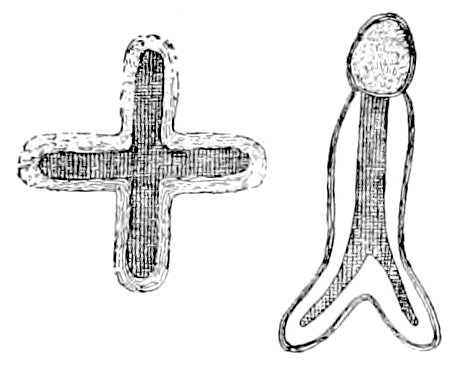
One of the most extensive groupings, and probably the most elaborately drawn, is in the Carisa plain, near Mr. Oreña’s ranch, 60 or 70 miles due north of Santa Barbara. The most conspicuous figure is that of the sun, resembling a human face, with ornamental appendages at the cardinal points, and bearing striking resemblance to some Moki masks and pictographic work. Serpentine lines and anomalous forms also abound.
Four miles northeast of Santa Barbara, near the residence of Mr. Stevens, is an isolated sandstone bowlder measuring about 20 feet high and 30 feet in diameter, upon the western side of which is a slight cavity bearing designs shown in Fig. 29, which correspond in general form to others in Santa Barbara county. The gesture for negation appears in the attitude of the human figures.
Half a mile farther east, on Dr. Coe’s farm, is another smaller bowlder, in a cavity of which various engravings appear shown in Fig. 30. Parts of the drawings have disappeared through disintegration of the rock, which is called “Pulpit rock,” on account of the shape of the[69] cavity, its position at the side of the narrow valley, and the echo observed upon speaking a little above the ordinary tone of voice.
Painted rocks also occur in the Azuza canyon, about 30 miles northeast of Los Angeles, of which Fig. 31 gives copies.
Just before his departure from the Santa Barbara region, Dr. Hoffman was informed of the existence of eight or nine painted records in that neighborhood, which up to that time had been observed only by a few sheep-herders and hunters.
Mr. L. L. Frost, of Susanville, California, reports the occurrence of pictographs (undoubtedly petroglyphs) 15 miles south of that town, on Willow creek, and at Milford, in the lower end of the valley. No details were furnished as to their general type and condition.
On Porter creek, 9 miles southwest of Healdsburg, on a large bowlder of hornblende syenite, petroglyphs similar to those found in Arizona and Nevada are to be seen. They are generally oblong circles or ovals, some of which contain crosses.
Figs. 32 and 33 are reduced copies 1/32 of original size of colored petroglyphs found by Dr. Hoffman in September, 1884, 12 miles west-northwest of the city of Santa Barbara, California. The locality is almost at the summit of the Santa Ynez range of mountains; the gray sandstone[70] rock on which they are painted is about 30 feet high and projects from a ridge so as to form a very marked promontory extending into a narrow mountain canyon. At the base of the western side of this bowlder is a rounded cavity, measuring on the inside about 15 feet in width and 8 feet in height. The floor ascends rapidly toward the back of the cave, and the entrance is rather smaller in dimensions than the above measurements of the interior. About 40 yards west of this rock is a fine spring of water. One of the four old Indian trails leading northward across the mountains passes by this locality, and it is probable that this was one of the camping places of the tribe which came south to trade, and that some of its members were the authors of the paintings. The three trails beside the one just mentioned cross the mountains at several points east of this, the most distant being about 15 miles. Other trails were known, but these four were most direct to the immediate vicinity of the Spanish settlement which sprang up shortly after the establishment of the Santa Barbara mission in 1786. The appearance and position of these and other pictographs in the vicinity appear to be connected with the several trails. The colors used in the paintings are red and black.
The circles figured in b and d of Fig. 32, and c, r, and w of Fig. 33, together with other similar circular marks bearing cross lines upon the interior, were at first unintelligible, as their forms among various tribes have very different signification. The character in Fig. 32, above and projecting from d, resembles the human form, with curious lateral bands of black and white, alternately. Two similar characters appear, also, in Fig. 33, a, b. In a the lines from the head would seem to indicate a superior rank or condition of the person depicted.
At the private ethnologic collection of Mr. A. F. Coronel, of Los Angeles, California, Dr. Hoffman discovered a clue to the general import of the above petroglyphs, as well as the signification of some of their characters. In a collection of colored illustrations of old Mexican costumes he found blankets bearing borders and colors nearly identical with those shown in the circles in Fig. 32, d, and Fig. 33, c, r, w. It is probable that the circles represent bales of blankets which early became articles of trade at the Santa Barbara mission. If this supposition is correct, the cross lines would seem to represent the cords used in tying the blankets into bales, which same cross lines appear as cords in l, Fig. 33. Mr. Coronel also possesses small figures of Mexicans, of various conditions of life, costumes, trades, and professions, one of which, a painted statuette, is a representation of a Mexican lying down flat upon an outspread serape, similar in color and form to the black and white bands shown in the upper figure of d, Fig. 32, and a, b, of Fig. 33, and instantly suggesting the explanation of those figures. Upon the latter the continuity of the black and white bands is broken, as the human figures are probably intended to be in front, or on top, of the drawings of the blankets.
The small statuette above mentioned is that of a Mexican trader, and if the circles in the petroglyphs are considered to represent bales of blankets, the character in Fig. 32, d, is still more interesting, from the union of one of these circles with a character representing the trader, i. e., the man possessing the bales. Bales, or what appear to be bales, are represented to the top and right of the circle in d, in that figure. In Fig. 33, l, a bale is upon the back of what appears to be a horse, led in[72] an upward direction by an Indian whose headdress and ends of the breechcloth are visible. To the right of the bale are three short lines, evidently showing the knot or ends of the cords used in tying a bale of blankets without colors, therefore of less importance, or of other goods. Other human forms appear in the attitude of making gestures, one also in j, Fig. 33, probably carrying a bale of goods. In the same figure u represents a centipede, an insect found occasionally south of the mountains, but reported as extremely rare in the immediate northern regions. For remarks upon x in the same figure see Chapter XX, Section 2, under the heading The Cross.
Mr. Coronel stated that when he first settled in Los Angeles, in 1843, the Indians living north of the San Fernando mountains manufactured blankets of the fur and hair of animals, showing transverse bands of black and white similar to those depicted, which were sold to the inhabitants of the valley of Los Angeles and to Indians who transported them to other tribes.
It is probable that the pictographs are intended to represent the salient features of a trading expedition from the north. The ceiling of the cavity found between the paintings represented in the two figures has disappeared, owing to disintegration, thus leaving a blank about 4 feet long, and 6 feet from the top to the bottom between the paintings as now presented.
Petroglyphs are reported by Mr. Cyrus F. Newcomb as found upon cliffs on Rock creek, 15 miles from Rio Del Norte, Colorado. Three small photographs, submitted with this statement, indicate the characters to have been pecked; they consist of men on horseback, cross-shaped human figures, animals, and other designs greatly resembling those found in the country of the Shoshonean tribes, examples of which are given infra.
Another notice of the same general locality is made by Capt. E. L. Berthoud (a) as follows:
The place is 20 miles southeast of Rio Del Norte, at the entrance of the canyon of the Piedra Pintada (Painted rock) creek. The carvings are found on the right of the canyon or valley and upon volcanic rocks. They bear the marks of age and are cut in, not painted, as is still done by the Utes everywhere. They are found for a quarter of a mile along the north wall of the canyon, on the ranches of W. M. Maguire and F. T. Hudson, and consist of all manner of pictures, symbols, and hieroglyphics done by artists whose memory even tradition does not now preserve. The fact that these are carvings done upon such hard rock invests them with additional interest, as they are quite distinct from the carvings I saw in New Mexico and Arizona on soft sandstone. Though some of them are evidently of much greater antiquity than others, yet all are ancient, the Utes admitting them to have been old when their fathers conquered the country.
Mr. Charles D. Wright, of Durango, Colorado, in a communication dated February 20, 1885, gives an account of some “hieroglyphs” on[73] rocks and upon the walls of cliff houses near the boundary line between Colorado and New Mexico. He says:
The following were painted in red and black paints on the wall (apparently the natural rock wall) of a cliff house: At the head was a chief on his horse, armed with spear and lance and wearing a pointed hat and robe; behind this character were some twenty characters representing people on horses lassoing horses, etc. In fact the whole scene represented breaking camp and leaving in a hurry. The whole painting measured about 12 by 16 feet.
Mr. Wright further reports characters on rocks near the San Juan river. Four characters represent men as if in the act of taking an obligation, hands extended, and wearing a “kind of monogram on breast, and at their right are some hieroglyphics written in black paint covering a space 3 by 4 feet.”
The best discussed and probably the most interesting of the petroglyphs in the region are described and illustrated by Mr. W. H. Holmes (a), of the Bureau of Ethnology. The illustrations are here reproduced in Figs. 34 to 37, and the remarks of Mr. Holmes, slightly condensed, are as follows:
The forms reproduced in Fig. 34 occur on the Rio Mancos, near the group of cliff houses. They are chipped into the rock evidently by some very hard implement and rudely represent the human figure. They are certainly not attempts to represent nature, but have the appearance rather of arbitrary forms, designed to symbolize some imaginary being.
The forms shown in Fig. 35 were found in the same locality, not engraved, but painted in red and white clay upon the smooth rocks. These were certainly done by the cliff-builders, and probably while the houses were in process of construction, since the material used is identical with the plaster of the houses. The sketches and[74] notes were made by Mr. Brandegee. The reproduction is approximately one-twelfth the size of the original.
The examples shown in Fig. 36 occur on the Rio San Juan about 10 miles below the mouth of the Rio La Plata and are actually in New Mexico. A low line of bluffs, composed of light-colored massive sandstones that break down in great smooth-faced blocks, rises from the river level and sweeps around toward the north. Each of these great blocks has offered a very tempting tablet to the graver of the primitive artist, and many of them contain curious and interesting inscriptions. Drawings were made of such of these as the limited time at my disposal would permit. They are all engraved or cut into the face of the rock, and the whole body of each figure has generally been chipped out, frequently to the depth of one-fourth or one-half of an inch.
The work on some of the larger groups has been one of immense labor, and must owe its completion to strong and enduring motives. With a very few exceptions the engraving bears undoubted evidence of age. Such new figures as occur are quite easily distinguished both by the freshness of the chipped surfaces and by the designs themselves. The curious designs given in the final group have a very perceptible resemblance to many of the figures used in the embellishment of pottery.
The most striking group observed is given in Fig. 37 A, same locality. It consists of a great procession of men, birds, beasts, and fanciful figures. The whole picture as placed upon a rock is highly spirited and the idea of a general movement toward the right, skillfully portrayed. A pair of winged figures hover about the train as if[75] to watch, or direct its movements; behind these are a number of odd figures, followed by an antlered animal resembling a deer, which seems to be drawing a notched sledge containing two figures of men. The figures forming the main body of the procession appear to be tied together in a continuous line, and in form resemble one living creature about as little as another. Many of the smaller figures above and below are certainly intended to represent dogs, while a number of men are stationed about here and there as if to keep the procession in order.
As to the importance of the event recorded in this picture, no conclusions can be drawn; it may represent the migration of a tribe or family or the trophies of a victory. A number of figures are wanting in the drawing at the left, while some of those at the right may not belong properly to the main group. The reduction is, approximately, to one-twelfth.
Designs B and C of the same figure represent only the more distinct portions of two other groups. The complication of figures is so great that a number of hours would have been necessary for their delineation, and an attempt to analyze them here would be fruitless.
It will be noticed that the last two petroglyphs are in New Mexico, but they are so near the border of Colorado and so connected with the series in that state that they are presented under the same heading.
The following account is extracted from Rafn’s Antiquitates Americanæ (a):
In the year 1789 Doctor Ezra Stiles, D. D., visited a rock situated in the Township of Kent in the State of Connecticut, at a place called Scaticook, by the Indians. He thus describes it: “Over against Scaticook and about one hundred rods East of Housatonic River, is an eminence or elevation which is called Cobble Hill. On the top of this stands the rock charged with antique unknown characters. This rock is by itself and not a portion of the Mountains; it is of White Flint; ranges North and South; is from twelve to fourteen feet long; and from eight to ten wide at base and top; and of an uneven surface. On the top I did not perceive any characters; but the sides all around are irregularly charged with unknown characters, made not indeed with the incision of a chisel, yet most certainly with an iron tool, and that by[76] pecks or picking, after the manner of the Dighton Rock. The Lacunae or excavations are from a quarter to an inch wide; and from one tenth to two tenths of an inch deep. The engraving did not appear to be recent or new, but very old.”
Charles C. Jones, jr., (a) describes a petroglyph in Georgia as follows:
In Forsyth county, Georgia, is a carved or incised bowlder of fine grained granite, about 9 feet long, 4 feet 6 inches high, and 3 feet broad at its widest point. The figures are cut in the bowlder from one-half to three-fourths of an inch deep. It is generally believed that they are the work of the Cherokees.
The illustration given by him is here reproduced in Fig. 38. It will be noted that the characters in it are chiefly circles, including plain, nucleated, and concentric, sometimes two or more being joined by straight lines, forming what is now known as the “spectacle shaped” figure. The illustrations should be compared with the many others presented in this paper under the heading of Cup Sculptures, see Chapter V, infra.
Dr. M. F. Stephenson (a) mentions sculptures of human feet, various animals, bear tracks, etc., in Enchanted mountain, Union county, Georgia. The whole number of sculptures is reported as one hundred and forty-six.
Mr. Jones (b) gives a different résumé of the objects depicted, as follows:
Upon the Enchanted mountain, in Union county, cut in plutonic rock, are the tracks of men, women, children, deer, bears, bisons, turkeys, and terrapins, and the outlines of a snake, of two deer, and of a human hand. These sculptures—so far as they have been ascertained and counted—number one hundred and thirty-six. The most extravagant among them is that known as the footprint of the “Great Warrior.” It measures 18 inches in length and has six toes. The other human tracks and those of the animals are delineated with commendable fidelity.
Mr. G. K. Gilbert, of the U. S. Geological Survey, has furnished a small collection of drawings of Shoshonean petroglyphs from Oneida, Idaho, shown in Fig. 39. Some of them appear to be totemic characters, and possibly were made to record the names of visitors to the locality.
Mr. Willard D. Johnson, of the U. S. Geological Survey, reports pictographic remains observed by him near Oneida, Idaho, in 1879. The figures represent human beings and were on a rock of basalt.
A copy of another petroglyph found in Idaho appears in Fig. 1092, infra.
Petroglyphs are reported by Mr. John Criley as occurring near Ava, Jackson county, Illinois. The outlines of the characters observed by him were drawn from memory and submitted to Mr. Charles S. Mason, of Toledo, Ohio, through whom they were furnished to the Bureau of Ethnology. Little reliance can be placed upon the accuracy of such drawing, but from the general appearance of the sketches the originals of which they are copies were probably made by one of the middle Algonquian tribes of Indians.
The “Piasa” rock, as it is generally designated, was referred to by the missionary explorer Marquette in 1675. Its situation was immediately above the city of Alton, Illinois.
Marquette’s remarks are translated by Dr. Francis Parkman (a) as follows:
On the flat face of a high rock were painted, in red, black, and green, a pair of monsters, each “as large as a calf, with horns like a deer, red eyes, a beard like a tiger, and a frightful expression of countenance. The face is something like that of a man, the body covered with scales; and the tail so long that it passes entirely round the body, over the head, and between the legs, ending like that of a fish.”
Another version, by Davidson and Struvé (a), of the discovery of the petroglyph is as follows:
Again they (Joliet and Marquette) were floating on the broad bosom of the unknown stream. Passing the mouth of the Illinois, they soon fell into the shadow of a tall promontory, and with great astonishment beheld the representation of two monsters painted on its lofty limestone front. According to Marquette, each of these frightful figures had the face of a man, the horns of a deer, the beard of a tiger, and the tail of a fish so long that it passed around the body, over the head, and between the legs. It was an object of Indian worship and greatly impressed the mind of the pious missionary with the necessity of substituting for this monstrous idolatry the worship of the true God.
A footnote connected with the foregoing quotation gives the following description of the same rock:
Near the mouth of the Piasa creek, on the bluff, there is a smooth rock in a cavernous cleft, under an overhanging cliff, on whose face, 50 feet from the base, are painted some ancient pictures or hieroglyphics, of great interest to the curious. They are placed in a horizontal line from east to west, representing men, plants, and animals. The paintings, though protected from dampness and storms, are in great part destroyed, marred by portions of the rock becoming detached and falling down.
Mr. McAdams (a), of Alton, Illinois, says “The name Piasa is Indian and signifies, in the Illini, ‘The bird which devours men.’” He furnishes a spirited pen-and-ink sketch, 12 by 15 inches in size and purporting to represent the ancient painting described by Marquette. On the picture is inscribed the following in ink: “Made by Wm. Dennis, April 3d, 1825.” The date is in both letters and figures. On the top of the picture in large letters are the two words, “FLYING DRAGON.” This picture, which has been kept in the old Gilham family of Madison county and bears the evidence of its age, is reproduced as Fig. 40.
He also publishes another representation (Fig. 41) with the following remarks:
One of the most satisfactory pictures of the Piasa we have ever seen is in an old German publication entitled “The Valley of the Mississippi Illustrated. Eighty[79] illustrations from nature, by H. Lewis, from the Falls of St. Anthony to the Gulf of Mexico,” published about the year 1839 by Arenz & Co., Düsseldorf, Germany. One of the large full-page plates in this work gives a fine view of the bluff at Alton, with the figure of the Piasa on the face of the rock. It is represented to have been taken on the spot by artists from Germany. We reproduce that part of the bluff (the whole picture being too large for this work) which shows the pictographs. In the German picture there is shown just behind the rather dim outlines of the second face a ragged crevice, as though of a fracture. Part of the bluff’s face might have fallen and thus nearly destroyed one of the monsters, for in later years writers speak of but one figure. The whole face of the bluff was quarried away in 1846-’47.
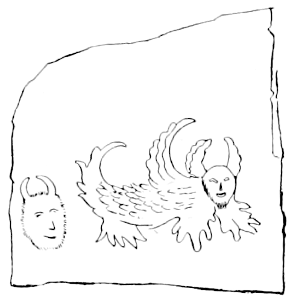
Under Myths and Mythic Animals, Chapter XIV, Section 2, are illustrations and descriptions which should be compared with these accounts, and Chapter XXII gives other examples of errors and discrepancies in the description and copying of petroglyphs.
Mr. A. D. Jones (a) says of the same petroglyph:
After the distribution of firearms among the Indians, bullets were substituted for arrows, and even to this day no savage presumes to pass the spot without discharging his rifle and raising his shout of triumph. I visited the spot in June (1838) and examined the image and the ten thousand bullet marks on the cliff seemed to corroborate the tradition related to me in the neighborhood.
Mr. McAdams, loc. cit., also reports regarding Fig. 42:
Some twenty-five or thirty miles above the mouth of the Illinois river, on the west bank of that stream, high up on the smooth face of an overhanging cliff, is another interesting pictograph sculptured deeply in the hard rock. It remains to-day probably[80] in nearly the same condition it was when the French voyagers first descended the river and got their first view of the Mississippi. The animal-like body, with the human head, is carved in the rock in outline. The huge eyes are depressions like saucers, an inch or more in depth, and the outline of the body has been scooped out in the same way; also the mouth.
The figure of the archer with the drawn bow, however, is painted, or rather stained with a reddish brown pigment, over the sculptured outline of the monster’s face.
Mr. McAdams suggests that the painted figure of the human form with the bow and arrows was made later than the sculpture.
The same author (b) says, describing Fig. 43:
Some 3 or 4 miles above Alton, high up beneath the overhanging cliff, which forms a sort of cave shelter on the smooth face of a thick ledge of rock, is a series of paintings, twelve in number. They are painted or rather stained in the rock with a reddish brown pigment that seems to defy the tooth of time. It may be said, however, that their position is so sheltered that they remain almost perfectly dry. We made sketches of them some thirty years ago and on a recent visit could see that they had changed but little, although their appearance denotes great age.
These pictographs are situated on the cliff more than a hundred feet above the river. A protruding ledge, which is easily reached from a hollow in the bluff, leads to the cavernous place in the rock.
Mr. James D. Middleton, formerly of the Bureau of Ethnology, mentions the occurrence of petroglyphs on the bluffs of the Mississippi river, in Jackson county, about 12 miles below Rockwood. Also of others about 4 or 5 miles from Prairie du Rocher, near the Mississippi river.
Mr. P. W. Norris, of the Bureau of Ethnology, found numerous caves on the banks of the Mississippi river, in northeastern Iowa, 4 miles south of New Albion, containing incised petroglyphs. Fifteen miles south of this locality paintings occur on the cliffs. He also discovered painted characters upon the cliffs on the Mississippi river, 19 miles below New Albion.
Mr. Edward Miller reports in Proceedings of the American Philosophical Society, vol. X, 1869, p. 383, the discovery of a petroglyph near the line of the Union Pacific railroad, 15 miles southeast of Fort Harker, formerly known as Fort Ellsworth, Kansas. The petroglyph is upon a formation belonging to No. 1, Lower Cretaceous group, according to the classification of Meek and Hayden.
The parts of the two plates VII and VIII of the work cited, which bear the inscriptions, are now presented as Fig. 44, being from two views of the same rock.
Mr. James D. Middleton, formerly of the Bureau of Ethnology, in a letter dated August 14, 1886, reports that at a point in Union county, Kentucky, nearly opposite Shawneetown, Illinois, petroglyphs are found, and from the description given by him they appear to resemble those in Jackson county, Illinois, mentioned above.
Mr. W. E. Barton, of Wellington, Ohio, in a communication dated October 4, 1890, writes as follows:
At Clover Bottom, Kentucky, on a spur of the Big Hill, in Jackson county, about 13 miles from Berea, is a large rock which old settlers say was covered with soil and vegetation within their memory. Upon it are representations of human tracks, with what appear to be those of a bear, a horse, and a dog. These are all in the same direction, as though a man leading a horse, followed the dog upon the bear’s track. Crossing these is a series of tracks of another and larger sort which I can not attempt to identify. The stone is a sandstone in the subcarboniferous. As I remember, the strata are nearly horizontal, but erosion has made the surface a slope of about 20°. The tracks ascending the slope cross the strata. I have not seen them for some years.
The crossing of the strata shows that the tracks are the work of human hands, if indeed it were not preposterous to think of anything else in rocks of that period. Still the tracks are so well made that one is tempted to ask if they can be real. They alternate right and left, though the erosion and travel have worn out some of the left tracks. A wagon road passes over the rock and was the cause of the present exposure of the stone. It can be readily found a fourth of a mile or less from the Pine Grove schoolhouse.
A number of inscribed rocks have been found in Maine and information of others has been obtained. The most interesting of them and the largest group series yet discovered in New England is shown in Pl. XII.
The rock upon which the glyphs appear is in the town of Machiasport, Maine, at Clarks point, on the northwestern side of Machias bay,[82] 2 miles below the mouth of Machias river. The rock or ledge is about 50 feet long from east to west and about fifteen feet in width, nearly horizontal for two-thirds its length, from the bank or western end at high water, thence inclining at an angle of 15° to low-water mark. Its southern face is inclined about 40°. The formation is schistose slate, having a transverse vein of trap dike extending nearly across its section. Nearly the entire ledge is of blue-black color, very dense and hard except at the upper or western end, where the periodical formation of ice has scaled off thin layers of surface and destroyed many figures which are remembered by persons now living. The ebb and flow of tides, the abrasion of moving beach stones or pebble wash and of ice-worn bowlders, have also effaced many figures along the southern side, until now but one or two indentations are discernible. Visitors, in seeking to remove some portion of the rock as a curiosity or in striving to perpetuate their initials, have obscured several of the most interesting, and until recently the best defined figures. It was also evident to the present writer, who carefully examined the rock in 1888, that it lay much deeper in the water than once had been the case. At the lowest tides there were markings seen still lower, which could not readily have been made if that part of the surface had not been continuously exposed. The depression of a rock of such great size, which was so gradual that it had not been observed by the inhabitants of the neighboring settlement, is an evidence of the antiquity of the peckings.
The intaglio carving of all the figures was apparently made by repeated blows of a pointed instrument—doubtless of hard stone; not held as a chisel, but working by a repetition of hammerings or peckings. The deepest now seen is about three-eighths of an inch. The amount of patient labor bestowed upon these figures must have been great, considering the hardness of the rock and the rude implement with which they were wrought.
There is no extrinsic evidence of their age. The place was known to traders early in the seventeenth century, and much earlier was visited by Basque fishermen, and perhaps by the unfortunate Cortereals in 1500 and 1503. The descendants of the Mechises Indians, a tribal branch of the Abnaki, who once occupied the territory between the St. Croix and Narraguagus rivers, when questioned many years ago, would reply in substance that “all their old men knew of them,” either by having seen them or by traditions handed down through many generations.
Several years ago Mr. H. R. Taylor, of Machias, who made the original sketch in 1868 and kindly furnished it to the Bureau of Ethnology, applied to a resident Indian there (Peter Benoit, then nearly 80 years old) for assistance in deciphering the characters. He gave little information, but pointed out that the figures must not all be read “from one side only,” thus, the one near the center of the sketch, which seen from the south was without significance, became from the opposite[83] point a squaw with sea fowl on her head, denoting, as he said, “that squaw had smashed canoe, saved beaver-skin, walked one-half moon all alone toward east, just same as heron wading alongshore.” Also that the three lines below the figure mentioned, which together resemble a bird track or a trident, represent the three rivers, the East, West, and Middle rivers of Machias, which join not far above the locality. The mark having a rough resemblance to a feather, next on the right of this river-sign, is a fissure in the rock. Most of the figures of human beings and other animals are easily recognizable.
Peckings of a character similar to those on the Picture rock at Clarks point, above described, were found and copied 600 feet south of it at high-water mark on a rock near Birch point. Others were discovered and traced on a rock on Hog island, in Holmes bay, a part of Machias bay. All these petroglyphs were without doubt of Abnaki origin, either of the Penobscot or the Passamaquoddy divisions of that body of Indians. The rocks lay on the common line of water communication between those divisions and were convenient as halting places.
In the Susquehanna river, about half a mile south of the state line, is a group of rocks, several of the most conspicuous being designated as the “Bald Friars.” Near by are several mound-shaped bowlders of the so-called “nigger-head” rock, which is reported as a dark-greenish chlorite schist. Upon the several bowlders are deep sculpturings, apparently finished by rubbing the depression with stone, or wood and sand, thus leaving sharp and distinct edges to the outlines. Some of these figures are an inch in depth, though the greater number are becoming more and more eroded by the frequent freshets, and by the running ice during the breaking up in early spring of the frozen river.
The following account is given by Prof. P. Frazer (a):
Passing the Pennsylvania state line one reaches the southern barren serpentine rocks, which are in general tolerably level for a considerable distance.
About 700 yards, or 640 meters, south of the line, on the river shore, are rocks which have been named the Bald Friars. French’s tavern is here, at the mouth of a small stream which empties into the Susquehanna. About 874 yards (800 meters) south of this tavern are a number of islands which have local names, but which are curious as containing inscriptions of the aborigines.
The material of which most of these islands are composed is chlorite schist, but as this rock is almost always distinguished by the quartz veins which intersect it, so in this case some of the islands are composed of this material almost exclusively, which gives them a very striking white appearance.
One of these, containing the principal inscriptions, is called Miles island.
The figures, which covered every part of the rocks that were exposed, were apparently of historical or at least narrative purport, since they seemed to be connected. Doubtless the larger portion of the inscription has been carried away by the successive vicissitudes which have broken up and defaced, and in some instances obliterated, parts of which we find evidence of the previous existence on the islands.
Every large bowlder seems to contain some traces of previous inscription, and in many instances the pictured side of the bowlder is on its under side, showing that it has been detached from its original place. The natural agencies are quite sufficient to account for any amount of this kind of displacement, for the rocks in their present condition are not refractory and offer no great resistance to the wear of weather and ice; but in addition to this must be added human agencies.
Amongst other things, they represent the conventional Indian serpent’s head, with varying numbers of lines.
Some of the signs next frequently recurring were concentric circles, in some cases four and in other cases a lesser number.
Fig. 45 is a reproduction of Prof. Frazer’s illustration.
This region was also referred to by Dr. Charles Rau (a), his cut from the specimen in the collection of the Smithsonian Institution (Mus. No. 39010) being here reproduced as Fig. 46.
During the autumn of the years 1888 and 1889 Dr. Hoffman visited these rocks, securing sketches and measurements, the former of which are reproduced in Figs. 47 and 48. The figures are deeply cut, as if rubbed down with sand and a round stick of green wood. The deepest channels, varying from three-fourths to 1¼ inches across and almost as deep as they are wide, appear as if cut out with a gouge, and for this reason bear a strong resemblance to the petroglyphs in Owens valley, California. In whatever manner these sculpturings were made, it is[85] evident that much time and great labor were expended upon them, as this variety of rock, locally termed “Nigger-head,” is extremely hard.
Fig. 45 represents a bird’s-eye view of the top of the rock, bearing the greater amount of workmanship. The petroglyphs cover a surface measuring about 5 feet by 4 feet 6 inches. The extreme ends of the figures extend beyond the irregular horizontal surface and project over the rounded edge of the rock, so that the line, at the left-hand lower part of the illustration, dips at an angle of about 45°. The two short lines at the extreme right are upon the side of the upper edge of the rock, where the surface inclines at an angle of 30°.
Some of the figures are indefinite, which is readily accounted for by the fact that the rock is in the river, a considerable distance from shore, and annually subjected to freshets and to erosion by floating logs and drift material. The characters at the right end of the upper row resemble those near Washington, Lancaster county, Pennsylvania. (See Fig. 73.)
Fig. 48 presents three characters, selected from other portions of the rock, to illustrate the variety of designs found. They are like some found at Owens valley, California, as will be observed by comparing them with the descriptions and plates under that heading in this section. The left-hand figure is 4 inches in diameter, the middle one 6 inches wide and about 15 inches in height, and the third, or right-hand, is composed of concentric rings, measuring about 10 inches across.
The following description of the much-discussed Dighton rock is taken from Schoolcraft (b), where it is accompanied with a plate, now reproduced as Fig. 49:
The ancient inscription on a bowlder of greenstone rock lying in the margin of the Assonet or Taunton river, in the area of ancient Vinland, was noticed by the New England colonists so early as 1680, when Dr. Danforth made a drawing of it. This outline, together with several subsequent copies of it, at different eras, reaching to 1830, all differing considerably in their details, but preserving a certain general resemblance, is presented in the Antiquatés Americanes [sic] (Tables XI, XII), and referred to the same era of Scandinavian discovery. The imperfections of the drawings (including that executed under the auspices of the Rhode Island Historical Society in 1839, Table XII), and the recognition of some characters bearing more or less resemblance to antique Roman letters and figures, may be considered to have misled Mr. Magnusen in his interpretation of it. From whatever cause, nothing could, it would seem, have been wider from the purport and true interpretation of it. It is of purely Indian origin, and is executed in the peculiar symbolic character of the Kekeewin.
A number of copies of the inscriptions on this rock, taken at different times by different persons, are given below in Chapter XXII, sec. 2, with remarks upon them.
Dr. Hoffman visited the locality in 1886, and found that the surface was becoming rapidly destroyed from the frequent use of scrubbing with broom and water to remove the film of sand and dirt which is[87] daily deposited by every tide, the rock being situated at a short distance inshore. Visitors are frequent, and the guide or ferryman does not interfere with them so long as he can show his passengers the famous inscription.
The resemblance between the characters on this rock and those found in western Pennsylvania, near Millsboro, Fig. 75, and south of Franklin, on the “Indian God rock,” Fig. 74, will be noted.
In Rafn’s Antiq. Amer. (b) is the following account:
A large stone, on which is a line of considerable length in unknown characters, has been recently found in Rutland, Worcester county, Massachusetts; they are regularly placed, and the strokes are filled with a black composition nearly as hard as the rock itself. The Committee also adds that a similar rock is to be found in Swanzy, county of Bristol and Commonwealth of Massachusetts, perhaps ten miles from the Dighton Rock.
The late Mr. P. W. Norris, who was connected with the Bureau of Ethnology, reported large numbers of pecked totemic characters on the horizontal faces of the ledges of rock at Pipestone quarry in Minnesota, and presented some imitations of the peckings. There is a tradition that it was formerly the custom for each Indian who gathered stone (catlinite) for pipes, to inscribe his totem (whether clan or tribal or personal totem is not specified) upon the rock before venturing to quarry upon this ground. Some of the cliffs in the immediate vicinity were of too hard a nature to admit of pecking or scratching, and upon these the characters were placed in colors. Mr. Norris distinguished bird tracks, the outline of a bird resembling a pelican, deer, turtle, a circle with an interior cross, and a human figure.
Examples of so-called totemic designs from this locality are given in Fig. 50, which are reproduced from the work of R. Cronau (a):
The same petroglyphs and also others at the Pipestone quarry are described and illustrated by Prof. N. H. Winchell (a). A part of his remarks is as follows:
On the glaciated surface of the quartzite about the “Three Maidens,” which is kept clean by the rebound of the winds, are a great many rude inscriptions, which were made by pecking out the rock with some sharp-pointed instrument or by the use of other pieces of quartzite. They are of different sizes and dates, the latter being evinced by their manner of crossing and interfering and by the evident difference in the weight of the instruments used. They generally represent some animal, such as the turtle, bear, wolf, buffalo, elk, and the human form. The “crane’s foot” is the most common; next is the image of men; next the turtle. It would seem as if any warrior or hunter who had been successful and happened to pass here left his tribute of thanks to the great spirit in a rude representation of his game and perhaps a figure of himself on the rocks about these bowlders, or perhaps had in a similar way invoked the good offices of the spirits of his clan when about to enter on some expedition. In some cases there is a connection of several figures by a continuous line, chipped in the surface of the rock in such a manner as if some legend or adventure were narrated, but for the most part the figures are isolated. This is the “sacred ground” of the locality. Such markings can be seen at no other place, though there is abundance of bare, smooth rock. (Similar inscriptions are found on the red[88] quartzite in Cottonwood county). The excavation of the surface of the rock is very slight, generally not exceeding a sixteenth of an inch, and sometimes only enough to leave a tracing of the designed form. The hardness of the rock was a barrier to deep sculpturing with the imperfect instruments of the aborigines; but it has effectually preserved the rude forms that were made. The fine glacial scratches that are abundantly scattered over this quartzite indicate the tenacity with which it retains all such impressions, and will warrant the assignment of any date to these inscriptions that may be called for within the human period. Yet it is probable that they date back to no very great antiquity. They pertain, at least, to the dynasty of the present Indian tribes. The totems of the turtle and the bear, which are known to have been powerful among the clans of the native races in America at the time of the earliest European knowledge of them, and which exist to this day, are the most frequent objects represented. The “crane’s foot,” or “turkey foot,” or “bird track,” terms which refer perhaps to the same totem sign—the snipe—is not only common on these rocks, but is seen among the rock inscriptions of Ohio, and was one of the totems of the Iroquois, of New York.
In June, 1892, Mr. W. H. Holmes, of the Bureau of Ethnology, visited the Pipestone quarry and took a number of tracings of the petroglyphs, which unfortunately were received too late for insertion in the present work. Some of his remarks are as follows:
The trouble with the figures copied and published by Prof. Winchell is that they are not arranged in the original order. It will now be impossible to correct this entirely, as most of the stones have been taken up and removed. * * * The Winchell drawings were evidently drawn by eye and have a very large personal equation; besides, they are mixed up while appearing to be in some order. The few groups that I was able to get are, it seems to me, of more interest than all the single figures you could put in a book. There can be little doubt that in the main this[89] great group of pictures was arranged in definite order, agreeing with the arrangements of mythical personages and positions usual in the aboriginal ceremonials of the region. It is a great pity that the original order has been destroyed, but the inroads of relic hunters and inscription cranks made it necessary to take up the stones. One large stone was taken to Minneapolis by Prof. Winchell. There are a few pieces still in place. All were near the base of one of the great granite bowlders, and it is said here that formerly, within the memory of the living, the place was visited by Indians who wished to consult the gods.
The following description is extracted from the account of Mr. James W. Lynd (b):
Numerous high bluffs and cliffs surround it; the Pipestone quarry and the alluvial flat below these, in which the quarry is situated, contains a huge bowlder that rests upon a flat rock of glistening, smooth appearance, the level of which is but a few inches above the surface of the ground. Upon the portions of this rock not covered by the bowlder above and upon bowlder itself are carved sundry wonderful figures—lizards, snakes, otters, Indian gods, rabbits with cloven feet, muskrats with human feet, and other strange and incomprehensible things—all cut into the solid granite, and not without a great deal of time and labor expended in the performance. * * *
A large party of Ehanktonwanna and Teetonwan Dakotas, says the legend, had gathered together at the quarry to dig the stone. Upon a sultry evening, just before sunset, the heavens suddenly became overclouded by a heavy rumbling thunder and every sign of an approaching storm, such as frequently arises on the prairie without[90] much warning. Each one hurried to his lodge, expecting a storm, when a vivid flash of lightning, followed immediately by a crashing peal of thunder, broke over them, and, looking towards the huge bowlder beyond their camp, they saw a pillar or column of smoke standing upon it, which moved to and fro, and gradually settled down into the outline of a huge giant, seated upon the bowlder, with one long arm extended to heaven and the other pointing down to his feet. Peal after peal of thunder, and flashes of lightning in quick succession followed, and this figure then suddenly disappeared. The next morning the Sioux went to this bowlder and found these figures and images upon it, where before there had been nothing, and ever since that the place has been regarded as wakan or sacred.
Mr. T. H. Lewis (b) gives a description of Fig. 51.
This bowlder is in the edge of the public park, on the north end of the plateau at Brown’s valley, Minnesota. The bowlder has a flat surface with a western exposure, is irregular in outline, and is about 5 feet 8 inches in diameter, and firmly imbedded in the terrace.
The central figure, a, undoubtedly represents a man, although the form is somewhat conventional; b represents a bird; c represents a tortoise; d is a cross and circle combined, but the circle has a groove extending from it; e, f, and g, although somewhat in the shape of crosses, probably represent bird tracks; h and i are nondescript in character, although there must be some meaning attached to them; k and l are small dots or cups cut into the bowlder.
The figures as illustrated are one-eighth of their natural size, and are also correct in their relative positions one to the other. The work is neatly done although the depth of the incisions is very slight.
Mr. Charles Hallock, of Washington, D. C., reports the occurrence of pictured rocks near Fort Assiniboin, Montana, but does not mention whether they are colored or incised, and also fails to describe the general type of the characters found.
The following (condensed) description of petroglyphs found in Dakota county, Nebraska, is furnished by Mr. J. H. Quick, of Sioux City, Iowa:
The petroglyphs are found upon the face of a sandstone cliff in a deep ravine at a point where two watercourses (dry for the most part), meet about 20 miles south of Sioux City, Iowa, but in Dakota county, in the State of Nebraska. At this point the range of bluffs which bounds the Missouri river bottom is deeply cut through by the above-mentioned ravine, which runs in a northerly direction towards the Missouri. Another ravine coming from the southwest leaves this narrow point of land between the two ravines, rising to a height of 50 to 75 feet above the bottom of the ravines. For some distance from the point this cape, if I may so term it, shows ledges of sandstone cropping out on both sides. And exactly at the point and for some rods back on the east side are found the pictographs under consideration.
The rocks are of two kinds, a few feet of hard jasperous sandstone superimposed on about the same thickness of sandstone so soft that it can be crumbled to pieces in the fingers. The lower soft strata have been worn away, leaving the upper harder layers jutting out to a distance of several feet over and completely sheltering them. And on the smooth surface of these lower soft strata, protected by the overhanging ledge above, shut in by bluffs 200 feet high on the east and sheltered from the winds by dense underwood and scrubby forest trees, are carved these pictographs. These safeguards, combined with the advantage of a very secluded situation, have combined to preserve them, very little marred by careless and mischievous hands.
The eagle or “thunder-bird” figures are quite numerous. There are also many of the “buffalo track” and of the “turkey track” figures. I call them “turkey tracks” because they all show a spur and seem to represent some of the large gallinaciæ.
In one of the groups, which I will call the “bear-fight group,” we are at a loss to determine whether the figure of the small animal was a part of the original design or a subsequent interpolation. It seemed genuine, but was not so deeply carved as the other figures. The same may be said of the diagonal bars across the figure of the bear.
In the other group, which I will term the “turkey-track group,” there are some figures of which we could not even imagine the meaning. But they are undoubtedly genuine, and seem to belong to the same design as the other figure.
The “bear-track” figures are very numerous and of several different sizes. A cat-like figure, which we call a panther, shows faintly. It is about effaced by time. Other figures reminded us of a crab or crawfish, but we were unable to determine whether the line running back just below belongs to it or not.
I am informed by the same gentleman who saw these petroglyphs in 1857 that there were at one time many more some 3 or 4 miles from this place, near Homer, Nebraska, in the vicinity of a large spring, but he also said that as it is a favorite picnic ground for the country people the carvings are probably destroyed. I presume others may be found in these bluffs.
I surmise that the almost cave-like nature of the place where the carvings I have above attempted to describe are situated rendered it a favorite camping ground and resting place; and also that the ravines above mentioned made easy trails from the Missouri bottom up to the higher grounds farther from the river, because it obviated the ascent of the very steep bluffs.
The Winnebago Indian reservation is a few miles south of this locality, but they were placed here by the Government as late as from 1860 to 1865. Previous to that time I think this ground was occupied by the Omahas. I have been unable to gain any information as to the Indians who carved these figures or as to their meaning.
The most instructive of the petroglyphs, copies of which are kindly furnished by Mr. Quick, is presented as Pl. XIII, and selected sketches from that and the other petroglyphs copied are shown as Figs. 52 and 53.
Frank La Flèche, of the Bureau of Indian Affairs, in February, 1886, communicated the following:
Ingnanχe gikáχa-ina is the Omaha name of a rock ledge on the banks of the Missouri river, near the Santee agency, Nebraska. This ledge contains pictographs of[92] men who passed to the happy hunting grounds, of life size, the sandstone being so soft that the engravings would be made with a piece of wood. They are represented with the special cause (arrow, gun, etc.), which sped them to hades. The souls themselves are said to make these pictographs before repairing “to the spirits.”
Rev. J. Owen Dorsey, of the Bureau of Ethnology, says that the probable rendering of the term when corrected is, “Spirit(s) they-made-themselves the (place where).”
Petroglyphs have been found by members of the U. S. Geological Survey at the lower extremity of Pyramid lake, Nevada, though no accurate reproductions are available. These characters are mentioned as incised upon the surface of basalt rocks.
Petroglyphs also occur in considerable numbers on the western slope of Lone Butte, in the Carson desert. All of these appear to have been produced on the faces of bowlders and rocks by pecking and scratching with some hard mineral material like quartz.
A communication from Mr. R. L. Fulton, of Reno, Nevada, tells that the drawing now reproduced as Fig. 54 is a pencil sketch of curious petroglyphs on a rock on the Carson river, about 8 miles below old[93] Fort Churchill. It is the largest and most important one of a group of similar characters. It is basaltic, about 4 feet high and equally broad.
Mr. Fulton gives the following description:
The rock spoken of has an oblong hole about 2 inches by 4 and 16 inches deep at the left end, which has been chipped out before the lines were drawn, if it was not some form of the ancient mill which is so common, as it seems to be the starting point for the whole scheme of the artist. The rock lies with a broad, smooth top face at an angle towards the south, and its top and southeast side are covered with lines and marks that convey to the present generation no intelligence whatever, so far as I can learn.
A line half an inch wide starts at the hole on the left and sweeping downward forms a sort of border for the work until it reaches midway of the rock, when it suddenly turns up and mingles with the hieroglyphics above. Two or three similar lines cross at the top of the stone, and one runs across and turns along the north side, losing itself in a coating of moss that seems as hard and dry and old as the stone itself. From the line at the bottom a few scallopy looking marks hang that may be a part of the picture, or it may be a fringe or ornament. The figures are not pictures of any animal, bird, or reptile, but seem to be made up of all known forms and are connected by wavy, snake-like lines. Something which might be taken for a dog with a round and characterless head at each end of the body, looking towards you, occupies a place near the lower line. The features are all plain enough. A deer’s head is joined to a patchwork that has something that might be taken for 4 legs beneath it. Bird’s claws show up in two or three places, but no bird is near them. Snaky figures run promiscuously through the whole thing. A circle at the right end has spokes joining at the center which run out and lose themselves in the maze outside.
The best known and largest collection of marks that I know of covers a large smooth ledge at Hopkins Soda Springs, 12 miles south of the summit on the Central Pacific railroad. The rock is much the same in character as those I have described, but the groundwork in this case is a solid ledge 10 feet one way and perhaps 40 the other, all closely covered with rude characters, many of which seem to point to human figures, animals, reptiles, etc. The ledge lies at an angle of 45°, and must have been a tempting place for a lazy artist who chanced that way.
Many other places on the Truckee river have such rocks all very much alike, and yet each bearing its own distinct features in the marking. Near a rock half a mile east of Verdi, a station on the Central Pacific railroad, 10 miles east of Reno, lie two others, the larger of which has lines originating in a hole at the upper right-hand corner, all running in tangents and angles, making a double-ended kind of an arrangement of many-headed arrows, pointing three ways. A snail-like scroll lies between the two arms, but does not touch them. Below are blotches, as if the artist had tried his tools.
This region has been roamed over by the Washoe Indians from a remote period, but none of them know anything of these works. One who has gray hair and more wrinkles than hairs, who is bent with age and who is said to be a hundred years old, was led to the spot. He said he saw them a heap long time ago, when he was only a few summers old, and they looked then just as they do now.
Mr. Lovejoy, a well-known newspaper man, took up, in 1854, the ranche where the rocks lie, and said just before his death that they were in exactly the same condition when he first saw them as they are to-day. Others say the same, and they are certainly of a date prior to the settlement of this coast by Americans and probably by the Spanish.
They are very peculiar in many respects, and the rock is wonderfully adapted to the uses to which it has been put. Wherever the surface has been broken the color[94] has changed to gray, and no amount of wear or weather seems to turn it back. The indentation is so shallow as to be imperceptible to sight or touch, and yet the marks are as plain as they could be made, and can be seen as far as the rock can be distinguished from its fellows.
It is hardly likely that the work was done without some motive besides the simple love of doing it, and it was well and carefully done, too, showing much patience and doubtless consumed a good deal of time, as the tools were poor.
A large ledge is marked near Meadow lake in Nevada county, and in the state of Nevada the petroglyphs cover a route extending from the southeast to the northwest corner of the state, crossing the line into California in Modoc county, and leaving a string of samples clear across the Madeline plains.
Eight miles below Belmont, in Nye county, Nevada, an immense rock which at some time has fallen into the canyon from the porphyry ledge above it has a patch of marks nearly 20 feet square. It is so high that a man on horseback can not reach the top.
A number at Reveillé, in the same county, are also marked. On the road to Tybo every large rock is marked, one of the figures being a semicircle with a short vertical spoke within the curve. At Reno a heavy black rock a couple of feet across is[95] beautifully engraved to represent a bull’s eye of 4 rings, an arrow with a very large feather, and one which may mean a man. In a steep canyon 15 miles northeast of Reno, in Spanish Spring mountains, several cliffs are well marked, and an exposed ledge, where the Carson river has cut off the point of a hill below Big Bend, is covered with rings and snakes by the hundred. Several triangles, a well-formed square and compass, a woman with outstretched arms holding an olive branch, etc., are there.
Humboldt county has its share, the best being on a bluff below the old Sheba mine. Ten miles south of Pioche are about 50 figures cut into the rock, many of them designed to represent mountain sheep. Eighty miles farther south, near Kane’s Spring, the most numerous and perfect specimens of this prehistoric art are found. Men on horseback engaged in the pursuit of animals are among the most numerous, best preserved, and carefully executed.
The region I have gone over is of immense size, and must impress everyone with the importance of a set of symbols which extends in broken lines from Arizona far into Oregon.
Fig. 55 exhibits engravings at Reveillé, Nevada. Great numbers of incised characters of various kinds are also reported from the walls of rocks flanking Walker river, near Walker lake, Nevada. Waving lines, rings, and what appear to be vegetable forms are of frequent occurrence. The human form and footprints are also depicted.
Fig. 56 is a copy of a drawing made by Lieut. A. G. Tassin, Twelfth U. S. Infantry, in 1877, of an ancient rock-carving at the base and in the recesses of Dead mountain and the abode of dead bad Indians according to the Mohave mythology. This drawing and its description is from a manuscript report on the Mohave Indians, in the library of the Bureau of Ethnology, prepared by Lieut. Tassin.
He explains some of the characters as follows:
(a) Evidently the two different species of mesquite bean.
(b) Would seem to refer to the bite of the cidatus, and to the use of a certain herb for its cure.
(c) Presumably the olla or water cooler of the Mohaves.
The whole of this series of petroglyphs is regarded as being Shinumo or Moki. They show a general resemblance to drawings in Arizona, known to have been made by the Moki Indians. The locality is within the territory of the Shoshonean linguistic division, and the drawings are in all probability the work of one or more of the numerous tribes comprised within that division.
On the north wall of Canyon de Chelly, one-fourth of a mile east of its mouth, are several groups of petroglyphs, consisting chiefly of various grotesque forms of the human figure, and also numbers of animals, circles, etc. A few of them are painted black, the greater portion consisting of rather shallow lines, which are in some places considerably weathered. Further up the canyon, in the vicinity of the cliff dwellings, are numerous small groups of pictographic characters, consisting of men and animals, waving or zigzag lines, and other odd figures.
Lieut. James H. Simpson (a), in his Journal of a Military Reconnoissance, etc., presents a number of plates bearing copies of inscriptions on rocks in the northwestern part of New Mexico, among which are those on the so-called “Inscription rock” at El Moro, here reproduced as Fig. 57. The petroglyphs are selected from the south face of the rock. Lieut. Simpson states that most of the characters are no higher than a man’s head, and that some of them are undoubtedly of Indian origin.
Among the many colored etchings and paintings on rock discovered by the Pacific railroad expedition in 1853-’54, Lieut. Whipple (c) notes those at Rocky dell creek, New Mexico, which were found between the edge of the Llano Estacado and the Canadian river. The stream flows through a gorge, upon one side of which a shelving sandstone rock forms a sort of cave. The roof is covered with paintings, some evidently ancient, and beneath are innumerable carvings of footprints, animals, and symmetrical lines. He also remarks (d) that figures cut upon a rock at Arch spring, near Zuñi, present some faint similarity to those at Rocky dell creek.
Near Ojo Pescado, in the vicinity of the ruins, are petroglyphs, also reported by Lieut. Whipple (d), which are very much weather-worn and have “no trace of a modern hand about them.”
Mr. Edwin A. Hill, of Indianapolis, in a letter, notes petroglyphs on the Denver and Rio Grande railroad, between Antonite and Espanola. Below Tres Piedras and near Espanola are rude sculptures, lining the valley on both sides of the road for a long distance, at least several miles. The canyon has a slope of about 45° and contains many bowlders, and on every available face pictographs are cut. Figures of arrows, hatchets, circles, triangles, bows, spears, turtles, etc., are outlined as if with some cutting-tool. The country had two years before been occupied by Apaches, but far greater age is attributed to the petroglyphs.
Other petroglyphs actually within the geographical area of New Mexico are so near the border that they are treated of in connection with those of Colorado.
Prof. E. D. Cope (a) gives a copy of figures which he found on the side of a ravine near Abiquiu, on the river Chama. They are cut in Jurassic sandstone of medium hardness, and are quite worn and overgrown with the small lichen which is abundant on the face of the rock.
Mr. Gilbert Thompson, of the U. S. Geological Survey, reports his observation of petroglyphs at San Antonio springs, 30 miles east of Fort Wingate, New Mexico. The human figure, in various forms, occurs, as well as numerous other characters, strikingly similar to those frequent in the country farther west occupied by the Moki Indians. The peculiarity of these figures is that the outlines are incised and that the depressions thus formed are filled with red, blue or white pigments. The interior of the figures is simply painted with one or more of the same colors.
Figs. 58 and 59 are reproductions of drawings of petroglyphs from Ojo de Benado, south of Zuñi, New Mexico. The manuscripts which once accompanied them, and which were forwarded to the Bureau of[98] Ethnology in the usual official manner, have become separated from the sketches, and on those there are no indications of the collectors’ names.
The characters are very like others from several localities in the territory and in the adjacent region. The type is that of the Pueblos generally.
Mr. Bandelier, in conversation, reported having seen and sketched a petroglyph at Nambe, in a canyon about 2 miles east of the pueblo, also another at Cueva Pintada, about 17 miles by the trail northwest of Cochiti.
The following is extracted from Schoolcraft (c):
There is a pictographic Indian inscription [now obliterated] in the valley of the Hudson, above the Highlands, which from its antiquity and character appears to[99] denote the era of the introduction of firearms and gunpowder among the aboriginal tribes of that valley. This era, from the well-known historical events of the contemporaneous settlement of New Netherlands and New France, may be with general accuracy placed between the years 1609, the date of Hudson’s ascent of that stream above the Highlands, and the opening of the Indian trade with the Iroquois at the present site of Albany, by the erection of Fort Orange, in 1614. * * *
In a map published at Amsterdam, in Holland, in 1659, the country, for some distance both above and below Esopus creek, is delineated as inhabited by the Waranawankongs, who were a totemic division or enlarged family clan of the Mohikinder. They spoke a well-characterized dialect of the Mohigan, and have left numerous geographical names on the streams and physical peculiarities of that part of the river coast quite to and above Coxsackie. The language is Algonquin.
Esopus itself appears to be a word derived from Seepu, the Minsi-Algonquin name for a river.
* * * The inscription may be supposed, if the era is properly conjectured, to have been made with metallic tools. The lines are deeply and plainly impressed. It is in double lines. The plumes from the head denote a chief or man skilled in the Indian medico-magical art. The gun is held at rest in the right hand; the left appears to support a wand. [The position of the arm may be merely a gesture.]
The reproduction here as Fig. 60 is from a rock on the western bank of the Hudson, at Esopus landing. It is presented mainly on account of the frequent allusions to it in literature.
Mr. James Mooney, of the Bureau of Ethnology, reports petroglyphs upon a gray gneissoid rock, a short distance east of Caney river, on the north side of the road from Asheville to Burnsville, North Carolina. The face of the surface is at an angle of 30° toward the south, and the sculptured area covers about 10 feet square. The characters consist chiefly of cup-shaped depressions, some about 2 inches deep, some being also connected. There are a few markings which appear to have been intended to represent footprints. The characters resemble, to some extent, those at Trap Rock gap, Georgia, and at the Juttaculla rock, North Carolina, on a branch of the Tuckasegee river, above Webster.
The above-described sculptured rock is on the property of Ellis Gardner, and is known as Gardner’s, or the “Garden rock.”
Mr. Mooney also reports that at Webster, North Carolina, there is one large rock bearing numerous petroglyphs, rings, cup-shaped depressions, fish-bone patterns, etc. He further states, upon the authority of Dr. J. M. Spainhour, of Lenoir, that upon a light gray rock measuring 4 feet by 30 are numerous cup-shaped petroglyphs, he having counted 215. The rock is on the Yadkin river, 4 miles below Wilkesboro, and is at times partly under water.
Dr. Hoffman, who in 1886 visited western North Carolina, gives the following account of colored pictographs found there by him.
“The locality known as ‘Paint rock’ is situated on the east or right bank of the French Broad river, about 100 yards above the Tennessee and North Carolina state line. The limestone cliff, which terminates abruptly near the river, measures about 100 feet in height and covers[100] an area from side to side of exposure of at least 100 yards. The accompanying view (Fig. 61), taken from across the river, presents the wall of limestone rock and the position of the petroglyph, which is delineated in proper proportion nearly in the center of the illustration.
“The property belongs to Mr. J. W. Chockley, who has been living in the vicinity for about fifteen years. He states that during this time the pictograph has undergone some change on account of gradual disintegration or fracture of the rock. The first knowledge of the pictograph, according to local tradition, dates back about sixty years, and no information as to its import could be learned, either from the white residents, who are few in number, or the straggling Cherokee Indians who visit the railway station at odd intervals.”
The pictograph is peculiar in design, no animal forms being apparent but an indefinite number of short, straight lines at right angles to one another, as shown in Fig. 62. One-thirty-sixth actual size.
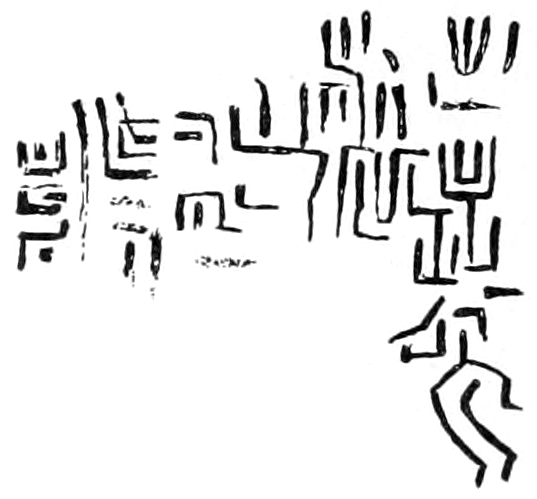
The characters are in dark red, probably a ferrous oxide, quantities of which are found in the neighborhood. The color appears to have[101] penetrated the softer portions of the limestone, though upon the harder surfaces it has been removed by exposure to the elements. The lowermost figure appears to resemble a rude outline of a human form, with one arm lowered and reaching forward, though this is only a suggestion.
Upon the face of the rock, a few yards to the right of the above, are indistinct outlines of circles, several of which indicate central spots, and one, at least, has a line extending from the center downward for about 8 inches.
A large number of petroglyphs are reported from this state. It is sufficient to present the following examples extracted, with reproduced illustrations and abbreviated descriptions, from the Report of the Committee of the State Archæological Society, published in the Report of the Ohio State Board of Centennial Managers.
Fig. 63 is a copy of the petroglyph on the Newark Track rock.
It is described in the volume cited, pages 94, 95, as follows:
The inscriptions near Newark, in Licking county, Ohio, originally covered a vertical face of conglomerate rock, 50 or 60 feet in length, by 6 and 8 feet in height. This rock is soft and, therefore, the figures are easily erased * * *. About the year 1800 it became a place where white men sought to immortalize themselves by cutting their names across the old inscription * * *.
On the rock faces and detached sandstone blocks of the banks of the Ohio river there are numerous groups of intaglios, but in them the style is quite different from those to which I have referred, and which are located in the interior. Those on the Ohio river resemble the symbolical records of the North American Indians, such as the Kelley Island stone, described in Schoolcraft by Capt. Eastman, the Dighton rock, the Big Indian rock of the Susquehanna, and the “God rock” of the Allegheny river. In those the supposed bird track is generally wanting. The large sculptured rock near Wellsville, which is only visible at low water of the Ohio, has among the figures one that is prominent on the Barnesville stones. This is the fore foot of the bear, with the outside toe distorted and set outward at right angles.
Other sculptured rocks of a similar character have been found in Fairfield, Belmont, Cuyahoga, and Lorain counties.
That the ancient bird-track character belonged to the mound-builders is evident from the fact that it is found among their works, constructed of soil on a large scale.
One of these bird-track mounds occurs in the center of the large circular inclosure near Newark, Ohio, now standing in the Licking county fair grounds. Among the characters will be noticed the human hand. In one instance the hand is open, the palm facing the observer, and in the other the hand is closed, except the index finger which points downward to the base of the cliff. Of the bird-track characters there are many varieties. There is also a character resembling a cross and another bearing some resemblance to an arrow.
Fig. 64 is an illustration of the Independence stone, which is described in the same volume, pp. 98, 99, as follows:
Great care has been taken to obtain a correct sketch of what remains of this inscription. A very rude drawing of it was published in Schoolcraft’s great work upon the Indian tribes, in 1854.
The rock here described only contains a portion of the inscription. The balance was destroyed in quarrying. The markings on the portion of the rock preserved consist of the human foot, clothed with something like a moccasin or stocking; of the naked foot; of the open hand; of round markings one in front of the great toe, of each representation of the clothed foot; the figure of a serpent, and a peculiar character which might be taken for a rude representation of a crab or crawfish, but which bears a closer resemblance to an old-fashioned spearhead used in capturing fish.
Fig. 65 is a copy of the drawings on the Track rock, near Barnesville, Belmont county, Ohio, the description of which is in the same volume, pp. 89-93.
The rude cuts of the human faces, part of the human feet, the rings, stars, serpents, and some others, are evidently works of art, as in the best of them the marks of the engraving instrument are to be seen. In all cases, whether single or in groups, the relative dimensions of the figures are preserved. The surface of this block is 8 by 11 feet.
At the south end of the petroglyphs occurs a figure of several concentric rings, a design by no means confined to Ohio. The third figure right of this resembles others in the same group, and evidently indicates the footprints of the buffalo. Human footprints are generally indicated by the pronounced toe marks, either detached as slight depressions or attached to the foot, and are thus recognized as different from bear tracks, which frequently have but slight indications of toes or perhaps claw marks, and in which also the foot is shorter or rounder. The arrow-shaped figures are no doubt intended for turkey tracks, characters common to many petroglyphs of the middle and eastern Algonquian area.
Fig. 66 gives several of the above characters enlarged from the preceding figure.
In Fig. 67, referring to another block mentioned in the same report, lying 20 feet south of the one first mentioned, there is a duplication of the characters before noted—human footprints, bear and turkey tracks, and the indication of what may be intended to represent a serpent.
Fig. 68, from p. 105 of the same volume, gives copies of sketches from the rocks near Wellsville, Ohio, with remarks as follows:
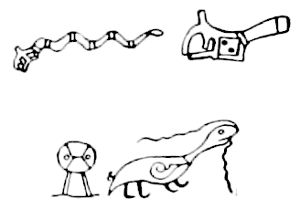
On the Ohio side of the river, 1 mile above Wellsville, there is a large group of sculptures on a flat sand rock of the coal series, scarred by floating ice and flood wood. They are only visible in low water, as they are only 2 or 3 feet above the extreme low stage of the river. * * * They are made in double outline and not by a single deep channel. The outlines are a series of dots made with a round-pointed instrument, seldom more than half an inch deep.
The upper design is a rattlesnake with a fancy head and tail. Its length is 4½ feet, a very clumsy affair, but intended for the common yellow rattlesnake of the West. The head of the snake, which occupies a space 6 inches square, is represented in the second character, which is reduced from a tracing size of nature. It brings to mind the horned snake of the Egyptians, which was an object of worship by them.
The character at the left hand of the lower line may be an uncouth representation of a demon or evil spirit. The right-hand character is probably an otter carrying a vine or string in his month.
It is more probable that the lines from the mouth of the animal indicate magic or supernatural power, of which many examples appear in this paper, as also of the device in the region of the animal’s heart, from which a line extends to the mouth. These characteristics connect the glyph with the Ojibwa drawings on bark.
Many bowlders and rock escarpments at and near the Dalles of the Columbia river, Oregon, are covered with incised or pecked glyphs.[105] Some of them are representations of human figures, but characters of other forms predominate.
Mr. Albert S. Gatschet, of the Bureau of Ethnology, reports the discovery by him, in 1878, of rock etchings 4 miles from Gaston, Oregon, and 2½ miles from the ancient settlement of the Tuálati (or Atfálati) Indians. These etchings are about 100 feet above the valley bottom on six rocks of soft sandstone, projecting from the grassy hillside of Patten’s valley, opposite Darling Smith’s farm, and are surrounded with timber on two sides.
This sandstone ledge extends for one-eighth of a mile horizontally along the hillside, upon the projecting portions of which the inscriptions are found. These rocks differ greatly in size, and slant forward so that the inscribed portions are exposed to the frequent rains of that region. The first rock, or that one nearest the mouth of the canyon, consists of horizontal zigzag lines and a detached straight line, also horizontal. On another side of the same rock is a series of oblique parallel lines. Some of the most striking characters found upon other exposed portions of the rock appear to be human figures, i. e., circles to which radiating lines are attached, and bear indications of eyes and mouth, long vertical lines running downward as if to represent the body, and terminating in a furcation, as if intended for legs, toes, etc. To the right of one figure is an arm and three-fingered hand (similar to some of the Moki characters), bent downward from the elbow, the humerus extending at a right angle from the body. Horizontal rows of short vertical lines are placed below and between some of the figures, probably numerical marks of some kind.
Other characters occur of various forms, the most striking being an arrow pointing upward, with two horizontal lines drawn across the shaft, and with vertical lines having short oblique lines attached thereto.
Mr. Gatschet remarks that the Tuálati tell a trivial story to explain the origin of these pictures, the substance of which is as follows: The Tillamuk warriors living on the Pacific coast were often at variance with the several Kalapuya tribes. One day, passing through Patten’s valley to invade the country of the Tuálati, they inquired of a woman how far they were from their camp. The woman, desirous not to betray her own countrymen, said they were yet at a distance of one (or two?) days’ travel. This made them reflect over the intended invasion, and, holding a council, they decided to withdraw. In commemoration of this the inscription, with its numeration marks, was incised by the Tuálati.
Dr. Charles Rau received from Dr. James S. Denison, physician at the Klamath agency, Lake county, Oregon, a communication relative to the practice of painting figures on rocks in the territory of the Klamath Indians in Oregon. There are in that neighborhood many rocks bearing painted figures; but Dr. Rau’s (b) description refers specially[106] to a single rock, called Ktá-i Tupákshi (standing rock), situated about 50 yards north of Sprague river and 150 yards from the junction of Sprague and Williamson rivers. It is about 10 feet high, 14 feet long, and 12 or 14 feet deep. Fig. 69, drawn one-twelfth of the natural size, illustrates the character of the paintings seen on the smooth southern surface of this rock. The most frequent designs are single or concentric circles, like Fig. 69, a, which consists of a dark red circle surrounded by a white one, the center being formed by a round red spot. Fig. 69, b, painted in dark red and white colors, exhibits a somewhat Mahadeo-like shape; the straight appendage of the circle is provided on each side with short projecting lines, alternately red and white, and almost producing the effect of the so-called herring-bone ornament.
Fig. 69, c and d, executed in dark red, are other designs seen on the standing rock above mentioned. The colors, which, as the informant thinks, are rubbed in with grease, appear quite distinct on the dark surface of the rock.
Along the river courses in northern and western Pennsylvania many rocks are found bearing traces of carvings, though, on account of the character of the geological formations, some of them are nearly obliterated.
In 1875 Mr. P. W. Shafer published in a historical map of Pennsylvania several groups of pictographs. These had before appeared in a rude and crowded form in the Transactions of the Anthropological Institute of New York, 1871-’72, page 66, where the localities are mentioned as “Big” and “Little” Indian rocks, respectively. One of these rocks is in the Susquehanna river, below the dam at Safe harbor, and the drawing clearly shows its Algonquian origin. The characters are nearly all either animals or various forms of the human body. Birds, bird tracks, and serpents also occur. A part of this pictograph is presented below, Fig. 1089.
Dr. W. J. Hoffman visited this place during the autumn of 1889 and made sketches of the petroglyphs. The Algonquian type of delineation of objects is manifest.
The rock known as “Big Indian rock” is in the Susquehanna river, three-fourths of a mile below the mouth of Conestoga creek and about 400 yards from the eastern bank of the Susquehanna. It is one of many, but larger than any other in the immediate vicinity, measuring about 60 feet in length, 30 feet in width, and an average height of about 20 feet. The upper surface is uneven, though smoothly worn, and upon this are pecked the characters, shown in Fig. 70.
The characters, through exposure to the elements, are becoming rather indistinct, though a few of them are pecked so deep that they still present a depression of from one-fourth to one-half an inch in depth. The most conspicuous objects consist of human figures, thunder birds, and animals resembling the panther.
“Little Indian rock” is also situated in the Susquehanna river, one-fourth of a mile from the eastern bank and a like distance below the mouth of Conestoga creek. This rock, also of hard micaceous schist, is not so large as the one above mentioned, but bears more interesting characters, the most conspicuous being representations of the thunder bird, serpents, deer and bird tracks, etc.
Prof. Persifor Frazer, jr., (b) remarks upon the gradual obliteration of these pictographs, and adds:
In addition to these causes of obliteration it is a pity to have to record another, which is the vandalism of some visitors to the locality who have thought it an excellent[108] practical joke to cut spurious figures alongside of and sometimes over those made by the Indians. It is not unlikely, too, that the “fish pots” here, as in the case of the Bald Friar’s inscriptions, a few miles below the Maryland line, may have been constructed in great part out of fragments of rock containing these hieroglyphics, so that the parts of the connected story which they relate are separated and the record thus destroyed.
Others have cut their initials or full names in these rocks, thus for an obscure record whose unriddling would award the antiquarian, substituting one, the correct deciphering of which leads to obscurity itself.
At McCalls ferry, on the Susquehanna river, in Lancaster county, and on the right shore near the water’s edge, is a gray gneissoid flat rock, bearing petroglyphs that have been pecked upon the surface. It is irregular in shape, measuring about 3½ by 4 feet in superficial area, upon which is a circle covering nearly the entire surface, in the middle of which is a smaller circle with a central point. On one side of the inner space, between the outer and inner circles, are a number of characters resembling human figures and others of unintelligible form. The petroglyph is represented in Fig. 72.
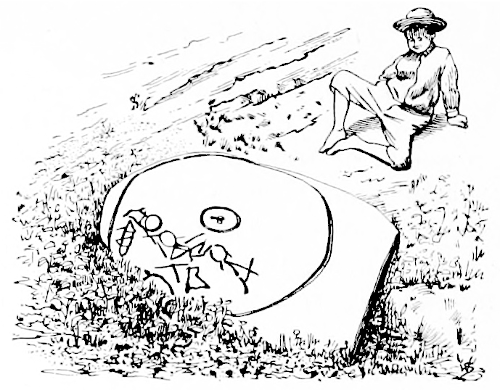
The resemblance between these drawings and those on Dighton rock is to be noted, as well as that between both of them and some in Ohio. All those localities are within the area formerly occupied by tribes of the Algonquian stock.
Near Washington, Lancaster county, Pennsylvania, on “Mill stream,” one-fourth of a mile above its junction with the Susquehanna river, is a large bowlder of gray sandstone (Fig. 73), the exposed portion of which bears several deeply incised lines which appear to have served as topographic indicators, as several others of like kind occur farther downstream. The longest incision is about 28 inches in length, the next one parallel to it, about 14 inches, while the third character is V-shaped, one arm of which is about 10 inches in length and the other 12. The apex of this character points in a southeast direction.
One-eighth of a mile farther down is another bowlder, also near the water, which bears shorter lines than the preceding, but in general pointing almost southeast and northwest.
The workmanship is similar to that at Conowingo, Maryland, at the site of the Bald Friar rocks. The marks appear to have been chipped to a considerable depth and then rubbed with sand and some hard substance so as to present a smooth and even surface, removing all or nearly all of the pecked surface.
Mr. P. W. Shafer, on the same historical map of Pennsylvania before mentioned, presents also a group of pictures copied from the originals on the Alleghany river, in Venango county, 5 miles south of Franklin, on what is known as the Indian God rock. There are but six characters furnished in his copy, three of which are variations of the human form, while the others are undetermined.
This rock was visited in 1886 by Dr. Hoffman, who made a number of drawings of objects represented, of which only those in Fig. 74 are here reproduced. The face of the bowlder bearing the original petroglyphs has been much disfigured by visitors who, in endeavoring to display their skill by pecking upon the surface names, dates, and other[110] designs, have so injured it that it is difficult to trace the original characters.
Fig. 74, a, represents, apparently, a panther. Above and beneath it are markings resembling wolf tracks, while farther down is a turkey track, and in the left-hand lower corner is a human form, such as is usually found upon rocks in the areas represented by Shoshonian tribes.
The design at b is much mutilated and eroded, and may originally have been a character like a, the first of this series.
The characters at c and d are evidently human faces, the former representing that of the sun, the latter being very much like a mask. That at e is found upon other Algonquian rocks, notably those called “Bald Friar,” Maryland, in the Susquehanna river, immediately below the state line of Pennsylvania.
The bowlder upon which these petroglyphs are engraved lies at the water’s edge, and during each freshet the lower half of the surface and sometimes even more is under water. At these times floating logs, impelled according to the curve in the river immediately above, are directed toward this rock, which may explain the worn surface and the eroded condition of the sculpture.
Mr. J. Sutton Wall, of Monongahela city, describes in correspondence a rock bearing pictographs opposite the town of Millsboro, in Fayette county, Pennsylvania. This rock is about 390 feet above the level of the Monongahela river, and belongs to the Waynesburg stratum of sandstone. It is detached and rests somewhat below its true horizon. It is about 6 feet in thickness, and has vertical sides; only two figures are carved on the sides, the principal inscriptions being on the top, and all are now considerably worn. Mr. Wall mentions the outlines of animals and some other figures formed by grooves or channels cut from an inch to a mere trace in depth. No indications of tool marks were[111] discovered. The footprints are carved depressions. The character marked z, near the lower left-hand corner, is a circular cavity 7 inches deep. A copy of the inscription made in 1882 by Mr. Wall and Mr. William Arison is reproduced as Fig. 75.
Again the resemblance between these drawings, those on Dighton rock, and some of those in Ohio, introduced above, is to be noted, and the fact that all these localities are within the area formerly occupied by tribes of the Algonquian stock.
Mr. Wall also contributes a group of glyphs on what is known as the “Geneva Picture rock,” in the Monongahela valley, near Geneva. These are footprints and other characters similar to those from Hamilton farm, West Virginia, which are shown in Fig. 1088.
Mr. L. W. Brown, of Redstone, Fayette county, Pennsylvania, mentions a rock near Layton, in that county, which measures about 15 by 25 feet in area, upon the surface of which occur a number of petroglyphs consisting of the human figure, animals, and footprints, some[112] of which are difficult to trace. From a rough sketch reproduced as Fig. 76, made by Mr. Brown, these appear to be Algonquian in type.
Mr. Brown also submitted for examination two pieces of chocolate-colored, smooth, fine grained slate, of hard texture, bearing upon the several sides outlines of incised figures. The specimens were found in Indian graves in Fayette county, Pennsylvania. The outline of the[113] incisions, although they are not strictly petroglyphs, are reproduced in Figs. 77 and 78.
The designs are made in delicate lines, as if scratched with a sharply pointed piece of quartz, or possibly metal. The character d on Fig. 78 is the representation of a fish, which has been accentuated by additional cutting since found. The characters resemble the Algonquian type, many of them being frequently found among those tribes living along the Great Lakes.
In C. C. Rafn’s Antiq. Amer. (c), is the following account:
Portsmouth rocks.—The rocks, for there are several of them, are situated on the western side of the island of Rhode Island, in the town of Portsmouth, on the shore, about 7 miles from Newport, taking the western road, and 4 miles from Bristol ferry. * * * They are partially, if not entirely, covered by water at high tide; and such was the state of the tide and the lateness of the hour when the location was ascertained, that I was unable to make a thorough examination of them. I saw sufficient, however, to satisfy me that they were formerly well covered with characters, although a large portion of them have become obliterated by the action of air and moisture, and probably still more by the attrition of masses of stone against them in violent storms and gales, and by the ruthless ravages of that most destructive power of all, the hand of man.
Tiverton rocks [op. cit. d].—Their situation may be thus known: by tracing along the east side of the map of Rhode Island until you strike Tiverton, and then following along to the southwest extremity of that town, the Indian name Puncoteast, also the English names Almy and High Hill, will be seen. The inscriptions are on masses of Graywacke. * * * We can only state they were occupied with some kind of characters.
These two inscriptions are pictured, op. cit., Table XIII.
Mr. T. H. Lewis (c), gives a description of Fig. 79 as follows:
This bowlder is on a high terrace on the west side of the Minnesota river, 1½ miles south of Browns valley, and is in Roberts county, South Dakota. It is oblong in form, being 3½ feet in length, 2 feet in width, and is firmly imbedded in the ground.
Of the characters a and b are undoubtedly tortoises; c is probably intended to represent a bird track; d represents a man, and is similar to the one at Browns valley, Minnesota, [Fig. 51, supra;] e is a nondescript of unusual form; f is apparently intended to represent a headless bird, in that respect greatly resembling certain earthen effigies in the regions to the southeast.
The figures are about one-fourth of an inch in depth and very smooth, excepting along their edges, which roughness is caused by a slight unevenness of the surface of the bowlder.
The same authority, op. cit., describes Fig. 79, g.
This bowlder, 4 miles northwest of Browns valley, Minnesota, is in Roberts county, South Dakota.
The figures here represented are roughly pecked into the stone, and were never finished; for the grooves that form the pictograph on other bowlders in this region have been rubbed until they are perfectly smooth. The face of the bowlder upon which these occur is about 2 feet long and 1½ feet in width.
Mr. John Haywood (a) gives the following account:
About 2 miles below the road which crosses the Harpeth river from Nashville to Charlotte is a large mound 30 or 40 feet high. About 6 miles from it is a large rock, on the side of the river, with a perpendicular face of 70 or 80 feet altitude. On it, below the top some distance and on the side, are painted the sun and moon in yellow colors, which have not faded since the white people first knew it. The figure of the sun is 6 feet in diameter; that of the moon is of the old moon. The sun and moon are also painted on a high rock on the side of the Cumberland river, in a spot which several ladders placed upon each other could not reach, and which is also inaccessible except by ropes let down the summit of the rock to the place where the painting was performed. * * * The sun is also painted on a high rock on the side of the Cumberland river, 6 or 7 miles below Clarksville; and it is said to be painted also at the junction of the Holston and French Broad rivers, above Knoxville, in East Tennessee; also on Duck river, below the bend called the Devil’s Elbow, on the west side of the river, on a bluff; and on a perpendicular flat rock facing the river, 20 feet below the top of the bluff and 60 above the water, out of which the rock rises, is the painted representation of the sun in red and yellow colors, 6 feet[115] in circumference, yellow on the upper side and a yellowish red on the lower. The colors are very fresh and unfaded. The rays, both yellow and red, are represented as darting from the center. It has been spoken of ever since the river was navigated and has been there from time immemorial. * * *
The painting on Big Harpeth, before spoken of, is more than 80 feet from the water and 30 or 40 below the summit. All these paintings are in unfading colors, and on parts of the rock inaccessible to animals of every description except the fowls of the air. The painting is neatly executed, and was performed at an immense hazard of the operator.
Mr. W. M. Clarke, in Smithsonian Report for 1877, page 275, says:
On the bluffs of the Big Harpeth many pictures of Indians, deer, buffalo, and bows and arrows are to be seen. These pictures are rudely drawn, but the coloring is as perfect now as when first put on.
Haywood (b) says:
At a gap of the mountains and near the head of Brasstown creek, which is toward the head of the Hiawassee, and among the highlands, is a large horizontal rock on which are engraved the tracks of deer, bears, horses, wolves, turkeys, and barefooted human beings of all sizes. Some of the horses’ tracks appear to have slipped forward. The direction of them is westward. Near them are signs of graves.
He also (c) gives the following account:
On the south bank of the Holston, 5 miles above the mouth of French Broad, is a bluff of limestone opposite the mounds and a cave in it. The bluff is 100 feet in height. On it are painted in red colors, like those on the Paint rock, the sun and moon, a man, birds, fishes, etc. The paintings have in part faded within a few years. Tradition says these paintings were made by the Cherokees, who were accustomed in their journeys to rest at this place. Wherever on the rivers of Tennessee are perpendicular bluffs, on the sides, and especially if caves be near, are often found mounds near them, inclosed in intrenchments, with the sun and moon painted on the rocks, and charcoal and ashes in the smaller mounds. These tokens seem to be evincive of a connection between the mounds, the charcoal and ashes, the paintings and the caves.
Mr. J. R. Bartlett (b) gives the following account:
About 30 miles from El Paso del Norte, in Texas, very near the boundary line of Mexico, there is an overhanging rock, extending for some distance, the whole surface of which is covered with rude paintings and sculptures, representing men, animals, birds, snakes, and fantastic figures. The colors used are black, red, white, and a brownish yellow. The sculptures are mere peckings with a sharp instrument just below the surface of the rock. The accompanying engravings [reproduced in Fig. 80] show the character of the figures and the taste of the designers. Hundreds of similar ones are painted on the rocks at this place. Some of them, evidently of great age, had been partly defaced to make room for more recent devices.
The overhanging rock, beneath which we encamped, seemed to have been a favorite place of resort for the Indians, as it is at the present day for all passing travelers. The recess formed by this rock is about 15 feet in length by 10 in width. Its entire surface is covered with paintings, one laid on over the other, so that it is difficult to make out those which belong to the aborigines. I copied a portion of these figures, about which there can be no doubt as to the origin. They represent Indians with shields and bows, painted with a brownish earth; horses, with their riders; uncouth looking animals, and a large rattlesnake. Similar devices cover the rock in every part, but are much defaced. Near this overhanging rock is the largest and finest tank or pool of water to be found about here. It is only reached by clambering[116] on the hands and knees 15 or 20 feet up a steep rock. Over it projects a gigantic bowlder, which, resting on or wedged between other rocks, leaves a space of about 4 feet above the surface of the water. On the underside of this bowlder are fantastic designs in red paint, which could only have been made by persons lying on their backs in this cool and sheltered spot.
Mr. Charles Hallock, of Washington, District of Columbia, gives information that there is a locality termed the Painted caves, “on the Rio Grande, near Devil’s river, in Crockett county, Texas, on the line of the ‘Sunset’ railroad. Here the rock is gray limestone and the petroglyphs are for the most part sculptured. They are in great variety, from a manifest antiquity to the most recent date; for these cliff caverns have been from time immemorial the refuge and resort of all sorts of wayfarers, marauders, and adventurers, who have painted, cut, and carved in every geometrical and grotesque form imaginable.”
Carvings and paintings on rocks are found in such numbers in the southern interior of Utah that a locality there has been named Pictograph rocks.
Mr. G. K. Gilbert, of the U. S. Geological Survey, collected in 1875 a number of copies of inscriptions in Temple creek canyon, southeastern Utah, and noted their finding as follows:
The drawings were found only on the northeast wall of the canyon, where it cuts the Vermillion cliff sandstone. The chief parts are etched, apparently by pounding with a sharp point. The outline of a figure is usually more deeply cut than the body. Other marks are produced by rubbing or scraping, and still others by laying on colors. Some, not all, of the colors are accompanied by a rubbed appearance, as though the material had been a dry chalk.
I could discover no tools at the foot of the wall, only fragments of pottery, flints, and a metate.
Several fallen blocks of sandstone have rubbed depressions that may have been[117] ground out in the sharpening of tools. There have been many dates of inscriptions, and each new generation has unscrupulously run its lines over the pictures already made. Upon the best protected surfaces, as well as the most exposed, there are drawings dimmed beyond restoration and others distinct. The period during which the work accumulated was longer by far than the time which has passed since the last. Some fallen blocks cover etchings on the wall, and are themselves etched.
Colors are preserved only where there is almost complete shelter from rain. In two places the holes worn in the rock by swaying branches impinge on etchings, but the trees themselves have disappeared. Some etchings are left high and dry by a diminishing talus (15 to 20 feet), but I saw none partly buried by an increasing talus (except in the case of the fallen block already mentioned).
The painted circles are exceedingly accurate, and it seems incredible that they were made without the use of a radius.
In the collection contributed by Mr. Gilbert there are at least fifteen series or groups of figures, most of which consist of the human form (from the simplest to the most complex style of drawing), animals, either singly or in long files—as if driven—bird tracks, human feet and hands, etc. There are also circles, parallel lines, and waving or undulating lines, spots, and other characters.
Mr. Gilbert also reports the discovery, in 1883, of a great number of pictographs, chiefly in color, though some are only incised, in a canyon of the Book cliff containing Thompson’s spring, about 4 miles north of Thompson’s station, on the Denver and Colorado Railroad, Utah. He has also furnished a collection of drawings of pictographs at Black rock spring, on Beaver creek, north of Milford, Utah. A number of fallen blocks of basalt at a low escarpment are filled with etchings upon the vertical faces. The characters generally are of an “unintelligible” nature, though the human figure is drawn in complex forms. Footprints and circles abound.
Mr. I. C. Russell, of the U. S. Geological Survey, furnished rude drawings of pictographs at Black rock spring, Utah (see Fig. 1093). Mr. Gilbert Thompson also discovered pictographs at Fool creek canyon, Utah (see Fig. 1094).
Mr. Vernon Bailey, in a letter dated January 18, 1889, reports that in the vicinity of St. George “all along the sandstone cliffs are strange figures like hieroglyphics and pictures of animals cut in the rocks, but now often worn dim.”
Mr. George Pope, of Provo city, Utah county, in a letter, kindly gives an account of an inscription on a rock in a canyon at the mouth of Provo river, about 7 miles from the city named. There is no paint seen, the inscription being cut. A human hand is conspicuous, being cut (probably pecked) to a depth of at least one-third of an inch, and so with representations of animals.
Dr. Rau (c) gives the design of a portion of a group carved on a cliff in the San Pete valley at the city of Manti, Utah, now reproduced as Fig. 81. He says:
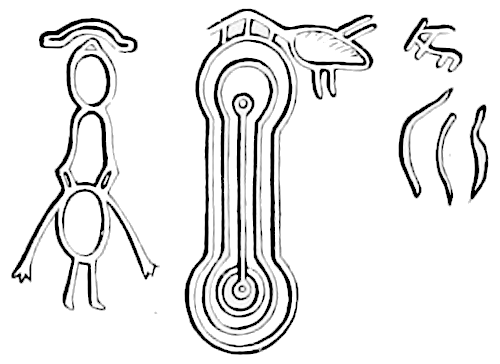
A line drawn horizontally through the middle of the parallel lines connecting the concentric circles would divide the figure into two halves, each bearing a close[118] resemblance to Prof. Simpson’s fifth type of cup stones. A copy of the group in question was made and published by Lieut. J. W. Gunnison, in The Mormons or Latter-Day Saints, etc., Philadelphia, 1853, p. 63. The illustration is taken from Bancroft’s Native Races (Vol. IV, p. 717). In accordance with Lieut. Gunnison’s design, the position of the grotesque human figure is changed to the left of the concentric circle. He also says that the Mormon leaders made this aboriginal inscription subservient to their religion by giving the following translation of it: “I, Mahanti, the second king of the Lamanites, in five valleys of the mountains, make this record in the twelve hundredth year since we came out of Jerusalem. And I have three sons gone to the south country to live by hunting antelope and deer.” * * * Schoolcraft attempts (Vol. III, p. 494) something like an interpretation which appears to me fanciful and unsatisfactory.
The following extract is made from The Shinumos by F. S. Dellenbaugh (a).
Some of the least disintegrated ruins are situated on the Colorado river, only a short distance below the mouth of the Dirty Devil river. * * * A level shelf varying from about 6 to 10 feet in width ran along for 150 feet or more. In most places the rocks above protruded as far as the edge of the lower rocks, sometimes farther, thus leaving a sort of gallery, generally 7 or 8 feet high. Walls that extended to the roof had been built along the outer edge of the natural floor, and the inclosed space being subdivided by stone partitions to suit the convenience of the builders, the whole formed a series of rather comfortable rooms or houses. The back walls of the houses—the natural rock—had on them many groups of hieroglyphics, and farther along where there was no roof rock at all the vertical faces had been inscribed with seeming great care. Some of the sheltered groups were painted in various dull colors, but most of them were chiseled.
The figure [82] gives a chiseled group. It is easy to see that these are signs of no low order. Considering their great age, their exposure, many of the delicate touches must be obliterated.
The inscriptions on this ruin might possibly be the history of the defense of the crossing, the stationing of the garrison, the death of officers of rank, etc.
The following sketches of petroglyphs, with the references attached, are taken from the sketch book of Mr. F. S. Dellenbaugh, before referred to.
The petroglyph, of which Fig. 83 is a copy, appears on a horizontal rock 5 miles below the mouth of the Dirty Devil river, Utah.
The characters in Fig. 84 from rocks near the preceding group are painted red, with the imprint of a hand (on the larger figure) in white.
The petroglyphs reproduced in Fig. 85 are copied from the vertical walls near the two groups immediately before mentioned.
The characters presented in Fig. 86 are copied from a vertical surface 10 by 16 feet in area and halfway up the ascent to the geodetic point west of “Windsor castle,” Pipe Spring. The human forms are similar in general design to the greater number of such representations made by the Shinumo Indians.
The human forms represented in Fig. 87 are from the vicinity of Colorado river, 5 miles below the mouth of the Dirty Devil river. Mr.[120] Dellenbaugh notes that the darkest portions of the figures indicate a chiseled surface.
Fig. 88 represents a number of petroglyphs obtained at the same locality as the one last mentioned. The greater number of the characters appear to represent snakes.
Fig. 89 shows characters from the Shinumo canyon, which, according to the draftsman’s general notes, are painted.
In 1886 Dr. Hoffman visited a local field 9 miles southwest of Tazewell, Tazewell county, Virginia, which can be designated as follows: The range of hills bounding the western side of the valley presents at various points low cliffs and exposures of Silurian sandstone. About 4 miles below the village, known as Knob post-office, there is a narrow ravine leading up toward a depression in the range, forming a pass to the valley beyond, near the summit of which is a large irregular exposure of rock facing west-southwest, upon the eastern extremity of which are a number of pictographs, many of which are still in good preservation. Fig. 90 is a representation. The westernmost object, i. e., the one on the extreme left, appears to be a circle about 16 inches in diameter, from the outer side of which are short radiating lines giving the whole the appearance of a sun. Beneath and to the right of this is the outline of an animal resembling a doe.
Other figures, chiefly human, follow in close succession to the eastern edge of the vertical face of the rock, nearly all of which present the arms in various attitudes, i. e., extended or raised as in extreme surprise or adoration. Concentric rings appear at one point, while a thunder-bird is shown not far away. About 12 feet east of this place are several figures resembling the thunder-bird.
All of the characters, with one exception, are drawn in heavy or solid[122] lines of dark red paint, presumably a ferruginous coloring material prepared in the neighborhood, which abounds in iron compounds. The exception is one object which appears to have been black, but is now so faded or eroded as to seem dark gray.
The following account of the Tazewell county, Virginia, pictographs is taken from Coale’s Life, etc., of Waters: (a)
In August, 1871, the writer went to visit Tazewell county by way of the saltworks. Upon this place are found those strangely painted rocks which have been a wonder and a mystery to all who have seen them. The grandfather of Gen. Bowen settled the cove in 1766, one hundred and ten years ago, and the paintings were there then, and as brilliant to-day as they were when first seen by a white man. They consist of horses, elk, deer, wolves, bows and arrows, eagles, Indians, and various other devices. The mountain upon which these rocks are based is about 1,000 feet high, and they lie in a horizontal line about halfway up and are perhaps 75 feet broad upon their perpendicular face.
When it is remembered that the rock is hard, with a smooth white surface, incapable of absorbing paint, it is a mystery how the coloring has remained undimmed under the peltings of the elements for how much longer than a hundred years no one can tell. This paint is found near the rocks, and Gen. Bowen informed the writers that his grandmother used it for dyeing linsey, and it was a fadeless color.
As there was a battle fought on a neighboring mountain, between 1740 and 1750, between the Cherokees and Shawnees for the possession of a buffalo lick, the remains of the rude fortifications being still visible, it is supposed the paintings were hieroglyphics conveying such intelligence to the red man as we now communicate to each other through newspapers.
It was a perilous adventure to stand upon a narrow, inclined ledge without a shrub or a root to hold to, with from 50 to 75 feet of sheer perpendicular descent below to a bed of jagged bowlders and the home of innumerable rattlesnakes, but I didn’t make it. I crawled far enough along that narrow slanting ledge with my fingers inserted in the crevices of the rocks to see most of the paintings, and then “coon’d” it back with equal care and caution.
Five miles east of the last-noted locality and 7 west of Tazewell, high up against a vertical cliff of rock, is visible a lozenge-shaped group of red and black squares, known in the locality as the “Handkerchief rock,” because the general appearance of the colored markings suggests the idea of an immense bandana handkerchief spread out. The pictograph is on the same range of hills as the preceding, but neither is visible from any place near the other. The objects can not be viewed upon Handkerchief rock excepting from a point opposite to it and across the valley, as the locality is so overgrown with large trees as to obscure it from any position immediately beneath. The lozenge or diamond-shaped figure appears to cover an area about 3 feet in diameter.
Capt. Charles Bendire, U. S. Army, in a letter dated Fort Walla-walla, Washington, May 18, 1881, mentions a discovery made by Col. Henry C. Merriam, then lieutenant-colonel Second United States Infantry, as thus quoted:
While encamped at the lower end of Lake Chelan, lat. 48° N., he made a trip to the upper end of said lake, where he found a perpendicular cliff of granite with a[123] perfectly smooth surface, from 600 to 1,000 feet high, rising out of the lake. On the cliff he found Indian picture-writings, painted evidently at widely different periods, but evidently quite old. The oldest was from 25 to 30 feet above the present water level, and could at the time they were executed only be reached by canoe. The paintings are figures, black and red in color, and represent Indians with bows and arrows, elk, deer, bear, beaver, and fish, and are from 1 foot to 18 inches in size. There are either four or five rows of these figures, quite a number in each row. The Indians inhabiting this region know nothing of the origin of these pictures, and say that none of their people for the past four generations knew anything about them.
Since the preceding letter was written a notice of the same rock has been published, together with an illustration, by Mr. Alfred Downing, of Seattle, Washington, in “The Northwest,” VII, No. 10, October, 1889, pp. 3, 4. The description, condensed, is as follows:
In that part of Washington territory until recent years known as the Moses Indian reservation lies the famous Lake Chelan, 70 miles in length with an average width of 2 miles.
About half a mile from its head, on the western shore and rising from the water, as an abrupt and precipitous wall of granite, stands “Pictured rock.”
The most remarkable feature of the Chelan picture is that the figures representing Indians, bear, deer, birds, etc., are painted upon the surface of the smooth granite, nearly horizontal, but about 17 feet above the lake; the upper portion of the picture being about 2 feet higher. The figures depicted are 5 to 10 inches long.
The difference between high and low stage of water at any period during the year does not exceed 4 feet, and this high-water mark being well defined along the shore, it becomes self-evident that these signs were placed there ages ago, when the water was 17 feet higher than it is now. The granite bluff or walls in this instance are smooth, being weather and water worn, and afford no hold for hand or foot either from above or below, and from careful observation it would appear to be a physical impossibility for either a white or red man to show his artistic skill on those rocks unless at the ancient stage of water and with the aid of a canoe or a “dugout.”
The paint or color used was black and red, the latter resembling venetian. How wonderfully the color has stood the test in the face of the storms to which the lake is subject is apparent; only in one or two instances does it to-day show any signs of fading or weather-wearing. The signs impressed me as intending to convey the idea of the prowess of an Indian chief in the hunt, or as being a page in the history of a tribe, the small perpendicular strokes seen in the lower portion indicating probably the number of bear, deer, or other animals slain.
When referring, in Pacific Railroad Report, vol. I, page 411, to a locality on the Columbia river in Washington, between Yakima and Pisquouse counties, Mr. George Gibbs mentioned pecked and colored petroglyphs which he found there as follows:
It was a perpendicular rock, on the face of which were carved sundry figures, most of them intended for men. They were slightly sunk into the sandstone and colored, some black, others red, and traces of paint remained more or less distinctly on all of them. These also, according to their [the Indians’] report, were the work of the ancient race; but from the soft nature of the rock, and the freshness of some of the paint, they were probably not of extreme antiquity.
For another example of petroglyphs from Washington see Fig. 679.
Mr. John Haywood (d) gives the following account:
In the county of Kenhaway [Kanawha] about 4 miles below the Burning spring, and near the mouth of Campbell’s creek, in the state of Virginia, is a rock of great size, on which, in ancient times, the natives engraved many representations. There is the figure of almost every indigenous animal—the buffalo, the bear, the deer, the fox, the hare, and other quadrupeds of various kinds; fish of the various productions of the western waters, fowls of different descriptions, infants scalped, scalps alone, and men as large as life. The rock is in the river Kenhaway, near its northern shore, accessible only at low water unless by the aid of water craft.
The following notice of the same locality, but perhaps not of the same rock, was published by James Madison (a), bishop of Virginia, in 1804:
I cannot conclude this letter without mentioning another curious specimen of Indian labour, and of their progress in one of the arts. This specimen is found within 4 miles of the place whose latitude I endeavoured to take, and within 2 of what are improperly called Burning springs, upon a rock of hard freestone, which sloping to the south, touching the margin of the river, presents a flat surface of above 12 feet in length and 9 in breadth, with a plane side to the east of 8 or 9 feet in thickness.
Upon the upper surface of this rock, and also upon the side, we see the outlines of several figures, cut without relief, except in one instance, and somewhat larger than the life. The depth of the outline may be half an inch; its width three-quarters, nearly, in some places. In one line ascending from the part of the rock nearest the river there is a tortoise; a spread eagle, executed with great expression, particularly the head, to which is given a shallow relief, and a child, the outline of which is very well drawn. In a parallel line there are other figures, but among them that of a woman only can be traced. These are very indistinct. Upon the side of the rock there are two awkward figures which particularly caught my attention. One is that of a man with his arms uplifted, and hands spread out as if engaged in prayer. His head is made to terminate in a point, or rather, he has the appearance of something upon the head of a triangular or conical form; near to him is another similar figure suspended by a cord fastened to his heels. I recollected the story which Father Hennepin relates of one of the missionaries from Canada who was treated in a somewhat similar manner, but whether this piece of seemingly historical sculpture has reference to such an event can be only a matter of conjecture. A turkey, badly executed, with a few other figures may also be seen. The labour and the perseverance requisite to cut those rude figures in a rock so hard that steel appeared to make but little impression upon it, must have been great; much more so than making of enclosures in a loose and fertile soil.
Another petroglyph, a copy of which is presented in Fig. 1088, is thus described in a letter from Morgantown, West Virginia:
The famous pictured rocks on the Evansville pike, about 4 miles from this place, have been a source of wonder and speculation for more than a century, and have attracted much attention among the learned men of this country and Europe. The cliff upon which these drawings exist is of considerable size and within a short distance of the highway above mentioned. The rock is a white sandstone, which wears little from exposure to the weather, and upon its smooth surface are delineated the outlines of at least fifty [?] species of animals, birds, reptiles, and fish, embracing in the number panthers, deer, buffalo, otters, beavers, wildcats, foxes, wolves, raccoons, opossums, bears, elk, crows, eagles, turkeys, eels, various sorts of fish, large and small, snakes, etc. In the midst of this silent menagerie of specimens of the animal kingdom is the full length outline of a female form, beautiful and perfect[125] in every respect. Interspersed among the drawings of animals, etc., are imitations of the footprints of each sort, the whole space occupied being 150 feet long by 50 feet wide. To what race the artist belonged or what his purpose was in making these rude portraits must ever remain a mystery, but the work was evidently done ages ago.
The late P. W. Norris, of the Bureau of Ethnology, reported that he found petroglyphs in many localities along the Kanawha river, West Virginia. Engravings are numerous upon smooth rocks, covered during high water, at the prominent fords in the river, as well as in the niches or long shallow caves high in the rocky cliffs of this region. Rude representations of men, animals, and some characters deemed symbolic were found, but none were observed superior to, or essentially differing from those of modern Indians.
On the rocky walls of Little Coal river, near the mouth of Big Horse creek, are cliffs which display many carvings. One of the rocks upon which a mass of characters appear, is 8 feet in length and 5 feet in height.
About 2 miles above Mount Pleasant, Mason county, on the north side of the Kanawha river, are numbers of characters, apparently totemic. These are at the foot of the hills flanking the river.
On the cliffs near the mouth of the Kanawha river, opposite Mount Carbon, Nicholas county, are numerous pictographs. These appear to be cut into the sandstone rock.
Pictographs were lately seen at various points on the banks of the Kanawha river, both above and below Charleston, but since the construction of the Chesapeake and Ohio railroad some of the rocks bearing them have been destroyed. About 6 miles above Charleston there was formerly a rock lying near its water’s edge upon which, it is reported by old residents, were depicted the outline of a bear, turkey tracks, and other markings. Tradition told that this was a boat or canoe landing, used by the Indians in their travels when proceeding southward. The tribe was not designated. From an examination of the locality it was learned that this rock had been broken and used in the construction of buildings. It is said that a trail passing there led southward, and at a point 10 miles below the Kanawha river stood several large trees upon which were marks of red ocher or some similar pigment, at which point the trail spread or branched out in two directions, one leading southward into Virginia, the other southwest toward Kentucky.
On a low escarpment of sandstone facing Little Coal river, 6 or 8 miles above its confluence with Coal river and about 18 miles south of the Kanawha river, are depicted the outlines of animals, such as the deer, panther (?), etc., and circles, delineated in dark red, but rather faint from disintegration of the surface. The characters are similar in general appearance to those in Tazewell county, Virginia, and appear as if they might have been made by the same tribe. There are no peculiarities in the topography of the surrounding region that would suggest the idea of their having served as topographic indications,[126] but they rather appear to be a record of a hunting party, and to designate the kinds of game abounding in the region.
Mr. L. V. McWhorter reports pictographs in a cave near Berlin, Lewis county, West Virginia. No details are given.
A petroglyph found in a rock shelter in West Virginia is also presented in Pl. XXXI.
A large number of glyphs are incised on the face of a rock near Odanah, now a village of the Ojibwa Indians, 12 miles northeast from Ashland, on the south shore of lake Superior, near its western extremity. The characters were easily cut on the soft stone, so were also easily worn by the weather, and in 1887 were nearly indistinguishable. Many of them appeared to be figures of birds. An old Ojibwa Indian in the vicinity told the present writer that the site of the rock was formerly a well-known halting place and rendezvous, and that on the arrival of a party, or even of a single individual, the appropriate totemic mark or marks were cut on the rock, much as white men register their names at a hotel.
The Pictured cave of La Crosse valley, called Brown’s cave, is described by Rev. Edward Brown (a) as follows:
This curious cavern is situated in the town of Barre, 4 miles from West Salem and 8 miles from La Crosse. * * *
Before the landslide it was an open shelter cavern, 15 feet wide at the opening and 7 feet at the back end; greatest width, 16 feet; average, 13; length, 30 feet; height, 13 feet, and depth of excavation after clearing out the sand of the landslide, 5 feet. The pictures are mostly of the rudest kind, but differing in degree of skill. Except several bisons, a lynx, rabbit, otter, badger, elk, and heron, it is perhaps impossible to determine with certainty what were intended or whether they represented large or small animals, no regard being had to their relative sizes.
[Examples of the figures are here presented as Fig. 91.]
Perhaps a indicates a bison or buffalo, and is the best executed picture of the collection. Its size is 19 inches long by 15½ inches from tip of the horns to the feet.
b represents a hunter, with a boy behind him, in the act of shooting an animal with his bow and arrow weapon. The whole representation is 25 inches long; the animal from tip of tail to end of horn or proboscis 12 inches, and from top of head to feet 7 inches; the hunter 11 inches high, the boy 4½.
c represents a wounded animal, with the arrow or weapon near the wound. This figure is 21¾ inches from the lower extremity of the nose to the tip of the tail, 8¾ inches from fore shoulders to front feet, and 8 inches from the rump to the hind feet. The weapon is 4½ inches long by 5 inches broad from the tip of one prong or barb to that of the other.
d represents a chief with eight plumes and a war club, 11 inches from top of head to the lower extremity, and 6¾ inches from the tip of the upper finger to the end of the opposite arm; the war club 6½ inches long.
Dr. Hoffman made a visit to this cave in August, 1888, to compare the pictographic characters with others of apparently similar outline and of known signification. He found but a limited number of the figures distinct, and these only in part, owing to the rapid disintegration of the sandstone upon which they were drawn. Many names and inscriptions had been incised in the soft surface by visitors, who also, by means of the smoke of candles, added grotesque and meaningless figures over and between the original paintings, so as to seriously injure the latter.
Mr. T. H. Lewis (d) describes the petroglyphs, a part of which is reproduced in Fig. 92, as follows:
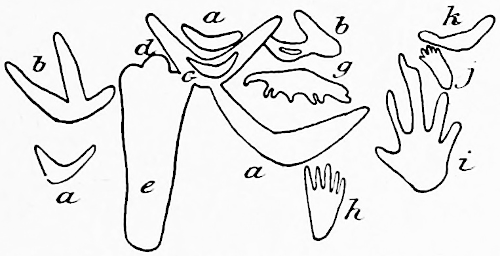
Last November my attention was called to some rock sculptures located about 2½ miles northwest from Trempealeau, Wisconsin. There is at the point in question an exposed ledge of the Potsdam sandstone extending nearly one-eighth of a mile along the east side of the lower mouth of the Trempealeau river, now known as the bay. Near its north end there is a projection extending out about 7 feet from the top of the ledge and overhanging the base about 10 feet. The base of the ledge is 40 feet back from the shore, and the top of the cliff at this point is 30 feet above the water. On the face of the projection, and near the top, are the sculpture figures referred to.
The characters designated a a are two so-called canoes, somewhat crescent-shaped, but with some variation in outline; b has the same form, but the additional upright portion overlaps it; c and d are also of the same form as a, but c is cut in the bottom of d; e probably represents a fort, and its length is 18½ inches; f is a nondescript, and it partly overlaps d; g is a nondescript four-legged animal, its length in a straight line from the end of the nose to the tip of the tail being 10½ inches; h may be intended to represent a foot, but possibly it may be a hand; it is 7½ inches in length; i is an outspread hand, a little over 13 inches long; j undoubtedly represents a foot and is 4½ inches long; k k are of the same class as a.
The figures are not mere outlines, but intaglio, varying in depth from a quarter of an inch to fully 1 inch. Although the surface of the rock is rough the intaglios were rubbed perfectly smooth after they had been engraved by pecking or cutting.
Several pictographs in Wyoming are described by Capt. William A. Jones, U. S. Army (a). They are reproduced here as Figs. 93, 94, and 95.
Fig. 93, found in the Wind river valley, Wyoming, was interpreted by members of a Shoshoni and Banak delegation to Washington in 1880 as “an Indian killed another.” The latter is very roughly delineated in the horizontal figure, but is also represented by the line under the hand of the upright figure, meaning the same dead person. At the right is the scalp taken and the two feathers showing the dead warrior’s rank. The arm nearest the prostrate foe shows the gesture for killed; concept, to put down, flat.
The same gesture appears in Fig. 94, from the same authority and locality. The scalp is here held forth, and the numeral (1) is indicated by the lowest stroke.
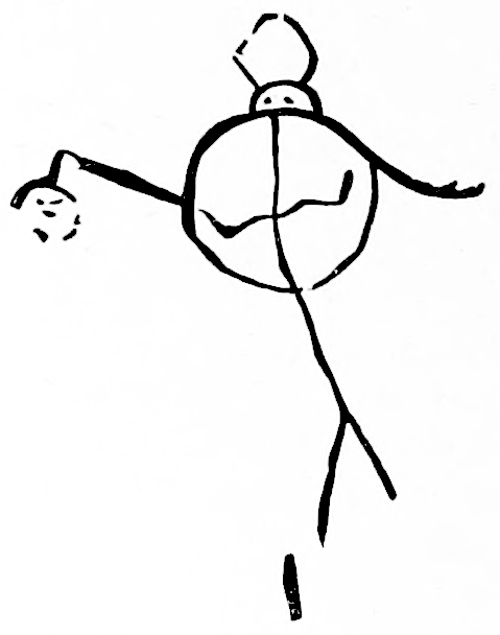
Fig. 95, from the same locality and authority, was also interpreted by the Shoshoni and Banak. It appears from their description that a Blackfoot had attacked the habitation of some of his own people. The right-hand upper figure represents his horse, with the lance suspended from the side. The lower figure illustrates the log house built against a stream. The dots are the prints of the horse’s hoofs, while the two lines running outward from the upper inclosure show that two thrusts of the lance were made over the wall of the house, thus killing the occupant and securing two bows and five arrows, as represented in the left-hand group. The right-hand figure of that group shows the hand raised in the attitude of making the gesture for kill.
The Blackfeet, according to the interpreters, were the only Indians in the locality mentioned who constructed log houses, and therefore the drawing becomes additionally interesting, as an attempt appears to have been made to illustrate the crossing of the logs at the corners, the gesture for which (log house) is as follows:
Both hands are held edgewise before the body, palms facing, spread the fingers, and place those of one hand into the spaces between those of the other, so that the tips of each protrude about an inch beyond.
Another and more important petroglyph was discovered on Little Popo-Agie, northwestern Wyoming, by members of Capt. Jones’s party in 1873. The glyphs are upon a nearly vertical wall of the yellow sandstone in the rear of Murphy’s ranch, and appear to be of some antiquity. Further remarks, with specimens of the characters, are presented below in this paper. (See Fig. 1091.)
Dr. William H. Corbusier, U. S. Army, in a letter to the writer, mentions the discovery of drawings on a sandstone rock near the headwaters of Sage creek, in the vicinity of Fort Washakie, Wyoming, and gives a copy which is presented as Fig. 96. Dr. Corbusier remarks that neither the Shoshoni nor the Arapaho Indians know who made the drawings. The two chief figures appear to be those of the human form,[130] with the hands and arms partly uplifted the whole being inclosed above and on either side by an irregular line.
The method of grouping, together with various accompanying appendages, as irregular lines, spirals, etc., observed in Dr. Corbusier’s drawing, show great similarity to the Algonquian type, and resemble some engravings found near the Wind river mountains, which were the work of Blackfeet (Satsika) Indians, who, in comparatively recent times, occupied portions of the country in question, and probably also sketched the designs near Fort Washakie.
Fig. 97 is also reported from the same locality.
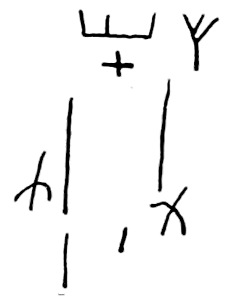
No adequate attention can be given in the present paper to the distribution and description of the petroglyphs of Mexico. In fact very little accurate information is accessible regarding them. The distinguished explorer, Mr. A. Bandelier, in a conversation mentioned that he had sketched but not published two petroglyphs in Sonora. One, very large and interesting, was at Cara Pintada, 3 miles southwest of Huassavas, and a smaller one was at Las Flechas, 1 mile west of Huassavas. He also sketched one in Chihuahua on the trail from Casas Grandes to the Cerro de Montezuma. From the accounts of persons met in his Mexican travels he gave it as his opinion that a large number of petroglyphs still remained in the region of the Sierra Madre.
The following mention of the paintings of the ancient inhabitants of Lower California is translated from an anonymous account, in Documentos para la Historia de Mexico (a), purporting to have been written in 1790:
Throughout civilized California, from south to north, and especially in the caves and smooth rocks, there remain various rude paintings. Notwithstanding their disproportion and lack of art, the representations of men, fish, bows and arrows, can be distinguished and with them different kind of strokes, something like characters. The colors of these paintings are of four kinds; yellow, a reddish color, green and black. The greater part of them are painted in high places, and from this it is inferred by some that the old tradition is true, that there were giants among the ancient Californians. Be this as it may, in the Mission of Santiago, which is at the south, was discovered on a smooth rock of great height, a row of hands stamped in red. On the high cliffs facing the shore are seen fish painted in various shapes and sizes, bows, arrows, and some unknown characters. In other parts are Indians armed with bows and arrows, and various kinds of insects, snakes, and mice, with lines and characters of other forms. On a flat rock about 2 yards in length were stamped insignia or escutcheons of rank and inscriptions of various characters.
Towards Purmo, about 30 leagues beyond the Mission of Santiago del Sur, is a bluff 8 yards in height and on the center of it is seen an inscription which resembles Gothic letters interspersed with Hebrew and Chaldean characters [?].
Though the Californian Indians have often been asked concerning the significance of the figures, lines, and characters, no satisfactory answer has been obtained. The most that has been established by their information is that the paintings were their predecessors, and that they are absolutely ignorant of the signification of them. It is evident that the paintings and drawings of the Californians are significant symbols and landmarks by which they intended to leave to posterity the memory, either of their establishment in this country, or of certain wars or political or natural triumphs. These pictures are not like those of the Mexicans, but might have the same purpose.
Several petroglyphs in Sonora are described and illustrated infra in Chapter XX on Special Comparisons. The following copies of petroglyphs are presented here as specimens and are markedly different from those in the northwestern states of Mexico, which represent the Aztec culture.
The description of Fig. 98 is extracted from Viages de Guillelmo Dupaix (a):
Going from the town of Tlalmanalco to that of Mecamecan, at a distance of a league to the east of the latter and in the confines of the estate of Señor Don José Tepatolco, is an isolated rock of granitic stone artificially cut into a conical form with a series of six steps cut in the solid rock itself on the eastern side, the summit forming a platform or horizontal section suitable for the purpose of observing the stars at all points of the compass. It is, therefore, most evident that this ancient monument or observatory was employed solely for astronomical observations, and it is further proved by various hieroglyphs cut in the south side of the cone; but the most interesting feature of this side is the figure of a man standing upright and in profile directing his gaze to the east with the arms raised, holding in the hands a tube or species of optical instrument. Beneath his feet is seen a carved frieze with six compartments or squares and other symbols of a celestial nature are engraved[133] on their surfaces, evidently the product of observation and calculation. Some of them have connection with those found symmetrically arranged in circles on the ancient Mexican calendar, exposed in this capital to general admiration. In front of the observer is a rabbit seated and confronted by two parallel rows of numerical figures; lastly two other symbols relating to the same science are seen at the back.
Prof. Daniel G. Brinton (a), gives an account of the illustration here produced on Pl. XIV A, which may be thus condensed:
The “Stone of the Giants” at Escamela near the city of Orizaba, Mexico, has been the subject of much discussion. Father Damaso Sotomayor sees in the inscribed figures a mystical allusion to the coming of Christ to the Gentiles and to the occurrences supposed in Hebrew myth to have taken place in the Garden of Eden. This stone was examined by Capt. Dupaix in the year 1808 and is figured in the illustrations to his voluminous narrative. The figure he gives [now presented as B on Pl. XIV] is, however, so erroneous that it yields but a faint idea of the real character and meaning of the drawing. It omits the ornament on the breast and also the lines along the right of the giant’s face, which as I shall show are distinctive traits. It gives him a girdle where none is delineated, and the relative size and proportions of all the three figures are quite distorted.
The rock on which the inscription is found is roughly triangular in shape, presenting a nearly straight border of 30 feet on each side. It is hard and uniform in texture and of a dark color. The length or height of the principal figure is 27 feet, and the incised lines which designate the various objects are deeply and clearly cut.
I now approach the decipherment of the inscriptions. Any one versed in the signs of the Mexican calendar will at once perceive that it contains the date of a certain year and day. On the left of the giant is seen a rabbit surrounded with ten circular depressions. These depressions are the well-known Aztec marks for numerals, and the rabbit represents one of the four astronomic signs by which they adjusted their chronologic cycles of fifty-two years. The stone bears a carefully dated record, with year and day clearly set forth. The year is represented to the left of the figure and is that numbered “ten” under the sign of the rabbit; the day of the year is number “one” under the sign of the fish.
These precise dates recurred once, and only once, every fifty-two years, and had recurred only once between the year of our era, 1450, and the Spanish conquest of Mexico in 1519-’20. Within the period named the year “ten rabbit” of the Aztec calendar corresponded with the year 1502 of the Gregorian calendar. It is more difficult to fix the day, but it is, I think, safe to say that, according to the most probable computations, the day, “one fish,” occurred in the first month of the year 1502, which month coincided in whole or in part with our February.
Such is the date on the inscription. Now, what is intimated to have occurred on that date? The clew to this is furnished by the figure of the giant. It represents an ogre of horrid mien with a death’s-head grin and formidable teeth, his hair wild and long, the locks falling down upon the neck. Suspended on the breast as an ornament is the bone of a human lower jaw, with its incisor teeth. The left leg is thrown forward as in the act of walking, and the arms are uplifted, the hands open, and the fingers extended as at the moment of seizing the prey or the victim. The lines about the umbilicus represent the knot of the girdle which supported the maxtli or breechcloth.
There is no doubt as to which personage of the Aztec pantheon this fear-inspiring figure represents. It is Tzontemoc Mictlantecutli, “the Lord of the Realm of the Dead, He of the Falling Hair,” the dread god of death and the dead. His distinctive marks are there, the death’s-head, the falling hair, the jaw bone, the terrible aspect, the giant size.
We possess several chronicles of the empire before Cortes destroyed it, written in the hieroglyphs which the inventive genius of the natives had devised. Taking two[134] of these chronicles, one known as the Codex Telleriano-Remensis, the other as the Codex Vaticanus, I turn to the year numbered “ten” under the sign of the rabbit and I find that both present the same record which I copy in the following figure.
The figure so copied is entitled “Extract from the Vatican Codex,” which is a slight error. It is a copy from the Codex Telleriano-Remensis, Kingsborough, I, Pt. 4, p. 23, year 1502, which is here reproduced as Fig. 99. The record in the Vatican Codex, Kingsborough, II, p. 130, differs in some unimportant details. It may also be noted that in the text relating to the Codex Telleriano-Remensis, Kingsborough, VI, p. 141, the word Ahuitzotl is given as “the name of an aquatic animal famous in Mexican mythology.” The present opportunity is embraced to recognize the acumen displayed by Prof. Brinton in his interpretation of the petroglyph. He proceeds as follows:
The sign of the year (the rabbit) is shown merely by his head for brevity. The ten dots, which give its number, are beside it. Immediately beneath is a curious quadruped, with what are intended as water-drops dripping from him. The animal is the hedgehog, and the figure is to be constructed iconomatically; that is, it must be read as a rebus through the medium of the Nahuatl language. In that language water is atl, in composition a, and hedgehog is uitzotl. Combine these and you get ahuitzotl, or, with the reverential termination, ahuitzotzin. This was the name of the ruler or emperor, if you allow the word, of ancient Mexico before the accession to the throne of that Montezuma whom the Spanish conquistador, Cortes, put to death.
Returning to the page from the chronicle, we observe that the hieroglyph of Ahuitzotzin is placed immediately over a corpse swathed in its mummy cloths, as was the custom of interment with the highest classes in Mexico. This signifies that the death of Ahuitzotzin took place in that year. Adjacent to it is the figure of his[135] successor, his name iconomatically represented by the headdress of the nobles, the tecuhtli, giving the middle syllables of “Mo-tecuh-zoma.” No doubt is left that La Piedra de los Gigantes of Escamela is a necrologic tablet commemorating the death of the Emperor Ahuitzotzin, some time in February, 1502.
Mr. Eugène Boban (a) mentions manuscript copies, dating from the beginning of the century, of various sculptured stones in Mexico. These sculpturings represent native ideographic characters, among them the teocalli, the tepetl, the sign ollin, etc.
On several of the plates which compose this collection are notes indicating the place where the monument, fragment, or ruin is found, from which the characters are copied; for example, one of them bears the note: “de la calle Rl de la villa de Cuernabaca.” Several others bear annotations which show that they have been copied in the cemetery, in the streets of that town, or in its environs.
Aside from these notes the plates are not accompanied by any information which could give a trace of the person who drew them, or the purpose for which they were intended.
The same author (b) describes a large sculptured stone of Mexico, the designs on which have been reproduced in paintings on deerskin. After giving a detailed description of the copied MS. he speaks of the stone as follows:
We deem it of interest to give some notes concerning the famous cylindrical stone, both sculptured and painted, known by the name Teocuauhxicalli (the sacred drinking vase of the eagles) on which are found the themes of all the designs which have been above described. This stone, buried at the time of the Spanish Conquest, was discovered in the first half of this century at the close of a series of excavations made in the soil of the Place d’Armes, Mexico. The director of the national museum, who was then M. Rafael Gondra, contented himself with taking the dimensions and making a hurried sketch of it. It was then reinterred, as the necessary funds were lacking to exhume it entirely and transport it to the museum.
The name Teocuauhxicalli is composed of: Teotl, god; cuauhili, eagle, and xicalli, hemispherical vase formed from the half of a gourd. It may be translated by, “The vase of god and the eagles,” or, rather, “The sacred drinking cup of the eagles.”
“The Mexican monarch Axayacatl, jealous of his predecessor Motecuhzoma I, took down the Teocuauhxicalli which was in the upper part of the Great Temple of Mexico, and replaced it by another, sculptured by his order;” so says the eminent Mexican archæologist and historian, Don Manuel Orozco y Berra, in his excellent work, Historia Antigua y de la Conquesta de Mexico (t. III, p. 348). This monument was also dedicated to the god of war, Huitzilopochtli.
According to Duran and Tezozomoc, those stones on which gods were represented were designated by the name Teocuauhxicalli; i. e., divine cuauhxicalli. They belonged to the class of painted stones, for they were covered with several colors.
Orozco y Berra adds the following: “It is evident that the figures sculptured and painted do not represent armed warriors preparing for combat. On the contrary, we see that they represent gods. Among them is found Huitzilopochtli (god of war) with his arms and attributes, having before him another deity or high priest who holds in his hands the emblems of the holocaust.
“The figures of the upper part are not fighting and could not have known how to fight, if we judge by their positions; the chest is turned back, the face raised toward the sky, in which appears an object which resembles the astronomical sign cipactli.
“Everywhere on the surface of this stone are noticed symbols, birds, quadrupeds, fantastic reptiles, signs of the sun, days, months, and a quantity of objects whose character is imitated in manuscripts and rituals. There can be no doubt that we are in the presence of a monument devoted to the gods and bearing legends relative to their worship. M. the minister of Fomento, D. Vicente Rivera Palacio, in 1877 made several attempts at excavation in the Plaza Mayor of Mexico, to recover this important monument, but all search remained unfruitful.”
This stone is supposed to be buried beneath the Place d’Armes at Mexico.
Mexican petroglyphs are also discussed and figured by Chavero (a).
It would seem from these and other descriptions of and allusions to petroglyphs in Mexico, that at the time of the Spanish conquest they were extant in large numbers, though now seldom found. Perhaps the Spaniards destroyed them in the same spirit which led them to burn up many of the Mexican pictographs on paper and other substances.
A number of illustrations of the Mexican pictographic writings are given below under various headings.
The valuable paper of A. L. Pinart (a), giving a description of the petroglyphs found by him in the Greater and Lesser Antilles, is received too late for reproduction of the illustrations. He explored a number of the groups of the West Indies with varying success, but found that the island of Puerto Rico was the one which now furnishes the greatest amount of evidence of development in the pictographic art. His marks translated with condensation appear below.
The first petroglyph to be mentioned is found at la Cueva del Islote, on Punta Braba, about 5 leagues east from Arecibo and on the north side of the island of Puerto Rico. The grotto is found in an immense blackish mass of igneous rock, forming a point projecting into the sea, which beats furiously against it; it communicates with the sea at the foot, and the water entering this passage, which is quite narrow, produces a terrific roaring followed soon after by veritable thunder claps. The people of the neighborhood have a superstitious fear of it, and it is only with great difficulty that anyone can be found to accompany one there. The entrance on the land side is toward the east—a yawning crevasse, filled partly with rubbish and partly by the stunted vegetation of the coast. On penetrating to the interior we find, after following a short but wide passage, a pyriform chamber 20 meters in diameter. In the ceiling a very narrow crack admits a ray of light which, reflected in the water of the sea, filling the bottom of the cave, produces a bluish twilight. Notwithstanding this twilight, we are obliged to carry torches to distinguish objects. All around us, but especially over the point where the sea enters in, are to be seen the inscriptions represented here. The incisions are very deep, and the edges are generally dulled by the blows of the hammer; in certain spots, toward the lower part of the grotto, several inscriptions are partially effaced by the action of the sea, but those of the upper part are in a remarkable state of preservation. Beneath certain principal figures of the groups are little circular basin-like depressions cut in the rock with a trench running down toward the bottom.
I will not attempt here to give a formal explanation of these inscriptions, but may we not regard the spot in which they are found as having served for a rendezvous for the ancient Borrinqueños where they performed their sacrifices or the ceremonies of their religion? On the other hand, the appearance of these inscriptions is very peculiar. One of them might be considered a representation of those little figurines and statuettes of stone found in Mexico, in Mixteca, and in the country to the south. In another a head is curiously decorated with a diadem of feathers, and apparently represents one presiding at a feast served in the small circular basin set before him. The most noticeable thing in this group of inscriptions is the frequency of the grinning faces in a circle, often alone, often accompanied by two others placed at the sides, which are universally met with in every inscription found in the Greater and Lesser Antilles. The same may be said of the human figure apparently swaddled in cloths like a very young infant, the head and body more or less decorated, which is also very frequently found.
Following these petroglyphs of Islote, we present a list of others discovered at Puerto Rico, hastily describing them and giving a particular description only of those which are of the greatest interest.
In the above-mentioned grotto of Cueva de los Archillas, near the village of Ciales, we observed the curious figures bearing traces of a crown and peculiar ear ornaments. In la Cueva de los Conejos, some distance from Arecibo, on the road from Utauado, we found a figure partly incised and partly painted in a dark red; it is very artistically fashioned, and represents the famous “guava,” the monster spider of the Greater Antilles, of which the natives have a great dread. It is probable that the ancient Borrinqueños also considered it with a certain awe, and we find images of the same animal in la Cueva del Templo on the coast of Haiti, at Santo Domingo. A solitary rock of a reddish color, in a field of the hacienda of Don Pedro Pavez at la Carolina, a short distance from the Rio Pedras, bears a series of grimacing faces in circles. On a granitic rock of large dimensions, superimposed on a heap of rocks of the same character, in the midst of a grove of Indian trees and at the entrance of the Cano del Indio into Rio la Ceiba, near Fajardo, on the east side, are found three swaddled human figures, the heads decorated with various ornaments. On a black rock in the Rio Arriba, one of the branches of the Rio de la Ceiba, is a petroglyph which presents but little that is of interest.
On the Loma Muñoz, near the Rio Arriba above mentioned, and on the summit of the hill, stands a dark rock with smooth face protected by another mass of rock, forming a sort of shelter on which is an inscription composed of a number of incised grinning faces. At the confluence of the Rio Blanco and the Rio de la Ceiba, in the district of Fajardo, is a series of violent rapids formed by immense rocks of a granitic character, on which are cut a large number of other grimacing faces and also some swaddled figures, and other incisions which are not of interest.
Lady Edith Blake, wife of Sir Henry Arthur Blake, formerly governor of the Bahama islands, has kindly furnished the following information and sketches (Figs. 100, 101, and 102), relating to petroglyphs in the Bahama islands. Lady Blake says:
The carvings are on the walls of an “Indian hole,” also called Hartford cave, in the northern shore of a small island in Rum Cay, one of the Bahama group. Rum Cay measures 5 miles from north to south and about 8 or 9 from east to west. It lies 20 miles northwest of Watlings island, the San Salvador of Columbus.
The cave is situated on the seashore about a mile and a half from the western point of the island to the eastward of a bluff, close to which is a “puffing hole,” through which the waves blow when the seas roll in from the north. The cave is[138] semicircular in shape and about 20 yards in depth, and is partially filled with debris of rocks, earth, and sand.
Like all rocks of which the Bahamas are formed, those in Hartford cave are a mixture of coral, detritus, and shell, very rough and full of cracks and indentations, and in this cave, from the constant damp of filtration and spray, the walls were coated with a deposit of lime and salt, so that it would be impossible to say if the carvings had been colored. If ever they had been, any traces of coloring must long have disappeared. Besides the markings copied there were others scattered over the walls of the cave, most of which were circles apparently resembling human faces. Unfortunately, we neglected to measure the carvings, but I should judge the circles or faces to be 10 inches or more across, while others of the figures must have been a foot and a half in length, and the markings must have been nearly half an inch in depth, cut into the face of the rock, and seemed to us such as might have been made with a sharp stone implement. Although we visited numerous caves in the various islands of the Bahamas, in no other did we find any appearance of markings or carvings on the walls, nor could we hear of any reported to have such markings.
The absence of any traces of carvings in other caves whose situation was better adapted for the preservation of markings, had such ever existed, and the proof that their contents afforded that most of those caves had been known to the Lucayans and used by them as burying places or otherwise, and the close proximity of Hartford cave to the sea, taken in connection with the great number of markings on its walls, led me to think that possibly this cave had been the resort of the marauding tribes whom the Lucayans gave Columbus to understand were their enemies, and who were in the habit of making war upon them; and if so, the Caribs, or whatever tribe it may have been, had left these rock markings as mementos of their various expeditions and guides to succeeding ones.
The above-mentioned petroglyphs bear a remarkable similarity to those in British Guiana figured and described below, and the authorship would seem to relate to the same group of natives, the Caribs.
In the Guesde collection of antiquities, described in the Smithsonian report for 1884, p. 834, Fig. 208, here reproduced as Fig. 103, is an inscribed slab found in Guadeloupe. It weighs several tons and it is impossible to remove it. In the vicinity are to be seen many other rocks bearing inscriptions, but this is the most elaborate of the group.
The inscriptions may be compared with those from Guiana presented in this work.
Pinart (b) gives the following account, translated and condensed:
The island of Aruba forms one of the group of the islands of Curaçao, on the north coast of Venezuela. This group consists of three principal islands, Curaçao, Buen Ayre, Aruba, and some isolated rocks. It belongs to Holland.
Aruba is the most western island of the group and is situated opposite the peninsula of Paraguana, on the mainland. The distance between the two is about 10 leagues, and from the island the shores of the continent can be seen very distinctly.
These islands, at the time of the discovery by the Spaniards, were inhabited by an Indian race which has left numerous traces of its occupancy; pottery, stone objects, petroglyphs, etc., are met with in large numbers in Aruba and in a less quantity on Buen Ayre and Curaçao. * * * These petroglyphs are quite different in character from those which I have recently described in a brief study of the Greater and Lesser Antilles, and their appearance brings to mind those found in Orinoco, in Venezuela, in the peninsula of Paraguana, on the border of the Magdalena river, and as far as Chiriqui. They differ from these, however, in several respects, and especially in that they are almost always multi-colored. The colors usually employed are red,[140] blue, a yellowish white, and black. They are, moreover, painted and not cut in the rock. They show the same degree of variance as I have already noticed in North America—in Sonora, Arizona, and Chihuahua—between the petroglyphs which I have designated as Pimos, which are always incised, and those in the mountains which I designated as Comanche, and which are always painted and in many colors. The petroglyphs are, as has already been said, very numerous on the island of Aruba. I have personal knowledge of thirty, but, according to my friend Père van Kolwsjk, there must be more than fifty. The most important groups are as follows:
(1) Avikok. An enormous dark rock forms the summit of a wooded knob, and in this rock are two large cavities, one above the other, on the walls of which are the petroglyphs represented.
(2) Fontein. On the border of a fresh-water lagoon, a short distance from the northeast part of the island, near the sea, is a grotto of coralline origin, whose walls are of remarkable whiteness. This grotto is composed of a principal passage, quite wide, cut off toward the lower end by a row of stalactites and stalagmites, which, joining together, form a curious grimacing figure. On the wall to the left, as we look toward the bottom of the grotto, are found some petroglyphs. They are well preserved, thanks to their situation and the shelter from inclement weather, and they show no indication of painting, being distinctly traced on the walls.
(3) Chiribana. On some granitic spurs of a hill of the same name are found curious petroglyphs.
(4) At Lero de Wajukan, near Avikok, and at the foot of a hill, petroglyphs are found on some blocks of granite. I notice specially the human figure which in the original is outlined in red and bears on the shoulder a hatchet of the Carib type with a haft.
(5) At Ayo I discovered petroglyphs with figures in blue and red.
(6) At Woeboeri inscriptions are found on the wall of an immense mass of granite.
(7) Some petroglyphs on the walls of a grotto at Karasito.
Some writers have endeavored to draw definite ethnic distinctions between the pre-Columbian inhabitants of North America and those farther south. The opinions and theories which have favored such discriminations have originated in error and ignorance. Until lately there has been but scanty scientific investigation of the peoples of Central and South America and but a limited exploration of the regions now or formerly occupied by them. The latest opinion of the best ethnologists is that no sufficient reason can be shown for separate racial classification of the aborigines of the three Americas. The examples of petroglyphs now presented from Central and South America, all of which are selected as typical, show remarkable similarity to some of those above illustrated and described, especially to those in California, New Mexico, and Arizona. This topic is further discussed under the heading of Special Comparison, Chapter XX, infra.
Dr. J. F. Bransford (a) gives the following account:
On a hillside on the southern end of the island of Ometepec, Nicaragua, about 1½ miles east of Point San Ramon, are many irregular blocks of basalt with marks and figures cut on them. The hillside faces east, and is about half a mile from the lake. There were similar markings on many of the shore rocks, which, in May, were partially covered with water, notwithstanding that that was about the driest season. These markings were excavated about half an inch in depth and a little more in width. Human faces and spiral lines predominated. There was also a crown, a representation of a monkey, and many irregular figures.
Several illustrations from these rocks are presented, infra, in Figs. 1102 and 1103, and one is reproduced in this connection as Fig. 104.
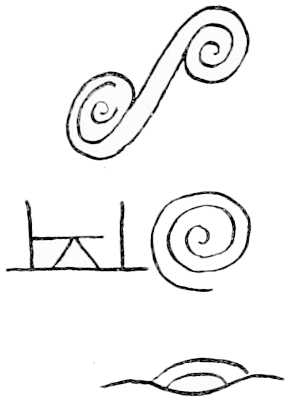
The following extract is taken from the work of Dr. S. Habel (a):
Santa Lucia is a village in the Republic of Guatemala, in the Department of Esquintla, near the base of the Volcano del Fuego, at the commencement of the inclined plane which extends from the mountain range to the coast of the Pacific Ocean. * * *
The sculptured slabs are in the vicinity of the village. The greater number of them form an extended heap, rendering it probable that there are others hidden from view that more extended researches would reveal. * * * All the sculptures, with the exception of three statues, are in low relief, nearly all being in cavo-relievo, that is, surrounded by a raised border, the height of which indicates the elevation of the relief. The same kind of relief was practiced by the ancient Assyrians and Egyptians.
In seven instances the sculpture represents a person adoring a deity of a different theological conception in each case. One of these seems to represent the sun, another the moon, while in the remaining five it is impossible to define their character. All these deities are represented by a human figure, of which only the head, arms, and breast are correctly portrayed, proving that the religious conceptions had risen to anthropomorphism, while the idols of the nations of Central America and Mexico, which have previously come to our knowledge, are represented by disfigured human forms or grotesque images.
Four of the other sculptures represent allegorical subjects; two of them the myth of the griffin, the bird of the sun.
The slabs on which the low reliefs are sculptured are of various sizes; the greater number of these, like those representing the deities, are 12 feet in length, 3 feet in width, and 2 feet in thickness. Nine feet of the upper part of these stones are occupied by the sculptures, while the lower 3 feet appear to have served as a base.
Several illustrations of these rock sculptures are presented, infra, as Figs. 1235 and 1236. It is evident that these very large slabs received their markings when they were in the locality in which they are now found so can be classed geographically.
Alexander von Humboldt (a) gives general remarks, now condensed, upon petroglyphs in South America:
In the interior of South America, between the second and fourth degrees of north latitude, a forest-covered plain is inclosed by four rivers, the Orinoco, the Atabapo, the Rio Negro, and the Cassiquiare. In this district are found rocks of granite and of syenite, covered with colossal symbolical figures of crocodiles and tigers, and drawings of household utensils, and of the sun and moon. The tribes nearest to its boundaries are wandering naked savages, in the lowest stages of human existence, and far removed from any thoughts of carving hieroglyphics on rocks. One may trace in South America an entire zone, extending through more than 8° of longitude, of rocks so ornamented, viz, from the Rupuniri, Essequibo, and the mountains of Pacaraima, to the banks of the Orinoco and of the Yupura. These carvings may belong to very different epochs, for Sir Robert Schomburgk even found on the Rio Negro representations of a Spanish galiot, which must have been of a later date than the beginning of the sixteenth century; and this in a wilderness where the natives were probably as rude then as at the present time. Some miles from Encaramada[143] there rises in the middle of the savannah the rock Tepu-Mereme, or painted rock. It shows several figures of animals and symbolical outlines which resemble much those observed by us at some distance above Encaramada, near Caycara. Rocks thus marked are found between the Cassiquiare and the Atabapo and, what is particularly remarkable, 560 geographical miles farther to the east, in the solitudes of Parime. Nicholas Hortsmann found on the banks of the Rupunuri, at the spot where the river winding between the Macarana mountains forms several small cascades, and before arriving at the district immediately surrounding lake Amucu, “rocks covered with figures,” or, as he says in Portuguese, “de varias letras.” We were shown at the rock of Culimacari, on the banks of the Cassiquiare, signs which were called characters, arranged in lines, but they were only ill-shaped figures of heavenly bodies, boa-serpents, and the utensils employed in preparing manioc meal. I have never found among these painted rocks (piedras pintadas) any symmetrical arrangement or any regular even-spaced characters. I am therefore disposed to think that the word “letras,” in Hortsmann’s journal, must not be taken in the strictest sense.
Schomburgk saw and described other petroglyphs on the banks of the Essequibo, near the cascade of Warraputa. Neither promises nor threats could prevail on the Indians to give a single blow with a hammer to these rocks, the venerable monuments of the superior mental cultivation of their predecessors. They regard them as the work of the Great Spirit, and the different tribes whom we met with, though living at a great distance, were nevertheless acquainted with them. Terror was painted on the faces of my Indian companions, who appeared to expect every moment that the fire of heaven would fall on my head. I saw clearly that my endeavors to detach a portion of the rock would be fruitless, and I contented myself with bringing away a complete drawing of these memorials. Even the veneration everywhere testified by the Indians of the present day for these rude sculptures of their predecessors show that they have no idea of the execution of similar works. There is another circumstance which should be mentioned. Between Encaramada and Caycara, on the banks of the Orinoco, a number of these hieroglyphical figures are sculptured on the face of precipices at a height which could now be reached only by means of extraordinarily high scaffolding. If one asks the natives how these figures have been cut, they answer, laughing, as if it were a fact of which none but a white man could be ignorant, that “in the days of the great waters their fathers went in canoes at that height.”
Mr. W. H. Holmes (b), of the Bureau of Ethnology, gives this account of petroglyphs in the province of Chiriqui, state of Panama:
Pictured rocks.—Our accounts of these objects are very meager. The only one definitely described is the “piedra pintal.” A few of the figures engraved upon it are given by Seemann, from whom the following paragraph is quoted:
“At Caldera, a few leagues (north) from the town of David, lies a granite block known to the country people as the piedra pintal or painted stone. It is 15 feet high, nearly 50 feet in circumference, and flat on the top. Every part, especially the eastern side, is covered with figures. One represents a radiant sun; it is followed by a series of heads, all with some variations, scorpions, and fantastic figures. The top and the other side have signs of a circular and oval form, crossed by lines. The sculpture is ascribed to the Dorachos (or Dorasques), but to what purpose the stone was applied no historical account or tradition reveals.”
These inscriptions are irregularly placed and much scattered. They are thought to have been originally nearly an inch deep, but in places are almost effaced by weathering, thus giving a suggestion of great antiquity. Tracings of these figures made recently by Mr. A. L. Pinart show decided differences in detail, and Mr. McNiel gives still another transcription.
In Fig. 105 Mr. McNiel’s sketch of the southwest face of the rock is presented.
Other illustrations from Colombia appear as Figs. 151 and 1166, infra.
The name of Guiana has been applied to the territory between the rivers Amazon, Orinoco, Negro, and Cassiquiare. It was once divided into the French, British, Dutch, Portuguese, and Spanish Guianas. The Portuguese Guiana now belongs to Brazil and Spanish Guiana is part of Venezuela. Many petroglyphs have been found in the several Guianas. They appear throughout the whole of the part belonging to Venezuela, but they are more thickly grouped in parts of the valley of the Orinoco.
The subject is well discussed in the following extract from Among the Indians of Guiana, by im Thurn (a):
The pictured rocks of Guiana are not all of one kind. In all cases various figures are rudely depicted on larger or smaller surfaces of rocks. Sometimes these figures are painted, though such cases are few and of but little moment; more generally they are graven on the rock, and these alone are of great importance. Rock sculptures may, again, be distinguished into two kinds, differing in the depth of incision, the apparent mode of execution, and, most important of all, the character of the figures represented.
Painted rocks in British Guiana are mentioned by Mr. C. Barrington Brown. He says that in coming down past Amailah fall, on the Cooriebrong river, he passed “a large white sandstone rock ornamented with figures in red paint.” * * * Mr. Wallace, in his account of his Travels on the Amazons, mentions the occurrence of similar drawings in more than one place near the Amazons. * * *
The engraved rocks must be of some antiquity; that is to say, they must certainly date from a time before the influence of Europeans was much felt in Guiana. As has already been said, the engravings are of two kinds and are probably the work of two different people; nor is there even any reason to suppose that the two kinds were produced at one and the same time.
These two kinds of engravings may, for the sake of convenience, be distinguished as “deep” and “shallow,” respectively, according as the figures are deeply cut into the rock or are merely scratched on the surface. The former vary from one-eighth to one-half of an inch, or even more, in depth; the latter are of quite inconsiderable depth. This difference probably corresponds with a difference in the means by which they were produced. The deep engravings seem cut into the rock with an edged tool, probably of stone; the shallow figures were apparently formed by long[145] continued friction with stones and moist sand. The two kinds seem never to occur in the same place or even near to each other; in fact, a distinct line may almost be drawn between the districts in which the deep and shallow kinds occur, respectively; the deep form occurs at several spots on the Mazeruni, Essequibo, Ireng, Cotinga, Potaro, and Berbice rivers. The shallow form has as yet only been reported from the Corentyn river and its tributaries, where, however, examples occur in considerable abundance. But the two kinds differ not only in the depth of incision, in the apparent mode of their production, and in the place of their occurrence, but also—and this is the chief difference between the two—in the figures represented.
Fig. 106 is a typical example of the shallow carvings.
Fig. 1104, infra, is a similar example of the deep carvings.
The shallow engravings seem always to occur on comparatively large and more or less smooth surfaces of rock, and rarely, if ever, as the deep figures, on detached blocks of rock, piled one on the other. The shallow figures, too, are generally much larger, always combinations of straight or curved lines in figures much more elaborate than those in the deep engravings; and these shallow pictures always represent not animals, but greater or less variations of the figure which has been described. Lastly, though I am not certain that much significance can be attributed to this, all the examples that I have seen face more or less accurately eastward.
The deep engravings, on the other hand, consist not of a single figure but of a greater or less number of rude drawings. * * * These depict the human form, monkeys, snakes, and other animals, and also very simple combinations of two or three straight[146] or curved lines in a pattern, and occasionally more elaborate combinations. The individual figures are small, averaging from 12 to 18 inches in height, but a considerable number are generally represented in a group.
Some of the best examples of this latter kind are at Warrapoota cataracts, about six days’ journey up the Essequibo.
* * * The commonest figures at Warrapoota are figures of men or perhaps sometimes monkeys. These are very simple and generally consist of one straight line, representing the trunk, crossed by two straight lines at right angles to the body line; one about two-thirds of the distance from the top, represents the two arms as far as the elbows, where upward lines represent the lower part of the arms; the other, which is at the lower end, represent the two legs as far as the knees, from which point downward lines represent the lower part of the legs. A round dot, or a small circle, at the top of the trunk line, forms the head; and there are a few radiating lines where the fingers, a few more where the toes, should be. Occasionally the trunk line is produced downwards as if to represent a long tail. Perhaps the tailless figures represent men, the tailed monkeys. In a few cases the trunk, instead of being indicated by one straight line, is formed by two curved lines, representing the rounded outlines of the body; and the body thus formed is bisected by a row of dots, almost invariably nine in number, which seem to represent vertebræ.
Most of the other figures at Warrapoota are very simple combinations of two, three, or four straight lines similar to the so-called “Greek meander pattern,” which is of such widespread occurrence. Combinations of curved and simple spiral lines also frequently occur. Many of these combinations closely resemble the figures which the Indians of the present day paint on their faces and naked bodies.
The same author (pp. 368, 369) gives the following account of the superstitious reverence entertained for the petroglyphs by the living Indians of Guiana:
Every time a sculptured rock or striking mountain or stone is seen, Indians avert the ill will of the spirits of such places by rubbing red peppers (Capsicum) each in his or her own eyes. * * * Though the old practitioners inflict this self-torture with the utmost stoicism, I have again and again seen that otherwise rare sight of Indians children, and even young men, sobbing under the infliction. Yet the ceremony was never omitted. Sometimes, when by a rare chance no member of the party had had the forethought to provide peppers, lime juice was used as a substitute; and once, when neither peppers nor limes were at hand, a piece of blue indigo-dyed cloth was carefully soaked, and the dye was then rubbed into the eyes.
The same author (b) adds:
It may be as well briefly to sum up the few facts that can be said, with any probability, of these rock pictures in Guiana. The engravings are of two kinds, which may or may not have had different authors and different intention. They were still produced after the first arrival of Europeans, as is shown by the sculptured ship. They were, therefore, probably made by the ancestors of the Indians now in the country; for, from the writings of Raleigh and other early explorers, as well as from the statements of early colonists, it is to be gathered that the present tribes were already in Guiana at the time of the first arrival of Europeans, though not perhaps in the same relative positions as at present. The art of stone-working being destroyed by the arrival of Europeans, the practice of rock-engraving ceased. Possibly the customary figures were for a time painted instead of engraved; but this degenerated habit was also soon relinquished. As to the intention of the figures, that they had some seems certain, but what kind this was is not clear. Finally, these figures really seem to indicate some very slight connection with Mexican civilization.
The following extract from a paper on the Indian picture-writing in[147] British Guiana, by Mr. Charles B. Brown (a), gives views and details somewhat different from the foregoing:
These writings or markings are visible at a greater or less distance in proportion to the depth of the furrows. In some instances they are distinctly visible upon the rocks on the banks of the river at a distance of 100 yards; in others they are so faint that they can only be seen in certain lights by reflected rays from their polished surfaces. They occur upon greenstone, granite, quartz-porphyry, gneiss, and jasperous sandstone, both in a vertical and horizontal position, at various elevations above the water. Sometimes they can only be seen during the dry season when the rivers are low, as in several instances on the Berbice and Cassikytyn rivers. In one instance, on the Corentyn river, the markings on the rock are so much above the level of the river when at its greatest height, that they could only have been made by erecting a staging against the face of the rock, unless the river was at the time much above its usual level. The widths of the furrows vary from half an inch to 1 inch, while the depth never exceeds one-fourth of an inch. * * * The furrows present the same weather-stained aspect as the rocks upon which they are cut. * * *
The Indians of Guiana know nothing about the picture-writing by tradition. They scout the idea of their having been made by the hand of man, and ascribe them to the handiwork of the Makunaima, their great spirit. * * *
As these figures were evidently cut with great care and at much labor by a former race of men, I conclude that they were made for some great purpose, probably a religious one, as some of the figures give indications of phallic worship.
Prof. R. Hartmann (a) presented a pencil drawing of a South American rock, covered with sculptures, sketched by Mr. Anton Goering, a painter in Leipzig, which is here reproduced as Fig. 107. The rock is situated not far from San Esteban, a village in the vicinity of Puerto Cabello, in Venezuela. C. F. Appun, in Unter den Tropen, I, p. 82, remarks as follows in reference to this “Piedra de los Indios” (Indians’ stone), a large granite block lying by the side of the road:
These drawings, cut in the stone to a depth of half an inch, mostly represent snakes and other animal forms, human heads and spiral lines, and differ from those which I afterward saw in Guiana, on the Essequibo and Rupununi, in characters[148] and forms, but their execution, like that of the latter, is rude. Though greatly weathered by the influence of rain and the atmosphere, the figures can still be perfectly distinguished and gigantic patience, such as none but Indians possess, was surely needed to carve them in the hard granite mass by means of a stone.
Dr. G. Marcano (a) gives an account translated as follows, which is connected with Fig. 108:
A tradition, the legend of the rock of Tepumereme, has been preserved by Father Gili. Some old writers, adhering to the Tamanak acceptation of the word, say indifferently tepumeremes or rocas pintadas (painted rocks). Usage has converted Tepumereme into a proper noun. At the present day it is applied exclusively to the rock situated some leagues from Encaramada, in the midst of the savanna, this rock having been the Mount Ararat of the Tamanaks.
Supposing that it is authentic, this legend, which we will relate further on [see page 33, supra], yields no information that might aid us in interpreting hieroglyphs, and so we are reduced to describing its principal characters.
Not all our pictographs correspond to the region of the Raudals, but in our ignorance of the peoples who carved them we see no harm in bringing them together so long as they all come from the banks of the Orinoco, and so long as the localities where they exist are indicated. The copies which we give of them have been very carefully made and reduced to one-tenth.
The first thing that strikes one on looking at them is that, despite differences in detail, the design presents a general common character. In fact, there is question not of figures with undecided forms, but with sure lines perfectly traced and combined in one and the same style. They are geometric designs rather than objective representations. The illustration [Fig. 108] came from a rock in the vicinity of Caïcara, a town situated on the right bank of the Orinoco, close to its last great bend. It represents three jaguars, one large and two small, the former being separated from the latter by an ornamented sun placed at the level of their feet. The spotting of their hides is rendered by means of angular lines arranged in so regular a manner that one might take them to be tigers did he not know that these felines never existed in these regions. The jaguars differ in insignificant details which, however, must have a purpose, in view of the general regularity. The largest shows six radiating lines on the muzzle and a circle in one of the ears. The second shows two hooks on the lower part of the body. The third is preceded by an isolated head, which is unfinished, without ears, inclined differently from the others. Some differences are also noted in the limbs.
Placed in the attitude of marching, these animals seem to descend from a height and to follow the same direction. Perhaps there is question here of a mnemonic whole, and, we might add, of a totem, if we knew that that system had been employed by the Indians of the region.
The same author (p. 205) gives a description of the petroglyphs of the rapids of Chicagua, here presented as Fig. 109.
This interesting collection includes the most varied ideographs.
Alongside of representations analogous to the preceding there appear new characters[149] and partial groupings which we had not yet found. On running over them one passes successively from simple points to figures made up of tangled lines, to objective representations, and even to letters of the alphabet, a resemblance which, of course, is fortuitous.
The first group begins by three points similar to those in Fig. 19 [of Marcano, occurring in Fig. 1105 in this paper], followed by two circles with central dots, and terminates below in a plexus of broken lines. The second group, placed at the right, is composed of regular figures of great variety. Among them we note the two lowest, one of which resembles a K and the other a reversed A. A spiral, two circles, one of which has two appendices, and a figure in broken lines make up the third group. Below is seen a coiled serpent. Its head is characteristic; it is found in other pre-Columbian carvings of the Orinoco. As regards design e, we will merely call attention to the sign analogous to the E of our alphabet. It is found at times in the United States of America. [For this remark the author refers to the ideograph for pain, in Figs. 824 and 872, infra.]
Design f is an animal difficult to characterize; its head and tail may be guessed at. The body is covered with ornaments and the legs, very incomplete, are in the attitude of running. Design g represents probably a tree with an appendix of undulating lines; design h, a head surmounted by a complicated headgear. This is the first distinctly human representation that we have found in the country. The strange combinations of designs j, k, and l exhibit the dots at the end of the lines which we have already spoken of. Design m resembles an M; design n shows a circle with plane face.
Thus we see that the statements of some travelers concerning mysterious hieroglyphic combinations are far from being realized. As regards the exaggerations of[150] Humboldt, they arise from the fact that he did not content himself with describing what he had seen. This is illustrated by the following sentence: “There is even seen on a grassy plain near Uruana an isolated granite rock on which, according to the account of trustworthy people, there are seen at a height of 80 feet deeply carved images which appear arranged in rows and represent the sun, the moon, and different species of animals, especially crocodiles and boas.” Elsewhere he speaks of kitchen and household utensils and of a number of objects which he can only have seen with the eyes of his imagination.
Other illustrations of pictographs in Venezuela are presented as Figs. 152, 153, 1105 and 1106, infra.
Remarks of general applicability to this region are made by Mr. J. Whitfield (a), an abstract of which follows:
The rock inscriptions were visited in August, 1865. Several similar inscriptions are said to exist in the interior of the province of Ceará, as well as in the provinces of Pernambuco and Piauhy, especially in the Sertaōs, that is, in the thinly-wooded parts of the interior, but no mention is ever made of their having been seen near the coast.
In the margin and bed only of the river are the rocks inscribed. On the margin they extend in some instances to 15 or 20 yards. Except in the rainy season the stream is dry. The rock is a silicious schist of excessively hard and flinty texture. The marks have the appearance of having been made with a blunt, heavy tool, such as might be made with an almost worn-out mason’s hammer. The situation is about midway between Serra Grande or Ibiapaba and Serra Merioca, about 70 miles from the coast and 40 west of the town Sobral. The native population attribute all the “Letreiros” (inscriptions), as they do everything else of which they have no information, to the Dutch, as records of hidden wealth. The Dutch, however, only occupied the country for a few years in the early part of the seventeenth century. Along the coast numerous forts, the works of the Dutch, still remain; but there are no authentic records of their ever having established themselves in the interior of the country, and less probability still of their amusing themselves with inscribing puzzling hieroglyphics, which must have been a work of time, on the rocks of the far interior, for the admiration of wandering Indians.
Mr. Franz Keller (a) narrates as follows regarding Fig. 110:
I found a “written rock” covered with spiral lines and concentric rings, evenly carved in the black gneiss-like material, and similar to those of the Caldeirão. Looking about for more, I discovered a perfect inscription, whose straight orderly lines can hardly be thought the result of lazy Indians’ “hours of idleness.” These characters were incised on a very hard smooth block 3 feet 4 inches in length, and 3¼ feet in height and breadth. It lay at an angle of 45°, only 8 feet above low water, and close to the water’s edge of the second smaller rapid, the Cachoeira do Ribeirão. The transverse section of the characters is not very deep, and their surface is as worn as that of the inscription farther down. In some places they are almost effaced by time and are to be seen distinctly only with a favorable light. A dark brown coat of glaze, found everywhere on the surface of the stones, laved at times by the water, covers the block so uniformly well on the concave glyphs as on the parts untouched by instrument, that many ages must have elapsed since some patient Indian spent long hours in cutting them out with his quartz chisel. As the lines of the inscription run almost perfectly horizontally, and as the figures near the Caldeirão and the Cachoeira and the Cachoeira das Lages are so little above low-water mark, the present position of the block seems to have been the original one. * * * On the rocky shores of the Araguaya, that huge tributary of the Tocantino, there are similar rude outlines of animals near a rapid called Martirios, from the first Portuguese explorers[151] fancying they recognized the instruments of the Passion in the clumsy representation.
Dr. Ladisláu Netto (a) gives the illustration, reproduced as Fig. 111, of an inscription discovered by Domingos S. Ferreira Penna on the rock called Itamaraca, on the Rio Xingu. Dr. Netto’s description is translated as follows:
This whole inscription seems to represent one idea, figuring a collection of villages of vast proportions, inclosed by fortifications on two sides, at which it seems most accessible. On these same sides this collection of villages has external constructions or means of security, a kind of meanders or symbolic figures, which perhaps signify difficulties besetting the communication of the inhabitants with the surrounding fields.
In the lower part of the left-hand side there is a group of figures which seem to represent residences of chiefs, war houses, or redoubts, built near the principal entrance to the villages or to the city for its defense. There are found three figures of saurians, one with a large tail, on the side of the redoubts or fortified houses, as if representing the population, and two with small tails, which seem strange, and which walk toward the first.
This inscription is evidently the most perfect and the most notable of those found till now in all America [?], not only by its perfect condition and dimensions, but also by the mode in which a series of ideas has here been brought together.
The same author, on p. 552, furnishes copies of inscriptions carved on stones in the valley of the Rio Negro, and remarks: “In this series there are notable the two crowned personages [represented here in Fig. 112], one of whom holds a staff in the right hand, and below and under them there are two figures of capibars (sea-hogs) facing each other, and whose representation in black color resembles some figures from the inscriptions of North America.”
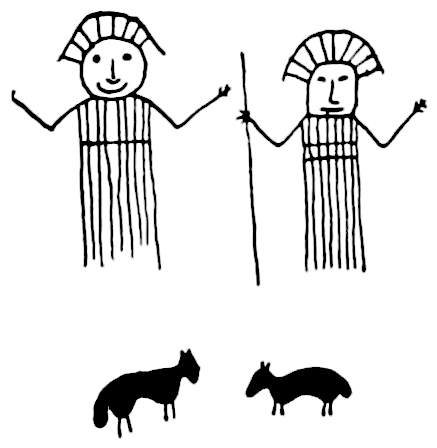
The following account is in Dr. E. R. Heath’s (a) Exploration of the River Beni:
Hieroglyphics were found on rocks at the falls and rapids of the rivers Madeira and Mamoré. * * * By accident we found some at the rapids at the foot of Caldierão do Inferno. Designs d and b are figures on the same rock side by side. a is another face of the same rock 10 feet across. e and f are on the upper surface of a rock, and c on one of its sides near the bottom; g is upon a rock 15 feet above the surface of the river. Many more were on the other rocks, but our time did not permit further copying. Mr. T. M. Fetterman, my companion, and myself sketched as fast as possible.
Fig. 113 is a reproduction of the illustration given.
The moment we arrived at the falls of Girão we searched for stone carvings, finding a few, and several repetitions of circles similar to those already found. Designs a and d are on the west and east side of the same rock, which is 9 feet in length. The figure is 21 inches high, the five circles 1 foot across. The east side was almost obliterated. Designs b and c are on loose stones; b, facing west, is 16 inches long; the rock is 50 inches long and 35 wide; c is 22 inches long; the rock 70 inches long by 27 inches broad, and was 30 feet above the river at date. The rocks are basaltic,[153] dipping north at an angle of 86°. Many small stones, 1 and 2 feet in diameter, lie about, with marks on them nearly defaced.
Fig. 114 is a reproduction of the illustration.

At Pederneira all the rocks on the right side at the foot of the rapids are literally covered with figures. Fig. 115 a is on a large bowlder facing the south; b has joined to its right side, c; d, e, and f are on the same stone. Most of these rocks are only a few feet above low water and are covered at least eight months each year.
At Araras rapids the river is very wide, [containing] two islands and a rocky ledge crossing the river from the rapid. Nearly all the rocks on the right bank are covered with figures.
These are reproduced in Fig. 116.
Having no small canoe we could not pass a small channel so as to gather copies of the figures we could see at a distance. The approaches both above and below the rapids and falls are many times as difficult to pass as the rapid or fall itself, giving rise to the division into “head,” “body,” and “tail.” Some not only have these divisions, but also have these subdivided into “head, body, and tail.” One is constantly hearing “el rabo,” “el rabo del rabo,” “el rabo del cuerpo,” or “cabeza,” and so on.
Ribeiráo.—The tail of the rapid is 3 miles in length, a continuous broken current and fields of rocks. It is here, on a rock but a foot or two above the river, that the hieroglyphic shown in F. Keller’s “Amazon and Madeira” is found. As both Mr. Fetterman and myself made copies of it, unknown to the other till finished, our copies may be relied on, although differing from Keller’s. The length[155] of the upper part is 45 inches and of the lower 36 inches, with 13 inches depth of each.
The copy mentioned is given here as Fig. 117.

The character of the lower right-hand corner was at one time as clearly cut as we represent it, some of the edges being yet clear and distinct.
At the rapid of Madeira there were a number of circles similar to 15 and 16 at Ribeiráo. On a ridge of rocks in the middle of the river, just above Larges rapids, are figures, and we had only time to sketch one, Fig. 118.
At Pao Grande we had a better harvest, showing evidently a later period than the former. One could easily believe these were made at the time of the Spanish conquest, the anchors, shields, and hearts being so often found in Spanish religious rites. Without doubt these were notices for navigators, as they were only out of water and seen when that passage was dangerous. Where projecting points of rock gave a face both up and down stream the same figure was on both faces. These rocks are syenitic granite and are cut to a depth of a half inch.
Fig. 119 is a reproduction of the copy published.
Senhor Tristão de Alencar Araripe (a) gives a large number of descriptions with illustrations, a selection of which, with translations, is as follows:
In the province of Ceará district of Inhamun, on the plantation of Carrapateira, is a small hill (or mound). On the face of one of its rocks, on the eastern side, near the edge of the road, is the inscription given in Fig. 120 painted in red.
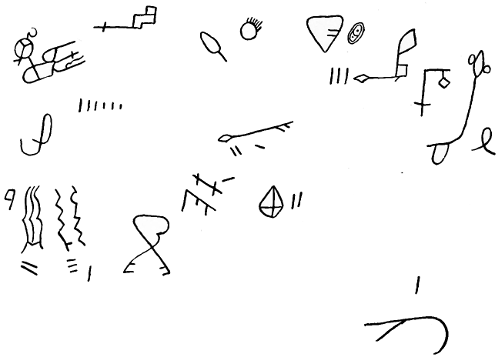
In the district of Inhamun, on the plantation of Carrapateira, in Morcego, on the top of a mound, is a semicircular stone bearing on the face toward the mound the four characters which appear in Fig. 121.

In Inhamun, on the plantation of Carrapateira, in Morcego, is a large stone mound, the stones being piled up in a form of a tower; and in the inside of this tower, on the south or southwest side, are the characters given in Fig. 122 painted in bright, cochineal color.
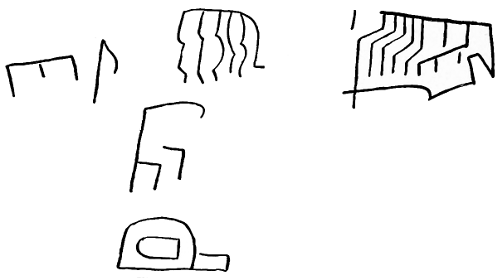
Near the road from Cracará to Favelas, Inhamun, is a large rock, on the face of which, at the top of the western side, is the inscription [given on the upper part of Fig. 123,] all in red paint, as is also that following.
The under part of this rock forms a shelter, and on the roof of this shelter are all the remaining characters of the figure.
To the right or south of the shelter containing the inscription is a stone, with the form of the figure represented in the third place in the lower row of characters, counting from left to right, on a small heap, with the rear end raised up and the sharp point toward the east, its side inclining toward the west, in such a way that it can be climbed to the end which is erect.
On the same side, at the south, but beyond this, on the top of a rise, is a mound in sight, which is represented by the figure [delineated in the lower part of Fig. 123 at the extreme right,] resembling an inclosure (corral) with the 21 small lines before it.
Fig. 124 is a copy of an inscription at Pedra Lavrada, Province of Parahiba, published loc. cit., but the description by Senhor de Alencar Araripe is very meager, amounting in substance to the following:
This is an inscription of vast proportions on a large rock in the town of Pedra Lavrada, which takes its name from that of the rock.
Other petroglyphs in Brazil are copied in Figs. 1107, 1108, 1109, 1110, 1111, 1113, 1114, and also under the heading of Cup Sculptures, Chapter V, infra.
F. P. Moreno (a), Museo de La Plata, Catamarca, gives an illustration of an inscribed rock at Bajo de Canota, Mendoza, reproduced as Fig. 125.
The following account is furnished by Messrs. de Rivero and Von Tschudi (a):
Eight leagues north of Arequipa there exist a multitude of engravings on granite which represent figures of animals, flowers, and fortifications, and which doubtless tell the story of events anterior to the dynasty of the Incas.
The illustration presented is copied here as Fig. 126.
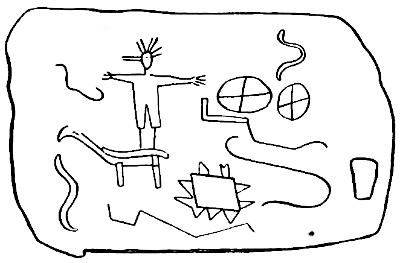
The account is continued as follows:
In the province of Castro-Vireyna, in the town of Huaytara, there is found in the ruins of a large edifice, of similar construction to the celebrated palace of old Huanuco, a mass of granite many square yards in size, with coarse engravings like those last mentioned near Arequipa. None of the most trustworthy historians allude to these inscriptions or representations, or give the smallest direct information concerning the Peruvian hieroglyphics, from which it may possibly be inferred that in the times of the Incas there was no knowledge of the art of writing in characters and that all of these sculptures are the remains of a very remote period. * * * In many parts of Peru, chiefly in situations greatly elevated above the sea are vestiges of inscriptions very much obliterated by time.
The illustration is copied here as Fig. 127.
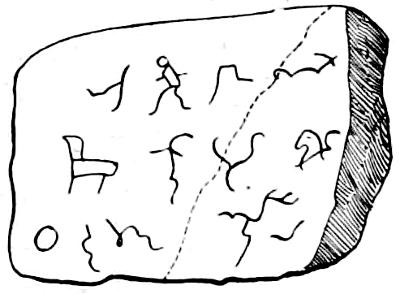
Charles Wiener (a), in Pérou et Bolivie, gives another statement, viz:
The archeologists of Peru have only found a single point—Tiahuanaco—where there were a limited number, though very interesting, of signs on rocks or stones which seemed to all observers to be symbolic. While there are a few petroglyphs found in Peru there are a large number of inscriptions properly so called on the tissues which cover or are found in connection with remains in the graves.
A number of pictographs from Peru are described and illustrated infra (see Figs. 688, 720, and 1167).
Prof. Edwyn C. Reed, of Valparaiso, Chile, presented through A. P. Niblack, ensign U. S. Navy, a photograph of a large bowlder bearing numerous sculpturings. No information pertaining to the locality at which the rock is situated or details respecting the characters upon it were furnished. The photograph is reproduced in Fig. 128.
Mr. R. A. Philippi, of Santiago, a corresponding member, made a communication to the Berliner Gesellschaft für Anthropologie, session of January 19, 1876, page 38, from which the following is extracted and translated:
I made a visit to the valley “Cajon de los Cipreses” in order to see the glacier giving rise to the Rio de los Cipreses, a tributary of the Cachapoal, and on that occasion had a cursory view of a rock with some pictures. I send you herewith a drawing of the rock and some of the figures cut on it. The rock, a kind of greenstone, lies at an altitude of about 5,000 feet above sea level, and the surface covered with figures, gently inclined down to the ground, may be 8 feet long and 5 or 6 feet high. The lines are about 4 mm. broad and 1 to ½ mm. deep. The carved figures on the stone are without any sort of order. When I spoke before a meeting of our faculty of physical and mathematical sciences concerning this stone which the shepherds of the region called piedra marcada, I learned that similar stones with carved figures are found in various places.
The figure mentioned is here reproduced as Fig. 129.
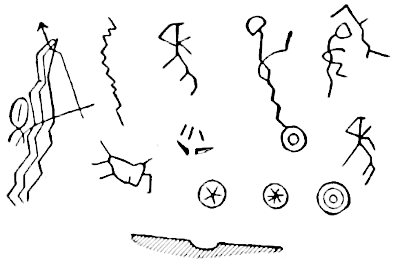
The term “extra-limital,” familiar to naturalists, refers in its present connection to the sculptures, paintings, and drawings on rocks beyond the continents of North and South America, which are now introduced for comparison and as evidence of the occurrence throughout the world of similar forms in the department of work now under examination.
Mr. Edward G. Porter (a), in “The Aborigines of Australia,” says: “Their rock carvings are only outline sketches of men, fish, animals, etc., sometimes seen on the top of large flat rocks. Two localities are mentioned, one on Sydney common and another on a rock between Brisbane water and Hawkesbury river.”
Much more detailed information is given by Thomas Worsnop, viz:
At Chasm island, which lies 1½ miles from “Groote Eylandt,” in the steep sides of the chasms, were deep holes or caverns undermining the cliffs, upon the walls of which are found rude drawings, made with charcoal and something like red paint, upon the white ground of the rock. These drawings represented porpoises, turtle, kangaroos, and a human hand, and Mr. Westall found the representations of a kangaroo with a file of thirty-two persons following after it.
In the MacDonnell ranges, 6 miles from Alice springs, in a large cave, there were paintings made by the aborigines, well defined parallel lines, intersected with footprints of the emu, kangaroo rat, and birds, with the outlines of iguana, hands of men, well sketched and almost perfect.
The parallel lines were of deep red and yellow colors, with brown and white borders; the footprints of light red, light yellow, and black; the outlines of the animals and hands were of red, yellow, white, black, wonderfully (considering it was done by savages) displayed and blended. All the paintings were in good preservation and evidently touched up occasionally, as they looked quite fresh.
I can only conjecture that these paintings were left as a record, a life-long charm, against the total destruction of the above animals. The paintings were seen by Mr. S. Gason, of Beltana, in the year 1873.
Very interesting groups of native drawings are to be seen in the caves of the Emily gorge in the MacDonnell ranges. Many of these drawings represent life-size objects.
The same author, page 20, describes the petroglyph copied in Fig. 130 as follows:
Mr. Arthur John Giles in the year 1873 discovered, at the junction of Sullivan’s creek with the Finke river, carvings on rocks. The sketch represents a smooth-faced rock, portion of a rock cliff about 45 feet high, composed of hard metamorphic slate. The lower portion of the sculptured face has been worn and broken away, forming a sort of cave. From the level of the creek to the lower edge of the sculptured rock is about 15 feet. The perpendicular lines are cut out, forming semicircular grooves about 1½ inches in diameter, cut in to a depth of nearly half an inch; all remaining figures are also carved into the solid rock to a depth of one-fourth of an inch.
The same author, page 14, gives the following description of some pictures discovered between 1831 and 1840 by Capt. Stokes on Depuch island, one of the Forestier group in Dampier archipelago, on the western coast of Australia:
Depuch island would seem to be their favorite resort, and we found several of their huts still standing. The natives are doubtless attracted to the place partly by the reservoirs of water they find among the rocks after rain; partly that they may enjoy the pleasure of delineating the various objects that attract their attention on the smooth surface of the rocks. This they do by removing the hard red outer coating and baring to view the natural color of the greenstone, according to the outline[163] they have traced. Much ability is displayed in many of these representations, the subject of which could be discovered at a glance. The number of specimens are immense, so that the natives must have been in the habit of amusing themselves in this innocent manner for a long period of time.
These savages of Australia, who have adorned the rocks of Depuch island with their drawings, have in one thing proved themselves superior to the Egyptian and the Etruscan, whose works have elicited so much admiration and afforded food to so many speculations, namely, there is not in them to be observed the slightest trace of indecency.
Fig. 131 shows a number of the characters drawn on these rocks. They are supposed to represent objects as follows:
a, a goose or duck; b, a beetle; c, a fish, with a quarter moon over, considered to have some reference to fishing by moonlight; d, a native, armed with spear and wommera or throwing stick, probably relating his adventures, which is usually done by song and accompanied with great action and flourishing of weapons, particularly when boasting of his powers; e, a duck and a gull; f, a native in a hut, with portion of the matting with which they cover their habitations; g, shark and pilot fish; h, a corroboreeo or native dance; i, a native dog; j, a crab; k, a kangaroo; l, appears to be a bird of prey, having seized upon a kangaroo rat.
The same author, page 5, describes another locality as follows:
In New South Wales, in the neighborhood of Botany bay and port Jackson, the figures of animals, of shields and weapons, and even of men, have been found carved upon the rocks, roughly, indeed, but sufficiently well to ascertain very fully what was the object intended. Fish were often represented, and in one place the form of a large lizard was sketched out with tolerable accuracy. On top of one of the hills the figure of a man, in the attitude usually assumed by them when they begin to dance, was executed in a still superior style.
The figure last mentioned was probably the god Daramūlŭn, see Howitt, Australian Customs of Initiation (a).
A special account of the aboriginal rock carvings at the head of Bantry bay is furnished by R. Etheridge, jr. (a), as follows, the illustration referred to being presented here as Fig. 132:
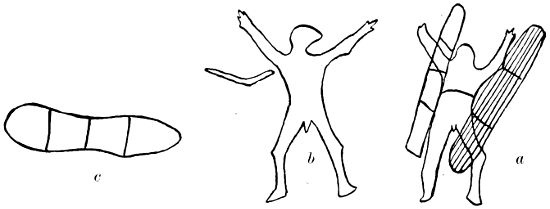
Of the numerous traces of aboriginal rock carvings to be seen on the shores of Port Jackson, none probably equal in extent or completeness of detail those on the heights at the head and on the eastern side of Bantry bay, Middle harbor, Australia.
The table of sandstone over which the carvings are scattered measures 2 chains in one direction by 3 in the contrary, and has a gentle slope of 7 degrees to the southwest. The high road as now laid out passes over a portion of them. * * *
The figures are represented in their present state in outline by a continuous indentation or groove from 1 to 1½ inches broad by half an inch to 1 inch in depth. Some are single subjects scattered promiscuously over the surface; others form small groups, illustrating compound subjects, but all appear to have been executed about one and the same time. * * *
An advance on the other sculptures existing at this place seems to be made in the originals of the designs a and b, from the fact that an attempt was apparently made to represent a compound idea in the form of a single combat between two warriors. The figures are quite contiguous to one another. The individual marked a seems to be holding in his right hand a body similar to that represented as c, and the position in which it is held would lend color to the belief in its shield-like nature. In the opposite hand are a bundle of rods which have been suggested to be spears, and this explanation for the want of a better may be accepted. On the other hand, we are confronted with the fact that these weapons of offense and defense are held in the wrong hands, unless the holder be regarded as sinistral; otherwise it must be conceived that the warrior’s back is presented to the observer, which is contrary to the other evidence existing in the carving. The opponent, marked as b, with legs astride and arms outstretched much in the position of an aboriginal when throwing the boomerang, is equally definitive. I conceive it quite possible that the position of[165] the boomerang close to the right hand conveys the idea that this man has just thrown the missile at the subject of a, allowing, of course, for the want of a knowledge of perspective on the part of the aboriginal artist. * * *
In several other figures the head is a mere rounded outline, but in b it is presented with a rather bird-like appearance. Another peculiarity is the great angularity given to the kneecap: this is visible both in a and b. It is further exemplified in the elbow of the left arms of both a and b.
The term “Oceanica” is used here without geographic precision, to include several islands not mentioned in other sections of the present work, in different parts of the globe, where specially interesting petroglyphs have been found and made known in publications. Although more such localities are known than are now mentioned, the pictographs from them are not of sufficient importance to justify description or illustration, but it may be remarked that they show the universality of the pictographic practice.
Dr. Julius von Haast (a) published notes, condensed as follows, descriptive of the illustration produced here as Fig. 133:
The most remarkable petroglyphs found in New Zealand are situated about 1 mile on the western side of the Weka Pass road in a rock shelter, which is washed out of a vertical wall of rock lining a small valley for about 300 feet on its right or southern side. The whole length of the rock below the shelter has been used for painting, and it is evident that some order has been followed in the arrangement of the subjects and figures. The paint consists of kokowai (red oxide of iron), of which the present aborigines of New Zealand make still extensive use, and of some fatty substance, such as fish oil, or perhaps some oily bird fat. It has been well fixed upon the somewhat porous rock and no amount of rubbing will get it off.
Some of the principal objects evidently belong to the animal kingdom, and represent animals which either do not occur in New Zealand or are only of a mythical or fabulous character. The paintings occur over a face of about 65 feet, and the upper end of some reaches 8 feet above the floor, the average height, however, being 4 to 5 feet. They are all of considerable size, most of them measuring several feet, and one of them even having a length of 15 feet.
Beginning at the eastern end in the left-hand corner is the representation a of what might be taken for a sperm whale with its mouth wide open diving downward. This figure is 3 feet long. Five feet from it is another figure c, which might also represent a whale or some fabulous two-headed marine monster. This painting is 3 feet 4 inches long. Below it, a little to the right in d, we have the representation of a large snake possessing a swollen head and a long protruding tongue. This figure is nearly 3 feet long, and shows numerous windings.
It is difficult to conceive how the natives in a country without snakes could not only have traditions about them but actually be able to picture them, unless they had received amongst them immigrants from tropical countries who had landed on the coasts of New Zealand.
Between the two fishes or whales is b, which might represent a fishhook, and below the snake d a sword e with a curved blade.
Advancing toward the right is a group which is of special interest, the figure i, which is nearly a foot long, having all the appearance of a long-necked bird carrying the head as the cassowary and emu do, and as the moa has done. If this design should represent the moa, I might suggest that it was either a conventional way of drawing that bird or that it was already extinct when this representation was painted according to tradition; in which latter case k might represent the taniwha or gigantic fabulous lizard which is said to have watched the moa. h is doubtless a quadruped, probably a dog, which was a contemporary of the moa and was used also as food by the moa hunters. j is evidently a weapon, probably an adz or tomahawk, and might, being close to the supposed bird, indicate the manner in which the latter was killed during the chase. The post, with the two branches near the top l, finds a counterpart in the remnant of a similar figure g between the figures c and i. They might represent some of the means by which the moa was caught or indicate that it existed in open country between the forest. m, under which the rock in the central portion has scaled off, is like f, one of the designs which resemble ancient oriental writing.
Approaching the middle portion of the wall we find here a well-shaped group of paintings, the center of which n has all the appearance of a hat ornamented on the crown. The rim of this broad-brimmed relic measures 2 feet across. The expert of ancient customs and habits of the Malayan and South Indian countries might perhaps be able to throw some light upon this and the surrounding figures, o to r.
From q, which is altogether 3 feet high, evidently issues fire or smoke; it therefore might represent a tree on fire, a lamp or an altar with incense offering. * * * The figure o is particularly well painted, and the outlines are clearly defined, but I[167] can make no suggestion as to its meaning. In s we have, doubtless, the picture of a human being who is running away from q, the object from the top of which issues fire or smoke. I am strengthened in my conviction that it is meant for a man by observing a similar figure running away from the monster aa. p, which has been placed below that group, might be compared to a pair of spectacles, but is probably a letter or an imitation of such a sign.
A little more to the right a figure 6 feet long is very prominent. It is probably the representation of a right whale in the act of spouting. Above it, in v, the figure of a mantis is easily recognizable, whilst u and the characters to the right below the supposed right whale again resemble cyphers or letters. w and y, although in many respects different, belong doubtless to the same group, and represent large lizards or crocodiles. * * * w is 4 feet long; it is unfortunately deficient in its lower portion, but it is still sufficiently preserved to show that besides four legs it possesses two other lower appendages, of which one is forked and the other has the appearance of a trident. I wish also to draw attention to the unusual form of the head. y is a similar animal 3 feet long, but it has eight legs, and head and tail are well defined. The head is well rounded off, and both animals represent, without doubt, some fabulous animal, such as the taniwha, which is generally described as a huge crocodile, of which the ancient legends give so many accounts.
aa, a huge snake-like animal 15 feet long, is probably a representation of the tuna tuoro, a mythical monster. It is evident that the tuna tuoro is in the act of swallowing a man, who tries to save himself by running away from it.
Mr. A. Langen (a) made a report on the Kei islands and their Ghost grottoes, with a plate now reproduced as Fig. 134. He says:
The group of the small Kei islands, more correctly Arue islands [southwest from New Guinea], is a sea bottom raised by volcanic forces and covered with corals and shells. The corals appear but at a few points. They are in the main covered with a layer of shells cemented together, whose cement is so hard and firm that it offers resistance to the influence of time even after the shell has been weathered away.
On the whole, all the figures in similar genre are represented in thousands of specimens. [They may be divided into three series, the first including letters a to k; the second, letters l to t; the third, letters u to cc.] Many are effaced and unrecognizable, only letter k, series 1; letters n, o, s, t, series 2; and letters cc, series 3, stand isolated and seem to have a peculiar meaning. The popular legend ascribes the greatest age to the characters of series 1 and series 2, and it is said that the signs record a terrible fight in which the islanders lost many dead, but yet remained victors. It is stated that the signs were produced by the ghosts of the fallen. The signs of series 3 are said to be the work of a woman named Tewaheru, who was able to converse with ghosts as well as with the living. But, when on one occasion she helped a living man to recover his dead wife by betraying to him the secret of making the spirit return to the body, she is said to have been destroyed by the ghosts and changed into a blackbird, whose call even at this day indicates death. Since that time no medium is said to exist between the living and the dead, nor do any new signs appear on the rock.
Investigation in place showed me that the color of series 3 consists of ocher made up with water. The very oldest drawings seem to have been made with water color, as the color has nowhere penetrated into the rock. Most of the figures are painted on overhanging rocks in such a way as to be protected as much as possible against wind and weather; whether they bear any relation to the signs on the rocks of Papua, and what that relation may be, I am not yet able to judge.
It may safely be assumed that the caves as abodes of spirits were sacred, but did not serve as places of burial. The lead rings and pieces of copper gongs found in small number before some of the caves seem to be derived from sacrifices offered to the spirits. At the present day no more sacrifices are offered there, and the islanders knew nothing of the existence of these things.
In this island carved human figures of colossal size have been frequently noticed in various publications, with and without illustrations, but apart from those statues ancient stone houses remain in which have been found large stone slabs bearing painted figures. Paymaster William J. Thompson, U. S. Navy (a) says of the Orongo houses, that the “smooth slabs lining the walls and ceilings were ornamented with mythological figures and rude designs painted in white, red, and black pigments.” The figures partake of the form of fish and bird-like animals, the exaggerated outlines clearly indicating mythologic beings, the type of which does not exist in nature. Fig. 135 is presented here, extracted by permission from the work above cited, and it may be of interest to know that nearly all, if not all, of the original specimens are now deposited in the U. S. National Museum.
While the curious carvings on the wooden tablets which are discussed in the work of Paymaster Thompson are not petroglyphs, it seems proper to mention them in this connection. Fig. 136 is taken from Mittheilungen der Anthropologischen Gesellschaft, in Wien (a), and shows one of the tablets, which does not appear to be presented in this exact form in the work before mentioned.
The following remarks by Prof. de Lacouperie (b) are quoted on account of the eminence of his authority, though the subject is still under discussion:
The character of eastern India, the Vengi-Châlukya, was also carried to north Celebes islands. The people have not remained at the level required for the practical use of a phonetic writing. It is no more used as an alphabet. Curiously enough, it is employed as pictorial ornaments on the MSS. they now write in a pictographic style of the lowest scale. This I have seen on the facsimile (Bilderschriften des Ostindischen Archipels, Pl. I, 1, 11) published by Dr. A. B. Meyer, of Dresden, in his splendid album on the writings of this region.
In the Easter island, or Vaihu, some fourteen inscriptions have been found incised on wooden boards, perhaps of driftwood. The characters are peculiar. Most of them display strange shapes, in which, with a little imagination, forms of men, fishes, trees, birds, and many other things have been fancied. A curious characteristic is that the upper part of the signs are shaped somewhat like the head of the herronia or albatross. A pictorial tendency is obvious in all of these. Some persons in Europe have taken them for hieroglyphics, and have ventured to find a connection with the flora and fauna of the island. The knowledge of this writing is now lost; and it is not sure that the few priests and other men of the last generation who boasted of being able to read them could do so thoroughly. Anyhow, in 1770, some chiefs were still able to write down their names on a deed of gift when the island was taken in the name of Carlos III of Spain.
In examining carefully the characters I was struck by the forked heads of many of them, which reminded me of the forked matras of the Vengi-Châlukya inscriptions. A closer comparison with Pls. i to viii of the Elements of South Indian Paleography (A. C. Burnell, Elements of South Indian Paleography, from the fourth to the seventeenth century A. D., being An Introduction to the Study of South Indian Inscriptions and MSS., 2d edit., London and Mangalore, 1878; Pls. i, vii, viii are specially interesting for the forked matras) soon showed me that I was on the right track, and a further study of the Vaihu characters, and their analysis by comparing the small differences (vocalic notation) existing between several of them, convinced me that they are nothing else than a decayed form of the above writing of southern India returning to the hieroglyphical stage. With this clue, the inscriptions[171] of Easter island are no more a sealed text. They can easily be read after a little training. Their language is Polynesian, and I can say that the vocabulary of the Samoan dialect has proved very useful to me for the purpose.
In the more settled and civilized parts of Europe petroglyphs are now rarely found. This is, perhaps, accounted for in part by the many occasions for use of the inscribed rocks or by their demolition during the long period after the glyphs upon them had ceased to have their original interest and significance and before their value as now understood had become recognized. Yet from time to time such glyphs have been noticed, and they have been copied and described in publications.
But few of the petroglyphs in the civilized portions of Europe not familiar by publication have that kind of interest which requires their reproduction in the present paper. It may be sufficient to state in general terms that Europe is no exception to the rest of the world in the presence of petroglyphs.
A number of these extant in the British islands and in the Scandinavian peninsula, besides the few examples presented in this chapter, are described and illustrated in other parts of this work, and brief accounts of others recently noted in France, Spain, and Italy are also furnished.
Nearly all of the petroglyphs found in the British islands, accounts of which have been published, belong to the class of cup sculptures discussed in Chapter V, infra, but several inscriptions showing characters not limited to that category are mentioned in “Archaic Rock Inscriptions,” (a) from which the following condensed extract referring to a cairn in county Meath, Ireland, is taken:
The ornamentation may be thus described: Small circles, with or without a central dot; two or many more concentric circles; a small circle with a central dot, surrounded by a spiral line; the single spiral; the double spiral, or two spirals starting from different centers; rows of small lozenges or ovals; stars of six to thirteen rays; wheels of nine rays; flower ornaments, sometimes inclosed in a circle or wide oval; wave-like lines; groups of lunette-shaped lines; pothooks; small squares attached to each other side by side, so as to form a reticulated pattern; small attached concentric circles; large and small hollows; a cup hollow surrounded by one or more circles; lozenges crossed from angle to angle (these and the squares produced by scrapings); an ornament like the spine of a fish with ribs attached, or the fiber system of some leaf; short equiarmed crosses, starting sometimes from a dot and small circle; a circle with rays round it, and the whole contained in a circle; a series of compressed semicircles like the letters ∩ ∩ ∩ inverted; vertical lines far apart, with ribs sloping downwards from them like twigs; an ornament like the fiber system of a broad leaf, with the stem attached; rude concentric circles with short rays extending from part of the outer one; an ornament very like the simple Greek fret, with dots in the[172] center of the loop; five zigzag lines and two parallel lines, on each of which, and pointing toward each other, is a series of cones ornamented by lines radiating from the apex, crossed by others parallel to the base—this design has been produced by scraping, and I propose to call it the Patella ornament, as it strikingly resembles the large species of that shell so common on our coasts, and which shell Mr. Conwell discovered in numbers in some of the cists, in connection with fragments of pottery and human bones; a semicircle with three or four straight lines proceeding from it, but not touching it; a dot with several lines radiating from it; combinations of short straight lines arranged either at right angles to or sloping from a central line; an S-shaped curve, each loop inclosing concentric circles; and a vast number of other combinations of the circle, spiral, line, and dot, which can not be described in writing.
Some of the ancient “Turf-Monuments” of England are to be classed as petroglyphs. The following extracts from the work of Rev. W. A. Plenderleath (b) give sufficient information on these curious pictures:
Although all the White Horses, except one, are in Wiltshire, that one exception is the great sire and prototype of them all, which is at Uffington, just 2½ miles outside the Wiltshire Boundary and within that of Berkshire. * * * The one mediæval document in which the White Horse is mentioned is a cartulary of the Abbey of Abingdon, which must have been written either in the reign of Henry II or soon after, and which runs as follows: “It was then customary amongst the English that any monks who wished might receive money or landed estates and both use and devolve them according to their pleasure. Hence two monks of the monastery at Abingdon, named Leofric and Godric Cild, appear to have obtained by inheritance manors situated upon the banks of the Thames; one of them, Godric, becoming possessed of Spersholt, near the place commonly known as the White Horse Hill, and the other that of Whitchurch, during the time that Aldhelm was abbot of this place.”
This Aldhelm appears to have been abbot from 1072 to 1084, and from the terms in which the White Horse Hill is mentioned the name was evidently an old one at that time.
Now it was only two hundred years before this time, viz, in 871, that a very famous victory had been gained by King Alfred over the Danes close to this very spot. “Four days after the battle of Reading,” says Asser, “King Æthelred, and Alfred, his brother, fought against the whole army of the pagans at Ashdown. * * * And the flower of the pagan youths were there slain, so that neither before nor since was ever such destruction known since the Saxons first gained Britain by their arms.” And it was in memory of this victory that, we are informed by local tradition, Alfred caused his men, the day after the battle, to cut out the White Horse, the standard of Hengist, on the hillside just under the castle. The name Hengist, or Hengst, itself means Stone Horse in the ancient language of the Saxons, and Bishop Nicholson, in his “English Atlas,” goes so far as to suppose the names of Hengist and Horsa to have been not proper at all, but simply emblematical.
The Uffington horse measures 355 feet from the nose to the tail and 120 feet from the ear to the hoof. It faces to sinister, as do also those depicted upon all British coins. The slope of the portion of the hill upon which it is cut is 39°, but the declivity is very considerably greater beneath the figures. The exposure is southwest.
The author then describes the White Horse on Bratton Hill, near Westbury, Wilts, now obliterated, the dimensions of which were, extreme length, 100 feet; height, nearly the same; from toe to chest, 54 feet, and gives accounts of several other White Horses, the antiquity[173] of which is not so well established. He then (c) treats of the Red Horse in the lordship of Tysoe, in Warwickshire, as follows:
This is traditionally reported to have been cut in 1461, in memory of the exploits of Richard, Earl of Warwick, who was for many years one of the most prominent figures in the Wars of the Roses. The earl had in the early part of the year found himself, with a force of forty thousand men, opposed to Queen Margaret, with sixty thousand, at a place called Towton, near Tadcaster. Overborne by numbers, the battle was going against him, when, dismounting from his horse, he plunged his sword up to the hilt in the animal’s side, crying aloud that he would henceforth fight shoulder to shoulder with his men. Thereupon the soldiers, animated by their leader’s example, rushed forward with such impetuosity that the enemy gave way and flew precipitately. No less than twenty-eight thousand Lancastrians are said to have fallen in this battle and in the pursuit which followed, for the commands of Prince Edward were to give no quarter. It was to this victory that the latter owed his elevation to the throne, which took place immediately afterwards.
The Red Horse used to be scoured every year, upon Palm Sunday, at the expense of certain neighboring landowners who held their land by that tenure, and the scouring is said to have been as largely attended and to have been the occasion of as great festivity as that of the older horse in the adjoining county of Berks. The figure is about 54 feet in extreme length by about 31 in extreme height.
The best known of Turf-Monuments other than horses is the Giant, on Trendle Hill, near Cerne Abbas, in Dorsetshire. This the same author (d) describes as follows:
This is a figure roughly representing a man, undraped, and with a club in his right hand; the height is 180 feet, and the outlines are marked out by a trench 2 feet wide and of about the same depth. It covers nearly an acre of ground. Hutchin imagines this figure to represent the Saxon god, Heil, and places its date as anterior to A. D. 600. * * * Britton, on the other hand, tells us that “vulgar tradition makes this figure commemorate the destruction of a giant who, having feasted on some sheep in Blackmoor and laid himself to sleep on this hill, was pinioned down like another Gulliver and killed by the enraged peasants, who immediately traced his dimensions for the information of posterity.” There were formerly discernible some markings between the legs of the figure rather above the level of the ankles, which the country folk took for the numerals 748, and imagined to indicate the date. We need, perhaps, scarcely remark that Arabic numerals were unknown in Europe until at least six centuries later than this period.
Mr. Paul B. Du Chaillu (a) gives the following (condensed) account describing, among many more “rock tracings,” as he calls them, those reproduced as Figs. 137 and 138:
There are found in Sweden large pictures engraved on the rocks which are of great antiquity, long before the Roman period.
These are of different kinds and sizes, the most numerous being the drawings of ships or boats, canoe-shaped and alike at both ends (with figures of men and animals), and of fleets fighting against each other or making an attack upon the shore. The hero of the fight, or the champion, is generally depicted as much larger than the other combatants, who probably were of one people, though of different tribes, for their arms are similar and all seem without clothing, though in some cases they are represented as wearing a helmet or shield.
On some rocks are representations of cattle, horses, reindeer, turtles, ostriches, and camels, the latter showing that in earlier times these people were acquainted with more southern climes. The greatest number and the largest and most complicated in detail of the tracings occur, especially in the present Sweden, in Bohuslän, “the ancient Viken of the Sagas,” on the coast of the peninsula washed by the Cattegat. They are also found in Norway, especially in Smaalenene, a province contiguous to that of Bohuslän, but become more scarce in the north, though found on the Trondhjem fjord.
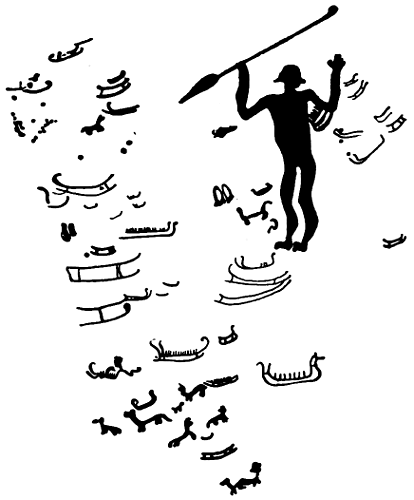
Fig. 137 is a copy of a petroglyph in Tanum parish, Bohuslän, Sweden. The large figure is doubtless a champion or commander, the exaggerated size of which is to be noted in connection with that of the Zulu chiefs in Fig. 142, infra, from South Africa, and Fig. 1024, infra, from North America. There are numerous small holes and footprints between the chief and the attacking force. Height, 20 feet; width, 15 feet.
In Bohuslän the tracings are cut in the quartz, which is the geological formation of the coast. They are mostly upon slightly inclined rocks, which are generally 200 or 300 feet or more above the present level of the sea, and which have been polished by the action of the ice. The width of the lines in the same representation varies from 1 to 2 inches and even more, and their depth is often only a third or fourth of an inch, and at times so shallow as to be barely perceptible. Those tracings, which have for hundreds, perhaps for thousands, of years been laid bare to the ravages of the northern climate, are now most difficult to decipher, while those which have been protected by earth are as fresh as if they had been cut to-day. Many seem to[175] have been cut near the middle or base of the hills, which were covered with vegetation, and were in the course of time concealed by the detritus from above.
Fig. 138 is from the same author (b) and locality. Height, 29 feet; width, 17 feet. The large birds and footprints and a chief designated by his size will be noticed, and also a character in the middle of the extreme upper part of the illustration which may be compared with the largest human form in Fig. 983, infra, from Tule valley, California.
Perrier du Carne (a), gives the following account (translated and condensed) of signs carved on the dolmen of Trou-aux-Anglais, in Épone:
This dolmen, situated in the commune of Épone, in a place called Le Bois de la Garenne, was constructed beneath the ground; it was concealed from view and it is to this circumstance, no doubt, that its preservation is due. Nothing indicates that it has been surmounted by a tumulus; in any case this tumulus had long since disappeared,[176] and the ground was entirely leveled when the digging was commenced some years ago. * * *
The characters (Fig. 139) are carved in intaglio on the farthest stone of the entrance, on the left side. The whole of the inscription measures 1m, 10 in height and 82 centimeters in width, and may be divided into two groups, an upper and a lower one.
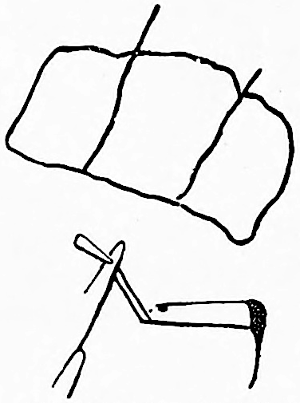
The upper character represents a rectangular figure divided into three transverse sections; in the third section and almost in the center is a cupule.
The lower character is more complicated and more difficult to describe. The first, or left-hand portion, represents a stone hatchet with a shaft; there is no doubt as to this, in my mind, as the outlines are perfectly clear, the design of the hatchet being very distinct. This hatchet measures 0m, 108 in length and 38mm in width to the edge of the blade. These are precisely the most common dimensions of the hatchets of our country. As to the remainder of the character, I think an interpretation of it difficult and premature.
On the whole, the result of an examination of these inscriptions leaves the impression that the author did not seek to cover a stone with ornamentation, for these outlines have nothing whatever of the ornamental, but that he wished to represent to his people, by intelligible symbols, some particular idea.
É. Cartailhac (a) begins an account of petroglyphs in the Department of Morbihan, in the old province of Brittany, translated and condensed as follows:
It is hardly possible to give a description of the designs in the covered way of Gavr’ inis. They are various linear combinations, the lines being straight, curved, undulating, isolated, or parallel, ramified like a fern, segments of concentric circles, limited or not, and decorating certain compartments with close winding spirals, recalling vividly the figures produced by the lines on the skin in the hollow of the hand and on the tips of the fingers.
In the midst of accumulated and very oddly grouped lines, which no doubt are merely decorative, there are found signs which must have had a meaning, and some figures easy to determine.
The hatchet, the stone hatchet and no other, the large hatchet of Tumiac, of Mané-er-Hroèg, and of Mont Saint Michel, is represented in intaglio or in relief, real size. A single pillar of Gavr’ inis bears eighteen of them. Less numerous groups are seen on some other blocks of the same covered way.
On a little block placed under the ceiling in order to wedge up one of the covering slabs, is seen the image of a hatchet with handle, conformable to a type found in the marsh of Ehenside in Cumberland, England. On many other monuments the presence of the same figures of hatchets, with handles or without, has been observed. The most curious slab is certainly that of Mané-er-Hroèg. It had been broken, and its three pieces had been thrown in disorder before the threshold of the crypt. One of its faces, very well smoothed off, bears a cartouche in the form of a stirrup, filled with enigmatic signs and surrounded above and below by a dozen hatchets with handles, all engraved.
One other sign, the imprint of the naked foot, is to be noted, found only once on this slab. Two human footprints are traced on one of the pillars of the crypt of the Petit-Mont in Arzon. They are said to be divided off, by a slight relief, from the rest of the granite frame on which they are sculptured, and which contains other drawings. Similar figures, engraved on rock or on tombstones, are cited from abroad, in lands far apart. In Sweden, the prints of naked or sandaled feet are[177] common among the rock sculptures of the age of bronze which represent the curious scenes of the life of the people of that period. It is proper to note that these Scandinavian and Morbihan sculptures are not synchronous; the idea of an immediate influence of one people on the other can not be entertained. One might, however, maintain the identity of origin.
The other inscriptions of Brittany are enigmatic in every respect. But they probably had a conventional value, a determined meaning. There is first of all a sort of complicated cartouche, plainly defined, having the appearance of a buckler or heraldic shield. Among the isolated signs it is proper to note a figure of the shape of the letter U with the ends spread wide apart and curved in opposite directions. It recalls, with some aid from the imagination, the character which on the Scandinavian rocks represents more plainly ships and barks.
The sculpturing of hands and feet is to be remarked in connection with similar characters on the rocks in America, many illustrations of which appear in the present work.
B. Souché (a) in 1879 described and illustrated curious characters on the walls of the crypt of the tumulus of Lisières (Deux-Sèvres), France, some of which in execution markedly resemble several found in the United States and figured in this work.
Mr. T. Jagor (a) communicated a brochure in reference to the Cueva de Altamira, transmitted to him by Prof. Vilanova in Madrid: “Short notes on some prehistoric objects of the province of Santander,” in which Don Marcelino de Sautuola describes the wall pictures and other finds in the cave discovered by him at Altamira. Mr. Jagor remarks as follows on the subject:
The reproductions of the large wall pictures discovered in that cave displayed, in part, so excellent technique that the question arose how much of this excellence is to be attributed to the prehistoric artist, and how much to his modern copyist. Mr. Vilanova, who visited the cave soon after its discovery, and who regards the wall pictures as prehistoric, being about equal in age to the Danish Kjökken-möddings, states that the pictures given are pretty faithful imitations of the originals. The published drawings are all found on the ceiling of the first cave; on the walls of the subsequent caves are seen sketches of those pictures, which the artist afterwards completed. The outlines of all the drawings have been cut in the wall with coarse instruments, and nearly all the bone implements found in the cave show scratches, which render it probable that they were used for this purpose. The colors used consist merely of various kinds of ocher found in the province, without further preparation. Finally Mr. Vilanova reports that in the cave farthest back there was found, in his presence, an almost perfect specimen of Ursus spelæus.
Don Manuel de Góngora y Martinez (a) gives the account translated as follows:
The inscriptions of Fuencaliente are of great interest and importance. About one league east of the town, on a spur of the Sierra de Quintana, at the site of the Piedra Escritá, there is an almost inaccessible place, the home of wild beasts and mountain goats. Beyond the river de los Batanes and the river de las Piedras, looking toward sunset and toward the town, the artisans of a remote age cut skillfully and symmetrically with the point of the pickax into the flank of the rock and of the mountain, which is of fine flint, leaving a facade or frontispiece 6 yards in height[178] and twice as wide, and excavating there two contiguous caves, which are wide at the mouth and end in a point, making two triangular niches polished on their four faces. On the two outer fronts to the left and right appear more than 60 symbols or hieroglyphs, written in a simple and rustic way with the index finger of a rude hand, and with a reddish bituminous pigment. The niches, about a yard and a half in height, 1 yard deep, and half a yard at the mouth, are covered by the exceedingly hard and immense rock of the mountain. There is formed, as it were, a vestibule or esplanade before the monument, and it is defended by a rampart made of the rocks torn from the niches, strengthened with juniper, oaks, and cork trees. The half-moon, the sun, an ax, a bow and arrows, an ear of corn, a heart, a tree, two human figures, and a head with a crown stand out among those signs, the foreshadowings of primitive writing.
The inscription on the first triangular face of the second cave is reproduced here as the left-hand group of the upper part of Fig. 1108, infra, and that “on the outer plane to the right, which already turns pyramidally to the north,” is reproduced as the right-hand group of the same figure. They are inserted at that place for convenient comparison with other characters on the figure mentioned and with those in Figs. 1097 and 1107.
Mr. Moggridge (in Jour. Anthrop. Inst. Gr. Br. and I., VIII, p. 65) observes that one of the designs, q, reported by Dr. Von Haast from New Zealand (see Fig. 133), was the same as one which had been seen on rocks 6,900 feet above the sea in the northwest corner of Italy. He adds:
The inscriptions are not in colors, as are those given in Dr. Von Haast’s paper, but are made by the repeated dots of a sharp pointed instrument. It is probable that if we knew how to read them they might convey important information, since the same signs occur in different combinations, just as the letters of our alphabet recur in different combinations to form words. Without the whole of these figures we can not say whether the same probability applies to them.
The following examples are selected from the large number of petroglyphs known to have been discovered in Africa apart from those in Egypt, which are more immediately connected with the first use of syllabaries and alphabets, with symbolism and with gesture signs, under which headings some examples of the Egyptian hieroglyphics appear in this work.
In the Revue Géographique Internationale (a) is a communication upon the rock inscriptions at Tyout (Fig. 140) and Moghar (Fig. 141) translated, with some condensation, as follows:
On the last military expedition made in the Sahara Gen. Colonieu made a careful restoration of the inscriptions on the rocks, whose existence was discovered at Tyout and Moghar. At Tyout these inscriptions are engraved on red or Vosgian sandstone,[179] and at Moghar on a hard compact calcareous stone. At Moghar the designs are more complicated than those at Tyout. An attempt has been made to render ideas by more learned processes; to the simplicity of the line, the artlessness of the poses which are seen at Tyout, there are added at Moghar academic attitudes difficult to render, and which must be intended to represent some custom or ceremony in use among the peoples who then inhabited this country. The costume at Moghar is also more complicated. The ornaments of the head recall those of Indians, and the woman’s dress is composed of a waist and a short skirt fastened by a girdle with flowing ends. All this is very decent and elegant for the period. The infant at the side is swaddled. The large crouching figure is the face view of a man who seems to be bearing his wife on his shoulders. At the right of this group is a giraffe or large antelope. In the composition above may be distinguished a solitary individual in a crouching attitude, seen in front, the arms crossed in the attitude of prayer or astonishment. The animals which figure in the designs at Moghar are cattle and partridges. The little quadruped seated on its haunches may be a gerboise (kind of rat), very common in these parts.
In the inscriptions at Tyout we easily recognize the elephant, long since extinct in these regions, but neither horse nor camel is seen, probably not having been yet imported into the Sahara country.
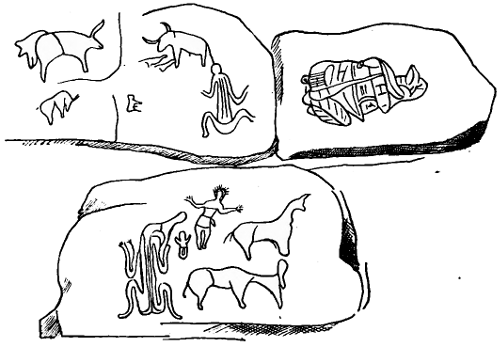
While the picture-writings of Egypt are too voluminous for present discussion and fortunately are thoroughly presented in accessible publications, it seems necessary to mention the work of the late Mrs. A. B. Edwards (a). She gives a good account of the petroglyphs on the rocks bounding the ancient river bed of the Nile below Philæ, which show their employment in a manner similar to that in parts of North America:
These inscriptions, together with others found in the adjacent quarries, range over a period of between three and four thousand years, beginning with the early reigns[180] of the ancient empire and ending with the Ptolemies and Cæsars. Some are mere autographs. Others run to a considerable length. Many are headed with figures of gods and worshippers. These, however, are for the most part mere graffiti, ill drawn and carelessly sculptured. The records they illustrate are chiefly votive. The passer-by adores the gods of the cataract, implores their protection, registers his name, and states the object of his journey. The votaries are of various ranks, periods, and nationalities; but the formula in most instances is pretty much the same. Now it is a citizen of Thebes performing the pilgrimage to Philæ, or a general at the head of his troops returning from a foray in Ethiopia, or a tributary prince doing homage to Rameses the Great and associating his suzerain with the divinities of the place.
Dr. Richard Andree, in Zeichen bei den Naturvölkern (a), presents well-considered remarks, thus translated:
The Hottentots and the Bantu peoples of South Africa produce no drawings, though the latter accomplish something in indifferent sculptures. The draftsmen and painters of South Africa are the Bushmen, who in this way, as well as by many other striking ethnic traits, testify to their independent ethnic position. The extraordinary multitude of figures of men and animals drawn by this people within its whole area, now greatly reduced, from the cape at the south to the lands and deserts north of the Orange river, and which they still draw at this day in gaudy colors, testify to an uncommonly firm hand, a keenly observing eye, and a very effective characterization. The Bushman artist mostly selects the surfaces of the countless rock bowlders, the walls of caves, or rock walls protected by overhanging crags, to serve as the canvas whereon to practice his art. He either painted his figures with colors or chiseled them with a hard sharp stone on the rock wall, so that they appear in intaglio. The number of these figures may be judged from the fact that Fritsch at Hopetown found “thousands” of them, often twenty or more on one block; Hubner, at “Gestoppte Fontein,” in Transvaal, saw two hundred to three hundred together, carved in a soft slate. The earth colors employed are red, ochre, white, black, mixed with fat or also with blood. What instrument (brush?) is employed in applying the colors has not yet been ascertained, since, so far as I know, no Bushman artist has yet been observed at his work. As regards the paintings[181] themselves, various classes may be distinguished, but in all cases the subjects are representations of figures; ornaments and plants are excluded. First of all, there are fights and hunting scenes, in which white men (boers) play a part, demonstrating the modern origin of these paintings. Next there are representations of animals, both of domestic animals (cattle, dogs) and of game, especially the various antelope species, giraffes, ostriches, elephants, rhinoceroses, monkeys, etc. A special class consists of representations of obscene nature, and, by way of exception, there has been drawn in one instance a ship or a palm tree.
Dr. Emil Holub (a) says:
The Bushmen, who are regarded as the lowest type of Africans, in one thing excel all the other South African tribes whose acquaintance I made between the south coast and 10° south latitude. They draw heads of gazelles, elephants, and hippopotami astonishingly well. They sketch them in their caves and paint them with ochre or chisel them out in rocks with stone implements, and on the tops of mountains we may see representations of all the animals which have lived in those parts in former times. In many spots where hippopotami are now unknown I found beautiful sketches of these animals, and in some cases fights between other native races and Bushmen are represented.
G. Weitzecker (a) gives a report of a large painting, in a cave at Thaba Phatsoua district of Léribé, here presented as Fig. 142, containing eighteen characters, with the addition of eight boys’ heads. It represents the flight of Bushman women before some Zulu Kaffirs (Matebele). The description, translated, is as follows:
As usual, the Bushmen are represented as dwarfs and painted in bright color as contrasted with the Kaffirs, who are painted large and of dark color. The scene is full of life, a true artistic conception, and in the details there are many important things to be noted. For this reason I add a sketch of it, with the figures numbered, in order to be able to send you some brief annotations.
I will premise that as far as the women are concerned, in the small figures, no mistaken notion should be entertained in regard to the anterior appendages which catch, or rather strike, the eye in some of them. There is question simply of the pudendal coverings of the Bushman women, consisting of a strip of skin, and flapping in the wind.
a seems to represent a woman in an advanced interesting condition, who in her headlong flight has lost even her mantle. She holds in her hand a mogope (disproportionate); that is to say, a gourd dipper, such as are found, I believe, among all the south African tribes.
b. This figure, besides the mogope which she holds in her left hand, carries away in her flight, steadying it on her head with her right hand, a nkho (sesuto), a baked earthenware vessel, in which drinks are kept, and of which the ethnographic museum now contains some specimens. This woman, too, has lost all her clothing except the pudendal covering, and she looks pregnant. The attitudes of flight, while maintaining equilibrium, I deem very fine.
c, f, g, h, l, m, and perhaps j. Women carrying their babies on their backs, as is the practice of the natives, in the so-called thari; that is, a sheepskin so prepared that they can fasten it to their bodies and hold it secure, even while bent to the ground or running.
l and m. Women with twins. It may be worthy of note that the painter has placed them last, hampered as they are with a double weight.
c. Apparently a woman who has fallen in her flight. Figures e and i represent men, who by their stature might be thought to be Bushmen, as also by their color, which, so far as I remember, is not the same as that of the men coming up after them, being rather similar to that of the women. In that case e would stoop to raise[182] the woman c who has fallen, and i would point the way to the others. Otherwise, if there is question of Matebeles, which is rendered plausible by the fact that n (which evidently represents an enemy) is not larger in stature than those two, then e would stoop to snatch the baby of the fallen woman, and i would strive to catch up with the two women g and h, who flee before it.
j. I can not explain this unless as a diffusion of color, which has transformed into something unrecognizable the figure of the child carried by its mother, who has fallen, like b.
k seems to be a woman resigned to her fate, who touches her neck with the left hand, unless, indeed, the line which I take to be the arm is the sketch of the thari with the baby.
l. A woman who runs toward the looker-on.
m represents a woman who has sat down, perhaps in order to place her twins better in the thari, while behind her n arrives, preparing to spear her. With n the band of enemies begins plainly, o seeming to be the leader, who, standing still, gives the signal. But this figure must have been altered by the water, which by diluting the color of the body has made it appear as a garment.
p and q. These admirable portraits of impetuosity and menace are a pictorial translation of the saying “having long legs so as to run fast.”
r. A fine type of an attitude in the poise of running.
The author’s discussion respecting the difference in size between the male human figures mentioned as indicating their respective tribes would have been needless had he considered the frequent expedient of representing chiefs or prominent warriors by figures of much larger stature than that of common soldiers or subjects. This device is common in the Egyptian glyphs, and examples of it also appear in the present work. (See Figs. 138, 139, and 1024.)
The same author, loc. cit., gives a brief account of two petroglyphs found by him near Leribo, in Basutoland, South Africa. They were on a large hollow rock overlooking a plain where the bushmen might spy game. The rock was all covered with pictures to a man’s height. Many of them were entirely or almost entirely spoiled, both by the hands of herdsmen and by water running down the walls in time of rain. Some of them, however, are still very well preserved. They are shown on Fig. 143.
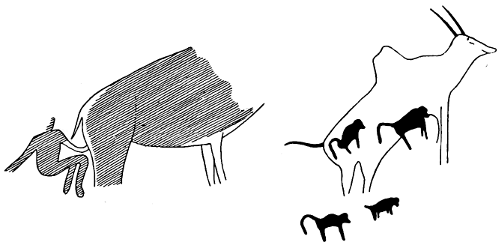
The left hand character represents a man milking an animal; the latter, judging by the back part, especially by the legs, was at first taken for an elephant; but the fore parts, especially the fore legs, evidently are those of a bovine creature or of an elk (eland). The enormous proportions of the back part are probably due to diffusion of colors,[183] through the action of water running down the rock. The right hand character represents the sketch of an elk (eland), on which and under which are depicted four monkeys, admirable for fidelity of expression. The legs, with one exception, are not finished.
These islands are considered in connection with the continent of Africa.
S. Berthelot (a) gives an account, referring to Figs. 144 and 145, from which the following is extracted and translated:
A site very little frequented, designated by the name of Los Letreros, appears to have been inhabited in very ancient times by one of the aboriginal tribes established on the Island of Fer, one of the Canary islands. At a distance of about three-quarters of a league from the coast all the land sloping and broken by volcanic mounds extends in undulations to the edge of the cliffs which flank the coast. It is on this desert site, called Los Letreros, that inscriptions are found engraved on an ancient flow of basaltic lava, with a smooth surface, over an extent of more than 400 meters. On all this surface, at various distances and without any relation to each[184] other, but placed where the lava presents the smoothest spots, rendered shining and glassy by the light varnish left by the volcanic matter in cooling, are the various groups of characters.
When we examine closely these different signs or characters so deeply engraved [pecked] on the rock, doubtless by means of some hard stone (obsidian or basalt), the first thing observed is that several identical signs are reproduced several times in the same group. These are, first, round and oval characters, more or less perfect, sometimes simple and isolated, again agglomerated in one group. These characters so often reproduced are again seen in juxtaposition or united, sometimes to others which are similar, sometimes to different ones, and even inclosed in others similar to them; for example, a in Fig. 144.
Round or more or less oval characters reappear several times in b.
Others, which are not met with more than once or twice among the groups of signs, also present notable variations; examples in c.
Of these are formed composite groups d, which belong, however, to the system of round signs.
Other analogous but not identical signs appear to assume rather the ovoid form than the round, and seem to have been so traced as not to be confounded with the round symbols. Some of them resemble leaves or fruit.
Another system of simple characters is the straight line, which can be represented by a stroke of the pen, isolated or repeated as if in numeration, and sometimes accompanied by other signs.
Other peculiar signs shown in e, which are not repeated, figure in the different groups of characters which the author has reproduced.
We notice further, in f, a small number of signs which bear a certain analogy to each other, and several of which are accompanied by other and more simple characters.
Several others still more complicated are in eccentric shapes which it is attempted to present in g.
Including the common oval characters often repeated and those consisting of a simple stroke similar to the strokes made by school children, all the various engraved characters scarcely exceed 400.
Fig. 145 gives a view of a series of different groups of signs in the length of the whole lava flow. The copyist has expressed by dots those symbols which were confused, partly defaced by the weather, or destroyed by fissures in the rock.
The same author (b) gives an account of several strange characters found engraved on a rock of the grotto of Belmaco, in the island of La Palma, one of the Canaries. He says:
These drawings, presented that they may be compared with those of Fer Island (Los Letreros), show some fifteen signs, some of which are repeated several times and others partly effaced by weather, or at least feebly traced. But what seems most remarkable is that six or seven[185] signs are recognized as exactly similar to those of Letreros, of the island of Fer, and almost all the others are analogous, for we recognize at once in comparing them the same style of bizarre writing, formed of hieroglyphic characters, mainly rude arabesques.
A considerable number of petroglyphs found in Asia are described and illustrated under other headings of this work. The following are presented here for geographic grouping:
Prof. Terrien de Lacouperie (c) says:
It is apparently to the art of the aboriginal non-Chinese that the following inscription [not copied] belongs, should it be proved to be primitive; and it is the only precise mention I have ever found of the kind in my researches.
Outside of Li-tch’eng (in N. Shangtang), at some 500 li on the west towards the north, is a stone cliff mountain, on the upper parts of which may be seen marks and lines representing animals and horses. They are numerous and well drawn, like a picture.
Prof. Edward S. Morse (a) kindly furnishes the illustration, reduced from a drawing made by a Japanese gentleman, Mr. Morishima, which is here reproduced (1/30 original size) as Fig. 145 a:
Prof. Morse in a letter gives further information as follows: “The inscriptions are cut in a rough way on the side of the cliff on the northwestern side of the bay of Otaru. Otaru is a little town on the western coast of Yezo. The cliffs are of soft, white tufa about 100 feet high, and the inscriptions were cut possibly with stone axes, and were 1 inch in width and from ¼ to ½ of an inch in depth. They are about 4 feet from the ground.”
Prof. John Milne (a) remarks upon the same petroglyph, of which he gives a rude copy, as follows:
So far as I could learn the Japanese are quite unable to recognize any of the characters, and they regard them as being the work of the Ainos.
I may remark that several of the characters are like the runic m. It has been suggested[186] that they have a resemblance to old Chinese. A second suggestion was that they might be drawings of the insignia of rank carried by certain priests; a third idea was that they were phallic; a fourth that they were rough representations of men and animals, the runic m being a bird; and a fifth that they were the handicraft of some gentleman desirous of imposing upon the credulity of wandering archæologists.
I myself am inclined to think that they were the work of the peoples who have left so many traces of themselves in the shape of kitchen middens and various implements in this locality. In this case they may be Aino.
Another illustration from Japan is presented in Pl. LII.
Mr. Rivett-Carnac, in Archæologic Notes on Ancient Sculpturings on Rocks in Kumaon, India (a), gives a description of the glyphs copied in Fig. 146:
At a point about two miles and a half south of Dwara-Hath, and twelve miles north of the military station of Ranikhet in Kumaon, the bridle-road leading from the plains through Naini Tal and Ranikhet to Baijnath, and thence on to the celebrated shrine of Bidranath, is carried through a narrow gorge at the mouth of which is a temple sacred to Mahadeo, ... which is locally known by the name of Chandeshwar.
About two hundred yards south of the temple, toward the middle of the defile, rises a rock at an angle of forty-five degrees presenting a surface upon which, in a space measuring fourteen feet in height by twelve in breadth, more than two hundred cups are sculptured. They vary from an inch and a half to six inches in diameter and from half an inch to an inch in depth, and are arranged in groups composed of approximately parallel rows.
The cups are mostly of the simple types and only exceptionally surrounded by single rings or connected by grooves.
N. S. Shtukin (a) referring to certain picture-writings on the cliffs of the Yenesei river, in the Quarterly Isvestia of the Imperial Geographical Society for 1882, says: “These are figured, but are not particularly remarkable, except as being the work of invaders from the far south, perhaps Persians. Camels and pheasants are among the animals represented.”
Philip John von Strahlenberg, in An Historico-Geographical Description of the North and Eastern Parts of Europe and Asia, etc., reported inscriptions relating to the chase, on the banks of the river Yenesei. He says of one: “It takes its characteristic features from the natural history of the region; and we may suppose it to embrace rude representations of the Siberian hare, the cabarda or musk deer and other known quadrupeds.”
He also furnishes a transcript of inscriptions found by him on a precipitous rock on the river Irtish. This rock, which is 36 feet high, is isolated. It has four sides, one of which faces the water and has a number of tombs or sepulchral caves beneath. All of the four faces[187] have rude representations of the human form, and other unintelligible characters are drawn in red colors in a durable kind of pigment, which[188] is found to be almost indestructible and is much used for rock inscriptions.
Prof. Terrien de Lacouperie, op. cit., makes the following remarks:
Symbolical marks, incised or drawn graffitti, not properly speaking inscriptions, have been found in Siberia, but they are not the expected primitive remains of ancient writings. Some are purely Tartar, being written in Mongolian and Kalmuck; others, obviously the work of common people, may be Arabic, while some others found on the left bank of the Jenissei river are much more interesting. They seem to me to be badly written in Syriac, from right to left horizontally, before the time of the adaptation of this writing to the Uigur and Mongol. The characters are still separated one from the other. On one of these graffitti found at the same place several Chinese characters, as written by common people, are recognizable.
Some hieroglyphical graffitti have been discovered on rocks above Tomsk, on the right bank of the Tom river, in Siberia. They are incised at a height of more than 20 feet. They are very rude, and somewhat like the famous Livre de Sauvages of merry fame in palæography. Quadrupeds, men, heads, all roughly drawn, and some indistinct lines, are all that can be seen. It looks more like the pictorial figures which can be used as a means of notation by ignorant people at any moment than like an historical beginning of some writing. There is not the slightest appearance of any sort of regularity or conventional arrangement in them.
The last we have to speak of are quite peculiar and altogether different from the others. The signs are painted in red. They are made of straight lines, disposed like drawings of lattices and window shades, and also like the tree characters of the Arabs and like the runes. They are met with near the Irtisch river, on a rock over the stream Smolank.
Figs. 513, 721, 722, and 723, infra, have relation to this geographic region.
It is to be remarked that some of the Siberian and Tartar characters, especially those reproduced by Schoolcraft, I, Pls. 65 and 66, have a strong resemblance to the drawings of the Ojibwa, some of which are figured and described in the present work, and this coincidence is more suggestive from the reason that the totem or dodaim, which often is the subject of those drawings, is a designation which is used by both the Ojibwa and the Tartar with substantially the same sound and significance.
The simplest form of rock inscription is almost ubiquitous. In Europe, Asia, Africa, America, and Oceanica, shallow, round, cup-like depressions are found, sometimes in rows, sometimes singly, sometimes surrounded by a ring or rings, but often quite plain. The cup-markers often arranged their sculpturings in regularly spaced rows, not infrequently surrounding them with one or more clearly cut rings; sometimes, again, they associated them with concentric circles or spirals. Occasionally the sculptors demonstrated the artificial character of their work by carving it in spots beyond the reach of atmospheric influences, such as the interiors of stone cists or of dwellings. It must, however, be noted that, although there is thus established a distinction between those markings which are natural and those which are artificial, it is possible that there may have been some distant connection between the two, and that the depressions worn by wind and rain may have suggested the idea of the devices, now called cup-markings, to those who first sculptured them.
Vast numbers of these cup stones are found in the British islands, often connected with other petroglyphs. In the county of Northumberland alone there are 53 stones charged with 350 sculptures, among which are many cup depressions. So also in Germany, France, Denmark, and indeed everywhere in Europe, but these forms took their greatest development in India.
The leading work relating to this kind of sculpture is that of Prof. J. Y. Simpson (a), afterward known as Sir James Simpson, who reduces the forms of the cup sculptures to seven elementary types, here reproduced in Fig. 147. His classification is as follows:
First type. Single cups.—They are the simplest type of these ancient stone-cuttings. Their diameter varies from 1 inch to 3 inches and more, while they are often only half an inch deep, but rarely deeper than an inch or an inch and a half. They commonly appear in different sizes on the same stone or rock, and although they sometimes form the only sculptures on a surface they are more frequently associated with figures of a different character. They are in general scattered without order over the surface, but occasionally four or five or more of them are placed in more or less regular groups, exhibiting a constellation-like arrangement.
Second type. Cups surrounded by a single ring.—The incised rings are usually much shallower than the cups and mostly surround cups of comparatively large size. The ring is either complete or broken, and in the latter case it is often traversed by a radial groove which runs from the central cup through and even beyond the ring.
Third type. Cups surrounded by a series of concentric complete rings.—In this complete annular form the central cup is generally more deeply cut than the surrounding rings, but not always.
Fourth type. Cups surrounded by a series of concentric, but incomplete rings having a straight radial groove.—This type constitutes perhaps the most common form of the circular carvings. The rings generally touch the radial line at both extremities, but sometimes they terminate on each side of it without touching it. The radial groove occasionally extends considerably beyond the outer circle, and in most cases[191] it runs in a more or less downward direction on the stone or rock. Sometimes it runs on and unites into a common line with other ducts or grooves coming from other circles, till thus several series of concentric rings are conjoined into a larger or smaller cluster, united together by the extension of their radial branch-like grooves.
Fifth type. Cups surrounded by concentric rings and flexed lines.—The number of inclosing or concentric rings is generally fewer in this type than in the two last preceding types, and seldom exceeds two or three in number.
Sixth type. Concentric rings without a central cup.—In many cases the concentric rings of the types already described appear without a central cup or depression, which is most frequently wanting in the complete concentric circles of the third type.
Seventh type. Concentric circular lines of the form of a spiral or volute.—The central beginning of the spiral line is usually, but not always, marked by a cup-like excavation.
It often occurs that two, three, or more of these various types are found on the same stone or rock, a fact indicating that they are intimately allied to each other.
Prof. Simpson presents what he calls “the chief deviations from the principal types” reproduced here as Fig. 148.
The first four designs represent cups connected by grooves, which is a noticeable and frequently occurring feature. In Fig. 149 views of sculptured rock surfaces at Auchnabreach, Argyleshire, Scotland, are given. Simple cups, cups surrounded by one ring or by concentric rings, with radial grooves and spirals, appear here promiscuously mingled. Fig. 150 exhibits isolated as well as connected cups, a cup surrounded by a ring, and concentric rings with radial grooves, on a standing stone (menhir), belonging to a group of seven at Ballymenach, in the parish of Kilmichael-Glassary, in Argyleshire, Scotland.
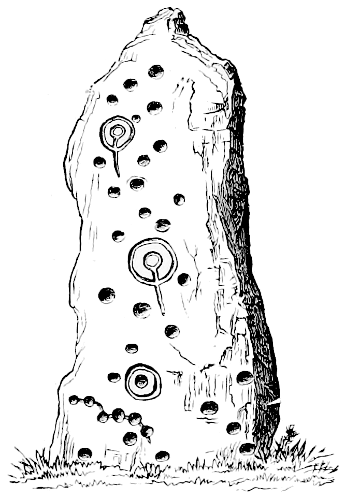
Dr. Berthold Seeman remarks concerning the characters in Fig. 105, supra, copied from a rock in Chiriqui, Panama, that he discovers in it a great resemblance to those of Northumberland, Scotland, and other parts of Great Britain. He says, as quoted by Dr. Rau (d):
It is singular that, thousands of miles away, in a remote corner of tropical America, we should find the concentric rings and several other characters typically identical with those engraved on the British rocks.
The characters in Chiriqui are, like those of Great Britain, incised on large stones, the surface of which has not previously undergone any smoothing process. The incised stones occur in a district of Veraguas (Chiriqui or Alanje), which is now thinly inhabited, but which, judging from the numerous tombs, was once densely peopled.
From information received during my two visits to Chiriqui and from what has been published since I first drew attention to this subject, I am led to believe that there are a great many inscribed rocks in that district. But I myself have seen only one, the now famous piedra pintal (i. e., painted stone), which is found on a plain at Caldera, a few leagues from the town of David. It is 15 feet high, nearly 50 feet in circumference, and rather flat on the top. Every part, especially the eastern side, is covered with incised characters about an inch or half an inch deep. The first figure on the left hand side represents a radiant sun, followed by a series of heads or what appear to be heads, all with some variation. It is these heads, particularly the appendages (perhaps intended for hair?), which show a certain resemblance to one of the most curious characters found on the British rocks, and calling[194] to mind the so-called “Ogham characters.” These “heads” are succeeded by scorpion-like or branched and other fantastic figures. The top of the stone and the other sides are covered with a great number of concentric rings and ovals, crossed by lines. It is especially these which bear so striking a resemblance to the Northumbrian characters.
Fig. 151 presents five selected characters from the rock mentioned: a attached to the respective numbers always refers to the Chiriqui and b to the British type of the several designs; 1a and 1b represent radiant suns; 2a and 2b show several grooves, radiating from an outer arch, resembling, as Dr. Seeman thinks, the Ogham characters; 3a and 3b show the completely closed concentric circles; 4a and 4b show how the various characters are connected by lines; 5a and 5b exhibit the groove or outlet of the circle.
Mr. G. H. Kinahan, in Journal of the Anthropological Institute of Great Britain and Ireland, 1889, p. 171, gives an account of Barnes’s Inscribed Dallâus, County Donegal, Ireland. One of his figures bears four cups joined together by lines forming a cross. The remainder of the illustrations consist of concentric rings and cups resembling others already figured in this paper.
Marcano (c) describes Fig. 152 as follows:
The chain of Cuchivero, situated in Venezuela between the Orinoco and the Caura, shows on its flanks small plateaus on which are numerous stones which seem to have been aligned. This chain is separated by a deep valley from that of Tiramuto, from which were copied the petroglyphs here presented. The one represents a single sun, the other two suns joined together. The rays of the former run from one circumference to the other. The other two are joined together by a central stroke, and the rays all start from the outer circumference.

The same author (loc. cit.) thus describes Fig. 153:
These designs, taken on the little hills of the high Cuchivero, differ altogether from the preceding. a is a very regular horizontal grouping. It begins by a spiral joined to three figures similar among themselves, and similar also to the eyes of jaguars which we have often met with. There follows a sort of isolated fret; at its right is another, larger and joined to a circle different from the preceding; it has a central point, and the second circumference is interrupted. The figure terminates in a spiral like the one at the beginning of the line, and which, being turned in the opposite direction, serves as its pendant.
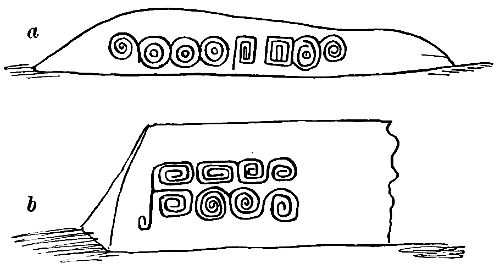
b is formed of two horizontal rows one above the other. We there find first of all two frets united by a vertical stroke ending in a hook. The characters which follow, resembling those of a, are distinct in each row, but on closer inspection they are seen to have a peculiar correspondence.
Dr. Ladisláu Netto (b) gives copies of carvings on the rocks in Brazil on the banks of the Rio Negro, from Moura to the city of Manaus, and remarks upon the characters reproduced here as Fig. 154, that they represent the figure of the multiple concentric circles joined together two by two, as were found[196] on several other rocks in the same region, and as they appear in many inscriptions of Central America and at various points of North America.
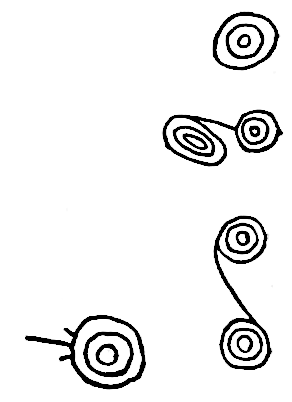
Senhor Araripe (b) gives the following account:
In Banabuiu, Brazil, about three-quarters of a league from the plantation of Caza-nova, on the road to Castelo, is a stone resting upon another, at the height of a man, which the inhabitants call Pedra-furada (pierced stone) having on its western face the inscription in Fig. 155.
The characters have been much effaced by the rubbing of cattle against them; the stone has also cracked. Some fragments lying at the foot of it bear on their upper faces round holes made by a sharp tool, and resembling those shown in this figure.
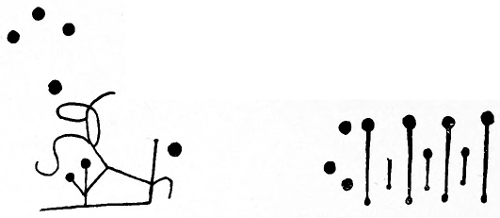
Cup stones, called by the French pierres à ecuelles and pierres à cupules and by the Germans Schalensteine, are found throughout Hindustan, on the banks of the Indus, at the foot of the Himalayas, in the valley of Cashmere, and on the many cromlechs around Nagpoor. At this very day one may see the Hindu women carrying the water of the Ganges all the way to the mountains of the Punjab, to pour into the cupules and thus obtain from the divinity the boon of motherhood earnestly desired.
The cup sculptures often become imposing by their number and combination. In the Kamaon mountains there are numerous blocks that support small basins. One of them is mentioned as being 13 feet in length by 9 in breadth and 7 in height, and showing five rows of cupules. At Chandeswar (see Fig. 146) the rocks themselves are covered with these signs. They present two different types. One of the most frequent groups shows a simple round cavity; in the others, the cupels are encircled by a sort of ring carved in intaglio and encircling figures. One of these figures recalls the swastika, the sacred sign of the Aryans. The present Hindus are absolutely ignorant of the origin of these sculptures; they are fain to attribute them to the Goalas, a mysterious race of shepherd kings who preceded the great invasions which imprinted an indelible stamp on the Indies as well as on Europe. These cupels are correlated with the worship of Mahadeo, one of the many names given to Siva, the third god of the Hindu triad, whose emblem is the[197] serpent. Chandeswar is reached through a narrow gorge; at the entrance is found a temple sacred to Mahadeo. The columns and slabs bear cupules similar to those seen on the rocks.
Some of the Mahadeo designs engraved on stone slabs in this temple (see Rivett-Carnac, loc. cit.) are represented in Fig. 156, showing a marked resemblance to and approaching identity with this class of cuttings on bowlders, rocks, and megalithic monuments in Europe.
A large number of stones with typical cup markings have been found in the United States of America. Some of those illustrated in this paper are presented in Pl. V, and Figs. 19 and 48.
Among the many attempts, all hitherto unsatisfactory, to explain the significance of the cup stones as distributed over nearly all parts of the earth, one statement of Mr. Rivett-Carnac (b) is of value as furnishing the meaning now attached to them in India. He says:
Having seen sketches and notes on
rock sculptures in India which closely
resemble unexplained rock carvings in
Scotland, and having myself found one
of the Scotch forms cut on a bowlder in
Kángrá, * * * being at Ayodhyá
with a Hindu who speaks good English,
I got a fakir and drew on the sand of the
Gogra the figure
![]() . I asked what
that meant. The fakir at once answered,
“Mahadeo.” I then drew
. I asked what
that meant. The fakir at once answered,
“Mahadeo.” I then drew
![]() and got
the same answer. At Delhi my old
acquaintance, Mr. Shaw, told me that
these two signs are chalked on stones
in Kángrá by people marching in marriage
processions. The meaning given to these
two symbols now in India is familiarly
known to the people.
and got
the same answer. At Delhi my old
acquaintance, Mr. Shaw, told me that
these two signs are chalked on stones
in Kángrá by people marching in marriage
processions. The meaning given to these
two symbols now in India is familiarly
known to the people.
Mahadeo, more accurately Mahadiva, is the god of generation. He is worshiped by the Sawas, one of the numerous Hindu sects, under the[198] form of a phallus, often represented by a simple column, which sometimes is placed on the yoni or female organ. It is suggested that in a common form of the sculptures the inner circle represents the Mahadeo or lingam, and the outer or containing circle the yoni. No idea of obscenity occurs from this representation to the Hindus, who adore under this form the generative power in nature.
Prof. Douglas, in the Saturday Review, November 24, 1883, furnishes some remarks on the topic now considered:
In Palestine and the country beyond Jordan some of the marks found are so large that it has been supposed that they may have been used as small presses of wine, or as mortars for pounding the gleanings of wheat. But there is an objection to these theories as accounting for the marks generally, which is fatal to them. To serve these purposes the rocks on which the marks occur should be in a horizontal position, whereas in a majority of cases all over the world the “cups” are found either on shelving rocks or on the sides of perpendicular stones. This renders worthless also the ideas which have at different times been put forward that they may have been used for some sort of gambling game, or as sun-dials. A Swiss archæologist who has lately devoted himself to the question believes that he has recognized, in the sculpturings under his observation, maps of the surrounding districts, the “cups” indicating the mountain peaks. In the same way others have thought that similar markings may have been intended as maps or plans pointing out the direction and character of old circular camps and cities in their neighborhood. But if any such resemblances have been discovered they can hardly be other than fortuitous, since it is difficult to understand how rows of cup marks, arranged at regular intervals and in large numbers, could have served as representatives either of the natural features of a country or of camps and cities. But a closer resemblance may be found in them as maps if we suppose that they were intended to represent things in the heavens rather than on earth. The round cup-like marks are reasonably suggestive of the sun, moon, and stars, and if only an occasional figure could be found representing a constellation, some color might be held to be given to the idea; but unfortunately this is not the case. Nevertheless the shape of the marks has led many to believe that they are relics of the ancient sun worship of Phœnicia, and that their existence in Europe is due to the desire of the Phœnician colonists to convert our forefathers to their faith. But there are many reasons for regarding this theory, though supported by the authority of Prof. Nilsson, as untenable. The observations of late years have brought to light cup marks and megalithic circles in parts of Europe on which a Phœnician foot never trod; and it is a curious circumstance that in those portions of the British Isles most frequented by these indefatigable traders there are fewer traces of these monuments than in the northern and inland districts, which were comparatively inaccessible to them.
The Swiss archæologist mentioned above by Prof. Douglas is Fritz Roediger (a), of whose theory the following is a translated abstract:
What renders the deciphering of these sign stones exceedingly difficult (I purposely avoid the words “map stones” because not all are such) is their great variety in size, position, material, workmanship, and meaning. I will here speak of the latter only, inasmuch as there are stones which in their smallest and their largest form are yet frequently nothing else than boundary stones, whose origin can often not be definitely established as prehistoric, while on the other hand again we discover well-marked boundary stones, which at the same time show the outline of the piece of ground which they guard. Similarly we find prehistoric (Gallic) “Leuk” stones, differing from the meter-high communal and state boundary stones of modern times in nothing but this, that they have some indistinct grooves and one or two hooks,[199] while on the other hand we meet “Leuk” stones, which on their restricted heads, often also on the side walls, indicate their environs for (Leuk) miles around, up, down, and sidewise, while a third class of this form merely adorn crossroads, and indicate deviations by means of lines and points (waranden). Thus we find quite extensive slabs or structures that signify only some hectares, often only one, while we meet very small ones, or, at any rate, of moderate size, which, one man can move, that represent very large districts, some presenting only lines and grooves, others with shells of various sizes, a third kind with both kinds of ornaments and samples of ornaments, and again others with no sign at all, but yet respected as stones of special meaning by the population, and called “hot stone,” “pointed stone,” “heath stone,” “child’s stone,” etc. Other stones have basin-like or platter-like depressions, and finally there are outcropping rocks with marks of one kind or another, holes, rents, clefts, etc. A further great difficulty hampering the deciphering of these wonderful stones is the lack of opportunities for comparison and experience. I have been markedly favored in this respect by my sojourn and wanderings in valley, mountain and alp. Western Switzerland is a very paradise for investigations of this kind, especially the lake country and the upper part of the canton of Solothurn (Soleure). A third difficulty, often insuperable, lies in the nonexistence of appropriate good maps for comparison. In this respect too we are well off in Switzerland.
According to my observations in this field, now continued nearly 12 years, prehistoric man had: (1) His land or province survey; (2) his circle, district, and communal surveys, in reference to which (3) the Alpine surveys deserve special mention, in cantons which down to the present day know nothing of such surveys; (4) private and special surveys. Thus it seems that my observations lend full confirmation to the oldest historic or traditional statements concerning the tenure of land of the Kelto-Germans or Germano-Kelts.
Among the Ojibwa concentric circles, according to Schoolcraft (d), constituted the symbol of time. It would be dangerous to explain the many markings of this character by the suggested symbolism, which also recalls that of Egypt in relation to the circle-figure. Inquiries have often been made whether the North American Indians have any superstitious or religious practices connected with the markings under consideration, e. g., in relation to the desire for offspring, which undoubtedly is connected with the sculpturing of cup depressions and furrows in the eastern hemisphere. No evidence is yet produced of any such correspondence of practice or tradition relating to it. In the absence of any extrinsic explanation the prosaic and disappointing suggestion intrudes that circular concentric rings are easy to draw and that the act of drawing them suggests the accentuation of depressions or hollows within their curves. Much stress is laid upon the fact that the characters are found in so many parts of the earth, with the implication that all the sculptors used them with the same significance, thus affording ground for the hypothesis that anciently one race of people penetrated all the regions designated. But in such an implication the history of the character formed by two intersecting straight lines is forgotten. The cross is as common as the cup-stone, and has, or anciently had, a different signification among the different people who used it, beginning as a mark and ending as a symbol. Therefore, it may readily be imagined that the rings in question, which are drawn[200] nearly as easily as the cross, were at one time favorite but probably meaningless designs, perhaps, in popular expression, “instinctive” commencements of the artistic practice, as was the earliest delineation of the cross-figure. Afterward the rings, if employed as symbols or emblems, would naturally have a different meaning applied to them in each region where they now appear.
It must, however, be noted that the figures under discussion can be and often are the result of conventionalization. A striking remark is made by Mr. John Murdoch (a), of the Smithsonian Institution, that south of Bering strait the design of the “circle and dot,” which may be regarded as the root of the cup sculpture, is the conventionalized representation of a flower, and is very frequently seen as an ornamental device.
An elucidation of some of the most common forms of cup sculptures is given, without qualification and also without authority, but with the serene consciousness of certainty, by the Rev. Charles Rogers, “D.D., LL. D., F. S. A., Scot., etc.,” as follows:
The sculptures are sacred books, which the awe-inspired worshipper was required to revere and, probably, to salute with reverence. A single circle represented the sun, two circles in union the sun and moon—Baal and Ashtaroth. The wavy groove passing across the circle pointed to the course of water from the clouds, as discharged upon the earth. Groups of pit marks pointed to the stars or, more probably, to the oaks of the primeval temples.
In leaving the geographic distribution of petroglyphs to examine the comprehensive theme of pictographs in general, the first and correct impression is that the mist of the archaic and unknown is also left and that the glow of current significance is reached. The pictographs of the American Indians are seldom if ever cryptographs, though very often conventional and sometimes, for special reasons, preconcerted, as are their signals. They are intended to be understood without a key, and nearly all of those illustrated below in the present work are accompanied by an interpretation. As the art is in actual daily use it is free from the superstition pending from remote antiquity.
It will be noticed that a large proportion of the pictographs to be now presented, which are not petroglyphs, are Micmac, Abnaki, Dakota, and Ojibwa, although it is admitted that as many more could be obtained from other tribes, such as the Zuñi and the Navajo. The reason for the omission of details regarding the latter is that they are already published, or are in the course of publication, by Mrs. Stevenson, Dr. Matthews, Mr. Cushing, Mr. Fewkes, and other writers, who have specially devoted themselves to the peoples mentioned and the region occupied by them.
The present writer obtained a valuable collection of birch-bark pictographs immemorially and still made by the Passamaquoddy and Penobscot tribes of Abnaki in Maine, showing a similarity in the use of picture-writing between the members of the widespread Algonquian stock in the regions west of the great lakes and those on the northeastern seaboard. He also learned that the same art was common to the less known Montagnais and Nascapees in the wooded regions north of the St. Lawrence. This correlation of the pictographic practice, in manner and extent, was before inferentially asserted, but no satisfactory evidence of it had been furnished until the researches of the Bureau of Ethnology, in 1887 and 1888, made by the writer, brought into direct comparison the pictography of the Ojibwa with that of the Micmacs and the Abnaki. Many of the Indians of the last-named tribes still use marks and devices on birch bark in the ordinary affairs of life, especially as notices of departure and direction and for warning and guidance. The religious use of original drawings among them, which is still prominent among the Ojibwa, has almost ceased, but traces of it remain.
The most interesting of all the accounts regarding the pictographs of the North American Indians published before the last decade was contained in the works of Henry R. Schoolcraft, issued in 1853 and subsequent years, and the most frequently quoted part of his contributions on this subject describes the pictographs of the Ojibwa. He had special facilities for obtaining accurate information with regard to all matters relating to that tribe on account of his marriage to one of its women, a granddaughter of a celebrated chief, Waub-o-jeeg and daughter of a European named Johnson. She was educated in Ireland and had sufficient intelligence to understand and describe to her husband the points of interest relating to her tribe.
The accounts given by Mr. Schoolcraft, with numerous illustrations, convey the impression that the Ojibwa were nearly as far advanced in hieroglyphic writing as the Egyptians before their pictorial representations had become syllabic. The general character of his voluminous publications has not been such as to assure modern critics of his accuracy, and the wonderful combination of minuteness and comprehensiveness attributed by him to the Ojibwa “hieroglyphs” has of late been generally regarded with suspicion. It was considered in the Bureau of Ethnology an important duty to ascertain how much of truth existed in these remarkable accounts, and for that purpose the writer, with Dr. Hoffman as assistant, examined the most favorable points in the present habitat of the tribe, namely, the northern regions of Minnesota and Wisconsin, to ascertain how much was yet to be discovered.
The general results of the comparison of Schoolcraft’s statements with what is now found show that he told the truth in substance, but with much exaggeration and coloring. The word “coloring” is particularly appropriate, because in his copious illustrations various colors were used freely and with apparent significance, whereas, in fact, the general rule in regard to the birch-bark rolls was that they were never colored at all; indeed, the bark was not adapted to coloration. The metaphorical coloring was also flourished by him in a manner which seems absurd to any thorough student of the Indian philosophy and religions. Metaphysical concepts are attached by him to some of the devices which he calls “symbols,” which could never have been entertained by a people in the stage of culture of the Ojibwa. While some symbolism, in the wide sense of the term, may be perceived, iconography and ideography are more apparent.
The largest part of the bark rolls and other pictographs of the Ojibwa obtained by the Bureau, relates to the ceremonies of the Midē' and of the shamanistic orders; another division refers to the Jessakid performances, which can be classed under the head of jugglery; and a third part embraces the more current and practical uses. Examples of all of these are given, infra.
The difficulties sometimes attending the pursuit of ceremonial pictographs were exemplified to the writer at Odanah, Wisconsin. Very[203] few of the Ojibwa in that neighborhood, who are generally civilized and in easy circumstances, had any more than a vague knowledge that such things as inscribed bark rolls had ever existed. Three, however, were traced and one was shown. The owner, an uncompromising heathen, was called Kitche-sha-bads. “Kitche” means big, “sha” is an attempt at the French form of John, and “bads” is a bad shot at Baptiste, the whole translation, therefore, being “Big John the Baptist.” This old fellow, though by no means as enterprising or successful as some of the younger generation, had a snug house and farm and $300 in the savings bank at Ashland. One thing, however, he needed, viz, whisky. The strictest regulations prevailed on the reservation, really prohibitory to the introduction of spirits, and, indeed, there was at the nearest town, Ashland, a severe penalty for selling any form of liquor to an Indian. To obtain whisky, therefore, was the only consideration which would tempt him to allow a copy of the roll to be taken or by which he could be induced to recite or rather to chant it in the manner prescribed. He was undoubtedly accomplished in the knowledge of the Midē' rites, and the roll, which was shown in his hands, but not out of them, is substantially the same as one of those copied in the present work, which was discovered several hundred miles farther northwest among a different division of the same tribe. The shaman began rather mildly to plead that he was an old man and could not remember well unless his spirit was made good by a little whisky. This difficulty might have been obviated by a traveler’s pocket flask, but his demands increased with great rapidity. He said that the roll could only be sung at night, that he must have another old man to help him, and the old man must have whisky; then that there must be a number of young men, who would join in the chorus, and all the young men must have whisky too. These demands made it evident that he was intending to have a drunken orgy, which resulted in a cloture of the debate. And yet the idea of the old shaman was in its way correct. The ceremonial chants could be advantageously pronounced only under inspiration, which was of old obtained by a tedious form of intoxication, now expedited by alcohol.
The fact that this work shows a large proportion of pictographs from the Siouan linguistic family, and especially from the Dakota division of that family, may be explained partly by the greater familiarity of the present writer with it than with most other Indian divisions. Yet probably more distinctive examples of evolution in ideography and in other details of picture-writing are found still extant among the Dakota than among any other North American tribe. The degree of advance made by the Dakota was well expressed by the Rev. S. D. Hinman, who was born, lived, married, and died in their midst, and, though unfortunately he committed to writing but little of his knowledge, was more thoroughly informed about that people than any other man of European descent.
To express his views clearly he gave to this writer in a manuscript communication his own classification of pictography (which is not in all respects approved) as follows:
I. Picturing.—[This is the method called by Prof. Brinton (b) iconographic writing.] This shows a simple representation of a thing or event in picture, as of a bear, a man’s hand, a battle.
II. Ideography.—This arbitrarily, though significantly, recalls an idea or abstract quality, as love or goodness.
III. Picture-writing.—This will, in picture and character, arbitrarily or otherwise, recite a connected story, there being a picture or character for every word, even for conjunctions and prepositions.
IV. Phonetic writing.—This gives phonetic value to every picture and spells out the words by sound, almost as in later alphabets, as if a lion should stand for the “l” sound, a bear for the “b” sound, etc., and from this last by modification came alphabets. [This is the familiar theory, which is accurate so far as it is applicable, of the initial sound, but other elements are disregarded, such as the “rebus,” for which special class Prof. Brinton, loc. cit., has invented the title of the Iconomatic method.]
Accepting this chronologic if not evolutionary arrangement, Mr. Hinman decided that the Dakota picture-writing had passed through stage I and was already entering upon stage II when it was first observed by the European explorers. Of III and IV he found no examples in Dakota pictography, though in sign language the Dakota had progressed further and had entered upon III.
As a summary of the topic it seems that pictographs other than petroglyphs which presumably are more modern than most of the latter, can be studied, not by geographic distribution, but by their ascertainable intent and use. Unless the classification of the remaining part of this work under its various headings has been defective, further discussion in this chapter is unnecessary.
Substances on which pictographs are made may be divided into—
I. The human body.
II. Natural objects other than the human body.
III. Artificial objects.
Markings on human bodies are—(1) Those expressed by painting or such coloration as is not permanent. It has been found convenient to treat this topic under the heading of “Significance of Colors,” Chap. XVIII, Sec. 3. (2) Those of intended permanence upon the skin, generally called tattoo, but including scarification. This enormous and involved topic is discussed, so far as space allows, under the heading of “Totems, Titles, and Names,” Chapter XIII, Sec. 3, where it seems to be most convenient in the general arrangement of this work. Though logically it might have been divided among several of the headings, that course would have involved much repetition or cross reference.
Other natural objects may be divided into—(1) Stone; (2) bone; (3) skins; (4) feathers and quills; (5) gourds; (6) shells; (7) earth and sand; (8) copper; (9) wood.
This caption comprises the pictographs upon stone surfaces or tablets which are not of the dimensions or in the position to be included under the heading of petroglyphs, as elsewhere defined. Accounts, with and without illustrations, have been published of several engraved tablets, regarding which there has been much discussion, and some examples appear, infra, under the appropriate heading. (See Chapter XXII, Sec. 1.) Other examples, in which the genuine aboriginal character of the work is undisputed, appear in the present work, and a large number of other engraved and incised stone objects could be referred to, some of which are in the possession of the Bureau of Ethnology, unpublished,[206] others being figured in its several reports. It is sufficient now for illustration of this subject to refer to the account accompanying Pl. LI, infra, describing and copying the Thruston tablet, which is, perhaps, the most interesting of any pictograph on stone yet discovered, the genuineness of which as Indian work has not been called in question.
For instances of the use of bone, several Alaskan and Eskimo carvings figured in this work may be referred to, e. g., Figs. 334, 459-462, 534, 703, 704, 742, 771, 844, and 1228.
Fig. 157, copied from Schoolcraft (e), is taken from the shoulder-blade of a buffalo found on the plains in the Comanche country of Texas. He says:
It is a symbol showing the strife for the buffalo existing between the Indian and white races. The Indian (1) presented on horseback, protected by his ornamented shield and armed with a lance, (2) kills a Spaniard (3) after a circuitous chase (6), the latter being armed with a gun. His companion (4), armed with a lance, shares the same fate.
It may be questioned whether Mr. Schoolcraft was not too active in the search for symbols in his explanation of (6) as a circuitous chase. The device is either a lasso or a lariat, and relates to the possession or attempt to take possession of the buffalo. The design (5), however, well expresses ideographically the fact that the buffalo at the time was in contention, and therefore was the property half of the Indians and half of the whites.
A large number of pictographs upon the hides of animals are mentioned in the present paper. Pl. XX, with its description in the Dakota[207] Winter Counts, infra, Chap, X, Sec. 2, is one instance. Rawhide drum-heads are also used to paint upon, as by the shamans of the Ojibwa.
The use of robes made of the hides of buffalo and other large animals, painted with biographic, shamanistic, and other devices, is also mentioned in various parts of this work. A description of very early observation is now introduced, taken from John Ribault in Hakluyt (a).
The king gaue our Captaine at his departure a plume or fanne of Hernshawes feathers died in red, and a basket made of Palmeboughes after the Indian fashion, and wrought very artificially and a great skinne painted and drawen throughout with the pictures of diuers wilde beasts so liuely drawen and pourtrayed, that nothing lacked but life.
With the American use of pictographic robes may be compared the following account of the same use by Australian natives by Dr. Richard Andree (b).
The inner side of the opossum skins worn by the blacks is also often ornamented with figures. They scratch lines into the skin, which afterward are rubbed over with fat and charcoal.
Edward M. Kern, in Schoolcraft (f), reports that the Sacramento tribes of California were very expert in weaving blankets of feathers, many of them having beautiful figures worked upon them.
The feather work in Mexico, Central America, and the Hawaiian Islands is well known, often having designs properly to be considered among pictographs, though in modern times not often passing beyond ornamentation.
Worsnop (op. cit.) mentions that on grand occasions of the “Mindarie” (i. e., peace festival) the Australian natives decorate the bodies, face, legs, and feet with the down of wild fowl, stuck on with their own blood. The ceremony of taking the blood is very painful, yet they stand it without a murmur. It takes five or six men four to five hours to decorate one man. The blood is put on the body wet and the down stuck on the blood, showing, when finished, outlines of man’s head, face, feet, snakes, emu, fish, trees, birds, and other outlines representing the moon, stars, sun, and Aurora Australis, the whole meaning that they are at peace with the world.
Mr. David Boyle (a) gives an account of a piece of porcupine quill work, with an illustration, a part of which is copied in Fig. 158.
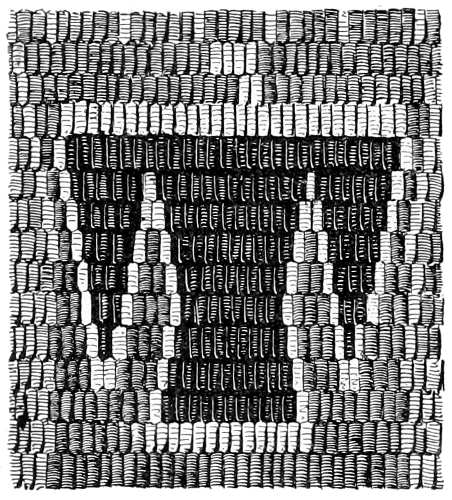
Among the lost or almost lost arts of the Canadian Indians is that of employing porcupine quills as in the illustration. Partly on account of scarcity of material, but chiefly, it is likely, from change of habits and of taste, there are comparatively few Indian women now living who attempt to produce any fabric of this kind. * * *
The central figure is meant to represent the eagle or great thunder-bird, the belief in which is, or was, widely spread among the Indians over the northern part of this continent. * * *
This beautiful piece of quill work was produced from Ek-wah-satch, who resides at Baptiste lake. He informed me that it had belonged to his grandfather, who resided near Georgian bay.
See also Fig. 685 for another illustration of pictographic work by colored porcupine quills.
After gourds have dried the contents are removed and small pebbles or bones placed in the empty vessel. Handles are sometimes attached. They serve as rattles in dances and in religious and shamanistic rites. The representations of natural or mythical objects, connected with the ceremonies, for which the owner may have special reverence are often depicted upon their outer surfaces. This custom prevails among the Pueblos generally, and also among many other tribes, notably those of the Siouan linguistic stock.
Fig. 159 is a drawing of the Sci-Manzi or “Mescal Woman” of the Kiowa as it appears on a sacred gourd rattle in the mescal ceremony of that tribe, and was procured with full explanations in the winter of 1890-’91 by Mr. James Mooney of the Bureau of Ethnology.
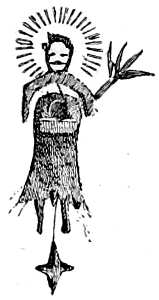
It shows the rude semblance of a woman, with divergent rays about her head, a fan in her left hand, and a star under her feet.
The peculiarity of the drawing is its hermeneutic character, which is rarely ascertained by actual evidence as existing among the North American Indians. It has a double meaning, and while apparently only a fantastic figure of a woman, it conveys also to the minds of the initiated a symbolic representation of the interior of the sacred mescal lodge. Turning the rattle with the handle toward the east, the lines forming the halo about the head of the figure represent the circle of devotees within the lodge. The head itself, with the spots for eyes and mouth, represents the large consecrated mescal which is placed upon a crescent-shaped mound of earth in the center of the lodge, this mound being represented in the figure by a broad, curving line, painted yellow, forming the curve of the shoulders. Below this is a smaller crescent curve, the original surface of the gourd, which symbolizes the smaller crescent mound of ashes built up within the crescent of earth as the ceremony progresses. The horns of both crescents point toward the[209] door of the lodge on the east side which, in the figure, is toward the feet. In the chest of the body is a round globule painted red, emblematic of the fire within the horns of the crescent in the lodge. The lower part of the body is green, symbolic of the eastern ocean beyond which dwells the mescal woman who is the ruling spirit or divinity to whom prayers are addressed in the ceremony, and the star under her feet is the morning star which heralds her approach. In her left hand is a device representing the fan of eagle feathers used to shield the eyes from the glare of the fire during the ceremony.
The admirable and well illustrated paper, Art in Shell of the Ancient Americans, by Mr. W. H. Holmes, in the Second Annual Report of the Bureau of Ethnology, and a similar paper, Burial Mounds of the Northern Section of the United States, by Prof. Cyrus Thomas, in the Fifth Annual Report of the same Bureau, render unnecessary present extended discussion under this head.
One example, however, which is unique in character and of established authenticity, is presented here as Pl. XV.
Dr. Edward B. Tylor (a) gives a description of the mantle copied upon that plate, which is condensed as follows:
Among specimens illustrative of native North American arts, as yet untouched by European influence, is the deerskin mantle ornamented with shellwork, recorded to have belonged to the Virginian chief, Powhatan. Of the group of Virginian mantles in Tradescant’s collection there only now remains this shell embroidered one. It is entered as follows in the MS. catalogue of the Ashmolean Museum, in the handwriting of the keeper, Dr. Plot, the well-known antiquary, about 1685: “205 Basilica Powhatan Regis Virginiani vestis, duabus cervorum cutibus consuta, et nummis indicis vulgo cori’s dictis splendidè exornata.” He had at first written “Roanoke,” but struck his pen through this word, and wrote “cori’s” (i. e. cowries) above, thus by no means improving the accuracy of his description.
The mantle measures about 2.2m in length by 1.6m in width. The two deerskins forming it are joined down the middle; no hair remains. The ornamental design consists of an upright human figure in the middle; divided by the seam; a pair of animals; 32 spirally-formed rounds (2 in the lowest line have lost their shells) and the remains of some work in the right lower corner. The marks where shellwork has come away plainly show the hind legs and tapering tails of both animals. It is uncertain whether the two quadrupeds represent in the conventional manner of picture-writing some real animal of the region, or some mythical composite creature such as other Algonquin tribes are apt to figure. The decorative shellwork is of a kind well known in North America. The shells used are Marginella; so far as Mr. Edgar A. Smith is able to identify them in their present weathered state, M. nivosa. They have been prepared for fastening on, in two different ways, which may be distinguished in the plate. In the animals and rounds, the shells have been perforated by grinding on one side, so that a sinew thread can be passed through the hole thus made and the mouth. In the man, the shells are ground away and rounded off at both ends into beads looking roughly ball-like at a distance.
The artistic skill of the North American Indians was not, as a rule, directed to represent the forms of animals with such accuracy as to allow of their identification as portraitures. Instead of attempting[210] such accuracy they generally selected some prominent feature such as the claws of the bear, which were drawn with exaggeration, or the tail of the mountain lion which was portrayed of abnormal length over the animal’s back. Those animals were, therefore, recognized by those selected features in much the same manner as if there had been a written legend—“this is a bear” or “a mountain lion,” the want of iconographic accuracy being admitted. In the animals represented on the mantle no such indicating feature is obvious, and the general resemblance to the marten is the only guide to identification.
The habitat of the marten does not include Virginia as a whole, but the animal is found in the elevated regions of that state. This local infrequency is not, however, of much significance. If regarded as a clan totem, as is probable, it may well be that the clan of Powhatan was connected with the clans of the more northern Algonquian tribes among whom the marten frequently appears as a clan totem. What is generally termed the Powhatan confederacy was a union, not apparently ancient, of a large number of tribal divisions or villages, and it is not known to which clan (probably extending through many of these tribal divisions) the head chief Powhatan belonged. There is almost nothing on record of the clan system of those Virginian Indians, but it is supposed to be similar to that of the northern and eastern members of the same linguistic family, among whom the marten clan was and still is found.
The topic of wampum which, considered as to its material, belongs to the division of shellwork, is with regard to the purposes of the present paper, discussed under the head of “Mnemonic,” Chap. IX, Sec. 3.
The highly important work, The Mountain Chant, a Navajo Ceremony, in the Fifth Annual Report of the Bureau of Ethnology, by Dr. Washington Matthews, U. S. Army, and that of Mr. James Stevenson, Ceremonial of Hasjelti Dailjis and Mythical Sand Painting of the Navajo Indians, in the Eighth Annual Report of that Bureau, give accounts of most interesting sand paintings by the Navajo Indians, which were before unknown. These paintings were made upon the surface of the earth by means of sand, ashes, and powdered vegetable and mineral matter of various colors. They were highly elaborate, and were fashioned with care and ceremony immediately preceding the observance of specific rites, at the close of which they were obliterated with great nicety. The subject is further discussed by Dr. W. H. Corbusier, U. S. Army, in the present paper (see Chap. XIV, Sec. 5).
Mr. Frank Hamilton Cushing, of the Bureau of Ethnology, kindly contributes the following remarks with special reference to the Zuñi:
A study of characteristic features in these so-called sand pictures of the Navajos would seem to indicate a Pueblo origin of the art, this notwithstanding the fact that it is to-day more highly developed or at least more extensively practiced amongst the Navajos than now, or perhaps ever, amongst the Pueblos. When, during my first[211] sojourn with the Zuñi, I found this art practice in vogue among the tribal priest magicians and members of cult societies, I named it dry or powder painting. I could see at a glance that this custom of powder painting had resulted from the effort to transfer from a vertical, smooth, and stable surface, which could be painted on, to a horizontal and unstable surface, unsuited to like treatment, such symbolic and sacramental pictographs as are painted on the walls of the kivas, temporarily, as appurtenances to the dramaturgic ceremonials of the cult societies, and as supposed aids to the magical incantations and formulæ of all the monthly, semiannual, and quadrennial observances and fasts of the tribal priests; sometimes, also, in the curative or “Betterment” ceremonials of these priests. It is noteworthy that, with the exception of the invariable “Earth terrace,” “Pathway of (earth) life,” and a few other conventional symbols of mortal or earthly things (nearly always made of scattered prayer meal), powder painting is resorted to amongst the Zuñi only in ceremonials pertaining to all the regions or inclusive of the lower region. In such cases paintings typical of the North, West, South, and East are made on the four corresponding walls of the kiva, whilst the lower region is represented by appropriately powder or paint colored sand on the floor, and the upper region either by paintings on the walls near the ceiling or on stretched skins suspended from the latter. Thus the origin of the practice of floor powder painting may be seen to have resulted from the effort to represent with more dramatic appropriateness or exactness the lower as well as the other sacramental regions, and to have been incident to the growth from the quaternary of the sextenary or septenary system of world division so characteristic of Pueblo culture. Hence it is that I attribute the art of powder or sand painting to the Pueblos, and believe that it was introduced both by imitation and by the adoption of Pueblo men amongst the Navajos. Its greater prevalence amongst them to-day is simply due to the fact that having, as a rule, no suitable vertical or wall surfaces for pictorial treatment, all their larger ceremonial paintings have to be made on the ground, and can only or best be made, of course, by this means alone.
It is proper to add, as having a not inconsiderable bearing on the absence generally of screen or skin painting among the Navajos, that, with the Pueblos at least, these pictures are—must be—only temporary; for they are supposed to be spiritually shadowed, so to say, or breathed upon by the gods or god animals they represent, during the appealing incantations or calls of the rites; hence the paint substance of which they are composed is in a way incarnate, and at the end of the ceremonial must be killed and disposed of as dead if evil, eaten as medicine if good.
Further light is thrown on this practice of the Zuñi in making use of these suppositively vivified paintings by their kindred practice of painting not only fetiches of stone, etc., and sometimes of larger idols, then of washing the paint off for use as above described, but also of powder painting in relief; that is, of modeling effigies in sand, sometimes huge in size, of hero or animal gods, sacramental mountains, etc., powder painting them in common with the rest of the pictures, and afterwards removing the paint for medicinal or further ceremonial use.
The construction of the effigies in high relief last above mentioned should be compared with the effigy mounds mentioned below in this section.
In connection with the ceremonial use, for temporary dry painting on the ground, of colored earth and sand and also that of sacred corn meal, a remarkable parallel is found in India. Mr. Edward Carpenter (a) mentions that the Devadásis, who are popularly called Nautch girls, as a part of their duty, ornament the floor of the Hindu temples with quaint figures drawn in rice flour.
The well known mounds or tumuli more or less distinctly representing animal forms and sometimes called effigy mounds, found chiefly in Wisconsin and Illinois, come in this category, but it is not possible to properly discuss them and also give space to the many other topics in this paper, the facts and authorities upon which are less known or less accessible. A large amount of information is published by Rev. S. D. Peet (a). Other articles are by Mr. T. H. Lewis in Science, September 7, 1888, and No. 318, 1889. One upon the Serpent mound of Ohio, by Prof. F. W. Putnam (a), is of special interest. It may be suggested as a summation that there is not sufficient evidence of the erection of this class of effigy mounds merely for burial purposes. They seldom exceeded 6 feet in height and varied in expanse from 30 to 300 feet. The animals most frequently recognizable in the constructions are lizards, birds, and several more or less distinct quadrupeds; serpents and turtles also are identified. The species of fauna represented are those now or lately found in the same region. There is a strong probability that the forms of the mounds in question were determined by totemic superstitions or tribal habitudes.
In England the pictographs styled “turf monuments” are sometimes made by cutting the natural turf and filling with chalk the part of the surface thus laid bare. Sometimes the color depends wholly upon the limestone, granite, or other rock exposed by removing the turf. Rev. W. C. Plenderleath (a) gives a full account of this variety of pictograph.
This is the only metal on which it is probable that the North American Indians made designs. To present comparisons of pictures by other peoples on that or other metals or alloys would be to enter into a field, the most interesting part of which is classed as numismatic, and which would be a departure from the present heading. That virgin copper was used for diverse purposes, generally ornamental, by the North American Indians, is now established, and there is a presentation of the subject in Prof. Cyrus Thomas’s (a) Burial Mounds. The most distinct and at the same time surprising account of a true pictographic record on copper is given by W. W. Warren (a), an excellent authority, and is condensed as follows:
The Ojibwa of the Crane family hold in their possession a circular plate of virgin copper, on which are rudely marked indentations and hieroglyphics denoting the number of generations of the family who have passed away since they first pitched their lodges at Shang-a-waum-ik-ong and took possession of the adjacent country, including the island of La Pointe.
When I witnessed this curious family register in 1843 it was exhibited to my father. The old chief kept it carefully buried in the ground and seldom displayed it. On this occasion he brought it to view only at the entreaty of my mother whose maternal uncle he was.
On this plate of copper were marked eight deep indentations, denoting the number of his ancestors who had passed away since they first lighted their fire at Shang-a-waum-ik-ong. They had all lived to a good old age.
By the rude figure of a man with a hat on its head, placed opposite one of these indentations, was denoted the period when the white race first made its appearance among them. This mark occurred in the third generation, leaving five generations which had passed away since that important era in their history.
Mr. I. W. Powell (a), Indian superintendent, in the report of the deputy superintendent-general of Indian affairs of Canada for 1879, gives an account of some tribes of the northwest coast, especially the Indians called in the report Newittees, a tribe now known as the Naqómqilis of the Wakashan family, who treasure pieces of copper peculiarly shaped and marked. The shape is that of one face of a truncated pyramid with the base upward. In the broad end appear marks resembling the holes for eyes and mouth, which are common in masks of the human face. The narrower end has a rough resemblance to an ornamental collar. These copper articles were made by the Indians originally from the native copper, and in 1879 a few were held by the chiefs who used them for presentation at the potlaches or donation feasts. The value which is attached to these small pieces of copper, which are intrinsically worthless, is astounding. For one of them 1,200 blankets were paid, which would at the time and place represent $1,800. Sometimes a chief in presenting one of them, in order to show his utter disregard of wealth, would break it into three or four pieces and give them away, each fragment being perhaps repurchased at an exorbitant sum. This competition in extravagance for display, under the guise of charity and humility, has had parallels in the silver-brick and flour-barrel auctions in parts of the United States, when the actors were white citizens. Apart from such public exhibitions, the copper tokens seem to partake of the natures both of fiat money and of talismans.
This division comprises:
(1) The living tree, of the use of which for pictographic purposes there are many descriptions and illustrations in this paper. In addition to them may be noted the remark made by Bishop De Schweinitz (a) in the Life and Times of Zeisberger, that in 1750 there were numerous tree carvings at a place on the eastern shore of Cayuga lake, the meaning of which was known to and interpreted by the Cayuga Indians.
This mode of record or notice is so readily suggested that it is found throughout the world, e. g., the “hieroglyph” in New Guinea, described by D’Albertis (a), being a drawing in black on a white tree.
(2) Bark.—The Abnaki and Ojibwa have been and yet continue to be in the habit of incising pictographic characters and mnemonic marks upon birch bark. Many descriptions and illustrations of this style are given in this paper, and admirable colored illustrations of it also appear in Pl. XIX of the Seventh Ann. Rept. Bureau of Ethnology. The lines appear sometimes to have been traced on the inner surface of young bark with a sharply pointed instrument, probably bone, but in other examples the drawings are made by simple puncturing. The[214] strips of bark, varying from an inch to several feet in length, roll up after drying, and are by heating straightened out for examination.
Another mode of drawing on birch bark which appears to be peculiar to the Abnaki is by scratching the exterior surface, thus displaying a difference in color between the outermost and the second layer of the rind, which difference forms the figure. The lower character in Pl. XVI shows this mode of picturing. It is an exact copy of part of an old bark record made by the Abnaki of Maine.
They also use the mode of incision, many examples of which appear in the present work, but their mode of scratching produced a much more picturesque effect, as is shown also in Fig. 659, than the mere linear drawing.
(3) Manufactured wood.—The Indians of the northwest coast generally employ wood as the material on which their pictographs are to be made. Totem posts, boats, boat paddles, the boards constituting the front wall of a house, and wooden masks, are among the objects used.
Many drawings among the Indians of the interior parts of the United States are also found upon pipestems made of wood, usually ash. Among the Arikara boat paddles are used upon which marks of personal distinction are reproduced, as shown in Fig. 578.
Mortuary records are also drawn upon slabs of wood. (See Figs. 728 and 729). Mnemonic devices, notices of departure, distress, etc., are also drawn upon slips of wood.
The examples of the use of wood for pictographs which are illustrated and described in this paper are too numerous for recapitulation; to them, however, may be added the following from Wilkes’s (a) Exploring Expedition, referring to Fig. 160.
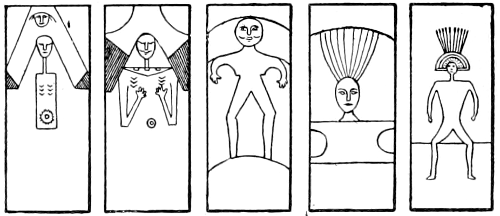
Near an encampment on Chickeeles river, near Puget Sound, Washington, were found some rudely carved painted planks, of which Mr. Eld made a drawing. These planks were placed upright and nothing could be learned of their origin. The colors were exceedingly bright, of a kind of red pigment.
Mr. James O. Pattie (a) gives an account of a wooden passport given to him in 1824 by a Pawnee chief. He describes it, without illustration, as a small piece of wood curiously painted with characters something like “hieroglyphics.” The chief told Mr. Pattie’s party if they saw any of his warriors to give them the stick, in which case they would be kindly treated, which promise was fulfilled a few days later when the party met a large band of the same tribe on the warpath.
Artificial objects may be classified, so far as is important for the present work, into, I, fictile fabrics and, II, textile fabrics.
A large number of articles of pottery bearing pictographs are figured in the illustrated collections by Mr. James Stevenson in the Second Annual Report, and by Mr. Stevenson and Mr. William H. Holmes in the Third Annual Report of the Bureau of Ethnology. Pipes on which totemic designs and property marks appear are also common.
The art of pottery was at first limited to vessel-making. In the earlier stages of culture, vases were confined to simple use as receptacles, but as culture ripened they were advanced to ceremonial and religious offices and received devices and representations in color and in relief connected with the cult to which they were devoted. Among some tribes large burial vases were fashioned to contain or cover the dead. An infinite variety of objects, such as pipes, whistles, rattles, toys, beads, trowels, calendars, masks, and figurines, were made of pottery. Clays of varying degrees of purity were used, and sometimes these were tempered with powdered quartz, shell, or like materials. The vessels were frequently built by coiling. The surface was smoothed by the hands or the modeling implement or was polished with a stone or other smoothing tool. Much attention was given to surface embellishment. The finger nails and various pointed tools were used to scarify and indent, and elaborate figures and designs were incised. Stamps with systematically worked designs were sometimes applied to the soft clay. Cords and woven fabrics were also employed to give diversity to the surface. With the more advanced tribes, though these simple processes were still resorted to, engraving, modeling in relief and in the round, and painting in colors were employed.
Textile fabrics include those products of art in which the elements of their construction are filamental and mainly combined by using their flexibility. The processes employed are called wattling, interlacing, plaiting, netting, weaving, sewing, and embroidery. The materials generally used by primitive people were pliable vegetal growths, such as twigs, leaves, roots, canes, rushes, and grasses, and the hair, quills, feathers, and tendons of animals.
Unlike works in stone and clay, textile articles are seldom long preserved. Still, from historic accounts and a study of the many beautiful articles produced by existing Indian tribes, a fair knowledge of the range and general character of native fabrics may be obtained. In many cases buried articles of that character have been preserved by the impregnation of the engirding earths with preservative salts, and[216] also some fabrics which had been wrapped about buried utensils, or ornaments of copper remained without serious decay. Charring has also been a means of preserving cloth, and much has been learned of the weaving done by ancient workers through impressions upon pottery which had been made by applying the texture while the clay was still soft. The weaving appliances were simple, but the results in plain and figured fabrics, in tapestry, in lace-like embroideries, and in feather-work are admirable.
This subject is discussed by Mr. W. H. Holmes in his paper, A Study of the Textile Art, etc., in the Sixth Annual Report of the Bureau of Ethnology, in a manner so comprehensive as to embrace the field of pictography in its relation to woven articles.
Several examples of this application also appear in the present work. See Figs. 821, 976 and 1167. In addition the following are now presented.
Some of the California tribes are expert workers in grass and roots in the manufacture of baskets, upon which designs other than for mere ornamentation are frequently worked. The Yokuts, at Tule river Agency, in the southeastern part of the State, sometimes incorporate various human forms in which the arms are suspended at the sides of the body with the hands directed outward to either side. Above the head is a heavy horizontal line.
The following is extracted from Prof. O. T. Mason’s (a) paper on basket work, describing Fig. 161:
a is a rain hat of twined basketry in spruce root from Haida Indians. This figure is the upper view and shows the ornamentation in red and black paint. The device in this instance is the epitomized form of a bird, perhaps a duck. Omitting the red cross on the top the beak, jaws, and nostrils are shown; the eyes at the sides near the top, and just behind them the ears. The wings, feet, and tail, inclosing a human face, are shown on the margin. The Haida, as well as other coast Indians from Cape Flattery to Mount Saint Elias, cover everything of use with totemic devices in painting and carving.
b shows the conical shape of a. The painted ornamentation on these hats is laid on in black and red in the conventional manner of ornamentation in vogue among the Haidas and used in the reproduction of their various totems on all of their houses, wood and slate carvings, and implements.
Mr. Niblack (b) says, describing Fig. 162:
The Chilkat and cedar-bark blankets are important factors in all ceremonial dances and functions. Other forms of ceremonial blankets or mantles are made from Hudson Bay Company blankets, with totemic figures worked on them in a variety of ways. The usual method is to cut out the totemic figure in red cloth and sew it on to the garment (ornamenting it with borders of beads and buttons) by the method known as appliqué work; another method is to sew pieces of bright abalone or pearl shell or pearl buttons on to the garment in the totemic patterns. The illustration is a drawing of a vestment which hangs down the back, representing the totem or crest of the wearer.
This specimen is mentioned as the workmanship of the Tsimshian Indians, at Point Simpson, British Columbia, and represents the halibut.
So far as appears on ancient pictographic works the kind of instruments and materials with which they were made can be inferred only from its aspect, though microscopic examination and chemical analysis have sometimes been successfully applied. A few examples relating to the topic are given as follows, though other descriptions appear elsewhere in this treatise.
This title, as here used, is intended to include cutting, pecking, scratching, and rubbing. The Hidatsa, when scratching upon stone or rocks, as well as upon pieces of wood, employ a sharply pointed piece of hard stone, usually a fragment of quartz. The present writer successfully imitated the Micmac scratchings at Kejimkoojik lake, Nova Scotia, by using a stone arrow point upon the slate rocks.
The bow-drill was largely used by the Innuit of Alaska in carving bone and ivory. Their present method of cutting figures and other characters is by a small steel blade, thick, though sharply pointed, resembling a graver.
Many petroglyphs, e. g., those at Conowingo, Maryland, at Machiasport, Maine, and in Owens valley, California, present every evidence of having been deepened if not altogether fashioned by rubbing, either with a piece of wood and sand or with pointed stone.
To incise or indent lines upon birch bark the Ojibwa, Ottawa, and other Algonquian tribes used a sharply pointed piece of bone, though they now prefer an iron nail. Examples of scratching upon the outer surface of bark are mentioned elsewhere.
Several examples of producing characters on stone by pecking with another stone are mentioned in this paper, and Mr. J. D. McGuire (a), of Ellicott City, Maryland, has been remarkably successful in forming petroglyphs with the ordinary Indian stone hammer. Some of the results established by him are published in The American Anthropologist.
Drawings upon small slabs of wood, found among the Ojibwa, were made with a piece of red-hot wire or thin iron rod hammered to a point. Such figures are blackened by being burned in.
When in haste or when better materials are not at hand, the Hidatsa sometimes drew upon a piece of wood or the shoulder-blade of a buffalo with a piece of charcoal from the fire or with a piece of red chalk or red ocher, with which nearly every warrior is at all times supplied.
Mr. A. W. Howitt, in Manuscript Notes on Australian Pictographs, says:
Not having any process such as is used by some of the savage tribes to soften skins, the harshness of these rugs is remedied by marking upon them lines and patterns, which being partly cut through the skin give to it a certain amount of suppleness. In former times, before the white man enabled the black fellow to supplement his meager stock of implements with those of civilization, a Kumai made use of the sharp edge of a mussel shell (unio) to cut these patterns. At the present time the sharpened edge of the bowl of a metal spoon is used, partly because it forms a convenient instrument, partly, perhaps, because its bowl bears a resemblance in shape to the familiar ancestral tool.
Painting upon robes or skins is executed by means of thin strips of wood or sometimes of bone. Tufts of antelope hair are also used, by tying them to sticks to make a brush, but this is evidently a modern innovation. Pieces of wood, one end of which is chewed so as to produce a loose fibrous brush, are also used at times, as has been specially observed among the Teton Dakota.
The Hidatsa and other Northwest Indians usually employ a piece of buffalo rib or a piece of hard wood having an elliptical form. This is dipped in a solution of glue, with or without color, and a tracing is made, which is subsequently filled up and deepened by a repetition of the process with the same or a stronger solution of the color.
Of late years in the United States colors of civilized manufacture are readily obtained by the Indians for painting and decoration. Frequently, however, when the colors of commerce can not be obtained, the aboriginal colors are still prepared and used. The ferruginous clays of various shades of brown, red, and yellow occur in nature so widely distributed that these are the most common and leading tints. Black is generally prepared by grinding fragments of charcoal into a very fine powder. Among some tribes, as has also been found in some of the “ancient” pottery from the Arizona ruins, clay had evidently been mixed with charcoal to give better body. The black color made by some of the Innuit tribes is made with blood and charcoal intimately[220] mixed, which is afterwards applied to incisions in ivory, bone, and wood.
Among the Dakota, colors for dyeing porcupine quills were obtained chiefly from plants. The vegetable colors, being soluble, penetrate the substance of the quills more evenly and beautifully than the mineral colors of eastern manufacture.
The black color of some of the Pueblo pottery is obtained by a special burning with pulverized manure, into which the vessel is placed as it is cooling after the first baking. The coloring matter—soot produced by smoke—is absorbed into the pores of the vessel, and does not wear off as readily as when colors are applied to the surface by brushes.
In decorating skins or robes the Arikara Indians boil the tail of the beaver, thus obtaining a viscous fluid which is thin glue. The figures are first drawn in outline with a piece of beef-rib, or some other flat bone, the edge only being used after having been dipped into the liquor. The various pigments to be employed in the drawing are then mixed with some of the same liquid, in separate vessels, when the various colors are applied to the objects by means of a sharpened piece of wood or bone. The colored mixture adheres firmly to the original tracing in glue.
When similar colors are to be applied to wood, the surface is frequently pecked or slightly incised to receive the color more readily.
Jacques Cartier, in Hakluyt (b), reports the Indian women of the Bay of Chaleur as smearing the face with coal dust and grease.
A small pouch, discovered on the Yellowstone river in 1873, which had been dropped by some fleeing hostile Sioux, contained several fragments of black micaceous iron. The latter had almost the appearance and consistence of graphite, so soft and black was the result upon rubbing with it. It had evidently been used for decorating the face as war-paint.
Mr. Wm. H. Dall (a), treating of the remains found in the mammalian layers in the Amakuak cave, Unalaska, remarks:
In the remains of a woman’s work-basket, found in the uppermost layer in a cave, were bits of this resin [from the bark of pine or spruce driftwood], evidently carefully treasured, with a little birch-bark case (the bark also derived from drift logs) containing pieces of soft hematite, graphite, and blue carbonate of copper, with which the ancient seamstress ornamented her handiwork.
The same author reports (f):
The coloration of wooden articles with native pigments is of ancient origin, but all the more elaborate instances that have come to my knowledge bore marks of comparatively recent origin. The pigments used were blue carbonates of iron and copper; the green fungus, or peziza, found in decayed birch and alder wood; hematite and red chalk; white infusorial or chalky earth; black charcoal, graphite, and micaceous ore of iron. A species of red was sometimes derived from pine bark or the cambium of the ground willow.
Stephen Powers (a) states that the Shastika women “smear their faces all over daily with choke-cherry juice, which gives them a bloody, corsair aspect.”
Mr. A. S. Gatschet, of the Bureau of Ethnology, reports that the Klamaths of southwestern Oregon employ a black color, lgú, made of burnt plum seeds and bulrushes, which is applied to the cheeks in the form of small round spots. This is used during dances. Red paint, for the face and body, is prepared from a resin exuding from the spruce tree, pánam. A yellow mineral paint is also employed, consisting probably of ocher or ferruginous clay. He also says that the Klamath spál, yellow mineral paint, is of light yellow color, but turns red when burned, after which it is applied in making small round dots upon the face. The white infusorial clay is applied in the form of stripes or streaks over the body. The Klamaths use charcoal, lgúm, in tattooing.
Mud and white clay were used by the Winnebago for the decoration of the human body and of horses. Some of the California Indians in the vicinity of Tulare river used a white coloring matter, consisting of infusorial earth, obtained there. The tribes at and near the geysers north of San Francisco bay procured vermilion from croppings of cinnabar. The same report is made with probability of truth concerning the Indians at the present site of the New Almaden mines, where tribes of the Mutsun formerly lived. Some of the black coloring matter of pictographs in Santa Barbara, California, proved on analysis to be a hydrous oxide of manganese. The Mojave pigments are ocher, clay, and charcoal mingled with oil.
Rev. J. Owen Dorsey, of the Bureau of Ethnology, reports regarding the Osage that one of their modes of obtaining black color for the face was by burning a quantity of small willows. When these were charred they were broken in small pieces and placed in pans, with a little water in each. The hands were then dipped into the pan and rubbed together and finally rubbed over the parts to be colored.
Dr. Hoffman reports that among the Hualpai, living on the western border of the Colorado plateau, Arizona, some persons appeared as if they had been tattooed in vertical bands from the forehead to the waist, but upon closer examination it was found that dark and light bands of the natural skin were produced in the following manner: When a deer or an antelope had been killed the blood was rubbed over the face and breast, after which the spread and curved fingers were scratched downward from the forehead over the face and breast, thus removing some of the blood; that remaining soon dried and gave the appearance of black stripes. The exposed portion of the skin retained the natural dark-tanned color, while that under the coating of coagulated blood became paler by being protected against the light and air. These persons did not wash off the marks and after a while the blood began to drop off by desquamation, leaving lighter spots and lines which for a week or two appear like tattoo marks. Similar streaks of blood have been held to have originated tattoo designs in several parts of the world to record success in hunting or in war, but such evolution does not appear to have resulted from the transient decoration in the case mentioned.
It is well known that the meal of maize called kunque is yet commonly used by the Zuñi for ceremonial coloration of their own persons and of objects used in their religious rites. Hoddentin is less familiarly known. It is the pollen of the tule, which is a variety of cat-tail rush growing in all the ponds of the southwestern parts of the United States. It is a yellow powder with which small buckskin bags are filled and those bags then attached to the belts of Apache warriors. They are also worn as amulets by members of the tribe. In dances for the cure of sickness the shaman applied the powder to the forehead of the patient, then to his breast in the figure of a cross; next he sprinkles it in a circle around his couch, then on the heads of the chanters and the assembled friends of the patient, and lastly upon his own head and into his own mouth.
Everard F. im Thurn (c) gives the following details concerning British Guiana:
The dyes used by the Indians to paint their own bodies, and occasionally to draw patterns on their implements, are red faroah, purple caraweera, blue-black lana, white felspathic clay and, though very rarely, a yellow vegetable dye of unknown origin.
Faroah is the deep red pulp around the seed of a shrub (Bixa orellana) which grows wild on the banks of some of the rivers, and is cultivated by the Indians in their clearings. It is mixed with a large quantity of oil. When it is to be used either a mass of it is taken in the palm of the hand and rubbed over the skin or other surface to be painted, or a pattern of fine lines is drawn with it by means of a stick used as a pencil.
Caraweera is a somewhat similar dye, of a more purplish red, and by no means so commonly used. It is prepared from the leaves of a yellow-flowered bignonia (B. chicka) together with some other unimportant ingredients. The dried leaves are boiled. The pot is then taken from the fire and the contents being poured into bowls are allowed to subside. The clear water left at the top is poured away and the sediment is of a beautiful purple color.
Lana is the juice of the fruit of a small tree (Genipa americana) with which without further preparation, blue-black lines are drawn in patterns, or large surfaces are stained on the skin. The dye thus applied is for about a week indelible.
Paul Marcoy (a), in Travels in South America, says the Passés, Yuris, Barrés and Chumanas of Brazil, employ a decoction of indigo or genipa in tattooing.
F. S. Moreat, M. D., in Jour. Roy. Geog. Soc., XXXII, 1862, p. 125, says that the Andaman Islanders rubbed earth on the top of the head, probably for the purpose of ornamentation.
Dr. Richard Andree (b) says:
Long before Europeans came to Australia, the Australian blacks knew a kind of pictorial representation, exhibiting scenes from their life, illustrating it with great fidelity to nature. An interesting specimen of that kind was found on a piece of bark that had served as cover of a hut on Lake Tyrrell. The black who produced this picture had had intercourse with white people, but had had no instruction whatever in drawing. The bark was blackened by smoke on the inside, and on this blackened surface the native drew the figures with his thumb nail.
This is the most obvious and probably was the earliest use to which picture-writing was applied. The contrivance of drawing the representations of objects, to fix in the memory either the objects themselves or the concepts, facts, or other matters connected with them, is practiced early by human individuals and is found among peoples the most ancient historically or in the horizons of culture. After the adoption of the characters for purely mnemonic purposes, those at first intended to be iconographic often became converted into ideographic, emblematic, or symbolic designs, and perhaps in time so greatly conventionalized that the images of the things designed could no longer be perceived by the imagination alone.
It is believed, however, that this form and use of picturing were preceded by the use of material objects which afterwards were reproduced graphically in paintings, cuttings, and carvings. In the present paper many examples appear of objects known to have been so used, the graphic representations of which, made with the same purpose, are explained by knowledge of the fact. Other instances are mentioned as connected with the evolution of pictographs, and they possibly may interpret some forms of the latter which are not yet understood.
This chapter is divided into (1) knotted cords and objects tied; (2) notched or marked sticks; (3) wampum; (4) order of songs; (5) traditions; (6) treaties; (7) appointment; (8) numeration; (9) accounting.
Dr. Hoffman reports a device among the Indians formerly inhabiting the mountain valleys north of Los Angeles, California, who brought or sent to the settlements blankets, skins, and robes for sale. The man trusted to transport and sell those articles was provided with a number of strings made of some flexible vegetable fiber, one string for each class of goods, which were attached to his belt. Every one confiding an article to the agent fixed the price, and when he disposed of it a single knot was tied to the proper cord for each real received, or a double knot for each peso. Thus any particular string indicated the kind of goods sold, as well as the whole sum realized for them, which was distributed according to the account among the former owners of the goods.
Mr. George Turner (a) says that among the South Sea Islanders tying a number of knots in a piece of cord was a common way of noting and remembering things in the absence of a written language.
A peculiar and ingenious mode of expressing thoughts without pronouncing or writing them in language is still met with among the Indian shepherds in the Peruvian Cordilleras, though it is practiced merely in the accounts of the flocks. This system consists of a peculiar intertwining of various strings into a net-like braidwork, and the diverse modes of tying these strings form the record, the knots and loops signifying definite ideas and their combination the connection of these ideas. This system of mnemonic device, which was practiced by the ancient Peruvians, was called quipu, and, though a similar knot-writing is found in China, Tartary, eastern Asia, on many islands of the Pacific, and even in some parts of Africa, yet in Peru, at the time of the Incas, it was so elaborately developed as to permit its employment for official statistics of the government. Of course, as this writing gave no picture of a word and did not suggest sounds, but, like the notched stick, merely recalled ideas already existing, the writing could be understood by those only who possessed the key to it; but it is noteworthy that when the Jesuit missions began their work in Peru they were able to use the quipus for the purpose of making the Indians learn Latin prayers by heart.
A more detailed account of the ancient quipu is extracted from Dr. von Tschudi’s Travels in Peru (a) with condensation as follows:
This method consisted in the dexterous intertwining of knots on strings, so as to render them auxiliaries to the memory. The instrument was composed of one thick head or top string, to which, at certain distances, thinner ones were fastened. The top string was much thicker than these pendent strings and consisted of two doubly twisted threads, over which two single threads were wound. The branches, or pendent strings, were fastened to the top ones by a single loop; the knots were made in the pendent strings and were either single or manifold. The length of the strings was various. The transverse or top string often measures several yards, and sometimes only a foot; the branches are seldom more than 2 feet long, and in general they are much shorter.
The strings were often of different colors, each having its own particular signification. The color for soldiers was red; for gold, yellow; for silver, white; for corn, green, etc. The quipu was especially employed for numerical and statistical tables; each single knot representing ten; each double knot stood for one hundred; each triple knot for one thousand, etc.; two single knots standing together made twenty; and two double knots, two hundred.
In this manner the ancient Peruvians kept the accounts of their army. On one string were numbered the soldiers armed with slings; on another the spearmen; on a third, those who carried clubs, etc. In the same manner the military reports were prepared. In every town some expert men were appointed to tie the knots of the quipu and to explain them. These men were called quipucamayocuna (literally, officers of the knots.) The appointed officers required great dexterity in unriddling the meaning of the knots. It, however, seldom happened that they had to read a quipu without some verbal commentary. Something was always required to be added if the quipu came from a distant province, to explain whether it related to the numbering of the population, to tributes, or to war, etc. This method of calculation[225] is still practiced by the shepherds of Puna. On the first branch or string they usually place the number of the bulls; on the second, that of the cows, the latter being classed into those which were milked and those which were not milked; on the next string were numbered the calves according to their ages and sizes. Then came the sheep, in several subdivisions. Next followed the number of foxes killed, the quantity of salt consumed, and, finally, the cattle that had been slaughtered. Other quipus showed the produce of the herds in milk, cheese, wool, etc. Each list was distinguished by a particular color or by some peculiarity in the twisting of the string.
Other accounts tell that the descendants of the Quiches still use the quipu, perhaps as modified by themselves, for numeration. They pierce beans and hang them by different colored strings, each of which represents one of the column places used in decimal arithmetic. A green string signifies 1,000; a red one, 100; a yellow, 10, and a white refers to the 9 smaller digits. Thus if 7 beans are on a green, 2 on a red, 8 on a yellow, and 6 on a white string, and the whole tied together, the bundle expresses the number 7,286.
Before the time of their acquaintance with the quipus, the Peruvians used in the same way pebbles or maize-beans of various colors. The same practice was known in Europe in the prehistoric period. The habit of many persons in civilized countries to tie a knot in the handkerchief to recall an idea or fact to mind is a familiar example to show how naturally the action would suggest itself for the purpose, and perhaps indicates the inheritance of the practice.
Dr. Andree (b) gives an illustration of a quipu (here reproduced as part of Pl. XVI), which he represents as taken from Perez, and states that the drawing was made soon after the exhuming of the object from an ancient Peruvian grave.
Capt. Bourke (a) gives descriptions and illustrations of varieties of the izze-kloth or medicine cord of the Apache. A condensed extract of his remarks is as follows:
These cords, in their perfection, are decorated with beads and shells strung along at intervals, with pieces of the sacred green chalchihuitl, which has had such a mysterious ascendancy over the minds of the American Indians—Aztec, Peruvian, Quiche, as well as the more savage tribes like the Apache and Navajo; with petrified wood, rock crystal, eagle down, claws of the hawk or eaglet, claws of the bear, rattle of the rattlesnake, buckskin bags of hoddentin, circles of buckskin in which are inclosed pieces of twigs and branches of trees which have been struck by lightning, small fragments of the abalone shell from the Pacific coast, and much other sacred paraphernalia of a similar kind.
That the use of these cords was reserved for the most sacred and important occasions I soon learned. They were not to be seen on occasions of no moment, but the dances for war, medicine, and summoning the spirits at once brought them out, and every medicine man of any consequence would appear with one hanging from his right shoulder over his left hip.
These cords will protect a man while on the warpath, and many of the Apache believe firmly that a bullet will have no effect upon the warrior wearing one of them. This is not their only virtue by any means; the wearer can tell who has stolen ponies or other property from him or from his friends, can help the crops, and cure the sick. If the circle attached to one of these cords is placed upon the head it will at once relieve any ache, while the cross attached to another prevents the[226] wearer from going astray, no matter where he may be; in other words, it has some connection with cross-trails and the four cardinal points, to which the Apache pay the strictest attention.
I was at first inclined to associate these cords with the quipus of the Peruvians and also with the wampum of the aborigines of the Atlantic coast, and investigation only confirms this first suspicion.
The praying beads of the Buddhists and of many Oriental peoples, who have used them from high antiquity, are closely allied to the quipu. They are more familiar now in the shape of the rosaries of Roman Catholics. In the absence of manufactured articles, arranged on wires, the necessary materials were easily procured. Berries, nuts, pease, or beans strung in any manner answered the purpose. The abacus of the Chinese and Greeks was connected in origin with the same device.
E. F. im Thurn (d) says of the Nikari-Karu Indians of Guiana:
At last, after four days’ stay, we got off. The two or three people from Euwari-manakuroo who came with us gave their wives knotted strings of quippus, each knot representing one of the days they expected to be away, and the whole string thus forming a calendar to be used by the wives until the return of their husbands.
That the general idea or invention for mnemonic purposes appearing in the quipu was actually used pictorially is indicated in the illustrations of the sculptures of Santa Lucia Cosumalhuapa in Guatemala given by Dr. S. Habel (b). Upon these he remarks:
It has been frequently affirmed that the aborigines of America had nowhere arisen high enough in civilization to have characters for writing and numeral signs, but the sculptures of Santa Lucia exhibit signs which indicate a kind of cipher-writing higher in form than mere hieroglyphics. From the mouth of most of the human beings, living or dead, emanates a staff, variously bent, to the sides of which nodes are attached. These nodes are of different sizes and shapes, and variously distributed on the sides of the staff, either singly or in twos and threes, the last named either separated or in shape of a trefoil. This manner of writing not only indicates that the person is speaking or praying, but also indicates the very words, the contents of the speech or prayer. It is quite certain that each staff, as bent and ornamented, stood for a well-known petition, which the priest could read as easily as those acquainted with a cipher dispatch can know its purport. Further, one may be allowed to conjecture that the various curves of the staves served the purpose of strength and rhythm, just as the poet chooses his various meters for the same purpose.
The following notices of the ancient mnemonic use of knotted cords and of its survival in various parts of the world are extracted from the essay of Prof. Terrien de Lacouperie (d):
The Yang tung, south of Khoten, and consequently north of Tibet, who first communicated with China in A. D. 641, had no written characters. They only cut notches in sticks and tied knots in strings for records.
The Bratyki and Buriats of Siberia are credited with the use of knotted cords.
The Japanese are also reputed to have employed knots on strings or bind-weeds for records.
The Li of Hainan, being unacquainted with writing, use knotted cords or notched sticks in place of bonds or agreements.
In the first half of the present century cord records were still generally used in the Indian archipelago and Polynesia proper. The tax-gatherers in the island of Hawaii by this means kept accounts of all the articles collected by them from the inhabitants. A rope 400 fathoms long was used as a revenue book. It was divided[227] into numerous portions corresponding to the various districts of the island; the portions were under the care of the tax-gatherers, who, with the aid of loops, knots, and tufts of different shapes, colors, and sizes, were enabled to keep an accurate account of the hogs, pigs, and pieces of sandal wood, etc., at which each person was taxed.
In Timor island, according to the Chinese records in 1618, the people had no writing. When they wanted to record something they did it with flat stones, and a thousand stones were represented by a string.
Knotted cords were originally used in Tibet, but we have no information about their system of using them. The bare statement comes from the Chinese annals.
The following statement regarding the same use by the Chinese is made by Ernest Faber (a). He says: “In the highest antiquity, government was carried on successfully by the use of knotted cords to preserve the memory of things. In subsequent ages, the sages substituted for these written characters. By means of these the doings of all the officers could be regulated and the affairs of all the people accurately examined.”
The use of notches for mere numeration was frequent, but there are also instances of their special significance.
The Dakotas, Hidatsa, and Shoshoni have been observed to note the number of days during which they journeyed from one place to another by cutting lines or notches upon a stick.
The coup sticks carried by Dakota warriors often bear a number of small notches, which refer to the number of the victims hit with the stick after they had been wounded or killed.
The young men and boys of the several tribes at Fort Berthold, Dakota, frequently carry a stick, upon which they cut a notch for every bird killed during a single expedition.
In Seaver’s (a) life of Mary Jemison it is set forth that the war chief
in each tribe of Iroquois keeps a war-post, in order to commemorate
great events and preserve the chronology of them. This post is a
peeled stick of timber 10 or 12 feet high, and is erected in the village.
For a campaign they make, or rather the chief makes, a perpendicular
red mark about 3 inches long and half an inch wide. On the opposite
side from this, for a scalp taken, they make a red cross, thus
![]() On another side, for a prisoner taken alive, they make a red cross in
this manner
On another side, for a prisoner taken alive, they make a red cross in
this manner
![]() with a head or dot, and by placing these significant
signs in so conspicuous a situation they are enabled to ascertain with
great certainty the time and circumstances of past events.
with a head or dot, and by placing these significant
signs in so conspicuous a situation they are enabled to ascertain with
great certainty the time and circumstances of past events.
It is suggested that the device first mentioned represents the scalp severed and lifted from the head, and that the second refers to the[228] manner in which the prisoners were secured at night, pegged and tied in the style called spread-eagle.
Rev. Richard Taylor (a) notes that the Maori had neither the quipus nor wampum, but only a board shaped like a saw, which was called “he rakau wakapa-paranga,” or genealogical board. It was, in fact, a tally, having a notch for each name, and a blank space to denote where the male line failed and was succeeded by that of the female; youths were taught their genealogies by repeating the names of each ancestor to whom the notches referred.
It is supposed that the use by bakers of notched sticks or tallies, as they are called, still exists in some civilized regions, and there is an interesting history connected with the same wooden tallies, which until lately were used in the accounts of the exchequer of Great Britain. They also appear more recently and in a different use as the Khe-mou circulated by Tartar chiefs to designate the number of men and horses required to be furnished by each camp.
Prof. Robert E. C. Stearns (a) says that wampum consisted of beads of two principal colors having a cylindrical form, a quarter of an inch, more or less, in length, the diameter or thickness being usually about half the length. The color of the wampum determined its value. The term wampum, wampon, or wampom, and wampum-peege was apparently applied to these beads when strung or otherwise connected, fastened, or woven together. The illustration given by him is now reproduced as Fig. 163.
In the Jesuit Relations, 1656, p. 3, the first present of an Iroquois chief to Jesuit missionaries at a council is described. This was a great figure of the sun, made of 6,000 beads of wampum, which explained to them that the darkness shall not influence them in the councils and the sun shall enlighten them even in the depth of night.
Among the Iroquoian and Algonquian tribes wampum belts were generally used to record treaties. Mr. John Long (a) describes one of them:
The wampum belts given to Sir William Johnson, of immortal Indian memory, were in several rows, black on each side and white in the middle; the white being placed in the center was to express peace and that the path between them was fair and open. In the center of the belt was a figure of a diamond made of white wampum, which the Indians call the council fire.
In the Jesuit Relations, 1642, p. 53, it is said that among the northern Algonquins a present to deliver a prisoner consisted of three strings of wampum to break the three bonds by which he was supposed to be tied, one around the legs, one around the arms, and the third around the middle.
In the same Relations, 1653, p. 19, is a good example of messages attached to separate presents of wampum, etc. This was at a council in 1653 at the Huron town, 2 leagues from Quebec:
The first was given to dry the tears which are usually shed at the news of brave warriors massacred in combat.
The second served as an agreeable drink, as an antidote to whatever bitterness might remain in the heart of the French on account of the death of their people.
The third was to furnish a piece of bark or a covering for the dead, lest the sight of them should renew the old strife.
The fourth was to inter them and to tread well the earth upon their graves, in order that nothing should ever come forth from their tombs which could grieve their friends and cause the spirit of revenge to arise in their minds.
The fifth was to serve as a wrapping to pack up the arms which were henceforth not to be touched.
The sixth was to cleanse the river, soiled with so much blood.
The last, to exhort the Hurons to agree to what Onontio, the great captain of the French, should decide upon touching the peace.
As a rule there was no intrinsic significance in a wampum belt, or collar, as the French sometimes called it. It was not understood except by the memory of those to whom and by whom it was delivered. This is well expressed in a dialogue reported by Capt. de Lamothe Cadillac (a) in 1703:
[Council of Hurons at Fort Ponchartrain, June 3, 1703.]
Quarante-Sols. I come on my way to tell you what I propose to do at Montreal. Here is a collar which has been sent to us by the Iroquois, and which the Ottawas have brought to us; we do not know what it signifies.
M. de Lamothe. How have you received this collar without knowing the purpose for which it was sent you?
Quarante-Sols. It has already been long since we received it. I was not there, and our old men have forgotten what it said.
M. de Lamothe. Your old men are not regarded as children to have such a short memory.
Quarante-Sols. We do not accept this collar; but we are going to take it to Sonnontouan [the Seneca town] to find out what it means; because it is a serious matter not to respond to a collar; it is the custom among us. The Ottawas can tell you what it is, because our people have forgotten it.
M. de Lamothe. The Ottawas will reply that having received it you should remember it, but since this collar is dumb and has lost its speech I am obliged to be silent myself.
In the Diary of the Siege of Detroit (a) it is narrated that after receiving a belt of wampum from the commanding officer the Pottawatomi chief called it the officer’s “mouth,” and said that those to whom it was sent would believe it when “they saw his mouth.”
But wampum designs, besides being mere credentials, and thus like the Australian message sticks, and also mnemonic, became, to some[230] extent, conventional. The predominance of white beads indicated peace, and purple or violet meant war.
On the authority of Sir Daniel Wilson (a) a string of black wampum sent round the settlement is still among the Indians of the Six Nations the notice of the death of a chief.
The Iroquois belts had an arrangement of wampum to signify the lakes, rivers, mountains, valleys, portages, and falls along the path of trail between them and the Algonkins, who were parties to their treaty in 1653.
On the authority of a manuscript letter from St. Ange to D’Abbadie, September 9, 1764, quoted by Parkman (a), Pontiac’s great wampum belt was 6 feet long, 4 inches wide, and was wrought from end to end with the symbols of tribes and villages, 47 in number, which were leagued with him.
In addition to becoming conventional the designs in wampum, perhaps from expertness in their workmanship, exhibited ideographs in their later development, of which the following description, taken from Rev. Peter Jones’s (a), “History of the Ojebway Indians” is an instance:
Johnson then explained the emblems contained in the wampum belt brought by Yellowhead, which, he said, they acknowledged to be the acts of their fathers. Firstly, the council fire at the Sault Ste. Marie has no emblem, because then the council was held. Secondly, the council fire at Mamtoulni has the emblem of a beautiful white fish; this signifies purity, or a clean white heart—that all our hearts ought to be white toward each other. Thirdly, the emblem of a beaver, placed at an island on Penetanguishew bay, denotes wisdom—that all the acts of our fathers were done in wisdom. Fourthly, the emblem of a white deer, placed at Lake Simcoe, signified superiority; the dish and ladles at the same place indicated abundance of game and food. Fifthly, the eagle perched on a tall pine tree at the Credit denotes watching, and swiftness in conveying messages. The eagle was to watch all the council fires between the Six Nations and the Ojebways, and being far-sighted, he might, in the event of anything happening, communicate the tidings to the distant tribes. Sixthly, the sun was hung up in the center of the belt to show that their acts were done in the face of the sun, by whom they swore that they would forever after observe the treaties made between the two parties.
In the same work, p. 119, is a description of a wampum belt that recorded the first treaty between the Ojibwa and the Six Nations of the Iroquois confederacy. It has the figure of a dish or bowl at its middle to represent that the Ojibwa and the Six Nations were all to eat out of the same dish, meaning, ideographically, that all the game in the region should be for their common use.
Mr. W. H. Holmes (c) gives an illustration of the well-known Penn wampum belt, reproduced here as Fig. 164, with remarks condensed as follows:
It is believed to be the original belt delivered by the Leni-Lenape sachems to William Penn at the celebrated treaty under the elm tree at Schackamaxon in 1682. Up to the year 1857 this belt remained in the keeping of the Penn family. In March, 1857, it was presented to the Pennsylvania Historical Society by Granville John Penn, a great-grandson of William Penn. Mr. Penn, in his speech on this occasion, states that there can be no doubt that this is the identical belt used at the treaty, and presents his views in the following language:
“In the first place, its dimensions are greater than of those used on more ordinary occasions, of which we have one still in our possession—this belt being composed of 18 strings of wampum, which is a proof that it was the record of some very important negotiation. In the next place, in the center of the belt, which is of white wampum, are delineated in dark-colored beads, in a rude, but graphic style, two figures—that of an Indian grasping with the hand of friendship the hand of a man evidently intended to be represented in the European costume wearing a hat, which can only be interpreted as having reference to the treaty of peace and friendship which was then concluded between William Penn and the Indians, and recorded by them in their own simple but descriptive mode of expressing their meaning by the employment of hieroglyphics.”
The Indian songs or, more accurately, chants, with which pictography is connected, have been preserved in their integrity by the use of pictured characters. They are in general connected with religious ceremonies, and are chiefly used in the initiation of neophytes to secret religious orders. Some of them, however, are used in social meetings or ceremonies of cult societies, though the distinction between social or any other general associations and those to be classified as religious is not easily defined. Religion was the real life of the tribes, permeating all their activities and institutions.
The words of these songs are invariable, even to the extent that by their use for generations many of them have become archaic and form no part of the colloquial language. Indeed, they are not always understood by the best of the shaman songsters, which fact recalls the oriental memorization of the Veda ritual through generations by the priests, who thus, without intent, preserved a language. The sounds were memorized, although the characters designating or, more correctly, recalling them, were not representations of sound, but of idea.
Practically, the words—or sounds, understood or not, which passed[232] for words—as well as the notes, were memorized by the singers, and their memory, or that of the shaman, who acted as leader or conductor or precentor, was assisted by the charts. Exoteric interpretation of any ideographic and not merely conventional or purely arbitrary characters in the chart, which may be compared for indistinctness with the translated libretto of operas, may suggest the general subject-matter, perhaps the general course, of the chant, but can not indicate the exact words, or, indeed, any words, of the language chanted.
A simple mode of explaining the amount of symbolism necessarily contained in the charts of the order of songs is by likening them to the illustrated songs and ballads lately published in popular magazines, where every stanza has at least one appropriate illustration. Let it be supposed that the text was obliterated forever, indeed, the art of reading lost, the illustrations remaining, as also the memory to some persons of the words of the ballad. The illustrations, kept in their original order, would always supply the order of the stanzas and also the particular subject-matter of each particular stanza, and that subject-matter would be a reminder of the words. This is what the rolls of birchbark supply to the initiated Ojibwa. Schoolcraft pretended that there is intrinsic symbolism in the characters employed, which might imply that the words of the chants were rather interpretations of those characters than that the latter were reminders of the words. But only after the vocables of the actual songs and chants have been learned can the mnemonic characters be clearly understood. Doubtless the more ideographic and the less arbitrary the characters the more readily can they be learned and retained in the memory, and during the long period of the practical use of the mnemonic devices many exhibiting ideography and symbolism have been invented or selected.
The ceremonial songs represented pictorially in Pl. XVII, A, B, C, and D, were obtained from Ojibwa shamans at White Earth, Minnesota, by Dr. Hoffman, and pertain to the ceremony of initiating new members into the Midē' wiwin or Grand Medicine Society. The language, now omitted, differs to some extent from that now spoken. The songs and ritual are transmitted from generation to generation, and although an Indian who now receives admission into the society may compose his own songs for use in connection with his profession, he will not adopt the modern Ojibwa words, but employs the archaic whenever practicable. To change the ancient forms would cause loss of power in the charms which such songs are alleged to possess.
The translation of the songs was given by the Ojibwa singers, while the remarks in smaller type further elucidate the meaning of the phrases, as afterwards explained by the shaman.
The characters were all drawn upon birch bark, as is usual with the “medicine songs” of the Ojibwa, and the words suggested by the incisions were chanted. The incompleteness of some of the phrases was accounted for by the shaman by the fact that they are gradually[233] being forgotten. The ceremonies are now of infrequent occurrence, which tends to substantiate this assertion.
One song, as presented on a single piece of birch bark, really consists of as many songs as there are mnemonic characters. Each phrase, corresponding to a character, is repeated a number of times; the greater the number of repetitions the greater will be the power of inspiration in the singer. One song or phrase may, therefore, extend over a period of from two to ten or more minutes.
The song covers much more time when dancing accompanies it, as is the case with the first one presented below. The dancing generally commences after a pause, designated by a single vertical bar.
The following characters are taken from A, Pl. XVII, and are here reproduced separately to facilitate explanation:

The earth, spirit that I am, I take medicine out of the earth.
The upper figure represents the arm reaching down toward the earth, searching for hidden remedies.

(Because of) a spirit that I am, my son.
The headless human figure emerging from the circle is a mysterious being, representing the power possessed by the speaker. He addresses a younger and less experienced Midē' or shaman.
Bar or rest.
The vertical line denotes a slight pause in the song, after which the chant is renewed, accompanied by dancing.

They have pity on me, that is why they call us to the Grand Medicine.
The inner circle represents the speaker’s heart; the outer circle, the gathering place for shamans, while the short lines indicate the directions from which the shamans come together.

I want to see you, medicine man.
The figure of a head is represented with lines running downward (and forward) from the eyes, donating sight. The speaker is looking for the shaman, spoken to, to make his appearance within the sacred structure where the Midē' ceremonies are to take place.

My body is a spirit.
The character is intended to represent the body of a bear, with a line across the body, signifying one of the most powerful of the sacred Man'idōs or spirits, of the Midē' wiwin or “Grand Medicine Society.”

You would [know] it, it being a spirit.
The figure of a head is shown with lines extending both upward and downward from the ears, denoting a knowledge of things in realm of the Man'idōs above, and of the secrets of the earth beneath.
As I am dressed, I am.
The otter is emerging from the sacred Midē' inclosure; the otter typifies the sacred Man'idō who received instruction for the people from Mi'nabō'zho, the intermediary between the “Great Spirit” and the Ânîshinâbeg.

That is what ails me, I fear my Midē' brothers.
The arm reaching into a circle denotes the power of obtaining mysterious influence from Kítschi Man'idō, but the relation between the pictograph and the phrase is obscure; unless the speaker fears such power as possessed by others.
The following is the order of another Midē' song. The general style of the original resembles the specific class of songs which are used when digging medicines, i. e., plants or roots. The song is shown in Pl. XVII, B as the character appears on the bark.

As I arise from [slumber].
The speaker is shown as emerging from a double circle, his sleeping place.

What have I unearthed?
The speaker has discovered a bear Man'idō, as shown by the two hands grasping that animal by the back.

Down is the bear.
The bear is said to have his legs cut off, by the outline of the Midē' structure, signifying he has become helpless because he is under the influence of the shamans.
Big, I am big.
The speaker is great in his own estimation; his power of obtaining gifts from superior beings is shown by the arm reaching for an object received from above; he has furthermore overcome the bear Man'idō and can employ it to advantage.
You encourage me.
Two arms are shown extended toward a circle containing spots of mī'gis, or sacred shells. The arms represent the assistance of friends of the speaker encouraging him with their assistance.
I can alight in the medicine pole.
The eagle or thunder-bird is perched upon the medicine pole erected near the shamans’ sacred structure. The speaker professes to have the power of flight equal to the thunder-bird, that he may transport himself to any desired locality.
The following is another example of a pictured Midē' song, and is represented in Pl. XVII, C.

I know you are a spirit.
The figure is represented as having waving lines extending from the eyes downward toward the earth, and indicating search for secrets hidden beneath the surface of the earth. The hands extending upward indicate the person claims supernatural powers by which he is recognized as “equal to a spirit.”
I lied to my son.
The signification of the phrase could not be explained by the informant, especially its relation to the character, which is an arm, reaching beyond the sky for power from Ki'tshi Man'idō. The waving line upon the arm denotes mysterious power.

Spirit I am, the wolf.
The speaker terms himself a wolf spirit, possessing peculiar power. The animal as drawn has a line across the body signifying its spirit character.

At last I become a spirit.
The circle denotes the spot occupied by the speaker; his hands extended are directed toward the source of his powers.
I give you the mī'gis.
The upper character represents the arm reaching down giving a sacred shell, the mī'gis, the sacred emblem of the “Grand Medicine Society.” The “giving of the mī'gis” signifies its “being shot” into the body of a new member of the society to give him life and the power of communing with spirits, or Man'idōs.
You are speaking to me.
An arm is extended toward a circle containing a smaller one, the latter representing the spot occupied by Midē' friends.
The characters next explained are taken from the last line, D, of the series given in Pl. XVII. The speaker appears to have great faith in his own powers as a Midē'.
Spirit I am, I enter.
The otter, which Man'idō, the speaker, professes to represent, is entering the sacred structure of Midē' lodge.

Midē' friends, do you hear me?
The circles denote the locality where the Midē' are supposed to be congregated. The waving lines signify hearing, when, as in this case, attached to the ears.
The first time I heard you.
The speaker asserts that he heard the voices of the Man'idōs when he went through his first initiation into the society. He is still represented as the otter.

The spirit, he does hear (?)
The interpretation is vague, but could not be otherwise explained. The lines from the ears denote hearing.
They, the Midē' friends, have paid enough.
The arm in the attitude of giving, to Ki'tshi Man'idō, signifies that the Midē' have made presents of sufficient value to be enabled to possess the secrets, which they received in return.

They have pity on me, the chief Midē'.
The arms of Ki'tshi Man'idō are extended to the Midē' lodge, giving assistance as besought.
The song mnemonically represented in Pl. XVIII A (reproduced from Pl. X A. of the Seventh Ann. Rep. Bur. of Ethn.) is sung by the Ojibwa preceptor who has been instructing the candidate for initiation. It praises the preceptor’s efforts and the character of the knowledge he has imparted. Its delivery is made to extend over as much time as possible.
The mnemonic characters were drawn by Sikas'sigĕ, and are a copy of an old birchbark scroll, which has for many years been in his possession,[237] and which was a transcript of one in the possession of his father Baiédzĭk, one of the leading Midē' at Mille Lacs, Minnesota.

My arm is almost pulled out with digging medicine. It is full of medicine.
The short zigzag lines signifying magic influence, erroneously designated “medicine.”

Almost crying because the medicine is lost.
The lines extending downward from the eye signify weeping; the circle beneath the figure, the place where the “medicine” is supposed to exist. The idea of “lost” signifies that some information has been forgotten through death of those who possessed it.

Yes, there is much medicine you may cry for.
Refers to that which is yet to be taught.

Yes, I see there is plenty of it.
The Midē' has knowledge of more than he has imparted, but reserves that knowledge for a future time. The lines of “sight” run to various medicines which he perceives or knows of.
Rest.

When I come out the sky becomes clear.
When the otter-skin Midē' sack is produced the sky becomes clear, so that the ceremonies may proceed.

The spirit has given me power to see.
The Midē' sits on a mountain the better to commune with the good Man'idō.

I brought the medicine to bring life.
The Midē' Man'idō, the Thunderer, after bringing some of the plants—by causing the rains to fall—returns to the sky. The short line represents part of the circular line usually employed to designate the imaginary vault of the sky.

I too, see how much there is.
His power elevates the Midē' to the rank of a Man'idō, from whose position he perceives many secrets hidden in the earth.

I am going to the medicine lodge.
The vertical, left-hand figure denotes a leg going toward the Midē'wigân.
I take life from the sky.
The Midē' is enabled to reach into the sky and to obtain from Ki'tshi Man'idō' the means of prolonging life. The circle at the top denotes the sacred migis or shell.
Let us talk to one another.
The circles denote the places of the speaker (Midē') and the hearer (Ki'tshi Man'idō), the short lines signifying magic influences, the Midē' occupying the left hand and smaller seat.

The spirit is in my body, my friend.
The mī'gis, given by Ki'tshi Man'idō, is in contact with the Midē'’s body, and he is possessed of life and power.
In the order of song, Pl. XVIII, B, reproduced from Pl. IX, C, of the Seventh Ann. Rep. of the Bureau of Ethnology, the preceptor appears to feel satisfied that the candidate is prepared to receive the initiation, and therefore tells him that the Midē' Man'idō announces to him the assurance. The preceptor therefore encourages his pupil with promises of the fulfillment of his highest desires:

I hear the spirit speaking to us.
The Midē'-singer is of superior power, as designated by the horns and pointer upon his head. The lines from the ears indicate hearing.

I am going into the medicine lodge.
The Midē'wigân is shown with a line through it, to signify that the preceptor is going through it in imagination, as in the initiation.
I am taking (gathering) medicine to make me live.
The disks indicate the sacred objects sought for, which are successively obtained by the speaker, who represents the officiating shaman.

I give you medicine, and a lodge, also.
The Midē', as the personator of Makwá Man'idō, is empowered to offer this privilege to the candidate.

I am flying into my lodge.
Represents the thunder-bird, a deity flying into the arch of the sky, the abode of spirits or Man'idōs. The short lines cutting the curve are spirit lines.

The spirit has dropped medicine from the sky where we can get it.
The line from the sky, diverging to various points, indicates that the sacred objects fall in scattered places.

I have the medicine in my heart.
The singer’s heart is filled with knowledge relating to sacred objects from the earth.
The song depicted in Pl. XVIII C, was drawn by “Little Frenchman,” an Ojibwa Midē' of the first degree, who reproduced it from a bark record belonging to his preceptor. “Little Frenchman” had not yet received instruction in these characters, and consequently could not sing the songs, but from his familiarity with mnemonic delineations of the order of the Grand Medicine of ideas he was able to give an outline of the signification of the figures and the phraseology which they suggested to his mind. In the following description the first line pertaining to a character is the objective description, the second being the explanation.
It is furthermore to be remarked that in this chart and the one following the interpretation of characters begins at the right hand instead of the left, contrary to rule. The song is reproduced from. Pl. XXII, A, of the Seventh Annual Report of the Bureau of Ethnology:
From the place where I sit.
A man, seated and talking or singing.

The big tree in the middle of the earth.
Tree; inclosure represents the world as visible from a given spot of observation—horizon.
I will float down the fast running stream.
Stream of water; the spots indicate progress of traveler, and may be rude indications of canoes or equally rude foot tracks, the usual pictograph for traveling.

The place that is feared I inhabit; the swift running stream.
A spirit surrounded by a line indicating the shore.

You who speak to me.
Two spirits communing.
I have long horns.
Horned water monster.
Rest; dancing begins with next character.

I, observing, follow your example.
Man listening to water monster (spirit).

You are my body; you see anybody; you see my nails are worn off in grasping the stone (from which medicine is taken).
Bear, with claws, scratching; depression shown by line under claws, where scratching has been done.

You (i. e., the spirits who are there), to whom I am speaking.
Spirit panther.

I am floating down smoothly.
Spirit otter, swimming; outer lines are river banks.
Rest.

I have finished my drum.
Spirit holding drum; sound ascending.

My body is like unto you.
This is the mī'gis shell—the special symbol of the Midē' wiwin.

Hear me, thou, who art talking to me.
Listening, and wanting others (spirits) to hear.

See what I am taking.
Spirit (Midē') taking “medicine root.”
See me whose head is out of the water.
Otters, two spirits, the left-hand one being the “speaker.”
The Midē' song, Pl. XVIII, D, was also copied by “Little Frenchman” upon birchbark, from one in the possession of his preceptor, but upon which he had not yet received careful instruction; hence the incompleteness of some of his interpretations. It is reproduced from Pl. XXII, B, of the Seventh Ann. Rep. Bureau of Ethnology.

I am sitting down with my pipe.
Man sitting, holding a pipe. He has been called upon to “make medicine.” The short lines beneath the body represent that he is seated. He holds a filled pipe which he is not yet smoking.

I, me the spirit, the spirit of the owl.
Owl, held by Midē'; arm above bird. This character appears upon the Grand Medicine chart from Red Lake, as passing from the midē' lodge to the ghost lodge.

It stands, that which I am going after.
Tree; showing tracks made by bear spirit. The speaker terms himself equal with this spirit and represents himself seeking remedies.

I, who fly.
Medicine bag, flying. The figure is that of the thunder bird (eagle) whose skin was used for a bag. The trees beneath show the bird to have ascended beyond their tops.

Kibinan is what I use—the magic arrow.
An arrow, held by hand.

I am coming to the earth.
Otter spirit. Circle denotes the surrounding sky in which is the spirit. The earth is shown by the horizontal line above which is the Indian hut. The speaker likens himself to the otter spirit who first received the rites of the Midē' initiation.

I am feeling for it.
Man (spirit) seeking for hidden medicine. The circle represents a hole in the earth.

I am talking to it.
Medicine bag made of an owl skin is held by shaman; latter is talking to the magic elements contained therein.
They are sitting in a circle (“around in a row”).
Midē' lodge; Midē' sitting around. The crosses represent the persons present.

You who are newly hung, and you who have reached half, and you who are now full.
Full moon, one half, and quarter moon.
I am going for my dish.
Footprints leading to dish (ghost society dish). The circular objects here each denotes a “feast,” usually represented by a “dish.”
I go through the medicine lodge.
Grand medicine lodge; tracks leading through it. The speaker, after having prepared a feast, is entitled to enter for initiation.

Let us commune with one another.
Two men conversing; two Midē'.
The mnemonic order of song, Pl. XIX a, is another example from Red Lake, prepared by the Ojibwa last mentioned:

“Carved images.”
Carved images. These represent the speaker to say that he prepares fetishes for hunting, love, etc.

I am holding my grand medicine sack.
Man holding “medicine bag.”

“Wants a woman.” [No interpretation was ventured by “Little Frenchman.”]

Hear me, great spirit.
Lines from the ears, to denote hearing.

I am about to climb.
Medicine tree at grand lodge. The marks on either side are bear tracks, the footprints of the bear spirit—the speaker representing him.

I am entering the grand medicine lodge.
The Midē'wigân, showing footprints of the bear Man'idō which are simulated by the boastful shaman.

I am making my tracks on the road.
Footprints on the path.

I am resting at my home.
Human figure, with “voice” issuing—singing.
Pl. XIX b is a similar song, also made by “Little Frenchman,” and relates to magic remedies and his powers of incantation:

The stars.
Stars, preceded by a mark of rest or beginning. It may be noticed that one star has eight and the other six rays, showing that their number is not significant.
The wolf that runs.
Wolf; the banded tail distinguishes it from the otter.

See me what I have; what I have (goods given in the midē' wigwân).
Man holding bow.
See what I am about to do.
Arm, holding a gun.
The house of the beaver.
Beaver, in his house.
I, who make a noise.
A frog, croaking, shown by “voice” lines.

My white hair.
Head with hair. The signification of white hair is great age, though there is no way to ascertain this without oral statement by the singer.
The house of the otter.
Otter in his burrow.

Hear me, you, to whom I am talking.
Mī'gis, spoken to by man, lines showing hearing. The sacred emblem of the Midē'wiwin is implored for aid in carrying out a desired scheme.
I stoop as I walk.
An old man. Age is denoted by the act of walking with a staff.

I stand by the tree.
Standing near medicine tree. The speaker knows of valued remedies which he desires to dispose of for payment.

I am raising a rock.
Man with stone for Midē' lodge. Carrying stone to Midē' lodge, against which to place a patient.

I am holding my pail.
Vessel of medicine; arm reaching down to it.

My arrow point is of iron, and about to kill a male bear.
Bear, above arrow. Bow—lower character.

I am about to speak to the sky.
Speaking to the “sky.” Power of communing with the Great Spirit, Ki'tshi Man'idō'.

I am about to depart; I will liken myself to a bear.
Bear, tracks and path.

I am walking on the hard sand beach.
Body of water, and lynx. The ellipse denotes a lake.
Another song of a similar character, reproduced from birchbark on Pl. XIX c, is explained below. It was also made by “Little Frenchman,” and relates to the searching for and preparation of objects used in sorcery.

It is fiery, that which I give you.
Vessel, with flames on top. Contains strong water wi-bīn', a magical decoction.

It is growing, the tree.
Midē'wigân, with trees growing around it at four corners.
I cover the earth with my length.
Snakes; guardians of the first degree.
The bear is contained within me.
Bear spirit within the man—i. e., the speaker. This indicates that he possesses the power of the Bear Man'idō, one of the most powerful of the guardians of the Midē' society.

He has Man'idō (spirit) in his mouth.
Possessing the power of curing by “sucking” bad spirits from patient’s body. This is the practice of the lower shamans, known as Jēs'sakkīd'.

The hawk genus et sp.
Ki-ni-en', the hawk from which “medicine” is obtained.

I, who am about to talk.
Head of man; lines from mouth denote speech.
The interpretation now again proceeds from right to left.

I am about to walk.
Bear spirit, talking. The lines upon the back indicate his spirit character.
I am crawling away.
Mī'gis shell. The sacred emblem of the Midē' society.
Rest.

From this, I wish to be able to walk.
Taking “medicine” trail (behind man). The speaker is addressing a Man'idō which he holds.

I am being called to go there.
Sacred lodges, with spirits within.

I am going.
Footprints, leading toward a wigwam.
Rest.
The Ojibwa chart, used in the “Song for the Metai, or for Medicine Hunting,” is taken from Tanner’s (a) Narrative and reproduced in Fig. 165. It should be noted that the Metai of Tanner’s interpretation, which follows, is the same as the Midē' in the foregoing interpretations:
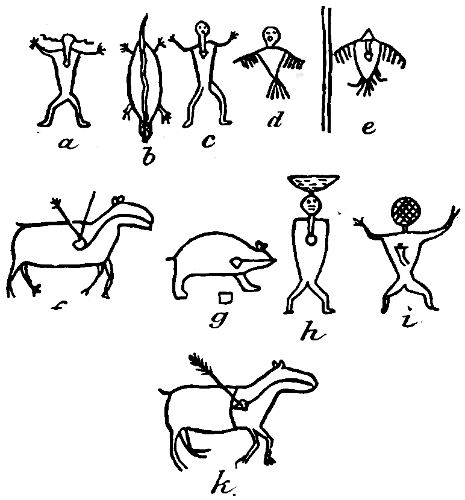
a. Now I hear it, my friends of the Metai, who are sitting about me.
This and the three following are sung by the principal chief of the[247] Metai, to the beat of his bwoin ah-keek, or drum. The line from the sides of the head of the figure indicate hearing.
b. Who makes this river flow? The Spirit, he makes this river flow.
The second figure is intended to represent a river, and a beaver swimming down it.
c. Look at me well, my friends; examine me, and let us understand that we are all companions.
This translation is by no means literal. The words express the boastful claims of a man who sets himself up for the best and most skillful in the fraternity.
d. Who maketh to walk about, the social people? A bird maketh to walk about the social people.
By the bird the medicine man means himself; he says that his voice has called the people together. Weej-huh nish-a-nauba, or weeja-nish-a-nau-ba seems to have the first syllable from the verb which means to accompany. The two lines drawn across, between this figure and the next, indicate that here the dancing is to commence.
e. I fly about and if anywhere I see an animal, I can shoot him.
This figure of a bird (probably an eagle or hawk) seems intended to indicate the wakefulness of the senses and the activity required to insure success in hunting. The figure of the moose which immediately follows, reminding the singer of the cunning and extreme shyness of that animal, the most difficult of all to kill.
f. I shoot your heart; I hit your heart, oh, animal—your heart—I hit your heart.
This apostrophe is mere boasting and is sung with much gesticulation and grimace.
g. I make myself look like fire.
This is a medicine man disguised in the skin of a bear. The small parallelogram under the bear signifies fire, and the shamans, by some composition of gunpowder, or other means, contrive to give the appearance of fire to the mouth and eyes of the bear skin, in which they go about the village late at night, bent on deeds of mischief, oftentimes of blood. We learn how mischievous are these superstitions when we are informed that they are the principal men of the Metai, who thus wander about the villages in the disguise of a bear, to wreak their hatred on a sleeping rival or their malice on an unsuspecting adversary. But the customs of the Indians require of anyone who may see a medicine man on one of these excursions to take his life immediately, and whoever does so is accounted guiltless.
h. I am able to call water from above, from beneath, and from around.
Here the medicine man boasts of his power over the elements, and his ability to do injury or benefit. The segment of a circle with dots in it represents water and the two short lines touching the head of the figure indicate that he can draw it to him.
i. I cause to look like the dead, a man I did.
I cause to look like the dead, a woman I did.
I cause to look like the dead, a child I did.
The lines drawn across the face of this figure indicate poverty, distress, and sickness; the person is supposed to have suffered from the displeasure of the medicine man. Such is the religion of the Indians. Its boast is to put into the hands of the devout supernatural means by which he may wreak vengeance on his enemies whether weak or powerful, whether they be found among the foes of his tribe or the people of his own village. This Metai, so much valued and revered by them, seems to be only the instrument in the hands of the crafty for keeping in subjection the weak and the credulous, which may readily be supposed to be the greater part of the people.
k. I am such, I am such, my friends; any animal, any animal, my friends, I hit him right, my friends.
This boast of certain success in hunting is another method by which he hopes to elevate himself in the estimation of his hearers. Having told them he has the power to put them all to death, he goes on to speak of his infallible success in hunting, which will always enable him to be a valuable friend to such as are careful to secure his good will.
The following chart for the “Song for beaver hunting and the Metai,” is taken from the same author, loc. cit., and reproduced in Fig. 166, with interpretations as follows:
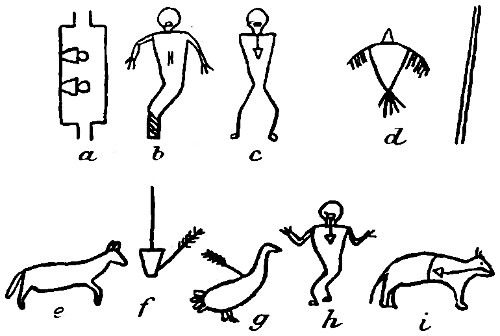
a. I sit down in the lodge of the Metai, the lodge of the Spirit.
This figure is intended to represent the area of the Metai-we-gaun, or medicine lodge, which is called also the lodge of the Man'idō, and two men have taken their seats in it. The matter of the song seems to be merely introductory.
b. Two days must you sit fast, my friend; four days must you sit fast, my friend.
The two perpendicular lines on the breast of this figure are read ne-o-gone (two days), but are understood to mean two years; so of the four lines drawn obliquely across the legs, these are four years. The heart must be given to this business for two years, and the constrained attitude of the legs indicates the rigid attention and serious consideration which the subject requires.
c. Throw off, woman, thy garments, throw off.
The power of their medicines and the incantations of the Metai are not confined in their effect to animals of the chase, to the lives and health of men; they control also the minds of all and overcome the modesty as well as the antipathies of women. The Indians firmly believe that many a woman who has been unsuccessfully solicited by a man is not only by the power of the Metai made to yield, but even in a state of madness to tear off her garments and pursue after the man she before despised. These charms have greater power than those in the times of superstition among the English, ascribed to the fairies, and they need not, like the plant used by Puck, be applied to the person of the unfortunate being who is to be transformed; they operate at a distance through the medium of the Miz-zin-ne-neens.
d. Who makes the people walk about? It is I that calls you.
This is in praise of the virtue of hospitality, that man being most esteemed among them who most frequently calls his neighbors to his feast.
e. Anything I can shoot with it (this medicine) even a dog, I can kill with it.
f. I shoot thy heart, man, thy heart.
He means, perhaps, a buck moose by the word e-nah-ne-wah, or man.
g. I can kill a white loon, I can kill.
The white loon (rara avis nigroque similimo cygno) is certainly a rare and most difficult bird to kill; so we may infer that this boaster can kill anything, which is the amount of the meaning intended in that[250] part of his song recorded by the five last figures. Success in hunting they look upon as a virtue of a higher character, if we may judge from this song, than the patience under suffering or the rakishness among women, or even the hospitality recommended in the former part.
h. My friends——
There seems to be an attempt to delineate a man sitting with his hands raised to address his friends; but the remainder of his speech is not remembered. This is sufficient to show that the meaning of the characters in this kind of picture writing is not well settled and requires a traditional interpretation to render it intelligible.
i. I open my wolf skin and the death struggle must follow.
This is a wolf skin used as a medicine bag and he boasts that whenever he opens it something must die in consequence.
Tanner’s Narrative (b) says of musical notation drawn on bark by Ojibwas:
Many of these songs are noted down by a method probably peculiar to the Indians, on birch bark, or small flat pieces of wood: the ideas being conveyed by emblematic figures, somewhat like those * * * used in communicating ordinary information.
Rev. P. J. De Smet (a) gives an account of the mnemonic order of songs among the Kickapoo and Pottawatomi. He describes a stick 1½ inches broad and 8 or 10 long, upon which are arbitrary characters which they follow with the finger in singing the prayers, etc. There are five classes of these characters. The first represents the heart, the second heart and flesh (chair), the third life, the fourth their names, and the fifth their families.
A. W. Howitt (b) says:
The makers of the Australian songs, or of the combined songs and dances are the poets or bards of the tribe and are held in great esteem. Their names are known to the neighboring peoples, and their songs are carried from tribe to tribe until the very meaning of the words is lost as well as the original source of the song.
Such an instance is a song which was accompanied by a carved stick painted red, which was held by the chief singer. This traveled down the Murray river from some unknown source. The same song, accompanied by such a stick, also came into Gippsland many years ago from Melbourne and may even have been the above mentioned one on its return.
Even since the Columbian discovery some tribes have employed devices yet ruder than the rudest pictorial attempt as markers for the memory. An account of one of these is given in E. Winslow’s Relation (A. D. 1624), Col. Mass. Hist. Soc., 2d series, IX, 1822, p. 99, as follows:
Instead of records and chronicles they take this course: Where any remarkable act is done, in memory of it, either in the place or by some pathway near adjoining, they make a round hole in the ground about a foot deep and as much over, which, when others passing by behold, they inquire the cause and occasion of the same, which, being once known, they are careful to acquaint all men as occasion serveth therewith. And lest such holes should be filled or grown over by any accident, as[251] men pass by they will often renew the same, by which means many things of great antiquity are fresh in memory. So that as a man traveleth, if he can understand his guide, his journey will be the less tedious by reason of the many historical discourses which will be related unto him.
In connection with this section students may usefully consult Dr. Brinton’s (f) Lenâpé and their Legends.
As an example of a chart used in the exact repetition of traditions, Fig. 167 is presented with the following explanation by Rev. J. Owen Dorsey:
The chart accompanies a tradition chanted by members of a secret society of the Osage tribe. It was drawn by an Osage, Red Corn.
The tree at the top represents the tree of life. By this flows a river. The tree and the river are described later in the degrees. When a woman is initiated she is required by the head of her gens to take four sips of water (symbolizing the river), then he rubs cedar on the palms of his hands, with which he rubs her from head to foot. If she belongs to a gens on the left side of a tribal circle, her chief begins on the left side of her head, making three passes, and pronouncing the sacred name three times. Then he repeats the process from her forehead down; then on the right side of her head; then at the back of her head; four times three times, or twelve passes in all.
Beneath the river are the following objects: The Watse ʇuʞa, male slaying animal (?), or morning star, which is a red star. 2. Six stars called the “Elm rod” by the white people in the Indian territory. 3. The evening star. 4. The little star. Beneath these are the moon, seven stars, and sun. Under the seven stars are the peace pipe and war hatchet; the latter is close to the sun, and the former and the moon are on the same side of the chart. Four parallel lines extending across the chart, represent four heavens or upper worlds through which the ancestors of the Tsiↄu people passed before they came to this earth. The lowest heaven rests on an oak tree; the ends of the others appear to be supported by pillars or ladders. The tradition begins below the lowest heaven, on the left side of the chart, under the peace pipe. Each space on the pillar corresponds with a line of the chant; and each stanza (at the opening of the tradition) contains four lines. The first stanza precedes the arrival of the first heaven, pointing to a time when the children of the “former end” of the race were without human bodies as well as human souls. The bird hovering over the arch denotes an advance in the condition of the people; then they had human souls in the bodies of birds. Then followed the progress from the fourth to the first heaven, followed by the descent to earth. The ascent to four heavens and the descent to three, makes up the number seven.
When they alighted, it was on a beautiful day when the earth was covered with luxuriant vegetation. From that time the paths of the Osages separated; some marched on the right, being the war gentes, while those on the left were peace gentes, including the Tsiↄu, whose chart this is.
Then the Tsiↄu met the black bear, called in the tradition Káxe-wáhü-san' (Crow-bone-white), in the distance. He offered to become their messenger, so they sent him to the different stars for aid. According to the chart he went to them in the following order: Morning star, sun, moon, seven stars, evening star, little star.
Then the black bear went to the Waↄiñʞa-ↄüʇse, a female red bird sitting on her nest. This grandmother granted his request. She gave them human bodies, making them out of her own body.
The earth lodge at the end of the chart denotes the village of the Hañʞa uta¢anʇsi, who were a very warlike people. Buffalo skulls were on the tops of the lodges, and the bones of the animals on which they subsisted whitened on the ground. The very air was rendered offensive by the decaying bodies and offal.
The whole of the chart was used mnemonically. Parts of it, such as the four heavens and ladders, were tattooed on the throat and chest of the old men belonging to the order.
The tradition relating to Minabō'zho and the sacred objects received from Kítshi Man'idō is illustrated in Fig. 168, which, represents a copy (one-third original size) of the record preserved at White Earth. This record is read from left to right and is, briefly, as follows:

a represents Minabō'zho, who says of the adjoining characters representing the members of the Midéwin: “They are the ones, they are the ones who put into my heart the life.” Minabō'zho holds in his left hand the sacred medicine bag.
b and c represent the drummers; at the sound of the drum everybody rises and becomes inspired, because the Great Spirit is then present in the lodge.
d denotes that women also have the privilege of becoming members of the Midéwin. This figure holds a snake-skin “medicine bag” in her left hand.
e represents the tortoise, the good spirit, who was the giver of some of the sacred objects used in the rite.
f the bear, also a benevolent spirit, but not held in so great veneration as the tortoise. His tracks are visible in the lodge.
g the sacred medicine bag, Biń-ji-gú-sân, which contains life and can be used by the Midē' to prolong the life of a sick person.
h represents a dog given by the spirits to Minabō'zho as a companion.
Fig. 169 gives copies, one-third actual size, of two records in possession of different Midē' at Red lake. The characters are almost identical, and one record appears to have been copied from the other. The lower figure, however, contains an additional character. The following is an[253] incomplete interpretation of the characters, the letters applying equally to both:
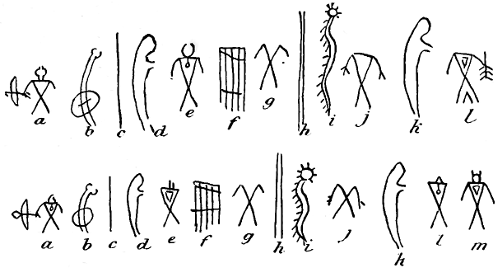
a, Esh'gibŏ'ga, the great uncle of the Unish'-in-ab'-aig, the receiver of the Midéwin.
b, the drum and drumsticks.
c, a bar or rest, observed while chanting the words pertaining to the records.
d, the bin'-ji-gu'-sân, or sacred medicine bag. It consists of an otter skin, and is the mī'gis, or sacred symbol of the midē'wigân' or grand medicine lodge.
e, a Midē' shaman, the one who holds the mī'gis while chanting the Midē' song in the grand medicine lodge, f. He is inspired, as indicated by the line extending from the heart to the mouth.
f, representation of the grand medicine lodge. This character, with slight addition, is usually employed by the southern division of the Ojibwa to denote the lodge of a jĕssakkī'd, and is ordinarily termed a “jugglery.”
g, a woman, and signifies that women may also be admitted to the midē'wigân', shown in the preceding character.
h, a pause or rest in the chant.
i, the sacred snake-skin bag, having the power of giving life through its skin. This power is indicated by the lines radiating from the head and the back of the snake.
j represents a woman.
k, another illustration of the mī'gis, represented by the sacred otter.
l denotes a woman who is inspired, as shown by the line extending from the heart to the mouth in the lower chart, and simply showing the heart in the upper. In the latter she is also empowered to cure with magic plants.
m represents a Midē' shaman, but no explanation was obtained of the special character delineated.

In Fig. 170 is presented a variant of the characters shown in a of Fig. 169. The fact that this denotes the power to cure by the use of plants would appear to indicate an older and more appropriate form than the delineation of the bow and arrow, as well as being more in keeping with the general rendering of the tradition.
Fig. 171, two-thirds real size, is a reproduction, introduced here for comparison and explanation, of a record illustrating the alleged power of a Midē'.

a, the author, is the Midē', who was called upon to take a man’s life at a distant camp. The line extending from the Midē' to i, explained below, signifies that his power extended to at least that distance.
b, an assistant Midē'.
c, d, e, and f represent the four degrees of the Midéwin, of which both shamans are members. The degrees are also indicated by the vertical lines above each lodge character.
g is the drum used in the ceremony.
h is an outline of the victim. A human figure is drawn upon a piece of birchbark, over which the incantations are made, and, to insure the death of the subject, a small spot of red paint is rubbed upon the breast and a sharp instrument thrust into it.
i, the outer line represents a lake, while the inner one is an island, upon which the victim resides.
The ceremony indicated in the above description actually occurred at White Earth during the autumn of 1884, and, by a coincidence, the Indian “conjured” died the following spring of pneumonia resulting from cold contracted during the winter. This was considered as the result of the Midē'’s power, and naturally secured for him many new adherents and believers.
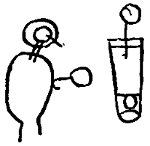
Fig. 172 represents a jĕssakkī'd, named Ne-wik'-ki, curing a sick woman by sucking the demon through a bone tube. It is introduced here for comparison, though equally appropriate to Chap. XIV, sec. 3. The left-hand character represents the Midē' holding a rattle in his hand. Around his head is an additional circle, denoting quantity (literally, more than an ordinary amount of knowledge), the short line projecting to the right therefrom indicating the tube used. The right-hand character is the patient operated upon.
The juggling trick of removing disease by sucking it through tubes is performed by the Midē' after fasting and is accompanied with many ceremonies.
Sikas'sigé, one of the officiating priests of the Midē' society of the Ojibwa at White Earth, Minnesota, gives the following explanation of Fig. 173, which is a reduced copy of a pictorial representation of a tradition explaining the origin of the Indians:
In the beginning, Ki'tshi Man'idō—Dzhe Man'idō, a—made the Midē' Man'idōs. He first created two men, b and c, and two women, d and e, but they had no power of thought or reason. Then Dzhe Man'idō made them reasoning beings. He then took them in his hands so that they should multiply; he paired them, and from this sprung the Indians. Then, when there were people, he placed them upon the earth; but he soon observed that they were subject to sickness, misery, and death, and that unless he provided them with the sacred medicine they would soon become extinct.
Between the position occupied by Dzhe Man'idō and the earth were four lesser spirits, f, g, h, and i, with whom Dzhe Man'idō decided to commune, and to impart the mysteries by which the Indians could be benefited; so he first spoke to a spirit at f, and told him all he had to say, who in turn communicated the same information to g, and he in turn to h, who also communed with i. Then they all met in council and determined to call in the four wind gods at j, k, l, and m. After consulting as to what would be best for the comfort and welfare of the Indians, these spirits agreed to ask Dzhe Man'idō to communicate the mystery of the sacred medicine to the people.
Dzhe Man'idō then went to the Sun Spirit (o) and asked him to go to the earth and instruct the people as had been decided upon by the council. The Sun Spirit, in the form of a little boy, went to the earth and lived with a woman (p) who had a little boy of her own.
This family went away in the autumn to hunt, and during the winter this woman’s son died. The parents were so much distressed that they decided to return to the village and bury the body there; so they made preparations to return, and as they traveled along they would each evening erect several poles upon which the body was placed to prevent the wild beasts from devouring it. When the dead boy was thus hanging upon the poles the adopted child—who was the Sun Spirit—would play about the camp and amuse himself, and finally told his adopted father he pitied him, and his mother, for their sorrow. The adopted son said he could bring his dead brother to life, whereupon the parents expressed great surprise and desired to know how that could be accomplished.
The adopted boy then had the party hasten to the village, when he said, “Get the women to make a wig'iwam of bark (q), put the dead boy in a covering of birch bark and place the body on the ground in the middle of the wig'iwam.” On the next morning, when this had been done, the family and friends went into this lodge and seated themselves around the corpse.
After they had all been sitting quietly for some time they saw, through the doorway, the approach of a bear (r), which gradually came toward the wig'iwam, entered it, and placed itself before the dead body, and said hŭ', hŭ', hŭ', hŭ', when he passed around it toward the left side, with a trembling motion, and as he did so the body began quivering, which increased as the bear continued, until he had passed around four times, when the body came to life and stood up. Then the bear called to the[256] father, who was sitting in the distant right-hand corner of the wig'iwam, and addressed to him the following words:
Nōs | Ka-wi'-na | ni'-shi-nâ'-bi | wis'-si | a-ya'wi-an' | man'-i-do | nin-gi'-sis.
My father | is not | an Indian | not | you are | a spirit | son.
Be-mai'-a-mi'-nik | ni'-dzhi | man'-i-do | mi'-a-zhi'-gwa | tshi-gi'-a-we-an'.
Insomuch | my fellow | spirit | now | as you are.
Nōs | a-zhi'-gwa | a-se'-ma | tshi-a'-to-yek'. | Â'-mi-kun'-dem | mi-e'-ta
My father | now | tobacco | you shall put. | He speaks of | only
a-wi-dink' | dzhi-gŏsh'-kwi-tōt' | wen'-dzhi-bĭ-mâ'-di-zid'-o-ma' | a-ga'-wa
once | to be able to do it | why he shall live here | now
bi-mâ'-di-zid'-mi-o-ma'; | ni'-dzhi | man'-i-do | mi'-a-zhi'-gwa | tshi-gi'-we-an'.
that he scarcely lives; | my fellow | spirit | now I shall go | home.
The little bear boy (r) was the one who did this. He then remained among the Indians (s) and taught them the mysteries of the Grand Medicine (t), and after he had finished he told his adopted father that as his mission had been fulfilled, that he was to return to his kindred spirits, the Indians would have no need to fear sickness, as they now possessed the Grand Medicine which would assist them to live. He also said that his spirit could bring a body to life but once, and he would now return to the sun from which they would feel his influence.
This is called Kwi'-wi-sĕns' wed-di'-shi-tshi' ge'-wi-nĭp'—“Little boy, his work.”
From subsequent information it was learned that the line (w) denotes the earth, and that, being considered as one step in the course of initiation into the Midē'wiwin, three others must be taken before a candidate can be admitted. These steps, or rests, as they are denominated, are typified by four distinct gifts of goods, which must be remitted to the Midē' priests before the ceremony can take place.
The characters s and t are repetitions of the figures alluded to in the tradition (q and r) to signify that the candidate must personate the Makwa' Man'idō—bear spirit—when entering the Midē'wiwin (t); t is the Midē' Man'idō, as Ki'tshi Man'idō is termed by the Midē' priests. The device of horns, attached to the head, is a common symbol of superior power, found in connection with the figures of human and divine forms in many Midē' songs and other mnemonic records; v represents the earth’s surface, similar to that designated as w. w, x, y, and z represent the four degrees of the grand medicine.
Fig. 174 is copy of a birchbark record which was made to commemorate a treaty of peace between the Ojibwa and Assinaboin Indians. The drawing on bark was made by an Ojibwa chief at White Earth, Minnesota.
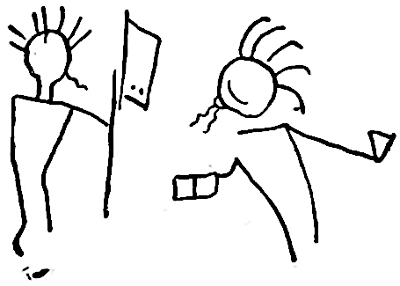
The figure on the left, holding a flag, represents the Ojibwa chief, while that on the right denotes the chief acting on the part of the Assinaboins. The latter holds in his left hand the pipe which was used in the preliminaries, and smoke is seen issuing from the mouth of the Assinaboin. He also holds in his right hand the drum used as an accompaniment to the songs.
The Ojibwa holds a flag used as an emblem of peace.
A considerable number of pictographic records of treaties are presented in different parts of the present work (see under the headings of Wampum, Chap. ix, Sec. 3; Notices, Chap. xi; History, Chap. xvi; Winter Counts, Chap. x, Sec. 2).
Le Page Du Pratz (b) says in describing the council of conspiracy which resulted in the Natchez war of 1729:
An aged councillor advised that after all the nations had been informed of the necessity of taking this violent action, each one should receive a bundle of sticks, all containing an equal number, and which were to mark the number of days to pass before that on which they were all to strike at once; that in order to guard against any mistake it would be necessary to take care to extract one stick every day and to break it and throw it away; a man of wisdom should be charged with this duty. All the old men approved of his advice and it was adopted.
Père Nicholas Perrot (a) says:
Celui qui, chez les Hurons, prenait la parole en cette circonstance, recevait un petit faisceau de pailles d’pied de long qui luy servoient comme de jetons, pour supputer les nombres et pour ayder la mémoire des assistans, les distribuant en divers lots, suyvant la diversité des choses. Dans l’Amérique du Sud, les Galibis de la rivière d’Amacourou et de l’Orénoque usaient du même procédé mnémotechnique, mais perfectionné. Le capitaine [Galibis] et moy, écrit le P. la Pierre (Voyage en terre-ferme et à la coste de Paria, p. 15 du Ms. orig.), eusmes un grand discours ... luy ayant demandé ce qu’il alloit faire à Barime, il me respondit qu’il alloit avertir tous les capitaines des aultres rivières, du jour qu’il en faudroit sortir pour aller donner l’attaque à leurs ennemis. Et, pour me faire comprendre la façon dont il s’y prenoit il me montra vingt petites buches liées ensemble qui se plient à la façon d’un rouleau. Les six premières estoient d’une couleur particulière; elles signifioent que, les six premiers jours, il falloit préparer du magnot [manioc] pour faire vivres. Les quatre suivantes estoient d’une aultre couleur pour marque qu’il falloit avertir les hommes. Les six d’aultre couleur et ainsi du reste, marquant par leur petites buches, faites en façon de paille, l’ordre que chaque capitaine doit faire observer à ses gens pour estre prest tous en mesme temps. La sortie devroit se faire dans vingt jours; car il n’y avoit que cest [vingt] petites buches.
Im Thurn (e) tells of the Indians of Guiana as follows:
When a paiwari feast is to be held, invitations are sent to the people of all neighboring settlements inhabited by Indians of the same tribe as the givers of the feast.[258] The latter prepare a number of strings, each of which is knotted as many times as there are days before the feast day. One of these strings is kept by the headman of the settlement where the feast is to be held; the others are distributed, one to the headman of each of the settlements from which guests are expected. Every day one of the knots, on each of the strings, is untied, and when the last has been untied guests and hosts know that the feast day has come.
Sometimes, instead of knots on a string, notches on a piece of wood are used. This system of knot-tying, the quippoo system of the Peruvians, which occurs in nearly identical form in all parts of the world, is not only used as in the above instance for calendar-keeping, but also to record items of any sort; for instance, if one Indian owes another a certain number of balls of cotton or other articles, debtor and creditor each has a corresponding string or stick, with knots or notches to the number of the owed article, and one or more of these is oblitered each time a payment is made until the debt is wiped out.
Darius (Herodot. IV, 98) did something of the kind when he took a thong and, tying sixty knots in it, gave it to the Ionian chiefs, that they might untie a knot every day and go back to their own land if he had not returned when all the knots were undone.
Champlain (a) describes a mode of preparation for battle among the Canadian Algonquins which partook of the nature of a military drill as well as of an appointment of rank and order. It is in its essentials mnemonic. He describes it as follows:
Les chefs prennent des bâtons de la longueur d’un pied autant en nombre qu’ils sont et signalent par d’autres un peu plus grands, leurs chefs; puis vont dans le bois et esplanadent une place de cinq ou six pieds en quarré où le chef comme Sergent Major, met par ordre tous ces bâtons comme bon luy semble; puis appelle tous ses compagnons, qui viennent tous armez, et leur monstre le rang et ordre qu’ils deuvont tenir lors qu’ils se battront avec leurs ennemis.
The author adds detail with regard to alignment, breaking ranks, and resumption of array.
D. W. Eakins, in Schoolcraft I, p. 273, describes the mnemonic numeration marks of the Muskoki thus:
Each perpendicular stroke stood for one, and each additional stroke marked an additional number. The ages of deceased persons or number of scalps taken by them, or war-parties which they have headed, are recorded on their grave-posts by this system of strokes. The sign of the cross represents ten. The dot and comma never stood as a sign for a day, or a moon, or a month, or a year. The chronological marks that were and are in present use are a small number of sticks made generally of cane. Another plan sometimes in use was to make small holes in a board, in which a peg was inserted to keep the days of the week.
Capt. Bourke (b) gives the following account of an attempt at compromise between the aboriginal method of numbering days, weeks, and months, and that of the civilized intruders to whose system the Indians found it necessary to conform.
The Apache scouts kept records of the time of their absence on campaign. There were several methods in vogue, the best being that of colored beads which were[259] strung on a string, six white ones to represent the days of the week, and one black, or other color, to stand for Sundays. This method gave rise to some confusion, because the Indians had been told that there were four weeks, or Sundays (“Domingos”), in each “Luna,” or moon, and yet they soon found that their own method of determining time by the appearance of the crescent moon was much the more satisfactory. Among the Zuñi I have seen little tally sticks with the marks for the days and months incised on the narrow edges, and among the Apache another method of indicating the flight of time by marking on a piece of paper along a horizontal line a number of circles or of straight lines across the horizontal datum line to represent the full days which had passed, a heavy straight line for each Sunday, and a small crescent for the beginning of each month.
It is not necessary to discuss the obvious method of repeating strokes, dots, knots, human heads or forms, weapons, and totemic designs, to designate the number of persons or articles referred to in the pictographs where they appear.
The Abnaki, in especial the Passamaquoddy division of the tribe in Maine, during late years have been engaged in civilized industries in which they have found it necessary to keep accounts. These are interesting as exhibiting the aboriginal use of ideographic devices which are only partially supplemented by the imitation of the symbols peculiar to European civilization. Several of these devices were procured by the present writer in 1888, and are illustrated and explained as follows:
A deer hunter brings 3 deerskins, for which he is allowed $2 each, making $6; 30 pounds of venison, at 10 cents per pound, making $3. In payment thereof he purchases 3 pounds of powder, at 40 cents per pound; 5 pounds of pork, at 10 cents per pound; and 2 gallons of molasses, at 50 cents per gallon. The debit foots $3.30, according to the[260] Indian account, but it seems on calculation to be 30 cents in excess, an overcharge, showing the advance in civilization of the Passamaquoddy trader.
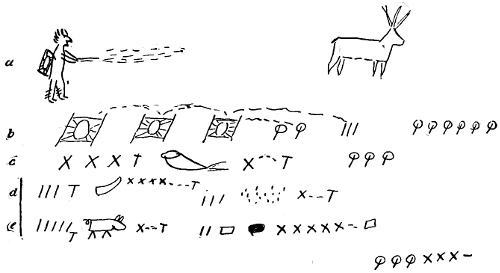
The following explanation will serve to make intelligible the characters employed, which are reproduced in Fig. 175. The hunter is shown as the first character in line a, and that he is a deer-hunter is furthermore indicated by his having a skin-stretcher upon his back, as well as the figure of a deer at which he is shooting. The three skins referred to are shown stretched upon frames in line b, the total number being also indicated by the three vertical strokes, between which and the drying frames are two circles, each with a line across it, to denote dollars, the total sum of $6 being the last group of dollar marks on line b.
The 30 pounds of venison are represented in line c, the three crosses signifying 30, the T-shaped character designating a balance scale, synonymous with pound, while the venison is indicated by the drawing of the hind quarter or ham. The price is given by uniting the X, or numeral, and the T, or pound mark, making a total of $3 as completing the line c.
The line d refers to the purchase of 3 pounds of powder, as expressed by the three strokes, the T, or scale for pound, and the powder horn, the price of which is four Xs or 40 cents per pound, or T; and 3 pounds of powder, the next three vertical strokes succeeded by a number of spots to indicate grains of powder, which is noted as being 10 cents per pound, indicated by the cross and T, respectively. The next item, shown on line e, charges for 5 pounds of pork, the latter being indicated by the outline of a pig, the price being indicated by the X or 10, and T, scale or pound; then two short lines preceding one small oblong square or quart measure, indicates that 2 quarts of molasses, shown by the black spot, cost 5 crosses, or 50 cents per measure, the sum of the whole of the purchase being indicated by three rings with stems and three crosses, equivalent to $3.30.
Another Indian, whose occupation was to furnish basket wood, brought some to the trader for which he received credit to the amount of $1.15, taking in exchange therefor pork sufficient to equal the above amount.
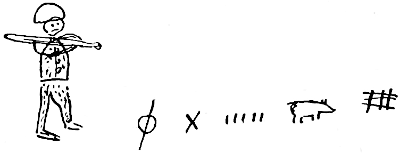
In Fig. 176 the Indian is shown with a bundle of basket wood, the value of which is given in the next characters, consisting of a ring with[261] a line across to denote $1, a cross to represent 10 cents, and the five short vertical lines for an additional 5 cents, making a total of $1.15. The pork received from the trader is indicated by the outline of a pig, while the crossed lines to the right denotes that the “account” is canceled.
Another customer, as shown in Fig. 177, was an old woman, the descendent of an ancient name—one known before the coming of white people. She was therefore called the “Owl,” and is represented in the “account” given below. She had bought on credit 1 plug of smoking tobacco, designated by one vertical stroke for the quantity and an oblong square figure corresponding to the shape of the package, which was to be used for smoking, as indicated by the spiral lines to denote smoke. She had also purchased 2 quarts of kerosene oil, the quantity designated by the two strokes preceding the small squares to represent quart measures, and the liquid is indicated by the rude outline of a kerosene lamp. This is followed by two crosses, representing 20 cents, as the value of the amount of her purchases. This account was settled by giving one basket, as shown in the device nearly beneath the owl, half of which is marked with crossed lines, connected by a line of dots or dashes with the cancellation mark at the extreme right of the record.

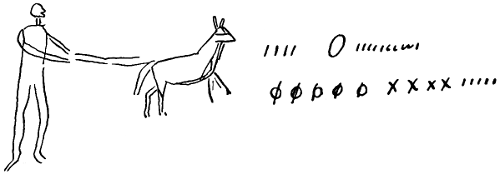
Another Passamaquoddy Indian, unable to read or write, carries on business and keeps his books according to a method of his own invention. One account is reproduced in Fig. 178. It is with a very slim Indian, as will be observed from the drawing, who carries on “trucking” and owns a horse, that animal being represented in outline and connected by lines with its owner. For services he was paid $5.45, which sum is shown in the lower line of characters by five dollar-marks—i. e., rings with strokes across them—4 crosses or numerals signifying 10 cents each, and five short vertical lines for 5 cents. The date is shown in the upper line of characters, the 4 short lines in front of the horse signifying 4, the oval figure next, to the right and intended for a circle, denoting the moon—i. e., the fourth moon, or April—while the 10 short strokes signify the tenth day of the month—i. e., he was paid $5.45 in full for services to April 10.
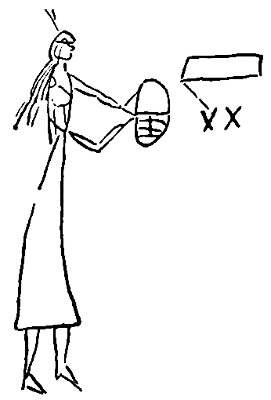
Another account was with a young woman noted as very slim, and is shown in Fig. 179. The girl brought a basket to the store, for which[262] she was allowed 20 cents. She received credit for 10 cents on account of a plug of tobacco bought some time previously.
In the illustration the decidedly slim form of the girl is portrayed, her hands holding out the basket which she had made. The unattached cross signifies 10 cents, which she probably received in cash, while the other cross is connected by a dotted line with the piece of plug tobacco for which she had owed 10 cents. The attachment of the plug to the unpaid dime is amusingly ideographic.
Another Indian, descended from the prehistoric Indians, was called “Lox,” the evil or tricksy deity, appearing as an animal having a long body and tail and short legs, which is probably a wolverine, under which form Lox is generally depicted by the Passamaquoddy. His account with the trader is given in Fig. 180, and shows that he brought 1 dozen ax handles, for which he received $1.50.
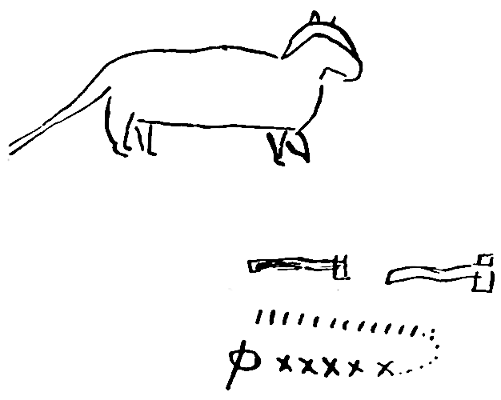
Beneath the figure of Lox are 2 axes, the 12 short lines denoting the number of handles delivered, while the dotted line to the right connects them with the amount received, which is designated by 1 one dollar mark and 5 crosses or dime marks.
Dr. Hoffman found in Los Angeles, California, a number of notched sticks, which had been invented and used by the Indians at the Mission of San Gabriel. They had chief herders, who had under their charge overseers of the several classes of laborers, herders, etc. The chief herder was supplied with a stick of hard wood, measuring about 1 inch in breadth and thickness and from 20 to 24 inches long. The corners were beveled at the handle. The general form of the stick is given in the upper character of Fig. 181, with the exception that the illustration is intentionally shortened so as to show both ends.
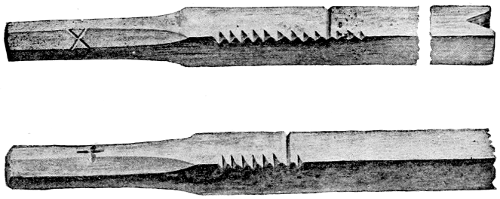
Upon each of the beveled surfaces on the handle are marks to indicate the kind of horned cattle referred to. The cross indicates that the corner of the stick upon which it is incised relates to heifers, each notch designating one head, the long transverse cut denoting ten, with an additional three cuts signifying that the herder has in charge thirteen heifers. Upon the next beveled edge appears an arrow-pointed mark, to denote in like manner which edge of the stick is to be notched for indicating the oxen. Upon the third beveled surface is one transverse cut for the record of the number of bulls in the herd, while upon the fourth bevel of the handle are two notches to note the number of cows.
The stick is notched at the end opposite the handle to signify that it refers only to horned cattle. That used to designate horses is sharpened from two sides only, so that the end is wedge-shaped, or exactly the reverse of the one first mentioned. The marks upon the handle would be the same, however, with this exception—that one cut would mean a stallion, two cuts a mare, the cross a gelding, and the arrow-shaped figure a colt. Sticks were also marked to denote the several kinds of stock and to record those which had been branded.
Another class of sticks were also used by the overseers, copies of which were likewise preserved by the laborers and herders, to keep an account of the number of days on which labor was performed, and to record the sums of money received by the workman.
The lower character of Fig. 181 represents a stick, upon the beveled edge of the handle of which is a cross to denote work. The short notches upon the corner of the stick denote days, each seventh day or week being designated by a cut extending across the stick.
Upon the opposite side of the handle is a circle or a circle with a cross within it to denote the number of reals paid, each real being indicated upon the edge of the stick by a notch, while each ten reals or peso is noted by making the cut all the way across that face of the stick.
Mr. Dall (a) says that the Innuit frequently keep accounts by tying knots in a string or notching a stick. Capt. Bourke (c) reports:
In the Mexican state of Sonora I was shown, some twenty years ago, a piece of buckskin, upon which certain Opata or Yaqui Indians—I forget exactly which tribe, but it matters very little, as they are both industrious and honest—had kept account of the days of their labor. There was a horizontal datum line as before, with complete circles to indicate full days and half circles to indicate half days, a long heavy black line for Sundays and holidays, and a crescent moon for each new month. These accounts had to be drawn up by the overseer or superintendent of the rancho at which the Indians were employed before the latter left for home each night.
Terrien de Lacouperie (e) says of the Sonthals of Bengal:
Their accounts are either notches on a stick, like those formerly used by the rustics for keeping scores at cricket matches in country villages in England, or knots on a piece of grass string, or a number of bits of straw tied together. I well remember my astonishment while trying my first case between a grasping Mahajun and a Sonthal when I ordered them to produce their accounts. * * * The Sonthal produced from his back hair, where it had been kept, I suppose, for ornament, a dirty bit of knotted grass string and threw it on the table, requesting the court to count that, as it had got too long for him. Each knot represented a rupee, a longer space between two knots represented the lapse of a year.
Many modes of accounting in a pictorial manner are noted in Europe and America among people classed as civilized. Some of these are very curious, but want of space prevents their recital here. A valuable description of the survival of the system in Brittany is given by M. Armand Landrin (a), translated and condensed as follows:
In the department of Finisterre the farmers, in keeping accounts, made bags of their old socks and coat sleeves, of different colors, each color representing one of the divisions of farm outlay or receipt, as cows, butter, milk, and corn. Each amount received was placed in coin in the appropriate bag. When any coins were taken out the same number of small stones or of peas or beans was put in to replace the coins. Other farmers substituted for the bags small sticks of different length and thickness in which they made cuts representing the receipts.
In the accounts with the laborers and farm hands the women were designated by the triangle, intended to represent the Breton head dress á grandes barbes. The kind of work performed was expressed by the tool connected with it, e. g., a horseshoe denoted the blacksmith, a scythe the mower, an ax the carpenter, a saddle the harness-maker, and a tub the cooper. The bill of a veterinary surgeon was rendered by drawing the figures of the several animals treated united in one group by a line.
Until quite recently the important accounts of the British exchequer were kept by wooden tallies, and some bakers in the United States yet persevere in keeping their accounts with their customers by duplicate tallies, one of which is rendered as a bill and is verified by the other.
It is not within the scope of the present work to examine the several systems of chronology of the American Indians, but only those pictorially exhibited. The Mexican system, much more scientific and more elaborate than that employed by the northern tribes, resembled it in the graphic record or detail of exhibit, and is highly interesting as compared with the Dakota Winter Counts. Although the principle of designating the years was wholly different, the mode of that designation was often similar, as is shown by collating the Codex Vaticanus and the Codex Telleriano Remensis with the Winter Counts of Lone Dog and Battiste Good, infra. It is also desirable to note the remarks of Prof. Brinton (e) with regard to the Chilan Balam. At the close of each of the Maya larger divisions of time (the so-called “Katum”), a “chilan” or inspired diviner uttered a prediction of the character of the year or epoch which was about to begin. This prophetic designation of the year was like a Zadkiel’s almanac, while the Dakotan method was a selection of the most important events of the past.
Dr. William H. Corbusier, surgeon, U. S. Army, gives the following information:
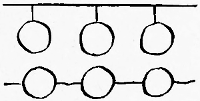
The Dakotas make use of the circle as the symbol of a cycle of time; a small one for a year and a large one for a longer period of time, as a life time, one old man. Also a round of lodges or a cycle of seventy years, as in Battiste Good’s Winter Count. The continuance of time is sometimes indicated by a line extending in a direction from right to left across the page when on paper, and the annual circles are suspended from the line at regular intervals by short lines, as in Fig. 182, upper character, and the ideograph for the year is placed beneath each one. At other times the line is not continuous, but is interrupted at regular intervals by the yearly circle, as in the lower character of Fig. 182.
Under other headings in this paper are presented graphic expressions for divisions of time—month, day, night, morning, noon, and evening. See, for some of them, Chap. XX, Sec. 2.
In the preliminary paper on “Pictographs of the North American Indians,” published in the Fourth Annual Report of the Bureau of Ethnology, 58 pages of text and 46 full-page plates were devoted to the winter counts of the Dakota Indians. The minute detail of explanation, the systematic comparison, and the synoptic presentation which seemed to be necessary need not now be repeated to establish the genuine character of the invention. This consisted in the use of events, which were in some degree historical, to form a system of chronology. The record of the events was only the device by which was accomplished the continuous designation of years, in the form of charts corresponding in part with the orderly arrangement of divisions of time termed calendars. It was first made public by the present writer in a paper entitled “A Calendar of the Dakota Nation,” which was issued in April, 1877, in Bulletin III, No. I, of the United States Geological and Geographical Survey. The title is now changed to that adopted by the Dakotas themselves, viz, Winter Counts—in the original, wan'iyetu wo'wapi.
The lithographed chart published with that paper, substantially the same as Pl. XX, Lone-Dog’s Winter Count, now much better presented than ever before, is the winter count used by, or at least known to, a large portion of the Dakota people, extending over the seventy-one years commencing with the winter of A. D. 1800-’01.
The copy from which the lithograph was taken is traced on a strip of cotton cloth, in size 1 yard square, which the characters almost entirely fill, and is painted in two colors, black and red, used in the original, of which it is a facsimile. The plate is a representation of the chart as it would appear on the buffalo robe. It was photographed from the copy on linen cloth, and not directly from the buffalo robe. It was painted on the robe by Lone-Dog, an Indian belonging to the Yanktonais tribe of the Dakotas, who in the autumn of 1876 was near Fort Peck, Montana. His Dakota name is given in the ordinary English literation as Shunka-ishnala, which words correspond nearly with the vocables in Riggs’s lexicon for dog-lone. Lone-Dog claimed that, with the counsel of the old men of his tribe, he decided upon some event or circumstance which should distinguish each year as it passed, and marked what was considered to be its appropriate symbol or device upon a buffalo robe kept for the purpose. The robe was at convenient times exhibited to other Indians of the tribe, who were thus taught the meaning and use of the signs as designating the several years.
It is not, however, supposed that Lone-Dog was of sufficient age in the year 1800 to enter upon the work. Either there was a predecessor from whom he received the earlier records or, when he had reached manhood,[267] he gathered the traditions from his elders and worked back, the object either then or before being to establish some system of chronology for the use of the tribe or more probably in the first instance for the use of his own band.
Present knowledge of the winter-count systems shows that Lone-Dog was not their originator. They were started, at the latest, before the present generation, and have been kept up by a number of independent recorders. The idea was one specially appropriate to the Indian genius, yet the peculiar mode of record was an invention, and it is not probably a very old invention, as it has not been used beyond a definite district and people. If an invention of that character had been of great antiquity it would probably have spread by intertribal channels beyond the bands or tribes of the Dakota, where alone the copies of such charts have been found and are understood.
The fact that Lone-Dog’s Winter Count, the only one known at the time of its first publication, begins at a date nearly coinciding with the first year of the present century, as it is called in the arbitrary computation that prevails among most of the civilized peoples, awakened a suspicion that it might be due to civilized intercourse and was not a mere coincidence. If the influence of missionaries or traders started any plan of chronology, it is remarkable that they did not suggest one in some manner resembling the system so long and widely used, and the only one they knew, of counting the numbers from an era, such as the birth of Christ, the Hegira, the Ab Urbe Conditâ, or the first Olympiad. But the chart shows nothing of this nature. The earliest character merely represents the killing of a small number of Dakotas by their enemies, an event neither so important nor interesting as many others of the seventy-one shown in the chart, more than one of which, indeed, might well have been selected as a notable fixed point before and after which simple arithmetical notation could have been used to mark the years. Instead of any plan that civilized advisers would naturally have introduced, the one actually adopted was to individualize each year by a specific recorded symbol. The ideographic record, being preserved and understood by many, could be used and referred to with ease and accuracy. Definite signs for the first appearance of the smallpox and for the first capture of wild horses were dates as satisfactory to the Dakota as the corresponding expressions A. D. 1802 and 1813 are to the Christian world, and far more certain than the chronology expressed in terms of A. M. and B. C. The arrangement of separate characters in an outward spiral starting from a central point is a clever expedient to dispense with the use of numbers for noting the years, yet allowing every date to be determined by counting backward or forward from any other known. The whole conception seems one strongly characteristic of the Indians, who in other instances have shown such expertness in ideography. The discovery of several other charts, which differ in their times of commencement and ending from[268] that of Lone-Dog and from each other, removed any inference arising from the above-mentioned coincidence in beginning with the present century. The following copies of charts, substantially the same as that of Lone-Dog, are now or have been in the possession of the present writer:
1. A chart made and kept by Bo-i'-de, The-Flame, a Dakota, who, in 1877, lived near Fort Sully, Dakota.
The facsimile copy is on a cotton cloth about a yard square and in black and red, thus far similar to the copy of Lone-Dog’s chart, but the arrangement is different. The character for the first year mentioned appears in the lower left-hand corner, and the record proceeds toward the right to the extremity of the cloth, then crossing toward the left and again toward the right at the edge of the cloth, and so throughout, in the style called boustrophedon. It thus answers the same purpose of orderly arrangement, allowing constant additions, like the more circular spiral of Lone-Dog. This record is for the years 1786-’87 to 1876-’77, thus commencing earlier and ending later than that of Lone-Dog.
2. A Minneconjou chief, The-Swan, kept another record on the dressed skin of an antelope or deer, claiming that it had been preserved in his family for seventy years.
The characters are arranged in a spiral similar to those in Lone-Dog’s chart, but more oblong in form. The course of the spiral is from left to right, not from right to left.
3. Another chart was kindly loaned to the writer by Bvt. Maj. Joseph Bush, captain Twenty-second U. S. Infantry. It was procured by him, in 1870 at the Cheyenne Agency. This copy is one yard by three-fourths of a yard, spiral, beginning in the center, from right to left. The figures are substantially the same as those in Lone-Dog’s chart, with which it coincides in time, except that it ends at 1869-’70, but the interpretation differs from that accompanying the latter in a few particulars.
4. The chart of Mato Sapa, Black-Bear. He was a Minneconjou warrior, residing in 1868 and 1869 on the Cheyenne Agency reservation, on the Missouri river, near the mouth of the Cheyenne river.
This copy is on a smaller scale than that of Lone-Dog, being a flat and elongated spiral, 2 feet 6 inches by 1 foot 6 inches. The spiral reads from right to left. This chart, which begins like that of Lone-Dog, ends with the years 1868-’69.
5. A most important and interesting Winter Count is that made by Battiste Good, a Brulé Dakota, which was kindly contributed by Dr. William H. Corbusier, surgeon U. S. Army. It begins with peculiar cyclic devices from the year A. D. 900, and in thirteen figures embraces the time to A. D. 1700, all these devices being connected with myths, and some of them showing European influence. From 1700-’01 to 1879-’80 a separate character is given for each year, with its interpretation,[269] in much the same style as shown in the other charts mentioned. Several Indians and half-breeds said that this count formerly embraced about the same number of years as the others, but that Battiste Good gathered the names of many years from the old people and placed them in chronological order as far back as he was able to learn them.
Another Winter Count, communicated by Dr. Corbusier, is that in the possession of American-Horse, an Oglala Dakota, at the Pine Ridge agency in 1879, who asserted that his grandfather began it, and that it is the production of his grandfather, his father, and himself.
A third Winter Count is communicated by Dr. Corbusier as kept by Cloud-Shield. He was also an Oglala Dakota, at the Pine Ridge agency, but of a different band from American-Horse. The last two counts embrace nearly the same number of years, viz, from A. D. 1775 to 1878. Two dates belong to each figure, as a Dakota year covers a portion of two of the calendar years common to civilization.
Dr. Corbusier also saw copies of a fourth Winter Count, which was kept by White-Cow-Killer, at the Pine Ridge agency. He did not obtain a copy of it, but learned most of the names given to the winters.
With reference to all the Winter Counts and to the above remarks that a Dakota year covers a portion of two calendar years, the following explanation may be necessary: The Dakota count their years by winters (which is quite natural, that season in their high levels and latitudes practically lasting more than six months), and say a man is so many snows old, or that so many snow seasons have passed since an occurrence. They have no division of time into weeks, and their months are absolutely lunar, only twelve, however, being designated, which receive their names upon the recurrence of some prominent physical phenomenon. For example, the period partly embraced by February is called the “raccoon moon;” March, the “sore-eye moon;” and April, that “in which the geese lay eggs.” As the appearance of raccoons after hibernation, the causes inducing inflamed eyes, and oviposition by geese vary with the meteorological character of each year, and as the twelve lunations reckoned do not bring back the point in the season when counting commenced, there is often dispute in the Dakota tipis toward the end of winter as to the correct current date. In careful examination of the several counts it often is left in doubt whether the event occurred in the winter months or was selected in the months immediately before or in those immediately after the winter. No regularity or accuracy is noticed in these particulars.
In considering the extent to which Lone-Dog’s chart is understood and used, it may be mentioned that every intelligent Dakota of full years to whom the writer has shown it has known what it meant, and many of them knew a large part of the years portrayed. When there was less knowledge, there was the amount that may be likened to that of an uneducated person or a child who is examined about a map of the United States, which had been shown to him before, with some explanation[270] only partially apprehended or remembered. He would tell that it was a map of the United States; would probably be able to point out with some accuracy the state or city where he lived; perhaps the capital of the country; probably the names of the states of peculiar position or shape, such as Maine, Delaware, or Florida. So the Indian examined would often point out in Lone-Dog’s chart the year in which he was born, or that in which his father died, or in which there was some occurrence that had strongly impressed him, but which had no relation whatever to the significance of the character for the year in question. It had been pointed out to him before, and he had remembered it, while forgetting the remainder of the chart.
On comparing all the Winter Counts it is found that they often correspond, but sometimes differ. In a few instances the differences are in the succession of events, but they are usually due to an omission or to the selection of another event. When a year has the same name in all of them, the bands were probably encamped together, or else the event fixed upon was of general interest; and when the name is different the bands were scattered, or nothing of general interest occurred. Many of the recent events are fresh in the memory of the people, as the warriors who strive to make their exploits a part of the tribal traditions proclaim them on all occasions of ceremony, count their coups, as the performance is called. Declarations of this kind partake of the nature of affirmations made in the invoked presence of a supposed divinity. War shirts, on which scores of the enemies killed are kept, and which are carefully transmitted from generation to generation, help to refresh their memories in regard to some of the events.
The study of all the charts renders plain some points remaining in doubt while the Lone-Dog chart was the only example known. It became clear that there was no fixed or uniform mode of exhibiting the order of continuity of the year-characters. They were arranged spirally or lineally, or in serpentine curves, by boustrophedon or direct, starting backward from the last year shown or proceeding uniformly forward from the first year selected or remembered. Any mode that would accomplish the object of continuity with the means of regular addition seemed equally acceptable. So a theory advanced that there was some symbolism in the right-to-left circling of Lone-Dog’s chart was abandoned, especially when an obvious reproduction of that very chart was made by an Indian with the spiral reversed. It was also obvious that when copies were made, some of them probably from memory, there was no attempt at Chinese accuracy. It was enough to give the graphic or ideographic character, and frequently the character is better defined on one of the charts than on the others for the corresponding year. One interpretation would often throw light on the others. It also appeared that, while different events were selected by the recorders of the different systems, there was sometimes a selection of the same event for the same year and sometimes for the next, such[271] as would be natural in the progress of a famine or epidemic, or as an event gradually became known over a vast territory.
A test of the mode of selecting events for designating the Winter Counts may be found in a suggestion made by the present writer in his account of Lone-Dog’s chart, published in 1877, as follows:
The year 1876 has furnished good store of events for the recorder’s choice, and it will be interesting to learn whether he has selected as the distinguishing event the victory over Custer, or, as of still greater interest, the general seizure of ponies, whereat the tribes, imitating Rachel, weep and will not be comforted, because they are not.
It now appears that two of the Counts made for 1876 and observed by the writer several years later have selected the event of the seizure of the ponies, and that none of them make any allusion to the defeat of Custer.
After examination of all the charts it is obvious that the design is not narrative, that the noting of events is being subordinated to the marking of the years by them, and that the pictographic serial arrangements of sometimes trivial though generally notorious incidents having been selected with special adaptation for use as a calendar. That in a few instances small personal events, such as the birth of the recorder or the death of members of his family, are set forth, may be regarded as interpolations in or unauthorized additions to the charts. If they had exhibited a complete national or tribal history for the years embraced in them, their discovery would have been in some respects more valuable, but they are interesting to anthropologists because they show an attempt before unsuspected among the northern tribes of American Indians to form a system of chronology.
While, as before mentioned, it is not now necessary to recapitulate the large amount of matter before published concerning the Winter Counts of the Dakota, it has been decided to present in an abbreviated form the characters and interpretations of the Lone-Dog chart as being the system which was first discovered, and the publication of which occasioned the discovery of all the other charts mentioned. The Winter Count of Battiste Good has not hitherto been published, and it possesses special importance and interest apart from its chronology, for which reason it is inserted in the present paper, see infra.
The several charts of The-Flame, The-Swan, American-Horse, and Cloud-Shield, published in the Fourth Annual Report of the Bureau of Ethnology, are omitted, but selections from all of them are presented under the headings of Ideography, Tribal and Personal Designations, Religion, Customs, History, Biography, Conventionalizing, Comparison, and in short are interspersed through the present paper where they appropriately belong.
The reader of the Lone-Dog and Battiste Good charts may find it convenient to note the following brief account of the tribal names frequently mentioned:
The great linguistic stock or family which embraces not only the Sioux or Dakota proper, but the Missouri, Omaha, Ponka, Osage, Kansa, Oto, Assinaboin, Gros Ventre or Minnitari, Crow, Iowa, Mandan, and some others, has been frequently styled the Dakota family. Maj. J. W. Powell, the Director of the Bureau of Ethnology, from consideration of priority, has lately adopted the name Siouan for the family, and for the grand division of it popularly called Sioux has used the term Dakota, which the people claim for themselves.
The word “Dakota” is translated in Riggs’s dictionary of that language as “leagued” or “allied.” The title Sioux, which is indignantly repudiated by the people, is either the last syllable or the last two syllables, according to pronunciation, of “Nadowesioux,” which is the French plural of the Algonkin name for the Dakotas “Nadowessi,” “hated foe.” The Ojibwa called the Dakota “Nadowessi,” which is their word meaning rattlesnake, or, as others translate, adder, with a contemptuous or diminutive termination; the plural is Nadowessiwak or Nadawessyak. The French gave the name their own form of the plural and the voyagers and trappers cut it down to “Sioux.”
The more important of the tribes and organized bands into which the Dakotas are now divided, being the dislocated remains of the “Seven Great Council Fires,” are as follows:
Yankton and Yanktonai or Ihanktonwạn, both derived from a root meaning “at the end,” alluding to the former locality of their villages.
Sihasapa, or Blackfeet.
Ohenonpa, or Two-Kettles.
Itaziptco, Without Bow. The French equivalent Sans Arc is more commonly used.
Minneconjou, translated “Those who plant by the water,” the physical features of their old home.
Sitcangu, Burnt Hip or Brulé.
Santee, subdivided into Wahpeton, Men among Leaves, i. e., among forests, and Sisseton, Men of Prairie Marsh. Two other bands, now practically extinct, formerly belonged to the Santee, or as it is more correctly spelled, Isanti tribes, from the root “Issan,” knife. Their former territory furnished the material for stone knives, from the manufacture of which they were called the “knife people.”
Uncpapa, once the most warlike and probably the most powerful of all the bands, though not the largest.
Oglala. The meaning and derivation of this name and of Uncpapa have been the subjects of controversy.
Hale, Gallatin, and Riggs designate a “Titon tribe” as located west of the Missouri, and as much the largest division of the Dakotas, the latter authority subdividing into the Sichangu, Itazipcho, Sihasapa, Minneconjou, Ohenonpa, Oglala, and Huncpapa, seven of the tribes specified above, which he calls bands. “Titon,” (from the word tintan, meaning “at or on land without trees or prairie,”) was the name of a[273] tribal division, but it has become only an expression for all those tribes whose ranges are on the prairie, and thus it is a territorial and accidental, not a tribular distinction. One of the Dakotas at Fort Rice spoke to the present writer of the “hostiles” as “Titons,” with obviously the same idea of locality, “away on the prairie,” it being well known that they were a conglomeration from several tribes.

Fig. 183, 1800-’01.—Thirty Dakotas were killed by Crow Indians. The device consists of thirty parallel black lines in three columns, the outer lines being united. In this chart, such black lines always signify the death of Dakotas killed by their enemies.
The Absaroka or Crow tribe, although belonging to the Siouan family, has nearly always been at war with the Dakotas proper since the whites have had any knowledge of either. They are noted for the extraordinary length of their hair, which frequently distinguishes them in pictographs.

Fig. 184, 1801-’02.—Many died of smallpox. The smallpox broke out in the tribe. The device is the head and body of a man covered with red blotches. In this, as in all other cases where colors in this chart are mentioned, they will be found to correspond with Pl. XX, but not in that respect with the text figures, which have no coloration.

Fig. 185, 1802-’03.—A Dakota stole horses with shoes on, i. e., stole them either directly from the whites or from some other Indians who had before obtained them from whites, as the Indians never shoe their horses. The device is a horseshoe.
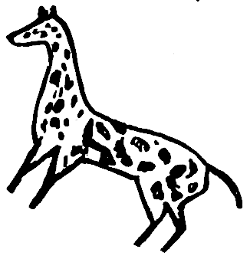
Fig. 186, 1803-’04.—They stole some “curly horses” from the Crows. Some of these horses are still on the plains, the hair growing in closely curling tufts. The device is a horse with black marks for the tufts. The Crows are known to have been early in the possession of horses.
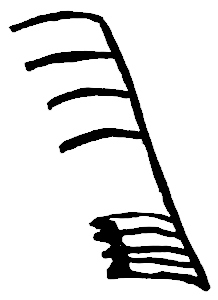
Fig. 187, 1804-’05.—The Dakota had a calumet dance and then went to war. The device is a long pipestem, ornamented with feathers and streamers. The feathers are white, with black tips, evidently the tail feathers of the adult golden eagle (Aquila chrysaëtos), highly prized by the Plains Indians. The streamers anciently were colored strips of skin or flexible bark; now gayly colored strips of cloth are used. The word calumet is a corruption of the French chalumeau. Capt. Carver (c) in his Three Years Travels Through the Interior Parts of North America, after puzzling over the etymology of “calumet,” describes the pipe as “about 4 feet long, bowl of red marble, stem of[274] a light wood curiously painted with hieroglyphics in various colors and adorned with feathers. Every nation has a different method of decorating these pipes and can tell at once to what band it belongs. It is used as an introduction to all treaties, also as a flag of truce is among Europeans.” Among the Indian tribes generally the pipe, when presented or offered to a stranger or enemy, was the symbol of peace, yet when used ceremonially by members of the same tribe among themselves was virtually a token of impending war. For further remarks on this point see the year 1842-’43 of this Winter Count.
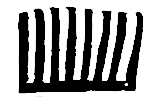
Fig. 188, 1805-’06.—The Crows killed eight Dakotas. Again the short parallel black lines, this time eight in number, united by a long stroke. The interpreter, Fielder, says that this character with black strokes is only used for grave marks.
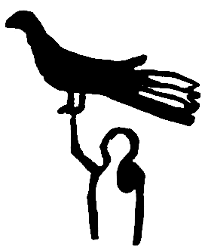
Fig. 189, 1806-’07.—A Dakota killed an Arikara (Ree) as he was about to shoot an eagle. The sign gives the head and shoulders of a man with a red spot of blood on his neck, an arm being extended, with a line drawn to a golden eagle.
The drawing represents an Indian in the act of catching an eagle by the legs, as the Arikara were accustomed to catch eagles in their earth traps. These were holes to which the eagles were attracted by baits and in which the Indians were concealed. They rarely or never shot war eagles. The Arikara was shot in his trap just as he put his hand up to grasp the bird.
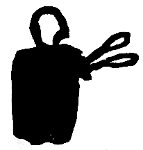
Fig. 190, 1807-’08.—Red-Coat, a chief, was killed. The figure shows the red coat pierced by two arrows, with blood dropping from the wounds.
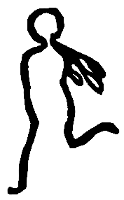
Fig. 191, 1808-’09.—The Dakota who had killed the Ree shown in this record for 1806-’07 was himself killed by the Rees. He is represented running, and shot with two arrows, blood dripping. These two figures, taking in connection, afford a good illustration of the method pursued in the chart, which was not intended to be a continuous history, or even to record the most important event of each year, but to exhibit some one of special peculiarity. There was some incident about the one Ree who was shot when, in fancied security, he was bringing down an eagle, and whose death was avenged by his brethren the second year afterward. It would, indeed, have been impossible to have graphically distinguished the many battles, treaties, horse-stealings, big hunts, etc., so most of them were omitted and other events of greater individuality and better adapted for portrayal were taken for the year count, the criterion being not that they were of historic moment, but[275] that they were of general notoriety, or perhaps of special interest to the recorders.
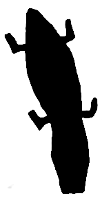
Fig. 192, 1809-’10.—A chief, Little-Beaver, set fire to a trading store, and was killed. The character simply designates his name-totem. The other interpretations say that he was a white trapper, but probably he had gained a new name among the Indians.

Fig. 193, 1810-’11.—Black-Stone made medicine. The expression medicine is too common to be successfully eliminated, though it is altogether misleading. The “medicine men” have no connection with therapeutics, feel no pulses, and administer no drugs, or, if sometimes they direct the internal or external use of some secret preparation, it is as a part of superstitious ceremonies, and with main reliance upon those ceremonies. Their incantations are not only to drive away disease, but for many other purposes, such as to obtain success in war, avert calamity, and were very frequently used to bring within reach the buffalo, on which the Dakotas depended for food. The rites are those known as shamanism, noticeable in the ethnic periods of savagery and barbarism. In the ceremonial of “making medicine,” a buffalo head, and especially the head of an albino buffalo, held a prominent place among the plains tribes. Many references to this are to be found in the Prince of Wied’s Travels in the Interior of North America. Also see infra, Chap. XIV. The device in the chart is the man figure, with the head of an albino buffalo held over his own.

Fig. 194, 1811-’12.—The Dakota fought a battle with the Gros Ventres and killed a great many. Device, a circle inclosing three round objects with flat bases, resembling heads severed from trunks, which are too minute in this device for decision of objects represented; but they appear more distinct in the record for 1864-’65 as the heads of enemies slain in battle. In the sign language of the plains, the Dakota are denoted by drawing a hand across the throat, signifying that they cut the throats of their enemies. The Dakota count by the fingers, as is common to most peoples, but with a peculiarity of their own. When they have gone over the fingers and thumbs of both hands, one finger is temporarily turned down for one ten. At the end of the next ten another finger is turned, and so on to a hundred. Opawinge (Opawinxe), one hundred, is derived from pawinga (pawinxa), to go round in circles, to make gyrations, and contains the idea that the round of all the fingers has again been made for their respective tens. So the circle is never used for less than one hundred, but sometimes signifies an indefinite number greater than a hundred. The circle, in this instance, therefore, was at first believed to express the killing in battle of many enemies. But the other interpretations removed all symbolic character, leaving the circle simply as the rude[276] drawing of a dirt lodge to which the Gros Ventres were driven. The present writer, by no means devoted to symbolism, had supposed a legitimate symbol to be indicated, which supposition further information on the subject showed to be incorrect.

Fig. 195, 1812-’13.—Wild horses were first run and caught by the Dakotas. The device is a lasso. The date is of value, as showing when the herds of prairie horses, descended from those animals introduced by the Spaniards in Mexico, or those deposited by them on the shores of Texas and at other points, had multiplied so as to extend into the far northern regions. The Dakotas undoubtedly learned the use of the horse and perhaps also that of the lasso from southern tribes, with whom they were in contact; and it is noteworthy that notwithstanding the tenacity with which they generally adhere to ancient customs, in only two generations since they became familiar with the horse they had been so revolutionized in their habits as to be utterly helpless, both in war and the chase, when deprived of that animal.

Fig. 196, 1813-’14.—The whooping-cough was very prevalent and fatal. The sign is suggestive of a blast of air coughed out by the man-figure.

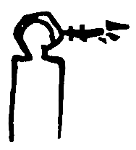
The interruption in the cough peculiar to the disease is more clearly delineated in the Winter Count of The-Flame for the same year, Fig. 197, and still better in The-Swan’s Winter Count, Fig. 198.
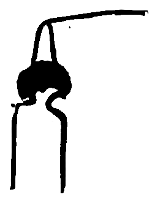
Fig. 199, 1814-’15.—A Dakota killed an Arapaho in his lodge. The device represents a tomahawk or battle-ax, the red being blood from the cleft skull.
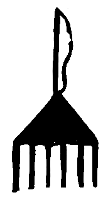
Fig. 200, 1815-’16.—The Sans Arcs made the first attempt at a dirt lodge. This was at Peoria Bottom, Dakota. Crow-Feather was their chief, which fact, in the absence of the other charts, seemed to explain the fairly drawn feather of that bird protruding from the lodge top, but the figure must now be admitted to be a badly drawn bow, in allusion to the tribe Sans Arc, without, however, any sign of negation. As the interpreter explained the figure to be a crow feather and as Crow-Feather[277] actually was the chief, Lone-Dog’s chart with its interpretation may be independently correct.

Fig. 201, 1816-’17.—“Buffalo belly was plenty.” The device rudely portrays a side of buffalo.
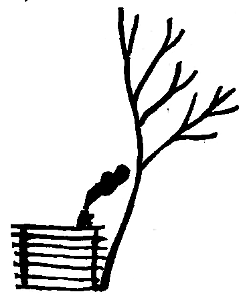
Fig. 202, 1817-’18.—La Framboise, a Canadian, built a trading store with dry timber. The dryness is shown by the dead tree. La Framboise was an old trader among the Dakota, who once established himself in the Minnesota valley. His name is mentioned by various travelers.

Fig. 203, 1818-’19.—The measles broke out and many died. The device in the copy is the same as that for 1801-’02, relating to the smallpox, except a very slight difference in the red blotches; and, though Lone-Dog’s artistic skill might not have been sufficient to distinctly vary the appearance of the two patients, both diseases being eruptive, still it is one of the few serious defects in the chart that the sign for the two years is so nearly identical that, separated from the continuous record, there would be confusion between them. Treating the document as a mere aide-de-mémoire no inconvenience would arise, it probably being well known that the smallpox epidemic preceded that of the measles; but care is generally taken to make some, however minute, distinction between the characters. It is also to be noticed that the Indian diagnosis makes little distinction between smallpox and measles, so that no important pictographic variation could be expected. The head of this figure is clearly distinguished from that in 1801-’02.
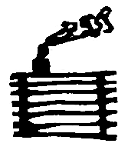
Fig. 204, 1819-’20.—Another trading store was built, this time by Louis La Conte, at Fort Pierre, Dakota. His timber, as one of the Indians consulted especially mentioned, was rotten.
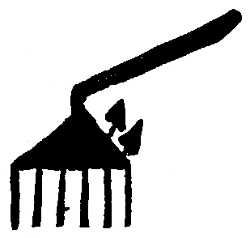
Fig. 205, 1820-’21.—The trader, La Conte, gave Two-Arrow a war dress for his bravery. So translated an interpreter, and the sign shows the two arrows as the warrior’s name-totem; likewise the gable of a house, which brings in the trader; also a long strip of black tipped with red streaming from the roof, which possibly may be the piece of parti-colored material out of which the dress was fashioned. This strip is not intended for sparks and[278] smoke, which at first sight was suggested, as in that case the red would have been nearest the roof instead of farthest from it.

Fig. 206, 1821-’22.—The character represents the falling to earth of a very brilliant meteor.
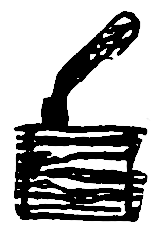
Fig. 207, 1822-’23.—Another trading house was built, which was by a white man called Big-Leggings, and was at the mouth of the Little Missouri or Bad river. The drawing is distinguishable from that for 1819-’20.
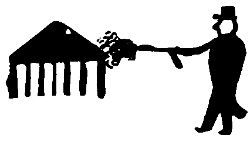
Fig. 208, 1823-’24.—White soldiers made their first appearance in the region. So said the interpreter, Clement, but from the unanimous interpretation of others the event portrayed is the attack of the United States forces accompanied by Dakotas upon the Arikara villages, the historic account of which is given in some detail in Chap. XVI, infra.
The device represents an Arickara palisaded village and attacking soldiers. Not only the remarkable character and triumphant result of this expedition, but the connection that the Dakotas themselves had with it, made it a natural subject for the year’s totem.
All the winter counts refer to this expedition.
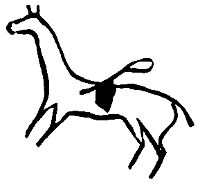
Fig. 209, 1824-’25.—Swan, chief of the Two-Kettle tribe, had all of his horses killed. Device, a horse pierced by a lance, blood flowing from the wound.
Fig. 210, 1825-’26.—There was a remarkable flood in the Missouri river and a number of Indians were drowned. With some exercise of fancy the symbol may suggest heads appearing above a line of water, and this is more distinct in some of the other charts.
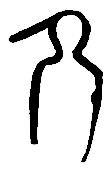
Fig. 211, 1826-’27.—“An Indian died of the dropsy.” So Basil Clement said. It was at first suggested that this circumstance was noted because the disease was so unusual in 1826 as to excite remark. Baron de La Hontan (c), a good authority concerning the Northwestern Indians before they had been greatly affected by intercourse with whites, specially mentions dropsy as one of the diseases unknown to them. Carver, op. cit., also states that this malady was extremely rare. The interpretations of other charts explained,[279] however, that some Dakotas on the warpath had nearly perished with hunger when they found and ate the rotting carcass of an old buffalo on which the wolves had been feeding. They were seized soon after with pains in the stomach, their abdomens swelled, and gas poured from the mouth. This disease is termed tympanites, the external appearance occasioned by it much resembling that of dropsy.

Fig. 212, 1827-’28.—Dead-Arm was stabbed with a knife or dirk by a Mandan. The illustration is quite graphic, showing the long-handled dirk in the bloody wound and withered arm.
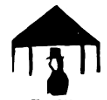
Fig. 213, 1828-’29.—A white man named Shadran, who lately, as reported in 1877, was still living in the same neighborhood, built a dirt lodge. The hatted head appears under the roof. This name should probably be spelled Chadron, with whom Catlin hunted in 1832, in the region mentioned.

Fig. 214, 1829-’30.—A Yanktonai Dakota was killed by Bad-Arrow Indians.
The Bad-Arrow Indians is a translation of the Dakota name for a certain band of Blackfeet Indians.

Fig. 215, 1830-’31.—Bloody battle with the Crows, of whom it is said twenty-three were killed. Nothing in the sign denotes number, it being only a man figure with red or bloody body and red war bonnet.
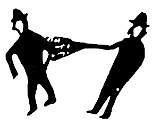
Fig. 216, 1831-’32.—Le Beau, a white man, killed another named Kermel. Le Beau was still alive at Little Bend, 30 miles above Fort Sully, in 1877.
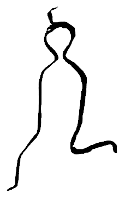
Fig. 217, 1832-’33.—Lone-Horn had his leg “killed,” as the interpretation gave it. The single horn is on the figure, and a leg is drawn up as if fractured or distorted, though not unlike the leg in the character for 1808-’09, where running is depicted.
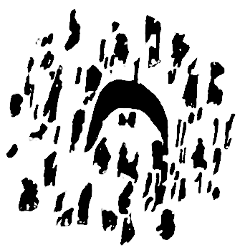
Fig. 218, 1833-’34.—“The stars fell,” as the Indians all agreed. This was the great meteoric shower observed all over the United States on the night of November 12 of that year. In this chart the moon is black and the stars are red.

Fig. 219, 1834-’35.—The chief Medicine-Hide was killed. The device shows the body as bloody, but not the war bonnet, by which it is distinguished from the character for 1830-’31.
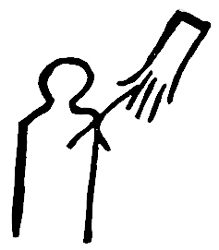
Fig. 220, 1835-’36.—Lame-Deer shot a Crow Indian with an arrow; drew it out and shot him again with the same arrow. The hand is drawing the arrow from the first wound. This is another instance of the principle on which events were selected. Many fights occurred of greater moment, but with no incident precisely like this. Lame-Deer was a distinguished chief among the hostiles in 1876. His camp of five hundred and ten lodges was surprised and destroyed by Gen. Miles, and four hundred and fifty horses, mules, and ponies were captured.

Fig. 221, 1836-’37.—Band’s-Father, chief of the Two Kettles, died. The device is nearly the same as that for 1816-’17, denoting plenty of buffalo belly.
Interpreter Fielder throws light on the subject by saying that this character was used to designate the year when The-Breast, father of The-Band, a Minneconjou, died. The-Band himself died in 1875, on Powder river. His name was O-ye-a-pee. The character was, therefore, the Buffalo-Breast, a personal name.
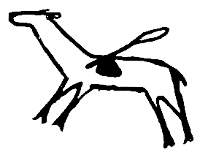
Fig. 222, 1837-’38.—Commemorates a remarkably successful hunt, in which it is said 100 elk were killed. The drawing of the elk is good enough to distinguish it from the other quadrupeds in this chart.
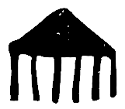
Fig. 223, 1838-’39.—A dirt lodge was built for Iron-Horn. The other dirt lodge (1815-’16) has a mark of ownership, which this has not. A chief of the Minneconjous is mentioned in Gen. Harney’s report in 1856 under the name of The-One-Iron-Horn.
The word translated “iron” in this case and appearing thus several times in the charts does not always mean the metal of that name. According to Rev. J. Owen Dorsey it has a mystic significance, in some manner connected with water and with water spirits. In pictographs objects called iron are painted blue when that color can be obtained.
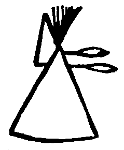
Fig. 224, 1839-’40.—The Dakotas killed an entire village of Snake or Shoshoni Indians. The character is the ordinary tipi pierced by arrows.
Fig. 225, 1840-’41.—The Dakotas made peace with the Cheyennes. The symbol of peace is the common one of the approaching hands of two persons. The different coloration of the two hands and arms shows that they belonged to two different persons, and in fact to different tribes. The mere unceremonial hand grasp or “shake” of friendship was not used by the Indians before it was introduced by Europeans.
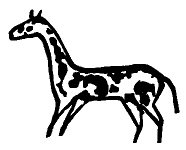
Fig. 226, 1841-’42.—Feather-in-the-Ear stole 30 spotted ponies. The spots are shown red, distinguishing them from those of the curly horse in the character for 1803-’04.
A successful theft of horses, demanding skill, patience, and daring, is generally considered by the Plains Indians to be of equal merit with the taking of scalps. Indeed, the successful horse thief is more popular than a mere warrior, on account of the riches gained by the tribe, wealth until lately being generally estimated in ponies as the unit of value.
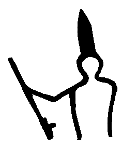
Fig. 227, 1842-’43.—One-Feather raised a large war party against the Crows. This chief is designated by his long solitary red eagle feather, and holds a pipe with black stem and red bowl, alluding to the usual ceremonies before starting on the warpath. For further information on this subject see Chap. XV. The Red-War-Eagle-Feather was at this time a chief of the Sans Arcs.
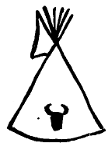
Fig. 228, 1843-’44.—The Sans Arcs made medicine to bring the buffalo. The medicine tent is denoted by a buffalo’s head drawn on it, which in this instance is not the head of an albino buffalo.
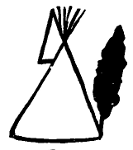
Fig. 229, 1844-’45.—The Minneconjous built a pine fort. Device, a pine tree connected with a tipi. Another account explains that they went to the woods and erected their tipis there as affording some protection from the unusually deep snow. This would account for the pine tree.
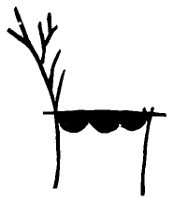
Fig. 230, 1845-’46.—Plenty of buffalo meat, which is represented as hung upon poles and trees to dry. This device has become the conventional sign for plenty and frequently appears in the several charts.

Fig. 231, 1846-’47.—Broken-Leg died. Rev. Dr. Williamson says he knew him. He was a Brulé. There is enough difference between this device and those for 1808-’09 and 1832-’33 to distinguish each.

Fig. 232, 1847-’48.—Two-Man was killed. His totem is drawn, two small man figures side by side. Another interpretation explains the figure as indicating twins.
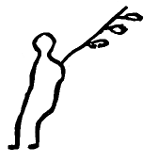
Fig. 233, 1848-’49.—Humpback was killed. An ornamented lance pierces the distorted back. Other records name him Broken-Back. He was a distinguished chief of the Minneconjous.
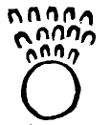
Fig. 234, 1849-’50.—The Crows stole a large drove of horses (it is said eight hundred) from the Brulés. The circle is a design for a camp or corral from which a number of horse-tracks are departing.

Fig. 235, 1850-’51.—The character is a distinct drawing of a buffalo containing a human figure. Clément translated that “a buffalo cow was killed in that year and an old woman found in her belly;” also that all the Indians believed this. Good-Wood, examined through another interpreter, could or would give no explanation except that it was “about their religion.” The Dakotas have long believed in the appearance from time to time of a monstrous animal that swallows human beings. This superstition was perhaps suggested by the bones of mastodons, often found in the territory of those Indians; and, the buffalo being the largest living animal known to them, its name was given to the legendary monster, in which nomenclature they were not wholly wrong, as the horns of the fossil Bison latifrons are 10 feet in length.[283] Major Bush suggests that perhaps some old squaw left to die sought the carcass of a buffalo for shelter and then died. He has known this to occur.
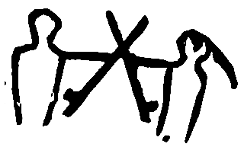
Fig. 236, 1851-’52.—Peace with the Crows. Two Indians, with differing arrangement of hair, showing two tribes, are exchanging pipes for a peace smoke.
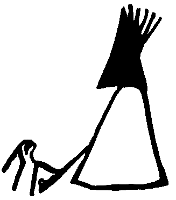
Fig. 237, 1852-’53.—The Nez Percés came to Lone-Horn’s lodge at midnight. The device shows an Indian touching with a pipe a tipi, the top of which is black or opaque, signifying night.
Touch-the-Clouds, a Minneconjou, son of Lone-Horn, when this chart was shown to him by the present writer, designated this character as being particularly known to him from the fact of its being his father’s lodge. He remembered all about it from talk in his family, and said it was the Nez Percés who came.
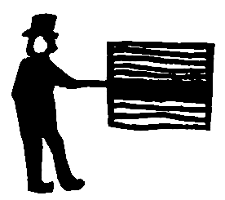
Fig. 238, 1853-’54.—Spanish blankets were first brought to the country. A fair drawing of one of those striped blankets is held out by a white trader.
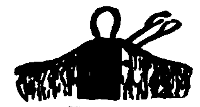
Fig. 239, 1854-’55.—Brave-Bear was killed. His extended arms are ornamented with pendent stripes.
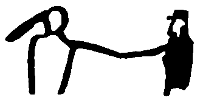
Fig. 240, 1855-’56—Gen. Harney, called by the Dakota Putinska (“white beard” or “white mustache”), made peace with a number of the tribes or bands of the Dakotas. The figure shows an officer in uniform shaking hands with an Indian.
Executive document No. 94, Thirty-fourth Congress, first session, Senate, contains the “minutes of a council held at Fort Pierre, Nebraska, on the 1st day of March, 1856, by Brevet Brig. Gen. William S. Harney, U. S. Army, commanding the Sioux expedition, with the delegations from nine of the bands of the Sioux, viz, the Two Kettle band, Lower Yankton, Uncpapas, Blackfeet Sioux, Minneconjous, Sans Arcs, Yanctonnais (two bands), Brulés of the Platte.”
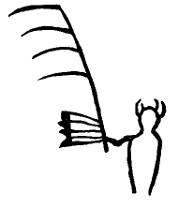
Fig. 241, 1856-’57.—Four-Horn was made a calumet or medicine man.
A man with four horns holds out the same kind of ornamented pipestem shown in the character for 1804-’05, it being his badge of office. Four-Horn was one of the subchiefs of the Uncpapas, and was introduced to Gen. Harney at the council of 1856 by Bear-Rib, head chief of that tribe.
Interpreter Clément, in the spring of 1874, said that Four-Horn and Sitting-Bull were the same person, the name Sitting-Bull being given him after he was made a calumet man. No other authority tells this.
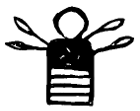
Fig. 242, 1857-’58.—The Dakotas killed a Crow squaw. She is pierced by four arrows, and the peace made with the Crows in 1851-’52 seems to have been short lived.
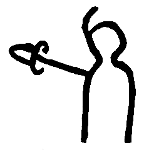
Fig. 243, 1858-’59.—Lone-Horn, whose solitary horn appears, made buffalo “medicine,” doubtless on account of the scarcity of that animal. Again the head of an albino bison. One-Horn, probably the same individual, is recorded as the head chief of the Minneconjous at this date.
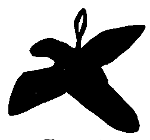
Fig. 244, 1859-’60.—Big-Crow, a Dakota chief, was killed by the Crows. He had received his name from killing a Crow Indian of unusual size.

Fig. 245, 1860-’61.—Device, the head and neck of an elk, similar to that part of the animal for 1837-’38, with a line extending from its mouth, at the extremity of which is the albino buffalo head. “The elk made you understand the voice while he was walking.” The interpreter persisted in this oracular rendering. This device and its interpretation were unintelligible to the writer until examination of Gen. Harney’s report, above referred to, showed the name of a prominent chief of the Minneconjous set forth as “The Elk that Holloes Walking.” It then became probable that the device simply meant that the aforesaid chief made buffalo medicine, which conjecture, published in 1877, was verified by the other records subsequently discovered.
Interpreter A. Lavary said, in 1867, that The-Elk-that-Holloes-Walking, then chief of the Minneconjous, was then at Spotted-Tail’s camp. His father was Red-Fish. He was the elder brother of Lone-Horn. His name is given as A-hag-a-hoo-man-ie, translated The Elk’s Voice Walking; compounded of he-ha-ka, elk, and omani, walk; this according to Lavary’s literation. The correct literation of the Dakota word meaning elk is heqaka; voice, ho; and to walk, walking, mani.[285] Their compound would be heqaka-ho-mani, the translation being the same as above given.
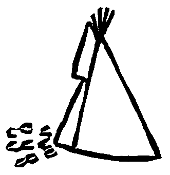
Fig. 246, 1861-’62.—Buffalo were so plentiful that their tracks came close to the tipis. The cloven-hoof mark is cleverly distinguished from the tracks of horses in the character for 1849-’50.

Fig. 247, 1862-’63.—Red-Feather, a Minneconjou, was killed. His feather is shown entirely red, while the “one-feather” in 1842-’43 has a black tip.
It is to be noted that there is no allusion to the great Minnesota massacre, which commenced in August, 1862, and in which many of the Dakotas belonging to the tribes familiar with these charts were engaged. Little-Crow was the leader. He escaped to the British possessions, but was killed in July, 1863. Perhaps the reason of the omission of any character to designate the massacre was the terrible retribution that followed it.

Fig. 248, 1863-’64.—Eight Dakotas were killed. Again the short, parallel black lines united by a long stroke. In this year Sitting-Bull fought General Sully in the Black Hills.

Fig. 249, 1864-’65.—The Dakotas killed four Crows. Four of the same rounded objects, like severed heads, shown in 1825-’26, but these are bloody, thus distinguishing them from the cases of drowning.
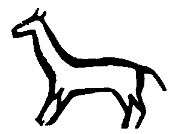
Fig. 250, 1865-’66.—Many horses died for want of grass. The horse here drawn is sufficiently distinct from all others in the chart.
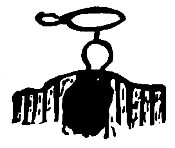
Fig. 251, 1866-’67.—Swan, father of Swan, chief of the Minneconjous in 1877, died. With the assistance of the name the object intended for his totem may be recognized as a swan swimming on the water.

Fig. 252, 1867-’68.—Many flags were given them by the Peace Commission. The flag refers to the visit of the Peace Commissioners, among whom were Generals Sherman, Terry, and other prominent military and civil officers. Their report appears in the Annual Report of the Commissioner of Indian Affairs for 1868. They met at Fort Leavenworth, August 13, 1867, and between August 30 and September 13 held councils with the various bands of the Dakota Indians at Forts Sully and Thompson, and also at[286] the Yankton, Ponka, and Santee reservations. These resulted in the Dakota treaty of 1868.
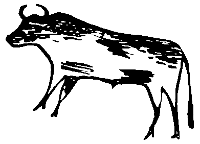
Fig. 253, 1868-’69.—Texas cattle were brought into the country. This was done by Mr. William A. Paxton, a well-known business man, resident in Dakota in 1877.
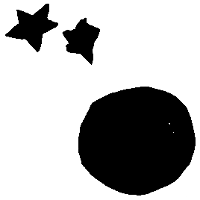
Fig. 254, 1869-’70.—An eclipse of the sun. This was the solar eclipse of August 7, 1869, which was central and total on a line drawn through the Dakota country. This device has been criticised because Indians generally believe an eclipse to be occasioned by a dragon or aerial monster swallowing the sun, and it is contended that they would so represent it. An answer is that the design is objectively good, the sun being painted black, as concealed, while the stars come out red, i. e., bright, and graphic illustration prevails throughout the charts where it is possible to employ it.
Dr. Washington Matthews, surgeon, U. S. Army, communicated the fact that the Dakotas had opportunities all over their country of receiving information about the real character of the eclipse. He was at Fort Rice during the eclipse and remembers that long before it occurred the officers, men, and citizens around the post told the Indians of the coming event and discussed it with them so much that they were on the tip-toe of expectancy when the day came. Two-Bears and his band were then encamped at Fort Rice, and he and several of his leading men watched the eclipse along with the whites and through their smoked glass, and then and there the phenomenon was thoroughly explained to them over and over again. There is no doubt that similar explanations were made at all the numerous posts and agencies along the river that day. The path of the eclipse coincided nearly with the course of the Missouri for over a thousand miles. The duration of totality at Fort Rice was nearly two minutes (1′ 48″).
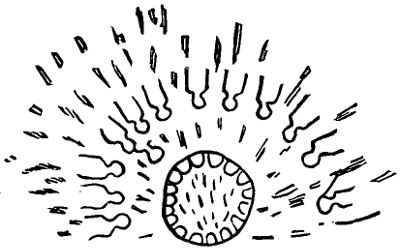
Fig. 255, 1870-’71.—The Uncpapas had a battle with the Crows, the former losing, it is said, 14, and killing 29 out of 30 of the latter, though nothing appears to show those numbers. The central object is not a circle denoting multitude, but an irregularly rounded object, perhaps intended for one of the[287] wooden inclosures or forts frequently erected by the Indians, and especially the Crows. The Crow fort is shown as nearly surrounded, and bullets, not arrows or lances, are flying. This is the first instance in this chart in which any combat or killing is portrayed where guns explicitly appear to be used by Indians, though nothing in the chart is at variance with the fact that the Dakotas had for a number of years been familiar with firearms. The most recent indications of any weapon were those of the arrows piercing the Crow squaw in 1857-’58, and Brave-Bear in 1854-’55, while the last one before those was the lance used in 1848-’49, and those arms might well have been employed in all the cases selected, although rifles and muskets were common. There is an obvious practical difficulty in picturing, by a single character, killing with a bullet, not arising as to arrows, lances, dirks, and hatchets, all of which can be and are shown in the chart projecting from the wounds made by them. Other pictographs show battles in which bullets are denoted by continuous dotted lines, the spots at which they take effect being sometimes indicated, and the fact that they did hit the object aimed at is expressed by a specially invented symbol. It is, however, to be noted that the bloody wound on the Ree’s shoulder (1806-’07) is without any protruding weapon, as if made by a bullet.
More distinct information regarding this fight, the record of which concludes the original Lone-Dog chart, has been kindly communicated by Mr. Luther S. Kelly, of Garfield County, Colorado.
The war party of Uncpapas mentioned charged upon a small trading post for the Crows on the Upper Missouri river, at the mouth of Musselshell river. Usually this post was garrisoned by a few frontiersmen, but on that particular day there happened to be a considerable force of freighters and hunters. The Indians were afoot and, being concealed by the sage brush, got within shooting distance of the fort before being discovered. They were easily driven off, and going a short distance took shelter from the rain in a circular washout, not having any idea of being followed by the whites. Meanwhile the whites organized and followed. The surprise was complete, the leading white man only being killed. The Indians sang their song and made several breaks to escape, but were shot down as fast as they rose above the bank. Twenty-nine were killed.
Dr. William H. Corbusier, surgeon, U. S. Army, while stationed in 1879 and 1880 at Camp Sheridan, Nebraska, near the Pine Ridge Indian Agency, Dakota, obtained a copy of this Winter Count from its recorder Baptiste, commonly called Battiste Good, a Brulé Dakota, whose Dakotan name is given as Wa-po-ctan-xi, translated Brown-Hat. He was then living at the Rose Bud Agency, Dakota, and explained the meaning of the pictographs to the Rev. Wm. J. Cleveland, of the last named agency, who translated them into English.
The copy made by Battiste Good from his original record, of which it is said to be a facsimile, is painted in five colors besides black, in which the outlines are generally drawn, but with the exception of red blood-marks these colors do not often appear to be significant. This copy, which was kindly contributed by Dr. Corbusier, is made in an ordinary paper drawing-book, the last page of which contains the first record. This is represented in Fig. 256, and pictures what is supposed to be an introduction in the nature of a revelation. The next page, reading backwards and corresponding with Pl. XXI, is a pretended record of a cycle comprising the years (presumed to be in the Christian chronology) from 901 to 930. Eleven similar pages and cycles bring the record down to 1700. These pages are only interesting from the mythology and tradition referred to and suggested by them, and which must be garnered from the chaff of uncomprehended missionary teaching. From 1700 to 1880, when the record closes, each year, or rather winter, is represented by a special character according to the Dakota system above explained.
Battiste Good, by his own statement in the present record, was born in the year 1821-’22. Any careful examination of the figures as worked over by his own hand shows that he has received about enough education in English and in writing to induce him to make unnecessary additions and presumptuous emendations on the pictographs as he found them and as perhaps he originally kept and drew the more recent of them. He has written English words and Arabic numerals over and connected with the Dakota devices, and has left some figures in a state of mixture including the methods of modern civilization and the aboriginal system. To prevent the confusion to the reader which might result from Battiste’s meddlesome vanity, these interpolated marks are in general omitted from the plates and figures as now presented, but, as specimens of the kind and amount of interference referred to, the designs on the copy for the years 1700-’01, 1701-’02, and 1707-’08 are given below as furnished.
The facts stated to have occurred so long ago as the beginning of the last century can not often be verified, but those of later date given by Battiste are corroborated by other records in the strongest manner—that is, by independent devices which are not mere copies. Therefore, notwithstanding Battiste’s mythic cycles and English writing, the body of his record, which constitutes the true Winter Counts, must be regarded as genuine. He is simply the bad editor of a good work. But whether or not the events occurred as represented, the pictography is of unique interest. It may be remarked that Battiste’s record is better known among the Oglala and Brulé, and Lone-Dog’s Winter Count among the Minneconjou.
It should be noted that when allusions are made to coloration in Fig. 256, and in any one of the other figures in the text which illustrate this Winter Count, they must be understood as applicable to the original.[289] Pls. XXI, XXII, and XXIII are colored copies of those furnished by Battiste Good, reduced, however, in size.
Fig. 256 illustrates Battiste Good’s introduction. He is supposed to be narrating his own experience as follows: “In the year 1856, I went to the Black Hills and cried, and cried, and cried, and suddenly I saw a bird above me, which said: ‘Stop crying, I am a woman, but I will tell you something: My Great-Father, Father God, who made this place, gave it to me for a home and told me to watch over it. He put a blue sky over my head and gave me a blue flag to have with this beautiful green country. [Battiste has made the hill country, as well as the curve for sky and the flag, blue in his copy.] My Great-Father, Father God (or The Great-Father, God my Father) grew, and his flesh was part earth and part stone and part metal and part wood and part water; he took from them all and placed them here for me, and told me to watch over them. I am the Eagle-Woman who tell you this.[290] The whites know that there are four black flags of God; that is, four divisions of the earth. He first made the earth soft by wetting it, then cut it into four parts, one of which, containing the Black Hills, he gave to the Dakotas, and, because I am a woman, I shall not consent to the pouring of blood on this chief house (or dwelling place), i. e., the Black Hills. The time will come that you will remember my words; for after many years you shall grow up one with the white people.’ She then circled round and round and gradually passed out of my sight. I also saw prints of a man’s hands and horse’s hoofs on the rocks [here he brings in petroglyphs], and two thousand years, and one hundred millions of dollars ($100,000,000). I came away crying, as I had gone. I have told this to many Dakotas, and all agree that it meant that we were to seek and keep peace with the whites.”
(Note by Dr. Corbusier.—The Oglálas and Brulés say that they, with the rest of the Dakota nation, formerly lived far on the other side of the Missouri River. After they had moved to the river, they lived at first on its eastern banks, only crossing it to hunt. Some of the hunting parties that crossed at length wandered far off from the rest and, remaining away, became the westernmost bands.)
Pl. XXI A. The record shown by this figure dates from the appearance of The-Woman-from-Heaven, 901 A. D.; but the Dakotas were a people long before this. The circle of lodges represents a cycle of thirty years, from the year 901 to 930, and incloses the “legend” by which this period is known. All the tribes of the Dakota nation were encamped together, as was then their custom, when all at once a beautiful woman appeared to two young men. One of them said to the other, “Let us catch her and have her for our wife.” The other said, “No; she may be something wakan” (supernatural or sacred). Then the woman said to them, “I came from Heaven to teach the Dakotas how to live and what their future shall be.” She had what appeared to be snakes about her legs and waist, but which were really braids of grass. She said, “I give you this pipe; keep it always;” and with the pipe she gave them a small package, in which they found four grains of maize, one white, one black, one yellow, and one variegated. The pipe is above the buffalo. She said, “I am a buffalo, The White-Buffalo-Cow. I will spill my milk all over the earth, that the people may live.” She meant by her milk maize, which is seen in the picture dropping from her udders. The colored patches on the four sides of the circle are the four quarters of the heavens (the cardinal points of the compass). In front of the cow are yellow and red. She pointed in this direction and said, “When you see a yellowish (or brownish) cloud toward the north, that is my breath; rejoice at the sight of it, for you shall soon see buffalo. Red is the blood of the buffalo, and by that you shall live.” Pointing east [it will be noticed that Battiste has placed the east toward the top of the page], she said, “This pipe is related to the heavens, and you shall live with it.” The line running from the[291] pipe to the blue patch denotes the relation. The Dakotas have always supposed she meant by this that the blue smoke of the pipe was one with or nearly related to the blue sky; hence, on a clear day, before smoking, they often point the stem of the pipe upward, in remembrance of her words. Pointing south, she said, “Clouds of many colors may come up from the south, but look at the pipe and the blue sky and know that the clouds will soon pass away and all will become blue and clear again.” Pointing west, i. e., to the lowest part of the circle, she said, “When it shall be blue in the west, know that it is closely related to you through the pipe and the blue heavens, and by that you shall grow rich.” Then she stood up before them and said, “I am The White-Buffalo-Cow; my milk is of four kinds; I spill it on the earth that you may live by it. You shall call me Grandmother. If you young men will follow me over the hills you shall see my relatives.” She said this four times, each time stepping back from them a few feet, and after the fourth time, while they stood gazing at her, she mysteriously disappeared. [It is well known that four is the favorite or magic number among Indian tribes generally, and has reference to the four cardinal points.] The young men went over the hills in the direction she took and there found a large herd of buffalo.
(Note by Dr. Corbusier.—Mr. Cleveland states that he has heard several different versions of this tradition.)
The man who first told the people of the appearance of the woman is represented both inside and outside the circle. He was thirty years old at the time, and said that she came as narrated above, in July of the year of his birth. Outside of the circle, he is standing with a pipe in his hand; inside, he is squatting, and has his hands in the position for the gesture-sign for pipe. The elm tree and yucca, or Spanish bayonet, both shown above the tipis, indicate that in those days the Dakota obtained fire by rapidly revolving the end of a dry stalk of the yucca in a hole made in a rotten root of the elm. The people used the bow and stone-pointed arrows, which are shown on the right. From time immemorial they have kept large numbers of sticks, shown by the side of the pipe, each one about as thick and as long as a lead-pencil (sic), for the purpose of counting and keeping record of numbers, and they cut notches in larger sticks for the same purpose.
(Note by Dr. Corbusier.—They commonly resort to their fingers in counting, and the V of the Roman system of notation is seen in the outline of the thumb and index, when one hand is held up to express five, and the X in the crossed thumbs, when both hands are held up together to express ten.)
The bundle of these sticks drawn in connection with the ceremonial pipe suggests the idea of an official recorder.
Pl. XXI B, 931-1000. From the time the man represented in Pl. XXI A was seventy years of age, i. e., from the year 931, time is counted by cycles of seventy years until 1700. This figure illustrates the manner of killing buffalo before and after the appearance of The-Woman. When the[292] Dakotas had found the buffalo, they moved to the herd and corralled it by spreading their camps around it. The Man-Who-Dreamed-of-a-Wolf, seen at the upper part of the circle, with bow and arrow in hand, then shot the chief bull of the herd with his medicine or sacred arrow; at this, the women all cried out with joy, “He has killed the chief bull!” On hearing them shout the man with bow and arrow on the opposite side, The-Man-Who-Dreamed-of-the-Thunder-and-received-an-arrow-from-the-Thunder-Bird (wakinyan, accurately translated “the flying one”) shot a buffalo cow, and the women again shouted with joy. Then all the men began to shout, and they killed as many as they wished. The buffalo heads and the blood-stained tracks show what large numbers were killed. They cut off the head of the chief bull, and laid the pipe beside it until their work was done. They prayed to The-Woman to bless and help them as they were following her teachings. Having no iron or knives, they used sharp stones, and mussel shells, to skin and cut up the buffalo. They rubbed blood in the hides to soften and tan them. They had no horses, and had to pack everything on their own backs.
The cyclic characters that embrace the period from 1001 to 1140 illustrate nothing of interest not before presented. Slight distinction appears in the circles so that they can be identified, but without enough significance to merit reproduction.
Pl. XXII A, 1141-1210. Among a herd of buffalo, surrounded at one time during this period, were some horses. The people all cried out, “there are big dogs with them,” having never seen horses before, hence the name for horse, sunka (dog) tanka (big), or sunka (dog) wakan (wonderful or mysterious). After killing all the buffalo they said “let us try and catch the big dogs;” so they cut a thong out of a hide with a sharp stone and with it caught eight, breaking the leg of one of them. All these years they used sharpened deer horn for awls, bone for needles, and made their lodges without the help of iron tools. [All other Dakota traditions yet reported in regard to the first capture of horses, place this important event at a much later period and long after horses were brought to America by the Spaniards. See this count for the year 1802-’03, and also Lone-Dog’s Winter Count for the same year.]
Pl. XXII B, 1211-1280. At one time during this period a war party of enemies concealed themselves among a herd of buffalo, which the Dakotas surrounded and killed before they discovered the enemy. No one knows what people, or how many they were; but the Dakotas killed them all. The red and black lodges indicate war, and that the Dakotas were successful.
The pages of the copy which embrace the period from 1281 to 1420 are omitted as valueless.
Pl. XXIII A, 1421-1490. “Found horses among the buffalo again and caught six.” Five of the horses are represented by the hoof prints. The lasso or possibly the lariat is shown in use. The bundle of sticks is now in the recorder’s hands.
Battiste’s pages which embrace the period from 1491 to 1630 are omitted for the same reason as before offered.
Pl. XXIII B, 1631-1700. This represents the first killing of buffalo on horseback. It was done in the year 1700, inside the circle of lodges pitched around the herd, by a man who was tied on a horse with thongs and who received the name of Hunts-inside-the-lodges. They had but one horse then, and they kept him a long time. Again the bundle of count-sticks is in the recorder’s hands.
This is the end of the obviously mythic part of the record, in which Battiste has made some historic errors. From this time forth each year is distinguished by a name, the explanation of which is in the realm of fact.
It must be again noted that when colors are referred to in the description of the text figures, the language (translated) used by Battiste is retained for the purpose of showing the coloration of the original and his interpretation of the colors, which are to be imagined, as they can not be reproduced by the process used.
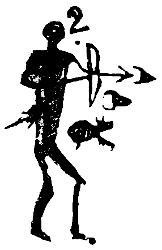
Fig. 257, 1700-’01.—“The-two-killed-on-going-back-to-the-hunting-ground winter (or year).” Two Dakotas returned to the hunting ground, after the hunt one day, and were killed by enemies, of what tribe is unknown. The blood-stained arrow in the man’s side signifies killed; the numeral 2 over his head, the number killed; and, the buffalo heads, the carcass of a buffalo—which had been left behind because it was too poor to eat—together with the arrow pointing toward them, the hunting-ground. The dot under the figure 2, and many of the succeeding ones, signifies, That is it. This corresponds with some gesture signs for the same concept of declaration, in which the index finger held straight is thrust forward with emphasis and repeatedly as if always hitting the same point.
With regard to the numeral 2 over the head of the man see remarks, page 288.
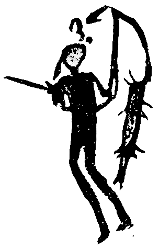
Fig. 258, 1701-’02.—“The-three-killed-who-went-fishing winter.” The arrow pointing toward the 3, indicates that they were attacked; the arrow in the man’s arm, and the blood stain, that they were killed; the pole, line, and fish which the man is holding, their occupation at the time.
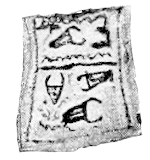
Fig. 259, 1702-’03.—“Camped-cutting-the-ice-through winter.” A long lake toward the east, near which the Dakotas were encamped, was frozen over, when they discovered about one thousand buffalo. They[294] secured them all by driving them on the ice, through which they broke, and in which they froze fast. Whenever the people wanted meat, they cut a buffalo out of the ice. In the figure, the wave lines represent the water of the lake; the straight lines, the shore; the blue lines outside the black ones, trees; the blue patches inside, the ice through which the heads of the buffalo are seen; the line across the middle, the direction in which they drove the buffalo. The supply of meat lasted one year. (Note by Dr. Corbusier.—The Apache of Arizona, the Ojibwa, and the Ottawa also represent water by means of waved lines.)
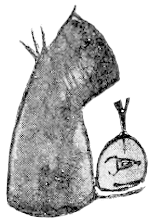
Fig. 260, 1703-’04—“The-burying winter,” or “Many-hole winter.”—They killed a great many buffalo during the summer, and, after drying the meat, stored it in pits for winter’s use. It lasted them all winter, and they found it all in good condition. The ring surrounding the buffalo head, in front of the lodge, represents a pit. The forked stick, which is the symbol for meat, marks the pit. [Other authorities suggest that the object called by Battiste a pit, which is more generally called “cache,” is a heap, and means many or much.]
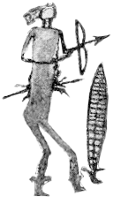
Fig. 261, 1704-’05.—“Killed-fifteen-Pawnees-who-came-to-fight winter.” The Dakotas discovered a party of Pawnees coming to attack them. They met them and killed fifteen. In this chart the Pawnee of the Upper Missouri (Arikara or Ree), the Pawnee of Nebraska, and the Omaha are all depicted with legs which look like ears of corn, but an ear of corn is symbol for the Rees only. The Pawnee of Nebraska may be distinguished by a lock of hair at the back of the head; the Omaha, by a cropped head or absence of the scalp-lock. The absence of all signs denotes Dakota. Dr. W. Matthews, in Ethnography and Philology of the Hidatsa Indians, states that the Arikara separated from the Pawnee of the Platte valley more than a century ago. [To avoid confusion the literation of the tribal divisions as given by the translator of Battiste Good are retained, though not considered to be accurate.]

Fig. 262, 1705-’06.—“They-came-and-killed-seven-Dakotas winter.” It is not known what enemies killed them.
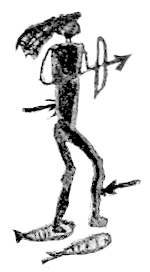
Fig. 263, 1706-’07.—“Killed-the-Gros-Ventre-with-snowshoes-on winter.” A Gros-Ventre (Hidatsa), while hunting buffalo on snowshoes, was chased by the Dakotas. He accidentally dropped a snowshoe, and, being then unable to get through the snow fast enough, they gained on him, wounded him in the leg, and then killed him. The Gros-Ventres and the Crows are tribes of the same nation, and are therefore both represented with striped or spotted hair, which denotes the red clay they apply to it.
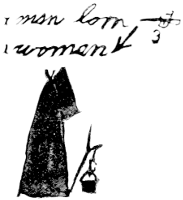
Fig. 264, 1707-’08.—“Many-kettle winter.” A man—1 man—named Corn, killed (3) his wife, 1 woman, and ran off. He remained away for a year, and then came back, bringing three guns with him, and told the people that the English, who had given him these guns, which were the first known to the Dakotas, wanted him to bring his friends to see them. Fifteen of the people accordingly went with him, and when they returned brought home a lot of kettles or pots. These were the first they ever saw. Some numerical marks for reference and the written words in the above are retained as perhaps the worst specimens of Battiste’s mixture of civilized methods with the aboriginal system of pictography. See remarks above, page 288.
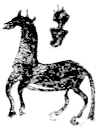
Fig. 265, 1708-’09.—“Brought-home-Omaha-horses winter.” The cropped head over the horse denotes Omaha.

Fig. 266, 1709-’10.—“Brought-home-Assiniboin-horses winter.” The Dakota sign for Assiniboin, or Hohe, which means the voice, or, as some say, the voice of the musk ox, is the outline of the vocal organs, as the Dakotas conceive them, and represents the upper lip and roof of the mouth, the tongue, the lower lip and chin, and the neck.
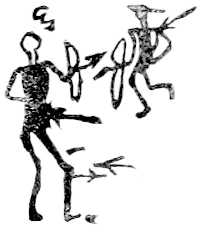
Fig. 267, 1710-’11.—“The-war-parties-met, or killed-three-on-each-side winter.” A war party of Assiniboins met one of Dakotas, and in the fight which ensued three were killed on each side.
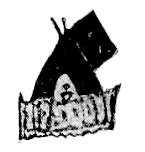
Fig. 268, 1711-’12.—“Four-lodges-drowned winter.” When the thunders returned in the summer the Dakotas were still in their winter camp, on the bottom lands of a large creek. Heavy rains fell, which caused the creek to rise suddenly; the bottoms were flooded, and the occupants of four lodges were swept away and drowned. Water is represented by waved lines, as before. The lower part of the lodge is submerged. The human figure in the doorway of the lodge indicates how unconscious the inmates were of their peril.
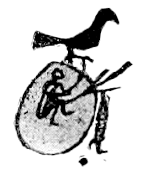
Fig. 269, 1712-’13.—“Killed-the-Pawnee-who-was-eagle-hunting winter.” A Pawnee (Ree) was crouching in his eagle-trap, a hole in the ground covered with sticks and grass, when he was surprised and killed by the Dakotas. This event is substantially repeated in this count for the year 1806-’07.
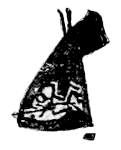
Fig. 270, 1713-’14.—“Came-and-shot-them-in-the-lodge winter.” The Pawnee (Rees) came by night, and, drawing aside a tipi door, shot a sleeping man, and thus avenged the death of the eagle-hunter.
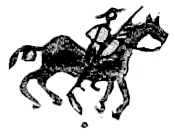
Fig. 271, 1714-’15.—“Came-to-attack-on-horseback-but-killed-nothing winter.” The horseman has a pine lance in his hand. It is not known what tribe came. (Note by Dr. Corbusier.—It is probable that horses were not numerous among any of the Indians yet, and that this mounted attack was the first one experienced by the Brulé.)
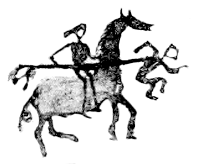
Fig. 272, 1715-’16.—“Came-and-attacked-on-horseback-and-stabbed-a-boy-near-the-lodge winter.” Eagle tail-feathers hang from the butt end of the lance.
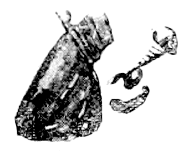
Fig. 273, 1716-’17.—“Much-pemmican winter.” A year of peace and prosperity. Buffalo were plentiful all the fall and winter. Large quantities of pemmican (wasna) were made with dried meat and marrow. In front of the lodge is seen the backbone of a buffalo, the marrow of which is used in wasna; below this is the buffalo stomach, in which wasna is packed for preservation.
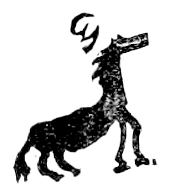
Fig. 274, 1717-’18.—“Brought-home-fifteen-Assiniboin-horses winter.” The sign for Assiniboin is above the horse.
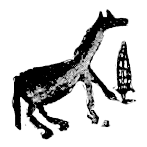
Fig. 275, 1718-’19.—“Brought-home-Pawnee-horses winter.” The sign for Ree, i. e., an ear of corn, is in front of the horse.
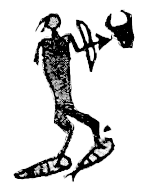
Fig. 276, 1719-’20.—“Wore-snowshoes winter.” The snow was very deep, and the people hunted buffalo on snowshoes with excellent success.
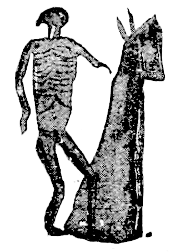
Fig. 277, 1720-’21.—“Three-lodges-starved-to-death winter.” The bare ribs of the man denote starvation. [The gesture-sign for poor or lean indicates that the ribs are visible. In the Ojibwa and Ottawa pictographs lines across the chest denote starvation.]
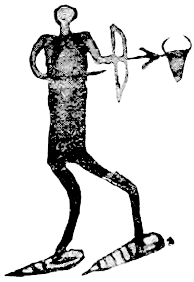
Fig. 278, 1721-’22.—“Wore-snowshoes-and-dried-much-buffalo-meat winter.” It was even a better year for buffalo than 1719-’20.
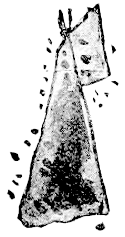
Fig. 279, 1722-’23.—“Deep-snow-and-tops-of-lodges-only-visible winter.” The spots are intended for snow.
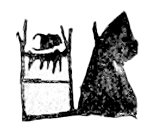
Fig. 280, 1723-’24.—“Many-drying-sticks-set-up winter.” They set up more than the usual number of sticks for scaffolds, etc., as they dried the buffalo heads, hides, and entrails, as well as the meat. This figure is repeated with differentiation for the year 1745-’46 in this chart.
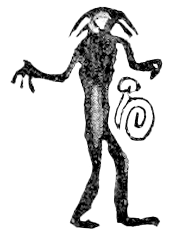
Fig. 281, 1724-’25.—“Blackens-himself-died winter.” This man was in the habit of blacking his whole body with charcoal. He died of some kind of intestinal bend [sic] as is indicated by the stomach and intestines in front of him, which represent the bowels in violent commotion, or going round and round.
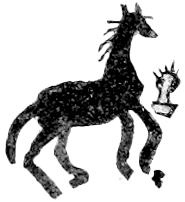
Fig. 282, 1725-’26.—“Brought-home-ten-Omaha-horses winter.” The sign for Omaha is the head, as before.
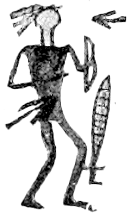
Fig. 283, 1726-’27.—“Killed-two-Pawnees-among-the-lodges winter.” The Pawnees (Rees) made an assault on the Dakota Village, and these two ran among the lodges without any arrows. The sign for Ree is, as usual, an ear of corn.
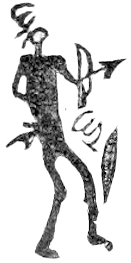
Fig. 284, 1727-’28.—“Killed-six-Assiniboins winter.” Two signs are given here for Assiniboin. There is some uncertainty as to whether they were Assiniboins or Arikaras, so the signs for both are given.
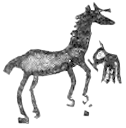
Fig. 285, 1728-’29.—“Brought-home-Gros-Ventre-horses winter.” A Gros Ventre head is shown in front of the horse.

Fig. 286, 1729-’30.—“Killed-the-Pawnees-camped-alone-with-their-wives winter.” Two Pawnees and their wives, who were hunting buffalo by themselves, and living in one lodge, were surprised and killed by a war party of Dakotas.
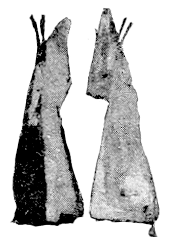
Fig. 287, 1730-’31.—“Came-from-opposite-ways-and-camped-together winter.” By a singular coincidence, two bands of Dakotas selected the same place for an encampment, and arrived there the same day. They had been separated a long time, and were wholly ignorant of each other’s movements. The caps of the tipis face one another.
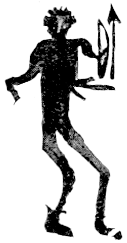
Fig. 288, 1731-’32.—“Came-from-killing-one-Omaha-and-danced winter.” This is the customary feast at the return of a successful war party. The erect arrow may stand for “one,” and the Omaha is drawn at full length with his stiff short hair and painted cheeks.
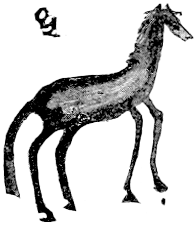
Fig. 289, 1732-’33.—“Brought-home-Assiniboin-horses winter.” The sign for Assiniboin is as before, over the horse.
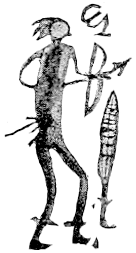
Fig. 290, 1733-’34.—“Killed-three-Assiniboins winter.” There is again uncertainty as to whether they were Assiniboins or Arikaras, and both signs are used.
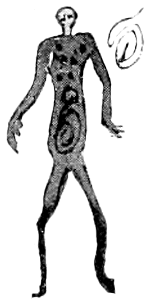
Fig. 291, 1734-’35.—“Used-them-up-with-bellyache winter.” About fifty of the people died of an eruptive disease which was accompanied by pains in the bowels. The eruption is shown on the man in the figure. This was probably the first experience by the Dakotas of the smallpox, which has been so great a factor in the destruction of the Indians.
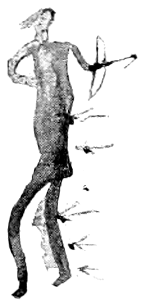
Fig. 292, 1735-’36.—“Followed-them-up-and-killed-five winter.” A war party of Dakotas were chased by some enemies, who killed five of them. The arrows flying from behind at the man indicate pursuit, and the number of the arrows, each with a bloody mark as if hitting, is five.
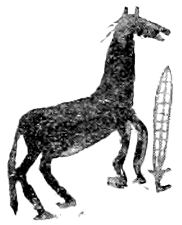
Fig. 293, 1736-’37.—“Brought-home-Pawnee-horses winter.” This date must be considered in connection with the figure in this record for 1802-’03. There is a distinction between the wild and the shod horses, but the difference in tribe is great. The ear of corn showing the husk is as common in this record for Pawnee as for Arikara.
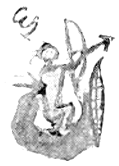
Fig. 294, 1737-’38.—“Killed-seven-Assiniboins-bringing-them-to-a-stand-under-a-bank winter.” The daub, blue in the original, under the crouching figure, represents the bank.
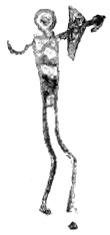
Fig. 295, 1738-’39.—“The-four-who-went-on-the-war-path-starved-to-death winter.” Starvation is indicated as before.
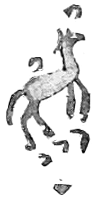
Fig. 296, 1739-’40—“Found-many-horse winter.” The horses had thongs around their necks, and had evidently been lost by some other tribe. Hoof prints are represented above and below the horse, that is all around.
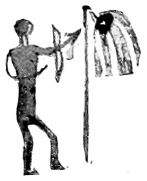
Fig. 297, 1740-’41.—“The-two-came-home-having-killed-an-enemy winter.” They took his entire scalp, and carried it home at the end of a pole. Only a part of the scalp is ordinarily taken, and that from the crown of the head.
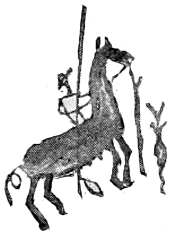
Fig. 298, 1741-’42.—“Attacked-them-while-gathering-turnips winter.” Some women, who were digging turnips (pomme blanche) near the camp, were assaulted by a party of enemies, who, after knocking them down, ran off without doing them any further harm. A turnip, and the stick for digging it, are seen in front of the horseman.
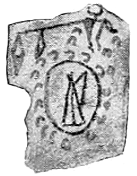
Fig. 299, 1742-’43.—“Killed-them-on-the-way-home-from-the-hunt winter.” The men were out hunting, and about 100 of their enemies came on horseback to attack the camp, and had already surrounded it, when a woman poked her head out of a lodge and said, “They have all gone on the hunt. When I heard you, I thought they had come back.” She pointed toward the hunting-ground, and the enemies going in that direction, met the Dakotas, who killed many of them with their spears, and put the rest to flight. Hoof-prints surround the circle of lodges, and are on the trail to the hunting-ground.
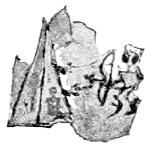
Fig. 300, 1743-’44.—“The-Omahas-came-and-killed-them-in-the-night winter.” They wounded many, but killed only one. The Dakotas were all encamped together.
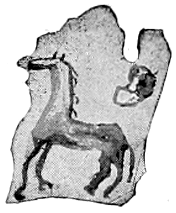
Fig. 301, 1744-’45.—“Brought-home-Omaha-horses winter.”
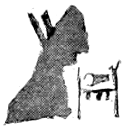
Fig. 302, 1745-’46.—“Many-drying-scaffolds winter.” It was even a better year for buffalo than 1723-’24.
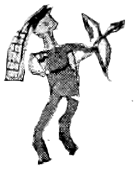
Fig. 303, 1746-’47.—“Came-home-having-killed-one-Gros-Ventre winter.”
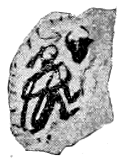
Fig. 304, 1747-’48.—“Froze-to-death-at-the-hunt winter.” The arrow pointing toward the buffalo head indicates they were hunting, and the crouching figure of the man, together with the snow above and below him, that he suffered severely from cold or froze to death.
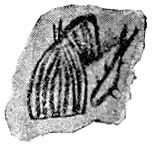
Fig. 305, 1748-’49.—“Eat-frozen-fish winter.” They discovered large numbers of fish frozen in the ice, and subsisted on them all winter.
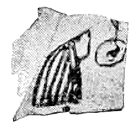
Fig. 306, 1749-’50.—“Many-hole-camp-winter.” The same explanation as for Fig. 260, for the year 1703-’04. The two figures are different in execution though the same in concept. There would, however, be little confusion in distinguishing two seasons of exceptional success in the hunt that were separated by forty-six years.
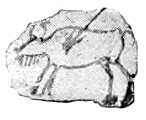
Fig. 307, 1750-’51.—“Killed-two-white-buffalo-cows winter.” (Note by Dr. Corbusier: Two white buffalo are so rarely killed one season that the event is considered worthy of record. Most Indians regard the albinos among animals with the greatest reverence. The Ojibwas, who look upon a black loon as the most worthless of birds regard a white one as sacred.)
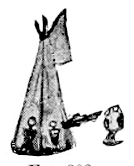
Fig. 308, 1751-’52.—“Omahas-came-and-killed-two-in-the-lodge winter.” An Omaha war party surprised them in the night, shot into the lodge, wounding two, and then fled. The two shot died of their wounds.
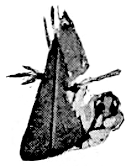
Fig. 309, 1752-’53.—“Destroyed-three-lodges-of-Omahas winter.” The Dakotas went to retaliate on the Omahas, and finding three lodges of them killed them. It will be noticed that in this figure the sign for Omaha is connected with the lodge, and in the preceding figure with the arrow.
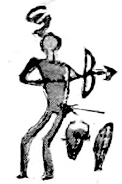
Fig. 310, 1753-’54.—“Killed-two-Assiniboins-on-the-hunt winter.”
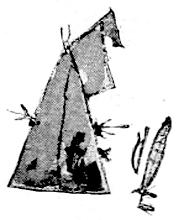
Fig. 311, 1754-’55.—“Pawnees-shouted-over-the-people winter.” The Pawnees (Rees) came at night, and standing on a bluff overlooking the Dakota village shot into it with arrows, killing one man, and alarmed the entire village by their shouts.
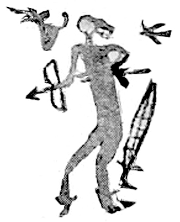
Fig. 312, 1755-’56.—“Killed-two-Pawnees-at-the-hunt winter.” A war party of Dakotas surprised some Pawnee (Ree) hunters and killed two of them.
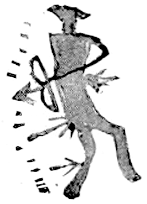
Fig. 313, 1756-’57.—“The-whole-people-were-pursued-and-two-killed winter.” A tribe, name unknown, attacked and routed the whole band. The man in the figure is retreating, as is shown by his attitude; the arrow on his bow points backward at the enemy, from whom he is retreating. The two blood-stained arrows in his body mark the number killed.
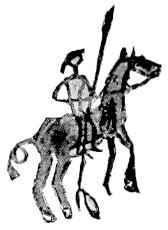
Fig. 314, 1757-’58.—“Went-on-the-warpath-on-horseback-to-camp-of-enemy-but-killed-nothing winter.” The lack of success may have been due to inexperience in mounted warfare as the Dakotas had probably for the first time secured a sufficient number of horses to mount a war party.
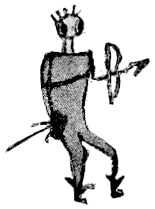
Fig. 315, 1758-’59.—“Killed-two-Omahas-who-came-to-the-camp-on-war-path winter.”
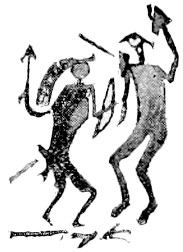
Fig. 316, 1759-’60.—“War-parties-met-and-killed-a-few-on-both-sides winter.” The attitude of the opposed figures of the Dakota and Gros Ventre and the footprints indicate that the parties met; the arrows in opposition, that they fought; and the blood-stained arrow in each man that some were killed on both sides.
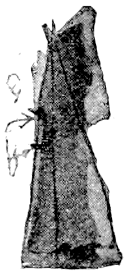
Fig. 317, 1760-’61.—“Assiniboins-came-and-attacked-the-camp-again winter;” or “Assiniboins-shot-arrows-through-the-camp winter.”
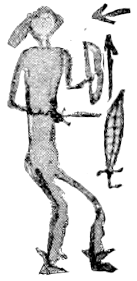
Fig. 318, 1761-’62.—“Killed-six-Pawnees (Rees) winter.” Besides the arrow sticking in the body another is flying near the head of the man figure, who has the tribal marks for Pawnee or Ree, as used in this record.
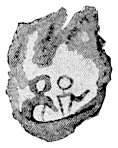
Fig. 319, 1762-’63.—“The-people-were-burnt winter.” They were living somewhere east of their present country when a prairie fire destroyed[305] their entire village. Many of their children and a man and his wife, who were on foot some distance away from the village, were burned to death, as also were many of their horses. All the people that could get to a long lake, which was near by, saved themselves by jumping into it. Many of these were badly burned about the thighs and legs, and this circumstance gave rise to the name Sican-zhu, burnt thigh (or simply burnt as translated Brulé by the French), by which they have since been known, and also to the gesture sign, as follows: “Rub the upper and outer part of the right thigh in a small circle with the open right hand, fingers pointing downward.”
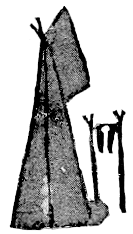
Fig. 320, 1763-’64.—“Many-sticks-for-drying-beef winter.” They dried so much meat that the village was crowded with drying poles and scaffolds.
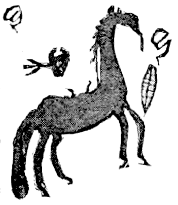
Fig. 321, 1764-’65.—“Stole-their-horses-while-they-were-on-the-hunt winter.” A Dakota war party chanced to find a hunting party of Assiniboins asleep and stole twenty of their horses. It was storming at the time and horses had their packs on and were tied. The marks which might appear to represent a European saddle on the horse’s back denote a pack or load. Hunting is symbolized as before, by the buffalo head struck by an arrow.
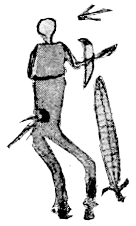
Fig. 322, 1765-’66.—“Killed-a-war-party-of-four-Pawnees winter.” The four Pawnees (Rees) made an attack on the Dakota camp.
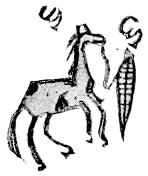
Fig. 323, 1766-’67.—“Brought-home-sixty-Assiniboin-horses (one spotted) winter.” They were all the horses the Assiniboins had and were on an island in the Missouri river, from which the Dakotas cleverly stole them during a snowstorm.
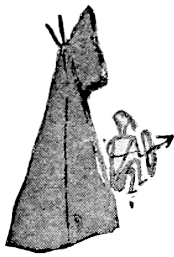
Fig. 324, 1767-’68.—“Went-out-to-ease-themselves-with-their-bows-on winter.” The Dakotas were in constant fear of an attack by enemies. When a man left his lodge after dark, even to answer the calls of nature, he carried his bows and arrows along with him and took good care not to go far away from the lodge. The squatting figure, etc., close to the lodge tells the story.
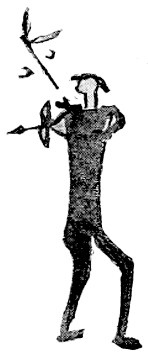
Fig. 325, 1768-’69.—“Two-horses-killed-something winter.” A man who had gone over a hill just out of the village was run down by two mounted enemies who drove their spears into him and left him for dead, one of them leaving his spear sticking in the man’s shoulder, as shown in the figure. He recovered, however. (Note by Dr. Corbusier: They frequently speak of persons who have been very ill and have recovered as dying and returning to life again, and have a gesture sign to express the idea.)
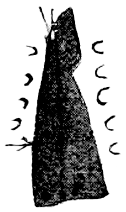
Fig. 326, 1769-’70.—“Attacked-the-camp-from-both-sides winter.” A mounted war party—tribe unknown—attacked the village on two sides, and on each side killed a woman. The footprints of the enemies’ horses and arrows on each side of the lodge, which represents the village, show the mode of attack.
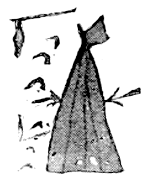
Fig. 327, 1770-’71—“Came-and-killed-the-lodges winter.” The enemy came on horseback and assailed the Dakota lodges, which were pitched near together, spoiling some of them by cutting the hide coverings with their spears, but killing no one. They used spears only, but arrows are also depicted, as they symbolize attack. No blood is shown on the arrows, as only the lodges were “killed.”
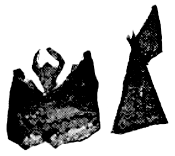
Fig. 328, 1771-’72.—“Swam-after-the-buffalo winter.” In the spring the Dakotas secured a large supply of meat by swimming out and towing ashore buffalo that were floating past the village and which had fallen into the river on attempting to cross on the weak ice.
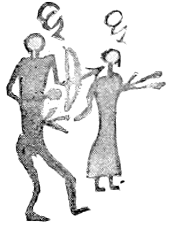
Fig. 329, 1772-’73.—“Killed-an-Assiniboin-and-his-wife winter.”
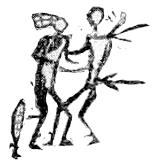
Fig. 330, 1773-’74.—“Killed-two-Pawnee-boys-while-playing winter.” A war party of Dakotas surprised two Pawnee (Ree) boys who were wrestling and killed them while they were on the ground.
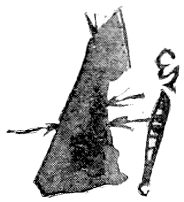
Fig. 331, 1774-’75.—“Assiniboins-made-an-attack winter.” They were cowardly, however, and soon retreated. Perhaps the two arrows of the Assiniboins compared with the one arrow of the attacked Dakotas suggests the cowardice.
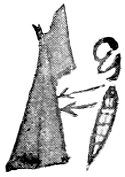
Fig. 332, 1775-’76.—“Assiniboins-went-home-and-came-back-mad-to-make-a-fresh-attack winter.” They were brave this time, being thoroughly aroused. They fought with bows and arrows only.
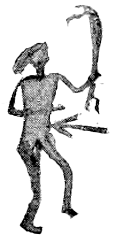
Fig. 333, 1776-’77.—“Killed-with-war-club-in-his-hand winter.” A Dakota war club is in the man’s hand and an enemy’s arrow is entering his body.

Fig. 334, 1777-’78.—“Spent-the-winter-in-no-particular-place winter.” They made no permanent camp, but wandered about from place to place.
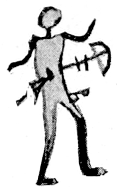
Fig. 335, 1778-’79.—“Skinned-penis-used-in-the-game-of-haka winter.” A Dakota named as mentioned was killed in a fight with the Pawnees and his companions left his body where they supposed it would not be found, but the Pawnees found it and as it was frozen stiff they dragged it into their camp and played haka with it. The haka-stick which, in playing the game, they cast after a ring, is represented on the right of the man. This event marks 1777-’78 in the Winter Count of American-Horse and 1779-’80 in that of Cloud-Shield. The insult and disgrace made it remarkable.

Fig. 336, 1779-’80.—“Smallpox-used-them-up winter.” The eruption and pains in the stomach and bowels are shown as before.

Fig. 337, 1780-’81.—“Smallpox-used-them-up-again winter.” There is in this figure no sign for pain but the spots alone are shown. An attempt to discriminate and distinguish the year-devices is perceived.
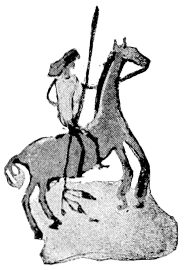
Fig. 338, 1781-’82.—“Came-and-attacked-on-horseback-for-the-last-time winter.” The name of the tribe is not known, but it is the last time they ever attacked the Dakotas.
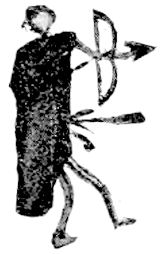
Fig. 339, 1782-’83.—“Killed-the-man-with-the-scarlet-blanket-on winter.” It is not known what tribe killed him.
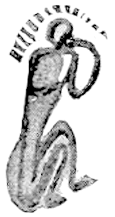
Fig. 340, 1783-’84.—“Soldier-froze-to-death winter.” The falling snow and the man’s position with his legs drawn up to his abdomen, one hand in an armpit and the other in his mouth, are indicative of intense cold.
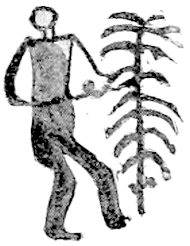
Fig. 341, 1784-’85.—“The-Oglala-took-the-cedar winter.” During a great feast an Oglala declared he was wakan and could draw a cedar tree out of the ground. He had previously fastened the middle of a stick to the lower end of a cedar with a piece of the elastic ligament from the neck of the buffalo and then planted the tree with the stick crosswise beneath it. He went to this tree, dug away a little earth from around it and pulled it partly out of the ground and let it spring back again, saying “the cedar I drew from the earth has gone home again.” After he had gone some young men dug up the tree and exposed the shallow trick.
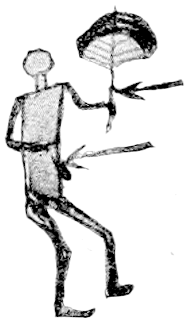
Fig. 342, 1785-’86.—“The-Cheyennes-killed-Shadow’s-father winter.” The umbrella signifies, shadow; the arrow which touches it, attacked; the three marks under the arrow (not shown in the copy), Cheyenne; the blood-stained arrow in the man’s body, killed. Shadow’s name and the umbrella in the figure intimate that he was the first Dakota to carry an umbrella. The advantages of the umbrella were soon recognized by them, and the first they obtained from the whites were highly prized. It is now considered an indispensable article in a Sioux outfit. They formerly wore a wreath of green leaves or carried green boughs, to shade them from the sun. The marks used for Cheyenne stand for the scars on their arms or stripes on their sleeves, which also gave rise to the gesture-sign for this tribe, see Fig. 495, infra.
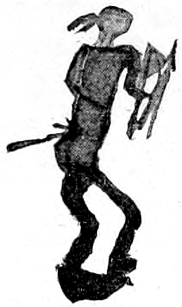
Fig. 343, 1786-’87.—“Iron-Head-Band-killed-on-warpath winter.” They formerly carried burdens on their backs, hung from a band passed across the forehead. This man had a band of iron which is shown on his head. So said the interpreter, but probably the band was not of the metal iron. The word so translated has a double meaning and is connected with religious ideas of water, spirit, and the color blue.
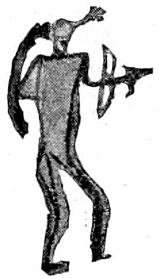
Fig. 344, 1787-’88.—“Left-the-heyoka-man-behind winter.” A certain man was heyoka—that is, his mind was disordered and he went about the village bedecked with feathers singing to himself, and, while so, joined a war party. On sighting the enemy the party fled, and called to him to turn back also; as he was heyoka, he construed everything that was said to him as meaning the very opposite, and therefore, instead of turning back, he went forward and was killed. If they had only had sense enough to tell him to go on, he would then have run away, but the thoughtless people talked to him just as if he had been in an ordinary condition and of course were responsible for his death. The mental condition of this man and another device for the event are explained by other records (see Fig. 651).
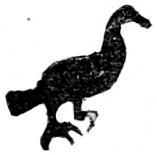
Fig. 345, 1788-’89.—“Many-crows-died winter.” Other records for the same year give as the explanation of the figure and the reason for its selection that the crows froze to death because of the intense cold.
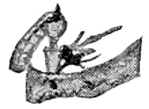
Fig. 346, 1789-’90.—“Killed-two-Gros-Ventres-on-the-ice winter.”
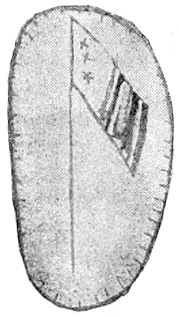
Fig. 347, 1790-’91.—“Carried-a-flag-about-with-them winter.” They went to all the surrounding tribes with the flag, but for what purpose is unknown. So said the interpreter, but The-Flame’s chart explains the figure by the statement: “The first United States flags in the country brought by United States troops.”

Fig. 348, 1791-’92.—“Saw-a-white-woman winter.” The dress of the woman indicates that she was not an Indian. This is obviously noted as being the first occasion when the Dakotas, or at least the bands which this record concerns, saw a white woman.
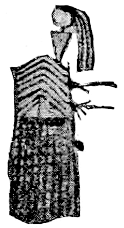
Fig. 349, 1792-’93.—“Camped-near-the-Gros-Ventres winter.” They were engaged in a constant warfare during this time. A Gros Ventre dirt lodge, with the entrance in front, is depicted in the figure and on its roof is a Gros Ventre head.
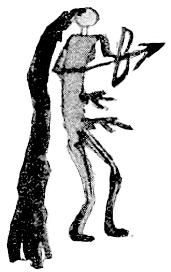
Fig. 350, 1793-’94.—“Killed-a-long-haired-man-at-Rawhide-butte winter.” The Dakotas attacked a village of 58 lodges and killed every soul in it. After the fight they found the body of a man whose hair was done up with deer-hide in large rolls, and, on cutting them open, found it was all real hair, very thick, and as long as a lodge-pole. [Mem. Catlin tells of a Crow called Long-Hair whose hair, by actual measurement, was 10 feet and 7 inches long.] The fight was at Rawhide butte (now so called by the whites), which the Dakotas named Buffalo-Hide butte, because they found so many buffalo hides in the lodges. According to Cloud-Shield, Long-Hair was killed in 1786-’87, and according to American-Horse, Long-Hair, a Cheyenne, was killed in 1796-’97.
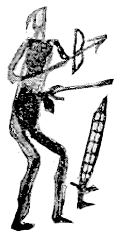
Fig. 351, 1794-’95.—“Killed-the-little-faced-Pawnee winter.” The Pawnee’s face was long, flat, and narrow, like a man’s hand, but he had the body of a large man.
White-Cow-Killer calls it: “Little-Face-killed winter.”
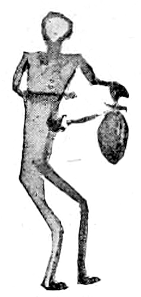
Fig. 352, 1795-’96.—“The-Rees-stood-the-frozen-man-up-with-the-buffalo-stomach-in-his-hand winter.” The body of a Dakota who had been killed in an encounter with the Rees (Pawnees), and had been left behind, frozen. The Rees dragged it into their village, propped it up with a stick, and hung a buffalo stomach filled with ice in one hand to make sport of it. The buffalo stomach was in common use at that time as a water-jug.
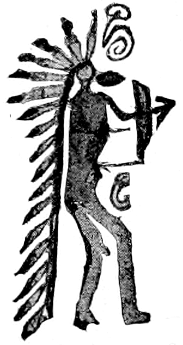
Fig. 353, 1796-’97.—“Wears-the-War-Bonnet-died winter.” He did not die this winter, but received a wound in the abdomen from which the arrowhead could not be extracted, and he died of the “bellyache” years after.
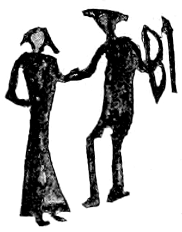
Fig. 354, 1897-’98.—“Took-the-God-Woman-captive winter.” A Dakota war party captured a woman—tribe unknown—who, in order to gain their respect, cried out, “I am a Wakan-Tanka,” meaning that she belonged to God, whereupon they let her go unharmed. This is the origin of their name for God (Wakan Tanka, the Great Holy, or Supernatural One). They had never heard of a Supernatural Being before, but had offered their prayers to the sun, the earth, and many other objects, believing they were endowed with spirits. [Those are the remarks of Battiste Good, who is only half correct, being doubtless influenced by missionary teaching. The term is much older and signifies mystic or unknown.]
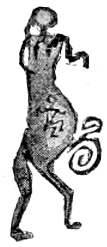
Fig. 355, 1798-’99.—“Many-women-died-in-childbirth winter.” They died of bellyache. The convoluted sign for pain in the abdominal region has appeared before. Cloud-Shield’s winter count for the same year records the same mortality among the women which was perhaps an epidemic of puerperal fever.
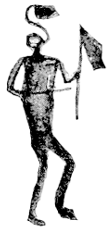
Fig. 356, 1799-1800.—“Don’t-Eat-Buffalo-Heart-made-a-commemoration-of-the-dead winter.” A buffalo heart is represented above the man. Don’t Eat is expressed by the gesture sign for negation, a part of which is indicated, and the line connecting the heart with his month. The red flag which is used in the ceremony is employed as its symbol. The name Don’t-Eat-Buffalo-Heart refers to the man for whom that viand is taboo, either by gentile rules or from personal visions. The religious ceremony of commemoration of the dead is mentioned elsewhere in this work, see Chapter XIV, section 6.
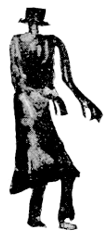
Fig. 357, 1800-’01.—“The-Good-White-Man-came winter.” Seven white men came in the spring of the year to their village in a starving condition; after feeding them and treating them well, they allowed them to go on their way unmolested. The Dakotas [of the recorder’s band] had heard of the whites, but had never seen any before. In the fall some more came, and with them, The-Good-White-Man, who is represented in the figure, and who was the first one to trade with them. They became very fond of him because of his fair dealings with them. The gesture made by his hands is similar to benediction, and suggests a part of the Indian gesture sign for “good.”
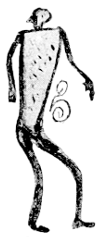
Fig. 358, 1801-’02.—“Smallpox-used-them-up-again winter.” The man figure is making a part of a common gesture sign for death, which consists substantially in changing the index from a perpendicular to a horizontal position and then pointing to the ground.
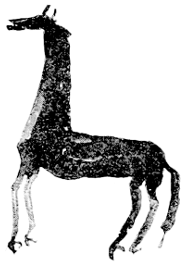
Fig. 359, 1802-’03.—“Brought-home-Pawnee-horses-with-iron-shoes-on winter.” The Dakotas had not seen horseshoes before. This agrees with and explains Lone-Dog’s Winter Count for the same year.
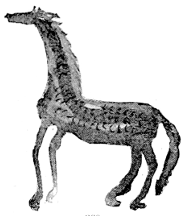
Fig. 360, 1803-’04.—“Brought-home-Pawnee-horses-with-their-hair-rough-and-curly winter.” The curly hair is indicated by the curved marks. Lone-Dog’s Winter Count for the same year records the same incident, but states that the curly horses were stolen from the Crows.
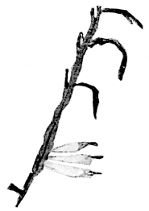
Fig. 361, 1804-’05.—“Sung-over-each-other-while-on-the-war-path winter.” A war party while out made a large pipe and sang each other’s praises. The use of an ornamented pipe in connection with the ceremonies of organizing a war party is mentioned in Chapter XV.

Fig. 362, 1805-’06.—“They-came-and-killed-eight winter.” The enemy killed eight Dakotas, as shown by the arrow and the eight marks beneath it.
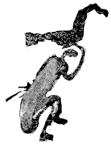
Fig. 363, 1806-’07.—“Killed-them-while-hunting-eagles winter.” Some Dakota eagle-hunters were killed by enemies. See Lone-Dog’s Winter Count for the same year.

Fig. 364, 1807-’08.—“Came-and-killed-man-with-red-shirt-on winter.” Other records say that Red-Shirt killed in this year was an Uncpapa Dakota, and that he was killed by Arikaras.

Fig. 365, 1808-’09.—“Pawnees-(Rees)-killed-Blue-Blanket’s-father winter.” A blanket, which in the original record is blue, is represented above the arrow and across the man’s body.

Fig. 366, 1809-’10.—“Little-Beaver’s-house-burned winter.” Little-Beaver was an English trader, and his trading house was a log one.
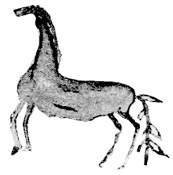
Fig. 367, 1810-’11.—“Brought-home-horse-with-his-tail-braided-with-eagle-feathers winter.” They stole a band of horses beyond the South Platte. One of them was very fleet, and had his tail ornamented as described.
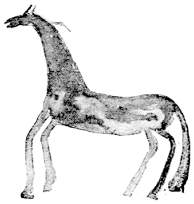
Fig. 368, 1811-’12.—“First-hunted-horses winter.” The Dakotas caught wild horses in the Sand Hills with braided lariats.
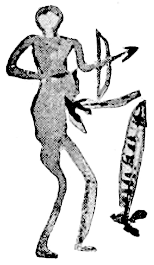
Fig. 369, 1812-’13.—“Rees-killed-Big-in-the-Middle’s-father winter.” Other records call this warrior Big-Waist and Big-Belly.
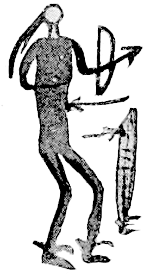
Fig. 370, 1813-’14.—“Killed-six-Pawnees (Rees) winter.” Six strokes are under the arrow, but are not shown in the copy.
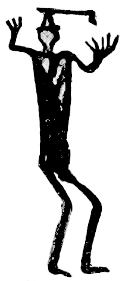
Fig. 371, 1814-’15.—“Smashed-a-Kiowa’s-head-in winter.” The tomahawk with which it was done is sticking in the Kiowa’s head.
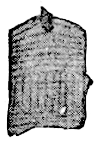
Fig. 372, 1815-’16.-“The-Sans-Arcs-made-large-houses winter.”

Fig. 373, 1816-’17.—“Lived-again-in-their-large-houses winter.”
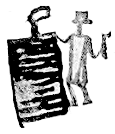
Fig. 374, 1817-’18.—“Chozé-built-a-house-of-dead-logs winter.” The house was for trading purposes. The Frenchman’s name is evidently a corruption.
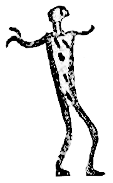
Fig. 375, 1818-’19.—“Smallpox-used-them-up-again winter.” They at this time lived on the Little White river, about 20 miles above the Rosebud agency. The two fingers held up may mean the second time the fatal epidemic appeared in the particular body of Indians concerned in the record.

Fig. 376, 1819-’20.—“Chozé-built-a-house-of-rotten-wood winter.” Another trading house was built.
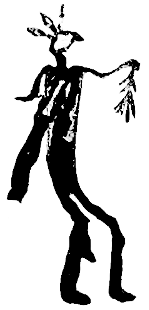
Fig. 377, 1820-’21.—“They-made-bands-of-strips-of-blanket-in-the-winter.” These bands were of mixed colors and reached from the shoulders to the heels. They also made rattles of deer’s hoofs by tying them to sticks with bead-covered strings. The man has a sash over his shoulders and a rattle in his hand.
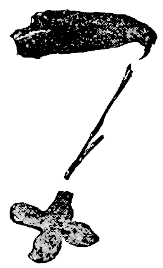
Fig. 378, 1821-’22.—“Star-passed-by-with-loud-noise winter,” “Much-whisky winter,” and “Used-up-the-Omahas winter.” In the figure the meteor, its pathway, and the cloud from which it came are shown. Whisky was furnished to them for the first time and without stint. It brought death to them in a new form, many since then having died from the excessive use of it, Red-Cloud’s father among the number. Battiste Good, alias Wa-po’stan-gi, more accurately Wa-po-ctan-xi (Brown-Hat), historian and chief, was born. He says that Omaha bullets were whizzing through the village and striking and piercing his mother’s lodge as she brought him forth. Red-Cloud was also born. In the count of American-Horse for this year he makes no mention of the meteor, but strongly marks the whisky as the important figure for the winter.
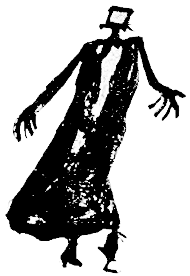
Fig. 379, 1822-’23.—“Peeler-froze-his-leg winter.” Peeler was a white trader, and his leg was frozen while he was on his way to or from the Missouri river. The name is explained by White Cow Killer’s record as follows: “White-man-peels-the-stick-in-his-hand-broke-his-leg winter.” He was probably a Yankee, addicted to whittling.
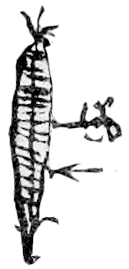
Fig. 380, 1823-’24.—“General-——-first-appeared-and-the-Dakotas-aided-in-an-attack-on-the-Rees winter.” Also “Much-corn winter”. The gun and the arrow in contact with the ear of corn show that both whites and Indians fought the Rees. This refers to Gen. Leavenworth’s expedition against the Arikara in 1823, when several hundred Dakotas were his allies. This expedition is mentioned several times in this work.
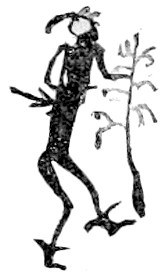
Fig. 381, 1824-’25.—“Killed-two-picking-plums winter.” A Dakota war party surprised and killed two Pawnees who were gathering plums.

Fig. 382, 1825-’26.—“Many-Yanktonais-drowned winter.” The river bottom on a bend of the Missouri river, where they were encamped, was suddenly submerged, when the ice broke and many women and children were drowned. All the Winter Counts refer to this flood.
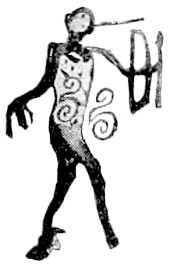
Fig. 383, 1826-’27.—“Ate-a-whistle-and-died winter.” Six Dakotas on the war path (shown by bow and arrow) had nearly perished with hunger, when they found and ate the rotting carcass of an old buffalo, on which the wolves had been feeding. They were seized soon after with pains in the stomach, the abdomen swelled, and gas poured from mouth and anus, and they died of a whistle or from eating a whistle. The sound of gas escaping from the mouth is illustrated in the figure.
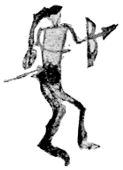
Fig. 385, 1828-’29.—“Killed-two-hundred-Gros Ventres (Hidatsas) winter.”
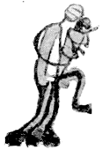
Fig. 386, 1829-’30.—“Old-Speckled-Face-clung-to-his-son-in-law winter.” The daughter of Speckled-Face, who was coming out second best in an altercation with her husband, called to her father for help. The latter ran and grabbed his son-in-law around the waist, and, crying “That is my daughter,” stabbed him. The son-in-law fell and the old man fell on top of him, and, clinging to him, begged the lookers on to put an end to him also, as he wished to bear his beloved son-in-law company to the spirit land. No one, however, was in the humor to speed him on the journey, and he remained with the living.

Fig. 387, 1830-’31.—“Shot-many-white-buffalo-cows winter.”

Fig. 388, 1831-’32.—“Killed-him-while-looking-about-on-the-hill winter.” A Dakota, while watching for buffalo at Buffalo Gap, in the Black Hills, was shot by the Crows. The man is represented on a hill, which is dotted with pine trees and patches of grass. Battiste makes the grass blue. Blue and green are frequently confounded by other Indians than Battiste, and some tribes have but one name for the two colors.
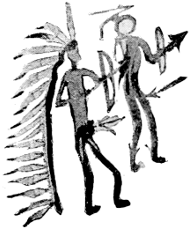
Fig. 389, 1832-’33.—“Stiff-Leg-with-War-Bonnet-on-died winter.” He was killed in an engagement with the Pawnees on the Platte river, in which the Brulés killed one hundred Pawnees.
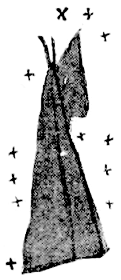
Fig. 390, 1833-’34.—“Storm-of-stars winter.” All the Winter Counts refer to this great meteoric display, which occurred on the night of November 12, 1833, and was seen over most of the United States.
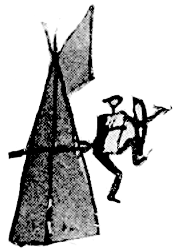
Fig. 391, 1834-’35.—“Killed-the-Cheyenne-who-came-to-the-camp winter.” A Cheyenne who stole into the village by night was detected and killed. The village was near what is now the Pine Ridge agency.
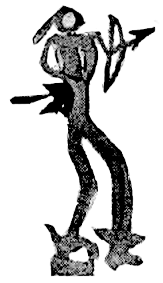
Fig. 392, 1835-’36.—“Killed-the-two-war-party-leaders winter.” A Dakota war party met one of Pawnees and killed two of their leaders, whereupon the rest ran.
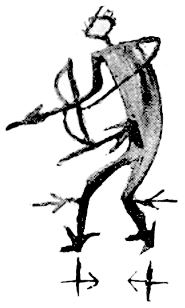
Fig. 393, 1836-’37.—“Fight-on-the-ice winter.” They fought with the Pawnees on the ice, on the Platte river, and killed seven of them. The two vertical marks, which are for the banks of the river, and the two opposed arrows, signify that the tribes were on opposite sides of the river.
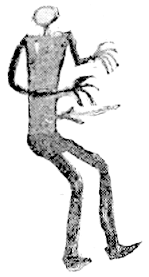
Fig. 394, 1837-’38.—“Spread-out-killed winter.” A Santee man, whose name is indicated by his spread hands, was killed by soldiers.
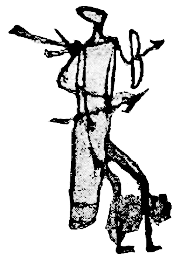
Fig. 395, 1838-’39.—“Came-and-killed-five-Oglálas winter.” They were killed by Pawnees. The man in the figure has on a capote, the hood of which is drawn over his head. This garment is used here as a sign for war, as the Dakotas commonly wear it on their war expeditions.
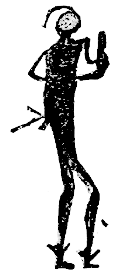
Fig. 396, 1839-’40.—“Came-home-from-the-starve-to-death-war-path winter.” All of the Dakota tribes united in an expedition against the Pawnees. They killed one hundred Pawnees, but nearly perished with hunger.
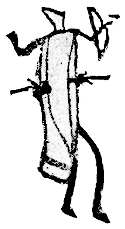
Fig. 397, 1840-’41—“Came-and-killed-five-of-Little-Thunder’s-brothers winter,” and “Battiste-alone-returns winter.” The five were killed in an encounter with the Pawnees. Battiste Good was the only one of the party to escape. The capote is shown again.
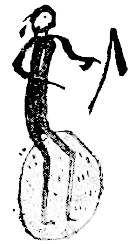
Fig. 398, 1841-’42.—“Pointer-made-a-commemoration-of-the-dead winter.” Also “Deep-snow winter.” The extended index denotes the man’s name, the ring and spots deep snow.
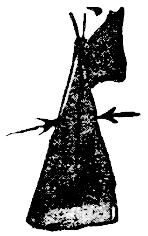
Fig. 399, 1842-’43.—“Killed-four-lodges-of-Shoshoni-and-brought-home-many-horses winter.”
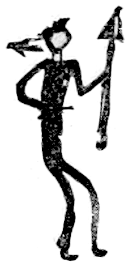
Fig. 400, 1843-’44.—“Brought-home-the-magic-arrow winter.” This arrow originally belonged to the Cheyennes from whom the Pawnees stole it. The Dakotas captured it this winter from the Pawnees and the Cheyennes then redeemed it for one hundred horses.
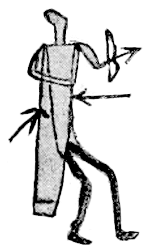
Fig. 401, 1844-’45.—“The-Crows-came-and-killed-thirty-eight-Oglálas winter.” The Oglálas were on the warpath, as indicated by the capote.
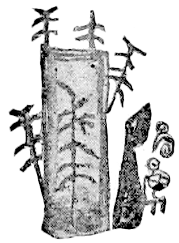
Fig. 402, 1845-’46.—“Broke-out-on-faces-had-sore-throats-and-camped-under-the-bluff winter.” “Also-had-bellyache.” The position of the camp is shown, also the suggestive attitude of the man.

Fig. 403, 1846-’47.—“Winter-camp-broke-his-neck winter.” He was thrown from his horse while on a hunt. The red on his neck is the break.
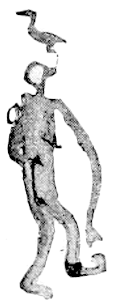
Fig. 404, 1847-’48.—“The-Teal-broke-his-leg winter.” His arm is lengthened to direct attention to his leg. The Chinese radical and phonetic character for the same concept, Fig. 1193, infra, may be compared, as also Fig. 231, supra.
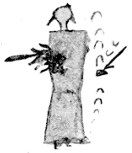
Fig. 405, 1848-’49.—“Killed-the-hermaphrodite winter” and “Big-horse-stealing winter.” They captured a Crow who pretended to be a woman, but who proved to be a man, and they killed him. It is probable that this was one of the men, not uncommon among the Indian tribes, who adopt the dress and occupation of women. This is sometimes compulsory from failure to pass an ordeal or from exhibition of cowardice. Eight hundred horses were stolen from the Dakotas, but seven hundred of them were recovered. The Crows killed one Dakota, as is indicated by the arrow in contact with the red spot in the hoof print.
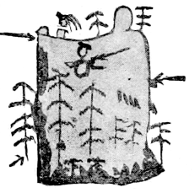
Fig. 406, 1849-’50.—“Brought-the-Crows-to-a-stand winter.” This was done at Crow Butte, near Camp Robinson, Nebraska. It is said that a party of Crows, who were flying from the Dakotas, took refuge on the Butte about dark and that the Dakotas surrounded them, confident of capturing them the next morning, but the Crows escaped during the night, very much to the chagrin of the Dakotas. The Crow’s head is just visible on the summit of the hill, as if the body had gone down.

Fig. 407, 1850-’51.—“The-big-smallpox winter.”
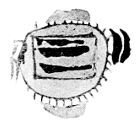
Fig. 408, 1851-’52.—“First-issue-of-goods winter.” The colored patches outside the circle are at the four cardinal points, the colored patches inside the circle are meant for blankets and the other articles issued, and the circle of strokes the people sitting. The Dakotas were told that fifty-five years after that issue they would have to cultivate the ground, and they understood that they would not be required to do it before.

Fig. 409, 1852-’53.—“Deep-snow-used-up-the-horses winter.” The spots around the horses represent snow.
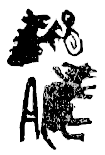
Fig. 410, 1853-’54.—“Cross-Bear-died-on-the-hunt winter.” The travail means they moved; the buffalo, to hunt buffalo; the bear with mouth open and paw advanced, Cross-Bear; the stomach and intestines, took the bellyache and died. The gesture sign for bear is made as follows: Slightly crook the thumbs and little fingers, and nearly close the other fingers; then, with their backs upward, hold the hands a little in advance of the body or throw them several times quickly forward a few inches. The sign is sometimes made with one hand only.
For explanation of the word “travail,” applied to the Indian sledge made of the joined tent poles, see Fig. 764 and accompanying remarks.
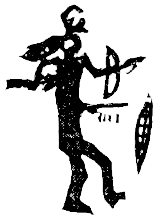
Fig. 411, 1854-’55.—“Killed-five-Assiniboins winter.” The Dakotas are ashamed of the part they took in the following deplorable occurrence and it is not therefore noted in the record, although it really marks the year. In consequence of a misunderstanding in regard to an old foot-sore cow, which had been abandoned on the road by some emigrants and which the Dakotas had innocently appropriated, Lieut. Grattan, Sixth U. S. Infantry, killed Conquering Bear (Mato-way'uhi, Startling Bear properly) about ten miles east of Fort Laramie, August 19, 1854. The Dakotas then, in retaliation, massacred Lieut. Grattan and the thirty men of Company G, Sixth U. S. Infantry, he had with him.
The figure without the above statement tells the simple story about the killing of five Assiniboins who are denoted by the usual tribal sign, the number being designated by the five strokes below the arrow.
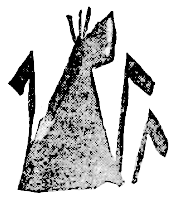
Fig. 412, 1855-’56.—“Little-Thunder-and-Battiste-Good-and-others-taken-prisoners-at-Ash-Hollow-on-the-Blue-creek winter,” and one hundred and thirty Dakotas were killed by the white soldiers. Also called “Many-sacrificial-flags winter.” The last-mentioned name for the winter is explained by other records and by Executive Document No. 94, Thirty-fourth Congress, first session, Senate, to refer to a council held on March 18, 1856, by Brevet Brig. Gen. W. S. Harney, U. S. Army, with nine of the bands of the Dakotas.
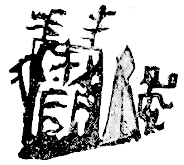
Fig. 413, 1856-’57.—“Bad-Four-Bear-trades-with-Battiste-Good-for-furs-all winter.” Bad-Four-Bear, a white trader, is represented sitting smoking a pipe in front of Battiste’s tipi under a bluff at Fort Robinson, Nebraska.
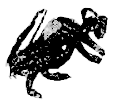
Fig. 414, 1857-’58.—“Hunted-bulls-only winter.” They found but few cows, the buffalo being composed principally of bulls. The travail is shown.

Fig. 415, 1858-’59.—“Many-Navajo-blankets winter.” A Navajo blanket is shown in the figure. Several of the records agree in the explanation about the bringing of these blankets at that time.
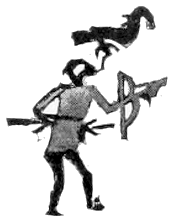
Fig. 416, 1859-’60.—“Came-and-killed-Big-Crow winter.” The two marks under the arrow indicate that two were killed.
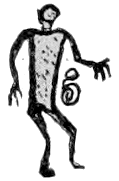
Fig. 417, 1860-’61.—“Broke-out-with-rash-and-died-with-pains-in-the-stomach winter.”
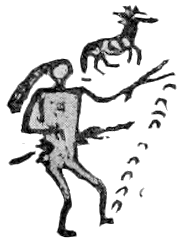
Fig. 418, 1861-’62.—“Killed-Spotted-Horse winter.” Spotted Horse and another Crow came and stole many horses from the Dakotas, who followed them, killed them, and recovered their horses.
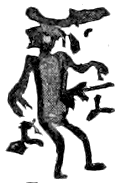
Fig. 419, 1862-’63—“Cut-up-the-boy-in-the-camp winter.” The Crows came to the lodges and cut up the boy while the people were away. The knife above his head shows that he was cut to pieces.
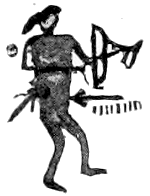
Fig. 420, 1863-’64.—“Crows-came-and-killed-eight winter.” Some of the eight were Cheyennes. The marks below the arrow represent the killed.
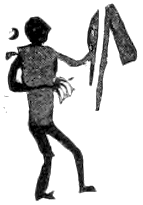
Fig. 421, 1864-’65.—“Roaster-made-a-commemoration-of-the-dead winter.” A piece of roasted meat is shown on the stick in the man’s hand. The Dakotas roast meat on a stick held in front of the fire.
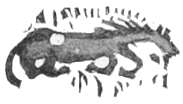
Fig. 422, 1865-’66.—“Deep-snow-used-up-the-horses winter.” The horse is obviously in a deplorable condition.
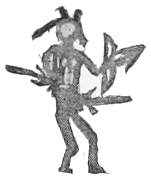
Fig. 423, 1866-’67.—“Beaver’s-Ears-killed winter.”
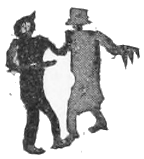
Fig. 424, 1867-’68.—“Battiste-Good-made-peace-with-General-Harney-for-the-people winter.” This refers to the great Dakota treaty of 1868 in which other general officers besides Gen. Harney were active and other Indian chiefs much more important than Battiste took part. The assumption of his intercession is an exhibition of boasting.
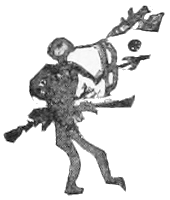
Fig. 425, 1868-’69.—“Killed-Long-Fish winter” and “Killed-fifteen winter.” The Crows killed fifteen Sans Arcs and Long-Fish also, a Lower Brulé. The long fish is shown attached by a line to the mouth of the man figure in the manner that personal names are frequently portrayed in this paper.
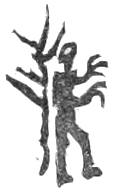
Fig. 426, 1869-’70.—“Trees-killed-them winter.” A tree falling on a lodge killed a woman.
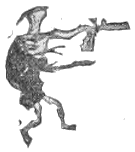
Fig. 427, 1870-’71.—“Came-and-killed-High-Back-Bone winter.” He was a chief. The Crows and Shoshoni shot him at long range, and the pistol with which he was armed was of no service to him.
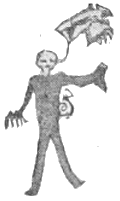
Fig. 428, 1871-’72.—“Gray-Bear-died winter.” He died of the bellyache.
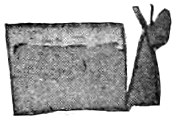
Fig. 429, 1872-’73.—“Issue-year winter.” A blanket is shown near the tipi. A blanket is often used as the symbol for issue of goods by the United States Government.
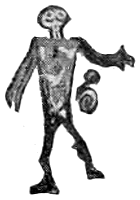
Fig. 430, 1873-’74.—“Measles-and-sickness-used-up-the-people winter.”
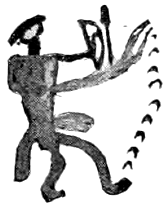
Fig. 431, 1874-’75.—“Utes-stole-horses winter.” They stole five hundred horses. The Utes are called “black men,” hence the man in the figure is represented as black. He is throwing his lariat in the direction of the hoof prints.
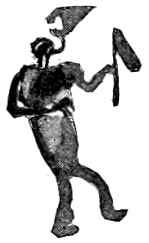
Fig. 432, 1875-’76.—“Bull-Head-made-a-commemoration-of-the-dead winter.”
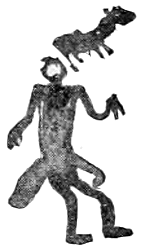
Fig. 433, 1876-’77.—“Female-Elk-Walks-Crying-died winter.” For some explanation of this figure see Lone Dog’s Winter Count for 1860-’61.
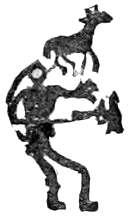
Fig. 434, 1877-’78.—“Crazy-Horse-came-to-make-peace-and-was-killed-with-his-hands-stretched-out winter.” This refers to the well-known killing of the chief Crazy-Horse while a prisoner.
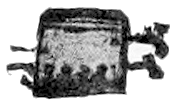
Fig. 435, 1878-’79.—“Brought-the-Cheyennes-back-and-killed-them-in-the-house winter.” The Cheyennes are shown in prison surrounded by blood stains, and with guns pointing toward them. The Cheyennes referred to are those who left the Indian Territory in 1878 and made such a determined effort to reach their people in the north, and who, after committing many atrocities, were captured and taken to Fort Robinson, Nebraska. They broke from the house in which they were confined and attempted to escape January 9, 1879. Many of them were killed; it was reported at the time among the Dakotas that they were massacred in their prison by the troops.

Fig. 436, 1879-’80.—“Sent-the-boys-and-girls-to-school winter.” A boy with a pen in his hand is represented in the picture.
This is an important division of the purposes for which pictographs are used. The pictographs and the objective devices antecedent to them under this head may be grouped as follows: 1st. Notice of visit, departure, and direction. 2d. Direction by drawing topographic features. 3d. Notice of condition. 4th. Warning and guidance.
Mr. G. K. Gilbert, of the U. S. Geological Survey, discovered drawings at Oakley spring, Yavapai County, Arizona, in 1878. He remarks that an Oraibi chief explained them to him and said that the “Mokis make excursions to a locality in the canyon of the Colorado Chiquito to get salt. On their return they stop at Oakley spring and each Indian makes a picture on the rock. Each Indian draws his crest or totem, the symbol of his gens (?). He draws it once, and once only, at each visit.” Mr. Gilbert adds, further, that—
There are probably some exceptions to this, but the drawings show its general truth. There are a great many repetitions of the same sign and from two to ten will[330] often appear in a row. In several instances I saw the end drawings of a row quite fresh while the others were not so. Much of the work seems to have been performed by pounding with a hard point, but a few pictures are scratched on. Many drawings are weather-worn beyond recognition, and others are so fresh that the dust left by the tool has not been washed away by rain. Oakley spring is at the base of the Vermilion cliff, and the etchings are on fallen blocks of sandstone, a homogeneous, massive, soft sandstone. Tubi, the Oraibi chief above referred to, says his totem is the rain cloud, but it will be made no more, as he is the last survivor of the gens.
A group from Oakley spring, of which Fig. 437 is a copy, furnished by Mr. Gilbert, measures 6 feet in length and 4 feet in height. Interpretations of several of the separated characters are given in Chapter XXI, infra.
Champlain (b) reports:
Quelque marque ou signal par où ayont passé leurs ennemis, ou leurs amis, ce qu’ils cognoissent par de certaines marques que les chefs se donnent d’une nation a l’autre, qui ne sont pas toujours semblables, s’advertisans de temps en temps quand ils en changent; et par ce moyen ils recognoissent si ce sont amis ou ennemis qui ont passé.
A notice of departure, direction, and purpose made in 1810 by Algonquins, of the St. Lawrence River, is described by John Merrick in the Collections of the Maine Historical Society (a), of which the following is an abstract;
It was drawn with charcoal on a chip cut from a spruce tree and wedged firmly into the top of a stake. It represented two male Indians paddling a canoe in an attitude of great exertion, and in the canoe were bundles of baggage and a squaw with a papoose; over all was a bird on the wing ascertained to be a loon. The whole was interpreted by an Indian pilot on the St. Lawrence, to be a Wickheegan or Awickheegan, and that it was left by a party of Indians for the information of their friends. The attitude of exertion showed that the party, consisting of two men, a woman, and a child, were going upstream. They intended to remain during the whole period allotted by Indians to the kind of hunting which was then in season, because they had all their furniture and family in the canoe. The loon expressed the intention to go without stopping anywhere before they arrived at the hunting ground, as the loon, from the shortness of its legs, walking with great difficulty, never alighted on its way.
The following account is from Doc. Hist. N.Y. (a).
When they go to war and wish to inform those of the party who may pass their path, they make a representation of the animal of their tribe, with a hatchet in his dexter paw; sometimes a saber or a club; and if there be a number of tribes together of the same party, each draws the animal of his tribe, and their number, all on a tree from which they remove the bark. The animal of the tribe which heads the expedition is always the foremost.
The three following figures show the actual use of the wikhegan by the Abnaki in the last generation. Wikhegan is a Passamaquoddy word which corresponds in meaning nearly to our missive, or letter, being intelligence conveyed to persons at a distance by marks on a piece of birch bark, which may be either sent to the person or party with whom it is desired to hold communication, or may be left in a conspicuous place for such persons to notice on their expected arrival. In the cases now figured the wikhegan was left as notice of departure and direction. They were made at different times by the brother, now[331] dead, of Big Raven, baptized as Noel Joseph, who lived all alone on Long Lake, a few miles from Princeton, Maine. He would not have anything to do with civilization, and subsisted by hunting and fishing in the old fashion, nor would he learn a word of French or English. When he would go on any long expedition his custom was to tie to a stick conspicuously attached to his wigwam a small roll of birch bark, with the wikhegan on it for the information of his friends.
The upper device of Fig. 438 means, I am going across the lake to hunt deer.
The middle device means, I am going towards the lake and will turn off at the point where there is a pointer, before reaching the lake.
The lower device means, I am going hunting—will be gone all winter, the last information indicated by snowshoes and packed sledge.
The following description of a pictograph on the Pacific coast is extracted from Dr. Gibbs’ (a) account, “Tribes of Western Washington,” etc., Contrib. to N. A. Ethn. I, p. 222, of the Sound tribes.
A party of Snakes are going to hunt strayed horses. A figure of a man, with a long queue or scalp lock, reaching to his heels, denoted Shoshone; that tribe being in the habit of braiding horse or other hair into their own in that manner. A number of marks follow, signifying the strength of the party. A footprint, pointing in the direction they take, shows their course, and a hoof mark turned backward, that they expect to return with animals. If well armed, and expecting a possible attack, a little powder mixed with sand tells that they are ready, or a square dotted about the figures indicates that they have fortified. These pictographs are often an object of study to decipher the true meaning. The shrewder or more experienced old men consult over them. It is not everyone that is sufficiently versed in the subject to decide correctly.
Dr. W. J. Hoffman obtained the original of the accompanying drawing,[332] Fig. 439, from Naumoff, an Alaskan, in San Francisco in 1882; also the interpretation.
The drawing was in imitation of similar ones made by the natives to inform their visitors or friends of their departure for a purpose designated. They are depicted upon strips of wood, which are placed in conspicuous places near the doors of the habitations.
The following is the explanation of the characters: a, the speaker, with the right hand indicating himself and with the left pointing in the direction to be taken; b, holding a boat-paddle, going by boat; c, the right hand to the side of the head, to denote sleep, and the left elevated with one finger erect to signify one night; d, a circle with two marks in the middle, signifying an island with huts upon it; e, same as a; f, a circle to denote another island; g, same as c, with an additional finger elevated, signifying two nights; h, the speaker, with his harpoon, making the sign of a sea-lion with the left hand. The flat hand is held edgewise with the thumb elevated, then pushed outward from the body in a slightly downward curve. At i is represented a sea-lion; j, shooting with bow and arrow; k, the boat with two persons in it, the paddles projecting downward; l, the winter or permanent habitation of the speaker.
The following, Fig. 440, is of a similar nature to the preceding, and was obtained under similar circumstances.

The explanation of the above characters is as follows:
The letters a, c, e, g, represent the person spoken to.
b. Indicates the speaker with his right hand to the side or breast, indicating self, the left hand pointing in the direction in which he is going.
d. Both hands elevated, with fingers and thumbs signifies many, according to the informant. When the hands are thus held up, in sign-language, it signifies ten, but when they are brought toward and backward from one another, many.
f. The right hand is placed to the head to denote sleep—many sleeps, or, in other words, many nights and days; the left hand points downward, at that place.
h. The right hand is directed toward the starting point, while the left is brought upward toward the head—to go home, or whence he came.
The drawing presented in Fig. 441 was made by a native Alaskan, and represents information to the effect that the artist contemplates[333] making a journey to hunt deer. The drawing is made upon a narrow strip of wood, and placed on or near the door of the house, where visitors will readily perceive it.
In this figure the curves a a represent the contour lines of the country and mountain peaks; b, native going away from home; c, stick placed on hilltop, with bunch of grass attached, pointing in the direction he has taken; d, native of another settlement, with whom the traveler remained over night; e, lodge; f, line representing the end of the first day, i. e., the time between two days; rest; g, traveler again on the way; h, making signal that on second day (right hand raised with two extended fingers) he saw game (deer, i,) on a hilltop, which he secured, so terminating his journey; i, deer.
Figs. 442, 443, and 444 were drawn by Naumoff and signify “Have gone home.”

His explanation of this figure is as follows:
When one of a hunting party is about to return home and wishes to inform his companions that he has started, he ascends the hilltop nearest to which they became separated, where he ties a bunch of grass or other light-colored material to the top of a long stick or pole. The lower end of the stick is placed firmly in the ground, leaning in the direction taken. When another hill is ascended, another stick with similar attachment is erected, again leaning in the direction to be taken. These sticks are placed at proper intervals until the village is sighted. This device is employed by Southern Alaskan Indians.
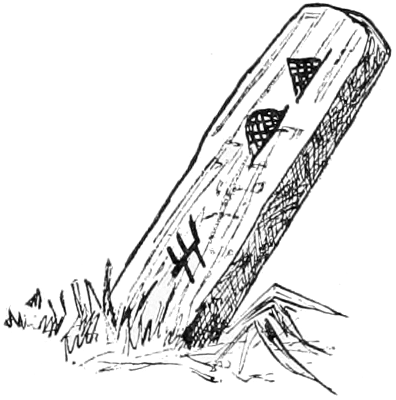
He explained Fig. 443 as follows:
Seal hunters thus inform their comrades that they have returned to the settlement. The first to return to the regular landing place sometimes sticks a piece of wood into the ground, leaning toward the village, upon which is drawn or scratched the outline of a baidarka, or skin canoe, heading toward one or more outlines of lodges, signifying that the occupants of the boat have gone toward their homes.
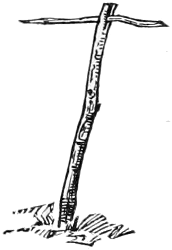
This device is used by coast natives of Southern Alaska and Kadiak. He explained Fig. 444 as follows:
When hunters become separated, the one first returning to the forks of the trail puts a piece of wood in the ground, on the top of which he makes an incision, into which a short piece of wood is secured horizontally, so as to point in the direction taken.
Maj. Long—Keating’s Long (a)—says:
When we stopped to dine, White Thunder (the Winnebago chief that accompanied me), suspecting that the rest of his party were in the neighborhood, requested a piece of paper, pen, and ink, to communicate to them the intelligence of his having come up with me. He then seated himself and drew three rude figures, which, at my request, he explained to me. The first represented my boat with a mast and flag, with three benches of oars and a helmsman. To show that we were Americans, our heads were represented by a rude cross, indicating that we wore hats. The representation of himself was a rude figure of a bear over a kind of cipher, representing a hunting ground. The second figure was designed to show that his wife was with him; the device was a boat with a squaw seated in it; over her head lines were drawn in a zigzag direction, indicating that she was the wife of White Thunder. The third was a boat with a bear sitting at the helm, showing that an Indian of that name [or of the bear gens] had been seen on his way up the river and had given intelligence where the party were. This paper he set up at the mouth of Kickapoo creek, up which the party had gone on a hunting trip.
An ingenious mode of giving intelligence is practiced at this day by the Abnaki, as reported by H. L. Masta, chief of that tribe, lately living at Pierreville, Quebec. When they are in the woods, to say “I am going to the east,” a stick is stuck in the ground pointing in that direction, Fig. 445, a. “I am not gone far,” another stick is stuck across the former, close to the ground, same figure, b. “Gone far” is the reverse, same figure, c. The number of days’ journey of proposed absence is shown by the same number of sticks across the first; thus, same figure, d, signifies five days’ journey.
Fig. 446, scratched on birch bark, was given to the present writer at Fredericton, New Brunswick, in August, 1888, by Gabriel Acquin, an Amalecite, then 66 years old, who spoke English quite well. The circumstances under which it was made and used are in the Amalecite’s words, as follows:
“When I was about 18 years old I lived at a village 11 miles above Fredericton and went with canoe and gun. I canoed down to Washademoak lake, about 40 miles below Fredericton; then took river until it became too narrow for canoe; then ‘carried’ to Buctoos river; followed down to bay of Chaleur; went up the northwest Mirimachi, and[335] ‘carried’ into the Nepisigiut. There spent the summer. On that river met a friend of my time; we camped there.
“One time while I was away my friend had gone down the river by himself and had not left any wikhe'gan for me. I had planned to go off and left for him this wikhe'gan, to tell where I would be and how long gone. The wigwam at the lower left-hand corner showed the one used by us, with the river near it. The six notches over the door of the wigwam meant that I would be gone six days. The canoe and man nearest to the wigwam referred to my friend, who had gone in the opposite direction to that I intended to travel. Next to it I was represented in my own canoe, with rain falling, to show the day I started, which was very rainy. Then the canoe carried by me by a trail through woods shows the ‘carry’ to Nictaux lake, beside which is a very big mountain. I stayed at that lake for six days, counting the outgoing and returning. As I had put the wikhe'gan in the wigwam before I started, my friend on his return understood all about me, and, counting six from and including[336] the rainy day, knew just when I was coming back, and was waiting for me.”
The chief point of interest in this notice is the ingenious mode of fixing the date of departure. The marks for rain are nearly obliterated, but it flows from the man’s hair. The topography is also delineated.
The following is extracted from James Long’s Expedition (b):
On the bank of the Platte river was a semicircular row of sixteen bison skulls, with their noses pointing down the river. Near the center of the circle which this row would describe, if continued, was another skull marked with a number of red lines.
Our interpreter informed us that this arrangement of skulls and other marks here discovered were designed to communicate the following information, namely, that the camp had been occupied by a war party of the Skeeree or Pawnee Loup Indians, who had lately come from an excursion against the Cumancias, Ietans, or some of the western tribes. The number of red lines traced on the painted skull indicated the number of the party to have been thirty-six; the position in which the skulls were placed, that they were on their return to their own country. Two small rods stuck in the ground, with a few hairs tied in two parcels to the end of each, signified that four scalps had been taken.
When a hunting party of the Hidatsa arrived at any temporary camping ground from which some of them had left on a short reconnoitering expedition, the remainder, having occasion to move, erect a pole and cause it to lean in the direction taken. At the foot of this pole a buffalo shoulder blade or other flat bone is placed, upon which is depicted the reason of departure; e. g. should buffalo or antelope be seen, the animal is drawn with a piece of charred wood or red lead.
When a Hidatsa party has gone on the warpath, and a certain number[337] is detailed to take another direction, the point of separation is taken as the rendezvous. After the return of the first party to the rendezvous, should the second not come up in a reasonable length of time, they will set sticks in the ground leaning in the direction to be taken, and notches are cut into the upper ends of the sticks to represent the number of nights spent there by the waiting party.
A party of Hidatsa who may be away from home for any purpose whatever often appoint a rendezvous, from which point they return to their respective lodges. Should one of the party return to the rendezvous before any others and wish to make a special trip, he will, for the information of the others, place a stick of about 3 or 4 feet in length in the ground, upon the upper end of which a notch is cut, or perhaps a split made for the reception of a thinner piece of twig or branch having a length of about a foot. This horizontal top piece is inserted at one end, so that the whole may point in the direction to be taken. Should he wish to say that the trail would turn at a right angle, to either side, at about half the distance of the whole journey in prospect, the horizontal branch is either bent in that direction or a naturally curved branch is selected having the turn at the middle of its entire length, thus corresponding to the turn in the trail. Any direction can be indicated by curves in the top branch.
No prescribed system of characters is used at the present time by the Ojibwa, in the indication of direction or travel. When anyone leaves camp or home for any particular hunting or berry ground, a concerted arrangement is made by which only those interested can, with any certainty, recognize “blaze” or trail marks.
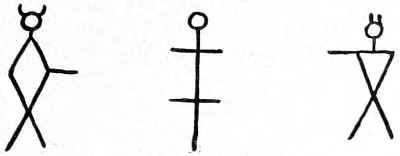
Three characters cut upon the bark of large pine trees observed in the forest near Red Lake, Minnesota, are shown in Fig. 447. The Ojibwa using such a mark will continue on a trail leading from his home, until he leaves the trail, when a conspicuous tree, or in its absence a piece of wood or bark, is selected upon which a human figure is cut, with one arm elevated and pointing in the direction to be taken. These figures measure about 18 inches in height. Those represented on the two sides of the copy were cut into the bark of a “jack pine” without coloration, and the one in the middle had been rubbed with red chalk upon the wood of the trunk after the bark had been removed and the incision made. The middle figure indicates the direction by its bearings, although the pointers are differently arranged.
Plain sticks are sometimes used by the Ojibwa to indicate direction. These vary in length according to the fancy of the person and the requirements of the case. They are stuck into the ground, and lean in the direction to which notice is invited.
When a preconcerted arrangement is made, scrolls of birch bark are used, upon which important geographic features are delineated, so that the reader can, with little difficulty, learn the course taken by the traveler. For instance, a hunter upon leaving his home, deposits there a scroll bearing marks such as appear in Fig. 448:

a is a stream to be followed to a lake b, where the hunter will erect his lodge c, during his stay. The do-dém (totem) is added, used between persons or parties communicating, to show who was the one that drew it. It is in the nature of a signature.
Fig. 449 shows a still existing use of the wikhegan between a Penobscot Indian and his nephew. It is copied from the original, incised on birch bark, by Nicholas Francis, a Penobscot, of Oldtown, Maine, which was obtained and kindly presented by Miss A. L. Alger of Boston.
Pitalo (Roaring Lion), English name, Noel Lyon, and his old uncle, aged over 70 years, went trapping for beaver in 1885 and camped at d, near Moosehead Lake h, having their supply tent at e. They visited the ponds a and b and knew there were beaver there, and set traps for them, f f. The beaver dams are also shown extending across the outlets of the streams. Noel came back from pond b one day to the[339] camping tent and found this birch-bark wikhegan made by the old uncle, who still used the pictographic method, as he does not know how to write, and by this Noel knew his uncle had gone to pond c to see if there were any beaver there and would be gone one night, the latter expressed by one line g drawn between the two arrows pointing in opposite directions, showing the going and returning on the same trail.
The notable part of the above description is that the wikhegan consisted of the chart of the geographic features before traversed by the two trappers, with the addition of new features of the country undoubtedly known to both of the Indians, but not before visited in the present expedition. This addition exhibited the departure, its intent, direction, and duration.
Sapiel Selmo, a chief of the Passamaquoddy tribe, who gave to the writer the wikhegan copied as Fig. 450, in 1887, was then a very aged man and has since died. He lived at Pleasant point, 7 miles north of Eastport, Maine. He was the son of a noted chief, Selmo Soctomah (a corruption of St. Thomas), who, as shown by a certificate exhibited, commanded 600 Passamaquoddy Indians in the Revolutionary war. When a young man Sapiel, with his father, had a temporary camp, a, at Machias Lake. He left his father and went to their permanent home at Pleasant Point, b, to get meat, and then returned to the first camp (route shown by double track) and found that his father had gone, but that he had left in the temporary wigwam the wikhegan on birch bark, showing that he had killed one moose, the meat of which Sapiel found in the snow, and that the father was going to hunt moose[340] on the other lake (East Machias lake) and would camp there three days, shown by the same number of strokes at c; so he waited for him until he came back.
Josiah Gregg (a) says of the Plains tribes:
When traveling they will also pile heaps of stones upon mounds or conspicuous points so arranged as to be understood by their passing comrades; and sometimes they set up the bleached buffalo heads, which are everywhere scattered over those plains, to indicate the direction of their march, and many other facts which may be communicated by those simple signs.
Putnam (a) gives one example of this character:
A family of five persons were killed—a tall man, a short, fat woman, and three children—at some place to the north. Five sticks were cut of various lengths. The longest being forked or split indicated the man, the thick short one the woman, and three of smaller sizes and lengths the children. They were all scalped, as is shown by the peeling of the bark. There were thirteen Indians, as we are informed by the stick with stripes and thirteen notches; and they have fled south with two prisoners, as we judge from the pointer and little strips of bark seemingly tied together. Sometimes all the intimations would be on one stick or piece of bark. A spy finding, at places well known, some of these mysterious articles, would bring them to the station, where a consultation would be held and conclusion drawn as to the meaning. A spy or hunter would intimate to his friend his want of powder or lead or other want and the place at which he would look for supplies.
Hind (a) speaks of a special form of notice by the natives of the Labrador peninsula:
To indicate their speed and direction on a march, the Nasquapees of the Labrador peninsula thrust a stick in the ground, with a tuft of grass at the top, pointing toward their line of route, and they show the rate at which they are traveling by the greater or less inclination of the stick. This mode of communicating intelligence to those who may follow is universal among Indians; but the excellent and simple contrivance for describing the speed at which they travel is not generally employed as far as I am aware, by other nations.
Mr. Charles G. Leland, in a letter, tells that the English gypsies, at a crossroad, drew the ordinary Latin cross with the long arm pointing in the direction taken. Others pulled up three bunches of grass by the roots and laid the green points in the direction. Others again, at the present time, take a small stick and set it up inclining at an angle of 45 degrees in the line of travel.
Dr. George M. Dawson (a) reports of the Shuswap people of British Columbia—
A rag of clothing, particularly a small piece or pieces of colored or other easily recognizable material from a woman’s dress, left in a forked twig, indicates that a person or party of persons has passed. If the stick stands upright, it means that the hour was noon, if inclined it may either point to the direction of the sun at the time or show the direction in which the person or party went. If it is desired to show both, a larger stick points to the position of the sun, a smaller to that of the route followed. If those for whose information the signs are left are likely to arrive after an interval of several days, a handful of fresh grass or a leafy branch may be left, from the condition of which an estimate of the time which has elapsed can be formed. Such signs are usually placed near the site of the camp fire.
The device to indicate the time of depositing the notice may be compared with that shown in Fig. 446.

Fig. 451 is a notice by Micmac scouts, which tribe was then at war with the Passamaquoddy, erected on a tree, to warn the rest of the tribe that ten Passamaquoddy Indians have been observed in canoes on the lake going toward the outlet of the lake and probably down the river. The Passamaquoddy tribal pictograph is shown and the whole topography is correctly drawn.
Notes in literature relating to the skill of the North American Indians in delineating geographic features are very frequent. The following are selected for reference:
Champlain (c), in 1605, described how the natives on the coast drew with charcoal its bays, capes, and the mouths of rivers with such accuracy that Massachusetts bay and Merrimack river have been identified.
Lafitau (d) says of the northeastern tribes of Indians—
Ils tracent grossierement sur des écorces, on sur le sable, des Cartes exactes, et ausquelles il ne manque que la distinction des degrés. Ils conservent même de ces sortes de Cartes Geographiques dans leur Trésor public, pour les consulter dans le besoin.
Sir Alexander Mackenzie, (a) in 1793, spoke of the skilled manner of chart-making by an Athabascan tribe, in which the Columbia river was drawn.
An interesting facsimile of a map with which the treaty of Hopewell, in 1875, made by the Cherokees, is connected, appears in American State Papers, Indian Affairs, I, 40.
Hind (b) writes:
On lake Tash-ner-nus-kow, Labrador, was found a “letter” stuck in a cleft pole overhanging the bank. It was written on birchbark, and consisted of a small map of the country, with arrows showing the direction the writer had taken, some crosses indicating where he had camped, and a large cross to show where he intended to make his first winter quarters. It was probably written by some Nasquapees as a guide to others who might be passing up the river or hunting in the country.
The Tegua Pueblos, of New Mexico, “traced upon the ground a sketch of their country, with the names and locations of the pueblos occupied in New Mexico,” a copy of which, “somewhat improved,” is given by Lieut. Whipple (c).
A Yuma map of the Colorado river, with the names and locations of tribes within its valley, is also figured in the last mentioned volume, page 19. The map was originally traced upon the ground.
A Piute map of the Colorado river, which was obtained by Lieut. Whipple, is also figured in the same connection.
Lean-Wolf, of the Hidatsa, who drew the picture of which Fig. 452 is a copy, made a trip on foot from Fort Berthold to Fort Buford, Dakota, to steal a horse from the Dakotas encamped there. The returning horse tracks show that he was successful and that he rode home. The following is his explanation of the characters:
Lean-Wolf is represented at a by the head only of a man to which is attached the outline of a wolf; b, Hidatsa earth lodges, circular in form, the spots representing the pillars supporting the roof—Indian village at Fort Berthold, Dakota; c, human footprints, the course taken by the recorder; d, the Government buildings at Fort Buford (square); e, several Hidatsa lodges (round), the occupants of which had intermarried with the Dakotas; f, Dakota lodges; g, a small square—a white man’s house—with a cross marked upon it to represent a Dakota lodge, which denotes that the owner, a white man, had married a Dakota woman, who dwelt there; h, horse tracks returning to Fort Berthold; i, the Missouri river; j, Tule creek; k, Little Knife river; l, White Earth river; m, Muddy creek; n, Yellowstone river; o, Little Missouri river; p, Dancing Beard creek.
The following illustration, Fig. 453, is the chart of the field of a battle between Ojibwas and Sioux with its description. The illustration, made by Ojibwa, the old Indian elsewhere mentioned, was drawn on birch bark, while the details of the description were oral. The locality referred to is above the mouth of Crow river, near Sauk rapids, Minnesota.
In the description a is the Mississippi river; b, Crow river; c, branch of Crow river; d, e, f, Crow lakes; g, Rice lake; h, Clear Water lake; i, Clear Water river; j, Sauk river; k, Big Sauk lake; l, Big prairie lake; m, Osakis lake; n, Sauk rapids; o and p, canoe and deer-hunting and fishing grounds; q, 1 man and 2 women killed (Ojibwas); r, Sauk Center; s, copses of timber—known as timber islands—on the prairie.
The chart refers to an episode of war in 1854, when 3 Ojibwa were pursued by 50 Dakota. Many of the lakes appear to be duplicated in name, simply because no special name for them was known.
Dr. Hoffman tells how at Grapevine springs, Nevada, in 1871, the Paiute living at that locality informed the party of the relative position of Las Vegas, the objective point. The Indian sat upon the sand and with his hands formed an oblong ridge to represent Spring mountain, and southeast of this ridge another gradual slope, terminating on the eastern side more abruptly; over the latter he passed his fingers to represent the side valleys running eastward. He then took a stick and showed the direction of the old Spanish trail running east and west over the lower portion of the last-named ridge. When this was completed, with a mixture of English, Spanish, Paiute, and gesture signs, he told that from where they were now they would have to go southward east of Spring mountain to the camp of Paiute Charlie, where they would have to sleep; then indicated a line southeastward to another spring (Stump’s) to complete the second day; then he followed the line representing the Spanish trail to the east of the divide of the second ridge above named, where he left it, and passing northward to the first valley he thrust the short stick into the ground and said, “Las Vegas.”
Mr. W. von Streeruwitz, of the Geological Survey of Texas, contributes[344] the copy of a map, evidently the work of Indians, which is received too late for reproduction. The map is roughly scratched into the flat surface of a large granite block, and is an approximately correct sketch of a pass and the nearest surrounding. The rock is situated in the pass above the so-called rattlesnake or mica tank, in a spur on the west side of the Van Horn mountains, El Paso county, Texas. An Indian trail passes near the very rough and weathered rear part of the rock, which on this side shows weak traces of some scratched-in drawings, which are nearly weathered off, made no doubt with the purpose to lead the attention of passing parties to the other side of the rock upon which the map is drawn. An old trail leads from the Rio Grande across the Eagle mountains to this pass and in the shortest line from the Green river valley to the northern main range of the Van Horn and from there east to the Davis mountains, formerly Apache mountains, and thence through the southern extension of the Guadeloupe mountains to this range and into New Mexico; also through the Sierra Carrizo to the Sierra Diablo; so that this trail must be regarded as one of the best warpaths for raids across the Rio Grande. An arrowhead at the upper end of the trail points out water (small or doubtful supply), as far as could be ascertained from drawings made by Apaches.
Following are modes of exhibiting pictographically topographic features, Fig. 454:
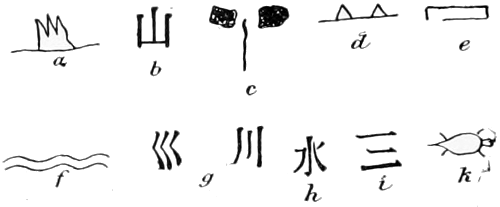
a, from Copway’s Ojibway Nation, p. 136, represents “mountains.”
b is the Chinese character for “mountain,” from Edkins, p. 14. “A picture of the object. More anciently, two upright cones or triangles connected at their bases.”
c is the representation by the Dakotas of a gap in the mountains, taken from Red-Cloud’s census.
d, from Copway, p. 135, represents “islands.”
e, from the same, p. 134, is a representation of the character for “sea” or “water,” probably a large body of water, e. g., lake, such as the Ojibwa were familiar with.
f is from the same authority, p. 134. It shows the character for “river” or “stream.”
g gives two Chinese characters for “river,” “stream,” from Edkins, p. 14. Three parallel lines drawn downward express “flowing” in all cases.
h is the Chinese character for “flowing water,” from Edkins, p. 23. “In the Chwen wen three strokes descending indicate the appearance of flowing water as seen in a river. The two outside strokes are broken in the middle.”
The same authority, p. 155, gives another character, i, with the same meaning as the last. The author says: “It is supposed to be turned on end. It is better to regard the old form with its three descending lines as a picture of water flowing downward.”
k, from Copway (a), represents the character for “land.” It is a turtle,[346] and refers to a common cosmologic myth concerning the recovery of land after the deluge.
G. Holm (a) gives the following account, translated and condensed, descriptive of Fig. 455, a wooden map made by the natives of the east coast of Greenland:
In reference to map making I will only remark that many are inclined to enlarge the scale as they approach the better known places, which in fact is quite natural, as they would not otherwise find room for all details. As a natural result, map drawing in the form of ground plat is something quite new to them. Their mode of representing their land is by carving it on wood. This has the advantage that not only the contour of the land, but also its appearance and rock forms, can in a certain degree be represented.
The block of wood brought back represents the tract between Kangerdluarsikajik, east of Sermiligak, and Sieralik, north of Kangerdlugsuatsiak. The mainland continues from one side of the wooden block to the other, while the islands are located on the accompanying block without regard to the distance between them in reference to the mainland. All places where there are old ruins of houses, and therefore good storage places, are marked on the wood map, which also shows the points where a kayak can be carried over the ground between two fiords when the sea ice blocks the headland outside. This kind of models serves to represent the route the person in question has followed, inasmuch as during his recital he moves the stick, so that the islands are shown in their relative positions. The other wooden map, which was prepared by request, represents the peninsula between Sermiligak and Kangerdluarsikajik.
A and B represent the tract between Kangerdluarsikajik (immediately east of Sermiligak) and Sieralik (slightly north of Kangerdlugsuatsiak). B represents the coast of the mainland, and is continuous from one side of the block to the other, while the outlying islands are represented by the wooden block of A, on which the connecting pieces between the various islands must be imagined as being left out. While the narrator explains the map he moves the stick to and fro, so as to get the islands into the right position in reference to the mainland.
Kunit explained the map to me. The names of the islands on A are: a, Sardlermiut, on the west side of which is the site of an old settlement; b, Nepinerkit (from napavok), having the shape of a pyramid; c, Ananak, having the site of an old settlement on the southwest point. (Note.—Others give the name Ananak to the cape on the mainland directly opposite, calling the island Kajartalik.) d, Aputitek; e, Itivdlersuak; f, Kujutilik; g, Sikivitik.
For B I obtained the following names, beginning at the north, as in the case of the islands: h, Itivdlek, where there are remains of a house; i, Sierak, a small fiord, in which salmon are found; k, Sarkarmiut, where there are remains of a house; l, Kangerdlugsuatsiak, a fiord of such length that a kayak can not even in a whole day row from the mouth to the head of the fiord and back again; m, Erserisek, a little fiord; n, Nutugat, a little fiord with a creek at the bottom; o, Merkeriak, kayak portage from Nutugkat to Erserisek along the bank of the creek, when the heavy ice blocks the headland between the two fiords; p, Ikerasakitek, a bay in which the land ice goes straight out to the sea; q, Kangerajikajik, a cape; r, Kavdlunak, a bay into which runs a creek; s, Apusinek, a long stretch where the land ice passes out into the sea; t, Tatorisik; u, Iliartalik, a fiord with a smaller creek; v, Nuerniakat; x, Kugpat; y, Igdluarsik; z, Sangmilek, a little fiord with a creek; aa, Nutugkat; bb, Amagat; cc, Kangerdluarsikajik, a smaller fiord; dd, Kernertuarsik.
C represents the peninsula between the fiords Sermiligak and Kangerdluarsikajik.
In the curious manuscript of Gideon Lincecum, written with Roman characters in the Choctaw language about 1818, and referring to the ancient customs of that tribe, appears the following passage (p. 276):
They had a significant and very ingenious method of marking the stakes so that each iksa could know its place as soon as they saw the stake that had been set up for them. Every clan had a name, which was known to all the rest. It was a species of heraldry, each iksa having its coat of arms. The iksas all took the name of some animal—buffalo, panther, dog, terrapin, any race of animals—and a little picture of whatever it might be, sketched on a blazed tree or stake, indicated the clan to which it belonged. They could mark a tree when they were about to leave a camp, in their traveling or hunting excursions, with a set of hieroglyphs, that any other set of hunters or travelers who might pass that way could read, telling what iksa they belonged to, how long they had remained at that camp, how many there were in the company, if any were sick or dead, and if they had been successful or otherwise in the hunt. Thus, drawn very neatly on a peeled tree near the camp, a terrapin; five men marching in a row, with bows ready strung in their hands, large packs on their backs, and one man behind, no pack, bow unstrung; one circle, half circle, and six short marks in front of the half circle; below, a bear’s head, a buffalo head, and the head of an antelope. The reading is, “Terrapin iksa, 6 men in company, one sick; successful hunt in killing bear, buffalo, and antelope; that they remained at the camp a moon and a half and six days, and that they have gone home.”
Among the Abnaki of the Province of Quebec, as reported by Masta, their chief, cutting the bark off from a tree on one, two, three, or four sides near the butt means “Have had poor, poorer, poorest luck.” Cutting it off all around the tree means “I am starving.” Smoking a piece of birch bark and hanging it on a tree means “I am sick.”
Tanner’s Narrative (c) mentions regarding the Ojibwa that, in cases where the information to be communicated is that the party mentioned is starving, the figure of a man is sometimes drawn, and his mouth is painted white, or white paint may be smeared about the mouth of the animal, if it happens to be one, which is his totem.
Fig. 456 is a copy of a drawing incised on birch bark by the old Passamaquoddy chief, Sapiel Selmo, who made comments upon it as follows: Two hunters followed the river a until it branches off b, c. Indian d takes one river and its lakes and small branches, and the other hunter (not figured in the chart) follows the other branch and also claims its small streams and lakes. Sometimes during the winter they visit one another. If it happen that the other hunter was away from his wigwam e and if the visiting hunter wishes to leave word with his friend and wishes to inform him of his luck, he makes a picture on a piece of birch bark and describes such animals he has killed with the number of animals as seen in f and g (figure of moose’s head) which, with two crosses to each, means 20 moose. He killed in each hunt altogether 40. h is a whole moose, also with two crosses, and means 20, and also the figure of a caribou i with one cross means 10 caribou,[348] and also a figure of a bear with four crosses j means 40 bears, and k shows a figure of bear with one cross which means 10 bears, and also a sable l with five crosses means 50 sables. If he wish to inform him he is in poor luck and hungry, he marked a figure of an Indian with a pot on one hand, the pot upside down; this means hunger. A figure of an Indian in lying position means sickness.
Fig. 457 was also incised on birch bark by Sapiel Selmo and described by him.
Two Indian hunters follow the river to hunt. They go together as far as the river’s forks and then separate. One went to the river c. The other follows river e and kills a moose. They both build their winter wigwams.
Indian b went to hunt and found a bear’s den under the foot of a big tree. He attempted to stab the bear, but missed the vital part. The bear got hold of him, bit him severely, and mortally wounded him. He went to his wigwam h and thinks he is going to die, so he makes his mark or wikhegan on a birch-bark. He makes notches j on the bark to mean his tracks and also marks a tree as in f and also a bear as in g. His friend d came to visit him and found him lying dead in his wigwam, and also found the marks on the piece of birch-bark, which he read and knew at once his partner was killed by the bear, and he followed his bear tracks, and he also found the bear dead.
a. Main river. b. One of the Indians who goes up c, branch of river.[349] d. The other Indian who goes on e, another branch of river. f. Tree above the bear’s den. g. Bear. h. Wigwam of Indian b. i. Moose which Indian d killed. j. Tracks of Indian b. k. Bear’s den under the tree. l. Indian d’s wigwam.
Fig. 458 originally scraped on birch bark tells its own story, but was described by Sapiel Selmo, who drew it, thus:
Two Indian hunters, b and c, went to hunt and follow river, a. They continued together as far as d, where the river branches off. Indian c follows the east branch e. He went as far as lake f, where he built his wigwam g. Indian c is very unlucky; he doesn’t kill any bears or moose, so he became very hungry. Indian b, who had followed the north branch and built his wigwam, l, near lake k, went to visit Indian c, who was away at the time, but b found mark on the birch bark, a pot upside down, h; this means hunger. He also makes his own mark, i, a moose’s head, showing success. He appoints lake j, where he killed moose, and wants him, c, to come to his, b’s, wigwam l.
o, lower lake, not connected with the story, but doubtless drawn[350] to complete the topography. The two trails, m and n, are designated by notches showing foot-path or snow-shoe tracks. The Abnaki have footpaths or snow-shoe tracks where the line of kelhign sisel, or sable dead falls, extends from one hunting camp to another, between two lakes or rivers.
The Ottawa and the Pottawatomi Indians indicate hunger and starvation by drawing a black line across the breast or stomach of the figure of a man. (See Fig. 1046.) This drawing is either incised upon a piece of wood, or drawn on it with a mixture of powdered charcoal and glue water, or red ocher. The piece of wood is then attached to a tree or fastened to a pole, and erected near the lodge on a trail, where it will be observed by passers by, who are thus besought to come to the rescue of the sufferer who erected the notice.
Fig. 459 illustrates information with regard to distress in another village, which occasioned the departure of the party giving the notification. The drawing was made in 1882 by the Alaskan, Naumoff, in imitation of drawings used at his home. The designs are traced upon[351] a strip of wood, which is then stuck upon the roof of the house belonging to the draftsman.

a, the summer habitation, showing a stick leaning in the direction to be taken; b, the baidarka, containing the residents of the house; the first person is observed pointing forward, indicating that they “go by boat to the other settlement”; c, a grave stick, indicating a death in the settlement; d, e, summer and winter habitations, denoting a village.
The drawing, Fig. 460, also made in 1882, by a native Alaskan, in imitation of originals familiar to him in Alaska, is intended to be placed in a conspicuous portion of a settlement which has been attacked by a hostile force and finally deserted. The last one to leave prepares the drawing upon a strip of wood to inform friends of the resort of the survivors.

a represents three hills or ranges, signifying that the course taken would carry them beyond that number of hills or mountains; b, the draftsman, indicating the direction, with the left hand pointing to the ground, one hill, and the right hand indicating the number two, the number still to be crossed; c, a circular piece of wood or leather, with the representation of a face, placed upon a pole and facing the direction to be taken from the settlement; in this instance the drawing of the character denotes a hostile attack upon the town, for which misfortune such devices are sometimes erected; d, e, winter and summer habitations; f, storehouse, erected upon upright poles. The latter device is used by Alaskan coast natives generally.
The design shown in Fig. 461 is in imitation of drawings made by natives of Southern Alaska to convey to the observer the information that the draftsman had gone away to another settlement, the inhabitants of which were in distress. The drawings were made on a strip of wood which was placed at the door of the house, where it might be seen by visitors or inquirers.

Naumoff gave the following explanation: a, a native making the gesture of indicating self with the right hand and with the left indicating direction of going; b, the native’s habitation; c, scaffold used for drying fish; upon the top of a pole is placed a piece of wood tied so that the longest end points in the direction to be taken by the relief party; d, the baidarka conveying it; e, a native of the settlement to be visited; f, summer habitation; g, “shaman stick,” or grave stick, erected to the memory of a recently deceased person, the cause which has necessitated the journey; h, winter habitation. This, together with f, indicates a settlement.
Fig. 462, also drawn by Naumoff, means “ammunition wanted.”
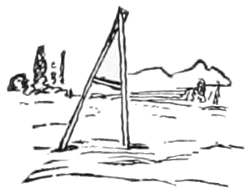
When a hunter is tracking game and exhausts his ammunition, he returns to the nearest and most conspicuous part of the trail and sticks his ihúnŭk in the ground, the top leaning in the direction taken. The ihúnŭk is the pair of sticks arranged like the letter A, used as a gun-rest. This method of transmitting the request to the first passer is resorted to by the coast people of Southern Alaska.
Fig. 463, also drawn by Naumoff, means “discovery of bear; assistance wanted.”
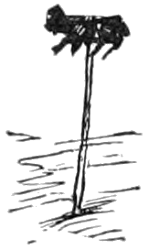
When a hunter discovers a bear and requires assistance, he ties together a bunch of grass, or other fibrous matter, in the form of the animal and places it upon a long stick or pole which is erected at a conspicuous point. The head of the effigy is directed toward the locality where the animal was last seen.
This device is used by most of the Alaskan Indians.
Fig. 464 was also drawn by Naumoff, and signifies “starving hunters.”
Hunters who have been unfortunate, and are suffering from hunger, scratch or draw on a piece of wood characters similar to those figured, and place the lower end of the stick in the ground on the trail where there is the greatest chance of its discovery. The stick is inclined toward their shelter. The following are the details of the information contained in the drawing:

a, A horizontal line denoting a canoe, showing the persons to be fishermen; b, a man with both arms extended signifying nothing, corresponding with the gesture for negation; c, a person with the right hand to the mouth, signifying to eat, the left hand pointing to the house occupied by the hunters; d, the shelter.
The whole signifies that there is nothing to eat in the house. This is used by natives of Southern Alaska.

Fig. 465, with the same signification and from the same hand, is similar to the preceding in general design. This is placed in the ground near the landing place of the canoemen, so that the top points toward the lodge. The following is the explanation of the characters:
a, Baidarka, showing double projections at bow, as well as the two men, owners, in the boat; b, a man making the gesture for nothing (see in this connection Fig. 983); c, gesture drawn, denoting to eat, with the right hand, while the left points to the lodge; d, a winter habitation.
This is used by the Alaskan coast natives.
The following description of an Ojibwa notice of a murderer’s being at large is extracted from Tanner’s Narrative: (d).
As I was one morning passing one of our usual encamping places I saw on shore a little stick standing in the bank and attached to the top of it a piece of birchbark. On examination I found the mark of a rattlesnake with a knife, the handle touching the snake and the point sticking into a bear, the head of the latter being down. Near the rattlesnake was the mark of a beaver, one of its dugs, it being a female, touching the snake. This was left for my information, and I learned from it that Wa-me-gon-a-biew, whose totem was She-she-gwah, the rattlesnake, had killed a man whose totem was Muk-kwah, the bear. The murderer could be no other than Wa-me-gon-a-biew, as it was specified that he was the son of a woman whose totem was the beaver, and this I knew could be no other than Net-no-kwa.
An amusing instance of the notice or warning, “No thoroughfare,” is presented in Fig. 466. It was taken in 1880 from a rock drawing in Canyon de Chelly, New Mexico, by Mr. J. K. Hillers, photographer of the U. S. Geological Survey.
The design on the left is undoubtedly a notice in the nature of warning, that, although a goat can climb up the rocky trail, a horse would tumble down.
During his connection with the geographic surveys west of the one hundredth meridian, Dr. Hoffman observed a practice among the Tivátikai Shoshoni, of Nevada, of erecting heaps of stones along or near trails to indicate the direction to be taken and followed to reach springs[354] of water. Upon slight elevations of ground, or at points where a trail branched into two or more directions, or at the intersection of two trails, a heap of stones would be placed varying in height according to the elevation requisite to attract attention. Upon the top of this would be fixed an elongated piece of rock so placed that the most conspicuous point projected and pointed in the course to be followed. This was continued sometimes at intervals of several miles unless indistinct portions of a trail or intersections demanded a repetition at shorter distances. A knowledge of this custom proved very beneficial to the early prospectors and pioneers.
Fig. 467 is a copy, one-sixteenth actual size, of colored petroglyphs found by Dr. Hoffman in 1884 on the North fork of the San Gabriel river, also known as the Azuza canyon, Los Angeles county, California.
The bowlder upon which the paintings occur measures 8 feet long, about 4 feet high, and the same in width. The figures are on the eastern side of the rock, so that the left arm of the human figure on the right points toward the north.
Fig. 468 is a map drawn on a scale of 1,000 yards to the inch, showing the topography of the immediate vicinity and the relative positions of the rocks bearing the paintings.
The stream is hemmed in by precipitous mountains, with the exception of two points marked c c, over which the old Indian trail passed in going from the Mojave desert on the north to the San Gabriel valley below, this course being the nearest for reaching the mission settlements at San Gabriel and Los Angeles. In attempting to follow the water course the distance would be greatly increased and a rougher trail encountered. Fig. 467, painted on the rock marked b on the map, shows characters in pale yellow upon a bowlder of almost white granite partly obliterated by weathering and annual floods, though still enough remains to indicate that the right-hand figure is directing the observer to the northeast, although upon taking that course it would be necessary to round the point a short distance to the west. It may have been[356] placed as a notification of direction to those Indians who might have come up the canyon instead of on the regular trail. Farther west, at the spot marked a on the map, is a granite bowlder bearing a large number of paintings, part of which have become almost obliterated. These were drawn with red ocher (ferric oxide). A selection of these is shown in Fig. 469.
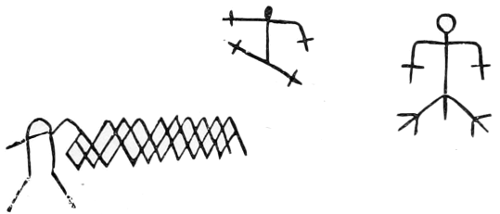
This is on the almost vertical western face of the rock. These characters also appear to refer to the course of the trail, which might readily be lost on account of the numerous mountain ridges and spurs. The left-hand human figure appears to place its hand upon a series of ridges, as if showing pantomimically the rough and ridged country over the mountains.
The middle figure is making a gesture which in its present connection may indicate direction of the trail, i. e., toward the left, or northward in an uphill course, as indicated by the arm and leg, and southward, or downward, as suggested by the lower inclination of the leg and lower forearm and hand on the right of the painting.
These illustrations, as well as other pictographs on the same rock, not now represented, exhibit remarkable resemblance to the general type of Shoshonean drawing, and from such evidence as is now attainable it is probable that they are of Chemehuevi origin, as that tribe at one time ranged far to the west, though north of the mountains, and also visited the valley and settlements at Los Angeles to trade. It is also known that the Mojaves came at stated periods to Los Angeles as late as 1845, and the trail indicated at point a of the map would appear to have been their most practicable and convenient route. There is strong evidence that the Moki sometimes visited the Pacific coast and might readily have taken this same course, marking the important portions of the route by drawings in the nature of guideboards.
The following curious account is taken from The Redman, Carlisle, October, 1888:
A ranchman visiting a deserted camp of Piegans found the following notice:
We called at this ranch at dinner time. They treated us badly, giving us no dinner and sending us away. There is a head man who has two dogs, one of which has no tail. There are two larger men who are laborers. They have two pairs of large horses and two large colts, also another smaller pair of horses and two ponies which have two colts.
The notice was composed thus: A circle of round stones represented the horses and ponies, the latter being smaller stones; the stones outside of the circle meant there were so many colts. Near the center was a long narrow stone, upon the end of which was a small one. This denoted the head man or owner, whose two dogs were shown by two pieces of bark, one with a square end while the other had a twig stuck in for a tail. Two other long narrow stones, larger than the first, stood for the laborers; these had no small stones on them. Some sticks of wood, upon which was a small pile of buffalo chips, meant that dinner was ready; and empty shells turned upside down told they got nothing to eat, but were sent away.
Mr. Charles W. Cunningham, formerly of Phœnix, Arizona, reports[357] the finding of petroglyphs in Rowe canyon, one-half mile from the base of Bradshaw mountain, Arizona. The characters are pecked upon its vertical wall of hard porphyry, covering a space between 12 or 15 feet in length and about 30 feet above the surface of the earth. They consist of human figures with outstretched arms, apparently driving animals resembling sheep or goats, while at the head of the procession appears the figure of a bear. The explanation given seems to be a notification to Indian herders that in going through the canyon they should be careful to guard against bears or possibly other dangerous animals, as the trail or canyon leads down to some water tanks where the herders may habitually have driven the stock.
D’Albertis (b) mentions of the Papuans that a warning not to enter a dwelling is made by erecting outside of it a stick, on the top of which is a piece of bark or a cocoanut, and in Yule island these warnings or taboo sticks are furnished with stone heads.
When a Tartar shaman wished to be undisturbed he placed a dried goat’s-head, with its prominent horns, over a wooden peg outside of his tent and then dropped the curtain. No one would dare to venture in.
The following is quoted from Franz Keller (b):
In the immense primeval forests, extending between the Ivahy and the Paranapanama, the Paraná and the Tibagy, the rich hunting grounds of numerous Coroado hordes, one frequently encounters, chiefly near forsaken palm sheds, a strange collection of objects hung up between the trees on thin cords or cipós, such as little pieces of wood, feathers, bones, and the claws and jaws of different animals.
In the opinion of those well versed in Indian lore these hieroglyphs are designed as epistles to other members of the tribe regarding the produce of the chase, the number and stay of the huntsmen, domestic intelligence, and the like; but this strange kind of composition, reminding one of the quippus (knotted cords), of the old Peruvians, has not yet been quite unraveled, though it is desirable that it should be, for the naïve son of the woods also uses it sometimes in his intercourse with the white man.
Settlers in this country, on going in the morning to look after their very primitive mills near their cottages, have frequently discovered them going bravely, but bruising pebbles instead of the maize grains, while on the floor of the open shed names and purposes of the unwelcome nocturnal visitors have been legibly written in the sand. Among the well-drawn zigzag lines were inserted the magnificent long tail feathers of the red and blue macaw, which are generally used by the Coroados for their arrows; and, as these are the symbols of war and night attacks, the whole was probably meant for a warning and admonition ad hominem: “Take up your bundle and go or beware of our arrows.”
Under this heading notes and illustrations are grouped of transmitted drawings, which were employed as letters and missives now are by people who possess the art of writing. To the drawings are added some descriptions of objects sent for the same purposes. These are sometimes obviously ideographic, but often appear to be conventional or arbitrary. It is probable that the transmittal or exchange of such objects anteceded the pictorial attempt at correspondence, so that the former should be considered in connection with the latter. The topic is conveniently divided by the purposes of the communications, viz, (1) declaration of war, (2) profession of peace and friendship, (3) challenge, (4) social and religious missives, (5) claim or demand.
Le Page du Pratz (a), in 1718, reported the following:
The Natchez make a declaration of war by leaving a hieroglyphic picture against a tree in the enemy’s country, and in front of the picture they place, saltierwise, two red arrows. At the upper part of the picture at the right is the hieroglyphic sign which designates the nation that declares war; next, a naked man, easy to recognize, who has a casse-tête in his hand. Following is an arrow, drawn so as in its flight to pierce a woman, who flees with her hair spread out and flowing in the air. Immediately in front of this woman is a sign belonging to the nation against which war is declared; all this is on the same line. That which is below is not so clear or so much relied upon in the interpretation. This line begins with the sign of a moon (i. e., month) which will follow in a short time. The days that come afterward are indicated by straight strokes and the moon by a face without rays. There is also a man who has in front of him many arrows which seem directed to hit a woman who is in flight. All that announces that when the moon will be so many days old they will come in great numbers to attack the designated nation.
Lahontan (a) writes:
The way of declaring war by the Canadian Algonquian Indians is this: They send back to the nation that they have a mind to quarrel with a slave of the same country, with orders to carry to the village of his own nation an axe, the handle of which is painted red and black.
The Huron-Iroquois of Canada sent a belt of black wampum as a declaration of war.
Material objects were often employed in declaration of war, some of which may assist in the interpretation of pictographs. A few instances are mentioned:
Capt. Laudonnière (a) says: “Arrows, to which long hairs are attached, were stuck up along the trail or road by the Florida Indians, in 1565, to signify a declaration of war.”
Dr. Georg. Schweinfurth (a) gives the following:
I may here allude to the remarkable symbolism by which war was declared against us on the frontiers of Wando’s territory. * * * Close on the path, and in full view of every passenger, three objects were suspended from the branch of a tree, viz, an ear of maize, the feather of a fowl, and an arrow. * * * Our guides readily comprehended and as readily explained the meaning of the emblems, which were designed to signify that whoever touched an ear of maize or laid his grasp upon a single fowl would assuredly be the victim of the arrow.
In the Notes on Eastern Equatorial Africa, by MM. V. Jacques (a) and É. Storms, it is stated that when a chief wishes to declare war he sends to the chief against whom he has a complaint an ambassador bearing a leaden bullet and a hoe. If the latter chooses the bullet, war ensues; if the hoe, it means that he consents to enter into negotiations to maintain peace.
Terrien de Lacouperie, op. cit., pp. 420, 421, reports:
The following instance in Tibeto-China is of a mixed character. The use of material objects is combined with that of notched sticks. When the Li-su are minded to rebel they send to the Moso chief (who rules them on behalf of the Chinese Government) what the Chinese call a muhki and the Tibetans a shing-tchram. It is a stick with knife-cut notches. Some symbols are fastened to it, such, for instance, as a feather, calcined wood, a little fish, etc. The bearer must explain the meaning of the notches and symbols. The notches may indicate the number of hundreds or thousands of soldiers who are coming; the feather shows that they arrive with the swiftness of a bird; the burnt wood, that they will set fire to everything on their way; the fish, that they will throw everybody into the water, etc. This custom is largely used among all the savage tribes of the region. It is also the usual manner in which chiefs transmit their orders.
The following account of pictorial correspondence leading to peace was written by Governor Lewis Cass, while on one of his numerous missions to the Western tribes, before 1820:
Some years before, mutually weary of hostilities, the chiefs of the Ojibwas and the Dakotas met and agreed upon a truce. But the Sioux, disregarding the solemn contract which they had formed, and actuated by some sudden impulse, attacked the Ojibwas and murdered a number of them.
On our arrival at Sandy lake I proposed to the Ojibwa chiefs that a deputation should accompany us to the mouth of the St. Peters, with a view to establish a permanent peace between them and the Sioux. The Ojibwas readily acceded to this, and ten of their principal men descended the Mississippi with us. The computed distance from Sandy lake to the St. Peters is 600 miles. As we neared this part of the country we found our Ojibway friends cautious and observing.
The Ojibwa landed occasionally to examine whether any of the Sioux had recently visited that quarter. In one of these excursions an Ojibwa found in a conspicuous place a piece of birch bark, made flat by fastening between two sticks at each end, and about 18 inches long by 2 broad.
This bark contained the answer of the Sioux nation. So sanguinary had been the contest between these two tribes that no personal communication could take place. Neither the sanctity of office nor the importance of the message could protect the ambassador of either party from the vengeance of the other.
Some time preceding, the Ojibwas, anxious for peace, had sent a number of their young men into these plains with a similar piece of bark, upon which they represented their desire. This bark had been left hanging to a tree, in an exposed situation, and had been found and taken away by a party of Sioux.
The proposition had been examined and discussed in the Sioux villages, and the bark contained their answer. The Ojibwa explained to us with great facility the intention of the Sioux.
The junction of the St. Peters with the Mississippi, where the principal part of the Sioux reside, was represented, and also the American fort, with a sentinel on duty, and a flag flying.
The principal Sioux chief was named The-Six, alluding, I believe, to the band of villages under his influence. To show that he was not present at the deliberation upon the subject of peace, he was represented on a smaller piece of bark, which was attached to the other. To identify him, he was drawn with six heads and a large medal. Another Sioux chief stood in the foreground, holding a pipe in his right hand and his weapons in his left. Even we could not misunderstand that; like our own eagle with the olive branch and arrows, he was desirous for peace, but prepared for war.
The Sioux party contained fifty-nine warriors, indicated by fifty-nine guns, drawn upon one corner of the bark.
The encampment of our troops had been removed from the low grounds upon the St. Peters to a high hill upon the Mississippi. Two forts were therefore drawn upon the bark, and the solution was not discovered until our arrival at St. Peters.
The effect of the discovery of the bark upon the minds of the Ojibwas was visible and immediate.
The Ojibwa bark was drawn in the same general manner, and Sandy lake, the principal place of their residence, was represented with much accuracy. To remove any doubts respecting it, a view was given of the old northwestern establishment, situated upon the shore, and now in the possession of the American Fur Company.
No proportion was preserved in their attempt at delineation. One mile of the Mississippi, including the mouth of the St. Peters, occupied as much space as the whole distance to Sandy Lake, nor was there anything to show that one part was nearer to the spectator than another.
The above pictorially professed attitude of being ready for either peace or war may be compared with the account in Champlain—Voyages (d)—of the chief whose name was Mariston, but he assumed that of Mahigan Atticq, translated as Wolf Deer. He thereby proclaimed that when at peace he was mild as a deer, but when at war was savage as a wolf.
In Davis’ Conquest of New Mexico (a) it is stated that Vargas’ Expedition in 1694 was met by the Utes, who hoisted a deerskin in token of peace.
The following “speech of an Ojibwa chief in negotiating a peace with the Sioux, 1806,” from Maj. Pike’s (a) Expeditions, etc., shows the pictographic use of the pipe as a profession of peace:
My father, tell the Sioux on the upper part of the river St. Peters that they mark trees with the figure of a calumet; that we of Red lake who may go that way should we see them, that we may make peace with them, being assured of their pacific disposition when we shall see the calumet marked on the trees.
D’Iberville, in 1699, as printed in Margry, IV, 153, said that the Indians met by him near the mouth of the Mississippi river indicated their peaceful and friendly purposes by holding up in the air a small stick of whitened wood. The same authority, in the same volume, p. 175, tells that the Oumas bore a white cross as a similar declaration; and another journal, in the same volume, p. 239, describes a stick also so borne as being fashioned like a pipe. The actual use of the pipe in profession of peace and friendship is mentioned in several parts of the present paper. See, also, the passport mentioned on p. 214 and wampum, p. 225.
Lieut. Col. Woodthorpe, in Jour. Anthr. Inst. Gr. Br. and I., XI, p. 211, says of the wild tribes of the Naga Hills, on the northeastern frontier of India:
On the road to Niao we saw on the ground a curious mud figure of a man in slight relief presenting a gong in the direction of Senua. This was supposed to show that the Niao men were willing to come to terms with Senua, then at war with Niao. Another mode of evincing a desire to turn away the wrath of an approaching enemy and induce him to open negotiations is to tie up in his path a couple of goats, sometimes also a gong, with the universal symbol of peace, a palm leaf planted in the ground hard by.
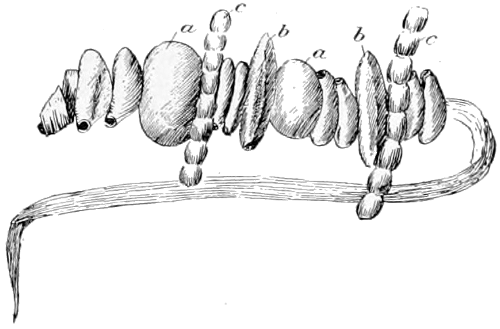
G. W. Bloxam (a) gives the following description of Fig. 470:
It represents a message of peace and good news from the King of Jebu to the King of Lagos, after his restoration to the throne on the 28th of December, 1851. It appears complicated, but the interpretation is simple enough. First we find eight cowries arranged in pairs, and signifying the people in the four corners of the world, and it will be observed that, while three of the pairs are arranged with their faces upwards, the fourth and uppermost, i. e., the pair in the most important position, are facing one another, thus signifying that the correspondents, or the people of Jebu and Lagos, are animated by friendly feeling towards each other; so, too, there are two each of all the other objects, meaning, “you and I,” “we two.” The two large seeds or warres, a, a, express a wish that “you and I” should play together as intimate friends do, at the game of “warre,” in which these seeds are used and which is the common game of the country, holding very much the same position as chess or draughts with us; the two flat seeds, b, b, are seeds of a sweet fruit called “osan,” the name of which is derived from the verb, “san,” to please [Mem. Notice the rebus] they, therefore, indicate a desire on the part of a sender of the message to please and to be pleased; lastly, the two pieces of spice, c, c, signify mutual trust. The following is the full meaning of the hieroglyphic:
Of all the people by which the four corners of the world are inhabited, the Lagos and Jebu people are the nearest.
As “warre” is the common play of the country, so the Jebus and Lagos should always play and be friendly with each other.
Mutual pleasantness is my desire; as it is pleasant with me so may it be pleasant with you.
Deceive me not, because the spice would yield nothing else but a sweet and genuine odor unto god. I shall never deal doubly with you.
H. H. Bancroft (a), in Native Races, says that the Shumeias challenged the Pomos (in central California) by placing three little sticks notched in the middle and at both ends, on a mound which marked the boundary between the two tribes. If the Pomos accept they tie a string round the middle notch. Heralds then meet and arrange time and place and the battle comes off as appointed.
The sending of material objects was the earliest and most natural mode for low cultured tribes to communicate when out of sight and hearing. Such was the system in use among the Scythians at the time of the invasion of their land by Darius. The version of the story in Herodotus is that commonly cited, but there is another by Pherecydes of Heros, who relates that Idanthuras, the Scythian king, when Darius had crossed the Ister, threatened him with war, sending him not a letter, but a composite symbol, which consisted of a mouse, a frog, a bird, an arrow, and a plow. When there was much discussion concerning the meaning of this message, Orontopagas, the chiliarch, maintained that it was a surrender; for he conjectured the mouse to mean their dwelling, the frog their waters, the bird their air, the arrow their arms, and the plow their country. But Xiphodres offered a contrary interpretation, thus: “Unless like birds we fly aloft, or like mice burrow under the ground, or like frogs take ourselves to the water, we shall never escape their weapons, for we are not masters of their country.”
Fig. 471 is a letter, one-half actual size, written by an Ojibwa girl, the daughter of a Midē', to a favored lover, requesting him to call at her lodge. This girl had taken no Midē' degrees, but had simply acquired her pictographic skill from observation in her home.
The explanation of the figure is as follows:
a. The writer of the letter, a girl of the Bear totem, as indicated by that animal, b.
e and f. The companions of a, the crosses signifying that the three girls are Christians.
c and g. The lodges occupied by the girls. The lodges are near a large lake, j, a trail leading from g to h, which is a well-traveled road.
The letter was written to a man of the Mud Puppy totem, as indicated in d.
i. The road leading to the lodge occupied by the recipient of the letter.
k and l. Lakes near which the lodges are built.
In examining c, the writer’s hand is seen protruding from an opening to denote beckoning and to indicate which lodge to visit. The clear indications of the locality serve as well as if in a city a young woman had sent an invitation to her young man to call at a certain street and number.
Fig. 472 is a letter sent by mail from a Southern Cheyenne, named Turtle-following-his-Wife, at the Cheyenne and Arapaho Agency, Indian Territory, to his son Little-Man, at the Pine Ridge Agency, Dakota. It was drawn on a half-sheet of ordinary writing paper, without a word written, and was inclosed in an envelope, which was addressed to “Little-Man, Cheyenne, Pine Ridge Agency,” in the ordinary manner, written by some one at the first named agency. The letter was evidently understood by Little-Man, as he immediately called upon Dr. V. T. McGillycuddy, Indian agent at Pine Ridge Agency, and was aware that the sum of $53 had been placed to his credit for the purpose of enabling him to pay his expenses in going the long journey to his father’s home in Indian Territory. Dr. McGillycuddy had, by the same mail, received a letter from Agent Dyer, inclosing $53, and explaining the reason for its being sent, which enabled him also to understand the pictographic letter. With the above explanation it very clearly shows, over the head of the figure to the left, the turtle following the turtle’s wife united with the head of the figure by a line, and over the head of the other figure, also united by a line to it, is a little man. Also over the right arm of the last-mentioned figure is another little man in the act of springing or advancing toward Turtle-following-his-Wife, from whose[364] mouth proceed two lines, curved or hooked at the end, as if drawing the little figure toward him. It is suggested that the last mentioned part of the pictograph is the substance of the communication, i. e., “come to me,” the larger figures with their name totems being the persons addressed and addressing. Between and above the two large figures are fifty-three round objects intended for dollars. Both the Indian figures have on breechcloths, corresponding with the information given concerning them, which is that they are Cheyennes who are not all civilized or educated.
Sagard (a) tells of the Algonkins of the Ottawa river, that when a feast was to be given, the host sent to each person whose presence was desired a little stick of wood, peculiar to them (i. e., probably marked or colored) of the length and thickness of the little finger, which he was obliged to show on entering the lodge, as might be done with a card of invitation and admission. The precaution was seemingly necessary both for the host’s larder and the satisfaction of the guests, as on an occasion mentioned by the good brother, each of the guests was provided with a big piece of sturgeon and plenty of “sagamite huylée.” There was probably some principle of selection connected with totems or religious societies on such occasions, not told by the narrator, as the ordinary custom among Indians is to keep open house[365] to all comers, who generally were the aboriginal “tramps,” with the result of waste and subsequent famine.
The Rev. Peter Jones (b), an educated Ojibwa missionary, in speaking of the eastern bands of the Ojibwa says:
Their method of imploring the favor or appeasing the anger of their deities is by offering sacrifices to them in the following order: When an Indian meets with ill-luck in hunting, or when afflictions come across his path, he fancies that by the neglect of some duty he has incurred the displeasure of his munedoo, for which he is angry with him; and in order to appease his wrath, he devotes the first game he takes to making a religious feast, to which he invites a number of the principal men and women from the other wigwams. A young man is generally sent as a messenger to invite the guests, who carries with him a bunch of colored quills or sticks, about 4 inches long. On entering the wigwam he shouts out “Keweekomegoo;” that is, “You are bidden to a feast.” He then distributes the quills to such as are invited; these answer to the white people’s invitation cards. When the guests arrive at the feast-maker’s wigwam the quills are returned to him; they are of three colors, red, green, and white; the red for the aged, or those versed in the wahbuhnoo order; the green for the media order, and the white for the common people.
Mr. David Boyle (b) refers to the above custom, and quotes Rev. Peter Jones, also giving as illustrations copies of the quills and sticks presented by Dr. P. E. Jones which had been brought by his father, the author above mentioned, from the Northwest fifty years ago. These are reproduced in Fig. 473.
When the ceremony of the Grand Medicine Society of the Ojibwa is to be performed, the chief midē' priest sends out a courier to deliver to each member an invitation to attend. These invitations consist of sticks of cedar, or other wood when that can not be found, measuring from 4 to 6 inches in length and of the thickness of an ordinary lead pencil. They may be plain, though the former custom of having one end painted red or green is sometimes continued. The colored band is about the width of one-fifth of the length of the stick. It is stated that in old times these invitation sticks were ornamented with colored porcupine quills, or strands of beads, instead of with paint.
The courier detailed to deliver invitations is also obliged to state the day, and locality of the place of meeting. It is necessary for the invited member to present himself and to deposit the invitation stick upon the floor of the inclosure in which the meeting is held; should he be deprived[366] of the privilege of attending, he must return the stick with an explanation accounting for his absence.
Fig. 474 exhibits the sticks without coloration.
Another mode of giving invitations for the same ceremony is by sending around a piece of birch bark bearing characters similar to those in Fig. 475, taken from Copway, p. 136.
The characters, beginning at the left hand, signify as follows: Medicine house; great lodge; wigwam; woods; lake; river; canoe; come; Great Spirit.
Copway remarks as follows:
“In the above, the wigwam and the medicine pale, or worship, represent the depositories of medicine, record, and work. The lodge is represented with men in it; the dots above indicate the number of days.
“The whole story would thus read:
‘Hark to the words of the Sa-ge-mah'. The Great Medicine Lodge will be ready in eight days. Ye who live in the woods and near the lakes and by streams of water come with your canoes or by land to the worship of the Great Spirit.’”
The above interpretation is too much adapted to the ideas and language of Christianity. The more simple and accurate expression would change the rendition from “worship” and “Great Spirit” to the simple notice about holding a session of the Grand Medicine Society.

Fig. 476, drawn by a Passamaquoddy, shows how the Indians of the tribe would now address the President of the United States, or the governor of Maine for help, and formerly would have made wikhegan for transmittal to a great chief having power over them. They say by this: “You are at the top of the pole, so no one can be higher than you. From this pole you can see the farthest of your country and can see all your children, and when any of your children come to see you they must work hard to get where you are, on top of the high pole. They must climb up this pole to reach you. You must pity them because they come long ways to see you, the man of power on the high pole.” This kind of wikhegan the old men called kinjemeswi waligoh, homage or salutation to the great chief. It was always in the old time accompanied by a belt of wampum.
A highly interesting illustration and account of a diplomatic packet from the pueblo of Tesuque appears in Schoolcraft (g), and in the same series (h) is a pictograph from the Caroline islands still more in point.
A. W. Howitt (c) reports:
Messengers in central Australia were sent to gather people together for dances from distances even up to 100 miles. Such messengers were painted with red ocher and wore a headdress of feathers.
In calling people together for the ceremonies of Wilyaru or Mindari the messengers were painted with diagonal stripes of yellow ocher, and had their beards tied tightly into a point. They carried a token shaped like a Prince of Wales feather, and made of emu feathers tied tightly with string.
The sending of a handful of red ocher tied up in a small bundle signifies the great Mindari or peace festival. In giving notice of the intention to “make some young men” the messenger takes a handful of charcoal and places a piece in the mouth of each person present without saying a word. This is fully understood to mean the “making of young men” at the Wilyaru ceremony.
The following is a description of a Turkish love letter, which was obtained by Lady Mary Wortley Montagu (a) in 1717:
I have got for you a Turkish love letter. * * * The translation of it is literally as follows. The first piece you should pull out of the purse is a little pearl, which must be understood in this manner:
| Pearl | Fairest of the young. |
| Clove | You are as slender as the clove. |
| You are an unblown rose. | |
| I have long loved you and you have not known it. | |
| Jonquil | Have pity on my passion. |
| Paper | I faint every hour. |
| Pear | Give me some hope. |
| Soap | I am sick with love. |
| Coal | May I die and all my years be yours. |
| A rose | May you be pleased and your sorrows mine. |
| A straw | Suffer me to be your slave. |
| Cloth | Your price is not to be found. |
| Cinnamon | But my fortune is yours. |
| A match | I burn, I burn! My flame consumes me. |
| Gold thread | Don’t turn away your face from me. |
| Hair | Crown of my head. |
| Grape | My two eyes. |
| Gold wire | I die; come quickly. |
And, by way of postscript:
| Pepper | Send me an answer. |
You see this letter is all in verse, and I can assure you there is as much fancy shown in the choice of them as in the most studied expressions of our letters, there being, I believe, a million of verses designed for this use. There is no color, no flower, no weed, no fruit, herb, pebble, or feather that has not a verse belonging to it; and you may quarrel, reproach, or send letters of passion, friendship, or civility, or even of news without ever inking your fingers.
The use by Turks and Persians of flower letters or communications, the significance of which is formed by the selection and arrangement of flowers, is well known. A missive thus composed of flowers is called sélam, but the details are too contradictory and confused to furnish materials for an accurate dictionary of the flower language, though dictionaries and treatises on it have been published. (See Magnat.) Individual fancy and local convention, it seems, fix the meanings.
A Japanese girl who decides to discourage the further attentions of a lover sends to him, instead of the proverbial “mitten” of New England, a sprig of maple, because the leaf changes its color more markedly than any other. In this connection it is told that the Japanese word for love also means color, which would accentuate the lesson of the changing leaf.
The following extracts are made from Curr’s (a) Australian Race:
I believe every tribe in Australia has its messenger, whose life, whilst he is in the performance of his duties, is held sacred in peace and war by the neighboring tribes. His duties are to convey the messages which the tribe desires to send to its neighbors, and to make arrangements about places of meeting on occasions of fights or corroborees. In many tribes it is the custom to supply the messenger when he sets out with a little carved stick, which he delivers with his message to the most influential man of the tribe to which he is sent. This carved stick he often carries whilst traveling stuck in the netted band which the blacks wear round the head. I have seen many of them, and been present when they were received and sent, and have some from Queensland in my possession at present. They are often flat, from 4 to 6 inches long, an inch wide, and a third of an inch thick; others are round, of the same length, and as thick as one’s middle finger. When flat their edges are often notched, and their surface always more or less carved with indentations, transverse lines, and squares; in fact, with the same sort of figures with which the blacks ornament their weapons throughout the continent; when round, fantastic lines are cut around them or lengthwise. I have one before me at this moment which is a miniature boomerang, carved on both sides, notched at the edges, and colored with red ocher. Any black could fashion sticks of this sort in an hour or two. Some of my correspondents have spoken of them as a sort of writing, but when pressed on the subject have admitted that their surmise, all the circumstances weighed, was not tenable. The flat sticks especially have that sort of regularity and repetition of pattern which wall papers exhibit. That they do not serve the purpose of writing or hieroglyphics I have no hesitation in asserting; and I may remark that in all cases which have come under my notice the messenger delivered his message before he presented the carved stick. That done the recipient would attempt to explain to those about him how the stick portrayed the message. Still this eminently childish proceeding leads one to consider whether the most savage mind does not contain the germ of writing. Bernal Diaz del Castillo, in his Discovery and Conquest of New Spain, relates that, when his country sent verbal messages by Mexican bearers to distant tribes, the messengers who had seen the Spaniards write always asked to be supplied with a letter, which, of course, neither they nor the people to whom they were sent could read.
Fig. 477 reproduces the illustration of the message sticks published in the work above mentioned.
Vol. I, p. 306.—In the Majanna tribe messengers are sent with a notched or carved stick, and the bearer has to explain its meaning. If it be a challenge to fight, and the challenge is accepted, another stick is returned.
Vol. II, p. 183.—The bearer of an important communication from one party to another often carries a message stick with him, the notches and lines on which he refers to whilst delivering his message. This custom, which prevails from the north coast to the south, is a very curious one. No black fellow ever pretends to be able to understand a message from a notched stick, but always looks upon it as confirmatory of the message it accompanies.
Vol. II, p. 427.—Message sticks are in use, the marks carved on them being a guaranty of the messenger, the same as a ring with us in former times.
Vol. III, p. 263.—Message sticks are used by the Maranoa river tribe. An informant has in his possession a reed necklace attached to a piece of flat wood about 5 inches long; on the wood are carved straight and curved lines, and this piece of wood was sent by one portion of the tribe to another by a messenger, the two parties being about 60 miles apart. The interpretation of the carving was: “My wife has been stolen; we shall have to fight; bring your spears and boomerangs.” The[370] straight lines, it was explained, meant spears and the curved ones boomerangs; but the stealing of the wife seems to have been left to the messenger to tell.
A. W. Howitt (a) gives a further account on this topic:
The messenger carries with him as the emblems of his missions a complete set of male attire, together with the sacred humming instrument, which is wrapped in a skin and carefully concealed from women and children. It is, therefore, in such cases, the totem which assembles the whole community.
In the Adjadura tribe of South Australia the ceremonies are ordered to be held by the headman of the whole tribe by his messenger, who carries a message stick marked in such a manner that it serves to illustrate his message; together with this there is also sent a sacred humming instrument.
Drs. Houzé and Jacques (a) give a different view of the significance of the marks on message sticks:
It proves very difficult to discover the signification of the notched message sticks. The Europeans have not succeeded in deciphering them. Some marks may represent a whole history. The following anecdote on this subject is reported by M. Cauvin (according to J. M. Davis, Aborigines of Victoria, v. I, p. 356, note): A European, having formed the project of establishing a new station, started from Edward river with a herd of cattle and some Indians. When, all being arranged, the colonist was on the point of returning home, one of the young blacks requested him to take a letter to his father, and, on the consent of his patron, he gave him a stick about a foot long covered with notches and signs. On arriving home the colonist went to the camp of the blacks and delivered the letter to the father of his young follower, who, calling around him the whole encampment, to the great surprise of the European, read from this stick a daily account of the doings of the company from the departure from Edward river until the arrival at the new station, describing[371] the country which they had traversed and the places where they had camped each night.
The Queenslanders did not give Drs. Houzé and Jacques such a long translation of their message sticks, but they informed them that one of the sticks related to the crossing from Australia into America, which is recounted by Tambo, the author of the message. An illustration of it is presented on p. 93 of the above cited work of Houzé and Jacques, but is not sufficiently distinct for reproduction.
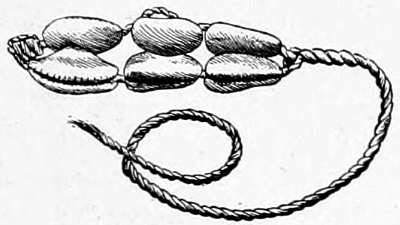
G. W. Bloxam (b) says of the aroko, or symbolic letters, used by the tribe of Jebu, in West Africa, describing Fig. 478:
This is a message from a native general of the Jebu force to a native prince abroad. It consists of six cowries. Six in the Jebu language is E-fà, which is derived from the verb fà, to draw. They are arranged two and two, face to face, on a long string; the pairs of cowries set face to face indicate friendly feeling and good fellowship; the number expresses a desire to draw close to the person to whom the message is sent [note the rebus]; while the long string indicates considerable distance or a long road. This is the message: “Although the road between us be very long, yet I draw you to myself and set my face towards you. So I desire you to set your face towards me and draw to me.”
On p. 298 he adds:
Among the Jebu in West Africa odd numbers in their message are of evil import, while even numbers express good will. Thus a single cowrie may be sent as an unfavorable answer to a request or message.
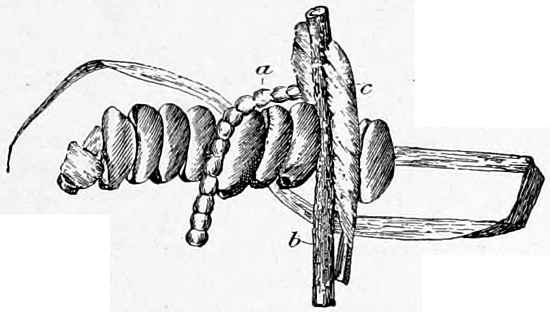
The same author writes, on p. 297, describing Fig. 479:
It is a message from His Majesty Awnjale, the King of Jebu, to his nephew abroad; and here we find other substances besides cowries included in the aroko. Taking the various articles in order, commencing from the knot, we observe four cowries facing in the same direction, with their backs to the knot; this signifies agreement. Next a piece of spice, a, which produces when burnt a sweet odor and is never unpleasant; then come three cowries facing in the same direction; then a piece of mat,[372] b; then a piece of feather, c; and, lastly, a single cowrie turned in the same direction as all the others. The interpretation is:
“Your ways agree with mine very much. Your ways are pleasing to me and I like them.
“Deceive me not, because the spice would yield nothing else but a sweet and genuine odor unto God.
“I shall never deal doubly with you all my life long.
“The weight of your words to me is beyond all description.
“As it is on the same family mat we have been sitting and lying down together, I send to you.
“I am, therefore, anxiously awaiting and hoping to hear from you.”
The following account of “African Symbolic Messages,” condensed from the paper of the Rev. C. A. Gollmer, which appeared in Jour. Anthrop. Inst. of Gr. Bn. and I., XIV, p. 169, et. seq., is highly interesting as showing the ideography attached to the material objects transmitted. The step in evolution by which the graphic delineation of those objects was substituted for their actual presence was probably delayed only by the absence of convenient material, such as birch bark, parchment, or other portable rudimentary form of paper on which to draw or paint, or at least by the want of a simple invention for the application of such material:
The natives in the Yoruba country, West Africa, in the absence of writing, and as a substitute for it, send to one another messages by means of a variety of tangible objects, such as shells, feathers, pepper, corn, stone, coal, sticks, powder, shot, razors, etc., through which they convey their ideas, feelings, and wishes, good and bad, and that in an unmistakable manner. The object transmitted is seen, the import of it known and the message verbally delivered by the messenger sent, and repeated by one or more other persons accompanying the messenger for the purpose as the importance of the message is considered to require.
Cowry shells in the symbolic language are used to convey, by their number and the way in which they are strung, a variety of ideas. One cowry may indicate “defiance and failure;” thus: A cowry (having a small hole made at the back part, so as to be able to pass a string through it and the front opening) strung on a short bit of grass fiber or cord, and sent to a person known as a rival, or one aiming at injuring the other, the message is: “As one finger can not take up a cowry (more than one are required), so you one I defy; you will not be able to hurt me, your evil intentions will come to nothing.”
Two cowries may indicate “relationship and meeting;” thus: Two cowries strung together, face to face, and sent to an absent brother or sister, the message is: “We are children of one mother, were nursed by the same breasts.”
Two cowries may indicate “separation and enmity;” thus: Two cowries strung back to back and sent to a person gone away, the message is: “You and I are now separated.”
Two cowries and a feather may indicate “speedy meeting;” thus: Two cowries strung face to face, with a small feather (of a chicken or other bird) tied between the two cowries, and sent to a friend at a distance, the message is: “I want to see you, as the bird (represented by the feather) flies straight and quickly, so come as quickly as you can.”
The following fivefold painful symbolic message was sent by D., whilst in captivity at Dahomey, to his wife, who happened to be staying with Mr. Gollmer, at Badagry, at the time. The symbols were a stone, a coal, a pepper, corn, and a rag. During the attack of the King of Dahomey, with his great army of Amazons and[373] other soldiers, upon Abeokuta in March, 1852, D., one of the native Christians and defenders of his town, home, and family, was taken captive and carried to Dahomey, where he suffered much for a long time. Whilst waiting for weeks to know the result his wife received the symbolic letter which conveyed the following message:
The stone indicated “health” (the stone was a small, common one from the street); thus the message was: “As the stone is hard, so my body is hardy, strong—i. e., well.”
The coal indicated “gloom” (the coal was a small piece of charcoal); thus the message was: “As the coal is black, so are my prospects dark and gloomy.”
The pepper indicated “heat” (the pepper was of the hot cayenne sort); thus the message was: “As the pepper is hot so is my mind heated, burning on account of the gloomy prospect—i. e., not knowing what day I may be sold or killed.”
The corn indicated “leanness” (the corn was a few parched grains of maize or Indian corn); thus the message was: “As the corn is dried up by parching; so my body is dried up or become lean through the heat of my affliction and suffering.”
The rag indicated “worn out;” thus (the rag was a small piece of worn and torn native cloth, in which the articles were wrapped) the message was: “As the rag is, so is my cloth cover—i. e., native dress, worn and torn to a rag.”
A tooth brush may indicate “remembrance;” thus: It is a well-known fact that the Africans in general can boast of a finer and whiter set of teeth than most other nations. And those Europeans who lived long among them know from constant observation how much attention they pay to their teeth, not only every morning, but often during the day. The tooth brush made use of is simply a piece of wood about 6 to 9 inches long, and of the thickness of a finger. One end of the stick, wetted with the saliva, is rubbed to and fro against the teeth, which end after awhile becomes soft. This sort of tooth brush is frequently given to friends as an acceptable present, and now and then it is made use of as a symbolic letter, and in such a case the message is: “As I remember my teeth the first thing in the morning, and often during the day, so I remember and think of you as soon as I get up, and often afterwards.”
Sugar may indicate “peace and love;” in the midst of a war this good disposition was made known from one party to another by the following symbol: A loaf of white sugar was sent by messengers from the native church at A. to the native church at I., and the message was: “As the sugar is white, so there is no blackness (i. e., enmity) in our hearts towards you; our hearts are white (i. e., pure and free from it). And as the sugar is sweet, so there is no bitterness among us against you; we are sweet (i. e., at peace with you) and love you.”
A fagot may indicate “fire and destruction;” when a fagot (i. e., a small bundle of bamboo poles, burnt on one end) is found fastened to the bamboo fence inclosing a compound, or premises, it conveys the message: “Your house will be burnt down”—i. e., destroyed.
Powder and shot are often made use of and sent as a symbolic letter; the message is to either an individual or a people, viz: “As we can not settle the quarrel, we must fight it out” (i. e., “we shall shoot you, or make war upon you”).
A razor may indicate “murder.” A person suspected and accused of having by some means or other been the cause of death of a member of a family, the representative of that family will demand satisfaction by sending the symbolic objects, viz, a razor or knife, which is laid outside the door of the house of the accused offender and guilty party, and the message is well understood to be: “You have killed or caused the death of N., you must kill yourself to avenge his death.”
The following examples indicate a still further step in evolution by which the names of the objects or of the numbers are of the same sound as words in the language the significance of which constitutes the real message. This objective rebus corresponds with the pictorial rebus so common in Mexican pictographs, and which is well known to have[374] borne a chief part in the development of Egyptian and other ancient forms of writing.
Three cowries with some pepper may indicate “deceit;” thus: Three cowries strung with their faces all looking one way (as mentioned before) with an alligator pepper tied to the cowries. Eru is the name of the pepper in the native language, which in English means “deceit.” The message may be either a “caution not to betray one another,” or, more frequently, an accusation of having deceived and defrauded the company.
Six cowries may indicate “attachment and affection;” thus: Efa in the native language means “six” (cowries implied); it also means “drawn,” from the verb fa, to draw. Mora is always implied as connected with Efa; this means “stick to you,” from the verb mo, to stick to, and the noun ara, body—i. e. you. Six cowries strung (as before mentioned) and sent to a person or persons, the message is: “I am drawn (i. e. attached) to you, I love you,” which may be the message a young man sends to a young woman with a desire to form an engagement.
Rev. Richard Taylor (b) says:
The Maori used a kind of hieroglyphical or symbolical way of communication; a chief, inviting another to join in a war party, sent a tattooed potato and a fig of tobacco bound up together, which was interpreted to mean that the enemy was a Maori and not European by the tattoo, and by the tobacco that it represented smoke; he therefore roasted the one and eat it, and smoked the other, to show he accepted the invitation, and would join him with his guns and powder. Another sent a waterproof coat with the sleeves made of patchwork, red, blue, yellow, and green, intimating that they must wait until all the tribes were united before their force would be waterproof, i. e., able to encounter the European. Another chief sent a large pipe, which would hold a pound of tobacco, which was lighted in a large assembly, the emissary taking the first whiff, and then passing it around; whoever smoked it showed that he joined in the war.
Stephen Powers (b) states that the Nishinam of California have the following mode of collecting debts:
When an Indian owes another, it is held to be in bad taste, if not positively insulting, for the creditor to dun the debtor, as the brutal Saxon does, so he devises a more subtle method. He prepares a certain number of little sticks, according to the amount of the debt, and paints a ring around the end of each. These he carries and tosses into the delinquent’s wigwam without a word and goes his way; whereupon the other generally takes the hint, pays the debt, and destroys the sticks.
The San Francisco (California) Western Lancet, XI, 1882, p. 443, thus reports:
When a patient has neglected to remunerate the shaman [of the Wikehumni tribe of the Mariposan linguistic stock] for his services, the latter prepares short sticks of wood, with bands of colored porcupine quills wrapped around them at one end only, and every time he passes the delinquent’s lodge a certain number of them are thrown in as a reminder of the indebtedness.
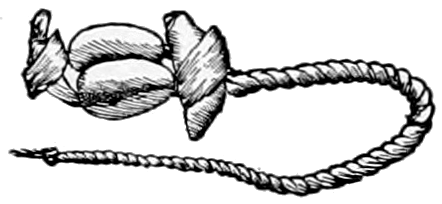
G. W. Bloxam (c) describes Fig. 480 thus:
Among the Jehu of West Africa two cowries facing one another signify two blood relations; two cowries, however, back to back may be sent as a message of reproof[375] for nonpayment of debt, meaning: “You have given me the back altogether; after we have come to an arrangement about the debt you have owed me, I will also turn my back against you.”
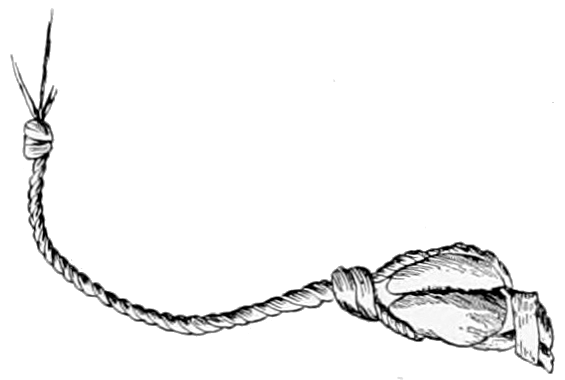
The same authority, p. 299, describes Fig. 481:
It consists of two cowries face to face, followed by one above facing upwards, and is a message from a creditor to a bad debtor, meaning: “After you have owed me a debt you kicked against me; I also will throw you off, because I did not know that you could have treated me thus.”
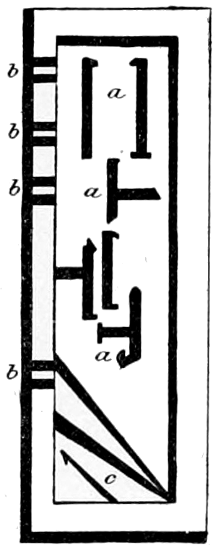
Prof. Anton Schrifner (a) describing Fig. 482, says:
On this plank the cuts marked b signify the number of reindeer required. Opposite these cuts are placed the hand marks, a, of various Samoyeds of whom the reindeer are demanded. At the bottom is found the official mark, c, of the Samoyed chief who forwarded this board to the various Samoyed settlements in place of a written communication.
The employment of pictographs to designate tribes, groups within tribes, and individual persons has been the most frequent of all the uses to which they have been applied. Indeed, the constant need that devices to represent the terms styled by grammarians proper names should be readily understood for identification has, more than any other cause, maintained and advanced pictography as an art, and in some parts of the world has evolved from it syllabaries and afterwards alphabets. From the same origin came heraldry, which in time designated with absolute accuracy persons and families for the benefit of letterless people. Trade-marks have the same history.
From the earliest times men have used emblems to indicate their tribes or clans. Homer makes no clear allusion to their manifestation at the poetic siege of Troy; but even if his Greeks did not bear them, other nations of the period did. The earlier Egyptians carried images of bulls and crocodiles into battle, probably at first with religious sentiments. Each of the twelve tribes of Israel had a special ensign of its own, which is now generally considered to have been totemic. The subjects of Semiramis adopted doves and pigeons as their token in deference to their queen, whose name meant “dove.”
At later dates Athens chose an owl for her sign, as a compliment to Minerva; Corinth, a winged horse, in memory of Pegasus and his fountain; Carthage, a horse’s head, in homage to Neptune; Persia, the sun, because its people worshiped fire; Rome, an eagle, in deference to Jupiter. These objects appear to have been carved in wood or metal. There is no evidence of anything resembling modern flags, except, perhaps, in parts of Asia, until the Romans began to use something like them about the time of Cæsar. But these small signs had no national or public character so as to be comparable with the eagles on the Roman standard; nor was any floating banner associated with ruling power until Constantine gave a religious meaning to the labarum.
Emblems also were often adopted by political and religious parties, e. g., the cornstalks and slings of the Mazarinists and anti-Mazarinists during the Fronde, the caps and hats in the Swedish diet in 1788, the scarf of the Armagnacs, and the cross of the Burgundians. The topic of emblems is further discussed in Chapter XVIII.
As with increased culture clans and tribes have become nations, so there has been an evolution by which the ensigns of bands and[377] orders have been discontinued and replaced by the emblems of nationalities. Frederic Marshall (a) well says: “Images of animals, badges, war cries, cockades, liveries, coats of arms, tokens, tattooing, are all replaced practically by national ensigns.” This change is toward the higher and nobler significance and employment, all members of the community being protected and designated by the simple exhibition of a single emblem.
This chapter is naturally divided into (1) Pictorial tribal designations, (2) Gentile and clan designations, (3) Significance of tattoo, (4) Designations of individuals.
Capt. de Lamothe Cadillac (a) writing in the year 1696 of the Algonquians of the Great Lake region near Mackinac, etc., describes the emblems on their canoes as follows: “On y voit la natte de guerre le corbeau, l’ours on quelque autre animal * * * estant l’esprit qui doit conduire cette enterprise.”
This, however, was a mistake as applicable to the time when it was written. The animals used as emblems may originally have been regarded as supernatural totemic beings, but had probably become tribal designations.
Bacqueville de la Potherie (c) says that a treaty with the French in Canada, about 1700, was “sealed” with the “proper arms,” pictorially drawn, of the Indian tribes which were parties to it. The following is a copy of the original statement in its archaic form:
Monsieur de Callieres, de Champigni, & de Vaudreüil, en signerent le Traité, que chaque Nation scella de ses propres armes. Les Tsonnontouans & les Onnontaguez designerent une araignée, le Goyogouin un calumet, les Onneyouts un morceau de bois en fourche, une pierre au milieu, un Onnontagué mit un Ours pour les Aniez, quoi qu’ils ne vinrent pas. Le Rat mit un Castor, les Abenaguis un Chevreüil, les Outaouaks un Liévre, ainsi des autres.
From this it appears that—
The Seneca and Onondaga tribes were represented by a “spider.” [This was doubtless a branching tree, so badly drawn as to be mistaken for a spider.]
The Cayuga tribe, by a calumet.
The Oneida tribe, by a forked stick with a stone in the fork. [The forked stick was really designed for the fork of a tree.]
The Mohawk tribe, by a bear.
Le Rat, who was a representative Huron of Mackinaw, by a beaver.
The Abnaki, by a deer.
The Ottawa, by a hare.
Several other accounts of the tribal signs of the Iroquois are published,[378] often with illustrations, e. g., in Documents relating to the Colonial History of New York (a), with the following remarks:
When they go to war, and wish to inform those of the party who may pass their path, they make a representation of the animal of their tribe, with a hatchet in his dexter paw; sometimes a saber or a club; and if there be a number of tribes together of the same party, each draws the animal of his tribe, and their number, all on a tree, from which they remove the bark. The animal of the tribe which heads the expedition is always the foremost.
Another account of interest, which does not appear to have been published, was traced and contributed by Mr. William Young, of Philadelphia. It is a deed from the representatives of the Six Nations (the Tuscaroras then being admitted) to the King of Great Britain, dated November 4, 1768, and recorded at the recorder’s office, Philadelphia, in Deed Book I, vol. 5, p. 241. Nearly all of these accounts and illustrations are confused and imperfect. An instructive blunder occurs in the translated signature representing the Mohawk tribe in the above mentioned deed. It is called “The Steel,” which could hardly have been an ancient tribal name, but after study it was remembered that the Mohawks have sometimes been called by a name properly translated the “Flint people.” By some confusion about flint and steel, which were still used in the middle of the last century to produce sparks of fire, perhaps assisted by the pantomime of striking those objects together, the one intended to be indicated, viz, the flint, was understood to be the other, the steel, and so these words were written under the figure, which was so roughly drawn that it might have been taken for a piece of flint or of steel or, indeed, anything else.
The illustrations in Fig. 483 were drawn in 1888 by a Passamaquoddy Indian, in Maine, near the Canada border. The Passamaquoddy, Penobscot, and Amalecite are tribal divisions of the Abnaki, who formerly were also called Tarrateens by the more southern New England tribes and Owenunga by the Iroquois. The Micmacs are congeners of the Abnaki, but not classed in their tribal divisions. All the four tribes belong to the Algonquian linguistic stock.
Fig. 483 a is the tribal emblem of the Passamaquoddy. It shows two Indians in a canoe, both using paddles and not poles, following a fish, the pollock. The variation which will appear in the represented use of poles and paddles in the marks of the Algonquian tribes in Maine, Nova Scotia, New Brunswick, etc., is said to have originated in the differing character of the waters, shoal or deep, sluggish or rapid, of the regions of the four bodies of Indians whose totems are indicated as next follows, thus requiring the use of pole and paddle, respectively, in a greater or less degree. The animals figured are in all cases repeated consistently by each one of the several delineators, and in all cases there is some device to show a difference between the four canoes, either in their structure or in their mode of propulsion, but these devices are[379] not always consistent. It is therefore probable that the several animals designated constitute the true and ancient totemic emblems, and that the accompaniment of the canoes is a modern differentiation.
b The Maresquite or Amalecite emblem. Two Indians in a canoe, both with poles, following a muskrat.
c The Micmac emblem. Two Indians, both with paddles, in a canoe built with high middle parts familiarly called “humpback,” following a deer.
d The Penobscot emblem. Two Indians in a canoe, one with a paddle and the other with a pole, following an otter.
In Margry (a) is an account, written about 1722, of the “Principal divisions of the Sioux and their distinctive marks,” thus translated:
There are from twenty to twenty-six villages of Scioux and they comprise the nations of the prairies:
(1) The Ouatabatonha, or Scioux des Rivières, living on the St. Croix river or Lake de la Folle-Avoine which is below, and 15 leagues from the Serpent river. Their distinctive sign is a bear wounded in the neck.
(2) The Menesouhatoba, or Scioux des Lacs, having for their mark a bear wounded in the neck.
(3) The Matatoba, or Scioux des Prairies, having for their mark a fox with an arrow in its mouth.
(4) The Hictoba, or Scioux de la Chasse, having for their symbol the elk.
(5) The Titoba, or Scioux des Prairies, whose emblem is the deer. It bears a bow on its horns.
We have as yet had no commerce save with five nations. The Titoba live 80 leagues west of Sault Saint-Antoine.
The above early, though meager, notice will serve as an introduction to the following series of pictorial tribal signs, all drawn by Sioux Indians, and many of them representing tribal divisions of the Siouan linguistic stock. The history and authority of the several “Winter Counts” mentioned are referred to supra, chapter X, section 2. Red-Cloud’s census and the Oglala roster are also described below. Explanations of some figures are added which have no reference to the present topic, but which seemed necessary and could not be separated and transferred to more appropriate division without undue multiplication of figures and text.
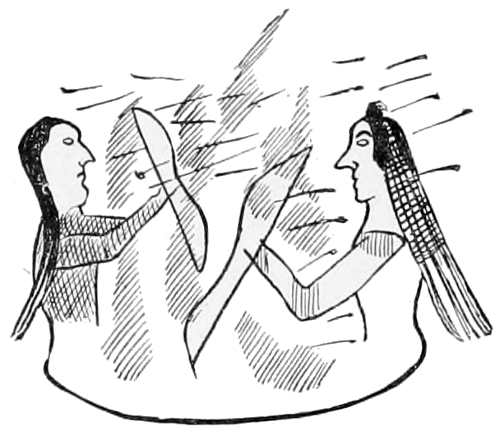
Fig. 484.—Dakota and Crow, Cloud-Shield’s Winter Count, 1819-’20. In an engagement between the Dakotas and the Crows both sides expended all of their arrows, and then threw dirt at each other. A Crow is represented on the right, and is distinguished by the manner in which the hair is worn. Hidatsa and Absaroka are represented with striped or spotted hair, which denotes the red clay they apply to it.
The custom which prevails among these tribes, and is said to have originated with the Crows, is to wear a wig of horse hair attached to the occiput, thus resembling the natural growth, but much increased in length. These wigs are made in strands having the thickness of a finger, varying from eight to fifteen in number, and held apart and in place by means of thin cross strands, thus resembling coarse network. At every intersection of strands of hair and crossties, lumps of pine gum are attached to prevent disarrangement and as in itself ornamental, and to these lumps dry vermilion clay is applied by the richer classes and red ocher or powdered clay by the poorer people.
Pictures drawn by some of the northern tribes of the Dakota show the characteristic and distinctive features for a Crow Indian to be the distribution of the red war paint which covers the forehead.
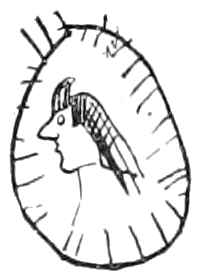
Fig. 485.—Cloud-Shield’s Winter Count, 1830-’31. The Crows were approaching a village at a time when there was a great deal of snow on the ground and intended to surprise it, but, some herders discovering them, the Dakotas went out, laid in wait for the Crows, surprised them, and killed many. A Crow’s head is represented in the figure.
The Crow is designated not only by the arrangement of back hair, before mentioned, but by a topknot of hair extending upward from the forehead, brushed upward and slightly backward. See also the seated figure in the record of Running Antelope, in Fig. 820, infra.
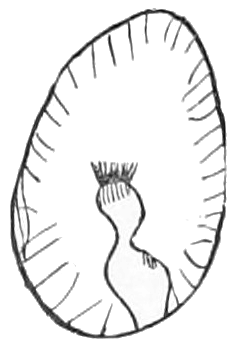
Fig. 486.—The Dakotas surrounded and killed ten Crows. Cloud-Shield’s Winter Count, 1857-’58.
The hair is somewhat shortened and not intentionally foreshortened, which was beyond the artist’s skill.
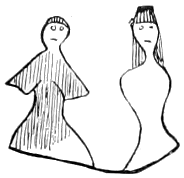
Fig. 487.—The Dakotas killed a Crow and his squaw who were found on a trail. Cloud-Shield’s Winter Count, 1839-’40.
This is a front view. The union line signifies husband and wife.
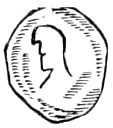
Fig. 488.—Arapaho, in the Dakota language, magpi-yato, blue cloud, is here shown by a circular cloud, drawn in blue in the original, inclosing the head of a man. Red-Cloud’s census.
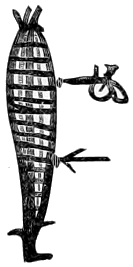
Fig. 489 is the tribal sign of the Arikara, made by the Dakota, taken from the Winter Count of Battiste Good for the year 1823-’24, which he calls “General-——-first-appeared-and-the-Dakotas-aided-in-an-attack-on-the-Rees winter,” also “Much corn winter.”
The gun and the arrow in contact with the ear of corn show that both whites and Indians fought the Rees. The ear of corn signifies “Ree” or Arikara Indians, who are designated in gesture language as “corn shellers.”

Fig. 490.—A Dakota kills one Ree. The-Flame’s Winter Count, 1874-’75. Here the ear of corn, the conventional sign for Arikara, has become abbreviated.

Fig. 491 is the tribal designation for Assiniboin or Hohe made by the Dakota, as taken from the Winter Count of Battiste Good for the year 1709-’10.
The Hohe means the voice, or, as some say, the voice of the musk ox, and the device is the outline of the vocal organs, according to the Dakota concept, and represents the upper lip and roof of the mouth, the tongue, the lower lip, and chin and neck. The view is lateral, and resembles the sectional aspect of the mouth and tongue.
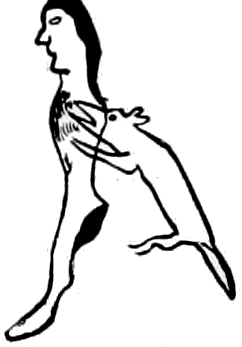
Fig. 492.—A Brulé, who had left the village the night before, was found dead in the morning outside the village, and the dogs were eating his body. Cloud-Shield’s Winter Count, 1822-’23.
The black spot on the upper part of the thigh shows he was a Brulé.
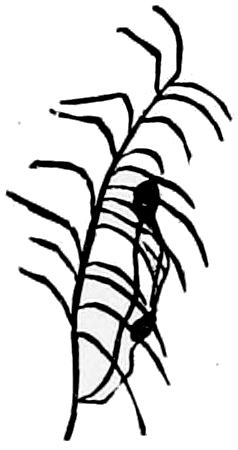
Fig. 493.—A Brulé was found dead under a tree, which had fallen on him. Cloud-Shield’s Winter Count, 1808-’10.
Again the burnt thigh is suggested by the black spot.
The significance of these two figures is explained by the gesture sign for Brulé as follows: Rub the upper and outer part of the right thigh in a small circle with the open right hand, fingers pointing downward. These Indians were once caught in a prairie fire, many burned to death, and others badly burned about the thighs; hence the name Si-can-gu, burnt thigh, and the sign. According to the Brulé chronology, this fire occurred in 1763, which they call “The-people-were-burned winter.”
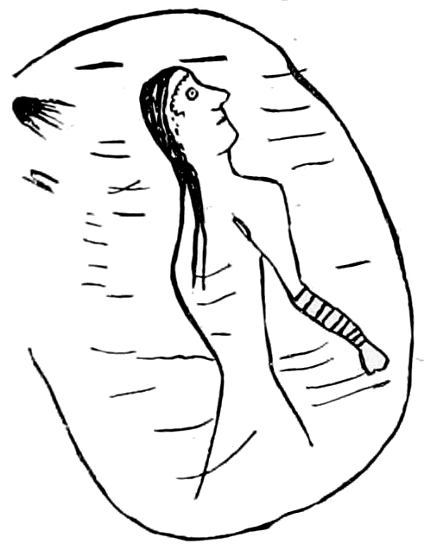
Fig. 494.—The Cheyenne who boasted that he was bullet and arrow proof was killed by white soldiers, near Fort Robinson, Nebraska, in the intrenchments behind which the Cheyennes were defending themselves after they had escaped from the fort. Cloud-Shield’s Winter Count, 1878-’79.

The marks on the arm constitute the tribal pictographic emblem. It is explained by the gesture sign as follows: Pass the ulnar side of the extended index finger repeatedly across extended finger and back of the left hand. Fig. 495 illustrates this gesture sign. Frequently, however, the index is drawn across the wrist or forearm, or the extended index, palm upward, is drawn across the forefinger of the left hand (palm inward), several times, left hand stationary, right hand is drawn toward the body until the index is drawn clear off; then repeat. Some Cheyennes believe this to have reference to the former custom of cutting the arms as offerings to spirits, while others think it refers to a more ancient custom of cutting[383] off the enemy’s fingers for necklaces, and sometimes to cutting off the whole hand or forearm as a trophy to be displayed as scalps more generally are.
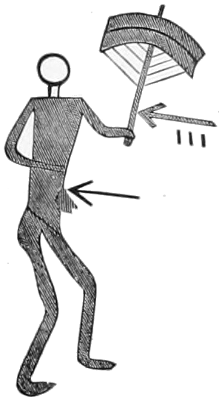
Fig. 496 is from the Winter Count of Battiste Good for the year 1785-’86. In that record this is the only instance where the short vertical lines below the arrow signify Cheyenne. In all others those marks are numerical and denote the number of persons killed. That these short lines here signify Cheyenne is explained by the foregoing remarks.
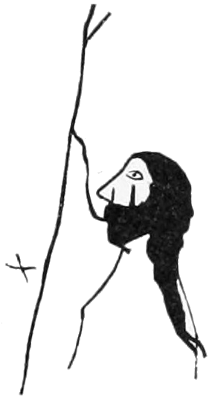
Fig. 497.—Picket-Pin went against the Cheyennes. A picket-pin is represented in front of him and is connected with his mouth by the usual line. Cloud-Shield’s Winter Count, 1790-’91.
The black band across his face denotes that he was brave and had killed enemies. The cross is the symbol for Cheyenne. This mark stands for the scars on their arms or stripes on their sleeves, and also to the gesture sign for this tribe. The cross is, therefore, the conventionalized form both for the emblem and the gesture.
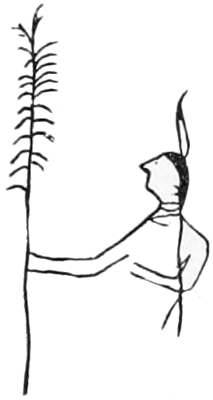
Fig. 498.—Standing-Bull, the great grandfather of the present Standing-Bull, discovered the Black Hills. American-Horse’s Winter Count, 1775-’76. He carried home with him a pine tree of a species he had never seen before. In this count the Dakotas are usually distinguished by the braided scalp lock and the feather they wear at the crown of the head, or by the manner in which they brush back and tie the hair with ornamented strips. Many illustrations are given in the present paper in which this arrangement of the hair is shown more distinctly.
With regard to the designation of this tribe by paint it seems that pictures made by the northern Dakotas represent themselves as distinguished from other Indians by being painted red from below the eyes to the end of the chin. But this is probably rather a special war painting than a tribal design.
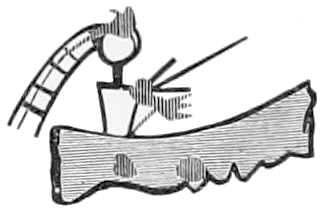
Fig. 499 shows the tribal designation of the Gros Ventres by the Dakotas, on the authority of Battiste Good, 1789-’90.
Two Gros Ventres were killed on the ice by the Dakotas. The two are designated by two spots of blood on the ice, and killed is expressed by a blood-tipped arrow against the figure of the man above. The long hair, with a red forehead, denotes the Gros Ventre. In other Dakota records the same style of painting the forehead red designates the Arikara and Absaroka Indians. The horizontal band, which is blue in the original, signifies ice.
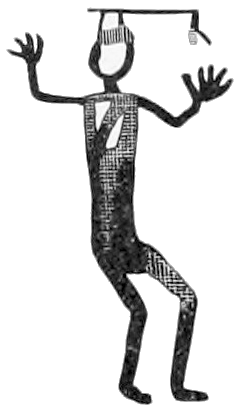
Fig. 500 shows the tribal designation of the Kaiowa by the Dakota, taken from the Winter Count of Battiste Good, 1814-’15. He calls the winter “Smashed-a-Kaiowa’s-head-in winter.” The tomahawk with which it was done is in contact with the Kaiowa’s head.
The sign for Kaiowa is sometimes made by passing one or both hands, naturally extended, in short horizontal circles on either side of the head, together with a shaking motion, the conception being “rattle-brained” or “crazy heads.” The picture is drawn to represent the man in the attitude of making this gesture, and not the involuntary raising of the hands upon receiving the blow, such attitudes not appearing in Battiste Good’s system.
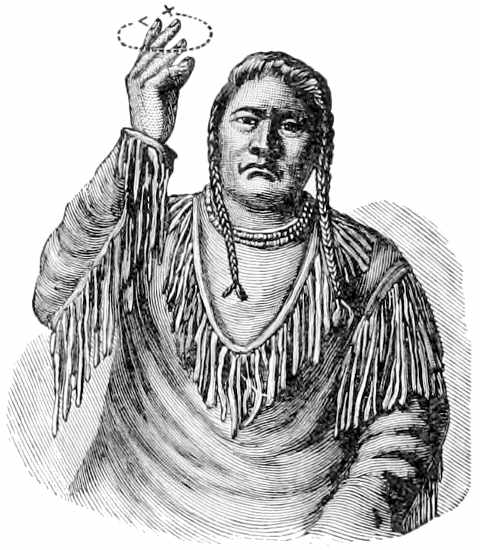
This gesture is illustrated in Fig. 501.
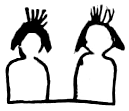
Fig. 502.—Mandan.
Fig. 502.—Two Mandans killed by Minneconjous. The peculiar arrangement of the hair distinguishes the tribe. The-Flame’s Winter Count, 1789-’90.

Fig. 503.—Mandan and Arikara.
Fig. 503.—The Mandans and Rees made a charge on a Dakota village. An eagle’s tail, which is worn on the head, stands for Mandan and Ree. American-Horse’s Winter Count, 1783-’84.
The mark on the tipi, which represents a village, is not, as it at first sight appears, a hatchet, but a conventional sign for “it hit.” See Fig. 987 and accompanying remarks.
Carver (a), writing in 1776-’78, tells that an Ojibwa drew the designation of his own tribe as a deer. The honest captain of provincial troops may have mistaken a clan mark to be a tribal mark, but the account is mentioned for what it is worth, and the context serves to support the statement.

Fig. 504.—Omaha.
Fig. 504 is the tribal designation of the Omahas by the Dakotas, taken from the Winter Count of Battiste Good, for the year 1744-’45. The pictograph is a human head with cropped hair and red cheeks. It is a front view. This tribe cuts the hair short and uses red paint upon the cheeks very extensively. This character is of frequent occurrence in Battiste Good’s count.
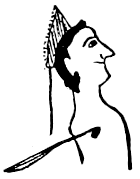
Fig. 505.—Omaha.
Fig. 505.—The Dakotas killed an Omaha in the night. Cloud-Shield’s Winter Count, 1806-’07.
This is a side view of the same. The illustration does not show the color of the cheeks.
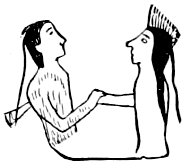
Fig. 506.—Omaha.
Fig. 506.—The Dakotas and Omahas made peace. Cloud-Shield’s Winter Count, 1791-’92.
The Omaha is on the right and the Dakota on the left.
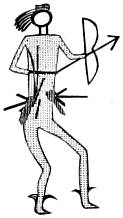
Fig. 507.—Pawnee.
Fig. 507 is the tribal designation of the Pawnee by the Dakotas, taken from Battiste Good’s Winter Count for the year 1704-’05.
He says: The lower part of the legs are ornamented with slight projections resembling the husks on the bottom of an ear of corn.

Fig. 508.—Pawnee.
Fig. 508.—Brulés kill a number of Pawnees. The-Flame’s Winter Count, 1873-’74.
This is the abbreviated or conventionalized form of the one preceding.

Fig. 509.—Pawnee.
Fig. 509.—They killed many Pawnees on the Republican river. Cloud-Shield’s Winter Count, 1873-’74.
Here the arrangement of the hair makes the distinction.
In this connection it is useful to quote Dunbar (a):
The tribal mark of the Pawnees in their pictographic or historic painting was the scalp lock dressed to stand nearly erect or curving slightly backwards, somewhat like a horn. This, in order that it should retain its position, was filled with vermillion or other pigment, and sometimes lengthened by means of a tuft of horse hair skillfully appended so as to form a trail back over the shoulders. This usage was undoubtedly the origin of the name Pawnee. * * * It is most probably derived from pá-rĭk-ĭ, a horn, and seems to have been once used by the Pawnees themselves to designate their peculiar scalp lock. From the fact that this was the most noticeable feature in their costume, the name came naturally to be the denominative term of the tribe.
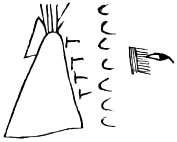
Fig. 510.—Ponka.
Fig. 510.—The Ponkas came and attacked a village, notwithstanding peace had just been made with them. American-Horse’s Winter Count, 1778-’79.
Some elk hair which is used to form a ridge about 8 inches long and 2 in breadth, worn from the forehead to the back of the neck, and a feather, represent Ponka. Horse tracks are used for horses. Attack is indicated by marks which represent bullet marks, and which convey the idea that the bullet struck. The marks are derived from the gesture-sign “it struck.” See Chapter XVIII, section 4.
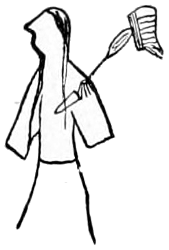
Fig. 511.—Ponka.
Fig. 511.—An Indian woman, who had been unfaithful to a white man to whom she was married, was killed by an Indian named Ponka. American-Horse’s Winter Count, 1804-’05.
The emblem for Ponka is the straight elk hair ridge.
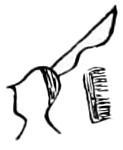
Fig. 512.—Ponka.
Fig. 512.—A Ponka, who was captured when a boy by the Oglalas, was killed while outside the village by a war party of Ponkas. American-Horse’s Winter Count, 1793-’94.
The artificial headdress, consisting of a ridge of elk hair, is again portrayed.
Dr. George Gibbs (b) describes a pictograph made by one of the Indian tribes of Oregon and Washington, upon which “the figure of a man with a long queue or scalp lock reached to his heels denoted a Shoshoni, that tribe being in the habit of braiding horse or other hair into their own in that manner.”
This may be correct regarding the Shoshoni Indians among the extreme northwestern tribes, but the mark of identification could not be based upon the custom of braiding with their own hair that of animals, to increase the length and appearance of the queue, as this custom also prevails among the Absaroka, Hidatsa, and Arikaa Indians, respectively, as before mentioned in this work.
Tanner’s Narrative (e) gives additional information on this topic regarding the absence of any tribal sign in connection with a human figure.
The men of the same tribe are extensively acquainted with the totems which belong to each, and if on any record of this kind the figure of a man appears without any designatory mark, it is immediately understood that he is a Sioux or at least a stranger. Indeed, in most instances the figures of men are not used at all, merely the totem or surname, being given. * * * It may be observed that the Algonkins believe all other Indians to have totems, though from the necessity they are in general under of remaining ignorant of those hostile bands, the omission of the totem in their picture writing serves to designate an enemy. Thus, those bands of Ojibbeways who border on the country of the Dahcotah or Sioux, always understand the figure of a man without totem to mean one of that people.

Fig. 513.—Tamga of Kirghise tribes.
In Sketches of Northwestern Mongolia, (a) are the tamga or seals of Kirghise tribes, of which Fig. 513 is a copy.
The explanation given is as follows: a. Kipchaktamga: letter alip. b. Arguin tamga: eyes. c. Naiman tamga: posts (of door). d. Kong-rat, Kirei, tamga: vine. e. Nak tamga: prop. f. Tarakti tamga: comb. g. Tyulimgut tamga: pike.
The clan and totemic system formerly called the gentile system undoubtedly prevailed anciently in Europe and Asia, but first became understood by observations of its existence in actual force among the aborigines of America and Australia, and typical representations of it are still found among them. In Australia it is called kobong. An animal or a plant, or sometimes a heavenly body was mythologically at first and at last sociologically connected with all persons of a certain stock, who believe, or once believed, that it was their tutelar god and they bear its name.
Each clan or gens took as a badge or objective totem the representation of the tutelar daimon from which it was named. As most Indian tribes were zootheistic, the object of their devotion was generally an animal—e. g., an eagle, a panther, a buffalo, a bear, a deer, a raccoon, a tortoise, a snake, or a fish, but sometimes was one of the winds, a celestial body, or other impressive object or phenomenon.
American Indians once generally observed a prohibition against killing the animal connected with their totem or eating any part of it. For instance, most of the southern Indians abstained from killing the wolf; the Navajo do not kill bears; the Osage never killed the beaver until the skins became valuable for sale. Afterward some of the animals previously held sacred were killed; but apologies were made to them at the time, and in almost all cases the prohibition or taboo survived with regard to certain parts of those animals which were not to be eaten on the principle of synecdoche, the temptation to use the food being too strong to permit entire abstinence. The Cherokee forbade the use of the tongues of the deer and bear for food. They cut these members out and cast them into the fire sacramentally. A practice still exists among the Ojibwa as follows: There is a formal restriction against members of the bear clan eating the animal, yet by a subdivision within the same clan an arrangement is made so that sub-clans may among them eat the whole animal. When a bear is killed, the head and paws are eaten by those who form one branch of the bear totem, and the remainder is reserved for the others. Other Indian tribes have invented a differentiation in which some clansmen may eat the ham and not the shoulder of certain animals, and others the shoulder and not the ham.
It follows, therefore, that sometimes the whole animal is designated as a clan totem, and also that sometimes only parts of it is selected.[389] Many of the devices given in this paper under the heading of personal names have this origin. The following figures show a selection of parts of animals that may further illustrate the subject. It must, however, be borne in mind that some of the cases may be connected with individual visions or with personal adventures and not directly with the clan system. In the absence of detailed information in each instance discrimination is impossible.
Schoolcraft says that the Ojibwa always placed the totemic or clan[390] pictorial mark upon the adjedatig or grave-post, thereby sinking the personal name which is not generally indicative of the totem. The same practice is found in other tribes. The Pueblos depict the gentile or totemic pictorial sign upon their various styles of ceramic work.
Fig. 514, gives examples taken from Dakota drawings, which appear to be pictured totemic marks of gentes or clans. If not in every instance veritable examples, they illustrate the mode of their representation as distinct from the mere personal designations mentioned below, and yet without positive information in each case, it is not possible to decide on their correct assignment to this section of the present chapter.
a. Bear-Back. Red-Cloud’s Census.
This and the six following figures exhibit respectively the portions of the bear, viz, the back or chine, the ears, the head, the paw, the brains, and the nostrils or muzzle, which are probably the subject of taboo and are the sign of a clan or subclan.
b. Bear’s-Ears, a Brulé, was killed in an Oglala village by the Crows. American-Horse’s Winter Count, 1785-’86.
c. Bear’s-Ears was killed in a fight with the Rees. Cloud-Shield’s Winter Count, 1793-’94.
This is another and more graphic delineation of the animal’s ears.
d. Bear-Head. Red-Cloud’s Census.
e. Bear-Paw. Red-Cloud’s Census. The paws of the bear are considered to be a delicacy.
f. Bear-Brains. Red-Cloud’s Census.
g. Bear-Nostrils. Red-Cloud’s Census.
h. Hump. Red-Cloud’s Census. The hump of the buffalo has been often praised as a delicious dish.
i. Elk-Head. Red-Cloud’s Census.
Fig. 515 represents carved uprights in a house of the Kwakiutl Indians, British Columbia, taken from a work of Dr. Franz Boas (b).
The author says that these uprights are always carved according to the crest of the gens of the house owner, and represent men standing on the heads of animals. This use of the term “crest” is not heraldically correct, as literally it would require the men to be standing on the coverings of their own heads, but the idea is plain, the word being used for a device similar in nature and significance to the crest in heraldry, and it was adopted by the ancestors of the Kwakiutl gentes in relation to certain exploits that they had made. Both human figures show painting and probably also tattooing on their faces.
The character on the left hand also shows a design on the breast. That on the right hand presents a curious artifice of carving by which the legs and an arm are exhibited while preserving the solidity of the upright.
Tattooing proper is a permanent marking of the skin accomplished by the introduction of coloring matter under the cutaneous epidermis. In popular expression and often in literature it includes penetration of the skin by cuts, gashes, or sometimes burns, without the insertion of coloring matter, the cicatrix being generally whiter than the sound skin of the people, most frequently of the dark races, among whom the practice is found. This form of figuration is distinguished as scarification and some examples of it are given below. The two varieties of tattoo may, however, for the purpose of this paper, be considered together and also in relation to painting the human body, which in its early use differs from them only in duration.
Mr. Herbert Spencer (a) considers all forms of tattoo to be originally tribal marks, and draws from that assumption additional evidence for his favorite theory of the deification of a dead tribal chief. Miss A. W. Buckland (a), in her essay on tattooing, follows in the same track, although recognizing modern deviations from the rule. A valuable article in the literature of the subject entitled “Tattooing among civilized people,” by Dr. Robert Fletcher should be consulted. Also A tatuagem em Portugal, by Rocha Peixoto.
Dr. C. N. Starcke (a) lays down the law still more distinctly, thus:
The tattoo-marks make it possible to discover the remote connection between clans, and this token has such a powerful influence on the mind that there is no feud between tribes which are tattooed in the same way. * * * Tattooing may also lead to the formation of a group within the tribe.
Prof. Frederick Starr (a) makes these remarks:
As a sign of war prowess the gash of the Kaffir warrior may be described. After an act of bravery the priest cuts a deep gash in the hero’s thigh. This heals blue and is a prized honor. To realize the value of a tribal mark think for a moment of the savage man’s relation to the world outside. He is a very Ishmaelite. So long as he remains on his own tribal territory he is safe; when on the land of another tribe his life is the legitimate prey of the first man he meets. To men in such social relations the tribal mark is the only safety at home; without it he would be slain unrecognized by his own tribesmen. There must have been a time when the old Hebrews knew all about this matter of tribe marks. By this custom only can we fully understand the story of Cain (Gen. IV, 14, 15), who fears to be sent from his own territory lest he be slain by the first stranger he meets, but is protected by the tribal mark of those among whom he is to wander being put upon him. But in scarring, as in so many other cases, the original idea is often lost and the mark becomes merely ornamental. This is particularly true among women. Among men it more frequently retains its tribal significance.
After careful study of the topic, less positive and conclusive authority is found for this explanation of tattooing than was expected, considering its general admission.
The great antiquity of tattooing is shown by reference to it in the Old Testament, and in Herodotus, Xenophon, Tacitus, Ammianus, and Herodian. The publications on the topic are so numerous that the notes now to be presented are by no means exhaustive. They mainly refer to the Indian tribes of North America with only such comparatively recent reports from other lands as seem to afford elucidation.
G. Holm (b) says of the Greenland Innuit that geometric figures consisting of streaks and points, are used in tattooing on the breasts, arms, and legs of the females.
H. H. Bancroft (b) says:
The Eskimo females tattoo lines on their chins; the plebeian female of certain bands has one vertical line in the center and one parallel to it on either side. The higher classes mark two vertical lines from each corner of the mouth. * * * Young Kadiak wives tattoo the breast and adorn the face with black lines. The Kuskoquim women sew into their chin two parallel blue lines.
William H. Gilder (a) reports:
The Esquimau wife has her face tattooed with lampblack and is regarded as a matron in society. * * * The forehead is decorated with the letter V in double lines, the angle very acute, passing down between the eyes almost to the bridge of the nose, and sloping gracefully to the right and left before reaching the roots of the hair. Each cheek is adorned with an egg-shaped pattern, commencing near the wing of the nose and sloping upward toward the corner of the eye; these lines are also double. The most ornamented part, however, is the chin, which receives a gridiron pattern; the lines double from the edge of the lower lip, and reaching to[393] the throat toward the corners of the mouth, sloping outward to the angle of the lower jaw. This is all that is required by custom, but some of the belles do not stop here. * * * None of the men are tattooed.
An early notice of tattooing in the territory now occupied by the United States, mentioned in Hakluyt (d), is in the visit of the Florida chief, Satouriona, in 1564, to Réné Laudonnière. His tattooed figure was drawn by Le Moyne, Tabulæ VIII, IX.
Capt. John Smith (a) is made to say of the Virginia Indians:
They adorne themselues most with copper beads and paintings. Their women, some haue their legs, hands, breasts and face cunningly imbrodered with divers workes, as beasts, serpents, artificially wrought into their flesh with blacke spots.
Thomas Hariot (a), in Pl. XXIII, here reproduced as Fig. 516, Discoveries of 1585, discussing “The Marckes of sundrye of the Chief mene of Virginia,” says:
The inhabitats of all the cuntrie for the most parte haue marks rased on their backs, wherby yt may be knowen what Princes subiects they bee, or of what place they haue their originall. For which cause we haue set downe those marks in this figure, and haue annexed the names of the places, that they might more easelye be discerned. Which industrie hath god indued them withal although they be verye simple, and rude. And to confesse a truthe I cannot remember, that euer I saw a better or quietter people than they.
The marks which I observed amonge them, are heere put downe in order folowinge.
The marke which is expressed by A. belongeth tho Wingino, the cheefe lorde of Roanoac.
That which hath B. is the marke of Wingino his sisters husbande.
Those which be noted with the letters of C. and D. belonge vnto diverse chefe lordes in Secotan.
Those which haue the letters E. F. G. are certaine cheefe men of Pomeiooc, and Aquascogoc.
Frère Gabriel Sagard (b) says (about 1636) of the Hurons that they tattooed by scratching with a bone of bird or fish, a black powder being applied to the bleeding wounds. The operation was not completed at[394] once, but required several renewals. The object was to show bravery by supporting great pain as well as to terrify enemies.
In the Jesuit Relation for 1641, p. 75, it is said of the Neuter Nation that on their bodies from head to foot they marked a thousand diverse figures with charcoal pricked into the flesh on which beforehand they have traced lines for them.
Lemoyne D’Iberville, in 1649, Margry (b), remarked among the Bayogoulas that some of the young women had their faces and breasts pricked and marked with black.
In the Jesuit Relation for 1663, p. 28, there is an account that the head chief of the Iroquois, called by the French Nero, had killed sixty enemies with his own hand, the marks of which he bears printed on his thigh, which, therefore, appears covered over with black characters.
Joutel, in Margry (c), speaks of tattooing among the Texas Indians in 1687. Some women make a streak from the top of the forehead to chin, some make a triangle at the corners of their eyes, others on the breast and shoulders, others prick the lips. The marks are indelible.
Bacqueville de la Potherie (b) says of the Iroquois:
They paint several colors on the face, as black, white, yellow, blue, and vermillion. Men paint snakes from the forehead to the nose, but they prick the greater part of the body with a needle to draw blood. Bruised gunpowder makes the first coat to receive the other colors, of which they make such figures as they desire and they are never effaced.
M. Bossu (a) says of tatooing among the Osages in 1756:
It is a kind of knighthood to which they are only entitled by great actions; they suffer with pleasure in order to pass for men of courage.
If one of them should get himself marked without having previously distinguished himself in battle he would be degraded, and looked upon as a coward, unworthy of an honor. * * *
I saw an Indian, who, though he had never signalized himself in defense of the nation, got a mark made on his body in order to deceive those who only judged from appearance. The council agreed that, to obviate such an abuse, which would confound brave men with cowards, he who had wrongfully adorned himself with the figure of a club on his skin, without ever having struck a blow at war, should have the mark torn off; that is, the place should be flayed, and that the same should be done to all who would offend in the same case.
The Indian women are allowed to make marks all over their body, without any bad consequences; they endure it firmly, like the men, in order to please them, and to appear handsomer to them.
James Adair (a) says of the Chikasas in 1720:
They readily know achievements in war by the blue marks over their breasts and arms, they being as legible as our alphabetical characters are to us. Their ink is made of the root of pitch pine, which sticks to the inside of a greased earthen pot; then delineating the parts, they break through the skin with gairfish teeth, and rub over them that dark composition, to register them among the brave, and the impression is lasting. I have been told by the Chikasah that they formerly erased any false marks their warriors proudly and privately gave themselves, in order to engage them to give real proofs of their martial virtue, being surrounded by the French and their red allies; and that they degraded them in a public manner, by stretching the marked parts, and rubbing them with the juice of green corn, which in a great degree took out the impression.
Sir Alex. Mackenzie (b) tells that the Slave and Dog Rib Indians of the Athabaskan stock practiced tatooing. The men had two double lines, either black or blue, tattooed upon each cheek from the ear to the nose.
In James’s Long (c) it is reported that—
The Omahas are often neatly tattooed in straight lines, and in angles on the breast, neck, and arms. The daughters of chiefs and those of wealthy Indians generally are denoted by a small round spot tattooed on the forehead. The process of tattooing is performed by persons who make it a business of profit.
Rev. J. Owen Dorsey (a) says:
In order that the ghost may travel the ghost-road in safety it is necessary for each Dakota, during his life, to be tattooed either in the middle of the forehead or on the wrists. In that event his spirit will go directly to the “Many Lodges.”
The female Midē' of the Ojibwa frequently tattoo the temples, forehead, or cheeks of sufferers from headache or toothache, which varieties of pain are believed to be caused by some malevolent manido or spirit. By this operation such demons are expelled, the ceremony being also accompanied by songs and gesticulations of exorcism. Relief is sometimes actually obtained through the counterirritant action of the tattooing, which is effected by using a small bunch of needles, though formerly several spicules of bone were tied together or used singly.
One old Ojibwa woman who was observed in 1887 had a round spot over each temple, made there to cure headache. The spots were of a bluish-black color, and about five-eighths of an inch in diameter. Another had a similar spot upon the nasal eminence, and a line of small dots running from the nostrils, horizontally outward over either cheek, two-thirds of the distance to the ears.
The men of the Wichita wore tattoo lines from the lips downward, and it is a significant fact that their tribal sign means “tattooed people,” the same expression being used to designate them in the language of several neighboring tribes. This would imply that tattooing was not common in that region. The Kaiowa women, however, frequently had small circles tattooed on their foreheads, and the Sixtown Choctaws still are distinguished by perpendicular lines tatooed on the chin.
Mr. John Murdoch (b) reports of the Eskimo:
The custom of tattooing is almost universal among the women, but the marks are confined almost exclusively to the chin, and form a very simple pattern. This consists of one, three, five, or perhaps as many as seven vertical lines from the under lip to the tip of the chin, slightly radiating when there are more than one. When there is a single line, which is rather rare, it is generally broad, and the middle line is sometimes broader than the others. The women, as a rule, are not tattooed until they reach a marriageable age, though there were a few little girls in the two villages who had a single line on the chin. I remember seeing but one married woman in either village who was not tattooed, and she had come from a distant settlement, from Point Hope, as well as we could understand.
Tattooing on a man is a mark of distinction. Those men who are, or have been, captains of whaling umiaks that have taken whales have marks to indicate this tattooed somewhere on their persons, sometimes forming a definite tally. For instance, An̄oru had a broad band across each cheek from the corners of the mouth, made up[396] of many indistinct lines, which was said to indicate “many whales.” Amaiyuna had the “flukes” of seven whales in a line across his chest, and Mû'n̄ialu had a couple of small marks on one forearm. Niăksára, the wife of An̄oru, also had a little mark tattooed in each corner of her mouth, which she said were “whale marks,” indicating that she was the wife of a successful whaleman. Such marks, according to Petitot (Monographie, etc., p. 15), are a part of the usual pattern in the Mackenzie district—“deux traits aux commissures de la bouche.” One or two men at Nuwŭk had each a narrow line across the face over the bridge of the nose, which were probably also “whale marks,” though we never could get a definite answer concerning them.
The tattooing is done with a needle and thread, smeared with soot or gunpowder, giving a peculiar pitted appearance to the lines. It is rather a painful operation, producing considerable inflammation and swelling, which lasts several days. The practice of tattooing the women is almost universal among the Eskimo from Greenland to Kadiak, including the Eskimo of Siberia, the only exception being the natives of Smith sound, though the custom is falling into disuse among the Eskimo who have much intercourse with the whites.
The simple pattern of straight, slightly diverging lines on the chin seems to prevail from the Mackenzie district to Kadiak, and similar chin lines appear always to form part of the more elaborate patterns, sometimes extending to the arms and other parts of the body, in fashion among the eastern Eskimo and those of Siberia, St. Lawrence island, and the Diomedes.
During the summer of 1884 Dr. Hoffman met, at Port Townsend, Washington, a party of Haida Indians from Queen Charlottes island, who were encamped there for a short time. Most of them were tattooed after the manner of the Haidas, the breast, back, forearm, and legs bearing partial or complete designs of animate forms relating to totems or myths. Some of the persons had been tattooed only in part, the figures upon the forearms, for instance, being incomplete, because the operation at a previous “potlatch” or festival had to be suspended on account of the great length of time required, or on account of an extra inflammatory condition of the affected parts.
Among this party of Haidas was Makdē'gos, the tattooer of the tribe, whose work is truly remarkable. The designs made by him are symmetrical, while the lines are uniform in width and regular and graceful in every respect. In persons tattooed upon the breast or back the part operated upon is first divided into halves by an imaginary vertical line upon the breast through the middle of the sternum and upon the back along the middle of the vertebral column. Such designs are drawn double, facing outward from this imaginary line. One side is first drawn and completed, while the other is merely a reverse transfer, made immediately afterwards or at such future time as the operation of tattooing may be renewed.
The colors are black and red, the former consisting of finely powdered charcoal, gunpowder, or India ink, while the latter is Chinese vermilion. The operation was formerly performed with sharp thorns, spines of certain fishes, or spicules of bone; but recently a small bunch of needles is used, which serves the purpose to better effect.
As is well known, the black pigments, when picked into the human skin, become rather bluish, which tint, when beneath the yellowish tinge of the Indian’s cuticle, appears of an olive or sometimes a greenish-blue shade. The colors, immediately after being tattooed upon the skin, retain more or less of the blue-black shade; but by absorption of the pigment and the persistence of the coloring matter of the pigmentary membrane the greenish tint soon appears, becoming gradually less conspicuous as time progresses, so that in some of the oldest tattooed Indians the designs are greatly weakened in coloration.
Upon the bodies of some persons examined the results of ulceration are conspicuous. This destruction of tissue is the result of inflammation caused by the tattooing and the introduction under the skin of so great a quantity of irritating foreign matter that, instead of designs in color, there are distinct, sharply defined figures in white or nearly white cicatrices, the pigmentary membrane having been totally destroyed by the ulceration.
The figures represented upon the several Indians met with, as above-mentioned, were not all of totemic signification, one arm, for instance, bearing the figure of the totem of which the person is a member, while the other arm presents the outline of a mythic being, as shown in Fig. 517, copied from the arms of a woman. The left device is taken from the left forearm, and represents kul, the skulpin, a totemic animal, whereas the right hand device, taken from the right arm of the same subject, represents mamathlóna, the dragon fly, a mythic insect.
In Fig. 518 two forms of the thunderbird are presented, copied from the right and left forearms and hands, respectively, of a Haida woman. The right hand device is complete, but that on the left, copied from the opposite forearm and hand, is incomplete, and it was expected that the design would be entirely finished at the “potlatch” which was to be held in the autumn of 1884. In the completed design the transverse curve in the body of the tail was red, as also the three diagonal lines upon the body of the bird running outward from the central vertical toward the radial side of the hand. The brace-shaped lines within the head ornament had also been tattooed in red.
In some instances the totem and mythic character are shown upon the same member, as is represented in Fig. 519. This tattooing was copied from the left arm of a woman, the complete figure upon the forearm and hand being that of a thunder bird, while the four heads upon the fingers represent that of the tshimō's, a mythic animal. The thunder-bird had been tattooed upon the arms a number of years before the heads were added, probably because the protracted and painful operation of tattooing so large a figure deterred the sufferer from further sitting. Sometimes, however, such, postponement or noncompletion of an operation is the result of inability on the part of the subject to defray the expense.
Another instance of the interrupted condition of tattooed designs is presented in Fig. 520. The figure upon the forearm and hand is that of the bear totem, and was made first. At a subsequent festival the bear heads were tattooed upon the fingers, and, last of all, the body was tattoed upon the middle finger, leaving three yet to be completed.
Fig. 521 shows tattoo designs upon the leg. These represent mēt, the mountain goat.
It is seldom that double designs occur on the extremities, such being reserved for the breast and back, but an instance was noted, represented in Fig. 522, which is a representation of hélinga, the thunder-bird, and was on the left arm of a man.
One of the most conspicuous examples of the art observed among the party of traveling Haidas mentioned, was that of a double raven tattooed upon the breast of Makdē'gos, copied here as Fig. 523.
Upon the back of this Indian is also the figure of kahátta, the dog-fish, Fig. 524. In addition to these marks he bears also upon his extremities totemic and mythic animals.
Sometimes the simple outline designs employed in tattooing are painted upon property belonging to various persons, such as boats, housefronts, etc. In such instances colors are employed that could not be used in tattooing. One fine example of such is presented in Pl. XXIV and another of more elaborate design in Pl. XXV.
Mr. James G. Swan made a valuable contribution on tattoo marks of the Haida Indians of Queen Charlotte islands, British Columbia, and the Prince of Wales archipelago, Alaska, published in the Fourth Annual Report of the Bureau of Ethnology, which, much condensed, is reproduced as follows:
Among all the tribes or bands belonging to the Haida family, the practice of tattooing the person in some manner is common; but the most marked are the Haidas proper, or those living on Queen Charlotte islands, and the Kaiganis, of Prince of Wales archipelago, Alaska.
I am of the opinion, judging from my own observation of over twenty years among the coast tribes, that but few females can be found among the Indians, not only on Vancouvers island, but all along the coast to the Columbia river, and perhaps even to California, that are not marked with some device tattooed on their hands, arms, or ankles, either dots or straight lines; but of all of the tribes mentioned, the Haidas stand preeminent for tattooing, and seem to be excelled only by the natives of the Fiji islands or the King’s Mills group in the south seas. The tattoo marks of the Haidas are heraldic designs or the family totem, or crests of the wearers, and are similar to the carvings depicted on the pillars and monuments around the homes of the chiefs, which casual observers have thought were idols.
These designs are invariably placed on the men between the shoulders just below the back of the neck, on the breast, on the front part of both thighs, and on the legs below the knee. On the women they are marked on the breast, on both shoulders,[404] on both forearms, from the elbow down over the back of the hands to the knuckles, and on both legs below the knee to the ankle.
Almost all of the Indian women of the northwest coast have tattoo marks on their hands and arms, and some on the face; but as a general thing these marks are mere dots or straight lines having no particular significance. With the Haidas, however, every mark has its meaning; those on the hands and arms of the women indicate the family name, whether they belong to the bear, beaver, wolf, or eagle totems, or any of the family of fishes. As one of them quaintly remarked to me, “If you were tattooed with the design of a swan, the Indians would know your family name.”
In order to illustrate this tattooing as correctly as possible I inclose herewith sketches of the tattoo marks on two women and their husbands, taken by me at Port Townsend.
The man on the left hand of Fig. 525 is a tattooed Haida. On his breast is the cod (kahátta), split from the head to the tail and laid open; on each thigh is the octopus (noo), and below each knee is the frog (flkamkostan).
The woman in the same figure has on her breast the head and forepaws of the beaver (tsching); on each shoulder is the head of the eagle or thunder-bird (skamskwin); on each arm, extending to and covering the back of the hand, is the halibut (hargo); on the right leg is the skulpin (kull); on the left leg is the frog (flkamkostan).
The woman in Fig. 526 has a bear’s head (hoorts) on her breast. On each shoulder is the eagle’s head, and on her arms and legs are figures of the bear.
The back of the man in the same figure has the wolf (wasko), split in halves and tattooed between his shoulders, which is shown enlarged in Fig. 531. Wasko is a mythological being of the wolf species, similar to the chu-chu-hmexl of the Makah Indians, an antediluvian demon supposed to live in the mountains.
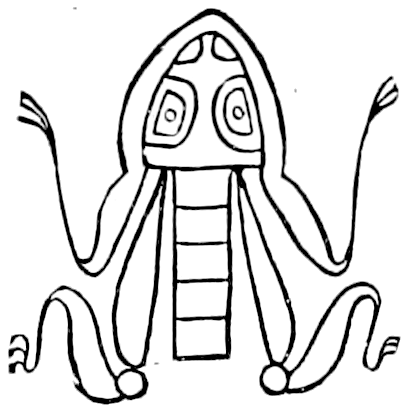
Fig. 528.—Frog, Haida.
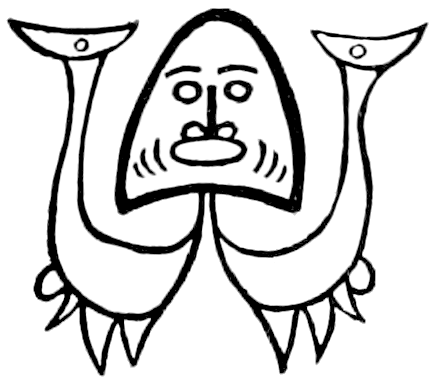
Fig. 529.—Cod, Haida.
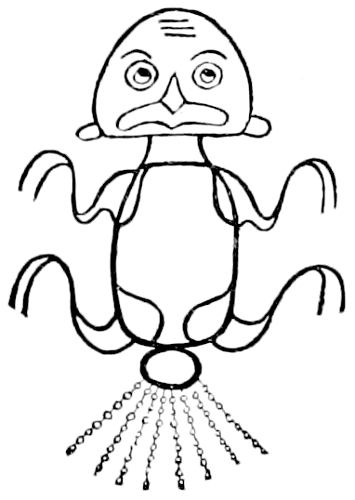
Fig. 530.—Squid, Haida.
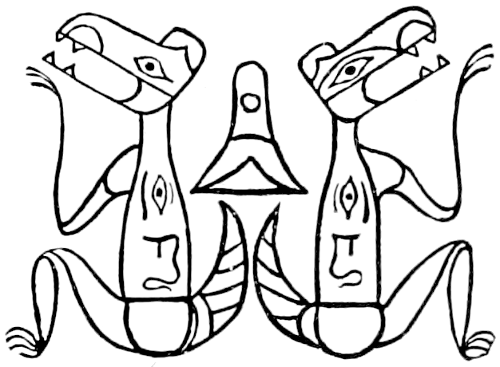
Fig. 531.—Wolf, Haida.
The skulpin, on the right leg of the woman in Fig. 525, is shown enlarged in Fig. 527; the frog on the left leg in Fig. 528. The codfish on the man in Fig. 525 is shown enlarged in Fig. 529; the octopus or squid in Fig. 530.
As the Haidas, both men and women, are very light-colored, some of the latter—full blooded Indians, too—having their skins as fair as Europeans, the tattoo marks show very distinct.
The same author continues:
This tattooing is not all done at one time, nor is it everyone who can tattoo. Certain ones, almost always men, have a natural gift which enables them to excel in this kind of work. One of the young chiefs, named Geneskelos, was the best designer I knew, and ranked among his tribe as a tattooer.
He told me the plan he adopted was first to draw the design carefully on the person with some dark pigment, then prick it in with needles, and then rub over the wound with some more coloring matter till it acquired the proper hue. He had a variety of instruments composed of needles tied neatly to sticks. His favorite one was a flat strip of ivory or bone, to which he had firmly tied five or six needles, with their points projecting beyond the end just far enough to raise the skin without inflicting a dangerous wound, but these needle points stuck out quite sufficiently to make the operation very painful, and although he applied some substance to deaden the sensation of the skin, yet the effect was on some to make them quite sick for a few days; consequently, the whole process of tattooing was not done at one time. As this tattooing is a mark of honor, it is generally done at or just prior to a Tomanawos performance and at the time of raising the heraldic columns in front of the chief’s houses. The tattooing is done in open lodge and is witnessed by the company assembled. Sometimes it takes several years before all the tattooing is done, but when completed and the person well ornamented, then they are happy and can take their seats among the elders.
Other notices about the tattooing of the Indians of the Pacific slope of North America are subjoined.
Stephen Powers (c) says the Karok (California) squaws tattoo in blue three narrow fern leaves perpendicularly on the chin, one falling from each corner of the mouth and one in the middle.
The same author reports, page 76:
Nearly every (Hupâ, California) man has ten lines tattooed across the inside of the left arm about halfway between the wrist and the elbow; and in measuring shell money he takes the string in his right hand, draws one end over his left thumb nail, and if the other end reaches to the uppermost of the tattoo lines the five shells are worth $25 in gold, or $5 a shell. Of course, it is only one in ten thousand that is long enough to reach this high value.
Also on page 96:
The Pátawāt (California) squaws tattoo in blue three narrow pinnate leaves perpendicularly on their chins, and also lines of small dots on the backs of their hands.
On page 148, of the Kástel Pomo:
The women of this and other tribes of the Coast range frequently tattoo a rude representation of a tree or other object covering nearly the whole abdomen and breast.
Of the Wintūns he says, page 233: “The squaws all tattoo three narrow lines, one falling from each corner of the mouth and one between.”
The same author says, on page 109:
The Mattoal, of California, differ from other tribes in that the men tattoo. Their distinctive mark is a round blue spot in the center of the forehead. The women tattoo pretty much all over their faces.
In respect to this matter of tattooing there is a theory entertained by some old pioneers which may be worth the mention. They hold that the reason why the women alone tattoo in all other tribes is that in case they are taken captives their own people may be able to recognize them when there comes an opportunity of ransom. There are two facts which give some color of probability to this reasoning. One is that the California Indians are rent into such infinitesimal divisions, any one of which may be arrayed in deadly feud against another at any moment, that the slight differences in their dialects would not suffice to distinguish the captive squaws. The second is that the squaws almost never attempt any ornamental tattooing, but adhere closely to the plain regulation mark of the tribe.
Blue marks tattooed upon a Mohave woman’s chin denote that she is married. See Whipple (f).
Mr. Gatschet reports that very few Klamath men now tattoo their faces, but such as are still observed have but a single line of black running from the middle of the lower lip to the chin. Half-breed girls appear to have but one perpendicular line tattooed down over the chin while the full-blood women have four perpendicular lines on the chin.
In Bancroft’s Native Races (c), it is stated that the Modoc women tattoo three blue lines, extending perpendicularly from the center and corners of the lower lip to the chin.
The same author on pages 117 and 127 of the same volume says:
The Chippewas have tattooed cheeks and foreheads. Both sexes have blue or black bars or from one to four straight lines to distinguish the tribe to which they[407] belong. They tattoo by entering an awl or needle under the skin and drawing it out, immediately rubbing powdered charcoal into the wounds. * * * On the Yukon river among the Kutchins, the men draw a black stripe down the forehead and the nose, frequently crossing the forehead and cheeks with red lines and streaking the chin alternately with red and black, and the women tattoo the chin with a black pigment.
Stephen Powers, in Overland Monthly, XII, 537, 1874, says of the Normocs:
I saw a squaw who had executed on her cheeks the only representation of a living object which I ever saw done in tattooing. It was a couple of bird’s wings, one on each cheek, done in blue, bottom-edge up, the butt of the wing at the corner of the mouth, and the tip near the ear. It was quite well wrought, both in correctness of form and in delicateness of execution, not only separate feathers but even the filaments of the vane, being finely pricked in.
Dr. Franz Boas (c) says:
Tattooings are found on arms, breast, back, legs, and feet among the Haida; on arms and feet among the Tshimshian, Kwakiutl and Bilqula; on breast and arms among the Nootka; on the jaw among the Coast Salish women.
Among the Nootka scars may frequently be seen running at regular intervals from the shoulder down the breast to the belly, and in the same way down the legs and arms. * * *
Members of tribes practicing the Hamats'a ceremonies show remarkable scars produced by biting. At certain festivals it is the duty of the Hamats'a to bite a piece of flesh out of the arms, leg, or breast of a man.
Dr. im Thurn (c) says:
Tattooing or any other permanent interference with the surface of the skin by way of ornament is practiced only to a very limited extent by the Indians; is used, in fact, only to produce the small distinctive tribal mark which many of them bear at the corners of their mouths or on their arms. It is true that an adult Indian is hardly to be found on whose thighs and arms, or on other parts of whose body are not a greater or less number of indelibly incised straight lines; but these are scars originally made for surgical, not ornamental purposes.
Herndon and Gibbon (a), p. 319, report:
Following the example of the other nations of Brazil (who tattoo themselves with thorns, or pierce their nose, the lips, and the ears,) and obeying an ancient law which commands these different tortures, this baptism of blood, * * * the Mahués have preserved * * * the great festival of the Tocandeira.
Paul Marcoy (b) says of the Passés, Yuris, Barrés, and Chumanas, of Brazil, that they mark their faces (in tattoo) with the totem, or emblem of the nation to which they belong. It is possible at a few steps distant to distinguish one nation from another.
Ancient monarchs adopted special marks to distinguish slaves; likewise for vengeance as an indelible and humiliating brand, a certain tattoo denounced him who had fallen into disgrace with a sovereign. Two monks having censured the iconoclastic frenzy of the emperor[408] Theophilus, he ordered to be imprinted on their foreheads eleven iambic verses; Philip of Macedon, from whom a soldier had solicited the possession of a man saved by him from shipwreck, ordered that on his forehead should be drawn signs indicative of his base greed; Caligula, without any object, commanded the tattooing of the Roman nobles.
In the period of the decline of Rome, tattooing was extensively practiced. Regulative laws prescribed the adopted symbols which were a proof of enlistment in the ranks and on which the military oath was taken. The purpose of this ordinance, which continued in force for a long time, was similar to that which authorized the marking of the slaves, since, the spirit of the people having become degenerated, the army was composed of mercenaries who, if they should run away, must be recognized, pursued, and captured. Until recently the practice, though more as a mark of manhood, was followed by the soldiers of the Piedmontese army.
Élisée Reclus (a) says:
Tattooing was in Polynesia widespread, and so highly developed that the artistic designs covering the body served also to clothe it. In certain islands the operation lasted so long that it had to be begun before the children were six years old, and the pattern was largely left to the skill and cunning of the professional tattooers. Still traditional motives recurred in the ornamental devices of the several tribes, who could usually be recognized by their special tracings, curved or parallel lines, diamond forms and the like. The artists were grouped in schools like the old masters in Europe, and they worked not by incision as in most Melanesian islands, but by punctures with a small comb-like instrument slightly tapped with a mallet. The pigment used in the painful and even dangerous operation was usually the fine charcoal yielded by the nut of Aleurites triloba, an oleaginous plant used for illuminating purposes throughout eastern Polynesia.
The following is from Rev. Richard Taylor (c) about the New Zealanders, Te Ika a Maui:
Before they went to fight, the youth were accustomed to mark their countenances with charcoal in different lines, and their traditions state that this was the beginning of the tattoo, for their wars became so continuous, that to save the trouble of thus constantly painting the face, they made the lines permanent by the moko; it is, however, a question whether it did not arise from a different cause; formerly the grand mass of men who went to fight were the black slaves, and when they fought side by side with their lighter colored masters, the latter on those occasions used charcoal to make it appear they were all one.
Whilst the males had every part of the face tattooed, and the thighs as well, the females had chiefly the chin and the lips, although occasionally they also had their thighs and breasts, with a few smaller marks on different parts of the body as well. There were regular rules for tattooing, and the artist always went systematically to work, beginning at one spot and gradually proceeding to another, each particular part having its distinguishing name.
Fig. 532 is an illustration from the same work, facing page 378. It shows the “grave of an Australian native, with his name, rank, tribe, etc., cut in hieroglyphics on the trees,” which “hieroglyphics” are supposed to be connected with his tattoo marks.
Fig. 533 is a copy of a tattooed head carved by Hongi, and also of the tattooing on a woman’s chin, taken from the work last cited.
The accompanying illustration, Fig. 534, is taken from a bone obtained from a mound in New Zealand, by Prof. I. C. Russell, formerly of the U. S. Geological Survey. He says that the Maori formerly tattooed the bones of enemies, though the custom now seems to have been abandoned. The work consists of sharp, shallow lines, as if made[410] with a sharp-pointed steel instrument, into which some blackish pigment has been rubbed, filling up some of the markings, while in others scarcely a trace remains.
In connection with the use of the tattoo marks as reproduced on artificial objects see Fig. 734.
Fig. 535 is a copy of a photograph obtained in New Zealand by Prof. Russell. It shows tattooing upon the chin.
Prof. Russell, in his sketch of New Zealand, published in the Am. Naturalist, XIII, 72, Feb., 1879, remarks, that the desire of the Maori for ornament is so great that they covered their features with tattooing, transferring indelibly to their faces complicated patterns of curved and spiral lines, similar to the designs with which they decorated their canoes and their houses.
E. J. Wakefield (a) reports of a man observed in New Zealand that he was a tangata tabu or sacred personage, and consequently was not adorned with tatu. He adds, p. 155, that the deeds of the natives are signed with elaborate drawings of the moko or tatu on the chiefs’ faces.
Dr. George Turner (b) says:
Herodotus found among the Thracians that the man who was not tattooed was not respected. It was the same in Samoa. Until a young man was tattooed he was considered in his minority. He could not think of marriage, and he was constantly exposed to taunts and ridicule, as being poor and of low birth, and as having no[411] right to speak in the society of men. But as soon as he was tattooed he passed into his majority, and considered himself entitled to the respect and privileges of mature years. When a youth, therefore, reached the age of 16, he and his friends were all anxiety that he should be tattooed. He was then on the outlook for the tattooing of some young chief with whom he might unite. On these occasions six or a dozen young men would be tattooed at one time, and for these there might be four or five tattooers employed. Tattooing is still kept up to some extent and is a regular profession, just as house-building, and well paid. The custom is traced to mythologic times and has its presiding deities.
In Révue d’Ethnographie (a) (translated) it is published that—
Tattoo marks of Papuan men in New Guinea can be worn on the chest only when the man has killed an enemy. Fig. 26, p. 101, shows the marks upon the chest of Waara, who had killed five men.
Tattoo marks upon parts other than the chest of the bodies of men and women do not seem to have significance. They are made according to the fancy of the designer. Frequently the professional tattooers have styles of their own, which, being popular and generally applied, become customary to a tribe.
The illustration above mentioned is reproduced as Fig. 536.
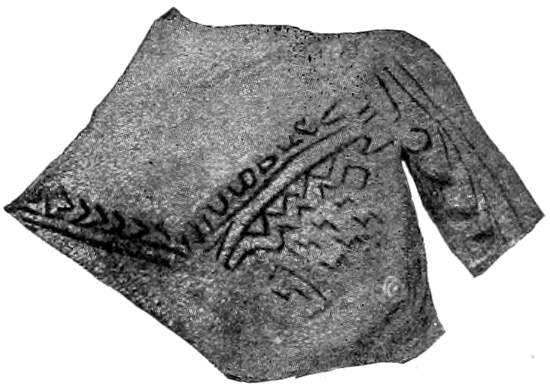
Fig. 536.—Tattoo on Papuan chief.
In the same article, p. 112, is the following, referring to Fig. 537:
Among the Papuans of New Guinea tattooing the chest of females denotes that they are married, though all other parts of the body, including the face and legs, may be tattooed long before; indeed the tattooing of girls may begin at 5 years of age. Fig. 39, p. 112, gives an illustration of a married woman. * * * The different forms of tattoo depend upon the style of the several artists. Family marks are not recognizable, but exist.
De Clercq (a) gives further particulars about tattooing among the Papuans of New Guinea. Among the Sègèt it is only on women. They call it “fadjan,” and the figures consist of two rows of little circles, on each side of the abdomen toward the region of the arm-pit, with a few cross strokes on the outer edge; it is done by pricking with a needle and afterwards the spots are fumigated with the smoke of burning resin. It is said to be intended as an ornament instead of dress, and that young girls do it because young men like to see it.
At Roembati tattooing is called “gomanroeri” and at Sĕkar “béti.” They do it there with bones of fish, with which they prick many holes[412] in the skin until the blood flows, and then smear on it in spots the soot from pans and pots, which, after the staunching of the blood, leaves an ineffaceable bluish spot or streak. Besides the breast and upper arm they also tattoo in the same way the calf of the leg, and in some cases the forehead, as a mere ornamentation, both of men and women—children only in very exceptional cases.
The Bonggose and Sirito are much tattooed over the breast and shoulder. At Saoekorèm, a Doré settlement, a few women were seen tattooed on the breast and in the face. At Doré it is called “pa,” and is done with thorns, and charcoal is rubbed over the bloody spots; only here and at Mansinam is it a sign of mourning; everywhere else it merely serves as ornamentation.
At Ansoes it does not occur much, and is principally in the face; it is there called “toi.” It is found somewhat more commonly on Noord-Japèn, and then on shoulder and upper arm. In Tarfia, Tana-mérah, and Humboldt bay but few persons were tattooed, mostly on the forehead.
The tattooing is always the work of women, generally members of the family, both on men and on women. First the figure is drawn with charcoal, and if it suits the taste then begins the pricking with the thorn of a citrus or a fine bone of some animal. It is very painful and only a small spot can be pricked at one time, so long as the tattooee can stand it. If the pain is too violent, the wounds are gently pressed with a certain leaf that has been warmed, in order to soothe the pain, and the work is continued only after three or four days. No special names are given to the figures; those are chosen which suit the taste. Children are never tattooed at the wish of the parents; it is entirely a matter of individual choice.
Mr. Forbes, in Journ. Anthrop. Inst. G. B. and I., August, 1883, p. 10, says that in Timor Laut, an island of the Malay archipelago—
Both sexes tattoo a few simple devices, circles, stars, and pointed crosses, on the breast, on the brow, on the cheek, and on the wrists, and scar themselves on the arms and shoulders with red-hot stones, in imitation of immense smallpox marks, in order to ward off that disease. * * * I have, however, seen no one variola-marked, nor can I learn of any epidemic of this disease among them.
Prof. Brauns, of Halle, reports, Science, III, No. 50, p. 69, that among the Ainos of Yazo the women tattoo their chins to imitate the beards of the men.
Carl Bock (a) says:
All the married women here are tattooed on the hands and feet and sometimes on the thighs. The decoration is one of the privileges of matrimony and is not permitted to unmarried girls.
In Myths and Songs from the South Pacific, London, 1876, p. 94, it is said that in Mangaia, of the Hervey group, the tattoo is in imitation of the stripes on the two kinds of fish, avini and paoro, the color of which is blue. The legend of this is kept in the song of Iná.
Elisée Reclus (b) says:
Most of the Dayaks tattoo the arms, hands, feet, and thighs; occasionally also breast and temples. The designs, generally of a beautiful blue color on the coppery ground of the body, display great taste, and are nearly always disposed in odd numbers, which, as among so many other peoples, are supposed to be lucky.
In L’Anthropologie (a), 1890, T. I, No. 6, p. 693, it is thus reported:
Tradition tells that the Giao chi, the alleged ancestors of the Annamites, were fishermen and in danger from marine monsters. To prevent disasters from the genii of the waters the king directed the people to tattoo their bodies with the forms of the marine monsters, and afterwards the dragons, crocodiles, etc., ceased their persecution. The custom became universal, and even the kings tattooed a dragon on their thighs as a sign of power and nobility. The same idea was in the painting of eyes, etc., on the prows of Annamite boats, which strongly resembled the sea monsters.
Mr. O’Reilly, the professional tattooer of New York, in a letter, says that he is familiar with the tattoo system of Burmah, and that, besides the ruling principle of ordeal, the Burmese use special tattoo marks to charm and to bring love. They also believe that tattooing the whole person renders the skin impenetrable to weapons.
In Zeitschrift für Ethnologie (a) it is recounted of the Badagas in the Nilgiri mountains, India:
All the women are tattooed on the forehead. The following [Fig. 538] a is the most usual form:

Besides this there occur the following (same Fig., b, c, d, and e):

Besides the forehead, the tattooing of which is obligatory for women, other parts of the body are often tattooed thus (same Fig., f)

Fig. 538.—Badaga tattoo marks.
on each shoulder. Other forms not infrequently found are variously grouped dots, also those shown in the same Fig., g, on the forearm and the back of the hand.
Nordenskiöld (a) gives the following account of tattooing among the Chukchis of Siberia:
It is principally the women that tattoo. The operation is performed by means of pins and soot; perhaps also graphite is employed, which the Chukchis gather. The tattooing of the women seems to be the same along the whole Chukchi coast from Cape Shelagskoy to Bering strait. The usual mode of tattooing is found represented in Nordenskiöld’s “Voyage of the Vega around Asia and Europe,” second part, p. 104. Still the tattooing on the cheek is not rarely more compound than is there shown. The picture given below [Fig. 539] represents a design of tattooing on the cheek.
Girls under nine or ten years are never tattooed. On reaching that age they gradually receive the two streaks running from the point of the nose to the root of the hair; next follow the vertical chin streaks and lastly the tattooing on the cheeks, of which the anterior arches are first formed and the posterior part of the design last. The last named in fact is the part of the design which is oftenest wanting.
The accompanying picture (the left hand of the same Fig.) represents the tattooing of the arms of a woman from the town of T’ápka. The design of the tattooing extends from the shoulder joint, where the upper triple ring is situated, to the hand joint at the bottom. As appears from the drawing, the tattooing on the right and left arm is different.
The men at the winter station of the Vega tattooed themselves only with two short horizontal streaks across the root of the nose. Some of the men at Rerkaypiya (C. North), on the other hand, had a cross tattooed on each cheek bone; others had merely painted similar ones with red mold. Some Chukchis at the latter place had also the upper lip tattooed.
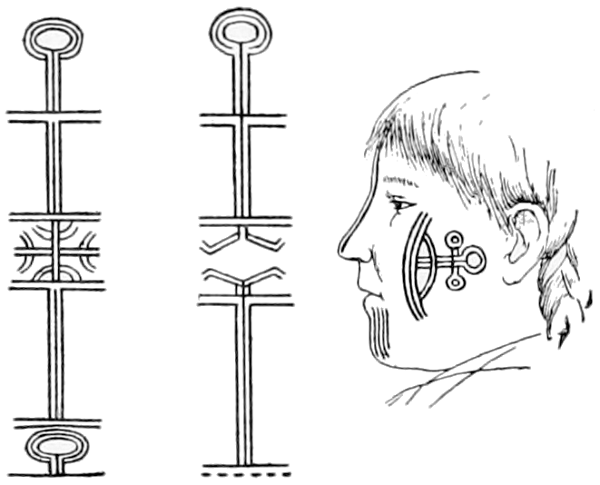
Fig. 539.—Chukchi tattoo marks.
The Chukchi designs are much simpler than those of the Eskimo.
Dr. Bazin, in “Étude sur le Tatouage dans la Régence de Tunis,” in L’Anthropologie (b), tells that the practice of tattooing is very widespread and elaborate in Tunisia, but chiefly among the natives of Arab race, who are nomads, workmen in the towns, and laborers, and also among the fellahs. The Berbers, on the contrary, who have remained mountaineers, the merchants of the coast towns, and the rich proprietors are little or not at all tattooed. In regard to the last class this proves that tattooing has become nothing but an ornament, since the members of this class are clothed in such a way that the legs and arms are completely covered, so that it would be useless to draw figures which would be invisible or almost entirely hidden. He adds[415] that the notables “du Tinge” do not disfigure themselves by incisions. The distinctive sign of the lower classes is the presence of three incisions on the temples, three on the cheeks, and three also on the lower part of the face.
Notes on East-Equatorial Africa, in Bull. Soc. d’Anthro. de Bruxelles (a) contains the following memoranda: Tattooing is done by traveling artists. Perhaps at first it showed tribal characteristics, but now it is difficult to distinguish more than fancy. The exception is that Wawenba alone tattoo the face. The local fetiches bear marks of tattoo.
Gordon Cumming (a) says:
One of the “generals” of Mosielely, King of the Bakatlas group of the Bechuana tribe, had killed about twenty men in battle with his own hand, and bore a mark of honor for every man. This mark was a line tattooed on his ribs.
David Greig Rutherford (a) makes remarks on the people of Batanga, West Tropical Africa, from which the following is extracted:
Tattooing evidently originated in certain marks being applied to the face and other parts of the body in order to distinguish the members of one tribe from those of another. The same marks would be used for both sexes, but as the tendency to ornamentation became developed, they would be apt to observe some artistic method in making them. Among the Dualles the custom at one time appears to have obtained with both sexes, with a preponderance, however, in the practice of it on the side of the women. The men did not always see the force of giving themselves needless pain, but the women, with a shrewd idea that it added to their charms, persisted in having it done. The men (and it is significant that in places where the men have ceased to tattoo themselves they continue to do it for the women) tattooed their children at an early age, but as the girls approached a marriageable age they added, on their own account, various ornamentations to those already existing. As an example that tattooing in its later stages is regarded as an increase of beauty, I may mention an instance given me by the wife of a missionary here. A woman belonging to some neighboring tribe having come to stay at the mission, was presented with a dress of some showy material as an inducement to her to discard the loin cloth she had been in the habit of wearing and as an introduction to the habits of civilized life. She objected to wear the dress, however, upon the ground that if she did so she would thereby hide her beauty. It appears certain that the unmarried woman who is most finely tattooed wins most admiration from the men.
Oscar Peschel (a) describes tattooing as another substitute for raiment and remarks: “That it actually takes away from the impression of nudity is declared by all who have seen fully tattooed Albanese.” As bearing in the same direction Mr. Darwin, in “Voyage of the Beagle,” may be quoted, who, when at New Zealand, speaking of the clean, tidy, and healthy appearance of the young women who acted as servants within the houses, remarks: “The wives of the missionaries tried to persuade them not to be tattooed, but a famous operator having arrived from the south they said: ‘We really must have a few lines on our lips, else when we grow old our lips will shrivel, and we shall be so very ugly.’”
In September, 1891, a Zulu, claiming to be a son of the late Cetewayo, gave to a reporter of the Memphis Avalanche the following account:
When some one expressed a doubt of his coming from Zululand he promptly rolled up his sleeve and showed on his right arm the brand of the tribe. The brand is just below the elbow-joint, and it is of a bright red color, showing conclusively that it had been burned into the flesh. The design is very much on the principle of a double heart with a cross running through the center. The same design has been branded over his left eye in a somewhat smaller shape. When questioned about these brands he said:
“In our country all the men have to have the brand of their tribe burned into their skin so that they can never desert us, and no matter where they are found, you can always tell a Zulu by the brand. Always look for it just over the left eye and on the inside of the right arm. Does it hurt? Oh, no: you see they just take the skin together in their fingers and when the brand is red hot touch it once to the skin and it is all done, and the brand can never wear away.”
The following notes regarding scarification are presented:
Edward M. Curr (b), p. 94, says:
The principal and most general ornament throughout Australia consists of a number of scars raised on the skin. They are made by deep incisions with a flint or shell, which are kept powdered with charcoal or ashes. The wounds thus made remain open for about three months, and, when covered with skin, scars sometimes almost as thick and long as one’s middle finger remain raised above the natural surface of the skin. The incisions are made in rows on various parts of the body, principally on the chest, back, and on the upper muscle of the arm, and less frequently on the thighs and stomach. The breasts of the female are often surrounded with smaller scars. In some tribes dots cut in the skin take the place of scars. The operation is a very painful one, and is often carried out amidst yells of torture. Both sexes are marked in this manner, but the male more extensively than the female.
In the same volume, p. 338, is the following:
When, as often happens, a young man and girl of the Whajook tribe in Australia elope and remain away from the tribe for a time, it is not unusual for them to scar each other in the interim as a memorial of their illicit loves; a singular proceeding when one remembers the agony caused by the operation and the length of time required to get over it. This proceeding is a great aggravation of the original offense in the eyes of husbands.
In Vol. II, p. 414, the same author says:
Men of the Cape river tribe scar their backs and shoulders in this way. Scars are made generally on the left thigh both of the men and women, continues Mr. Chatfield, but occasionally on the right, for the purpose of denoting the particular class to which they belong; but as such a practice would conflict with the custom prevalent throughout the continent as far as known, which is to make these marks for ornament alone, the statement cannot be received without further evidence.
Thomas Worsnop, in the Prehistoric Arts of the Aborigines of Australia, says:
This practice of tattooing by scarification was common all over the continent, varying in character amongst the respective tribes, each having its own distinctive marks, although all patterned upon one monotonous idea.
This is far from evidence of distinct tribal marks, the slight varieties of which may be only local or tribal fashions.
Alfred C. Haddon (a), p. 366, says:
Tattooing is unknown, but the body used to be ornamented with raised cicatrices. * * * The Torres strait islanders are distinguished by a large, complicated, oval[417] scar, only slightly raised and of neat construction. This, which I have been told has some connection with a turtle, occupies the right shoulder and is occasionally repeated on the left. I suspect that a young man was not allowed to bear a cicatrice until he had killed his first turtle or dugong.
The same author, op. cit., says of the Mabuiag of Torres straits:
The people were formerly divided up into a number of clans. * * * A man belonging to one clan could not wear the badge of the totem of another clan. * * * All the totems appear to have been animals—as the crocodile, snake, turtle, dugong, dog, cassowary, shark, sting-ray, kingfish, etc.
The same writer, in Notes on Mr. Beardsmore’s paper, in Jour. Anthrop. Inst. of Gr. Br. and I. (a), says:
A large number of the women of Mowat, New Guinea, have a Λ-shaped scar above the breasts. * * * Maino of Tud told me that it was cut when the brother leaves the father’s house and goes to live with the men; and another informant’s story was that it was made when a brother harpooned his first dugong or turtle. Maino (who, by the by, married a Mowat woman) said that a mark on the cheek recorded the brother’s prowess.
D’Albertis (c) tells that the people of New Guinea produced scars “by making an incision in the skin and then for a lengthened period irritating it with lime and soot. * * * They use some scars as a sign that they have traveled, and tattoo an additional figure above the right breast on the accomplishment of every additional journey. * * * In Yuli island women have nearly the whole body covered with marks. Children are seldom tattooed; slaves never. Men are hardly ever tattooed, though they have frequently marks on the chest and shoulders; rarely on the face. Tribes and families are recognized by tattoo marks.”
Mr. Griffith, in his paper on Sierra Leone, in Jour. Anthrop. Inst. of Gr. Br. and I. (b), says:
The girls are cut on their backs and loins in such a manner as to leave raised scars, which project above the surface of the skin about one-eighth of an inch. They then receive Boondoo names, and after recovery from the painful operation are released from Boondoo with great ceremony and gesticulation by some who personate Boondoo devils. They are then publicly pronounced marriageable.
Dr. Holub (b), speaking of three cuts on the breast of a Koranna of Central South Africa, says:
They have among themselves a kind of freemasonry. Some of them have on their chest three cuts. When they were asked what was the reason of it they generally refused to answer, but after gaining their confidence they confessed that they belonged to something like a secret society, and they said, “I can go through all the valleys inhabited by Korannas and Griquas, and wherever I go when I open my coat and show these three cuts I am sure to be well received.”
Mr. H. H. Johnston (a) tells us that scarification is practiced right along the course of the Congo up to the Stanley falls. The marks thus made are tribal. Thus the Bateke are always distinguished by five or six striated lines across the cheek bones, while the Bayansi scar their foreheads with a horizontal or vertical band.
E. Brussaux, in L’Anthropologie (c), reports that scarifications in Congo, which are chiefly on the back, are made for therapeutic reasons.
Julian Thomas (a) gives the following description of a New Hebrides woman:
She had a pattern traced over her throat and breast like a scarf. It was done with a shark’s tooth when a child. The women’s skins are blistered up into flowers and ferns. The skin is cut and earth and ashes placed inside the gashes, and the flesh grows into these forms. Of course they do not cover up these beauties by clothing.
According to Mr. Man, Journ. Anthrop. Inst. of Gr. Br. and I. (c), the Andamanese, who also tattoo by means of gashing, do so first by way of ornament, and, secondly, to prove the courage of the individual operated upon and his or her power of enduring pain.
Many notes on the topic are omitted, especially those relating mainly to the methods of and the instruments used in the operation. But from those presented above it appears that tattooing still is or very recently was used in various parts of the world for many purposes besides the specific object of designating a tribe, clan, or family, and also apart from the general intent of personal ornament. The most notable of those purposes are as follows: 1, to distinguish between free and slave without reference to the tribe of the latter; 2, to distinguish between a high and low status in the same tribe; 3, as a certificate of bravery exhibited by supporting the ordeal of pain; 4, as marks of personal prowess, particularly, 5, as a record of achievements in war; 6, to show religious symbols; 7, as a therapeutic remedy for disease, and 8, as a prophylactic against disease; 9, as a brand of disgrace; 10, as a token of a woman’s marriage, or, sometimes, 11, of her marriageable condition; 12, identification of the person, not as tribesman or clansman, but as an individual; 13, to charm the other sex magically; 14, to inspire fear in the enemy; 15, to magically render the skin impenetrable by weapons; 16, to bring good fortune; and 17, as the device of a secret society.
The use of tattoo marks as certificates and records of prowess in war is considered to be of special importance in any discussion of their origin. A warrior returns from the field stained with blood from an honorable wound, the scars of which he afterwards proudly displays. It would be strictly in the line of ideography to make artificial scars or to paint the semblance of wounds on the person as designations of honor, and from such origin quite as well as from a totemic representation all other forms and uses may have been evolved. For instance, the vigor of manhood being thus signified, the similar use would show the maturity of women. Yet some of the practices of tattoo may have originated independently of either totem or glory mark. The mere idea of decoration as shown in what civilized people call deformations of nose, lip, ear, teeth, and in fact all parts of the body, is sufficient to account for the inception of any form of tattoo. Primitive man never[419] seemed to be content to leave the surface of his body in its natural condition, and from recognition of that discontent studies of clothing and of ornament should take their point of departure.
In this paper many examples are presented of the use, especially by the North American Indians, of tribal signs carved or painted on rock, tree, bark, skin, and other materials, and suggestion is made of an interesting connection between these designs and those of heraldry in Europe. It would, therefore, seem natural that the same Indians who probably for ages used such totemic and tribal devices should paint or tattoo them on their own persons, and the meagerness of the evidence that they actually did so is surprising. Undoubtedly the statement has been made in a general way by some of the earlier explorers and travelers, but when analyzed it is frequently little more than a vague expression of opinion, perhaps based on a preconceived theory. Nearly all the Indian tribes have peculiarities of arrangement of the hair and of some article of apparel and accouterment by which they can always be distinguished. These are not totemic, nor are they by design expressions of a tribal character. They come under the heading of fashion, and such fashions in clothing and in arrangement of the hair still exist among civilized peoples, so that the people of one nation or province can at once be distinguished from others. Very little appears from the account of actual observers to show that the character of the tattoo marks of the North American Indians, perhaps excluding those of the northwest coast, was more than a tribal fashion. Such styles or fashions with no intent or deliberate purpose that they should serve as tribal signs prevail to-day in Africa and in some other regions, and have been introduced by the professional artists who had several styles. Besides the necessary influence of a school of artists, it is obvious that people living together would contract and maintain the same custom and fashion in their cutaneous decoration.
These are divided into: (1) Insignia or tokens of authority. (2) Signs of individual achievements. (3) Property marks. (4) Personal names.
Champlain (e) says of the Iroquois in 1609:
Those who wore three large “pannaches” [plumes] were the chiefs, and the three chiefs delineated have their plumes much larger than those of their companions who were simple warriors.
In Travels of Lewis and Clarke (a) it is said:
Among the Teton Sioux the interior police of a village is confided to two or three officers who are named by the chief for the purpose of preserving order, and remain in power some days, at least till the chief appoints a successor; they seem to be a sort of constable or sentinel, since they are always on the watch to keep tranquility during the day and guarding the camp in the night. * * * Their distinguishing mark is a collection of two or three raven skins fixed to the girdle behind the back in such a way that the tails stick out horizontally from the body. On the head too is a raven skin split into two parts and tied so as to let the beak project from the forehead.
In James’s Long (d) it is reported that—
Among the Omaha on all occasions of public rejoicings, festivals, dances, or general hunts, a certain number of resolute warriors are previously appointed to preserve order and keep the peace. In token of their office they paint themselves entirely black; usually wear the crow, and arm themselves with a whip or war-club with which they punish on the spot those who misbehave, and are at once both judges and executioners.
Prince Maximilian of Wied (a) says:
In every numerous war party there are four leaders (partisans, karokkanakah) sometimes seven, but only four are reckoned as the real partisans; the others are called bad partisans (karokkanakah-chakohosch, literally, partisans galeux). All partisans carry on their backs a medicine pipe in a case which other warriors dare not have. To become a chief (Numakschi) a man must have been a partisan and then kill an enemy when he is not a partisan. If he follows another partisan for the second time he must have first discovered the enemy, have killed one and then possessed the hide of a white buffalo cow complete with the horns to pretend to the title of chief (Numakschi). * * * All the warriors wear small war pipes round their necks, which are often very elegantly ornamented with porcupine quills.
Pls. XXVI and XXVII are illustrations specially relating to insignia of office selected from an important and unique pictorial roster of the heads of Oglala families, eighty-four in number, in the band of Chief Big-Road, which were obtained by Rev. S. D. Hinman at Standing Rock Agency, Dakota, in 1883, from the United States Indian agent, Maj. McLaughlin, to whom the original had been delivered by Chief Big-Road when brought to that agency and required to give an account of his followers. Other selections from this Oglala Roster appear under the headings of Ideography, Personal names, Comparisons, Customs, Gestures, Religion, and Conventionalizing.
Chief Big Road and his people belong to the northern Oglala, and at the time mentioned had been lately associated with Sitting-Bull in various depredations and hostilities against settlers and the United States authorities. The translations of the names have been verified and the Oglala name attached. At the date of the roster Chief Big-Road was above 50 years old, and was as ignorant and uncompromising a savage in mind and appearance, as one could well find.
The drawings in the original are on a single sheet of foolscap paper, made with black and colored pencils, and a few characters are in yellow-ocher waters color paint. They were made for the occasion with the materials procured at the agency.
Pl. XXVI exhibits the five principal chiefs with their insignia. Each[421] has before him a decorated pipe and pouch, the design of each being distinct from the others. The use of pipes as insignia for leaders is frequently mentioned in this work. The five chiefs do not have the war club, their rank being shown by pipe and pouch. Each of the five chiefs has at least three transverse bands on the cheek, with differentiations of the pattern.
Pl. XXVII shows the subchiefs of the band. The three red bands are the sign that they are Akicita-itacanpi, which means head soldiers—captains in war, and captains of police in civil administration. Each of them is decorated with three red transverse bands on the cheek and carries a war club held vertically before the person.
The other male figures not represented in the plates have in general each but a single red band on the cheek; others, two bands, red and blue. These are merely ornamental and without significance.
It will be noticed that in this series the device indicating the name is not generally connected by lines with the mouth but only when there is a natural connection with it. It appears attached by a line to the crown of the head, but sometimes without any connecting line.
Pl. XXVI shows the five principal chiefs of the Oglala in 1883, who are severally designated as follows:
a. Cankutanka, Big-Road. Big-Road is often called Good-Road because a road that is big or broad and well traveled is good. The tracks on both sides of the line indicating a mere path show that the road is big. The bird flying through the dusk indicates the rapidity of travel which the good road allows. This is the same chief as the following:
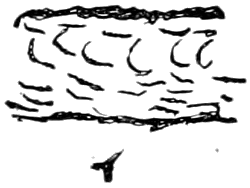
Fig. 540.—Big-Road.
Fig. 540, Big-Road as appearing in Red-Cloud’s Census, No. 96. The broad and big road is indicated by the artist of that series as having distinctly marked sides and horsetracks between these roadsides. In this instance as in several others it is obvious that the ideographic device was not fixed but elastic and subject to variation, the intention being solely to preserve the idea.
b. Sunka-kuciyela, Low-Dog. The dog figure is represented as “low” by the shortness of the legs as compared with the next figure of Long-Dog.
c. Sunka-hanska, Long-Dog. This term “long” is in the pictography of the Siouan tribes, but is differently translated as tall. There is a marked variation in the length of the legs between this and the next foregoing.
d. Kangi-maza, Iron-Crow. The term “iron” is explained above. The color blue is always used in Dakotan pictography for the word translated as iron.
e. Cetan-cigala, Little-Hawk.
Pl. XXVII shows the subchiefs or partisans of the Oglala at the time of the roster in 1883.
a. Represents Tatanka-he-luta, Red-horn-Bull. The bull’s horns have been made bloody by goring.
b. Represents Cetan-watakpe, Charging-Hawk. This subchief also appears with a slightly different form of “charging” in Red-Cloud’s Census, in which the bird is represented head downward.

Fig. 541.—Charging-Hawk.
Fig. 541.—Charging-Hawk, from Red-Cloud’s Census, No. 142. On careful examination the bird is seen to be not erect, as at first appears, but is swooping down.
c. Represents Wiyaka-aopazan, Wears-the-Feather. The feather in its conventional form is presented twice, once connected by a line with the mouth and also over the war club as in common with other pictures of this series. The same person is represented next below.

Fig. 542.—Feather-on-his-Head.
Fig. 542.—Feather-on-his-Head, from Red-Cloud’s Census, No. 86. In this case the feather droops while it is erect in the figure next above. No significance is indicated in the slight variation.
d. Represents Pankeskahoksila, Shell-Boy. The shell is the circular object over the head of the small human figure, which is without the proper number of legs, showing perhaps that he can not march, and his open, weaponless hands say that he is not a warrior, i. e., he is a boy. The object, now translated shell, was originally a large excrescence on the trunk of a tree which was often cut away by the Dakotas, hollowed out and used as a bowl.
e. Mato-niyanpi, The-Bear-spares-him. The bear passing through the marks of several tracks indicates an incident not explained, in which the subchief was in danger.
f. Represents Cetan-maza, Iron-Hawk. The bird is colored blue, as before explained.
g. Represents Kangi-luta, Red-Crow.
h. Represents Situpi-ska, White-Tail. The bird is probably one of the hawks, as is more distinctly indicated in the representation of the same name as follows:
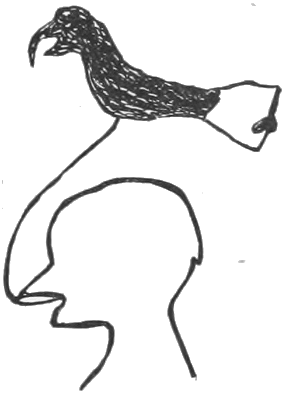
Fig. 543.—White-Tail.
Fig. 543.—White-Tail; from Red-Cloud’s Census, No. 190. This is inserted for convenient comparison with the foregoing, being a slightly variant device for the same person.
i. Represents Mato-ska, White-Bear.
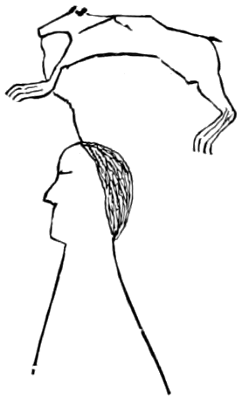
Fig. 544.—White-Bear.
Fig. 544.—White-Bear; from Red-Cloud’s Census, No. 252. This is inserted here for comparison of the drawings. The characteristics of the animal appear in both.
k. Represents Mato-najin, Standing-Grizzly-Bear. The differentiations of these and other similar positions of the same object remind one of the heraldic devices “statant,” “regardant,” “passant,” and the like.
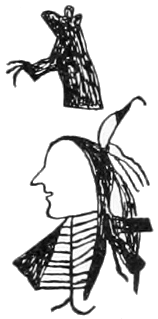
Fig. 545.—Standing-Bear.
Fig. 545.—Standing-Bear; from Red-Cloud’s Census, No. 140. This is probably the same man as in the last-mentioned figure, though the fancy of the artist has blazoned the bear as demi. This was, however, for convenience and without special significance, as the forequarters are not indicated in the name. But that might well have been done if the device were strictly totemic and connected with the taboo. Some of the bear gens are only allowed to eat the fore quarters of the animal, others the hind quarters.
l. Represents Tatanka-najin, Standing-Buffalo-Bull.
m. Represents Tasunke-inyanke, His-Running-Horse. This man was probably the owner of a well known racing pony.
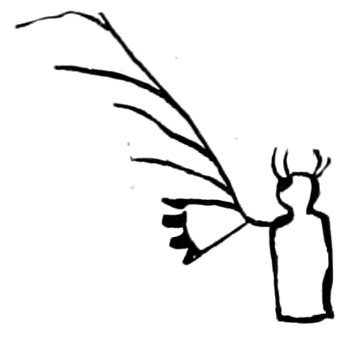
Fig. 546.—Four-Horn calumet.
Fig. 546.—A Minneconjou Dakota, named Red-Fish’s-Son, danced the calumet dance. The-Swan’s Winter Count, 1856-’57.
Maj. Bush says: “A Minneconjou, Red-Fish’s-Son, The-Ass, danced the Four-Horn calumet.”
The peculiarly ornamented pipe, frequently portrayed and mentioned in the parts of the paper relative to the Dakotas, is, at least for the time of the duration of the ceremonies, the sign of the person who leads them.
In connection with the display of pipes as insignia of authority and rank, Figs. 547 and 548 are introduced here.
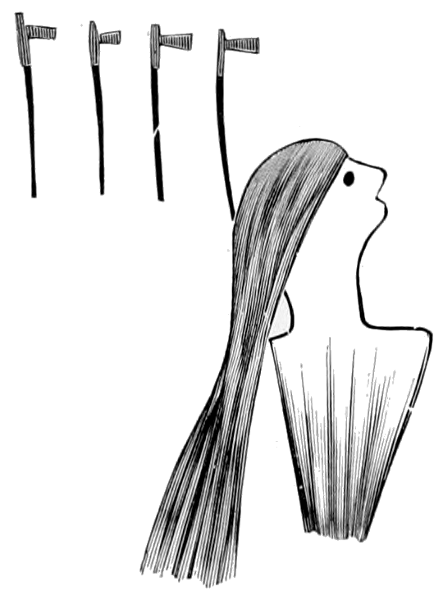
Fig. 547.—Two-Strike as partisan.
Fig. 547, drawn and explained by an Oglala Dakota, exhibits four erect pipes, to show that he had led four war parties.
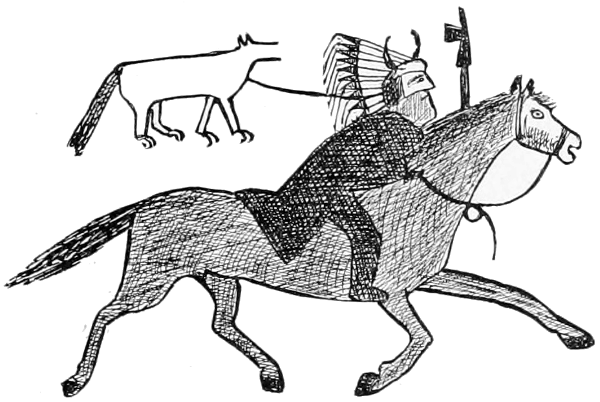
Fig. 548.—Lean-Wolf as partisan.
Fig. 548 is a copy of a drawing made by Lean-Wolf, when second chief of the Hidatsa, to represent himself. The horns on his head-dress show that he is a chief. The eagle feathers on his war bonnet, arranged in the special manner portrayed, also show high distinction as a warrior. His authority as “partisan,” or leader of a war party, is represented by the elevated pipe. His name is also added, with the usual line drawn from the head. He explained the outline character of the wolf, having a white body with the mouth unfinished, to show that it was hollow, nothing there; i. e., lean. The animal’s tail is drawn in detail and dark, to distinguish it from the body.
The character for “partisan” is also shown in Lone-Dog’s Winter Count for the year 1842-’43.
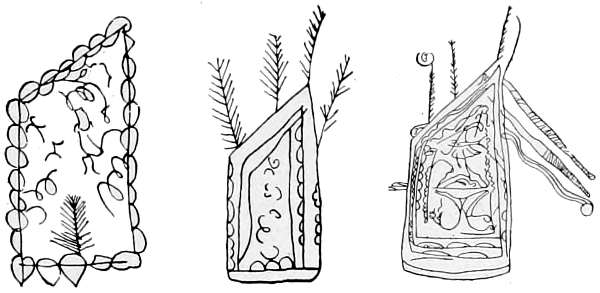
Fig. 549.—Micmac head dress in pictographs.
Fig. 549 gives three examples, actual size, of a large number of similar designs scratched on the rocks of Kejimkoojik lake, Nova Scotia. They were at first considered to be connected with the ceremonial or[425] mystery lodges, many sketches of which appear on the same rocks, and examples of which are given in Figs. 717 and 718. Undoubtedly there is some connection between the designs, but those now under consideration are recognized by the Indians of the general locality as the elaborate forms of head dress sometimes so extended as to become masks, which are still worn by a few of the Micmac and Abnaki women. Those women are or were of special authority and held positions in social and religious ceremonies. Their ornamental head coverings therefore were insignia of their rank. The modern specimens seen by the present writer are elaborately wrought with beads, quills, and embroidery on fine cloth, velvet or satin, but were originally of skin. The patterns still used show some fantastic connection with those of the rock drawings of this class, and again the latter reproduce some of the tracings on the ground plans of the mystery lodges before mentioned. The feathery branches of trees appearing on both of the two classes of illustrations are in the modern head coverings actual feathers. The first of the three figures shows the branch or feather inside of the pattern, and the other two have them outside, in which variation the bushes or branches of the medicine lodges show a similar proportion. The third sketch, in addition to the exterior feathers, shows flags or streamers, which in the ceremonial head gear in present use is imitated by ribbons.
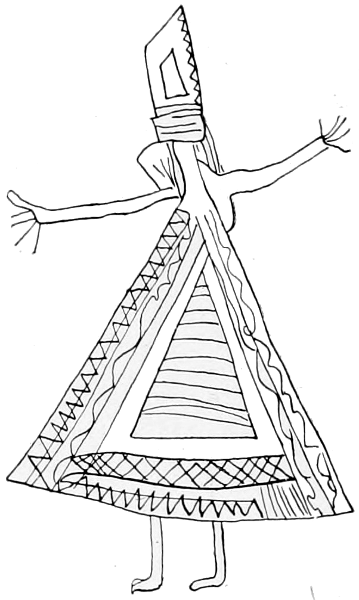
Fig. 550.—Micmac chieftainess in pictograph.
If there had been any doubt remaining of the interpretation of this class of drawing it would be removed by the presence of a number of contiguous and obviously contemporary sketches of which Fig. 550 is an example. Here the female chieftain or, perhaps, priestess appears in a ceremonial robe, with her head completely covered by one of these capote masks. The researches made not only establish the significance of this puzzling class of designs, but also show that their authors were of the Abnaki or Micmac branches of the Algonquian linguistic family.
The two lower drawings in Fig. 551 were printed from the Kejimkoojik slate rocks, Nova Scotia, and are recognized by Micmacs of that peninsula as copies of insignia which they say their chiefs used to wear. The designs show some marks suggesting the artistic devices used in the Roman Catholic Church, though the figuration of the cross is by no means conclusive of European origin. The use of gorgets and other ornaments bearing special designs, as insignia of rank and authority, was well established, and it is quite possible that some of the Micmac designs were affected by the influence of the early missionaries, who indeed may have issued to the chiefs of their flock medals which adopted the general aboriginal style, but were redeemed by Christian symbols. There is no intrinsic evidence to decide whether these particular drawings were or were not made before the arrival of the earliest French missionaries.
The upper right-hand drawing of the three trees with peculiar devices[427] near their several roots was also printed from one of the Kejimkoojik rocks. It became intelligible to the present writer after examination of a silver disk in the possession of Mrs. W. Wallace Brown, of Calais, Maine, which, not long before, had been owned by the head chief of the Passamaquoddy tribe, whose title had been modernized into “governor.” The disk, which is copied in the upper left-hand corner, was probably not of Indian workmanship, but appeared to have been ordered from a silversmith to be made from a Passamaquoddy design. It was known to represent the three superior officers of the tribe mentioned and had been worn by a former governor as a prized sign of his rank. The middle[429] device is for the governor and the right and left for the officers next in rank to him. The devices at the roots of the trees of the drawing before mentioned are noticeably similar. They may have been made, as were most of the other characters on the Kejimkoojik rocks, by the Micmacs, in which case it would seem that they designated their chiefs by emblems similar to those used by their congeners of the Passamaquoddy tribe or some member of the last-named tribe may have drawn the emblem on the rocks in the Micmac territory. In any case there is encouragement in the attempt to decipher petroglyphs from the fact that the tree drawing in Nova Scotia, which seemed without significance, was readily elucidated by a metal inscription found in Maine, the interpretation being verified through living Indians, not only in the two geographic divisions mentioned, but also by the Amalecites in New Brunswick.
Father P. J. De Smet (b), referring to the Piegan and Blackfeet or Satsika, describes the great Tail-Bearer:
His tail, composed of buffalo and horse hair, is about 7 or 8 feet long, and instead of wearing it behind, according to the usual fashion, it is fastened above his forehead and there formed into a spiral coil resembling a rhinoceros’s horn. Such a tail among the Blackfeet is a mark of greater distinction and bravery—in all probability the larger the tail the braver the person.
The following description of a Chilkat ceremonial shirt, with the illustration reproduced in Fig. 552, is taken from Niblack (c):
The upper character in the figure represents the sea lion, and that below is a rear view of the same shirt ornamented with a design of wasko, a mythological animal of the wolf species. The edges and arm holes are bordered with red cloth and the whole garment is neatly made.
The same authority describes a Chilkat cloak, with the illustration reproduced as Fig. 553, as follows:
It represents a cloak with a neck opening, ornamented in red cloth with the totemic design of the Orca or Killer. It is in the form of a truncated cone, with no openings for the arms.
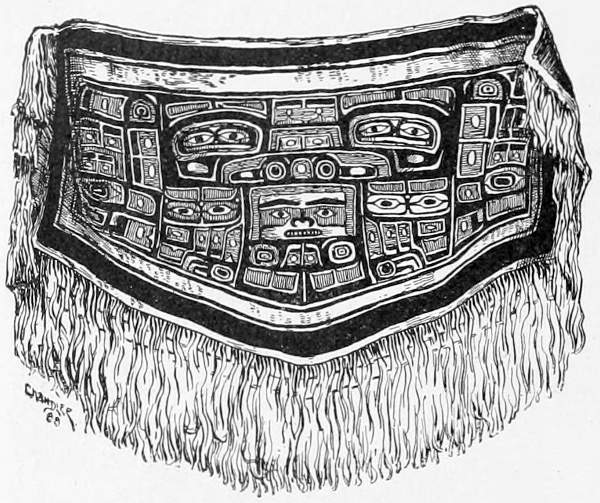
Fig. 554.—Chilkat ceremonial blanket.
The same author gives description accompanying Pl. X, Figs. 33 and 34, of ceremonial blankets and coats. The first-mentioned drawing is reproduced here as Fig. 554:
It is worn by Indians of rank and wealth on the northwest coast, commonly called a “Chilkat blanket,” because the best specimens come from the Chilkat country, although other tribes are more or less expert in weaving them. The warp is composed of twisted cord or twine of cedar bark fiber, and the woof of worsted spun from the wool of the mountain goat. Brown, yellow, black, and white are the colors used, and these are skillfully wrought into a pattern representing the totem or a totemic legend of the owner.
The design on the blanket shown represents Hoorts, the bear.
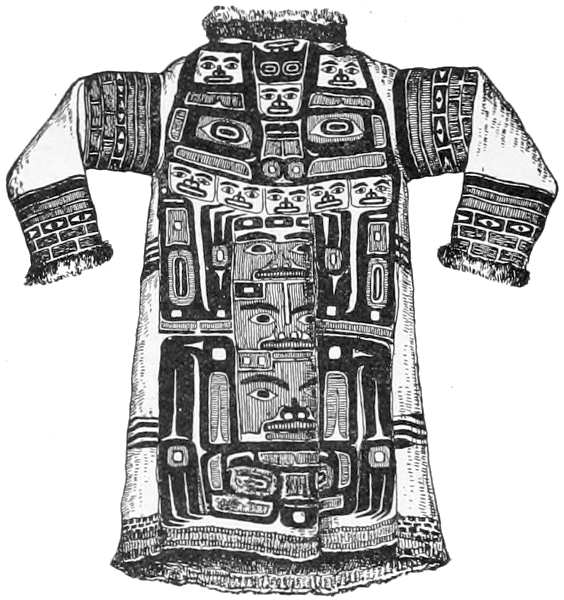
Fig. 555.—Chilkat ceremonial coat.
Fig. 555 is described thus: “A ceremonial shirt or coat of similar workmanship as the blanket just described, is trimmed on the collar and cuffs with sea-otter fur.”
In the Verhandl. der Berliner Gesellsch. für Anthrop. (a) is the illustration from which Fig. 556 is reproduced. It shows a group of Bella Coola Indians, which is made interesting by the elaborate ceremonial coat worn by the middle figure in the foreground.
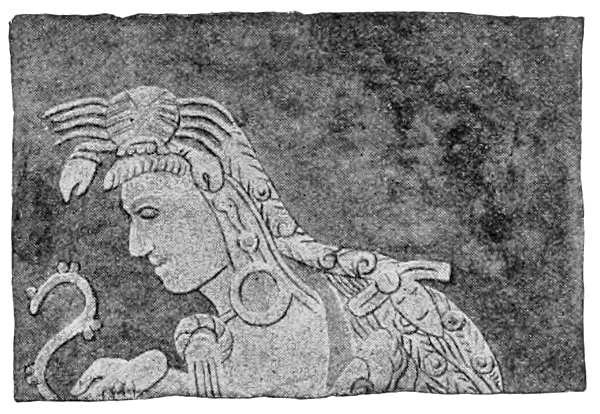
Fig. 557.—Guatemala priest.
Dr. S. Habel (c) gives the following description of Fig. 557, which reproduces only the upper part of the sculpture:
The design represents in low relief an erect human figure in profile, with the head and shoulders slightly inclined forward. The body is apparently naked, excepting those portions which are concealed by elaborate ornaments, the most prominent of which is a crab covering the head. Since there is every reason to believe the figure to represent a priest, the crab may be taken as the emblem of priestly rank.
Pls. LXV and LXVI of the Codex Mendoza, in Vol. I of Lord Kingsborough’s Antiquities of Mexico, exhibit the devices and insignia of[432] the soldiers who advanced step by step to higher command, according to their military achievements. The chief criterion, indeed the only one mentioned for these steps and promotions, was the number of prisoners severally taken by the soldiers in war. From the large number of degrees in rank and titles of valor expressed in the above-mentioned plates, a number have been selected and copies of them, exact in drawing, size, and coloration, are presented here in Pls. XXVIII and XXIX. The quaint text relating to them is in Kingsborough (p).
Pl. XXVIII.—a represents a young man who if he took any prisoners was presented with a square mantle bearing a device of flowers as a sign of valor. He holds a prisoner by the hair. b: This brave man has been presented with a device of arms, which he wears, and with a square orange-colored mantle with a scarlet fringe besides, as a sign of valor, on account of his having taken prisoner two of the enemy, one of whom he holds by the hair. c: This brave man, whose title is that of Quachie, and device of arms such as he wears, bears proof that he has captured five prisoners in war, besides having taken many other prisoners from the enemy in other wars. He also is drawn holding a prisoner. d: This brave man, whose title is Tlacatecatl and device the robe which he wears, with his braided hair and the insignia of a rich plume, declares by his presence that he has obtained the title of a valiant and distinguished person, by merit surpassing that of the others who are represented behind him.
In Pl. XXIX.—a: An Alfaqui or superior officer, who merits further promotion and to whom has been presented as a reward for his valor, on account of his having taken three prisoners in war, the device and arms which he wears. He grasps a prisoner by the hair. b: The same Alfaqui, who, as a sign of valor on account of his having captured four of the enemy, has been presented with the device of arms which he wears. He holds a prisoner as before.
Each one of the remaining figures in the plate of Kingsborough declares the titles which officers gained and acquired in the exercise of arms, by which they rose to higher rank, the kings of Mexico creating them captains and generals of their forces or as officers of dispatch [similar to aids-de-camp] to execute their orders, whether they related to the affairs of their own kingdom or to those of the other vassal states, who promptly obeyed without in any manner deviating from the commands which they had received. The two selected are shown in the present Pl. XXIX, viz: c, Ezguaguacatl, an officer of dispatch, and d, Tocinltecatl, a man of distinguished courage in war and one of the officers who filled the post of generals of the Mexican armies.
Wiener (b), p. 763, says:
Passing in review the numerous delineations of men on the different tissues in the Peruvian graves, it is to be remarked that a chief is always recognized by a panache, which for the decurion has two plumes, for the centurion four, for the chief of a thousand men six, and the colors of these plumes indicate civil or military functions.
A. W. Howitt (e) says:
Messengers in central Australia sent to form a Pinya to avenge a death wear a kind of net on the head and a white frontlet in which is stuck a feather. The messenger is painted with yellow ochre and pipeclay and bears a bunch of emu feathers stuck in his girdle at the back, at the spine. He carries part of the deceased’s beard or some balls of pipeclay from the head of one of those mourning for him. These are shown at the destination of the messenger and are at once understood.
The same author, p. 78, reports:
A third party which the Dieri sent out was the dreaded Pinya. It was the avenger of the dead, of those who were believed to have been done to death by sorcery.
The appearance at a camp of one or more men marked each with a white band round the head, with diagonal white and red stripes across the breast and stomach, and with the point of the beard tied up and tipped with human hair, is the sign of a Pinya being about. These men do not converse on ordinary matters, and their appearance is a warning to the camp to listen attentively and to reply truly to such questions as may be put concerning the whereabouts of the condemned man. Knowing the remorseless spirit of the Pinya, any and every question is answered in terror.
Prince Maximilian of Wied, (b) gives an account explanatory of Figs. 558 and 559:
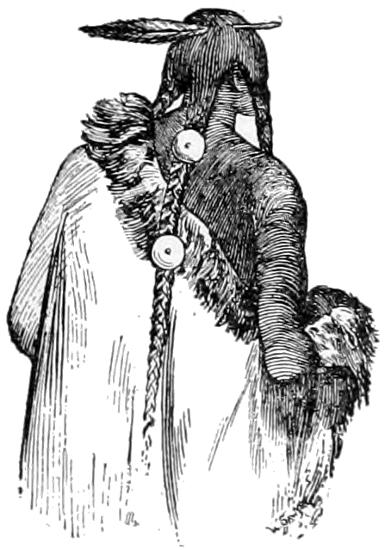
Fig. 558.—Mark of exploit. Dakota.
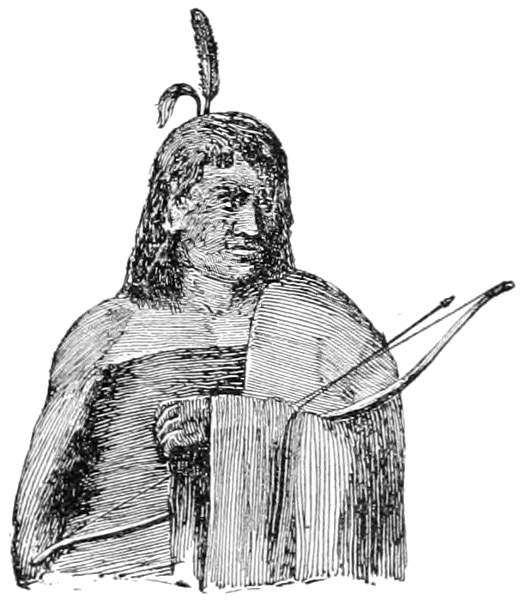
Fig. 559.—Killed with fist. Dakota.
The Sioux highly prize personal bravery, and therefore constantly wear the marks of distinction which they have received for their exploits; among these are, especially, tufts of human hair attached to the arms and legs, and feathers on their heads. He who, in the sight of the adversaries, touches a slain or living enemy places a feather horizontally in his hair for this exploit.
They look upon this as a very distinguished act, for many are killed in the attempt before the object is attained. He who kills an enemy by a blow with his fist sticks a feather upright in his hair.
If the enemy is killed with a musket a small piece of wood is put in the hair, which is intended to represent a ramrod. If a warrior is distinguished by many deeds he has a right to wear the great feather-cap with ox-horns. This cap, composed of eagle feathers, which are fastened to a long strip of red cloth hanging down the back, is highly valued by all the tribes on the Missouri. * * * Whoever first[434] discovers the enemy and gives notice to his comrades of their approach is allowed to wear a small feather which is stripped except towards the top.
The following scheme, used by the Dakotas, is taken from Mrs. Eastman’s Dahcotah. Colors are not given, but red undoubtedly predominates, as is known from personal observation.
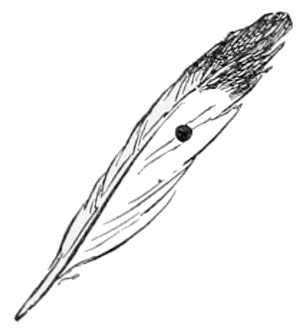
Fig. 560.—Killed an enemy. Dakota.
A spot upon the larger web denotes that the wearer has killed an enemy. Fig. 560.
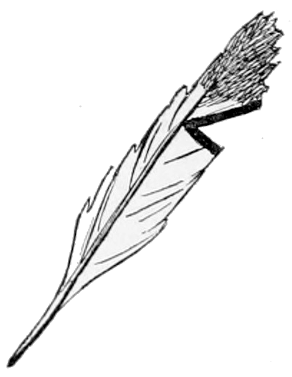
Fig. 561.—Cut throat and scalped. Dakota.
Fig. 561 denotes that the wearer has cut the throat of his enemy and taken his scalp.
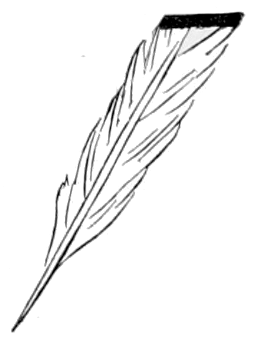
Fig. 562.—Cut enemy’s throat. Dakota.
Fig. 562 denotes that the wearer has cut the throat of his enemy.
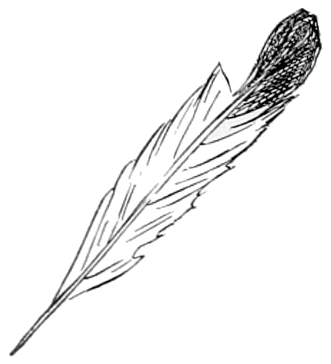
Fig. 563.—Third to strike. Dakota.
Fig. 563 denotes that the wearer was the third that touched the body of his enemy after he was killed.
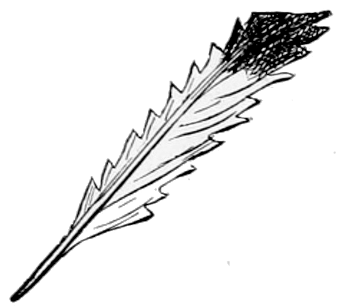
Fig. 564.—Fourth to strike. Dakota.
Fig. 564 denotes that the wearer was the fourth that touched the body of his enemy after he was killed.
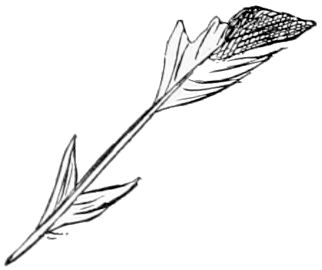
Fig. 565.—Fifth to strike. Dakota.
Fig. 565 denotes that the wearer was the fifth that touched the body of his enemy after he was killed.
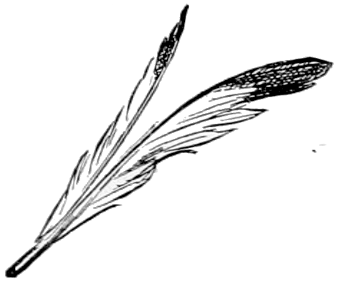
Fig. 566.—Many wounds. Dakota.
Fig. 566 denotes that the wearer has been wounded in many places by the enemy.
The following variations in the scheme were noticed in 1883 among the Mdewakantanwan Dakotas, near Fort Snelling, Minnesota.
Feathers of the eagle are used as among the other bands of Dakotas.
A plain feather is used to signify that the wearer has killed an enemy, without regard to the manner in which he was slain.
When the end is clipped transversely, and the edge colored red, it signifies that the throat of the enemy was cut.
A black feather denotes that an Ojibwa woman was killed. Enemies are considered as Ojibwas, that being the tribe with which the Mdewakantanwan Dakotas have been most in collision.
When a warrior has been wounded a red spot is painted upon the broad side of a feather. If the wearer has been shot in the body, arms, or legs, a red spot is painted upon his clothing or blanket, immediately over the locality of the wound. These red spots are sometimes worked in porcupine quills, or in cotton fiber as now obtained from the traders.
Belden (a) says:
Among the Sioux an eagle’s feather with a red spot painted on it, worn by a warrior in the village, denotes that on the last war-path he killed an enemy, and for every additional enemy he has slain he carries another feather painted with an additional red spot about the size of a silver quarter.
A red hand painted on a warrior’s blanket denotes that he has been wounded by the enemy, and a black one that he has been unfortunate in some way.
Boller (a) in Among the Indians, p. 284, describes a Sioux as wearing a number of small wood shavings stained with vermilion in his hair, each the symbol of a wound received.
Lynd (c) gives a device differing from all the foregoing, with an explanation:
To the human body the Dakotas give four spirits. The first is supposed to be a spirit of the body, and dies with the body. The second is a spirit which always remains with or near the body. Another is the soul which accounts for the deeds of the body, and is supposed by some to go to the south, by others to the west, after the death of the body. The fourth always lingers with the small bundle of the hair of the deceased kept by the relatives until they have a chance to throw it into the enemy’s country, when it becomes a roving, restless spirit, bringing death and disease to the enemy whose country it is in.
From this belief arose the practice of wearing four scalp-feathers for each enemy slain in battle, one for each soul.
It should be noted that all the foregoing signs of individual achievements are given by the several authorities as used by the same body of Indians, the Dakota or Sioux. This, however, is a large body, divided into tribes, and it is possible that a different scheme was used in the several tribes. But the accounts are so conflicting that error in either observation or description or both is to be suspected.
Rev. J. Owen Dorsey (b) explains the devices on the shield of a Teton Dakota:
* * * The three pipes on the shield, in a colored sketch prepared by Bushotter, denote that on so many expeditions he carried a war pipe. The red stripes declare how many of the enemy were wounded by him, and the human heads show the number of foes that he killed. The half moon means that he shouted at his foes on a certain night. Once he threw aside his arms and engaged in a hand-to-hand struggle with a foe; this is shown by the human hand. The horse tracks indicate that he ran off with so many horses. If his name was Black Hawk, for instance, a black hawk was painted in the middle of his shield.
Irving (a), in Astoria, says of the Arikara:
He who has killed an enemy in his own land is entitled to drag at his heels a fox skin attached to each moccasin; and he who has slain a grizzly bear wears a necklace of his claws, the most glorious trophy that a hunter can exhibit.
Prince Maximilian, of Wied (c), thus reports on the designations of the Mandans connected with the present topic:
The Mandans wear the large horned feather cap; this is a cap consisting of strips of white ermine with pieces of red cloth hanging down behind as far as the calves of the legs, to which is attached an upright row of black and white eagle feathers, beginning at the head and reaching to the whole length. Only distinguished warriors who have performed many exploits may wear this headdress.
If the Mandans give away one or more of these headdresses, which they estimate very highly, they are immediately considered men of great importance. * * * On their buffalo robes they often represent this feather cap under the image of a sun. Very celebrated and eminent warriors, when most highly decorated, wear in their hair various pieces of wood as signals of their wounds and heroic deeds. Thus Mato-Topé had fastened transversely in his hair a wooden knife painted red and about the length of a hand, because he had killed a Cheyenne chief with his knife; then six wooden sticks, painted red, blue, and yellow, with a brass nail at one end, indicating so many musket wounds which he had received. For an arrow wound he fastened in his hair the wing feather of a wild turkey; at the back of his head he wore a large bunch of owl’s feathers, dyed yellow, with red tips, as the badge of the Meniss-Ochata (the dog band). The half of his face was painted red and the other yellow; his body was painted reddish-brown, with narrow stripes, which were produced by taking off the color with the tip of the finger wetted. On his arms, from the shoulder downwards, he had seventeen yellow stripes, which indicated his warlike deeds, and on his breast the figure of a hand, of a yellow color, as a sign that he had captured some prisoners.
* * * A Mandan may have performed many exploits and yet not be allowed to wear tufts of hair on his clothes, unless he carries a medicine pipe and has been the leader of a war party. When a young man who has never performed an exploit is the first to kill an enemy on a warlike expedition he paints a spiral line round his arm, of whatever color he pleases, and he may then wear a whole wolf’s tail at the ankle or heel of one foot. If he has first killed and touched the enemy he paints a line running obliquely round the arm and another crossing it in the opposite direction, with three transverse stripes. On killing the second enemy he paints his left leg (that is, the leggin) a reddish-brown. If he kills the second enemy before another is killed by his comrades he may wear two entire wolves’ tails at his heels. On his third exploit he paints two longitudinal stripes on his arms and three transverse stripes. This is the exploit that is esteemed the highest; after the third exploit no more marks are made. If he kills an enemy after others of the party have done the same he may wear on his heel one wolf’s tail, the tip of which is cut off.
The Hidatsa scheme of designating achievements was obtained by Dr. Hoffman, at Fort Berthold, North Dakota, during 1881, and now follows:
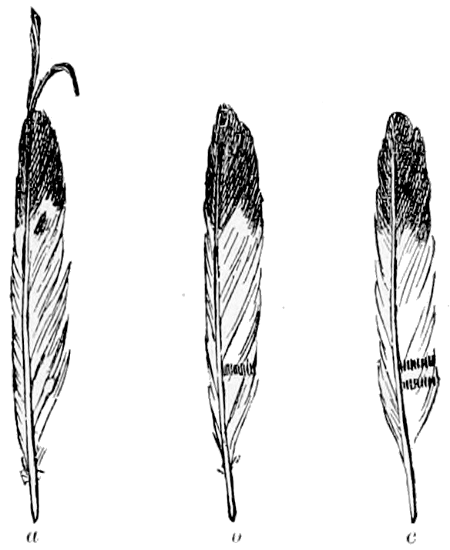
Fig. 567.—Marks of exploits, Hidatsa.
A feather, to the tip of which is attached a tuft of down or several strands of horse hair, dyed red, denotes that the wearer has killed an enemy and that he was the first to touch or strike him with the coup stick. Fig. 567 a.
A feather bearing one red bar made with vermillion, signifies the wearer to have been the second person to strike the fallen enemy with the coup stick. Same Fig. b.
A feather bearing two red bars signifies that the wearer was the third person to strike the body. Same Fig. c.
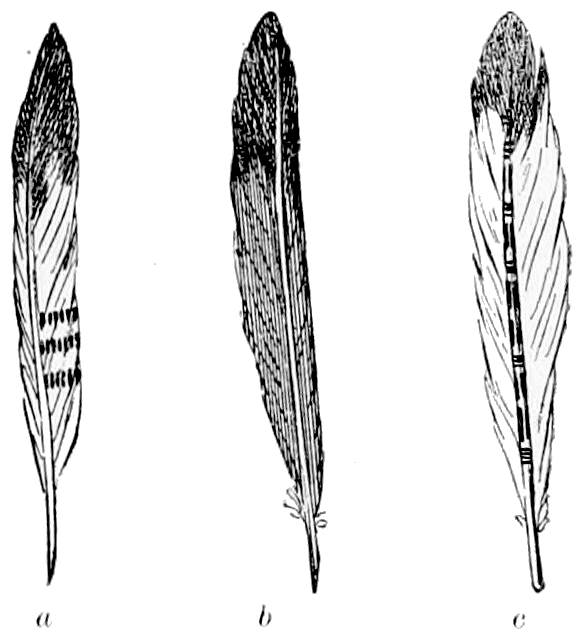
Fig. 568.—Marks of exploits, Hidatsa.
A feather with three bars signifies that the wearer was the fourth to strike the fallen enemy. Fig. 568 a. Beyond this number honors are not counted.
A red feather denotes that the wearer was wounded in an encounter with an enemy. Fig. 568 b.
A narrow strip of rawhide or buckskin is wrapped from end to end with porcupine quills dyed red, though sometimes a few white ones are inserted to break the monotony of color. This strip is attached to the inner surface of the rib or shaft of the quill by means of very thin fibers of sinew, and signifies that the wearer killed a woman belonging to a hostile tribe. It is shown in Fig. 568 c. In very fine specimens the quills are directly applied to the shaft without resorting to the strap of leather.
Similar marks denoting exploits are used by the Hidatsa, Mandan, and Arikara Indians. The Hidatsa claim to have been the originators of the devices.
The following characters are marked upon robes and blankets, usually in red or blue colors, and often upon the boat paddles. Frequently an Indian has them painted upon his thighs, though this is generally resorted to only on festal occasions or for dancing.
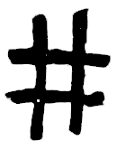
Fig. 569.—Successful defense. Hidatsa, etc.
Fig. 569 denotes that the wearer successfully defended himself against the enemy by throwing up a ridge of earth or sand to protect the body. The manner of depicting this mark upon the person or clothing is shown in Pl. XXX upon the shirt of the third figure in the lower row.
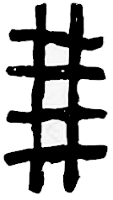
Fig. 570.—Two successful defenses. Hidatsa, etc.
Fig. 570 signifies that the wearer has upon two different occasions defended himself by hiding his body within low earthworks. The character is merely a compound of two of the preceding marks placed together. Both of the devices shown in Figs. 569 and 570 are displayed on the clothing in Fig. 575, drawn by a Hidatsa.

Fig. 571.—Captured a horse. Hidatsa, etc.
Fig. 571 signifies that the one who carries this mark upon his blanket, leggings, boat paddle, or any other property, or upon his person, has distinguished himself by capturing a horse belonging to a hostile tribe. This character appears upon the garments and legs of several of the human figures in Pl. XXX, drawn by a Hidatsa, at Fort Berthold, North Dakota.
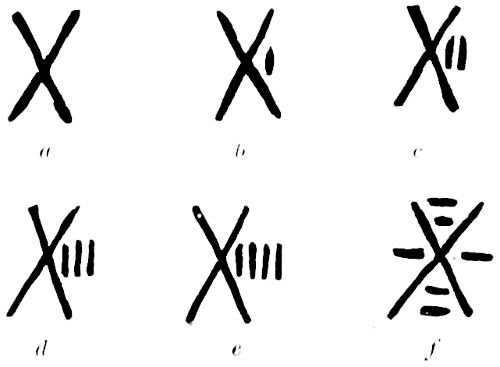
Fig. 572.—Exploit marks, Hidatsa.
In Fig. 572, a signifies among the Hidatsa and Mandans that the wearer was the first person to strike a fallen enemy with a coup stick. It signifies among the Arikara simply that the wearer killed an enemy.
b represents among the Hidatsa and Mandans the second person to strike a fallen enemy. It represents among the Arikara the first person to strike the fallen enemy.
c denotes the third person to strike the enemy, according to the Hidatsa and Mandan; the second person to strike him according to the Arikara.
d shows among the Hidatsa and Mandan the fourth person to strike the fallen enemy. This is the highest and last number; the fifth person to risk the danger is considered brave for venturing so near the ground held by the enemy, but has no right to wear a mark therefor.
The same mark among the Arikara represents the person to be the third to strike the enemy.
e, according to the Arikara, represents the fourth person to strike the enemy.
According to the Hidatsa, the wearer of the mark f had figured in four encounters; in those recorded by the marks in each of the two lateral spaces he was the second to strike the fallen enemy, and the marks in the upper and lower spaces signify that he was the third person upon two other occasions.
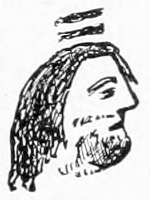
Fig. 573.—Record of exploits.
The marks at c, in Fig. 572, may be compared with Fig. 573. The head of the victim in this instance is a white man. Such drawings are not made upon the person or clothing of the hero, but upon buffalo robes or other substances used for record of biographical events.
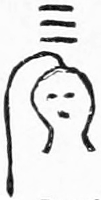
Fig. 574.—Record of exploits.
The marks at d, in Fig. 572, are drawn on records in the mode shown in Fig. 574.
Illustrations of the actual mode of wearing several of the above devices appear in Fig. 575, drawn by a Hidatsa.
The mark of a black hand, sometimes made by the impress of an actually blackened palm or drawn of natural size, or less, signifies that the person authorized to wear the mark has killed an enemy.
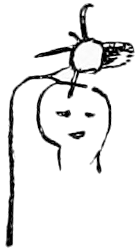
Fig. 576.—Scalp taken.
Fig. 576, drawn by a Hidatsa, means that the owner of the robe or record on which it appears had taken a scalp. Fig. 577, also drawn by a Hidatsa, means that the bearer struck the enemy in the order above mentioned and took his scalp and his gun.
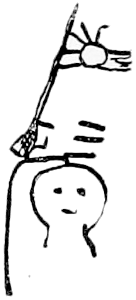
Fig. 577.—Scalp and gun taken.
The drawing reproduced on Pl. XXX was made by a Hidatsa at Fort Berthold, North Dakota. It represents several dancing figures, upon which the several marks of personal achievements can be recognized. The fourth figure of the upper row shows the wearer to have been the second person to strike an enemy upon four different occasions. Upon the right-hand figure of the lower row two distinct marks will be observed; that upon the wearer’s left leg indicating him to have been the second to strike an enemy upon two different occasions; and the mark upon the right leg, that he was twice the second person to strike enemies, and twice the third person to perform that exploit.
Miss Agnes Crane (a), in an article on Ancient Mexican Heraldry, seems to assert that the evidence of emblems in the western hemisphere as boastful records of individual achievements is confined to Mexico. The present section may supply the evidence lacking.
The following information regarding Winnebago devices of the character now under consideration was given by St. Cyr, a mixed blood Winnebago, in April, 1886.
To show that the wearer killed a man, strike the muddy hand upon the body or horse. Clay of any kind is used. When 20 men have been killed, an otter skin is worn on the back. A skunk skin worn on the calf signifies a man killed.
Scented grass worn on the neck or the wrist shows that a prisoner had been captured and tied with grass in the absence of other cords.
To show that the wearer had been wounded, cover the part of the body with white clay, and indicate the spot with red paint.
Paul Kane (a) says that among the Cree Indians red earth was spotted on a leg to indicate that the wearer had been wounded.
Prof. Dall (b) tells of the Sitka-Kwan:
They perforate their noses, wearing a ring adorned with feathers. They make a succession of perforations all around the edge of the ears, which are ornamented with scarlet thread, shark’s teeth, or pieces of shell. Each hole is usually the record of a deed performed or a feast given by the person so adorned.
This topic, upon which much interesting material has been collected in many geographic and ethnologic divisions of the earth, can not include objectively or pictorially many genuine and distinctive illustrations from the North American Indians. The reason for this paucity is that the individual Indian had very little property. Nearly everything which could be classed as personal property belonged to his tribe or, more generally, to his clan or gens. Yet articles of a man’s personal manufacture, such as arrows, were often marked in such a manner as to be distinguished. Those marks, many examples of which are upon arrows in the U. S. National Museum, are not of sufficient general interest to be reproduced here. They are not valuable unless they are connected with the makers or owners by a concurrence of the devices with the signs adopted by persons or by classes, the evidence of which can not now except in rare instances be procured. Most of the devices mentioned seem to have degenerated into mere ornamentation, which might be expected, because the arrows are not of great antiquity, and during recent years the records which could have been used for their identification have decayed as authorities even when they have remained in the immediate family, having escaped sale and robbery.
As a general rule neither a man nor a family, in the modern sense, had any property in land, which belonged to a much larger sociologic division, but on their arrival in California Europeans noticed among the Indians there a device to assert rights in realty by the use of distinctive marks. It is not clear whether these marks were merely personal or were tribal or gentile.
According to Mr. A. F. Coronel, of Los Angeles, California, the Serrano Indians in that vicinity formerly practiced a method of marking trees to indicate the corner boundaries of patches of land. The Indians owning areas of territory of whatever size would cut lines upon the bark of the tree corresponding to lines drawn on their own faces, i. e., lines running outward and downward over the cheeks, or perhaps over the chin only, tattooed in color. These lines were made on the trees on the side facing the property, and were understandingly recognized by the whole tribe. This custom still prevailed when Mr. Coronel first located in southern California about the year 1843.
Among the Arikara Indians a custom prevails of drawing upon the blade of a canoe or bull-boat paddle such designs as are worn by the chief and owner to suggest his personal exploits. This has to great extent been adopted by the Hidatsa and Mandans. The marks are[442] chiefly horseshoes and crosses, as in Fig. 578, referring to the capture of the enemy’s ponies and to coups in warfare. The entire tribe being intimately acquainted with the courage and actions of all its members, imposition and fraud in the delineation of any character are not attempted, as such would surely be detected, and the impostor would be ridiculed if not ostracised.

Fig. 578.—Boat paddle. Arikara.
The brands upon cattle in Texas and other regions of the United States where ranches are common illustrate the modern use of property marks. A collection of these brands made by the writer compares unfavorably for individuality and ideography with the genuine marks of Indians for similar purposes.

Fig. 579.—African property mark.
The following translation from Kunst and Witz der Neger in Das Ausland (a), describing Fig. 579, is inserted for comparison:
Whenever a pumpkin of surprisingly fine appearance is growing, which promises to furnish a desirable water vase, the proprietor hurries to distinguish it by cutting into it some special mark with his knife, and probably superstitious feelings may coöperate in this act. I have reproduced herewith the best types of such property marks which I have been able to discover.
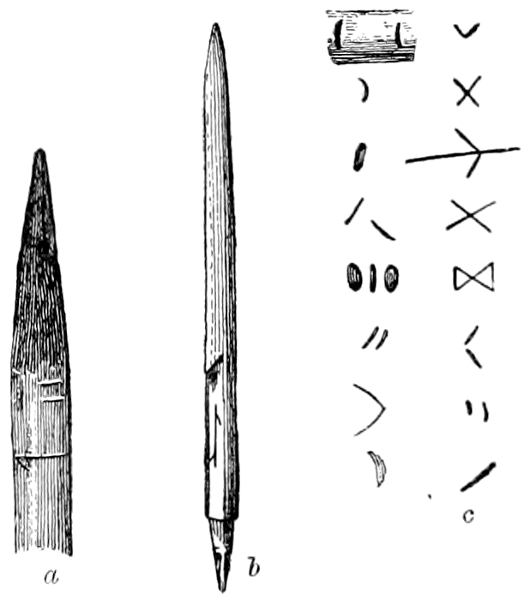
Fig. 580.—Owner’s marks, Slesvick.
Sir John Lubbock (a) tells that many of the arrows found at Nydam, Slesvick, had owner’s marks on them, now reproduced in Fig. 580 as a and c, resembling those on the modern Esquimaux arrows shown in the same figure as b.
Prof. Anton Schiefner (b) gives a remarkable parallel between the Runic alphabet and the property marks of the Finns, Lapps, and Samoyeds.
The names of Indians as formerly adopted by or bestowed among themselves were generally connotive. They very often refer to some animal and predicate an attribute or position of that animal. On account of their sometimes objective and sometimes ideographic nature, they almost invariably admit of being expressed in sign language; and for the same reason they can readily be portrayed in pictographs. The device generally adopted by the Dakotan tribes to signify that an object drawn in connection with a human figure was a totemic or a personal name of the individual, is to connect that object with the figure by a line drawn to the head or, more frequently, to the[443] mouth of the latter. The same tribes make a distinction to manifest that the gesture sign for an object gestured is intended to be the name of a person and not introduced for any other purpose by passing the index forward from the mouth in a direct line after the conclusion of the sign for the object. This signifies “that is his name,” the name of the person referred to.
As a general rule, Indians were named in early infancy according to a tribal system, but in later life each generally acquired a new name, or perhaps several names in succession, from some special exploits or adventures. Frequently a sobriquet is given which is not complimentary. All of the names subsequently acquired as well as the original names are so connected with material objects or with substantive actions as to be expressible in a graphic picture and also in a pictorial sign. In the want of alphabet or syllabary they used the same expedient to distinguish the European invaders. A Virginian was styled Assarigoa, “Big Knife.” The authorities of Massachusetts were called by the Iroquois, Kinshon, “a fish,” doubtless in allusion to the cod industry and the fact that a wooden codfish then hung, as it did long afterwards, in the state house at Boston, as an emblem of the colony and state.
The determination to use names of this connotive character is shown by the objective translation, whenever possible, of such European names as it became necessary for them to introduce frequently into their speech. William Penn was called Onas, that being the word for feather-quill in the Mohawk dialect. The name of the second French governor of Canada was De Montmagny, erroneously translated to be “great mountain,” which words were correctly translated by the Iroquois into Onontio, and this expression becoming associated with the title has been applied to all successive Canadian governors, though the origin having been generally forgotten, it has been considered to be a metaphorical compliment.
The persistence of titles is shown by the fact that the Abnaki of New Brunswick to-day call Queen Victoria, “King James,” with a feminine addition.
Gov. Fletcher was named by the Iroquois Cajenquiragoe, “the great swift arrow,” not because of his speedy arrival at a critical time, as has been supposed, but because they had somehow been informed of the etymology of his name, “arrow-maker” (Fr. fléchier). A notable example of the adoption of a graphic illustration from a similarity in the sound of the name to known English words is given in the present paper, in Fig. 919, where Gen. Maynadier is represented as “many deer.”
While, as before said, some tribes give names to children from considerations of birth and kinship according to a fixed rule, others conferred them after solemn deliberation. Even these were not necessarily permanent. A diminutive form is frequently bestowed by the affection of the parent. On initiation into one of the cult associations a name is generally received. Until this is established a warrior is liable to[444] change his name after every fight or hunt. He will sometimes only acknowledge the name he has himself assumed, perhaps from a dream or vision, though he may be habitually called by an entirely different name. From that reason the same man is sometimes known under several different epithets. Personal peculiarity, deformity, or accident is sure to fix a name against which it is vain to struggle. Girls do not often change names bestowed in their childhood. The same precise name is often given to different individuals in the same tribe, but not so frequently in the same band, whereby the inconvenience would be increased. For this reason it is often necessary to specify the band, sometimes also the father. For instance, when the writer asked an Indian who Black-Stone, a chief mentioned in the Lone-Dog winter counts, was, the Indian asked, first, what tribe was he; then, what band; then, who was his father; and, except in the case of very noted persons, the identity is not proved without an answer to these questions. A striking instance of this plurality of names among the Dakotas was connected with the name Sitting-Bull, belonging to the leader of the hostile band, while one of that name was almost equally noted as being the head soldier of the friendly Dakotas at Red-Cloud Agency.
The northeastern tribes sometimes formally resurrected the name of the dead and also revived it by adoption. See Jes. Rel., 1639, p. 45, and 1642, p. 53.
Among the peculiarities connected with Indian personal names, far too many for discussion here, is their avoidance of them in direct address, terms of kinship or relative age taking their place. Maj. J. W. Powell states that at one time he had the Kaibab Indians, a small tribe of northern Arizona, traveling with him. The young chief was called by white men “Frank.” For several weeks he refused to give his Indian name and Maj. Powell endeavored to discover it by noticing the term by which he was addressed by the other Indians, but invariably some kinship term was employed. One day in a quarrel his wife called him Chuarumpik (“Yucca-heart”). Subsequently Maj. Powell questioned the young chief about the matter, who explained and apologized for the great insult which his wife had given him and said that she was excused by great provocation. The insult consisted in calling the man by his real name.
Everard F. im Thurn (g) gives the following account of the name-system of the Indians of Guiana, which might have been written with equal truth about some tribes of North America:
The system under which the Indians have their personal names is intricate and difficult to explain. In the first place, a name, which may be called the proper name, is always given to a young child soon after birth. It is said to be proper that the peaiman, or medicine-man, should choose and give this name, but, at any rate now, the naming seems more often left to the parents. The word selected is generally the name of some plant, bird, or other natural object. But these names seem of little use, in that owners have a very strong objection to telling or using them, apparently[445] on the ground that the name is part of the man, and that he who knows the name has part of the owner of that name in his power. One Indian, therefore, generally addresses another only according to the relationship of the caller and the called, as brother, sister, father, mother, and so on. These terms, therefore, practically form the names actually used by Indians amongst themselves. But an Indian is just as unwilling to tell his proper name to a white man as to an Indian, and, of course, between the Indian and the white man there is no relationship the term for which can serve as a proper name. An Indian, therefore, when he has to do with a European, asks the latter to give him a name, and if one is given to him always afterwards uses this. The names given in this way are generally simple enough—John, Peter, Thomas, and so on.
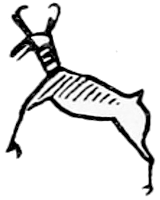
Fig. 581.—Signature of Running Antelope, Dakota.
The original of Fig. 581 was made in 1873 by Running Antelope, chief of the Uncapapa Dakota, in the style of a signature instead of being attached to his head by a line as is the usual method of the tribe in designating personal names.

Fig. 582.—Solinger sword-makers’ marks.
Fig. 582 presents a curious comparison with Figs. 548 and 903 showing the manner in which the wolf, proverbially a lean animal, was delineated by Germans in the thirteenth and fourteenth centuries. It is taken from Rudolf Cronau (b), whose remarks are translated and condensed as follows:
a. The oldest representation known to me of the “wolf” occurs on a Gothic sword of the thirteenth century, in the Historical Museum of Dresden.
b. Is more primitive, from a sword of the last half of the fourteenth century, in the “Berliner Zeughause;” also similar to c, of the same period, from a specimen in the Züricher Zeughaus.
d and e. Signatures on two specimens in the collection in Feste Coburg; e is a rare representation of the figure of the wolf of 1490, in the Germanic Museum at Nürnberg, and still more intricate (verzwickter) is the drawing f on a Dresden specimen of the year 1559.
A large proportion of the pictographs of several names next to be presented are from Red-Cloud’s Census, the history of which is as follows:
A pictorial census was prepared in 1884 under the direction of Red-Cloud, chief of the Dakota at Pine Ridge Agency, Dakota Territory. The 289 persons enumerated, many of whom were heads of families, were the adherents of Red-Cloud and did not represent all the Indians[446] at that agency. Owing to a disagreement the agent refused to acknowledge that chief as head of the Indians at the agency, and named another as the official chief. Many of the Indians exhibited their allegiance to Red-Cloud by having their names attached in their own pictorial style to a document showing their votes and number. This filled seven sheets of ordinary manila paper and was sent to Washington. While in the custody of Dr. T. A. Bland, of that city, it was loaned by him to the Bureau of Ethnology to be copied by photography. The different sheets were apparently drawn by different persons, as the drawings of human heads vary enough to indicate individuality. This arrangement seems to imply seven bands or, perhaps, gentes.
Dr. V. T. McGillicuddy, who at the time was Indian agent at Pine Ridge Agency, Dakota, in correspondence gives the impression that the several pictographs representing names were attached as signatures by the several individuals to a subscription list for Dr. Bland, before mentioned, who was the editor of The Council Fire, in support of that publication and with an agreement that each should give 25 cents. The document in that view would be a subscription list, but the subscribers were, in fact, the adherents of Red-Cloud. Whatever was the motive for this collection of pictured names, its interest consists in the mode of their portrayal, together with the assurance that they were the spontaneous and genuine work of the Indians concerned.
In addition to the personal names which immediately follow, a considerable number of the 289 pictographic names appear elsewhere in this paper under the various heads of Tribal Designations, Ideography, Conventionalizing, Customs, special Comparison, etc.
Interspersed among the personal names taken from the above mentioned list are others selected from the Oglala Roster, the origin of which is explained above, and the several winter counts of The-Flame, The-Swan, American-Horse, and Cloud-Shield, mentioned, respectively, in Chap. X, Sec. 2. The authority is in each case attached to the pictograph with the translation of the Indian name, and in some cases with the name in the original.
Rev. J. Owen Dorsey, in Vol. XXXIV of the Proceedings of the American Association for the Advancement of Science and in the American Anthropologist for July, 1890, gives valuable notes on the subject of Indian personal names and also has made oral suggestions to the present writer. Some of those may be considered with reference to the list now presented. He thinks that the frequent use of color names is from a mythical or symbolic significance attributed to the colors. Also the word translated “iron,” or “metal,” is connected with the color blue, the object called iron being always painted blue when colors are used, and that color is mystically connected with the water powers of the Dakotan mythology. The frequent use of the terms “Little” and “Big,” with or without graphic differentiation, may be as the terms young and old, junior and senior, are employed by civilized people, but the expressions in other cases may refer to the size[447] of the animals seen in the visions of fasting which have determined the names.
Explanations on parts of the pictographs not strictly connected with the personal name are annexed for the reason before indicated and the objects connected by the names are to some extent arranged in classes.
In the figures immediately following the delineation is objective. It is sometimes interesting to note the different modes of representing the same object or concept.
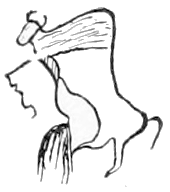
Fig. 583.
Fig. 583.—High-Back-Bone, a very brave Oglala, was killed by the Shoshoni. They also shot another man, who died after he reached home. American-Horse’s Winter Count, 1870-’71.
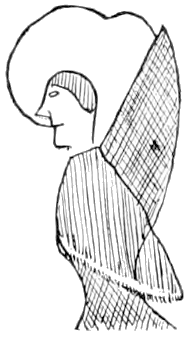
Fig. 584.
Fig. 584.—High-Back-Bone was killed in a fight with the Snakes (Shoshoni). Cloud-Shield’s Winter Count, 1870-’71. White-Cow-Killer calls it “High-Back-Bone-killed-by-Snake-Indians winter.”
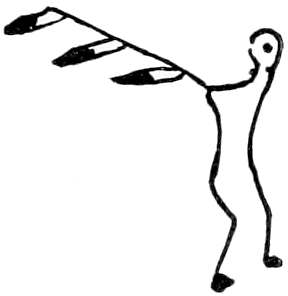
Fig. 585.
Fig. 585.—A Minneconjou Dakota named Broken-Back was killed by the Crow Indians at Black Hills. Swan’s Winter Count, 1848-’49.
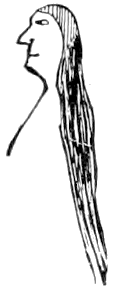
Fig. 586.
Fig. 586.—Long-Hair was killed. Cloud-Shield’s Winter Count, 1786-’87. To what tribe he belonged is not known. The tribes, such as the Crows, in which it is a tribal custom to wear the hair to an enormous length, eke it out by artificial means and ornament it with beads and streamers. In this case the length of the hair seems to have been a personal peculiarity, not a tribal mark.
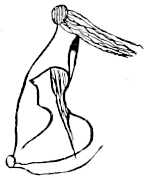
Fig. 587.
Fig. 587.—They killed the long-haired man in a fight with the Cheyennes while on an expedition to avenge the death of The-Man-Who-Owns-The-Flute, who was killed by the Cheyennes the year before. American-Horse’s Winter Count, 1796-’97. This may be the same man who is referred to in the last preceding figure, as the expression “killed,” given in translation by the interpreters, does not always mean wounded to death, but severely wounded—Hibernicé “kilt.” Here the scalp shows the length of the hair, and the victim is called a Cheyenne.
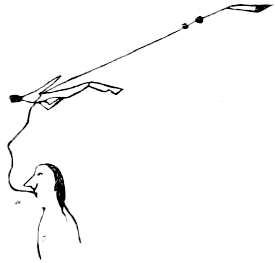
Fig. 588.
Fig. 588.—The Stabber. Cloud-Shield’s Winter Count, 1783-’84. The man’s name is suggested by the spear in the body over his head, which is connected with his mouth by a line.
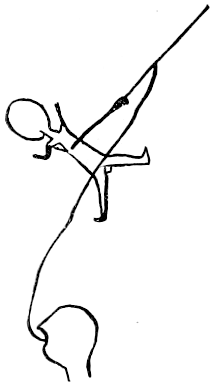
Fig. 589.
Fig. 589.—Stabber. Red-Cloud’s Census. This figure is substantially the same as the preceding, though more rude.
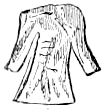
Fig. 590.
Fig. 590.—Red-Shirt. Red-Cloud’s Census. This and the following figure exhibit the name, the first showing only the garment and the second exhibiting it as worn.
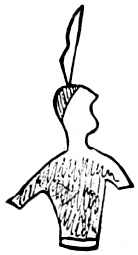
Fig. 591.
Fig. 591.—Red-Shirt, a Dakota, was killed by the Crows while looking for his ponies near Old Woman’s fork. American-Horse’s Winter Count, 1810-’11. The bow over the head and the absence of scalp-lock signifies death by the arrow of enemies.
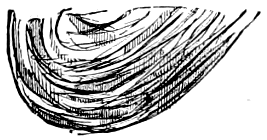
Fig. 592.
Fig. 592.—Chief Red-Cloud. Red-Cloud’s Census. This and the next figure give two modes of expressing the name of the celebrated chief, Red-Cloud.
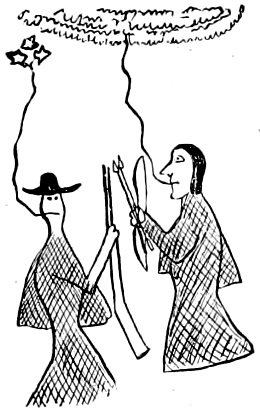
Fig. 593.
Fig. 593.—Three-Stars (General Crook) took Red-Cloud’s young men to help him fight the Cheyennes. Cloud-Shield’s Winter Count, 1876-’77.
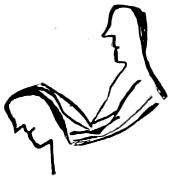
Fig. 594.
Fig. 594.—Caught-the-Enemy. Red-Cloud’s Census. The enemy seems to be caught by his hair.

Fig. 595.
Fig. 595.—Black-Rock was killed by the Crows. His brother, whose name he had taken, was killed by the Crows three years before. American-Horse’s Winter Count, 1809-’10.
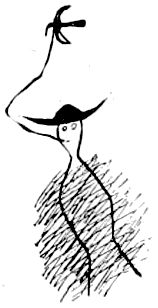
Fig. 596.
Fig. 596.—Bird, a white trader, was burned to death by the Cheyennes. Cloud-Shield’s Winter Count, 1864-’65. He is surrounded by flames in the picture. His name was probably Bird, which was pictorially represented as usual.
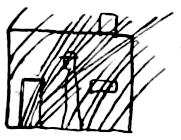
Fig. 597.
Fig. 597.—Red-Lake’s house, which he had recently built, was destroyed by fire, and he was killed by the accidental explosion of some powder. American-Horse’s Winter Count, 1831-’32. This figure is introduced here in connection with the simple fire on the one preceding to show the artistic portrayal separately of a steady flame and of an explosion.
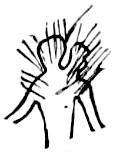
Fig. 598.
Fig. 598.—Two-Face, an Oglala, was badly burnt by the explosion of his powder horn. American-Horse’s Winter Count, 1860-’61. Here is another view of the explosion of gunpowder.

Fig. 599.
Fig. 599.—A Two-Kettle Dakota, named The-Breast, died. Swan’s Winter Count, 1836-’37.
Mato Sapa says: A Two-Kettle, named The-Breast, died. This is the same character as is given elsewhere for abundance, plenty of buffalo. But here it has a wholly personal application.
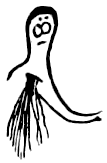
Fig. 600.
Fig. 600.—Left-Handed-Big-Nose was killed by the Shoshoni. American-Horse’s Winter Count, 1839-’40. His left arm is represented extended, and his nose is grotesquely conspicuous.
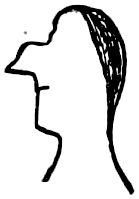
Fig. 601.
Fig. 601.—Roman-Nose. Red-Cloud’s Census. The large and aquiline nose is exhibited, which was very liberally translated “Roman Nose,” and the term became the popular name of a celebrated chief of the Dakotas.
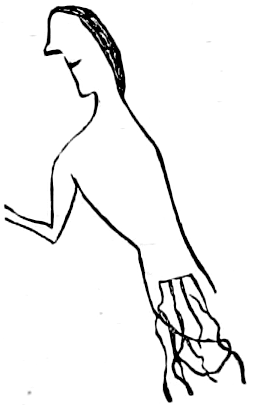
Fig. 602.
Fig. 602.—Torn-Belly. Red-Cloud’s Census.

Fig. 603.
Fig. 603.—Spotted-Face. Red-Cloud’s Census.
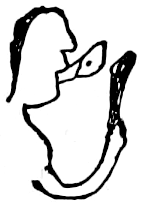
Fig. 604.
Fig. 604.—Licks-with-his-tongue. Red-Cloud’s Census. The tongue is exaggerated as well as protruded, and without explanation might be mistaken for a large object bitten off for eating in a gluttonous manner.
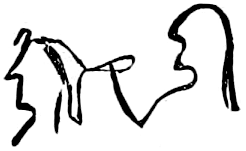
Fig. 605.
Fig. 605.—Knock-a-hole-in-the-head. Red-Cloud’s Census.
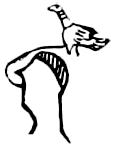
Fig. 606.
Fig. 606.—Broken-Leg-Duck, an Oglala, went to a Crow village to steal horses and was killed. American-Horse’s Winter Count, 1786-’87. A line connects the bird, one of whose legs is out of order, with the mouth of the man’s head, which is without scalp-lock.
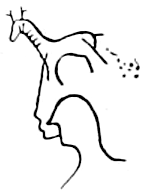
Fig. 607.
Fig. 607.—Antelope-Dung broke his neck while surrounding buffalo. American-Horse’s Winter Count, 1853-’54.
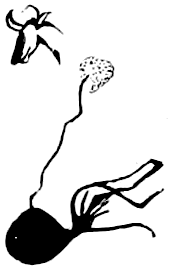
Fig. 608.
Fig. 608.—Antelope-Dung broke his neck while running antelope. Cloud-Shield’s Winter Count, 1853-’54. His head is the only part of his body that is shown, and it is bleeding copiously. Without the preceding figure this one would not be intelligible.

Fig. 609.
Fig. 609.—Broken-Arrow fell from his horse while running buffalo and broke his neck. American-Horse’s Winter Count, 1859-’60.
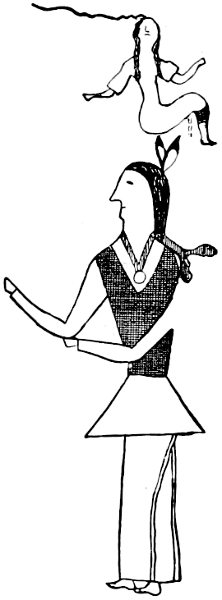
Fig. 610.
Fig. 610.—Sits-like-a-Woman. Red-Cloud’s Census. This person is also portrayed in a recent Dakota record, where the character is represented by the “woman seated” only. The name of this man is not “Sits-like-a-Woman,” but High-Wolf—shunkmanitu (wolf), wankantuya (up above). This is an instance of giving one name in a pictograph as if the correct or official name and retaining another by which the man is known in camp to his companions.
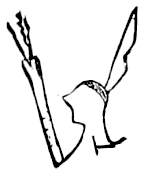
Fig. 611.
Fig. 611.—The-Man-Who-Owns-the-Flute was killed by the Cheyennes. American-Horse’s Winter Count, 1795-’96. His flute is represented in front of him with sounds coming from it. A bullet mark is on his neck. In reference to this character, see Chap. XX, Sec. 2.
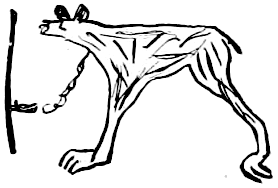
Fig. 612.
Fig. 612.—Smoking-Bear. Red-Cloud’s Census. The bear does not appear to be smoking the pipe, but the smoke of the latter is mounting to the animal’s neck, so the bear is smoking in a passive sense.
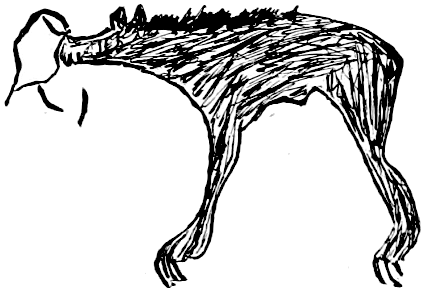
Fig. 613.
Fig. 613.—Biting-Bear. Red-Cloud’s Census. The bear seems to be biting at the bark on the limb of a tree, which shows the marks of his claws. This animal, as is well known, eats the bark of certain trees.
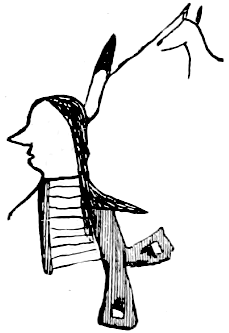
Fig. 614.
Fig. 614—Wolf-Ear. Red-Cloud’s Census. The designation of the ear of a wolf probably refers to size, and is substantially the same as big-ear.
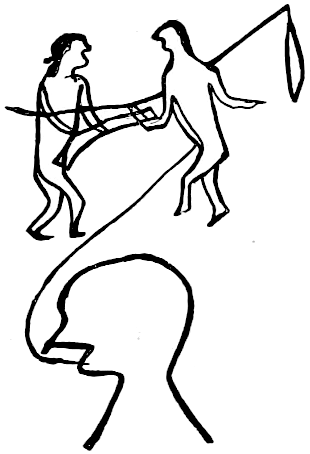
Fig. 615.
Fig. 615.—Fighting-Cuss. Red-Cloud’s Census. This warrior appears, while only armed with a lance, to be successfully fighting an enemy who has a gun.
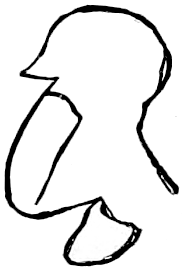
Fig. 616.
Fig. 616.—Man-with-hearts. Red-Cloud’s Census. There is no information as to the significance of this drawing, but it is conjectured that the warrior had eaten the heart of one or more enemies, as was frequently done. This was not cannibalism, but a superstitious and sometimes ceremonial performance, by which the eater acquired the qualities of the victim, and in this case would be supposed to have more than one heart, i. e., the courage attributed to those hearts.
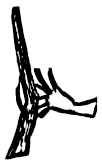
Fig. 617.
Fig. 617.—Takes-the-Gun. Red-Cloud’s Census. It appears from the name that the man is not handling his own gun, but is on the point of grasping and taking away the weapon of another person.
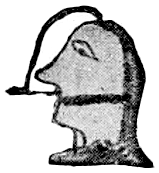
Fig. 618.
Fig. 618.—Jola, Whistler. The Oglala Roster. This is one of the instances where the usual rule in the Oglala Roster, of representing the name above the head, is abandoned, because it is essential to connect it with the mouth to express the whistle. Without this arrangement the musical instrument would not be suggested.
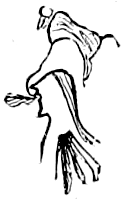
Fig. 619.
Fig. 619.—American-Horse’s Winter Count for 1872-’73 gives the pictograph of Whistler, also named Little-Bull. Both of his names appear; that of Whistler is expressed by the sounds blown from the mouth. He whistles without an instrument.
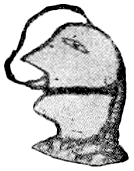
Fig. 620.
Fig. 620.—Ceji, Tongue. The Oglala Roster. This man was not necessarily an orator, but probably the nickname was given in derision as orally “tonguey” might be. Again the line is from the crown of the head to the protruded tongue.
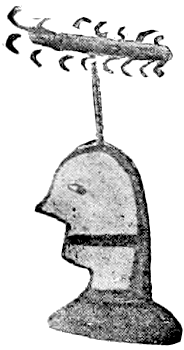
Fig. 621.
Fig. 621.—Canku-sapa, Black-Road. The Oglala Roster. This road, on which horse tracks are shown, is distinguished from that of the head chief Big-Road (a, on Pl. XXVI) as being much more narrow and obscure, therefore black.
The following figures are selected from a large number to show the variety of animals, and the differentiation by marks and attitudes found necessary to present the names. A similar multiplication of the animals by different coloration is exhibited, but can not be repeated in the text figures.
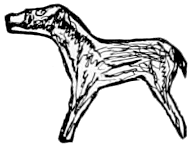
Fig. 622.
Fig. 622.—Bob-tail-Horse. Red-Cloud’s Census. The translation of the Indian’s name is rather liberal, but the device is graphic.
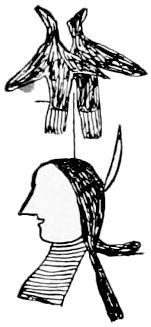
Fig. 623.
Fig. 623.—Two-Eagles. Red-Cloud’s Census.
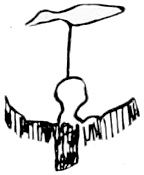
Fig. 624.
Fig. 624.—Minneconjou Dakota chief, named Swan, died. The-Swan’s Winter Count, 1866-’67. This bird is supposed to be swimming on the water, its legs not being visible.
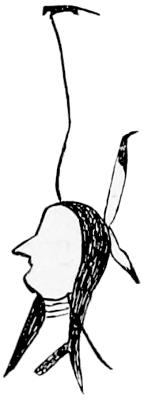
Fig. 626.
Fig. 626.—Mouse. Red-Cloud’s Census.
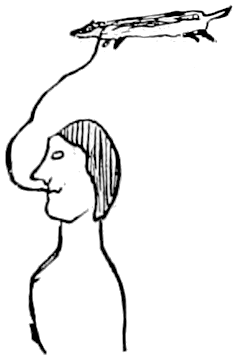
Fig. 627.
Fig. 627.—Badger, a Dakota, was killed by enemies, as shown by the absence of his scalp. Cloud-Shield’s Winter Count, 1796-’97.
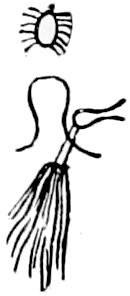
Fig. 628.
Fig. 628.—Spider was killed (stabbed) in a fight with the Pawnees. American-Horse’s Winter Count, 1861-’62. An immense effusion of blood is depicted flowing from the wound.
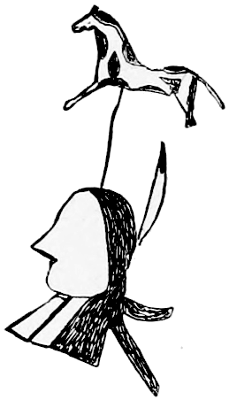
Fig. 630.
Fig. 630.—Spotted-Horse. Red-Cloud’s Census.
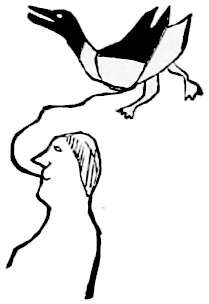
Fig. 631.
Fig. 631.—White-Goose was killed in an attack made by some enemies. Cloud-Shield’s Winter Count, 1789-’90. White-Cow-Killer calls it, “Goose-Feather-killed winter.”
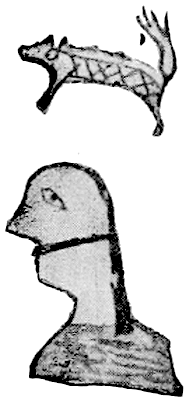
Fig. 632.
Fig. 632.—Maka-gleska, Spotted-Skunk. The Oglala Roster. The special characteristic of the animal is suggested.
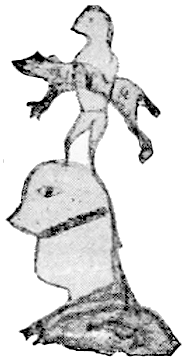
Fig. 633.
Fig. 633.—Hoka-qin, Carried-the-Badger. The Oglala Roster. The design explains itself. The animal is exaggerated in size and some of its features are accentuated.
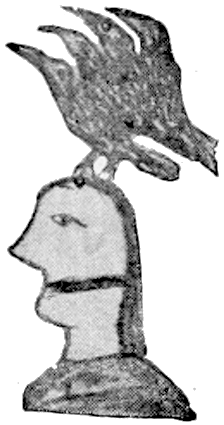
Fig. 634.
Fig. 634.—Kangi-topa, Four-Crows. The Oglala Roster. The four crows are cawing forth such explanation as they can give of the reasons, probably coming from visions, why they were used to form a name for an Oglala.
The products of the vegetable kingdom are not often used by the Dakotas in their personal designations. The three following figures, however, are examples of such use.
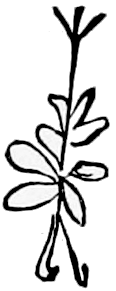
Fig. 635.
Fig. 635.—Tree-in-the-Face. Red-Cloud’s Census. This man probably painted a tree on his face.
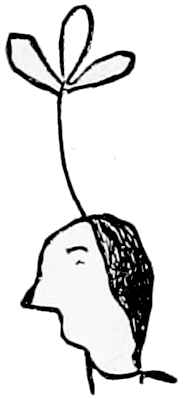
Fig. 636.
Fig. 636.—Leaves. Red-Cloud’s Census. This and the following figure represent two different men of the same name and the devices are distinctly individual.
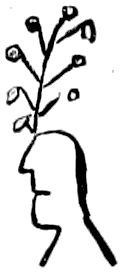
Fig. 637.
Fig. 637.—Leaves. Red-Cloud’s Census.
With regard to the errors arising from bad translation, an example may be given, relating to a name the explanation of which has often been asked. A former chief of the Oglala was called “Old-man-afraid-of-his-Horses,” by the whites, and his son is known as “Young-man-afraid-of-his-Horses.”[459] A common interpretation about “afraid-of-his-horses” is that the man valued his horses so much that he was afraid of losing them. The representative of the name, however, stated to the writer that the correct name was Ta-shunka Kokipapi, and that the true meaning was “He-whose-horse-they-fear”; literally “His-horse-they-fear-it.”
A large number of pictorially rendered Indian names attached to deeds and treaties have been published, e. g., in Documents relating to the Colonial History of New York (b). Few of them are of interest, and they generally suggest the assistance of practiced penmen. In the collections mentioned some of the Dutch marks are in the same general style as those of the Indians.
Mr. P. W. Norris, late of the Bureau of Ethnology, had a buffalo robe containing a record of exploits, which was drawn by Black-Crow, a Dakota warrior. The successful warrior is represented in each instance upright, the accompanying figure being always in a recumbent posture, representing the enemy who was slain. The peculiar feature of these pictographs is that instead of depicting the victim’s personal name with a connecting line, the object denoting his name is placed above the head of the victor in each instance, and a line connects the character with his mouth. The latter thus seems to proclaim the name of his victim. A pipe is also figured between the victor and the vanquished, showing that he is entitled to smoke a pipe of celebration.
A copy of the whole record was shown to the Mdewakantanwan Dakotas, near Fort Snelling, Minnesota, in 1883, and the character reproduced in Fig. 638, about which there was the most doubt, was explained as signifying “many tongues,” or Loud-Talker.
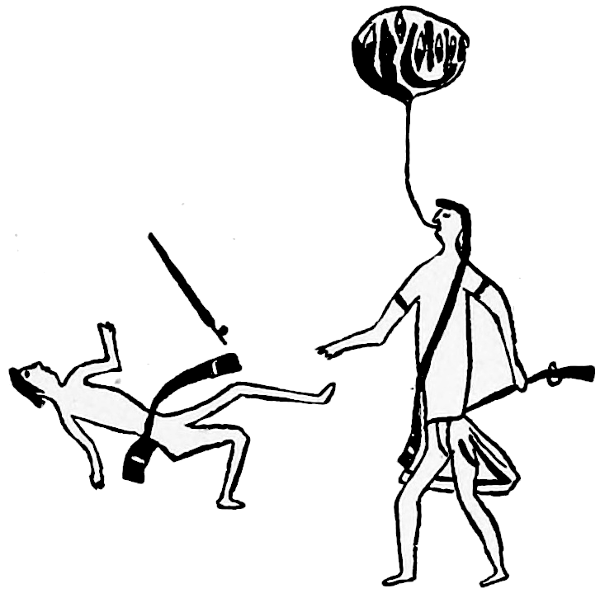
Fig. 638.—Loud-Talker.
The circle at the end of the line running from the mouth contains a number of lanceolate forms, one-half of each of which is black, the other[460] white. They have the appearance of feathers, but also may represent tongues and signify voice, sound issuing from the mouth, and correspond in some respect to those drawn by the Mexicans with that significance, of which examples are given in this work, Chap. XX, Sec. 2. The considerable number of these tongue-like figures suggests intensity and denotes loud voice, or, as given literally, “loud talker,” that being the name of the victim.
It is, however, to be noted that “Shield,” an Oglala Dakota, contends that the character signifies Feather-Shield, the name of a warrior formerly living at the Pine Ridge Agency, Dakota.
Designation of an object, as a name, by means of a connecting line is mentioned in Kingsborough (a). Pedro de Alvarado, one of the companions of Cortez, was red-headed. Designating him, the Mexicans called him Tonatihu, the “Sun,” and in their picture-writing his name was represented by their conventional character for the sun attached to his person by a line.
Other examples are now presented both of the linear connection and of the iconographic figuration by the old Mexicans.
In Kingsborough (b) is a pictograph of Chimalpopoca, which name signifies a smoking shield, here reproduced as Fig. 639 (a). The smoking shield is connected with the head by a line, and the form of smoke should be noticed in comparison with the representation of flame and of voice by the same pictors.
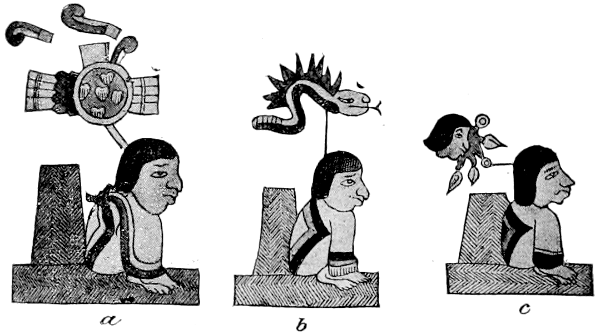
Fig. 639.—Mexican names.
The same authority and volume, p. 135 (illustration in Vol. I, Pt. 4, Pl. V), gives the name and illustration (reproduced in the same Fig., b) of Ytzcohuatl, the signification of which name is a serpent armed with knives. The knives refer to the Itzli stone.
In the same volume, p. 137, is the name Face of Water, with the corresponding illustration in Vol. I, Pt. 4, Pl. 12 (here Pl. XII c). The drops of water are falling profusely from the face.
The most surprising fact relating to the North American Indians, which until lately had not been realized, is that they habitually lived in and by religion to a degree comparable with the old Israelites under the theocracy. This was sometimes ignored, and sometimes denied in terms, by many of the early missionaries and explorers. The aboriginal religion was not their religion, and therefore was not recognized to have an existence or was pronounced to be satanic. Many pictorial representations are given in this chapter of concepts of the supernatural, as operative in this world, which is popularly styled religion when it is not condemned as superstition. The pictographic examples presented from the Siouan stock are generally explained as they appear. Those from the Ojibwa and other tribes are not so fully discussed. It is therefore proper to mention explicitly that, in the several localities where the tribes are now found which have been the least affected by civilization, they in a marked degree live a life of religious practices, and their shamans have a profound influence over their social character. A careful study of these people has already given indication of facts corresponding in interest with those which have recently surprised the world as reported by Mr. Cushing from among the Zuñi and Dr. Matthews from among the Navajo.
The most extensive and important publications on the subject have been made by Maj. J. W. Powell (a), Director of the Bureau of Ethnology. These have been made at many times and in various shapes, from the Outlines of the Philosophy of the North American Indians, read in 1876, to the present year.
A considerable amount of detail respecting religion appears in Chap. IX, Sections 4 and 5, in the present work.
The discussion of the religions and religious practices of the tribes of America is not germane to the present work, except so far as it elucidates their pictographs. In that connection it may be mentioned that the tribes of Indians in the territory of the United States, which have been converted to Christianity, seem not to have spontaneously turned their pictographic skill to the representation of objects connected with the religion to which they have been converted. This might be explained by the statement, often true, that the converts have been taught[462] to read and write the languages of their teachers in religion, and therefore ceased to be pictographers. But where they have not been so instructed, indeed have been encouraged to retain their own language and to write it in a special manner supposed to be adapted to their ancient methods, the same result is observed. The Micmacs still with delight draw on bark their stories of Glooscap and Lox, and scenes from the myths of their old faith, but unless paid as for a piece of work, do not produce Christian pictures. This assertion does not conflict with the account of the “Micmac hieroglyphs” in Chap. XIX, Sec. 2. All the existing specimens of these were made by Europeans, and the action of the first Indian converts, which was imitated by Europeans, was the simple use of their old scheme of mnemotechny to assist in memorizing the lessons required of them by missionaries. It is also to be noted that some tribes for convenience have adopted Christian emblems into their own ceremonial pictographs (see Fig. 159).
It has been found convenient to divide this chapter into the following sections: (1) Symbols of the supernatural. (2) Myths and mythic animals. (3) Shamanism. (4) Charms and amulets. (5) Religious ceremonies. (6) Mortuary practices.
This group shows the modes of expressing the idea of the supernatural, holy, sacred, or, more correctly, the mystic or unknown (perhaps unknowable), that being the true translation of the Dakota word wakan. The concept of “crazy,” in the sense of influenced by superior powers or inspired, is in the same connection. Not only the North American Indians, but many tribes of Asia and Africa, consider a demented person to be sacred and therefore inviolable. The spiral line is but a pictorial representation of the sign for wakan, which is: With its index finger extended and pointing upward, or all the fingers extended, back of hand outward, move the right hand from just in front of the forehead spirally upward nearly to arm’s length from left to right.
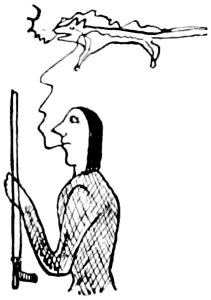
Fig. 640.
Fig. 640.—Crazy-Dog, a Dakota, carried the pipe around and took the war path. Cloud-Shield’s Winter Count, 1838-’39.
The waved or spiral lines denote crazy or mystic, as above explained.
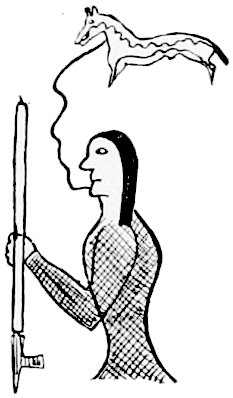
Fig. 641.
Fig. 641.—Crazy-Horse says his prayers and goes on the war-path. Cloud-Shield’s Winter Count, 1844-’45.
The waved lines are used again for crazy. “Says his prayers,” which are the words of the interpreter, would be more properly rendered by referring to the ceremonies of organizing a war party.
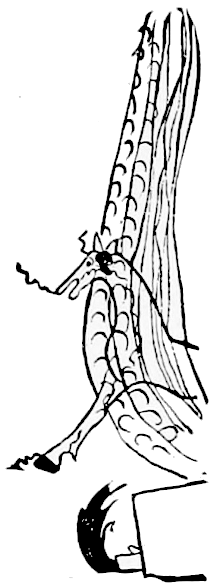
Fig. 642.
Fig. 642.—Crazy-Horse’s band left the Spotted-Tail agency (at Camp Sheridan, Nebraska) and went north, after Crazy-Horse was killed at Fort Robinson, Nebraska. Cloud-Shield’s Winter Count, 1877-’78.
Hoofprints and lodge-pole tracks run northward from the house, which represents the agency. That the horse is “crazy” is shown by the waved or spiral lines on his body, running from his nose, hoof, and forehead. The band is named from its deceased chief, and is designated by his personal device, a distinct and unusual departure among Indians tending towards the evolution of band or party emblems unconnected with the gentile system.
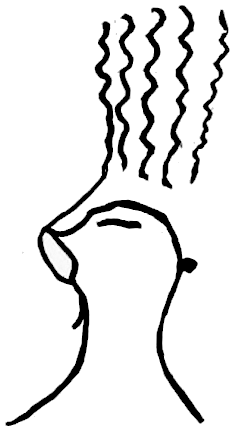
Fig. 643.
Fig. 643.—Medicine. Red-Cloud’s Census. The full rendering should be medicine-man or shaman. The waving lines above the head again signify mystic or sacred, and are made in gesture in a similar manner as that before described, with some differentiation, for prayer or incantation. The shut or half-closed eye may be noted.
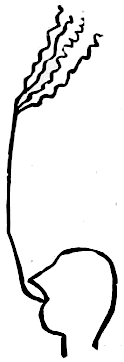
Fig. 644.
Fig. 644.—Medicine-man. Red-Cloud’s Census. This is a rude variant of the foregoing.

Fig. 645.
Fig. 645.—Crazy-Head. Red-Cloud’s Census. The wavy lines here form a circle around the head to suggest the personal name as well as the quality.
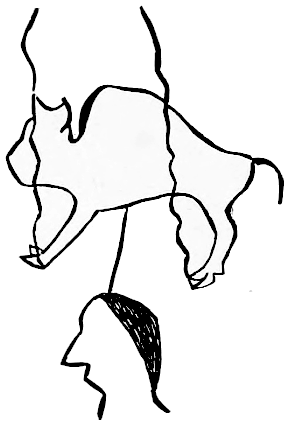
Fig. 646.
Fig. 646.—Medicine-Buffalo. Red-Cloud’s Census. This is probably an albino buffalo, and may refer to the man who possessed one who is venerated therefor. See Chap. XIII.
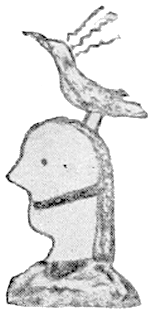
Fig. 647.
Fig. 647.—Kangi-wakan, Sacred-Crow. The Oglala Roster. The lines above the bird’s head signify sacred, mystic, sometimes termed “medicine,” as above.

Fig. 648.
Fig. 648.—White-Elk. Red-Cloud’s Census. This is an albino elk which partakes in sacredness with the albino buffalo. The elk was an important article of food, though not so much a reliance as the buffalo, and the practices relating to the latter would naturally, and in fact did, measurably, apply to the former.

Fig. 649.
Fig. 649.—The Dakotas had all the mini wakan (spirit water, or whisky) they could drink. American-Horse’s Winter Count, 1821-’22. A barrel with a waved or spiral line running from it represents the whisky, the waved line signifying wakan, or spirit, in the double sense of the English word.
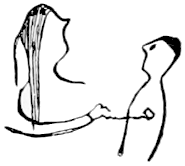
Fig. 650.
Fig. 650.—Cloud-Bear, a Dakota, killed a Dakota, who was a long distance off, by throwing a bullet from his hand and striking him in the heart. American-Horse’s Winter Count, 1824-’25. [466]The spiral line is used for wakan.
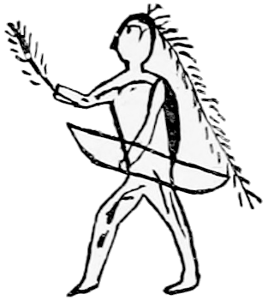
Fig. 651.
Fig. 651.—A Minneconjou clown, well known to the Indians. The-Flame’s Winter Count, 1787-’88. His accouterments are fantastic. The character is explained by Battiste Good’s Winter Count for the same year as follows:
“Left-the-heyoka-man-behind winter.” A certain man was heyoka, that is, in a disordered frame of mind, and went about the village bedecked with feathers singing to himself, and while so joined a war party. On sighting the enemy the party fled and called to him to turn back also, but as he was heyoka he construed everything that was said to him as meaning the very opposite, and, therefore, instead of turning back he went forward and was killed. This conception of a man under superhuman influence being obliged to believe or speak the reverse of the truth is not uncommon among the Indians. See Leland (a) Algonquin Legends.

Fig. 652.—Dream. Ojibwa.
Fig. 652, from Copway (b), gives the representation of “dream”. The recumbent human figure naturally suggests sleep, and the wavy lines to the head indicate the spiritual or mythic concept of a dream.
Fig. 653: a is an Ojibwa pictograph taken from Schoolcraft representing “medicine man,” “meda.” With these horns and spiral may be collated b in the same figure, which portrays the ram-headed Egyptian god Knuphis, or Chnum, the spirit, in a shrine on the boat of the sun, canopied by the serpent goddess Ranno, who is also seen facing him inside the shrine. This is reproduced from Cooper’s Serpent Myths (a). The same deity is represented in Champollion (a) as reproduced in Fig. 653, c.
d is an Ojibwa pictograph found in Schoolcraft (i) and given as “power.” It corresponds with the Absaroka sign for “medicine man” made by passing the extended and separated index and second finger of the right hand upward from the forehead, spirally, and is considered to indicate “superior knowledge.” Among the Otos, as part of the sign with the same meaning, both hands are raised to the side of the head and the extended indices pressing the temples.
e is also an Ojibwa pictograph from Schoolcraft, same volume, Pl. 59, and is said to signify Meda’s power. It corresponds with another sign made for “medicine man” by the Absaroka and Comanche, viz, the hand passed upward before the forehead, with index loosely extended. Combined with the sign for “sky” it means knowledge of superior matters, spiritual power.
In many parts of the United States and Canada rocks and large stones are found which generally were decorated with paint and were regarded as possessing supernatural power, yet, so far as ascertained, were not directly connected with any special personage of Indian[467] mythology. One of the earliest accounts of these painted stones was made by the Abbé de Gallinée and is published in Margry (d). The Abbé, with La Salle’s party in 1669, found on the Detroit river, six leagues above Lake Erie, a large stone remotely resembling a human figure and painted, the face made with red paint. All the Indians of the region—Algonquian and Iroquoian—believed that the rock-image could give safety in the passage of the lake, if properly placated, and they never ventured on the passage without offering to it presents of skins, food, tobacco, or like sacrifices. La Salle’s party, which had met with misfortune, seems to have been so much impressed with the evil powers of the image that they broke it into pieces.
Keating’s Long (e) tells:
At one of the landing places of the St. Peters river, in the Sioux country, we observed a block of granite of about eighty pounds weight; it was painted red and covered with a grass fillet, in which were placed twists of tobacco offered up in sacrifice. Feathers were stuck in the ground all round the stone.
Mrs. Eastman (a) also describes a stone painted red, which the Dakotas called grandfather, in reverence, at or near which they placed as offerings their most valuable articles. They also killed dogs and horses before it as sacrifices.
In “A study of Pueblo Architecture,” by Victor Mindeleff, in the Eighth Annual Report of the Bureau of Ethnology, is an account of the cosmology of the Pueblos as symbolized in their architecture and figured devices, as follows:
In the beginning all men lived together in the lowest depths, in a region of darkness and moisture; their bodies were misshapen and horrible and they suffered great misery, moaning and bewailing continually. Through the intervention of Myuingwa (a vague conception known as the god of the interior) and of Baholikonga (a crested serpent of enormous size, the genius of water) “the old man” obtained a seed from which sprang a magic growth of cane. It penetrated through a crevice in the roof overhead and mankind climbed to a higher plane. A dim light appeared in this stage and vegetation was produced. Another magic growth of cane afforded the means of rising to a still higher plane, on which the light was brighter; vegetation was reproduced and the animal kingdom was created. The final ascent to this present or fourth plane was effected by similar magic growths and was led by mythic twins, according to some of the myths, by climbing a great pine tree, in others by climbing the cane, Phragmites communis, the alternate leaves of which afforded steps as of a ladder, and in still others it is said to have been a rush,[468] through the interior of which the people passed up to the surface. The twins sang as they pulled the people out, and when their song was ended no more were allowed to come, and hence many more were left below than were permitted to come above; but the outlet through which mankind came has never been closed, and Myuingwa sends through it the germs of all living things. It is still symbolized by the peculiar construction of the hatchway of the kiva and in the designs on the sand altars in these underground chambers, by the unconnected circle painted on pottery, and by devices on basketry and other textile fabrics.
Among the hundreds of figures and characters seen by the present writer on the slate rocks that abound on the shores and islands of Kejimkoojik Lake, Queen’s county, Nova Scotia, described in Chap. II, Sec. 1, there appears a class of incised figures illustrating the religious myths and folk lore of the Indian tribes which inhabited the neighborhood within historic times. It is probable that in other parts of America, and, indeed, in all lands, the pictographic impulses and habits of the people have induced them to represent the scenes and characters of their myths on such rocks as were adapted to the purpose, as they are known to have done on bark, skins, and other objects. But these exhibitions of the favorite or prevalent myths in the shape of petroglyphs, though doubtless existing, have seldom been understood and deciphered by modern students. Sometimes they have not originally been sufficiently distinct or have become indefinite by age, and frequently their artists have been people of languages, religions, and customs different from the tribes now or lately found in the localities and from whom the significance of the petroglyphs has been sought in vain. The conditions of the characters at Kejimkoojik, now mentioned, are perhaps unique. They are drawn with great distinctness and sufficient skill, so that when traced on the rocks they immediately struck the present writer as illustrative of the myths and tales of the Abnaki. Many of these myths had been recently repeated to him by Mrs. W. Wallace Brown, of Calais, Maine, the highest authority in that line of study, and by other persons visited in Maine, New Brunswick, Nova Scotia, and in Cape Breton and Prince Edwards Islands, who were familiar with the Penobscot, Passamaquoddy, Amalecite, and Micmac tribes. A number of these myths and tales had before been collected in variant forms by Mr. Charles G. Leland (a). It is a more important and convincing fact that the printed impressions of the figures now presented were at once recognized by individual Indians of the several Abnaki tribes above mentioned to have the signification explained below. It is also to be noted that these Abnaki have preserved the habit of making illustrations from their stories by scratchings and scrapings on birch bark. The writer saw several such figures on bark ornaments and utensils which exhibited parts of the identical myths indicated in the petroglyphs but not the precise scenes or characters depicted on the rocks. The selection[469] of themes and their treatment were not conventional and showed some originality and individuality both in design and execution. From the appearance and surroundings of the rock drawings now specially under discussion they were probably of considerable antiquity and suggested that the Micmacs, who doubtless were the artists, had gained the idea of practicing art for itself, not merely using the devices of pictography for practical purposes, such as to record the past or to convey information.
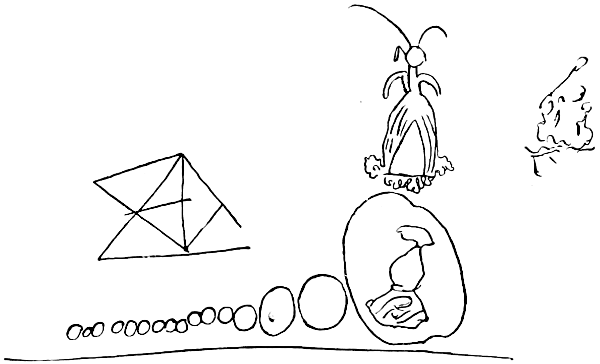
Fig. 654.—Myth of Pokinsquss.
Fig. 654 is one of the drawings mentioned, and indicates one episode among the very numerous adventures of Glooscap, the Hero-God of the Abnaki, several of which are connected with a powerful witch called by Mr. Leland Pook-jin-skwess, or the Evil Pitcher, and by Mrs. W. Wallace Brown, Pokinsquss, the Jug Woman. She is also called the toad woman, from one of her transformations, and often appeared in a male form to fight Glooscap after he had disdained her love proffered as a female. Among the multitude of tales on this general theme, one narrates how Glooscap was at one time a Pogumk, or the small animal of the weasel family commonly called Fisher (Mustela Canadensis), also translated as Black Cat, and was the son of the chief of a village of Indians who were all Black Cats, his mother being a bear. Doubtless these animal names and the attributes of the animals in the tales refer to the origin of totemic divisions among the Abnaki. Pokinsquss was also of the Black Cat village, and hated the chief and contrived long how she could kill him and take his place. Now, one day when the camp had packed up to travel, the witch asked the chief Pogumk to go with her to gather gull’s eggs; and they went far away in a canoe to an island where the gulls were breeding and landed there, and then she hid herself to spy, and having found out that the Pogumk was Glooscap, ran to the canoe and paddled away singing:
Nikhed-ha Pogumk min nekuk,
Netswil sāgāmawin!
Which being translated from the Passamaquoddy language means—
I have left the Black Cat on an island,
I shall be chief of the Fishers now!
The continuation of the story is found in many variant shapes. In one of them Glooscap’s friend the Fox came to his rescue, as through Glooscap’s m’toulin or magic power he heard the song of appeal though miles away beyond forests and mountains. In others the Sea Serpent appears in answer to the Hero-God’s call, and the latter, mounting the serpent’s back, takes a load of stones as his cargo to throw at the serpent’s horns when the latter did not swim fast enough. In the figure the island is shown at the lower right hand as a roundish outline with Glooscap inside. The small round objects to the left are probably the gull’s eggs, but may be the stimulating stones above mentioned. Pokinsquss stands rejoicing in the stern of a canoe, which points in the wavy water away from the island. The device to the left of the witch may be the dismantled camp of the Black Cats, and the one to her right is perhaps where the Fox “beyond forests and mountains” heard Glooscap’s song of distress.
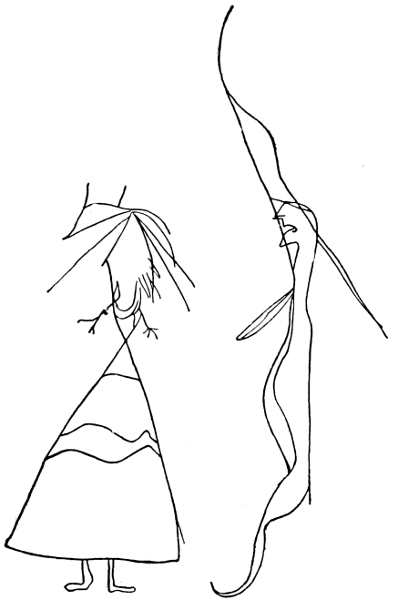
Fig. 655.—Myth of Atosis.
Fig. 655, another specimen of the same class, refers to one of the tales about At-o-sis, the Snake, who was the lover of a beautiful Abnaki woman. He appeared to her from out the surface of a lake as a young hunter with a large shining silvery plate on his heart and covered with brilliant white brooches as fish are covered with scales. He provided her with all animals for food. The bow attached to the semi-human head in the illustration may refer to this expertness in the chase. The head of the female figure is covered or masked by one of the insignia of rank and power mentioned in Chap. XIII, Sec. 2. She became the mother of the Black Snakes.
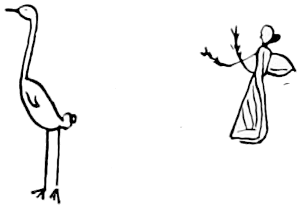
Fig. 656.—Myth of the Weasel girls.
Fig. 656, from the same locality, shows simply a crane, and a woman who bears in her hand two branches; but this is a sufficient indication of the tale of the Weasel girls, who had come down from Star-land by means of a diminishing hemlock tree, and flying from Lox had come to a broad river which they could not cross. But in the edge of the water stood motionless a large crane, or the Tum-gwo-lig-unach, who was the ferryman. “Now, truly, this is esteemed to be the least beautiful of all the birds, for which cause he is greedy of good words and fondest of flattery. And of all beings there were none who had more bear’s oil ready to annoint every one’s hair with—that is to say, more compliments ready for everybody—than the Weasels. So, seeing the Crane, they sang:
“This charmed the old ferryman very much, and when they said: ‘please, grandfather, hurry along,’ he came quickly. Seeing this, they began to chant in chorus sweetly as the Seven Stars themselves:
“Hearing this the good crane wanted more; so when they asked him to give them a lift across he answered, slowly, that to do so he must be well paid, but that good praise would answer as well. Now they who had abundance of this and to spare for everybody were these very girls. ‘Have I not a beautiful form?’ he inquired; and they both cried aloud: ‘Oh, uncle, it is indeed beautiful!’ ‘And my feathers?’ ‘Ah, pegeakopchu.’ ‘Beautiful and straight feathers, indeed!’ ‘And have I not a charming long, straight, neck?’ ‘Truly our uncle has it straight and long.’ ‘And will ye not acknowledge, oh maidens, that[472] my legs are fine?’ ‘Fine! oh, uncle, they are perfection. Never in this life did we see such legs!’ So, being well pleased, the crane put them across, and then the two little weasels scampered like mice into the bush.”
Though but one woman figure is drawn, the two boughs borne by her suggest the two weasel girls, who had come down the hemlock tree and had also been water fairies until their garments were stolen by the marten, and thereupon they had lost their fairy powers and become women in a manner at once reminding of the Old World swan-maiden myth.
Fig. 657 is a sketch of the Giant Bird Kaloo, or, in the literation of Mr. Leland, Culloo. He was the most terrible of all creatures. He it was who caught up the mischievous Lox in his claws and, mounting to the top of the sky among the stars, let him drop, and he fell from dawn to sunset. Lox was often a badger in the Micmac stories, and was more Puck-like than the devilish character he showed among the Passamaquoddy, being then generally in the form of a wolverine, though sometimes in that of a lynx. In the illustration Kaloo is soaring among the stars, and appears to possess an extra pair of legs armed with claws. Perhaps one of the objects beneath his beak represents Lox or some[473] other victim falling through the air. There is another story of Lox’s two feet talking and acting independently of the rest of his body, and the two feet and legs without any body may be a symbol of the tricksy demigod.
Fig. 658 represents Kiwach, the Strong Blower, a giant who kills people with his violent breath. Tales of him seem to be more current or better preserved among the Amalecites than among the other Abnaki.
Fig. 659 is an exact copy of the design on a birch-bark jewel box made by the Passamaquoddy of Maine, amiably contributed by Mrs. W. W. Brown, together with the description of that part of the myth which is illustrated on the box. There are several variants of this myth, the nearest to the form now presented being published by Mr. J. Walter Fewkes (a).
The Sable and the Black Cat wanted some maple sugar, and went to a wood where the maple trees grew. Toward night they lost their way and separated from each other to find it, agreeing to call to each other by m’toulin power. These animals were as frequently in human form as in that designated by their names, and could change to the forms of other animals. It is not certain, from anything in the present version of the myth, which one of the daimons was represented by the Sable, but the Black Cat afterward appears as Glooscap. Sable, in his wanderings, came to a wigwam in which was a large fire with a kettle boiling over it, tended by a great Snake. The Snake said he was glad the Sable had come, as he was very hungry and would eat him, but in gratitude for his coming would put him to as little pain as was possible. The Snake told him to go into the woods and get a straight stick, so that when he pierced him he would not tear open his entrails. Sable then went out and sang in a loud voice a m’toulin song for the Black Cat to hear and come to his aid. The Black Cat heard him and came to him. Then the Sable told the Black Cat how the Snake was going to kill him. The Black Cat told Sable not to be afraid, but that he would kill the big Snake. He told him that he would lie down behind the trunk of a hemlock tree which had fallen and that Sable should search out a stick that was very crooked, only pretending to obey the commands of the great Snake. After finding such a stick he should carry it to the Snake, who would complain that the stick was not straight enough, and then Sable should reply that he would[474] straighten it in the fire, holding it there until the steam came out of the end. Then while the Snake watched the new mode of straightening sticks Sable should strike the Snake over the eyes. The Sable sought out the most crooked stick he could find and then returned to the wigwam where the Snake was. The Snake said the stick was too crooked. The Sable replied as directed and held it in the fire. When it was burning he struck the Snake with it over the eyes, blinded him, and ran away. The Snake followed the Sable, and as he passed over the hemlock trunk the Black Cat killed him and they cut him into small pieces.
The two human figures on the left show the animals under the forest trees in human form bidding good-bye before they parted in search of the right trail. Their diminutive size gives the suggestion of distance from the main scene. Next comes the great Snake’s wigwam, the stars outside showing that night had come, and inside the kettle hung over a fire, and on its right appear the wide-open jaws and an indication of the head of the great Snake. The very crooked stick is on the other side. Farther on the Black Cat comes responsive to the Sable’s call. Next is shown, the Black Cat and the Sable, who is in human form, near the hemlock tree. The fact that the tree is fallen is suggested, without any attempt at perspective, by the broken-off branches and the thick part of the trunk being upturned. The illustration ends with the Black Cat sitting upon the Snake, clawing and throwing around pieces of it.
The illustration above presented gives an excellent example of the art of the Passamaquoddy in producing pictures by the simple scraping of birch bark.
The characters in Fig. 660 are reproduced from Schoolcraft (k).
The first device, beginning at the left, is used by the Ojibwa to denote a spirit or man enlightened from on high, having the head of the sun.
The second device is drawn by the Ojibwa for a “wabeno” or shaman.
The third is the Ojibwa “symbol” for an evil or one-sided “meda” or higher-grade shaman.
The fourth is the Ojibwa general “symbol” for a meda.
Mr. William H. Holmes, of the Bureau of Ethnology, gives the following account (condensed from the American Anthropologist, July, 1890) of a West Virginia rock shelter (shown in Pl. XXXI). The copy is in two rows of figures, but in the original there is only one row, the parts marked a and a being united:
In Harrison county, West Virginia, a small stream, Two-Lick creek, heading near the Little Kanawha divide, descends into the west fork of the Monongahela about 4 miles west of Lost Creek station, on the Clarksburg and Weston railroad. Ascending the stream for a little more than 2 miles and turning to the right up a tributary called Campbells run, is a recess in the rocks, the result of local surface undermining of an outcrop of sandstone assisted by roof degradation, which therefore is a typical rock shelter. At the opening it is about 20 feet long and in the deepest part extends back 16 feet.
The rock sculptures, of which simplified outlines are given in Pl. XXXI, occupy the greater part of the back wall of the recess, covering a space of some 20 feet long by about 4 feet in height. At the left the line of figures approaches the outer face of the rock, but at the right it terminates in the depths of the chamber, beyond which the space is too low and uneven to be utilized. There are indications that engravings have existed above and below those shown, but their traces are too indistinct to be followed.
The more legible designs comprise three heads, resembling death’s-heads, one human head or face, one obscure human figure, three birds resembling cranes or turkeys (one with outspread wings), three mountain lions or beasts of like character, two rattlesnakes, one turtle, one turtle-like figure with bird’s head, parts of several unidentified creatures (one resembling a fish), and four conventional figures or devices resembling, one a hand, one a star, one the track of a horse, and the fourth the track of an elk, buffalo, deer, or domestic cow.
The serpents, placed above and toward the right of the picture, are much larger than life, but the other subjects are represented somewhat nearly natural size. The animal figure facing the two death’s-heads is drawn with considerable vigor and very decidedly suggests the panther. A notable feature is the two back-curving spines or spine-like tufts seen upon its shoulder; it is possible that these represent some mythical character of the creature. Two of the animal figures, in accordance with a widespread Indian practice, exhibit the heart and the life line, the latter connecting the heart with the mouth; these features are, as usual, drawn in red.
The human head or face is somewhat larger than life; it is neatly hollowed out to the nearly uniform depth of one-fourth of an inch, and is slightly polished over most of the surface. Ear lobes are seen at the right and left, and an arched line, possibly intended for a plume, rises from the left side of the head. A crescent-shaped band of red extends across the face, and within this the eyes are indistinctly marked. The mouth is encircled by a dark line and shows six teeth, the spaces between being filled in with red.
Probably the most remarkable members of the series are the three death’s-heads seen near the middle of the line. That they are intended to represent skulls and not the living face or head is clear, and the treatment is decidedly suggestive of that exhibited in similar work of the more cultured southern nations. The eye spaces are large and deep, the cheek bones project, the nose is depressed, and the mouth is a mere node depressed in the center.
All the figures are clearly and deeply engraved, and all save the serpents are in full intaglio, being excavated over the entire space within the outlines and to the[476] depth of from one-eighth to one-fourth of an inch. The serpents are outlined in deep unsteady lines, ranging from one-fourth of an inch to 1 inch in width, and in parts are as much as one-half an inch in depth. The example at the left is rather carefully executed, but the other is very rude. It is proper to notice a wing-like feature which forms a partial arch over the larger serpent. It consists of a broad line of irregular pick marks, which are rather new looking and may not have formed a part of the original design; aside from this, there are few indications of the use of hard or sharp tools, and, although picking or striking must have been resorted to in excavating the figures, the lines and surfaces were evidently finished by rubbing. The friable character of the coarse, soft sandstone makes excavation by rubbing quite easy, and at the same time renders it impossible to produce any considerable degree of polish.
The red color used upon the large face and in delineating the life line and heart of the animal figures is a red ocher or hematite, bits of which, exhibiting the effects of rubbing, were found in the floor deposits of the recess. The exact manner of its application is not known (perhaps the mere rubbing was sufficient), but the color is so fixed that it can not be removed save by the removal of the rock surface.
Regarding the origin and purpose of these sculptures, it seems probable that they are connected with religious practices and myths. If the inscriptions were mnemonic records or notices it is reasonable to suppose that they would have been placed so as to meet the eye of others than those who made or were acquainted with them. But these works are hidden in a mountain cave, and even yet, when the forest is cleared and the surrounding slopes are cultivated, this secluded recess is invisible from almost every side. The spot was evidently the resort of a chosen few, such as a religious society. Such sequestered art gives evidence of a mystic purpose.

Fig. 661.—Baho-li-kong-ya. Arizona.
In this connection it may be noted that a rock drawing in the Canyon Segy, Arizona (Fig. 661), shows Baho li-kong-ya, a god, the genius of fructification, worshipped by living Moki priests. It is a great crested serpent with mammæ, which are the source of the blood of all the animals and of all the waters of the land.
The serpents in the last-mentioned plate and figure may be compared with two Ojibway forms published by Schoolcraft (l).
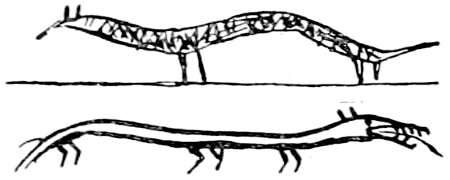
Fig. 662.—Mythic serpents, Innuits.
The upper design of Fig. 662 undoubtedly represents a mythical animal, referred to in the myths of some of the Innuits. It is reproduced[477] from a drawing on walrus ivory, bearing Museum No. 40054, obtained at Port Clarence, Alaska. This form is not so close in detail to that form usually described and more fully outlined in the lower design of the same figure, which is reproduced from a specimen of reindeer horn drill-bow, from Alaska, marked No. 24557, collected by L. Turner.
Ensign Niblack, U. S. Navy (d), gives the following description of the illustration reproduced here as Fig. 663.
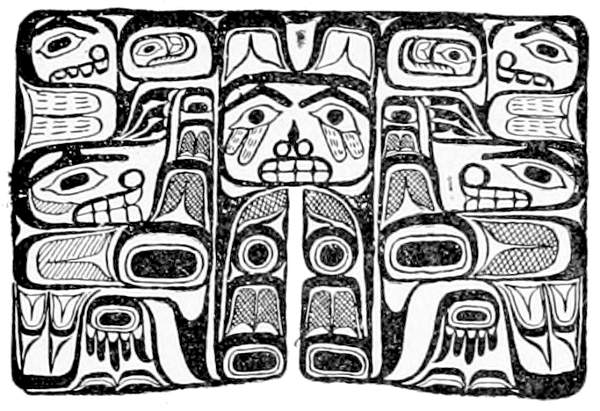
Fig. 663.—Haida Wind Spirit.
It represents T’kul, the wind spirit, and the cirrus clouds, explaining the Haida belief in the causes of the changes in the weather. The center figure is T’kul, the wind spirit. On the right and left are his feet, which are indicated by long streaming clouds; above are the wings, and on each side are the different winds, each designated by an eye, and represented by the patches of cirrus clouds. When T’kul determines which wind is to blow, he gives the word and the other winds retire. The change in the weather is usually followed by rain, which is indicated by the tears which stream from the eyes of T’kul.
The same author, p. 322, thus describes Fig. 664:
It represents the orca or whale-killer, which the Haida believe to be a demon called Skana. Judge Swan says that, according to their belief—
“He can change into any desired form, and many are the legends about him. One which was related to me was that ages ago the Indians were out seal-hunting. The[478] weather was calm and the sea smooth. One of these killers, or blackfish, a species of porpoise, kept alongside of a canoe, and the young men amused themselves by throwing stones from the canoe ballast and hitting the fin of the killer. After some pretty hard blows from these rocks the creature made for the shore, where it grounded on the beach. Soon a smoke was seen, and their curiosity prompted them to ascertain the cause, but when they reached the shore they discovered, to their surprise, that it was a large canoe, and not the Skana that was in the beach, and that a man was on shore cooking some food. He asked them why they threw stones at his canoe. ‘You have broken it,’ he said, ‘and now go into the woods and get some cedar withes and mend it.’ They did so, and when they had finished the man said, ‘Turn your backs to the water and cover your heads with your skin blankets and don’t look till I call you.’ They did so, and heard the canoe grate on the beach as it was hauled down to the surf. Then the man said, ‘Look, now.’ They looked, but when it came to the second breaker it went under and presently came up outside of the breaker a killer and not a canoe, and the man or demon was in its belly. This allegory is common among all the tribes on the Northwest Coast, and even with the interior tribes with whom the salmon takes the place of the orca, which never ascends the fresh-water rivers. The Chilcat and other tribes of Alaska carve figures of salmon, inside of which is the full length figure of a nude Indian. * * * Casual observers without inquiry will at once pronounce it to be Jonah in the fish’s belly, but the allegory is of ancient origin, far antedating the advent of the white man or the teachings of the missionary.”
The same author, Pl. XLIX, gives an explanation of Fig. 665, which is a copy of a Haida slate carving, representing the “Bear-Mother.”
The Haida version of the myth is as follows:
A number of Indian squaws were in the woods gathering berries when one of them, the daughter of a chief, spoke in terms of ridicule of the whole bear species. The bears descended on them and killed all but the chief’s daughter, whom the king of the bears took to wife. She bore him a child half human and half bear. The carving represents the agony of the mother in suckling this rough and uncouth offspring. One day a party of Indian bear hunters discovered her up a tree and were about to kill her, thinking her a bear, but she made them understand that she was human. They took her home and she afterwards became the progenitor of all Indians belonging to the bear totem. They believe that the bear are men transformed for the time being. This carving was made by Skaows-ke'ay, a Haida. Cat. No. 73117, U. S. Nat. Museum. Skidegate village, Queen Charlotte Islands, British Columbia. Collected by James G. Swan.
Dr. F. Boas (d) gives the following account of a myth of the Kwakiut Indians illustrated on a house front at Alert Bay, copied here as Fig. 666.
The house front shows how Kunkunquilikya (the thunder-bird) tried to lift the whale. The legend says that he had stolen the son of the raven, who in order to recover him, carried a whale out of a huge cedar that he covered with a coating of gum. Then he let all kinds of animals go into the whale, and they went to the land of the thunder-bird. When the bird saw the whale he sent out his youngest son to catch it. He was unable to lift it. He stuck to the gum and the animals killed him. In this way the whole family was slaughtered.
On Pl. XXXII is shown a reproduction of a native Haida drawing, representing the Wasko, a mythologic animal partaking of the characteristics of both the bear and the orca, or killer. It is one of the totems of the Haidas.
On the same plate is a figure representing the Hooyeh, or mythic raven. The character is also reproduced from a sketch made by a Haida Indian. Both of these figures were obtained from Haida Indians who visited Port Townsend, Washington, in the summer of 1884.
The following is extracted from Mrs. Eastman’s (b) Dahcotah. The picture, reproduced here in Fig. 667, is that of Haokah, the antinatural god, one of the giants of the Dakotas, drawn by White-Deer, a Sioux warrior, living near Fort Snelling about 1840.
Explanation of the drawing.—a, the giant; b, a frog that the giant uses for an arrow point; c, a large bird that the giant keeps in his court; d, another bird; e, an ornament[480] over the door leading into the court; f, an ornament over a door; g, part of court ornamented with down; h, part of court ornamented with red down; i, a bear; j, a deer; k, an elk; l, a buffalo; m, n, incense-offering; o, a rattle of deer’s claws, used when singing; p, a long flute, or whistle; q, r, s, t, are meteors that the giant sends out for his defense, or to protect him from invasion; u, v, w, x, the giant surrounded with lightnings, with which he kills all kinds of animals that molest him; y, red down in small bunches fastened to the railing of the court; z, the same. One of these bunches of red down disappears every time an animal is found dead inside the court; aa, bb, touchwood, and a large fungus that grows on trees. These are eaten by any animal that enters the court, and this food causes their death; cc, a streak of lightning going from the giant’s hat; dd, giant’s head and hat; ee, his bow and arrow.
Mrs. Eastman’s explanation of the drawing would have been better if she had known more about the mystery lodges. It is given here in her own words.

Fig. 668.—Ojibwa Ma'nidō.
Fig. 668, from Copway (c), shows the representations, beginning from the left, of spirits above, spirits under water, and animals under ground, all of which are called ma'nidōs.
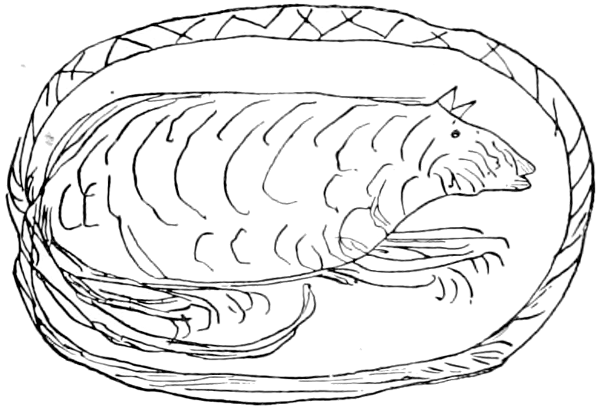
Fig. 669.—Menomoni. White Bear Ma'nidō.
Fig. 669 is a reproduction of a drawing made by Niópet, chief of the Menomoni Indians, and represents the white bear spirit who guards the deposits of native copper of Lake Superior. According to the myth the animal is covered with silvery hair, and the tail, which is of great length and extends completely around the body, is composed of bright, burnished copper. This spirit lives in the earth, where he guards the metal from discovery.

Fig. 670.—Mythic wild-cats. Ojibway.
In a midē' song, given by James Tanner (f), is the representation of an animal resembling the preceding, viz, the middle character of Fig. 670, to which is attached the Ojibway phrase and explanation as follows:
Che-be-gau-ze-naung gwit-to-i-ah-na maun-dah-ween ah-kee-ge neen-wa-nah gua-kwaik ke-nah gwit-to-i-ah-na.
I come to change the appearance of the ground, this ground; I make it look different each season.
This is a Manito who, on account of his immensity of tail, and other peculiarities, has no prototype. He claims to be the ruler over the seasons. He is probably Gitche-a-nah-mi-e-be-zhew (great underground wild-cat).
The “underground wild-cat” is again mentioned in the same work, page 377, with an illustration now presented as the left-hand character of the same Fig. 670, slightly different from the above, described as follows:
A-nah-me be-zhe ne-kau-naw.
Underground wild-cat is my friend.
At the fourth verse he exhibits his medicines, which he says are the roots of shrubs and of We-ug-gusk-oan, or herbs, and from these he derives his power, at least in part; but lest his claim, founded on a knowledge of these, should not be considered of sufficient importance, he proceeds to say, in the fifth and sixth verses, that the snakes and the underground wild-cat are among his helpers and friends. The ferocity and cunning, as well as the activity of the feline animals have not escaped the notice of the Indians, and very commonly they give the form of animals of this family to those imaginary beings whose attributes bear, in their opinion, some resemblance to the qualities of these animals. Most of them have heard of the lion, the largest of the cats known to white men, and all have heard of the devil; they consider them the same. The wild-cat here figured has horns, and his residence is under the ground; but he has a master, Gitche-a-nah-mi-e-be-zhew (the great underground wild-cat), who is, as some think, Matche-Manito himself, their evil spirit, or devil. Of this last they speak but rarely.
In another song from Tanner, p. 345, sung only by the midē', is the drawing, the right hand character of the same figure, of a similar animal with a bar across the throat, signifying, no doubt, its emerging or appearance from the surface of the ground.
Nah-ne-bah o-sa ann neen-no ne-mah-che oos-sa ya-ah-ne-no. [Twice.]
I walk about in the nighttime.
This first figure represents the wild-cat, to whom, on account of his vigilance, the medicines for the cure of diseases were committed. The meaning probably is that to those who have the shrewdness, the watchfulness, and intelligence of the wild-cat, is intrusted the knowledge of those powerful remedies, which, in the opinion of the Indians, not only control life and avail to the restoration of health but give an almost unlimited power over animals and birds.
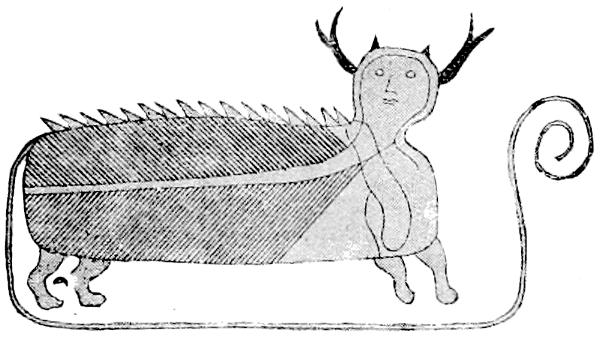
Fig. 671.—Winnebago magic animal.
Schoolcraft, part II, p. 224, describes Fig. 671 as follows:
It was drawn by Little Hill, a Winnebago chief of the upper Mississippi, west. He represents it as their medicine animal. He says that this animal is seldom seen; that it is only seen by medicine men after severe fasting. He has a piece of bone which he asserts was taken from this animal. He considers it a potent medicine and uses it by filing a small piece in water. He has also a small piece of native copper which he uses in the same manner, and entertains like notions of its sovereign virtues.
The four preceding figures are to be compared with those relating to the Piasa rock. See Figs. 40 and 41, supra.
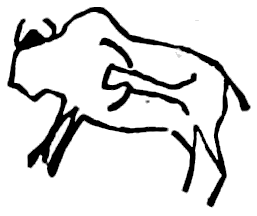
Fig. 672.—Mythic buffalo.
Fig. 672.—A Minneconjou Dakota, having killed a buffalo cow, found an old woman inside of her. The-Swan’s Winter Count, 1850-’51.
For remarks upon this statement see Lone-Dog’s Winter Count for 1850-’51, supra.
Graphic representations of Atotarka and of the Great Heads are shown in Mrs. Erminie A. Smith’s Myths of the Iroquois, in the Second Annual Report of the Bureau of Ethnology. Several illustrations of myths and mythic animals appear in the present work in Chap. IX, Secs. 4 and 5.
Some forms of the thunder bird are here presented:
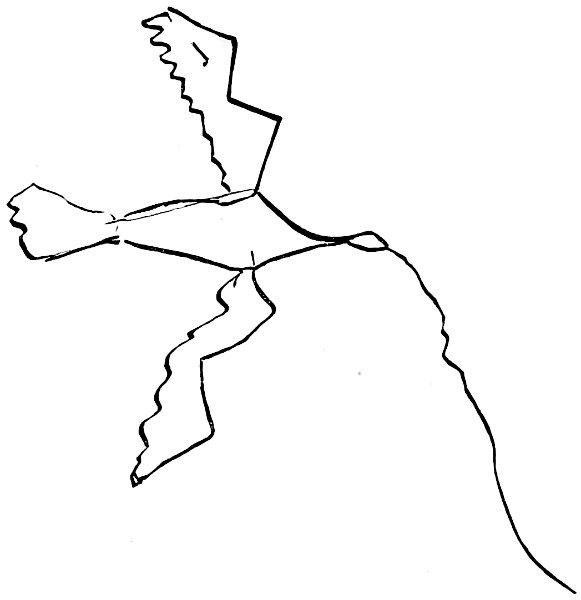
Fig. 673.—Thunder-bird, Dakota.
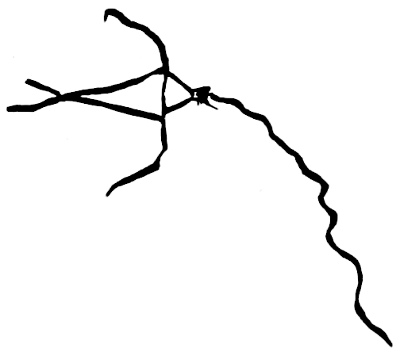
Fig. 674.—Thunder-bird, Dakota.
Figs. 673 and 674 are forms of the thunder bird found in 1883 among the Dakotas near Fort Snelling, drawn and interpreted by themselves. They are both winged, and have waving lines extending from the mouth downward, signifying lightning. It is noticeable that Fig. 673 placed vertically, then appearing roughly as an upright human figure, is almost identically the same as some of the Ojibwa meda or spirit figures represented in Schoolcraft, and also on a bark Ojibwa record in the possession of the writer.

Fig. 675.—Wingless thunder-bird, Dakota.
Fig. 675 is another and more cursive form of the thunder bird obtained at the same place and time as those immediately preceding. It is wingless, and, with changed position or point of view, would suggest a headless human figure.
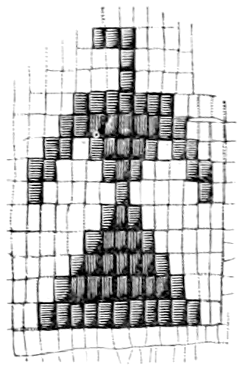
Fig. 676.—Thunder-bird, Dakota.
The thunder-bird, Fig. 676, is blue, with red breast and tail. It is a copy of one worked in beads found at Mendota, Minnesota.

Fig. 677.—Dakota thunder-bird.
The Sioux believe that thunder is a large bird, and represent it thus, Fig. 677, according to Mrs. Eastman (c), who adds details condensed as follows:
This figure is often seen worked with porcupine quills on their ornaments. U-mi-ne wah-chippe is a dance given by some one who fears thunder and thus endeavors to propitiate the god and save his own life.
A ring is made of about 60 feet in circumference by sticking saplings in the ground and bending their tops down, fastening them together. In the center of this ring a pole is placed, about 15 feet in height and painted red. From this swings a piece of birch bark cut so as to represent thunder. At the foot of the pole stand two boys and two girls. The boys represent war; they are painted red and hold war clubs in their hands. The girls have their faces painted with blue clay; they represent peace.
On one side of the circle a kind of booth is erected, and about 20 feet from it a wigwam. There are four entrances. When all arrangements for the dance are concluded the man who gives it emerges from his wigwam, dressed up hideously, crawling on all fours toward the booth. He must sing four tunes before reaching it.
In the meantime the medicine men, who are seated in the wigwam, beat time on the drum, and the young men and squaws keep time to the music by hopping on one foot and then on the other, moving around inside the ring as fast as they can. This is continued for about five minutes, until the music stops. After resting a few moments the second tune commences and lasts the same length of time, then the third and the fourth; the Indian meanwhile making his way toward the booth. At the end of each tune a whoop is raised by the men dancers.
After the Indian has reached his booth inside the ring he must sing four more tunes. At the end of the fourth tune the squaws all run out of the ring as fast as possible, and must leave by the same way that they entered, the other three entrances being reserved for the men, who, carrying their war implements, might be accidentally touched by one of the squaws, and the war implements of the Sioux warrior have from time immemorial been held sacred from the touch of woman. For the same reason the men form the inner ring in dancing round the pole, their war implements being placed at the foot of the pole.
When the last tune is ended the young men shoot at the image of thunder, which is hanging to the pole, and when it falls a general rush is made by the warriors to get hold of it. There is placed at the foot of the pole a bowl of water colored with blue clay. While the men are trying to seize the parts of the bark representation of their god they at the same time are eagerly endeavoring to drink the water in the bowl, every drop of which must be drank.
The warriors then seize on the two boys and girls (the representations of war and peace) and use them as roughly as possible, taking their pipes and war-clubs from[485] them and rolling them in the dirt until the paint is entirely rubbed off from their faces. Much as they dislike this part of the dance, they submit to it through fear, believing that after this performance the power of thunder is destroyed.
James’s Long (f) says:
When a Kansas Indian is killed in battle the thunder is supposed to take him up they do not know where. In going to battle each man traces an imaginary figure of the thunder on the soil, and he who represents it incorrectly is killed by the thunder.
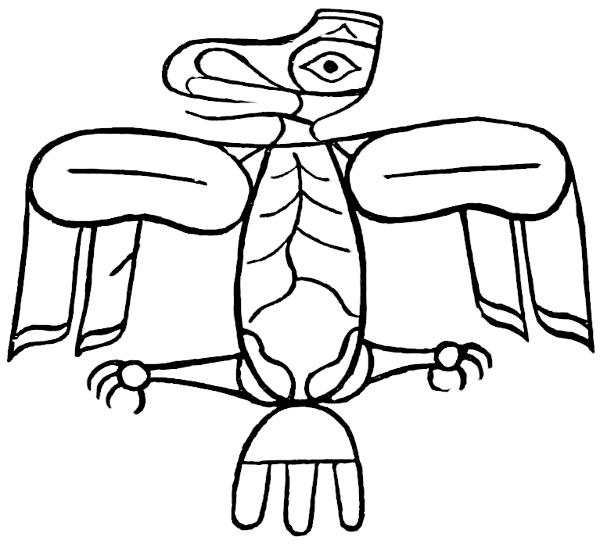
Fig. 678.—Thunder-bird. Haida.
Fig. 678 is “Skam-son,” the thunder-bird, a tattoo mark copied from the back of an Indian belonging to the Laskeek village of the Haida tribe, Queen Charlotte islands, by Mr. James G. Swan.
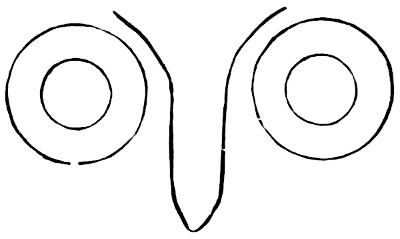
Fig. 679.—Thunder-bird. Twana.
Fig. 679 is a Twana thunder-bird, as reported by Rev. M. Eells in Bull. U. S. Geol. and Geog. Survey, III, p. 112.
There is at Eneti, on the reservation [Washington Territory], an irregular basaltic rock, about 3 feet by 3 feet and 4 inches, and a foot and a half high. On one side there has been hammered a face, said to be the representation of the face of the thunder-bird, which could also cause storms.
The two eyes are about 6 inches in diameter and 4 inches apart and the nose about 9 inches long. It is said to have been made by some man a long time ago, who felt very badly, and went and sat on the rock and with another stone hammered out the eyes and nose. For a long time they believed that if the rock was shaken it would cause rain, probably because the thunder-bird was angry.
The three following figures, taken from Red-Cloud’s Census, are connected with the thunder-bird myth:
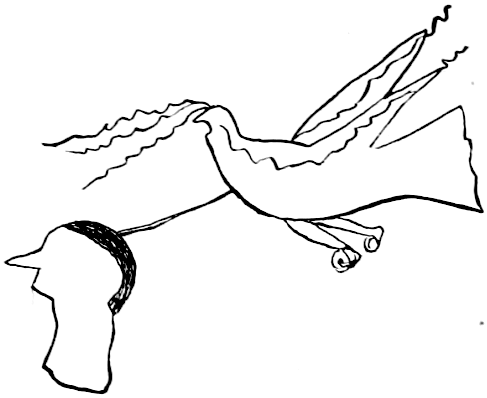
Fig. 680.—Medicine bird. Dakota.
Fig. 680.—Medicine bird. Red-Cloud’s Census. The word medicine is in the Indian sense, before explained, and would be more correctly expressed by the word sacred or mystic, as is also indicated by the waving lines issuing from the mouth.
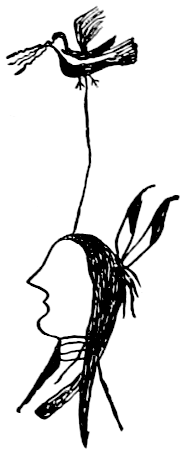
Fig. 681.—Five thunders. Dakota.
Fig. 681.—Five thunders. Red-Cloud’s Census. The thunder-bird is here drawn with five lines (voices) issuing from the mouth, which may mean many voices or loud sound, but is connected with the above mentioned wavy or spiral lines, which form the conventional sign for wakan.
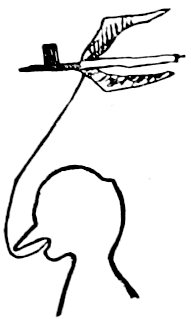
Fig. 682.—Thunder pipe. Dakota.
Fig. 682.—Thunder pipe. Red-Cloud’s Census. This is a pipe to which are attached the wings of the thunder-bird.
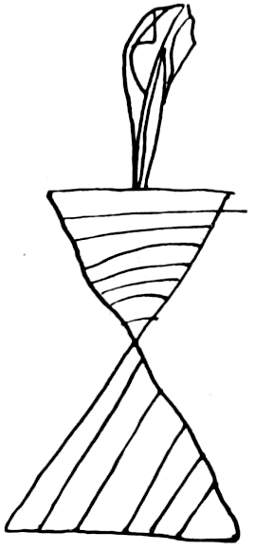
Fig. 683.—Micmac thunder-bird.
Fig. 683, one of the drawings from the Kejimkoojik rocks of Nova Scotia, may be compared with the other designs of the thunder-bird and also with the Ojibwa type of device for woman. As regards the head, which appears to have a non-human form, it may also be compared with the many totemic designations in Chapter XIII, on Totems, Titles, and Names.
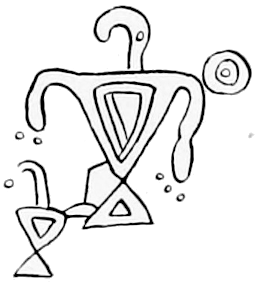
Fig. 684.—Venezuelan thunder-bird.
Marcano (d), describing Fig. 684, reports:
At Boca del Infierno (mouth of hell), on a plain, there are found stones, separated from each other by spaces of 7 meters, on which are found inscriptions nearly a centimeter in depth. One of them represents a great bird similar to those which the Oyampis (Crevaux) are in the habit of drawing. On its left shoulder are seen three concentric circles arranged like those that form the eyes of the jaguars of Calcara. This figure is often reproduced in Venezuelan Guiana and beyond the Esequibo. The bird is united at the right by a double connecting stroke with another which is incomplete and much smaller. Furthermore, three small circles are seen below the left wing; three others, farther apart, separate its right wing from the neck of the lower bird. The triangles which form the breast and the tail of the two birds are worthy of note.
Mr. A. Ernst (b) describes the same figure:
From the same place (“Boca del Infierno,” a rapid of the Orinoco, 35 kilometers below the mouth of the Caura) is easily recognized a rough representation of two birds; from the feathers of the larger one water seems to be dropping; above, to the right, is seen a picture of the sun. This may be symbolic, and would then remind one of the representation of the wind and rain gods on the ruins of Central America.
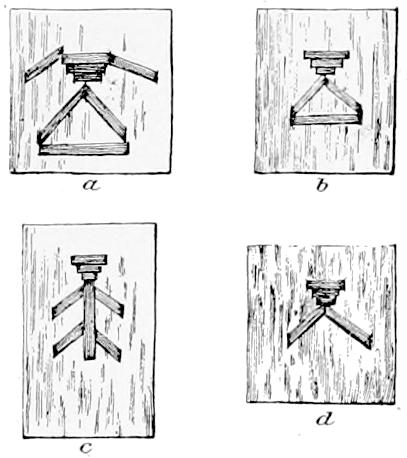
Fig. 685.—Ojibwa thunder-bird.
Fig. 685 is a copy of four specimens of Indian workmanship in the collection of the Academy of Natural Sciences of Philadelphia. The objects are depicted by porcupine quills worked on pieces of birch bark, and represent various forms of the thunder-bird. The specimens are reported as having been obtained from a northwestern tribe, which may safely be designated as the Ojibwa, because the figures relate to one of the most important mythic animals of that tribe, and also because birch bark is used, a material exceedingly scarce in the country of the Sioux, among whom also the thunder-bird has a prominent religious position.
a. Made of neutral-tinted quills upon yellow bark, as is also b, which is without the projecting pieces to designate[488] wings. In c, made of yellow quills on faded red bark, the head is shown with the wings and legs beneath, while in the two preceding figures the head takes the place of the bird’s body. d. Here is still more abbreviation, the body and legs being absent, leaving only the head and wings. This is made of neutral-tint quills on straw-yellow bark.
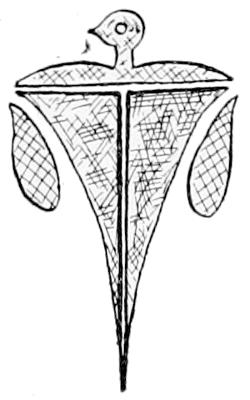
Fig. 686.—Moki Rain bird.
Fig. 686 is a copy of a painting on a jar, probably of old Moki work, thus described in the manuscript catalogue of Mr. T. V. Keam:
It is the “Rain bird” (Tci-zur), the upper portion surrounded by inclosing cloud symbols, arranged so as to convey the idea of the germinative symbol implying the generative power of rain. The crosshatching, still water, in the wings denotes rain water in volume. The body or tail of the bird divided into two tapering prolongations is a very common occurrence. As a cloud emblem in the modern ware, the Tci-zur is not like the Um-tokina (Thunder-bird) in mythical creation, but is the comprehensive name used by the women for any small bird. Explained as a rain emblem by the fact that during seasons of sufficient rainfall flocks of small birds surround the villages and gardens, while during drought they take flight to the distant water courses.
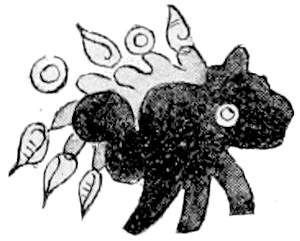
Fig. 687.—Ahuitzotl.
Fig. 687 is reproduced from Kingsborough (c). It represents Ahuitzotl, which is the name of an aquatic animal famous in Mexican mythology. The conventional sign for water is connected with this animal which Dr. Brinton (c) calls a hedgehog.
Wiener (c) gives a copy, here reproduced as the left-hand character in Fig. 688, of a bas-relief found at Cabana, Peru, representing a fabulous animal, a quadruped, the hair of which is floating and its tongue hanging out of the mouth and ending in serpents’ heads. One-sixth actual size.
The same author, loc. cit., gives a copy, now reproduced as the right-hand character in the same Fig. 688, of another bas-relief in granite found at Cabana, Peru, representing a fabulous animal, perhaps the alcoce, sitting like a dog. One-sixth natural size.
Mr. Thomas Worsnop (a) gives an account of Fig. 689, abbreviated as follows:
Sir George Grey, between 1836 and 1839, saw on a sandstone rock a most extraordinary large figure. Upon examination this proved to be[490] a drawing at the entrance to a cave, which he found to contain besides many remarkable paintings. On the sloping roof the principal character, i. e., the upper one of Fig. 689, was drawn. In order to produce the greater effect the rock about it was painted black and the figure itself colored with the most vivid red and white. It thus appeared to stand out from the rock, and Sir George Grey says he was surprised at the moment that he first saw this gigantic head and upper part of a body bending over and staring grimly down at him. He adds that it would be impossible to convey in words an adequate idea of this uncouth and savage figure, and therefore he only gives such a succinct account as will serve as a sort of description.
Its head was encircled by bright red rays, something like the rays one sees proceeding from the sun, when depicted on the signboard of a public house; inside of this came a broad stripe of very brilliant red, which was crossed by lines of white; but both inside and outside of this red space were narrow stripes of a still deeper red, intended probably to mark its boundaries; the face was painted vividly white and the eyes black, being, however, surrounded by red and yellow lines; the body, hands, and arms were outlined in red, the body being curiously painted with red stripes and bars.
Upon the rock which formed the left-hand wall of this cave, and which partly faced you on entering, was a very singular painting, the lower character of the same figure, vividly colored, representing four heads joined together. From the mild expression of the countenances they appeared to represent females, and to be drawn in such a manner, and in such a position, as to look up at the principal figure, before described; each had a very remarkable head-dress, colored bright blue, and one had a necklace on. Both of the lower figures had a sort of dress painted with red in the same manner as that of the principal figure, and one of them had a band round her waist. In Sir George Grey’s opinion each of the four faces was marked by a totally distinct expression of countenance, and none of them had mouths.
The term “shaman” is a corrupted form of the Sanscrit word meaning ascetic. Its original application was to the religion of certain tribes of northern Asia, but now shamanism is generally used to express several forms of religion which are founded in the supposed communion with and influence over supernatural beings by means of magic arts. The shaman or priest pretends to control by incantations and ceremonies the evil spirits to whom death, sickness, and other misfortunes are ascribed. This form or stage of religion was so prevalent among the North American Indians that the adoption of the term “shaman” here is substantially correct, and it avoids both the stupid expression[491] “medicine man” of current literature and the indefinite title “priest,” the associations with which are not appropriate to the Indian religious practitioner. The statement that the Indians worship, or ever have worshiped, one “Great Spirit” or single overruling personal god is erroneous. That philosophical conception is beyond the stage of culture reached by them, and was not found in any tribe previous to missionary influence. Their actual philosophy can be expressed far more objectively and therefore pictorially.
The special feature of the notes now collected under the present heading relates to the claims and practices of shamans, but the immediately succeeding headings of “Charms and Amulets” and of “Religious Ceremonies” are closely connected with the same topic. It must be confessed that, as now presented, they have been arranged chiefly for mechanical convenience, to which convenience also in other parts of the present work scientific discrimination has sometimes been forced to yield without, it is hoped, much injury. Individual intercomparison, with or without cross references, is besought from any critical reader of this paper.
Feats of jugglery or pretended magic rivaling or surpassing the best of spiritualistic séances have been recounted to the present writer in many places by independent and intelligent Indian witnesses, not operators, generally of advanced age. The cumulated evidence gives an opportunity for spiritualists to argue for the genuineness of their own manifestations or manipulations as, in accordance with the degree of credence, they may be styled. Others will contend that these remarkable performances in which this hemisphere was rich before the Columbian discovery—the occidental rivaling the oriental Indians—belong to a culture stage below civilization. They will observe that the age of miracles among barbaric people has not expired, and that it still exists among outwardly civilized persons who are yet subject to superstition in its true etymologic sense of “remaining over from the past.”
The most elaborate and interesting of these stories which are known relate to a time about forty years ago, shortly before the Davenport brothers and the Fox sisters had excited interest in the civilized portions of the United States; but exhibitions of a magic character are still given among the tribes, though secretly, from fear of the Indian agents and missionaries. It is an important fact that the first French missionaries in Canada and the early settlers of New England described substantially the same performances when they first met the Indians, all of whom belonged to the Algonquian or Iroquoian stocks. So remarkable and frequent were these performances of jugglery that the French, in 1613, called the whole body of Indians on the Ottawa River, whom they met at a very early period, “The Sorcerers.” They were the tribes afterwards called Nipissing, and were the typical Algonquians. No suspicion of prestidigitation or other form of charlatanry appears to have been entertained by any of the earliest French and English[492] writers on the subject. The severe Puritan and the ardent Catholic both considered that the exhibitions were real, and the work of Satan. It is also worth mentioning that one of the derivations of the name “Micmac” is connected with the word meaning sorcerer. The early known practices of this character, which had an important effect upon the life of the people, extended from the extreme east of the continent to the Great Lakes. They have been found later far to the south, and in a higher state of evolution.
It was obvious in cross-examining the old men of the Algonquians that the performances of jugglery were exhibitions of the pretended miraculous power of an adventurer whereby he obtained a reputation above his rivals and derived subsistence and authority by the selling of charms and pretended superhuman information. The charms and fetiches which still are bought from the few shamans who yet have a credulous clientele are of three kinds—to bring death or disease on an enemy, to lure an enemy into an ambush, and to excite a return to sexual love.
Among the Ojibwa three distinct secret societies are extant, the members of which are termed, respectively and in order of their importance, the Midē', the Jĕs'sakīd, and the Wâbĕnō. The oldest and most influential society is known as the Midē'wiwin', or Grand Medicine, and the structure in which the ceremonies are conducted is called the Midē'wigân, or Grand Medicine lodge.
The following statement of the White Earth Midē' shaman presents his views upon the origin of the rite and the objects employed in connection with ceremonies, as well as in the practices connected with medical magic and sorcery:
When Minabō'sho, the first man, had been for some time upon the earth, two great spirits told him that to be of service to his successors they would give to him several gifts, which he was to employ in prolonging life and extending assistance to those who might apply for it.
The first present consisted of a sacred drum, which was to be used at the side of the sick and when invoking the presence and assistance of the spirits. The second was a sacred rattle, with which he was enabled to prolong the life of a patient. The third gift was tobacco, which was to be an emblem of peace; and as a companion he also received a dog. He was then told to build a lodge, where he was to practice the rites of which he would receive further instruction.
All the knowledge which the Midē' have, and more, Minabō'sho received from the spirits. Then he built a long lodge, as he had been directed, and now even at this day he is present at the Sacred Medicine lodge when the Grand Medicine rite is performed.
In the rite is incorporated most that is ancient amongst them, songs and traditions that have descended, not orally alone, but by pictographs, for a long line of generations. In this rite is also perpetuated the purest and most ancient idioms of their language, which differs somewhat from that of the common, every-day use.
It is desirable to explain the mode of using the Midē' and other bark records of the Ojibwa and also those of other tribes mentioned in this[493] paper. A comparison made by Dr. Tyler of the pictorial alphabet to teach children, “A was an archer,” etc., is not strictly appropriate in this case. The devices are not only mnemonic, but are also ideographic and descriptive. They are not merely invented to express or memorize the subject, but are evolved therefrom. To persons acquainted with secret societies a good comparison for the charts or rolls is what is called the trestle board of the Masonic order, which is printed and published and publicly exposed without exhibiting any of the secrets of the order, yet through its ideography it is practically useful to the esoteric members by assisting memory in details of ceremony and it also prevents deviation from the established ritual.

Fig. 690.—Ojibwa Midē' wigwam.
Fig. 690, from Copway (d), gives the Ojibway character for Grand Medicine lodge.
Fig. 171, supra, is a reproduction, with description, of a birch-bark record illustrating the alleged power of a Jĕssakkī'd, one who is also a Midē' of the four degrees of the Medicine Society.
Fig. 172, supra, represents, with explanations, a Jĕssakkī'd named Niwi'kki, curing a sick woman by sucking the demon through a bone tube.
When the method of procedure of a Midē' goes beyond the ordinary ceremonies, such as chanting prayers and drumming, the use of the rattle, and the administration of magic medicines and exorcisms, it overlaps the prescribed formulæ of the Midē'win and partakes of the rites of the Jĕssakkī'd or “Juggler.”
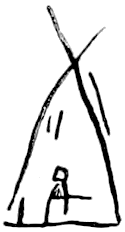
Fig. 691.—Lodge of a Midē'.
The lodge of the Midē' is represented as in Fig. 691, the shaman himself being indicated as sitting inside.
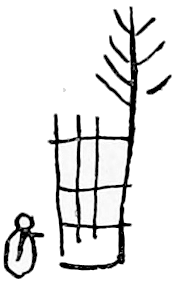
Fig. 692.—Lodge of Jĕssakkī'd.
The Jĕssakkī'd represents his lodge or jugglery as shown in Fig. 692, the shaman being represented as sitting on the outside. The chief feature of the jugglery lodge is that the branch is always seen projecting from the top of one of the vertical poles, which peculiarity exists in no other religious structure represented in pictorial records.
The following group, including Figs. 693 to 697, gives several modes of illustrating the “making buffalo medicine” by the Dakotas and other tribes of the Great Plains. The main object was to bring the buffalo to where they could be hunted successfully, and incantations, with dancing and many ceremonies, were resorted to, as upon the buffalo the tribes depended not only for food but for most of the necessaries and conveniences of their daily life. The topic is referred to elsewhere in this paper, especially in Lone-Dog’s Winter Count for the year 1810-’11.
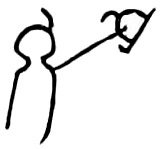
Fig. 693.—Making medicine. Dakota.
Fig. 693.—A Minneconjou chief named Lone-Horn made medicine with a white buffalo cow skin. The-Swan’s Winter Count, 1858-’59.
The horned head of the animal is connected with the man figure. An albino buffalo was much more prized for ceremonial purposes than any other. Lone-Horn, chief of the Minneconjous, died in 1874, in his camp on the Big Cheyenne.
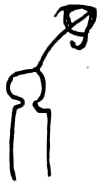
Fig. 694.—Making medicine. Dakota.
Fig. 694.—A Minneconjou Dakota named Little-Tail first made “medicine” with white buffalo cow skin. The-Swan’s Winter Count, 1810-’11. Again the head of an albino buffalo.
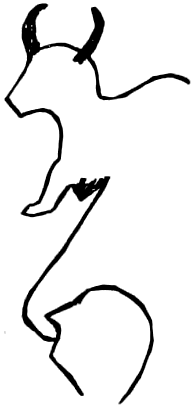
Fig. 695.—Making medicine. Dakota.
Fig. 695.—White-Cow-Man. Red-Cloud’s Census. The mere possession of an albino buffalo conferred dignity and honor. To have once owned such an animal, even though it had died or been lost, gave specific rank.
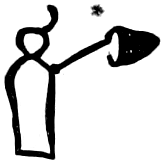
Fig. 696.—Making medicine. Dakota.
Fig. 696.—Lone-Horn makes medicine. “At such times Indians sacrifice ponies and fast.” The-Flame’s Winter Count, 1858-’59. In this figure the buffalo head is black.
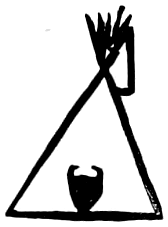
Fig. 697.—Making medicine.
Fig. 697. Buffalo is scarce; an Indian makes medicine and brings a herd to the suffering. The-Flame’s Winter Count, 1843-’44.
Here the incantation is shown by a tipi with the buffalo head drawn upon it. It is the “medicine” or sacred tipi where the rites are held.
A curious variant of divination with regard to the use of songs in the removal of disease was found among the Choctaws. Each of the songs[495] of this class bore reference to some herb or form of treatment, each of which was represented objectively or pictorially and produced simultaneously with the chanting of the appropriate song by the shaman. The remedy or treatment to be adopted was decided upon by the degree of pleasure or relief afforded to the patient by the respective songs.
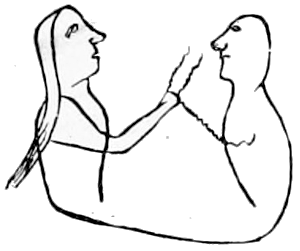
Fig. 698.—Magic Killing.
Fig. 698. Cat-Owner was killed with a spider-web thrown at him by a Dakota. Cloud-Shield’s Winter Count, 1824-’25. The spider-web is shown reaching to the heart of the victim from the hand of the man who threw it and two spiral wakan lines are also shown. Blood issuing from his nose, colored red in the original, indicates that he bled to death. It is a common belief among Indians that certain “medicine men” possess the power of taking life by shooting needles, straws, spider-webs, bullets, and other objects, however distant the person may be against whom they are directed.
It may be noted that the union line connecting the two figures at the base signifies that they belong to the same tribe which the hair on the figure of the left shows to be Dakota. The victim is not scalped, but has no hair or other designation, being shown only in outline.
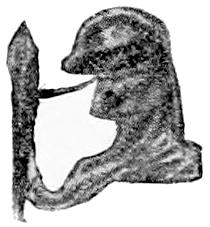
Fig. 699.—Held a ghost lodge.
Fig. 699. Cannaksa-Yuha, Has-a-war-club; from the Oglala Roster. This man has his father’s name “war-club,” and is therefore set by the ghosts in his stead as a warrior. He is supposed to be invulnerable to any mortal weapon, and the children and even women fear him as they would a ghost. He holds the war club before his face, as it partakes of the nature of insignia. In the original the whole of the man’s face is painted red. This is to show that he has a wakicagapi-ecokicoupe, which means that he has put up a ghost tent, concerning which there are many and complicated ceremonies and details narrated by Rev. J. Owen Dorsey in the American Anthropologist, II, 145 et seq.
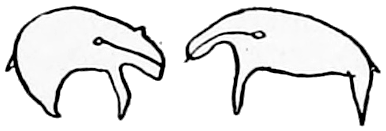
Fig. 700.—Muzzin-ne-neen. Ojibwa.
John Tanner (g) gives an account of sorcery among the Ojibwa, with illustrations copied as Fig. 700, being nearly identical with those recently obtained by Dr. Hoffman, and published in the Seventh Ann. Rep., Bureau of Ethnology, as Figs. 20 and 21.
It was thought necessary to have recourse to a medicine hunt. Nah-gitch-e-gum-me [a “medicine” maker] sent to me and O-ge-mah-we-ninne, the best two hunters of the band, each a little leather sack of medicine, consisting of certain roots pounded fine and mixed with red paint, to be applied to the little images or figures of the animals we wish to kill. Precisely the same method is practiced in this kind of hunting, at least as far as the use of medicine is concerned, as in those[496] instances where one Indian attempts to inflict disease or suffering on another. A drawing or a little image is made to represent the man, the woman, or the animal on which the power of the medicine is to be tried; then the part representing the heart is punctured with a sharp instrument, if the design be to cause death, and a little of the medicine is applied. The drawing or image of an animal used in this case is called muzzin-ne-neen, and the same name is applicable to the little figures of a man or women, and is sometime rudely traced on birch bark, in other instances more carefully carved of wood. These little images or drawings, for they are called by the same names, whether of carved wood or rags or only rudely sketched on birch bark, or even traced in sand, are much in use among several and probably all the Algonquin tribes. Their use is not confined to hunting, but extends to the making of love, and the gratification of hatred, revenge, and all malignant passions.
It is a prevailing belief that the necromancers, men or women of medicine, or those who are acquainted with the hidden powers of their wusks, can, by practicing upon the muzzin-ne-neence, exercise an unlimited control over the body and mind of the person represented. Many a simple Indian girl gives to some crafty old squaw her most valued ornaments, or whatever property she may possess, to purchase from her the love of the man she is most anxious to please. The old woman, in a case of this kind, commonly makes up a little image of stained wood and rags, to which she gives the name of the person whose inclinations she is expected to control; and to the heart, the eyes, or to some other part of this she, from time to time, applies her medicines, or professes to have done so, as she may find necessary to dupe and encourage her credulous employer.
But the influence of these images and conjurations is more frequently tested in cases of an opposite character, where the inciting cause is not love, but hatred, and the object to be attained the gratification of a deadly revenge. In cases of this kind the practices are similar to those above mentioned, only different medicines are used Sometimes the muzzin-ne-neence is pricked with a pin or needle in various parts, and pain or disease is supposed to be produced in the corresponding part of the person practiced upon. Sometimes they blacken the hands and mouth of the image, and the effect expected is the change which marks the near approach of death.
The similarity, approaching identity, of these practices to those common in Europe during the middle ages and continuing in some regions until the present time will be noticed.
The same author, pp. 197, 198, gives an account of Ojibwa divination in the following address of a shaman, illustrated by Fig. 702.
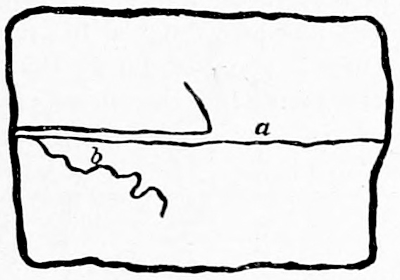
Fig. 702.—Ojibwa divination.
For you, my friends, who have been careful to regard and obey the injunctions of the Great Spirit, as communicated by me, to each of you he has given to live to the full age of man: this long and straight line a is the image of your several lives. For you, Shaw-shaw-wa ne-ba-se, who have turned aside from the right path, and despised the admonitions you have received, this short and crooked line b represents your life. You are to attain only to half of the full age of man. This line, turning off on the other side, is that which shows what is determined in relation to the young wife of Ba-po-wash. As he said this, he showed us the marks he had made on the ground, as below. The long, straight middle line represented, as he said, the life of the Indians, Sha-gwaw-koo-sink, Wau-zhe-gaw-maish-koon, etc. The short, crooked one below showed the irregular course and short continuance of mine; and the abruptly terminating one on the other side showed the life of the favorite wife of Ba-po-wash.
Fig. 703 was copied from a piece of walrus ivory in the museum of the Alaska Commercial Company, of San Francisco, California, in 1882, by Dr. Hoffman, and the interpretation is as obtained from a native Alaskan.
a, b. The shaman’s summer habitations, trees growing in the vicinity. c. The shaman, who is represented in the act of holding one of his “demons.” These are considered as under the control of the shaman, who employs them to drive others out of the bodies of sick men. d. The demon or aid. e. The same shaman exorcising the demons causing the sickness. f, g. Sick men, who have been under treatment, and from whose bodies the “evil beings” or sickness has been expelled. h. Two “evil spirits” which have left the bodies of f and g.
Fig. 704 was copied by Dr. Hoffman from an ivory bow in the same museum. The interpretation was also obtained at the same time from the same Alaskan.
The rod of the bow upon which the characters occur is here represented in three sections, A, B, and C. A bears the beginning of the narrative, extending over only one-half of the length of the rod. The course of the inscription is then continued on the adjacent side of the rod at the middle, and reading in both directions (sections B and C),[498] toward the two files of approaching animals. B and C occupy the whole of one side.
The following is the explanation of the characters:
A. a, baidarka or skin boat resting on poles; b, winter habitation; c, tree; d, winter habitations; e, storehouse; f, tree. Between this and the storehouse is placed a piece of timber, from which is suspended fish for drying. g, storehouse. The characters from a to g represent a group of dwellings, which signifies a settlement, the home of the person to whom the history relates. h, the hunter sitting on the ground, asking for aid, and making the gesture for supplication. i, the shaman to whom application is made by the hunter desiring success in the chase. The shaman has just finished his incantations, and while still retaining his left arm in the position for that ceremony, holds the right toward the hunter, giving him the success requested. j, the shaman’s winter lodge; k, trees; l, summer habitation of the shaman; m, trees near the shaman’s home.
B. n, tree; o, a shaman standing upon his lodge, driving back game which had approached against his wish. To this shaman the hunter had also made application for success in the chase, but was denied, hence the act of driving back. p, deer leaving at the shaman’s order; q, horns of a deer swimming a river; r, young deer, apparently, from the smaller size of the body and unusually long legs.
C. s, a tree; t, the lodge of the hunter (A. h), who, after having been granted the request for success, placed his totem upon the lodge as a mark of gratification and to insure greater luck in his undertaking; u, the hunter in the act of shooting; v-w, the game killed, consisting of five deer; x, the demon sent out by the shaman (A. i), to drive the game in the way of the hunter; y-bb, the demon’s assistants.
The following description and illustration, Fig. 705, is kindly contributed by the Rev. M. Eells, of Skokomish, Washington:
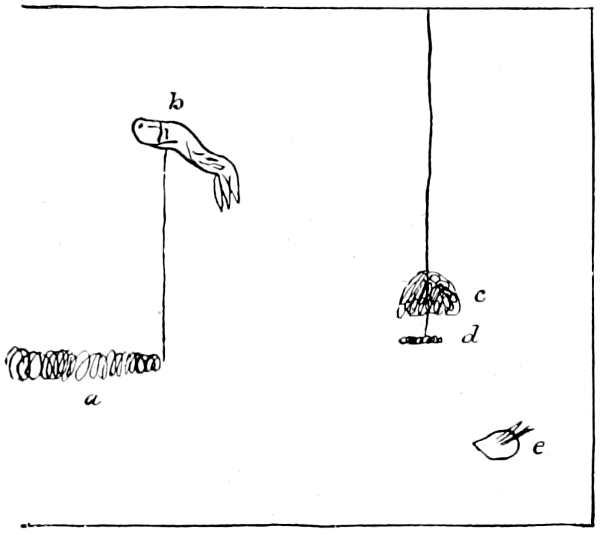
Fig. 705.—Skokomish tamahnous.
Your figure of a shaman’s lodge in Alaska [Fig. 714 in this work] reminds me of a drawing made of the same character on this reservation by one of our best educated Indian boys. His description of it is as follows: “When I was at Dr. Charley’s house (the shaman or medicine man), they tamahnoused [performed incantations] over [my brother] Frank. They saw that he was under a kind of sickness. Dr. Charley took it, and just a little after that Frank shook and became stiff, and while I sat I heard my father say that his breath was gone. I went out, as I did not want to see my brother lay dead before me. When I came back he was breathing a little and his eyes were closed. Dr. Charley was taking care of his breath with his own tamahnous [guardian spirit] and waiting for more folks to come, so as to have enough folks to beat on sticks when he should tamahnous and see what was the matter with Frank. So he went on and saw that there was another kind of sickness besides the one he took first. The other one went over Frank and almost killed him. Dr. Charley took it again and went (travel) [in spirit] with another kind of tamahnous to see where Frank’s spirit was. He found him at Humahuma [18 or 20 miles distant], where they had camped [some time previous]. So Frank got better after a hard tamahnous. From the drawing you will see how Dr. Charley fixed the kind of sickness. b shows the first sickness which Dr. Charley took. It has tails, which, when they come close to the sick person, makes him worse. a is the way it goes when it kills a person and stays in his home. c is the second one and is hanging over Frank, d. e is another sickness which is in Frank.”
In Kingsborough (d) is the following: “In the year of Eleven Houses, or in 1529, Nuño de Guzman set out for Yalisco on his march to subdue that territory. They pretend that a serpent descended from the sky, exclaiming that troubles were preparing for the natives, since the Christians were directing their course hither.” The illustration for this account is presented as Fig. 1224, Chap. XX, on Special Comparisons.
The use of material objects for the magic purposes suggested by this title is well known. Their graphic representation is not so familiar, though it is to be supposed that the objects of this character would be pictorially represented in pictographs connected with religion. The following is an instance where the use of a charm or fetich in action was certainly portrayed in a pictograph.
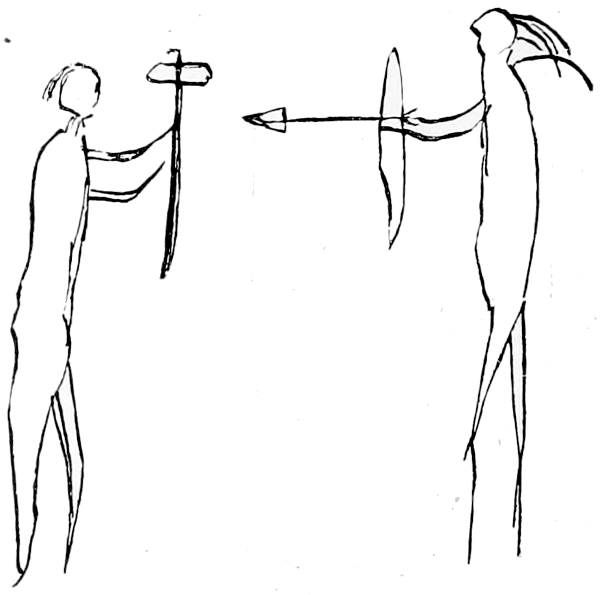
Fig. 706.—Mdewakantawan fetich.
Fig. 706, drawn by the Dakota Indians, near Fort Snelling, Minnesota, exhibits the use as a charm or talisman of an instrument fashioned in imitation of a war club, though it is not adapted to offensive employment. The head of the talisman is a grooved stone hammer from an inch and a half to 5 inches in length. A withe is tied about the middle of the hammer, in the groove binding on a handle of from 2 to 4 feet in length. The latter is frequently wrapped with buckskin or rawhide to strengthen it, as well as for ornamental purposes. Feathers attached bear designs indicating marks of distinction, perhaps sometimes fetichistic devices not understood.
It is believed that these objects possess the charm of warding off an enemy’s missiles when held upright before the body, as shown in the pictograph. The interpretation was explained by the draftsman himself.
“Medicine bags,” as they are termed by frontiersmen, are worn as amulets. They are sometimes filled by the owner in obedience to the suggestions of visions, but more frequently are prepared by the shaman. They are carried suspended from the neck by means of string or buckskin cords, as shown in Fig. 707, drawn in 1889 by I-teup'-de-tĭ, No-Shin-Bone, a Crow Indian, to represent himself with his insignia, and was extracted from a record kindly communicated by Dr. R. B. Holden, physician at the Crow Agency, Montana.
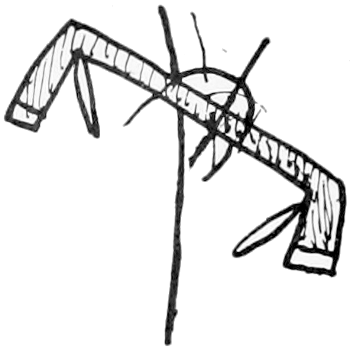
Fig. 708.—Medicine bag hung up.
Fig. 708, drawn by the same hand, shows the same medicine bag temporarily hung on a forked stick. When the bag is carried on a war party it is never allowed to touch the ground. Also among the Ojibwa some of the bags which are considered to have the greatest fetichistic power are not kept in the lodges, as too dangerous, but are suspended from trees.
Capt. Bourke (d) gives the following account of the medicine hat of the Apache:
The medicine hat of the old and blind Apache medicine man, Nan-ta-do-tash, was an antique affair of buckskin, much begrimed with soot and soiled by long use. Nevertheless it gave life and strength to him who wore it, enabled the owner to peer into the future, to tell who had stolen ponies from other people, to foresee the approach of an enemy, and to aid in the cure of the sick. * * * This same old man gave me an explanation of all the symbolism depicted upon the hat, and a great deal of valuable information in regard to the profession of medicine men, their specialization, the prayers they recited, etc. The material of the hat, as already stated, was buckskin. How that was obtained I can not assert positively, but from an incident occurring under my personal observation in the Sierra Madre, in Mexico, in 1883, where our Indian scouts and the medicine men with them surrounded a nearly grown fawn and tried to capture it alive, as well as from other circumstances too long to be here inserted, I am of the opinion that the buckskin to be used for sacred purposes among the Apache must, whenever possible, be that of a strangled animal, as is the case, according to Dr. Matthews, among the Navajo.
The body of Nan-ta-do-tash’s cap was unpainted, but the figures upon it were in two colors, a brownish yellow and an earthy blue, resembling a dirty Prussian blue. The ornamentation was of the downy feathers and black-tipped plumes of the eagle, pieces of abalone shell and chalchihuitl, and a snake’s rattle on the apex.
Nan-ta-do-tash explained that the characters on the medicine hat meant: A, clouds; B, rainbow; C, hail; E, morning star; F, the god of wind, with his lungs; G, the black “kan;” H, the great stars or suns. “Kan” is the name given to their principal gods. The appearance of the kan himself and of the tail of the hat suggest the centipede, an important animal god of the Apache. The old man said that the figures represented the powers to which he appealed for aid in his “medicine” and the kan upon whom he called for help.
The same author says, op. cit., p. 587:
The Apache, both men and women, wear amulets, called tzidaltai, made of lightning-riven wood, generally pine or cedar or fir from the mountain tops, which are highly valued and are not to be sold. These are shaved very thin and rudely cut in the semblance of the human form. They are in fact the duplicates, on a small scale, of the rhombus. Like it they are decorated with incised lines representing the lightning. Very often these are to be found attached to the necks of children or to their cradles.
Four of the several winter counts described in the present work unite in specifying for the year 1843-’44 the recapture of a fetich called the great medicine arrow.

Fig. 709.—Magic arrow.
Fig. 709.—In a great fight with the Pawnees the Dakotas captured the great medicine arrow which had been taken from the Cheyennes, who made it, by the Pawnees. Cloud-Shield’s Winter Count, 1843-’44.
The head of the arrow projects from the bag which contains it. The delicate waved or spiral lines show that it is sacred.
White-Cow-Killer calls it “The Great-medicine-arrow-comes-in winter.”
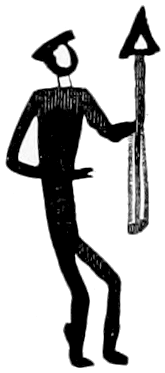
Fig. 710.—Magic arrow.
Battiste Good’s record gives the following for the same year:
“Brought-home-the-magic-arrow winter. This arrow originally belonged to the Cheyennes, from whom the Pawnees stole it. The Dakotas captured it this winter from the Pawnees, and the Cheyennes then redeemed it for one hundred horses.” His sign for the year is shown in Fig. 710. An attempt was made to distinguish colors by the heraldic scheme, which in this cut did not succeed. The upper part of the man’s body is sable or black, the feathers on the arrow are azure or blue, and the shaft, gules or red. The remainder of the figure is of an undecided color not requiring specification.

Fig. 711.—Magic arrow.
Fig. 711.—The great medicine arrow was taken from the Pawnees by the Oglalas and Brulés, and returned to the Cheyennes to whom it rightly belonged. American-Horse’s Winter Count, 1843-’44. The arrow appears to be in a case marked over with the lines meaning sacredness.
Another account of a magic arrow and illustrations of other fetichistic objects are in Chap. IX.
Pl. XXXIII is a copy of a cloak or mantle made from the skin of a deer, and covered with various mystic paintings. It was made and used by the Apaches as a mantle of invisibility, that is, a charmed covering for spies which would enable them to pass with impunity through the country, and even through the camp of their enemies. In this instance the fetichistic power depends upon the devices drawn. A similar but not identical pictographic fetich or charm is described and illustrated by Capt. Bourke (e) as obtained from a Chicarahua Apache which told when his ponies were lost, and which brought rain. The symbols show, inter alia, the rain cloud, and the serpent lightning, the raindrops and the cross of the winds of the four cardinal points.
Lewis and Clarke (b) say that the Chilluckittequaw, a Chinook tribe, had a “medicine” bag colored red 2 feet long, suspended in the middle of the lodge. It was held sacred, containing pounded dirt, roots, and such mysterious objects. From the chief’s bag he brought out fourteen forefingers of enemies—Snakes—whom he had killed.
A remarkable drawing in an Australian cave, described by Sir George Grey, in Worsnop, op. cit., was an ellipse, 3 feet in length and 1 foot 10 inches in breadth. The outside line of the painting was of deep blue color, the body of the ellipse being of a bright yellow dotted over with red lines and spots, whilst across it ran two transverse lines of blue. The portion of the painting above described formed the ground, or main part of the picture, and upon this ground was painted a kangaroo in the act of feeding; two stone spear heads, and two black balls; one of the spear heads was flying to the kangaroo, and one away from it; so that the whole subject probably constituted a sort of charm by which the luck of an inquirer in killing game can be ascertained. This cave drawing is copied in Fig. 712.
George Turner (c) gives account of hieroglyphic taboos, as he calls them, which are connected with the present subject:
The sea-pike taboo. If a man wished that a sea-pike might run into the body of the person who attempted to steal, say, his bread fruits, he would plait some cocoanut leaflets in the form of a sea-pike, and suspend it from one or more of the trees which he wished to protect.
The white-shark taboo was another object of terror to a thief. This was done by plaiting a cocoanut leaf in the form of a shark, adding fins, etc., and this they suspended from the tree. It was tantamount to an expressed imprecation, that the thief might be devoured by the white shark the next time he went to fish.
The cross-stick taboo. This was a piece of any sort of stick suspended horizontally[505] from the tree. It expressed the wish of the owner of the tree, that any thief touching it might have a disease running right across his body, and remaining fixed there till he died.
The ulcer taboo. This was made by burying in the ground some pieces of clam shell, and erecting at the spot three or four reeds, tied together at the top in a bunch like the head of a man. This was to express the wish and prayer of the owner that any thief might be laid down with ulcerous sores all over his body.
The death taboo. This was made by pouring some oil into a small calabash, and burying it near the tree. The spot was marked by a little hillock of white sand.
The thunder taboo. If a man wished that lightning might strike any who should steal from his land, he would plait some cocoanut leaflets in the form of a small square mat, and suspend it from a tree, with the addition of some white streamers of native cloth flying. A thief believed that if he trespassed, he, or some of his children, would be struck with lightning, or perhaps his own trees struck and blasted from the same cause. They were not, however, in the habit of talking about the effects of lightning. It was the thunder they thought did the mischief; hence they called that to which I have just referred the thunder taboo.
Many examples of masks, dance ornaments, and fetiches used in ceremonies are reported and illustrated in the several papers of Messrs. Cushing, Holmes, and Stevenson in the Second Annual Report of the Bureau of Ethnology. Paintings or drawings of many of them have been found on pottery, on shells, and on rocks.
An admirable article by Mr. J. Walter Fewkes (b) on Tusayan Pictographs explains many of the petroglyphs of that region as depicting objects used in dances and ceremonies.
Fig. 713 exhibits drawings of various masks used in dancing, the characters of which were obtained by Mr. G. K. Gilbert from rocks at Oakley springs and were explained to him by Tubi, the chief of the Oraibi Pueblos. They are representations of masks as used by the Moki, Zuñi, and Rio Grande Pueblos.
Dr. W. H. Corbusier, U. S. Army, writing from Camp Verde, Arizona, kindly furnished the following account of Yuman ceremonies, in which the making of sand pictures was prominent:
All the medicine men meet occasionally and with considerable ceremony “make medicine.” They went through the performance early in the summer of 1874 on the reservation for the purpose of averting the diseases with which the Indians were afflicted the summer previous. In the middle of one of the villages they made a round ramada, or house of boughs, some 10 feet in diameter, and under it, on the sand, illustrated the spirit land in a picture about 7 feet across, made in colors by sprinkling powdered leaves and grass, red clay, charcoal, and ashes on the smoothed sand. In the center was a round spot of red clay about 10 inches in diameter, and around it several successive rings of green and red alternately, each ring being an inch and a half wide. Projecting from the outer ring were four somewhat triangular-shaped figures, each one of which corresponded to one of the cardinal points of the compass, giving the whole the appearance of a Maltese cross. Around this cross and between its arms were the figures of men with their feet toward the center, some made of charcoal, with ashes for eyes and hair, others of red clay and ashes, etc.[506] These figures were 8 or 9 inches long, and nearly all of them lacked some portion of the body, some an arm, others a leg or the head. The medicine men seated themselves around the picture on the ground in a circle, and the Indians from the different bands crowded around them, the old men squatting close by and the young men standing back of them. After they had invoked the aid of the spirits in a number of chants, one of their number, apparently the oldest, a toothless, gray-haired man, solemnly arose and, carefully stepping between the figures of the men, dropped on each one a pinch of the yellow powder which he took from a small buckskin bag which had been handed to him. He put the powder on the heads of some, on the chests of others, and on other parts of the body, one of the other men sometimes telling him where to put it. After going all around, skipping three figures, however, he put up the bag, and then went around again and took from each figure a large pinch of powder, taking up the yellow powder also, and in this way collected a heaping handful. After doing this he stepped back and another medicine man collected a[507] handful in the same way, others following him. Some of the laymen, in their eagerness to get some, pressed forward, but were ordered back. But after the medicine men had supplied themselves the ramada was torn down and a rush was made by men and boys; handfuls of the dirt were grabbed and rubbed on their bodies or carried away. The women and children, who were waiting for an invitation, were then called. They rushed to the spot in a crowd, and grabbing handfuls of dirt tossed it up in the air so that it would fall on them, or they rubbed their bodies with it, mothers throwing it over their children and rubbing it on their heads. This ended the performance.
According to Stephen Powers (in Contrib. to N. A. Ethnol., III, p. 140), there is at the head of Potter valley, California, “a singular knoll of red earth which the Tatu or Hūchnom believe to have furnished the material for the erection of the original coyote-man. They mix this red earth into their acorn bread, and employ it for painting their bodies on divers mystic occasions.”
Descriptions of ceremonies in medicine lodges and in the initiation of candidates to secret associations have been published with and without illustrations. The most striking of these are graphic ceremonial charts made by the Indians themselves, a number of which besides those immediately following appear in different parts of the present work.
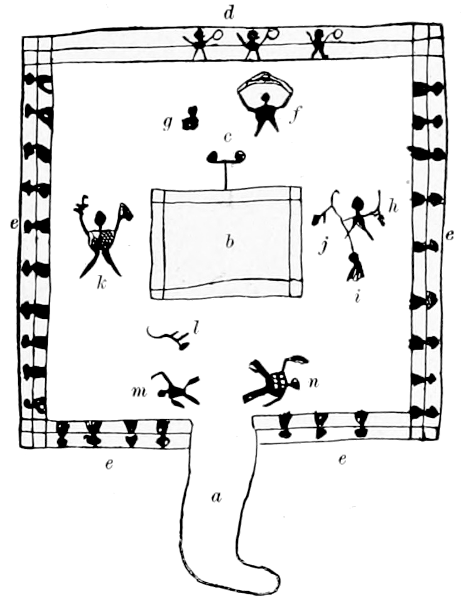
Fig. 714.—Shaman’s lodge. Alaska.
Fig. 714 was drawn and interpreted by Naumoff, a Kadiak native, in San Francisco, California, in 1882. It represents the ground plan of a shaman’s lodge, with the shaman curing a sick man.
The following is the explanation:
a, the entrance to the lodge; b, the fireplace; c, a vertical piece of wood upon which is placed a crosspiece, upon each end of which is a lamp; d, the musicians upon the raised seats drumming and producing[508] music to the movements of the shaman during his incantations in exorcising the “evil spirit” supposed to have possession of the patient; e, visitors and friends of the afflicted seated around the walls of the lodge; f, the shaman represented in making his incantations; g, the patient seated upon the floor of the lodge; h represents the shaman in another stage of the ceremonies, driving out of the patient the “evil being”; i, another figure of the patient—from his head is seen to issue a line connecting it with j; j, the “evil spirit” causing the sickness; k, the shaman in the act of driving the “evil being” out of the lodge—in his hands are sacred objects, his personal fetich, in which the power lies; l, the flying “evil one”; m, n, are assistants to the shaman stationed at the entrance to hit and hasten the departure of the evil being.
The writer in examination at three reservations in Wisconsin obtained information concerning the Midē' ceremonies additional to the details described by Dr. Hoffman (a) and by others quoted in the present work. The full ceremonies of the Midē' lodges, which the more southern Ojibwa, who speak English, translate as “grand medicine,” were performed twice a year—in the fall and in the spring. Those in the spring were of a rejoicing character, to welcome the return of the good spirits; those in the fall were in lamentation for the departure of the beneficent and the arrival of the maleficent spirits. The drums were beaten four days and nights before the dance, which lasted for a whole day. After the dance twelve selected persons built a lodge, about the center of which they placed stones which had been heated, and dancing went on around it until the stones were moistened and cooled by the sweat of the performers. Singing, or more properly chanting, regulated the rhythm of the dances, although, perhaps, in the order of evolution the dance was prior to the chant. These ceremonies were performed by the body of the people, and were independent of the initiations in the secret order. With regard to the candidates who passed the initiations, it was mentioned as an undisputed fact that they always became stronger and better men, perhaps because only those succeeded who had the requisite strength of mind and body to endure the various ordeals and to pass examination in the mysteries. In pictography the spring and the fall, the drums and the steaming stones, the dancing forms and the open chanting mouth are shown.
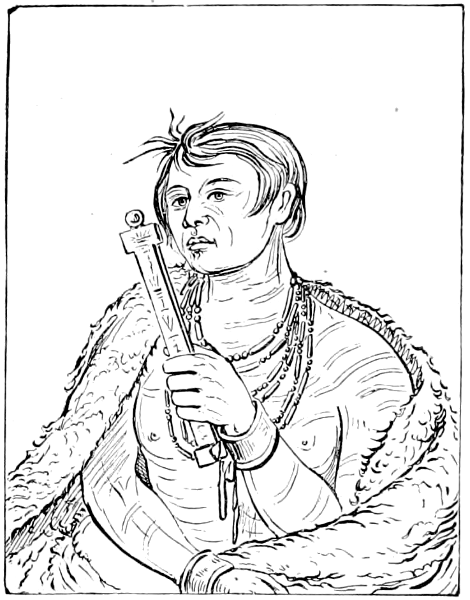
Fig. 715.—Ah-tón-we-tuck.
Catlin (a) gives an account of Kee-an-ne-kuk, the foremost man, who, though a Kickapoo, was commonly called the Shawnee Prophet, and also the following description relating to Fig. 715, painted by that author in 1831:
Ah-tón-we-tuck, The-Cock-Turkey, is another Kickapoo of some distinction and a disciple of the [Shawnee] Prophet, in the attitude of prayer, which he is reading off from characters cut upon a stick that he holds in his hand. It was told to me in the tribe by the traders (though I am afraid to vouch for the whole truth of it) that while a Methodist preacher was soliciting him for permission to preach in his village, the Prophet refused him the privilege, but secretly took him aside and supported[509] him until he learned from him his creed and his system of teaching it to others, when he discharged him and commenced preaching amongst his people himself, pretending to have had an interview with some superhuman mission or inspired personage, ingeniously resolving that if there was any honor or emolument or influence to be gained by the promulgation of it, he might as well have it as another person; and with this view he commenced preaching and instituted a prayer, which he ingeniously carved on a maple stick of an inch and a half in breadth, in characters somewhat resembling Chinese letters. These sticks, with the prayers on them, he has introduced into every family of the tribe and into the hands of every individual; and as he has necessarily the manufacturing of them all, he sells them at his own price and has thus added lucre to fame, and in two essential and effective ways augmented his influence in his tribe. Every man, woman, and child in the tribe, so far as I saw them, were in the habit of saying their prayer from this stick when going to bed at night and also when rising in the morning, which was invariably done by placing the forefinger of the right hand under the upper character until they repeat a sentence or two, which it suggests to them, and then slipping it under the next and the next, and so on to the bottom of the stick, which altogether required about ten minutes, as it was sung over in a sort of a chant to the end.
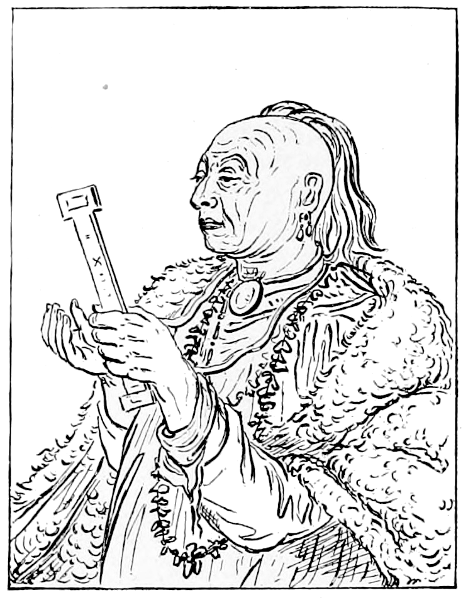
Fig. 716.—On-sáw-kie.
Fig. 716, from the same volume, opposite page 100, is a portrait of On-sáw-kie, The-Sac, a Pottawatomie, using one of these prayer sticks, which had been procured from the Shawnee Prophet.
Figs. 715 and 716 with their descriptions exhibit an intermediate condition between the aboriginal mnemonic method and the Christian formula of prayer by the use of printed books. They should be considered in comparison with the remarks on the “Micmac Hieroglyphs,” Chap. XIX, Sec. 2.
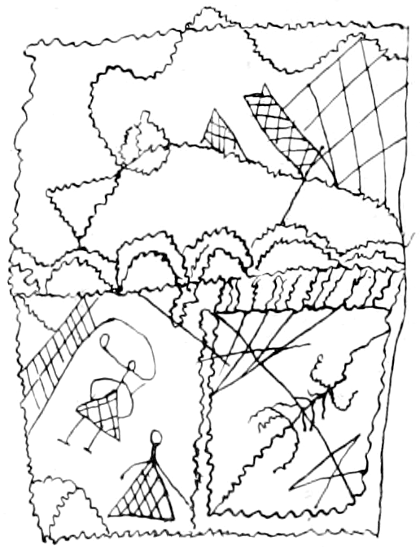
Fig. 717.—Medicine lodge. Micmac.
Fig. 717, incised on the Kejimkoojik rocks in Nova Scotia, suggests the midē' lodge, sometimes called the medicine lodge, of the Ojibwa,[510] which is described above. The ground plan indicated in this figure seems to be divided by partitions, which, together with the human figures and designs, probably refer to the rites of initiation and celebration performed in them. Some of the Micmacs examined had a vague recollection of these ceremonies, which, at the time of the European discovery of the northeastern part of North America, probably were as widely prevalent, as they continued to be much later, among the regions farther in the interior, also occupied by the Algonquian tribes.
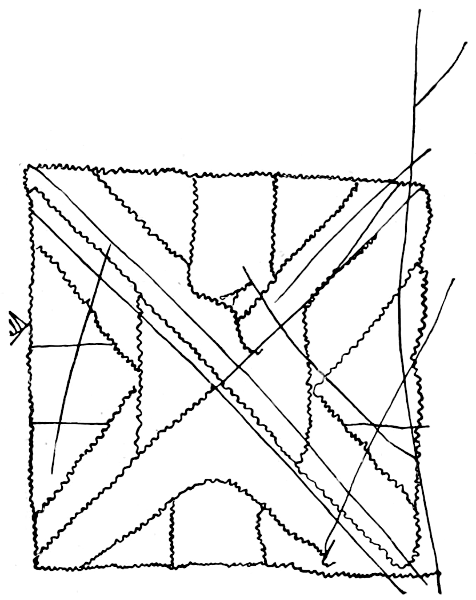
Fig. 718.—Juggler lodge. Micmac.
Fig. 718, from the same locality, is a drawing of the ground plan of another description of ceremonial wigwam or lodge which is remarkably similar to that now called by the Ojibwa “the jessăkân.” Its distinguishing feature is the branch of a tree erected on the outside, and it is the wigwam of a juggler or wizard, and not the lodge belonging to the regular order of the Midē'. Such wigwams of jugglers, who performed wonderful feats similar to those of modern spiritualistic exhibitions, are frequently mentioned by the early French and English writers, who gave accounts of the provinces of New France and New England. The figure now presented is not suggestive without comparison, and would not have been selected for the foregoing description[511] without the authority of living Micmac and Abnaki Indians, to whom it was significant.
Figs. 717 and 718, however, when studied, recall the use of branches and prayer plumes in the descriptions of the houses, and especially of the kivas of the Pueblos and the forms of their consecration mentioned in the study of the Pueblo Architecture, by Mr. Victor Mindeleff, in the Eighth Annual Report of the Bureau of Ethnology, as follows:
It is difficult to elicit intelligent explanation of the theory of the baho and the prayer ceremonies in either kiva or house construction. The baho is a prayer token; the petitioner is not satisfied by merely speaking or singing his prayer; he must have some tangible thing upon which to transmit it. He regards his prayer as a mysterious, impalpable portion of his own substance, and hence he seeks to embody it in some object which thus becomes consecrated. The baho, which is inserted in the roof of the kiva, is a piece of willow twig about 6 inches long, stripped of its bark and painted. From it hang four small feathers suspended by short cotton strings tied at equal distances along the twig. In order to obtain recognition from the powers especially addressed, different colored feathers and distinct methods of attaching them to bits of wood and string are resorted to.

Fig. 719.—Moki ceremonial.
The characters in Fig. 719 are copied from a drawing on the rocks[512] in the Canyon Segy. They have been submitted to the most intelligent of the old Moki priests, and are said to represent the primitive sun priests. They watched for the sunrise every morning and the chief sun priest kept a reckoning of the equinoxes. The chief sun priest, a, made the daily sacrifices to the sun by scattering consecrated meal and singing a prayer to the sun just as it rose. His assistant, b, lit a pipe of tobacco at the same time, and exhaled puffs of smoke, one toward each of the cardinal points, one to the zenith, and one to the nadir. The three other figures are flageolet priests, and the skins of different kinds of foxes were attached to their reed flageolets. c played to the morning star, typified by the skin of the gray fox. d played to the dawn, typified by the skin of the red fox. e played to the daylight, typified by the skin of the yellow fox.
Dr. Franz Boas (e) reported as follows:
The Tsimshian have four secret societies, which have evidently been borrowed from the Kwākiutl, the Olala or Wihalait, Nō'ntlem, Mē'itla, and Semhalait.
The candidate is taken to the house of his parents and a bunch of cedar bark is fastened over the door, to show that the place is tabooed, and nobody is allowed to enter. The chief sings while it is being fastened. In the afternoon the sacred house is prepared for the dance. A section in the rear of the house is divided off by means of curtains; it is to serve as a stage, on which the dancers and the novice appear. When all is ready messengers carrying large carved batons are sent around to invite the members of the society, the chief first. The women sit down in one row, nicely dressed up in button blankets and their faces painted red. The chief wears the amhalait, a carving rising from the forehead, set with sea-lion barbs and with a long drapery of ermine skins; the others, the cedar bark rings of the society. * * *
The Mēitla have a red head ring and red eagle downs, the Nōntlem a neck ring plaited of white and red cedar bark, the Olala a similar but far larger one. The members of the societies receive a head ring for each time they pass through these ceremonies. These are fastened one on top of the other.
Mr. James W. Lynd (d) says:
In the worship of their deities paint (with the Dakotas), forms an important feature. Scarlet or red is the religious color for sacrifices, whilst blue is used by the women in many of the ceremonies in which they participate. This, however, is not a constant distinction of sex, for the women frequently use red and scarlet. The use of paints, the Dakotas aver, was taught them by the gods. Unktehi taught the first medicine men how to paint themselves when they worshiped him and what colors to use. Takushkanshkan (the moving god), whispers to his favorites what colors are most acceptable to him. Heyoka hovers over them in dreams, and informs them how many streaks to employ upon their bodies and the tinge they must have. No ceremony of worship is complete without the wakan or sacred application of paint. The down of the female swan is colored scarlet and forms a necessary part of sacrifices.
Wiener (d) gives a description of Peruvian ceremonies, with an illustration reproduced here as Fig. 720.
The paintings on this vase, found by Dr. Macedo in the excavations at Pachacamac, show the principal practices of the exoteric worship of the sun. In this painting there are three entirely distinct groups. The central one is composed of the solar image surrounded by nine rays, terminating in symbols of fecundity. Two men placed at its right and left seem to play on pandean pipes. The group on the left is formed of four individuals, two of whom have head-dresses of royal feathers. This group is performing[513] a dance, while the third group represents the same solar disk and the sacrifice accompanied by music performed in its honor. There are also vases of different forms containing, probably, the sacred drink, and the officiator approaching one hand to one of the great urns, while with the other he holds the vase or the bowl from which he is about to drink the chica consecrated to the sun. The princely personages who have the right to approach the sun wear casques with royal plumes, chemisettes extending below the middle, and ornaments at the lower part of the legs and on the feet. The musicians, four in number (two of whom play upon the pandean pipes and two upon the henna), are distinguished by bonnets without feathers and by a kind of cloak tied around the neck by a band which floats behind them. Finally, the priests, one of whom is an officiator, and the other dancers in the suite of the princely personages, wear bonnets like that of the musicians (who very probably belong to the same class). They have their faces painted.
A. W. Howitt, in MS. Notes on Australian Pictographs, contributes the following:
Among the most interesting of the pictorial markings used by the aborigines are those which are made in connection with the ceremonies of initiation. I now take as an instance the Murring tribe of the southern coast of New South Wales, whose ceremonies I have described elsewhere. The humming instrument, which is known in England as a child’s toy called the bull roarer, has a sacred character with all the Australian tribes. The Murring call it Mŭdji, and the loud roaring sound made when it is swung around at the end of a cord is considered to be the voice of Daramūlŭn, the great supernatural being by whom, according to their tradition, these ceremonies were first instituted.
On this instrument there are marked two notches, one at each end, representing the gap left in the upper jaw of the novice after his teeth have been knocked out during the rites; there is also figured on it the rude representations of Daramūlŭn.
A similar rude outline of a man in the attitude of the magic dance, being also Daramūlŭn, is cut by the old men (wizards) at the ceremonies, upon the bark of a tree at the spot where one of them knocks out the tooth of the novice. This pictograph is then carefully cut out and obliterated after the ceremonies are over.
At a subsequent stage of the proceedings a similar figure is molded on the ground in clay, and is surrounded by the native weapons which Daramūlŭn is said to have invented. This figure, after having been exhibited to the novice, is also destroyed, and they are strictly forbidden under pain of death to make them known in any manner to “women or children;” that is to say, to the uninitiated.
The Mŭdji is not destroyed, but is carefully and secretly preserved by the principal headman who had caused the ceremonies to be held.
The ceremonies of the Wirajuri tribe in New South Wales are substantially the same as those of the Murring, although the tribes are several hundred miles apart. The details, however, differ in some respects.
For instance, at one part of the ceremonies certain carvings are made upon the tree adjoining the place of the ceremonies and upon the ground, as follows:
(1) A piece of bark is stripped off the tree from the branches spirally down the bole to the ground. This represents the path along which Daramūlŭn is supposed to descend from the sky to the place where the initiation is held.
(2) The figure of Daramūlŭn is cut upon the ground, resembling that which the Murring cut upon the tree at the place where in their ceremonies the tooth is knocked out. The figure represents a naked black fellow dancing, his arms being slightly extended and the legs somewhat bent outwards (sideways) at the knee, as in the well known “corroboree” attitude.
(3) The representation of his tomahawk cut on the ground, where he let it fall on reaching the earth.
(4) The footsteps of an emu of which Daramūlŭn was in chase.
(5) The figure of the emu extended on the ground where it fell when struck down by Daramūlŭn.
The same author (f) remarks as follows:
Speaking generally, it may be asserted with safety that initiation ceremonies of some kind or other, and all having a certain fundamental identity, are practiced by the aboriginal tribes over the whole of the Australian continent. * * *
Here, then, the novices for the first time witness the actual exhibition of those magical powers of the old men of which they have heard since their earliest years. They have been told how these men can produce from within themselves certain deadly things which they are then able to project invisibly into those whom they desire to injure or to kill; and now the boys see during the impressive magical dances these very things, as they express it, “pulled out of themselves” by the wizards.
Figs. 721, 722, and 723 are copies of the designs upon Tartar and Mongol drums, taken from G. N. Potanin (b). They are used in religious ceremonies with the belief that the sounds emanating from the surface upon which the designs are made, or, to carry the concept a little further, the sounds coming from the designs themselves, produce special influences or powers. Some of these designs are notably similar to some of those found in America and reproduced in the present paper.
The upper left-hand design (a) in Fig. 721, on the outside of the drum, represents the sun and the moon in the form of circles with a central dot. Below the crossbar were two other such figures with central dot. Besides, were represented below, on the left side, two shamans, and under them a wild goat and serpent in the form of wavy lines; on the right side three shamans and a deer.
The upper right-hand design (b) on the same figure is a group representing the bringing of a horse to sacrifice. Under a rainbow, dots represent stars, and two heavenly maidens who the shamans said were the daughters of Ulgen and who were playing. They come down to the mountains and rise up to the skies.
A bow with a knob at each end is made to represent a rainbow in the lower part of a shaman’s drum.
The lower left-hand design (c) on the same figure on a drum of the telengit shaman is the external delineation of a head without eyes and nose. The lower end of the line coming from the head represents a bifurcation. Under the head is a short horizontal line like an extended arm. Above a line extending from side to side of the drum are two circles, and below six circles, all empty. According to the owner of the drum[515] these circles are representations of drums, and the three human figures are masters or spirits of localities.
The lower right-hand design (d) in the same figure has in the upper section five zigzag lines represented similar to those with which lightning is often represented. According to the shaman these are serpents.
The upper left-hand design (a) in Fig. 722 inside the drum has painted two trees. On each of them sits the bird karagush, with bill turned to the left. On the left of the trees are two circles, one dark (the moon), the other light (the sun). Below a horizontal line are depicted a frog, a lizard, and a serpent.
The upper right-hand design (b) in the same figure has on the upper half two circles, the sun and moon; on the left side four horsemen; under them a bowman, also on horseback. The center is occupied by a picture of a net and a sieve for winnowing the nuts and seeds of the cedar tree. On the right side are two trees, baigazuin (literally the rich birch), over which two birds, the karagush, are floating. Under a[516] division on the right and on the left side are oval objects with latticed-figured or scaly skin. These are two whales. In the middle, between them, are a frog and a deer, and below a serpent. Above, toward the hoop of the drum, is fastened an owl’s feather.
The lower left hand design (c) in the same figure has represented in the upper half seven figures reminding one of horses. These are the horses, bura, going to heaven, i. e., their sacrifice. Above them are two circles emitting light, the sun and the moon; on the right of the horses are three trees; under a horizontal line on the left is a serpent; on the right a fish, the kerbuleik, the whale according to Verbitski, literally the bay-fish.
The lower right-hand design (d) in the same figure has a drawing on the outside, a circle divided by horizontal bars into halves. The field of the upper half is divided into three strata, the first stratum of which is heaven, the second the rainbow, and in the lower stratum the stars. On the left side the sun, and the crescent moon on the right side; the goat, trees, and an undefined figure, which is not given in the drawing,[517] underneath. The kam, a kind of shaman, called it the bura. Some said that it meant a cloud; others that it meant heavenly horses.
The left-hand design (a) in Fig. 723 shows four vertical and four horizontal lines. The latter represent the rainbow; the vertical lines borsui. Circles with dots in the center are represented in three sections, and in the fourth one circle.
The right-hand design in the same figure: On the upper sections are represented a number of human figures. These, according to the shaman’s own explanation, are heavenly maidens (in the original Turkish, tengriduing kuiz). Below, under a rainbow, which is represented by three arched lines, are portrayed two serpents, each having a cross inside. These are kurmos nuing tyungurey, i. e., the drums are kurmos’s. Kurmos is the Alti word for spirits, which the shamans summon.
Bastian (a) makes remarks as follows concerning the magic drum of the Shamans in the Altai, which should be considered in this connection:
The Shamans admit three worlds (among the Yakuts), the world of the heavens (hallan jurda), the middle one of the earth (outo-doidu) and the lower world or hell (jedän tügara), the former the realm of light, the latter the realm of darkness, while the earth has for a time been given over by the Creator (Jüt-tas-olbohtah Jürdän-Ai-Tojan) to the will of the devil or tempter, and the souls of men at their death, according to the measure of their merit, are sent into one or the other realm. When, however, the earth world has come to an end, the souls of the two realms will wage a war against each other, and victory must remain on the side of the good souls.
Champlain (f) in his voyage of 1603, says of the Northeastern Algonquins that their graves were covered with large pieces of wood, and one post was erected upon them, the upper part of which was painted red.
The same author, in 1613, writing of the Algonquins of the Ottawa[518] river, at the Isle des Alumettes, gives more details of the pictures on their grave posts:
On it the likeness of the man or woman who is buried there is roughly engraved. If a man, they put on a buckler, a spear, war club, and bows and arrows. If he is a chief he will have a plume on his head and some other designs or ornaments. If a boy, they give him one bow and a single arrow. If a woman or girl, they put on a kettle, an earthen pot, a wooden spoon, and a paddle. The wooden tomb is 6 or 7 feet long and 4 wide, painted yellow and red.
Some northern tribes—probably Cree—according to the Jesuit Relations (a), gave a notice of death to absent relations or dear friends of the deceased by hanging the object signifying his name on the path by which the traveler must return, e. g., if the name of the deceased was Piré (Partridge) the skin of a partridge was suspended. The main object of the notice was that the traveler, thereby knowing of the death, should not on his return to the lodge or village ask after or mention the deceased. Perhaps this explains the custom of placing pictographs of personal names and totemic marks on some prominent point or on trails without any apparent incident.
The same Relation describes a custom of the same Indians of shaping out of wood a portraiture of the more distinguished dead and inserting it over their graves, afterwards painting and greasing it as if it were the live man.
In Keating’s Long (g) it is told that the Sac Indians are particular in their demonstrations of grief for departed friends. These consist in darkening their faces with charcoal, fasting, abstaining from the use of vermillion and other ornaments in dress, etc. They also make incisions in their arms, legs, and other parts of the body; these are not made for the purposes of mortification, or to create a pain which shall by dividing their attention efface the recollection of their loss, but entirely from a belief that their grief is internal and that the only way of dispelling it is to give it a vent through which to escape.
This is an explanation of the practice which has been verified in the field work of the Bureau of Ethnology and corresponds with the concept of finding relief from disease and pain by similar incisions, to let out the supposed invading entity that causes distress.
The same authority, p. 332, gives the following account of Dakota burial scaffolds:
On these scaffolds, which are from 8 to 10 feet high, corpses were deposited in a box made from part of a broken canoe. Some hair was suspended which we at first mistook for a scalp; but our guide informed us that these were locks of hair torn from their heads by the relations to testify their grief. In the center, between the four posts which supported the scaffold, a stake was planted in the ground; it was about 6 feet high, and bore an imitation of human figures; five of which had a design of a petticoat, indicating them to be females; the rest, amounting to seven, were naked, and were intended for male figures. Of the latter, four were headless, showing that they had been slain; the three other male figures were unmutilated but held a staff in their hands which, as our guide informed us, designated that they were slaves. The post, which is an usual accompaniment to the scaffold that supports a[519] warrior’s remains, does not represent the achievements of the deceased, but those of the warriors that assembled near his remains, danced the dance of the post, and related their martial exploits.
Maximilian, Prince of Wied (d), tells that as a sign of mourning the Sioux daub themselves with white clay.
According to Powers, (d) “A Yokaia widow’s style of mourning is peculiar. In addition to the usual evidence of grief she mingles the ashes of the dead husband with pitch, making a white tar or ungent with which she smears a band about two inches wide all around the edge of her hair (which is previously cut off close to the head), so that at a little distance she appears to be wearing a white chaplet.”
Mr. Dorsey reports that mud is used by a mourner in the sacred-bag war party among the Osages. Several modes of showing mourning by styles of paint and markings are presented in this paper under the headings of Color and of Tattooing. Other practices connected with the present topic, and which may explain some pictographs, are described in the work of Dr. H. C. Yarrow, acting assistant surgeon, U. S. Army, on The Mortuary Customs of the North American Indians, in the First Annual Report of the Bureau of Ethnology.
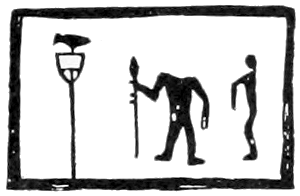
Fig. 724.—Votive offering. Alaska.
Fig. 724 is copied from a piece of ivory in the museum of the Alaska Commercial Company, San Francisco, California, and was interpreted by an Alaskan native in San Francisco in 1882.
First is a votive offering or “shaman stick,” erected to the memory of one departed. The “bird” carvings are considered typical of “good spirits,” and the above was erected by the remorse-stricken individual, who had killed the person shown.
The headless body represents the man who was killed. In this respect the Ojibwa manner of drawing a person “killed” is similar.
The right hand Indian represents the homicide who erected the “grave-post” or “sacred stick.” The arm is thrown earthward, resembling the Blackfeet and Dakota gesture for “kill.”
That portion of the Kauvuya tribe of Indians in Southern California known as the Playsanos, or lowlanders, formerly inscribed characters upon the gravestones of their dead, relating to the pursuits or good qualities of the deceased. Dr. W. J. Hoffman obtained several pieces or slabs of finely-grained sandstone near Los Angeles, California, during the summer of 1884, which had been used for this purpose. Upon these were the drawings, in incised lines, of the fin back whale, with figures of men pursuing them with harpoons. Around the drawings were close parallel lines with cross lines similar to those made on ivory by the southern Innuit of Alaska.
Figs. 725 to 727 were procured from a native Alaskan by Dr. Hoffman in 1882, and explained to him to be drawings made upon grave posts.

Fig. 725.—Grave post. Alaska.
Fig. 725 commemorates a hunter, as land animals are shown to be his chief pursuit. The following is the explanation of the characters:
a. The baidarka, or boat, holding two persons; the occupants are shown, as are also the paddles, which project below the horizontal body of the vessel.
b. A rack for drying skins and fish. A pole is added above it, from which are seen floating streamers of calico or cloth.
c. A fox.
d. A land otter.
e. The hunter’s summer habitation. These are temporary dwellings and usually constructed at a distance from home. This also indicates the profession of a skin-hunter, as the permanent lodges, indicated as winter houses, i. e., with round or dome-like roof, are located near the seashore, and summer houses are only needed when at some distance from home, where a considerable length of time is spent in hunting.

Fig. 726.—Grave post. Alaska.
The following is the explanation of Fig. 726. It is another design for a grave post, but is erected in memory of a fisherman:
a. The double-seated baidarka, or skin canoe.
b. The bow used in shooting seal and other marine animals.
c. A seal.
d. A whale.
The summer lodge is absent in this, as the fisherman did not leave the seashore in the pursuit of game on land.

Fig. 727.—Village and burial grounds. Alaska.
Fig. 727 is a drawing of a village and neighboring burial-ground, prepared by an Alaskan native in imitation of originals seen by him among the natives of the mainland of Alaska, especially the Aigalúqamut. Carvings are generally on walrus ivory; sometimes on wooden slats. In the figure, g is a representation of a grave post in position, bearing an inscription similar in general character to those in the last two preceding figures.
The details are explained as follows:
a, b, c, d. Various styles of habitations, denoting a settlement.
e. An elevated structure used for the storage of food.
f. A box with wrappings, containing the corpse of a child. The[521] small lines, with ball attached, are ornamental appendages consisting of strips of cloth or skin, with charms, or, sometimes, tassels.
g. Grave post, bearing rude illustrations of the weapons or implements used by the deceased during his life.
h. A grave scaffold, containing adult. Besides the ornamental appendages, as in f preceding, there is a “Shaman stick” erected over the box containing the corpse as a mark of good wishes of a sorrowing survivor. See object a, in Fig. 724.
Schoolcraft (m) gives a good account, with illustration, of the burial posts used by the Sioux and Chippewas. It has been quoted so frequently that it is not reproduced here. The most notable feature connected with the posts is that the totems depicted on them are reversed, to signify the death of the persons buried.
Fig. 728 represents the grave post of a Menomoni Indian of the bear totem. The stick is a piece of pine board 2½ inches wide at the top, gradually narrowing down to a point; three-fourths of an inch thick, and about 2 feet long. On one side are two sets of characters, the oldest being incised with a sharp-pointed nail, while over these are a later set of drawings made with red ocher, represented in the illustration by shading. The figure of the bear, drawn with head to the ground, denotes the totem of which the deceased was a member, the remaining incised figures relating to some exploits the signification of which was not known. The red marks were put upon the stick at the time of the holding of a memorial service, when the father of the deceased furnished a feast to the medicine priests just previous to his being received into the society of[522] shamans to fill the vacancy caused by the death. The number of red crosses denote the number of speeches made at the grave upon that occasion, while the band at the top refers to the person acting as master of ceremonies, who had been requested to make all the arrangements for the medicine ceremonies and initiation. So said some Menomoni in the neighborhood, but later the Indian who actually painted the red crosses came to Washington and explained that they signified the number of war parties in which the deceased had taken part.
Fig. 729 shows the incised lines on the front of the post before color was applied. The manner of placing the grave posts at the head of the grave box is shown in Fig. 730, the left-hand grave being that of Oshkosh, the late head chief of the Menomoni in Wisconsin, after whom the city of Oshkosh was named.
Before the grave is a small board, upon which tobacco is placed to gratify the taste of the dead, and during the season of sugar making pieces of that delicacy are pushed through the small openings in the head board, that the spirit of the deceased may be gratified and give success to the donors at future seasons.
The right-hand grave box is that of another member of the family of Oshkosh, at which the board, with tobacco, is also placed, as well as the grave post. This, however, does not bear any indications of characters, which probably had been washed off by the rain.
Pieces of bark, stones, and sticks are also placed upon the grave boxes, but the signification of this practice could not be ascertained.
The next two figures come from the Dakotas.
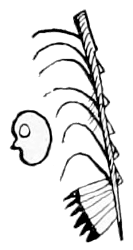
Fig. 731.—Commemoration of dead. Dakota.
Fig. 731.—Held a commemoration of the dead. Cloud-Shield’s Winter Count, 1826-’27. The ceremonial pipe-stem and the skull indicate the mortuary practice, which is further explained by the next figure.
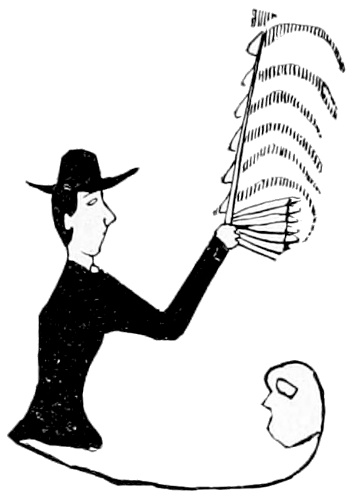
Fig. 732.—Ossuary ceremonial. Dakota.
Fig. 732.—A white man made medicine over the skull of Crazy-Horse’s brother. Cloud-Shield’s Winter Count, 1852-’53. He holds a pipe-stem in his hand. This figure refers to the custom of gathering periodically the bones of the dead that have been placed on scaffolds and burying them. It appears that a white man made himself conspicuous by conducting the ceremonies on the occasion noted.
Lewis and Clarke (c) mention the Chilluckittequaws, a division of the Chinooks of the Columbia river, as having for burial purposes vaults made of pine or cedar boards, closely connected, about 8 feet square and 6 in height. The walls as well as the door were decorated with strange figures cut and painted on them; besides these there were several wooden images of men, some of them so old and decayed[524] as to have almost lost their shape, which were all placed against the sides of the vaults. These images do not appear to be at all the objects of adoration, but were probably intended as resemblances of those whose decease they indicate.
Whymper (a) reports that the Kalosh Indians of Alaska construct grave boxes or tombs which contain only the ashes of the dead. These people invariably burn the deceased. On one of the boxes he saw a number of faces painted, long tresses of human hair depending therefrom. Each head represented a victim of the deceased man’s ferocity. Thus the pictures are not likenesses or totemic marks of the cremated Kalosh, but of enemies whom he had killed, being in the nature of trophies or proofs of valor. Fig. 733 is a reproduction of the illustration.
Dall (c) says of the Yukon Indians:
Some wore hoops of birch wood around the neck and wrists, with various patterns and figures cut on them. These were said to be emblems of mourning for the dead.
Dr. Franz Boas (f) gives the following account of the funeral customs practiced by the Snanaimuq, a Salish tribe:
The face of the deceased is painted with red and black paint. * * * A chief’s body is put in a carved box and the front posts supporting his coffin are carved. His mask is placed between these posts. The graves of great warriors are marked by a statue representing a warrior with a war club. * * * After the death of husband or wife, the survivor must paint his legs and his blanket red. * * * At the end of the mourning period the red blanket is given to an old man, who deposits it in the woods.
Didron (a) speaks of emblems on tombstones:
Even today, at Constantinople, in the cemetery of the Armenians, every tombstone is marked with the insignia of the profession followed by the defunct which the stone covers. For an Armenian tailor there is a pair of shears, thread, and needles; for a mason, hammer and trowel; for a shoemaker, a last, leather, and a leather cutter; for a grocer, a pair of scales; for a banker, pieces of money. It is the same with others. Among us [Frenchmen], in the middle ages, a compass, a rule, and square are engraved on the tomb of Hugues Libergier. In the cemetery of L’Est, at Paris, a palette indicates the grave of a painter, a chisel and hammer mark that of a sculptor. Animals are represented as talking and acting, masks grimace and smile, to announce in the same inclosure the tombs of La Fontaine and[525] of Molière. Among the Romans it was the same: a fisher had a boat on his tomb; a shepard, a sheep; a digger, a pickaxe; a navigator, an anchor or a trident; a vine-dresser, a cask; an architect, a capital or the instruments of his art.
Hewitt (g) says of the Dieri, a tribe of Central Australia:
A messenger who is sent to convey the intelligence of a death is smeared all over with white clay. On his approach to the camp the women all commence screaming and crying most passionately. After a time the particulars of the death are made known to the camp. The near relations and friends then only weep. Old men even cry bitterly, and their friends comfort them as if they were children. On the following day the near relations dress in mourning by smearing themselves over with white clay. Widows and widowers are prohibited by custom from uttering a word until the clay has worn off, however long it may remain on them. They do not, however, rub it off, as doing so would be considered a bad omen. It must absolutely wear off of itself. During this period they communicate by means of gesture language.
Dr. Ferdinand von Hochstetter (a) says:
The carved Maori figures which are met with on the road are the memorials of chiefs who, while journeying to the restorative baths of Rotorua, succumbed to their ills on the road. Some of the figures are decked out with pieces of clothing or kerchiefs; and the most remarkable feature in them is the close imitation of the tattooing of the deceased, by which the Maoris are able to recognize for whom the monument has been erected. Certain lines are peculiar to the tribe, others to the family, and again others to the individual. A close imitation of the tattooing of the face, therefore, is to the Maori the same as to us a photographic likeness; it does not require any description of name.
A representation of one of these carved posts is given in Fig. 734.
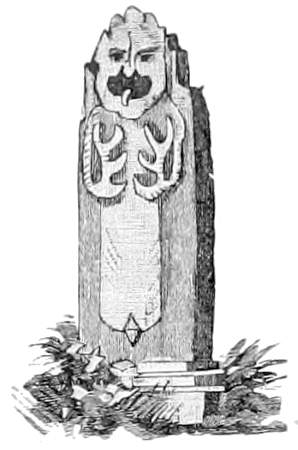
Fig. 735.—New Zealand grave-post.
Another carved post of like character is represented in Fig. 735, concerning which the same author says, p. 338: “Beside my tent, at Tahuahu, on the right bank of the Mangapu, there stood an odd, half-decomposed figure carved of wood; it was designated to me by the natives as a Tiki, marking the tomb of a chief.”
Ball, on Nicobarese Ideographs, in Jour. Anthrop. Inst. of Gr. Br. & I. (d), says, describing Fig. 736, which appears to be connected with mortuary observances:
The example of Nicobarese picture writing in Fig. 736 was obtained in the year 1873 on the island of Kondul, where I found it hanging in the house of a man who was said to have died a short time previously. * * *
The material of which it is made is either the glume of a bamboo or the spathe of a palm which has been flattened out and framed with split bamboos.
It is about 3 feet long by 18 inches broad. The objects are painted with vermilion, their outlines being surrounded with punctures, which allow the light to pass through. * * *
As in all such Nicobarese paintings, figures of the sun, moon, and stars occupy prominent positions. Now, the sun and moon are stated, by those who have known the Nicobarese best, to be especial objects of adoration, and therefore these paintings may have some religious significance.
At first it occurred to me that this was merely an inventory of the property of the deceased, but as some of the objects are certainly not such as we should expect to find in an enumeration of property, e. g., the lizard, while the figures of men appear to portray particular emotions, it seems probable that the objects represented have a more or less conventional meaning, and that we have here a document of as bona fide and translatable a character as an Egyptian hieroglyphic inscription.
My own efforts to discover an interpretation from the natives on the spot were not crowned with success. * * *
Mr. De Röepstorff, extra assistant superintendent of the Andamans and Nicobars, to whom I applied for such information as he might be able to collect upon the subject, assured me by letter, in 1873, that the screens had a religious significance and were used to exorcise spirits, but he did not seem to regard them as capable of being interpreted. * * *
The following is a list of the objects depicted, besides animals; many of the common utensils in use in a Nicobarese household are included:
(1) The sun and stars; (2) the moon and stars; (3) swallows or (?) flying fish; (4) impression of the forepart of a human foot; (5) a lizard (Hydrosaurus?); (6) four men in various attitudes; (7) two dás for cutting jungle; (8) two earthen cooking vessels; (9) two birds; (10) an ax; (11) two spears; (12) a ladder (?); (13) dish for food; (14) cocoanut water-vessels; (15) palm tree; (16) a canoe; (17) three pigs; (18) shed; (19) domestic fowl; (20) seaman’s chest; (21) dog; (22) fish of different kinds; (23) turtle.
The notes given under this heading are divided into (1) cult societies; (2) daily life and habits; (3) games.
Voluntary associations, to be distinguished from those of an exclusively religious character, have flourished among most Indian tribes and are still found among those least affected by contact with civilization. Maj. Powell, the Director of the Bureau of Ethnology, has named them cult societies. Their members are designated by special paintings and marks entirely distinct from those relating to their clans or gentes and their personal names. Travelers have frequently been confused by the diversity of such designations.
The translated names of some of these societies found among the Sioux are “Brave Night Hearts,” “Owl Feathers,” and “Wolves and Foxes.” They control tribes in internal affairs and strongly influence their policy in external relations, and may be regarded as the substitute both for regular soldiery and for police. It is necessary that a young man proposing to be a warrior should be initiated into some one of these societies. But in distinguishing them from the purely shamanistic orders it must not be understood that their ceremonies and ties are independent of the cult of religion, or that they disregard it, for this among Indians would be impossible.
The following account of these societies among the Blackfeet or Satsika and their pictorial or objective devices is condensed from Maximilian of Wied’s Travels (e):
The bands, unions, or associations are found among the Blackfeet as well as all the other American tribes. They have a certain name, fixed rules and laws, as well as their peculiar songs and dances, and serve in part to preserve order in the camp, on the march, in the hunting parties, etc. Seven such bands or unions among the Blackfeet were mentioned to me. They are the following: (1) The band of the mosquitos. This union has no police business to do, but consists of young people, many of whom are only 8 or 10 years of age. There are also some young men among them and sometimes even a couple of old men, in order to see to the observance of the laws and regulations. This union performs wild, youthful pranks; they run about the camp whenever they please; pinch, nip, and scratch men, women, and children in order to give annoyance like the mosquitos. The young people begin[529] with this union and then gradually rise higher through the others. As the badge of their band they wear an eagle’s claw fastened around the wrist with a leather strap. They have also a particular mode of painting themselves, like every other band, and their peculiar songs and dance. (2) The dogs. Its badge is not known to me; it consists of young married men, and the number is not limited. (3) The prairie dogs. This is a police union, which receives married men; its badge is a long hooked stick wound round with otter skin, with knots of white skin at intervals, and a couple of eagle’s feathers hanging from each of them. (4) Those who carry the raven. Its badge is a long staff covered with red cloth, to which black ravens’ feathers in a long thick row are fastened from one end to the other. They contribute to the preservation of order and the police. (5) The buffalo, with thin horns. When they dance they wear horns on their caps. If disorders take place they must help the soldiers, who mark out the camp and then take the first place. (6) The soldiers. They are the most distinguished warriors, who exercise the police, especially in the camp and on the march; in public deliberations they have the casting vote whether, for instance, they shall hunt, change their abode, make war or conclude peace, etc. They carry as their badge a wooden club the breadth of a hand, with hoofs of the buffalo cow hanging to the handle. They are sometimes 40 or 50 men in number. (7) The buffalo bulls. They form the first, that is, the most distinguished, of all the unions, and are the highest in rank. They carry in their hand a medicine badge, hung with buffalo hoofs, which they rattle when they dance to their peculiar song. They are too old to attend to the police, having passed through all the unions, and are considered as having retired from office. In their medicine dance they wear on their head a cap made of the long forelock and mane of the buffalo bull, which hangs down to a considerable length.
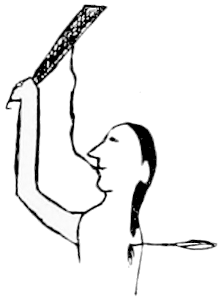
Fig. 737.—The policeman.
Fig. 737.—“The policeman” was killed by the enemy. Cloud-Shield’s Winter Count, 1780-’81.
The man here figured was probably one of the active members of the associations whose functions are above described to keep order and carry out the commands of the chiefs.
These voluntary associations are not of necessity ancient or permanent. An instance is given in Fig. 738 which is instructive in the interpretation of pictographs. It is a copy of drawings on a pipe stem which had been made and used by Ottawa Indians. On each side are four spaces, upon each of which are various incised characters, three spaces on one side being reserved for the delineation of human figures, each having diverging lines from the head upward, denoting their social status as chiefs or warriors and medicine men.
Upon the space nearest the mouth is the drawing of a fire, the flames passing upward from the horizontal surface beneath them. The cross bands are raised portions of the wood (ash) of which the pipestem is made; these show peculiarly shaped openings which pass entirely through the stem, though not interfering with the tube necessary for the passage of the smoke. This indicates considerable mechanical skill.
Upon each side of the stem are spaces corresponding in length and position to those upon the opposite side. In the lower space of the stem is a drawing of a bear, indicating that the two persons in the corresponding space on the opposite side belong to the bear gens. The next upper figure is that of a beaver, showing the three human figures to belong to the beaver gens, while the next to this, the eagle, means that the opposite persons are members of the eagle gens. The upper figure is that of a lodge which contains a council fire, shown on the opposite side.
The signification of the whole is that two members of the bear gens, three members of the beaver gens, and three members of the eagle gens have united and constitute a society living in one lodge, around one fire, and smoke through the same pipe.
Reference may also be made to remarks by Prof. Dall (d) upon the use of masks by associations or special classes.
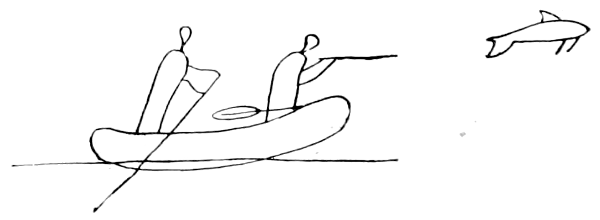
Fig. 739.—Shooting fish. Micmac.
Fig. 739, printed from the Kejimkoojik rocks, in Nova Scotia, represents two Indians in a canoe following a fish to shoot it. This is not a pure example of the class of totemic designs. Both Indians in the canoe have paddles in which the device resembles the Micmac tribal device, but in that the hunters pursue a deer and not a fish and the canoe is “humpback.” The Passamaquoddy tribal pictographic sign in which a fish is followed, requires both Indians to have paddles, and, it may be understood that the two Indians in the canoe are Passamaquoddy, but in the figure one of them has laid aside his paddle and is shooting at the fish with a gun, which departs from the totemic device, and also shows that the drawing was made since the Indians of the region had obtained[531] firearms from Europeans, but these were obtained three centuries ago, quite long enough for hunting scenes on some of the petroglyphs to exhibit the use of a gun instead of a bow.
This kind of fish hunting by gunshot is one of daily occurrence in the region during the proper season.
Fig. 740, from the same locality, is more ideographic. The line of the gun barrel is exaggerated and prolonged so as nearly to touch the fish, and signifies that the shot was a sure hit. The hunters are very roughly delineated. Possibly this hunting was at night with fire on a brazier and screens, a common practice which seems to be indicated.
Fig. 741, also from Kejimkoojik, is more ancient, but less distinct. The fish is larger, and the weapon may be a lance, not a gun.

Fig. 742.—Whale hunting. Innuit.
Fig. 742, copied from a walrus ivory drill-bow, from Cape Darley, Alaska (Nat. Mus. No. 44211), illustrates the mode of whale-hunting by the Innuit. The crosses over the whale and beneath the harpoon line represent aquatic birds; the three, oval objects attached to the line are floaters to support the line and to indicate its course after the downward plunge of the harpooned cetacean.

Fig. 743.—Hunting in canoe. Ojibwa.
A similar hunting scene by canoe, in which, however, the game was deer, is given in Fig. 743. The drawing is on birch bark, and was made by an old Indian named Ojibwa, now living at White Earth, Minnesota, an intimate friend and associate of the late chief Hole-in-the-Day. Ojibwa is supposed to be actor as well as depictor. He shows his lodges in a, where he resided many years ago; b is a lake; c, c, c, c represent four deer, one of which is shown only by the horns protruding above a clump of brush near the lake; e represents Ojibwa in his canoe, d, floating on the river, h, h; g is a pine torch, giving light and smoke, erected on the bow of the canoe, the light being thrown forward from a curve slice of birch bark at f, its bright inner surface acting as a reflector. The whole means that during one hunt, by night, the narrator shot four deer at the places indicated.
The accompanying Fig. 744 is reproduced from a drawing also incised on birch bark by Ojibwa, and relates to a hunting expedition made by his father and two companions, all of whom are represented by three human forms near the left-hand upper line. The circle at the left is Red Cedar lake, Minnesota; a river is shown flowing northward, and another toward the east, having several indications of lakes which this river passes through or drains. The circle within the lake denotes an island upon which the party camped, as is shown by the trail leading from the human forms to the island. Around the lake are a number of short lines which signify trees, indicating a wooded shore. The first animal form to the right of the human figures is a porcupine; the next a bittern. The two shelters in the right-hand upper corner indicate[533] another camp made by the hunters, to which one of them dragged a deer, as shown by the man in that act, just to the left of the shelter.
Another camp of the same party of three is shown in the lower left-hand corner; the bow and arrow directed to the right indicates that there they shot a raccoon, a fisher, a duck (a man lying down decoyed this bird by calling), a mink, and an otter. The line above the lower row consists of the following animals, reading from the left to right, viz, bear, owl, wolf, elk, and deer.
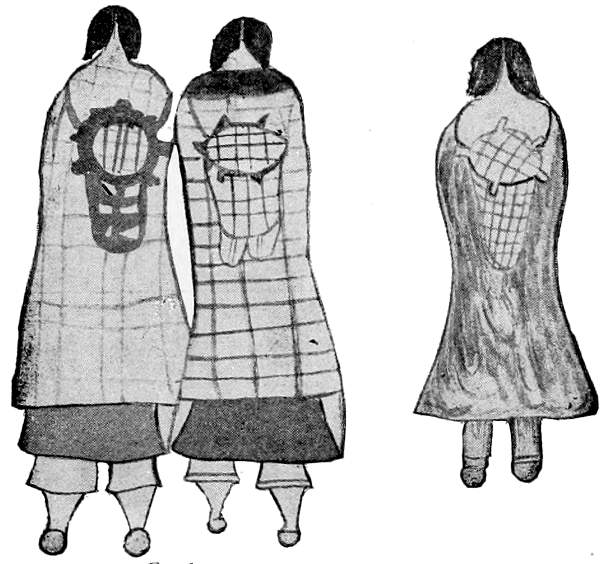
Fig. 745.—Fruit gatherers. Hidatsa.
Fig. 745 is a copy of a sketch made by Lean-Wolf, second chief of the Hidatsa, and shows the manner in which the women carry baskets used[534] in gathering wild plums, bull-berries, and other small fruits. The baskets are usually made of thin splints of wood, and very similar in manner of construction to the well known bushel-basket of our eastern farmers.
Fig. 746 was also made by Lean-Wolf, and illustrates the old manner of hunting antelope and deer. The hunter would disguise himself by covering his head with the head and skin of an antelope, and so be enabled to approach the game near enough to use his bow and arrow.
In a similar manner the Hidatsa would mask themselves with a wolf skin to enable them to approach buffalo. This is illustrated in Fig. 747, which is a reproduction of a drawing made by the above-mentioned chief.
The next group of figures illustrates the custom of gaining and afterwards counting coups or hits, the French expression, sometimes spelled by travelers “coo,” being generally adopted. This is an honor gained by hitting an enemy, whether dead or alive, with an ornamented lance, or sometimes a stick, carried for the purpose as part of a warrior’s equipment. These sticks or wands are about 12 feet long, often of willow, stripped of leaves and bark, and each having some distinguishing objects, such as feathers, bells, brightly-colored cloth, or else painted in a special manner. Further remarks on this custom appear in Chapter XIII, Section 4.
a, in Fig. 748, Kills-the-Enemy, from Red-Cloud’s Census, exhibits the coup stick in contact with the dead enemy’s head. b is taken from Bloody-Knife’s robe and shows an Indian about to strike his prostrate enemy.
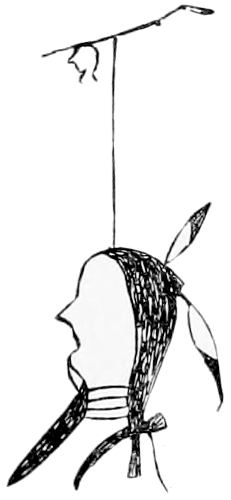
Fig. 749.—Counting coups. Dakota.
Fig. 749.—Killed-First. Red Cloud’s Census. This is the case where a warrior struck the enemy with his coup stick first in order, which is the most honorable achievement, greater than the actual killing. The word translated kill or killed does not always imply immediate death, but the infliction of a fatal wound.
The apparent reason why the striking of the body of a dead or disabled enemy, whether or not killed or disabled by the striker, is more honorable than the actual infliction of the wound, is because the attempt to strike is vigorously resisted by the enemy, the survivors of which assemble to prevent the successful achievement; mere killing might be at a distance in comparative safety.
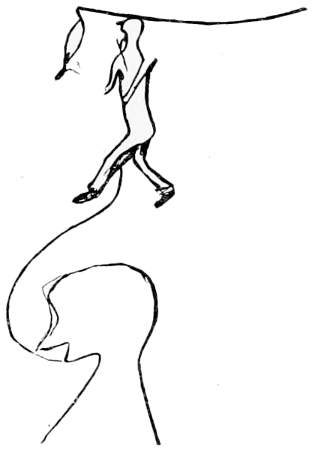
Fig. 750.—Counting coups. Dakota.
Fig. 750.—Enemies-hit-him. Red-Cloud’s Census. In this case the Dakota has been hit by the enemy’s lance or coup stick.
This group refers to the custom, east of the Rocky mountains, of exhibiting scalps.
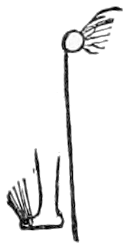
Fig. 751.—Scalp displayed. Dakota.
Fig. 751.—A war party of Oglalas killed one Pawnee; his scalp is on the pole. American-Horse’s Winter Count, 1855-’56. This and the next figure show the custom of a successful war party on returning to the home village to display the scalps taken. This display is the occasion of special ceremonies. The marks on the foot signify that on their way home the men of the war party froze their feet.
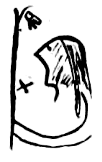
Fig. 752.—Scalp displayed. Dakota.
Fig. 752.—Owns-the-Pole, the leader of an Oglala war party, brought home many Cheyenne scalps. American-Horse’s Winter Count, 1798-’99. The cross stands for Cheyenne, as explained above.
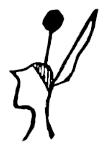
Fig. 753.—Scalped head. Dakota.
Fig. 753.—Black-Rock, a Dakota, was killed by the Crows. American-Horse’s Winter Count, 1806-’07. A rock or, more correctly translated, a large stone is represented above his head. He was killed with an arrow and was scalped. The figure is introduced here to show the designation of a scalped head, which is colored red—that is, bloody—when coloration is possible. It frequently appears in the Winter Counts of the Dakotas.
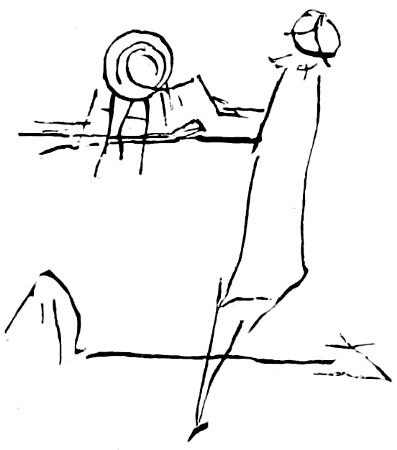
Fig. 754.—Scalp taken.
Fig. 754 was drawn by a Dakota Indian at Mendota, Minnesota, and represents a man holding a scalp in one hand, while in the other is the gun, the weapon used in killing the enemy. The short vertical lines below the periphery of the scalp indicate hair. The line crossing the leg of the Indian is only a suggestion of the ground upon which he is supposed to stand.
The following group pictographically expresses the hunting of antelopes.
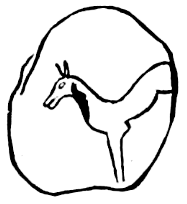
Fig. 755.—Antelope hunting. Dakota.
Fig. 755.—They drove many antelope into a corral and then killed them. Cloud-Shield’s Winter Count, 1828-’29. This and the following two figures show the old mode of procuring antelope and other animals by driving them into an inclosure.
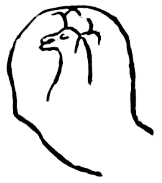
Fig. 756.—Antelope hunting. Dakota.
Fig. 756.—They provided themselves with a large supply of antelope meat by driving antelope into a corral, in which they were easily killed. American-Horse’s Winter Count, 1828-’29.
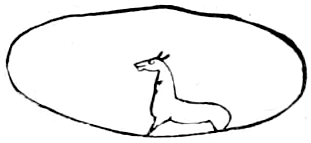
Fig. 757.—Antelope hunting. Dakota.
Fig. 757.—They capture a great many antelope by driving them into a pen. Cloud-Shield’s Winter Count, 1860-’61.
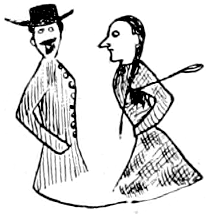
Fig. 758.—Wife’s punishment.
Fig. 758.—A woman who had been given to a white man by the Dakotas was killed because she ran away from him. Cloud-Shield’s Winter Count, 1799-1800. The gift of the woman was in fact a sale, and, in addition to the crime of marital infidelity, the tribe was implicated in a breach of contract. The union line below the figures, mentioned before, means husband and wife. This picture illustrates, as far as may be done pictorially, a Dakotan custom as regards marriage and the penalty connected with it.
The following figures relate to several different forms:
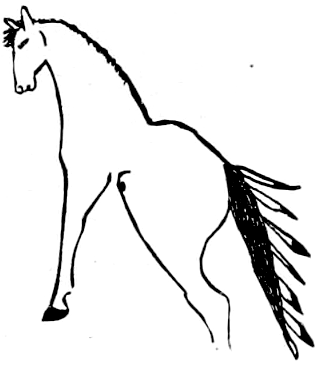
Fig. 759.—Decorated horse.
Fig. 759.—They brought in a fine horse with feathers tied to his tail. Cloud-Shield’s Winter Count, 1810-’11. White-Cow-Killer calls it “Came-with-medicine-on-horse’s-tail winter.” This illustrates the ornamentation of specially valuable or favorite horses, which, however, is not mere ornamentation, but often connected with sentiments or symbols of a religious character, and as often with the totemic, which from another point of view may also be regarded as religious.

Fig. 760.—Suicide. Dakota.
Fig. 760.—A young man who was afflicted with smallpox and was in his tipi by himself sang his death song and shot himself. American-Horse’s Winter Count, 1784-’85. Suicide is more common among Indians than is generally suspected, and even boys sometimes take their own lives. A Dakota boy at one of the agencies shot himself rather than face his companions after his mother had whipped him; and a Paiute boy at Camp McDermit, Nevada, tried to poison himself with the wild parsnip because he was not well and strong like other boys. The Paiutes usually eat the wild parsnip when bent on suicide.
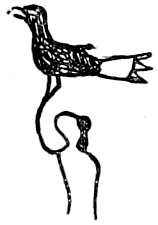
Fig. 761.—Eagle hunting. Arikara.
Fig. 761.—A Ree Indian hunting eagles from a hole in the ground was killed by the Two-Kettle Dakotas. The Swan’s Winter Count, 1806-’07. The drawing represents an Indian in the act of catching an eagle by the legs in the manner that the Arikaras were accustomed to catch eagles in their earth-traps. They rarely or never shot war eagles. The Dakotas probably shot the Arikara in his trap just as he put his hand up to grasp the bird.
In this connection Fig. 762 is properly inserted. It is a sketch made by an Ojibwa hunter to illustrate the manner of catching eagles, the feathers of which are highly prized by nearly all Indians for personal decoration and for war bonnets.
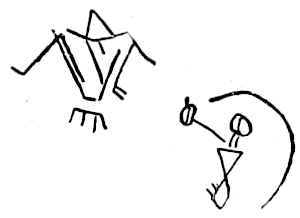
Fig. 762.—Eagle hunting. Ojibwa.
The upper character represents an eagle; the curved line at the right denotes the covering of branches and leaves of a temporary structure placed over a hole in the ground in which the Indian is secreted. He is depicted beneath covering, while a line, extending toward the eagle, terminates in a small oblong object, which is intended to represent the bait placed upon the covering to attract the eagle. The bait may consist of a young deer, a hare, or some other live animal of sufficient size to attract the eagle. When the latter swoops down and seizes the prey he is caught by the leg and held until assistants arrive, after which he is carried back to camp and plucked and is then liberated.
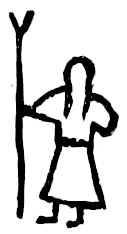
Fig. 763.—Gathering pomme-blanche.
Fig. 763.—A Ree woman is killed by a Dakota while gathering pomme-blanche. The-Flame’s Winter Count, 1797-’98. Pomme-blanche, or navet de prairie, is a white root, somewhat similar in appearance to a white turnip, botanically Psoralea esculenta (Nuttal) sometimes P. argophylla. It is a favorite food of the Indians, eaten boiled down to a sort of mush or hominy. A forked stick is used in gathering these roots.

Fig. 764.—Moving tipi.
Fig. 764.—Lodge-Roll. Red-Cloud’s Census, No. 101. This figure shows the mode of rolling up the skins forming the tipi for transportation. It is attached to four lodge poles, the ends of which trail on the ground and constitute the “travail” which was dragged by dogs. Horses are now used for this purpose, and canvas takes the place of skins.
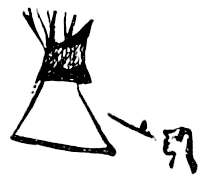
Fig. 765.—Claiming sanctuary.
Fig. 765.—An enemy came into Lone-Horn’s lodge during the medicine feast and was not killed. The-Swan’s Winter Count, 1852-’53. The pipe is not in the man’s hand, and the head only is drawn with the pipe between it and the tipi.
An interesting custom of the Indians connected with the rite of sanctuary is that called by English writers “running the gauntlet.” When captives had successfully run through a line of tormentors to a post near the council-house they were for the time free from further molestation. In the northeastern tribes this was in the nature of an ordeal to test whether or not the captive was vigorous and brave enough to be adopted into the tribe, but among other tribes it appears in a different shape. Any enemy, whether a captive or not, could secure immunity from present danger if he could reach a central post, or if there were no post, the lodge or tipi of the chief. A similar[539] custom existed among the Arikaras, who kept a special pipe in a “bird-box.” If a criminal or enemy succeeded in smoking the pipe contained in the box he could not be hurt. This corresponds with the safety found in laying hold of the horns of the Israelite altar.
The position of the pipe is significant. Its mouthpiece points to the entrance of the tipi. The visitor does not bring or offer peace, but hopes that the tribe visited may grant it to him.
The four figures next following refer to ceremonies by which a war party was organized among some of the tribes of the Plains. A brief account of the ceremonies specially relating to the pipe is as follows:
When a warrior desires to make up a war party he visits his friends and offers them a filled pipe as an invitation to follow him, and those who are willing to go accept the invitation by lighting and smoking it. Among the Dakotas this was succeeded by a muster feast and war dance. Any man whose courage has been proved may become the leader of a war party. The word leader has been generally translated “partisan,” an expression originally adopted by the French voyageurs. Among the Arapahos the would-be leader does not invite anyone to accompany him, but publicly announces his intention of going to war. He fixes the day for his departure, and states where he will camp the first night, naming some place not far off. The morning on which he starts, and before leaving the village, he invokes the aid of his guardian totem. He rides off alone, carrying his bare pipe in his hand with the bowl carefully tied to the stem to prevent it from slipping off. If the bowl should at any time accidentally fall to the ground he considers it an evil omen and immediately returns to the village, and nothing could induce him to proceed, as he thinks that only misfortune would attend him if he did. Sometimes he ties eagle or hawk plumes to the stem of his pipe, and after quitting the village, repairs to the top of some hill and makes an offering of them to the sun, taking them from his pipe and tying them to a pole which he erects in a pile of stones. Those who intend to follow him usually join him at the first camp, equipped for the expedition; but often there are some who do not join him until he has gone further on. He eats nothing before leaving the village, nor as long as the sun is up; but breaks his fast at his first camp after the sun sets. The next morning he begins another fast, to be continued until sunset. He counts his party, saddles his horse, names some place 6 or 7 miles ahead, where he says he will halt for awhile, and again rides off alone with his pipe in his hand. After awhile the party follow him in single file. When they have reached his halting place he tells them to dismount and let their horses graze. They all then seat themselves on the ground on the left of the leader, forming a semicircle facing the sun. The leader fills his pipe, all bow their heads, and, pointing the stem of the pipe upward, he prays toward the sun, asking that they may find an abundance of game, that dead shots may be made, so that their ammunition will not be wasted, but reserved for their enemies; that they may easily find their enemies and kill them; that[540] they may be preserved from wounds and death. He makes his petition four times, then lights his pipe, and after sending a few whiffs of smoke skyward as incense to the sun, hands the pipe to his neighbor who smokes and passes it on to the next. It is passed from one to another toward the left, until all have smoked, the leader refilling it as often as necessary. They then proceed to their next camp, where probably others join them. The same programme is carried out for three or four days before the party is prepared for action.
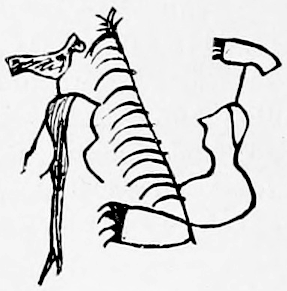
Fig. 766.—Raising war party. Dakota.
Fig. 766.—Big Crow and Conquering-Bear had a great feast and gave many presents. American-Horse’s Winter Count, 1846-’47. The two chieftains are easily recognized by the name characteristic over their heads. They have between them the war eagle pipe—specifically, but erroneously, called calumet by some writers.
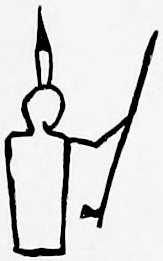
Fig. 767.—Raising war party. Dakota.
Fig. 767.—Feather-in-the-Ear made a feast to which he invited all the young Dakota braves, wanting them to go with him. The-Swan’s Winter Count, 1842-’43. A memorandum is added that he failed to persuade them.
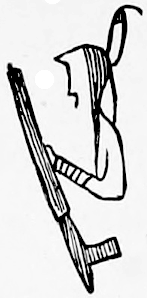
Fig. 768.—Raising war party. Dakota.
Fig. 768.—The Cheyennes carry the pipe around to invite all the tribes to unite with them in a war against the Pawnees. American-Horse’s Winter Count, 1852-’53.
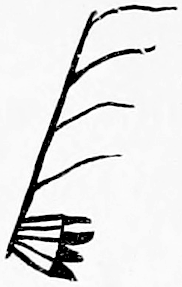
Fig. 769.—Raising war party. Dakota.
Fig. 769.—Danced calumet dance before going to war. The-Swan’s Winter Count, 1804-’05. The specially ornamented pipe becomes the conventional symbol for the ceremonial organization of a war party.

Fig. 770.—Walrus hunting. Alaska.
Fig. 770 represents an Alaskan in the water killing a walrus. The illustration was obtained from a slab of walrus ivory in the museum of the Alaska Commercial Company of San Francisco.
The carving, Fig. 771, made of a piece of walrus tusk, was copied from the original in the same museum during the summer of 1882. Interpretations were verified by Naumoff, a Kadiak half-breed.
a is a native whose left hand is resting against the house, while the right hangs toward the ground. The character to his right represents a “Shaman stick” surmounted by the emblem of a bird, a “good spirit,” in memory of some departed friend. It was suggested that the grave stick had been erected to the memory of his wife.
b represents a reindeer, but the special import in this drawing is unknown.
c signifies that one man, the designer, shot and killed another with an arrow.
d denotes that the narrator has made trading expeditions with a dog sledge.
e is a sailboat, although the elevated paddle signifies that that was the manner in which the voyage was best made.
f, a dog sled, with the animal hitched up for a journey. The radiating lines in the upper left hand corner, over the head of the man, are the rays of the sun.
g, a sacred lodge. The four figures at the outer corners of the square represent the young men placed on guard, armed with bows and arrows, to keep away those not members of the band, who are depicted as holding a dance. The small square in the center of the lodge represents the fireplace. The angular lines extending from the right side of the lodge to the vertical partition line show in outline the subterranean entrance to the lodge.
h, a pine tree upon which a porcupine is crawling upward.
i, a pine tree, from which a bird (woodpecker) is extracting larvæ for food.
j, a bear.
k, the designer in his boat holding aloft his double-bladed paddle to drive fish into a net.
l, an assistant fisherman driving fish into the net.
m, the net.
The figure over the man (l) represents a whale, with harpoon and line attached, caught by the narrator.
Many customs, such, for instance, as the peculiar arrangement of hair in any tribe, are embodied in their pictorial designation by other tribes and often by themselves. Numerous examples are presented in this paper.
In Lord Kingsborough, Vol. VI, p. 45 et seq., is the text relating to the collection of Mendoza, in Vol. I, Pls. LVIII, to LXII, inclusive, here presented as Pls. XXXIV to XXXVIII. The textual language is preserved with some condensation.
Pl. XXXIV exhibits the customs of the Mexicans at the birth of a male or female infant; the right and ceremony of naming the children and of afterwards dedicating and offering them at their temples or to the military profession.
As soon as the mother was delivered of the infant they put it into a cradle and when it was 4 days old the midwife took the infant in her arms, naked, and carried it into the court of the mother’s house, in which court was strewed reeds, or rushes, which they call tule, upon which was placed a small vessel of water in which the midwife bathed the infant; and after she had bathed it 3 boys being seated near the said rushes, eating roasted maize mixed with boiled beans, which kind of food they named yxcue, which provision or paste they set before the said boys in order that they might eat it. After the bathing, or washing, the midwife desired the boys to pronounce the name aloud, bestowing a new name on the infant which had been thus bathed; and the name that they gave it was that which the midwife wished. They first carried out the infant to bathe it. If it was a boy they carried him, holding his symbol in his hand, which symbol was the instrument which the father of the infant employed either in the military profession or in his trade, whether it was that of a goldsmith, jeweller, or any other; and the said ceremony having been gone through, the midwife delivered the infant to his mother. But if the infant was a girl the symbol with which they carried her to be bathed was a spinning wheel and distaff, with a small basket and a handful of brooms which were the things which would afford her occupation when she arrived at a proper age.
They offered the umbilical cord of the male infant together with the shield and arrows, the symbols with which they carried him to be bathed, in that spot and place where war was likely to happen with their enemies, where they buried them in the earth; and they did the same with that of the female infant, which they in the same way buried beneath the metate or stone on which they ground meal.
After these ceremonies, when twenty days had expired, the parents of the infant went with it to the temple, or mesquita, which they called calmecac, and in the presence of their alfaquis presented the infant with its offering of mantles and maxtles, together with some provision; and after the infant had been brought up by its parents, as soon as it arrived at the proper age, they delivered him to the[543] superior of the said mezquita, that he might be there instructed in order that he might afterwards become an alfaqui; but if the parents resolved that when the infant attained a fit age he should go and serve in the military profession, they immediately offered him to the master, making a promise of him, which master of the young men and boys was named Teachcauh or Telpuchtlato; which offering they accompanied with a present of provisions and other things for its celebration; and when the infant attained a fit age they delivered him up to the said master.
In the plate a is a woman lately delivered; the four roses, b, signify four days, at the completion of which period the midwife carried forth the new born infant to be bathed; c, is the cradle with the infant; d, the midwife; e, the symbols; f, g, h, the three boys who named the new-born infant; i, the rushes, with the small vessel of water; j, the brooms, distaff, spinning wheel, and basket; k, the father of the infant; l, the superior alfaqui; m, the infant in the cradle, whose parents are offering it at the mezquita; n, the mother of the girl; o, the master of the boys and young men.
Kingsborough’s Pl. LIX—here Pl. XXXV, treats of the time and manner in which the Mexicans instructed their children how they ought to live.
The first section shows how parents corrected their children of 3 years old by giving them good advice, and the quantity of food which they allowed them at each meal was half a roll.
The three circles, a, indicate 3 years of age; b, denotes the father of the boy; c, the boy; d, the half of a roll; e, the mother of the girl; f, the half of a roll; g, the girl of 3 years of age.
The second section represents the parents employed in the same way, in instructing their children when they attained 4 years of age, when they began to exercise them by bidding them to do a few slight things. The quantity of food which they gave them at each meal was a roll.
The father of the boy is shown at h; the boy, 4 years of age, at i; j, a roll; k, the mother of the girl; l, a roll; m, the girl of 4 years.
The third section shows how the parents employed and exercised their sons of 5 years of age in tasks of bodily strength; for example, in carrying loads of wood of slight weight, and in sending them with light bundles to the tianquez or market place; and the girls of this age received lessons how they ought to hold the distaff and the spinning wheel. Their allowance of food was a roll.
In this section, n shows the father of the boy; o, two boys of 5 years of age; p, a roll; q, a roll; r, the mother of the girl; s, a roll; t, the girl of 5 years of age.
The fourth section shows how parents exercised and employed their sons of 6 years in personal services, that they might be of some assistance to their parents; as also in the tianquez, or market places, in picking up from the ground the grains of maize which lay scattered about, and the beans and other trifling things which those who resorted to the market had dropped. The girls were set to spin, and employed in other useful tasks that they might hereafter, through the said tasks and[544] works, sedulously shun idleness in order to avoid the bad habits which idleness is accustomed to cause. The allowance of food which was given to the boys at each meal was a roll and a half.
The father of the two boys appears at u; two boys of 6 years old at v; w, a roll and a half; x, the mother of the girl: y, a roll and a half; z, the girl of 6 years old.
Pl. LX, here Pl. XXXVI, treats of the time and manner in which the native Mexicans instructed and corrected their sons, that they might learn to avoid all kinds of sloth and to keep themselves constantly exercised in profitable things. It is divided into four sections.
The first section shows how fathers employed their sons of 7 years old in giving them nets to fish with; and mothers occupied their daughters in spinning and in giving them good advice. The allowance of food which they gave to their sons at each meal was a roll and a half.
The seven points, a, signify seven years; b, is the father of the boys; c, a roll and a half; d, the boy of 7 years old whose father is instructing him how to fish with the net which he holds in his hands; e, the mother of the girls; f, a roll and a half; g, the girl of 7 years whom her mother is teaching how to spin.
The second section declares how fathers chastised their sons of 8 years of age, threatening them with thorns of the aloe, that in case of negligence and disobedience to their parents they should be punished with the said thorns. The boys accordingly weep for fear. The quantity of food which they allowed them consisted of a roll and a half.
The eight points, h, signify eight years; i, the father of the boys; j, a roll and a half; k, the boy of 8 years, whose father threatens him in case of ill behavior to inflict public punishment upon him with thorns; l, thorns of the aloe; m, the mother of the girls; n, a roll and a half; o, the girl of 8 years of age, whose mother threatens her with thorns of the aloe in case of ill behavior; p, thorns of the aloe.
The third section declares how fathers punished with the thorn of the aloe their sons of 9 years of age, when they were incorrigible and rebellious toward their parents, by running the said thorns into their shoulders and bodies. They also corrected their daughters by pricking their hands with thorns. The allowance of food which they gave them was a roll and a half.
The nine points, q, signify nine years; r, a roll and a half; s, the father of the boys; t, a boy of 9 years old being found to be incorrigible, his father runs thorns of the aloe into his body; u, the mother of the girls; v, a roll and a half; w, the girl of 9 years old and her mother, who corrects her for her negligence by pricking her hands with thorns.
The fourth section shows how fathers chastised their sons of 10 years of age, when they were refractory, by inflicting blows upon them with a stick and threatening them with other punishments. The[545] quantity and allowance of food which they gave them was a roll and a half.
The ten points, x, signify ten years; y, a roll and a half; z, the father of the boys; aa, the boy of 10 years old, whose father is correcting him with a stick; bb, the mother of the girl; cc, a roll and a half; dd, the girl of 10 years old, whose mother is correcting her with a stick.
Pl. LXI, here Pl. XXXVII, is in three sections.
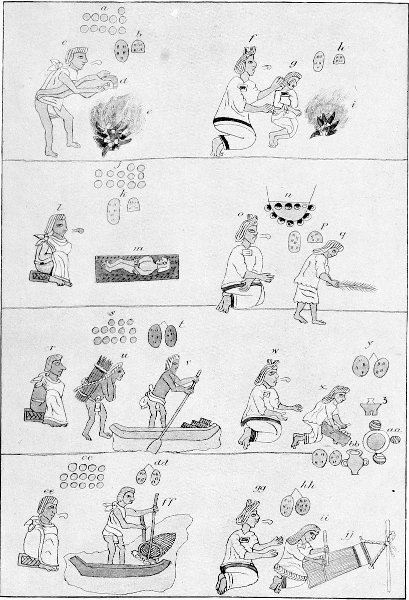
BUREAU OF ETHNOLOGY TENTH ANNUAL REPORT PL. XXXVII
EDUCATION OF MEXICAN CHILDREN, ELEVEN TO FOURTEEN YEARS.
The first section explains that when a boy of 11 years of age disregarded verbal reproof, his parents obliged him to inhale smoke of axi through the nostrils, which was a cruel and severe punishment, that he might be sorry for such conduct and not turn out worthless and abandoned, but on the contrary employ his time in profitable things. They gave boys of such an age bread, which consisted of rolls, only by allowance, that they might learn not to be gormandizers or gluttons. Girls received similar discipline.
The eleven points, a, signify eleven years; b, a roll and a half; c, the father of the boys; d, the boy of 11 years of age, whose father is punishing him by obliging him to inhale through the nostrils the smoke of dried axi; e, the smoke or vapor of axi; f, the mother of the girls; g, the girl of 11 years, whose mother is punishing her by making her breathe smoke of axi; h, a roll and a half; i, the smoke of axi.
The second section represents that when boys or girls of 12 years of age would not submit to the reproof or advice of their parents, the father took the boy and tied his hands and feet and laid him naked on the ground in some damp and wet place, in which situation he kept him for a whole day, in order that by this punishment he might amend and fear his displeasure. And the mother obliged the girl of the said age to work by night before break of day, employing her in sweeping the house and the street and continually occupying her in personal tasks. They gave them food likewise by allowance.
The points, j, indicate twelve years; k, a roll and a half; l, the father of the boys; m, the boy of 12 years of age, stretched upon the wet ground, with his hands and feet tied, for a whole day; the painting at n signifies the night; o, the mother of the girls; p, a roll and a half; q, the girl of 12 years of age, who is employed by night in sweeping.
The third section of this plate represents that boys and girls of 13 years of age were occupied by their parents, the boys in fetching wood from the mountains and in bringing reed grass and other litter in canoes for the use of the house; and the girls in grinding meal and making bread, and preparing other articles of food for their parents. They gave the boys for their allowance of food two rolls each at each meal.
The father of the boys is represented at r; the points, s, indicate thirteen years; t, two rolls; u, the boy of 13 years old, who brings a load of reed grass; v, the boy in a canoe, with bundles of canes; w, the[546] mother of the girls; x, the girl of 13 years of age, who makes cakes and prepares articles of food; y, two cakes; z, a bowl; aa, the comali; bb, a pot for boiling provisions in and two cakes.
The fourth section of this plate represents how their parents employed and occupied a boy or girl of 14 years of age, the boy in going in a canoe to fish in the lakes, and the girl in the task of weaving a piece of cloth. Their allowance of food was two rolls.
The fourteen points, cc, represent fourteen years; dd, two rolls; ee, the father of the boys; ff, the boy of 14 years of age, who goes out fishing with his canoe; gg, the mother of the girls; hh, two rolls; ii, the girl of 14 years, who is occupied in weaving; jj, the web and occupation of weaving.
The figures of Pl. LXII, here Pl. XXXVIII, are in two sections.
Those contained in the first section signify that the father, who had sons nearly grown up, carried them to the two houses represented in the plate; either to the house of the master, who taught and instructed the young men, or to the mezquita, accordingly as the lad was himself inclined, and committed him to the care of the superior Alfaqui or to the master of the boys, to be educated, which lads it was fit should have attained the age of 15.
In this section a is a youth of 15 years of age, whose father delivers him up to the superior Alfaqui, that he might receive him as an Alfaqui; b is the Tlamazqui, who is the superior Alfaqui; c, the mezquita, named Calmecac; d, the father of these two youths; e, a young man of 15, whose father delivers him up to the master that he might teach and instruct him; f, the teachcauh or master; g, the seminary where they educated and taught the young men, which was called cuincacali; h, fifteen years.
The second section of the plate signifies the laws and usages which they followed and observed in marriages. The ceremony consisted in the female negotiator, who arranged the nuptials, carrying on her back on the first night of the wedding the betrothed woman, accompanied by four women with blazing torches of resinous fir, who attended to light her on the way; and having arrived at the house of the man to whom she was engaged, the parents of the betrothed man went out to receive her in the court of the house and conducted her to an apartment where the man expected her; and seating the betrothed couple on a mat on which were placed seats, near a hearth of fire, they took them and tied them to each other by their clothes and offered incense of copal to their gods. Two old men and two women afterward delivered a separate discourse to the newly married couple and set food before them, which they presently ate; and after their repast was over, the two old men and women gave good advice to the married pair, telling them how they ought to conduct themselves and to live, and by what means they might pass their lives in tranquillity.
The square inclosure, i, is the apartment; j, the old man; k, the[547] hearth, of fire; l, the wife; m, copal (the latter is not shown in the drawing, but the copal is between the marrying couple); n, the husband; o, the old woman; p, the old man; q, food; r, a mat; s, food; t, an old woman; u, a pitcher of pulque; v, a cup; w, x, the women lighting the bride on her way with torches, when on the first night of the wedding they accompany her to the house of the bridegroom; y, the female negotiator; z, the bride; aa, bb, women lighting the bride and bridegroom on the first night of their wedding.
Many accounts of the games of the Indians have been published, but they are not often connected with pictography. Those now presented refer to the picturing connected with only three games.
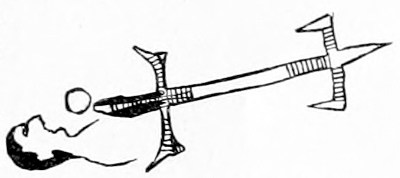
Fig. 772.—Haka game. Dakota.
Fig. 772.—A dead man was used in the ring-and-pole game. American-Horse’s Winter Count, 1779-’80.
The figure represents the stick and ring used in the game of haka, with a human head in front to suggest that the corpse took the place of the usual stick. This and the next figure illustrate the game.
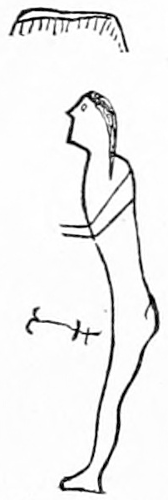
Fig. 773.—Haka game. Dakota.
Fig. 773.—It was an intensely cold winter and a Dakota froze to death. American-Horse’s Winter Count, 1777-’78.
The sign for snow or winter, i. e., a cloud with snow falling from it, is above the man’s head. A haka-stick, which is used in playing that game, is represented in front of him.
Battiste Good’s record further explains the illustration by the account that the Dakota was killed in a fight with the Pawnees, and his companions left his body where they supposed it would not be found, but the Pawnees found it, and, as it was frozen stiff, they dragged it into their camp and played haka with it.
The characters a and b, Fig. 774, represent one point of view of two of a set of Haida gambling sticks, real size. They are made of juniper or some other similar wood, and neatly carved with diverse figures. The game is played by any number of persons, and it would seem with any number of marked sticks. A dealer sits on the ground with a pile of shredded cedar bark in front of him, and with much ceremony draws out the sticks one by one without looking at them and passes them to the players, in turn, who sit in front of him.
Each device counts a certain number, in a manner similar to the devices on ordinary playing cards, and the winning is by the high and[548] low or the definite and specific values of the sticks decided upon in variations of the games. These sticks are cylindrical, and to illustrate the characters on them, c is presented, which shows the whole round of the character b. This exhibits the typical Haida style. An excellent collection of these pictured sticks is in the U. S. National Museum, No. 73552.
Dr. Fewkes (c) reports as follows:
Among the very interesting games played by the Hopi Indians is one of ethnological interest, which is allied to a game described by the early Spanish historians of the Mexicans. This game, to-to-lós-pi, resembles somewhat the game of checkers and can be played by two persons or by two parties. In playing the game a rectangular figure, divided into a large number of squares, is drawn upon the rock, either by scratching or by using a different colored stone as a crayon. (Figures of this game formerly existed on the rocks near the village of Wál-pi.) A diagonal line, tūh-ki-o-ta, is drawn across the rectangle from northwest to southeast, and the players station themselves at each end of this line.
When two parties play, a single person acts as player and the other members of the party act as advisers. The first play is won by tossing up a leaf or corn husk with one side blackened. The pieces which are used are bean or corn kernels, stones, and wood, or small fragments of any substance of marked color. The players were stationed at each end of the diagonal line, tūh-ki-o-ta. They move their pieces upon this line, but never across it. The moves which are made are intricate and the player may move one or more pieces successively. Certain positions entitle him to this privilege. He may capture or, as he terms it, kill one or more of his opponent’s[549] pieces at one play. In this respect the game is not unlike checkers, and to capture the pieces of the opponent seems to be the main object of the game. The checkers, however, must be concentrated and always moved towards the southeast corner.
This game is now rarely played on the East Mesa, but is still used at O-rai-be. It is said to have been played in ancient times by the sun and moon or by other mythical personages.
Turning now to old Mexico, we find that the Spanish chronicles give an account of a Mexican game called patolli, which was played with colored stones. The squares were made of a cross-shaped figure, and the stones were moved according to the throws of beans which were marked upon one side.
A discussion of the “ghost gamble,” with many illustrations, some of which show marks which, in a broad sense, may be classed as pictographic, is published in the paper “Study of the mortuary customs of the North American Indians,” by Dr. H. C. Yarrow (a), U. S. Army.
Colored pebbles found in the grotto of Mas d’Azil, in the department of the Ariège, France, have lately awakened some discussion. These pebbles were selected as being narrow and flat, and, with rare exceptions, are no more than 9 centimeters in length. They were colored with red oxide of iron. Many of the designs could have been made by the end of a finger anointed with the coloring matter, but others would have required a small pencil. The coloring matter was thick and probably fixed by grease or glue, which time has destroyed. The color now disappears on the least rubbing. Its preservation until now has been owing to the fact that the pebbles were left undisturbed in the cindery layer where they were deposited. Only one of the faces of the pebbles bears a design, and generally their border is ornamented by a narrow band of red, resembling a frame to the design, the color being applied[550] in the same manner as to the latter. Fig. 775 gives examples though without color of these pebbles. They are selected from a plate in L’Anthropologie (d) illustrating the text by Émile Cartailbac, who declines to offer any hypothesis concerning the use of these objects. But to an observer familiar with the gambling games of the North American Indians in which marked plum stones, and similar objects are employed, these stained flat pebbles at once suggest their use to decide the values in a game by the several designs and by the pebbles falling on the figured or on the unmarked side.
It is seldom possible to distinguish by pictographs, or indeed to decide from oral accounts obtained from Indians, whether those purporting to be historical have a genuine basis or are merely traditions connected with myths. This chapter may therefore be correlated with Chapter IX, section 5, which has special relation to traditions as mnemonically pictured. The notes now following are considered to refer to actual events or to explain the devices used in the record of such events.
The account by Dr. Brinton (c) of the Walum-Olum or bark record of the Lenni-Lenapé, as also some of Schoolcraft’s pictographic illustrations, may with some propriety be regarded as historic, but are so well known that their specific citation is needless.
The American Indians have not produced detailed historic pictures, such as appear on the Column of Trajan, and the Bayeux tapestry, with such excellence in art as to be self-interpreting. Neither do they equal in this respect the Egyptian and Assyrian sculptures, which portray the ordering of battle, the engineering work of sieges, the plan of camps, and the tactical moves of chieftains. Those sculptures also depict the whole civil and domestic lives of the peoples of the several nations. In some of these particulars the Mexicans approached these graphic details, as is shown below, but, as a rule, in the three divisions of America, history was noted and preserved by ideographic methods supplementing the incompleteness of artistic skill.
With regard to the advance gained by the Mexicans reference is made, with regret that copious quotation is impossible, to the essay of Henry Phillips, jr. (a), and to the monumental work of Eugène Boban, before cited. It will be noticed by students that ideography and its attendant conventionalism continually appear in the pictographic histories mentioned. The original authors had not advanced very far in art, but they had not lost the thought-language, which preceded art.
The subject is here divided into: (1) Record of expedition; (2) Record of battle; (3) Record of migration; (4) Record of sociologic events.
The following account from Lafitau (a) explains the device for prisoner, under the heading of marked sticks, in Chapter IX, section 2, supra:
The most grievous time for them is at night; for every evening they are extended on their backs almost naked, with no other bed than the earth, in which four stakes are driven for each prisoner; to these their arms and legs are attached, spread apart in the form of a St. Andrew’s cross. To a fifth stake a halter is tied, which holds the prisoner by the neck and is wound around it three or four times. Finally, he is bound around the middle of the body by another halter or girdle, the two ends of which are taken by the person in charge of the captive and placed under his head while he sleeps, so that he will be awakened if the prisoner makes any movement to escape.
With the same object of explaining pictographic devices, the following is extracted from James’s Long (h):
Returning war parties of the Omaha peel off a portion of the bark from a tree, and on the trunk thus denuded and rendered conspicuous, they delineate hieroglyphics with vermilion or charcoal, indicative of the success or misfortune of the party, in their proceedings against the enemy. These hieroglyphics are rudely drawn, but are sufficiently significant to convey the requisite intelligence [t]o another division of the party, that may succeed them. On this rude chart the combatants are generally represented by small straight lines, each surmounted by a head-like termination, and are readily distinguishable from each other; the arms and legs are also represented when necessary to record the performance of some particular act or to exhibit a wound. Wounds are indicated by the representation of the dropping of blood from the part; an arrow wound, by adding a line for the arrow, from which the Indian is able to estimate with some accuracy its direction, and the depth to which it entered. The killed are represented by prostrate lines; equestrians are also particularized, and if wounded or killed they are seen to spout blood or to be in the act of falling from their horses. Prisoners are denoted by their being led, and the number of captured horses is made known by the number of lunules representing their track. The number of guns taken may be ascertained by bent lines, on the angle of which is something like the prominences of the lock. Women are portrayed with short petticoats and prominent breasts, and unmarried females by the short queues at the ears.
In Margry (e) there is an account of La Salle’s finding in 1683 on the bark of a tree a record of the party of Tonty’s pilot. The picture was that of a man with the costumes and general appearance of the pilot who had deserted, another man tied as a captive, and four scalps. This corresponded with the facts afterwards learned. The pilot had been left free, another man kept alive, and four killed, thus accounting for the lost party of six. The record had been made by the captors.
The figures in the following group, taken from several of the Winter Counts of the Dakotas, picture a number of important expeditions, all of which are independently known. Some of them are narrated in the official documents of the United States.
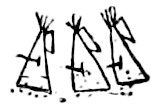
Fig. 776.
Fig. 776. The Oglalas, Brulés, Minneconjous, San Arcs, and Cheyennes united in an expedition against the Crows. They surprised and captured a village of thirty lodges, killed all the men and took the women and children prisoners. American-Horse’s Winter Count, 1801-’02.
The three tipis stand for thirty; the spots in the original are red for blood.
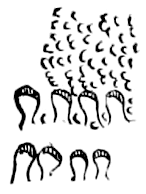
Fig. 777.
Fig. 777. The Oglalas and Minneconjous took the war-path against the Crows and stole three hundred horses. The Crows followed them and killed eight of the party. American-Horse’s Winter Count, 1863-’64. Eight scalped heads are portrayed.
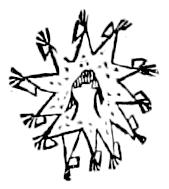
Fig. 778.
Fig. 778. The Dakotas assaulted and took a Crow village of a hundred lodges. They killed many and took many prisoners. American-Horse’s Winter Count, 1820-’21.
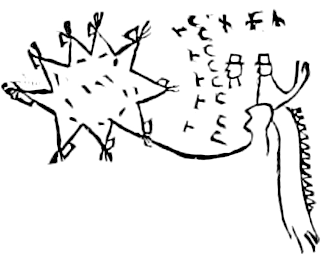
Fig. 779.
Fig. 779. The Oglalas helped Gen. Mackenzie to whip the Cheyennes. American-Horse’s Winter Count, 1876-’77. The head of the Indian on which is the ornamented war bonnet represents the man who was the first to enter the Cheyenne village, which is figured by the tipis in a circle. The hatted, i. e., white man holding up three fingers is Gen. Mackenzie, who, as was explained by the interpreter, is placed upon the head of the Dakota to indicate that the Dakotas backed or assisted him, but it may mean that he commanded or was at the head of the party. The other white man is Gen. Crook, or Three Stars, as indicated by the three stars above him, and as he is called in another record. This designation might be suggested from the uniform, but it is not accurate. Gen. Crook’s rank as major-general of volunteers, or as brevet major-general in the Army, did not entitle him to more than two stars on his shoulder straps. It is possible that one of the stars in this figure belongs to Gen. Mackenzie.
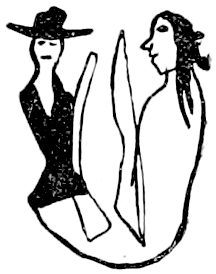
Fig. 780.
Fig. 780. The Dakotas joined the whites in an expedition up the Missouri river against the Rees. Cloud-Shield’s Winter Count, 1823-’24.
White-Cow-Killer calls it “Old-corn-plenty-winter.”
The union line between the Indian and the white soldier shows that on this occasion they were allies.
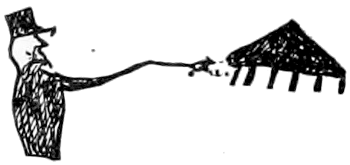
Fig. 781.
Fig. 781. United States troops fought Ree Indians. The-Swan’s Winter Count, 1823-’24.
This and the preceding figure are signs of a specially interesting expedition, a condensed account of which follows taken from the annual report of J. C. Calhoun, Secretary of War, November 29, 1823:
Gen. William H. Ashley, a licensed trader, was treacherously attacked by the Arickaras at their village on the west bank of the Missouri river, about midway between the present Fort Sully and Fort Rice. Twenty-three of the trading party were killed and wounded, and the remainder retreated in boats and sent appeals for succor to the commanding officer at Fort Atkinson, the present site of Council Bluffs. This officer was Col. H. Leavenworth, Sixth United States Infantry, who marched June 22, with 220 men of that regiment, 80 men of trading companies, and two 6-pound cannon, a 5½-inch brass howitzer, and some small swivels, nearly 700 miles through a country filled with hostile or unreliable Indians, to the Ree villages, which he reached on the 9th of August. The Dakotas were at war with the Arickara or Rees, and 700 to 800 of their warriors had joined the United States forces on the way; of these Dakotas 500 are mentioned as Yanktons, but the tribes of the remainder are not designated. The Rees were in two villages, the lower one containing seventy-one dirt lodges and the upper seventy, both being inclosed with palisades and a ditch and the greater part of the lodges having a ditch around the bottom on the inside. The enemy, having knowledge of the expedition, had fortified and made every preparation for resistance. Their force consisted of over 700 warriors, most of whom were armed with rifles procured from British traders. On the 9th of August the Dakotas commenced the attack and were driven back until the regular troops advanced, but nothing decisive resulted until the artillery was employed on the 10th, when a large number of the Rees, including their chief, Gray Eyes, were killed, and early in the afternoon the survivors begged for peace. They were much terrified and humbled by the effect of the cannon, which, though small, answered the purpose. During the main engagement the Dakotas occupied themselves in gathering and carrying off all the corn to be found.
See also the record of Lean-Wolf’s expedition in Fig. 452.
Lafitau (b) gives the following account, translated with condensation, of the records of expedition, battle, etc., made by the Iroquois and northeastern Algonquins:
The designs which the Indians have tattooed on their faces and bodies are employed as hieroglyphics, writing, and records. When an Indian returns from war and wishes to make his victory known to the neighboring nations through whose country he passes, when he has chosen a hunting ground and wishes it to be known that he has selected it for himself and that it would be an affront to him for others to establish themselves there, he supplies the lack of an alphabet by those characteristic symbols which distinguish him personally; he paints on a piece of bark, which is raised on a pole by a place of passage [trail], or he cuts away some pieces from a tree trunk with his hatchet, and, after having made a smooth surface, traces his portrait and adds other characters, which give all the information that he desires to convey.
When I say that he draws his portrait, it will be understood that he is not skillful enough to delineate all the features of his face in such a manner that it would be recognized. They have, indeed, no other way of painting than that monogrammatic or linear painting, which consists of little more than the mere outlines of the shadow of the body rather than of the body itself—a picture so imperfect that it was often necessary to add below the name of the object which was intended to be represented in order to make it known.
The Indian then, to represent his portrait, draws a simple outline in the form of a head, adding scarcely any marks to indicate the eyes, nose, ears, or other features of the face. In place of these he draws the designs which are tattoed upon his own face, as well as those upon his breast, and which are peculiar to him and render him recognizable not only to those who have seen him, but even to all who, knowing him only by reputation, are acquainted with his hieroglyphic symbol, as formerly in Europe an individual was distinguished by his device and as we to-day know a family by its armorial bearings. About his head he paints the object which expresses his name; the Indian, for example, called the Sun paints a sun; at the right he traces the animals which are the symbols of the nation and family to which he belongs. That of the nation is above the one representing the family, and the beak or muzzle of the former is so placed that it corresponds to the place of his right ear, as if this symbolic figure of his nation represented its spirit, which inspires him. If this Indian is returning from war, he represents beneath his portrait the number of warriors composing the party which he leads, and beneath the warriors the number of prisoners made and those whom he has killed by his own hand. At the left side are indicated his expeditions and the prisoners or scalps taken by those of his party. The warriors are represented with their weapons or simply by lines; the prisoners by the stick decorated with feathers and by the chichikoue or tortoise-shell rattle, which are the marks of their slavery; the scalps or the dead by the figures of men, women, or children without heads. The number of expeditions is designated by mats. He distinguishes those which he has accompanied from those which he has commanded by adding strings [of wampum] to the latter. If the Indian goes as an ambassador of peace all the symbols are of a pacific nature. He is represented below his portrait with the calumet in his hand; at the left is seen an enlarged figure of the calumet, the symbolic figure of the nation with which he goes to treat, and the number of those who accompany him on the embassy.
The same author, on page 194 of the same volume, explains how the mat or mattress came to mean war:
The Iroquois and the Hurons call war n’ondoutagette and gaskenrhagette. The final verb gagetton, which is found in the composition of these two words, and which signifies to bear or to carry, shows, verily, that heretofore something was borne to it [i. e., to war], which was a symbol of it [i. e., of war] to such a degree that it [war] had assumed its [the symbol’s] designation. The term ondouta signifies the down [the wool-like substance] which is taken from the ear [cat-tails] of marsh reeds, and it also denotes the entire plant, which they use in making the mattresses [nattes] upon which they lie; so that it appears that they applied this term to war because every warrior in this kind of expeditions carried with him his own mattress; in fact, the mattress is still to-day the symbol employed in their hieroglyphic picture-writing to denote the number of their campaigns.
Mr. J. N. B. Hewitt, in Science, April 1, 1892, has gone deeper into the etymology of the words quoted, but coincides generally with Father Lafitau in the explanation that they were denotive of the custom of the Iroquoian warrior to carry his mattress when on the warpath.
Figs. 782 and 783 are reproductions of Lafitau’s (c) illustrations, which were explained as follows by him:
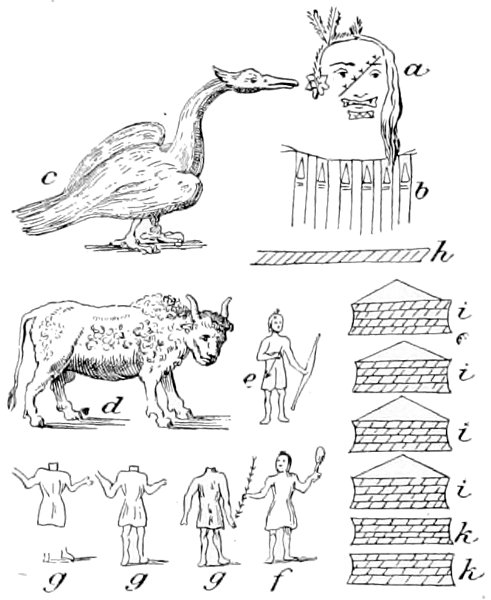
Fig. 782.—Record of battle.
Fig. 782 shows that the Indian called Two-Feathers, a b, of the Crane nation c, and the Buffalo family d, accompanied by fifteen warriors h, has made one prisoner f, and taken three scalps g, on his sixth expedition k, and on the fourth, when he commanded it, i.
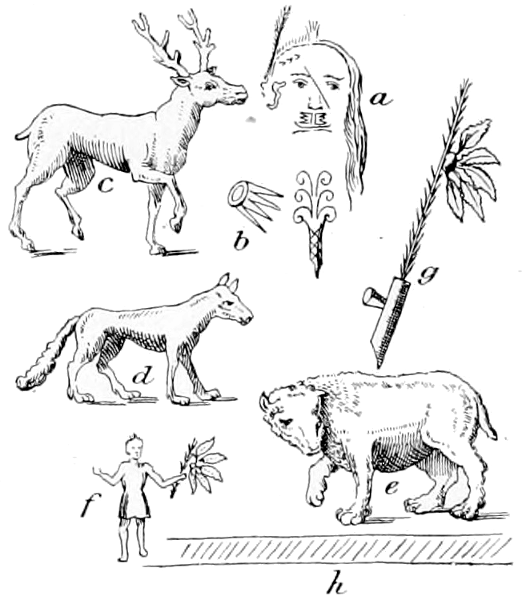
Fig. 783.—Record of battle.
Fig. 783 relates that the Indian named Two-Arrows a, of the nation of the Deer c, and the Wolf family d, has gone as an ambassador bearing the calumet of peace to the Bear nation e, accompanied by thirty persons h. In both figures the Indian is not only represented by his “hieroglyph,” but he is also pictured at full length in the first with his arms, and in the second holding the calumet and the rattle.
A historical record relating to a fight between the Ojibwa and the Dakota ninety-one years ago is given in Fig. 784. The following narrative was given by the draftsman of the record, an Ojibwa:
Ninety-one winters ago (A. D. 1797) twenty-five Ojibwa were encamped on a small lake, o, called Zi'zabe'gamik, just west of Mille Lacs, Minnesota. The chief’s lodge, a, was erected a short distance from the lake, m, where the Indians had been hunting, and as he felt unsafe on account of the hostile Sioux he directed some of his warriors to reconnoiter south of the lower lake, where they soon discovered a body of three hundred of their enemies. The chief of the reconnoitering party, b, sent back word for the women and children to be removed to a place of safety, but three of the old women refused to go. Their lodges are represented in c, d, and e. Five Ojibwa escaped through the brush, in a northwest direction (indicated in f).
The Sioux surrounded the lake and the fight took place on the ice. Twenty of the Ojibwa were killed, the last to die being the chief of the party, who, from appearances, was beaten to death with a tomahawk; g represents three bearskins; h, i, and j, respectively, deer, grouse, and turtle, the kinds of game hunted there during the several seasons.[557] The canoe k indicates the manner of hunting along the shore and the stream connecting the lakes, l, m, and o.
The Ojibwa frequently spent part of a season at the middle lake, m, and at another time had been engaged in a skirmish with the Sioux farther north, on the small lake indicated at o. The Ojibwa had been scattered about, but when the attack was made by the Sioux the former rapidly came to the rescue both by boat, p, and on foot, q, so that the enemy was gradually driven off. In the first mentioned battle 70 Sioux were killed, their bodies being subsequently buried in the lake by cutting holes through the ice. The openings are shown at r, the lines representing bodies ready to be cast down into the water.
Baron Lahontan (b) says:
When a Party of (Algonkin) Savages have routed their enemies in any Place whatsoever, the Conquerors take care to pull the Bark off the Trees for the height of five or six Foot in all Places where they stop in returning to their own Country; and in honour of their Victory paint certain images with Coal pounded and beat up with[558] Fat and Oyl. These Pictures continue upon the peel’d Tree for ten or twelve Years, as if they were Grav’d, without being defac’d by the Rain.
The same author, on page 86, et seq., of the same volume, gives an illustration, with descriptive explanation, of a pictographic record supposed to be made by the Canadian Algonquins. The explanation is useful as indicating the principles of pictography adopted by the North American Indians for a record of that character, but it is not deemed proper to reproduce the illustration here. It has often been copied, but it is misleading in its artistic details. It is obviously drawn by a European artist as his own interpretation of a verbal description of the record.
The more valuable parts of the explanation are condensed as follows, the quaint literation of the early translation being retained:
The Arms of France, with an Ax above. Now the Ax is a Symbol of War among the Savages as the Calumet is the Bond of Peace: So that this imports that the French have taken up the Ax, or have made a Warlike Expedition with as many tens of Men as there are Marks or Points Round the Figure. These marks are eighteen in number and so they signifie an Hundred and eighty Warriors.
A Mountain that represents the City of Monreal and the Fowl upon the Wing at the top signifies Departure. The Moon upon the Back of the Stag signifies the first Quarter of the July Moon which is call’d the Stag-Moon.
A Canow, importing that they have travel’d by Water as many Days as you see Huts in the Figure, i. e., 21 Days [the huts undoubtedly mean stopping places for night shelters].
A foot, importing that after their Voyage by Water they march’d on Foot as many Days as there are Huts design’d; that is, seven Days Journeys for Warriors, each Days Journey being as much as five common French Leagues, or five of those which are reckon’d to be twenty in a Degree.
A Hand and three Huts, which signifie that they are got within three Days Journey of the Iroquese Tsonnontouans [Senecas], whose Arms are a Hut with two trees leaning downwards, as you see them drawn. The Sun imports that they were just to the Eastward of the Village.
Twelve marks, signifying so many times ten Men like those last mentioned. The Hut with two Trees being the Arms of the Tsonnontouans, shows that they were of that Nation; and the Man in a lying posture speaks that they were surpris’d.
In this row there appears a Club and eleven Heads, importing that they had kill’d eleven Tsonnontouans, and the five men standing upright upon the five Marks signifie that they took as many times ten prisoners of War.
Nine Heads in an Arch [i. e., Bow] the meaning of which is, that nine of the Aggressors or of the Victorious side were kill’d; and the twelve Marks underneath signifie that as many were Wounded.
Arrows flying in the air, some to one side and some to the other, importing a vigorous Defence on both sides.
The arrows all point one way, which speaks the worsted Party either flying or fighting upon a Retreat in disorder.
The meaning of the whole is: A hundred and eighty French soldiers set out from Montreal in the first quarter of the month of July and sailed twenty-one days; after which they marched 35 leagues over land and surprised 120 Senecas on the east side of their village, 11 of whom were killed and 50 taken prisoners; the French sustaining the loss of 9 killed and 12 wounded, after a very obstinate engagement.
Fig. 785 is a reproduction of a drawing by a Winnebago Indian of[559] the battle of Hard river, fought against a large force of Sioux by Gen. Sully’s command, with which was a company of Winnebagos.
a. Gen. Sully’s camp, on the left bank of Hard river, from which camp the company of Winnebagos were sent across the river.
b. The Winnebagos skirmishing with a party of hostile Sioux. Two Winnebagos, having gone ahead of the main party, came first upon about thirty Sioux, who immediately gave chase. The two Winnebagos are represented endeavoring to escape arrows from pursuing Sioux flying about them, and the blood from the horse of one of them flowing over the ground. The rest of the Winnebagos are coming to rescue their companions.
c. Gen. Sully’s entire force, after crossing Hard river, were assailed by a number of Sioux. Gen. Sully’s forces formed in hollow square to repulse the Sioux, who with loud yells went galloping about them, trying to stampede horses or throw his men into confusion.
d. The camp of the Sioux, the women and children escaping over the hills. One squaw was left in the camp and with her papoose is seen. One of the Sioux previously wounded was found dead and was scalped, a representation of which operation the artist has given.
Fig. 786 is a copy of a birch-bark record made and also explained by the leader of the expedition referred to.
In 1858 a war party of Mille Lacs Ojibwa Indians, a, under the leadership of Shahâsh'king, b, went to attack Shákopi’s camp, c, of Sioux at St. Peter’s river, d. Shákopi is represented at e. The Ojibwa lost one man, f, at the St. Peter’s river, while the Ojibwa killed five Sioux, but succeeded in securing only one arm of an Indian, g.
The line h is the trail followed between Mille Lacs, a, and Shákopi’s camp, c. The spots at c designate the location of lodges, while the vertical line with short ones extending from it, i, signifies the prairie with trees growing near camp.
Fig. 787 is the pictorial story of Megaque’s last battle, drawn on birch bark by the Passamaquoddy chief, Sapiel Selmo, with his interpreted description.
In the old times there was a certain Indian chief and hunter. He was so cruel and brave in time of war and his success in conquering his enemies and taking so many scalps was so great that he was called Megaque, or the Scalping Man. In hunting seasons he always went to his hunting grounds with his warriors to defend and guard their hunting grounds from the trespassing of other hunters. He was well known by other Indians for his bravery and his cruelty to his prisoners. He conquered so many other warriors and tortured them that he was hated, and they tried to capture him alive. Some of the warriors from other tribes gathered an army and marched to his hunting grounds when they knew that he could not escape from their hands. When they come near where he is they send messengers to him and notify him of the approaching army; he is out hunting when they reach his camp, but they make marks on a piece of birch bark, a figure of an Indian warrior with tomahawk in one hand and spear in the other, similar to that seen in g, which is put up in a village of wigwams, i. When Megaque returned from his hunt and found someone had visited him during his absence, he also found the pieces of bark which read to mean a band of warriors. He has no time. He was so brave and proud he did not try to escape. In a day or two the band of warriors had reached him. After fighting, when he killed many as usual, he was finally captured and taken to the enemy’s country to be tortured. He can stand all the usual tortures bravely and sing his usual war songs while he is tormented. Finally he was killed.
The following is the explanation of the details: a, Megaque; b, his braves; c, the course by which the enemy comes; d, e, f, Megaque’s rivers and lakes; g, the enemy; h, their warriors; i, their village; j, river boundary line.
The figures now following are those notices of battle pictured in the several Winter Counts which have been selected as being of more than ordinary interest either from the importance and notoriety of the events or from their mode of delineation:
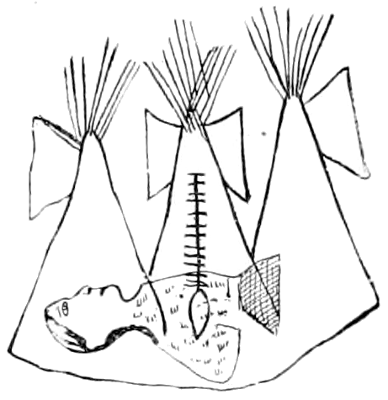
Fig. 788.
Fig. 788.—The Oglalas killed three lodges of Omahas. Cloud-Shield’s Winter Count, 1785-’86. The Omaha is prostrate and scalped.
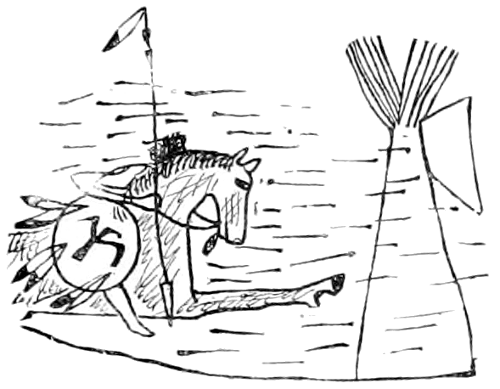
Fig. 789.
Fig. 789.—The Omahas made an assault on a Dakota village. Cloud-Shield’s Winter Count, 1802-’03. Bullets are flying back and forth. The single rider represents the whole of the troop. He is partially covered by the shield and the horse’s neck, behind which he hangs in a manner common among the Indian horsemen. The ornamented shield with its device of a[562] displayed eagle, and the lance with eagle feather for a pennon, recalls the equipments of chivalry.
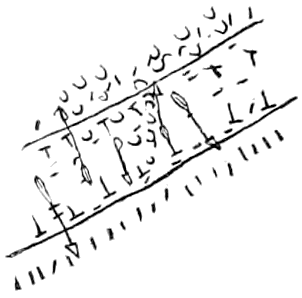
Fig. 790.
Fig. 790.—The Dakotas and Pawnees fought on the ice on the North Platte river. American-Horse’s Winter Count, 1836-’37. The Dakotas were on the north side (the right-hand side in the figure), the Pawnees on the south side (the left in the figure). Horsemen and footmen on the left are opposed to footmen on the right. Both sides have guns and bows, as shown by the bullet-marks and the arrows. Blood-stains are on the ice.
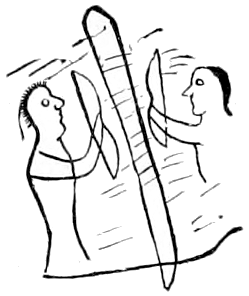
Fig. 791.
Fig. 791.—The Dakotas fought the Pawnees across the ice on the North Platte. Cloud-Shield’s Winter Count, 1836-’37. The man on the left is a Pawnee. This is a variant of the preceding figure, far less graphically expressed.
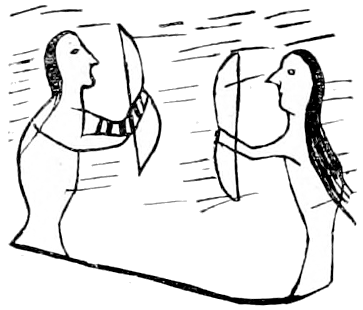
Fig. 792.
Fig. 792.—The Dakotas fought with the Cheyennes. Cloud-Shield’s Winter Count, 1834-’35. The stripes on the arm are for Cheyenne, as before explained.
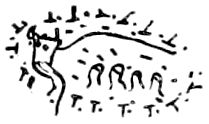
Fig. 793.
Fig. 793.—White-Bull and thirty other Oglalas were killed by the Crows and Shoshoni. American-Horse’s Winter Count, 1845-’46.
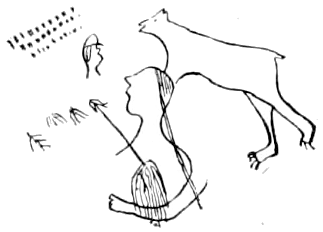
Fig. 794.
Fig. 794.—Mato-wayuhi, Conquering-Bear, was killed by white soldiers, and thirty white soldiers were killed by the Dakotas, 9 miles below Fort Laramie. American-Horse’s Winter Count, 1854-’55. The thirty black dots in three lines stand for the soldiers, and a red stain at the end of the line, starting from the pictured discharge of a gun, means killed. The head covered[563] with a fatigue cap further shows the soldiers were white. Indian soldiers are usually represented in a circle or semicircle. The gesture-sign for white soldier means “all in line,” and is made by placing the nearly closed hands, with palms forward and thumbs near together, in front of the body and then separating them laterally about 2 feet.
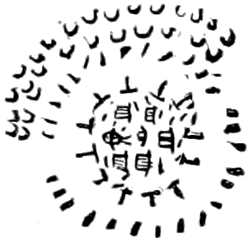
Fig. 795.
Fig. 795.—The Dakotas killed one hundred white men at Fort Phil. Kearny. American-Horse’s Winter Count, 1866-’67. The hats and the cap-covered head represent the whites; the red spots, the killed; the circle of characters around them, rifle or arrow shots; the black strokes, Dakota footmen; and the hoof-prints, Dakota horsemen. The Phil. Kearny massacre occurred December 21, 1866, and eighty-two whites were killed, including officers, citizens, and enlisted men. Capt. W. J. Fetterman was in command of the party.
Dr. Charles E. McChesney, acting assistant surgeon, U. S. Army, has communicated a most valuable and unique account, both in carefully noted gesture-signs and in pictographs, of the battle, now much discussed, which was fought in Montana on June 25, 1876, and is popularly but foolishly styled “Custer’s massacre.” If the intended surprise, with the object of killing as many Indians as possible, had been successful instead of being a disastrous defeat, any surviving Indians might with some propriety have spoken of “Custer’s massacre.” The account now presented in one of its forms, was given by Red-Horse, a Sioux chief and a prominent actor in the battle. The form which gives the relation in gesture-signs and shows the syntax of the sign-language perhaps better than any published narrative, will be inserted in a work now in preparation by the present writer to be issued by the Bureau of Ethnology. The narrative, closely translated into simple English, is given below. Accompanying the record of signs are forty-one sheets of manila paper, besides one map of the battle ground, all drawn by Red-Horse, which average 24 by 26 inches, most of them being colored. These may either be considered as illustrations of the signs or the signs may be considered as descriptive of the pictographs. It is impossible to reproduce now this mass of drawing on any scale which would not be too minute for appreciation. It has been decided to present, with necessary reduction from the above-mentioned dimensions, the map and nine of the typical sheets in Pls. XXXIX to XLVIII. Indeed, without considering the space required, there would be small advantage in reproducing all of the sheets, as they are made objectionable by monotonous repetitions.
Here follows the story of Red-Horse. Pl. XXXIX is the map of the[564] Little-Bighorn battlefield and adjacent territory, embracing part of Montana and the Dakotas, drawn at Cheyenne River agency, South Dakota, in 1881. The map as now presented is reduced to one-sixteenth from the original, which is drawn in colors on a sheet of manila paper. The letters were not on the original and are inserted only for reference from the descriptive text, as follows:
a, Wind River mountains, called by the Sioux “the Enemies’ mountains.”
b, Bighorn mountains.
c, Missouri river.
d, Yellowstone river.
e, Bighorn river.
f, Little Bighorn river, called by the Sioux Greasy Grass creek and Grass Greasy creek.
g, Indian camp.
h, battlefield.
i, Dry creek.
j, Rosebud river.
k, Tongue river.
l, Powder river.
m, Little Missouri river.
n, Cheyenne river, called by the Sioux Good river. The North and South Forks are drawn but not lettered.
o, Bear butte.
p, Black hills.
q, Cheyenne agency.
r, Moreau or Owl creek.
s, Thin butte.
t, Rainy butte.
u, White butte.
v, Grand or Ree river.
w, Ree village.
x, White Earth river.
y, Fort Buford.
Five springs ago I, with many Sioux Indians, took down and packed up our tipis and moved from Cheyenne river to the Rosebud river, where we camped a few days; then took down and packed up our lodges and moved to the Little Bighorn river and pitched our lodges with the large camp of Sioux.
The Sioux were camped on the Little Bighorn river as follows: The lodges of the Uncpapas were pitched highest up the river under a bluff. The Santee lodges were pitched next. The Oglala’s lodges were pitched next. The Brulé lodges were pitched next. The Minneconjou lodges were pitched next. The Sans Arcs’ lodges were pitched next. The Blackfeet lodges were pitched next. The Cheyenne lodges were pitched next. A few Arikara Indians were among the Sioux (being without lodges of their own). Two-Kettles, among the other Sioux (without lodges). [Pl. XL shows the Indian camp.]
I was a Sioux chief in the council lodge. My lodge was pitched in the center of the camp. The day of the attack I and four women were a short distance from the camp digging wild turnips. Suddenly one of the women attracted my attention to a cloud of dust rising a short distance from camp. I soon saw that the soldiers were charging the camp. [Pl. XLI shows the soldiers charging the Indian camp.] To the camp I and the women ran. When I arrived a person told me to hurry to the council lodge. The soldiers charged so quickly we could not talk (council). We came out of the council lodge and talked in all directions. The Sioux mount horses, take guns, and go fight the soldiers. Women and children mount horses and go, meaning to get out of the way.
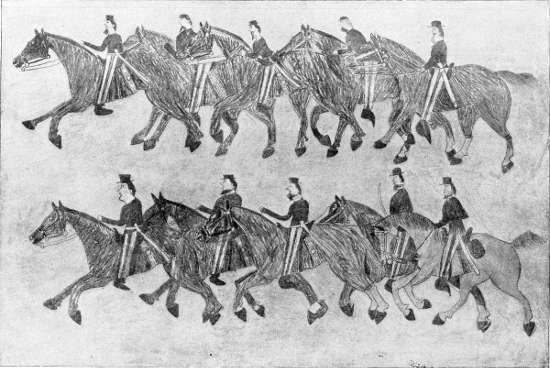
BUREAU OF ETHNOLOGY TENTH ANNUAL REPORT PL. XLI
BATTLE OF LITTLE BIGHORN. SOLDIERS CHARGING INDIAN CAMP.
Among the soldiers was an officer who rode a horse with four white feet. [From Dr. McChesney’s memoranda this officer was Capt. French, Seventh Cavalry.] The Sioux have for a long time fought many brave men of different people, but the Sioux say this officer was the bravest man they had ever fought. I don’t know whether this was Gen. Custer or not. Many of the Sioux men that I hear talking tell me it was. I saw this officer in the fight many times, but did not see his body. It has[565] been told me that he was killed by a Santee Indian, who took his horse. This officer wore a large-brimmed hat and a deerskin coat. This officer saved the lives of many soldiers by turning his horse and covering the retreat. Sioux say this officer was the bravest man they ever fought. I saw two officers looking alike, both having long yellowish hair.
Before the attack the Sioux were camped on the Rosebud river. Sioux moved down a river running into the Little Bighorn river, crossed the Little Bighorn river, and camped on its west bank.
This day [day of attack] a Sioux man started to go to Red Cloud agency, but when he had gone a short distance from camp he saw a cloud of dust rising and turned back and said he thought a herd of buffalo was coming near the village.
The day was hot. In a short time the soldiers charged the camp. [This was Maj. Reno’s battalion of the Seventh Cavalry.] The soldiers came on the trail made by the Sioux camp in moving, and crossed the Little Bighorn river above where the Sioux crossed, and attacked the lodges of the Uncpapas, farthest up the river. The women and children ran down the Little Bighorn river a short distance into a ravine. The soldiers set fire to the lodges. All the Sioux now charged the soldiers [Pl. XLII] and drove them in confusion across the Little Bighorn river, which was very rapid, and several soldiers were drowned in it. On a hill the soldiers stopped and the Sioux surrounded them. A Sioux man came and said that a different party of soldiers had all the women and children prisoners. Like a whirlwind the word went around, and the Sioux all heard it and left the soldiers on the hill and went quickly to save the women and children.
From the hill that the soldiers were on to the place where the different soldiers [by this term Red-Horse always means the battalion immediately commanded by General Custer, his mode of distinction being that they were a different body from that first encountered] were seen was level ground with the exception of a creek. Sioux thought the soldiers on the hill [i. e., Reno’s battalion] would charge them in rear, but when they did not the Sioux thought the soldiers on the hill were out of cartridges. As soon as we had killed all the different soldiers [Pl. XLIII shows the fighting with Custer’s battalion] the Sioux all went back to kill the soldiers on the hill. All the Sioux watched around the hill on which were the soldiers until a Sioux man came and said many walking soldiers were coming near. The coming of the walking soldiers was the saving of the soldiers on the hill. Sioux can not fight the walking soldiers [infantry], being afraid of them, so the Sioux hurriedly left.
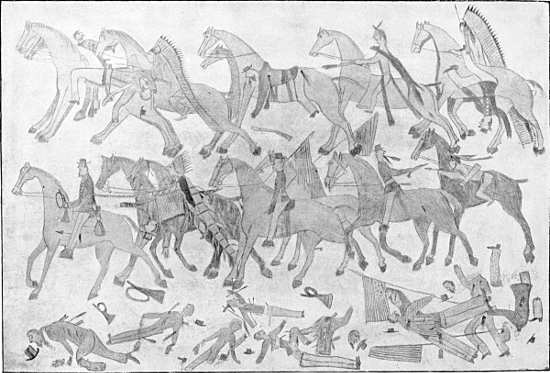
BUREAU OF ETHNOLOGY TENTH ANNUAL REPORT PL. XLIII
BATTLE OF LITTLE BIGHORN. SIOUX FIGHTING CUSTER’S BATTALION.
The soldiers charged the Sioux camp about noon. The soldiers were divided, one party charging right into the camp. After driving these soldiers across the river, the Sioux charged the different soldiers [i. e., Custer’s] below, and drove them in confusion; these soldiers became foolish, many throwing away their guns and raising their hands, saying, “Sioux, pity us; take us prisoners.” The Sioux did not take a single soldier prisoner, but killed all of them; none were left alive for even a few minutes. These different soldiers discharged their guns but little. I took a gun and two belts off two dead soldiers; out of one belt two cartridges were gone, out of the other five.
The Sioux took the guns and cartridges off the dead soldiers and went to the hill on which the soldiers were, surrounded and fought them with the guns and cartridges of the dead soldiers. Had the soldiers not divided I think they would have killed many Sioux. The different soldiers [i. e., Custer’s battalion] that the Sioux killed made five brave stands. Once the Sioux charged right in the midst of the different soldiers and scattered them all, fighting among the soldiers hand to hand.
One band of soldiers was in rear of the Sioux. When this band of soldiers charged, the Sioux fell back, and the Sioux and the soldiers stood facing each other. Then all the Sioux became brave and charged the soldiers. The Sioux went but a short distance before they separated and surrounded the soldiers. I could see the officers riding in front of the soldiers and hear them shouting. Now the Sioux had many[566] killed. [Pls. XLIV and XLV show the dead Sioux.] The soldiers killed 136 and wounded 160 Sioux. The Sioux killed all these different soldiers in the ravine. [Pl. XLVI shows the dead cavalry of Custer’s battalion.]
The soldiers charged the Sioux camp farthest up the river. A short time after the different soldiers charged the village below. While the different soldiers and Sioux were fighting together the Sioux chief said, “Sioux men, go watch the soldiers on the hill and prevent their joining the different soldiers.” The Sioux men took the clothing off the dead and dressed themselves in it. Among the soldiers were white men who were not soldiers. The Sioux dressed in the soldiers’ and white men’s clothing fought the soldiers on the hill.
The banks of the Little Bighorn river were high, and the Sioux killed many of the soldiers while crossing. The soldiers on the hill dug up the ground [i. e., made earthworks], and the soldiers and Sioux fought at long range, sometimes the Sioux charging close up. The fight continued at long range until a Sioux man saw the walking soldiers coming. When the walking soldiers came near the Sioux became afraid and ran away. [Pls. XLVII and XLVIII show the Indians leaving the battle ground.]
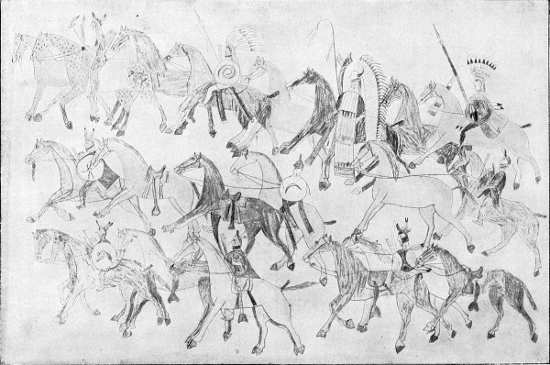
BUREAU OF ETHNOLOGY TENTH ANNUAL REPORT PL. XLVII
BATTLE OF LITTLE BIGHORN. INDIANS LEAVING BATTLE GROUND.
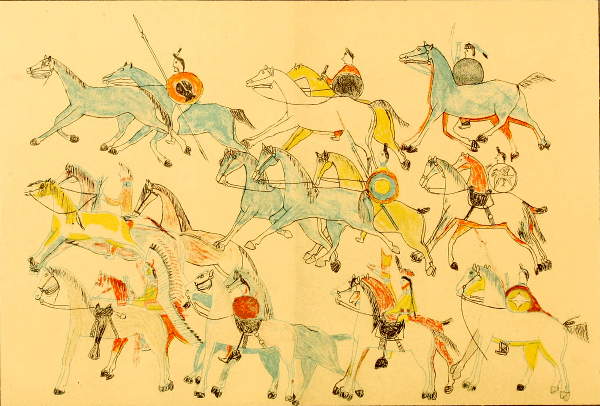
BUREAU OF ETHNOLOGY TENTH ANNUAL REPORT PL. XLVIII
BATTLE OF LITTLE BIG HORN. Indians Leaving Battle Ground.
Fig. 796 is a pictorial account of the migrations of the Ojibwa, being a reduced copy of a drawing made by Sika'ssigĕ'. The account, especially in its commencement, follows the rule of all ancient history in being mixed with religion and myth. The otter was the messenger of Mi'nabō'zho and led the Âni'shinabē'g, who were the old or original people, the ancestors of the Ojibwa, and also of some other tribes which they knew, from an island, which was the imagined center of the world as bounded by the visible horizon, to the last seats of the tribe before interference by Europeans. The details of the figure were thus explained by the draftsman:
a. The circle signifies the earth’s surface, bounded by the horizon, as before described, and the dot in the center is the imagined island or original home of the human race. b. A line separating the history of the Midē'wiwin, that is, the strictly religious tradition from that of the actual migration as follows: When the Otter had offered four prayers, which fact is referred to by the spot c, he disappeared beneath the surface of the water and went toward the west, in which direction the Âni'shinabég followed him, and located at Ottawa island, d. Here they erected the Midē'wigân and lived for many years. Then the Otter again disappeared beneath the water, and it a short time reappeared at A'wiat'ang (e), when the Midē'wiwin was again erected and the sacred rites conducted in accordance with the teachings[567] of Mi'nabō'zho. Afterwards an interrupted migration was continued, the several resting places being given below in their proper order, and at each of them the rites of the Midē'wiwin were conducted in all their purity. The next place to locate at was Mi'shenama'kinagung—Mackinaw (f); then Ne'mikung (g); Kiwe'winang' (h); Bâ'wating—Sault Ste. Marie (i); Tshiwi'towi' (j); Nega'wadjĕ'ŭ—Sand mountain (k), northern shore of Lake Superior; Mi'nisa'wik [Mi'nisa'bikkăng]—Island of Rocks (l); Kawa'sitshĭŭwongk'—Foaming rapids (m); Mush'kisi'wi [Mash'kisi'bi]—Bad river (n); Sha'gawâ'mikongk—“Long sand bar beneath the surface” (o); Wikwe'dânwong'gan—Sandy bay (p); Neâ'shiwĭkongk'—Cliff point (q); Neta-wa-ya-sink—Little point of sand bar (r); Ân'nibis—Little elm tree (s); Wikup'bin-minsh—Little island basswood (t); Makubin'-minsh—Bear island (u); Shage'skike'-dawan'ga (v); Ne'wigwas'sikongk—The place where bark is peeled (w); Ta'pakwe'-ĭkak [Sa'apakwe'shkwa'okongk]—The place where lodge-bark is obtained (x); Ne'uwesak'kudĕze'bi [Ne'wisak'udĕsi'bi]—Point dead wood timber river (y); Anibi'kanzi'bĭ [modern name Ashkiba'gisi'bĭ] rendered by different authorities both as Fish Spawn river, and “Green Leaf river” (z).
This locality is described as being at Sandy lake, Minnesota, where the Otter appeared for the last time, and where the Midē'wigân was finally established. The Ojibwa say that they have dispersed in bands from La Pointe, as well as from Sandy lake, over various portions of Minnesota and into Wisconsin, which final separation into distinct bodies has been the chief cause of the gradual changes found to exist in the ceremonies of the Midē'wiwin.
Reference may be made to a highly interesting record of migration in Kingsborough, Codex Boturini, being a facsimile of an original Mexican hieroglyphic painting from the collection of Boturini, in twenty-three plates.
In this group are presented some figures from the Dakota Winter Counts, which record events of tribal or intertribal importance not included under other heads.
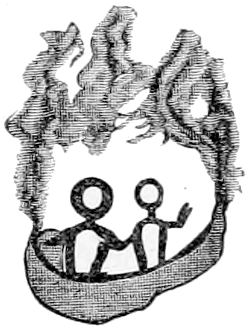
Fig. 797.—Origin of Brulé Dakota.
Fig 797.—The-people-were-burnt winter. Battiste Good’s Winter Count 1762-’63. He explains the origin of the title “Brulé” Dakota as follows:
Some of the Dakotas were living east of their present country, when a prairie fire destroyed their entire village. Many of their children and a man and his wife, who were on foot some distance away from the village, were burned to death. Many of their horses were also burned to death. All the people that could get to a long lake which was near by saved themselves by jumping into it. Many of these were badly burned about the thighs and legs, and this circumstance gave rise to the name, si-can-gu, translated properly in to English as Burnt Thigh and by the French abbreviated as Brulé, by which latter name they have since been generally known.
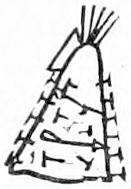
Fig. 798.—Kiyuksas.
Fig. 798.—The Oglalas engaged in a drunken brawl, which resulted in a division of the tribe, the Kiyuksas (Cut-Offs) separating from the others. American-Horse’s Winter Count, 1841-’42.
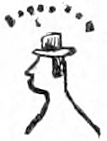
Fig. 799.—First coming of traders.
Fig. 799.—Nine white men came to trade with the Dakotas. American-Horse’s Winter Count, 1800-’01.
The hatted head stands for a white man and also indicates that the eight dots over it are for white men. According to this count the first whites came in 1794-’95, and the party now depicted succeeded them and were the first traders.
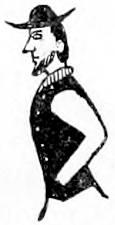
Fig. 800.—First coming of traders.
Fig. 800.—The Good-White-Man came. Cloud-Shield’s Winter Count, 1800-’01.
He was the first white man to trade and live with that division of the Dakotas of which Cloud-Shield’s chart gives the early records.
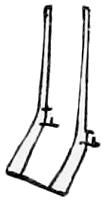
Fig. 801.—First coming of traders.
Fig. 801.—A trader brought the Dakotas their first guns. Cloud-Shield’s Winter Count, 1801-’02.
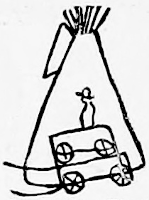
Fig. 802.—First coming of traders.
Fig. 802.—The Dakotas saw wagons for the first time. Red-Lake, a white trader, brought his goods in them. American-Horse’s Winter Count, 1830-’31.
The earliest traders came by the river, in boats.
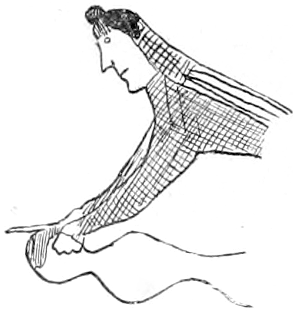
Fig. 803.—Boy scalped.
Fig. 803.—Some Crows came to the Dakota camp and scalped a boy. Cloud-Shield’s Winter Count, 1862-’63.
This is represented also in the next figure.
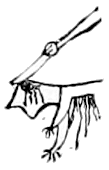
Fig. 804.—Boy scalped alive.
Fig. 804.—The Crows scalped an Oglala boy alive. American-Horse’s Winter Count, 1862-’63.
This unusually cruel outrage renewed the violence of warfare between Dakota and Absaroka.
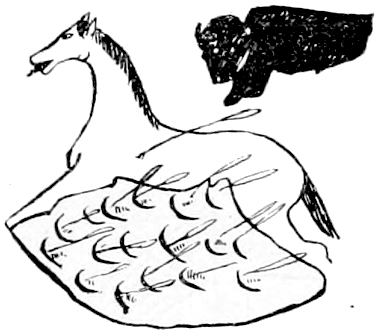
Fig. 805.—Horses killed.
Fig. 805.—All of Standing Bull’s horses were killed. Cloud-Shield’s Winter Count, 1832-’33.
Hoof-prints, blood-stains, and arrows are shown under the horse. It may be remarked with regard to the name-device for Standing-Bull, that the quadruped can stand on two legs, but cannot run or even walk with that limitation, so that the exhibition of two legs only may properly signify standing, though for convenience the fore legs are depicted.
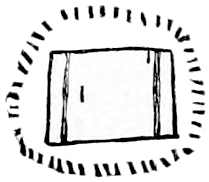
Fig. 806.—Annuities received.
Fig. 806.—They received their first annuities at the mouth of Horse creek. American-Horse’s Winter Count, 1851-’52.
A one-point blanket is depicted and denotes dry goods. It is surrounded by a circle of marks which represent the people.
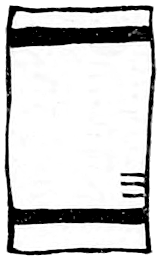
Fig. 807.—Annuities received.
Fig. 807.—Many goods were issued to the Dakotas at Fort Laramie. Cloud-Shield’s Winter Count, 1851-’52.
The goods were the first they received from the United States Government. The blanket which is represented stands for the whole issue.
White-Cow-Killer calls it “Large-issue-of-goods-on-the-Platte-river-winter.”
This is a more conventionalized form of the preceding figure.
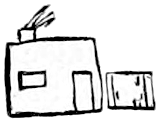
Fig. 808.—Annuities received.
Fig. 808.—The Dakotas received annuities at Raw-Hide Butte. American-Horse’s Winter Count, 1856-’57.
The house and the blanket represent the agency and the goods.
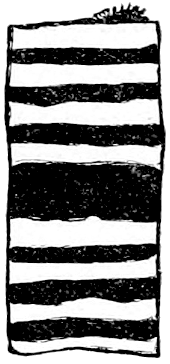
Fig. 809.—Mexican blankets bought.
Fig. 809.—The Dakotas bought Mexican blankets of John Richard, who bought many wagon-loads of the Mexicans. Cloud-Shield’s Winter Count, 1858-’59.
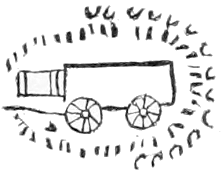
Fig. 810.—Wagon Captured.
Fig. 810.—They captured a train of wagons near Tongue river. The men who were with it got away. American-Horse’s Winter Count, 1867-’68.
The blanket protruding from the front of the wagon represents the goods found in the wagons.
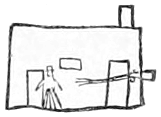
Fig. 811.—Clerk killed.
Fig. 811.—The Oglalas killed the Indian agent’s (Seville’s) clerk inside the stockade of the Red Cloud agency at Fort Robinson, Nebraska. American-Horse’s Winter Count, 1873-’74.
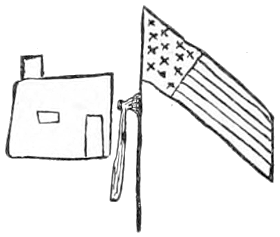
Fig. 812.—Flag staff cut down.
Fig. 812.—The Oglalas at the Red Cloud agency, near Fort Robinson, Nebraska, cut to pieces the flagstaff which had been cut and hauled by order of their agent, but which they would not allow him to erect, as they did not wish to have a flag flying over their agency. American-Horse’s Winter Count, 1874-’75.
This was in 1874. The flag which the agent intended to hoist was lately at the Pine ridge agency, Dakota.
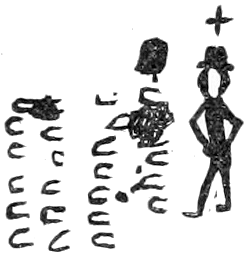
Fig. 813.—Horses taken.
Fig. 813.—Horses taken by United States government. The Flame’s Winter Count, 1876-’77.
This figure refers to the action of the military authorities of the United States toward the Indian tribes which had been connected with or suspected of favoring the outbreak which resulted in the defeat of the force under Gen. Custer. A body of troops swept the reservations on the Missouri river and took away all the ponies of the tribes, thereby depriving them of their means of transportation for hostile purposes. The hatted man with a star above his head is the brigadier-general in command of the United States forces. The hoof prints without marks of horseshoes indicate the Indian ponies as usual. The black blurs among them probably refer to the considerable number of the ponies that fell and died before they reached Bismark and other points of sale to which they were driven. It was promised that the amount realized from the sale of the drove should be returned to the owners, but the latter received little.
Pictographs under this head may be grouped as: 1st. Continuous record of events in life. 2d. Particular exploits or events. Pictographs of both of these descriptions are very common. An excellent collection is published in the George Catlin Indian Gallery in the U. S. National Museum, with memoir and statistics by Thomas Donaldson, a part of the Smithsonian Report for 1885, Pls. 100 to 110.
An authentic and distinct example of a continuous record is the following “autobiography,” which was prepared at Grand River, Dakota, in 1873, in a series of eleven drawings, by Running-Antelope, chief of the Uncpapa Dakotas. Seven of these, regarded as of most interest, are now presented. The sketches were painted in water colors and were made for Dr. W. J. Hoffman, to whom the following interpretations were given by the artist.
The record comprises the most important events in the life of Running-Antelope as a warrior. Although frequently more than one person is represented as slain, it is not to be inferred that all included in the same figure were killed at one time unless it is so specified, but that thus they were severally the victims of one expedition, of which the warrior was a member or leader. The bird (Falco cooperi?) upon the[572] shield always borne by him, refers to the clan or band totem, while the antelope always drawn beneath the horses, in the act of running, identifies his personal name.
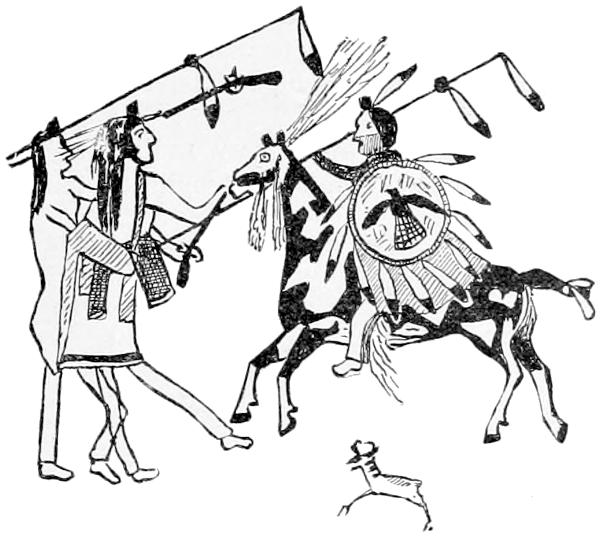
Fig. 814.—Killed two Arikara.
Fig. 814.—Killed two Arikara Indians in one day. The lance held in the hand, thrusting at the foremost of the enemy, signifies that Running-Antelope killed him with that weapon; the left-hand figure was shot, as is shown by the discharging gun, and afterwards struck with the lance. This occurred in 1853.
Fig. 815.—Shot and scalped an Arikara Indian in 1853. It appears that the Arikara attempted to inform Running-Antelope of his being unarmed, as the right hand is thrown outward with distended fingers, in imitation of making the gesture for negation, having nothing.
Fig. 816.—Killed ten men and three squaws in 1856. The grouping of persons strongly resembles the ancient Egyptian method of drawing.
Fig. 817.—Killed two Arikara chiefs in 1856. Their rank is shown by the appendages to the sleeve and coat, which are made of white weasel skins. The arrow in the left thigh of the victor shows that he was wounded. The scars remained distinct upon the thigh of Running-Antelope, showing that the arrow had passed through it.
Fig. 818.—Killed one Arikara in 1857. Striking the enemy with a bow is considered the greatest insult that can be offered. See for a similar concept among the eastern Algonquians (Leland, b). The act entitles the warrior to count one coup when relating his exploits in the council chamber.
Fig. 819.—Killed two Arikara hunters in 1859. Both were shot, as is indicated by the figure of a gun in contact with each Indian. The cluster of lines drawn across the body of each victim represents the discharge of the gun, and shows where the ball took effect. The upper one of the two figures was in the act of shooting an arrow when he was killed.
Fig. 820.—Killed five Arikara in one day in 1863. The dotted line indicates the trail which Running-Antelope followed, and when the Indians discovered that they were pursued, they took shelter in an isolated[575] copse of shrubbery, where they were killed at leisure. The five guns within the inclosure represent the five persons armed.
The Arikara are nearly always delineated in these pictures wearing the topknot of hair, a fashion specially prevalent among the Absaroka, though as the latter were the most inveterate enemies of the Sioux, and as the word Palláni for Arikara is applied to all enemies, the Crow custom may have been depicted as a generic mark.
Wiener (e) gives the following account of the tablet found at Mansiche, reproduced as Fig. 821, one-fifth actual size:
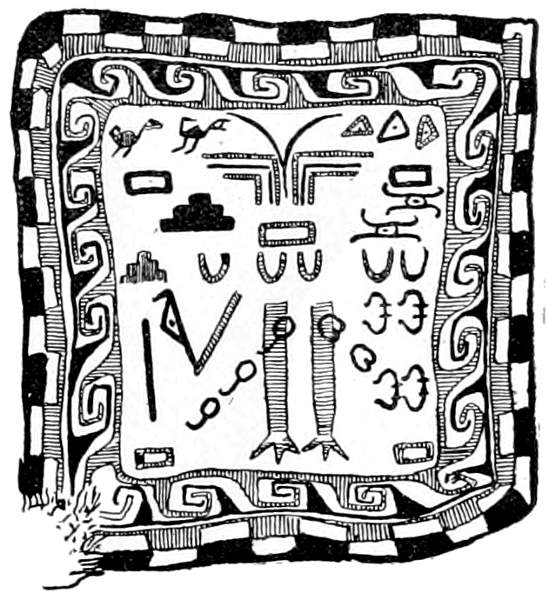
Fig. 821.—Peruvian biography.
It gives all the descriptive elements of the life of the deceased; in fact his biography. He was a chieftain of royal blood (vide the red planache with five double plumes). He commanded an entire tribe. He had a military command (v. the mace which he holds in his right hand). He had taken part in three battles (v. the three arms which three times proved his strength). He was a judge in his district (v. the sign of the speaking-trumpet in the center). He had under him four judges (v. the four signs of the speaking-trumpet in the corners). He had during his administration irrigated the country (v. the designs which surround the painting); and he had constructed great buildings (v. the checkers surrounding the meanders). He had busied himself besides all that in the raising of cattle (v. the indications of llamas). He had lived 42 years (v. the blocks, which indicate years, just as the rings indicate the age of trees). He had had five children, three sons and two daughters (indicated by the little drops of sperm). Such is the life of this person, written by ideography on a tablet, which at first would be taken as a fantasy of an infant painter.
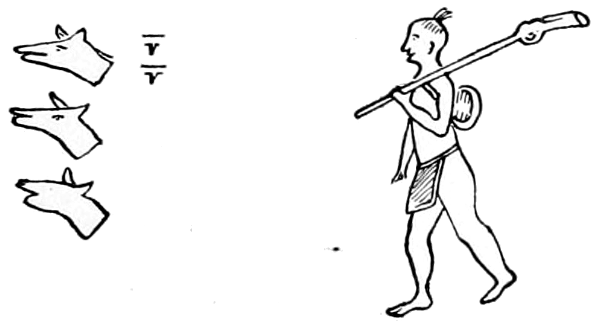
Fig. 822.—Hunting record. Iroquois.
In the Doc. Hist. N. Y. (b) is an illustration, presented here as Fig. 822, of an Iroquois “returning from hunting, who has slept two nights on the hunting ground and killed three does; for when they are bucks they add their antlers.”
From the same volume, page 9, the following extract is made, describing Fig. 823:
b. This is the way they mark when they have been to war, and when there is a bar extending from one mark to the other it signifies that, after having been in battle, he did not come back to his village, and that he returned with other parties whom he met or formed.
c. This arrow, which is broken, denotes that they were wounded in this expedition.
d. Thus they denote that the belts which they gave to raise a war party and to avenge the death of some one, belonging to them or to some of the same tribe.
e. He has gone back to fight without having entered his village.
f. A man whom he killed on the field of battle, who had a bow and arrow.
g. These are two men, whom he took prisoners, one of whom had a hatchet and the other a gun in his hand.
gg. This is a woman who is designated only by a species of waistcloth.
Fig. 824 is taken from the Winter Count of Battiste Good for the year 1853-’54.
He calls the year Cross-Bear-died-on-the-hunt winter.
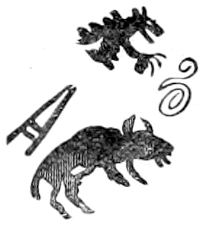
Fig. 824.—Cross-Bear’s death.
The character on the extreme left hand is a “travail,” and means they moved; the buffalo, to hunt buffalo; the bear with mouth open and paw advanced, cross-bear. The involute character frequently repeated in Battiste’s record signifies pain in the stomach and intestines, resulting in death. In this group of characters there is not only the brief story, an obituary notice, but an ideographic mark for a particular kind of death, a noticeable name-totem, and a presentation of the Siouan mode of transportation.
The word “travail” may require explanation. It refers to the peculiar sledge which is used by many tribes of Indians for the purpose of transportation. It is used on the surface of the ground when not covered with snow even more than when snow prevails. In print the word is more generally found in the plural, where it is spelled “travaux”[577] and sometimes “travois.” The etymology of this word has been the subject of much discussion. It is probably one of the words which descended in corrupted form from the language of the Canadian voyageurs, and was originally the French word “traineau,” with its meaning of sledge. The corrupt form “travail” was retained by English speakers from its connection with the sound of the word “travel.”
Fig. 825 is taken from a roll of birch bark, known to be more than seventy years old, obtained in 1882 from the Ojibwa Indians at Red Lake, Minnesota. The interpretation was given by an Indian from that reservation, although he did not know the author nor the history of the record. With one exception, all of the characters were understood and interpreted to Dr. Hoffman, in 1883, by Ottawa Indians at Harbor Springs, Michigan.
a represents the Indian who visited a country supposed to have been near one of the great lakes. He has a scalp in his hand which he obtained from the head of an enemy, after having killed him. The line from the head to the small circle denotes the name of the person, and the line from the mouth to the same circle signifies (in the Dakota method), “That is it,” having reference to proper names.
b, the enemy killed. He was a man who held a position of some consequence in his tribe, as is indicated by the horns, marks used by the Ojibwas among themselves for shaman, wabeno, etc. It has been suggested that the object held in the hand of this figure is a rattle, though the Indians, to whom the record was submitted for examination, are in doubt, the character being indistinct.
c, three disks connected by short lines signify, in the present instance,[578] three nights, i. e., three black suns. Three days from home was the distance the Indian a traveled to reach the country for which he started.
d represents a shell, and denotes the primary object of the journey. Shells were needed for making ornaments and to trade, and traffic between members of the different and even distant tribes was common, although attended with danger.
e, two parallel lines are here inserted to mark the end of the present record and the beginning of another.
The following narrative of personal exploit was given to Dr. W. J. Hoffman by “Pete,” a Shoshoni chief, during a visit of the latter to Washington, in 1880. The sketch, Fig. 826, was drawn by the narrator, who also gave the following explanation of the characters:
a, Pete, a Shoshoni chief; b, a Nez Percés Indian, one of the party from whom the horses were stampeded, and who wounded Pete in the side with an arrow; c, hoof-marks, showing course of stampede; d, lance, which was captured from the Nez Percés; e, e, e, saddles captured; f, bridle captured; g, lariat captured; h, saddle-blanket captured; i, body-blanket captured; j, pair of leggings captured; k, three single legs of leggings captured.
The figures in the following group represent some of the particular exploits and events in life which have been considered by the recorders of the Winter Counts of the Dakotas to be specially worthy of note:
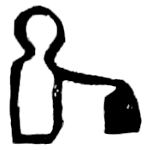
Fig. 827.—Life risked for water.
Fig. 827.—While surrounded by the enemy (Mandans) a Blackfeet Dakota Indian goes at the risk of his life for water for the party. The-Flame’s Winter Count, 1795-’96. The interpreter stated that this was near the present Cheyenne agency, Dakota. In the original character there is a bloody wound at the shoulder,[579] showing that the heroic Indian was wounded. He is shown bearing a water vessel.
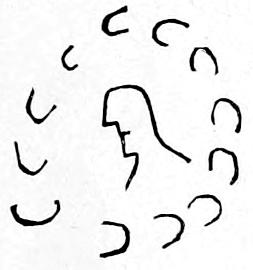
Fig. 828.—Runs by the enemy.
Fig. 828.—Runs-by-the-Enemy. Red-Cloud’s Census. This figure suggests a feat of special courage and fleetness in making a circuit of a hostile force.
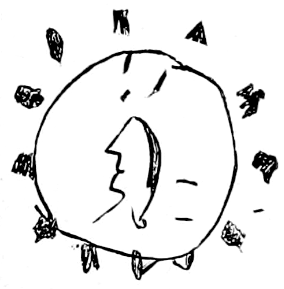
Fig. 829.—Runs around.
Fig. 829.—Runs-Around. Red-Cloud’s Census. This figure seems to indicate a warrior surrounded and shot at by a number of enemies, who yet escapes by his swiftness.
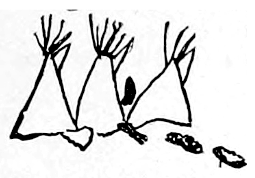
Fig. 830.—Goes through the camp.
Fig. 830.—Goes-through-the-Camp. Red-Cloud’s Census. This figure notes the successful passage of a spy through the enemy’s camp.
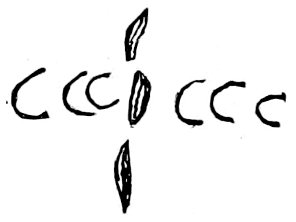
Fig. 831.—Cut through.
Fig. 831.—Cut-Through. Red-Cloud’s Census. Here a footman cuts his way through a line of hostile horsemen.
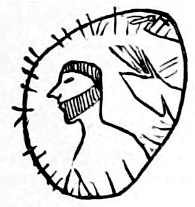
Fig. 832.—Killed in tipi.
Fig. 832.—Paints-His-Face-Red, a Dakota, was killed in his tipi by the Pawnees. Cloud-Shield’s Winter Count, 1837-’38. The right to paint the face red was sometimes gained by providing the ceremonial requirements for a commemoration of the dead, which were very expensive. There are two facts depicted by the figure. The man and his tipi are surrounded by a ring of enemies, who are shooting him, and, touched by the upper part of the ring, is the bottom of another and more minute tipi, marked with the sign of a fatal shot.
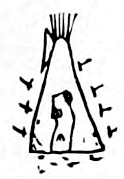
Fig. 833.—Killed in tipi.
Fig. 833.—Paints-His-Cheeks-Red and his family, who were camping by themselves, were killed by Pawnees. American-Horse’s Winter Count, 1837-’38. This character tells the same story as the one preceding, but is more conventional.
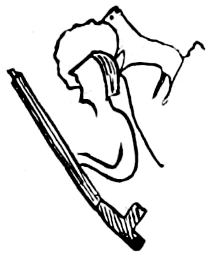
Fig. 834.—Took the warpath.
Fig. 834.—Spotted-Horse carried the pipe around and took the warpath against the Pawnees to avenge the death of his uncle, Paints-His-Cheeks-Red. American-Horse’s Winter Count, 1838-’39. This figure is the sequel to those immediately preceding.
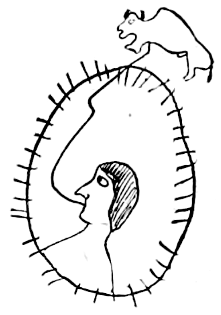
Fig. 835.—White-Bull killed.
Fig. 835.—White-Bull and many others were killed in a fight with the Shoshoni. Cloud-Shield’s Winter Count, 1845-’46. This warrior seems to have lost more than the normal quantity of scalp.
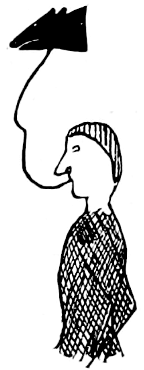
Fig. 836.—Brave-Bear killed.
Fig. 836.—Brave-Bear was killed in a quarrel over a calf. Cloud-Shield’s Winter Count, 1854-’55. He was killed by enemies; hence his scalp is gone.
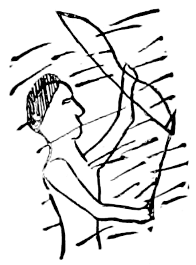
Fig. 837.—Brave-Man killed.
Fig. 837.—The-Brave-Man was killed in a great fight. Cloud-Shield’s Winter Count, 1817-’18. The fight is shown by the arrows flying to and from him. He is also scalped.
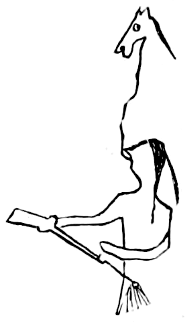
Fig. 838.—Crazy-Horse killed.
Fig. 838.—A soldier ran a bayonet into Crazy-Horse and killed him. American-Horse’s Winter Count, 1877-’78. This was done in the guard-house at Fort Robinson, Nebraska, September 5, 1877. The horse in this instance does not distinctly exhibit the wavy lines shown in several other representations of the chief which appear among the illustrations of this paper. This omission is doubtless due to carelessness of the Indian artist.
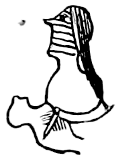
Fig. 839.—Killed for whipping wife.
Fig. 839.—Striped-Face stabbed and killed his daughter’s husband for whipping his wife. American-Horse’s Winter Count, 1829-’30.
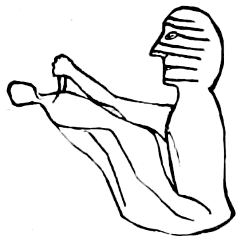
Fig. 840.—Killed for whipping wife.
Fig. 840.—Spotted-Face stabs his daughter’s husband for whipping his wife. Cloud-Shield’s Winter Count, 1829-’30. This is another form of the preceding figure.
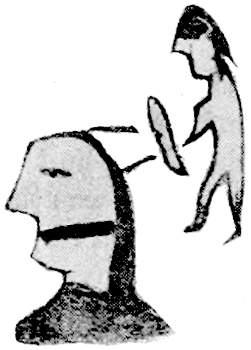
Fig. 841.
Fig. 841.—Kaglala-kutepi, Shot-Close. The Oglala Roster. This may refer to an incident in the warrior’s life in which he had a narrow escape, or may, on the other hand, refer to his stealing upon and shooting from near by at an enemy. The design, as often occurs, allows of double interpretation. The close shooting is not accurate markmanship, but with proximity as suggested by the arrow touching the head while still near the bow. This figure may receive some interpretation from the one following.
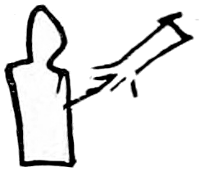
Fig. 842.
Fig. 842.—The-Swan’s Winter Count, 1835-’36. A Minneconjou chief named Lame-Deer shot an Assiniboin three times with the same arrow. He kept so close to his enemy that he never let the arrow slip away from the bow but pulled it out and shot it in again.
Fig. 843 consists of two stories pictured by Lean-Wolf, a Hidatsa chief, showing the attack made by Sioux Indians in search of horses and the result of the raid. In the upper figure, at the left end, is shown the Sioux camp from which the trail of the horse thieves extends to near the camp of the Hidatsa, at Fort Berthold, North Dakota. This village is indicated by the circular dirt lodges within a square inclosure. The Sioux captured some Indian horses and rode away, as indicated by the prints of horse hoofs. A series of short lines from the Hidatsa village indicates that Lean-Wolf and his companions followed on foot, subsequently overtaking the Sioux, killing one and taking his[582] scalp. The scalp is shown above the figure of the human head, while the weapon with which he struck the Sioux is also shown. This is the war club. The lower division of the figure is similar to the upper. In the pursuit of the Sioux, who had come to Fort Berthold on another occasion to steal horses, Lean-Wolf assisted in capturing and killing three of the marauders. In the left-hand group of the three human heads he is shown to have killed an enemy; in the second he was the third to strike a Sioux after he was shot, but took his scalp, and in the third, or right hand, he was the fourth to strike the fallen enemy.
A record on ivory shown as Fig. 844 was obtained by Dr. Hoffman in San Francisco, California, in 1882, and was interpreted to him by an Alaskan native. The story represents the success of a hunt; the animals desired are shown, as well as those which were secured.
The following is the explanation of the characters:
a, b, deer; c, porcupine; d, winter, or permanent, habitation. The cross-piece resting upon two vertical poles constitutes the rack, used for drying fish; e, one of the natives occupying the same lodge with the recorder; f, the hunter whose exploits are narrated; g, h, i, beavers; j, k, l, m, n, martens; o, a weasel, according to the interpretation, although there are no specific characters to identify it as different from the preceding; p, land otter; q, a bear; r, a fox; s, a walrus; t, a seal; u, a wolf.
By comparing the illustration with the text it will be observed that all the animals secured are turned toward the house of the speaker, while the heads of those animals desired, but not obtained, are turned away from it.
The following is the text in the Kiatéxamut dialect of the Innuit language as dictated by the Alaskan, with his own literal translation into English:
Huí-nu-ná-ga | huí-pu-qtú-a | pi-cú-qu-lú-a | mus'-qu-lí-qnut. | Pa-mú-qtu-līt'
I, (from) my place. (settlement.) | I went | hunting | (for) skins. (animals) | martens
ta-qí-mĕn, | a-mí-da-duk' | a-xla-luk', | á-qui-á-muk | pi-qú-a | a-xla-luk';
five, | weasel | one, | land otter | caught | one;
ku-qú-lu-hú-nu-mŭk' | a-xla-luk', | tun'-du-muk | tú-gu-qlí-u-gú | me-lú-ga-nuk',
wolf | one, | deer | (I) killed | two,
pé-luk | pi-naí-u-nuk, | nú-nuk | pit'-qu-ní, | ma-klak-muk' | pit'-qu-ní,
beaver | three, | porcupine | (I) caught none, | seal | (I) caught none,
a-cí-a-na-muk | pit'-qu-ni, | ua-qí-la-muk | pit'-qu-ní, | ta-gú-xa-muk | pit'-qu-ní.
walrus | (I) caught none, | fox | (I) caught none, | bear | (I) caught none.
The imagination is stimulated and developed by the sense of sight more than by any other sense, perhaps more than by all of the other senses combined. The American Indians, and probably all savages, are remarkable for acute and critical vision, and also for their retentive memory of what they have once seen. When significance is once attached to an object seen, it will always be recalled, though often with false deductions. Therefore, like deaf-mutes, who depend mainly on sight, the American Indians have developed great facility in communicating by signs, and also in expressing their ideas in pictures which are ideographic though seldom artistic. This tendency has likewise affected their spoken languages. Their terms express with wonderful particularity the characters and relations of visible objects, and their speeches, which are in a high degree metaphoric, become so by the figurative presentation in words of such objects accompanied generally by imitative signs for them, and often by their bodily exhibition.
The statement once made that the aboriginal languages of North America are not capable of expressing abstract ideas is incorrect, but the tendency to use tangible and visible forms for such ideas is apparent. This practice was most marked in reference to religious subjects, which were often presented under the veil of symbols, as has been the common expedient of most peoples who have emerged from the very lowest known stages of human culture, but have not attained the highest.
Many instances appear in this work in which pictures expressive of an idea present more than mere portraitures of objects, which latter method has been styled imitative or iconographic writing.
It is, however, impossible to classify with scientific precision the pictured ideograms collected, for the reason that many of them occupy intermediate points in any scheme that would be succinct enough to be practically useful. In the arrangement of the present chapter the division is made into: 1st. Abstract ideas expressed pictorially. 2d. Signs, symbols, and emblems. 3d. Significance of colors. 4th. Gesture and posture signs depicted. When any of the graphic representations of ideas have become successful, i. e., commonly adopted, it soon becomes[584] more or less conventionalized. Chapter XIX is devoted specially to that branch of the general subject.
The first stage of picture-writing, as considered in the present chapter, was the representation of a material object in such style or connection as determined it not to be a mere portraiture of that object, but figurative of some other object or person. This stage is abundantly exhibited among the American Indians. Indeed, their personal and tribal names thus objectively represented constitute the largest part of their picture-writing so far thoroughly understood.
The second step was when a special quality or characteristic of an object, generally an animal, became employed to express a general quality, i. e., an abstract idea. It can be readily seen how, among the Egyptians, a hawk with bright eye and lofty flight might be selected to express divinity and royalty, and that the crocodile should denote darkness, while a slightly further advance in metaphors made the ostrich feather, from the equality of its filaments, typical of truth. All peoples whose rulers used special objective designations of their rank, made those objects the signs for power, whether they were crowns or umbrellas, eagle feathers, or colored buttons. A horse meant swiftness, a serpent life—or immortality when drawn as a circle—a dog was watchfulness, and a rabbit was fecundity. It is evident from examples given in the present paper that the American tribes at the time of the Columbian discovery had entered upon this second step of picture-writing, though with marked inequality between tribes and regions in advance therein. None of them appear to have reached such proficiency in the expression of connected ideas by picture, as is shown in the sign-language existing among some of them, which may be accounted for by its more frequent use required by the constant meeting of many persons speaking different languages. There is no more necessary connection between abstract ideas and sounds, the mere signs of thought that strike the ear, than there is between the same ideas and signs addressed only to the eye. The success and scope of either mode of expression depends mainly upon the amount of its exercise, in which oral language undoubtedly has surpassed both sign-language and picture-writing.
The examples now following in this chapter are by no means all the graphic representations of abstract ideas collected. Indeed many others are contained in the work under other headings, but the following are selected for grouping here with an attempt at order. In the popular definition, or want of definition, some of them would be classed as symbols.
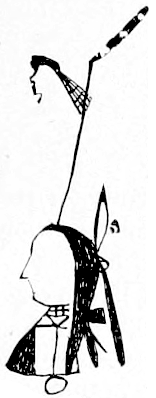
Fig. 845.—Charge after.
Fig. 845.—Charge after; Red-Cloud’s Census.
Here is suggested the order in a charge upon an enemy, apparently a Crow. The concept is not the general charge of a number of warriors upon the Crows, but the succession between themselves of the men who made that charge. The person whose name is represented probably followed in but did not lead some celebrated charge.
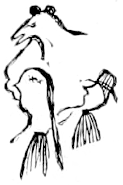
Fig. 846.—Killed after.
Fig. 846.—John Richard shot and killed an Oglala named Yellow-Bear, and the Oglalas killed Richard before he could get out of the lodge; American-Horse’s Winter Count, 1871-’72. This occurred in the spring of 1872. As the white man was killed after the Indian, he is placed behind him in the figure. The bear’s head is shown.
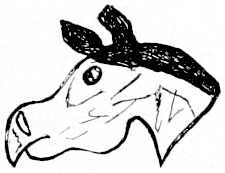
Fig. 847.—Old-Horse.
Fig. 847.—Old-Horse; Red-Cloud’s Census. Here the old age is shown by the wrinkles and projecting lips.
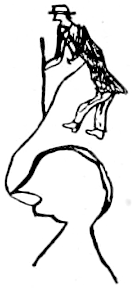
Fig. 848.—Old-Mexican.
Fig. 848.—Old-Mexican; Red-Cloud’s Census. The man in European dress is bent and supported by a staff, thus depicting the gesture-sign mentioned in connection with Fig. 994. The Dakota had probably received his name from killing an aged Mexican.
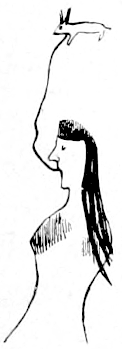
Fig. 849.—Young-Rabbit.
Fig. 849.—Young-Rabbit, a Crow, was killed in battle by Red-Cloud. Cloud-Shield’s Winter Count, 1861-’62. Here the youth of the Rabbit is expressed by diminutive size and short legs.

Fig. 850.—Bad-Boy.
Fig. 850.—Bad-Boy. Red-Cloud’s Census. The boyhood is expressed by the short hair and short scalp lock.
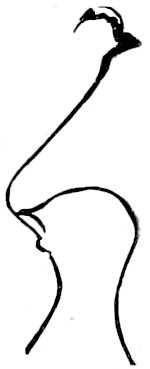
Fig. 851.—Bad-Horn.
Fig. 851.—Bad-Horn. Red-Cloud’s Census. The bad quality of the horn is expressed by its decayed and broken condition and its distorted curve.
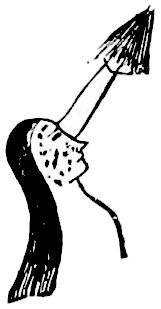
Fig. 852.—Bad-Face.
Fig. 852.—Bad-Face, a Dakota, was shot in the face. Cloud-Shield’s Winter Count, 1794-’95. The bad face may have been broken out with blotches of disease before the shot, or the scars may have been the result of the shot, which gave occasion for a new name, as is common. The idea of “bad” is often expressed by an abnormality, especially one which disfigures.
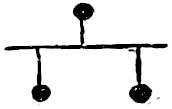
Fig. 853.—Bad. Ojibwa.
Fig. 853, taken from Copway (d), represents “bad.” The concept appears to be the preponderance of “below” to “above.”
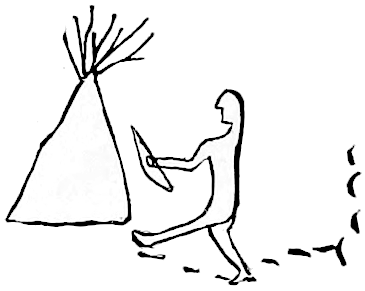
Fig. 854.—Got there first.
Fig. 854.—Got there first. Red-Cloud’s Census. The figure portrays a successful escape of an unmounted Indian from a chase by enemies on horseback. The chased man gets home to his tipi before being overtaken by his pursuers, whose horses’ tracks are shown.

Fig. 855.—Big-Turnip.
Fig. 855.—Big-Turnip. Red-Cloud’s Census. The plant is also known as the navet de prairie. The large size of the specimen, as compared with the human head, is apparent.
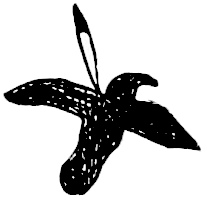
Fig. 856.—Big-Crow.
Fig. 856.—A Minneconjou Dakota, named Big-Crow, was killed by the Crow Indians. Swan’s Winter Count, 1859-’60. He had received his name from killing a Crow Indian of unusual size. The bird is portrayed much larger than similar objects in the Winter Count, from which it is taken.

Fig. 857.—Grasp.
Fig. 857.—Grasp. Red-Cloud’s Census. Here the indication of size and strength of the hand is suggested by one[587] hand growing out from another, a species of duplication. To have drawn two distinct hands would only have been normal and not suggestive of unusual power of grip.
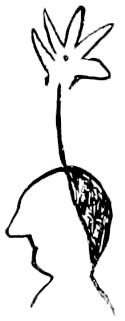
Fig. 858.—Big-Hand.
Fig. 858.—Big-Hand. From Red-Cloud’s Census. Here the fingers are widely separated and displayed.
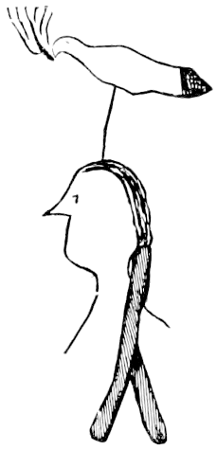
Fig. 859.—Big-Thunder.
Fig. 859.—Big-Thunder. From Red-Cloud’s Census. Here the size or power is suggested by implication. The double or two-voiced thunder is big thunder.
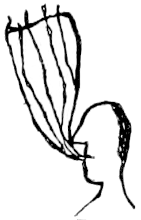
Fig. 860.—Big-Voice.
Fig. 860.—Big-Voice. From Red-Cloud’s Census. In this figure there are still more voices than in the preceding.
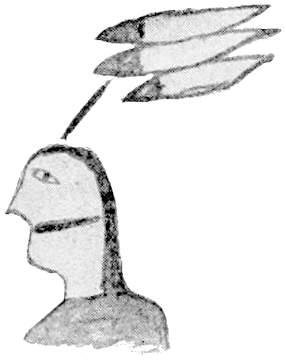
Fig. 861.—Center-Feather.
Fig. 861.—Upi-Yaslate. Center-Feather. The Oglala Roster. This is the indication of a particular feather, i. e., the middle tail feather of a bird, probably of an eagle, the tail feathers of which bird are represented in many pictographs in this paper. There was some reason for the selection of the center feather for the name, and to indicate the center three feathers were depicted with a line touching the middle one.
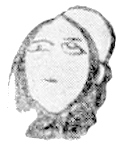
Fig. 862.—Deaf-Woman.
Fig. 862.—Wi-nugin-kpa, Deaf-Woman. The Oglala Roster. The ears are covered by a line, i. e., are closed, and the ear most in view is connected with the crown of the head, to show that the name is expressed.
This title has been selected as being the most comprehensive one for the five following figures. The first shows a moccasin with a serpentine track, at the farthest end of which is an angular design, indicating leadership as well as the direction taken. This suggests the leader of a war party conducting his band over an uncertain trail. The second is explanatory of the first. That the chief goes in front is indicated in a manner the reverse of that which would appear in the designs common in our military text-books. He is supposed to be in the opening in the angle of the advance and not at its apex. The third figure shows a steadfast leadership in the determined straight direction of attack against the enemy. This is still more ideographically represented by the single strong straight line showing that he “Don’t turn” in the fourth figure of this group.

Fig. 863.—Direction.
Fig. 863.—Warrior. Red-Cloud’s Census. The name does not give any idea of the design.
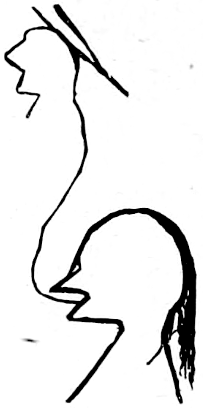
Fig. 864.—Goes-in-Front.
Fig. 864.—Goes-in-Front. Red-Cloud’s Census.
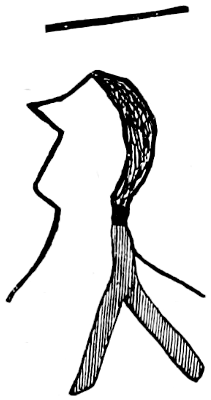
Fig. 865.—Don’t-turn.
Fig. 865.—Don’t-turn. Red-Cloud’s Census. This means that the warrior don’t—that is, won’t—turn from his direct course.
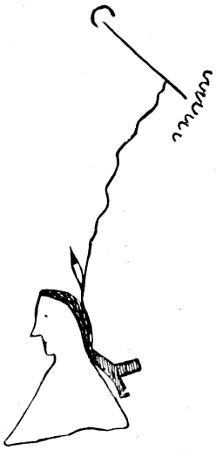
Fig. 866.—Don’t-turn.
Fig. 866.—Don’t-turn. Red Cloud’s Census. This figure is a variant of the last, and a body of mounted men following the leader, all on horseback as shown by the lunules.
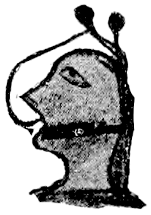
Fig. 867.—Returning Scout.
Fig. 867.—Tunweya-gli, Returning-Scout. The Oglala Roster. The returning is ingeniously represented by the line curving backward and returning to the point of starting. The two balls above the head are simply two fixed points, which establish the course of the line.
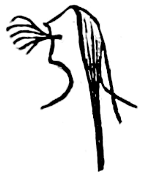
Fig. 868.—Whooping cough.
Fig. 868.—Many had the whooping cough. American-Horse’s Winter Count, 1813-’14. The cough is represented by the lines issuing from the man’s mouth, but the characteristics of the disease are better expressed in the three charts of the Lone-Dog system, Figs. 196, 197, and 198.

Fig. 869.—Measles.
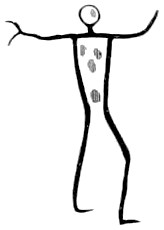
Fig. 870.—Measles or smallpox.
Fig. 869.—All the Dakotas had measles, very fatal. Swan’s Winter Count, 1818-’19. Battiste Good says: “Smallpox-used-them-up-again winter.” They, i. e., the Dakotas, at this time lived on the Little White river, about 20 miles above the Rosebud agency. The character in Battiste Good’s chart is presented here in Fig. 870 as a variant.

Fig. 871.—Ate buffalo and died.
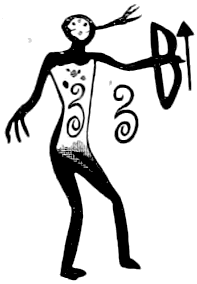
Fig. 872.—Died of “whistle.”
Fig. 871.—Dakota war party ate a buffalo and all died. Swan’s Winter Count, 1826-’27. Battiste Good calls the same year, “Ate-a-whistle-and-died winter,” Fig. 872, and explains that six Dakotas on the warpath had nearly perished with hunger, when they found and ate the rotting carcass of an old buffalo, on which the wolves had been feeding. They were seized soon after with pains in the stomach, their bellies swelled, and gas poured from the mouth and the anus, and they “died of a whistle,” or from eating a whistle. The sound of gas escaping from the mouth is illustrated in the figure. The character on the abdomen and on its right may be considered to be the ideograph for pain in that part of the body.

Fig. 873.—Smallpox.
Fig. 873.—Many people died of smallpox. Cloud-Shield’s Winter Count, 1782-’83. The charts all record two successive winters of smallpox, but American-Horse makes the first year of the epidemic one year later than that of Battiste Good, and Cloud-Shield makes it two years later.

Fig. 874.—Smallpox.
Fig. 874.—Many died of smallpox. American-Horse’s Winter Count, 1780-’81. Here the smallpox marks are on the face and neck of a Dakota, as indicated by the arrangement of the hair.
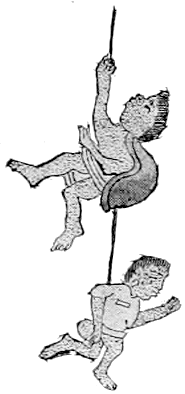
Fig. 875.—Smallpox. Mexican.
Kingsborough (e) explains Fig. 875 by these words in the text: “In the year of Seven Rabbits, or in 1538, many of the people died of the smallpox.” This may be compared with the two preceding figures.
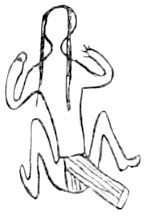
Fig. 876.—Died of cramps.
Fig. 876.—Many died of the cramps. American-Horse’s Winter Count, 1849-’50. The cramps were those of Asiatic cholera, which was epidemic in the United States at that time, and was carried to the plains by the California and Oregon emigrants. The position of the man is very suggestive of cholera.
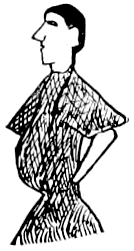
Fig. 877.—Died in childbirth.
Fig. 877.—Many women died in childbirth. Cloud-Shield’s Winter Count, 1798-’99.

Fig. 878.—Died in childbirth.
Fig. 878.—Many women died in childbirth. American-Horse’s Winter Count, 1792-’93.

Fig. 879.—Sickness. Ojibwa.
Fig. 879, from Copway (e), represents sickness. It evidently refers to the loss of flesh consequent thereon. The sick man is a European.

Fig. 880.—Sickness. Chinese.
Edkins (a) gives Fig. 880 as “sickness,” and calls it a picture of a sick man leaning against a support. All words connected with diseases are arranged under this head.
The following figures clearly indicate rapidity of motion:
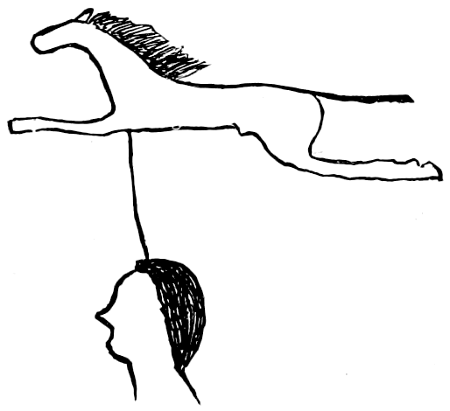
Fig. 881.—Fast-Horse.
Fig. 881.—Fast-Horse. Red-Cloud’s Census.
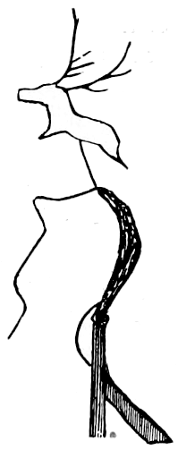
Fig. 882.—Fast-Elk.
Fig. 882.—Fast-Elk. Red-Cloud’s Census.
The following ideograms for the concept of fear show respectively an elk, a bear, and a bull surrounded by a circle of hunters. It would seem that the latter were supposed to be afraid to attack the animals when at bay in hand-to-hand fight, but stood off in a circle until they had killed the enraged beast, or at least wounded it sufficiently to allow of approach without danger.
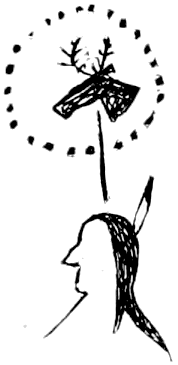
Fig. 883.—Afraid-of-Elk.
Fig. 883.—Afraid-of-Elk. Red-Cloud’s Census.
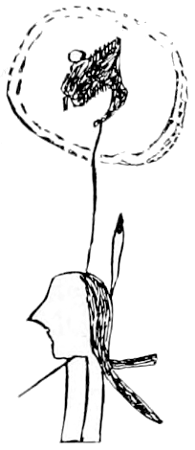
Fig. 884.—Afraid-of-Bull.
Fig. 884.—Afraid-of-Bull. Red-Cloud’s Census.
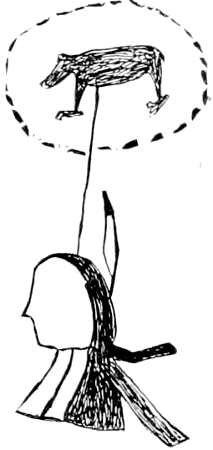
Fig. 885.—Afraid-of-Bear.
Fig. 885.—Afraid-of-Bear. Red-Cloud’s Census.
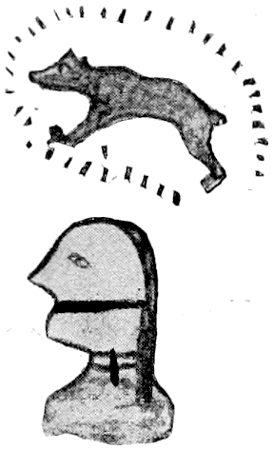
Fig. 886.—The Bear-stops.
Fig. 886.—Matokinajin, The-Bear-Stops. The Oglala Roster. The bear is surrounded by a circle of hunters, so is forced to stop. This figure is in no essential respect different from the one preceding, yet the name is suggestive of the converse of the fact expressed. In this case the bear is forced to stop, and doubtless fear is exhibited by that animal and not his hunters. Each of the ideas is appropriately expressed, the point of consideration being changed.
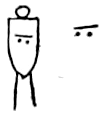
Fig. 887.
Fig. 887 is taken from Copway, loc. cit. It probably represents “fear,” the concept being the imagined sinking or depression of the heart and vital organs, as is correspondingly expressed in several languages.
This small group shows the Dakotan modes of portraying the freshets of the rivers on the banks of which they lived, which were often disastrous. Each of the three figures pictures differently the same event.
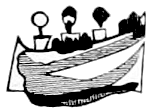
Fig. 888.—River freshet.
Fig. 888.—“Many-Yanktonais-drowned winter.” The river bottom on a bend of the Missouri river, where they were encamped, was suddenly submerged, when the ice broke and many women and children were drowned. Battiste Good’s Winter Count 1825-’26.
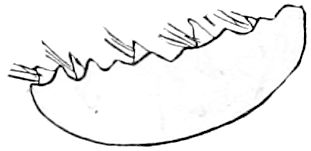
Fig. 889.—River freshet.
Fig. 889.—Many of the Dakotas were drowned in a flood caused by a rise in the Missouri river, in a bend of which they were encamped. Cloud-Shield’s Winter Count, 1825-’26. The curved line is the bend in the river; the waved line is the water, above which the tops of the tipis are shown.
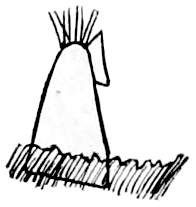
Fig. 890.—River freshet.
Fig. 890.—Some of the Dakotas were living on the bottom lands of the Missouri river, below the Whetstone, when the river, which was filled with broken ice, rose and flooded their village. Many were drowned or else killed by the floating ice. Many of those that escaped climbed on cakes of ice or into trees. American-Horse’s Winter Count, 1825-’26.
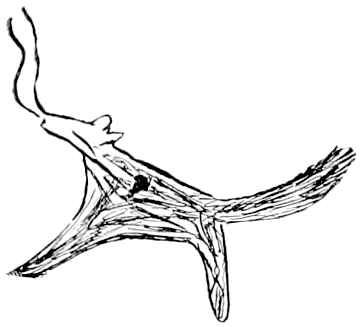
Fig. 891.—Good weasel.
Fig. 891.—Good-Weasel. Red-Cloud’s Census. The character is represented with two waving lines passing upward from the mouth in imitation of the gesture sign, good talk, as made by passing two extended and separated fingers (or all fingers separated) upward and forward from the mouth. This gesture is made when referring either to a shaman or to a Christian clergyman. It is connected with the idea of “mystic” frequently mentioned in this work.
Various modes of delineating this idea are represented as follows:
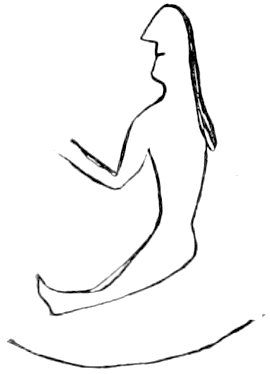
Fig. 892.—Top-man.
Fig. 892.—Top-man. Red-Cloud’s Census. This character for Top-man, or more properly “man above,” is drawn a short distance above a curved line, which represents the character for sky inverted. The gesture for sky is sometimes made by passing the hand from east to west, describing an arc. Other pictographs for sky are shown in Fig. 1117.
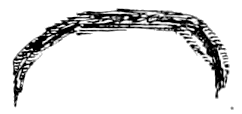
Fig. 893.—High-Cloud.
Fig. 893.—High-Cloud. Red-Cloud’s Census. The light and horizontal character of the cloud suggests that it is one of those classed by meteorologists[593] as belonging to the higher regions of the atmosphere. This differs from all the varieties of clouds depicted in the Dakotan system.
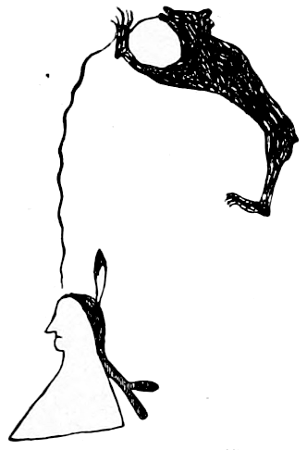
Fig. 894.—High-Bear.
Fig. 894—High-Bear. Red-Cloud’s Census. The length of the line and the animal’s stretch of attitude suggest the altitude.
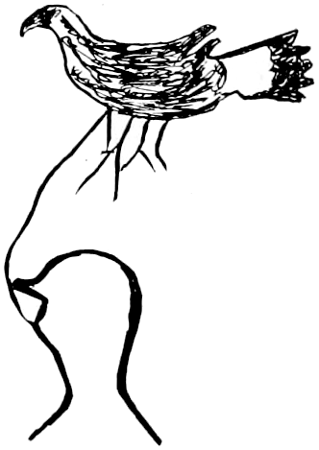
Fig. 895.—High-Eagle.
Fig. 895.—High-Eagle. Red-Cloud’s Census. Here there is an additional suggestion of elevation from the upward angle or pointer delineated below the eagle’s body and in front of its legs.
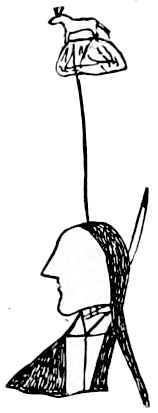
Fig. 896.—Wolf on height.
Fig. 896.—Wolf-stands-on-a-hill. Red-Cloud’s Census. This and the following representation of the same name show variation in execution. The first, which is faint, as if distant vertically, is connected with a straight line. The second shows the hill, appearing from vertical distance too small to be the support of the wolf, which requires an imaginary support for its hind legs.
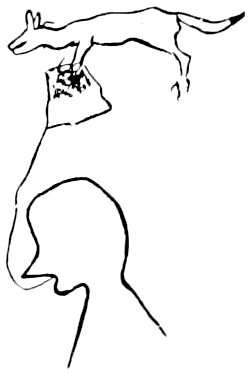
Fig. 897.—Wolf on height.
Fig. 897.—Wolf-stands-on-hill. Red-Cloud’s Census.
In the five figures next following the leanness of the several animals is objectively portrayed. In Fig. 903 the idea is conveyed of “nothing inside.”
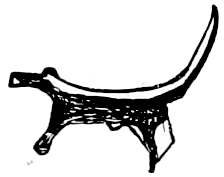
Fig. 898.—Lean-Skunk.
Fig. 898.—Lean-Skunk. Red-Cloud’s Census.
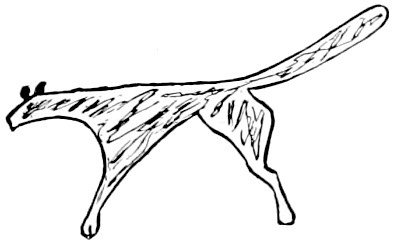
Fig. 899.—Lean-Dog.
Fig. 899.—Lean-Dog. Red-Cloud’s Census.
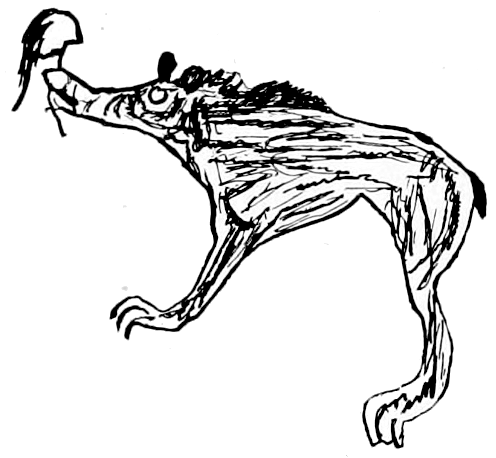
Fig. 900.—Lean-Bear.
Fig. 900.—Lean-Bear. Red-Cloud’s Census. This bear being excessively hungry is rendered ferocious by devouring unpalatable provender.
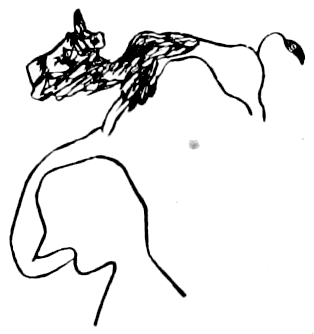
Fig. 902.—Lean-Bull.
Fig. 902.—Lean-Bull. Red-Cloud’s Census.
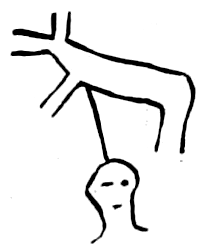
Fig. 903.—Lean-Wolf.
The original of Fig. 903 was made by Lean-Wolf, second chief of the Hidatsa, in 1881, and represents the method which he had employed to designate himself for many years past. During his boyhood he had another name. This is a current, or perhaps it may be called cursive, form of the name, which is given more elaborately in Fig. 548.
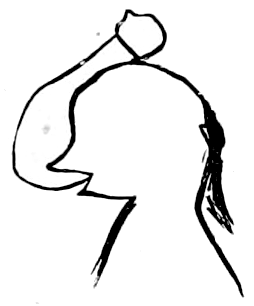
Fig. 904.—Little-Ring.
Fig. 904.—Little-Ring. Red-Cloud’s Census. This and the six following figures express smallness by their minute size relative to the other characterizing figures among nearly three hundred in the census.

Fig. 905.—Little-Ring.
Fig. 905.—Little-Ring. Red-Cloud’s Census.
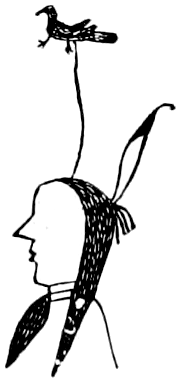
Fig. 906.—Little-Crow.
Fig. 906.—Little-Crow. Red-Cloud’s Census.
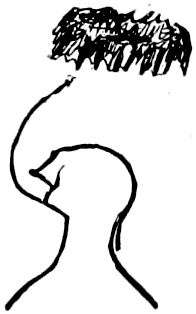
Fig. 907.—Little-Cloud.
Fig. 907.—Little-Cloud. Red-Cloud’s Census.
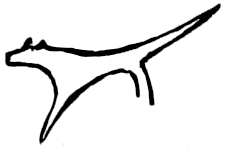
Fig. 908.—Little-Dog.
Fig. 908.—Little-Dog. Red-Cloud’s Census.
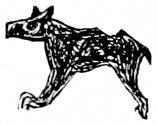
Fig. 910.—Little-Bear.
Fig. 910.—Little-Bear. Red-Cloud’s Census.
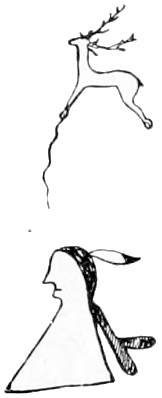
Fig. 911.—Little-Elk.
Fig. 911.—Little-Elk. Red-Cloud’s Census. Here there is an ideogram explained by the sign-language for small, little, as follows:
Hold imaginary object between left thumb and index; point (carrying right index close to tips) to the last. In the original appears a small round spot over the back of the deer representing the imaginary point made in the gesture.
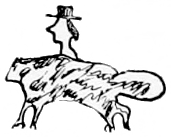
Fig. 912.—Little-Beaver.
Fig. 912.—Little-Beaver and three other white men came to trade. American-Horse’s Winter Count, 1797-’98. In this figure the man is small and the beaver abnormally large.
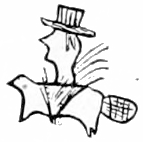
Fig. 913.—Little-Beaver.
Fig. 913.—Little-Beaver’s trading house was burned down. American-Horse’s Winter Count, 1808-’09. The beaver is not comparatively so large as in the preceding figure, but still much too large for a proper proportion with the human head. It is indicated that the man is small.
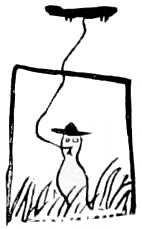
Fig. 914.—Little-Beaver.
Fig. 914.—Little-Beaver’s house was burned. Cloud-Shield’s Winter Count, 1809-’10. White-Cow-Killer says, “Little-Beaver’s (the white man) house-burned-down winter.” This is a third method of representing the same name.
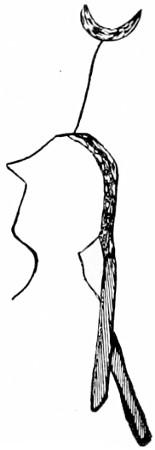
Fig. 915.—Little-Moon.
Fig. 915.—Little-Moon. Red-Cloud’s Census. This figure shows a phase of the moon when the bright part of its disk is small.
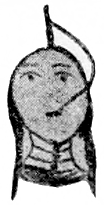
Fig. 916.—Lone-woman.
Fig. 916.—Winyan-isnala, Lone-Woman. The Oglala Roster. It is possible that the single straight line above the woman’s head shows unity, loneliness, or independence, as it may be interpreted.
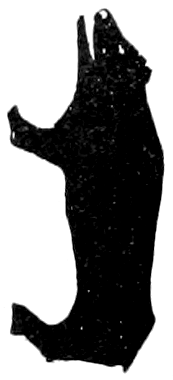
Fig. 917.—Lone-Bear.
Fig. 917.—Lone-Bear was killed in battle. Cloud-Shield’s Winter Count, 1866-’67. This figure is perhaps to be explained by the one preceding. The bear is drawn sitting upright and solitary, not standing as it would be with the device turned, feet to ground, as might be suspected to be the intended attitude instead of that here shown.
In the two following figures the idea of “many” is conveyed by repetition.
In the third, Fig. 920, the representation is that of a heap, for much.
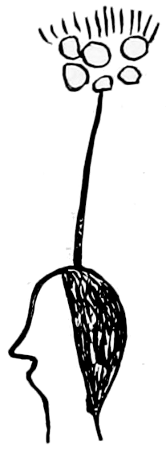
Fig. 918.—Many-Shells.
Fig. 918.—Many-Shells. Red Cloud’s Census.
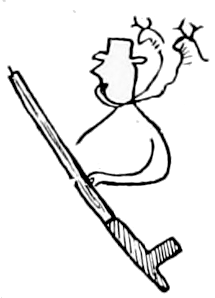
Fig. 919.—Many deer.
Fig. 919.—General Maynadier made peace with the Oglalas and Brulés. American-Horse’s Winter Count, 1865-’66. The general’s name (the sound of which resembles the words “many deer”) is indicated by the two deer heads connected with his mouth by lines. The pictographers represented his name in the same manner as they do their own. It is not an example of rebus, but of misunderstanding the significance of the word as spoken and heard by such Indians as had some knowledge of English. The official interpreters would be likely to commit the error as they seldom understand more than the colloquial English phrases.
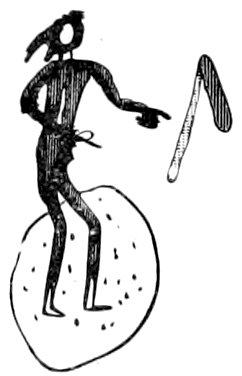
Fig. 920.—Much snow.
Fig. 920 is taken from the winter count of Battiste Good for the year 1841-’42. He calls the year “Pointer-made-a-commemoration-of-the-dead winter.” Also “Deep-snow winter.”
The extended index denotes the man’s name, “Pointer,” the circular line and spots, deep snow.
The spots denoting snow occur also in other portions of this count, and the circle, denoting much, is in Fig. 260 connected with a forked stick and incloses a buffalo head to signify “much meat.” That the circle is intended to signify much is made probable, by the fact that a gesture for “much” is made by passing the hands upward from both sides and together before the body, describing the upper half of a circle, i. e., showing a heap.

Fig. 921.-Great, much.
Fig. 921, from Copway, gives the character meaning “great,” really “much.” See the above mentioned gesture.
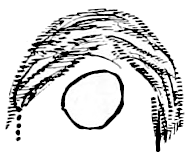
Fig. 922.—Ring-Cloud.
Fig. 922.—Ring-Cloud. Red-Cloud’s Census. The semicircle for cloud is the reverse in execution to that shown in Fig. 893. The ring is partially surrounded by the cloud.

Fig. 923.—Cloud-Ring.
Fig. 923.—Cloud-Ring. Red-Cloud’s Census. Here the outline of the ring is intentionally contorted and blurred, thus becoming obscure.
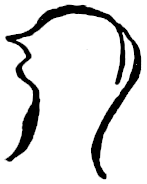
Fig. 924.—Fog.
Fig. 924.—Fog. Red-Cloud’s Census. The obscurity here can only be appreciated by comparison with the other figures of the chart. The outline is drawn broad and with a blurred and in part double line, and there is no distinguishing mark of identity, as if to suggest that the man was so much obscured in the fog as not to be recognizable.
The following two figures, 925 and 926, are introduced to show the opposition in attitude, which would not be understood without knowledge of the fact that these are perhaps the only instances in a collection of nearly three hundred in which the characterizing faces are turned to the right, all others being turned to the left. This shows the opposite of normality, i. e., opposition, as suggested in each case, with a different shade of meaning.
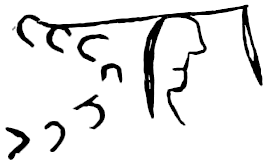
Fig. 925.—Kills-Back.
Fig. 925.—Kills-Back. Red-Cloud’s Census. Here the backward concept is presented by the unusual attitude. The coup stick or lance is supposed to be wielded in the reverse manner.
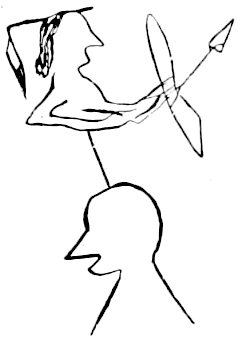
Fig. 926.—Keeps-the-Battle.
Fig. 926.—Keeps-the-Battle. Red-Cloud’s Census. The concept is that of stubborn retreat while fighting against the advancing foe.
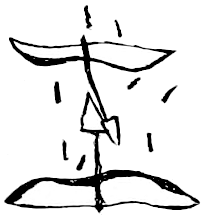
Fig. 927.—Keeps-the-Battle.
Fig. 927.—Keeps-the-Battle. Red-Cloud’s Census. This is the same name as the preceding, but the opposition suggested is that which is usual in pictographs of a battle, with the important addition of the opposed arrow points being attached together by striking the same object, and possibly being connected by an imaginary knot. This keeps or continues the struggle.
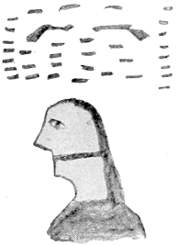
Fig. 928.—His-Fight.
Fig. 928.—Okicize-tawa, His-Fight. The Oglala[598] Roster. The opposed guns and tracks indicate the fight in which this warrior was conspicuous and probably victorious. This figure is introduced here as typical of simple opposition in battle.

Fig. 929.—River fight.
Fig. 929.—Battiste Good’s Winter Count, 1836-’37. An encounter is represented between two tribes, separated by the banks of a river, from which arrows are fired across the water at the opposing party. The vertical lines represent the banks, while the opposing arrows denote a fight or an encounter.
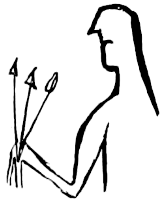
Fig. 930.—Owns the arrows.
Fig. 930.—Owns-the-Arrows. Red-Cloud’s Census. This is a common mode of expressing possession by exhibition in hand.
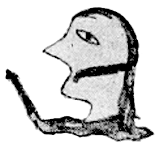
Fig. 931.—Has something sharp.
Fig. 931.—Pesto-yuha, Has-something-sharp (weapon). Oglala Roster. The weapon or sharp utensil is held in front to denote its possession.
This group shows the several modes of expressing the idea of a prisoner.
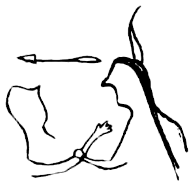
Fig. 932.—Prisoner. Dakota.
Fig. 932.—The Ponkas attacked two lodges of Oglalas, killed some of the people, and made the rest prisoners. The Oglalas went to the Ponka village a short time afterward and took their people from the Ponkas. American-Horse’s Winter Count, 1802-’03.
In the figure an Oglala has a prisoner by the arm leading him away. The arrow indicates that they were ready to fight. The hand grasping the fore arm is the ideogram of prisoner.
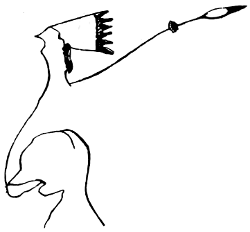
Fig. 933.—Takes enemy.
Fig. 933.—Takes-Enemy. Red-Cloud’s Census. This man is represented as not killed nor even wounded. He is touched by the coup stick or feathered lance, when he can not escape, and becomes a prisoner.
Lafitau (d) gives the following account descriptive of Fig. 934, which reminds of the classic Roman parade of prisoners in triumph:
Those who have charge of the prisoners prepare them for this ceremony, which is a sort of triumph, having for them something of glory and of sorrow at the same time; for, whether it is desired to do them honor or to enhance the triumph of the conquerors, they paint their faces black and red as on a solemn feast day. Their[599] heads are decorated with a crown, embellished with feathers; in the left hand is placed a white stick covered with swan skin, which is a sort of commander’s baton or scepter, as if they represented the chief of the nation [sic] or the nation itself which had been vanquished; in the right hand is placed the rattle, and around the neck of the most prominent of the slaves the wampum necklace which the war chief has given or received when he raised the party and on which the other warriors have sealed their engagement. But if on one hand the prisoners are honored, on the other, to make them feel their miserable situation, they are deprived of everything else; so that they are left entirely naked and made to walk with the arms tied behind the back above the elbow.
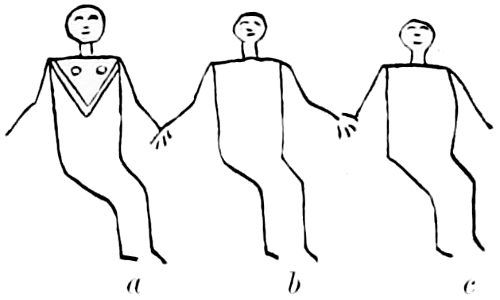
Fig. 935.—Prisoners. Dakota.
Fig. 935 is taken from Mrs. Eastman (d), and shows a Dakota method of recording the taking of prisoners. a and c are the prisoners, a being a female as denoted by the presence of mammæ, and c a male; b is the person making the capture. It is to be noted that the prisoners are without hands, to signify their helplessness.
In Doc. Hist. New York (c) is the following description of Fig. 936:
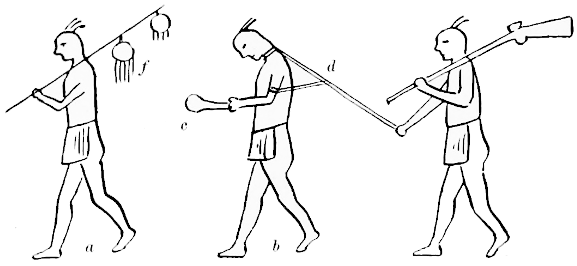
Fig. 936.—Prisoners. Iroquois.
On their return, the Iroquois, if they have prisoners or scalps, paint the animal of the tribe to which they belong rampant (debout), with a staff on the shoulder along which are strung the scalps they may have and in the same number. After the animal are the prisoners they have made, with a chichicois (or gourd filled with beans which rattle) in the right hand. If they be women, they represent them with a cadenette or queue and a waistcloth.
a. This is a person returning from war who has taken a prisoner, killed a man and woman, whose scalps hang from the end of a stick that he carries. b. The prisoner. c. Chichicois (or a gourd), which he holds in the hand. d. These are cords attached to his neck, arms, and girdle. e. This is the scalp of a man; what is joined on one side is the scalp-lock. f. This is the scalp of a woman; they paint it with the hair thin.
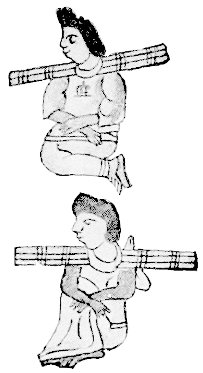
Fig. 937.—Prisoners. Mexico.
The expression prisoner and slave are often convertible. The following from Kingsborough (f), explaining this illustration reproduced as Fig. 937, refers in terms to slavery. “The figures are those of the wife and son of a cacique who rebelled against Montezuma, and who, having been conquered, was strangled. The ‘collars’ upon their necks show that they have been reduced to slavery.”
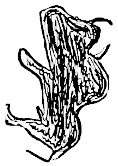
Fig. 938.—Short-Bull.
Fig. 938.—Short-Bull. Red-Cloud’s Census, No. 16. The buffalo is markedly short even to distortion.

Fig. 939.—Sees-the-Enemy.
Fig. 939.—Sees-the-Enemy. Red-Cloud’s Census. In this collection the eye is not indicated except where that organ is directly connected with the significance of the name. Here its mere presence suggests that vision is the subject matter. But, in addition, the object above the head is probably a hand mirror, which by its reflection is supposed to “see” the objects reflected. The plains Indians make use of such mirrors not only in their face painting but in flash signaling.
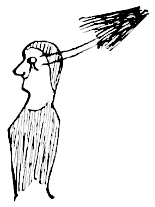
Fig. 940.—Crier.
Fig. 940.—In a fight with the Mandans, Crier was shot in the head with a gun. Cloud-Shield’s Winter Count, 1827-’28. This figure is[601] introduced to present another rare instance in which the eye is delineated. Here the act is that of weeping.

Fig. 941.—Comes-in-Sight.
Fig. 941.—Comes-in-Sight. Red-Cloud’s Census, No. 235. Distant objects, probably buffalo or other animals of the chase, are observed coming into the line of vision.
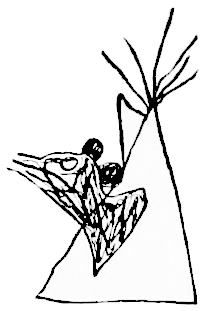
Fig. 942.—Bear-comes-out.
Fig. 942.—Bear-comes-out. Red-Cloud’s Census. Here the bear is supposed to come into sight through a hole in the tipi.
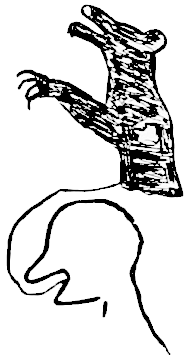
Fig. 943.—Bear-comes-out.
Fig. 943.—Bear-comes-out. Red-Cloud’s Census. This figure is explained by the one preceding. Only half of the bear—the fore part—is to be seen as if emerging through some orifice. Heads and other parts of animals are frequently portrayed as signifying the whole, by synechdoche, but in this case the presentation of the head and forequarters has special significance.
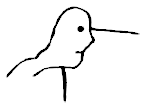
Fig. 944.
Fig. 944.—Taken from Copway, p. 136, is the character which is employed to represent “see.”
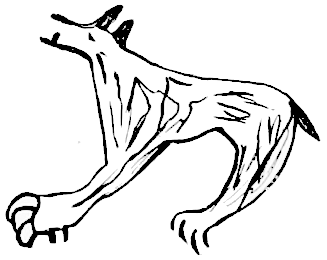
Fig. 945.—Slow-Bear.
Fig. 945.—Slow-Bear. Red-Cloud’s Census. In this figure the bear seems to be in backing or retrograde motion, which is slower than any normal advance, and is therefore ideographically suggestive of slowness.
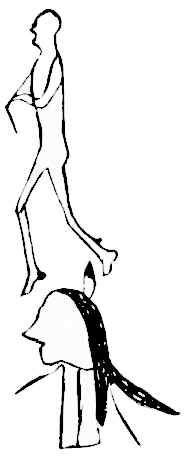
Fig. 946.—Tall-Man.
Fig. 946.—Tall-Man. Red-Cloud’s Census. This and the five following animal figures show length and individual height objectively.
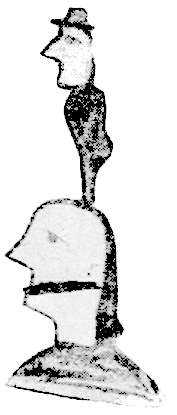
Fig. 947.—Tall-White-Man.
Fig. 947.—Wasicun-wankatuya, Tall-White-Man. The Oglala Roster. The hat shows the man of European origin, but his figure is large in the face and short in the legs; so not tall in a usual sense. He was probably killed by the Oglala.

Fig. 948.—Tall-White-Man.
Fig. 948.—Tall-White-Man. Red-Cloud’s Census. This expresses the height much more graphically than the one preceding.
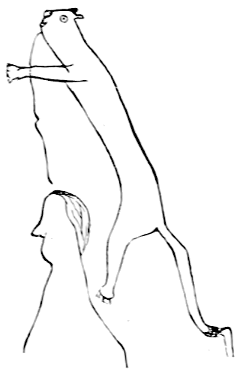
Fig. 950.—Tall-Panther.
Fig. 950.—Tall-Panther. Red-Cloud’s Census.
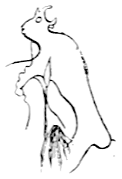
Fig. 951.—Tall-Bull.
Fig. 951.—Tall-Bull was killed by white soldiers and Pawnees on the south side of the South Platte river. American-Horse’s Winter Count, 1869-’70. The combined arrangement of the human head and the buffalo so as to produce the effect of abnormal height in the latter is ingenious. The plan of this chart did not allow of long lines above the head, so the effect is attained by comparison of the standing buffalo with the height of the man.
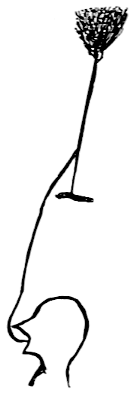
Fig. 952.—Tall-Pine.
Fig. 952.—Tall-Pine. Red-Cloud’s Census. In this as in the two next figures the length of the trunk of the tree is apparent.

Fig. 953.—Long-Pine.
Fig. 953.—Long-Pine was killed in a fight with the Crows. American-Horse’s Winter Count, 1879-’80. The absence of his scalp denotes that he was killed by an enemy. The fatal wound was made with the bow and arrow.
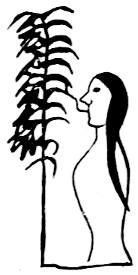
Fig. 954.—Long-Pine.
Fig. 954.—Long-Pine, a Dakota, was killed by Dakotas, perhaps accidentally or perhaps in a personal quarrel. Cloud-Shield’s Winter Count, 1846-’47. He was not killed by a tribal enemy, as he has not lost his scalp.

Fig. 955.—Trade.
Fig. 955.—They were compelled to sell many mules and horses to enable them to procure food, as they were in a starving condition. They willingly gave a mule for a sack of flour. American-Horse’s Winter Count, 1868-’69. The mule’s halter is connected with two sacks of flour.
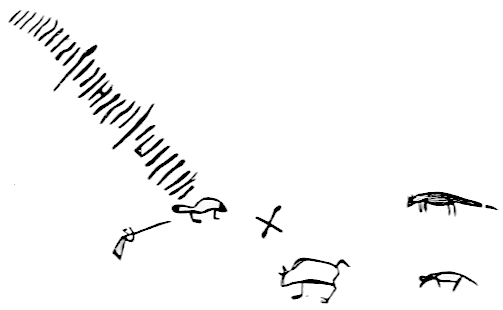
Fig. 956.—Trade.
Fig. 956 is taken from Prince Maximilian, of Wied’s (h) Travels. The cross signifies, I will barter or trade. Three animals are drawn on the right hand of the cross; one is a buffalo (probably albino); the two others, a weasel (Mustela Canadensis) and an otter. The pictographer offers in exchange for the skins of these animals the articles which he has drawn on the left side of the cross. He has there, in the first place, depicted a beaver very plainly, behind which there is a gun; to the left of the beaver are thirty strokes, each ten separated by a longer line; this means: I will give thirty beaver skins and a gun for the skins of the three animals on the right hand of the cross.
The ideographic character of the design consists in the use of the cross—being a drawing of the gesture-sign for “trade”—the arms being interchanged in position. Of the two things each one is put in the place before occupied by the other thing, the idea of exchange.
The Dakotas often express this concept by uniting two or more figures by a distinct inclusive line below the figures. This sometimes means family relationship and sometimes common membership in the same tribe.
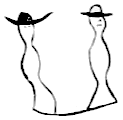
Fig. 957.—Brothers.
Fig. 957.—Antoine Janis’s two boys were killed by John Richard. Cloud-Shield’s Winter Count, 1872-’73. The line of union shows them to be intimately connected; in fact, they were brothers.
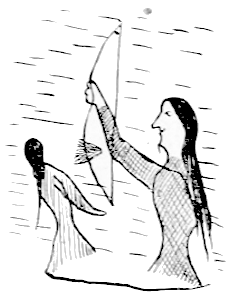
Fig. 958.—Same tribe.
Fig. 958.—The Oglalas got drunk at Chug creek and engaged in a quarrel among themselves, in which Red-Cloud’s brother was killed and Red-Cloud killed three men. Cloud-Shield’s Winter Count, 1841-’42. The union line shows that the quarrel was in the tribe.
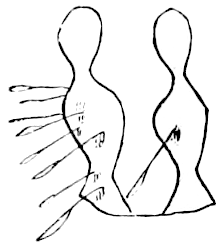
Fig. 959.—Man and wife.
Fig. 959.—Torn-Belly and his wife were killed by some of their own people in a quarrel. Cloud-Shield’s Winter Count, 1855-’56. Here the man and wife are united by the inclusive line.

Fig. 960.—Same tribe.
Fig. 960.—Eight Minneconjou Dakotas were killed by Crow Indians at the mouth of Powder river. The-Swan’s Winter Count, 1805-’06. This device is very frequently used to denote the death of the Dakotas. The black strokes indicate the death of persons of the number delineated and the union line shows that they were of the same tribe.
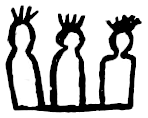
Fig. 961.—Same tribe.
Fig. 961.—Blackfeet Dakotas kill three Rees. The-Flame’s Winter Count for 1798-’99. Here the uniting line of death refers to others than Dakotas, which does not often appear, but the principle is maintained that the dead are of the same tribe.
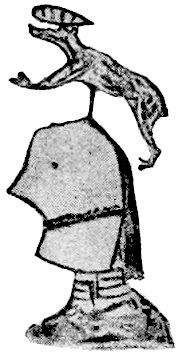
Fig. 962.—Bear-Whirlwind.
Fig. 962.—Mato-wamniyomni, Bear-Whirlwind. The Oglala Roster. This figure shows over the bear’s head a variant of the character given in Red-Cloud’s Census, Fig. 963. The figure appears, according to the explanation given by several Oglala Dakota Indians, to signify the course of a whirlwind with the transverse lines in imitation of the circular movement of the air, conveying dirt and leaves, observed during such aerial disturbances.
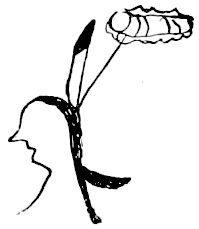
Fig. 963.—White-Whirlwind.
Fig. 963.—Represents White-Whirlwind, above referred to, from Red-Cloud’s Census. In this the designating character is more distinct.
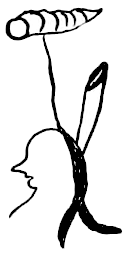
Fig. 964.—Leafing.
Fig. 964.—Leafing. Red-Cloud’s Census. This seems to be of the same description. It is said to be drawn in imitation of a number of fallen leaves packed against one another and whirled along the ground. It also has reference to the season when leaves fall—autumn.
Mr. Keam’s MS. describing Fig. 965, says:
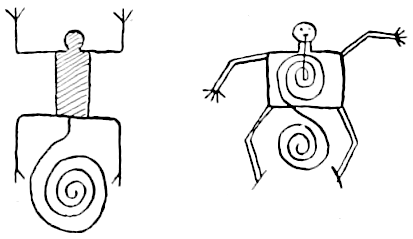
Fig. 965.—Whirlwind.
It is a decoration of great frequency and consisting of the single and double spirals. The single spiral is the symbol of Ho-bo-bo, the twister, who manifests his power by the whirlwind. It is also of frequent occurrence as a rock etching in the vicinity of ruins, where also the symbol of the Ho-bo-bo[605] is seen. But the figure does not appear upon any of the pottery. The myth explains that a stranger came among the people, when a great whirlwind blew all the vegetation from the surface of the earth and all the water from its courses. With a flint he caught these symbols upon a rock, the etching of which is now in Keam’s Cañon, Arizona Territory. It is 17 inches long and 8 inches across. He told them that he was the keeper of breath. The whirlwind and the air which men breathe comes from this keeper’s mouth.
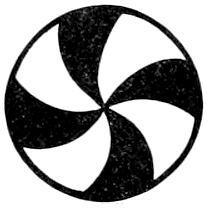
Fig. 966.—Whirlwind.
Fig. 966 is a copy of part of the decoration on a pot taken from a mound in Missouri, published in Second Annual Report of the Bureau Ethnology, Pl. LIII, fig. 11. On the authority of Rev. S. D. Hinman, it is the conventional device among the Dakotas to represent a whirlwind.
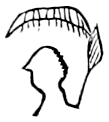
Fig 967.—Froze to death.
Fig. 967.—Glue, an Oglala, froze to death on his way to a Brulé village. American-Horse’s Winter Count, 1791-’92. A glue-stick is represented back of his head. Glue, made from the hoofs of buffalo, is used to fasten arrowheads to the shaft and is carried about on sticks. The cloud from which hail or snow is falling represents winter.

Fig. 968.—Froze to death.
Fig. 968.—A Dakota, named Glue, froze to death. Cloud-Shield’s Winter Count, 1820-’21. This figure is introduced to corroborate of the preceding one as regards the name Glue. It gives another representation of the glue stick.
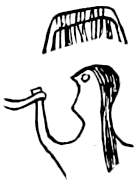
Fig. 969.—Crows froze.
Fig. 969.—A Dakota named Stabber froze to death. American-Horse’s Winter Count, 1782-’83. The sign for winter is the same as before, but doubled, as if of twofold power or excessively severe.
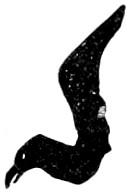
Fig. 970.—Froze to death.
Fig. 970.—The winter was so cold that many crows froze to death. Cloud-Shield’s Winter Count, 1788-’89. White-Cow-Killer says “Many-black-crows-died winter.”
The Crow falling stiff and motionless is a good symbol for the effect of excessive cold.
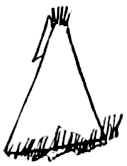
Fig. 971.
Fig. 971.—The snow was very deep. American-Horse’s Winter Count, 1827-’28. The piled-up snow around the bottoms of the tipis is graphic; no other material than snow could make that kind of surrounding heap.

Fig. 972.—Cold, snow.
Fig. 972.—From Copway, page 135, is the representation of “cold,” “snow.”
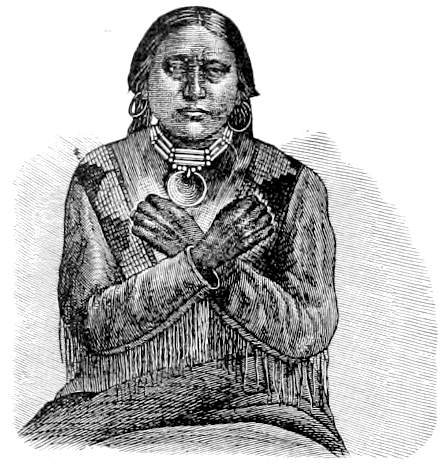
Fig. 973.
The Shoshoni and Banak sign for cold, winter, is: Clinch both hands and cross the forearms before the breast with a trembling motion. It is represented in Fig. 973. Cf. Battiste Good’s Winter count for 1747-’48 and 1783-’84.
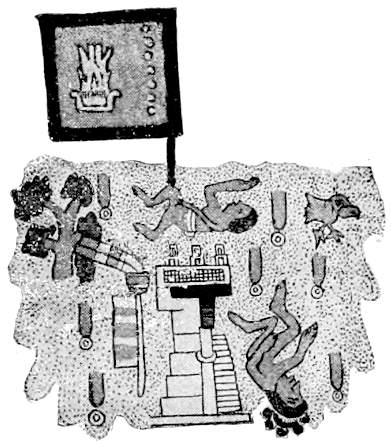
Fig. 974.
In Kingsborough (g) is the painting reproduced in Fig. 974 with this description: “In the year of seven Canes and 1447 according to our calculation, it snowed so heavily that lives were lost.”
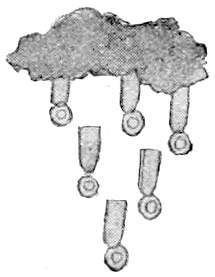
Fig. 975.
In the same work and volumes, p. 146 and Pl. 26, is the original of Fig. 975, with the explanation that: “In this year of seven Flints, or 1512, there were heavy falls of snow.”
Wiener, op. cit., p. 762, gives the following description (condensed) of Fig. 976, a remarkable example of ideography:
This is on a cloth on which the eight fortresses of Paramonga were presented. Between these bridges are drawn; these forts are of three stages and on each stage is a representation of a man or of two men. The men who are down on the plain had clothing of another color and even another colored face from those who appear on the different stages. Those who are on the plain at the foot of the fortress have no arms, but they have highly developed ears. The same is true of those who appear on the first stage. Those of the following stage are provided with arms, and the ears are of normal size. On the highest platform appear individuals with arms and they have ears like those on the second stage. In the middle a figure is provided with one arm and only one developed ear, which are on opposite sides. The men without arms are also without weapons. Those of the second stage carry at the height of the belt a kind of hatchet and those of the upper platform have each a club.
Considering the character of the locality where this cloth was found, the number of forts there, the marshy land which prevented dry-shod communication between them, it can not be doubted that the subject matter was the representation of that region, but this representation is not a drawing on a plan, but is a description which does not only treat of the nature of the place and of the work that man raised there, but it also indicates the rôle that the inhabitants played there.
The function of the men with exaggerated ears and no arms was that of scouts. The armed men with normal ears were guards or warriors[607] bearing different weapons, ax and club, and differently uniformed. The highest figure with one large ear was the chief of the garrison.
It will be noticed that the scouts have enormous feet which do not rest on the ground. This in connection with their exaggerated ears implies that their duty is to listen and when they hear the enemy not to engage him, as they have no arms or weapons, but to fly to the headquarters and make the report. The duty of the warriors is not to listen, so their ears are not abnormal, but to fight, and therefore they have arms, one of which is exposed and the other holds a weapon. Their feet are attached to their several stations. The chief must both listen and direct, wherefore he is drawn with one exaggerated ear and one arm. His feet do not touch the platform, which signifies that he has no special station, but must move wherever he is most needed.
The terms sign, symbol, and emblem are often used interchangeably and therefore incorrectly. Many persons ascribe an occult and mystic signification to symbols, probably from their general religious and esoteric employment. All characters in Indian picture-writing have[608] been loosely styled symbols, and, as there is no logical distinction between the characters impressed with enduring form and when merely outlined in the ambient air, all Indian gestures, motions, and attitudes, intended to be significant, might with equal appropriateness be called symbolic. But an Indian sign-talker or a deaf-mute represents a person by mimicry, and an object by the outline of some striking part of its form, or by the pantomime of some peculiarity in its actions or relations. Their attempt is to bring to mind the person or thing through its characteristics, not to distinguish the characteristics themselves, which is a second step. In the same manner a simple pictorial sign attempts to express an object, idea, or fact without any approach to symbolism. Symbols are less obvious and more artificial than mere signs, are not only abstract, but metaphysical, and often need explanation from history, religion, and customs. They do not depict, but suggest subjects; do not speak directly through the eye to the intelligence, but presuppose in the mind knowledge of an event or fact which the sign recalls. The symbols of the ark, dove, olive branch, and rainbow would be wholly meaningless to people unfamiliar with the Mosaic or some similar cosmology, as would the cross and the crescent be to those ignorant of history.
The loose classification by which symbols would include every gesture or pictorial sign that naturally or conventionally recalls a corresponding idea, only recognizes the fact that every action and object can, under some circumstances, become a symbol. And indeed lovers of the symbolic live in, on, and by the symbols which they manufacture.
A curious instance of the successful manufacture of a symbol by the ingenuity of one man is in the one now commonly pictured of a fish to represent Christ. The fish for obvious reasons has been connected with Eurasian mythology, and therefore was a heathen symbol many centuries before the Christian era; indeed, probably before the creed of the Israelites had become formulated. It was used metaphorically or emblematically by the early Christians without the apparent propriety of the lamb-bearing shepherd, the dove, and other emblems or symbols found in the catacombs, and Didron (b) says that only in the middle of the fourth century Optatus, bishop of Milesia, in Africa, declared the significance of the letters of the Greek word for fish, ΙΧΘΥΣ, to be the initials of Ἰησοῦς Χριστὸς Θεοῦ Ὑιος Σωτηρ, which acrostic was received with acclamation, and new characteristics were from time to time invented, adding force to the thenceforth commonly displayed symbol. It may be noted that when symbols, which were generally religious, received acceptance, they were soon used objectively as amulets or talismans.
This chapter is not intended to be a treatise on symbolism, but it is proper to mention the distinction in the writer’s mind between a pictorial sign, an emblem, and a symbol; though it is not easy to preserve accurate discrimination in classification of ideographic characters. To partly express the distinction, nearly all of the characters in the Winter[609] Counts in this work are regarded as pictorial signs, and the class represented by tribal and clan designations, insignia, etc., is considered to belong to the category of emblems. There is no doubt, however, that true symbols exist among the Indians, as they must exist to some extent among all peoples not devoid of poetic imagination. Some of them are shown in this work. The pipe is generally a symbol of peace, although in certain positions and connections it signifies preparation for war, and, again, subsequent victory. The hatchet is a common symbol for war, and joined hands or approaching palms denote peace. The tortoise has been clearly used as a symbol for land, and many other examples can be admitted. Apart from the exaggerations of Schoolcraft, true symbolism is found among the Ojibwa, of which illustrations are presented. The accounts of the Zuñi, Moki, and Navajo, before mentioned, show the constant employment of symbolic devices by those tribes which are notably devoted to mystic ceremonies. Nevertheless the writer’s personal experience is that when he has at first supposed a character to be a genuine symbol, better means of understanding has often proved it to be not even an ideograph, but a mere objective representation. In this connection the remarks on the circle, in Lone-Dog’s Winter Count for 1811-’12, and those on the cross infra, may be in point.
The connection, to the unlettered Indian, between printed words, pictures, and signs, was well illustrated through the spontaneous copial, by a Cheyenne, of the ornate labels on packages of sugar and coffee, which he had seen at a reservation, and the lines of which he rather skillfully and very ingeniously repeated on a piece of paper when sending to a post-trader to purchase more of the articles. The printed label was to him the pictorial sign for those articles.
The following remarks are quoted from D’Alviella (a):
There is a symbolism so natural, that, like certain implements peculiar to the stone age, it does not belong to any particular race, but constitutes a characteristic trait of mankind at a certain phase of its development. Of this class are representations of the sun by a disk or radiating face, of the moon by a crescent, of the air by birds, of water by fishes or a broken line, of thunder by an arrow or a club, etc. We ought, perhaps, to add a few more complicated analogies, as those which lead to symbolizing the different phases of human life by the growth of a tree, the generative forces of nature by phallic emblems, the divine triads by an equilateral triangle, or in general by any triple combination the members of which are equal, and the four principal directions of space by a cross. How many theories have been built upon the presence of the cross as an object of veneration among nearly all the peoples of the Old and New Worlds? Roman Catholic writers have justly protested, in recent years, against attributing a pagan origin to the cross of the Christians, because there were cruciform signs in the symbolism of religions anterior to Christianity. It is also right, by the same reason, to refuse to accept the attempts to seek for infiltrations of Christianity in foreign religions because they also possess the sign of redemption. * * * Nearly all peoples have represented the fire from the sky by an arm and, sometimes also, by a bird of strong and rapid flight. It was symbolized among the Chaldeans by a trident. Cylinders going back to the most ancient ages of Chaldean art exhibit a water jet gushing from a trident which[610] is held by the god of the sky or of the storm. The Assyrian artist who first, on the bas-reliefs of Nimroud or Malthai, doubled the trident or transformed it into a trifid fascicle, docile to the refinements and elegancies of classic art, by that means secured for the ancient Mesopotamian symbol the advantage over all the other representations of thunder with which it could compete. The Greeks, like the other Indo-European nations, seem to have represented the storm-fire under the features of a bird of prey. When they received the Asiatic figure of the thunderbolt, they put it in the eagle’s claws and made of it the scepter of Zeus, explaining the combination, after their habit, by the story of the eagles bringing thunder to Zeus when he was preparing for the war against the Titans. Latin Italy transmitted the thunderbolt to Gaul, where, in the last centuries of paganism, it alternated on the Gallo-Roman monuments with the two-headed hammer.
The emblem writers, so designated, have furnished an immense body of literature, and apparently have considered such pictures as those of the Winter Counts in the present work and also all symbols to be included in their proper scope. The best summary on the subject is by Henry Greene (a), from which the following condensed extract is taken:
Of the changes through which a word may pass the word emblem presents one of the most remarkable instances. Its present signification, type, or allusive representation is of comparatively modern use, while its original meaning is obsolete. Among the Greeks an emblem meant something thrown in or inserted after the fashion of what we now call marquetry and mosaic work, or in the form of a detached ornament to be affixed to a pillar, a tablet, or a vase, and put off or on as there might be occasion.
Quintilian (lib. 2, cap. 4), in enumerating the arts of oratory used by the pleaders of his day, describes some of them as in the habit of preparing and committing to memory certain highly finished clauses, to be inserted (as occasion might arise) like emblems in the body of their orations. Such was the meaning of the term in the classical ages of Greece and Rome; nor was its signification altered until some time after the revival of literature in the fifteenth century.
Thus, in their origin, emblems were the figures or ornaments fashioned by the tools of the artists, in metal or wood, independent of the vase, or the column, or the furniture they were intended to adorn; they might be affixed or detached at the promptings of the owner’s fancy. Then they were formed, as in mosaic, by placing side by side little blocks of colored stone, or tiles, or small sections of variegated wood. Raised or carved figures, however produced, came next to be considered as emblems; and afterwards any kind of figured ornament or device, whether carved or engraved or simply traced, on the walls and floors of houses or on vessels of wood, clay, stone, or metal.
By a very easy and natural step figures and ornaments of many kinds, when placed on smooth surfaces, were named emblems; and as these figures and ornaments were very often symbolical, i. e., signs or tokens of a thought, a sentiment, a saying, or an event, the term emblem was applied to any painting, drawing, or print that was representative of an action, of a quality of the mind, or of any peculiarity or attribute of character. Emblems in fact were and are a species of hieroglyphics, in which the figures or pictures, besides denoting the natural objects to which they bear resemblances, were employed to express properties of the mind, virtues and abstract ideas, and all the operations of the soul.
The following remarks of the same author (b) are presented in this connection, though they pass beyond the scope of either symbols or emblems into other divisions of pictography, as classified in the present work:
Coins and medals furnish most valuable examples of emblematical figures; indeed some of the emblem writers, as Sambucus, in 1564, were among the earliest to publish[611] impressions or engravings of ancient Roman money, on which are frequently given very interesting representations of customs and symbolical acts. On Grecian coins we find, to use heraldic language, that the owl is the crest of Athens, a wolf’s head that of Argos, and a tortoise the badge of the Peloponnesus. The whole history of Louis XIV and that of his great adversary, William III, is represented in volumes containing the medals that were struck to commemorate the leading events of their reigns, and, though outrageously untrue to nature and reality by the adoption of Roman costumes and classic symbols, they serve as records of remarkable occurrences.
Heraldry throughout employs the language of emblems; it is the picture-history of families, of tribes, and of nations, of princes and emperors. Many a legend and many a strange fancy may be mixed up with it, and demand almost the credulity of simplest childhood in order to obtain our credence; yet in the literature of chivalry and honors there are enshrined abundant records of the glory that belonged to mighty names.
The custom of taking a device or badge, if not a motto, is traced to the earliest times of history. It is a point not to be doubted that the ancients used to bear crests and ornaments in the helmets and on the shields; for we see this clearly in Virgil, when he made the catalogue of the nations which came in favor of Turnus against the Trojans, in the eighth book of the Æneid; Amphiaraus then (as Pindar says), at the war of Thebes, bore a dragon on his shield. Similarly Statius writes of Capaneus and of Polinices that the one bore the Hydra and the other the Sphynx.
Emblems do not necessarily require any analogy between the objects representing and the objects or qualities represented, but may arise from pure accident. They may bear any meaning that men may choose to attach to them, so their value still more than that of symbols depends upon extrinsic facts and not intrinsic features. After a scurrilous jest the beggar’s wallet became the emblem of the confederated nobles, the Gueux of the Netherlands; and a sling, in the early minority of Louis XIV, was adopted from the refrain of a song by the Frondeur opponents of Mazarin.
The several tribal designations for Sioux, Arapaho, Cheyenne, etc., are their emblems, precisely as the star-spangled flag is that of the United States, but there is no intrinsic symbolism in them. So the designs for individuals, when not merely translations of their names, are emblematic of their family totems or personal distinctions, and are no more symbols than are the distinctive shoulder-straps of an army officer.
The point urged is that while many signs can be used as emblems and both can be converted by convention into symbols or be explained as such by perverted ingenuity, it is futile to seek for that form of psychological exuberance in the stage of development attained by the greater part of the American tribes. All predetermination to interpret their pictographs on the principles of symbolism as understood or pretended to be understood by its admirers, and as are sometimes properly applied not only to Egyptian hieroglyphics, but to Mexican, Maya, and some other southern pictographs, results in mooning mysticism.
The following examples are presented as being either symbols or emblems, according to the definition of those terms, and therefore[612] appropriate to this section. More will be found in Chapter XX, on Special Comparisons, and indeed may appear under different headings; e. g., Battiste Good symbolizes hunting by a buffalo head and arrow, Fig. 321, and war by a special head-dress, Fig. 395.
Sir A. Mackenzie (c) narrates that in 1793 he found among the Athabascans an emblem of a country abounding in animals. This was a small round piece of green wood chewed at one end in the form of a brush, which the Indians use to pick the marrow out of bones.
Mr. Frank H. Cushing, in notes not yet reduced to final shape for publication, gives two excellent examples of symbols among the Zuñi:
(1) The circle or halo around the sun is supposed to be and is called by the Zuñi the House of the Sun-God. This is explained by analogy. A man seeks shelter on the approach of a rainstorm. As the sun circle almost invariably appears only with the coming of a storm, the Sun, like his child, the man, seeks shelter in his house, which the circle has thus come to be.
The influence of this simple inference myth on the folklore of the Zuñi shows itself in the perpetuation, until within recent generations, of the round sun towers and circular estufas so intimately associated with sun worship, yet which were at first but survivals of the round medicine lodge.
(2) The rainbow is a deified animal having the attributes of a human being, yet also the body and some of the functions of a measuring worm. Obviously, the striped back and arched attitude of the measuring worm, its sudden appearance and disappearance among the leaves of the plants which it inhabits, are the analogies on which this personification is based. As the measuring worm consumes the herbage of the plants and causes them to dry up, so the rainbow, which appears only after rains, is supposed to cause a cessation of rains, consequently to be the originator of droughts, under the influence of which latter plants parch and wither away as they do under the ravages of the measuring worms. Here it will be seen that the visible phenomenon called the rainbow gets by analogy the personality of the measuring worm, while from the measuring worm in turn the rainbow gets its functions as a god. Of this the cessation of rain on the appearance of the rainbow is adduced as proof.
The following is reported by Dr. W. H. Dall (e), and explains how the otter protruding his tongue is the emblem of Shaman:
The carvings on the rattles of the Tlinkit are matters belonging particularly to the shaman or medicine man, and characteristic of his profession. Among these very generally, if not invariably, the rattle is composed of the figure of a bird, from which, near the head of the bird or carved upon the back of the bird’s head, is represented a human face with the tongue protruding.
This tongue is bent downward and usually meets the mouth of a frog or an otter, the tongue of either appearing continuous with that of the human face. In case it is a frog it usually appears impaled upon the tongue of a kingfisher, whose head and variegated plumage are represented near the handle in a conventional way. It is asserted that this represents the medicine man absorbing from the frog, which has been brought to him by the kingfisher, either poison or the power of producing evil effects on other people.
In case it is an otter the tongue of the otter touches the tongue of the medicine man, as represented on the carving. * * *
This carving is represented, not only on rattles, but on totem posts, fronts of houses, and other objects associated with the medicine man, the myth being that when the young aspirant for the position of medicine man goes out into the woods after fasting for a considerable period, in order that his to be familiar spirit may[613] seek him, and that he may become possessed of the power to communicate with supernatural beings; if successful he meets with a river otter, which is a supernatural animal. The otter approaches him and he seizes it, kills it with the blow of a club, and takes out the tongue, after which he is able to understand the language of all inanimate objects, of birds, animals, and other living creatures. * * *
This ceremony or occurrence happens to every real medicine man. Consequently the otter presenting his tongue is the most universal type of the profession as such, and is sure to be found somewhere in the paraphernalia of every individual of that profession.
With this account from the Pacific coast a similar determination of emblems by the Indians in the northeastern parts of the United States may be compared. The objects seen by them in their fasting visions not only were decisive of their names but were held to show the course of their lives. If a youth saw an eagle or bear he was destined to be a warrior; if a deer he would be a man of peace; and a turkey buzzard or serpent was the sign that he would be a medicine man. The figures of those animals therefore were respectively the emblems of the qualities and dispositions implied. See Fig. 159, supra, for a drawing of the Sci-Manzi or “Mescal Woman” of the Kaiowa as it appears on a sacred gourd rattle used in the mescal ceremony of that tribe, with description.
In Kingsborough (h) is the record that “in the year of Ten Houses, or 1489, a very large comet, which they name Xihuitli, appeared.”

Fig. 977.—Comet. Mexican.
The comet is represented in the plate by the symbol of a caterpillar, in allusion, perhaps, to its supposed influence in causing blights. This may be compared with the measuring worm, symbol of the rainbow, supra. The character is reproduced in Fig. 977.
In the same work and Codex, Pls. 10, 12, and 33, are three characters, somewhat differing, representing earthquakes, which, according to the text in Vol. VI, p. 137, et seq., occurred in Mexico in the years A. D. 1461, 1467, and 1542. The concept appears to be that of the disruption and change of the position of the several strata of soil, which are indicated by the diverse coloration. These characters are reproduced in the present work in Pl. XLIX as the three on the right hand in the lower line.

Fig. 978.—Robbery. Mexican.
Fig. 978 is from the same work (i), Codex Mendoza, and is the symbol for robbery, in allusion to the punishment of the convicted robber.
In the same work (k), Codex Vaticanus, is the following description, in quaint language, of the plate now reproduced in Pl. XLIX:
These are the twenty letters or figures which they employed in all their calculations, which they supposed ruled over men, as the figure shows, and they cured in a corresponding manner those who became ill or suffered pains in any part of the body. The sign of the wind was assigned to the[614] liver; the rose to the breast; the earthquake to the tongue; the eagle to the right arm; the vulture to the right ear; the rabbit to the left ear; the flint to the teeth; the air to the breath; the monkey to the left arm; the cane to the heart; the herb, to the bowels; the lizard to the womb of women; the tiger to the left foot; the serpent to the male organ of generation, as that from which their diseases proceeded in their commencement; for in this manner they considered the serpent, wherever it occurred, as the most ominous of all their signs. Even still physicians continue to use this figure when they perform cures, and, according to the sign and hour in which the patient became ill, they examined whether the disease corresponded with the ruling sign; from which it is plain that this nation is not as brutal as some persons pretend, since they observed so much method and order in their affairs and employed the same means as our astrologers and physicians use, as this figure still obtains amongst them and may be found in their repertoires.
a, deer or stag; b, wind; c, rose; d, earthquake; e, eagle; f, eagle of a different species; g, water; h, house; i, skull or death; j, rain; k, dog; l, rabbit; m, flint; n, air; o, monkey; p, cane; q, grass or herb; r, lizard; s, tiger; t, serpent.
Dr. S. Habel (d) gives the description concerning Fig. 979, which is presented here on account of the several symbols and gestures exhibited:
This is a block of dark gray porphyry (vulcanite) 12 feet long, 3 feet broad and 2 feet thick, the upper left corner of which is slightly broken off. The sculpture occupies 9 feet of its upper part. The upper portion represents the head and breast of a female, surrounded by a circle, from which the arms project. Besides the stereotyped frill surrounding the forehead, the only ornament of the head consists of two[615] entwined rattlesnakes. The hair is of medium length and descends in tresses to the shoulders and breast. The ear is ornamented with circular disks inclosing smaller ones. Around the neck is a broad necklace of irregularly-shaped stones of extraordinary size. Below the necklace the breast is covered with a kind of scarf or textile fabric, the upper ends of which are fastened by buttons. To the center of this scarf seems to be attached a globe, the upper part of which is adorned by a knotted band from which four others ascend. From the lower part of the globe descends another band, with incisions characteristic of Mexican sculpture, while its sides are adorned by wreaths like wings. The wrists of both hands are covered with strings of large stones perforated in the center. From the semicircular bands emanate two of the twining staves; to the staves are attached knots, leaves, flowers, and various other emblems of a mythical character. The most conspicuous of these is the representation of a human face in a circle resembling the ordinary pictures of the full moon. The two central staves, originating from the neck, pass downward, and are differently ornamented. The fact that the head and part of the breast are surrounded by a circle, and that the image of the moon forms one of its ornaments, induces us to believe that this is the figure of the moon goddess. In the lower part of the sculpture appears, again, an individual imploring the deity with face upturned and elevated hand. The supplication is indicated by a curved staff knotted on the sides. Excepting a circular disk attached to the hair, the head is without ornament; the long hair hangs down to the breast and back, ending in a complicated ornament extending below the knees. In the lobe of the ear is a small ring from which a larger one depends. The breast is adorned with a globe similar to that on the breast of the goddess, only it is smaller. Around the wrist of the right hand is a plain cuff, while the left hand is covered by a skull; a stiff girdle, with a boar’s head ornamenting its back part, surrounds the waist. This girdle differs from the previous ones by being ornamented with circular depressions. From the front of the girdle descend two twisted cords surrounding the thigh, and a band tied in bow and ends. Below the right knee is a kind of garter with a pear-shaped pendant. The left foot, with the exception of the toes, is inclosed in a sort of shoe.
In front of the adorer is a small altar, the cover of which has incisions similar to those in the pendant of the globe on the breast of the deity. On the altar is a human head, from the mouth of which issues a curved staff, while other staves in the shape of arrows appear on the side of the head.
Fig. 980 is reproduced by permission from Lieut. H. R. Lemly (a), U. S. Army, who calls it a “stone calendar.” It is the work of the Chibcha Indians of the United States of Colombia, and its several parts, some of which are to be compared with similar designs in other regions, are explained as follows:
a, Ata, a small frog in the act of leaping. This animal was the base of the system, and in this attitude denoted the abundance of water. b, Bosa, a rectangular figure with various divisions, imitating cultivated fields. c, Mica, a bicephalous figure, with the eyes distended, as if to examine minutely. It signified the selection and planting of seed. d, Muihica, similar to the preceding, but with the eyes almost closed. It represented the dark and tempestuous epoch in which, favored by the rain, the seed began to sprout. e, Hisca, resembling c and d of the stone, but larger, with no division between the heads. It was the symbol of the conjunction of the sun and moon, which the Chibchas considered the nuptials or actual union of these celestial spouses—one of the cardinal dogmas of their creed. f, Ta, almost identical with b. It represented the harvest month. g, Cuhupcua, an earless human head upon one of the lateral faces of the stone. It was the symbol of the useless or so-called deaf month of the Chibchan year. h, Suhuza, perhaps a tadpole, and probably referred to the generation of these animals. i, Aca, a figure of a frog, larger than a, but in a similar posture. It announced the approach of the rainy season. j, Ulchihica, two united rhomboids—a fruit or seed, and perhaps an ear. It referred to their invitations[616] and feasts. k, Guesa, a human figure in an humble attitude, the hands folded, and a halo about the head. It is supposed to represent the unfortunate youth selected as the victim of the sacrifice made every twenty Chibchan years to the god of the harvest.
The characters b and f below, markedly resemble one given by Pipart (a), with the same signification. It referred to the preparation of the ground for sowing.
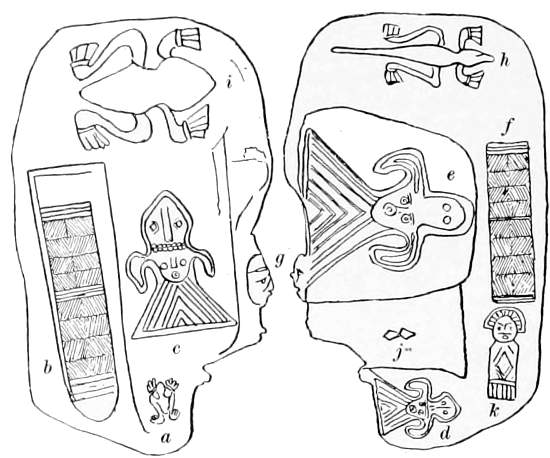
Fig. 980.—Chibcha symbols.
Wiener (f) gives the following summary of prominent Peruvian symbols:
In the conventional system of the Peruvians a bird indicates velocity, a lion strength, the lion and the bird united in one figure strength and velocity together, and, deductively, power. The meander indicates fertility and the pyramid with degrees or steps indicates defense. A bird combined with the meander indicates rapid production. A rectangular oblong figure (the mouth) indicates speech and discourse. A circle with a depression almost in the form of a heart means a female child, a circle with a small blade or stalk a male child. The circle with two stalks is the symbol of a man—the worker. The circle with four stalks means a married couple, marriage, etc.
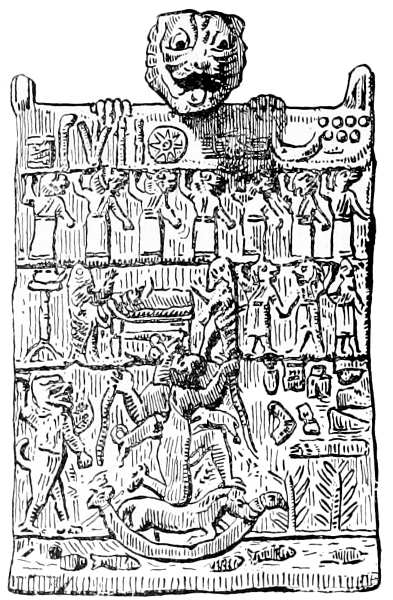
Fig. 981.—Syrian symbols.
Fig. 981 is presented to show another collection of engraved symbols, some of which with different execution resemble some found in North America. It is a bronze tablet found in Syria in the collection of M. Péretié, and is described by Maj. Claude R. Conder, R. F. (a):
It measures 4½ inches in height by 3¼ in width. The design is supposed to represent the fate of the soul according to Assyrian or Phenician belief. The tablet is divided into four compartments horizontally, the lowest being the largest and highest the most narrow. In the top compartment various astronomical symbols occur, many of which, as M. Canneau points out, occur on other Assyrian monuments. On the extreme right are the seven stars, next to these the crescent, next the winged solar disk, then an eight-rayed star in a circle. The remaining symbols are less easily explained, but the last is called by M. Canneau a “cidaris” or Persian tiara, while another appears to approach most nearly to the Trisul, or symbol of “fire,” the emblem of the Indian Siva.
Below these symbols stand seven deities facing to the right, with long robes, and the heads of various animals. The first to the left resembles a lion, the second a wolf or hound, the fourth a ram, the sixth a bird, the seventh a serpent, while the third and fifth are less easily recognized. In the third compartment a body lies on a bier, with a deity at the head, and another at the feet. These deities have the right hand held up, and the left down (a common feature of Indian symbolism also observable in the attitude of the Mâlawiyeh dervishes), and the figure to the left appears to hold a branch or three ears of corn. Both are robed in the peculiar fish-headed costume, with a scaly body and fish tail, which is supposed to be symbolical of the mythical Oannes, who according to Berosus, issued from the Persian gulf and taught laws and arts to the early dwellers on the Euphrates. Behind the left-hand fish-god is a tripod stand, on which is an indefinite object; to the right of the other fish-god are two lion-headed human figures with eagles’ claws, apparently contending with one another, the right arms being raised, the left holding hand by hand. To the right of these is another figure of Assyrian type, with a domed headdress and beard.
In the lowest compartment the infernal river fringed with rushes, and full of fish, is represented. A fearful lion-headed goddess with eagles’ claws kneels on one knee on a horse (the emblem of death) which is carried in a kneeling attitude on a boat with bird-headed prow. The goddess crushes a serpent in either hand, and two lion cubs are represented sucking her breasts. To the left is a demon bearing a close resemblance to the one which supports the tablet itself, and which appears to urge on the boat from the bank; to the right are various objects, mostly of an indefinite character, among which M. Ganneau recognizes a vase, and a bottle, a horse’s leg with hoof, etc.; possibly offerings to appease the infernal deities. The lion-headed goddess might well be taken for the terrible infernal deity Kali or Durga, the worship of whose consort, Yama, was the original source of that of the later Serapis, whose dog was the ancestor of Cerberus. There is also a general resemblance between this design and the well-known Egyptian picture representing the wicked soul conveyed to hell in the form of a pig.
The Oannes figures take the place of the two goddesses who in Egyptian designs stand at either end of the mummy and who form the prototype of the two angels for whom the pious Moslem provides seats at the head and foot of his tombstone. Perhaps the miserable horse who stumbles under the weight of the gigantic lion goddess may represent the unhappy soul itself, while the three ears of corn remind us of the grains of corn which have been found in skulls dug up in Syria by Capt. Burton. Corn is intimately connected with Dagon, the Syrian fish-god.
As a tentative suggestion I may, perhaps, be allowed to propose that the seven deities in the second compartment are the planets, and that the symbols above belong to them as follows, commencing on the right:
| Planet. | Assyrian name. | Head of deity. | Symbol. |
|---|---|---|---|
| 1. Saturn | Chiun | Serpent | Seven stars. |
| 2. Moon | Nannar | Bird | Crescent. |
| 3. Sun | Shamash | Boar (?) | Winged Disc. |
| 4. Mars | Marduk | Ram | Rayed disc. |
| 5. Mercury | Nebo | (?) | Two columns. |
| 6. Venus | Ishtar | Wolf (?) | Trisul. |
| 7. Jupiter | Ishn | Lion | Cidaris (?). |
The serpent is often the emblem of Saturn, who, as the eldest of the seven (“the great serpent father of the gods”), naturally comes first and therefore on the right, and has seven stars for his symbol.
The moon, according to Lenormant, was always an older divinity than the sun.
The boar is often an emblem of the sun in its strength.
The disc (litu) was the weapon employed by Marduk, the warrior god, as mentioned by Lenormant.
The two pillars of Hermes are the proper emblem of the ancient Set or Thoth, the planet Mercury.
The trisul belongs properly to the Asherah, god or goddess of fertility—the planet Venus.
The Cidaris occurs in the Bavian sculptures in connection with a similar emblem. In the Chaldean system, Jupiter and Venus occur together as the youngest of the planets.
It should also be noted that the position of the arms and the long robe covering the feet resemble the attitudes and dress of the Mâlawîyeh dervishes in their sacred dance, symbolic of the seven planets revolving (according to the Ptolemaic system) round the earth.
Didron (c) thus remarks upon the emblems in the Roman catacombs:
The large fish marks the fisher who catches it or the manufacturer who extracts the oil from it. The trident indicates the sailor, as the pick the digger. The trade of digger in the catacombs was quite elevated; the primitive monuments thus represent these men who are of the lower class among us, and who in the beginning of the Christian era, when they dug the graves of saints and martyrs, were interred side by side with the rich and even beside saints, and were represented holding a pickaxe in one hand and a lamp in the other; the lamp lighted them in their subterranean labors. The hatchet indicates a carpenter, and the capital a sculptor or an architect. As to the dove, it probably designates the duties of the mother of a family who nourishes the domestic birdlings as would appear to be indicated by a mortuary design in Bosis. It is possible, moreover, that it originated from a symbolic idea, but this idea would be borrowed from profane rather than religious sentiments, and I would more willingly see in it the memorial of the good qualities of the dead, man or woman, the fidelity of the wife, or of the dove, which returning to the ark after the deluge announced that the waters had retired and the land had again appeared; from this we can not conclude that the fish filled a rôle analogous to it, nor above all that it is the symbol of Christ; the dove is in the Old Testament, the fish neither in the old nor in the new.
Edkins (b) says respecting the Chinese:
It is easy to trace the process of symbol-making in the words used for the crenelated top of city walls, which are ya and c’hi, both meaning “teeth” and both being pictures of the object, and further, when the former is found also to be used for “tree buds” and “to bud.” Such instances of word creation show how considerable has been the prevalence of analogy and the association of ideas. The picture writing of the Chinese is to a large extent a continuation of the process of forming analogies to which the human mind had already become accustomed in the earlier stages of the history of language.
D’Alviella (b) furnishes this poetical and truthful suggestion:
It is not surprising that the Hindoos and Egyptians should both have adopted as the symbol of the sun the lotus flower, which opens its petals to the dawn and infolds them on the approach of night, and which seems to be born of itself on the surface of the still waters.
The use of color to be considered in studies of pictography is probably to be traced to the practice of painting on the surface of the human body. This use is very ancient. The Ethiopians in the army of Xerxes[619] applied vermillion and white plaster to their skins, and the German tribes when first known in history inscribed their breasts with the figures of divers animals. The North British clans were so much addicted to paint (or perhaps tattoo) that the epithet Picti was applied to them by the Romans. In this respect comparisons may be made with the Wichita, who were called by the French Pawnees Piqués, commonly rendered in English Pawnee Picts, and Marco de Niça, in Hakluyt, (e) says that Indians in the region of Arizona and New Mexico were called Pintados “because they painted their faces, breasts, and arms.” The general belief with regard to the employment of paint in the above and similar cases is that the colors had a tribal significance by which men became their own flags; the present form of flag not having great antiquity, as Clovis was the first among western monarchs to adopt it. Then the theory became current that colored devices, such as appeared on ensigns and on clothing, e. g., tartans, were imitated from the painted marks on the skin of the tribesmen. In this connection remarks made supra about tattoo designs are applicable. There is but little evidence in favor of the theory, save that fashions in colored decorations probably in time became tribal practices and so might have been evolved into emblems. But it is proper to regard such colorations as primarily ornamental, and to remember that even in England as late as the eighth century some bands of men were so proud of their decorated bodies that they refused to conceal them by clothes.
This topic may be divided into: 1. Decorative use of color. 2. Idiocrasy of colors. 3. Color in ceremonies. 4. Color relative to death and mourning. 5. Colors for war and peace. 6. Colors designating social status.
The following notes give instances of the use of painting which appear to be purely decorative:
Fernando Alarchon, in Hakluyt, (f) says of the Indians of the Bay of California: “These Indians came decked after sundry fashions, some came with a painting that couered their face all ouer, some had their faces halfe couered, but all besmouched with cole and euery one as it liked him best.”
John Hawkins, in Hakluyt, (g) speaking of the Florida Indians, tells of “Colours both red, blacke, yellow, and russet, very perfect, wherewith they so paint their bodies and Deere skinnes which they weare about them, that with water it neither faded away nor altereth in color.”
Maximilian of Wied (f), reports:
Even in the midst of winter the Mandans wear nothing on the upper part of the body, under their buffalo robe. They paint their bodies of a reddish brown colour, on some occasions with white clay, and frequently draw red or black figures on their arms. The face is, for the most part, painted all over with vermillion or yellow, in which latter case the circumference of the eyes and the chin are red. There are,[620] however, no set rules for painting, and it depends on the taste of the Indian dandy; yet, still, a general similarity is observed. The bands, in their dances and also after battles, and when they have performed some exploit, follow the established rule. In ordinary festivals and dances, and whenever they wish to look particularly fine, the young Mandans paint themselves in every variety of way, and each endeavors to find out some new mode. Should he find another dandy painted just like himself, he immediately retires and makes a change in the pattern, which may happen three or four times during the festival. If they have performed an exploit, the entire face is painted jet black.
A colored plate in the report of the Pacific Railroad Expedition (f) shows the designs adopted by the Mojave Indians for painting the body. These designs consist of transverse lines extending around the body, arms, and legs, or horizontal lines or different parts may partake of different designs. Clay is now generally used.
Everard F. im Thurn (h) describes the painting of the Indians of Guiana as follows:
The paint is applied either in large masses or in patterns. For example, a man, when he wants to dress well, perhaps entirely coats both his feet up to the ankles with a crust of red; his whole trunk he sometimes stains uniformly with blue-black, more rarely with red, or covers it with an intricate pattern of lines of either color; he puts a streak of red along the bridge of his nose; where his eyebrows were till he pulled them out he puts two red lines; at the top of the arch of his forehead he puts a big lump of red paint, and probably he scatters other spots and lines somewhere on his face. The women, especially among the Ackawoi, who use more body-paint than other ornament, are more fond of blue-black than of red; and one very favorite ornament with them is a broad band of this, which edges the mouth, and passes from the corners of that to the ears. Some women especially affect certain little figures, like Chinese characters, which look as if some meaning were attached to them, but which the Indians are either unable or unwilling to explain.
Kohl (a) says of the Indians met by him around Lake Superior that “The young men only paint—no women. When they become old they stop and cease to pluck out their beards which are an obstacle in painting.” It is probable that the custom of plucking the hairs originated in the attempt to facilitate face and body painting.
Herndon (b) gives the following report from the valley of the Amazon:
Met a Conibo on the beach. This man was evidently the dandy of his tribe. He was painted with a broad stripe of red under each eye; three narrow stripes of blue were carried from one ear, across the upper lip to the other—the two lower stripes plain, and the upper one bordered with figures. The whole of the lower jaw and chin were painted with a blue chain-work of figures, something resembling Chinese figures.
According to Dr. J. J. von Tschudi (b):
The uncivilized Indians of Peru paint their bodies, but not exactly in the tattoo manner; they confine themselves to single stripes. The Sensis women draw two stripes from the shoulder, over each breast, down to the pit of the stomach; the Pirras women paint a band in a form of a girdle round the waist, and they have three of a darker color round each thigh. These stripes, when once laid on, can never be removed by washing. They are made with the unripe fruit of one of the Rubiacaceæ. Some tribes paint the face only; others, on the contrary, do not touch that part; but bedaub with colors their arms, feet, and breasts.
F. J. Mouat, M. D., in Jour. Roy. Geogr. Soc., (a) says that Andaman Islanders rub red earth on the top of the head, probably for the purpose of ornamentation. This fashion is similar to that of some North American Indian tribes which rub red pigment on the parting of the hair.
Marcano (e) says:
The present Piaroas of Venezuela are in the habit of painting their bodies, but by a different process. They make stamps out of wood, which they apply to their skins after covering them with coloring matter.
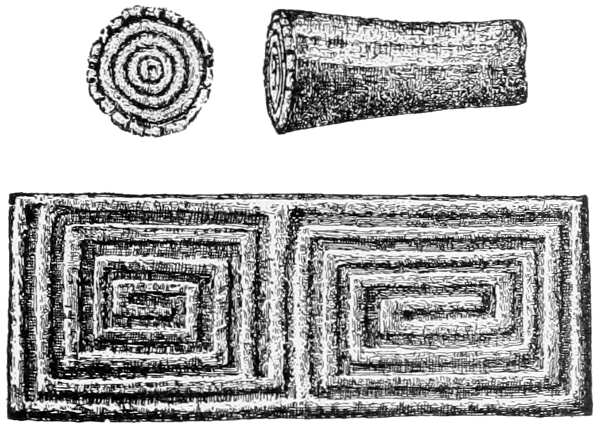
Fig. 982.—Piaroa color stamps.
Fig. 982 shows examples of these stamps. The most noteworthy thing about them is that they reproduce the types of certain petroglyphs, particularly of those of the upper Cuchivero (see Figs. 152 and 153, supra).
The Piaroas either copied the models they found carved on the rocks by peoples who preceded them, or they are aware of their meaning and preserved the tradition of it. The former hypothesis is the only tenable one. Not being endowed with inventive faculties, it seems more natural that they should simply have copied the only models they found. The Indians of French Guiana paint themselves in order to drive away the devil when they start on a journey or for war, whence Crevaux concludes that the petroglyphs must have been carved for a religious purpose. But painting is to the Piaroas a question of ornamentation and of necessity. It is a sort of garment that protects them against insects, and which, applied with extra care, becomes a fancy costume to grace their feasts and meetings.
It is to be noted that at least one instance is found of the converse of the Piaroa practice, by which the face-marks are used as the designs of pictographs on inanimate objects. The Serranos, near Los Angeles, California, formerly cut lines upon the trees and posts marking boundaries of land, these lines corresponding to those adopted by the owner as facial decorations.
A suggestion appropriate to this branch of the topic is presented in the answer communicated in a personal conversation of a Japanese lady who was asked why she blackened her teeth: “Any dog has white[622] teeth!” An alteration of the physical appearance is itself a distinction, and the greater the difference between the decorated person and the want of decoration in others the greater the distinction. Modern milliners, dressmakers, tailors and hatters, and their patrons pursue the same ends of fashionable distinction which are exhibited in rivalry for priority and singularity. These arbitrary fluctuations of fashion, which are seen equally in the Mandan and the millionaire, the Pueblan and the Parisian, are to be considered with reference to the supposed tribal significance of colors before mentioned. So far as they originated in fashion they changed with fashion, and the studies made in the preparation of this paper tend to a disbelief in their distinctness and stability. The conservatism of religious and of other ceremonial practices and of social customs preserved, however, a certain amount of consistency and continuity.
It has often been asserted that there was and is an intrinsic significance in the several colors. A traditional recognition of this among the civilizations connected with modern Europe is shown by the associations of death and mourning with black, of innocence and peace with white, danger with red, and epidemic disease officially with yellow. A comparison of the diverse conceptions attached to the colors will show great variety in their several attributions.
The Babylonians represented the sun and its sphere of motion by gold, the moon by silver, Saturn by black, Jupiter by orange, Mars by red, Venus by pale yellow, and Mercury by deep blue. Red was anciently and generally connected with divinity and power both priestly and royal. The tabernacle of the Israelites was covered with skins dyed red, and the gods and images of Egypt and Chaldea were of that color, which to this day is the one distinguishing the Roman Pontiff and the cardinals.
In ancient art each color had a mystic sense or symbolism, and its proper use was an essential consideration. With regard to early Christian art Mrs. Clement (a) furnishes the following account:
White is worn by the Saviour after his resurrection; by the Virgin in representations of the Assumption; by women as the emblem of chastity; by rich men to indicate humility; and by the judge as the symbol of integrity. It is represented sometimes by silver or the diamond, and its sentiment is purity, virginity, innocence, faith, joy, and light.
Red, the color of the ruby, speaks of royalty, fire, divine love, the holy spirit, creative power, and heat. In an opposite sense it symbolized blood, war, and hatred. Red and black combined were the colors of Satan, purgatory, and evil spirits. Red and white roses are emblems of love and innocence or love and wisdom, as in the garland of St. Cecilia.
Blue, that of the sapphire, signified heaven, heavenly love and truth, constancy and fidelity. Christ and the Virgin Mary wear the blue mantle; St. John a blue tunic.
Green, the emerald, the color of spring, expressed hope and victory.
Yellow or gold was the emblem of the sun, the goodness of God, marriage and fruitfulness. St. Joseph and St. Peter wear yellow. Yellow has also a bad signification when it has a dirty, dingy hue, such as the usual dress of Judas, and then signifies jealousy, inconstancy, and deceit.
Violet or amethyst signified passion and suffering or love and truth. Penitents, as the Magdalene, wear it. The Madonna wears it after the crucifixion, and Christ after the resurrection.
Gray is the color of penance, mourning, humility, or accused innocence.
Black with white signified humility, mourning, and purity of life. Alone, it spoke of darkness, wickedness, and death, and belonged to Satan. In pictures of the Temptation Jesus sometimes wears black.
The associations with the several colors above mentioned differ widely from those in modern folk-lore; for instance, those with green and yellow, the same colors being stigmatized in the old song that “green’s forsaken and yellow’s forsworn.”
The Hist. de Dieu, by Didron (d), contains the following:
The hierarchy of colors could well, in the ideas of the Middle Ages, have been allied at the same time to symbolism. The most brilliant color is gold, and here it is given to the greatest saints. Silver, color of the moon, which is inferior to the sun, but its companion, however, should follow; then red, or the color of fire, attribute of those who struggle against passion, and which is inferior to the two metals, gold and silver, to the sun and moon, of which it is but an emanation; next green, which symbolizes hope, and which is appropriate to married people; lastly, the uncertain yellowish color, half white and half yellow, a modified color, which is given to saints who were formerly sinners, but who have succeeded in reforming themselves and are made somewhat bright in the sight of God by penitence.
A note in the Am. Journal of Psychology, Vol. I, November, 1887, p. 190, gives another list substantially as follows:
Yellow, the color of gold and fire, symbolizes reason.
Green, the color of vegetable life, symbolizes utility and labor.
Red, the color of blood, symbolizes war and love.
Blue, the color of the sky, symbolizes spiritual life, duty, religion.
The colors attributed to the cardinal points have been the subject of much discussion. Some of these special color schemes of the North American Indians are now mentioned.
Mr. James Stevenson, in an address before the Anthropological Society of Washington, D. C.; Dr. Washington Matthews, U. S. Army, in the Fifth Ann. Rep. of the Bureau of Ethnology, p. 449; and Mr. Thomas V. Keam, in a MS. contribution, severally report the tribes mentioned below as using in their ceremonial dances the respective colors designated to represent the four cardinal points, viz:
| N. | S. | E. | W. | |
|---|---|---|---|---|
| Stevenson—Zuñi | Yellow. | Red. | White. | Black. |
| Matthews—Navajo | Black. | Blue. | White. | Yellow. |
| Keam—Moki | White. | Red. | Yellow. | Blue. |
Mr. Stevenson, in his paper on the Ceremonial of Hasjelti Dailjis, in the Eighth Ann. Rep. of the Bureau of Ethnology, agrees with Dr.[624] Matthews regarding the ceremonial scheme of the Navajo colors symbolic of the cardinal points, as follows: “The eagle plumes were laid to the east, and near by them white corn and white shell; the blue feathers were laid to the south, with blue corn and turquoise; the hawk feathers were laid to the west, with yellow corn and abalone shell; and to the north were laid the whippoorwill feathers, with black beads and corn of all the several colors.”
In A Study of Pueblo Architecture, by Mr. Victor Mindeleff, in the Eighth Ann. Rep. of the Bureau of Ethnology, the prayers of consecration by the Pueblos are addressed thus:
Mr. Frank H. Cushing, in Zuñi Fetiches, Second Ann. Rep., Bureau of Ethnology, pp. 16-17, gives the following:
In ancient times, while yet all beings belonged to one family, Po-shai-ang-k’ia, the father of our sacred bands, lived with his children (disciples) in the City of the Mists, the middle place (center) of the medicine societies of the world. When he was about to go forth into the world he divided the universe into six regions, namely, the North (Direction of the swept or barren place); the West (Direction of the Home of the Waters); the South (Direction of the Place of the Beautiful Red); the East (Direction of the Home of Day); the Upper Regions (Direction of the Home of the High); and the Lower Regions (Direction of the Home of the Low).
In the center of the great sea of each of these regions stood a very ancient sacred place—a great mountain peak. In the North was the Mountain Yellow, in the West the Mountain Blue, in the South the Mountain Red, in the East the Mountain White, above the Mountain All-color, and below the Mountain Black.
We do not fail to see in this clear reference to the natural colors of the regions referred to—to the barren North and its auroral hues, the West with its blue Pacific, the rosy South, the white daylight of the east, the many hues of the clouded sky, and the black darkness of the “caves and holes of earth.” Indeed these colors are used in the pictographs and in all the mythic symbolism of the Zuñis to indicate the directions or regions respectively referred to as connected with them.
Mr. A. S. Gatschet (a), in Proc. Am. Philos. Soc., gives the symbolic colors of the Isleta Pueblo for the points of the compass, as “white for the east; from there they go to the north, which is black; to the west, which is blue; and to the south, which is red.”
Mr. James Mooney, in Seventh Ann. Rep., Bureau Ethnology, p. 342, says that the symbolic color system of the Cherokees is:
In the ceremonies of the Indians of the plains it is common that the smoke of the sacred pipe should be turned first directly upward, second directly downward, and then successively to the four cardinal points, but without absolute agreement among the several tribes as to the order of that succession. In James’ Long (i), it is reported that in a special ceremony of the Omaha regarding the buffalo the first whiff of[625] smoke was directed to them, next to the heavens, next to the earth, and then successively to the east, west, north, and south. The rather lame explanation was given that the east was for sunrise, the west for sunset, the north for cold country, and the south for warm country.
The Count de Charencey, in Des Couleurs considérés comme symboles des Pointes de l’Horizon, etc., and in Ages ou Soleils, gives as the result of his studies that in Mexico and Central America the original systems were as follows:
Quaternary system.
East—Yellow.
North—Black.
West—White.
South—Red.
Quinary system.
South—Blue.
East—Red.
North—Yellow.
West—White.
Center—Black.
Mr. John Crawford (a) says:
In Java the divisions of the horizon and the corresponding colors were named in the following order: first, white and the east; second, red and the south; third, yellow and the west; fourth, black and the north; and fifth, mixed colors and the focus or center.
Boturini (a) gives the following arrangement of the “symbols of the four parts or angles of the world,” comparing it with that of Gemelli:
| Gemelli. | Boturini. |
| 1. Tochtli—South. | 1. Tecpatl—South. |
| 2. Acatl—East. | 2. Calli—East. |
| 3. Tecpatl—North. | 3. Tochtli—North. |
| 4. Calli—West. | 4. Acatl—West. |
| SYMBOLS OF THE FOUR ELEMENTS. | |
| Gemelli. | Boturini. |
| 1. Tochtli—Earth. | 1. Tecpatl—Fire. |
| 2. Acatl—Water. | 2. Calli—Earth. |
| 3. Tecpatl—Air. | 3. Tochtli—Air. |
| 4. Calli—Fire. | 4. Acatl—Water. |
Herrera (a) speaks only of the year symbols and colors, and, although he does not directly connect them, indicates his understanding in regard thereto by the order in which he mentions them:
They divided the year into four signs, being four figures; the one of a house, another of a rabbit, the third of a cane, the fourth of a flint, and by them they reckoned the year as it passed on. * * * They painted a sun in the middle from which issued four lines or branches in a cross to the circumference of the wheel, and they turned so that they divided it into four parts and the circumference and each of them moved with its branch of the same color, which were four—green, blue, red, and yellow.
From this statement Prof. Cyrus Thomas, in Notes on certain Maya and Mexican Manuscripts, Third Ann. Rep., Bureau of Ethnology, concludes that Herrera’s arrangement would presumably be as follows:
Combining these several lists it would appear that Calli, color green, was Fire and West or Earth and East; Tochtli, color blue, was Earth and South or Air and North; Acatl, color red, was Water and East or Water and West; Tecpatl, color yellow, was Air and North or Fire and South.
The foregoing notes leave the symbolic colors of the cardinal points in a state of confusion, and on calm reflection no other condition could be expected. Taking the idea of the ocean blue, for instance, and recognizing the impressive climatic effects of the ocean, the people examined may be in any direction from the ocean and to each of them its topographic as well as color relation differs. If it shall be called blue, the color blue may be north, south, east, or west. So as to the concepts of heat and cold, however presented in colors by the fancy, heat being sometimes red and sometimes yellow, cold being sometimes considered as black by the manifestation of its violent destruction of the tissues and sometimes being more simply shown as white, the color of the snow. Also the geographic situation of the people must determine their views of temperature. The sun in tropical regions may be an object of terror, in Arctic climes of pure beneficence, and in the several seasons of more temperate zones the sun as fire, whether red or yellow, may be destructive or life-giving. Regarding the symbols of the cardinal points it seems that there is nothing intrinsic as to colors, but that the ideograms connected with the topic are local and variant. As the ancient assignments of color to the cardinal points are not established and definite among people who have been long settled in their present habitat, the hope of tracing their previous migration by that line of investigation may not be realized.
The following account of the degree posts of the Grand Medicine Society of the Ojibwa is condensed from an article by Dr. Hoffman in the Am. Anthropologist for July, 1889:
In constructing the inclosure in which the Midē' priests practice the rites and ceremonies of initiation, a single post, from 4 to 5 feet in height and about 8 inches thick, is planted at a point opposite the main entrance, and about three-fourths the entire distance of the interior from it. This post is painted red, with a band of green about the top, of the width of a palm.
The red and green colors are used to designate the Midē' society, but for what reason is not positively known. The green appears to have some connection with the south, the sources of heat and abundance of crops; the thunder-bird also comes from that direction in the springtime, bringing rain, which causes the grass and fruits to grow, giving an abundance of food.
For the second degree two posts are erected within the inclosure, the first being like that for the first degree, the second being planted nearer the main entrance, though not far from the opposite end of the structure; this post is painted red and is covered with white spots made by applying white clay with the finger tip. These spots are symbolical of the migis shell, the sacred emblem of the Grand Medicine Society.
The third degree contains three posts, the two preceding ones being used, to which a third is added and planted in a line with them; this post is painted black.
In the fourth degree the additional post is really a cross, a crosspiece of wood being[627] attached near the top; the lower part of the upright piece is squared, the side on the east being painted white; on the south, green; on the west, red; and on the north, black. The white is the source of light facing the direction of the rising sun, the green, apparently the source of warmth, rains, and abundance of crops, while the north is black, and pertains to the region from which come cold, disease, and desolation. The red is placed upon the western side, but there is a diversity of opinion regarding its significance. The most plausible theory appears to relate to the “road of the dead,” referred to in the ritual of the Ghost Society, as the path upon which the departed shadow partakes of the gigantic strawberry which he finds. The upper portion of the cross is white, upon which are placed irregularly red spots.
In the same article is the following account of face coloring in the Midē' degrees:
In connection with the colors of the degree posts, there is a systematic arrangement of facial ornamentation, each style to be characteristic of one of the four degrees, as well as the degree of the Ghost Society.
According to the White Earth (Minnesota) method, the arrangement is as follows:
First degree. One red stripe across the face from near the ears across the tip of the nose.
Second degree. One stripe as above and another across the eyes, temples, and root of the nose.
Third degree. The upper half of the face painted green and the lower half red.
Fourth degree. The forehead and the left side of the face from the outer canthus of the eye downward is painted green; four spots of vermilion are made with the tip of the finger upon the forehead and four upon the green surface of the left cheek.
According to Sikassige, a Mille Lacs Midē' priest, the ornamentation practiced during his youth was as follows:
First degree. A broad band of green across the forehead and a narrow stripe of vermilion across the face just below the eyes.
Second degree. A narrow stripe of vermilion across the temple, eyelids, and the root of the nose, a short distance above which is a similar stripe of green, then another of vermilion, and above this again one of green.
Third degree. Red and white spots are daubed all over the face, the spots averaging three-fourths of an inch each in diameter.
Fourth degree. Two forms are admissible; in the former the face is painted red, with a stripe of green extended diagonally across it from the upper part of the left temporal region to the lower part of the right cheek. In the latter the face is painted red with two short, horizontal parallel green bars across the forehead.
Either of these may be adopted as a sign of mourning by a man whose deceased son had been intended for the priesthood of the Grand Medicine Society.
The religious and ceremonial use of the color red by the New Zealanders is mentioned by Taylor (d):
Closely connected with religion, was the feeling they entertained for the Kura, or Red Paint, which was the sacred color; their idols, Pataka, sacred stages for the dead, and for offerings or sacrifices, Urupa graves, chief’s houses, and war canoes, were all thus painted.
The way of rendering anything tapu was by making it red. When a person died, his house was thus colored; when the tapu was laid on anything, the chief erected a post and painted it with the kura; wherever a corpse rested, some memorial was set up, oftentimes the nearest stone, rock, or tree served as a monument; but whatever object was selected, it was sure to be made red. If the corpse were conveyed by water, wherever they landed a similar token was left; and when it reached its destination, the canoe was dragged on shore, thus distinguished, and abandoned. When the hahunga took place, the scraped bones of the chief, thus ornamented, and wrapped[628] in a red-stained mat, were deposited in a box or bowl, smeared with the sacred color, and placed in a tomb. Near his final resting place a lofty and elaborately carved monument was erected to his memory; this was called he tiki, which was also thus colored.
In former times the chief anointed his entire person with red ocher; when fully dressed on state occasions, both he and his wives had red paint and oil poured upon the crown of the head and forehead, which gave them a gory appearance, as though their skulls had been cleft asunder.
Mr. S. Gason reports in Worsnop, op. cit.:
On the Cooper, Herbert, and Diamentina rivers of the North there are no paintings in caves, but in special corroborees the bodies of the leading dancers are beautifully painted with every imaginable color, representing man, woman, animals, birds, and reptiles, the outlines being nearly faultless, and in proportion, independent of the blending of the colors.
These paintings take about seven or eight hours’ hard tedious work for two men, one in front, the other at the back of the man who is to be painted, and when these men who are painted display themselves, surrounded by bright fires and rude torches, it has an enchanting effect to the others. After the ceremony is over, the paintings are allowed to be examined, and the artists congratulated or criticised.
At the other ceremonies, after returning from “Bookatoo” (red ocher expedition), they paint a few of their dancers with all the colors of the rainbow, the outlines showing all the principal species of snakes. They are well drawn and colored, and take many hours of labor to complete.
These paintings of snakes are done for the purpose of having a good harvest of snakes. The women are not allowed to attend at this ceremony, as it is one of their strict secret dances.
A few notes of other ceremonial and religious uses of color are presented.
Capt. John G. Bourke (f) says that the Moki employ the colors in prayers—yellow for pumpkins, green for corn, and red for peaches. Black and white bands are typical of rain, and red and blue bands, of lightning.
In James’s Long (k), it is mentioned of the Omaha that the boy who goes to fast on the hill top to see his guardian spirit, as a preparation rubs his body over with whitish clay, but the same ceremonial among the Ouenebigonghelins near Hudson bay is described by Bacqueville de la Potherie (d), with the statement that the postulant paints his face black.
Peter Martyr (a) says the natives of the Island of Hispaniola [Haiti] when attending a festival at the religious edifice, go in a procession having their bodies and faces painted in black, red, and yellow colors. Some had feathers of the parrot and other birds, with which they decorated themselves. The women had no decoration.
Pénicaut’s Relation, A. D. 1704, in Margry (f), gives an account of decorations of the victims who die with the grand chief, or Sun of the Natchez. Their faces were painted vermilion, as the author says, “lest they by paleness should show their fear.” Though the practice may have thus originated as a mere expedient, red thus used would become in time a sacrificial color.
But the color red can not always be deduced from such an origin. It is connected with the color of fire and of blood. The Romans on great festivals[629] painted the face of Jupiter Capitolinus with vermilion. They painted in the same way all the statues of the gods, demi-gods, heroes, fauns, and satyrs. Pan is described by Virgil in Ecl. X, line 27:
Pan, deus Arcadiæ venit, quem vidimus ipsi
Sanguineis ebuli baccis minioque rubentem.
These verses are rendered with spirit by R. C. Singleton, Virgil in English Rhythm, London, 1871, though the translator wrote “cinnabar” instead of “red lead” and might as well have used the correct word, “minium,” which has the same prosodial quantity as cinnabar.
Pan came, the god of Arcady, whom we
Ourselves beheld, with berries bloody red
Of danewort, and with cinnabar aglow.
In Chapman’s translation of Homer’s hymn to Pan the god is again represented stained with red, but with the original idea of blood.
A lynx’s hide, besprinkled round about
With blood, cast on his shoulders.
By imitation of greatness and the semblance of divinity the faces of generals when they rode in triumph, e. g., Camillus as mentioned by Pliny, quoting Verrius, were painted red.
On the tree which supports the Vatican figure of the Apollo Belvedere are traces of an object supposed to be the στέμμα δελφικόν, which was composed of bushy tufts of Delphian laurel bound with threads of red wool into a series of knots and having at each end a tassel. This is an old sign of consecration and is possibly connected with the traditional gipsy sign of mutual binding in love signified by a red knot, as mentioned in a letter from Mr. Charles G. Leland.
The Spaniards distinguished red as the color par excellence, and among many of the savage and barbaric peoples red is the favorite and probably once was the sacred color.
Charlevoix (a) says of the Micmacs that “their mourning consisted in painting themselves black and in great lamentations.”
Champlain (f), in 1603, described the mourning posts of the northeastern Algonquian tribes as painted red.
Keatings’ Long (g) tells that the Sac Indians blackened themselves with charcoal in mourning and during its continuance did not use any vermilion or other color for ornamentation.
Some of the Dakota tribes blackened the whole face with charcoal for mourning, but ashes were also frequently employed.
Col. Dodge (a) says that the Sioux did not use the color green in life, but that the corpses were wrapped in green blankets. The late Rev. S. D. Hinman, who probably was, until his death within the last year, the best authority concerning those Indians, contradicts this statement in a letter, declaring that the Sioux frequently use the color green in their face-painting, especially when they seek to disguise themselves,[630] as it gives so different an expression. If it is not used as generally as blue or yellow the reason is that it is seldom found in the clays which were formerly relied upon and therefore it required compounding. Also they do not use green as painting or designation for the dead, but red, that being their decoration for the “happy hunting ground.” But the color for the mourning of the survivors is black.
Thomas L. McKenny (a) says the Chippeway men mourn by painting their faces black.
The Winnebago men blacken the whole face with charcoal in mourning. The women make a round black spot on both cheeks.
Dr. Boas, in Am. Anthrop. (a), says of Snanaimuq, a Salish tribe:
The face of the deceased is painted red and black. After the death of husband or wife the survivor must paint his legs and his blanket red. For three or four days he must not eat anything; then three men or women give him food, and henceforth he is allowed to eat.
In Bancroft (d) it is mentioned that the Guatemalan widower dyed his body yellow.
Carl Bock (b) describes the mourning solemnities in Borneo as being marked chiefly by white, the men and women composing the mourning processions being enveloped in white garments, and carrying white flags and weapons and ornaments, all of which were covered with white calico.
A. W. Howitt (h) says of the Dieri of Central Australia:
A messenger who is sent to convey the intelligence of a death is smeared all over with white clay. On his approach to the camp the women all commence screaming and crying most passionately. * * * Widows and widowers are prohibited by custom from uttering a word until the clay of mourning has worn off, however long it may remain on them. They do not, however, rub it off, as doing so would be considered a bad omen. It must absolutely wear off of itself. During this period they communicate by means of gesture language.
A. C. Haddon (b) tells that among the western tribes of Torres strait plastering the body with gray mud was a sign of mourning.
Elisée Reclus (c) says: “In sign of mourning the Papuans daub themselves in white, yellow, or black, according to the tribes.”
D’Albertis (d) reports that the women of New Guinea paint themselves black all over on the death of a relation, but that there are degrees of mourning among the men, e. g., the son of the deceased paints his whole body black, but other less related mourners may only paint the face more or less black. In Vol. II, p. 9, a differentiation is shown, by which in one locality the women daubed themselves from head to foot with mud. The same author says, in the same volume, p. 378, that the skulls preserved in their houses are always colored red and their foreheads frequently marked with some rough design.
In Armenia, as told in The Devil Worshipers of Armenia, in Scottish Geog. Mag., viii, p. 592, widows dress in white.
In Notes in East Equatorial Africa, Bull. Soc. d’Anthrop. de Brux. (b), it is told that in the region mentioned the women rub flour over their bodies on the death or departure of the husband.
Sir G. Wilkinson (a) writes that the ancient Egyptians in their mourning ceremonies wore white fillets, and describes the same use of the color white in the funeral processions painted on the walls of Thebes.
Dr. S. Wells Williams (a) reports of the Chinese mourning colors that “the mourners are dressed entirely in white or wear a white fillet around the head. In the southern districts half-mourning is blue, usually exhibited in a pair of blue shoes and a blue silken cord woven in the queue, instead of a red one; in the northern provinces white is the only mourning color seen.”
Herr von Brandt, in the Ainos and Japanese, Journal of the Anthrop. Inst. G. B. and I. (e), tells that the coffins of the deceased Mikados were covered with red, that is, with cinnabar.
These colors, respecting the Algonquian Indians, are mentioned in 1763, as published in Margry, to the effect that red feathers on the pipe signify war, and that other colors [each of which may have a modifying or special significance] mean peace.
W. W. H. Davis (b) recounts that “in 1680 the Rio Grande Pueblos informed the Spanish officers that they had brought with them two crosses, one painted red, which signified war, and the other white, which indicated peace, and they might take their choice between the two.”
Capt. de Lamothe Cadillac (b), writing in the year 1696 of the Algonquians of the Great Lake region near Mackinac, etc., describes their decorations for war as follows:
On the day of departure the warriors dress in their best. They color their hair red; they paint their faces red and black with much skill and taste, as well as the whole of their bodies. Some have headdresses with the tail feathers of eagles or other birds; others have them decorated with the teeth of wild beasts, such as the wolf or tiger [wild cat]. Several adorn their heads, in lieu of hats, with helmets bearing the horns of deer, roebuck, or buffalo.
Schoolcraft (r) says that blue signifies peace among the Indians of the Pueblo of Tesuque.
The Dakota bands lately at Grand river agency had the practice of painting the face red from the eyes down to the chin when going to war.
The Absaroka or Crow Indians generally paint the forehead red when on the warpath. This distinction of the Crows is also noted by the Dakota in recording pictographic narratives of encounters with the Crows.
Haywood (e) says of the Cherokees:
When going to war their hair is combed and annointed with bear’s grease and the red root, Sanguinaria canadensis, and they adorn it with feathers of various beautiful colors, besides copper and iron rings, and sometimes wampum or peak in the ears; and they paint their faces all over as red as vermilion, making a circle of black about one eye and another circle of white about the other.
H. H. Bancroft (e) tells that when a Modoc warrior paints his face black before going into battle it means victory or death, and that he[632] will not survive a defeat. In the same volume, p. 105, he says that when a Thlinkit arms himself for war he paints his face and powders his hair a brilliant red. He then ornaments his head with a white eagle feather as a token of stern, vindictive determination.
Mr. Dorsey reports that when the Osage men go to steal horses from the enemy they paint their faces with charcoal. [Possibly this may be for disguise, on the same principle that burglars use black crape.] The same authority gives the following description of the Osage paint for war parties:
Before charging the foe the Osage warriors paint themselves anew. This is called the death paint. If any of the men die with this paint on them the survivors do not put on any other paint.
All the gentes on the “Left” side use the “fire paint,” which is red. It is applied by them with the left hand all over the face. And they use prayers about the fire: “As the fire has no mercy, so should we have none.” Then they put mud on the cheek, below the left eye, as wide as two or more fingers. The horse is painted with some of the mud on the left cheek, shoulder, and thigh.
The following extract is from Belden (b):
The sign paints used by the Sioux Indians are not numerous, but very significant. When the warriors return from the warpath and have been successful in bringing back scalps, the squaws, as well as the men, paint with vermilion a semicircle in front of each ear. The bow of the arc is toward the nose and the points of the half-circle on the top and bottom of the ear; the eyes are then reddened and all dance over the scalps.
John Lawson (a) says of the North Carolina Indians:
When they go to war * * * they paint their faces all over red, and commonly make a circle of black about one eye and another circle of white about the other, while others bedaub their faces with tobacco-pipe clay, lampblack, black lead, and divers other colors, etc.
De Brahm, in documents connected with the History of South Carolina (a), reports that the Indians of South Carolina “painted their faces red in token of friendship and black in expression of warlike intentions.”
Rev. M. Eells (a) says of the Twana Indians of the Skokomish reservation that when about to engage in war “they would tamanamus in order to be successful and paint themselves with black and red, making themselves as hideous as possible.”
The U. S. Exploring Expedition (b), referring to a tribe near the Sacramento river, tells that the chief presented them with a tuft of white feathers stuck on a stick about 1 foot long, which was supposed to be a token of friendship.
Dr. Boas, in Am. Anthrop. (b), says of the Snanaimuq that before setting out on war expeditions they painted their faces red and black.
Peter Martyr (b) says of the Ciguaner Indians:
The natives came out of the forest painted and daubed with spots. For it is their custom, when they go to war, to daub themselves from the face to the knee with black and scarlet or purple color in spots, which color they [obtain] from some curious fruits resembling “Pyren,” which they plant and cultivate in their gardens with the greatest care. Similarly they also cause the hair to grow in a thousand very curious[633] shapes, if it is not by nature long or black enough, so that they look not otherwise than if the similar devil or hellish Circe came running out of hell.
Curr (c) tells that the Australians whitened themselves with white clay when about to engage in war. Some African tribes, according to Du Chaillu, also paint their faces white for war.
Haddon (c) says of the western tribe of Torres straits:
When going to fight the men painted their bodies red, either entirely so or partially, perhaps only the upper portion of the body and the legs below the knees, or the head and upper part of the body only. The body was painted black all over by those who were actually engaged in the death dance.
Du Chaillu (c) tells that among the Scandinavians there were peace and war shields, the former white and the latter red. When the white was hoisted on a ship it was a sign for the cessation of hostility, in the same manner that a flag of the same color is now used to procure or mark a truce. The red shield displayed on a masthead or in the midst of a body of men was the sign of hostility.
The following extract is translated, from Peter Martyr (c):
For the men are in body long and straight, possess a vivid and natural complexion which compares somewhat with a red and genuine flesh color. Their whole body and skin is lined over with sundry paints and curious figures, which they consider as a handsome ornament and fine decoration, and the uglier a man’s painting or lining over is the prettier he considers himself to be, and is also regarded as the most noble among their number.
Mr. Dorsey reports of the Osages that all the old men who have been distinguished in war are painted with the decorations of their respective gentes. That of the Tsicu wactake is as follows: The face is first whitened all over with white clay; then a red spot is made on the forehead and the lower part of the face is reddened; then with the fingers the man scrapes off the white clay, forming the dark figures by letting the natural color of the face show through.
H. H. Bancroft (f), citing authorities, says the central Californians (north of San Francisco bay) formerly wore the down of Asclepias (?) (white) as an emblem of royalty; and in the same volume, p. 691, it is told that the natives of Guatemala wore red feathers in their hats, the nobles only wearing green ones.
The notes immediately following are about the significant use of color, not readily divisible into headings.
Belden (c) furnishes the following remarks:
The Yanktons, Sioux, Santees, and Cheyennes use a great deal of paint. A Santee squaw paints her face the same as a white woman does, only with less taste. If she wishes to appear particularly taking she draws a red streak half an inch wide from ear to ear, passing it over the eyes, the bridge of the nose, and along the middle of the cheek. When a warrior desires to be left alone he takes black paint or lampblack and smears his face; then he draws zigzag lines from his hair to his chin by scraping off the paint with his nails. This is a sign that he is trapping, is melancholy, or in love.
A Sioux warrior who is courting a squaw usually paints his eyes yellow and blue and the squaw paints hers red. I have known squaws to go through the painful operation of reddening the eye-balls, that they might appear particularly fascinating to the young men. A red stripe drawn horizontally from one eye to the other means that the young warrior has seen a squaw he could love if she would reciprocate his attachment.
As narrated by H. H. Bancroft, the Los Angeles county Indian girls paint the cheeks sparingly with red ocher when in love. This also prevails among the Arikara, at Fort Berthold, Dakota.
La Potherie (e) says that the Indian girls of a tribe near Hudson bay, when they have arrived at the age of puberty, at the time of its sign, daub themselves with charcoal or a black stone, and in far distant Yucatan, according to Bancroft (h), the young men restricted themselves to black until they were married, indulging afterwards in varied and bright colored figures.
The color green is chiefly used symbolically as that of grass, with reference to which Father De Smet’s MS. on the dance of the Tinton Sioux contains these remarks: “Grass is the emblem of charity and abundance; from it the Indians derive the food for their horses and it fattens the wild animals of the plains, from which they derive their subsistence.”
Brinton (d) gives the following summary:
Both green and yellow were esteemed fortunate colors by the Cakchiquels, the former as that of the flourishing plant, the latter as that of the ripe and golden ears of maize. Hence, says Coto, they were also used to mean prosperity.
The color white, zak, had, however, by far the widest metaphorical uses. As the hue of light, it was associated with day, dawn, brightness, etc.
Marshall (b) gives as the explanation why certain gracious official documents are sealed with green that the color expresses youth, honor, beauty, and especially liberty.
H. M. Stanley (a) gives the following use of white as a sign of innocence: “Qualla drew a piece of pipeclay and marked a broad white band running from the wrist to the shoulder along each arm of Ngalyema, as a sign to all men present that he was guiltless.”
H. Clay Trumbull (a) says:
The Egyptian amulet of blood friendship was red, as representing the blood of the gods. The Egyptian word for “red” sometimes stood for “blood.” The sacred directions in the Book of the Dead were written in red; hence follows our word “rubrics.” The rabbis say that, when persecution forbade the wearing of the phylacteries with safety, a red thread might be substituted for this token of the covenant with the Lord. It was a red thread which Joshua gave to Rahab as a token of her covenant relations with the people of the Lord. The red thread, in China, to-day, binds the double cup, from which the bride and bridegroom drink their covenant draught of “wedding wine,” as if in symbolism of the covenant of blood. And it is a red thread which, in India, to-day, is used to bind a sacred amulet around the arm or the neck. * * * Upon the shrines in India the color red shows that worship is still living there; red continues to stand for blood.
Mr. Mooney, in the Seventh Annual Report, Bureau of Ethnology, shows that to the Cherokee the color blue signifies grief or depression of[635] spirits, a curious parallel to the colloquial English phrase “has the blues” and wholly opposite to the poetical symbol of blue for hope.
The notes above collected on the general topic of color symbolism might be indefinitely extended. Those presented, however, are typical and perhaps sufficient for the scope of the present work. In regarding ideography of colors the first object is to expunge from consideration all merely arbitrary or fanciful decorations, which is by no means easy, as ancient customs, even in their decadence or merely traditional, preserve a long influence. But as a generalization it seems that all common colors have been used in historic times for nearly all varieties of ideographic expression by the several divisions of men, and that they have differed fundamentally in the application of those colors. Yet there was an intelligent origin in each one of those applications of color. With regard to mourning the color black is now considered to be that of gloom. It was still earlier expressed by casting ashes or earth over the head and frame, and possibly the somber paint was adopted for cleanliness, the concept being preserved and indeed intensified by durable blackness instead of the mere transient dinginess of dirt, although the actual defilement by the latter is thereby only symbolized. This gloom is the expression of the misery of the survivors, perhaps of their despair as not expecting any happiness to the dead or any hope of a meeting in another world. Other lines of thought are shown by blue, considered as the supposed sky or heavenly home of the future, and by green, as suggesting renewal or resurrection, and those concepts determine the mourning color of some peoples. Red or yellow may only refer to the conceptions of the colors of flames, and therefore might simply be an objective representation of the disposition of the corpse, which very often was by cremation. But sometimes these colors are employed as decoration and display to proclaim that the dead go to glory. White, used as frequently by the populations of the world as other funeral colors, may have been only to assert the purity and innocence of the departed, an anticipation of the flattering obituary notices or epitaphs now conventional in civilized lands.
With regard to the color red, it may be admitted that it originally represents blood; but it may be, and in fact is, used for the contradictory concepts of war and peace. It is used for war as suggesting the blood of the enemy, for peace and friendship to signify the blood relation or blood covenant, the strongest tie of love and friendship.
So it would seem that, while colors have been used ideographically, the ideas which determined them were very diverse and sometimes their application has become wholly conventional and arbitrary. A modern military example may be in point which has no connection with the well-known squib of an English humorist. One of the officers of the U. S. Army of the last generation when traveling in Europe was much disgusted to observe that a green uniform was used in some of the armies for the corps of engineers and for branches of the service other[636] than rifles or tirailleurs. He insisted that the color naturally and necessarily belongs to the Rifles, because the soldiers of that arm when clad with that color were most useful as skirmishers in wooded regions. This reason for the selection of green for the riflemen who composed a part of the early army of the United States is correct, but in the necessity for the distinction of special uniforms for the several component parts of a military establishment, whether in Europe or America, the original and often obsolete application of color was wholly disregarded and colors were selected simply because they were not then appropriated by other branches of the service. So in the late formation of the signal corps of the U. S. Army, the color of orange, which had belonged to the old dragoons, was adopted simply because it was a good color no longer appropriated.
With these changes by abandonment and adoption comes fashion, which has its strong effect. It is even exemplified where least expected, i. e., in Stamboul. Every one knows that the descendants of the Prophet alone are entitled to wear green turbans, but a late Sultan, not being of the blood of Mohammed, could not wear the color, so the emirs who could do so carefully abstained from green in his presence and the color for the time was unfashionable.
As the evolution of clothing commenced with painting and tattooing, it may be admitted that what is now called fashion must have had its effect on the earlier as on the later forms of personal decoration. Granting that there was an ideographic origin to all designs painted on the person, the ambition or vanity of individuals to be distinctive and to excel must soon have introduced varieties and afterward imitations of such patterns, colors, or combinations as favorably struck the local taste. The subject therefore is much confused.
An additional suggestion comes from the study of the Mexican codices. In them color often seems to be used according to the fancy of the scribe. Compare pages 108 and 109 of the Codex Vaticanus, in Kingsborough, Vol. II, with pages 4 and 5 of the Codex Telleriano Remensis, in part 4 of Kingsborough, Vol. I, where the figures and their signification are evidently the same, but the coloration is substantially reversed.
A comparison of Henry R. Schoolcraft’s published coloration with the facts found by the recent examination of the present writer is set forth with detail on page 202, supra.
In his copious illustrations colors were exhibited freely and with stated significance, whereas, in fact, the general rule in regard to the birch-bark rolls is that they were never colored at all; indeed, the bark was not adapted to coloration. His colors were painted on and over the true scratchings, according to his own fancy. The metaphorical coloring was also used by him in a manner which, to any thorough student of the Indian philosophy and religions, seems absurd. Metaphysical significance is attached to some of the colored devices, or, as he calls[637] them, symbols, which could never have been entertained by a people in the stage of culture of the Ojibwa, and those devices, in fact, were ideograms or iconograms.
Among people where a system of ideographic gesture signs has prevailed it would be expected that their form would appear in any mode of pictorial representation used with the object of conveying ideas or recording facts. When a gesture sign had been established and it became necessary or desirable to draw a character or design to convey the same idea, nothing could be more natural than to use the graphic form or delineation which was known and used in the gesture sign. It was but one more step, and an easy one, to fasten upon bark, skins, or rocks the evanescent air pictures of the signs.
In the paper “Sign language among the North American Indians,” published in the First Ann. Rep. of the Bureau of Ethnology, a large number of instances were given of the reproduction of gesture lines in the pictographs made by those Indians, and they appeared to be most frequent when there was an attempt to convey subjective ideas. It was suggested, therefore, that those pictographs which, in the absence of positive knowledge, are the most difficult of interpretation were those to which the study of sign-language might be applied with advantage. The topic is now more fully discussed. Many pictographs in the present work, the meaning of which is definitely known from direct sources, are noted in connection with the gesture-signs corresponding with the same idea, which signs are also understood from independent evidence or legitimate deduction.
Dr. Edkins (c) makes the following remarks regarding the Chinese characters, which are applicable also to the picture-writing of the North American Indians, and indeed to that of all peoples among whom it has been cultivated:
The use of simple natural shapes, such as the mouth, nose, eye, ear, hand, foot, as well as the shape of branches, trees, grass, caves, holes, rivers, the bow, the spear, the knife, the tablet, the leaf—these formed, in addition to pictures of animals, much of the staple of Chinese ideographs.
Attention should be drawn to the fact that the mouth and the hand play an exceptionally important part in the formation of the symbols.
Men were more accustomed then than now to the language of signs by the use of these organs. Perhaps three-twentieths of the existing characters are formed by their help as one element.
This large use of the mouth and hand in forming characters is, as we may very reasonably suppose, only a repetition of what took place when the words themselves were made.
There is likely to be a primitive connection between demonstratives and names for the hand, because the hand is used in pointing.
Fig. 983 is a copy of a colored petroglyph on a rock in the valley of Tule river, California, further described on page 52, et seq., supra.
a, a person weeping. The eyes have lines running down to the breast, below the ends of which are three short lines on either side. The arms and hands are in the exact position for making the gesture for rain. See h in Fig. 999, meaning eye-rain, and also Fig. 1002. It was probably the intention of the artist to show that the hands in this gesture should be passed downward over the face, as probably suggested by the short lines upon the lower end of the tears. It is evident that sorrow is portrayed.
b, c, d, six persons apparently making the gesture for “hunger” by passing the hands towards and backward from the sides of the body, suggesting a gnawing sensation. The person, d, shown in a horizontal position, may possibly denote a “dead man,” dead of starvation, this position being adopted by the Ojibwa, Blackfeet, and others as a common[639] device to represent a dead body. The varying lengths of head ornaments denote different degrees of status as warriors or chiefs.
e, f, g, h, i. Human forms of various shapes making gestures for negation, or more specifically “nothing, nothing here,” a natural and universal gesture made by throwing one or both hands outward toward either side of the body. The hands are extended, and, to make the action apparently more emphatic, the extended toes are also shown on e, f, g, and i. The several lines upon the leg of i probably indicate trimmings upon the leggings.
The character at j is strikingly similar to the Alaskan pictographs (see b of Fig. 460), indicating self with the right hand, and the left pointing away, signifying to go.
k. An ornamented head with body and legs. It may refer to a Shaman, the head being similar to the representations of such personages by the Ojibwa and Iroquois.
Similar drawings occur at a distance of about 10 miles southeast of this locality as well as at other places toward the northwest, and it appears probable that the pictograph was made by a portion of a tribe which had advanced for the purpose of selecting a new camping place, but failed to find the quantities of food necessary for sustenance, and therefore erected this notice to inform their followers of their misfortune and determined departure toward the northwest. It is noticeable that the picture is so placed upon the rock that the extended arm of j points toward the north.
The following examples are selected from a large number that could be used to illustrate those gesture signs known to be included in pictographs. Others not referred to in this place may readily be noticed in several parts of the present paper where they appear under other headings.
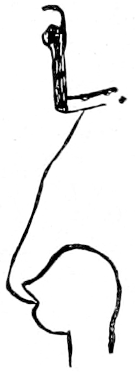
Fig. 984.—Coward.
Fig. 984.—Afraid-of-him. Red-Cloud’s Census. The following is the description of a common gesture sign used by the Dakotas for afraid, fear, coward:
Crook the index, close the other fingers, and, with its back upward, draw the right hand backward about a foot, from 18 inches in front of the right breast. Conception, “Drawing back.”

Fig. 985.—Coward.
Fig. 985.—Afraid-of-him. Red-Cloud’s Census. This is obviously the same device without clear depiction of the arm, which is explained by the preceding.

Fig. 986.—Little-Chief.
Fig. 986.—Little-Chief. Red-Cloud’s Census. A typical gesture sign for chief is as follows:
Raise the forefinger, pointed upwards, in a vertical direction and then reverse both finger and motion; the greater the elevation the “bigger” the chief. In this case the elevation above the head is slight, so the chief is “little.”

Fig. 987.—Hit.
Fig. 987.—The Dakotas went out in search of the Crows in order to avenge the death of Broken-Leg-Duck. They did not find any Crows, but, chancing on a Mandan village, captured it and killed all the people in it. American-Horse’s Winter Count, 1787-’88.
The mark on the tipi is not the representation of a hatchet or tomahawk, but is explained by the gesture sign for “hit by a bullet from a gun,” made by the Dakotas as follows:
With the hands in the position of the completion of the sign for discharge of a gun, draw the right hand back from the left, that is, in toward the body; close all the fingers except the index, which is extended, horizontal, back toward the right, pointing straight outward, and is pushed forward against the center of the stationary left hand with a quick motion. Conception, “Bullet comes to a stop. It struck.”
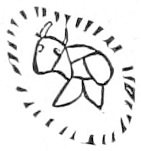
Fig. 988.—Cow.
Fig. 988.—The first stock cattle were issued to them. American-Horse’s Winter Count, 1875-’76. The figure represents a cow surrounded by people. A common gesture sign distinguishing the cattle brought by Europeans from the buffalo is as follows:
Make sign for buffalo, then extend the left forefinger and draw the extended index across it repeatedly at different places. Literally, spotted buffalo.
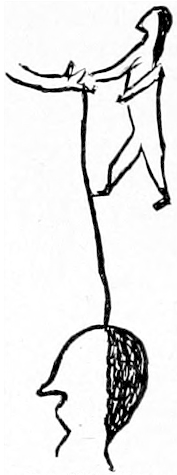
Fig. 989.—Two.
Fig. 989.—Kills-two. Red-Cloud’s Census. In this figure only the suggestion of number is in point. Two fingers are extended.

Fig. 990.—Sign for Dakota.
Fig. 990.—Four Crow Indians killed by the Minneconjou Dakotas. The-Swan’s Winter Count, 1864-’65.
The four heads and necks are shown. The pictograph shows the tribe of the conquerors and not that of the victims. The gesture sign for Dakota is as follows:
Forefinger and thumb of right hand extended (others closed) are drawn from left to right across the throat as though cutting it. The Dakotas have been named the “cut-throats” by some of the surrounding tribes.
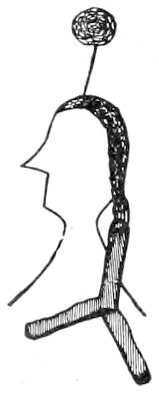
Fig. 991.—Noon.
Fig. 991.—Noon. Red-Cloud’s Census. A Dakotan gesture sign for noon is as follows:
Make a circle with the thumb and index for sun, and then hold the hand overhead, the outer edge uppermost.

Fig. 992.—Hard.
Fig. 992.—Hard. Red-Cloud’s Census. This is the representation of a stone hammer and coincides with the Dakotan gesture sign for hard as follows:
Same as the sign for stone, which is: With the back of the arched right hand strike repeatedly in the palm of the left, held horizontal,[641] back outward, at the height of the breast and about a foot in front; the ends of the fingers point in opposite directions. Refers to the time when the stone hammer was the hardest pounding instrument the Indians knew.

Fig. 993.—Moon.
Fig. 993.—Little-Sun. Red-Cloud’s Census. The moon is expressed both in gestural and oral language as sun-little.
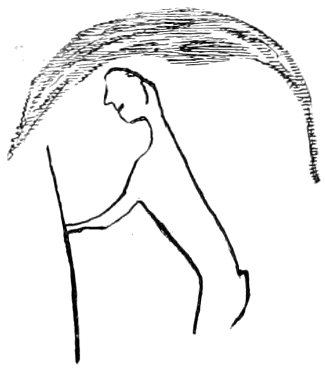
Fig. 994.—Old-Cloud.
Fig. 994.—Old-Cloud. Red-Cloud’s Census. Cloud is drawn in blue in the original; old is signified by drawing a staff in the hand of the man. The Dakotan gesture for old is described as follows:
With the right hand held in front of right side of body, as though grasping the head of a walking-stick, describe the forward arch movement, as though a person walking was using it for support. “Decrepit age dependent on a staff.”
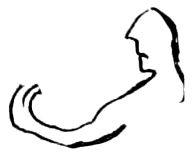
Fig. 995.—Call-for.
Fig. 995.—Call-for. Red-Cloud’s Census. The gesture for come or to call to one’s self is shown in this figure. This is similar to that prevalent among Europeans, and so requires no explanation.
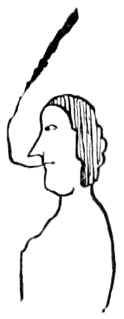
Fig. 996.—Wise-Man.
Fig. 996.—The-Wise-Man was killed by enemies.
Cloud-Shield’s Winter Count, 1797-’98. The following gesture sign explains this figure:
Touch the forehead with the right index and then make the sign for big directly in front of it. Conception, “Big brain.”
In this as in other delineations of gesture the whole of the sign could not be expressed, but only that part of it which might seem to be the most suggestive.
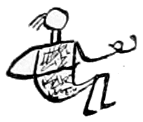
Fig. 997.—Sign for pipe.
Fig. 997 is taken from the winter count of Battiste Good and is drawn to represent the sign for pipe, which it is intended to signify. The sign is made by placing the right hand near the upper portion of the breast, the left farther forward, and both held so that the index and thumb approximate a circle, as if holding a pipe-stem. The remaining fingers are closed.
The point of interest in this character is that, instead of drawing a pipe, the artist drew a human figure making the sign for pipe, showing the intimate connection between gesture-signs and pictographs. The pipe, in this instance, was the symbol of peace.
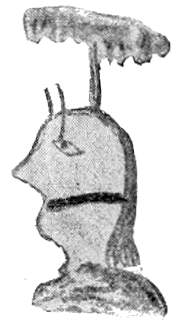
Fig. 998.—Searches-the-Heavens.
Fig. 998.—Mahpiya-wakita, Searches-the-Heavens; from the Oglala Roster. The cloud is drawn in[642] blue, the searching being derived from the expression of that idea in gesture by passing the extended index of one hand (or both) forward from the eye, then from right to left, as if indicating various uncertain localities before the person, i. e., searching for something. The lines from the eyes are in imitation of this gesture.
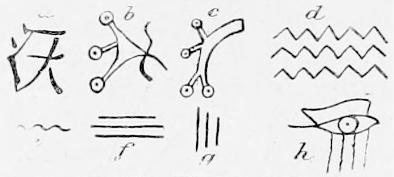
Fig. 999.—Water symbols.
The Chinese character for to give water is a, in Fig. 999, which may be compared with the common Indian gesture to drink, to give water, viz: “Hand held with the tips of fingers brought together and passed to the mouth, as if scooping up water” (see Fig. 1000), obviously from primitive custom, as with Mojaves, who still drink with scooped hands, throwing the water to the mouth.
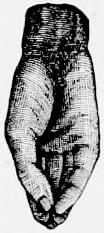
Fig. 1000.—Gesture sign for drink.
Another common Indian gesture sign for water to drink—I want to drink—is: “Hand brought downward past the mouth with loosely extended fingers, palm toward the face.” This appears in the Mexican character for drink, b, in Fig. 999, taken from Pipart (a). Water, i. e., the pouring out of water with the drops falling or about to fall, is shown in Fig. 999, c, taken from the same author (b), being the same arrangement of them as in the Indian gesture-sign for rain, shown in Fig. 1002, the hand, however, being inverted. Rain in the Mexican picture-writing is sometimes shown by small circles inclosing a dot, as in the last two designs, but not connected together, each having a short line upward marking the line of descent. Several other pictographs for rain are given below.
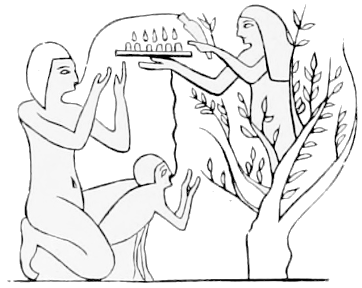
Fig. 1001.—Water, Egyptian.
With the gesture sign for drink may be compared Fig. 1001, the Egyptian goddess Nu in the sacred sycamore tree, pouring out the water of life to the Osirian and his soul represented as a bird, in Amenti, from a funereal stelē in Cooper’s Serpent Myths (b).
The common Indian gesture for river or stream—water—is made by passing the horizontal flat hand, palm down, forward and to the left from the right side in a serpentine manner.
The Egyptian character for the same is d in Fig. 999, taken from Champollion’s Dictionary (b). The broken line is held to represent the movement of the water on the surface of the stream. When made with one line less angular and more waving it means water. It is interesting to compare with this the identical character in the syllabary invented by a West African negro, Mormoru Doalu Bukere, for water, e, in Fig. 999, mentioned by Dr. Tylor (b).
The abbreviated Egyptian sign for water as a stream is f, in Fig. 999, taken from Champollion, loc. cit., and the Chinese for the same is as in g, same figure.
In the picture writing of the Ojibwa the Egyptian abbreviated character, with two lines instead of three, appears with the same signification.
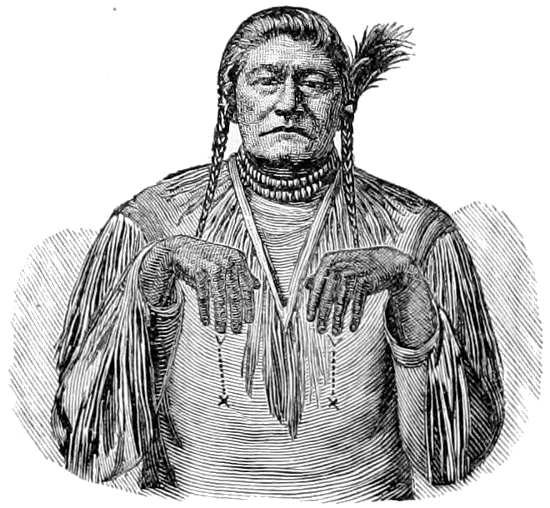
Fig. 1002.—Gesture for rain.
The Egyptian character for weep, h, in Fig. 999, i. e., an eye with tears falling, is also found in the pictographs of the Ojibwa, published by Schoolcraft (o), and is also made by the Indian gesture of drawing lines by the index repeatedly downward from the eye, though perhaps more frequently made by the full sign for rain—made with the back of the hand downward from the eye—“eye rain.” The sign is as follows, as made by the Shoshoni, Apache, and other Indians: Hold the hand (or hands) at the height of and before the shoulder, fingers pendent, palm down, then push it downward a short distance, as shown in Fig. 1002. That for heat is the same, with the difference that the hand is held above the head and thrust downward toward the forehead; that for to weep is made by holding the hand as in rain, and the gesture made from the eye downward over the cheek, back of the fingers nearly touching the face.
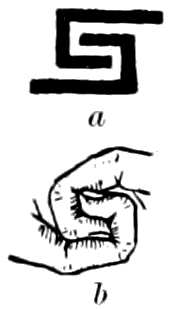
Fig. 1003.—Water sign. Moki.
The upper design in Fig. 1003, taken from the manuscript catalogue of T.V. Keam, is water wrought into a meandering device, which is the conventional generic sign of the Hopitus. The two forefingers are joined as in the lower design in the same figure.
In relation to the latter, Mr. Keam says: “At the close of the religious festivals the participants join in a parting dance called the ‘dance of the linked finger.’ They form a double line, and crossing their arms in front of them they lock the forefingers of either hand with those of their neighbors, in both lines, which are thus interlocked together, and then dance, still interlocked by this emblematic grip, singing their parting song. The meandering designs are emblems of this friendly dance.”
The Arapaho sign for child, baby, is the forefinger in the mouth, i. e., a nursing child, and a natural sign of a deaf-mute is the same. The Egyptian figurative character for the same is seen in Fig. 1004 a. Its linear form is b, same figure, and its hieratic is c, Champollion (c).
These afford an interpretation to the ancient Chinese form for son, d in same figure, given in Journ. Royal Asiatic Society, I, 1834, p. 219, as belonging to the Shang dynasty, 1756-1112 B. C., and the modern Chinese form, e, which, without the comparison, would not be supposed to have any pictured reference to an infant with hand or finger at or approaching the mouth, denoting the taking of nourishment. Having now suggested this, the Chinese character for birth, f in same figure, is understood as a parallel expression of a common gesture among the Indians, particularly reported from the Dakota, for born, to be born; viz, place the left hand in front of the body a little to the right, the palm, downward and slightly arched, then pass the extended right hand downward, forward, and upward, forming a short curve underneath the left, as in Fig. 1005 a. This is based upon the curve followed by the head of the child during birth, and is used generically. The same curve, when made with one hand, appears in Fig. 1005 b.
It may be of interest to compare with the Chinese child the Mexican abbreviated character for man, Fig. 1004 g, found in Pipart (c). The character on the right is called the abbreviated form of the one by its side.
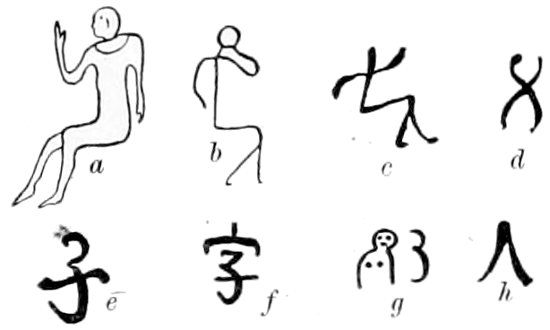
Fig. 1004.—Symbols for child and man.
The Chinese character for man is Fig. 1004 h, and may have the same obvious conception as a Dakota sign for the same signification: “Place the extended index pointing upward and forward before the lower portion of the abdomen.”
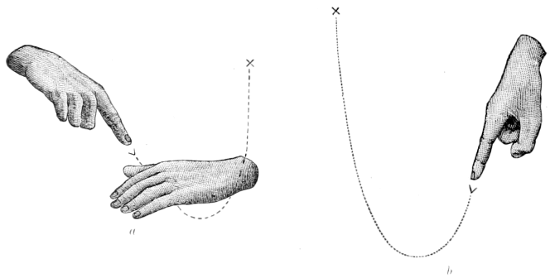
Fig. 1005.—Gestures for birth.
A typical sign made by the Indians for no, negation, is as follows:
The hand extended or slightly curved is held in front of the body, a little to the right of the median line; it is then carried with a rapid sweep a foot or more farther to the right.
The sign for none, nothing, sometimes used for simple negation, is made by throwing both hands outward from the breast toward their respective sides.
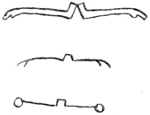
Fig. 1006.—Negation.
With these compare the two forms of the Egyptian character for no, negation, the two upper characters of Fig. 1006 taken from Champollion (d). No vivid fancy is needed to see the hands indicated at the extremities of arms extended symmetrically from the body on each side.
Also compare the Maya character for the same idea of negation, the lowest character of Fig. 1006, found in Landa (a). The Maya word for negation is “ma,” and the word “mak,” a six-foot measuring rod, given by Brasseur de Bourbourg in his dictionary, apparently having connection with this character, would in use separate the hands as illustrated, giving the same form as the gesture made without the rod.
Another sign for nothing, none, made by the Comanche is: Flat hand thrown forward, back to the ground, fingers pointing forward and downward. Frequently the right hand is brushed over the left thus thrown out.
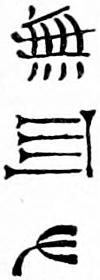
Fig. 1007.—Hand.
Compare the Chinese character for the same meaning, the upper character of Fig. 1007. This will not be recognized as a hand without study of similar characters, which generally have a cross-line cutting off the wrist. Here the wrist bones follow under the crosscut, then the metacarpal bones, and last the fingers, pointing forward and downward.
Leon de Rosny (a) gives the second and third characters in Fig. 1007 as the Babylonian glyphs for “hand,” the upper being the later and the lower the archaic form.

Fig. 1008.—Signal of discovery.
Fig. 1008 is reproduced from an ivory drill-bow (U. S. Nat. Mus., No. 24543) from Norton sound, Alaska. The figure represents the gesture sign or signal of discovery. In this instance the game consists of whales, and the signal is made by holding the boat paddle aloft and horizontally.
Fig. 1009, reproduced from Fig. 365, p. 308, Sixth Ann. Rep. Bureau of Ethnology, is a copy of Pl. 53 of the Dresden Codex, and is a good example of the use of gestures in the Maya graphic system. The main figure in the upper division of the plate, probably that of a deity or ruler, holds his right hand raised to the level of the head, with the index prominently separated from the other fingers. This is the first part of a sign common to several of the Indian tribes of North America and signifies affirmation or assent. The Indians close the fingers other than the index more decidedly than in the plate and, after the hand has reached its greatest height, shake it forward and down, but these details, which indeed are not essential, could not well be indicated pictorially.[647] The human figure in the lower division is kneeling and holds both hands easily extended before the body, palms down and index fingers straight, parallel, and separated from the other fingers, which are flexed or closed. This in its essentials is a common Indian gesture sign for “the same,” “similar,” and also for “companion.” A sign nearly identical is used by the Neapolitans to mean “union” or “harmony.” If the two divisions of the plate are supposed to be connected, it might be inferred through the principles of gesture language that the kneeling man was praying to the seated personage for admission to his favor and companionship, and that the latter was responding by a dignified assent.
Dr. S. Habel (e) thus describes Fig. 1010, a sculpture in Guatemala:
The upper half represents the head, arms, and part of the breast of a deity, apparently of advanced age, as indicated by the wrinkles in the face. The right arm is bent at the elbow, the finger tips of the outstretched hand apparently touching the region of the heart; the left upper arm is drawn up, the elbow being almost as high as the shoulder, and the fore arm and hand hanging at nearly right angles. From the head and neck issue winding staves, to which not only knots or nodes are attached, but also variously-shaped leaves, buds, flowers, and fruits. Apparently these are symbols of speech, replacing our letters and expressing the mandate of the deity.
The lower part represents an erect human figure with the face turned up toward the deity imploring, and from the mouth emanates a staff with[648] nodes variously arranged. The appeal is still further intensified by the raising of the right hand and arm. A human head partly covers the head of the figure, from which hang variously-shaped ribbons, terminating in the body and tail of a fish. Above the right wrist is a double bracelet, apparently formed of small square stones. The left hand is covered, gauntlet-like, by a human skull, and the wrist is ornamented by a double scaly bracelet. The waist is encircled by a stiff projecting girdle, which differs from the general style of this ornament by having attached to it on the side a human head, with another human head suspended from it. From the front of the girdle emanate four lines, which ascend towards the deity, uniting at the top. They seem to symbolize the emotions of the person, not expressed by words. From behind the image issue flames.
Before writing was invented by a people there were attempts in its direction which are mentioned in other chapters of this paper. Human forms were drawn pictorially in the act of making gesture signs and in significant actions and attitudes and combinations of them. Other natural objects, as well as those purely artificial, which represented work or the result of work, were also drawn with many differing significations. When any of these designs had become commonly adopted on account of its striking fitness or even from frequent repetition with a special signification, it became a conventional term of thought-writing, with substantially the same use as when, afterward, the combinations of letters of an alphabet into words became the arbitrary signs of sound-writing. While the designs thus became conventional terms, their forms became more and more abbreviated or cursive until in many cases the original concept or likeness was lost. Sometimes when a specimen of the original form is preserved, its identity in meaning with the current form can be ascertained by correlation of the intermediate shapes.
The original ideography is often exhibited by exaggeration. For instance, a loud voice has been sometimes indicated by a human face with an enormous mouth. Hearing, among the Peruvians, was early expressed by a man with very large ears; then by a head with such ears, and afterwards by the form of the ears without the head. Soon such forms became so conventionalized as to be practically ideographic writing. In the same manner a numeral cipher has become the representation of a mathematical quantity, a written musical note shows a kind and degree of sound, and other pictured signs give values of weights and measures. All of these signs express ideas independent of any language and may be understood by peoples speaking all diversities of language.
So also the idea of smallness and subjection may be conveyed by drawing an object in an obviously diminished size, of which examples are given in this chapter. Another expedient, illustrations of which also appear, is by repetition and combination, with reference to which the following condensed remarks of James Summers (a) are in point:
The earliest Chinese characters were pictorial; but pictures could not be made which would clearly express all ideas. One of the means devised to express concepts that could not be indicated by a simple sketch, was to combine two or more familiar pictures. For instance, a man with a large eye represents “seeing;” two men, “to follow;” three men, “many;” two men on the ground, “sitting.”
All other means failing, the present great mass of characters was formed by a principle from which the class is called “phonetic;” because in the characters classed under it, while one part (called the “radical”) preserves its meaning, the other part (called the “phonetic” or “primitive”) is used to give its own sound to the whole figure. This part does sometimes, however, convey also its symbolic meaning as well as its sound.
But while the original mode of expressing ideas required various devices, when an idea had become established in pictography there always appeared an attempt to simplify the figure and reduce it in size, so as to require less space in the drafting surface and also to lessen the draftsman’s labor. This was more obvious in the degree in which the figure was complicated and of frequent employment.
For convenience the subject is divided into: 1. Conventional devices. 2. Syllabaries and alphabets.
Among the North American Indians and in several parts of the world where, as among the Indians, the hand-grasp in simple salutation has not been found, the junction of the hands between two persons of different tribes is the ceremonial for union and peace, and the sign for the same concept is exhibited by the two hands of one person similarly grasped as an invitation to, or signification of, union and peace. The ideogram of clasped hands to indicate peace and friendship is found in pictographs from many localities. The exhibition and presentation of the unarmed hand may have affected the practice, but the concept of union by linking is more apparent.

Fig. 1011.
Fig. 1011.—The Dakotas made peace with the Cheyenne Indians. The-Swan’s Winter Count, 1840-’41. Here the hands shown with fingers extended, and therefore incapable of grasping a weapon, are approaching each other. The different coloration of the arms indicates different tribes. The device on the right is a rough form of the forearm of the Cheyenne marked as mentioned several times in this work.
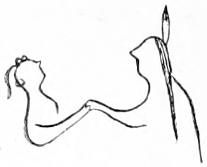
Fig. 1012.
Fig. 1012.—The Dakotas made peace with the Pawnees. American-Horse’s Winter Count, 1858-’59. The man on the left is a Pawnee.
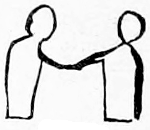
Fig. 1013.
Fig. 1013.—A Mandan and a Dakota met in the middle of the Missouri River, each swimming halfway across. They shook hands there and made peace. The-Flame’s Winter Count, 1791-’92.
Mulligan, post interpreter at Fort Buford, says that this was at Fort Berthold, and is an historic fact; also that the same Mandan long afterwards, killed the same Dakota.
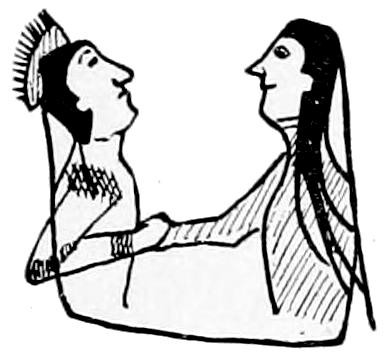
Fig. 1014.
Fig. 1014.—The Omahas came and made peace to get their people whom the Dakotas held as prisoners. Cloud-Shield’s Winter Count, 1804-’05. The attitudes and expressions are unusually artistic. The uniting line may only intensify the idea of a treaty resulting in peace, but perhaps recognizes the fact that the Omaha (on the left) and Dakota belong to the same Siouan stock. The marks on the Omaha are not tribal, but refer to the prisoners—the marks of their bonds.
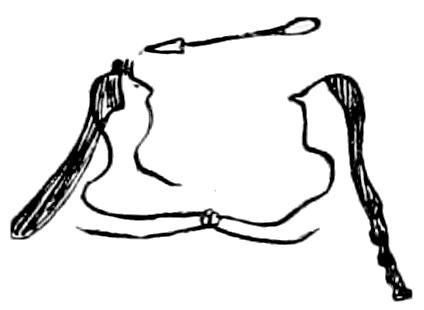
Fig. 1015.
Fig. 1015.—The Dakotas made peace with the Crows at Pine Bluff. American-Horse’s Winter Count, 1816-’17. The arrow shows they had been at war. The Indian at the left is a Crow. The distinctive and typical arrangement of the hair of the several tribes in this and the preceding figure are worthy of note.
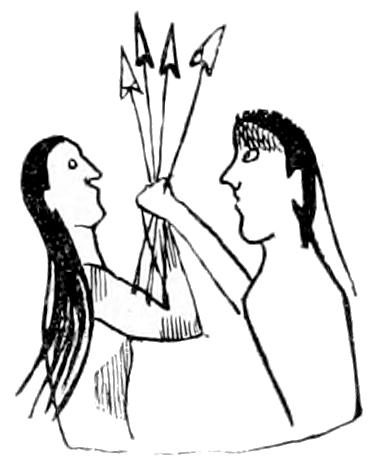
Fig. 1016.
Fig. 1016.—The Dakotas made peace with the Pawnees. Cloud-Shield’s Winter Count, 1814-’15. The man with the marked forehead, blue in the original, is a Pawnee, the other is a Dakota, whose body is smeared with clay. The four arrows show that they had been at war, and the clasped hands denote peace.
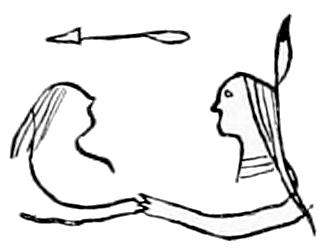
Fig. 1017.
Fig. 1017.—They made peace with the Gros Ventres. American-Horse’s Winter Count, 1803-’04. But one arrow is shown, indicating that the subject in question was war, but that it was not waged at the time, as would have been shown by two opposed arrows.
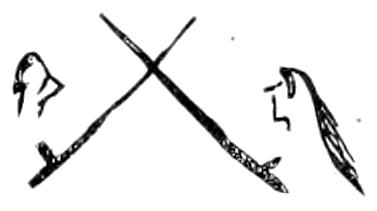
Fig. 1018.
Fig. 1018.—Dakotas made peace with the Crow Indians. The-Swan’s Winter Count, 1851-’52. Here the representatives of the two tribes show their pipes crossed, indicating exchange as is expressed by a common gesture sign.
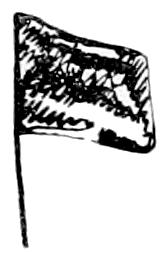
Fig. 1019.
Fig. 1019.—Made peace with Gen. Sherman and others at Fort Laramie. The-Swan’s Winter Count, 1867-’68. This is the adoption of the white man’s flag, as the paramount symbol on recognition of which peace was made.
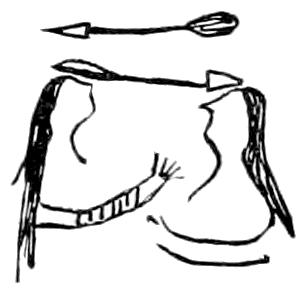
Fig. 1020.
Fig. 1020.—The Dakotas were at war with the Cheyennes. American-Horse’s Winter Count, 1834-’35. The Cheyenne is[652] the man with stripes on his arm. The two arrows shot in opposite directions form one of the conventional symbols for war.
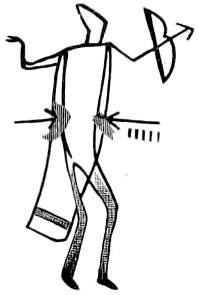
Fig. 1021.
Fig. 1021 is taken from the Winter Count of Battiste Good for the year 1840-’41. He names it “Came-and-killed-five-of-Little-Thunder’s-brothers winter.” He explains that the five were killed in an encounter with the Pawnees. The capote or headdress, always but not exclusively worn by Dakota war parties, is shown, and is the special symbol of war as also given in several other places in the same record. The five short vertical lines below the arrow signify that five were killed.

Fig. 1022.
Fig. 1022.—War-Eagle. Red-Cloud’s Census. This figure shows a highly abbreviated conventional symbol. The pipe used in the ceremonial manner explained on page 539 et seq. means war and not peace, and the single eagle feather stands for the entire bird often called the war-eagle.
The adoption of a mat or mattress as an emblem of war or a military expedition is discussed and illustrated, supra, p. 553, Fig. 782.
In the Jesuit Relation for 1606, p. 51, it is narrated that “The Huron and Northern Algonkin chiefs, when their respective war parties met the enemy, distributed among their warriors rods which they carried for the purpose, and the warriors stuck them in the earth as a token that they would not retreat any more than the rods would.”
In their pictographs the rods became represented by strokes which were not only numerical, but signified warriors.
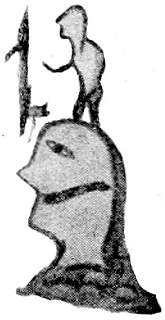
Fig. 1023.—Chief-Boy.
Fig. 1023.—Naca-haksila, Chief-Boy. From the Oglala Roster. The large pipe held forward with the outstretched hand is among the Oglalas the conventional device for chief. This is explained elsewhere by the ceremonies attendant on the raising of war parties, in which the pipe is conspicuous. That the human figure is a boy is indicated by the shortness of the hair and the legs.
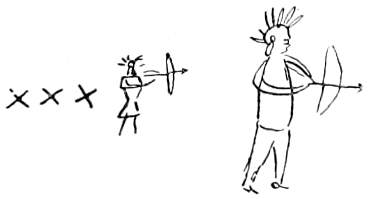
Fig. 1024.—War Chief. Passamaquoddy.
Fig. 1024, drawn by a Passamaquoddy Indian, shows the manner of representing a war chief by that tribe:
It signifies a chief with 300 braves. The relative magnitude of the leading human figure indicates his rank. In this particular compare Figs. 137, 138, and 142. The device is common in the Egyptian glyphs.
Dr. Worsnop, op. cit., makes the following remarks about a similar device in Australia:
At Chasm island, in the Gulf of Carpentaria, indenting Australia, the third person of a file of thirty-two painted on the rock was twice the height of the others, and held in his hand[653] something resembling the waddy, or wooden sword, of the natives of Port Jackson, and was probably intended to represent a chief. They could not as with us, indicate superiority by clothing or ornament, since they wear none of any kind, and therefore, with the addition of a weapon similar to the ancients, they seem to have made superiority of persons the principal emblem of superior power, of which, indeed power is usually a consequence in the very early stages of society.
The exhibition of horns as a part of the head dress, or pictorially displayed as growing from the head, is generally among the tribes of Indians an emblem of power or chieftancy. It is distinctly so asserted by Schoolcraft, vol. I, p. 409, as regards the Ojibwa, and by Lafitau, vol. II, 21, both authors presenting illustrations. The same concept was ancient and general in the eastern hemisphere. The images of gods and heads of kings were thus adorned, as at a later day were the crests of the dukes of Brittany. Some writers have suggested that this symbol was taken from the crescent moon, others that it referred to the vigor of the bull. Col. Marshall (a), however, gives an instance of special derivation. He says that the Todas, when idle, involuntarily twist and split branches of twigs and pieces of cane into the likeness of buffalo horns, because they dream of buffalo, live on and by it, and their whole religion is based on the care of the cow.
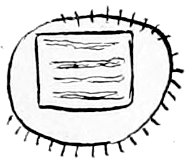
Fig. 1025.
Fig. 1025 is taken from the Winter Count of Battiste Good for the year 1851-’52. In that year the first issue of goods was made to the Dakotas, and the character represents a blanket surrounded by a circle to show how the Indians sat awaiting the distribution. The people are represented by small lines running at right angles to the circle.
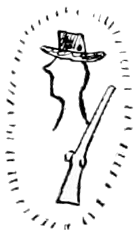
Fig. 1026.
Fig. 1026.—The-Good-White-Man returned and gave guns to the Dakotas. American-Horse’s Winter Count, 1799-1800. The circle of marks represents the people sitting around him, the flint-lock musket the guns.
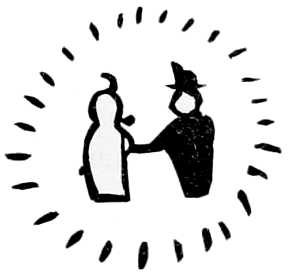
Fig. 1027.
Fig. 1027.—Council at Spotted-Tail agency. The-Flame’s Winter Count, 1875-’76. Here the circle composed of short lines pointing to the center takes the conventional form frequently used to designate a council.
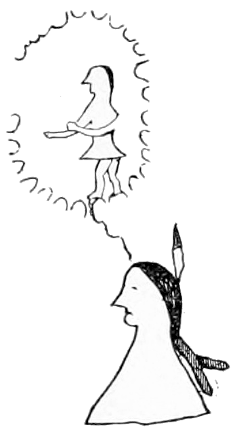
Fig. 1028.
Fig. 1028.—Surrounds-them. Red-Cloud’s Census. This figure is introduced in this place to show the[654] distinction made by an antagonistic “surround” and the peaceable ring depicted immediately before.
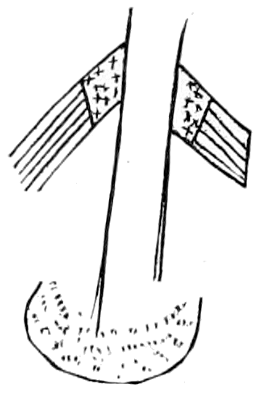
Fig. 1029.
Fig. 1029.—The Dakotas had a council with the whites on the Missouri river below the Cheyenne agency, near the mouth of Bad creek. They had many flags which the Good-White-Man gave them with their guns, and they erected them on poles to show their friendly feelings. American-Horse’s Winter Count, 1805-’06. This was perhaps their meeting with the Lewis and Clarke expedition. The curved line is drawn to represent the council lodge, which they made by opening several tipis and uniting them at their sides to form a semicircle. The small dashes are for the people. This is a compromise between the Indian and the European mode of designating an official assemblage.
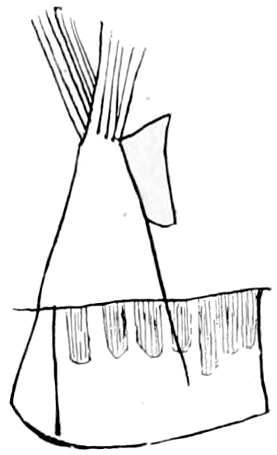
Fig. 1030.
Fig. 1030.—The Dakotas have an abundance of buffalo meat. Cloud-Shield’s Winter Count, 1856-’57. This is shown by the full drying pole on which it was the usage after successful hunts to hang the pieces of meat to be dried for preservation.
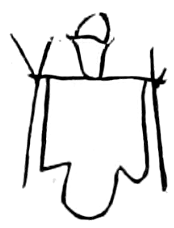
Fig. 1031.
Fig. 1031.—The Oglalas had an abundance of buffalo meat and shared it with the Brulés, who were short of food. American-Horse’s Winter Count, 1817-’18. The buffalo hide hung on the drying pole, with the buffalo head above it, indicates an abundance of meat, as in the preceding figure.
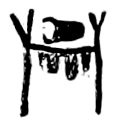
Fig. 1032.
Fig. 1032 is taken from Battiste Good’s Winter Count for the year 1745-’46, in which the drying-pole is as usual supported by two forked sticks or poles. This is a variant of the two preceding figures.
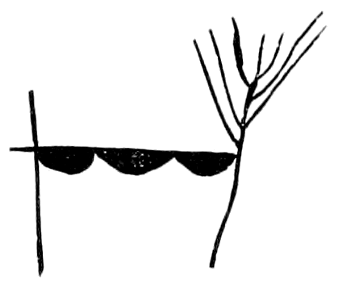
Fig. 1033.
Fig. 1033.—Immense quantities of buffalo meat. The-Swan’s Winter Count, 1845-’46. This is another form of drying-pole in which a tree is used for one of the supports. The pieces of meat would not be recognized as such without explanation by the preceding figures.
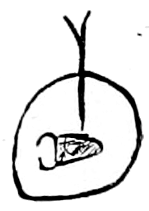
Fig. 1034.
Fig. 1034 is taken from the Winter Count of Battiste Good for the year 1703-’04. The forked stick being one of the supports of the drying pole or scaffold, indicates meat. The irregular circular object means “heap,”[655] i. e., large quantity, buffalo having been very plentiful that year. The buffalo head denotes the kind of meat stored. This is an abbreviated form of the device before presented, and affords a suggestive comparison with some Egyptian hieroglyphics and Chinese letters, both in their full pictographic origin and in their abbreviation.

Fig. 1035.
Fig. 1035.—The Dakotas had unusual quantities of buffalo. The-Swan’s Winter Count, 1816-’17. This representation of a buffalo hide or side is another sign for abundance of meat, and is the most abbreviated and conventional of all, with the same significance, in the collections now accessible.
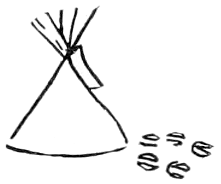
Fig. 1036.
Fig. 1036.—The Dakotas had unusual abundance of buffalo. The-Swan’s Winter Count, 1861-’62. This is another mode of expressing the same abundance. The buffalo tracks, shown by the cloven hoofs, are coming up close to the tipi.

Fig. 1037.
Fig. 1037.—They had an abundance of corn, which they got at the Ree villages. American-Horse’s Winter Count, 1823-’24.
The symbol shows the maize growing, and also is the tribal sign for Arikara or Ree.
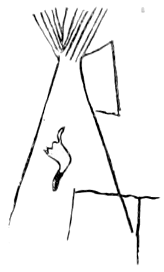
Fig. 1038.
Fig. 1038.—The Dakotas had very little buffalo meat, but plenty of ducks in the fall. Cloud-Shield’s Winter Count, 1811-’12. The bare, drying pole is easily interpreted, but the reversed or dead duck would not be understood without explanation.
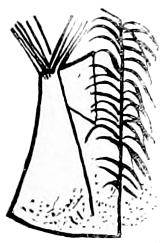
Fig. 1039.
Fig. 1039.—Food was very scarce and they had to live on acorns. Cloud-Shield’s Winter Count, 1813-’14. The tree is intended for an oak and the dots beneath it for acorns.
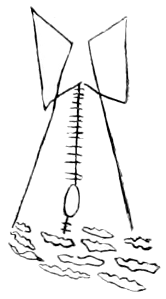
Fig. 1040.
Fig. 1040.—A year of famine. Cloud-Shield’s Winter Count, 1787-’88. They, i. e., the Dakotas, lived on roots, which are represented in front of the tipi.
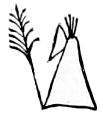
Fig. 1041.
Fig. 1041.—They could not hunt on account of the deep snow, and were compelled to subsist on anything they could get, as herbs (pézi) and roots. American-Horse’s Winter Count, 1790-’91.
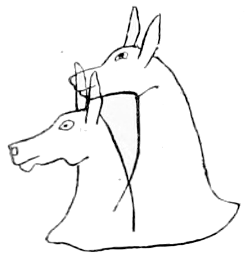
Fig. 1042.
Fig. 1042.—They had to sell many mules and horses to get food, as they were starving. Cloud-Shield’s Winter Count, 1868-’69. White-Cow-Killer calls it “Mules-sold-by-hungry-Sioux winter.” The figure is understood as a conventionalized sign by reference to the historic fact mentioned. The line of union between the horses’ necks shows that the subject-matter was not a horse trade, but that both of the animals, i. e., many, were disposed of.
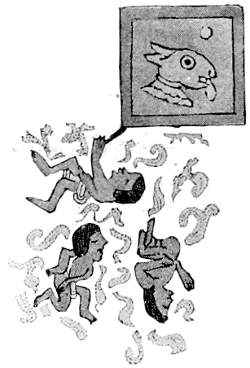
Fig. 1043.
Fig. 1043.—Kingsborough (l) gives the pictograph recording that “In the year of One Rabbit and A. D. 1454 so severe a famine occurred that the people died of starvation.” It is reproduced in Fig 1043.
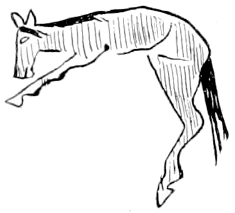
Fig. 1044.
Fig. 1044.—Many horses were lost by starvation, as the snow was so deep they couldn’t get at the grass. Cloud-Shield’s Winter Count, 1865-’66.
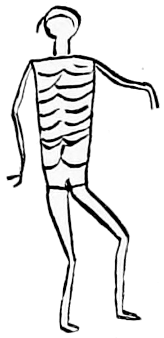
Fig. 1045.
Fig. 1045, from the record of Battiste Good for the year 1720-’21, signifies starvation, denoted by the bare ribs. This design is abbreviated and conventionalized among the Ottawa and Pottawatomi Indians. Among the latter a single line only is drawn across the breast, shown in Fig. 1046. This corresponds also with one of the Indian gesture-signs for the same idea.
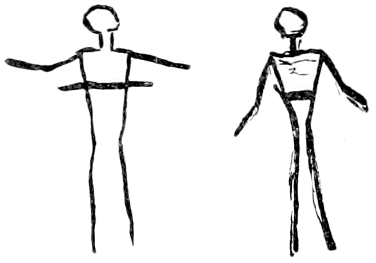
Fig. 1046.
See also the Abnaki sign of starvation, a pot upside down, in Fig. 456, supra.
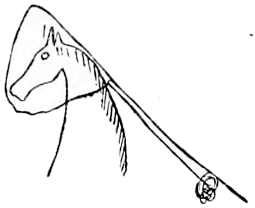
Fig. 1047.
Fig. 1047.—They caught many wild horses south of the Platte river. American-Horse’s Winter Count, 1811-’12. This figure shows a horse in the process of being caught by a lasso.

Fig. 1049.
Fig. 1049.—Dakotas first used a lasso for catching wild horses. The-Swan’s Winter Count, 1812-’13. In these two figures the lasso is shown without the animal, thus becoming the conventional sign for wild horse.
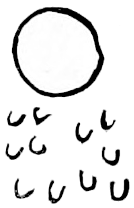
Fig. 1050.
Fig. 1050.—Crow Indians stole 200 horses from the Minneconjou Dakotas, near Black Hills. The-Swan’s Winter Count, 1849-’50. This figure is inserted to show in the present connection the lunules, which signify unshod horses. The Indians never shod their ponies, and the hoof marks may be either of wild horses, herds of which formerly roamed the prairies, or the common horses brought into subjection.

Fig. 1051.
Fig. 1051.—Blackfeet Dakotas stole some American horses having shoes on. Horseshoes seen for the first time. The-Swan’s Winter Count, 1802-’03. The horseshoe here depicted is the conventional sign for the white man’s horse.
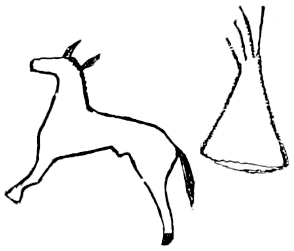
Fig. 1052.
Fig. 1052.—Runs-off-the-Horse. Red-Cloud’s Census. “Runs off” in the parlance of the plains means stealing.
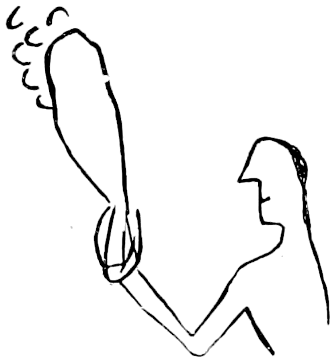
Fig. 1053.
Fig. 1053.—Runs-off-the-Horse. Red-Cloud’s Census. This figure explains the one preceding. The man has in his hand a lariat or perhaps a lasso.
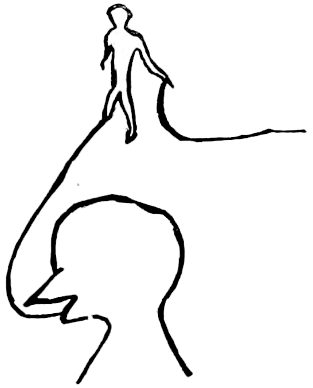
Fig. 1054.
Fig. 1054.—Drags-the-Rope. Red-Cloud’s Census. This is a variant of the last figure, without, however, the exhibition of anything, such as tracks, to indicate horses.
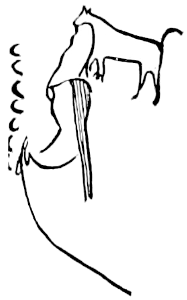
Fig. 1055.
Fig. 1055.—Dog, an Oglala, stole seventy horses from the Crows. American-Horse’s Winter Count, 1822-’23. Each of the seven tracks stands for ten horses. A lariat, which serves the purpose among others of a long whip, and is usually allowed to trail on the ground, is shown in the man’s hand.
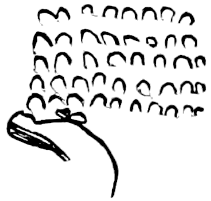
Fig. 1056.
Fig. 1056.—Sitting-Bear, American-Horse’s father, and others, stole two hundred horses from the Flat Heads. American-Horse’s Winter Count, 1840-’41. A trailing lariat is in the man’s hand.
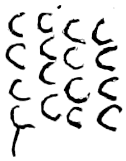
Fig. 1057.
Fig. 1057.—Brings-lots-of-horses. Red-Cloud’s Census. This is a further step in conventionalizing. The lariat is but slightly indicated as connected with the horse track on the lower left-hand corner.
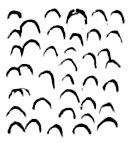
Fig. 1058.
Fig. 1058.—The Utes stole all of the Brulé horses. Cloud-Shield’s Winter Count, 1874-’75. The mere indication of a number of horse tracks without any qualifying or determinative object means that the horses are run off or stolen. This becomes the most conventionalized form of the group.
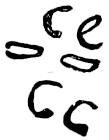
Fig. 1059.
Fig. 1059.—Steals-Horses. Red-Cloud’s Census. In this figure the horse tracks themselves are more rude and conventionalized.
The Prince of Wied mentions, op. cit., p. 104, that in the Sac and Fox tribes the rattle of a rattlesnake attached to the end of the feather worn on the head signifies a good horse stealer. The stealthy approach of the serpent, accompanied with latent power, is here clearly indicated.
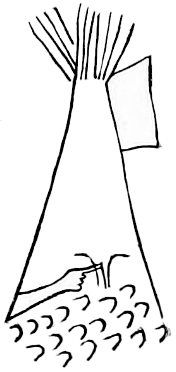
Fig. 1060.
Fig. 1060.—Making-the-Hole stole many horses from a Crow tipi. Such is the translation in Cloud-Shield’s Winter Count, 1849-’50. The man is cutting the hole with a knife. Through the orifice thus made he obtains access to the horse. But it is more probable that the single tipi represents a village into which the horse-thief effected an entrance and ran off the horses belonging to it.

Fig. 1061.
Fig. 1061.—Male-Crow, an Oglala, was killed by the Shoshoni. American-Horse’s Winter Count, 1844-’45. The bow in contact with the head of the victim is frequently the conventional sign for “killed by an arrow.” This is not drawn in the Winter Counts on the[659] same principle as the touching with a lance or coup stick, elsewhere mentioned in this paper, but is generally intended to mean killed, and to specify the manner of killing, though in fact before the use of firearms the “coup” was often counted by striking with a bow.
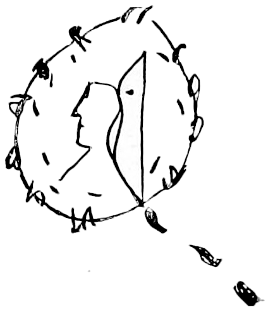
Fig. 1062.
Fig. 1062.—Kills-in-tight-place. Red-Cloud’s Census. This man has evidently been enticed into an ambush, to which his tracks lead.
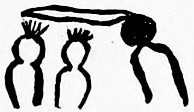
Fig. 1063.
Fig. 1063.—Uncpapas kill two Rees. The-Flame’s Winter Count, 1799-1800. The object over the heads of the two Rees, projecting from the man figure, is a bow, showing the mode of death. The hair of the Arickaras is represented. This is clearly conventional and would not be understood from the mere delineation.
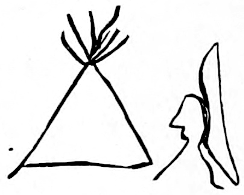
Fig. 1064.
Fig. 1064.—Kills-by-the-camp. Red-Cloud’s Census. The camp is shown by the tipi, and the idea of “kill” by the bow in contact with the head of the victim.
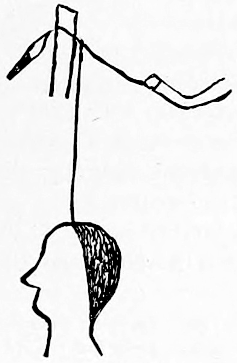
Fig. 1065.
Fig. 1065.—Kills-Two. Red-Cloud’s Census. Here is the indication of number by upright lines united by a horizontal line, as designating the same occasion and the same people, two of whom are struck by the coup stick.
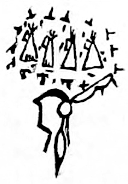
Fig. 1066.
Fig. 1066.—Feather-Ear-Rings was killed by the Shoshoni. American-Horse’s Winter Count, 1842-’43. The four lodges and the many blood-stains intimate that he was killed in a battle when four lodges of Shoshoni were killed. Again appears the character for successful gunshot wound, before explained in connection with Fig. 987.

Fig. 1067.
Fig. 1067.—Kills-the-Bear. Red-Cloud’s Census. Here there appears to be a bullet mark in the middle of the paw representing the middle of the whole animal. The idea of death may be indicated by the reverse attitude of the paws, which are turned up, corresponding with the slang expression “toes up,” to indicate death.
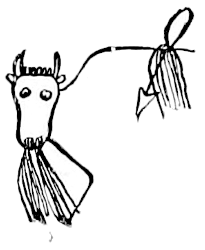
Fig. 1068.
Fig. 1068.—They killed a very fat buffalo bull. American-Horse’s Winter Count, 1835-’36. This figure is introduced to show an ingenious differentiation. The rough outline of the buffalo’s forequarters is given[660] sufficiently to show that the arrow penetrates to an unusual depth, which indicates the mass of fat, into the region of the buffalo’s respiratory organs, and therefore there is a discharge of blood not only from the point of entrance of the arrow, but from the nostrils of the animal. No device of an analogous character is found among five hundred of the Dakotan pictographs studied, so that the designation of abnormal fat is made evident.
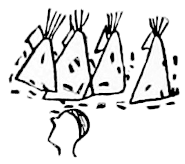
Fig. 1069.
Fig. 1069.—They killed many Gros Ventres in a village which they assaulted. American-Horse’s Winter Count, 1832-’33. The single scalped head shows the killing. This conventional sign is so common as hardly to require notice.
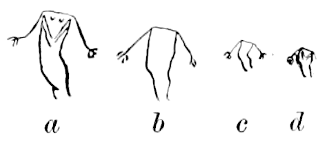
Fig. 1070.—Killed. Dakota.
Fig. 1070, taken from Mrs. Eastman’s Dakota (e), shows the Dakota pictograph for “killed”: a is a woman and b a man killed, and c and d a boy and girl killed.

Fig. 1071.—Life and death. Ojibwa.
Fig. 1071, taken from Copway (g), gives two characters which severally represent life and death, the black disk representing death and the simple circle life.

Fig. 1072.—Dead. Iroquois.
In Doc. Hist. N. Y. (d), is the illustration now copied as Fig. 1072 with the statement that it shows the fashion of painting the dead among the Iroquois; the first two are men and the third is a woman, who is distinguished only by the waistcloth that she wears.
The device is further explained by the following paragraphs from the same volume, on p. 6, which add other details:
When they have lost any men on the field of battle they paint the men with the legs in the air and without heads, and in the same number as they have lost; and to denote the tribe to which they belonged, they paint the animal of the tribe of the deceased on its back, the paws in the air, and if it be the chief of the party that is dead, the animal is without the head.
If there be only wounded, they paint a broken gun which, however, is connected with the stock, or even an arrow, and to denote where they have been wounded, they paint the animal of the tribe to which the wounded belong with an arrow piercing the part in which the wound is located; and if it be a gunshot they make the mark of the ball on the body of a different color.

Fig. 1073.—Dead man. Arikara.
Fig. 1073.—This is drawn by the Arikara for “dead man” and perhaps suggests the concept of nothing inside, i. e., no life, with a stronger emphasis than given to “lean” in Fig. 903, supra. It must be noted, however, that the Hidatsa draw the same character for “man” simply.
La Salle, in 1680, wrote that when the Iroquois had killed people they made red strokes with the figure of a man drawn in black with bandaged[661] eyes. As this bandaging was not connected with the form of killing, it may be conjectured that it ideographically meant death—the light of life put out.
In this group the figures show obvious similarity yet seem to be graphic, or at least ideographic, but on examining the text of the several records conventionality is developed.
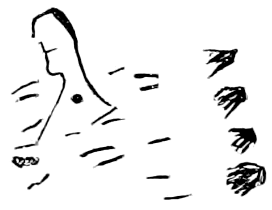
Fig. 1074.
Fig. 1074.—Shot-at. Red-Cloud’s Census. Here is shown the discharge of guns and lines of passage of the bullets, one of which is graphically displayed passing the neck of the human figure, but without either graphic mark of wound or the conventional sign for “hit” or “it struck.” He was shot at by many enemies, but was not hit.
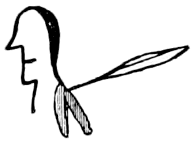
Fig. 1075.
Fig. 1075.—Shot. Red-Cloud’s Census. There is no doubt that this man, a Dakota, was actually shot with an arrow.
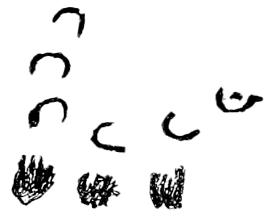
Fig. 1076.
Fig. 1076.—Shot-at-his-horse. Red-Cloud’s Census. Here again are the flashes made by the discharge of guns and the horse tracks showing horses, but no specific indication of hitting. The mark within the right-hand horse track may be compared with the passing bullet in Fig. 1074. The horse was shot at but not hit.
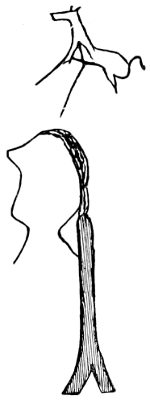
Fig. 1077.
Fig. 1077.—Shot-his-horse. Red-Cloud’s Census. This figure is to be correlated with the last one, as it shows actual hitting and blood flowing from the wound.
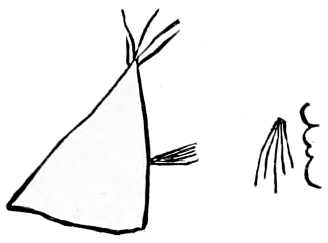
Fig. 1078.
Fig. 1078.—Shot-in-front-the-lodge. Red-Cloud’s Census. Without explanation derived from the context this figure would not be understood. The right hand character means several bows united. Between these and the tipi is the usual device for blood flowing vertically downwards, meaning a fatal shot, and the device displayed horizontally and touching the tipi means that the man shot belonged to that tipi or lodge, in front of which he was shot.
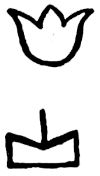
Fig. 1079.—Coming rain.
Mr. Keam in his MS. describes Fig. 1079 as two forms of the symbol of Aloseka, which is the bud of the squash. The form seen in the upper part of the figure, drawn in profile, is also used by the Moki to typify the east peak of the San Francisco mountains, the birthplace of the Aloseka; when the clouds circle, it presages the coming rain. In the rock carvings the curving profile is further conventionalized into straight lines and assumes the lower form.
The collection of characters given in Figs. 1080 and 1081 are selected from a list published by Maj. C. R. Conder (b). That list includes all the Hittite designs distinctly deciphered which are so far known, and they are divided by the author into two plates, one giving the “Hittite emblems,” as he calls them, “of known sound,” and which are all compared with the Cypriote, and some with the cuneiform, Egyptian, and other characters; and the other comprising the “Hittite emblems of uncertain sound.” The collection is highly suggestive for comparison of the significance of many forms commonly appearing in several lands and also as a study of conventionalizing. In these respects its presentation renders it unnecessary to dwell as much as would otherwise be required upon the collections of Egyptian and cuneiform characters, with which students are more familiar and which teach substantially the same lessons.
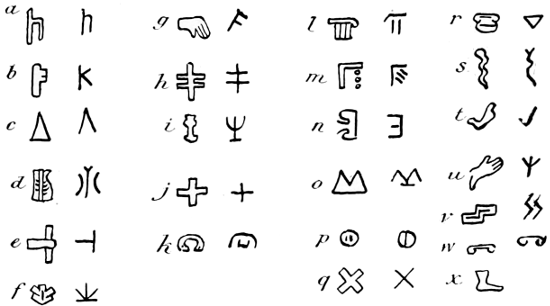
Fig. 1080.—Hittite emblems of known sound.
a, a crook. Cypriote u.
b, apparently a key. Cypriote ke. Compare the cuneiform emblem ik, “to open.”
c, a tiara. Cypriote ko; Akkadian ku, “prince;” Manchu chu, “lord.”
d, another tiara, apparently a variant of c.
e, hand and stick. Cypriote ta, apparently a causative prefix, like the Egyptian determinative; Chinese ta, “beat.”
f, an herb. Cypriote te; Akkadian ti, “live;” Turkish it, “sprout;” ot, “herb.”
g, the hand grasping. Cypriote to. Compare the Egyptian, cuneiform and Chinese signs for “touch,” “take,” “have.” Akkadian tu, “have.”
h, apparently a branch. Cypriote pa. Compare Akkadian pa, “stick” (Lenormant).
i, apparently a flower. Cypriote pu. Compare the Akkadian emblem pa, apparently a flower. Akkadian pu, “long;” Tartar boy, “long,” “growth,” “grass;” Hungarian fu, “herb.”
j, a cross. Cypriote lo; Carian h.
k, a yoke. Cypriote lo and le; Akkadian lu, “yoke.”
l probably represents rain. Compare the Egyptian, Akkadian, and Chinese emblems for “rain,” “storm,” “darkness.”
m seems to represent drops of water equivalent to the last. Cypriote re.
n, possibly the “fire-stick.” Cypriote ri. Occurs as the name of a deity. Akkadian ri, “bright,” the name of a deity.
o, two mountains. Cypriote me or mi. The emblem for “country.”
p resembles the cuneiform sign for “female.”
q, this is the sign of opposition in cuneiform, in Chinese and Egyptian. Cypriote mu or no (nu, “not”).
r, a pot. Cypriote a or ya. Compare the Akkadian a, “water.”
s, a snake. Perhaps the Cypriote ye.
t, apparently a sickle. Cypriote sa. Compare the Tartar sa, se, “knife.”
u, the open hand. Cypriote se. Akkadian sa, “give.” Tartar saa, “take.”
v resembles the cuneiform and Chinese emblem for “breath,” “wind,” “spirit.” Cypriote zo or ze. Occurs as the name of a god. Akkadian zi, “spirit.”
w resembles the Chinese, cuneiform, and Egyptian emblem for heaven. Akkadian u. It may be compared with the Carian letter u or o.
x, the foot, used evidently as a verb, and resembles the cuneiform du. Probably may be sounded as in Akkadian and used for the passive (du, “come” or “become”).
HITTITE EMBLEMS OF UNCERTAIN SOUND.
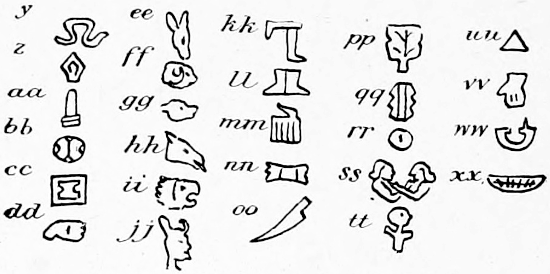
Fig. 1081.—Hittite emblems of uncertain sound.
y, a serpent. Occurs in the name of a god.
z, perhaps a monument. It recalls the Cypriote ro.
aa, apparently a monument.
bb, probably the sun (ud or tam).
cc, apparently a house.
dd, perhaps the sole of the foot.
ee, a donkey’s head. Probably the god Set.
ff, a ram’s head. Probably with the sound gug or guch and the meaning “fierce,” “mighty.”
gg, a sheep’s head. Probably lu or udu.
hh, a dog or fox head.
ii, a lion’s head. Only on seals.
jj, a demon’s head. Used specially in a text which seems to be a magic charm.
kk, two legs. Resembles the cuneiform dhu, and means probably “go” or “run.”
ll, two feet. Probably “stand;” or “send,” as in Chinese.
mm, apparently an altar.
nn, perhaps a bundle or roll.
oo, apparently a knife or sword; perhaps pal.
pp, apparently a tree.
qq, apparently the sacred artificial tree of Asshur.
rr, a circle. Compare the cuneiform sa, “middle.”
ss, twins. As in Egyptian.
tt resembles the Chinese emblem for “small.”
uu, a pyramid or triangle.
vv, apparently a hand or glove, pointing downwards. Possibly tu or dun for “down.”
ww, apparently a ship, like the cuneiform ma. Appears only on seals.
xx, only once found on the Babylonian bowl, and seems to represent the inscribed bowl itself.
It is worthy of observation that the Greeks used the same word, γράφειν, to mean drawing and writing, suggesting their early identity. Drawing was the beginning of writing, and writing was a conventionalized drawing. The connection of both with gesture signs has been noticed above. A gesture sign is a significant but evanescent motion, and a drawing is produced by a motion which leaves significant marks. When man became proficient in oral language, and desired to give permanence[665] to his thoughts, he first resorted to the designs of picture-writing, already known and used, to express the sounds of his speech.
The study of different systems of writing—such as the Chinese, the Assyrian, and the Egyptian—shows that no people ever invented an arbitrary system of writing or originated a true alphabet by any fixed predetermination. All the known graphic systems originated in picture-writing. All have passed through the stage of conventionalism to that commonly called the hieroglyphic, while from the latter, directly or after an intermediate stage, sprang the syllabary which used modifications of the old ideograms and required a comparatively small number of characters. Finally, among the more civilized of ancient races the alphabet was gradually introduced as a simplification of the syllabary, and still further reduced the necessary characters.
The old ideograms were, or may be supposed to have been, intelligible to all peoples without regard to their languages. In this respect they resembled the Arabic and Roman numerals which are understood by many nations of diverse speech when written while the sound of the words figured by them is unintelligible. Their number, however, was limited only by the current ideas, which might become infinite. Also each idea was susceptible of preservation in different forms, and might readily be misinterpreted; therefore the simplicity and precision of alphabetic writing amply compensated for its exclusiveness.
The high development of pictorial writing in Mexico and Central America is well known. Some of these peoples had commenced the introduction of phonetics into their graphic system, especially in the rendering of proper names, which probably also was the first step in that direction among the Egyptians. But Prof. Cyrus Thomas (b) makes the following remark upon the Maya system, which is of general application:
It is certain, and even susceptible of demonstration, that a large portion, perhaps the majority, of the characters are symbols.
The more I study these characters the stronger becomes the conviction that they have grown out of a pictographic system similar to that common among the Indians of North America. The first step in advance appears to have been to indicate, by characters, the gesture signs.
It is not possible now to discuss the many problems contained in the vast amount of literature on the subject of the Mexican and Central American writing, and it is the less necessary because much of the literature is recent and easily accessible. With regard to the Indian tribes north of Mexico, it is not claimed that more than one system of characters resembling a syllabary or alphabet was invented by any of them. The Cherokee alphabet, so called, was adopted from the Roman by Sequoya, also called George Gist, about A. D. 1820, and was ingenious and very valuable to the tribe, but being an imitation of an old invention it has no interest in relation to the present topic. The same is manifestly true regarding the Cree alphabet, which was of missionary origin.[666] The exception claimed is that commonly, but erroneously, called the Micmac hieroglyphics. The characters do not partake of the nature of hieroglyphs, and their origin is not Micmac.
The Micmac was an important tribe, occupying all of Nova Scotia, Cape Breton island, Prince Edward island, the northern part of New Brunswick, and the adjacent part of the province of Quebec, and ranging over a great part of Newfoundland. According to Rev. Silas T. Rand, op. cit., Megum is the singular form of the name which the Micmacs use for themselves. Rev. Eugene Vetromile (a) translates “Micmacs” as “secrets practicing men,” from the Delaware and old Abnaki word malike, “witchcraft,” and says the name was given them on account of their numerous jugglers; but he derives Mareschite, which is an Abnaki division, from the same word and makes it identical with Micmac. The French called them Souriquois, which Vetromile translates “good canoe men.” They were also called Acadians, from their habitat in Acadie, now Nova Scotia.
The first reference in literature with regard to the spontaneous use by Indians of the characters now called the “Micmac hieroglyphs” appears in the Jesuit Relations of the year 1652, p. 28. In the general report of that year the work of Father Gabriel Druillettes, who had been a missionary to the Abnaki (including under this term the Indians of Acadia, afterwards distinguished as Micmacs), is dwelt upon in detail. His own words, in a subordinate report, appear to have been adopted in the general report of the Father Superior, and, translated, are as follows:
Some of them wrote out their lessons in their own manner. They made use of a small piece of charcoal instead of a pen, and a piece of bark instead of paper. Their characters were novel, and so particuliers [individual or special] that one could not know or understand the writing of the other; that is to say, that they made use of certain marks according to their own ideas as of a local memory to preserve the points and the articles and the maxims which they had remembered. They carried away this paper with them to study their lesson in the repose of the night.
No further remark or description appears.
It is interesting to notice that the abbé J. A. Maurault, (a) after his citation of the above report of Father Druillettes, states in a footnote translated as follows:
We have ourselves been witnesses of a similar fact among the Têtes-de-Boule Indians of the River St. Maurice where we had been missionaries during three years. We often saw during our instructions or explanations of the catechism that the Indians traced on pieces of bark, or other objects very singular hieroglyphs. These Indians afterward passed the larger part of the following night in studying what they had so written, and in teaching it to their children or their brothers. The rapidity with which they by this manner learnt their prayers was very astonishing.
The Indians called by the Abbé Maurault the Têtes-de-Boule or Round Heads, are also known as Wood Indians, and are ascertained[667] to have been a band of the Ojibwa, which shows a connection between the practice of the Ojibwa and that of the Micmacs, both being of the Algonquian stock, to mark on bark ideographic or other significant inscriptions which would assist them to memorize what struck them as of special interest and importance, notably religious rites. Many instances are given in the present paper, and the spontaneous employment of prayer sticks by other persons of the same stock is also illustrated in Figs. 715 and 716.
The next notice in date is by Père Chrétien Le Clercq (a), a member of the Recollect order of Franciscans who landed on the coast of Gaspé in 1675, learned the language of the Micmacs and worked with them continuously for several years.
It would appear that he observed and took advantage of the pictographic practice of the Indians, which may have been continued from that reported by Father Druillettes a few years earlier with reference to the same general region, or may have been a separate and independent development in the tribe with which Father Le Clercq was most closely connected.
His quaint account is translated as follows:
Our Lord inspired me with this method the second year of my mission, when, being greatly embarrassed as to the mode in which I should teach the Indians to pray, I noticed some children making marks on birch bark with coal, and they pointed to them with their fingers at every word of the prayer which they pronounced. This made me think that by giving them some form which would aid their memory by fixed characters, I should advance much more rapidly than by teaching on the plan of making them repeat over and over what I said. I was charmed to know that I was not deceived, and that these characters which I had traced on paper produced all the effect I desired, so that in a few days they learned all their prayers without difficulty. I cannot describe to you the ardor with which these poor Indians competed with each other in praiseworthy emulation which should be the most learned and the ablest. It costs, indeed, much time and pains to make all they require, and especially since I enlarged them so as to include all the prayers of the church, with the sacred mysteries of the trinity, incarnation, baptism, penance, and the eucharist.
There is no description whatever of the characters.
The next important printed notice or appearance of the Micmac characters is in the work of Rev. Christian Kauder, a Redemptorist missionary, the title page of which is given in Fig. 1082. It was printed in Vienna in 1866 and therefore was about two centuries later than the first recorded invention of the characters. During those two centuries the French and therefore the Roman Catholic influences had been much of the time dormant in the habitat of the Micmacs (the enforced exodus of the French from Acadie being about 1755). Father Kauder was one of the most active in the renewal of the missions. He learned the Micmac language, probably gathered together such “hieroglyphs” on rolls of bark as had been preserved, added to them parts of the Greek and Roman alphabet and other designs, and arranged the whole in systematic and grammatic form. After about twenty years of work upon[668] them he procured their printing in Vienna. A small part of the edition, which was the first printed, reached the Micmacs. The main part, shipped later, was lost at sea in the transporting vessel.
Fig. 1083 shows the version of the Lord’s Prayer, published by Dr. J. G. Shea (a) in his translation of Le Clercq’s First Establishment of the Faith in New France, this and the preceding figure being taken from the Bibliography of the Languages of the N. A. Indians by Mr. J. C. Pilling, of the Bureau of Ethnology.
The publication of Father Kauder was a duodecimo in three parts: Catechism, 144 pages; religious reflections, 109 pages; and hymnal, 208 pages. They are very seldom found bound together, and a perfect copy of either of the parts or volumes is rare. On a careful examination of the hieroglyphs, so called, it seems evident that on the original substratum of Micmac designs or symbols, each of which represented mnemonically a whole sentence or verse, a large number of arbitrary[670] designs have been added to express ideas and words which were not American, and devices were incorporated with them intended to represent the peculiarities of the Micmac grammar as understood by Kauder, and it would seem of a universal grammar antedating Volapük. The explanation of these additions has never been made known. Kauder died without having left any record or explanation of the plan by which he attempted to convert the mnemonic characters invented by the Indians into what may be considered an exposition of organized words (not sounds) in grammatical form. An attempt which may be likened to this was made by Bishop Landa in his use of the Maya characters, and one still more in point was that of the priests in Peru, mentioned in connection with Figs. 1084 and 1085, infra.
The result is that in the several camps of Micmacs visited by the present writer in Cape Breton island, Prince Edward island, and Nova Scotia, fragments of the printed works are kept and used for religious worship, and also many copies on various sheets and scraps of paper have been made of similar fragments, but their use is entirely mnemonic, as was that of their ancient bark originals. Very few of the Indians who in one sense can “read” them currently in the Micmac language, have any idea of the connection between any one of the characters and the vocables of the language. When asked what a particular character meant they were unable to answer, but would begin at the commencement of the particular prayer or hymn, and when arrested at any point would then for the first time be able to give the Micmac word or words which corresponded with that character. This was not in any religious spirit, as is mentioned by Dr. Washington Matthews, in his Mountain Chant, Fifth Ann. Rep. Bureau of Ethnology, with reference to the Navajo’s repeating all, if any, of the chant, but because they only knew that way to use the script. In that use they do as is mentioned of the Ojibwa, supra. The latter often by their bark script keep the memory of archaic words, and the Micmac keep that of religious phrases not well understood. A few, and very few, of the characters, which were constantly repeated, and were specially conspicuous, were known as distinct from the other characters by one only of the Indians examined. It apparently had never occurred to any of them that these same characters, which in their special mnemonic connection represented Micmac words, could be detached from their context and by combination represent the same words in other sentences. Therefore, the expression “reading,” used in reference to the operation, is not strictly correct. In most cases the recitation of the script was in a chant, and the musical air of the Roman Catholic Church belonging to the several hymns and chants was often imitated. The object, therefore, which has been expressed in the above quoted accounts of Fathers Druillettes and Le Clercq had been accomplished regarding the then extant generation of Indians two hundred years before Father Kauder’s publication. That object was for Indians under their immediate charge to learn in the most speedy manner certain[671] formulæ of the church, by the use of which it was supposed that they would gain salvation. The formation of an alphabet, or even a syllabary, by which the structure of the language should be considered and its vocal expression recorded, was not the object. It is possible that there was an objection to the instruction of the Indians in a modern alphabet by which they might more readily learn either French or English, and at the same time be able to read profane literature and thereby become perverted from the faith. These missionaries certainly refrained, for some reason, not only from instructing the heathen in any of the languages of civilization, but also from teaching them the use of an alphabet for their own language.
It is probable that Father Kauder had some idea of reducing the language of the Micmacs to a written form, based not upon verbal or even syllabic notation, but upon some anomalous compromise between their ideographic original or substratum and a grammatic superstructure. If so, he entirely failed. The interesting point with regard to this remarkable and unique attempt is, that there is undoubtedly a basis of Indian designs and symbols included and occluded among the differentiated devices in the three volumes mentioned, which arbitrarily express thoughts and words by a false pictographic method, instead of sentences and verses. But the change from the pictorial forms to those adopted, if not as radical as that from the Egyptian hieroglyphs to the Roman text, resembles that from the archaic to the modern Chinese. Therefore it would follow that the present form of the characters is not one which the Indians would learn more readily than an alphabet or a syllabary, and that is the ascertained fact. At Cow bay, a Micmac camp, about 12 miles from Halifax, an aged chief who in his boyhood at Cape Breton island was himself instructed by Father Kauder in these characters, explained that Kauder taught them to the boys by drawing them on a blackboard and by repetition, very much in the manner in which a schoolmaster in civilized countries teaches the alphabet to children. The actual success of the Cherokees in the free and general use of Sequoya’s Syllabary, which was not founded on pictographs, but on signs for sounds, should be noted in this connection.
Among the thousands of scratchings on the Kejemkoojik rocks, many of which were undoubtedly made by the Micmac, only two characters were found resembling any in Kauder’s volumes, and those were common symbols of the Roman Catholic Church, and might readily have been made by the Frenchmen, who also certainly left scratchings there. Altogether after careful study of the subject it is considered that the devices in Father Kauder’s work are so intrinsically changed, both in form and intent, from the genuine Micmac designs that they can not be presented as examples of Indian pictography.
Connected with this topic is the following account in the Jesuit Relations of 1646, p. 31, relative to the Montagnais and other Algonquians of the St. Lawrence river, near the Saguenay: “They confess themselves with admirable frankness; some of them carry small sticks to remind[672] them of their sins; others write, after their manner, on small pieces of bark.” This is but the application of the ideographic writing on birch bark by the converts to the ceremonies and stories of the Christian religion, as the same art had been long used for their aboriginal traditions.
Examples of pictographic work, done in a spirit similar to that above mentioned, are given by Wiener (g), describing the illustrations of which Figs. 1084 and 1085 are copies, one-fifth real size.
In the most distant part of Peru, in the valley of Paucartambo, at Sicasica, the history of the passion of Christ was found written in the same ideographic system that the Indians of Ancon and the north of the coast were acquainted with before the conquest. (Fig. 1084.) The drawings were made with a pencil, probably first dipped in a mixture of gum and mandioc flour. This tissue is of a dark brown and the designs are of a very bright red.
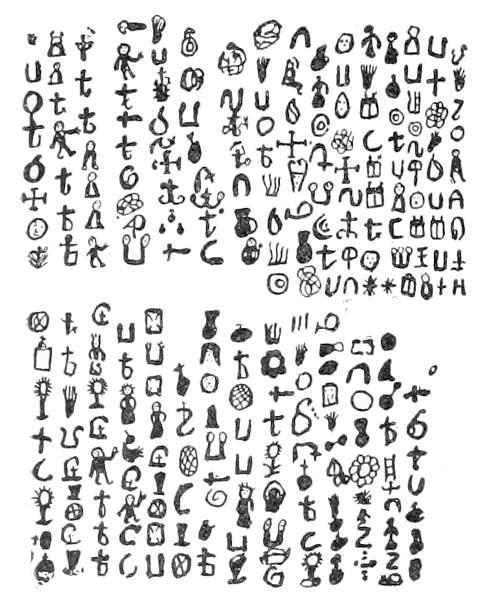
Fig. 1085.—Religious story. Sicasica.
The second series, Fig. 1085, which was found at Paucartambo, was written in an analogous system on old Dutch paper. The designs are red and blue.
In an article by Terrien de Lacouperie (f) is the following condensed[673] account, part of which relates to Fig. 1086, and may be compared with the priestly inventions above mentioned:
Père Desgodins was able, in 1867, to make a copy of eleven pages from a manuscript written in hieroglyphics, and belonging to a tom-ba or tong-ba, a medicine man among the Mo-sos. These hieroglyphics are not, properly speaking, a writing, still less the current writing of the tribe. The sorcerers or tong-bas alone use it when invited by the people to recite these so-called prayers, accompanied with ceremonies and sacrifices, and also to put some spells on somebody, a specialty of their own. They alone know how to read them and understand their meaning; they alone are acquainted with the value of these signs, combined with the numbers[674] of the dice and other implements of divination which they use in their witchcraft. Therefore, these hieroglyphics are nothing else than signs more or less symbolical and arbitrary, known to a small number of initiated who transmit their knowledge to their eldest son and successor in their profession of sorcerers. Such is the exact value of the Mo-so manuscripts; they are not a current and common writing; they are hardly a sacred writing in the limits indicated above.
However, they are extremely important for the general theory of writing, inasmuch as they do not pretend to show in that peculiar hieroglyphical writing any survival of former times. According to these views, it was apparently made up for the purpose by the tom-bas or medicine men. This would explain, perhaps, the anomalous mixture of imperfect and bad imitations of ancient seal characters of China, pictorial figures of animals and men, bodies and their parts, with several Tibetan and Indian characters and Buddhist emblems.
It is not uninteresting to remark here that a kind of meetway or toomsah, i. e., priest, has been pointed out among the Kakhyens of Upper Burma. The description is thus quoted:
“A formal avenue always exists as the entrance to a Kakhyen village. * * * On each side of the broad grassy pathway are a number of bamboo posts, 4 feet high or thereabouts, and every 10 paces or so, taller ones, with strings stretching across the path, supporting small stars of split rattan and other emblems. There are also certain hieroglyphics which may constitute a kind of embryo picture-writing but are understood by none but the meetway or priest.”
Mr. W. W. Rockhill, in Am. Anthrop., IV, No. 1, p. 91, notices the work of M. Paul Vial, missionary, etc., De la langue et de l’écriture indigènes au Yûnân, with the following remarks:
Père Vial has published a study upon the undeciphered script of the Lolos of Western China, of which the first specimen was secured some twelve years ago by E. Colborne Baber. Prof. Terrien de Lacouperie endeavored to establish a connection between these curious characters and the old Indian script known as the southern Ashoka alphabet. The present, Père Vial’s, work gives them a much less glorious origin. He says of them: “The native characters were formed without key, without method. It is impossible to decompose them. They are written not with the strokes of a brush, but with straight, curved, round, or angular lines, as the shape chosen for them requires. As the representation could not be perfect, they have stopped at something which can strike the eye or mind—form, motion, passion, a head, a bird’s beak, a mouth, right or left, lightness or heaviness; in short, at that portion of the object delineated which is peculiarly characteristic of it. But all characters are not of this expressive kind; some even have no connection with the idea they express. This anomaly has its reason. The native characters are much less numerous than the words of the language, only about thirty per cent. Instead of increasing the number of ideograms, the Lolos have used one for several words. As a result of this practice the natives have forgotten the original meaning of many of their characters.”
A summary of the original cuneiform characters, numbering one hundred and seventy, gives many of them as recognizable sketches of objects. The foot stands for “go,” the hand for “take,” the legs for “run,” much as in the Egyptian and in the Maya and other American systems. The bow, the arrow, and the sword represent war; the vase, the copper tablet, and the brick represent manufacture; boats, sails, huts, pyramids, and many other objects are used as devices.
W. St. Chad Boscawen (a) says:
Man’s earliest ventures in the art of writing were, as we are well aware, of a purely pictorial nature, and even to this day such a mode of ideography can be seen among some of the Indian tribes. * * * There is no reasonable doubt but that all the principal systems of paleography now in vogue had their origin at some remote period in this pictorial writing. In so primitive a center as Babylonia we should naturally expect to find such a system had been in vogue, and in this we are not disappointed.
Fig. 1087 is presented as a brief exhibit of the pictographs in some inchoate alphabets.
The utility of the present work depends mainly upon the opportunity given by the various notes and illustrations collected for students to make their own comparisons and deductions. This chapter is intended to assist in that study by presenting some groups of comparisons which have seemed to possess special interest. For that reason descriptions and illustrations are collected here which logically belong to other headings.
Many of the pictographs discussed and illustrated in this chapter and in the one following are the representation of animals and other natural objects. It would therefore seem that they could be easily identified, but in fact the modes of representation of the same object among the several peoples differed, and when conventionalizing has also become a factor the objects may not be recognized without knowledge of the typical style. Sometimes there was apparently no attempt at the imitation of natural objects, but marks were used, such as points, lines, circles, and other geometric forms. These were combined in diverse modes to express concepts and record events. Those marks and combinations originated in many centers and except in rare instances of “natural” ideograms those of one people would not correspond with those of other peoples unless by conveyance or imitation. Typical styles therefore appear also in this class of pictographs and, when established, all typical styles afford some indication with regard to the peoples using them.
This chapter is divided under the headings of: 1. Typical Style. 2. Homomorphs and Symmorphs. 3. Composite forms. 4. Artistic skill and methods.
Fig. 1088 is presented as a type of eastern Algonquian petroglyphs. It is a copy of the “Hamilton picture rock,” contributed by Mr. J. Sutton Wall, of Monongahela city, Pennsylvania. The drawings are on a sandstone rock, on the Hamilton farm, 6 miles southeast from Morgantown, West Virginia. The turnpike passes over the south edge of the rock.
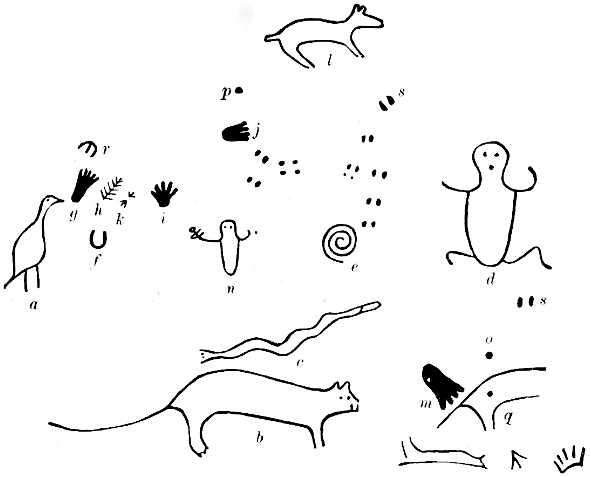
Fig. 1088.—Algonquian petroglyph. Hamilton farm, West Virginia.
Mr. Wall furnishes the following description of the characters:
a, outline of a turkey; b, outline of a panther; c, outline of a rattlesnake; d, outline of a human form; e, a “spiral or volute;” f, impression of a horse foot; g, impression of a human foot; h, outline of the top portion of a tree or branch; i, impression of a human hand; j, impression of a bear’s forefoot, but lacks the proper number of toe marks; k, impression of two turkey tracks; l, has some appearance of a hare or rabbit, but lacks the corresponding length of ears; m, impression of a bear’s hindfoot, but lacks the proper number of toe marks; n, outline of infant human form, with two arrows in the right hand; o, p, two cup-shaped depressions; q, outline of the hind part of an animal; r might be taken to represent the impression of a horse’s foot were it not for the line bisecting the outer curved line; s represent buffalo and deer tracks.
The turkey a, the rattlesnake c, the rabbit l, and the “footprints” j, m, and q, are specially noticeable as typical characters in Algonquian pictography.
Mr. P. W. Sheafer furnishes, in his Historical Map of Pennsylvania, Philadelphia, 1875, a sketch of a pictograph on the Susquehanna river, Pennsylvania, below the dam at Safe Harbor, part of which is reproduced in Fig. 1089. This appears to be purely Algonquian, and has more resemblance to Ojibwa characters than any other petroglyph in the eastern United States yet noted.
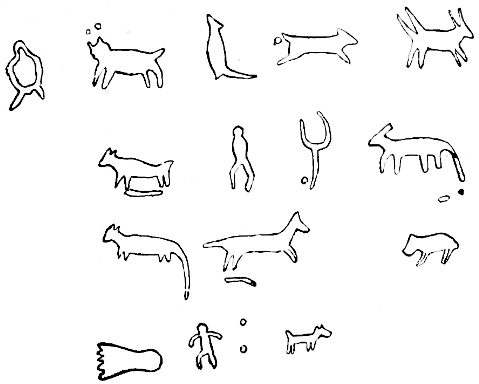
Fig. 1089.—Algonquian petroglyphs. Safe Harbor, Pennsylvania.
See also Figs. 70, et seq., supra, under the heading of Pennsylvania, as showing excellent types of eastern Algonquian petroglyphs and resembling those on the Dighton rock.
Fig. 1090 is reproduced from Schoolcraft (p), and is a copy taken in 1851 of an inscription sculptured on a rock on the south side of Cunningham’s island, Lake Erie. Mr. Schoolcraft’s explanation, given in great detail, is fanciful. It is perhaps only necessary to explain that the dotted lines are intended to divide the partially obliterated from the more distinct portions of the glyph. The central part is the most obscure.
It is to be remarked that this petroglyph is in some respects similar in general style to those before given as belonging to the eastern Algonquian type, but is still more like some of the representations of the Dighton rock inscription, one of them being Fig. 49, supra, and others, which it still more closely resembles in the mode of drawing human figures, are in the copies of Dighton rock on Pl. LIV, Chap. XXII. In some respects this Cunningham’s island glyph occupies a typical position intermediate between the eastern and western Algonquian.
A good type of western Algonquian petroglyphs was discovered by the party of Capt. William A. Jones (b), in 1873, with an illustration here reproduced as Fig. 1091, in which the greater number of the characters are shown, about one-fifth real size.
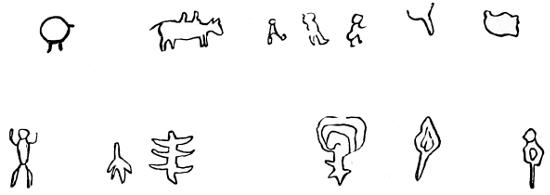
Fig. 1091.—Algonquian petroglyphs. Wyoming.
An abstract of his description is as follows:
* * * Upon a nearly vertical wall of the yellow sandstones, just back of Murphy’s ranch, a number of rude figures had been chiseled, apparently at a period not very recent, as they had become much worn. * * * No certain clue to the connected meaning of this record was obtained, although Pínatsi attempted to explain it when the sketch was shown to him some days later by Mr. F. W. Bond, who copied the inscriptions from the rocks. The figure on the left, in the upper row, somewhat resembles the design commonly used to represent a shield, with the greater part of the ornamental fringe omitted, perhaps worn away in the inscription. We shall possibly be justified in regarding the whole as an attempt to record the particulars of a fight or battle which once occurred in this neighborhood. Pínatsi’s remarks conveyed the idea to Mr. Bond that he understood the figure [the second in the upper line] to signify cavalry, and the six figures [three in the middle of the upper line, as also the three to the left of the lower line] to mean infantry, but he did not appear to recognize the hieroglyphs as the copy of any record with which he was familiar.
Throughout the Wind river country of Wyoming many petroglyphs[679] have been found and others reported by the Shoshoni Indians, who say that they are the work of the “Pawkees,” as they call the Blackfeet, or, more properly, Satsika, an Algonquian tribe which formerly occupied that region, and their general style bears strong resemblance to similar carvings found in the eastern portion of the United States, in regions known to have been occupied by other tribes of the Algonquian linguistic stock.
The four specimens of Algonquian petroglyphs presented here in Figs. 1088-91 and those referred to, show gradations in type. In connection with them reference may be made to the numerous Ojibwa bark records in this work; the Ottawa pipestem, Fig. 738; and they may be contrasted with the many Dakota, Shoshoni, and Innuit drawings also presented.
The petroglyphs found scattered throughout the states and territories embraced within the area bounded by the Rocky mountains on the east and the Sierra Nevada on the west, and generally south of the forty-eighth degree of latitude, are markedly similar in the class of objects represented and the general style of their delineation, without reference to their division into pecked or painted characters; also in many instances the sites selected for petroglyphic display are of substantially the same character. This type has been generally designated as the Shoshonean, though many localities abounding in petroglyphs of the type are now inhabited by tribes of other linguistic stocks.
Mr. G. K. Gilbert, of the U. S. Geological Survey, has furnished a small collection of drawings of Shoshonean petroglyphs from Oneida, Idaho, shown in Fig. 39, supra.
Five miles northwest from this locality and one-half mile east from Marsh creek is another group of characters on basalt bowlders, apparently totemic, and drawn by Shoshoni. A copy of these, also contributed by Mr. Gilbert, is given in Fig. 1092.
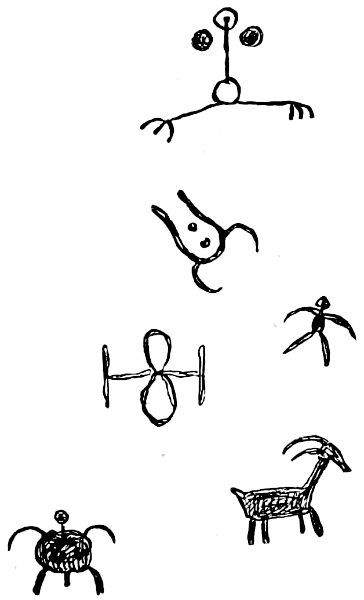
Fig. 1092.—Shoshonean petroglyphs. Idaho.
All of these drawings resemble the petroglyphs found at Partridge[681] creek, northern Arizona, and in Temple creek canyon, southeastern Utah, mentioned supra, pages 50 and 116, respectively.
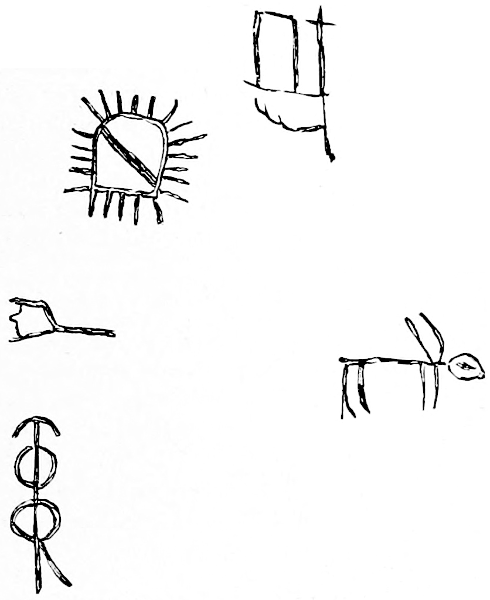
Fig. 1093.—Shoshonean petroglyphs. Utah.
Mr. I. C. Russell, of the U. S. Geological Survey, has furnished drawings of rude pictographs at Black Rock spring, Utah, represented in Fig. 1093. Some of the other characters not represented in the figure consist of several horizontal lines, placed one above another, above which are a number of spots, the whole appearing like a numerical record having reference to the figure alongside, which resembles, to a slight extent, a melon with tortuous vines and stems. The left-hand upper figure suggests the masks shown in Fig. 713.
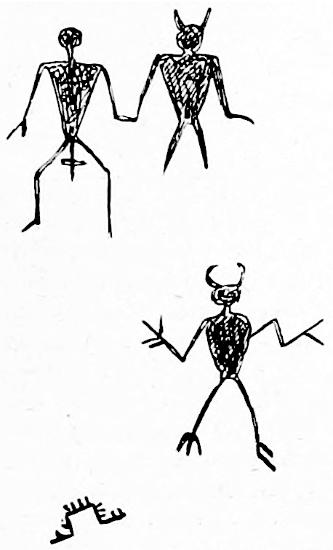
Fig. 1094.—Shoshonean rock-painting. Utah.
Mr. Gilbert Thompson, of the U. S. Geological Survey, has discovered pictographs at Fool creek canyon, Utah, shown in Fig. 1094, which strongly resemble those still made by the Moki of Arizona. Several characters are identical with those last mentioned, and represent human figures, one of which is drawn to represent a man, shown by a cross, the upper arm of which is attached to the perinæum. These are all drawn in red color and were executed at three different periods. Other neighboring pictographs are pecked and unpainted, while others are both pecked and painted.
Both of these pictographs from Utah may be compared with the Moki pictographs from Oakley springs, Arizona, copied in Fig. 1261.
Dr. G. W. Barnes, of San Diego, California, has kindly furnished sketches of pictographs prepared for him by Mrs. F. A. Kimball, of National city, California, which were copied from records 25 miles northeast of the former city. Many of them found upon the faces of large rocks are almost obliterated, though sufficient remains to permit[682] tracing. The only color used appears to be red ocher. Many of the characters, as noticed upon the drawings, closely resemble those in New Mexico, at Ojo de Benado, south of Zuñi, and in the canyon leading from the canyon at Stewart’s ranch, to the Kanab creek canyon, Utah. This is an indication of the habitat of the Shoshonean stock apart from the linguistic evidence with which it agrees.
From the numerous illustrations furnished of petroglyphs found in Owens valley, California, reference is here made to Pl. II a, Pl. III h, and Pl. VII a as presenting suggestive similarity to the Shoshonean forms above noted, and apparently connecting them with others in New Mexico, Arizona, Sonora, and Central and South America.
Mr. F. H. Cushing (a) figured three petroglyphs, now reproduced in Figs. 1095 and 1096, from Arizona, and referred to them in connection with figurines found in the ruined city of Los Muertos, in the Salado valley, as follows:
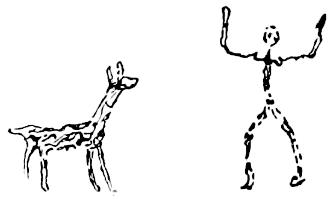
Fig. 1096.—Arizona petroglyph.
Beneath the floor of the first one of these huts which we excavated, near the ranch of Mr. George Kay Miller, were discovered, disposed precisely as would be a modern sacrifice of the kind in Zuñi, the paraphernalia of a Herder’s sacrifice, namely, the paint line, encircled, perforated medicine cup, the Herder’s amulet stone of chalcedony, and a group of at least fifteen remarkable figurines. The figurines alone, of the articles constituting this sacrifice, differed materially from those which would occur in a modern Zuñi “New Year Sacrifice” of the kind designed to propitiate the increase and prosperity of its herds. While in Zuñi these figurines invariably represent sheep (the young of sheep mainly; mostly also females), the figurines in the hut at “Los Guanacos,” as I named the place, represented with rare fidelity * * * some variety, I should suppose, of the auchenia or llama of South America.
Summing up the evidence presented by the occurrence of numerous “bola stones” in these huts and within the cities; by the remarkably characteristic forms of these figurines; by the traditional statement of modern Zuñis regarding “small hairy animals” possessed by their ancestors, no less than by the statements of Marcus Nizza, Bernal Diaz, and other Spanish writers to the same effect, and adding to this sum the facts presented in sundry ritualistic pictographs, I concluded, very boldly, * * * that the ancient Pueblos-Shiwians, or Aridians, * * * must have had[683] domesticated a North American variety of the auchenia more nearly resembling, it would seem, the guanaco of South America than the llama.
It is ascertained that the petroglyphs copied by Mr. Cushing as above are pecked upon basaltic rock in the northern face of Maricopa mountains, near Telegraph pass, south of Phœnix, Arizona.
The following information is obtained from Dr. H. Ten Kate (a):
In several localities in the sierra in the peninsula of California and Sonora are rocks painted red. These paintings are quite rude and are inferior to many of the pictographs of the North American Indians. Figs. 1097 and 1098 were found at Rincon de S. Antonio. The right-hand division of Fig. 1097 is a complete representation, and the figures copied appear on the stone in the order in which they are here given. The left-hand division of the same figure represents only the most distinct objects, selected from among a large number of others, very similar, which cover a block of marble several meters in height. The object in the upper left-hand corner of Fig. 1097 measures 20 to 21 centimeters; the others are represented in proportion.
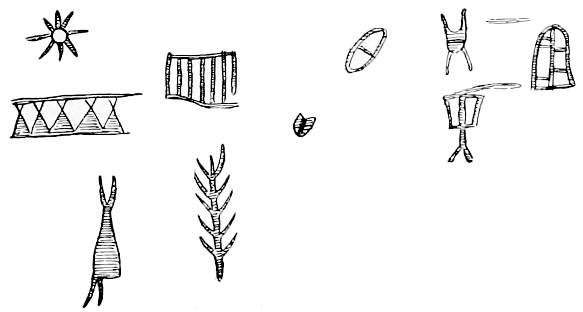
Fig. 1097.—Petroglyphs, Lower California.
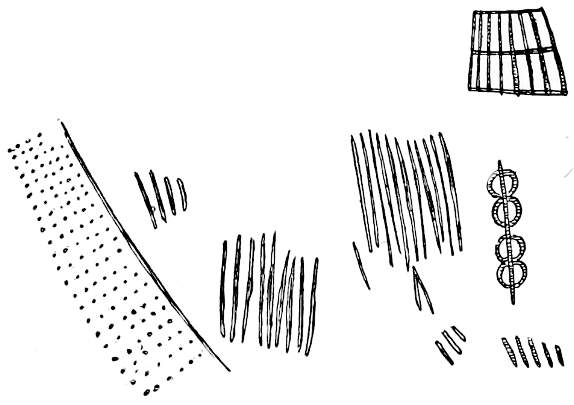
Fig. 1098.—Petroglyphs in Lower California.
These two figures resemble petroglyphs reported from the Santa Inez range, west of Santa Barbara, Lower California.
The same author, op. cit., p. 324, says:
Fig. 1098 represents symbols which were the most easily distinguished among the great number of those which cover two immense granite blocks at Boca San Pedro. The rows of dots (or points) which are seen at the left of this figure measure 1.50 meters, the parallel lines traced at the right are about 1 meter.
This figure is like another found farther east (see Fig. 31) from Azuza canyon, California.
A number of Haida pictographs are reproduced in other parts of this[685] work. In immediate connection with the present topic Fig. 1099 is presented. It shows the carved columns in front of the chief’s house at Massett, Queen Charlotte island.
The following illustrations from New Zealand are introduced here for comparison.
Dr. F. von Hochstetter (b) writing of New Zealand, says:
The dwellings of the chiefs at Ohinemutu are surrounded with inclosures of pole fences, and the Whares and Wharepunis, some of them exhibiting very fine specimens of the Maori order of architecture, are ornamented with grotesque wood carvings. Fig. 1100 is an illustration of some of them. The gable figure with the lizard having six feet and two heads is very remarkable. The human figures are not idols, but are intended to represent departed sires of the present generation.
Niblack (c) gives a description of the illustration reproduced as Fig. 1101.
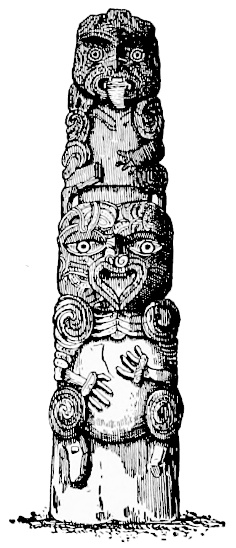
Fig. 1101.—New Zealand tiki.
Tiki. At Raroera Pah, New Zealand. From Wood’s Natural History, page 180. Of this he says: “This gigantic tiki stands, together with several others, near the tomb of the daughter of Te Whero-Whero, and, like the monument which it seems to guard, is one of the finest examples of native carving to be found in New Zealand. The precise object of the tiki is uncertain, but the protruding tongue of the upper figure seems to show that it is one of the numerous defiant statues which abound in the islands. The natives say that the lower figure represents Maui the Auti who, according to Maori tradition, fished up the islands from the bottom of the sea.”
Dr. Bransford (b) gives an illustration, copied here as the left-hand character of Fig. 1102, with the description of the site, viz: “On a hillside[686] on the southern end of the island of Ometepec, Nicaragua, about a mile and a half east of Point San Ramon.” On a rough, irregular stone of basalt, projecting 3 feet above ground, was the following figure on the south side:
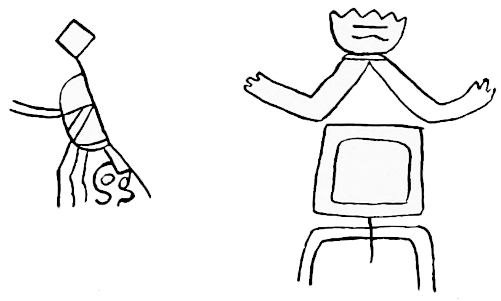
Fig. 1102.—Nicaraguan petroglyphs.
This suggests comparison with some of the Moki and British Guiana figures.
The same authority gives on page 66, from the same island and neighborhood, the illustration copied as the right-hand character of the same figure.
By comparing some of the New Mexican, Zuñi, and Pueblo drawings with the above figure the resemblance is obvious. This is most notable in the outline of the square abdomen and the widespread legs.
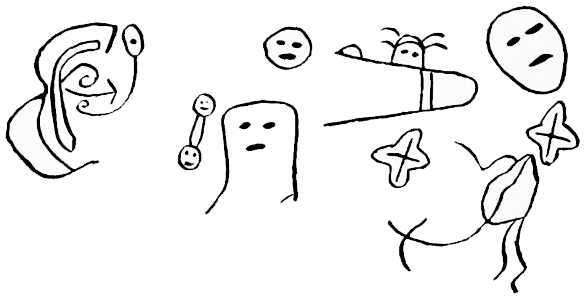
Fig. 1103.—Nicaraguan petroglyphs.
Fig. 1103, also mentioned and figured by Dr. Bransford as found with the preceding in Nicaragua, resembles some of the petroglyphs presented in the collection from Owens valley, California.
The carvings in Fig. 1104 are from British Guiana, and are reproduced from im Thurn (i):
Most of these figures so strongly resemble some from New Mexico, and perhaps Arizona, as to appear as if they were made by the same people. This is specially noticeable in the lowermost characters, and more particularly so in the last two, resembling the usual Shoshonean type for toad or frog.
The petroglyph of Boca del Infierno, a copy of which is furnished by Marcano (f), reproduced as Fig. 1105, is thus described:
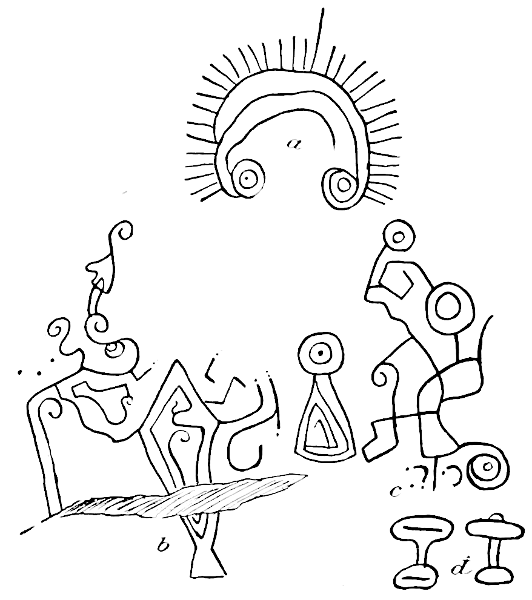
Fig. 1105.—Venezuelan petroglyphs.
In the strange combination that surmounts it, a, there are seen at the lower part two figures resembling the eyes of jaguars, but asymmetric. Still the difference is apparent rather than real. These eyes are always formed of three circumferences, the central one being at times replaced by a point, as in the eye at the left; the one at the right shows its three circumferences, but the outermost is continuous with the rest of the drawing. The two eyes are joined together by superposed arches, the smallest of which touches only the left eye, while the larger one, which is not in contact with the left eye, forms the circumference of the right eye. The whole is surrounded by 34 rays, pretty nearly of the same size, except one, which is larger. Is there question of a jaguar’s head seen from in front with its bristling mane, or is it a sunrise? All conjecture is superfluous, and it is useless to search for the interpretation of these figures, whose value, entirely conventional, is known only by those who invented them.
[688]In b of the same pictograph, alongside of a tangle of various figures, always formed of geometric lines, we distinguished, at the left, three points; in the middle a collection of lines representing a fish. Let us note, finally, the dots which, as in the preceding case, run out from certain lines.
The design of c, while quite as complex, has quite another arrangement. At the left we see again the figure of the circumferences surrounding a dot, and these are surmounted by a series of triangles; at the bottom there are two little curves terminated by dots. At d two analogous objects are represented; they may be what Humboldt took to be arms or household implements.
In the above figure, the uppermost character, a, is similar to various representations of the “sky,” as depicted upon the birch-bark midē' records of the Ojibwa. The lower characters are similar to several examples presented under the Shoshonean types, particularly to those in Owens valley, California.
Dr. A. Ernst in Verhandl. der Berliner, Anthrop. Gesell. (c) gives a description of Fig. 1106, translated and condensed as follows:
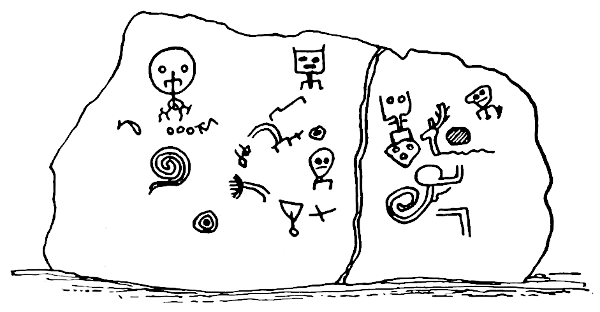
Fig. 1106.—Venezuelan petroglyphs.
The rock on which the petroglyph is carved is 41 kilometers WSW. of Caracas, and 27 kilometers almost due north of La Victoria, in the coast mountains of Venezuela. The petroglyph is found on two large stones lying side by side and leaning against other blocks of leptinite, though resembling sandstone. The length of the two stones is 3.5 m., their height 2 m. The stones lie beside the road from the colony of Tovar to La Maya, on the border of a clearing somewhat inclined southward not far from the woods. The surface is turned south. Concerning the meaning of the very fragmentary figures I can not even express a conjecture.
Araripe (c) furnishes the following description of Fig. 1107:
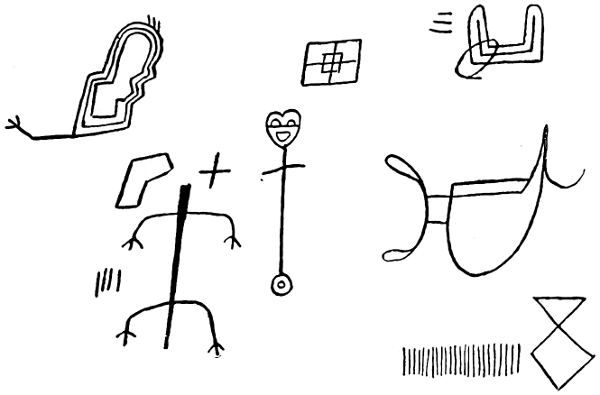
Fig. 1107.—Brazilian petroglyphs.
In the district of Inhamun, on the road from Carrapateira to Cracará, at a distance of half a league, following a footpath which branches off to the left, is a small lake called Arneiros, near which is a heap of round and long stones; on one of the round ones is an inscription, here given in the order in which the figures appear, on the face toward the north, engraved with a pointed instrument, the characters being covered with red paint.
The same authority, p. 231, gives the following description of the lower group in Fig. 1108. It is called Indian writing in Vorá, in Faxina, province of São Paulo.
From a rock which is more than 40 meters in height, a large mass has been detached leaving a greater inclination of 10 meters. This incline, together with the wall formed by the detached portion, constitutes a sheltered place which was used by the Indians as a resting place for their dead.
On the walls of this grotto are figures engraved in the stone and painted with “indelible” colors in red and black. It would seem that the Indians had engraved in these figures the history of the tribe. The designs are as follows:
A human figure with ornaments of feathers on the head and neck; a palm tree rudely engraved and painted; a number of circular holes, 24 or more or less, in a straight line; a circle with a diameter of 15 inches, having dentated lines on the[690] edge; two concentric circles resembling a clock face, with 60 divisions; immediately following this the figure of an idol, and various marks all painted in a very firm black; a figure of the sun with a +; a T; six more circles; a human hand and foot well carved, etc. In the wall are fragments of bones.
The two upper groups are copies of petroglyphs in Fuencaliente, Andalusia, Spain, which are described in Chap. IV, sec. 3, and are[691] introduced here for convenient comparison with characters in the lower group of this figure, and also with others in Figs. 1097 and 1107.
Dr. Ladisláu Netto (c) gives an account of characters copied from the inscriptions of Cachoeira Savarete, in the valley of the Rio Negro, here reproduced as Fig. 1109. They represent men and animals, concentric circles, double spirals, and other figures of indefinite form. The design in the left hand of the middle line evidently represents a group of men gathered and drawn up like soldiers in a platoon.
The same authority, p. 552, furnishes characters copied from rocks near the villa of Moura in the valley of the Rio Negro, here reproduced as Fig. 1110. They represent a series of figures on which Dr. Netto remarks as follows:
It is singular how frequent are these figures of circles two by two, one of which seems to simulate one of the meanders that in a measure represent the form of the Buddhic cross. This character, represented by the double cross, is very common in many American inscriptions. It probably signifies some idea which has nothing to do with that of nandyavarta.
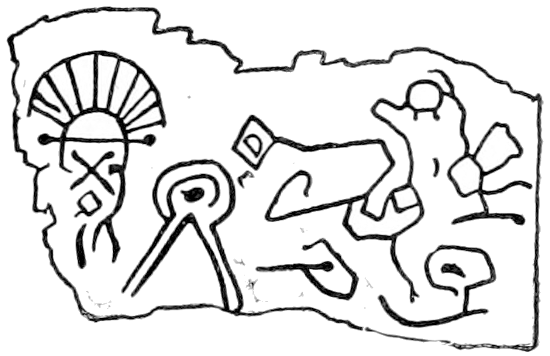
Fig. 1111.—Brazilian petroglyphs.
The same authority, p. 522, gives carvings copied from the rocks of the banks of the Rio Negro, from Moura to the city of Mañaus, some of which are reproduced as Fig. 1111. The group on the left Dr. Netto believes to represent a crowned chief, having by his side a figure which may represent either the sun or the moon in motion, but which, were it carved by civilized men, would suggest nothing more remarkable than a large compass.
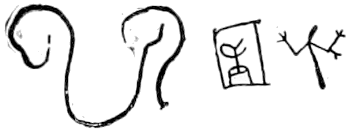
Fig. 1112.—Brazilian pictograph.
The same authority, p. 553, presents characters copied from stones on the banks of the Rio Negro, Brazil, here reproduced as Fig. 1112.
They are rather sketches or vague tracings and attempts at drawing than definite characters. The human heads found in most of the figures observed at this locality resemble the heads carved in the inscriptions of Central America and on the banks of the Colorado river. The left-hand character, which here appears to be simply a rude drawing of a nose and[692] the eyes belonging to a human face, may be compared with the so-called Thunderbird from Washington, contributed by Rev. Dr. Eels (see Fig. 679).
Dr. E. R. Heath (b), in his Exploration of the River Beni, introducing Fig. 1113, says:
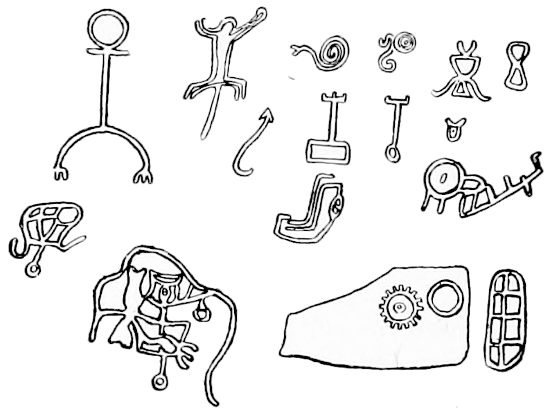
Fig. 1113.—Brazilian petroglyphs.
Periquitos rapids connects so closely with the tail of “Riberáo” that it is difficult to say where one begins and the other ends. Our stop at the Periquitos rapids was short yet productive of a few figures, one rock having apparently a sun and moon on it, the first seen of that character.
He further says:
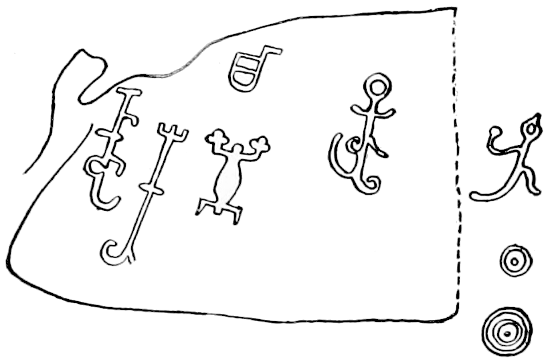
Fig. 1114.—Brazilian petroglyphs.
On some solid water-worn rocks, at the edge of the fall, are the following figures [Fig. 1114]. There were many fractional parts of figures which we did not consider of sufficient value to copy.
It has already been mentioned that characters substantially the same, or homomorphs, made by one set of people, have a different signification among others. The class of homomorphs may also embrace the cases common in gesture signs, and in picture writing, similar to the homophones in oral language, where the same sound has several meanings among the same people.
It would be very remarkable if precisely the same character were not used by different or even the same persons or bodies of people with wholly distinct significations. The graphic forms for objects and ideas are much more likely to be coincident than sound is for similar expressions, yet in all oral languages the same precise sound, sometimes but not always distinguished by different literation, is used for utterly diverse meanings. The first conception of different objects could not have been the same. It has been found, indeed, that the homophony of words and the homomorphy of ideographic pictures is noticeable in opposite significations, the conceptions arising from the opposition itself. The same sign and the same sound may be made to convey different ideas by varying the expression, whether facial or vocal, and by the manner accompanying their delivery. Pictographs likewise may be differentiated by modes and mutations of drawing. The differentiation in picturing or in accent is a subsequent and remedial step not taken until after the confusion had been observed and had become inconvenient. Such confusion and contradiction would only be eliminated from pictography if it were far more perfect than is any spoken language.
This heading, for convenience, though not consistently with its definition, may also include those pictographs which convey different ideas and are really different in form of execution as well as in conception, yet in which the difference in form is so slight as practically to require attention and discrimination. Examples are given below in this section, and others may be taken from the closely related sign-language, one group of which may now be mentioned.
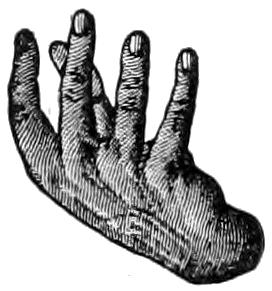
Fig. 1115.—Tree.
The sign used by the Dakota, Hidatsa, and several other tribes for “tree” is made by holding the right hand before the body, back forward, fingers and thumb separated; then pushing it slightly upward, Fig. 1115; that for “grass” is the same, made near the ground; that for “grow” is made like “grass,” though, instead of holding the back of the hand near the ground, the hand is pushed upward in an interrupted manner, Fig. 1116. For “smoke” the hand (with the back down, fingers pointing upward as in grow) is then thrown upward several times from the same place instead of continuing the whole motion upward. Frequently the fingers are thrown forward from under the thumb with each successive upward motion. For “fire” the hand is employed as in the gesture for smoke, but the motion is frequently more waving, and in other cases made higher from the ground.
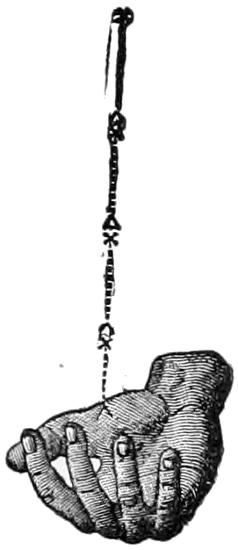
Fig. 1116.—Grow.
Symmorphs, a term suggested by the familiar “synonym,” are designs not of the same form, but which are used with the same significance or so nearly the same as to have only a slight shade of distinction and which sometimes are practically interchangeable. The comprehensive[694] and metaphorical character of pictographs renders more of them interchangeable than is the case with words; still, like words, some pictographs with essential resemblance of meaning have partial and subordinate differences made by etymology or usage. Doubtless the designs are purposely selected to delineate the most striking outlines of an object or the most characteristic features of an action; but different individuals and likewise different bodies of people would often disagree in the selection of those outlines and features. In an attempt to invent an ideographic, not an iconographic, design for “bird,” any one of a dozen devices might have been agreed upon with equal appropriateness, and, in fact, a number have been so selected by several individuals and tribes, each one, therefore, being a symmorph of the other. Gesture language gives another example in the signs for “deer,” designated by various modes of expressing fleetness, also by his gait when not in rapid motion, by the shape of his horns, by the color of his tail, and sometimes by combinations of those characteristics. Each of these signs and of the pictured characters corresponding with them may be indefinitely abbreviated and therefore create indefinite diversity. Some examples appropriate to this line of comparison are now presented.

Fig. 1117.—Sky.
The Indian gesture sign for sky, heaven, is generally made by passing the index from east to west across the zenith. This curve is apparent in the Ojibwa pictograph, the left-hand character of Fig. 1117, reported in Schoolcraft (q), and is abbreviated in the Egyptian character with the same meaning, the middle character of the same figure, from Champollion (e). A simpler form of the Ojibwa picture sign for sky is the right-hand character of the same figure, from Copway (h).
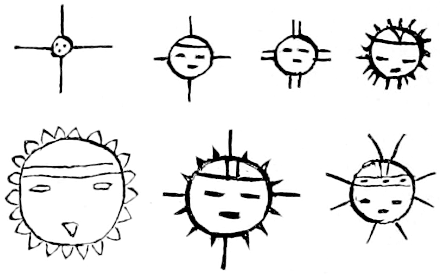
Fig. 1118.—Sun. Oakley springs.
Fig. 1118 shows various representations of the sun taken from a petroglyph at Oakley springs.
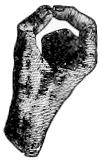
Fig. 1119.—Sun. Gesture sign.
The common Indian gesture sign for sun is: Right hand closed, the index and thumb curved, with tips touching, thus approximating a circle, and held toward the sky, the position of the fingers of the hand forming a circle as is shown in Fig. 1119. Two of the Egyptian characters for sun, the left-hand upper characters of Fig. 1120 are the common conception of the disk. The rays emanating from the whole disk appear in the two adjoining characters on the same figure, taken from the rock etchings of the Moki pueblos in Arizona. From the same locality are the two remaining characters in the same figure, which may be distinguished from several similar etchings for “star,” Fig. 1129, infra, by their showing some indication of a face, the latter being absent in the characters denoting “star.”

Fig. 1120.—Devices for sun.
With the above characters for sun compare the left-hand character of Fig. 1121, found at Cuxco, Peru, and taken from Wiener (h).

Fig. 1121.—Sun and light.
In the pictorial notation of the Laplanders the sun bears its usual figure of a man’s head, rayed. See drawings in Scheffer’s History of Lapland, London, 1704.
The Ojibwa pictograph for sun is seen in the second character of Fig. 1121, taken from Schoolcraft (r). The sun’s disk, together with indications of rays, as shown in the third character of the same figure, and in its linear form, the fourth character of that figure, from Champollion, Dict., constitutes the Egyptian character for light.
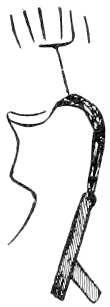
Fig. 1122.—Light.
Fig. 1122.—Light. Red-Cloud’s Census. This is to be compared with the rays of the sun as above shown, but still more closely resembles the old Chinese character for light, or more specifically “light above man,” in the left-hand character of Fig. 1123, reported by Dr. Edkins.

Fig. 1123.—Light and sun.
The other characters of the same figure are given by Schoolcraft (s) as Ojibwa symbols of the sun.
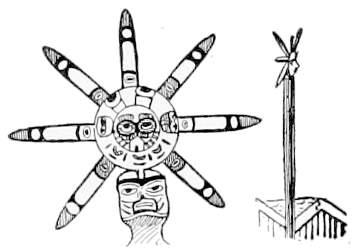
Fig. 1124.—Sun. Kwakiutl.
The left-hand character of Fig. 1124, from Proc. U. S. Nat. Museum[696] (a), shows the top of an heraldic column of the Sentlae (Sun) gens of the Kwakiutl Indians in Alert bay, British Columbia, which represents the sun surrounded by wooden rays. A simpler form is seen in the right character of the same figure where the face of the sun is also fastened to the top of a pole. The author, Dr. Boas, states that Fig. 1125 is the sun mask used by the same gens in their dance. This presents another mode in which the common symbolic connection of the eagle (the beak of which bird is apparently shown) with the sun is indicated.
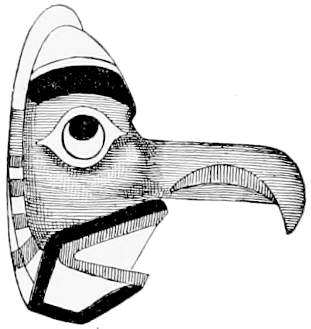
Fig. 1125.—Sun mask. Kwakiutl.
Prof. Cyrus Thomas, in Aids to the Study of the Manuscript Troano, Sixth Ann. Rep. Bur. Ethn., p. 348, gives the left-hand character in Fig. 1126 as representing the sun.

Fig. 1126.—Suns.
General Forlong (a) states that the middle device of the same figure represents the sun as Mihr, the fertilizer of the seed.
Dr. Edkins (e) gives the right-hand device of the same figure as a picture of the sun. Originally it was a circle with a stroke or dot in the middle.
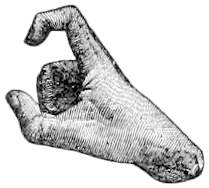
Fig. 1127.—Gesture for moon.
A common Indian gesture sign for moon, month, is the right hand closed, leaving the thumb and index extended, but curved to form a half circle and the hand held toward the sky, in a position which is illustrated in Fig. 1127, to which curve the Moki drawing, the upper left-hand device in Fig. 1128, and the identical form in the ancient Chinese have an obvious resemblance.
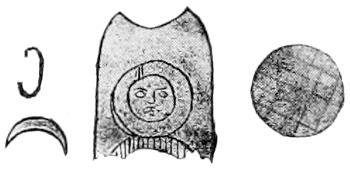
Fig. 1128.—Moon.
The crescent, as Europeans and Asiatics commonly figure the satellite, appears also in the Ojibwa pictograph, the lower left-hand character in Fig. 1128, taken from Schoolcraft (t), which is the same, with a slight addition, as the Egyptian figurative character.
The middle character in Fig. 1128 is the top of an upright post of a house of the moon gens of the Kuakiutl Indians taken from Boas (g). It represents the moon.
Schoolcraft (u) gives the right-hand character of the same figure for the moon, i. e., an obscured sun, as drawn by the Ojibwa.
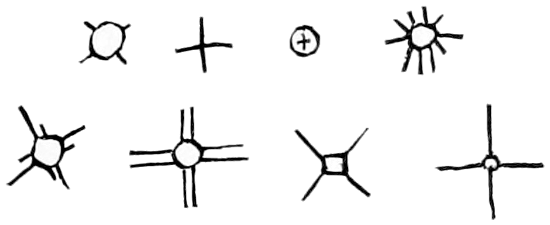
Fig. 1129.—Stars.
Fig. 1129 shows various forms of stars, taken from a petroglyph at Oakley Springs, Arizona. Most of them show the rays in a manner to suggest the points of stars common in many parts of the world.
Fig. 1130, copied from Copway (h), presents respectively the characters for sunrise, noon, and sunset.
Fig. 1130.—Day. Ojibwa.
An Indian gesture sign for “sunrise,” “morning,” is: Forefinger of right hand crooked to represent half of the sun’s disk and pointed or extended to the left, slightly elevated. In this connection it may be noted that when the gesture is carefully made in open country the pointing would generally be to the east, and the body turned so that its left would be in that direction. In a room in a city, or under circumstances where the points of the compass are not specially attended to, the left side supposes the east, and the gestures relating to sun, day, etc., are made with such reference. The half only of the disk represented in[698] the above gesture appears in the Moki pueblo drawings for morning and sunrise.

Fig. 1131.—Morning. Arizona.
Fig. 1131 shows various representations of sunrise from Oakley Springs, Arizona.
J. B. Dunbar (b), in The Pawnee Indians, says:
As an aid to the memory the Pawnees frequently made use of notches cut in a stick or some similar device for the computation of nights (for days were counted by nights), or even of months and years. Pictographically a day or daytime was represented by a six or eight pointed star as a symbol of the sun. A simple cross (a star) was a symbol of a night and a crescent represented a moon or lunar month.
A common Indian gesture for day is when the index and thumb form a circle (remaining fingers closed) and are passed from east to west.

Fig. 1132.—Day.
Fig. 1132 shows a pictograph found in Owens valley, California, a similar one being reported in the Ann. Rep. Geog. Survey West of the 100th Meridian for 1876, Washington, 1876, pl. opp. p. 326, in which the circle may indicate either day or month (both these gestures having the same execution), the course of the sun or moon being represented perhaps in mere contradistinction to the vertical line, or perhaps the latter signifies one.
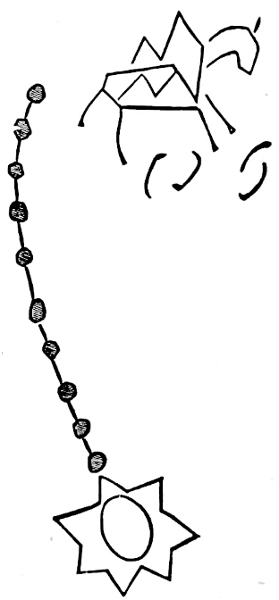
Fig. 1133.—Days. Apache.
Fig. 1133 is a pictograph made by the Coyotèro Apaches, found at Camp Apache, in Arizona, reported in the Tenth Ann. Rep. U. S. Geol. and Geogr. Survey of the Terr., Washington, 1878, Pl. LXXVII. The sun and the ten spots of approximately the same shape represent the days, eleven, which the party passed in traveling through the country. The separating lines are the nights, and may include the conception of covering over and consequent obscurity referred to in connection with the pictographs for night.

Fig. 1134.—Clear, stormy. Ojibwa.
The left-hand character in Fig. 1134, copied from Copway (h), represents smooth water or clear day.
The right-hand character in the same figure, from the same authority, p. 135, represents storm or a windy day.
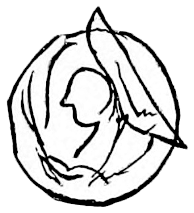
Fig. 1135.
Fig. 1135.—Kills-the-Enemy-at-Night. Red-Cloud’s Census. Night is indicated by the black circle around the head, suggesting the covering over with darkness, as is shown in the common gesture for night, made by passing both flat hands from their respective sides, inward and downward, before the body. The sign for kill is denoted here by the bow in contact with the head, in accordance with a custom among the Dakota of striking the dead enemy with the bow or coup stick.
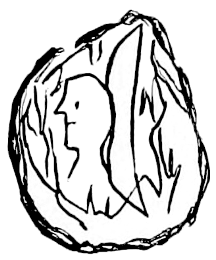
Fig. 1136.
Fig. 1136.—Kills-Enemy-at-Night. Red-Cloud’s Census. This drawing is similar to the preceding. The differentiation is sufficient to allow of a distinction between the two characters, each representing the same name, though belonging to two different men.
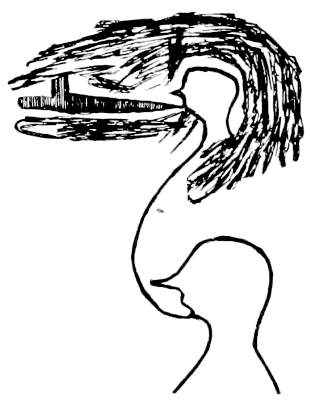
Fig. 1137.
Fig. 1137.—Smokes-at-Night. Red-Cloud’s Census. Again the concept is expressed by the covering over with darkness.
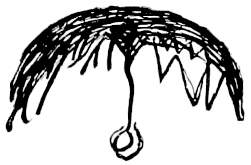
Fig. 1138.
Fig. 1138.—Kills-at-Night. Red-Cloud’s Census. Night is here shown by the curve for sky and the suspension, beneath it, of a star, or more probably in Dakotan expression, a night sun, i. e., the moon.
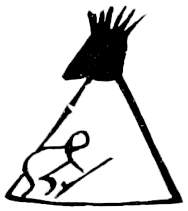
Fig. 1139.
Fig. 1139.—A Crow chief, Flat-Head, comes into the tipi of a Dakota chief, where a council was assembled. Flame’s Winter Count, 1852-’53. The night is shown by the black top of the tipi.

Fig. 1140.—Ojibwa.
Fig. 1140 is taken from Copway (f). It represents “night.”
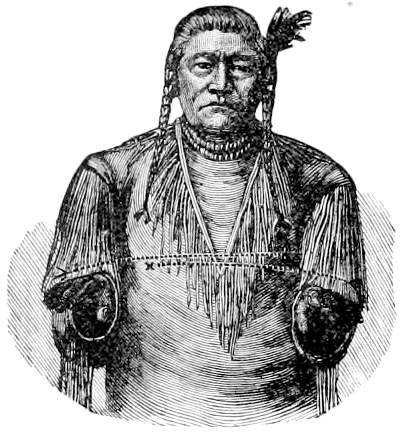
Fig. 1141.—Sign for night.
A typical Indian gesture for night, illustrated by Fig. 1141, is: Place the flat hands horizontally about 2 feet apart, move them quickly in an upward curve toward one another until the right lies across the left. “Darkness covers all.”

Fig. 1142.—Night. Egyptian.
The conception of covering executed by delineating the object covered beneath the middle point of an arch or curve, appears also clearly in the Egyptian characters for night, Fig. 1142, Champollion (f).
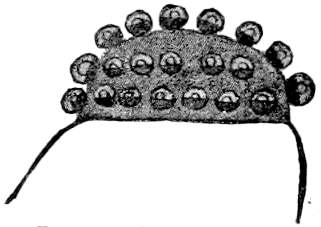
Fig. 1143.—Night. Mexican.
In Kingsborough (m) is the painting reproduced as Fig. 1143.
This painting expresses the multitude of eyes, i. e., stars in the sky, and signifies the night. Eyes in Mexican paintings are painted exactly in this manner.
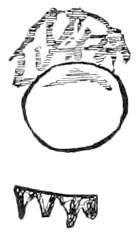
Fig. 1144.—Cloud shield.
Fig. 1144.—Cloud shield. Red-Cloud’s Census. This figure shows in conjunction with the disk, probably a shield but possibly the sun, a dim cloud, and below is a line apparently holding up clouds from which the raindrops have not yet begun to fall. This may be collated with the pictographs for rain and also for snow, as figured below.

Fig. 1145.—Clouds, Moki.
A Cheyenne sign for cloud is as follows: (1) Both hands partially closed, palms facing and near each other, brought up to level with or slightly above but in front of the head; (2) suddenly separated sidewise, describing a curve like a scallop; this scallop motion is repeated for “many clouds.” The same conception is in the Moki etchings, the three left-hand characters of Fig. 1145 (Gilbert MS.), and in variants from Oakley Springs, the two right-hand characters of the same figure.
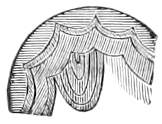
Fig. 1146.—Cloud, Ojibwa.
The Ojibwa pictograph for cloud, reported in Schoolcraft (n), is more elaborate, Fig. 1146. It is composed of the sign for sky to which that for clouds is added, the latter being reversed, as compared with the Moki etchings, and picturesquely hanging from the sky.

Fig. 1147.—Rain. Ojibwa.
Fig. 1147.—From Copway, loc. cit., represents rain, cloudy.
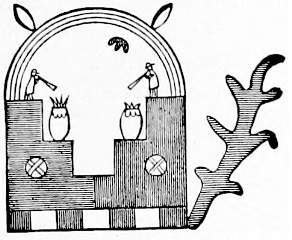
Fig. 1148.—Rain. Pueblo.
The gesture sign for rain is illustrated in Fig. 1002. The pictograph, Fig. 1148, reported as found in New Mexico, by Lieut. Simpson, in Ex. Doc. No. 64, 31st Congress, 1st session, 1850, p. 9, is said to represent Montezuma’s adjutants sounding a blast to him for rain. The small character inside the curve which represents the sky, corresponds with the gesturing hand, but may be the rain cloud appearing.

Fig. 1149.—Rain. Moki.
The Moki drawing for rain, i. e., a cloud from which the drops are falling, is given in Fig. 1149, in six variants taken from a petroglyph at Oakley Springs.

Fig. 1150.—Rain. Chinese.
Edkins (f) gives Fig. 1150 as the Chinese character for rain. It is a picture of rain falling from the clouds. He adds, p. 155:
Rain was anciently without the upper line, and instead of the vertical line in the middle there were four, but all shorter. Above each of them and within the concave was a dot. These four dots were raindrops, the four lines were the direction of their descent, and the concave was the firmament.
Among the northern Indians of North America the concept of lightning is included in that of thunder, and is represented by the thunder bird, see Chap. XIV, sec. 2, supra.
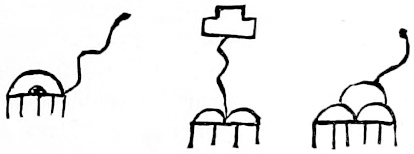
Fig. 1151.—Lightning. Moki.
Fig. 1151 shows three ways in which lightning is represented by the Moki. They are copied from a petroglyph at Oakley Springs, Arizona. In the middle character the sky is shown, the changing direction of the streak and clouds with rain falling. The part relating specially to the streak is portrayed in an Indian gesture sign[702] as follows: Right hand elevated before and above the head, forefinger pointing upward, brought down with great rapidity with a sinuous, undulating motion, finger still extended diagonally downward toward the right.
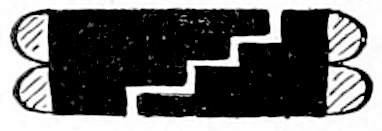
Fig. 1152.—Lightning. Moki.
Fig. 1152 is a copy from a vase in the collection of relics of the ancient builders of the southwest table lands in the MS. Catalogue of Mr. Thomas V. Keam, and represents the body of the mythic Um-tak-ina, the Thunder. This body is a rain cloud with thunder [lightning] darting through it, and is probably of ancient Moki workmanship.
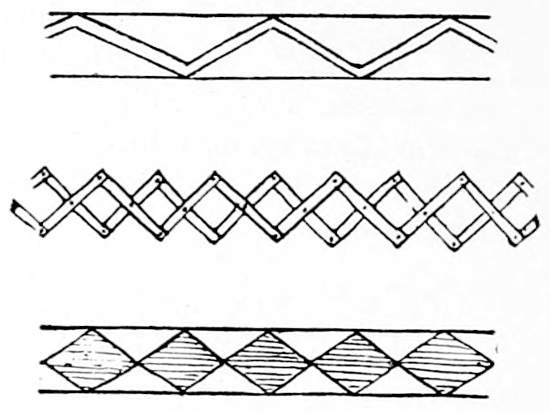
Fig. 1153.—Lightning. Moki.
Fig. 1153, also from Keam’s MS., gives three other representations of the Moki characters for lightning. The middle one shows the lightning sticks which are worked by the hands of the dancers.
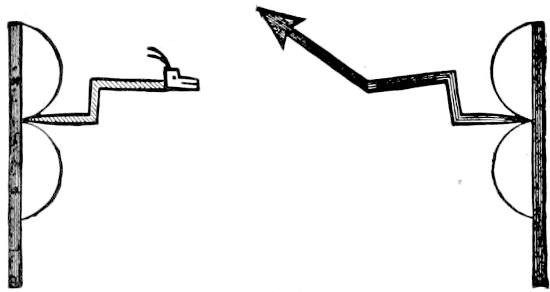
Fig. 1154.—Lightning. Pueblo.
Fig. 1154 also represents lightning, taken by Mr. W. H. Jackson, photographer of the late U. S. Geol. and Geogr. Survey, from the decorated walls of an estufa in the Pueblo de Jemez, New Mexico. The former is blunt, for harmless, and the latter terminates in an arrow or spear point, for destructive or fatal lightning.
Connected with this topic is the following extract from Virgil’s Æneis, Lib. VIII, 429:
The “radii” are the forks or spikes by which lightning is designated, especially on medals. It consisted of twelve wreathed spikes or darts extended like the radii of a circle. The wings denote the lightning’s rapid motion and the spikes or darts its penetrating quality. The four different kinds of spikes refer to the four seasons. The “tres imbristorti radii” or the three spikes of hail, are the winter when hail storms abound. The “tres nubis aquosæ radii,” the three spikes of a watery cloud, denote the spring. The “tres rutili ignis radii,” the three spikes of sparkling fire, are the summer when lightning is frequent and the “tres alitis austri radii,” or the three spikes of winged wind, are for autumn with its many wind storms.

Fig. 1155.—Human form.
Fig. 1155.—a among the Arikara signifies men. The characters are used in connection with horseshoes, to denote “mounted men” b. In other pictographs such spots or dots are merely numerical. c is drawn by the Kiatéxamut branch of the Innuits for man. It is an abbreviated form and rare. d, drawn by the Blackfeet, signifies “Man-dead.” This is from a pictograph in Wind River mountains, taken from Jones’s (c) Northwestern Wyoming. e is also a Kiatéxamut Innuit drawing for man. This figure is armless; generally represents the person addressed.
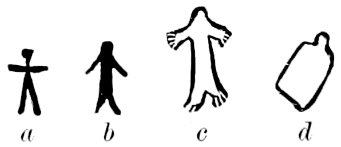
Fig. 1156.—Human form.
Fig. 1156.—a is also a Kiatéxamut Innuit drawing for man. The person makes the gesture for negation. b and c, from a Californian petroglyph, are men also gesturing negation. d, from Schoolcraft (v), is the Ojibwa “symbol” for disabled man.
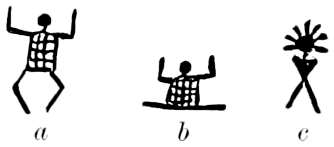
Fig. 1157.—Human form.
Fig. 1157.—a is the Kiatéxamut Innuit drawing for Shaman. b, used by the same tribe, represents man supplicating. c, reproduced from Schoolcraft (u), is the Ojibwa representative figure or man.

Fig. 1158.—Human form.
Fig. 1158.—a, from Schoolcraft, loc. cit., is an Ojibwa drawing of a headless body. b, from the same, is another Ojibwa figure for a headless body, perhaps female. c, contributed by Mr. Gilbert Thompson, is a drawing for a man, made by the Moki in Arizona. d, reproduced from Schoolcraft (w), is a drawing from the banks of the River Yenesei, Siberia, by Von Strahlenberg (a). e is given by Dr. Edkins, op. cit., p. 4, as the Chinese character for, and originally a picture of, a man.

Fig. 1159.—Human form. Alaska.
The representation of a headless body does not always denote death. An example is given in Fig. 1159, a, taken from an ivory drill-bow in the collection of the Alaska Commercial Company, of San Francisco, California. It was made by the Aigaluxamut natives of Alaska. As the explanation gives no suggestion of a fatal casualty, the concept may be that the hunter got lost or “lost his head,” according to the colloquial phrase.
The figures of men in a canoe are represented by the Kiatéxamut Innuit of Alaska, as shown in the same figure, b. The right-hand upward stroke represents the bow of the boat, while the two lines below[704] the horizontal stroke denote the paddles used by the men, who are shown as the first and second upward strokes above the canoe; in the same figure, c shows the outline of human figures, copied from a walrus ivory drill-bow (U. S. Nat. Mus., No. 44398) from Cape Nome, Alaska. The second pair closely resemble forms of the thunder-bird as drawn by various Algonquian tribes and as found in petroglyphs upon rocks in the northeastern portion of the United States; in the same figure, d, selected from a group of human forms, is incised upon a walrus ivory drill-bow obtained at Port Clarence, Alaska, by Dr. T. H. Bean, of the National Museum. The specimen is numbered 40054. The fringe-like appendages on the arms may indicate the garment worn by some of the Kenai or other inland Athabascan Indians of Alaska.

Fig. 1160.—Bird-man. Siberia.
Fig. 1160, from Strahlenberg, op. cit., was found in Siberia, and is identical with the character which, according to Schoolcraft, is drawn by the Ojibwa to represent speed and the power of superior knowledge by exaltation to the regions of the air, being, in his opinion, a combination of bird and man.
It is to be noticed that some Ojibwa recently examined regard the character merely as a human figure with outstretched arms, and fringes pendent therefrom. It has, also, a strong resemblance to some of the figures in the Lone-Dog Winter Counts (those for 1854-’55 and 1866-’67, pages 283 and 285, respectively), in which there is no attempt understood to signify anything more than a war-dress.
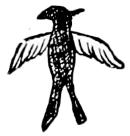
Fig. 1161.—American. Ojibwa.
Fig. 1161, according to Schoolcraft (t), is the Ojibwa drawing symbolic for an American.
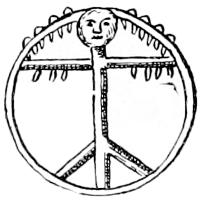
Fig. 1162.—Man. Yakut.
Bastian (a), in Ethnologisches Bilderbuch, says:
Upon a shaman’s drum, from the Yakuts of Siberia, is the figure of a human form greatly resembling some forms of the American types. The appendages beneath the arms, given in Fig. 1162, suggest also some forms of the thunder-bird as drawn by the Ojibwa.

Fig. 1163.—Human forms. Moki.
Fig. 1163 is a copy of human forms found by Mr. Dellenbaugh in[705] petroglyphs in Shinumo canyon, Utah. They probably are of Moki workmanship.
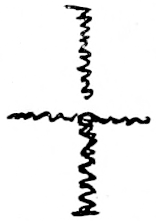
Fig. 1164.—Human form. Navajo.
Fig. 1164, from Mr. Stevenson’s paper in the Eighth Annual Report of the Bureau of Ethnology, p. 283, is the form of a man, drawn in the sand in the Hasjelti ceremony of the Navajo.
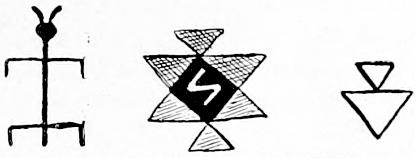
Fig. 1165.—Man and woman. Moki.
The left-hand character of Fig. 1165 is described in Keam’s MS. as follows:
This is a conventional design of dragon flies, and is often found among rock etchings throughout the plateau [Arizona]. The dragon flies have always been held in great veneration by the Mokis and their ancestors, as they have been often sent by Oman to reopen springs which Muingwa had destroyed and to confer other benefits upon the people.
This form of the figure, with little vertical lines added to the transverse lines, connects the Batolatci with the Ho-bo-bo emblems. The youth who was sacrificed and translated by Ho-bo-bo reappeared a long time afterwards, during a season of great drought, in the form of a gigantic dragon fly, who led the rain clouds over the lands of Ho-pi-tu, bringing plenteous rains.
Describing the middle character of the figure, he says: “The figure represents a woman. The breath sign is displayed in the interior. The simpler design in the right-hand character consists of two triangles, one upon another, and is called the ‘woman’s head and body.’”
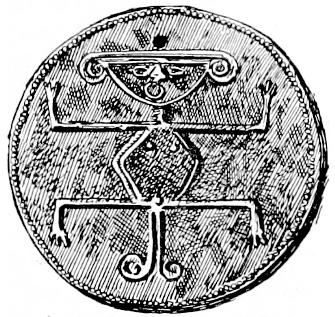
Fig. 1166.—Human form. Colombia.
Fig. 1166, reproduced by permission from the Century Magazine for October, 1891, p. 887, is a representation of a golden breastplate found in the United States of Colombia, and now in the Ruiz-Randall collection. The human figure is nearly identical with some of those described and illustrated in the present work as found in other localities.
Crevaux, quoted by Marcano, (g) in speaking of the photographs of French Guyana, makes these useful suggestions:
The drawings of frogs found by Brown on the Esesquibo are nothing else than human figures such as the Galihis, the Roucouyennes, and the Oyampis represent them every day on their pagaras, their pottery, or their skin. We ourselves, on examining these figures with legs and arms spread out, thought that they were meant for frogs, but the Indians told us that that was their manner of representing man.
In Necropolis of Ancon in Peru, by W. Reiss and A. Stubel, (a) are descriptions of figures a to g in Pl. L, all being painted sepulcher tablets one-seventh of the actual size. The descriptions are condensed. The general characteristics of the tablets are that they are in a tabular form, made of reeds, and covered with a white cotton fabric, the edges of[706] which are stitched together behind and attached to a pole, short at top, and projecting to a greater length downwards. On the front is a slightly sketched design in red and black lines, while a winding or undulating border usually runs around the sides. Nearly all the space within this border is occupied by a human figure surrounded by isolated symbols or ornaments. The head and features of the conventionalized figure is out of all proportion to the small body, which is often merely suggested by a few strokes.
a. The features and high headdress of a human figure, represented by concentric black and red lines. To the short arms are attached outstretched three-fingered hands, the right holding some object, while body and legs are arbitrarily indicated. The legs are twice reproduced in black and red lines. The space between the figure and border is occupied by six simple designs, two black and one red on either side.
b. The human figure, comparatively simple and distinct, distinguished by large ear ornaments, with designs similar to those of the preceding figure, but varying in number and disposition.
c. Highly fantastic figure with diverse ornamentations; the space in the corners cut off by designs, of which the upper two show a bird motive, such as frequently occurs on earthenware and woven fabrics.
d. This is doubtless meant to represent a figure clothed down to the feet.
e. Here the human figure is formed of black lines, connected at right angles with complementary red lines. A wide top-piece covers the head, which consists of two small rectangles, leaving room only to indicate the eyes, while the mouth, placed rather too low down, is suggested by a red stroke. The arms are bent downwards; hands and feet with triple articulation. Within the red and black frame the figure is encircled by crosses, dots, and a conventional star.
f. Human figure filling most of the space, which is inclosed only by a narrow edging. Surface painting distinguishes the wide body, which is rounded off below and to which the triangular head is fitted above. Hands with five, feet with three, articulations; crenelled head gear; necklace suggested by dots; the corners of the ground-surface filled in with rectangular sharply-edged ornaments.
g. Human figure consisting of two disconnected parts; triangular head and body; hands and feet with two articulations; frame of red and black dovetailed teeth.
Wiener (i), describing illustrations reproduced here as Fig. 1167, says:
The tissue found at Moché, a, represents a man with flattened head, exaggerated ears, and the thumb of the right hand too much developed. When correlated with that from Ancon, b, with its coarse paintings, it becomes a sort of caligraphy in which all the letters are traced with the greatest care, while b, and also the sepulchral inscription c, found at the same place, become cursive.
The design a of this series presents peculiarities found in Zuñi drawings on pottery. The appendages from the side of the head among the[707] latter denote large coils of hair so arranged by tying. Their significance is that the wearer is an unmarried woman. The remaining designs also resemble types of human figures found upon Zuñi and Pueblo pottery, being rather of a decorative character than having special significance.
A large number of human faces as drawn by members of different tribes and stocks of North American Indians appear in the present paper. Some of them are iconographic and others are highly conventionalized. Other examples from other regions of the world are also presented under various headings.
In the present connection it may be useful to examine a series of drawings from the prehistoric pottery of Brazil in the National Museum[708] at Rio de Janeiro. Although the U. S. National Museum contains many specimens of a similar character, some of which have been copied and published, the Brazilian types show an instructive peculiarity in the reduction of the face to certain main lines and finally to the eyes, so that the latter are placed apart and independent in a symmetric field.
The following Figs. 1168 to 1174 are reproduced from Dr. Ladisláu Netto (d), all of them being from Brazil and from paintings and carvings on Marajo ware.
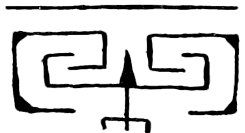
Fig. 1168.—Human face. Brazil.
Fig. 1168 shows broken lines without the aid of curves, but gracefully attached to an instrument, either lance or trident, which present the outline of the contours of a face.
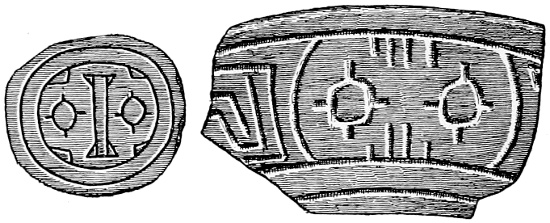
Fig. 1169.—Human faces. Brazil.
The characters in Fig. 1169 are somewhat more elaborate. The eyes are decorated with lines and the contour of the face is round.

Fig. 1170.—Human faces. Brazil.
The characters in Fig. 1170 are carved human faces, some of which would not be recognized as such unless shown in the series.
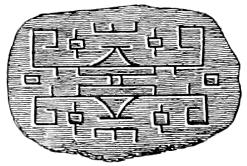
Fig. 1171.—Double-faced head. Brazil.
The face in Fig. 1171 represents the horizontal projection or plan of a double-faced head. The central H represents in this case the top of the head, each of the shafts of the H being neither more nor less than the double arch of the eyebrows, joined to which the representation of the nose in a triangular figure may be recognized. The most noticeable point is that if this surface be applied in imagination to[709] the cranium of the bifrontal head, of which it seems to be the covering or skin, the features of the double-faced heads of the Marajo idols are immediately recognized, including the orifices by which those idols are hung on cords, which orifices are seen in the dividing line of the two faces.
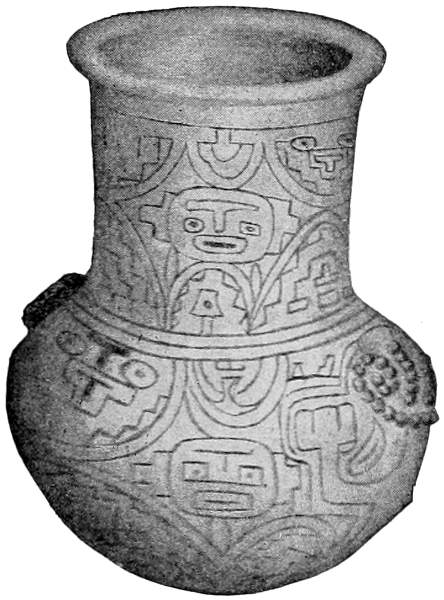
Fig. 1172.—Funeral urn. Marajo.
Fig. 1172 presents the general form of decoration found upon vases bearing figures of the face as above mentioned. It is a funeral urn, carved and engraved, from Marajo, reduced to one-fifth.
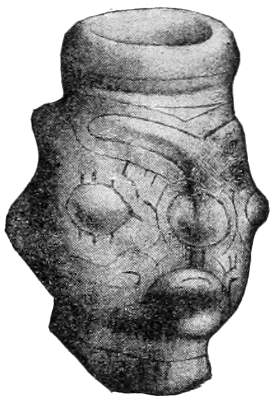
Fig. 1173.—Marajo vase.
Frequently the face is produced in relief, in which a larger portion of a vessel is taken to produce more lifelike imitation, as in Fig. 1173. It is the neck of an anthropomorphic vase of Marajo ornamented with grooves and lines, red on a white ground, reduced to one-half.
Fig. 1174 a, real size, is the neck of a Marajo vase, representing a human head. The nose and chin are very prominent, the eyes horizontal and slit in the same direction. This head is remarkable for the relief of the eyebrows which, after reaching the height of the ears, form these organs, describing above a second curve in the inverse direction of the curve of the brow, each brow thus forming an S. There are other heads in which the eyebrows are prolonged to form the relief of the ears at the outer extremity. In these cases the whole relief represents a semicircle more or less irregular, while on the contrary this relief forms the figure S.
Same figure, b, real size, is the neck of an ornithomorphic, anthropocephalous vase. It has on the face the classic and conventional T to represent the nose and brows. The eyes are formed by the symbolic figure equally conventional in the ceramics of the mound-builders of Marajo, and the ears differ very little from the characters seen in other figures.
Same figure, c, four-fifths real size, is the neck of a Marajo vase representing, by engraving and painting, all the conventional characters of the different parts of the human face employed by the mound-builders of Marajo. This vase preserves perfectly the primitive colors, which show vermilion lines on a white ground. A double protuberance from each ear, the design which forms the eyes, and that which surrounds and outlines the mouth, the nose, and the ears, are characteristic traces of the decorative art of the human face which few heads present in such perfection.
Same figure, d, four-fifths real size, is the neck of a Marajo vase more simple than the preceding one, but with more regular and distinct features.
The Brazilian system above illustrated, which reduces the face to certain main lines and finally to the eyes, in such manner that the eyes are placed apart and each is put by itself in a symmetric field, has its parallel in North America. This is the practice of the Bella Coola Indians and their neighbors at the present day. They divide the surface, to be ornamented into zones and fields, by means of broad horizontal and vertical lines, each field containing, according to its position, now a complete face, now only an indication of it, the especial indication[711] being made by the eye. The eyes themselves are given different shapes, according to the different animals represented, being now large and round, now oblong and with pointed angles. These peculiarities, which have become conventional, are retained when the eye is represented alone, so that by this method it may still be easy to recognize which animal—for example, a raven or a bear, is intended to be portrayed.
The left-hand character in Fig. 1175, from Champollion (g), is the Egyptian character for a human face. The predominance of the ears probably has some special significance.

Fig. 1175.—Human heads.
Schoolcraft (u) gives the right-hand character of the same figure as a man’s head, with ears open to conviction, as made by the Ojibwa.
Both of these may be compared with the exaggerated ears in Fig. 1167.
The impression, real or represented, of a human hand is used in several regions in the world with symbolic significance.
Among the North American Indians the mark so readily applied is of frequent occurrence, with an ascertained significance, which, however, differs in several tribes.
Fig. 1176, taken from Copway (b), represents the hand, and also expresses “did so.” This signification of “do,” or action, and hence “power,” is also given to the same character in the Egyptian and Chinese ideograms.

Fig. 1176.—Hand. Ojibwa.
Among several Indian tribes a black hand on a garment or ornament means “the wearer of this has killed an enemy.” The decoration appears upon Ojibwa bead belts, and the Hidatsa and Arikara state that it is an old custom of showing bravery. The character was noticed at Fort Berthold, and the belt bearing it had been received from Ojibwa Indians of northern Minnesota. The mark of a black hand drawn of natural size or less, and sometimes made by the impress of an actually blackened palm, was also noticed, with the same significance, on articles among the Hidatsa and Arikara in 1881.
Schoolcraft (x) says of the Dakota on the St. Peters river that a red hand indicates that the wearer has been wounded by his enemy, and a black hand that he has slain his enemy.
Irving (b) remarks, in Astoria, of the Arikara warriors: “Some had the stamp of a red hand across their mouths, a sign that they had drunk the life-blood of a foe.”
In other parts of the present paper the significance of the mark is mentioned and may be briefly summarized here.
Among the Sioux a red hand painted on a warrior’s blanket or robe means that he has been wounded by the enemy, and a black hand that[712] he has been in some way unfortunate. Among the Mandan a yellow hand on the breast signifies that the wearer had captured prisoners.
Among the Titon Dakota a hand displayed meant that the wearer had engaged in a hand-to-hand struggle with an enemy. The impress of a hand, stained or muddy, upon the body or horse was the Winnebago mark that the wearer had killed a man.
The drawing of linked fingers or joined hands has been before discussed, p. 643, and in several petroglyphs illustrated in this paper the single hand appears. It is a common device on rocks, and doubtless with varieties of signification, as above mentioned in other forms of pictograph.
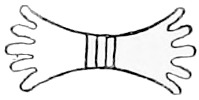
Fig. 1177.—Joined hands. Moki.
It will suffice now to add that the figure of a hand with extended fingers is very common in the vicinity of ruins in Arizona as a rock etching, and is also frequently seen daubed on the rocks with colored pigments or white clay. But Mr. Thomas V. Keam explains the Arizona drawings of hands on the authority of the living Moki. In his MS., in describing Fig. 1177, he says:
The outline of two outstretched hands joined at the wrists and figure of a hand with extended fingers is very common as a rock etching.
These are vestiges of the test formerly practiced among young men who aspired for admission to the fraternity of Salyko. The Salyko is a trinity of two women and a woman from whom the Hopitu obtained the first corn. The first test above referred to was that of putting their hands in the mud and impressing them upon the rock. Only those were chosen as novices the imprints of whose hands had dried on the instant.
Le Plongeon (a) tells that the tribes of Yucatan have the custom of printing the impress of the human hand, dipped in a red-colored liquid, on the walls of certain sacred edifices.
A. W. Howitt, in manuscript notes on Australian pictographs, says:
In very many places there are representations of a human hand imprinted or delineated upon the rocks or in caverns. In the mountains on the western side of the Darling river, in New South Wales, I have observed such, and the aborigines whom I questioned upon the subject said that these representations were made in sport. This reply would, however, be also given were any white man to find and draw their attention to one of the figures which are made in connection with the initiation ceremonies. The representations of hands are made in two ways. In one the hand is smeared with red ocher and water, and impressed upon the rock surface. In the other the hand, being placed upon the rock, a mouthful of red ocher or pipe-clay and water is squirted over it. The hand being then removed there remains its representation surrounded and marked out by the colored wash.
Thomas Worsnop (b) says:
Mr. Winnecke, in 1879, saw several drawings on rocks and in caves, [Fig. 1178], and describes them as follows:
There are found in several large caves near Mount Skinner and Ledans hill, in latitude 22° 30′ south and longitude 134° 30′ east. The natives appear to have selected the smooth surface of granite rocks inside several large caves, which spots are not subject to the influence of wind or rain. These caves are resorted to by the natives during excessive rainy seasons, as indicated by their camp preparations, and[713] it is beyond doubt that these drawings have been performed during these periods of forced inactivity by some artistically inclined native. Those I am alluding to are somewhat numerous in these particular localities and present a uniform appearance.
a, apparently represents a heart pierced in the center by a spear. The outline of the object representing the heart has been delineated with red ocher, whilst the spear has been drawn with a burnt stick or piece of coal. I have only seen this particular sketch in one instance, where four distinct drawings of the same object exactly below and equidistant from each other have been made in anything but a crude manner, the outline having been carefully and very distinctly traced on the rocks, showing a degree of perfection scarcely to be anticipated from these wild inhabitants. The breadth of the heart is about 5 inches and its length about 6 inches. The length of the spear portion is about 3 feet. [The device reminds of St. Valentine’s day.]
b, consists of two parallel lines about 6 inches apart, with regular marks between, and probably represents the native’s notion of a creek with emu tracks traversing its bed. This drawing has been made with a coal, and is found depicted on smooth rocks in various localities.
c, has been drawn both with coal and red ocher. It is found in many places, and seems to be a favorite drawing of the natives. I have found it depicted in several localities in the interior of Australia. It is generally supposed to represent a hand.
d. This figure is made by the natives in the following manner: Placing their extended hand against a smooth rock, after having previously moistened the same, they fill their mouths with powdered charcoal, which they then blow violently along the[714] outline of their extended hand, thus leaving the portions of rock covered perfectly clean, whilst the space between their fingers and elsewhere around about becomes covered with the black substance. This drawing is not very common. I found several specimens near the Sabdover river. I have, however, been informed that it has been seen in other and distant parts of Australia.
Renan (a) says in the chapter on the Nomad Semites:
The real monuments of the period were, as in the case with all people who can not write, the stones which they reared, the columns erected in memory of some event, and upon which was often represented a hand, whence the name of iad [finger post].
Major Conder (c) writes that in Jerusalem a rough representation of a hand is marked by the native races on the wall of every house while building. Some authorities connect it with the five names of God, and it is generally considered to avert the evil eye. The Moors generally, and especially the Arabs in Kairwan, apply paintings of red hands above the doors and on the columns of their houses as talismans to drive away the envious. Similar hand prints are found in the ruins of El Baird near Petra. Some of the quaint symbolism connected with horns is supposed to originate from such hand marks. The same people make the gesture against the evil eye by extending the five fingers of the left hand.
H. Clay Trumbull (b) gives the following:
It is a noteworthy fact that among the Jews in Tunis, near the old Phenician settlement of Carthage, the sign of a bleeding hand is still an honored and a sacred symbol as if in recognition of the covenant-bond of their brotherhood and friendship. “What struck me most in all the houses,” says a traveler (Chevalier de Hesse-Wartegg) among these Jews, “was the impression of an open bleeding hand on every wall of each floor. However white the walls, this repulsive (yet suggestive) sign was to be seen everywhere.”
The following is extracted from Panjab Notes and Queries, Vol. I, No. 1 (October, 1883), p. 2:
At the Temple of Balasundarí Deví at Tilokpúr, near Náhan, the priests stamp a red hand on the left breast of the coat of a pilgrim who visits the temple for the first time to show that he has, as it were, paid for his footing. If the pilgrim again visits the temple and can show the stamp he pays only 4 annas as his fee to the priests.
Gen. A. Hontum-Schindler, Teheran, Persia, in a letter of December 19, 1888, tells:
All through Persia, principally in villages though, a rough representation of a hand, or generally the imprint of a right hand, in red, may be seen on the wall or over the door of a house whilst in building, or on the wall of a mosque, booth, or other public building. It is probably an ancient custom, although the Persians connect it with Islam, and they say that the hand represents that of Albas, a brother of Husain (a grandson of the prophet Mohammed), who was one of the victims at the massacre of Kerbela in 680, and who had his right hand cut off by el Abrad ibu Shaibân. In India I have noticed similar marks, hands, or simply red streaks.
In Journal of the Proc. Royal Soc. Antiq., Ireland, I, 3, fifth series, 1890, p. 247, is the following:
The hand an emblem of good luck in Ireland.—In Maj. Conder’s “Syrian Stone Lore,” published for the Palestine Exploration Committee by Bentley & Son (1886), p. 71, occurs the following passage: “Among other primitive emblems used by the[715] Phenicians is the hand occurring on votive steles at Carthage, sometimes in connection with the sacred fish. This hand is still a charm in Syria, called Kef Miriam, ‘the Virgin Mary’s hand,’ and sovereign against the evil eye. The red hand is painted on walls, and occurs, for instance, in the Hagia Sophia at Constantinople and elsewhere. It is common also in Ireland and in India (Siva’s hand) and on early scepters, always as an emblem of good luck.” What actual foundation is there for the above statement as regards Ireland? About twenty years ago the first Monday in January was known in the south of Ireland as “Handsel Monday,” and looked upon as in some way indicating the prosperity the year succeeding was to bring forth. But whether, as the name would seem to imply, this had any connection with the hand as an emblem of good luck I am unaware.—J. C.
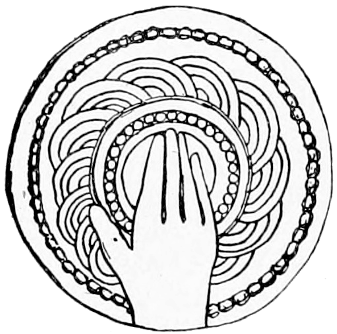
Fig. 1179.—Irish cross.
Gen. Forlong (b) makes the following remarks:
The “red hand of Ireland” is known alike to Turanians, Shemites, and Aryans, and from the Americas to farthest Asia. The hand, being an organ peculiar to man, is in the East a sign of Siva, and seems to have been identified with his emblem even by the Medes. All men have usually worshiped and plighted their troth or sworn by manual signs, so the hand naturally stands as the sign of man himself; but more than this, Easterns attach a significance to it as an organ without which the procreating one is useless. In Germany, says J. Grimm, the hand was Tyr, or the son of Odin, “the one-handed,” for he lost one limb by the biting wintry wolf—that is, he became powerless to produce.... He was then the “golden-handed,” fertilizer, whom ancient Irans denoted by their name Zerdosht, and Irish Kelts placed as a talisman on their Ulster shield.... The Irish solo-phalik idea is seen in the “crosses” of Clon-Mac-Noise and Monasterboise, where, as in Fig. 1179, all the fingers are carefully placed in the center of the circle of fertility. The Vedas constantly speak of Savatar as “the golden-handed sun,” who lost this limb owing to his efforts when at sacrifice, and who remained impotent until the deity restored to him a hand of gold.
Hindus, like the high Asian tribes and the old Mexicans, usually impress a hand covered with blood or vermilion on the door posts of their temple—that is, on the Delpheus or “door of life;” and the great Islamite, Mahmood, when he captured Constantinople, rode up to the holy feminine shrine of St. Sophia, and reaching up as high as he could, there unwittingly imprinted this bloody sign of Great Siva. We must remember how often the hand appears with other significant objects on the arms of men and nations, and notably so on Roman standards.... Fig. 1180.
In the old shrines of America, Leslie says, the “sacred hand was a favorite subject of art,” and Stevens in his Yucatan says, “The red hand stared us in the face over all the ruined buildings of the country, ... not drawn or printed, but stamped by the living hand, the pressure of the palm upon the stone being quite distinct, the thumb and fingers being extended as we see in the Irish and Hindu hands.”

Fig. 1180.—Roman standard.
In the two first illustrations of this group the respective figures of the man and the eagle are in the act of forming tracks on the ground. Such tracks are shown in the next two figures, but without the context[716] might not be recognized as such. The fifth figure is more distinctly ideographic, showing the foot and leg as in the act of making the impress, and the eagle’s feather to indicate the kind of track which would have been made by a running eagle.
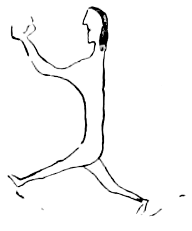
Fig. 1181.
Fig. 1181.—Goes-Walking. Red-Cloud’s Census.
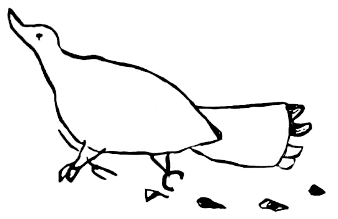
Fig. 1182.
Fig. 1182.—Running-Eagle. Red-Cloud’s Census.
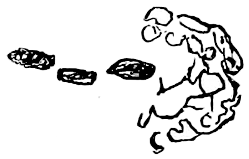
Fig. 1183.
Fig. 1183.—Tracks. Red-Cloud’s Census.

Fig. 1184.
Fig. 1184.—Walking-Bull-Track. Red-Cloud’s Census.
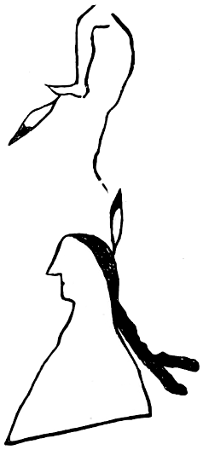
Fig. 1185.
Fig. 1185.—Eagle-Track. Red-Cloud’s Census.

Fig. 1186.—Feet.
Fig. 1186, copied from Copway (b), gives three characters of which the first represents “ran,” the second “walked” or “passed,” and the third “stand,” characters similar both to the tracks and the feet found on many petroglyphs in North America.
They are also found in the terraces of temples of Thebes, of Karnak, and especially at Nakhaur in South Bihar.
P. le Page Renouf (a), in An Elementary Grammar of the Ancient Egyptian Language, gives the right-hand character of the same figure as the generic determinative implying motion.
This group gives several modes of expressing, pictorially, broken legs.
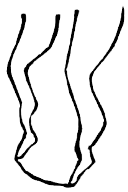
Fig. 1187.
Fig. 1187.—Many were thrown from their horses while surrounding buffalo, and some had their legs broken. Cloud-Shield’s Winter Count, 1847-’48. The legs are distorted and the line may refer to the slippery ice touched by the toes.

Fig. 1188.
Fig. 1188.—Lone-Horn’s father broke his leg. The-Flame’s Winter Count, 1832-’33. This is a strongly marked representation.
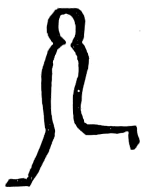
Fig. 1189.
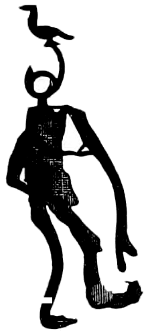
Fig. 1190.
Fig. 1189.—A Minneconjou Dakota named Broken-Leg died. The-Flame’s Winter Count, 1846-’47. The-Flame’s representation is objective, but Battiste Good gives another more ideographic. The arm in his character, given in Fig. 1190, is lengthened so as nearly to touch the broken leg, which is shown distorted, instead of indicating the injury by the mere distortion of the leg itself. The bird over the head, and connected by a line with it, probably represents the teal as a name-totem. Perhaps he was called Broken-Leg after the injury.

Fig. 1191.
Fig. 1191.—There were a great many accidents and some legs were broken, the ground being covered with ice. American-Horse’s Winter Count, 1847-’48. Here the fracture is very obvious—too much so to be intended as objective—rather delineating the idea of the breaking and separation of the bone.
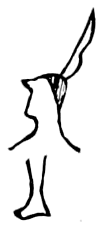
Fig. 1192.
Fig. 1192.—Broken-Leg was killed by the Pawnees. His leg had been broken by a bullet in a previous fight with the Pawnees. American-Horse’s Winter Count, 1807-’08. Here the leg is entirely removed from its normal position.

Fig. 1193.—Broken leg. Chinese.
Dr. Edkins (g) gives Fig. 1193, a, as a picture of a bent leg broken, and adds, “The true radical and phonetic for which this stands as representative is rather b, ‘fault,’ ‘move.’”
This group relates to sounds issuing from the mouth, that is, to voice and speech:

Fig. 1194.
Fig. 1194.—The-Elk-that-Holloes-Walking. The-Swan’s Winter Count, 1860-’61. Interpreter A. Lavary said, in 1867, that The-Elk-that-Holloes-Walking, then chief of the Minneconjous, was then at Spotted-Tail’s camp. His father was Red-Fish. He was the elder brother of Lone-Horn. His name is given as A-hag-a-hoo-man-ie, translated The-Elk’s-Voice-Walking, compounded of he-ha-ka, elk, and omani, walk; this according to Lavary’s literation. The correct literation of the Dakota word meaning elk is heqaka; voice, ho; and to walk, walking, mani. Their compound would be heqaka ho mani, the translation being the same as above given.
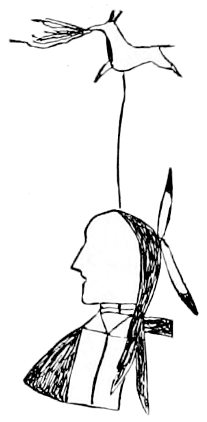
Fig. 1195.
Fig. 1195.—Elk-walking-with-his-Voice. Red-Cloud’s Census: This is explained by the following figure.
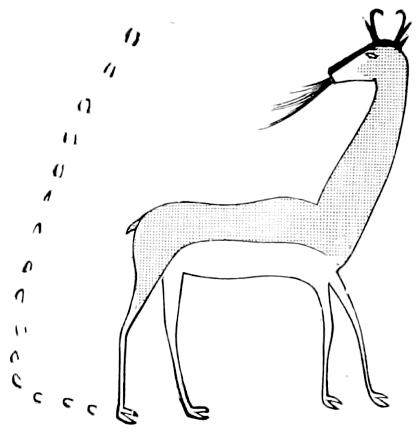
Fig. 1196.
Fig. 1196 is taken from the manuscript drawing book of an Indian prisoner at St. Augustine, Florida, now in the Smithsonian Institution,[718] No. 30664. It represents an antelope and the whistling sound produced by the animal on being surprised or alarmed. It also shows the tracks, and supplies the idea of walking not exhibited by the preceding two figures.
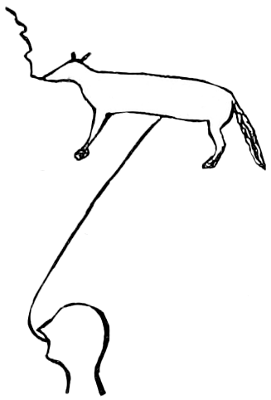
Fig. 1197.
Fig. 1197.—Dog-with-good-voice. Red-Cloud’s Census. The peculiar angular divisions of the line may indicate the explosive character of a dog’s bark as distinct from a long-drawn howl. Among the many lines indicating voice which appear in the Dakota pictographs none has been found identical with this, and therefore it probably has special significance.
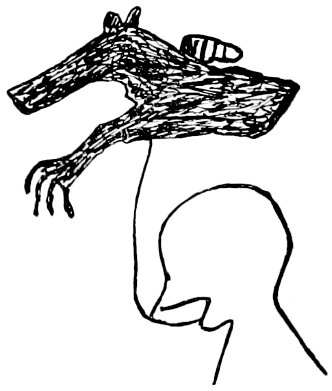
Fig. 1198.
Fig. 1198.—Bear-that-growls. Red-Cloud’s Census. This figure gives a marked differentiation. The sound of growling does not appear to come from the mouth, but from the lower part of the neck or the upper part of the chest, from which the lines here are drawn to emanate. They are also confined by a surrounding line, to suggest the occluded nature of the sound.
The Mexican pictograph, Fig. 1200, taken from Kingsborough (n), is illustrative of the sign made by the Arikara and Hidatsa for “tell” and “conversation.” “Tell me” is: Place the flat right hand, palm upward, about 15 inches in front of the right side of the face, fingers pointing to the left and front; then draw the hand inward toward and against the bottom of the chin. For “conversation,” talking between two persons, both hands are held before the breast, pointing forward, palms up, the edges being moved several times toward one another. Perhaps, however, the picture in fact only means the common poetical image of “flying words.”
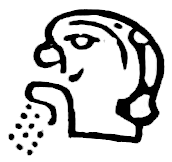
Fig. 1201.—Talk. Maya.
Fig. 1201 is from Landa (b) and suggests one of the gestures for “talk,” and more especially that for “sing,” in which the extended and separated fingers are passed forward and slightly downward from the mouth—“many voices.” Although late criticisms of the bishop’s work are unfavorable to its authenticity, yet even if it were prepared by a Maya, under his supervision, the latter would probably have given him some genuine native conceptions, and among them gestures would be likely to occur.
Gustav Eisen (a), in describing Fig. 1202, says:
The original, from near Santa Lucia, Guatemala, represents a sepulchral tablet, on which are seen the portraits of perhaps man and wife, their different headdresses, etc., indicating decidedly their different sexes. From the mouths of the respective portraits extend as usual curved figures with notes or nodes.
Irving (c) noticed fifty years ago that each tribe of Indians has a different mode of shaping and arranging lodges, and especially that the[720] Omaha make theirs gay and fanciful with undulating bands of red and yellow or with dressed and painted buffalo skins.
The left-hand upper characters of Fig. 1203 represents Dakota lodges as drawn by the Hidatsa. These characters when carelessly or rudely drawn can only be distinguished from personal marks by their position and their relation to other characters.
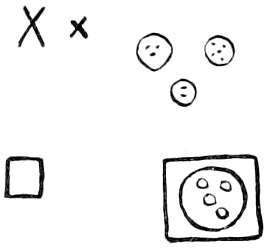
Fig. 1203.—Dwellings.
The right-hand upper characters of the same figure signify, among the Hidatsa, earth lodges. The circles represent the ground plan of the lodges, while the central markings are intended to represent the upright poles, which support the roof on the interior. Some of these are similar to the Kadiak drawing for island, Fig. 439.
The left-hand lower character of the figure represents buildings erected by civilized men; the character is generally used by the Hidatsa to designate government buildings and traders’ stores.
The remaining character is the Hidatsati, the home of the Hidatsa; an inclosure having earth lodges within it.
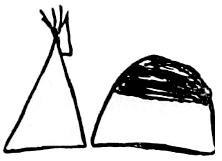
Fig. 1204.
Fig. 1204.—Dakotas and Rees meet in camp together and are at peace. The-Flame’s Winter Count, 1792-’93. The two styles of dwellings, viz, the tipi of the Dakotas and the earth lodge of the Arikaras, are depicted.
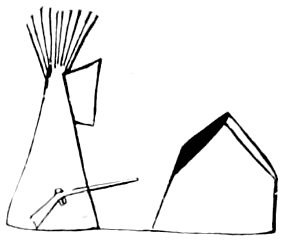
Fig. 1205.
Fig. 1205.—The Dakotas camped on the Missouri river, near the Gros Ventres, and fought with them a long time. Cloud-Shield’s Winter Count, 1792-’93. The Dakota tipi and the Gros Ventre lodge are shown in the figure. The gun shows that war was raging.
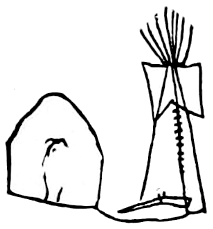
Fig. 1206.
Fig. 1206.—The Dakotas camped near the Rees and fought with them. Cloud-Shield’s Winter Count, 1795-’96. This figure is a variant of the one foregoing.
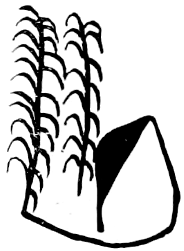
Fig. 1207.
Fig. 1207.—Some of the Dakotas built a large house and lived in it during the winter. Cloud-Shield’s Winter Count, 1815-’16. White-Cow-Killer calls it “Made-a-house-winter.” It would seem to be a larger dwelling than the ordinary tipi, and that wood entered into its construction. This is made more clear by the figure next following.
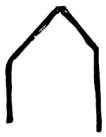
Fig. 1208.
Fig. 1208.—They lived in the same house that they did last winter. Cloud-Shield’s Winter Count, 1816-’17.
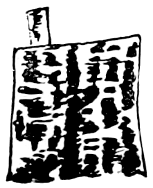
Fig. 1209.
Fig. 1209.—Adobe houses were built by Maj. J. W. Wham, Indian agent (afterwards paymaster, U. S. Army), on the Platte river, about 30 miles below Fort Laramie. Cloud-Shield’s Winter Count, 1871-’72. White-Cow-Killer calls it “Major-Wham’s-house-built-on-Platte-river winter.”
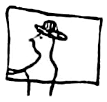
Fig. 1210.
Fig. 1210.—American-Horse’s Winter Count, 1815-’16. The figure is intended to represent a white man’s house. Other forms are shown in Lone-Dog’s Winter Count, Chap. X, sec. 2.
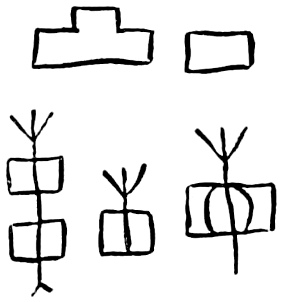
Fig. 1211.—Dwelling. Moki.
Fig. 1211 shows different representations of Moki houses copied from a petroglyph at Oakley Springs, Arizona.
Prof. Cyrus Thomas, in A Study of the Manuscript Troano, Contrib. N. A. Ethn., Vol. V, p. 128, gives the following description of Fig. 1212:
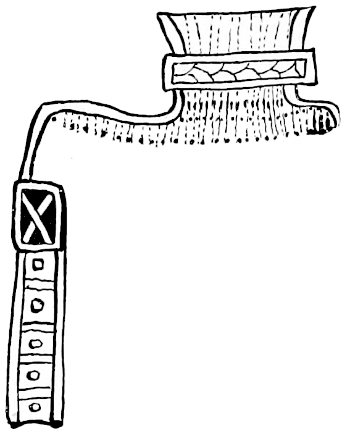
Fig. 1212.—Dwelling. Maya.
The side wall in Fig. 1212 appears to be composed of blocks of some kind placed one upon another, probably of stone, each bearing the Muluc character. The character at the top of the wall with a cross in it, somewhat resembling that in the symbol[722] for Ezanab, is very common in these figures. This probably marks the end of the beam which was placed on the wall to support the roof. The curved line running from this to the top portion probably represents the rafter; the slender thread-like lines (yellow in the original) the straw or grass with which the roof was thatched.
The checkered part may represent a matting of reeds or brushwood on which the straw was placed.
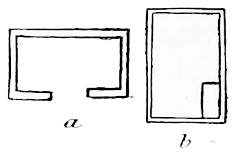
Fig. 1213.—House. Egyptian.
Champollion (h) gives the Egyptian characters for house, reproduced in Fig. 1213.
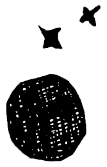
Fig. 1214.—Eclipse of the sun.
Fig. 1214.—Dakotas witnessed eclipse of the sun; they were terribly frightened. The sun is a dark globe and the stars appear. The-Swan’s Winter Count, 1869-’70.
The left-hand design on the lower line of Pl. XLIX is reproduced from Kingsborough. “In this year there was a great eclipse of the sun.”
Humboldt infers from this painting that the Mexicans were informed of the real cause of the eclipses; which would not be at all surprising considering the many other curious things with which they were acquainted, the knowledge of which they must have derived from the West. It is proper to observe that on the 127th page of the Vatican MS., where a representation of the same eclipse occurs, the disk of the moon does not appear to be projecting over that of the sun. The Vatican MS. appears to have been copied from a Mexican painting similar to but not the same as that which Pedro de los Rios copied, whose notes and interpretations the Italian interpreter had before his eyes and strictly followed.
This group shows the pictorial representation of meteors by the Dakotas. The translations as well as the devices are suggestive.

Fig. 1215.
Fig. 1215.—A large roaring star fell. It came from the east and shot out sparks of fire along its course. Cloud-Shield’s Winter Count, 1821-’22. Its track and the sparks are shown in the figure. White-Cow-Killer says “One-star-made-a-great-noise winter.”
This and the three following figures evidently refer to the fall of a single large meteor in the land of the Dakotas some time in the winter of 1821-’22. The fact can not be verified by scientific records.[723] There were not many correspondents of scientific institutions in the upper Missouri region at the date mentioned.

Fig. 1216.
Fig. 1216.—Large ball of fire with hissing noise (aerolite). The-Flame’s Winter Count, 1821-’22.
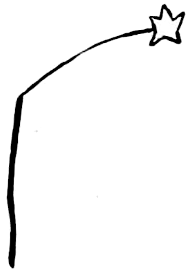
Fig. 1217.
Fig. 1217.—Dakota Indians saw an immense meteor passing from southeast to northwest, which exploded with great noise. The-Swan’s Winter Count, 1821-’22.
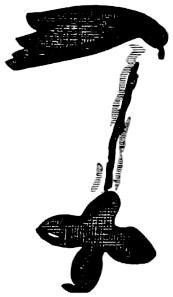
Fig. 1218.
Battiste Good says for the same phenomenon: “Star-passed-by-with-loud-noise winter.” His device is shown in Fig. 1218, showing the meteor, its pathway, and the clouds from which it came.
The five winter counts next cited all undoubtedly refer to the magnificent meteoric display of the morning of November 13, 1833, which was witnessed throughout North America and which was correctly assigned to the winter corresponding with that of 1833-’34. All of them represent stars having four points, except The-Swan, who draws a globular object followed by a linear track.
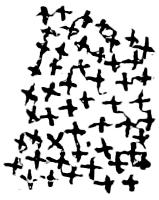
Fig. 1219.
Fig. 1219.—It rained stars. Cloud-Shield’s Winter Count, 1833-’34. White-Cow-Killer calls it “Plenty-stars winter.”
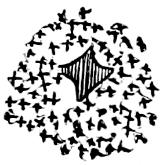
Fig. 1220.
Fig. 1220.—The stars moved around. American-Horse’s Winter Count, 1833-’34. This shows one large four-pointed star as the characterizing object and many small stars, also four-pointed.
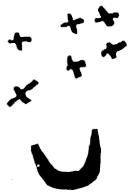
Fig. 1221.
Fig. 1221.—Many stars fell. The-Flame’s Winter Count, 1833-’34. The character shows six stars above the concavity of the moon.
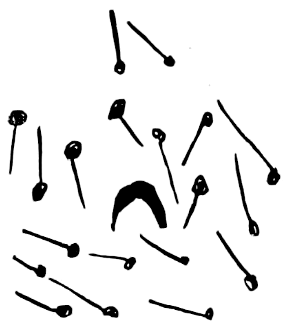
Fig. 1222.
Fig. 1222.—Dakotas witnessed magnificent meteoric showers; much terrified. The-Swan’s Winter Count, 1833-’34.
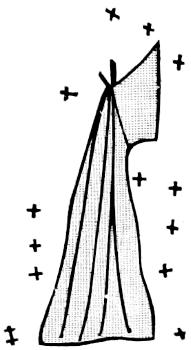
Fig. 1223.
Battiste Good calls it “Storm-of-stars winter,” and gives as the device a tipi with stars falling around it. This is presented in Fig. 1223. The tipi is colored yellow in the original and so represented in the figure according to the heraldic scheme.
Fig. 1224 is taken from Kingsborough, I, Pls. XXIX and XXX. The description, given in Codex Tell.-Rem., VI, p. 148, et seq., is as follows: Regarding the left-hand[724] device figure, “In the year of Three Rabbits, or in 1534, Don Antonio de Mendoça arrived as Viceroy of New Spain. They say that the star smoked.”
Regarding the lower figure: “In the year of Eleven Houses, or in 1529, Nuño de Guzman set out for Yalisco on his march to subdue that territory; they pretend that a serpent descended from the sky, exclaiming that troubles were preparing for the natives since the Christians were directing their course thither.”
Referring to the numerous forms of cross delineated in the work of Mr. W. H. Holmes (d), it is to be noted that most of them are equilateral or the Greek pattern, and that similar ornaments or instruments now used by the Dakotas are always worn so that the cross upon them stands as if resting on one foot only and not on two, as is the mode in which St. Andrew’s cross is drawn.
The “Greek” cross represents to the Dakota the four winds, which issue from the four caverns in which the souls of men existed before their incarnation in the human body. All “medicine-men,” i. e., conjurers and magicians, recollect their previous dreamy life in those places and the instructions then received from the gods, demons, and sages. They recollect and describe their preexistent life, but only dream and speculate as to the future life beyond the grave.
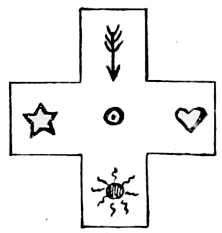
Fig. 1225.—Cross. Dakota.
The top of the cross is the cold all-conquering giant, the North-wind, most powerful of all. It is worn on the body nearest the head, the seat of intelligence and conquering devices. The left arm covers the heart; it is the East-wind, coming from the seat of life and love. The foot is the melting burning South-wind, indicating, as it is worn, the seat of fiery passion. The right arm is the gentle West-wind, blowing from the spirit land, covering the lungs, from which the breath at last goes[725] out, gently, but into unknown night. The center of the cross is the earth and man, moved by the conflicting influences of the gods and winds. This cross is often illustrated as in Fig. 1225. It is sometimes drawn and depicted in beadwork and also on copper, as in Fig. 1226, extracted from the Second Ann. Rep. Bur. Ethn., Pl. LII, Fig. 4, where it appears cut out of a copper plate found in an Ohio mound.
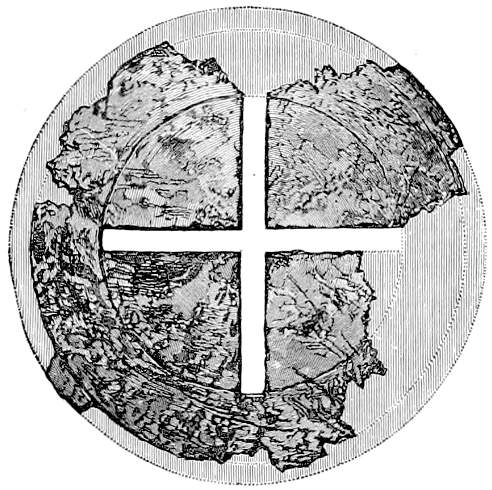
Fig. 1226.—Cross. Ohio mound.
But among some of the Indian tribes the true Latin cross is found, viz, upright with three members of equal length, and the fourth, the foot, much longer. The use of this symbol antedates the discovery of America, and is carried far back in tradition and myth. When a missionary first asked a Dakota the name of this figure, which he drew for him in the sand, wishing to use the information in his translation of Bible and Creed, the Dakota promptly replied Sus-be-ca, and retraced the figure saying “That is a Sus-be-ca.” It was therefore promptly transferred to Scripture and Creed where it still reads “He was nailed to the Susbeca,” etc. “God forbid that I should glory save in the Susbeca of our Lord Jesus Christ.” To the good missionary this was plain and satisfactory; for the Dakota had demonstrated by tracing it in the sand that Susbeca was the name of the figure called in English, “cross.” The foregoing statement is made on the excellent authority of Rev. S. D. Hinman.
But when the Dakota read his new Bible or Creed, he must have been puzzled or confused to find, “He was nailed to a mosquito-hawk,” or, “God forbid that I should glory save in the mosquito-hawk of our Lord Jesus Christ.”
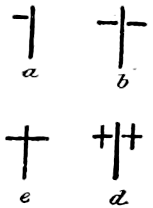
Fig. 1227.—Dragon fly.
The same disposition of straight lines which is called the Latin cross was and is used by the Dakota to picture or signify both in pictograph and gesture sign, the mosquito-hawk, more generally called dragon fly. The Susbeca or mosquito-hawk is a supernatural being. He is gifted with speech. He warns men of danger. He approaches the ear of the man moving carelessly or unconcernedly through the deep grass of the meadow or marsh—approaches his ear silently and at right angles, as shown in Fig. 1227a, and says to him, now alarmed, “Tci”-“tci”-“tci!”—which is an interjection[726] equivalent to “Look out!” “You are surely going to destruction!” “Look out!” “Tci”-“tci”-“tci!”
Now the mosquito-hawk is easily knocked down and caught and has a temptingly small neck. But woe to the man or woman or child who with the cruelty commonly practiced on all living things by Indians of all ages and states, dares to wring off his head. Whoever shall do this before the winter comes shall be beheaded by the detested Ojibwa. It is true, for long ago a reckless young warrior feeling annoyed or insulted by the infernal “Tci”-“tci”-“tci!” so unceremoniously uttered in explosive breaths near his ear, tried it, and his headless trunk was found ere he escaped from the swamp.
The cross has its proper significance in this use not only in representing quite faithfully the shape of the insect but also the angle of his approach. It is variously drawn, but usually as in Fig. 1227, a, or b, and in painting or embroidery, c, and sometimes d.
One reason for the adoption of the dragon fly as a mysterious and supernatural being, is on account of its sudden appearance in large numbers. When in the still of the evening, before the shades of darkness come, there is heard from the meadow a hum as of the sound of crickets or frogs, but indistinct and prolonged; on the morrow the Susbeca will be hovering over it; it is the sound of their coming, but whence no man kens. See also Fig. 1165 and remarks.
Among the Ojibwa of northern Minnesota the cross is one of the sacred symbols of the society of the Midē or shamans, and has special reference to the fourth degree. A neophyte who has been advanced to the third initiation or degree, is instructed in ritualistic chants purporting to relate the struggle between Mi'nabō'zho, the mediator between the Ojibwa and Ki'tshi Ma'nidō, and the malevolent Bear spirit, which contest occurred when Mi'nabō'zho entered the fourth degree structure at the time when the first Indian was inducted therein for initiation.
The structure as erected at this day is built in the form of an oblong square having openings or doors at the four cardinal points. At these openings Mi'nabō'zho appeared and shot into the inclosure charmed arrows, to expel the horde of demons occupying the sacred place, and the Bear spirit was the last to yield to his superior powers. The openings being opposite to one another, north and south and east and west, suggested to Mi'nabō'zho the cross, which is now erected whenever a third degree Midē receives this last and highest honor.
The cross is made of saplings, the upright pole reaching the height of 4 to 6 feet, the transverse arms being somewhat shorter, each being of the same length as that part of the pole between the arms and the top. The upper parts are painted white, or besmeared with white clay, over which are spread small spots of red, the latter suggesting the sacred shell or mēgis, the symbol of the order. The lower arm or pole is squared, the surface toward the east being painted white, to denote[727] the source of light and warmth. The face on the south is green, denoting the source of the thunder bird who brings the rains and causes the appearance of vegetation; the surface toward the west is covered with vermilion and relates to the land of the setting sun, the abode of the dead. The north is painted black, as that faces the direction from which come affliction, cold, and hunger.
Illustrations and additional details on this topic are presented in the paper of Dr. Hoffman (a).
In the chart presented in that paper, Pl. B, a midē' structure is also shown, within which are a number of crosses, each of which designates the spirit of a deceased midē priest.
Upon several birch-bark scrolls received from Ojibwa midē priests are characters resembling rude crosses, which are merely intended to designate wigwams, resembling in this respect similar characters made by Hidatsa to designate Sioux lodges as shown in Fig. 1203.
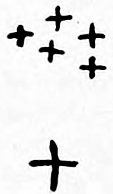
Fig. 1228.—Crosses. Eskimo.
Groups of small crosses incised upon ivory bow drills and representing flocks of birds, occur on Eskimo specimens, Nos. 45020 and 44211, in the collection of the U. S. National Museum. They are reproduced in Fig. 1228. In Figs. 429 and 1129, representing petroglyphs at Oakley Springs, Arizona, are crosses which are mentioned by Mr. G. K. Gilbert as signifying stars. The simple cross appears to be the simplest type of character to represent stellar forms. See Figs. 1219, 1220, 1221 and 1223.
Fig. 28, supra, represents a cross copied from the Najowe Valley group of colored pictographs, 40 miles west of Santa Barbara, California. The cross measures 10 inches in length, the interior portion being painted black, while the outside or border is of a dark red tint. This drawing, as well as numerous others in close connection, is painted on the walls of a shallow cave or rock-shelter in the limestone formation.
Fourteen miles west of Santa Barbara, on the summit of the Santa Ynez mountains, are caverns having a large opening, facing the northwest and north, in which crosses occur of the types given in Fig. 33, supra.
The interior portion of the cross is of a dull, earthy red, while the outside line is of a faded black tint. The cross measures nearly a foot in extent.
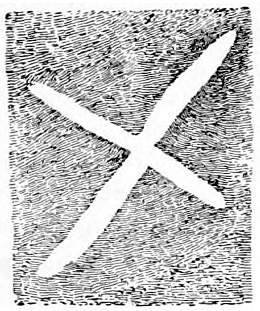
Fig. 1229.—Cross. Tulare valley, California.
At Tulare Indian agency, Tulare valley, California, is an immense bowlder of granite which has become broken in such a manner that one of the lower quarters has moved away from the larger mass sufficiently to leave a passageway 6 feet wide and nearly 10 feet high. The interior walls are well covered with large,[728] painted figures, while upon the ceiling are numerous forms of animals, birds, and insects. Among this latter group is a white cross measuring about 18 inches in length, Fig. 1229, presenting a unique appearance, for the reason that white coloring matter applied to petroglyphs is, with this single exception, entirely absent in that region.
One of the most interesting series of rock sculpturings in groups is that in Owens valley, south of Benton, California. Among these various forms of crosses occur, and circles containing crosses of various simple and complex types, as shown in Pls. I to XI and in Mojave desert, California, illustrated in Fig. 19, but the examples of most interest in the present connection are the two shown herewith in Fig. 1230, a and b.
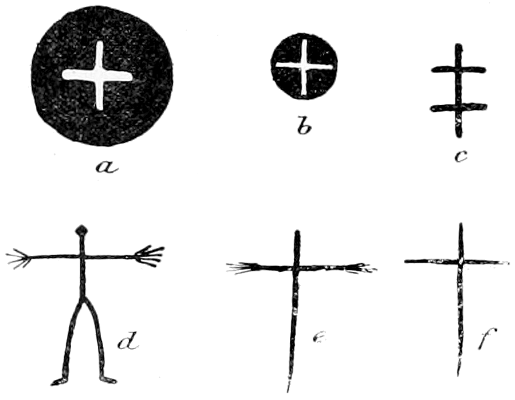
Fig. 1230.—Crosses. Owens valley, California
The larger one, a, occurs upon a large bowlder of trachyte, blackened by exposure, located 16 miles south of Benton, at a locality known as the Chalk Grade. The circle is a depression about 1 inch in depth, the cross being in high relief within. Another smaller cross, b, found 3 miles north of the one above-mentioned, is almost identical, each of the arms of the cross, however, extending to the rim of the circle.
In this locality occurs also the form of the cross c, in the same figure, and some examples having more than two cross arms. Other simple forms clearly represent the human form, but by erosion the arms and body have become partially obliterated so as to lose all trace of resemblance to humanity.
In the same figure, d, from a rock in the neighborhood, exhibits the outline of the human form, while in e parts of the extremities have been removed by erosion so that the resemblance is less striking; in f a simple cross occurs, which may also have been intended to represent the same, but through disintegration the extremities have been so greatly changed or erased that their original forms can not be determined.
Rev. John McLean (a) says: “On the sacred pole of the sun lodge of the Blood Indians two bundles of small brushwood taken from the birch tree were placed in the form of a cross. This was an ancient symbol evidently referring to the four winds.”
Among the Kiatéxamut, an Innuit tribe, a cross placed on the head, as in Fig. 1231, signifies a Shaman’s evil spirit or demon. This is an[729] imaginary being under control of the Shaman to execute the wishes of the latter.

Fig. 1231.—Cross. Innuit.
Many of the mescal eaters at the Kaiowa mescal ceremony wear the ordinary Roman Catholic crucifixes, which they adopt as sacred emblems of the rite, the cross representing the cross of scented leaves upon which the consecrated mescal rests during the ceremony, while the human figure is the mescal goddess.
Concerning Fig. 1232, Keam, in his MS., says:
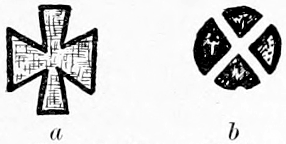
Fig. 1232.—Crosses. Moki.
The Maltese cross is the emblem of a virgin; still so recognized by the Moki. It is a conventional development of a more common emblem of maidenhood, the form in which the maidens wear their hair arranged as a disk of 3 or 4 inches in diameter upon each side of the head. This discoidal arrangement of their hair is typical of the emblem of fructification worn by the virgin in the Muingwa festival, as exhibited in the head-dress illustration a. Sometimes the hair, instead of being worn in the complete discoid form, is dressed from two curving twigs and presents the form of two semicircles upon each side of the head. The partition of these is sometimes horizontal and sometimes vertical. A combination of both of these styles, b, presents the form from which the Maltese cross was conventionalized. The brim decorations are of ornamental locks of hair which a maiden trains to grow upon the sides of the forehead.
The ceremonial employment of the cross by the Pueblo is detailed in Mr. Stevenson’s paper entitled Ceremonial of Hasjelti Dailjis and Mythical Sand-painting of the Navajo Indians, in the Eighth Ann. Rept. Bur. Ethn., p. 266, where it denotes the scalp-lock.
In the present paper the figure of the cross among the North American Indians is presented under other headings with many differing significations. Among other instances it appears on p. 383 as the tribal sign for Cheyenne; on p. 582 as Dakota lodges; on p. 613 as the character for trade or exchange; on p. 227 as the conventional sign for prisoner; on p. 438 for personal exploits; while elsewhere it is used in simple numeration.
But, although this device is used with a great variety of meanings, when it is employed ceremonially or in elaborate pictographs by the Indians both of North and South America, it represents the four winds. The view long ago suggested that such was the significance of the many Mexican crosses, is sustained by Prof. Cyrus Thomas, in his Notes on Maya and Mexican MSS., Second Ann. Rep. Bur. Ethn., p. 61, where strong confirmatory evidence is produced by the arms of the crosses having the appearance of conventionalized wings, similar to some representations of the thunder-bird by more northern tribes. Yet the same author, in his paper on the Study of the MS. Troano, Contrib. N. A. Ethn., V, 144, gives Fig. 1233 as the symbol for wood, thus further showing the manifold concepts attached to the general form.

Fig. 1233.—Crosses. Maya.
Bandelier (a) thinks that the crosses which were frequently used before the conquest by the aborigines of Mexico and Central America were merely ornaments and were not objects of worship, while the so-called crucifixes, like that on the “Palenque tablet,” were only the symbol of the “new fire” or close of a period of fifty-two years. He believes them to be merely representations of “fire-drills,” more or less ornamented.
Mr. W. H. Holmes (e) shows by a series representing steps in the simplification of animal characters that in Chiriqui a symmetrical cross was developed from the design of an alligator.
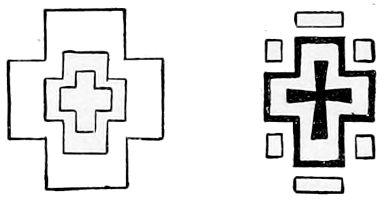
Fig. 1234.—Crosses. Nicaragua.
Carl Bovallius (a) gives an illustration, copied here as Fig. 1234, of pictographs in the island of Ceiba, Nicaragua.
Zamacois (a) says that “the cross figured in the religion of various tribes of the peninsula of Yucatan and that it represented the god of rain.”
Dr. S. Habel (f), describing Fig. 1235, says:
On it is a person in a reclining position, with a single band tied around his forehead, forming a knot with two pendent tassels. From his temple rises an ornament resembling the wing of a bird. The emaciated face, as well as the recumbent position of the body, indicates a state of sickness. The hair is interwoven behind with many ribbons forming loops, which are bound together by a clasp, and then spread out in the shape of a fan. The ear is ornamented with a circular disk, to the center of which are attached a plume and a twisted ornament similar to a queue. On the breast is a kind of brooch, which is hollow like a shell, and in which are imbedded seven pearls. Around the waist are three rows of a twisted fabric, which is knotted in front in a bow, the ends descending between the thighs. Another band, of a different texture, stretches out horizontally from the region of the above-mentioned knot. Attached to this girdle is another fabric, of a scaly texture, which surrounds the thighs. The right leg, below the knee, is encircled with a ribbon and a rosette.[731] This would seem to be the undress substitute for the band and pendant. In front of the recumbent person stands the representation of a skeleton, quite well executed. Other points noticeable about this skeleton are the hair on the head and the fact that its hands are fleshy and the fingers and toes have nails. Like all representations by these sculptures, the skeleton is also embellished with ornaments.
From the back of the head emanate two objects similar to horns, which, if they were not differently ribbed, might represent flames. The ear is ornamented with a circular disk, with a pendant from its center. A double-ruffled collar surrounds the neck and a serpent encircles the loins. Both the shoulders and arms are enveloped in flames. From the mouth emanates a bent staff, touching the first of a row of ten circles. Beneath the second and third circles are five bars, three of which are horizontal. The lowest one is the longest, while the two upper ones are shorter and of different lengths. On the uppermost of these bars rest two others, crossing each other obliquely, and touching with their upper ends two of the aforesaid circles. From the last of these circles descend serpentine lines, which touch the ground behind the recumbent person.
Gustav Eisen, op. cit., describing Fig. 1236, says:
From near Santa Lucia, Guatemala, is a stone tablet, most likely a sepulchral tablet, having in its center a forced dead head, with outstretched tongue. Above the same are seen two crossed bars, perhaps meant to represent two crossed bones.
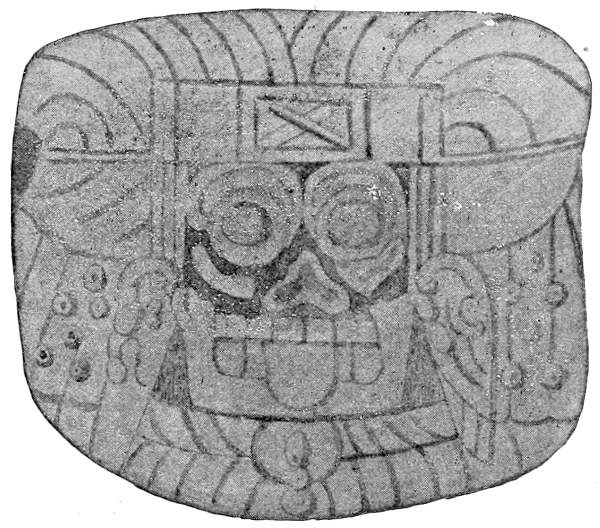
Fig. 1236.—Cross. Guatemala.
W. F. Wakeman (a) makes the following remarks:
A cross was used by the people of Erin as a symbol of some significance at a period long antecedent to the mission of St. Patrick or the introduction of Christianity to this island. It is found, not unfrequently, amongst the scribings picked or carved upon rock surfaces and associated with a class of archaic designs, to the meaning of which we possess no key. * * * It may be seen on prehistoric monuments in America, on objects of pottery found by Dr. Schliemann at Hissarlik and at Mycenæ, and, in more than one form, on pagan Roman altars still preserved in Germany and[732] Britain. With the Chinese it was for untold ages a symbol of the earth. The Rev. Samuel Beal, B. A., rector of Flastone, North Tyrone, professor of Chinese in University College, London, writes: “Now, the earliest symbol of the earth was a plain cross, denoting the four cardinal points; hence we have the word chaturanta, i. e., the four sides, both in Pâli and Sanscrit, for the earth; and on the Nestorian tablet, found at Siganfu some years ago, the mode of saying “God created the earth” is simply this: “God created the +.””
A writer in the Edinburgh Review in an article entitled “The Pre-Christian Cross,” January, 1870, p. 254, remarks: “The Buddhists and Brahmins who together constitute nearly half the population of the world, tell us that the decussated figure of the cross, whether in a simple or complex form, symbolizes the traditional happy abode of their primeval ancestors.”
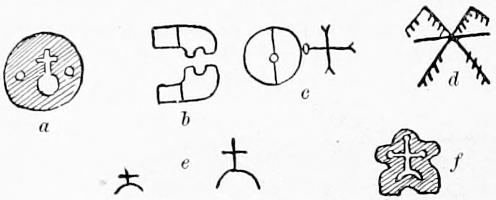
Fig. 1237.—Crosses. Sword-maker’s marks.
Rudolf Cronau (c), describing Fig. 1237, says that in the Berlin Zeughause are swords of the fifteenth and sixteenth centuries, bearing the marks shown in a, b, c, and d, while those having the marks e and f are from swords in the Historical Museum at Dresden.
The remarkable resemblance of some of these characters to forms on petroglyphs in the three Americas, presented in this paper, will at once be noticed.
D’Alviella (c), remarks:
One of the most frequent forms of the cross is called the gamma cross, because its four arms are bent at a right angle so as to form a figure like that of four Greek gammas turned in the same direction and joined at the base. We meet it among all the peoples of the Old World, from Japan to Iceland, and it is found in the two Americas. There is nothing to prevent us from supposing that in the instance it was spontaneously conceived everywhere, like the equilateral crosses, circles, triangles, chevrons, and other geometrical ornaments so frequent in primitive decoration. But we see it, at least among the peoples of the Old Continent, invariably passing for talisman, appearing in the funeral scenes or on the tombstones of Greece, Scandinavia, Numidia, and Thibet, and adorning the breasts of divine personages—of Apollo and Buddha—without forgetting certain representations of the Good Shepherd in the Catacombs.
It is, however, impossible within the present limits, to attempt even a summary of the vast amount of literature on this topic. Perhaps one symbolic use of the form which is not commonly known is of sufficient interest to be noted. Travelers say that crosses are exhibited in the curtains of the monasteries of the Thibetan Buddhists, to mean peace and quietness. With the same conception the loopholes of the Japanese forts were in time of peace covered with curtains embroidered with crosses, which when war broke out were removed.
It is also impossible to refrain from quoting the following, translated with condensation, from de Mortillet (a). The illustration referred to is reproduced in the present paper by Fig. 1238, the right-hand figure[733] being from the vase, and that on the left the recognized monogram of Christ:
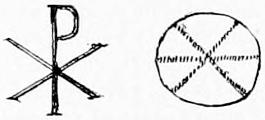
Fig. 1238.—Cross. Golasecca.
There can no longer be any doubt as to the use of the cross as a religious symbol long before the advent of Christianity. The worship of the cross, extensive throughout Gaul before the conquest, already existed during the bronze age, more than a thousand years before Christ.
It is especially in the sepulchres of Golasecca that this worship is revealed in the most complete manner, and there, strange to say, has been found a vessel bearing the ancient monogram of Christ, designed perhaps 1,000 years before the coming of Jesus Christ. Is the isolated presence of this monogram of Christ in the midst of numerous crosses, an entirely accidental coincidence?
Another curious fact, very interesting to prove, is that this great development of the worship of the cross before the coming of Christ seems to coincide with the absence of idols and indeed of any representation of living objects. Whenever such objects appear, it may be said that the crosses become more rare and finally disappear altogether. The cross has then been, in remote antiquity, long before Christ, the sacred emblem of a religious sect which repudiated idolatry.
The author, with considerable naiveté, has evidently determined that the form of the cross was significant of a high state of religious culture, and that its being succeeded by effigies, which he calls idols, showed a lapse into idolatry. The fact is simply that, next after one straight line, the combination of two straight lines forming a cross is the easiest figure to draw, and its use before art could attain to the drawing of animal forms, or their representation in plastic material, is merely an evidence of crudeness or imperfection in designing. It is worthy of remark that Dr. Schliemann, in his “Troja,” page 107, presents as his Fig. 38 a much more distinct cross than that given by M. de Mortillet, with the simple remark that it is “a geometrical ornamentation.”
Probably no cause has more frequently produced archeologic and ethnologic blunders than the determination of Christian explorers and missionaries to find monograms of Christ in every monument or inscription where the cross figure appears. The early missionaries to America were obliged to explain the presence of this figure there by a miraculous visit of an apostle, St. Thomas being their favorite. Other generations of the same good people were worried in the same manner by the cross pattée or Thor hammer of the Scandinavians, and by the conventionalized clover leaf of the Druids. This figure often has been a symbol and as often an emblem or a mere sign, but it is so common in every variety of application that actual evidence is necessary to show in any special case what is its real significance.
Gen. G. P. Thruston (a) gives the following account of Pl. LI, which suggests several points of comparison with figures under other headings in this paper:
There has been discovered in Sumner county, Tennessee, near the stone graves and mounds of Castalian springs, a valuable pictograph, the ancient engraved stone which we have taken the liberty to entitle a Group of Tennessee Mound Builders.
This engraved stone, the property of the Tennessee Historical Society, is a flat, irregular slab of hard limestone, about 19 inches long and 15 inches wide. It bears every evidence of very great age. * * * The stone was found on Rocky creek, in Sumner county, and was presented, with other relics, to the Tennessee Historical Society about twelve years ago. * * *
It is evidently an ideograph of significance, graven with a steady and skillful hand, for a specific purpose, and probably records or commemorates some important treaty or public or tribal event. * * * Indian chiefs fully equipped with the insignia of office, are arrayed in fine apparel. Two leading characters are vigorously shaking hands in a confirmatory way. The banner or shield, ornamented with the double serpent emblem and other symbols, is, doubtless, an important feature of the occasion. Among the historic Indians, no treaty was made without the presence or presentation of the belt of wampum. This, the well-dressed female of the group appears to grasp in her hand, perhaps as a pledge of the contract. The dressing of the hair, the remarkable scalloped skirts, the implements used, the waistbands, the wristlets, the garters, the Indian leggings and moccasins, the necklace and breastplates, the two banners, the serpent emblem, the tattoo stripes, the ancient pipe, all invest this pictograph with unusual interest. * * * The double serpent emblem or ornament upon the banner may have been the badge or totem of the tribe, clan, or family that occupied the extensive earthworks at Castalian springs in Sumner county, near where the stone was found. The serpent was a favorite emblem or totem of the Stone Grave race of Tennessee, and is one of the common devices engraved on the shell gorgets taken from the ancient cemeteries. * * * The circles or sun symbol ornaments on the banners and dresses are the figures most frequently graven on the shell gorgets found near Nashville.
The following summary of the translation, kindly furnished by Mr. Pom K. Soh of an article, “Pictures of Dokatu or so-called bronze bell,” by Mr. K. Wakabayashi (a), in the Bulletin of the Tōkyō Anthropological Society, refers to Pl. LII. The author saw the bell described at the town of Takoka, Japan, in August, 1891. The “pictures” on it were fourteen in number, cast in the metal of the bell, each one occupying a separate compartment and running around the bell in several bands. The author took rubbings of the pictures, lithographs of which are published as illustrations of his article, and from these the eight pictures now presented in actual size are selected, the remainder being of the same general character, and some of them nearly identical with those selected. The information obtained is that the bell, which is iron and not bronze, was procured before, and perhaps long before, the present century from Jisei, in the village of Sasakura in the state of Yetsin, and had been excavated from a mountain at Samki. Copies of the markings upon it were taken in 1817 to a high authority at Yedo, now Tōkyō. It is believed that the markings illustrate or are related to a national story, “Kanden Ko Hitsu,” written by Ban Kokei. A few similar bells or fragments of them, some being bronze, have been found in various parts of the Japanese empire. One, which is bronze, height about 3½ feet, and diameter somewhat more than 1 foot, was dug up in Hanina in the year A. D. 821.
The interest of the drawings on Pl. LII, in the present connection, consists in their remarkable similarity, both in form and apparent motive, with several of those found in the western continent and figured[735] in the present work. Thus, a is to be compared with characters on Figs. 437 and 1227 and others referring to the human form, the cross, and the dragon-fly; b with Figs. 57, 165 b and 1261 l; the two characters in c, respectively, with Fig. 1262; the mantis, and Fig. 1129, one form of star; d with a common turtle form, as in Fig. 50; e with Fig. 166, an Ojibwa human form, and also exhibiting gesture, and Fig. 113 a Brazilian petroglyph; and f with Fig. 657, a north-eastern Algonquian drawing. The three last-mentioned pictures, e and f and g, exhibit the peculiar internal life organ (often the conventionalized heart), noticed in Figs. 50, 700, and 701, and it is to be remarked that the largest quadruped in g has the life organ connected with the mouth, while the other quadrupeds, and those in h, show no depiction of internal organs. The human figure in g is noticeable for the American form of bow, and the upper character of h is to be compared with Figs. 104 and 148.
The figures in this group are selected from a larger number in which the union of two animals of different kinds or that of an animal and another object indicates the union of the several qualities or attributes supposed to belong to those animals or objects. The form and use of such composite figures are familiar from the publication of the inscriptions on Egyptian monuments and papyri.
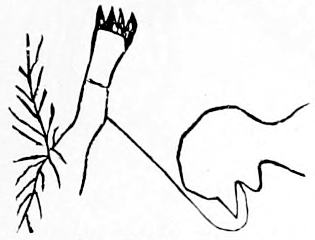
Fig. 1239.
Fig. 1239.—Eagle-Elk. Red-Cloud’s Census. Here are the branching antlers of the elk and the tail of the eagle.
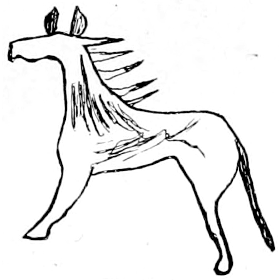
Fig. 1240.
Fig. 1240.—Eagle-Horse. Red-Cloud’s Census. Eagle feathers replace the horse’s mane.
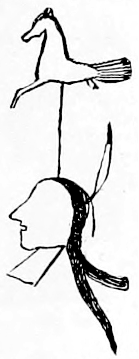
Fig. 1241.
Fig. 1241.—Eagle-Horse. Red-Cloud’s Census. This is a variant of the preceding, the change being shown in the tail.
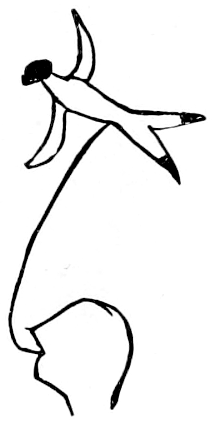
Fig. 1242.
Fig. 1242.—Eagle-Swallow. Red-Cloud’s Census. The characteristics of the two birds are obvious.
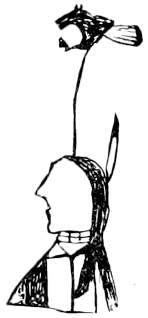
Fig. 1243.
Fig. 1243.—Eagle-Bear. Red-Cloud’s Census.
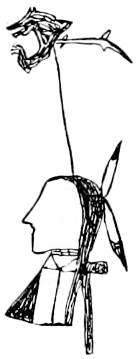
Fig. 1244.
Fig. 1244.—Weasel-Bear. Red-Cloud’s Census. With only hasty view the really characteristic form of the weasel might be mistaken for a rudely drawn gun.
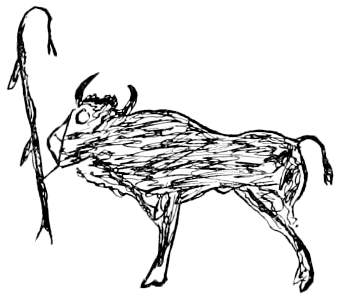
Fig. 1246.
Fig. 1246.—Bull-Lance. Red-Cloud’s Census. The object attached to the bull’s muzzle is the common ornamented lance of the Plains tribes.
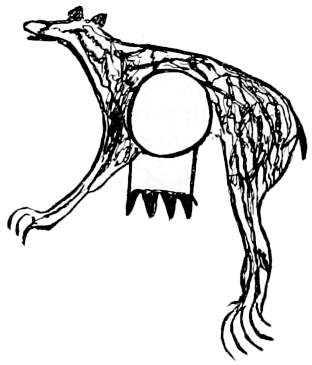
Fig. 1247.
Fig. 1247.—Shield-Bear. Red-Cloud’s Census. The ornamented shield is borne on the bear’s body.
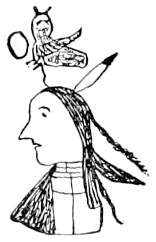
Fig. 1248.
Fig. 1248.—Ring-Owl. Red-Cloud’s Census.
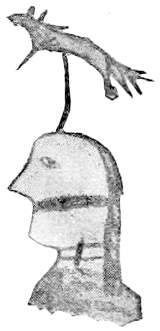
Fig. 1249.
Fig. 1249.—Sunka-wanbli, Dog-Eagle; from the Oglala Roster. The[737] mingling of the attributes of the dog and the eagle with special reference to swiftness may be suggested.
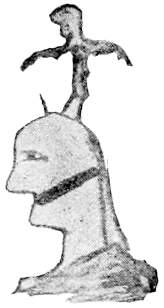
Fig. 1250.
Fig. 1250.—Zintkala-wicasa, Bird-Man; also from the Oglala Roster. An indication of a bird gens is suggested without information, but perhaps it is only a representation of the usual vision required from and therefore obtained by boys before reaching manhood.
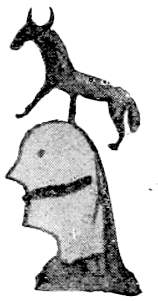
Fig. 1251.
Fig. 1251.—Sunkakan-heton, Horse-with-horns; also from the Oglala Roster. Perhaps this is not intended as a composite animal, but as a horse possessing special and mystic power, as is indicated by the gesture sign for wakan, and, as elsewhere in pictographs, by lines extending from each side of the head. The same sub-chief appears in Red-Cloud’s Census with the name translated into English as Horned-Horse.
This union of the human figure with that of other animals is of interest in comparison with the well-known forms of similar character in the art of Egypt and Assyria.
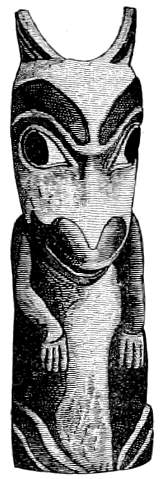
Fig. 1252.—Wolf-man. Haida.
The feet of the accompanying Fig. 1252, reproduced from Bastian (b) on the Northwest Coast of America, can not be seen, being hidden in the head of the figure beneath. It is squatting, with its hands on its knees, and has a wolf’s head. Arms, legs, mouth, jaws, nostrils, and ear-holes are scarlet; eyebrows, irises, and edges of the ears black.

Fig. 1253.—Panther-man. Haida.
The drawing Fig. 1253 was made by Mr. J. G. Swan while on a visit to the Prince of Wales archipelago, where he found two carved figures with panthers’ heads, and claws upon the fore feet, and human feet attached to the hind legs. These mythical animals were placed upon either side of a corpse which was lying in state, awaiting burial.
The Egyptians represented the evil Typhon by the hippopotamus, the most fierce and savage of their animals; the hawk was the symbol for power, and the serpent that for life. Plutarch, in Isis and Osiris, 50, says that in Hermopolis these symbols were united, a hawk fighting with a serpent being placed on the hippopotamus, thus accentuating the idea of the destroyer. The Greeks sometimes substituted the eagle for the hawk, and pictured it killing a hare, the most prolific of quadrupeds, or fighting a serpent, the same attribute of destruction[738] being portrayed. But the eagle when alone meant simply power, as did the hawk in Egypt. The Scandinavians posited the eagle on the head of their god Thor and the bull on his breast to express a similar union of attributes.
Dr. Andree (d), in Das Zeichnen bei den Naturvölkern, makes the following remarks, translated with condensation:
The great ability of the Eskimo and their southern neighbors, the natives of northwest America (Koliushes, Thlinkits, etc.), in representative art is well known and needs no further insisting. Among all primitive peoples they have made the greatest advances in the conventionalization of figures, which indicates long practice in painting. The totem figures, carved both in stone and in wood and tattooed on the body, show severe conventionalization and have perfect heraldic value. Ismailof, one of the earliest Russian explorers that came in contact with the Koliushes, relates that European paintings and drawings did not strike them with the least awe. When a chief was shown portraits of the Russian imperial family he manifested no astonishment. That chief was accompanied by his painter, who examined everything very closely, in order to paint it afterward. He was able in particular “to paint all manner of objects on wooden tablets and other material (leather),” using blue iron earth, iron ocher, colored clays, and other mineral colors. Among these peoples, too, painting is employed as a substitute for writing, in order to record memorable things.
Far below the artistic achievements of the Eskimo and of the natives of the American northwest (Haida, Thlinkit, etc.) are those of the redskins east of the Rocky mountains. They are, however, very productive in figure drawing; nay, that art has advanced to a kind of picture writing, which, it is true, is not distinguished by artistic finish. That “fling” which, depending on good observation of nature, appears in the drawings of Australians, Bushmen, etc., and the good characterization of the figures, are lacking among the Indians; and though, as is frequently the case, their animals are better represented than the men, yet they can not compare with the animal figures of the Eskimo or Bushmen. Dr. Capitan, who had drawings made by the Omahas shown in 1883 in the Jardin d’acclimatation of Paris, says concerning them: “It is singular to note that by the side of very rudimentary representations of human figures the pictures of horses are drawn with a certain degree of correctness. If the Indians take pains in anything it is in the painting of their buffalo skins, which are often worn as mantles. On red-brown ground are seen black figures, especially of animals; on others, on white ground, the heroic deeds and life events of distinguished Indians, represented in black or in other colors. You see the wounded enemies, the loss of blood, the killed and the captives, stolen horses, all executed in the peculiar manner of an art of painting still in the stage of infancy, with earth colors black, red, green, and yellow. Almost all the Missouri tribes practice painting on buffalo skins; the most skillful are the Pawnees, Mandans, Minitaris, and Crows. Among the Mandans, Wied met individuals who possessed “a very decided talent” for drawing.”
The same author, in the same connection, reasserts the old statement that there is an established difference in artistic capacity between the so-called mound-builders and the present Indians, so great that it either shows a genetic difference between them or that the Indians had degenerated in that respect. This statement is denied by the Bureau[739] of Ethnology, but the point to be now considered is whether it is true that the historic North American Indians are as low in artistic skill as is alleged.
The French traveler Crevaux, as quoted by Marcano (g), says that he had the happy idea of giving pencils to the Indians, in order to see whether they were capable of producing the same drawings. The young Yumi rapidly drew for him sketches of man, dog, tiger; in brief, of all the animals of the country. Another Indian reproduced all sorts of arabesques, which he was wont to paint with genipa. Crevaux saw that these savages, who are accused of being absolutely ignorant of the fine arts, all drew with extraordinary facility.
The same idea, i. e., of testing the artistic ability of Indians in several tribes, occurred to the present writer and to many other travelers, who generally have been surprised at the skill in free-hand drawing and painting exhibited. It would seem that the Indians had about the same faults and decidedly more talent than the average uninstructed persons of European descent who make similar attempts. An instance of special skill in portrait painting is given by Lossing (a), where a northern tribe in 1812 made a bark picture of Joseph Barron, a fugitive, to obtain his identification by sending copies of it to various tribes. The portrait given as an illustration in the work cited is very distinct and lifelike. This, however, was a special task prompted by foreign influence. While the Indians had no more knowledge of perspective than the Japanese, they were unable or indisposed to attempt the accurate imitation of separate natural objects in which the Japanese excel. Before European instruction or example they probably never produced a true picture. Some illustrations in the present work, which show a continuous series of men, animals, and other objects, are no more pictures than are the consecutive words of a printed sentence, both forms, indeed, being alike in the fact that their significance is expressed by the relation between the separate parts. The illustration which at a first glance seems to be most distinctively picturesque[740] is Fig. 659, but it will be noticed that the personages are repeated, the scene changed, and the time proceeds, so that there is no view of specified objects at any one time and place.
Fig. 1254 shows two drawings from Kejimkoojik, N. S., reduced to one-fourth, each supposed to represent a moose, though possibly one of them is a caribou, and the mode of execution vividly suggests some of the examples of prehistoric art found in Europe and familiar by repeatedly published illustrations.
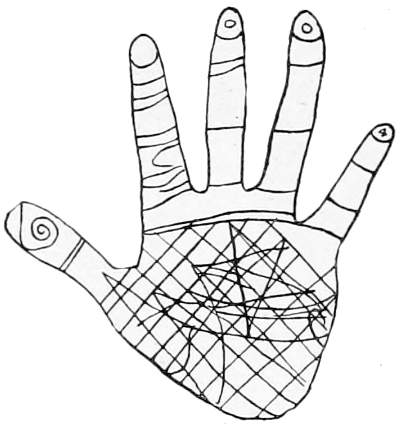
Fig. 1255.—Hand, Kejimkoojik.
Fig. 1255 is the etching of a hand from the Kejimkoojik rocks, reduced one-half. Its peculiarity consists in the details by which the lines of the palm and markings on the balls of the thumb and fingers are shown. If this is the real object of the design it shows close observation, though it is not suggested that any connection with the pseudo-science of palmistry is to be inferred.
In connection with this drawing the following translated remarks in Verhandl. Berlin. Gesellsch. für Anthrop. (d), may be noted:
The frequency with which partial representations of the eye are met with appeared to me so striking that I requested Mr. Jacobson to ask the Bella Coola Indians whether they had any special idea in employing the eye so frequently. To my great surprise the person addressed pointed to the palmar surface of his finger tips and to the fine lineaments which the skin there presents; in his opinion a rounded or longitudinal field, such as appears between the converging or parallel lines, also means an eye, and the reason of this is that originally each part of the body terminated in an organ of sense, particularly an eye, and was only afterward made to retrovert into such rudimentary conditions.
The lower character in Pl. LIII is copied from Rudolph Cronau (c) Geschichte der Solinger Klingenindustrie, where it is presented as an illustration of the knights of the thirteenth century, after a sketch in a MS. of the year 1220, in the library of the University of Leipsig.
The upper character in the same plate is a copy of a drawing made in 1884 by an Apache Indian at Anadarko, although the insignia of the riders are more like those used by the Cheyenne than those of the Apache. A striking similarity will be noticed in the motive of the two sketches of the mounted warriors and their steeds as well as in their decorations, from which in Europe the devices called heraldic were differentiated. Doubtless still better examples could be obtained to compare the degree of artistic skill attained by the several draftsmen, but these are used as genuine, convenient, and typical. See also the Mexican representation of horses and riders under the heading of meteors, Fig. 1224.
These horses are far less skillfully portrayed than they are by the Plains tribes, which may be explained by the fact that the Mexicans had not yet become familiar with the animal.
A story told by Catlin to the general effect that the Siouan stock of Indians did not understand the drawing of human faces in profile has been repeated in various forms. The last is by Popoff (a):
When Catlin was drawing the profile of a chief named Matochiga, the Indians around him seemed greatly moved, and asked why he did not draw the other half of the chief’s face. “Matochiga was never ashamed to look a white man square in the face.” Matochiga had not till then seemed offended at the matter, but one of the Indians said to him sportively, “The Yankee knows that you are only half a man, and he has only drawn half of your face because the other half is not worth anything.”
Another variant of the story is that Catlin was accused of practicing magic, by which the half of the subject’s head should get into his power, and he was forced to stop his painting and flee for his life. The explorer and painter who tells the story is not considered to be altogether free from exaggeration, and he may have invented the tale to amuse his auditors in his lectures and afterwards his readers, or he may have been the victim of a practical joke by the Indians, who are fond of such banter, and the well-known superstitions about sorcerers gaining possession of anything attached to the person would have rendered their anger plausible. But certain it is that the people referred to, before and after and at the time of the visit of Catlin to them, were in the habit of drawing the human face in profile, and, indeed, much more frequently than the full or front face. This is abundantly proved by many pictures in existence at that time and place which have been seen by this writer, and a considerable number of them are copied in the present work. Thus much for one of the oft-cited fictions on which the allegation of the Indian’s stupidity in drawing has been founded.
Another false statement is copied over and over again by authors, to the effect that from a similar superstition the Indians are afraid to, and therefore do not, make delineations of the whole human figure. The present work shows their drawing of front, side, and rear views of the whole human figure, presenting as each view may allow, all the limbs and features. This, however, is rare, not from the fear charged, but because the artists directed their attention, not to iconography, but to ideography, seizing some special feature or characteristic for prominence and disregarding or intentionally omitting all that was unnecessary to their purpose.
On the other hand the Indians have sometimes been unduly praised for acumen in observation and for skill in their iconography. For instance, in the lectures of Mr. Edward Muybridge, explaining the highly interesting photographs of consecutive movements of animals from which he formulates the novel science of zoöpraxography, the lecturer attributes to the Indians a scientific and artistic method of drawing horses in motion which has excelled in that respect all the most famous[742] painters and sculptors. But Mr. Muybridge bases his statement upon a small number of Indian drawings, apparently seen by him in Europe, the characteristics of which do not appear in the many drawings of horses in the possession of the present writer, a considerable number of which are published in this work. The position of the legs in the drawings praised is doubtless fortuitous. The Indian in his delineation of horses cared little more than to show an animal with the appropriate mane, tail, and hoofs, and the legs were extended without the slightest regard to natural motion. The drawing of the Indians closely resembles the masterly abstractions of the living forms devised by the early heraldic painters which later were corrupted by an attempt to compromise with zoölogy, resulting in a clumsy naturalism if not caricature.
A comparison of artistic rather than of pictographic skill may frequently be made, for instance the art of the Haida in carving, which shows remarkable similarity to that in Central and South America, and made public by Habel, op. cit., and H. H. Bancroft (i).
The style of drawing is strongly influenced by the material on which it is made. This topic must receive some consideration here, though too extensive for full treatment. The substances on which and the instruments by which pictographs are made in America are discussed in Chaps. VII and VIII of this work, and the remarks and illustrations there presented apply generally to other forms of drawing and painting. Examples of drawing on every kind of material known to the American aborigines appear in this work. Carving, pecking, and scratching of various kinds of rock are illustrated, also paintings on skins and on wood. The Innuit carving on walrus ivory, of which numerous illustrations are furnished, is notable for its minuteness as well as distinctness. The substance was precious, the working surface limited, and the workmanship required time and care. Birch bark, common in the whole of the northern Algonquian region, was an attractive material. It was used much more freely and was worked more easily than walrus ivory, and in two modes, one in which outlines are drawn by any hard-pointed substance on the inner side of the bark when it is soft and which remain permanent when dry, the other made by scraping on the rough outer surface, thus producing a difference in color. Many examples of the first-mentioned method are shown throughout this work, and of the latter in Pl. XVI and Fig. 659. Having before them this large collection of varied illustrations readers can judge for themselves of the effect of the material in determining the style among people who had substantially the same concepts.
It is universally admitted that the material used, whether papyrus or parchment, stone or wood, palm leaves or metal, wax or clay, and the appropriate instruments, hammer, knife, graver, brush or pen, decided the special style of incipient artists throughout the world. The Chinese at first worked with knives on bamboo and stone, and even after they had obtained paper, ink, and fine hair pencils, the influence[743] of the old method continued. The cuneiform characters are due to the shape of the wooden style used to impress the figures on unbaked clay. It may generally be remarked that in materials having a decided “grain,” of which bamboo is the most obvious instance, the early stage of art with its rude implements was forced to work in lines running with the grain.
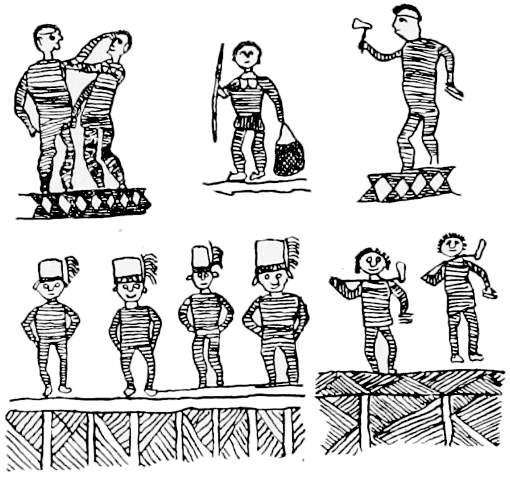
Fig. 1256.—Engravings on bamboo, New Caledonia.
Dr. Andree (e) gives the illustration presented here as Fig. 1256 with these remarks:
The advances made by the Kanakas of New Caledonia in drawing are illustrated by the bamboo staves covered with engraved drawings, which they carry about as objects of fashion, somewhat as we do our walking sticks, and a number of which are preserved in the ethnographic museum of Paris (Trocadero). They have been described by E. T. Hamy. In these finely incised drawings ornaments of the simplest kind (straight lines and zigzag models) are combined with figures and tree groups. The artistic execution is a rather primitive one, yet the figures by no means lack character and vividness. There are seen on the bamboo the pointed-roofed huts of the chieftains, turtles, fowl, lizards, and between them scenes from the life of the Kanakas. A man beats his wife, men discharge their bows, others stand idle in rank and file, adorned with the cylindric straw hat described by Cook, which at this day has almost entirely disappeared.
The explanation of many peculiar forms of Indian drawing and painting is to be found in the stage of mythologic sophiology reached by the several tribes. For instance, Mr. W. H. Holmes, op. cit., discovered that in Chiriqui all the decorations originated in life forms of animals, none being vegetal and none clearly expressive of the human figure or attempting the portrayal of physiognomy. This peculiarity doubtless arose from the exclusively zoomorphic character of the religion of the people. Other mythologic concepts have given a special trend to the art of other tribes and peoples. This results in conventionalism. The sculptures of Persia chiefly express the power and glory of the God-King, and the Egyptian statues are canonical idealizations of an abstract human being, type of the race. It is to be noticed that Indians also show conservatism and conventionalization in their ordinary pictures. Within what may be called a tribal, or more properly stock, system, every Indian draws in precisely the same manner. The figures of a man, of a horse, and of every other object delineated are made by everyone who attempts to make any such figure, with seeming desire for all the identity of which their mechanical skill is capable, thus[744] showing their conception and motive to be the same. In this respect the drawing of the Indians may be likened to that of boys at a public school, who are always drawing, and drawing the same objects and with constant repetition of the same errors from one school generation to another.
In discussing artistic skill only in its relation to picture-writing the degree of its excellence is not intrinsically important, though it may be so for comparison and identification. The figures required were the simplest. Among these were vertical and horizontal straight lines and their combinations, circles, squares, triangles, a hand, a foot, an ax or a bow, a boat or a sledge. Both natural and artificial objects were drawn by a few strokes without elaboration. The fewer the marks the more convenient was the pictograph, if it fulfilled its object of being recognized by the reader. The simple fact without esthetic effect was all that the pictographic artists wanted to show, and when an animal was represented it was not by imitation of its whole form, but by emphasis of some characteristic which must be made obvious, even if it distorted the figure or group and violated every principle of art as now developed.
The power of determining the authorship of pictographs made on materials other than rocks, by means of their general style and type, can be estimated by a comparison of those of the Abnaki, Ojibwa, Dakota, Haida, Innuit, Shoshoni, Moki, etc., presented in various parts of this paper.
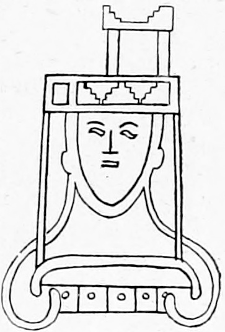
Fig. 1257.—Typical character. Guiana.
Everard F. im Thurn (k), in reference to Fig. 1257, remarks:
Wherever a peculiar, complex, and not very obvious figure occurs in many examples it is legitimate to assume that this had some ulterior object and meaning. Now this figure, occurring in the shallow engravings of Guiana, is of such kind. It is not a figure which an Indian would be likely to invent in an idle moment even once, for such a man very seldom, probably never, except in these particular figures, has been known to draw straight lines. Moreover, even if it were a figure that one Indian might idly invent, it is certainly highly improbable that this would be copied by many other Indians in various places. And, lastly, a figure strikingly like the one in question, if, indeed, it is not identical, occurs in certain Mexican picture writings. For example, in the Mexican MSS. [reproduced in Kingsborough, op. cit., I, from Sir Thomas Bodley’s MSS., pp. 22, 23, and from the Selden MSS., also in the Bodleian, p. 3] several figures occur so like that of the shallow engravings of Guiana that there can be but little doubt of their connection. The recurrence of this peculiar figure in these writings is surely sufficient evidence of the fact that they are not without intention. If it were possible to obtain a clue to the meaning of the Mexican figures it might serve as a key to decipher the hieroglyphic writings of Guiana.
With regard to the study of the individual characters themselves to identify the delineators of pictographs, the various considerations of fauna, religion, customs, tribal signs, indeed most of the headings of this paper, will be applicable.
It is convenient to divide this chapter into: 1. Marked characters of known significance. 2. Distinctive costumes, weapons, and ornaments. 3. Ambiguous characters, with ascertained meaning.
It is obvious that before attempting the interpretation of pictographs concerning which no direct information is to be obtained, there should be a collection, as complete as possible, of known characters, in order that through them the unknown may be learned. When any considerable number of objects in a pictograph are actually known the[746] remainder may be ascertained by the context, the relation, and the position of the several designs, and sometimes by the recognized principles of the art.
The present writer has been engaged, therefore, for a considerable time in collating a large number of characters in a card-catalogue arranged primarily by similarity in forms, and in attaching to each character any significance ascertained or suggested. As before explained, the interpretation upon which reliance is mainly based is that which has been made known by direct information from Indians who themselves were actually makers of pictographs at the time of giving the interpretation. Apart from the comparisons obtained by this collation, the only mode of ascertaining the meaning of the characters, in other words, the only key yet discovered, is in the study of the gesture sign included in many of them.
A spiral line frequently seen in petroglyphs is explained by the Dakota to be a snail shell, and, furthermore, this device is seen in Pl. XX, and fully described in that connection as used in the recording and computation of time.
The limits of this paper do not allow of presenting a complete list of the characters in the pictographs which have become known. But some of the characters in the petroglyphs, Figs. 1258, 1259, and 1260, which are not discussed under various headings, supra, should be explained. The following is a selection of those which were interpreted to Mr. Gilbert.
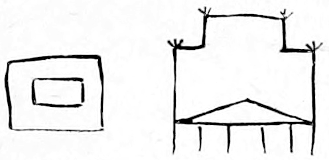
Fig. 1258.—Moki devices.
The left hand device of Fig. 1258 is an inclosure, or pen, in which ceremonial dances are performed. That on the right is a headdress used in ceremonial dances.
Compare the drawing from Fairy Rocks, N. S., Fig. 549.

Fig. 1259.—Frames and arrows. Moki.
Fig. 1259 gives sketches of the frames or sticks used in carrying wood on the back; also shows different forms of arrows.

Fig. 1260.—Blossoms. Moki.
Fig. 1260 represents the blossoms of melons, squashes.
The appearance of objects showing the influence of European civilization and christianization should always be carefully noted. An[747] instance where an object of that character is found among a multitude of others not liable to such suspicion is in the heart surmounted by a cross, in the upper line of Fig. 437. This suggests missionary teaching and corresponding date.
Maximilian of Wied (g) says:
Another mode of painting their robes by the Dakotas is to represent the number of valuable presents they have made. By these presents, which are often of great value, they acquire reputation and respect among their countrymen. On such robes we observed long red figures with a black circle at the termination placed close to each other in transverse rows; they represent whips, indicating the number of horses given, because the whip belonging to the horse is always bestowed with the animal. Red or dark-blue transverse figures indicate cloth or blankets given; parallel transverse stripes represent firearms, the outlines of which are pretty correctly drawn.
It may be desirable also to note, to avoid misconception, that where, throughout this work, mention is made of particulars under the headings of customs, religion, etc., which might be made the subject of graphic illustration in pictographs, and for that reason should be known as preliminary to the attempted interpretation of the latter, the suggestion is not given as a mere hypothesis. Such objective marks and conceptions of the character indicated which can readily be made objective, are in fact frequently found in pictographs and have been understood by means of the preliminary information to which reference is made. When interpretations obtained through this line of study are properly verified, they can take places in the card catalogue little inferior to those of interpretations derived directly from aboriginal pictographers.
The interpretation by means of gesture-signs has already been discussed, Chap. XVIII, Sec. 4.
Capt. Carver (b) describes how an Ojibwa drew the emblem of his own tribe as a deer, a Sioux as a man dressed in skins, an Englishman as a human figure with a hat on his head, and a Frenchman as a man with a handkerchief tied around his head.
In this connection is the quotation from the Historical Collections of Louisiana, Part III, 1851, p. 124, describing a pictograph, as follows: “There were two figures of men without heads, and some entire. The first denoted the dead and the second the prisoners. One of my conductors told me on this occasion that when there are any French among either, they set their arms akimbo, or their hands upon their hips, to distinguish them from the savages, whom they represent with their arms hanging down. This distinction is not purely arbitrary; it proceeds from these people having observed that the French often put themselves in this posture, which is not used among them.”
It is also said suggestively, by C. H. Read (f) in Jour. of the Anthrop. Inst. of Gr. Br. and I., that in the carvings of the West African negroes, the typical white man is constantly figured with a brandy bottle in one hand and a large glass in the other.
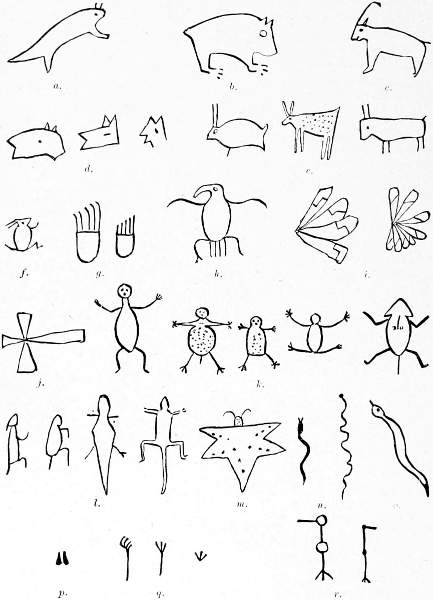
Fig. 1261.—Moki characters. The following is the explanation:
Instructive particulars regarding pictographs may be discovered in the delineation of the fauna in reference to its present or former habitat in the region where the representation of it is found.
As an example of the number and kind of animals pictured as well as of their mode of representation, the foregoing Fig. 1261, comprising many of the Moki inscriptions at Oakley Springs, Arizona, is presented by Mr. G. K. Gilbert. These were selected by him from a large number of etchings for the purpose of obtaining the explanation, and they were explained to him by Tubi, an Oraibi chief living at Oraibi, one of the Moki villages.
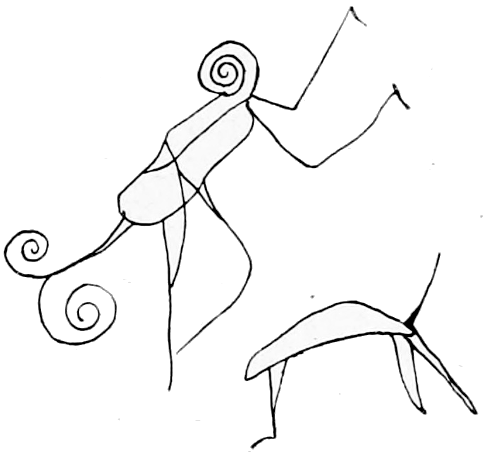
Fig. 1262.—Mantis. Kejimkoojik.
The large object in Fig. 1262, scratched on the Kejimkoojik rocks, Nova Scotia, is probably intended for a mantis or “rear-horse,” but strongly reminds the observer of the monkey forms in the petroglyphs of Central and South America.
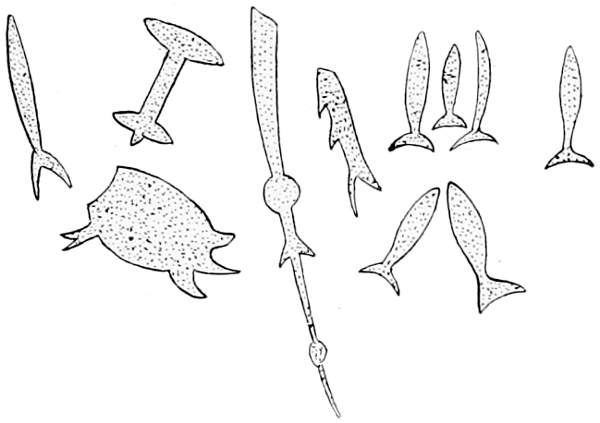
Fig. 1263.—Animal forms. Sonora.
Ten Kate (b) shows in Fig. 1263 those animal forms which were not obliterated from the face of the rock of El-Sauce, Sonora; they were very nearly in the order in which they are represented. The fish at the upper right hand is 20 centimeters long.
On examining the relics of ancient peoples or their modern representatives, the instruments and arms accompanying them and the clothing upon them mark the social status of the individual. In the social life of past generations, and still to-day, certain garments with[750] their adjuncts indicate certain functions. The lawyer, the mechanic, the priest, and the soldier are easily recognizable. These garments do not only give general indications, but minute details, so in looking upon a certain soldier it is known what country he serves, how many men are under his orders, and how many chiefs are above him. It is known if he marches on horseback or afoot, if he handles the rifle or the saber, works the cannon, designs fortifications, or builds bridges. Also, by looking on his decorated breast, it is shown if he has made campaigns and participated in historic battles, and whether or not he has gained distinction. This is told by the color, cut, and ornaments of his clothes and by the weapon he bears. Some details are also furnished by the cut of the hair, and even the style of foot-gear. The above remarks apply to the highest civilization, but all kinds of personal and class designations by means of distinctive costumes, weapons, and adornments were and still are most apparent and important among the less cultured peoples.
The American Indians seldom clothed themselves, except in very cold weather, save for purposes of ornament. They habitually wore no other garment than the breech-cloth, but in their ceremonies and social dances they bedecked themselves with full and elaborate costumes, often regulated with special punctilio for the occasion. The boreal tribes, such as the Alaskan, Athapascan, and Chippewayan, who were obliged to protect themselves for a large part of the year by furs and skins, developed characteristic forms of dress which in pictography take the place occupied by painting and tattooing among tribes where the person was more habitually exposed. Among the southern tribes there was need of protection against the rays of the sun, as in Mexico, where cotton and other fibers were used. In general some of the forms of wearing apparel, if only varieties in the make of moccasins or sandals, designated the tribe of the wearers, and therefore often became adopted as pictorial signs. Ceremonial clothing is often elaborately decorated with beads, porcupine quills, claws and teeth of animals, shells, and feathers. Many of these garments are further ornamented with paintings of a totemic or mythologic character, or bear the insignia of the wearer’s rank and social status. Metal ornaments, such as armlets, bracelets, anklets, earrings and bells, were also worn, the material and quantity being in accordance with the wearer’s ability and pecuniary condition. Upon both social and ceremonial occasions the headgear displayed eagle feathers and the plumes of other species of birds, and tufts of hair dyed in red or other colors. Necklaces were made of claws, shells, deer and antelope hoofs, the teeth of various animals, snake-skins, and even human fingers.
Immediately following are some of the Dakota designations in the particulars mentioned:
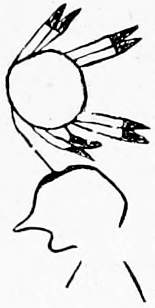
Fig. 1264.
Fig. 1264.—Shield. Red Cloud’s Census. The shield here is without device, though frequently one is painted on the war shields. Such painting may be the pictograph of the gens or of the personal designation, or may show the marks of rank.
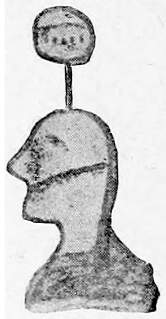
Fig. 1265.
Fig. 1265.—Wahacanka, Shield. The Oglala Roster. The marks or bearings on the shield probably are personal and similar to those commonly called heraldic, but in this drawing are too minute for accurate blazonry.
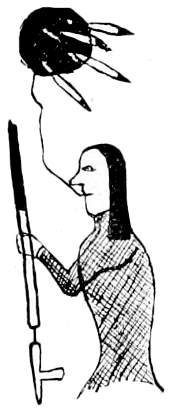
Fig. 1266.
Fig. 1266.—Black-Shield “says his prayers” (in the interpreter’s phrase; that is, he performed the rites elsewhere explained); and takes the war-path to avenge the death of two of his sons who had been killed by the Crows. Cloud-Shield’s Winter Count, 1859-’60.
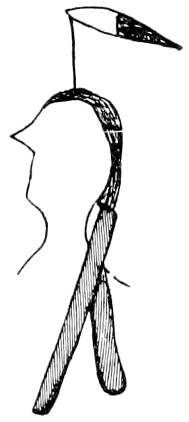
Fig. 1267.
Fig. 1267.—Eagle-Feather. Red-Cloud’s Census. This is probably the same name as translated Lone-Feather in the following figure, in which the feather also comes from an eagle’s tail:
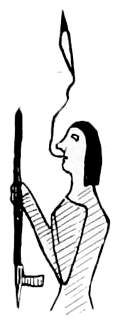
Fig. 1268.
Fig. 1268.—Lone-Feather said his prayers and took the warpath to avenge the death of some relatives. Cloud-Shield’s Winter Count, 1842-’43.
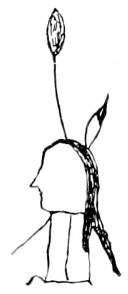
Fig. 1269.
Fig. 1269.—Feathers. Red-Cloud’s Census. This figure and the next refer to some special ornamentation.
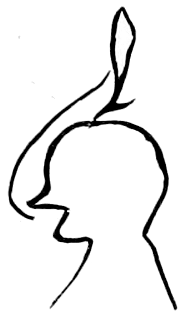
Fig. 1270.
Fig. 1270.—Feathers. Red-Cloud’s Census.

Fig. 1271.
Fig. 1271.—Bone-Necklace. Red-Cloud’s Census. This figure and the three following show special kinds of neck ornaments.
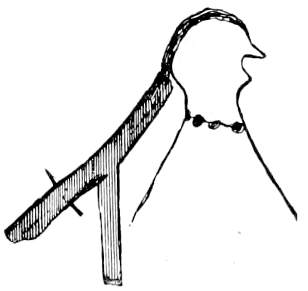
Fig. 1272.
Fig. 1272—Beads. Red-Cloud’s Census.
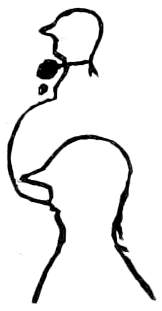
Fig. 1273.
Fig. 1273.—Stone-Necklace. Red-Cloud’s Census.
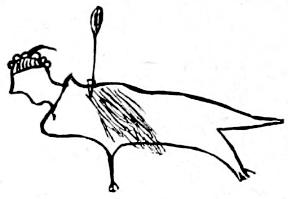
Fig. 1275.
Fig. 1275.—Wolf-Robe was killed by the Pawnees. American-Horse’s Winter Count, 1850-’51.
He is killed and scalped while wearing a robe of wolf-skin.
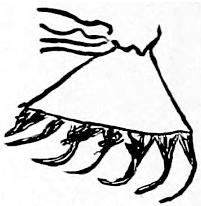
Fig. 1276.
Fig. 1276.—Wears-the-Bonnet. Red-Cloud’s Census. This is the ornamented war bonnet of the Dakotas.
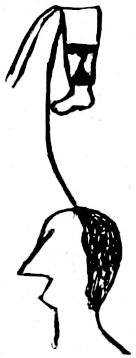
Fig. 1277.
Fig. 1277.—Garter. Red-Cloud’s Census.
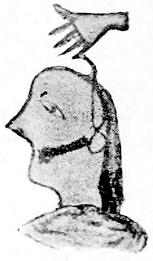
Fig. 1278.
Fig. 1278.—Wicanapsu-owin, Wears-human-fingers as earrings. The Oglala Roster.
The place for the fingers to be worn is indicated by the line terminating in a loop.
The Indian accumulated no wealth except in things useful during his life. His ornaments were made from shells which in their natural shape are innumerable; from the skins of animals which require only skill to take and dress them; and from stone and copper, demanding only strength to procure and transport them. The value of an Indian ornament is in the skill, care and patience required in making it. Thus the wampum-bead became of intrinsic value, similar in that to gold and silver in civilization; the stone carefully wrought into the fashion of a pipe became the emblem of authority and the instrument of worship; and copper, slowly and toilfully delved and fashioned with the rudest of tools and appliances, became almost a fetich of superstition. So likewise the quill of the porcupine, worked into a design in embroidery with the most exquisite care, was an ornament fit for warriors and chiefs. But on the cradle or basket-nest for the expected or new-born child, upon the gown or woman’s dress of the favorite daughter, and upon the moccasins and trappings for the growing son, hand and head and heart were employed for months and even years.
The Dakotan bride, swayed by the yearning of expectant maternity, perhaps also by ambition to excel in the sole permitted mode of its display, adorned her lodge with ornamented cradles, each new one becoming in design more beautiful and intricate than the last, until her yearning was answered, when the cradles not needed were exchanged for horses and ornaments, which became the endowment of the new-born child.
Some note should be made of the sense of correspondence and contrast of colors which the Dakota, at least, exhibits; the rules which he originates and observes forming that which is called artistic taste. The Indian’s use of colors corresponds more nearly than that of most barbarians with that common in high civilization, except that he perceives so little distinction between blue and green that but one name generally suffices for both colors. It is remarkable that among the wilder and plains tribes of Dakotas dead colors in beads are preferred and arranged with good effect, and that among these, specially, the use of neutral tints is common. Probably both of these results were produced from the old and exclusive employment of clays for pigments—clays of almost all colors and shades being found in the country over which the Dakotas roamed.
The peculiarities of dress or undress would seem to have first struck the people of the eastern hemisphere as well adapted to pictorial representation. Singularly enough to modern ideas, the braccæ or trousers were to the Romans the symbol of barbarism, whereas now the absence of the garments, called even “indispensable,” has the same significance. Maj. C. R. Conder (d) gives this good lesson literally “a propos de bottes:”
A curious peculiarity of dress also serves to indicate the racial connection. In Cappadocia and in Anatolia the monuments represent figures with a boot or shoe curled up in front. An Assyrian representation of an Armenian merchant shows the same boot. Sir C. Wilson first compared it with the boot now worn by the peasantry of Asia Minor. Perrot compares it with the cavalry boot worn in Syria and with what we call a Turkish slipper. The Etruscans wore a similar shoe called calceus repandus by the Romans. On the monuments at Karnak the Hittites are represented wearing the same shoe, and although it is not of necessity a mark of race, it is still curious that this curly-toed boot was common to the various Turanian peoples of Syria, Asia Minor, Armenia, and Italy.
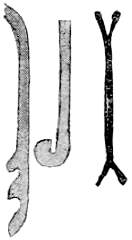
Fig. 1279. Weapons.
Schoolcraft (t) gives the characters on the left hand of Fig. 1279 as two Ojibwa war clubs, and the right-hand character in the same figure is represented in a Wyoming petroglyph as a bow.
Many other weapons distinctive to their draughtsmen are shown in this paper.
It may be well to insert here Fig. 1280, showing the wommeras and clubs of the Australians, taken from Curr (d), not only on account of their forms but of the pictorial designs on some of them, which should be compared with those of the Moki and other Indian tribes.
A large number of pictographic figures distinguishing bodies of Indians by different mode of head dress have already been given. Some additional detail may be added about the Absaroka who have in this regard been imitated by the Hidatsa and Arikara.
They wear horse hair taken from the tail, attached to the back of their heads and allowed to hang down their backs. It is arranged in eight or ten strands, each about as thick as a finger and laid parallel with[754] spaces between them of the width of a single strand. Pine gum is then mixed with red ocher or vermilion and by means of other hair, or fibers of any kind laid crosswise, the strands are secured and around each intersection of hair a ball of gum is plastered to hold it in place, secured to the real growth of hair on the back of the head. About four inches further down a similar row of gum balls and cross strings is placed, and so on down to the end. The Indians frequently incorporate the false hair with their own so as to lengthen the latter without any marked evidence of the deception. Nevertheless the transverse fastenings with their gum attachments are present. In picture-writing this is shown upon the figure of a man by parallel lines drawn downward from the back of the head, intersected by cross lines, the whole[755] appearing like small squares or a piece of net. See Figs. 484 and 485, supra.
A quaint account of social designation by the arrangement of the hair among the Northeastern Algonquins is recorded in the Jesuit Relations of 1639, pp. 44-5:
When a girl or woman favors some one who seeks her, she cuts the hair in the fashion adopted by the maidens of France, hanging over the forehead, which is an ugly style as well in this country as in France; St. Paul forbidding women to show their hair. The women here wear their hair in bunches at the back of the head, in the form of a truss, which they decorate with beads when they have them. If, after marrying some one, a woman leaves him without cause, or if, being promised and having accepted some present, she fails to keep her word, the presumptive husband sometimes cuts her hair, which renders her very despicable and prevents her from getting another spouse.
There is a differentiation of this usage among the Pueblos generally, who, when accurate and particular in delineation, designate the women of that tribe by a huge coil of hair over either ear. This custom prevails also among the Coyotèro Apaches, the women wearing the hair in a coil to denote a virgin, while the coil is absent in the case of a married woman.
Regarding the apparent subject matter of pictographs an obvious distinction may be made between hunting and land scenes such as would be familiar to interior tribes and those showing fishing and aquatic habits common to seaboard and lacustrine peoples. Similar and more perspicuous modes of discrimination are available. The general scope of known history, traditions, and myths may also serve in identification. Known habits and fashions of existing or historically-known tribes have the same application, e. g., the portrayal on a drawing of a human face of labrets or nose rings limits the artist to defined regions, and then other considerations may further specify the work.
When the specific pictorial style of distinctive peoples is ascertained its appearance on rocks may give evidence of their habitat and migrations, and on the other hand their authorship of the petroglyphs being received as a working hypothesis, the latter may be confirmed and the characters interpreted through the known practices and habits of the postulated authors.
Under this heading specimens of the card catalogue before mentioned are presented. The characters would not probably be recognized for the objects they are intended to represent and many of them might be mistaken for attempts to delineate other objects. A much larger number of similar delineations are to be found under other headings in this work, especially in Chap. XIII on Totems, titles, and names.
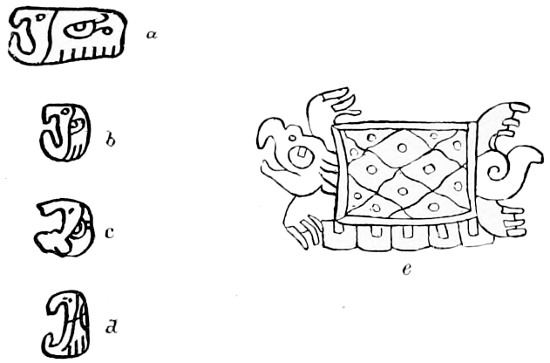
Fig. 1281.—Turtle. Maya.
Prof. C. Thomas (c) gives a, b, c, and d, in Fig. 1281 as representing the turtle.
That they do so is shown by the head of the animal, e, taken from the Cortesian Codex. This is one of the many examples in which the significance of drawings can be ascertained from a series of conventionalized forms. Other instances are given in the present paper, and more in the works of Mr. W. H. Holmes, published in several of the Annual Reports of the Bureau of Ethnology.
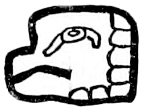
Fig. 1282.—Armadillo. Yucatan.
Fig. 1282 is given in the last cited volume and page as the symbol of the armadillo of Yucatan.
The drawings of which Fig. 1283 presents copies were made by Dakota tribesmen: a, fox; b, black fox; c, wolf; d, black deer; e, beaver; f, spotted horse; g, porcupine; h, white hawk; i, bald eagle; k, crow; l, swallow; m and n, war bonnet; o, leggins; p, gun; q, pipe.
The characters in Fig. 1284 are Ojibwa drawings. With the exception[757] of the last one they are copies of selected sketches made by Gaga Sindebi at White Earth, Minn., in 1891, as parts of a Midē' song.
a, a wolf. The dark chest markings and the large tail are in imitation of those parts of the timber wolf. The coyote is not now found in the region where the author of the song lives; but is more particularly a prairie animal.
b, a wolf. The pronounced jaw indicates his carnivorous nature.
c, a badger. Although the form resembles that of the bear the difference is shown by the darkened body to imitate the gray fur.
d, a bear.
e, a bear. This style of drawing is not common, it being rather short and stout, while the legs and ears are unusually pronounced.
f, the figure of a bear manido, to which is attached a feather denoting the mythic character of the animal.
g, the figure represents a “lean bear,” as is specified by the appearance of the ribs showing his lean condition.
h, a lizard. The ribs are ridges, which are found upon some forms of Siredon, one species of which occurs in the ponds and small lakes of Minnesota.
i, a toad.
k, a raccoon. The bands of color are indicated in the drawing.
l, a porcupine. Resembles some forms of the sacred bear manido as the latter is sometimes drawn.
m, the crane. The three round spots over the head represent three songs sung by the midē' to the crane manido.
n, the thunder-bird or eagle, having four heads. This character appears to be unique, as it has at no time been noticed upon any of the[758] numerous midē' records in the possession of the Bureau of Ethnology.
o, the character represents a man using the rattle, as in the ceremony of incantation. The projections above the head denote his superior powers.
p, a midē', holding in his right hand a bear’s paw medicine bag, and in his left hand an arrow. The character resembles similar drawings to denote vessels in which herbs are boiled and from the top of which vapor is issuing.
q, a midē' medicine sack. The character appears like similar drawings of the otter; in the present instance, however, the ornamentation upon the skin shows it to be not a living animal.
r, a beaver’s tail, from Schoolcraft (y). Many other illustrations of this general nature are given by Mr. Schoolcraft, nearly all colored according to his fancy.
No large amount of space need be occupied in the mention of detected pictographic frauds, their present and future importance being small, but much more than is now allowed would be required for the full discussion of controverted cases.
There is little inducement, beyond the amusement derived from hoaxing, to commit actual frauds in the fabrication of petroglyphs. It must, however, be remembered that coloration and carving of a deceptive character are sometimes produced by natural causes, e. g., pictured rocks on the island of Monhegan, Maine, figured by Schoolcraft (z), are classed in “Science” VI, No. 132, p. 124, as freaks of surface erosion. Mica plates were found in a mound at Lower Sandusky, Ohio, which, after some attempts at interpretation, proved to belong to the material known as graphic or hieroglyphic mica, the discolorations having been caused by the infiltration of mineral solution between the laminæ.
The instances where inscribed stones from mounds have been ascertained to be forgeries or fictitious drawings are to be explained as sometimes produced by simple mischief, sometimes by craving for personal notoriety, and in other cases by schemes either to increase the marketable value of land supposed to contain more of the articles or to sell those exhibited.
With regard to more familiar and more portable articles, such as engraved pipes, painted robes, and like curios, it is well known that the fancy prices paid for them by amateurs have stimulated their unlimited manufacture by Indians at agencies who make a business of sketching upon ordinary robes or plain pipes the characters in common use by them, without regard to any real event or person, and selling them as significant records. Some enterprising traders have been known to furnish the unstained robes, plain pipes, paints, and other materials for the purpose, and simply pay a skillful Indian for his work, when the fresh antique or imaginary chronicle is delivered.
As the business of making and selling archæologic frauds has become so extensive in Egypt and Palestine, it can be no matter of surprise that it has been attempted by enterprising people of the United States, about whom the wooden-nutmeg imputation still clings. The Bureau of Ethnology has discovered several centers of the manufacture of antiquities.
It was once proclaimed that six inscribed copper plates had been found in a mound near Kinderhook, Pike county, Illinois, which were[760] reported to bear a close resemblance to Chinese. This resemblance seemed not to be extraordinary when it was ascertained that the plate had been engraved by the village blacksmith, copied from the lid of a Chinese tea-chest.
The following recent notice of a case of alleged fraud is quoted from Science, Vol. III, No. 58, March 14, 1884, page 334:
Dr. N. Roe Bradner exhibited [at the Academy of Natural Sciences, Philadelphia, Pennsylvania] an inscribed stone found inside a skull taken from one of the ancient mounds at Newark, Ohio, in 1865. An exploration of the region had been undertaken, in consequence of the finding of stones bearing markings somewhat resembling Hebrew letters, in the hope of finding other specimens of a like character. The exploration was supposed to have been entirely unproductive of such objects until Dr. Bradner had found the engraved stone, now exhibited, in a skull which had been given to him.
This was supplemented by an editorial note in No. 62 of the same publication, page 467, as follows:
A correspondent from Newark, Ohio, warns us that any inscribed stones said to originate from that locality may be looked upon as spurious. Years ago certain parties in that place made a business of manufacturing and burying inscribed stones and other objects in the autumn, and exhuming them the following spring in the presence of innocent witnesses. Some of the parties to these frauds afterwards confessed to them; and no such objects, except such as were spurious, have ever been known from that region.
The correspondent of Science probably remembered the operations of David Wyrick, of Newark, who, to prove his theory that the Hebrews were the mound-builders, discovered in 1860 a tablet bearing on one side a truculent “likeness” of Moses with his name in Hebrew, and on the other a Hebrew abridgment of the ten commandments. A Hebrew bible afterwards found in Mr. Wyrick’s private room threw some light on the inscribed characters.
A grooved stone ax or maul, first described by the late Dr. John Evans, of Pemberton, New Jersey, was reproduced by Dr. Wilson (a). Several characters are cut in the groove and on the blade. They are neither Runic, Scandinavian, nor Anglo-Saxon. It was found near Pemberton, New Jersey, prior to 1859. Dr. E. H. Davis, who saw the stone, does not regard the inscription as ancient. The characters had been retouched before he saw them.
A grooved stone ax or maul, sent to Col. Whittlesey in 1874, from Butler county, Ohio, about the size of the Pemberton ax, was covered with English letters so fresh as to deceive no one versed in antiquities. The purport of this inscription is that in 1689 Capt. H. Argill passed there and secreted two hundred bags of gold near a spring.
It was claimed that an inscribed stone had been plowed up on the eastern shore of Grand Traverse bay, Michigan, and an imperfect cast of it was among the collections of the state of Michigan at the Centennial Exhibition. The original is or was in the cabinet of the Kent county Institute, Grand Rapids, Michigan. It is imperfectly executed,[761] probably with a knife, and evidently of recent make, in which Greek, Bardic, and fictitious letters are jumbled together without order.
In 1875 a stone maul was discovered in an ancient mine pit near Lake Desor, Isle Royal, Lake Superior, on which were cut several lines that were at first regarded as letters.
An instructive paper by Mr. Wm. H. Holmes “On Some Spurious Mexican Antiquities and their Relation to Ancient Art,” is published in the Report of the Smithsonian Institution for 1886, Pt. 1, pp. 319-334.
An inscribed stone found in Grave creek mound, near the Ohio river, in 1838, has been the subject of much linguistic contention among persons who admitted its authenticity. Twenty-four characters on it have been considered by various experts to be alphabetic, and one is a supposed hieroglyphic sign. Mr. Schoolcraft says that twenty-two of the characters are alphabetic, but there has been a difference of opinion with regard to their origin. One scholar finds among them four characters which he claims are ancient Greek; another claims that four are Etruscan; five have been said to be Runic; six, ancient Gaelic; seven, old Erse; ten, Phenician; fourteen, old British; and sixteen, Celtiberic. M. Levy Bing reported at the Congress of Americanists at Nancy, in 1875, that he found in the inscription twenty-three Canaanite letters, and translated it: “What thou sayest, thou dost impose it, thou shinest in thy impetuous clan and rapid chamois.” (!) M. Maurice Schwab in 1857 rendered it: “The Chief of Emigration who reached these places (or this island) has fixed these statutes forever.” M. Oppert, however, gave additional variety by the translation, so that all tastes can be suited: “The grave of one who was assassinated here. May God to avenge him strike his murderer, cutting off the hand of his existence.”
Col. Chas. Whittlesey (a) gives six copies of the Grave creek stone, all purporting to be facsimiles, which have been published and used in the elaborate discussions held upon its significance. Of these, three are here reproduced with Col. Whittlesey’s remarks, as follows:
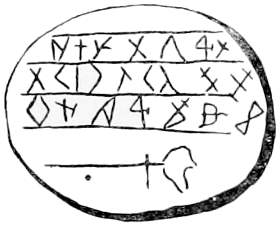
Fig. 1285.—Grave creek stone.
Copy No. 1 is reproduced as Fig. 1285, drawn by Capt. Eastman.
Capt. Seth Eastman was a graduate and teacher of drawing at West Point. He was an accomplished draftsman and painter detailed by the War Department to furnish the illustrations for “Schoolcraft’s Indian Tribes,” published by the Government. This copy was made in his official capacity, with the stone before him, and therefore takes the first rank as authority. There are between the lines twenty-two characters, but one is repeated three times and another twice leaving only twenty. The figure, if it has any significance, is undoubtedly pictorial.
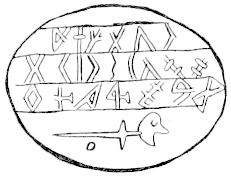
Fig. 1286.—Grave creek stone.
Copy No. 3, now Fig. 1286, was used by Monsieur Jomard at Paris, 1843.
From this copy M. Jomard considered the letters to be Lybian, a language derived from the Phenician. At the right of the upper line one is omitted and another bears no resemblance to the original. The fifth character of the second line is equally defective and objectionable. The second, fifth, and sixth of the lower line are little better. In the rude profile of a human face beneath an eye has been introduced and the slender cross lines attached to it have assumed the proportions of a dagger or sword. For the linguist or ethnologist this copy is entirely worthless.
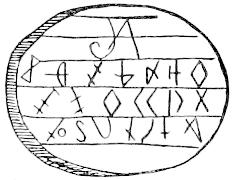
Fig. 1287.—Grave creek stone.
Copy No. 4, now Fig. 1287, was sent to Prof. Rafn, Copenhagen, 1843.
This is so imperfect and has so many additions that it is little better than a burlesque upon the original. No one will be surprised that the learned Danish antiquarian could find in it no resemblance to the Runic, with which he was thoroughly familiar.
A mere collocation of letters from various alphabets is not an alphabet. Words can not be formed or ideas communicated by that artifice. When a people adopts the alphabetical signs of another it adopts the general style of the characters and more often the characters in detail. Such signs had already an arrangement into syllables and words which had a vocalic validity as well as known significance. A jumble of letters from a variety of alphabets bears internal evidence that the manipulator did not have an intelligent meaning to convey by them, and did not comprehend the languages from which the letters were selected. In the case of the Grave creek inscription the futile attempts to extract a meaning from it on the theory that it belongs to an intelligent alphabetic system show that it holds no such place. If it is genuine it must be treated as pictorial and ideographic, unless, indeed, it is cryptographic, which is not indicated.
In this connection some allusion must be made to the learned discussions upon the Dighton rock before mentioned, p. 86. The originally Algonquian characters were translated by a Scandinavian antiquary as an account of the party of Thorfinn, the Hopeful. A distinguished Orientalist made out clearly the word “melek” (king). Another scholar triumphantly established the characters to be Scythian, and still another identified them as Phenician. But this inscription has been so manipulated that it is difficult now to determine the original details.
An official report made in 1830 by the Rhode Island Historical Society and published by the Royal Society of Northern Antiquaries,[763] in “Antiquitates Americanæ,” by C. C. Rafn (e), presents the best account known concerning the Dighton rock and gives copies made from time to time of the inscription, which are here reproduced, Pl. LIV. The text is condensed as follows, but in quoting it the statement that the work was not done by the Indians is without approval.
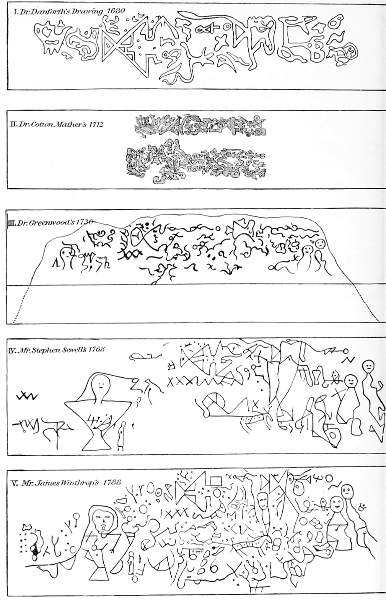
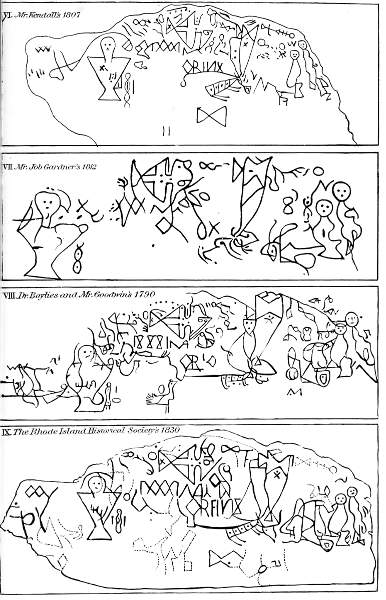
BUREAU OF ETHNOLOGY TENTH ANNUAL REPORT PL. LIV
DIGHTON ROCK.
It is situated about 6½ miles south of Taunton, on the east side of Taunton river, a few feet from the shore, and on the west side of Assonet neck, in the town of Berkley, county of Bristol, and commonwealth of Massachusetts; although probably from the fact of being generally visited from the opposite side of the river, which is in Dighton, it has always been known by the name of the Dighton Writing Rock. It faces northwest toward the bed of the river, and is covered by the water 2 or 3 feet at the highest, and is left 10 or 12 feet from it at the lowest tides; it is also completely immersed twice in twenty-four hours. The rock does not occur in situ, but shows indubitable evidence of having occupied the spot where it now rests since the period of that great and extensive disruption which was followed by the transportation of immense bowlders to, and a deposit of them in, places at a vast distance from their original beds. It is a mass of well characterized, fine grained graywacke. Its true color, as exhibited by a fresh fracture, is a bluish gray. There is no rock in the immediate neighborhood that would at all answer as a substitute for the purpose for which the one bearing the inscription was selected, as they are aggregates of the large conglomerate variety. Its face, measured at the base is 11½ feet, and in height it is a little rising 5 feet. The upper surface forms with the horizon an inclined plane of about 60 degrees. The whole of the face is covered to within a few inches of the ground with unknown hieroglyphics. There appears little or no method in the arrangement of them. The lines are from half an inch to an inch in width; and in depth, sometimes one-third of an inch, though generally very superficial. They were, inferring from the rounded elevations and intervening depressions, pecked in upon the rock and not chiseled or smoothly cut out. The marks of human power and manual labor are indelibly stamped upon it. No one who examines attentively the workmanship will believe it to have been done by the Indians. Moreover, it is a well attested fact that nowhere throughout our widespread domain is a single instance of their recording or having recorded their deeds or history on stone.
“The committee also examined the various drawings that have been made of this inscription.
“The first was made by Cotton Mather as early as 1712; and may be found in No. 338, vol. 28, of the Philosophical Transactions, pp. 70 and 71; also in vol. 5, Jones’s abridgment, under article fourth.
“Another was made by James Winthrop in 1788, a copy of which may be found in the Memoirs of the American Academy, vol. 2, part 2, p. 126.
“Dr. Baylies and Mr. Goodwin made another drawing in 1790, a copy of which is inclosed.
“Mr. E. A. Kendall in 1807 took another which may be found in the Memoirs of the American Academy, vol. 3, part 1, p. 165.
“And one has been more recently [1812] made by Mr. Job Gardner, a lithograph from which is also inclosed.
“Dr. Isaac Greenwood exhibited a drawing of the inscription before the Society of Antiquarians of London bearing the date of 1730. The drawing by the Historical Society of Rhode Island bears the date of 1830.
“We send you a copy of the inscription, as given on said representation of the rock, being what you probably desire; but having made an accurate drawing of the rock itself for your special use, we have not deemed it necessary to forward the one above referred to. We also send a copy of Judge Winthrop’s drawing contained in the same work, and of one taken by Stephen Sewell in 1768.
“You will likewise find among the drawings a copy of what purports to be ‘a faithful and accurate representation of the inscription,’ taken by Dr. Danforth in 1680. This is not sent with any idea that it will prove serviceable in your present inquiry, but simply to show what strange things have been conjured up by travelers and sent to Europe for examination. We are, indeed, at times almost compelled to believe there must have been some other inscription rock seen; and yet from the accompanying accounts it would appear that all refer to the same one; besides, there is a degree of similarity in the complicated triangular figures which appear on all.”
See, also, the illustration from Schoolcraft, Fig. 49, supra, with further account. The fact was mentioned on p. 87 that the characters on the Dighton Rock strongly resembled those on the Indian God Rock, Pennsylvania, and some others specified. Lately some observers have noticed the same fact with a different deduction. They presuppose that the Dighton inscription is Runic, and therefore that the one in Pennsylvania was carved by the Norsemen. This logic would bring the Vikings very far inland into West Virginia and Ohio.
From considerations mentioned elsewhere, and others that are obvious, any inscriptions purporting to be pre-Columbian, showing apparent use of alphabetic characters, signs of the zodiac, or other evidences of a culture higher than that known among the North American Indians, must be received with caution, but the pictographs may be altogether genuine, and their erroneous interpretation may be the sole ground for discrediting them.
The course above explained, viz, to attempt the interpretation of all unknown American pictographs by the aid of actual pictographers among the living Indians, should be adopted regarding all remarkable “finds.” This course was pursued by Mr. Horatio N. Rust, of Pasadena, California, regarding the much-discussed Davenport Tablets, in the genuineness of which he believes. Mr. Rust exhibited the drawings to Dakotas with the result made public at the Montreal meeting of the American Association for the Advancement of Science, and also in a letter, an extract from which is as follows:
As I made the acquaintance of several of the older and more intelligent members of the tribe, I took the opportunity to show them the drawings. Explaining that they were pictures copied from stones found in a mound, I asked what they meant. They readily gave me the same interpretation (and in no instance did either interpreter know that another had seen the pictures, so there could be no collusion). In Plate I, of the Davenport Inscribed Tablets [so numbered in the Proceedings of the Davenport Academy, vol. II], the lower central figure represents a dome-shaped lodge, with smoke issuing from the top, behind and to either side of which appears a number of individuals with hands joined, while three persons are depicted as lying upon the ground. Upon the right and left central margins are the sun and moon, the whole surmounted by three arched lines, between each of which, as well as above them, are numerous unintelligible characters. * * * The central figure, which has been supposed by some to represent a funeral pile, was simply the picture of a[765] dirt lodge. The irregular markings apparently upon the side and to the left of the lodge represent a fence made of sticks and brush set in the ground. The same style of fence may be seen now in any Sioux village.
The lines of human figures standing hand-in-hand indicate that a dance was being conducted in the lodge. The three prostrate forms at right and left sides of the lodge represent two men and a woman who, being overcome by the excitement and fatigue of the dance, had been carried out in the air to recover. The difference in the shape of the prostrate forms indicates the different sexes.
The curling figures or rings above the lodge represent smoke, and indicate that the dance was held in winter, when fire was used.
An amusing example of forced interpretation of a genuine petroglyph is given by Lieut. J. W. Gunnison (a), and is presented in the present work in connection with Fig. 81, supra.
Fig. 1288 is a copy of a drawing taken from an Ojibwa pipestem, obtained by Dr. Hoffman from an officer of the United States Army, who had procured it from an Indian in St. Paul, Minnesota. On more minute examination, it appeared that the pipestem had been purchased at a shop in St. Paul, which had furnished a large number of similar objects—so large as to awaken suspicion that they were in the course of daily manufacture. The figures and characters on the pipestem were drawn in colors. In the present figure, which is without colors, the horizontal lines represent blue and the vertical red, according to the heraldic scheme. The outlines were drawn in a dark neutral tint, in some lines approaching black; the triangular characters, representing lodges, being also in a neutral tint, or an ashen hue, and approaching black in several instances. The explanation of the figures, made before there was any suspicion of their authenticity, is as follows:
The first figure is that of a bear, representing the person to whom the record pertains. The heart above the line, according to an expression in gesture language, would signify a brave heart, increased numbers indicating much or many, so that the three hearts mean a large brave heart.
The second figure, a circle inclosing a triradiate character, refers to the personal totem. The character in the middle somewhat resembles the pictograph sometimes representing stars, though in the latter the lines center upon the disks and not at a common point.
The seven triangular characters represent the lodges of a village to which the person referred to belongs.
The serpentine lines immediately below these signify a stream or river, near which the village is situated.
The two persons holding guns in their left hands, together with another holding a spear, appear to be the companions of the speaker or recorder, all of whom are members of the turtle gens, as shown by that animal.
The curve from left to right is a representation of the sky, the sun having appeared upon the left or eastern horizon. The drawing, so far, might represent the morning when a female member of the crane gens, was killed—shown by the headless body of a woman.
The lower figure of a bear is the same apparently as the upper, though turned to the right. The hearts are drawn below the line, i. e., down, to denote sadness, grief, remorse, as it would be expressed in gesture language, and to atone for the misdeed committed the pipe is brought and offering made for peace.
Altogether the act depicted appears to have been accidental, the woman belonging to the same tribe, as can be learned from the gens of which she was a member. The regret or sorrow signified in the bear, next to the last figure, corresponds with that supposition, as such feelings would not be manifested on the death of an enemy.
The point of interest in this drawing is, that the figures are very skillfully copied from the numerous characters of the same kind representing Ojibwa pictographs, and given by Schoolcraft. The arrangement of these copied characters is precisely what would be common in the similar work of Indians. In fact, the group constitutes an intelligent pictograph and affords a good illustration of the manner in which one can be made. The fact that it was sold under false representations is its objectionable feature.
Another case brought officially to the Bureau of Ethnology shows evidence of a more determined fraud. In 1888 and earlier a so-called “Shawnee doctor” had displayed as a chart in the nature of an aboriginal diploma, a brightly colored picture 36 by 40 inches, a copy of which was sent, to be deciphered, to the Bureau by a gentleman who is not supposed to have been engaged in fraud or hoax. The mystic chart is copied in Fig. 1289. There was little difficulty in its explanation.
The large figures on the border can not be pretended to be of Indian origin. The smaller interior figures constituting the body of the chart are all, with trifling exceptions, exact copies of figures published and fully explained in G. Copway’s “Traditional History, etc., of the Ojibway Nation,” op. cit. Several of the same figures appear above in the present work. The principal exceptions are, first, a modern knife; second, a bird with a decidedly un-Indian human head, and, third, a cross with two horizontal arms of equal length. The figures from Copway are not in the exact order given in his list and it is possible[767] that they may have been placed in their present order to simulate the appearance of some connected narrative or communication, which could readily be done in the same manner as the words of a dictionary could be cut out and pasted in some intelligent sequence.
Among the curiosities of literature in connection with the interpretation of pictographs may be mentioned La Vèritè sur le Livre des Sauvages, par L’Abbé Em. Domenech, Paris, 1861, and Researches into the Lost Histories of America, by W. S. Blacket, London and Philadelphia, 1884.
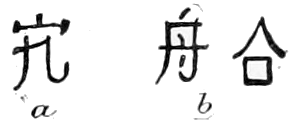
Fig. 1290.—Chinese characters.
The following remarks of Dr. Edkins (h) are also in point:
The early Jesuits were accustomed to interpret Chinese characters on the wildest principles. They detected religious mysteries in the most unexpected situations. Kwei “treacherous,” is written with Kieu “nine,” and above it one of the covering radicals, Fig. 1290a. This, then, was Satan at the head of the nine ranks of angels. The character, same Fig., b, c’hwen “a boat,” was believed to contain an allusion to the deluge. On the left side is the ark and on the right are the signs for eight and for persons. The day for this mode of explaining the Chinese characters has gone by.
The result of the writer’s studies upon petroglyphs as distinct from other forms of picture writing may now be summarized.
Perhaps the most important lesson learned from these studies is that no attempt should be made at symbolic interpretation unless the symbolic nature of the particular characters under examination is known, or can be logically inferred from independent facts. To start with a theory, or even a hypothesis, that the rock writings are all symbolic and may be interpreted by the imagination of the observer or by translation either from or into known symbols of similar form found in other regions, were a limitless delusion. Doubtless many of the characters are genuine symbols or emblems, and some have been ascertained through extrinsic information to be such. Sometimes the more modern forms are explained by Indians who have kept up the pictographic practice, and the modern forms occasionally throw light upon the more ancient. But the rock inscriptions do not evince mysticism or esotericism, cryptography, or steganography. With certain exceptions they were intended to be understood by all observers either as rude objective representations or as ideograms, which indeed were often so imperfect as to require elucidation, but not by any hermeneutic key. While they often related to religious ceremonies or myths, such figures were generally drawn in the same spirit with which any interesting matter was portrayed.
While the interpretation of petroglyphs by Indians should be obtained if possible, it must be received with caution. They very seldom know by tradition the meaning of the older forms, and their inferences are often made from local and limited pictographic practices. There is no more conscientious and intelligent Indian authority than Frank La Flêche, an Omaha, and he explains the marks on a rock in Nebraska as associated with the figures of deceased men and exhibiting the object which caused their death, such as an arrow or ax. This may be a local or tribal practice, but it certainly does not apply to similar figures throughout the Algonquian and Iroquoian areas, where, according to the concurrent testimony for more than two centuries, similar figures are either designations of tribes and associations, or in their combinations are records of achievements.
Lossing (b) gives the following explanation of markings on a well known rock:
Among the brave warriors in the battle [of Maumee] who were the last to flee before Wayne’s legion, was Me-sa-sa, or Turkey-foot, an Ottawa chief, who lived on Blanchards Fork of the AuGlaize River. He was greatly beloved by his people.[769] His courage was conspicuous. When he found the line of dusky warriors giving way at the foot of Presque Isle hill, he leaped upon a small bowlder, and by voice and gesture endeavored to make them stand firm. He almost immediately fell, pierced by a musket ball, and expired by the side of the rock. * * * They carved many rude figures of a turkey’s foot on the stone, as a memorial of the English name of the lamented Me-sa-sa. The stone is still there, by the side of the highway at the foot of Presque Isle hill, within a few rods of the swift-flowing Maumee. Many of the carvings are still quite deep and distinct, while others have been obliterated by the abrasion of the elements.
This tale may be true, but it surely does not account for the turkey-foot marks which are so common in the northeastern Algonquian region, extending from Dighton rock to Ohio, that they form a typical characteristic of its pictographs. They have been considered to be the sign for the bird, the turkey, which was a frequent totem. Lossing’s story is an example of the readiness of an Indian, when in an amiable and communicative mood, to answer queries in a manner which he supposes will be satisfactory to his interviewer. He will then give any desired amount of information on any subject without the slightest restriction by the vulgar bounds of fact. It is dangerous to believe explanations on such subjects as are now under consideration, unless they are made without leading questions by a number of Indian authorities independently.
Specially convenient places for halting and resting on a journey, either by land or water, such as is mentioned supra, on Machias bay, generally exhibit petroglyphs if rocks of the proper character are favorably situated there. The markings may be mere graffiti, the product of leisure hours, or may be of the more serious descriptions mentioned below.
Some points are ascertained with regard to the motives of the painters and sculptors on rocks. Some of the characters were mere records of the visits of individuals to important springs or to fords on regularly established trails. In this practice there may have been in the intention of the Indians very much the same spirit which induces the civilized man to record his name or initials upon objects in the neighborhood of places of general resort. But there was real utility in the Indian practice, which more nearly approached to the signature in a visitor’s book at a hotel or public building, both to establish the identity of the traveler and to give the news to friends of his presence and passage. At Oakley springs, Arizona territory, totemic marks have been found, evidently made by the same individual at successive visits, showing that on the number of occasions indicated he had passed by those springs, probably camping there, and the habit of making such record was continued until quite recently by the neighboring Indians. The same repetition of totemic names has been found in great numbers in the pipestone quarries of Minnesota, on the rocks near Odanah, Wisconsin, and also at some old fords in West Virginia. These totemic marks are so designed and executed as to have intrinsic significance and value, wholly different in this respect from[770] names in alphabetic form, which grammatically are proper but practically may be common.
Rock carvings are frequently noticed at waterfalls and other points on rivers and on lake shores favorable for fishing, which frequency is accounted for by the periodical resort of Indians to such places. Sometimes they only mark their stay, but occasionally there also appear to be records of conflict with rival or inimical tribes which sought to use the same waters.
Evidence is presented in the present work that the characters on rock pictures sometimes were pointers or “sign-posts” to show the direction of springs, the line of established trails, or of paths that would shorten distances in travel. It has been supposed that similar indications were used guiding to burial mounds and other places of peculiar sanctity or interest, but the evidence of this employment is not conclusive. Many inquiries have been made of the Bureau of Ethnology concerning Indian marks supposed to indicate the sites of gold, silver, and copper mines and buried treasure generally, which inquiries were answered only because it was recognized as the duty of an office of the government to respond, so far as possible, to requests for information, however silly, which are made in good faith.
Petroglyphs are now most frequently found in those parts of the world which are still, or recently have been, inhabited by savage or barbarian tribes. Persons of these tribes when questioned about the authorship of the rock drawings have generally attributed them to supernatural beings. Statements to this effect from many peoples of the three Americas and of other regions, together with the names of rockwriting deities, are abundantly cited in the present work. This is not surprising, nor is it instructive, except as to the mere fact that the drawings are ancient. Man has always attributed to supernatural action whatever he did not understand. Also, it appears that in modern times shamans have encouraged this belief and taken advantage of it to interpret for their own purposes the drawings, some of which have been made by themselves. But notwithstanding these errors and frauds, a large proportion of the petroglyphs in America are legitimately connected with the myths and the religious practices of the authors. The information obtained during late years regarding tribes such as the Zuñi, Moki, Navajo, and Ojibwa, which have kept up on the one hand their old religious practices and on the other that of picture writing, is conclusive on this point. The rites and ceremonies of these tribes are to some extent shown pictorially on the rocks, some of the characters on which have until lately been wholly meaningless, but are now identified as drawings of the paraphernalia used in or as diagrams of the drama of their rituals. Unless those rituals, with the creeds and cosmologies connected with them had been learned, the petroglyphs would never have been interpreted. The fact that they are now understood does not add any new information, except that perhaps in[771] some instances their age may show the antiquity and continuity of the present rites.
A potent reason for caution in making deductions based only on copies of figures published incidentally in works of travel is that it can seldom be ascertained with exactness what is the true depiction of those figures as actually existing or as originally made. The personal equation affects the drawings and paintings intended to be copies from the rock surfaces and also the engravings and other forms of reproductions, and the student must rely upon very uncertain reproductions for most of his material. The more ancient petroglyphs also require the aid of the imagination to supply eroded lines or faded colors. Travelers and explorers are seldom so conscientious as to publish an obscure copy of the obscure original. It is either made to appear distinct or is not furnished at all, and if the author were conscientious the publisher would probably overrule him.
Thorough knowledge of the historic tribes, including their sociology, sophiology, technology, and especially their sign language, will probably result in the interpretation of many more petroglyphs than are now understood, but the converse is not true. The rock characters studied independently will not give much primary information about customs and concepts, though it may and does corroborate what has been obtained by other modes of investigation. A knowledge of Indian customs, costumes, including arrangement of hair, paint, and all tribal designations, and of their histories and traditions, is essential to the understanding of their drawings; for which reason some of those particulars known to have influenced pictography have been set forth in this work and objects have been mentioned which were known to have been portrayed graphically with special intent.
Other objects are used symbolically or emblematically which, so far as known, have never appeared in any form of pictographs, but might be found in any of them. For instance, Mr. Schoolcraft says of the Dakotas that “some of the chiefs had the skins of skunks tied to their heels to symbolize that they never ran, as that animal is noted for its slow and self-possessed movements.” This is one of the many customs to be remembered in the attempted interpretations of pictographs. The present writer does not know that a skunk skin or a strip of skin which might be supposed to be a skunk skin attached to a human heel has ever been separately used pictorially as the ideogram of courage or steadfastness, but with the knowledge of this objective use of the skins, if they were found so represented pictorially, the interpretation would be suggested without any direct explanation from Indians.
A partial view of petroglyphs has excited hope that by their correlation the priscan homes and migrations of peoples may be ascertained. Undoubtedly striking similarities are found in regions far apart from as well as near to each other. A glance at the bas-reliefs of Boro Boudour in Java, now copied and published by the Dutch authorities, at once recalls figures of the lotus and uræus of Egypt, the horns of Assyria, the[772] thunderbolt of Greece, the Buddhist fig tree, and other noted characters common in several parts of the world. If the petroglyphs of America are considered as the texts with which all others may be compared, it is believed that the present work shows illustrations nearly identical with many much-discussed carvings and paintings on the rocks of the eastern hemisphere, those in Siberia being most strongly suggestive of connection. But from the present collection it would seem that the similarity of styles in various regions is more worthy of study than is the mere resemblance or even identity of characters, the significance of which is unknown and may have differed in the intent of the several authors. Indeed it is clear that even in limited areas of North America, diverse significance is attached to the same figure and differing figures are made to express the same concept.
The present work shows a surprising resemblance between the typical forms among the petroglyphs found in Brazil, Venezuela, Peru, Guiana, part of Mexico, and those in the Pacific slope of North America. This similarity includes the forms in Guatemala and Alaska, which, on account of the material used, are of less assured antiquity. Indeed it would be safe to include Japan and New Zealand in this general class. In this connection an important letter from Mr. James G. Swan, respecting the carved wooden images of the Haidas, accentuates the deduction derived only from comparison. Mr. Swan says that he showed to the Indians of various coast tribes the plates of Dr. Habel’s work on sculptures in Guatemala, and that they all recognized several of the pictures which he notes. They also recognized and understood the pictures of the Zuñi ceremonials, masks, and masquerades scenes published by Mr. F. H. Cushing.
Without entering upon the discussion whether America was peopled from east to west, or from either, or from any other part of the earth, it is for the present enough to suggest that the petroglyphs and other pictographs in the three Americas indicate that their pre-Columbian inhabitants had at one time frequent communication with each other, perhaps not then being separated by the present distances of habitat. Styles of drawing and painting could thus readily be diffused, and, indeed, to mention briefly the extralimital influence, if as many Japanese and Chinese vessels were driven upon the west American coast in prehistoric times as are known by historic statistics to have been so driven, the involuntary immigrants skilled in drawing and painting might readily have impressed their styles upon the Americans near their landing place to be thence indefinitely diffused. This hypothesis would not involve migration.
Interest has been felt in petroglyphs, because it has been supposed that if interpreted they would furnish records of vanished peoples or races, and connected with that supposition was one naturally affiliated that the old rock sculptures were made by peoples so far advanced in culture as to use alphabets or at least syllabaries, thus supporting[773] the theory about the mythical mound builders or some other supposititious race. All suggestions of this nature should at once be abandoned. The practice of pictography does not belong to civilization and declines when an alphabet becomes popularly known. Neither is there the slightest evidence that an alphabet or syllabary was ever used in pre-Columbian America by the aborigines, though there is some trace of Runic inscriptions. The fact that the Maya and Aztec peoples were rapidly approaching to such modes of expressing thought, and that the Dakota and Ojibwa had well entered upon that line of evolution, shows that they had proceeded no farther, and it is admitted that they were favorable representatives of the tribes of the continent in this branch of art. The theory mentioned requires the assumption, without a particle of evidence, that the rock sculptures are alphabetic, and therefore were made by a supposititious and extinct race. Topers of the mysterious may delight in such dazing infusions of perverted fancy, but they are repulsive to the sober student.
The foregoing remarks apply mainly to rock inscriptions and not to pictographs on other substances, the discussion and illustration of which occupy the greater part of the present work. In that division there is no need of warning against wild theories or uncertain data. The objects are in hand and their current use as well as their significance is understood. Their description and illustration by classes is presented in the above chapters with such detail that further discussion here would be mere repetition.
One line of thought, however, is so connected with several of the classifications that it may here be mentioned with the suggestion that the preceding headings, with the illustrations presented under each, may be reviewed in reference to the methodical progress of pictography toward a determined and convenient form of writing. This exhibition of evolution was arrested by foreign invasion before the indirect signs of sound had superseded the direct presentments of sight for communication and record. Traces of it appear throughout the present paper, but are more intelligently noticed on a second examination than in cursory reading. In the Winter Counts of Battiste Good there are many characters where the figure of a human being is connected with an object, which shows his tribal status or the disease of which he died, and the characters representing the tribe or disease are purely determinative.
The discrimination which is made between animals and objects portrayed simply as such, and as supernatural or mystic, is shown in the many illustrations of Ojibwa and Zuñi devices, in which the heart is connected with a line extending to the mouth, and those of the Ojibwa and the Dakota, where the spirals indicate spirit or wakan. Animals are often portrayed without such lines, in which cases it is understood that they are only the animals in natural condition, but with the designations or determinatives they are intended to be supernatural. Among[774] the Ojibwa animals connected with certain ceremonies are represented as encircled by a belt or baldric, an ornamented baldric of the same character being used by the participants in the ceremonial chant dance; so that the baldric around the animal determines that the figure is that of a supernatural and mystic, not an ordinary, animal. This is an indication of the start from simple pictography towards an alphabet by the use of determinatives as was done by the Chinese.
It is not believed that much information of historical value will be obtained directly from the interpretation of the petroglyphs in America. The greater part of those already known are simply peckings, carvings, or paintings connected with their myths or with their every-day lives. It is, however, probable that others were intended to commemorate events, but the events, which to their authors were of moment, would be of little importance as history, if, as is to be expected, they were selected in the same manner as is done by modern Indian pictographers. They referred generally to some insignificant fight or some season of plenty or of famine, or to other circumstances the interest in which has long ago died away.
The question may properly be asked, why, with such small prospect of gaining historic information, so much attention has been directed to the collection and study of petroglyphs. A sufficient answer might be submitted, that the fact mentioned could not be made evident until after that collection and study, and that it is of some use to establish the limits of any particular line of investigation, especially one largely discussed with mystical inferences to support false hypotheses. But though the petroglyphs do not and probably never will disclose the kind of information hoped for by some enthusiasts, they surely are valuable as marking the steps in one period of human evolution and in presenting evidence of man’s early practices. Also though the occurrences interesting to their authors and therefore recorded or indicated by them are not important as facts of history, they are proper subjects of examination, simply because in fact they were the chief objects of interest to their authors, and for that reason become of ethnologic import. It is not denied that some of the drawings on rocks were made without special purpose, for mere pastime, but they are of import even as mere graffiti. The character of the drawings and the mode of their execution tell something of their makers. If they do not tell who those authors were, they at least suggest what kind of people they were as regards art, customs, and sometimes religion. But there is a broader mode of estimating the quality of known pictographs. Musicians are eloquent in lauding of the great composers of songs without words. The ideography, which is the prominent feature of picture writing, displays both primordially and practically the higher and purer concept of thoughts without sound.
The experience of the present writer induces him to offer the following suggestions for the benefit of travelers and other observers who may meet with petroglyphs which they may desire to copy and describe.
As a small drawing of large rock inscriptions must leave in doubt the degree of its finish and perhaps the essential objects of its production, it is requisite, in every instance, to affix the scale of the drawing, or to give a principal dimension to serve as a guide. A convenient scale for ordinary petroglyphs is one-sixteenth of actual size. The copy should be with sufficient detail to show the character of the work. It is useful to show the lithologic character of the rock or bowlder used; whether the drawing has been scratched into the face of the rock, or incised more deeply with a sharp implement, and the depth of such incision; whether the design is merely outlined, or the whole body of the figures pecked out, and whether paint has been applied to the pecked surface, or the design executed with paint only. The composition of paint should be ascertained when possible. The amount of weathering or erosion, together with the exposure, or any other feature bearing on the question of antiquity, might prove important. If actual colors are not accessible for representation the ordinary heraldic scheme of colors can be used.
That sketches, even by artists of ability, are not of high value in accuracy, is shown by the discrepant copies of some of the most carefully studied pictographs, which discrepancies sometimes leave in uncertainty the points most needed for interpretation. Sketches, or still better, photographs are desirable to present a connected and general view of the characters and the surface upon which they are found. For accuracy of details “squeezes” should be obtained when practicable.
A simple method of obtaining squeezes of petroglyphs, when the lines are sufficiently deep to receive an impression, is to take ordinary manilla paper of loose texture, and to spread the sheet, after being thoroughly wetted, over the surface, commencing at the top. The top edge may be temporarily secured by a small streak of starch or flour paste. The paper is then pressed upon the surface of the rock by means of a soft bristle brush, so that its texture is gently forced into every depression. Torn portions of the paper may be supplied by applying small patches of wet paper until every opening is thoroughly covered. A coating of ordinary paste, as above mentioned, is now applied to the entire surface, and a new sheet of paper, similarly softened by water, is laid over this and pressed down with the brush. This process is continued until three or four thicknesses of paper have been used. Upon drying, the entire mold will usually fall off by contraction. The edge at the top, if previously pasted to the rock, should be cut. The entire sheet can then be rolled up, or if inconveniently large can be cut in sections and properly marked for future purposes. This process yields the negative. To obtain the positive the inner coating of the negative may be oiled, and the former process renewed upon the cast.
The characters when painted with bright tints and upon a light-colored surface, may readily be traced upon tracing linen, such as is employed by topographers. Should the rock be of a dark color, and the characters indistinct, a simple process is to first follow the characters[776] in outline with colored crayons, red chalk, or dry colors mixed with water and applied with a brush, after which a piece of muslin is placed over the surface and pressed so as to receive sufficient coloring matter to indicate general form and relative position. After these impressions are touched up, the true position may be obtained by painting the lines upon the back of the sheet of muslin, or by making a true tracing of the negative.
An old mode of securing the outline was to clear out the channels of the intaglios, then, after painting them heavily, to press a sheet of muslin into the freshly painted depressions. The obvious objection to this method is the damage to the inscription. Before such treatment, if the only one practicable, all particulars of the work to be covered by paint should be carefully recorded.
The locality should be reported with detail of State (or territory), county, township, and distance and direction from the nearest post-office, railway station, or country road. In addition the name of any contiguous stream, hill, bluff, or other remarkable natural feature should be given. The name of the owner of the land is of temporary value, as it is liable to frequent changes. The site or station should be particularly described with reference to its natural characteristics and geological history. When petroglyphs are in numbers and groups, their relation to each other to the points of the compass or to topographical features, should be noted, if possible, by an accurate survey, otherwise by numeration and sketching.
The following details should be carefully noted: The direction of the face of the rock; the presence of probable trails and gaps which may have been used in shortening distances in travel; localities of mounds and caves, if any, in the vicinity; ancient camping grounds, indicated by fragments of pottery, flint chips or other refuse; existence of aboriginal relics, particularly flints which may have been used in pecking (these may be found at the base of the rocks upon which petroglyphs occur); the presence of small mortar-holes which may have served in the preparation of colors.
With reference to pictographs on other objects than rock it is important to report the material upon which they appear and the implements ascertained to be used in their execution examples of which are given in other parts of this work.
With reference to all kinds of pictographs, it should be remembered that mere descriptions without graphic representations are of little value. Probable age and origin and traditions relating to them should be ascertained. Their interpretation by natives of the locality who themselves make pictographs or who belong to people who have lately made pictographs is most valuable, especially in reference to such designs as may be either conventional, religious, or connected with lines of gesture-signs.
The object of this alphabetical list is to permit convenient reference to authorities without either deforming the pages of the present work by footnotes or cumbering the text with more or less abbreviated indications of editions, volumes, and pages, as well as titles and names, which in some cases would have required many repetitions. The list is by no means intended as a bibliography of the subject, nor even as a statement of the printed and MS. works actually studied and consulted by the present writer in the preparation of his copy. The details and niceties of bibliographic description are not attempted, the titles being abbreviated, except in a few instances where they are believed to be of special interest. The purpose is to include only the works which have been actually quoted or cited in the text, and, indeed, not all of those, as it was deemed unnecessary to transfer to the list some well-known works of which there are no confusing numbers of editions. When a publication is cited in the text but once, sufficient reference is sometimes made at the place of citation. When it would seem that the reference should be more particular the work is mentioned in the text, generally by the name of the author, followed by an italic letter of the alphabet in a parenthesis, which letter is repeated in the same form under the author’s name in the alphabetical list followed by mention of the edition from which the citation was taken, the number of the volume when there is more than one volume of that edition, and the page; also a reference, when needed, to the illustration reproduced or described.
Example: When the voluminous official publication of Schoolcraft is first quoted on p. 35, the reference is to p. 351 of his first volume, and the name “Schoolcraft” is followed by (a). On turning to that name in the list there appears under it a note of the work and the letter (a) is followed by “I, p. 351.” The references to this author are so many that all the letters of the alphabet are successively employed—indeed, some of them do duty several times, as several references in the text are to the same page or plate. The references to this single author would therefore have required at least thirty footnotes, or corresponding words in the text, instead of thirty italic letters divided between the several places of citation.
The abbreviation and simplicity of the plan is shown where there are many editions of the work cited. One of the most troublesome for reference of all publications is that of the Travels, etc., of Lewis and Clarke. The letter (a) after those names on p. 419, repeated under the same names in the list, refers to p. 66 of the edition specified.
When the italic letter in parenthesis precedes the title of a work in the list, reference is made to that work as a whole without specific quotation. So also when no such italic letter appears. Occasionally the title and imprint of a magazine or other continuous publication appears in the list without note of volume and page. This occurs where the authority is noted elsewhere, generally more than once, with only curt reference to the serial publication, and is intended to avoid repetition.
The simple scheme is designed, while avoiding bibliographic prolixity, to give practical assistance to the reader in finding the authorities cited, when desired. Scientific pretense has sometimes been sacrificed for simplicity and convenience.
ADAIR (James).
The History of the American Indians; particularly those Nations adjoining to the Mississippi, East and West Florida, Georgia, South and North Carolina, and Virginia. * * * By James Adair, Esquire, a Trader with the Indians, and Resident in their Country for Forty Years. London; 1775. 4o.
(a) p. 389.
AMERICAN ANTHROPOLOGIST.
The American Anthropologist, published quarterly under the auspices of the Anthropological Society of Washington. Washington, D. C. Vol. I[-VI]. 8o.
(a) II, 1889, No. 4, p. 323. (b) ibid., p. 524.
AMERICAN NATURALIST.
The American Naturalist, a monthly journal devoted to the natural sciences in their widest sense. Philadelphia. Vol. I[-XXVII]. 8o.
AMERICAN PHILOSOPHICAL SOCIETY.
Proceedings of the American Philosophical Society, held at Philadelphia, for promoting useful knowledge. Philadelphia (Penna.). Vol. I[-XXX]. 8o.
(a) XXIX, p. 216.
ANDREE (Dr. Richard).
Das Zeichnen bei den Naturvölkern. Separatabdruck aus den Mittheilungen der Anthropologischen Gesellschaft in Wien. Bd. XVII, der neuen Folge Bd. VII. Wien; 1887. 8o.
(a) p. 6. (b) p. 4. (c) ib. (d) p. 8. (e) p. 5.
Ethnographische Parallelen und Vergleiche, von Richard Andree. Mit 6 Tafeln und 21 Holzschnitten. Stuttgart; 1878. 8o.
(a) p. 260. (b) p. 194.
ANTHROPOLOGICAL INSTITUTE OF GREAT BRITAIN AND IRELAND.
The Journal of the Anthropological Institute of Great Britain and Ireland. London; 1872[-1892]. 8o.
(a) XIX, May, 1890, p. 368. (b) XVI, Feb., 1887, p. 309. (c) I, 1872, p. 334. (d) X, Feb., 1880, p. 104. (e) III, Feb., 1873, p. 131. (f) XVII, Nov., 1887, p. 86.
ANTHROPOLOGICAL SOCIETY OF TŌKYŌ.
See Tōkyō Anthropological Society of.
ANTHROPOLOGIE.
See L’Anthropologie.
ANTHROPOLOGISCHE GESELLSCHAFT IN BERLIN.
See Berliner Gesellschaft für Anthropologie.
ANTHROPOLOGISCHE GESELLSCHAFT IN WIEN.
Mittheilungen der Anthropologischen Gesellschaft in Wien. In Commission bei Alfred Hölder, k.k. Hof- und Universitäts-Buchhändler. Wien; 4o.
(a) XVI, iii. and iv. Heft, 1886, Tafel X.
APPUN (C. F.).
Südamerikanischen, mit Sculpturen bedeckten Felsens. In Verhandlungen der Berliner Gesellschaft für Anthropologie, Ethnologie und Urgeschichte. Berlin; Mai, 1877.
(a) pp. 6 and 7, Pl. XVI.
ARARIPE (Tristão de Alencar).
Cidades Petrificades e Inscripções Lapidares no Brazil. By Tristão de Alencar Araripe. In Revista Trim. do Inst. Hist. e Geog. Brazil, Tome L, 2o folheto. Rio de Janeiro; 1887.
(a) p. 275 et seq. (b) p. 291. (c) p. 277.
ARCHAIC ROCK INSCRIPTIONS.
Archaic Rock Inscriptions; an Account of the Cup and Ring Markings on the Sculptured Stones of the Old and New Worlds. * * * A Reader, Orange Street, Red Lion Square, London; 1891. Sm. 8o.
AUSLAND, Das
Das Ausland. Wochenschrift für Erd- und Völkerkunde. Herausgegeben von Siegmund Günther. Stuttgart. Verlag der J. G. Cotta’schen Buchhandlung, Nachfolger. 4o.
(a) 1884, No. 1, p. 12.
BANCROFT (Hubert Howe).
The Native Races of the Pacific States of North America. By Hubert Howe Bancroft. San Francisco; 1882. Vol. I[-V]. 8o.
(a) I, p. 379. (b) I, p. 48. (c) I, p. 332. (d) II, p. 802. (e) I, p. 333. (f) I, p. 387. (g) I, p. 403. (h) II, p. 374. (i) IV, pp. 40-50.
BANDELIER (A. F.).
Report of an Archæological Tour in Mexico in 1881. By A. F. Bandelier. Papers of the Archæological Institute of America. American Series, II. Boston; 1884. 8o.
(a) p. 184.
BARTLETT (John Russell).
Personal Narrative of Explorations and Incidents in Texas, New Mexico, California, Sonora, and Chihuahua, connected with the United States and Mexican Boundary Commission, during the years 1850, ’51, ’52, and ’53. By John Russell Bartlett, United States Commissioner during that period. New York; 1854. 2 vols. 8o.
(a) II, pp. 192-206. (b) ibid., pp. 170-173.
BASTIAN (A.).
(b) Amerika’s Nordwest-Küste. Neueste Ergebnisse ethnologischer Reisen. Aus den Sammlungen der königlichen Museen zu Berlin. Herausgegeben von der Direction der ethnologischen Abtheilung. Berlin; 1884. Folio.
Ethnologisches Bilderbuch (mit erklärendem Text), 25 Tafeln. Von Adolf Bastian. Berlin; 1887. Folio.
(a) Pl. VI.
BELDEN (G. P.).
Belden, the White Chief, or Twelve Years among the Wild Indians of the Plains. From the diaries and manuscripts of George P. Belden. * * * Edited by Gen. James S. Brisbin, U. S. A. Cincinnati and New York; 1870. 8o.
(a) p. 277. (b) p. 145. (c) p. 144.
BERLINER GESELLSCHAFT FÜR ANTHROPOLOGIE.
Verhandlungen der Berliner Gesellschaft für Anthropologie, Ethnologie und Urgeschichte. Redigirt von Rud. Virchow. Berlin. 8o.
(a) No. 20, March, 1886. (b) Sitzung 16, November, 1889, p. 655. (c) ibid., p. 651. (d) March 20, 1886, p. 208.
BERTHELOT (S.).
Notice sur les Caractères Hiéroglyphiques Gravés sur les Roches Volcaniques aux îles Canaries. In Bulletin de la Société de Géographie, rédigé avec le Concours de la Section de Publication par les Secrétaires de la Commission Centrale. Sixième Série, Tome Neuvième, année 1875. Paris; 1875.
(a) p. 117 et seq. (b) p. 189.
BERTHOUD (Capt. E. L.).
(a) In Kansas City Review of Science and Industry, VII, 1883, No. 8, pp. 489, 490.
BLOXAM (G. W.).
Aroko, or Symbolic Letters. In Journal Anthrop. Inst. Great Britain and Ireland. 1887.
(a) pp. 291 et seq. (b) p. 295. (c) p. 298.
BOAS (Dr. Franz).
Report on the Northwestern Tribes of the Dominion of Canada. In Report of the Fifty-ninth Annual Meeting of the British Association for the Advancement of Science. London; 1889.
(c) p. 12. (e) pp. 852, 853. (f) p. 841.
Felsenzeichnung von Vancouver Island. In Verhandlungen der Berliner Gesellschaft für Anthropologie, ausserordentliche Sitzung am 14. Februar 1891.
(a) p. 160. Fig. p. 161.
The Houses of the Kwakiutl Indians, British Columbia. In Proceedings of the U. S. National Museum for 1888. Washington. 8o.
(b) pp. 197 et seq. (d) p. 212, Pl. XL. (g) p. 208.
BOBAN (Eugène).
Documents pour servir à l’Histoire du Mexique. Catalogue raisonné de la Collection de M. E.-Eugène Goupil (Ancienne coll. J.-M.-A. Aubin). Manuscrits figuratifs et autres sur papier indigène d’agave Mexicana et sur papier européen antérieurs et postérieurs à la Conquête du Mexique. (XVIe siècle). Avec une introduction de M. E.-Eugène Goupil et une lettre-préface de M. Auguste Génin. Paris; 1891. 2 vols. 4o, and atlas folio.
(a) II, p. 273. (b) II, pp. 331, 342.
BOCK (Carl).
The Head-Hunters of Borneo: A narrative of travel up the Mahakkam and down the Barrito; also journeyings in Sumatra. By Carl Bock. London; 1881. 8o.
(a) p. 67. (b) p. 41.
BOLLER (Henry A.).
Among the Indians. Eight years in the Far West: 1858-1866. Embracing sketches of Montana and Salt Lake. By Henry A. Boller. Philadelphia; 1868. 12o.
(a) p. 284.
BOSCAWEN (W. St. Chad).
The Prehistoric Civilization of Babylonia. In Journal of the Anthropological Institute of Great Britain and Ireland, Vol. VIII, No. 1; August, 1878.
(a) p. 23.
BOSSU (Capt.).
Travels through that part of North America formerly called Louisiana. By Mr. Bossu, captain in the French marines. Translated from the French by John Rheinhold Forster. Illustrated with Notes, relative chiefly to Natural History. London; 1771. 2 vols. 8o.
(a) I, p. 164.
BOTURINI (Benaduci).
Idea de una Nueva Historia General de la América Septentrional, fundada sobre material copioso de Figuras, Symbolos, Caracteres y Geroglíficos, Cantares y Manuscritos de Antores Indios, ultimamente descubiertos. Dedicada al Rey Ntro Señor en su real y supremo consejo de las Indias el Cavallero Lorenzo Boturini Benaduci, Señor de la Torre, y de Pono. Madrid; 1746. 4o.
(a) pp. 54-56.
BOURKE (Capt. John G.).
The Snake-Dance of the Moquis of Arizona; being a Narrative of a Journey from Santa Fé, New Mexico, to the Villages of the Moqui Indians of Arizona, etc. By John G. Bourke, Captain, Third U. S. Cavalry. New York; 1884. 8o.
(f) p. 120.
The Medicine Men of the Apaches. By John G. Bourke, Captain, Third Cavalry, U. S. Army. In the Ninth Annual Report of the Bureau of Ethnology.
(a) p. 550 et seq. (b) p. 562. (c) ib. (d) p. 580. (e) p. 588. (f) ib.
BOVALLIUS (Carl).
Nicaraguan Antiquities. By Carl Bovallius; pub. by Swed. Soc. Anthrop. and Geog. Stockholm; 1886. 8o.
(a) Pl. 39.
BOYLE (David).
4th Ann. Rep. Canadian Institute, 1890.
(a) p. 23. (b) ib.
BRANSFORD (Dr. J. F.).
Archæological Researches in Nicaragua. By J. F. Bransford, M. D., Passed Assistant Surgeon, U. S. Navy. [Constitutes No. 383, Smithsonian Contributions to Knowledge.] Washington; 1881.
(a) p. 64, fig. 123. (b) p. 65.
BRASSEUR DE BOURBOURG (Abbé Charles Étienne).
See Landa.
BRAZILEIRO, REVISTA TRIMENSAL.
See Revista Trimensal do Instituto Hist. e Geog. Brazileiro.
BRINTON (Prof. Daniel G.).
On the “Stone of the Giants.” In Report of the Proceedings of the Numismatic and Antiquarian Society of Philadelphia for the years 1887-1889. Philadelphia; 1891.
(a) p. 78 et seq. (c) ib.
On the Ikonomatic Method of Phonetic Writing, with special reference to American Archæology. Read before the Am. Philosoph. Soc. Oct. 1, 1886.
(b) p. 3.
The Names of the Gods in the Kiche Myths, Central America. By Daniel G. Brinton, M. D. Separate and in Proc. Am. Philos. Soc. 8o.
(d) XIX, p. 613.
(e) The Maya Chronicles. Edited by Daniel G. Brinton, M. D. Philadelphia; 1882. 8o. Number 1 of Brinton’s Library of Aboriginal American Literature.
(f) The Lenape and their Legends, with the complete text and symbols of the Walam Olum. By Daniel G. Brinton, M. D. Philadelphia; 1885. 8o.
(g) The Myths of the New World. A treatise on the symbolism and mythology of the red race of America. By D. G. Brinton. New York; 1876. 8o.
BROWN (Chas. B.).
The Indian Picture Writing in British Guiana. By Charles B. Brown. In Journal of the Anthropological Inst. of Gt. Britain and Ireland.
(a) II, 1873, pp. 254-257.
BROWN (Edward).
The Pictured Cave of La Crosse Valley, near West Salem, Wisconsin. In Report and Collections of the State Historical Society of Wisconsin for the years 1877, 1878, and 1879, Vol. VIII, Madison; 1879.
(a) pp. 174-181, Figs. 2, 5, 9, 14.
BRUXELLES, SOCIÉTÉ D’ANTHROPOLOGIE DE.
See Société d’Anthropologie de Bruxelles.
BUCKLAND (Miss A. W.).
On Tattooing. In Journal Anthrop. Inst. Gt. Britain and Ireland, XVII, No. 4. May, 1888.
(a) p. 318 et seq.
BUREAU OF ETHNOLOGY.
Annual Reports of the Bureau of Ethnology to the Secretary of the Smithsonian Institution. Washington. Roy. 8o. I[-X].
First Annual Report [for 1879-’80]. 1881. Sign Language among North American Indians compared with that among other peoples and deaf mutes. By Garrick Mallery. pp. 263-552.
(a) p. 498.
Same Report. A Further Contribution to the Study of the Mortuary Customs of the North American Indians. By Dr. H. C. Yarrow, Act. Asst. Surg. U. S.
A. pp. 87-203.
(a) p. 195.
Fourth Annual Report [for 1882-’83]. 1886. Pictographs of North American Indians. A Preliminary Paper. By Garrick Mallery. pp. 3-256.
References to other authors in this series appear under their respective names.
CADILLAC (Capt. de Lamothe).
(a) Collier qui doit être porté à Montréal. In Margry, Part V, pp. 290-291.
(b) In Margry, Part V, p. 90.
CANADA, ROYAL SOCIETY OF.
Proceedings and Transactions of the Royal Society of Canada. I[-IX]. Montreal and Toronto. Large 4o.
CANADA, Report of the Deputy Superintendent-General of Indian Affairs of. Ottawa; 1879. 8o.
(a) p. 113.
CANADIAN INSTITUTE.
Proceedings of the Canadian Institute of Toronto, being a continuation of the Canadian Journal of Science, Literature, and History. 20 vols. in 3 series, commencing 1852. Toronto. First series 4o, last series 8o.
CARNE (Perrier du).
(a) In L’Anthropologie, II, 1891, No. 2, p. 269.
CARPENTER (Edward).
From Adam’s Peak to Elephanta. Sketches in Ceylon and India. By Edward Carpenter. London; 1892. 8o.
(a) p. 129.
CARTAILHAC (Émile).
La France préhistorique d’après les sépultures et les monuments. Par Émile Cartailhac. Paris; 1889. 8o.
(a) p. 234.
CARVER (Capt. Jonathan).
Travels through the Interior Parts of North America, in the years 1766, 1767, and 1768. By J. Carver, esq., captain of a company of Provincial troops during the late war with France. Illustrated with copper plates. London; 1778. 8o.
(a) p. 418. (b) ib. (c) p. 357.
CATLIN (George).
Letters and Notes on the Manners, Customs, and Condition of the North American Indians. Fourth edition. London; 1844. 2 vols. 8o.
(a) II, p. 98.
CHAMPLAIN (Le Sieur Samuel de).
Les voyages de la Novvelle France occidentale, dicte Canada, faits par le Sr de Champlain Xainctongeois, Capitaine pour le Roy en la Marine du Ponant, & toutes les Descouuertes qu’il a faites en ce païs depuis l’an 1603 iusques en l’an 1629. Où se voit comme ce pays a esté premierement descouuert par les François, sous l’authorité de nos Roys tres-Chrestiens, iusques au regne de sa Majesté à present regnante Lovis XIII. Roy de France & de Nauarre. Auec vn traitté des qualitez & conditions requises à vn bon & parfaict Nauigateur pour cognoistre la diuersité des Estimes qui se font en la Nauigation; Les Marques & enseignments que la prouidence de Dieu a mises dans les Mers pour redresser les Mariniers en leur routte, sans lesquelles ils tomberoient en de grands dangers, Et la maniere de bien dresser Cartes marines auec leurs Ports, Rades, Isles, Sondes & autre chose necessaire à la Nauigation. Ensemble vne Carte generalle de la description dudit pays faicte en son Meridien selon la declinaison de la guide Aymant, & vn Catechisme ou Instruction traduicte du François au langage des peuples Sauuages de quelque contree, auec ce qui s’est passé en ladite Nouuelle France en l’année 1631. Paris; 1632. Sm. 4o.
Œuvres de Champlain publiées sous le patronage de l’Université Laval par l’abbé C. H. Laverdière, M. A., professor d’histoire à la faculté des arts et bibliothécaire de l’université; Seconde édition. Québec; 1870. [6 vols. Sm. 4o (the fifth in two parts), paged consecutively at bottom. 2 p. ll., pp. i-lxxvi, 1-1478, 1 l. The pagination of the original edition appears at the top. Vol. V is a reprint in facsimile as to arrangement, of the 1632 edition of Les Voyages].
(a) V, 1st pt., p. 159. (b) ib. 157. (c) III, p. 57. (d) V, 2d pt., p. 40. (e) III, p. 194. (f) II, p. 19.
CHAMPOLLION (Jean Francois, le jeune).
Grammaire Egyptienne, ou principes généraux de l’écriture sacrée égyptienne appliquées à la représentation de la langue parlée. Publiée sur le manuscrit autographe. Paris; 1836-’41. Sm. folio.
(a) p. 113. (d) p. 519. (g) p. 91. (h) p. 57.
Dictionnaire Egyptien, en écriture hiéroglyphique; publié d’après les manuscrits autographes, par M. Champollion-Figeac. Paris; 1842-’44. Folio.
(b) p. 429. (c) p. 31. (e) p. 1. (f) p. 3.
CHARENCEY (Count Hyacinthe de).
(a) Des Couleurs considérées comme Symboles des points de l’Horizon chez les Peuples. From Actes de la Société Philologique. Tome VI, No. 3, Oct., 1876; Paris; 1877.
Essai sur la symbolique des points de l’horizon dans l’extrême orient. Hyacinthe de Charencey. Caen; 1876. 8o.
CHARLEVOIX (Père F. X. de).
History and General Description of New France. By the Rev. Père François Xavier de Charlevoix. Translated with Notes by John Gilmary Shea. New York; 1866-1872. 2 vols. Imperial 8o.
(a) I, p. 266.
CHAVERO (Alfredo).
La piedra del Sol. Estudio arqueológico por Alfredo Chavero. In Anales del Museo Nacional de México.
(a) III, p. 124.
CLEMENT (Clara Erskine).
A Handbook of Legendary and Mythological Art. By Clara Erskine Clement. Boston; 1883. Small 8o.
(a) p. 7.
COALE (Charles B.).
Life and Adventures of William Waters. By Charles B. Coale. Richmond; 1878. 12o.
(a) p. 136.
COMMISSION SCIENTIFIQUE AU MEXIQUE.
See Mexique, Mission Scientifique au.
CONDER (Maj. Claude R.)
Hittite Ethnology. In Journal Anthropological Institute of Great Britain and Ireland, XVII, pt. 2, Nov., 1887.
(d) p. 141.
Palestine Exploration Fund. Quarterly Statement for July, 1881. London; 1881.
(a) pp. 214-218. (c) p. 16.
On the Canaanites. In Journal of the Transactions of the Victoria Institute, Vol. XXIV, No. 93. London; 1889, pp. 56-62.
(b) p. 57.
CONGRÈS INTERNATIONAL DES AMÉRICANISTES.
Compte-rendu de la cinquiéme session, Copenhague, 1883. Copenhague, 1884. 8o.
CONTRIBUTIONS TO NORTH AMERICAN ETHNOLOGY.
Vol. I[-VI]. Washington. Government Printing Office; 1877[-1890]. 4o. (Department of the Interior. U. S. Geographical and Geological Survey of the Rocky Mountain Region. J. W. Powell in charge.)
COOPER (W. R.).
The Serpent Myths of Ancient Egypt. By W. R. Cooper, F. R. S. L. London; 1873. 8o.
(a) p. 24. (b) p. 43.
COPE (Prof. E. D.).
Report on the Remains of Population observed in Northwestern New Mexico. By Prof. E. D. Cope. In Report upon United States Geographical Surveys west of the one hundredth meridian, in charge of First Lieut. Geo. M. Wheeler. 7 vols. Washington, 4o.
(a) VII, 1879, p. 358.
COPWAY (G.).
The Traditional History and characteristic sketches of the Ojibway Nation. By G. Copway, or Kah-gi-ga-gah-bowh, chief of the Ojibway Nation. London; 1850. Sm. 8o.
(a) p. 134. (b) p. 136. (c) pp. 135, 136. (d) p. 135. (e) p. 134. (f) p. 135. (g) p. 134. (h) ibid.
CRANE (Miss Agnes).
Ancient Mexican Heraldry. By Agnes Crane. In Science, Vol. XX, No. 503.
(a) p. 175.
CRAWFURD (John).
History of the Indian Archipelago. By John Crawford * * *. Edinburgh; 1820. 3 vols. 8o.
(a) I, p. 290.
CRONAU (Rudolf).
Geschichte der Solinger Klingenindustrie. Von Rudolf Cronau. Stuttgart; 1885. Folio.
(b) p. 17. (c) pp. 18, 19.
Im Wilden Westen. Eine Künstlerfahrt durch die Prairien und Felsengebirge der Union. Von Rudolf Cronau. * * * Braunschweig; 1889. 8o.
(a) p. 85.
CUMMING (R. Gordon).
Sporting Adventures in South Africa. By Gordon Cumming. London; 1856. 2 vols. 8o.
(a) I, p. 207.
CURR (Edward M.).
The Australian Race. By Edward M. Curr. London; 1886. 3 vols. 8o, and folio atlas.
(a) I, p. 149 et seq. (b) ibid., p. 94. (c) III, p. 544. (d) I, plate facing p. 145.
CUSHING (Frank Hamilton).
Preliminary Notes on the origin, working hypothesis and primary researches of the Hemenway Southwestern Archæological Expedition. In Congrès International des Américanistes. Compte-rendu de la septième session. Berlin; 1890.
(a) p. 151.
D’ALBERTIS (L. M.).
New Guinea; What I did and what I saw. By L. M. D’Albertis. Boston; 1881. 2 vols. 8o.
(a) II, p. 66. (b) ibid., p. 301. (c) I, pp. 213, 215, 519. (d) I, 262 and 264.
DALL (William H.).
On Masks, Labrets and certain aboriginal customs, with an inquiry into the bearing of their geographical distribution. In Third Annual Report of the Bureau of Ethnology, Washington, 1885; pp. 67-202.
(d) p. 75. (e) p. 111.
Contributions to North American Ethnology, I.
(a) p. 79. (f) p. 86.
Alaska and its Resources. London; 1870. 8o.
(a) p. 142. (b) p. 412. (c) p. 95.
D’ALVIELLA (Count Goblet).
The Migration of symbols. By the Count Goblet D’Alviella. In Popular Science Monthly; 1890. (Sept. and Oct.) (Trans. from Révue des Deux Mondes; Paris; May 1, 1890, p. 121.)
(a) pp. 674, 779. (b) p. 676. (c) p. 677.
DAVIDSON (Alexander) AND STRUVÉ (Bernard).
History of Illinois from 1673 to 1884, by Alexander Davidson and Bernard Struvé. Springfield, Ill.; 1884. 8o.
(a) p. 62.
DAVIS (W. W. H.).
The Spanish Conquest of New Mexico. By W. W. H. Davis. Doylestown, Pa.; 1869. 8o.
(a) p. 405. (b) p. 292.
DAWSON (Dr. George M.).
Notes on the Shuswap people of British Columbia. By George M. Dawson, LL. D., F. R. S., Assistant Director Geological Society of Canada. In Transactions of Royal Soc. of Canada, Section II, 1891.
(a) p. 14.
DE CLERCQ (F. S. A.).
Ethnographische Beschrijving van de West- en Noordkust van Nederlandsch Nieuw-Guinea door F. S. A. De Clercq, met medewerking van J. D. E. Schmeltz. Leiden; 1893. 4o.
(a) p. 31.
DELLENBAUGH (F. S.).
The Shinumos. A Prehistoric People of the Rocky Mountain Region. By F. S. Dellenbaugh. In Bull. Buffalo Soc. Nat. Sciences; Buffalo, N. Y.; Vol. III, 1875-1877.
(a) p. 172.
DE SMET (Rev. Peter).
See Smet (Père Peter de).
DE SCHWEINITZ (Bishop Edmund).
The life and times of David Zeisberger, the western pioneer and apostle of the Indians. By Edmund De Schweinitz. Philadelphia; 1870. 8o.
(a) p. 160.
DETROIT (Siege of, Diary of the).
Diary of the Siege of Detroit in the War with Pontiac. Albany; 1860. 4o.
(a) p. 29.
DIDRON (M.).
Iconographie Chrétienne. Histoire de Dieu. Par M. Didron, de la Bibliothèque Royale, Secrétaire du Comité Historique des Arts et Monuments. Paris; 1843. 4o.
(a) p. 338. (b) p. 330. (c) p. 343. (d) p. 145.
DODGE (Col. R. I.).
Our Wild Indians; Thirty-three years’ personal experience among the Red Men of the Great West. * * * By Colonel Richard Irving Dodge, U. S. Army. Hartford; 1882. 8o.
(a) p. 163.
DORMAN (Rushton M.).
The Origin of Primitive Superstitions and their development into the worship of spirits and the doctrine of spiritual agency among the aborigines of America. By Rushton M. Dorman. Philadelphia; 1881. 8o.
DORSEY (Rev. J. Owen).
Teton Folk-lore. In American Anthropologist, Vol. II, No. 2. Washington; 1889.
(a) p. 144. (b) p. 147.
DU CHAILLU (Paul B.).
The Viking Age. The early history, manners, and customs of the ancestors of the English-speaking nations. By Paul B. Du Chaillu. * * * New York; 1889. 2 vols. 8o.
(a) II, p. 116 et seq. (b) ibid., p. 133. (c) ibid., p. 10.
DUNBAR (John B.).
The Pawnee Indians. Their History and Ethnology. In Magazine of American History. New York and Chicago; 1881.
(a) IV, No. 4, p. 259. (b) VIII, p. 744.
DUPAIX (M.).
In Kingsborough’s Mexican Antiquities. See Kingsborough.
(a) V, p. 241. Pl. in IV, Pt. 2, No. 44.
DURAN (Fr. Diego).
Historia de las Indias de Nueva-España y Islas de Tierra Firma. Por El Padre Fray Diego Duran. México; 1867. 4o.
EASTMAN (Mary).
Dahcotah; or, Life and Legends of the Sioux around Fort Snelling. By Mrs. Mary Eastman; with Preface by Mrs. C. M. Kirkland. New York; 1849. 8o.
(a) p. 72. (b) p. 207. (c) p. 262. (d) p. xxvi. (e) p. xxviii.
EDKINS (Rev. Dr. J.).
Introduction to the Study of the Chinese Characters. By J. Edkins, D.D. London; 1876. 8o.
(a) p. 26. (b) p. 42. (c) p. 41. (d) Append. A, p. 3. (e) p. 20. (f) p. 35. (g) p. 14. (h) p. viii.
EDWARDS (Mrs. A. B.).
A Thousand Miles up the Nile. By Mrs. A. B. Edwards. London; 1889. 8o.
(a) p. 205.
EELLS (Rev. M.).
Twana Indians of the Skokomish Reservation in Washington Terr. In Bull. U. S. Geolog. Survey, Vol. III, pp. 57-114. Washington; 1877. 8o.
EISEN (Gustav).
Some Ancient Sculptures from the Pacific Slope of Guatemala. In Mem. of the California Academy of Sciences, Vol. II, No. 2. San Francisco; July, 1888.
(a) p. 17.
EMORY (Lt. Col. William Helmsley).
Notes of a Military Reconnoissance from Fort Leavenworth, in Missouri, to San Diego, in California, etc. By Lieut. Col. W. H. Emory, made in 1846-’47. [Thirtieth Congress, first session; Ex. Doc. No. 41.] Washington; 1848. 8o.
(a) p. 89. (b) p. 63.
ETHERIDGE (R., jr.).
The Aboriginal Rock-Carvings at the Head of Bantry Bay. In Records of the Geological Survey of New South Wales, Vol. II, Pt. 1; 1890.
(a) p. 26 et seq.
ETHNOLOGY, CONTRIBUTIONS TO NORTH AMERICAN.
See Contributions to North American Ethnology.
ETHNOLOGY (BUREAU OF).
See Bureau of Ethnology.
EWBANK (Thomas).
North American Rock-writing and other aboriginal modes of recording and transmitting thought. By Thomas Ewbank, Vice-President of the Ethnological Society. Morrisania, N. Y.; 1866. Pamph., pp. 49.
EXPLORING EXPEDITION (United States).
See Wilkes (Commodore Charles).
FABER (Ernest).
Prehistoric China. By Ernest Faber. In Journal of the China Branch of the Royal Asiatic Society, n. s., XXIV.
FEWKES (Dr. J. Walter).
Journ. of American Folk Lore; Oct.-Dec., 1890.
(a) p. 10.
Am. Anthrop., V, No. 1, 1892.
(b) p. 9.
Journ. Am. Ethnol. and Archæol., II.
(c) p. 159.
FLETCHER (Dr. Robert).
Tattooing among civilized people. In Transactions of the Anthropological Society of Washington, II, p. 411.
FORLONG (Gen. J. G. R.).
River of Life, or Sources and Streams of the Faiths of Man in all Lands. * * * By Maj.-Gen. J. G. R. Forlong. London; 1883. 2 vols. 4o.
(a) I, p. 509. (b) II, p. 434.
FRAZER (Prof. Persifor, jr.).
The Geology of Lancaster County. In Second Geological Survey of Pennsylvania: Report of Progress in 1877. CCC, Harrisburg; 1880.
(a) pp. 92, 94, 95. (b) p. 62.
GATSCHET (Albert S.).
A Migration Legend of the Creek Indians, with a linguistic, historic, and ethnographic introduction. By Albert S. Gatschet. * * * Philadelphia; 1884. 2 vols. 8o. [Printed in Brinton’s Library of Aboriginal American Literature. No. IV.]
GIBBS (Dr. George).
Tribes of Western Washington and Northern Oregon. In Contributions to North American Ethnology, Vol. I, pp. 159-240. Washington; 1877. 4o.
(a) p. 222. (b) ib.
GILDER (William H.).
Schwatka’s Search. Sledging in the Arctic in quest of the Franklin records. By William H. Gilder. New York; 1881. 8o.
(a) p. 250.
GONGORA Y MARTINEZ (Manuel de).
Antiguedades Prehistóricas de Andalucía, monumentos, inscripciones, armas, utensilios y otros importantes objetos pertenecientes á los tiempos mas remotos de su poblacion. Por Don Manuel de Gongora y Martinez. * * * Madrid; 1868. 8o.
(a) p. 64.
GREEN (Henry).
Shakespeare and the Emblem Writers; an exposition of their similarities of thought and expression. Preceded by a view of emblem-literature down to A. D. 1616. By Henry Green, M. A. London; 1870. 8o.
(a) pp. 4-12. (b) p. 13.
GREGG (Josiah).
Commerce of the Prairies, or the Journal of a Santa Fé Trader, during eight expeditions across the Great Western Prairies and a residence of nearly nine years in Northern Mexico. By Josiah Gregg. Second ed. New York; 1845. 2 vols. 12o.
(a) II, p. 286.
GUNNISON (Lieut. J. W.).
The Mormons, or Latter-Day Saints in the Valley of the Great Salt Lake; a History of the Mormons. By Lieut. J. W. Gunnison of the Topographical Engineers. Philadelphia; 1852. 12o.
(a) pp. 62-63.
GÜNTHER (C.).
Die anthropologische Untersuchung der Bella-Coola. In Verhandlungen der Berliner Gesellschaft für Anthropologie, Ethnologie und Urgeschichte. Sitzung vom 20. März 1886. Berlin; 1886.
(a) pp. 208, 209.
HAAST (Dr. Julius von).
Some Ancient Rock Paintings in New Zealand. Journal Anthropological Institute of Great Britain and Ireland. Vol. VIII. 1878.
(a) p. 50 et seq.
HABEL (Dr. S.).
The Sculptures of Santa Lucia Cosumal-Whuapa in Guatemala. By S. Habel. Washington; 1879. Constitutes No. 269 of Smithsonian Contributions to Knowledge, 1878, Vol. XXII.
(a) pp. 64-66. (b) p. 85. (c) p. 66. Sculp. No. 1, Pl. I. (d) Sculp. No. 4. Pl. II, p. 68. (e) pp. 67-68. (f) p. 77.
HABERLANDT (M.).
Ueber Schrifttafeln von der Osterinsel. In Mittheilungen der anthropologischen Gesellschaft in Wien. XVI. Band (der neuen Folge VI. Band), III. und IV. Heft. 1886.
HADDON (Alfred C.).
The Ethnography of the Western Tribe of Torres Straits. In Journal of the Anthropological Institute of Great Britain and Ireland. Vol. XIX, No. 3. 1890.
(a) p. 366. (b) p. 365. (c) ib.
HAKLUYT (Richard).
Collection of the Early Voyages, Travels, and Discoveries of the English Nation. A new edition, with additions. London; 1809[-1812]. 5 vols. and supplement. 4o.
(a) III, 1810, p. 372. (b) ib., p. 276. (c) ib., p. 415. (d) ib., p. 369. (e) ib., p. 40. (f) ib., p. 508. (g) ib., p. 615.
HARIOT (Thomas).
A brief and true report of the new found land of Virginia, of the commodities and of the nature and manners of the naturall inhabitants. * * * By Thomas Hariot. Frankfurti ad Mœnvm. De Bry, anno 1590. Reprinted in facs. by J. Sabin & Sons. New York; 1872. 4o.
(a) Pl. XXIII.
HARTMAN (Prof. R.).
(a) p. 6 of the session of May 26, 1877, of the Berliner Gesellschaft für Anthropologie.
HAYWOOD (John).
The Natural and Aboriginal History of Tennessee up to the first Settlements therein by the White People in the year 1768. By John Haywood. Nashville; 1823. 8o.
(a) p. 113. (b) p. 160. (c) p. 169. (d) pp. 322-323. (e) p. 228.
HEATH (Dr. E. R.).
The Exploration of the River Benī. In Journal of the American Geographical Society of New York, Vol. XIV. pp. 157-164. New York; 1882.
(a) p. 157. (b) p. 161.
HERNDON (Lieut. Wm. Lewis) and Gibbon (Lieut. Lardner).
Exploration of the Valley of the Amazon, made under direction of the Navy Department. By Wm. Lewis Herndon and Lardner Gibbon, Lieutenants United States Navy. Washington; 1853. 2 vols. 8o. [Ex. Doc. 36, Senate, 32d Cong., 2d Sess.]
(a) I, p. 319. (b) ibid., p. 201.
HERRERA (Antonio de).
The General History of the Vast Continent and Islands of America Commonly call’d the West-Indies, from the First Discovery thereof; with the best Account the People could give of their Antiquities. Collected from the Original Relations sent to the Kings of Spain. By Antonio de Herrera, Historiographer to his Catholic Majesty. Translated into English by Capt. John Stevens. * * * Second edition, London; 1740. 6 vols. 8o.
(a) Decade II, B. 10, Chap. 4.
HIND (Henry Youle).
Explorations in the Interior of the Labrador Peninsula, etc. By Henry Youle Hind. London; 1863; 2 vols. 8o.
(a) II, p. 105. (b) I, p. 270.
HOCHSTETTER (Dr. Ferdinand von).
New Zealand, its physical geography, geology and natural history. By Dr. Ferdinand von Hochstetter, Professor at the Polytechnic Inst. of Vienna, etc. Stuttgart; 1867. 8o.
(a) p. 437. (b) p. 423.
HOFFMAN (Dr. W. J.)
(a) The Midewiwin or “Grand Medicine Society” of the Ojibwa. In Seventh Annual Report of the Bureau of Ethnology; Washington; 1891; pp. 143-300.
(b) Pictography and Shamanistic Rites of the Ojibwa. In The American Anthropologist; Washington; July, 1888; pp. 209-229.
HOLM (G.).
Ethnologisk Skizze af Angmagsalikerne (Særtryk af Meddelelser om Grønland. X.) Kjøbenhavn; 1887. 8o.
(a) p. 101. (b) p. 108.
HOLMES (William Henry).
Report on the Ancient Ruins of Southwestern Colorado, examined during the summers of 1875 and 1876. Washington; 1879. [Extract from 10th Ann. Rep. of U. S. Geological Survey, 1879.]
(a) pp. 401-405, Pls. XLII and XLIII.
Ancient Art of the Province of Chiriqui, United States of Colombia, by William H. Holmes. Washington; 1888. 8o. In the Sixth Annual Report of the Bureau of Ethnology.
(b) p. 21. (e) p. 181.
Art in Shell of the Ancient Americans. In Second Ann. Report of the Bureau of Ethnology.
(c) p. 253 et seq. (d) Pl. LII.
HOLUB (Dr. Emil).
On the Central South African Tribes from the South Coast to the Zambesi. In Journal of the Anthropological Institute of Great Britain and Ireland, Vol. X, No. 1. August, 1880.
(a) p. 6. (b) p. 7.
HOUZÉ (Dr. E.) AND JACQUES (Dr. Victor).
Étude d’anthropologie. Les Australiens du Musée du Nord. By Dr. E. Houzé and Dr. Victor Jacques. Bruxelles; 1885. 8o.
(a) p. 92.
HOWITT (Alfred W.).
On Some Australian Ceremonies of Initiation. By A. W. Howitt, F. G. S. London; 1884. 8o.
(a) p. 17. (d) p. 8. (f) p. 2.
Notes on Songs and Song Makers of Some Australian Tribes. By A. W. Howitt, F. G. S. London; 1887. 8o.
(b) p. 328.
The Dieri and other kindred Tribes of Central Australia. In Journal of the Anthrop. Inst. of Great Britain and Ireland, Vol. XX, No. 1. 1890.
(c) p. 71. (e) p. 72. (g) ib. (h) ib.
HUMBOLDT (Alexander von).
Aspects of Nature. By Alexander von Humboldt. London; 1850. 2 vols. 8o.
(a) I, pp. 196-201.
IMPERIAL Academy of Sciences.
Scientific papers of the Imperial Academy of Sciences, Vol. III, pt. 5. St. Petersburg; 1855.
IM THURN (Everard F.).
Among the Indians of Guiana; being Sketches chiefly Anthropologic from the Interior of British Guiana. London; 1883. 8o.
(a) p. 391 et seq. (b) p. 410. (c) p. 316. (d) p. 39. (e) p. 319. (f) p. 195. (g) p. 219. (h) p. 196. (i) pp. 392, 393, Figs. 25 and 26. (k) p. 405.
INDIAN AFFAIRS.
Canada, Report of the Deputy Superintendent-General of. (See Canada.)
IRVING (Washington).
Astoria; or Anecdotes of an enterprise beyond the Rocky Mountains. By Washington Irving. Philadelphia; 1836. 2 vols. 8o.
(a) I, p. 226. (b) ib., p. 227. (c) ib., p. 169.
JACQUES (V.) AND STORMS (É.)
Notes sur l’Ethnologie de la Partie Orientale de l’Afrique Équatoriale. By V. Jacques and É. Storms. In. Bull. Soc. d’Anthrop. de Bruxelles. Tome V. Bruxelles; 1887.
JAGOR (F.).
Die Badagas im Nilgiri-Gebirge. In Verhandlungen der Berliner Gesellschaft für Anthropologie, etc. Jahrgang 1876. p. 195.
Über die Hieroglyphen der Osterinsel und über Felseinritzungen in Chile. In Verhandl. der Berliner Gesellsch. für Anthrop., etc. Jahrgang 1876, pp. 16, 17, Figs. 2, 3.
(a) Verhandl. der Berliner Gesellsch. für Anthrop., etc., Jahrgang 1882, p. 170.
JAMES (Dr. Edwin).
See Tanner (John).
JAMES’ LONG’S EXPEDITION.
See Long (Major Stephen Harriman).
JAPAN.
Transactions of the Asiatic Society of Yokohama. * * * Tōkyō. 8o.
JEMISON (Mary).
See Seaver (James E.).
JESUIT RELATIONS.
Relations des Jésuites; contenant ce qui s’est passé de plus remarquable dans les Missions des pères de la Compagnie de Jésus, dans la Nouvelle France. Québec; 1858; 3 vols. 8o.
(a) II, 1646, p. 48.
JOHNSTON (H. H.).
The River Congo, from its mouth to Bolobo; with a general description of the natural history and anthropology of its western basin. By H. H. Johnston, F. F. S., F. R. G. S. * * * Second ed. London; 1884. 8o.
(a) p. 420.
JONES (A. D.).
Illinois and the West. By A. D. Jones. Boston; 1838. 8o.
(a) p. 59.
JONES (Charles C., jr.).
Antiquities of the Southern Indians, particularly of the Georgia Tribes. By Charles C. Jones, jr. New York, 1873. 8o.
(a) pp. 377-379. (b) ib.
JONES (Rev. Peter).
History of the Ojebway Indians. By Rev. Peter Jones. London; 1861. 12o.
(a) p. 121. (b) p. 94.
JONES (Capt. William A.).
Report upon the Reconnaissance of Northwestern Wyoming. By William A. Jones, U. S. A. Washington; 1875. 8o.
(a) p. 268. (b) p. 269. (c) p. 207, fig. 33.
KANE (Paul).
Wanderings of an artist among the Indians of North America. * * * London; 1859.
(a) p. 393.
KEATING’S LONG’S EXPEDITION.
See Long (Major Stephen Harriman).
KELLER (Franz).
The Amazon and Madeira Rivers. Sketches and descriptions from the note-book of an explorer. By Franz Keller, engineer. Philadelphia; 1875. Large 8o.
(a) p. 65 et seq. (b) p. 159 et seq.
KENDALL (Edward Augustus).
Travels through the northern parts of the United States, in the years 1807 and 1808. By Edward Augustus Kendall, Esq. New York; 1809. 3 vols. 8o.
KINGSBOROUGH (Edward King, Lord).
Antiquities of Mexico: Containing fac-similes of Ancient Mexican Paintings and Hieroglyphics * * * together with the Monuments of New Spain, by M. Dupaix. London; 1831-’48. 9 vols. Imp. folio.
(a) Vol. VI, Codex Telleriano Remensis, p. 150 (vol. I, Codex T. R., pt. 4, Pl. 33). (b) VI, Codex T. R., p. 135 (vol. I, Codex T. R., pt. 4, Pl. 4). (c) VI, Codex T. R., p. 141 (I, Codex T. R., pt. 4, Pl. 19). (d) VI, Codex T. R., p. 148 (I, Codex T. R., pt. 4, Pl. 29). (e) VI, Codex T. R., p. 150 (I, Codex T. R., pt. 4, Pl. 32). (f) VI, Coll. Mendoza, p. 74 (I, Coll. Mendoza, Pl. 67). (g) VI, Codex T. R., p. 136 (I, Codex T. R., pt. 4, Pl. 7). (h) VI, Codex T. R., p. 141 (I, Codex T. R., pt. 4, Pl. 20). (i) VI, Coll. Mend., p. 86 (I, Coll. Mend., Pl. 71, Fig. 30). (k) VI, Codex Vaticanus, p. 222 (II, Codex Vat., Pl. 75). (l) VI, Codex T. R., p. 136 (I, Codex T. R., pt. 4, Pl. 7). (m) VI, Coll. Mend., p. 69 (I, Coll. Mend., Pl. 64, Fig. 5). (n) (II, Codex Vat., Pl. 100.) (o) VI, Codex T. R., p. 142 (I, Codex T. R., pt. 4, Pl. 22). (p) VI, Coll. Mend., p. 71 (I, Coll. Mend., Pl. 75).
In the above citations the double references, one in and one not in parentheses, are necessary because the text and the copies of paintings are in different volumes. The above references not in parentheses refer to the text alone. The several parts of the volumes containing the plates are mentioned because the pagination of those volumes is not continuous.
KOHL (J. G.).
Kitchi-Gami. Wanderings round Lake Superior. By J. G. Kohl. London; 1860. 8o.
(a) p. 18.
LACOUPERIE (Prof. Dr. Terrien de).
Beginnings of Writing in and around Thibet. In Journ. Royal Asiatic Society. New series, Vol. XVII, Pt. III. London; 1885.
(a) p. 442 et seq. (b) ib. (c) p. 443. (d) p. 424. (e) p. 428. (f) p. 459.
LAFITAU (Père Joseph François).
Mœurs des Sauvages Amériquaines, Comparées aux Mœurs des Premiers Temps. By le Père Lafitau. Paris; 1724. 2 vols. 4o.
(a) II, p. 261. (b) II, p. 43. (c) ib. (d) ib., p. 266.
LAHONTAN (Baron).
New Voyages to North America. Containing an Account of the Several Nations of that vast continent, etc. By the Baron Lahontan, Lord Lieutenant of the French Colony at Placentia in Newfoundland. * * * London; 1703. 2 vols. 8o.
(a) II, p. 82. (b) ib., p. 84. (c) ib., p. 246. (d) ib., p. 225.
LAMOTHE. See Cadillac.
LANDA (Diego de).
Relation des Choses de Yucatan de Diego de Landa; Texte Espagnol et Traduction Française en regard, comprenant les Signes du Calendrier et de l’Alphabet Hiéroglyphique de la Langue Maya, accompagné de documents divers historiques et chronologiques, avec une Grammaire et un Vocabulaire Abrégés Français-Maya, précédés d’un essai sur les sources de l’histoire primitive du Mexique et de l’Amérique Centrale, etc., d’après les monuments Égyptiens et de l’Histoire primitive de l’Égypte d’après les monuments Américains. Par l’Abbé Brasseur de Bourbourg, Ancien Administrateur ecclésiastique des Indians de Rabinal (Guatemala), Membre de la Commission scientifique du Mexique, etc. Paris and Madrid; 1864. 8o.
(a) p. 316. (b) ib.
LANDRIN (Armand).
(a) Écriture figurative et Comptabilité en Bretagne; par Armand Landrin, Conservateur du Musée d’Ethn. In Revue d’Ethnographie. Tome premier, No. 5, Sept.-Oct. Paris; 1882.
LANGEN (A.).
Key-Inseln und die dortigen Geistergrotten. In Verhandlungen der Berliner Gesellschaft für Anthropologie, Ethnologie und Urgeschichte. Sitzung vom 17. October 1885. 1885.
(a) pp. 407-409. Taf. XI.
L’ANTHROPOLOGIE.
L’Anthropologie. Paraissant tous les deux mois sous la direction de MM. Cartailhac, Hamy, Topinard. * * * Paris; 1890. 8o. [The present journal is a consolidation of “Matériaux pour l’histoire de l’homme,” “Revue d’Anthropologie,” and “Revue d’Ethnographie.”]
(a) II, No. 6, p. 693. (b) I, No. 5, p. 566. (c) II. No. 2, 1891, p. 150. (d) II, No. 2, Mar.-Avr. 1891, p. 148.
LA PLATA. See Museo de la Plata.
LAUDONNIÈRE (Capt. Réné).
The Second voyage into Florida made and written by Captain Laudonnière, which fortified and inhabited there two summers and one whole winter. In Hakluyt’s Collection of the Early Voyages, Travels, and Discoveries of the English nation, q. v.
(a) III, pp. 384-419.
LAWSON (A. C.).
Ancient Rock Inscriptions on the Lake of the Woods. In The American Naturalist, Vol. XIX, Philadelphia, 1885. pp. 654-657.
(a) Pl. XIX and Fig. 1.
LAWSON (John).
The History of Carolina, containing the exact Description and Natural History of that country, together with the Present State thereof and a Journal of a Thousand miles traveled through several Nations of Indians. Giving a particular Account of their Customs, Manners, etc. By John Lawson, Gent., Surveyor-General of North Carolina. London; 1714. 12o.
(a) p. 190.
LE CLERCQ (Père Chrétien).
Nouvelle Relation de la Gaspesie, qui contient les Mœurs & la Religion des Sauvages Gaspesiens Porte-Croix, adorateurs du Soleil, & d’autres Peuples de l’Amérique Septentrionale, dite le Canada. Dediée à Madame la Princesse d’Epinoy. Par le Père Chrétien Le Clercq, Missionnaire Recollet de la Province de Saint Antoine de Pade en Artois, & Guardian du Convent de Lens. Paris; 1691. 16o.
(a) p. 139.
LELAND (Charles G.).
The Algonquin Legends of New England. * * * By Charles G. Leland. Boston; 1884. 8o.
(a) p. 40. (b) p. 44.
LEMLY (Lieut. H. R.).
Who was El Dorado? By Lieut. H. R. Lemly, U. S. Army. In Century Magazine for October, 1891.
(a) p. 889.
LE PAGE DU PRATZ.
Histoire de la Louisiane. Contenant la Découverte de ce vaste Pays. Par M. Le Page du Pratz. Paris; 1758. 3 vols. 12o.
(a) II, p. 432. (b) III, p. 241.
LE PLONGEON (Dr. Augustus).
Vestiges of the Mayas; or, Facts tending to prove that communications and intimate relations must have existed in very remote times between the inhabitants of Mayab and those of Asia and Africa. By Augustus Le Plongeon, M. D. New York; 1881. 8o.
(a) p. 29.
LEWIS (Capt. Meriwether) AND CLARKE (Capt.).
Travels to the source of the Missouri River, etc., and across the American Continent to the Pacific Ocean, * * * in the years 1804, 1805, and 1806. By Captains Lewis and Clarke. Published from the Official Report. * * * London; 1814. 8o.
(a) p. 66. (b) p. 375. (c) p. 379.
LEWIS (T. H.).
Incised Bowlders in the upper Minnesota Valley. In The American Naturalist for July, 1887.
(a) p. 642. (b) p. 639 et seq. (c) ib.
(d) Sculptured Rock at Trempeleau, Wisconsin. By T. H. Lewis. In The American Naturalist for September, 1889, pp. 782, 783.
LONG (John).
Voyages and Travels of an Indian Interpreter and Trader, Describing the Manners and Customs of the North American Indians; with an Account of the Posts situated on the river St. Lawrence, Lake Ontario, etc. To which is added, A Vocabulary of the Chippeway Language. * * * By J. Long, London; 1791. 4o.
(a) p. 47.
LONG (Maj. Stephen Harriman).
Account of an expedition from Pittsburgh to the Rocky Mountains in 1819 and 1829, under command of Major Stephen H. Long. Compiled by Edwin James. Phila.; 1823. 2 vols. 8o. [Commonly known as James’ Long’s Expedition].
(b) I, p. 478. (c) ib., p. 287. (d) ib., p. 207. (f) ib., p. 125. (h) ib., p. 296. (i) ib., p. 208. (k) ib., p. 240.
Narrative of an expedition to the source of St. Peter’s River, etc., performed in the year 1823 under the command of Stephen H. Long, Major U. S. T. E. Compiled by William H. Keating. Phila.; 1824. 2 vols. 8o. [Commonly called Keating’s Long’s Expedition.]
(a) I, p. 217. (e) ib., p. 334. (g) ib., p. 226.
LOSSING (Benson J.).
The American Revolution and the war of 1812; or, Illustrations by pen and pencil of the History, Biography, Scenery, Relics, and Traditions of our wars with Great Britain. By Benson J. Lossing. New York Book Concern; 1875. 3 vols. Large 8o.
(b) III, p. 55.
The Pictorial Field-Book of the War of 1812. * * * By Benson J. Lossing. New York; 1868.
(a) p. 191, footnote.
LUBBOCK (Sir John).
Prehistoric Times as illustrated by ancient remains and the manners and customs of modern savages. By Sir John Lubbock, Bart., M. P., etc. London; 1878. 8o.
(a) p. 11.
LYND (James W.).
The Religion of the Dakotas. In Collections of the Minnesota Historical Society. St. Paul; 1860. 3 vols. 8o.
(a) II, pt. 2, pp. 79, 80. (b) ib., pp. 59, 60. (c) ib., p. 68. (d) ib., p. 80.
MACKENZIE (Sir Alexander).
Voyages from Montreal on the River St. Lawrence, through the Continent of North America, to the Frozen and Pacific Oceans; in the years 1789 and 1793. * * * By Sir Alexander Mackenzie. Philadelphia; 1802. 8o.
(a) p. 236. (b) p. 33. (c) p. 173.
MADISON (Rt. Rev. James).
On the supposed fortifications of the western country. In Transactions of the American Philosophical Society, VI, pt. 1, 1804.
(a) pp. 141. 142.
MAGNAT (Casimir).
Traité du Langage Symbolique, emblématique et religieux des Fleurs. Par Casimir Magnat. Paris; 1855. 8o.
MAINE HISTORICAL SOCIETY.
Collections of the Maine Historical Society. * * * Portland [and Bath;] 1831[-1876]. 7 vols. 8o.
(a) VII, p. 393.
MALLERY (Col. Garrick).
See Bureau of Ethnology.
MARCANO (Dr. G.).
Ethnographic Précolombienne du Vénézuéla. Région des Raudals de l’Orénoque. In Mémoires de la Société d’Anthropologie de Paris; 2e Série, Tome Quatrième, Deuxième Fascicule. Paris; 1890. pp. 99-218.
(a) p. 197. (b) p. 203. (c) p. 199. (d) p. 210. Pl. XXX, Fig. 25. (e) p. 200. (f) p. 210.
MARCOY (Paul).
Travels in South America. By Paul Marcoy. New York; 1875. 2 vols. 8o.
(a) II, p. 353. (b) ib.
MARGRY (Pierre).
Découvertes et établissements des Français dans l’ouest et dans le sud de l’Amérique septentrionale (1614-1754). Mémoires et documents originaux recuillis et publiés par Pierre Margry. Paris; 1875-1886. 6 vols. 8o.
(a) VI, p. 518. (b) IV, p. 172. (c) III, p. 363. (d) I, p. 159. (e) II, p. 325. (f) V, p. 454. (g) I, p. 264.
MARSHALL (Frederic).
Curiosities of Ceremonies. By Frederic Marshall. London; 1880. 8o.
(a) p. 190. (b) p. 65.
MARSHALL (Lieut.-Col. William E.).
Travels amongst the Todas, or the Study of a Primitive Tribe in South India. By William E. Marshall, Lieutenant-Colonel of her Majesty’s Bengal Staff Corps. London; 1873. 8o.
(a) p. 109. (b) p. 65.
MARTYR (Peter).
The History of the West Indies, * * * By Peter Martyr. Benzoni’s trans. Basel; 1582.
(a) Lib. I, Chap. XXVI. (b) II, p. CCCX.
Histori von der Franzosen Zug in die Landschafft Floridam.
(c) Cap. III, Die Neue Welt, Basel; 1583.
MASON (Prof. Otis T.).
Basket-work of the North American aborigines. In Report of the Smithsonian Institution, for 1884. Washington; 1885. Pt. II, pp. 291-306.
(a) p. 296.
MATÉRIAUX pour l’Histoire primitive et naturelle de l’Homme. Revue Mensuelle Illustrée dirigée par M. Émile Castailhac. Toulouse et Paris. 8o.
MATTHEWS (Dr. Washington, U. S. A.).
The Mountain Chant. A Navajo ceremony. By Dr. Washington Matthews, U. S. A. In the Fifth Annual Report of the Bureau of Ethnology, pp. 379-467.
MAURAULT (Abbé J. A.).
Histoire des Abenaquis depuis 1605 jusqu’à nos jours. Par l’Abbé J. A. Maurault. Quebec. Gazette de Sorel; 1866. 8o.
(a) p. 138.
MAXIMILIAN (Prince of Wied).
See Wied-Neuwied (Maximilian, Prince of).
McADAMS (Wm.).
Records of Ancient Races in the Mississippi Valley; being an account of some of the pictographs, sculptured hieroglyphics, symbolic devices, emblems, and traditions of the prehistoric races of America, with some suggestions as to their origin. * * * By Wm. McAdams. St. Louis; 1887. 8o.
McGUIRE (Joseph D.).
Materials, Apparatus, and Processes of the Aboriginal Lapidary. By Joseph B. McGuire. In The American Anthropologist, April, 1892, Vol. V, No. 2.
(a) p. 165.
McKENNEY (Thomas L.).
Sketches of a Tour to the Lakes; of the Character and Customs of the Chippeway Indians; and of the Incidents connected with the Treaty of Fond du Lac. By Thomas L. McKenney, of the Indian Department. * * * Baltimore; 1827. 8o.
(a) p. 293.
McLEAN (Rev. John).
(a) The Blackfoot Sun Dance. By Rev. John McLean. Toronto; 1889. 8o.
MEMOIRES DE LA SOCIETE D’ANTHROPOLOGIE DE PARIS.
See Paris (Mémoires de la Société d’Anthropologie de).
MEXICO (Anales del Museo Nacional de).
Anales del museo nacional de México. Mexico. Vol. I[-V] 1887 ? 4o.
MEXICO (Documentos para la Historia de).
Memorias para la Historia Natural de California; escritas por un religioso de la Provincia del Santo Evangelio de México. In Documentos para la Hist. de México; Tomo V, p. 220. Mexico; 1857. 8o.
(a) p. 254.
MEXIQUE (Mission Scientifique au.)
Mission Scientifique au Mexique et dans l’Amérique Centrale. Publiée par ordre du Ministre de l’Instruction Publique [France]. Paris and Madrid; 1864. Folio.
MILNE (Prof. John).
Notes on stone implements from Utaru and Hakodate, with a few general remarks on the prehistoric remains of Japan. In Trans. of the Asiatic Society, Japan; VIII, Pt. I.
(a) p. 64.
MINING AND SCIENTIFIC PRESS. San Francisco, Cal.
(a) Nov. 29, 1880. p. 247.
MONTAGU (Lady Mary Wortley).
The Letters and Works of Lady Mary Wortley Montagu; edited by Lord Wharncliffe. London; 1837. 3 vols. 8o.
(a) II, p. 31.
MORE (James F.).
The History of Queen’s County, N.S. By James F. More, Esq. Halifax; 1873. 8o.
(a) p. 213.
MORENO (F. P.).
Esploracion Arqueologica de la Provincia de Catamarca. Estracto del informe anual correspondiente, Museo de la Plata, á 1890-’91. q. v.
(a) p. 8.
MORSE (Prof. Edward S.).
Some recent Publications on Japanese Archeology. In the American Naturalist, September, 1880.
(a) p. 658.
MORTILLET (Gabriel de).
Le Signe de la Croix avant le Christianisme. By Gabriel de Mortillet. Paris; 1866. 8o.
(a) p. 173.
MÜLLER (F. Max).
Lectures on the Origin and Growth of Religion. London and New York; 1879. 8o. Hibbert Lectures for 1878.
MURDOCH (John).
Ethnological Results of the Point Barrow Expedition. In Ninth Annual Report of the Bureau of Ethnology.
(a) p. 390. (b) p. 138.
MUSEO DE LA PLATA.
Revista del Museo de la Plata. Dirijida por Francisco P. Moreno, Fundador y Director del Museo. Tomo I. La Plata. Talleres de publicaciones del Museo. 1890-’91. Large 8o.
NATIONAL MUSEUM (Proceedings of).
Proceedings of the United States National Museum. Vols. 1[-13], 1875[-1890]. Washington. 8o.
NATIONAL MUSEUM (Reports of).
Report of the National Museum under the direction of the Smithsonian Institution. With Ann. Reports Smithsonian Institution, 1881, pub. 1883[-1889, pub. 1891]. Washington. 8o.
NEBEL (Don Carlos).
Viaje Pintoresco y Arqueolojico sobre la parte mas interesante de la República Mejicana, en los años transcurridos desde 1829 hasta 1834. Por el arquitecto Don Carlos Nebel. Paris y Mejico; 1840. Fol.
NETTO (Dr. Ladisláu).
Investigações sobre a Archeologia Brazileira. In Archives do Museu Nacional do Rio de Janeiro; Vol. VI, 1º, 2º, 3º, e 4º Trimestres, Correspondente a 1881, Consagrado a Exposição Anthropologica Brazileira, realisada no Museu Nacional a 29 de Julho de 1882. Rio de Janeiro; 1885. 4o.
(a) p. 551. (b) p. 552. Pl. XIII. (c) p. 551. (d) p. 306.
NEW YORK (The Documentary History of the State of).
See O’Callahan (E. B.).
NEW YORK (Documents relating to the Colonial History of the State of).
Albany; irregularly issued; 1853 to 1883. 14 vols. 8o.
(a) IX, pp. 46 and 385. (b) XII, p. 49, and XIII, p. 398.
NIBLACK (Ensign Albert P., U. S. N.).
The Coast Indians of Southern Alaska and Northern British Columbia. By Albert P. Niblack, Ensign, U. S. Navy. In Report of the U. S. Nat. Museum, 1887-’88, pp. 225-386. Washington; 1890. Pll. I-LXX.
(a) p. 321. (b) p. 272. (c) p. 278. (d) p. 324. (e) Pl. LV.
NORDENSKJÖLD (Adolf Erick).
Vega-Expeditionens Vetenskapliga Iakttagelser. By A. E. Nordenskjöld. Stockholm; 1882-87. 5 vols. 8o.
Contains:
Nordqvist (Oscar). Bidrag till Kännedomen om Tschuktscherna.
NORDQVIST (Oscar).
Bidrag till Kännedomen om Tschuktscherna. In Nordenskjöld (Adolf Erick). Vega-Expeditionens Vetenskapliga Iakttagelser.
(a) II, p. 241.
NORTHWEST COAST OF AMERICA (The).
Being results of recent ethnological researches from the Collections of the Royal Museums at Berlin; published by the Directors of the Ethnological department. Translated from the German. New York; 1884. Fol.
(a) Pl. 7, Fig. 3.
O’CALLAGHAN (Dr. E. B.).
The Documentary History of the State of New York; arranged under the direction of the Hon. Christopher Morgan, Secretary of State. By E. B. O’Callaghan, M. D. Albany; 1849. 4 vols. 8o.
(a) I, 1849, pp. 4, 5. (b) ibid., p. 7. (c) ib., p. 5. (d) ib., p. 78.
OHIO STATE BOARD OF CENTENNIAL MANAGERS.
Final Report of the Ohio State Board of Centennial Managers to the General Assembly of the State of Ohio. Columbus; 1877. 8o.
PACIFIC RAILROAD EXPEDITION.
See Whipple (Lieut. A. W.).
PARIS (Mémoires de la Société d’Anthropologie de).
Paris; 1873-1892. Publié par la Société d’Anthropologie. 7 vols. in two series. Large 8o.
Bulletins de la Société d’Anthropologie de Paris. Paris. 8o. Publiés par fascicules trimestriels.
PARKMAN (Dr. Francis).
The Conspiracy of Pontiac and the Indian war after the conquest of Canada. By Francis Parkman. Boston; 1883. 2 vols. 8o.
(a) II, p. 265.
La Salle and the Discovery of the Great West. By Francis Parkman. Twelfth edition. Boston; 1883. 8o.
(a) p. 59.
PATTIE (James O.).
The personal narrative of James O. Pattie, of Kentucky, during an expedition from St. Louis through the vast regions between that place and the Pacific Ocean, and thence back through the City of Mexico to Vera Cruz, during journeyings of six years; in which he and his father, who accompanied him, suffered unheard-of hardships and dangers; had various conflicts with the Indians, and were made captives, in which captivity his father died. * * * Cincinnati; 1833. 12o.
(a) pp. 15 and 22.
PEET (Rev. S. D.).
(a) The Emblematic Mounds of Wisconsin; Animal effigies, their shapes and attitudes. [A paper read before the American Association for the Adv. of Science.] In Am. Antiquarian. Chicago; 1884. 8o.
PEIXOTO (Rocha).
A tatuagem em Portugal. Por Rocha Peixoto. In Revista de Sciencias Naturales e Sociaes, Vol. II, No. 708. Porto; 1892. 8o.
PERROT (Père Nicolas).
Mémoire sur les Mœurs, Coutumes et Religion des Sauvages de l’Amérique Septentrionale. Par Nicolas Perrot; publié pour la première fois par le R. P. J. Tailhau de la Compagnie de Jésus. Leipsig and Paris; 1864. [Bibliotheca Americana, Collection d’ouvrages inédits ou rares sur l’Amérique.]
(a) p. 172.
PESCHEL (Oscar).
The Races of Man and their Geographical Distribution. Translated from the German of Oscar Peschel. New York; 1876. 8o.
(a) p. 175.
PHILLIPS (Henry, jr.).
(a) History of the Mexicans as told by their Paintings. In Proc. Amer. Philos. Soc., XXI, p. 616.
PIKE (Maj. Z. M.).
An Account of Expeditions to the Sources of the Mississippi and through the Western Parts of Louisiana to the Sources of the Arkansaw, Kans., La Platte and Pierre Jaun Rivers. By Maj. Z. M. Pike. Philadelphia; 1810. 8o.
(a) App. to Pt. I, p. 22.
PINART (Alphonse L.).
Note sūr les Pétroglyphes et Antiquités des Grandes et Petites Antilles. Par A. L. Pinart. Paris; 1890. Folio. Fac-simile of MS.
(a) p. 3 et seq.
Aperçu sur l’Ile d’Aruba, ses Habitants, ses Antiquités, ses Pétroglyphes. Par A. L. Pinart. Paris; 1890. Folio. Fac-simile of MS.
(b) p. 1 et seq.
PIPART (Abbé Jules).
Éléments Phonétiques dans les Écritures figuratives des Anciens Mexicains. In Compte Rendu du Cong. Inter. des Américanistes, 2me Session; Paris; 1878. Vol. II.
(a) p. 551. (b) p. 349. (c) p. 359.
PLENDERLEATH (Rev. W. C.).
The White Horses of the West of England, with notices of some other ancient Turf-monuments. By the Rev. W. C. Plenderleath, M. A., Rector of Cherhill, Wilts. London; (no year). 12o.
(a) pp. 5-35. (b) pp. 7-17. (c) pp. 33-34. (d) pp. 35-36.
POPOFF (M. Lazar).
The origin of painting. In Popular Science Monthly, Vol. XL, No. 1, Nov., 1891. [Translated for the Popular Science Monthly from the Revue Scientifique.]
(a) p. 103.
POPULAR SCIENCE MONTHLY.
The Popular Science Monthly. Edited by W. J. Youmans, Vols. 1 [XLIII]. New York. 8o.
PORTER (Edward G.).
The Aborigines of Australia. In Proceedings of the American Antiquarian Society. New series, Vol. VI, pt. 3. Worcester; 1890.
(a) p. 320.
POTANIN (G. N.).
Sketches of North Western Mongolia. In Ethnologic Material, No. 4. St. Petersburg; 1883. 8o.
(a) Pl. I. (b) Pls. IV to XI.
POTHERIE (Bacqueville de la).
(a) Histoire de l’Amérique Septentrionale Divisée en Quatre Tomes. Tome Premier, contenant le Voyage du Fort de Nelson, dans la Baye d’Hudson, à l’Extrémité de l’Amérique. Par M. de Bacqueville de la Potherie, né à la Guadeloupe, dans l’Amérique Méridionale, Aide Major de la dite Isle. Paris; 1753. 4 vols. 16o.
(b) III, p. 43. (c) IV, p. 174. (d) I, p. 129. (e) ib., p. 128.
POWELL (Maj. J. W.).
(a) Outlines of the Philosophy of the North American Indians. By J. W. Powell. N. Y. 1877. 8o.
POWELL (Dr. J. W.).
Report on British Columbia. In Rep. of the Deputy Superintendent-General of Indian Affairs [Canada] for 1879. Ottawa. 8o.
POWERS (Stephen).
Tribes of California. By Stephen Powers. In Contributions to North American Ethnology, Vol. III. Washington; 1877.
(a) p. 244. (b) p. 321. (c) p. 20. (d) p. 166.
Northern Californian Indians. In Overland Monthly, San Francisco. Vol. VIII, 1872, and Vol. XII, 1874.
PRATZ (Le Page du).
See Le Page du Pratz.
PUTNAM (A. W.).
History of Middle Tennessee; or Life and Times of Gen. James Robertson. By A. W. Putnam. Nashville; 1859. 8o.
(a) p. 321.
PUTNAM (Prof. F. W.).
The Serpent Mound of Ohio. In The Century Illus. Monthly Magazine, April, 1890. New York. 8o.
(a) p. 871.
RAFN (Charles Christian).
Antiquitates Americanæ. Edidit Societas Regia Antiquariorum Septentrionalium. Studio et opera Charles Christian Rafn. Copenhagen; 1845. Folio.
(a) p. 359. (b) p. 360. (c) p. 397. (d) p. 401. (e) p. 357.
RAND (Rev. Silas).
A First Reading Book in the Micmac Language; comprising the Micmac numerals and the names of the different kinds of beasts, birds, fishes, trees, etc., of the maritime Provinces of Canada. Also some of the Indian names of places and many familiar words and phrases, translated literally into English. By Rev. Silas Rand. Halifax; 1875. 12o.
(a) p. 91.
RAU (Dr. Charles).
Observations on Cup-shaped and other Lapidarian Sculptures in the Old World and in America. By Charles Rau. In Contributions to North American Ethnology. Vol. V. Washington; 1882; pp. 1-112. Figs. 1-161. 4o.
(a) p. 60. (b) p. 65. (c) p. 64. (d) p. 9.
REBER (Dr. Franz von).
History of Ancient Art. By Dr. Franz von Reber. Translated and augmented by Joseph Thacher Clarke. New York; 1882. 8o.
RECLUS (Élisée).
The Earth and its Inhabitants. By Élisée Reclus. Edited by A. H. Keane, B.A. New York; 1890. Large 8o.
(a) Oceanica, p. 476. (b) ib. p. 134. (c) ib. p. 304.
REISS (W.) AND STUBEL (A.).
Necropolis of Ancon in Peru. By W. Reiss and A. Stubel. London and Berlin. 1880-1887. Large folio.
(a) Pls. 33 and 33a.
RENAN (Ernest).
History of the People of Israel till the time of King David. By Ernest Renan. Boston; 1889. 8o.
(a) p. 19.
RENOUF (P. Le Page).
An Elementary Grammar of the Ancient Egyptian Language, in the hieroglyphic type. By P. Le Page Renouf, one of Her Majesty’s Inspectors of Schools. London and Paris; date of dedication, 1875. [No publication date.]
(a) p. 2.
REVISTA TRIMENSAL do Instituto Historico e Geographico Braziliero. Fundado no Rio de Janeiro. Debaixo da immediata protecção de S. M. I. O. Sr. D. Pedro II. Vols. I[-L]. Rio de Janeiro. 8o.
REVUE D’ETHNOGRAPHIE.
Lately incorporated with two other serials and published under the title of L’Anthropologie, q.v.
(a) V, No. 2; 1886.
REVUE GÉOGRAPHIQUE INTERNATIONALE.
Journal mensuel illustré des sciences géographiques. Paris; 1884; 9e année. Editorial notice of report made to the Société de Géographie de Tours, by General Colonieu.
(a) No. 110, p. 197.
RIVERO (Mariano Edward) AND VON TSCHUDI (John James).
Peruvian Antiquities. By Mariano Edward Rivero, * * * and John James von Tschudi. Translated into English, from the original Spanish, by Francis L. Hawkes, D. D. LL. D. New York and Cincinnati; 1855. 8o.
(a) pp. 105-109.
RIVETT-CARNAC (J. H.).
Archæological Notes on Ancient Sculpturings on Rocks in Kumaon, India, similar to those found on monoliths and rocks in Europe. By J. H. Rivett-Carnac, Esq., Bengal Civil Service. * * * Reprinted from the Journal of the Asiatic Society of Bengal. Calcutta; 1883.
(a) p. 1. (b) p. 15.
ROCK INSCRIPTIONS.
See Archaic Rock Inscriptions.
ROEDIGER (Fritz).
Prehistoric Sign Stones, as boundary stones, milestones, finger posts, and maps. In Verhandl. der Berlin. Gesellschaft für Anthrop.; 1890.
(a) p. 526.
ROGERS (Rev. Charles).
Social Life in Scotland from early to recent times. By the Rev. Charles Rogers. Edinburgh; 1884. 3 vols. 8o.
(a) I, p. 35.
ROSNY (Léon de).
Archives Paléographiques, * * * Par Léon de Rosny. Paris; 1870. 8o.
(a) Tom. I, 2me liv. Avril-juin, p. 93.
ROYAL GEOGRAPHICAL SOCIETY.
The Journal of the Royal Geographical Society of London. Vols. I[-L?] London. 8o.
(a) XXXII, 1862, p. 125.
RUTHERFORD (David Greig).
(a) Notes on the People of Batanga, West Tropical Africa. In Jour. of Anthrop. Inst. G. B. & I., X, 1881, p. 466.
SAGARD (Gabriel).
Histoire du Canada et Voyages que les frères Mineurs recollet y ont faicts pour conversion des infidèles depuis l’an 1615. Par Gabriel Sagard Theodat, avec un dictionnaire de la langue Huronne. Nouvelle edition publiée par M. Edwin Tross. Paris; 1866. 4 vols. 8o.
(a) III, p. 724. (b) II, p. 347.
SAYCE (Prof. A. H.).
Address to the Anthropological Section of the British Association at Manchester. By Prof. A. H. Sayce. In Journal of the Anthropological Institute of Great Britain and Ireland.
(a) Nov., 1887, p. 169.
SCHOOLCRAFT (Henry R.).
Historical and Statistical Information respecting the History, Condition, and Prospects of the Indian Tribes of the United States. Collected and prepared under the direction of the Bureau of Indian Affairs, per act of Congress of March 3d, 1847. By Henry R. Schoolcraft. Illustrated by S. Eastman, Capt. U. S. Army. Published by authority of Congress. Philadelphia; 1851-1857. 6 vols. 4o.
(a) I, p. 351. (b) IV, 119. (c) III, 73 et seq. (d) I, 409, Pl. 58, Fig. 67. (e) IV, 253, Pl. 32. (f) V, 649. (g) III, p. 306. (h) I, 336, Pl. 47, Fig. c. (i) I, Pl. 58, op. p. 408. (k) ib. (l) I, Pl. 59, Figs. 79 and 103, text on pp. 409, 410. (m) I, p. 356. (n) III, p. 306. (o) I, Pl. 54, Fig. 27. (p) III, p. 85. (q) I, Pl. 18, Fig. 21. (r) I, Pl. 56, Fig. 67. (s) I, Pls. 58, 59, Figs. 8, 9, and 98. (t) I, Pl. 58. (u) ib. (v) I, Pl. 59, No. 91. (w) I, Pl. 64. (x) II, p. 58. (y) I, p. 410, Pl. 59, Fig. 102. (z) VI, p. 610.
SCHWATKA’S SEARCH.
(See Gilder, Wm. H.)
SCHWEINFURTH (Georg).
The Heart of Africa. By Georg Schweinfurth. New York; 1874. 2 vols. 8o.
(a) II, p. 23.
SEAVER (James E.).
A Narrative of the life of Mrs. Mary Jemison, who was taken by the Indians in the year 1755, when only about twelve years of age, and has continued to reside amongst them to the present time. Carefully taken from her own words. Nov. 29, 1823. By James E. Seaver. London; 1826. 24o.
(a) p. 70.
SHEA (Dr. John Gilmary).
First establishment of the Faith in New France. Now first translated by John Gilmary Shea. New York; 1881. 2 vols. 8o. (See also Le Clercq (Père Chrétien).
(a) I. p. 19.
SHRIFNER (Anton).
Ethnographic Importance of Property Marks. In Scientific Treatises of the Imperial Academy of Sciences. St. Petersburg; 1855. 8o.
(a) p. 601. (b) ib.
SHTUKIN (N. S.).
An Explanation of Certain Picture-writings on the Cliffs of the Yenesei River. In No. 4 of Quarterly Isvestia of the Imp. Geogr. Soc., St. Petersburg; 1882.
SIMPSON (Lieut. James H.).
Journal of a Military Reconnaissance from Santa Fé, New Mexico, to the Navajo Country in 1849. By Lt. James H. Simpson, U. S. T. Engineers. Phila.; 1852. 8o.
(a) Pl. 72.
SIMPSON (Sir James Y.).
On Ancient Sculpturings of Cups and Concentric Rings, * * * In Proceedings of the Society of Antiquaries of Scotland. Appendix to Volume VI. Edinburgh; 1867. pp. 1-147. Pls. I-XXXII.
SIMPSON (Thomas).
Narrative of the Discoveries of the North Coast of America; effected by the officers of the Hudson’s Bay Company during the years 1836-’39. By Thomas Simpson, Esq. London; 1843. 8o.
SMET (Père Peter de).
Missions de l’Orégon et Voyages aux Montagnes Rocheuses, aux sources de la Colombie, de l’Athabasco et du Sascatschawin, en 1845-’46. Par le Père P. de Smet de la Société de Jésus. English translation, New York; 1847. 12o.
(a) p. 288. (b) p. 320.
SMITH (Capt. John).
The True Travels, Adventures and Observations of Captain John Smith, in Europe, Asia, Africke and America; beginning about the yeere 1593 and continued to this present 1629. From the London edition of 1629. Richmond; 1819. 2 vols. 8o.
(a) I, p. 230.
SMITHSONIAN REPORTS.
Annual Report of the Board of Regents of the Smithsonian Institution. 1847[-1892]. Washington. 8o.
SOCIÉTÉ D’ANTHROPOLOGIE DE BRUXELLES.
Bulletin de la Société d’Anthropologie de Bruxelles. Bruxelles. 8o.
(a) V, 1886-’87, p. 109. (b) ib., p. 108.
SOCIÉTÉ D’ANTHROPOLOGIE DE PARIS.
(See Paris.)
SOUCHÉ (B.).
Notes sur quelques découvertes d’archéologie préhistorique aux environs de Pamproux. Niort; 1879. 8o. Partly reported in Matériaux pour l’Histoire Prim., etc.
(a) 2e série, xi. 1880, p. 147.
SOUTH CAROLINA, DOCUMENTS CONNECTED WITH THE HISTORY OF.
Edited by P. C. J. Weston. London; 1856.
(a) p. 220.
SPENCER (Herbert).
The Principles of Sociology. By Herbert Spencer. New York; 1884. 2 vols. 12o.
(a) II, p. 72 et seq.
SPROAT (Gilbert Malcomb).
Scenes and Studies of Savage Life. By Gilbert Malcomb Sproat. London; 1868. 8o.
(a) p. 269.
STANLEY (Henry M.).
The Congo and the Founding of its Free State. A story of work and exploration. By Henry M. Stanley. New York; 1885. 2 vols. 8o.
(a) I, p. 373.
STARCKE (Dr. C. N.).
The Primitive Family in its origin and development. By Dr. C. N. Starcke. New York; 1889. 8o. [International Scientific Series.]
(a) p. 42.
STARR (Prof. Frederick).
Dress and Adornment. In Popular Science Monthly, Vol. XL, Nos. 1 and 2; 1891.
(a) p. 499.
STEARNS (Prof. Robert E. C.).
Ethnoconchology; a Study of Primitive Money. In the Report of the U. S. National Museum; 1886-’87.
(a) p. 304.
STEPHENSON (Dr. M. F.).
Geology and Mineralogy of Georgia. By Dr. M. F. Stephenson. Atlanta; 1871. 16o.
(a) p. 199.
STEVENSON (James).
Ceremonial of Hasjelti Dailjis and Mythical Sand Painting of the Navajo Indians. By James Stevenson. In the Eighth Annual Report of the Bureau of Ethnology, for 1886-87, pp. 229-285. Washington; 1891.
STRAHLENBERG (Philip John von).
(a) An Historico-Geographical Description of the north and eastern parts of Europe and Asia, but more particularly of Russia, Siberia, and Great Tartary. By Philip John von Strahlenberg. London; 1738. 2 vols. 4o.
SUMMERS (James).
A Handbook of the Chinese Language. By James Summers. Oxford; 1863. 8o.
(a) Part I, p. 16.
TANNER (John).
Narrative of the Captivity and Adventures of John Tanner * * * during Thirty Years’ Residence among the Indians in the interior of North America. Prepared for the press by Edwin James, M. D. New York; 1830. 8o.
(a) pp. 341-344. (b) p. 193. (c) p. 176. (d) p. 174. (e) pp. 176 and 314. (f) p. 367. (g) pp. 174 and 189.
TAYLOR (Rev. Richard).
Te Ika a Maui; or New Zealand and its Inhabitants. By Rev. Richard Taylor. M. A., F. G. S. London; 1870. 8o.
(a) p. 379. (b) Ib. (c) p. 320. (d) p. 209.
TEN KATE (Dr. H. F. C.).
Some Ethnographic Observations in the California Peninsula and in Sonora. In Revue d’Ethnographie, Vol. II, 1888.
(a) p. 321. (b) p. 324.
THOMAS (Prof. Cyrus).
Aids to the Study of the Maya Codices. In Sixth Annual Report of the Bureau of Ethnology. Washington; 1888. pp. 253-371. Figs. 359-388.
(b) p. 371. (c) p. 348.
Burial Mounds of the Northern Section of the United States. In Fifth Annual Report of the Bureau of Ethnology. Washington; 1888. pp. 3-119. Pll. I-VI, Figs. 1-49.
(a) p. 100.
THOMAS (Julian).
Cannibals and Convicts in the Western Pacific. By Julian Thomas. London; 1886. 8o.
(a) p. 37.
THOMSON (Paymaster William J., U. S. N.).
Te Pito Te Henua; or Easter Island. In Report U. S. National Museum for 1888-’89; Washington; 1891. pp. 447-552. Pls. XII-LX, Figs. 1-20. (a) p. 480. Pl. XXIII.
THURN (Everard F. im).
See im Thurn (E. F.).
THRUSTON (Gates P.).
The Antiquities of Tennessee and the adjacent States, and the state of aboriginal society in the scale of civilization represented by them. By Gates P. Thruston. Cincinnati; 1890. 8o.
(a) pp. 90-96.
TOKYO (Anthropological Society of.)
The Bulletin of the Tōkyō Anthropological Society. Tōkyō Anthrop. Society office, Hongo, Tōkyō. Vols. I-[VII]. 8o.
(a) VII. No. 67. Oct. 1891, p. 30.
TREICHEL (A.).
Die Verbreitung des Schulzenstabes und verwandter Geräthe. In Verhandlungen der Berliner Gesellschafft für Anthropologie, Ethnologie und Urgeschichte. Sitzung vom 20. März 1886. Berlin; 1886. 8o. p. 251.
TRUMBULL (Henry Clay).
The Blood Covenant a Primitive Rite and its Bearings on Scripture. By H. Clay Trumbull. New York; 1885. 8o.
(a) pp. 236-7. (b) p. 342.
TSCHUDI (Dr. J. J. von).
Travels in Peru. By Dr. J. J. von Tschudi. New York; 1847. 8o.
(a) Pt. II, pp. 344, 345. (b) p. 284.
See also Rivero (Mariano Edward) and von Tschudi (Dr. J. J.).
TURNER (George).
Samoa a hundred years ago and long before. By George Turner. London; 1884. 8o.
(a) p. 302. (b) p. 88. (c) p. 185.
TYLOR (Prof. Edward Burnett).
Researches into the Early History of Mankind. By Edward Burnett Tylor. New York; 1878. 8o.
(b) p. 103.
(a) Notes on Powhatan’s Mantle. In Internationales Archiv für Ethnographie, I, 1888, p. 215.
TYOUT ET DE MOGHAR (Les Dessins des Roches de).
In Revue Géographique Internationale, 9e année, Paris; décembre 1884. No. 110, p. 197. Editorial.
UNITED STATES NATIONAL MUSEUM.
See National Museum.
VETROMILE (Rev. Eugene).
A Dictionary of the Abnaki Language. English-Abnaki and Abnaki-English. By the Rev. Eugene Vetromile. MS. in the Library of the Bureau of Ethnology. 3 vols. Folio.
VICTORIA INSTITUTE.
Journal of the Transactions of the Victoria Institute, or Philosophical Society of Great Britain. London; published by the Institute. Vols. I[-XXVI ?]. 8o.
VINING (Edward P.).
An Inglorious Columbus, or Evidence that Hwui Shan and a Party of Buddhist Monks from Afghanistan discovered America in the Fifth Century A. D. By Edward P. Vining. New York; 1885. 8o.
WAKABAYASHIA (K.).
(a) Pictures on Dotaku or so-called Bronze Bell. By Mr. K. Wakabayashia. In Bulletin of the Tōkyō Anthropological Society, Vol. VII, No. 67, Oct., 1891, with illustrations continued in No. 69. Tōkyō. 8o.
WAKEFIELD (Edward Jerningham).
Adventures in New Zealand from 1839 to 1844. By Edward Jerningham Wakefield. London; 1845. 2 vols. 8o.
(a) I, p. 64.
WAKEMAN (W. F.).
On the Earlier Forms of Inscribed Christian Crosses found in Ireland. In Journal of the Proceedings of the Royal Society of Antiquaries of Ireland. Vol. I, 5th ser. 1st quar. 1891. 8o.
(a) p. 350.
WALLACE (Prof. Alfred R.).
A Narrative of Travels on the Amazon and Rio Negro. * * * By Alfred R. Wallace. London; 1853. 8o.
WARREN (Wm. F.).
Paradise Found; the Cradle of the Human Race at the North Pole; a Study of the Prehistoric World. By Wm. F. Warren. Boston; 1885. 8o.
WARREN (W. W.).
Memoir of W. W. Warren; a History of the Ojibwa. In Coll. of the Minnesota Historical Society, Vol. V, St. Paul; 1885. 8o.
(a) pp. 89-90.
WESTON (P. C. J.). See South Carolina.
WEITZECKER (Giacomo).
Bushman Pictograph. In Bollet. della Società, Geografica Ital. Ser. II, Vol. XII. Fasc. Apr., 1887. Roma; 1887.
(a) pp. 297-301.
WHIPPLE (Lieut. A. W.).
Report upon the Indian Tribes. By Lieut. A. W. Whipple, Thomas Ewbank, Esq., and Prof. Wm. W. Turner. Washington; 1855. Forms Pt. III of Reports of Explorations and Surveys to ascertain the most practicable and economical route for a railroad from the Mississippi River to the Pacific Ocean. Washington; 1856. Senate Ex. Doc. No. 78. 33d Cong. 2d session.
(a) p. 42. (b) ib., pl. 36. (c) pp. 36-37, pls. 28, 29, 30. (d) p. 39, pl. 32. (e) pp. 9, 10. (f) p. 33.
WHITFIELD (J.).
In Journ. of Anthrop. Inst. of Gt. Br. and I.
(a) III, 1874, p. 114.
WHITTLESEY (Col. Charles).
Antiquities of Ohio. Report of the Committee of the State Archæological Society. In Final Report of the Ohio State Board of Centennial Managers to the General Assembly of the State of Ohio. Columbus; 1877. 8o.
Archæological Frauds. Western Reserve and Northern Ohio Historical Society, Cleveland, Ohio. Tracts 1 to 36, 1870-1877. Cleveland; 1877, 8o.
(a) No. 33, Nov., 1876, pp. 1-7; Ills. 1, 3, and 4.
WHYMPER (Frederick).
Travels and Adventures in the Territory of Alaska, formerly Russian American—now ceded to the United States—and in various other parts of the North Pacific. New York; 1869. 8o.
(a) p. 101.
WIED-NEUWIED (Maximilian Alexander Phillip, Prinz von).
Travels in the Interior of North America. By Maximilian, Prince of Wied. London; 1843. Imp. folio.
(a) p. 387. (b) p. 149, et seq. (c) pp. 339, 386. (d) p. 153. (e) p. 255. (f) p. 340. (g) p. 341. (h) p. 352.
WIENER (Charles).
Pérou et Bolivie, récit de voyage, suivi d’études archéologiques et ethnographiques et de notes sur l’écriture et les langues des populations indiennes. Par Charles Wiener. Paris; 1880. 8o.
(a) p. 759. (b) p. 763. (c) p. 167. (d) p. 705. (e) p. 770. (f) p. 763. (g) p. 77. (h) p. 706. (i) p. 669. Ill. on pp. 772 and 773.
WILKES (Commodore Charles, U. S. N.).
Narrative of the United States Exploring Expedition during the years 1838, 1839, 1840, 1841, 1842. By Charles Wilkes, U. S. N. Philadelphia; 1850. 5 vols. 4o.
(a) V, p. 128. (b) ib., p. 185.
WILKINSON (Sir J. Gardner).
The Manners and Customs of the Ancient Egyptians. By Sir Gardner Wilkinson, D. C. L., F. R. S., F. R. G. S. A new edition, revised and corrected by Samuel Birch, LL. D., D. C. L. Boston; 1883. 3 vols. 8o.
(a) II, Ch. X.
WILLIAMS (Dr. S. Wells).
The Middle Kingdom. A Survey of the Geography, Government, Literature, Social Life, Arts and History of the Chinese Empire and its Inhabitants. By S. Wells Williams, LL. D. New York; 1883. 2 vols. 8o.
(a) II, p. 248.
WILSON (Sir Daniel).
Prehistoric Man. Researches into the Origin of Civilization in the Old and the New World. By Daniel Wilson, LL. D. Cambridge and London; 1862. 2 vols. 8o.
(a) II, p. 185.
The Huron-Iroquois of Canada; a Typical Race of American Aborigines. In Proceedings of the Royal Society of Canada.
(a) II., 1884, p. 82.
WINCHELL (Prof. N. H.).
The Geology of Minnesota. Vol. I of the final report. By N. H. Winchell. Minneapolis, Minn.; 1884. Imp. 8o.
(a) pp. 555-561, Pls. I, J, K, and L.
WISCONSIN (Annual Reports and Collections of the State Historical Society of).
Madison, Wis. Vols. I, 1854 [-XI]. 12o.
WORSNOP (Thomas).
The Pre-Historic Arts of the Aborigines of Australia. By Thos. Worsnop. Adelaide; 1887.
(a) pp. 7-9. (b) p. 22.
YARROW (Dr. H. C.).
See Bureau of Ethnology.
ZAMACOIS (D. Niceto de).
Historia de México. Barcelona and Mexico; 1877-’80. 11 vols. 8o.
(a) I, p. 238.
ZEITSCHRIFT FÜR ETHNOLOGIE.
Organ der Berliner Gesellschaft für Anthropologie, Ethnologie und Urgeschichte. Unter Mitwirkung des Vertreters desselben R. Virchow herausgegeben von A. Bastian und R. Hartmann. Berlin. I[-XXV]. 1869-92.
(a) VIII, 1876, p. 195.
[The names of authors and works which appear in the List of Works and Authors cited (pp. 777-808) are not included in this index.]
Illustrations have been moved next to the text to which they refer. Page numbers in the list of Illustrations may not match their locations in the eBook.
Plate headings have been standardised in the format: "BUREAU OF ETHNOLOGY TENTH ANNUAL REPORT PL. X"
The printed text used non-standard typography which could not be replicated entirely in the eBook. In particular:
The "remarks in smaller type" referred to on p. 232 are indented in the eBook.
"e.g." has been regularised to "e. g."
The following printing errors have been corrected:
The letters identifying the elements in Fig. 653, Fig. 719 and Fig. 936 were not clearly printed.
The following are used inconsistently in the text:
On p. 127 the text refers to two characters k; only one is shown in the illustration.
The following possible errors have not been changed:
Inconsistent use of small capitals for volume numbers in the List of Works and Authors Cited has not been regularised.
The following were hyphenated at the end of lines: